Back

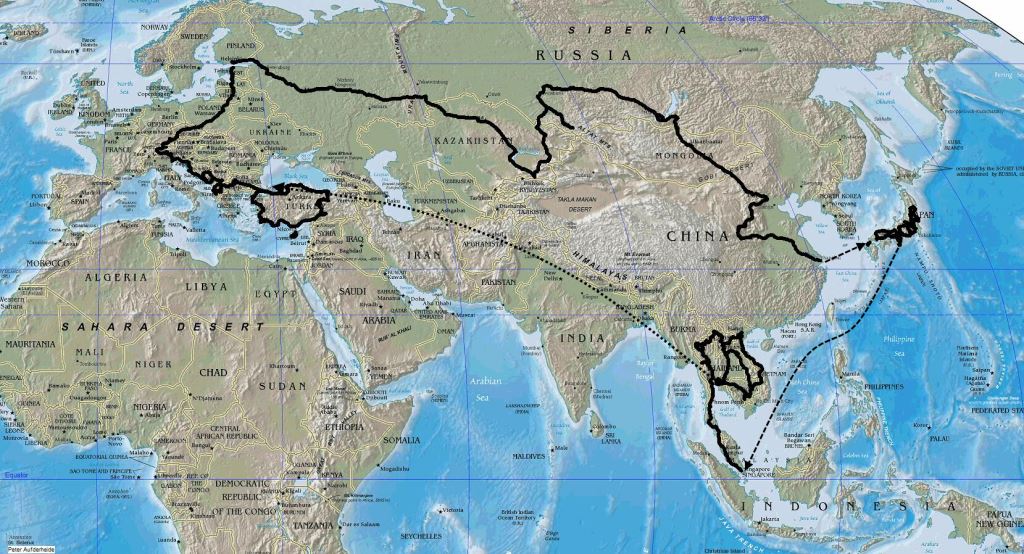
What a hectic couple of weeks both at work and at home. (I think I could probably copy and paste that from the previous trips.)
Audrey had been finishing up at school first with report cards and then packing up her classroom. At my work it had been a pretty steep learning curve for Viola, my replacement, and we could probably have met for another two weeks and not cover everything there is to know. She is going to have a fun and challenging year. Come to think of it, so will we.
We thought the house wouldn't be too difficult since we started moving stuff into the basement and cleaning a few weeks beforehand but in the end cleaning is one of those never ending jobs as there always seems to be one more thing to do. We worked right through to 9:30 on Saturday evening with the renters moving in on Sunday morning so we didn't get to my parent's house in Airdrie until 10:30 pm.
Sunday was spent trying to figure out what to take and then how to pack it. We went to Carstairs for lunch with Audrey's mom, Verna, and said our good-byes. We put our VW in storage at a friend's place late in the afternoon (thanks Craig!) and then went back to Airdrie to stuff everything into the bags and headed off to the airport where we got to Club Class check-in in at 8:30. When we had booked our flight in January there were no inexpensive flights to Munich ($1,500 one-way with layovers in Toronto and Warsaw was the best) so we ended up booking a flight to Frankfurt on Air Transat and renting a car. The regular ticket was only $450 and Club Class was $800 so we upgraded for the extra leg room and extra luggage allowance since we were carrying all of our motorcycle gear and I had found a great deal on new shock absorbers for my bike. We were allowed 40 Kg each (compared to 23) and when we weighed our luggage it came to 38 Kg each. Perfect! We went to Kelsey's for supper with my Mom and then a tearful good-bye at security before we boarded our plane at 11:30 pm.
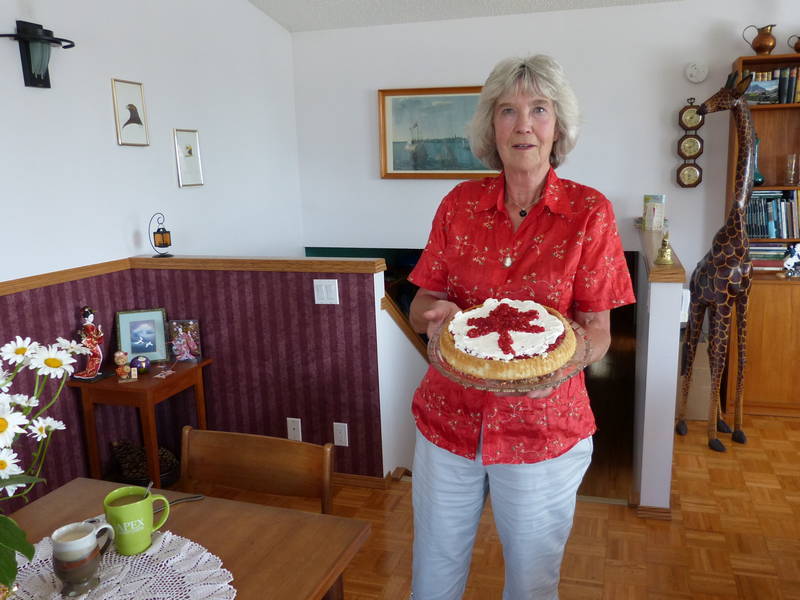
Club Class looked great with comfy seats and a welcome glass of champagne to start our huge trip. We had a delicious cold snack on real china using real silverware while steerage got a plastic wrapped hot meal. We had the opportunity to pre-order breakfast and it was delicious. When we landed, about 45 minutes early, our luggage came out first with Priority tags on it. I'm lovin' Club Class! Audrey says she may never fly Steerage again.
Welcome aboard Club Class

Delicious breakfast
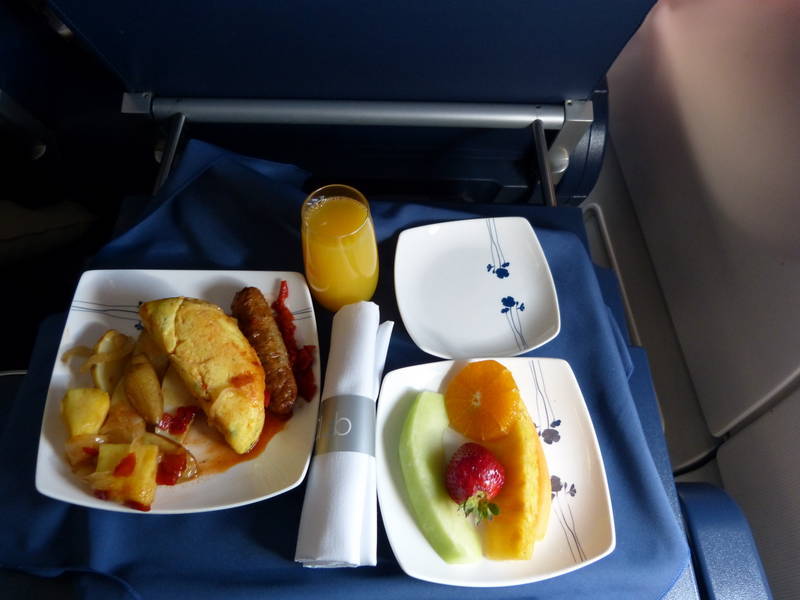
We took a cab (who wants to haul 80 Kg of luggage on the train?) and got to the Ibis hotel at about the time we were scheduled to land. A short break with a shower and a phone call home and then we went for a walk to find curry wurst. The small restaurant on the Main River we had gone to last year was just closing for the evening so we walked around the old town and found a sidewalk cafe that served curry wurst. Back at our tiny little hotel room we collapsed into bed at 9:30.
Old Town Frankfurt
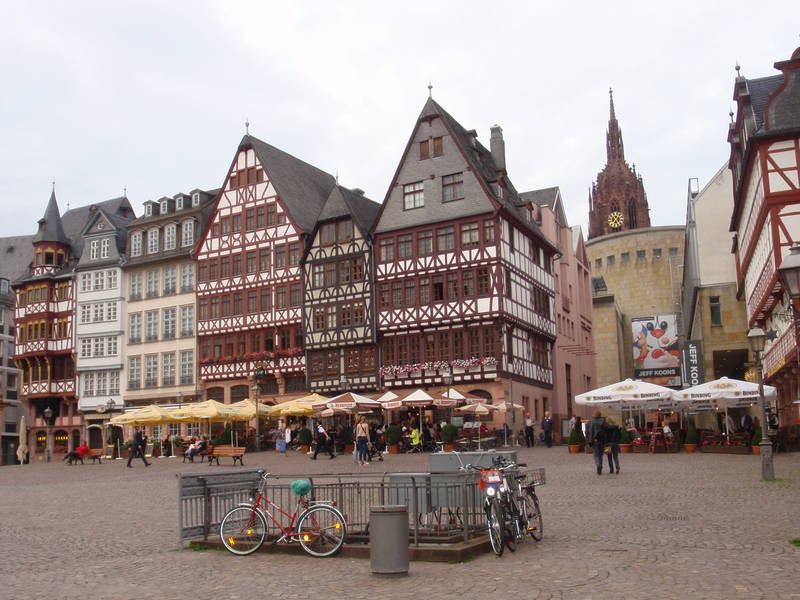
Curry Wurst

Frankfurt Opera House
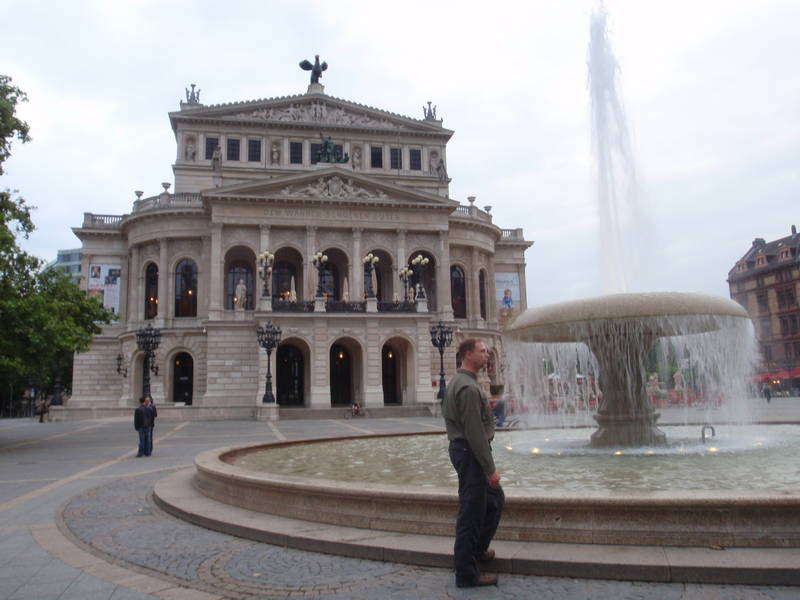
Tuesday morning we enjoyed the hotel buffet breakfast and then walked over to the train station to pick up our rental car. The Renault Scenic was big enough to carry four duffle bags as well as our carry-on bags. One feature that was quite handy was the built in navigation system that showed the current speed limit. In Europe when you leave a town there is usually a "speed limit ends" sign but nothing indicating the speed limit on the highway so this was actually a pretty useful gadget. A few hours down the autobahn took us to Tiefenbach and Motorrad Zierer, near Landshut. Audrey was very happy to see her bike sitting in the parking lot, ready to ride to China. We dropped off the new shock absorbers for my Adventure and then drove to Erding where Brian Dean, a friend from Calgary, was just starting an Edelweiss motorcycle tour of the Alps. We remembered roughly where Hotel Henry was from the time we spent living near Erding five years ago and went there via Schwaig. At the front desk we called his room but there was no answer. Someone walking by in an Edelweiss shirt didn't know Brian but he did hear a couple of people talking about Calgary in the parkade a few minutes earlier so we headed downstairs. Brian looked a bit surprised as we opened the door to the parkade and nearly ran into him. We had a little time before Brian and his friend Bob had to attend a briefing before their tour so we headed over to one of our favourite cake places, the Gezundheit's Park where I used to go for physiotherapy. Cake was part of the physio regimen at the time so a banana and egg liqueur cake seemed appropriate now. I was not disappointed. After cake we dropped Brian and Bob off at the hotel and drove to Kronwinkl.
Ekke, Audrey, Bob and Brian in front of the Edelweiss support van

Audrey writes:
We drove into my sister's driveway in Kronwinkl about 5 pm. Just then Peter Munro also drove up, which was great because exactly the same thing had happened when we arrived a year ago on our trip down from Norway. He's a friend of my sister's and works for BMW. Helena, Willi, and sons Andrew and Robin live in a quaint German cottage-like house and it was great to see it all again. Helena works in Munich but took the week off and chauffeured us around to get our various errands done, made delicious meals, and translated when necessary. One order of business was to take care of the motorcycles. The shocks we had brought from Canada would be installed by 5 pm on July 4th so we drove over to Zierer Motorrad to pick up the bikes. Michael Zierer, after learning about our trip plans, had us pose for photos in front of the shop. He wanted to put them on their dealership website. It felt great to get on the bikes again - the F650 GS twin purred to life when I eventually remembered how to start it. It had been a year and it took me a few moments to become familiar with the controls again. The less hilly way out of the parking lot seemed a good idea, as it would be a shame to drop the bike on the steep exit onto the busy road. Soon we were winding our way through the German hills, passing maize fields and red-roofed farm houses. Ekke went for a ride around the beautiful countryside. I just wanted to get back to Kronwinkl and shed my hot motorcycle gear in the severe humidity.
Ekke gives his bike a hug when he sees it while Michael Zierer looks on in bemusement

Ready to ride to China!
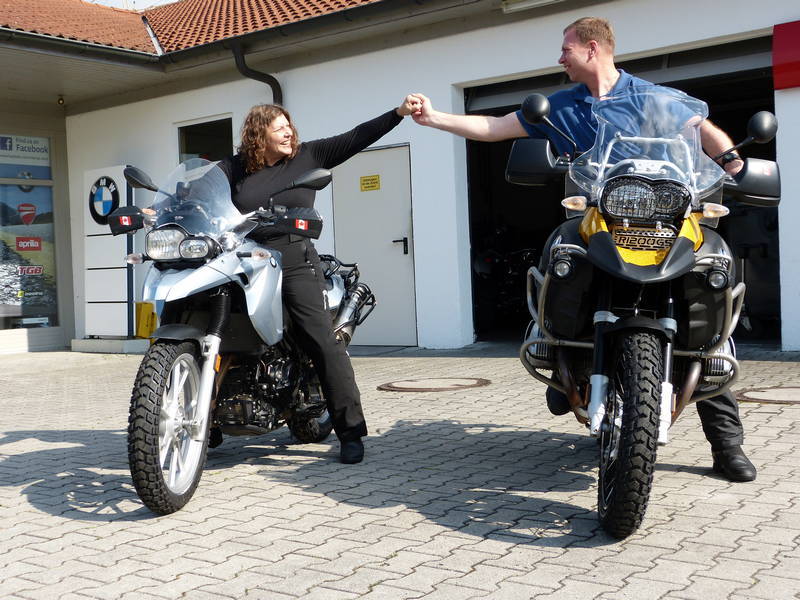
Recently restored church near Kronwinkl on Ekke's first ride

Helena and Willi wish for cooler weather to enjoy their new sweaters
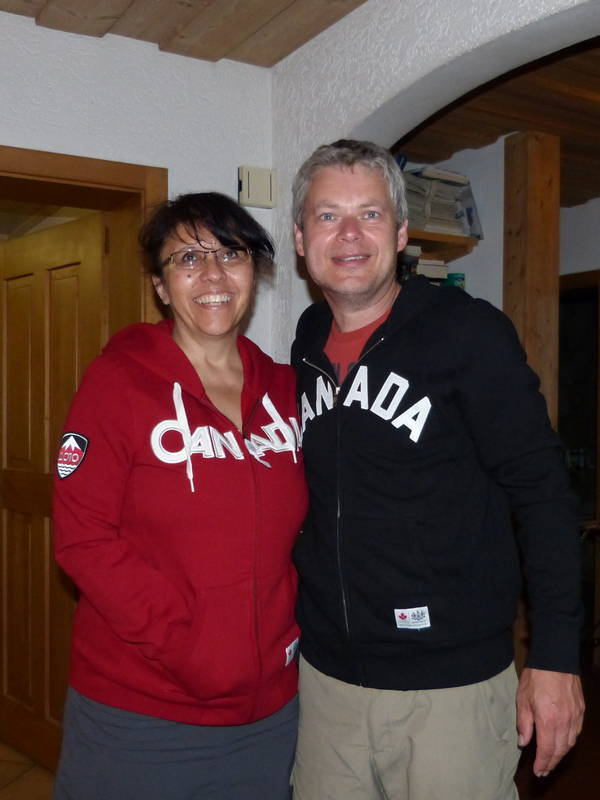
Our week in Kronwinkl was just what we needed after our hectic departure from Calgary. It was easy to get into a routine of sleeping in, which we blamed on the jet lag, and eating fresh 'brotchens' or buns with meats, cheese, and Nutella for breakfast. Going into Landshut, about 11 km away was an absolute delight with its tall brick cathedral, old town of pastel-coloured buildings, and medieval Trausnitz Castle on the hill. Karstad, a local department store had everything we needed and Ekke found a pair of runners in his size. Later, Helena invited us to a Stamtisch at a nearby restaurant where expats and locals got together to speak English. We met some fabulous people. On Thursday night we went to a barbeque at the Huber's place, our former landlords of Gaesthaus Huber in Schwaig. I always get a bit teary-eyed when I see the place where we spent four months when Ekke was recuperating from the cargo bay accident of 2007. The Huber kids are all grown up and have promised to come to Canada to learn English. During the week, Ekke had time to install a sidestand foot enlarger, tank bag, straps for the BMW bag and sort out the camping and cooking gear. There was some tough decision-making, especially in the area of clothes. Motorcycle travellers know the value of space, especially when carrying all the camping and cooking gear. Clothing for all types of weather is crucial, like the rain gear, warm sweater, down-filled jacket, long undies, warmer gloves, and this takes up much of the space. As usual, I packed too much of the non-essential clothing, making my bag too heavy. What to toss out...
Ekke writes:
Saturday morning dawned with cloudy skies and imminent rain. Soon enough it was simply pelting down with rain. I'm sure we'll get enough rain on the trip anyway so we decided to pile into Willi's Golf and drive to Garmisch-Partenkirchen for BMW Motorrad Days. There was a very nice stretch of road approaching Wallgau, where our hotel was located, that would have been really fun on the bikes with twists and turns, not to mention waving at all the other BMW motorcyclists on the road but it sure was convenient in the car. As soon as Peter and Michelle arrived and we were all checked in we took a local bus to Garmisch and walked onto the festival grounds. Wow, what a lot of people and BMW motorcycles. Heaven! After a lunch in the biergarten we split up and explored the show. Audrey and I ended up at a presentation by Kevin and Julia Sanders from the UK whose Globebusters videos we've watched at home. They did a presentation on the tour they run from London to Beijing so it seemed especially relevant to us. The next presentation was by Michael Martin, the famous German photographer whom we had met in 2007 just before starting our Africa trip. I got on the cell phone and tried Tom and Andrea's (Munich Blue Knights) cell phone and they had just arrived at the front gates, just in time to join us for the Michael Martin presentation. Afterwards we wandered the grounds looking at the cool custom bikes and watching Chris Pfeiffer's stunt show. We met everyone back at the biergarten for supper and to enjoy the evening's entertainment. BMW Motorrad UK had reserved an entire section for about 225 people right next to our table. When we saw Julia Sanders Audrey went over and said, "Hello" so we got to thank her for their inspirational videos. She was really excited about our upcoming adventure too. There's a possibility that their next London to Beijing tour would be going through the 'Stans at about the same time as we'll be there coming back next year so maybe we'll see them again. A free shuttle bus brought us back to Wallgau later that evening and we enjoyed an Almond liqueur and hot chocolate night cap together before retiring to our rooms.
Checking in at the Hotel Alpenhof in Wallgau
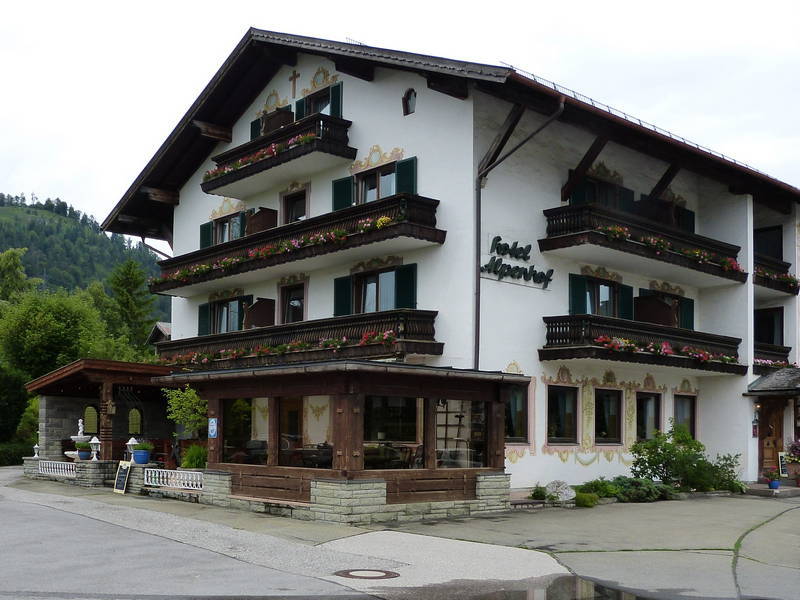
Cool custom bikes were plentiful

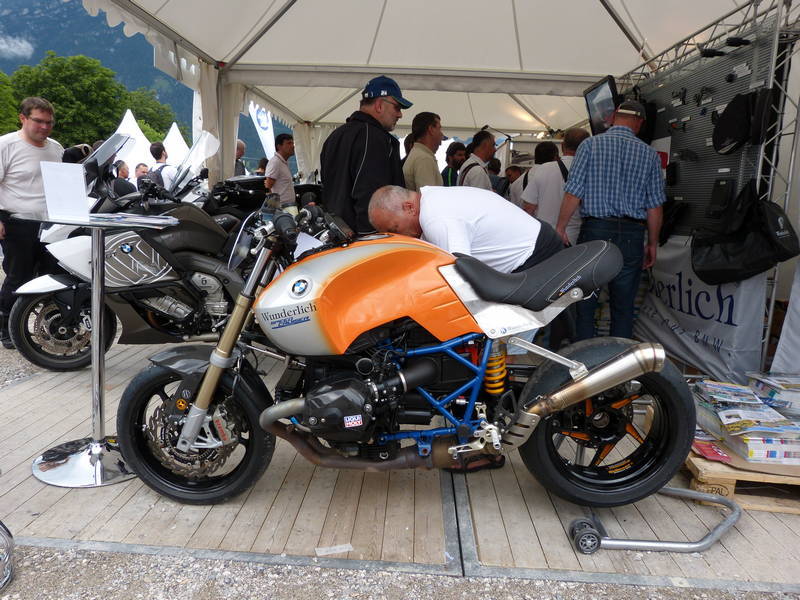
I want this bike...
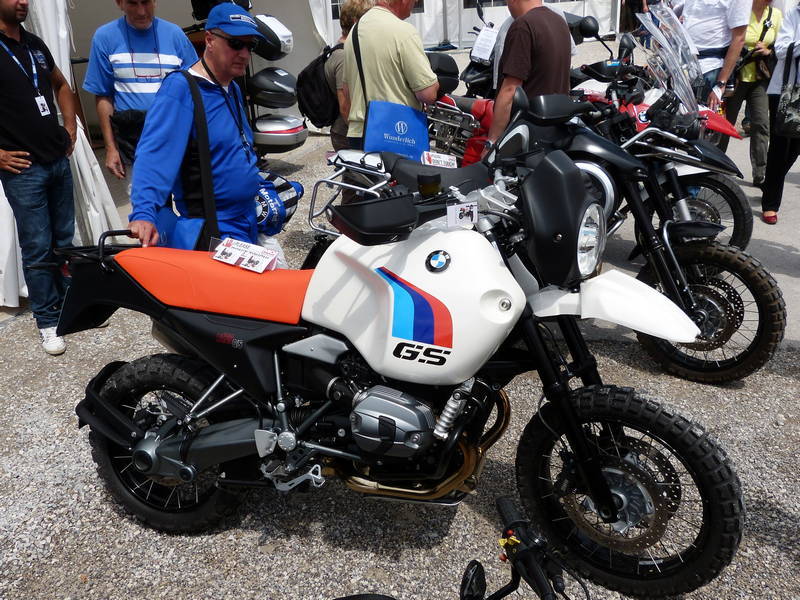
Audrey tries the new F700GS

While Ekke checks out the new BMW scooters
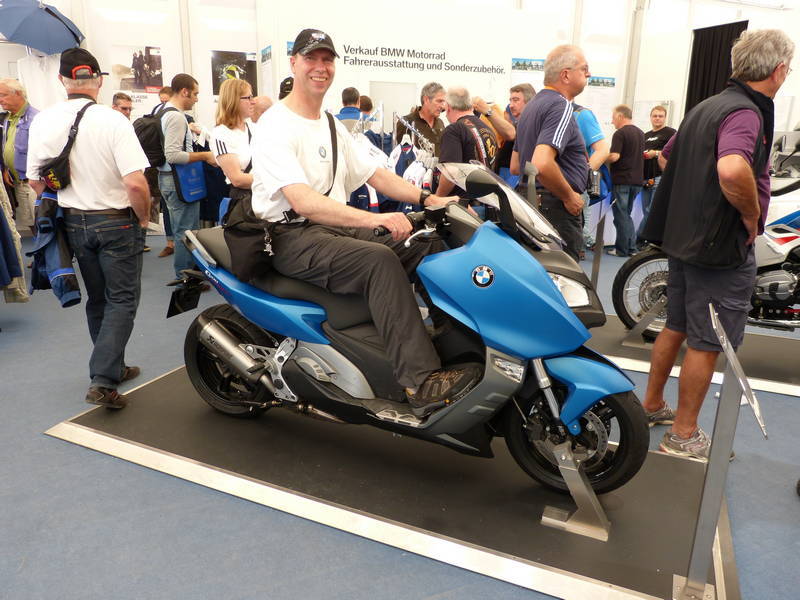
Andrea and Tom meet us in time for the Michael Martin show

Michael Martin remembers us from his show five years ago just before we left for Africa
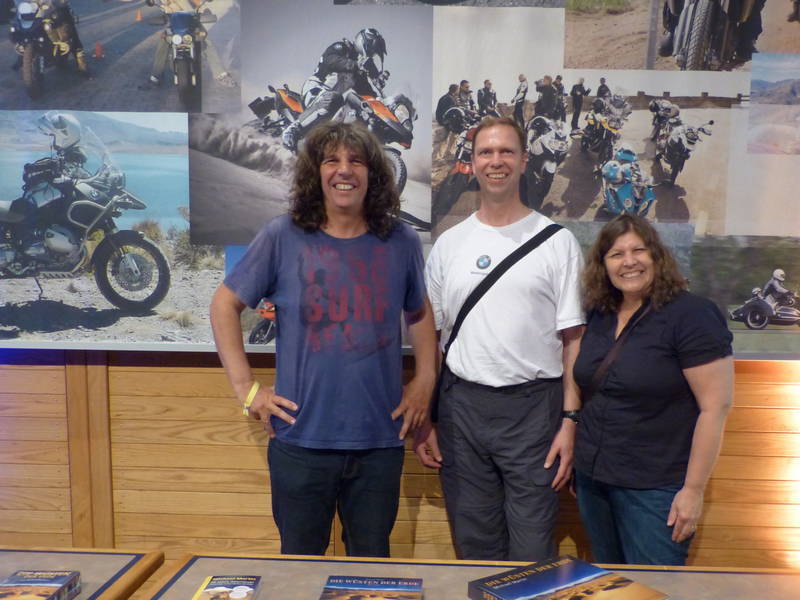
The bike that started it all for us, Helge Pederson's R80G/S. Ten Years on Two Wheels.

Audrey buys some new gloves and tries her judo moves
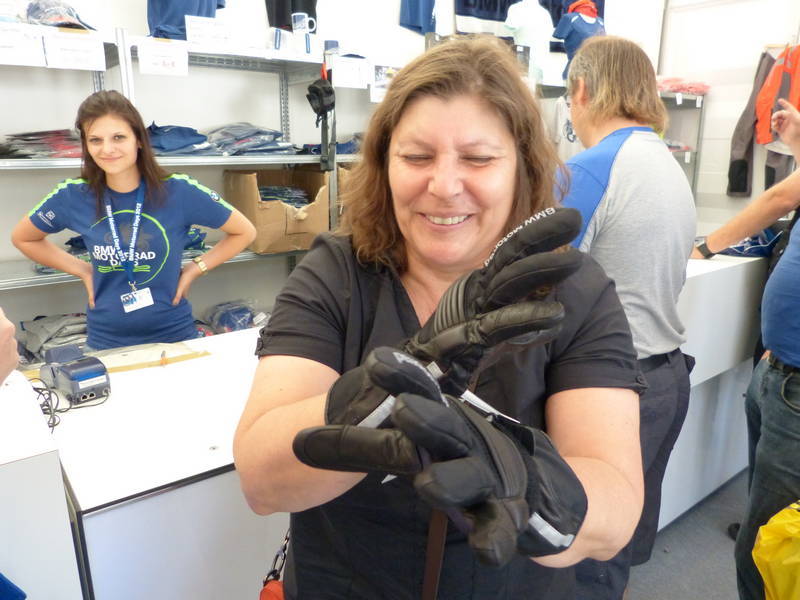
Chris Pfeiffer demos the K1600GT
Peter, Helena, Audrey, Tom, Andrea, Michelle and Willi getting ready for a fun evening
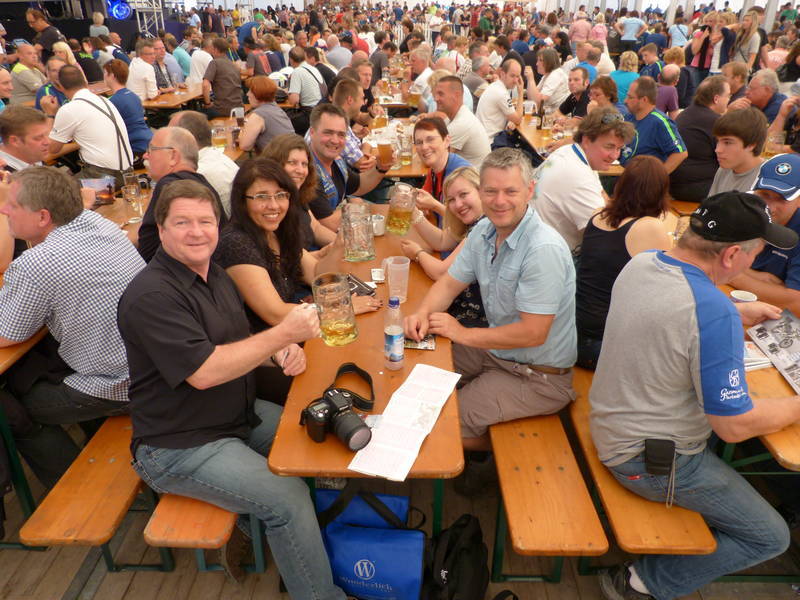
We meet one of our heroes, Julia Sanders of Globebusters

Sunday looked like a great day so we decided to take the gondola to Alpspitz for the view. A really cool cantilevered platform was suspended over a sheer drop. I didn't venture out very far but I got a few photos of the others out there. The area really reminded us of the Rocky Mountains at home but at home there aren't cable cars and gondolas to every mountain peak with restaurants conveniently placed within walking distance. We took another gondola down part way and walked for half an hour to a restaurant for lunch. The wild flowers along the walk were just beautiful and we had to pause often to admire them and the views. Back at the cars, Peter and Michelle put the top down on their BMW 1 Series Cabriolet before heading home and we piled into the Golf for the 2 hour ride to Kronwinkl. What a fabulous weekend.
Audrey cantilevered out over Garmisch-Partenkirchen

Two sisters enjoying the view

Alpine meadows at Alpspitz

At the back Willi and Michelle and the front Peter, Helena, Audrey and Ekke

The second gondola to take us part way down to a hike

Wildflowers on the hike between the upper and lower gondolas
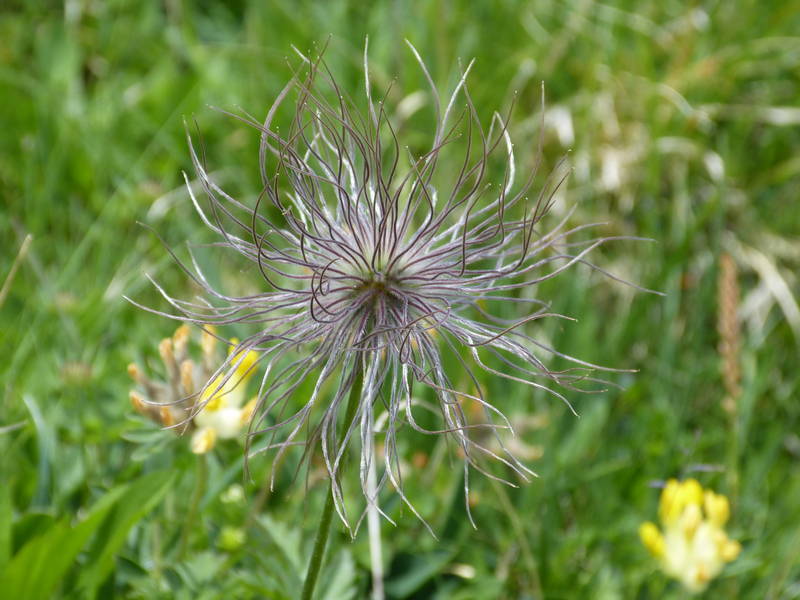
Tuesday morning was the real start to our trip and we loaded the bikes up in the driveway after everyone else had left for work. The ride to the Czech Republic started out on the autobahn but soon enough wound up into the hills on smaller two-lane roads. Our first true border crossing turned out to be rather anticlimactic. There was no border post to be seen, only some souvenir shops so we had to settle for a photo of a small sign announcing our arrival in a new country. While the border was nearly invisible, the change in the houses and cars and people was palpable.
The five litre bag won't fit so we have to drink some of the apple juice before heading off

And we're off!
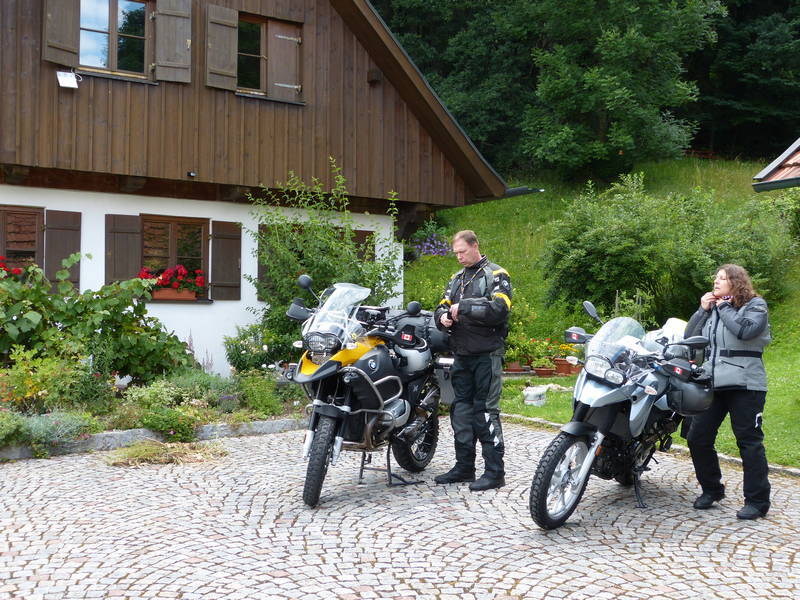
Audrey writes:
Crossing the border into Czech Republic was a non-event. There were a few buildings scattered about from what used to be a formal process of passport stamping and visa checking. But there was no one to be seen, and we just cruised on through. Immediately the architecture changed and the neat and tidy Bavarian towns were behind us. Ekke had purchased $50 in Czech koruna in Canada, so that got us started in our first grocery store. I went inside to get some lunch supplies while Ekke watched the bikes. I only knew two words of Czech, but people in the store were very helpful. A small wall on the edge of the parking lot gave us a great place to sit, enjoying delicious home-made brownies compliments of Helena. Willi had given us a five litre bag of apple juice, from his own apple tree, which lasted until Lithuania. Any apple juice we tried after that was never as delicious. It was a pleasure riding the good roads through forests and beside farmland, and making our way through Prague was easy with Ekke's Garmin Zumo 550 GPS. It led us right to Hotel Kinsky where we could use our Best Western travel cards earned through Airmiles. A hotel concierge opened up a set of wooden doors from the street, and we rode through a tunnel into the hotel courtyard. Very cool. It felt very secure parking there, and we just threw the bikes covers over the bikes to protect our gear from the rain. The room was lovely, and it was great to have a place to plug in our iPad, iPhone, netbook, laptop and batteries from four different cameras, using the proper European plug adapters, of course.
Arriving in the Czech Republic had us doing a U-turn to find the sign

Parking in the courtyard of the Hotel Kinsky
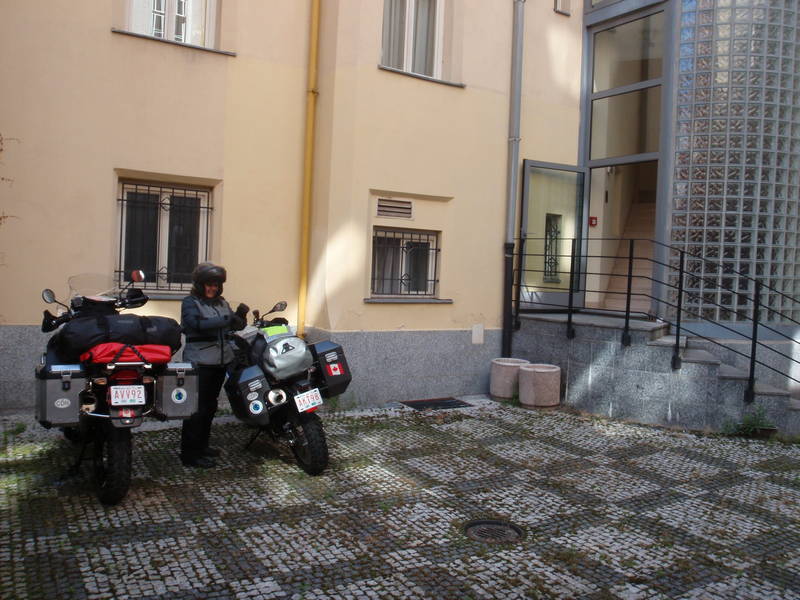
This was our third try to get to Prague. In 2002 my bike broke down in Salzburg, and in 2007, Ekke had the knee accident. So, walking around Prague was extra special for us. A highlight for me was Charles Bridge, a 14th century stone bridge lined with 30 statues of various saints. It was also lined with several artists doing caricatures, and this was where Charlie Boorman had his portrait done in 'Long Way Round'. The three Gothic bridge towers were quite majestic, one of them a portal into the castle district, the other into the old town. We happened upon the medieval Astronomical Clock, a huge timepiece which still worked, and it also showed the positions of the sun and moon. The market square was really unusual as it contained a variety of Gothic and Baroque buildings and we just stared up in wonderment. I've heard the square described as the most beautiful in Europe, and, having finally seen it, have to agree.
Walking along the Charles Bridge Ekke contemplates getting a caricature done
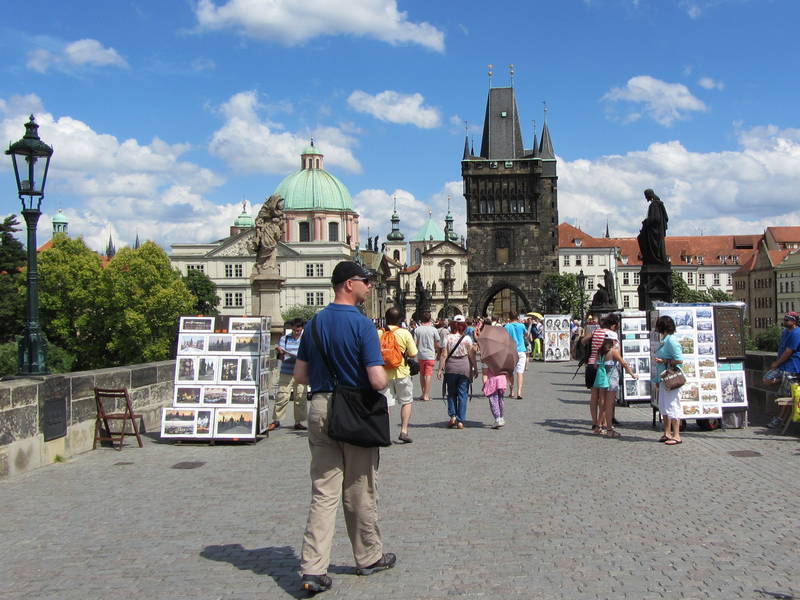




The next day, July 11th, we wandered up to the castle complex. Some tourists were trying to negotiate the steep cobblestoned roads on Segways, and it looked about as much fun as on a motorcycle, or, not at all. But good entertainment for us. The changing of the guard at the castle was just starting. I couldn't see much because of the big crowd but did catch a glimpse of a blue uniform every now and again. Later, during our cappuccino break, some of the soldiers walked by us and I got a better look. Views across Prague were magnificent in the bright sunshine, and we looked down on lovely terraced gardens. A stroll across the old town took us to Wenceslaus Square where we admired the statue of the good king. Legend has it that he gave alms to the poor and helped his page get through a blizzard, which started tales of his heroic goodness and inspired the famous Christmas carol. The huge square was reminiscent of wide boulevards in Paris. It was interesting to walk where a crowd of 100 000 people had gathered in 1989 for the Velvet Revolution, a peaceful protest that contributed to the collapse of Czech communism. As we walked across a bridge to the lesser town, Ekke noticed a little restaurant, Terrassa, on the banks of the Vltava river, and soon I was sipping Sauvignon Blanc and eating delicious bread with olive oil with balsamic vinegar. Ekke said that his smoked salmon salad was delicious.
Saint Vitus Cathedral at the castle complex

Beautiful square
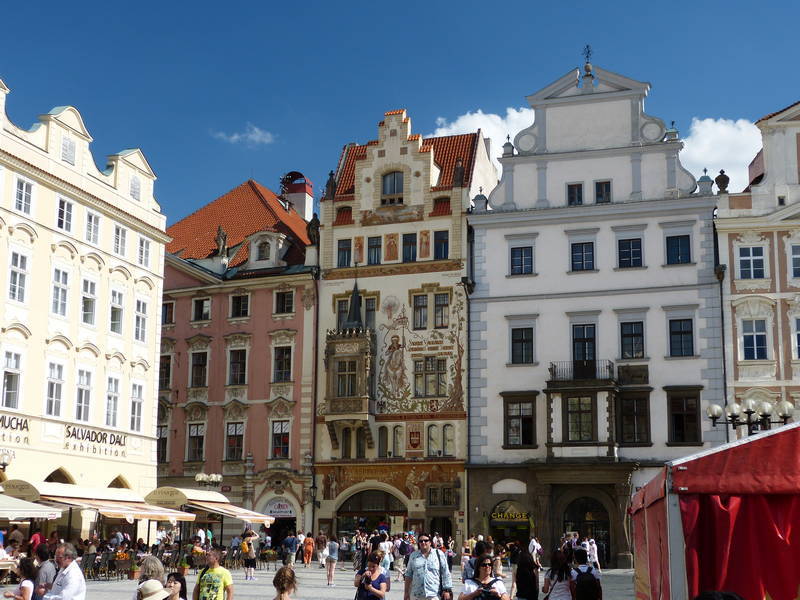
Good King Wenceslaus

Beer is cheaper than water
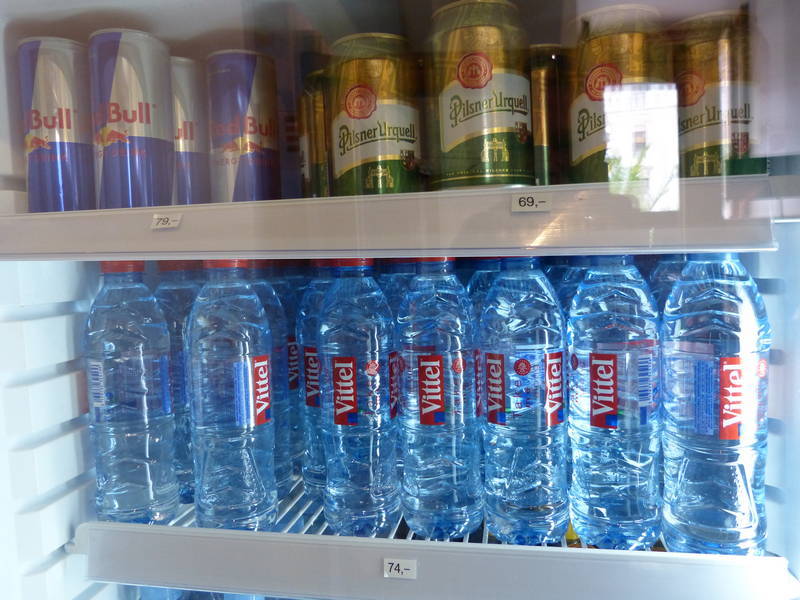
The Dancing House (nicknamed Ginger and Fred)

No matter how sore my feet were after a day's sight seeing I wasn't doing this
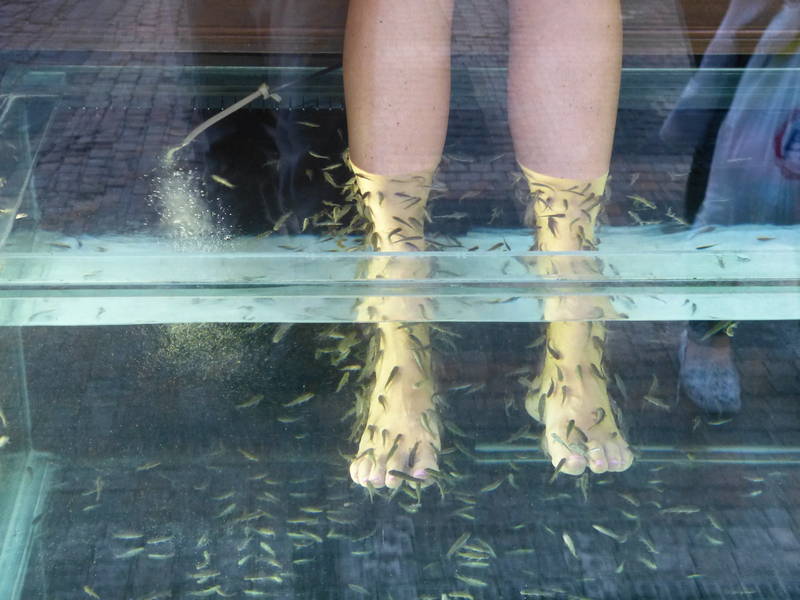
Spotting a restaurant adjacent to the weir

A delicious dinner


The border crossing into Poland on July 12th was easy, with more abandoned customs houses and no one to stamp our passports. While picnicking, a guy walked toward us and seemed pretty excited. He had seen our Alberta plates, and was astonished to see us in Poland with motorcycles. Turns out he was from Windsor, Ontario, and was visiting his former homeland. He warned us about drivers in Poland, saying they drank a lot, so be careful. We chatted for a while and he gave us a big salute as we rode away. I don't know if we saw any drunk drivers but the roads were very narrow, with no shoulder, and it made for some interesting passing situations. Oncoming vehicles just passed without really noticing we were there, and we were often forced to the side of the road to avoid a collision. On a really narrow, rough stretch, it started pouring rain. Ekke thought we could avoid the downpour because our route on the GPS headed in another direction. No such luck. Too late to put on the raingear and we pulled into our hotel a bit soaked. The only other group in the restaurant for dinner were some Gold Wing riders from Ukraine. But, our Ukrainian language skills are limited so we couldn't have much conversation. The meal was excellent and Ekke's beetroot soup with apple froth was the best he's ever had while his Roast Duck was simply fabulous. The lid on the coriander container must have fallen off as they were making my lasagna though.
Leaving the Hotel Kinsky
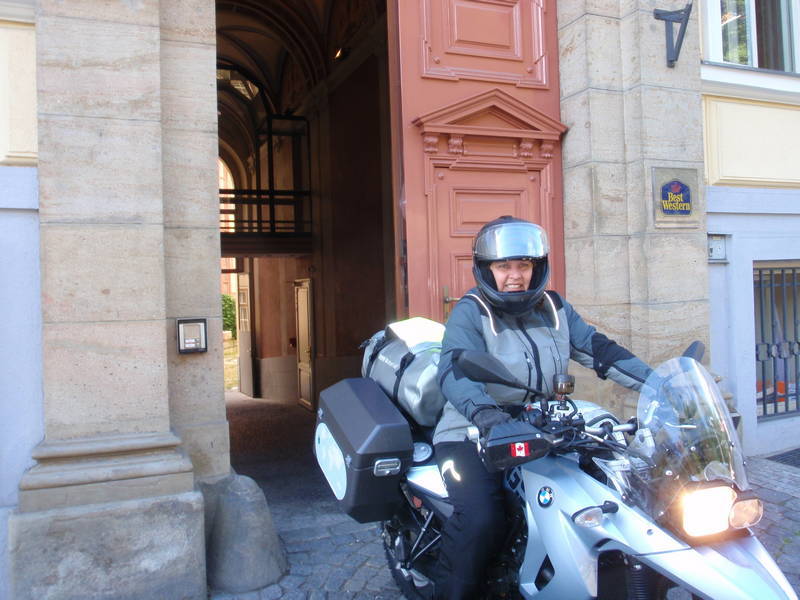
Entering Poland
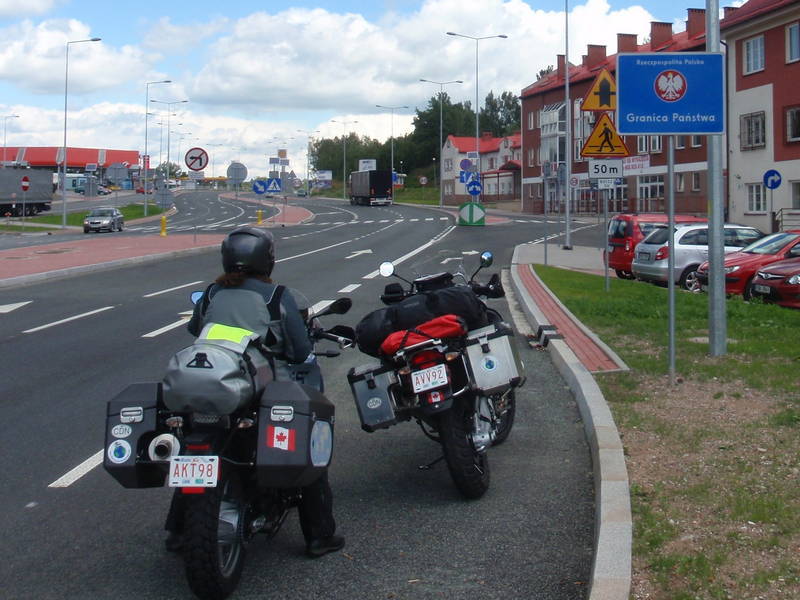
Ultra-modern Best Western at a truck stop at Osjakow, Poland

Some narrow roads took us past fields and farmhouses and through small forests to Warsaw on July 13 and to the next Best Western. There was time to visit the old town after checking in and we spent some quality time wandering near the castle, fortress and border to the former ghetto. A quaint dinner spot had dumplings and potato pancakes on the menu, and it was great to sample the local cuisine. We happened upon a statue of Nicolaus Copernicus, the Polish astronomer. All around the statue were bronze plates depicting the earth revolving around the sun and I walked the path of the moon revolving around the earth. On the way home, Ekke nicknamed our cab-driver Robert Kubica, a Polish Formula 1 driver. He accidentally took us to the wrong hotel and then hit the gas to get us to our hotel a bit faster, swerving in and out of traffic, using other cars as pylons. I just held my breath for most of the trip and when we arrived safely, I looked around for a guy waving a chequered flag.
Some pleasant riding in Poland (when the traffic wasn't too heavy)

The Best Western Hotel Felix looks like a remnant of the Soviet Era

An evening stroll in Warsaw's old town
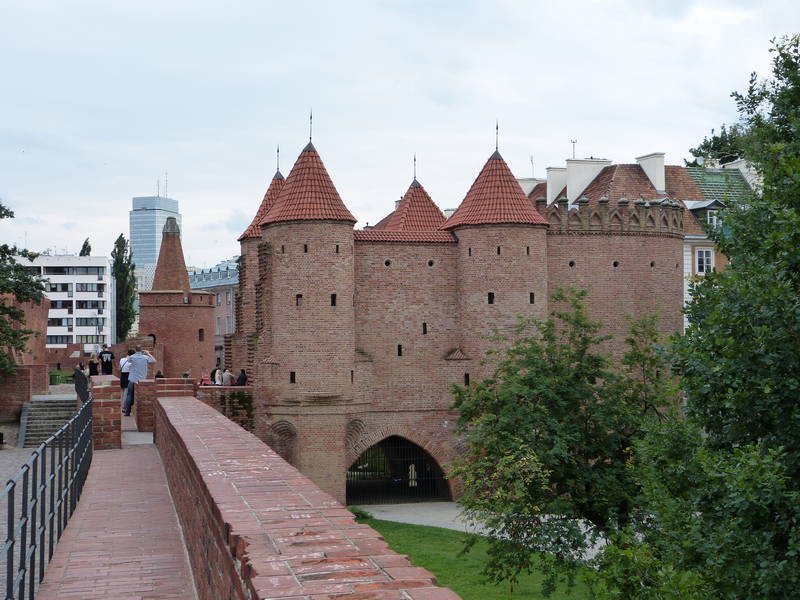
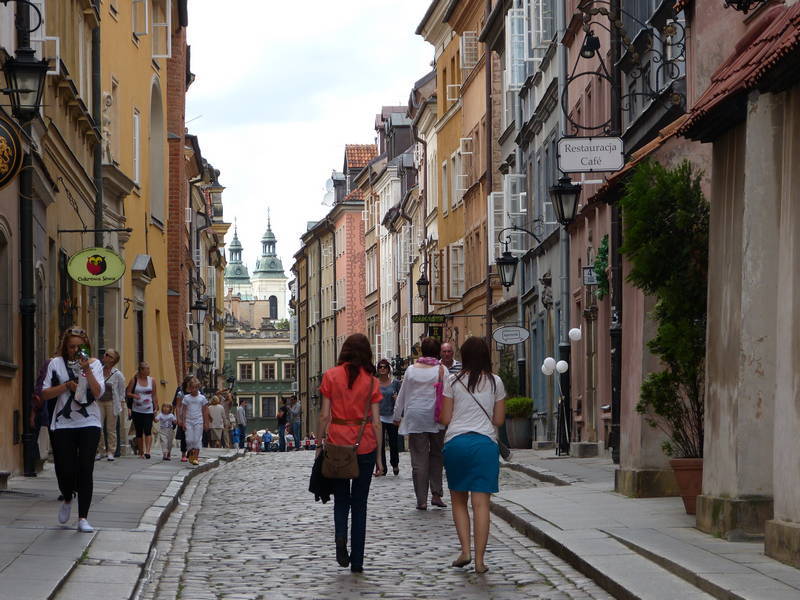

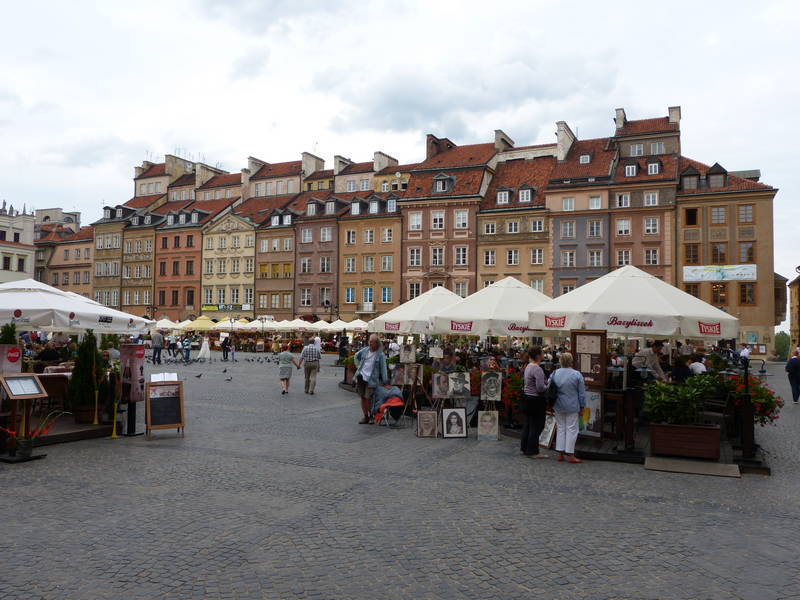
Madam Curie's museum wasn't open

The statue of Nicolaus Copernicas was surrounded by orbits of the planets

Having fun with bubbles

Our route north took us through Kaunas, Lithuania. The capital, Vilnius, was out of the way so we decided to save that for another time. Getting to the hotel was interesting as the GPS sent us the wrong way down a heavily cobblestoned one-way street but it seemed the only way into the courtyard of the hotel short of riding on a pedestrian mall. Walking down the mall after checking in we thought the buildings must have been quite spectacular at one time but were starting to crumble a bit. But the cathedral was beautiful and our restaurant was great. Ekke tried a strange drink, a kind of fermented wheat drink with raisins floating in it. There was not much time to visit Kaunas and we knew we'd have to come back to see the historic city.
Riding north in Poland

Delicious hunter stew for lunch

Entering Lithuania
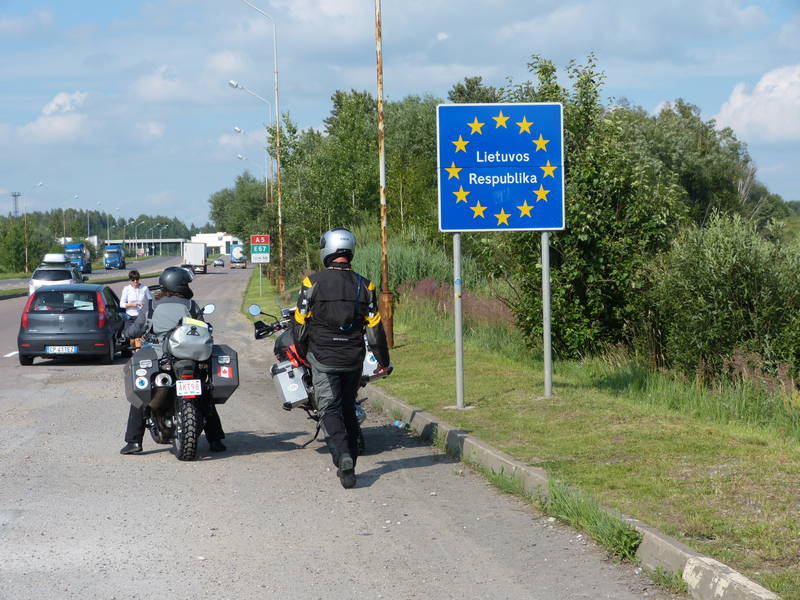
Parking the bikes in the courtyard of the Best Western
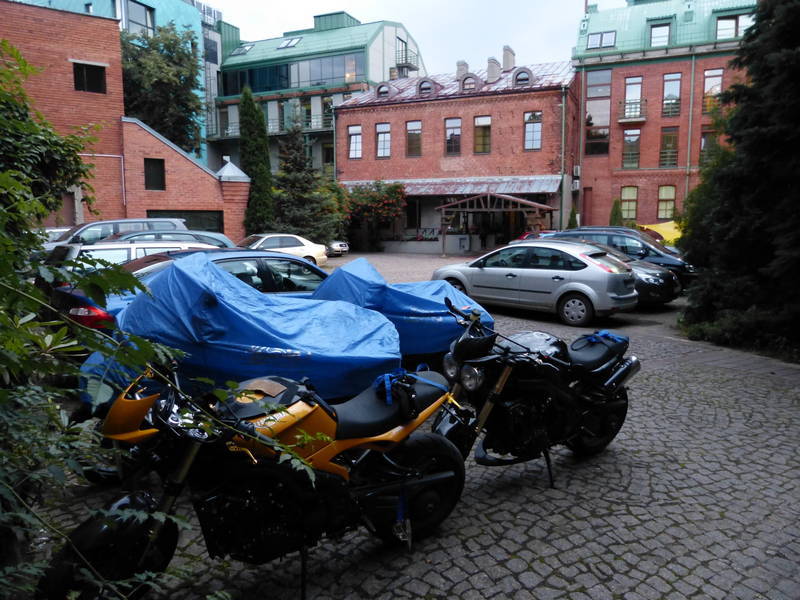
Gorgeous church in Kaunas

An "interesting" beverage
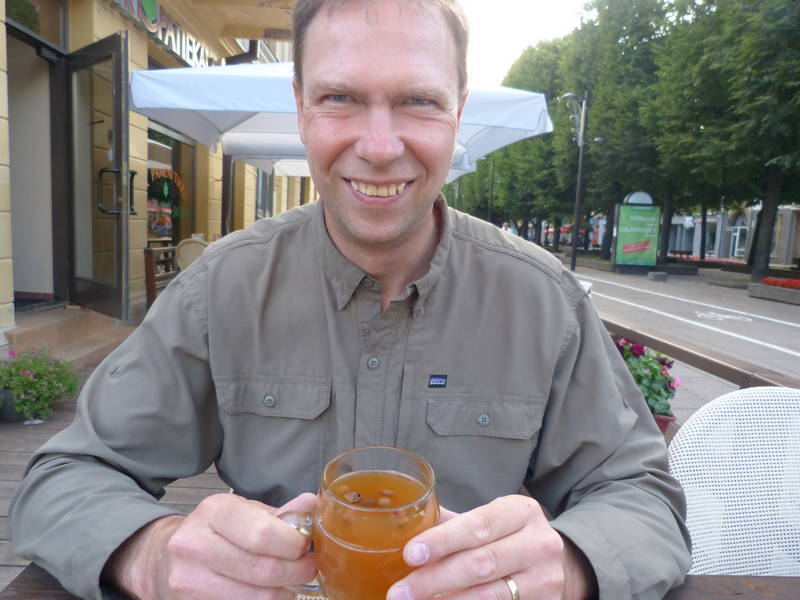
The easiest way to leave our hotel was to, again, go the wrong way down a one-way street, which landed us on the pedestrian mall. A short ride on that, to the surprise of many walkers, eventually got us going in the right direction. The ride through the countryside was gentle, with wide shoulders that made passing safer than in Poland. Buildings and yards were neatly kept and it was pleasant riding. The Lithuanian litas that we had went a long way and we were hard-pressed to spend them all before leaving the country. Our dinner the previous evening had cost less than $10.00 for both of us, and we tried to spend the money on lunch and snacks. At a roadside cafe, Ekke looked at the sky and said it was going to rain in about two minutes. About two seconds later it just started pouring and we had just begun to throw the bike covers over the bikes. The cafe provided a nice refuge, with tacky boar statues, and the rain stopped as soon as it had started. It was still quite overcast when we came out so we put on our raingear. My BMW Tourshell pants are supposed to be waterproof, but the heavy rain disproved that theory, so I put rainpants on over top. My C-Change liner works well to keep my upper body dry, but in heavy rain it is good to have an outer covering to keep the jacket itself dry. Ekke also had liners, but has to plan ahead to put the pant's liner on before leaving the hotel as doing it on the side of the road makes for too much entertainment for passing motorists. So, he often wears raingear as well. As the sun appeared, it got hotter and hotter and soon we were baking inside the raingear, so off it came. There was no map of Riga on the GPS so Ekke looked at the iPad map and memorized it to try to get us to the hotel. We ended up doing a huge u-turn way up the highway, which led us into some pouring rain, and, with no raingear on and no place to stop, we were soaked by the time we got to the hotel. The joys of motorcycling.
A fellow BMW rider in Lithuania
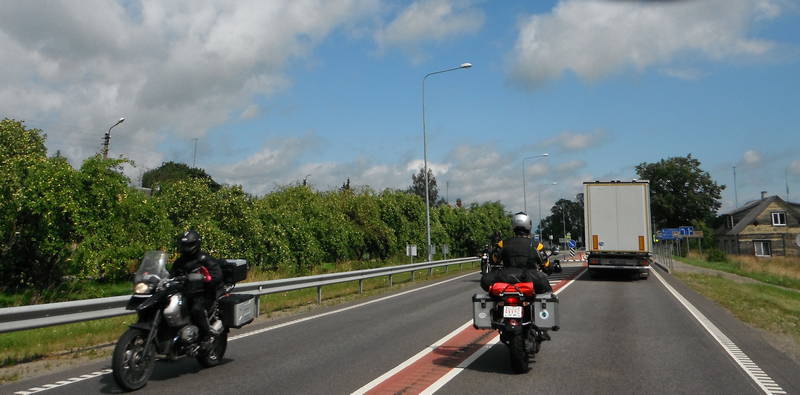
Audrey tries to decide which one to bring home for a souvenir (go for the boar!)

Entering Latvia with the abandoned border control post decaying quietly behind
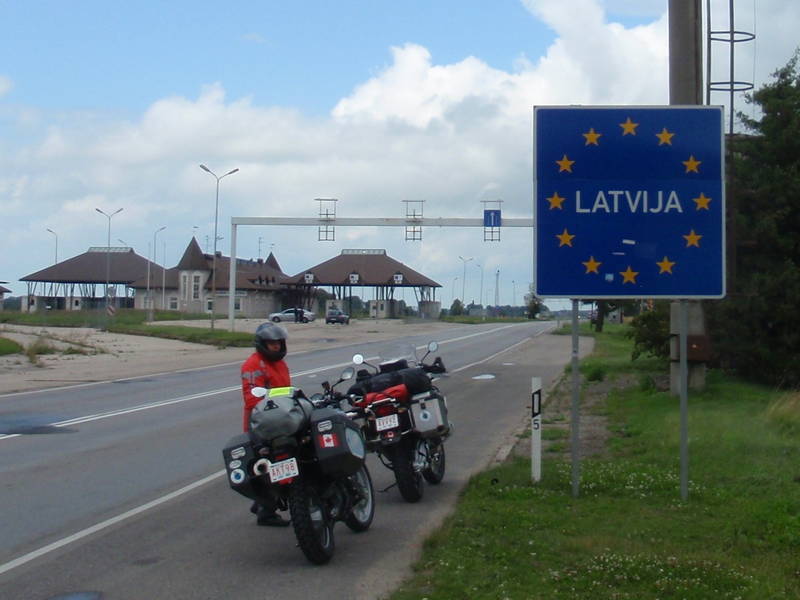
Using the iPad to find the hotel in Riga
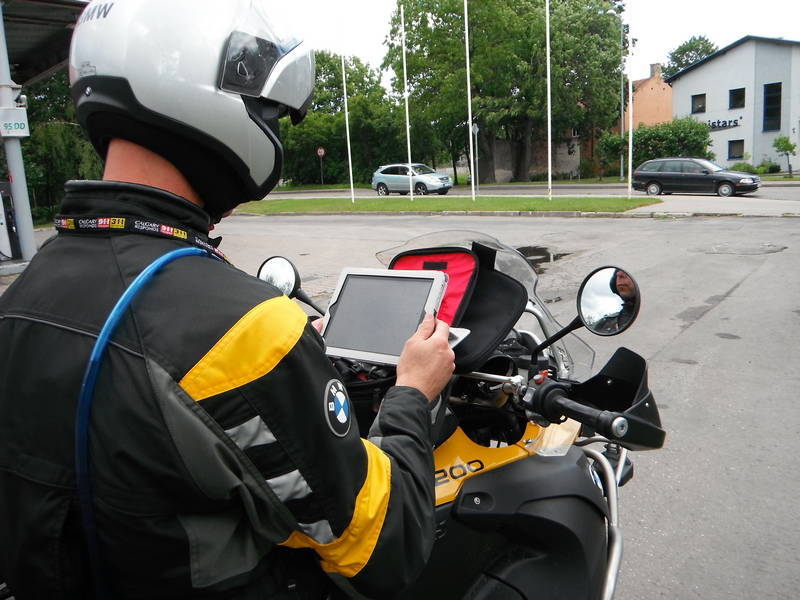
The sun appeared again, and we had a great walk around the beautiful old town. Our shuttle bus driver had suggested the Lido Cafe for supper, and we decided to try it. The decor looked like a Latvian hunting lodge, the staff wore traditional dress, and the pork steak and sauerkraut were a great combination. On our walk, we peeked inside a church where a Sunday evening service was being held. The setting was lovely, and the priest had a beautiful singing voice. Too bad video wasn't allowed. The medieval buildings in the old town were awesome to look at, many of them having been rebuilt after the second world war. In Bastion Hill Park there were a lot of padlocks attached to a small bridge. Newlyweds attach their lock to the wrought iron as a symbol of a firm and stable marriage.
Downtown Riga, House of the Blackheads
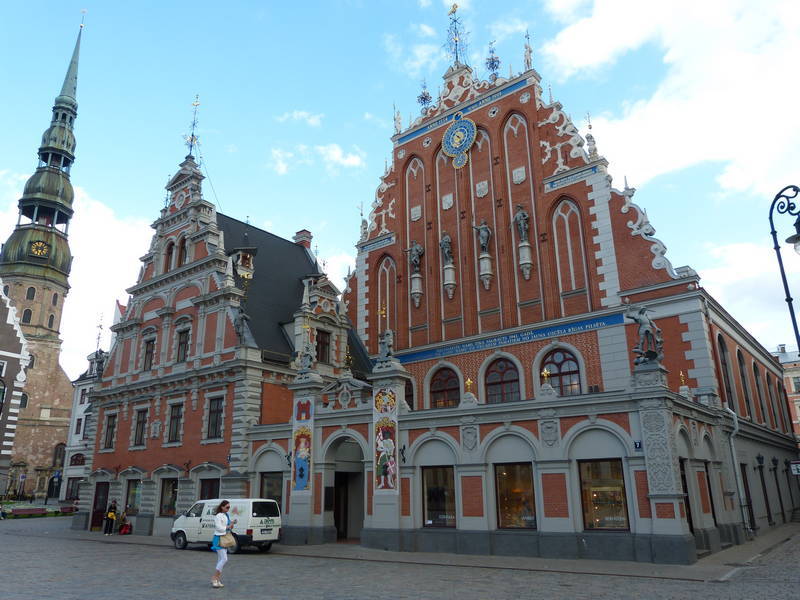
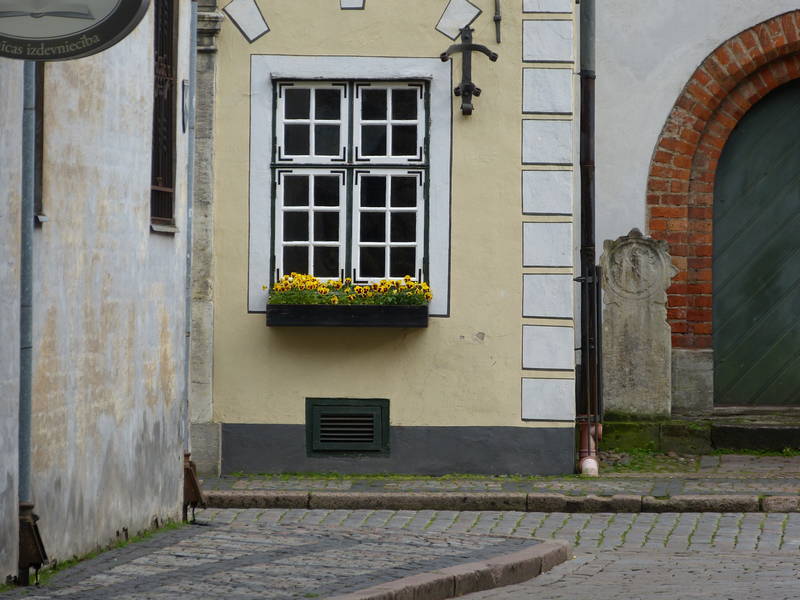
Cat on a pointy roof

Coats of arms in Latvia beside the Powder Tower

Breakfast of oatmeal and hardboiled eggs was great at the Best Western Mara on July 16th. It is advertised as a 'Canadian-style' hotel, maybe because it is free standing, a half-timber design, with a big parking lot in front. It looked like a building you'd see while travelling around Ontario. There was also a copy of a landscape painting in the breakfast room by Frederick Varley, one of the Group of Seven. So Ontario-esque. Our ride took us along the Baltic, but we could only see trees. Luckily, on one of our breaks, we saw a little path through the trees and walked out onto a beautiful beach. Gorgeous yellow sand and a beautiful blue sea greeted us, but the wind was just howling and it was a bit chilly down there. The border crossing into Estonia was, again, non-existent. It was great to be able to use euros again and not have to worry about unfamiliar currencies. Ekke had done some research on the internet and learned that there was no Best Western hotel in Tallinn and other hotels were pretty pricey so we decided to give camping a try. The city campground was a bit tricky to find and when we finally did, it looked just like a parking lot. Ekke suggested we try a place by the yacht club, which turned out to be great, with a grassy, tree-lined spot and picnic tables. The best part was that it cost 3 euros per night. But showers were 3 euros per person, so not much savings there. There was a great little restaurant just across the parking lot, and we enjoyed a couple of pizzas. Prices seemed similar to those in Canada.
Cool and windy on the beach today
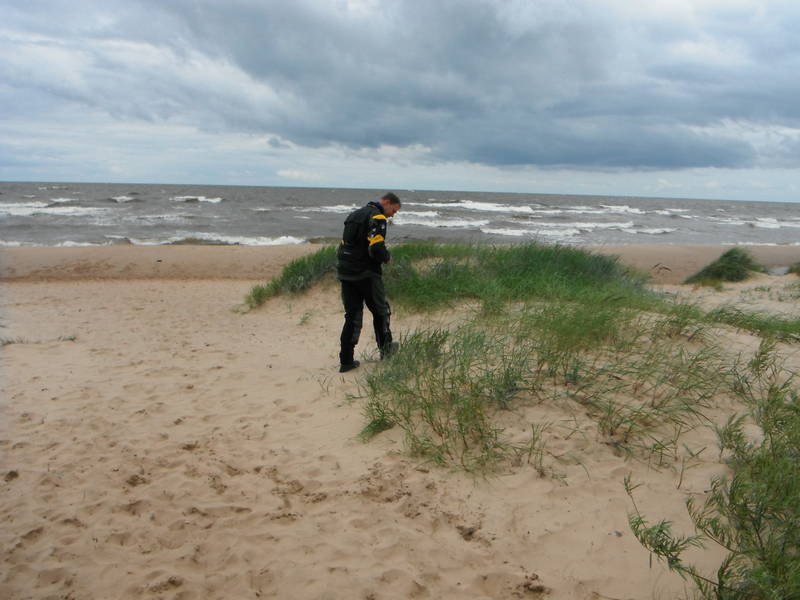
Entering Estonia
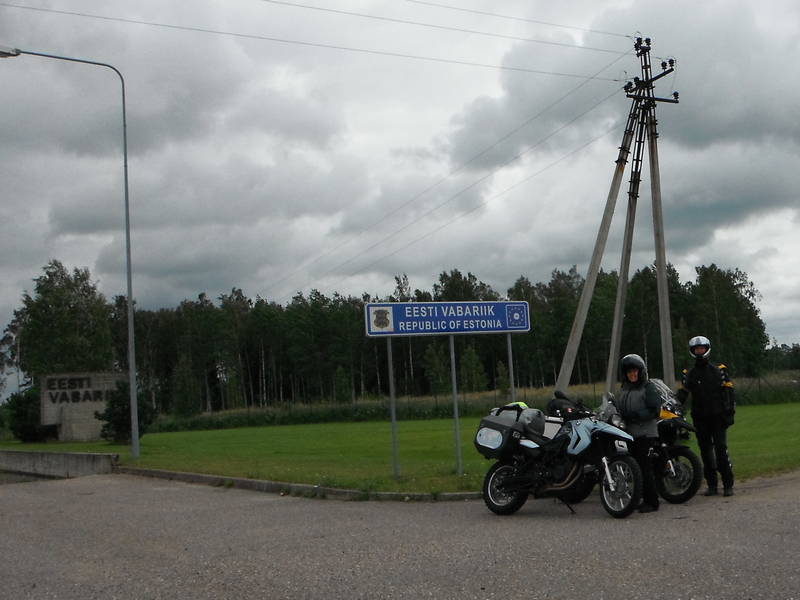
Lots of forests in Estonia
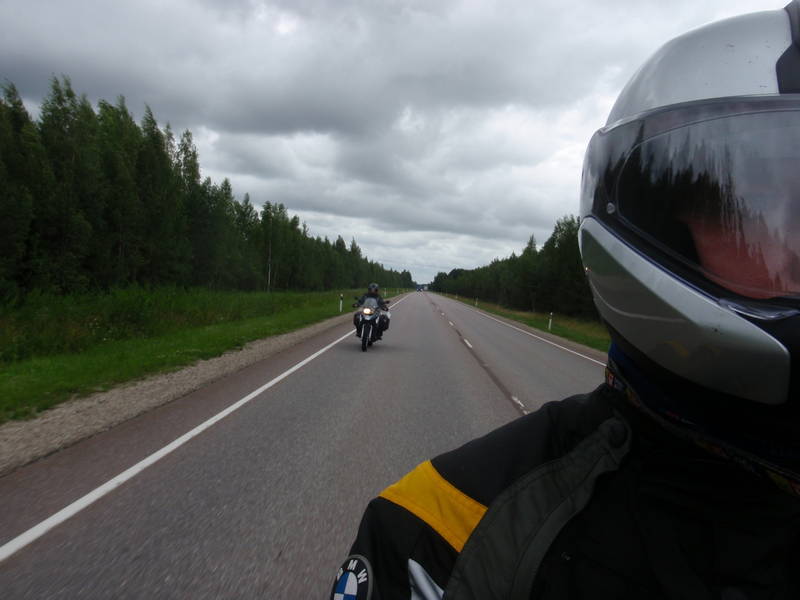
Camping for the first time on the trip

Audrey checks out the washroom facilities at the yacht club
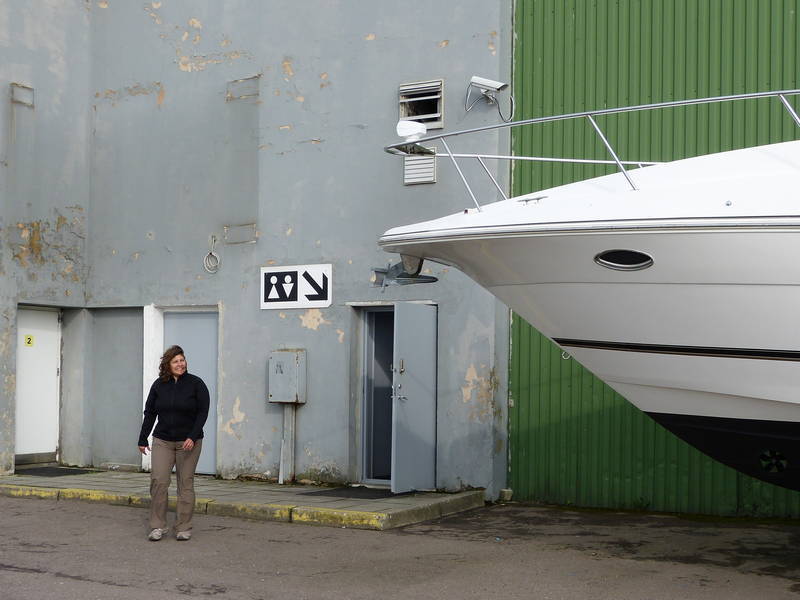
The next day, July 17th, a bus was available nearby to take us into the old town of Tallinn, and we could leave our motorcycles safely parked at the yacht club. What a gorgeous old town, with fairy-tale spires and a stone wall with a wooden roof surrounding the World Heritage Site. The streets were heavily cobblestoned and we had to step carefully so we didn't twist an ankle. First order of business was to get a map, then find out about ferry schedules to Finland, and then get a cappuccino and cake. I overheard someone at the info place asking about the free English tour, so we decided to join in. The tour took two hours, and we started at Freedom Square. Our tour guide said that the Freedom Monument there was very unpopular, as it resembled a cross and most Estonians were atheists. It was also supposed to light up but often had technical difficulties. A petition had been started to have it removed. A walk up the hill took us to Kiek-in-da-Kok tower which means 'Peep into the Kitchen'. In the 15th century, tower occupants were able to peek into the kitchens of nearby houses. Maybe that's why curtains were invented. The tower had four metre thick walls and still had cannon balls embedded in it from 1577. The Toompea building, flanked by Tall Hermann Tower, is the centre of government of Tallinn. When Estonia was part of the Russian Empire in the late 1800s, the Alexander Nevsky Cathedral was built nearby. Inside, there was a lot of gold and marble, all stunning. The Doma Cathedral around the corner had a totally different feel, very plain, all concrete with huge tombs, and big coats of arms hanging on the walls.
The main gates into Tallinn's old town centre
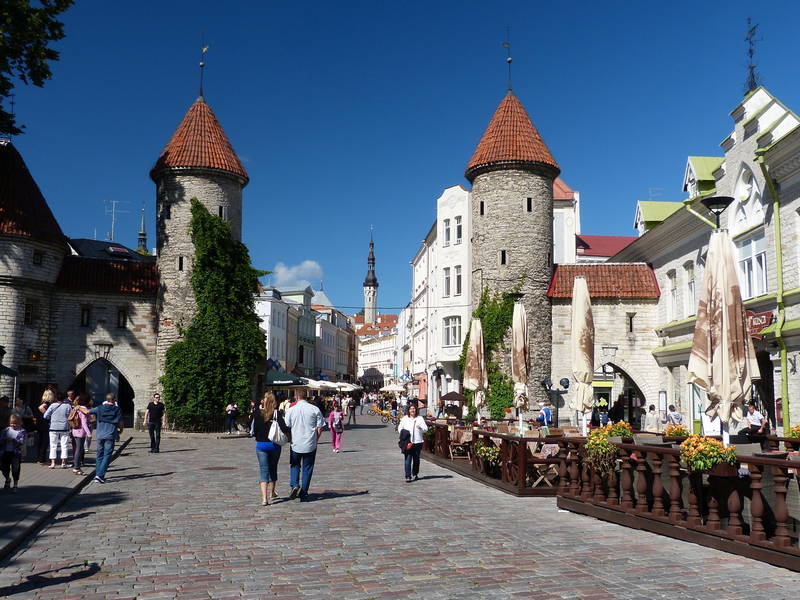
Alexander Nevsky Cathedral
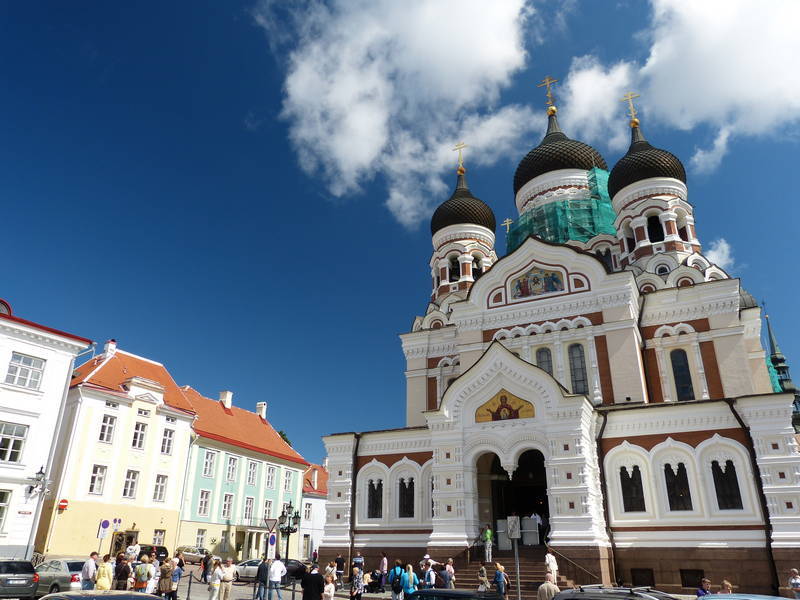
Spectacular view over Tallinn towards the docks
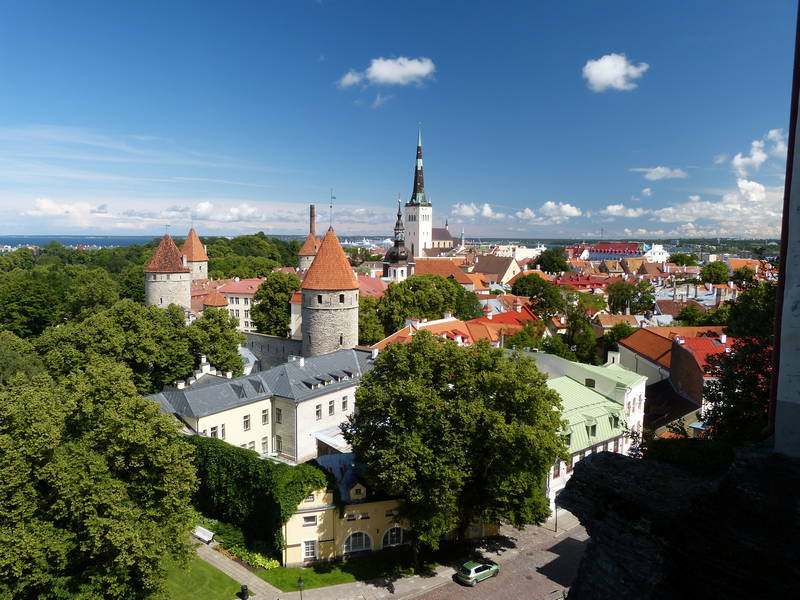
Tall Herman tower

The central square, Raekoja Plats was chock-a-block with sidewalk cafes, souvenir stands, and people. Our guide asked us to find 5 spires from where we were standing, and within seconds, a lady in the group said she had found them. No, only 4. She was sure she had 5, and kept trying to point them out. No, only 4. The guide showed us a special spot where you could stand and just see the top of a fifth spire if you looked carefully between two buildings. After saying goodbye to our great tour guide, we enjoyed lunch of Nuremburg sausages at a Bavarian restaurant, which seemed like the cheapest option. We retraced our steps of a lot of the tour because I had thought we had missed the palace, but it turns out we had seen it. The guide had described it as a government building and didn't mention that it used to be the palace. After a walk up to St. Olaf's Cathedral and Fat Margaret's Tower, we were so done. Fatigue had set in, so we tried to recharge our batteries with some sparkling water and cake at Josephine's. Ekke met his match with this huge piece of cake - too big and too sweet. But I still found more sights on our tourist map that we had not seen, and Ekke kindly joined me as we walked through St. Catherine's passage, the guildhall, and the Black Head Brotherhood house. Back at the yacht club, Ekke noticed that some other campers were using Skype so he tried calling his parents, with success. Did you know Skype was invented in Estonia? Me neither.
Raekoja Plats (only one steeple visible in this photo)

What should we have for lunch? A big beer maybe?

Cool old DKW on the road in Tallinn
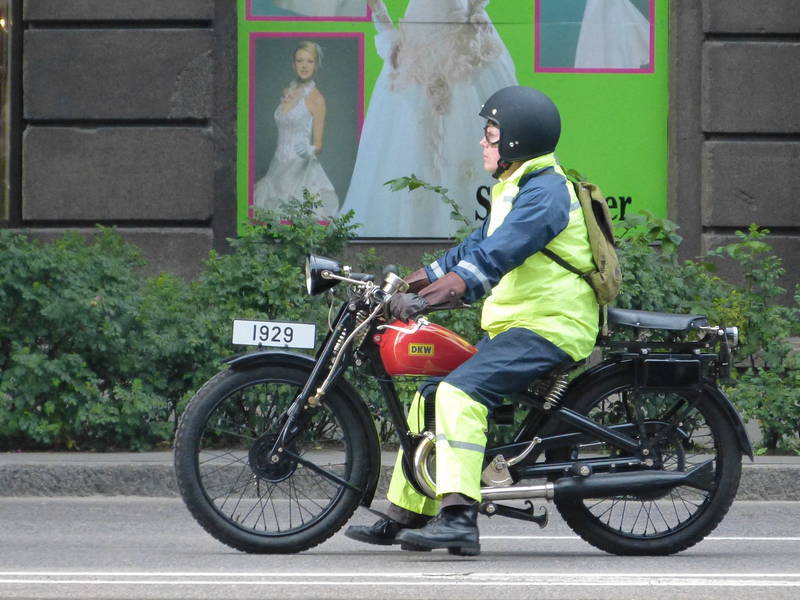
Josephine cake is just too much, even for Ekke
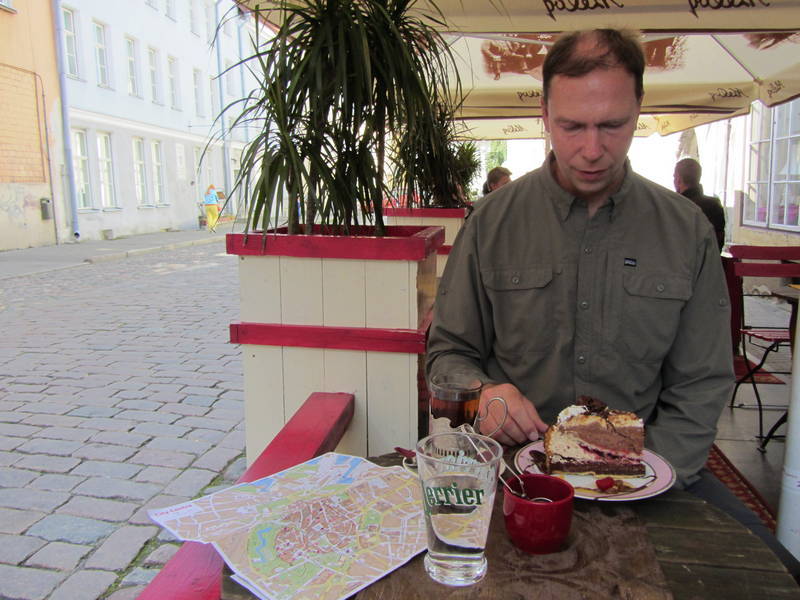
Ekke writes:
Well our first experience camping was a real pleasure and all the equipment seemed to work. The Exped down filled sleeping mattresses were more comfortable than some of our hotel beds and I'm thinking of taking mine into the hotel with me. Too bad we didn't have an opportunity to test the stove for cooking. In any case, we needed to dry everything out after a light, ten minute rain shower in the morning but we were able to do that and make it to the ferry terminal by 9:10. We were directed to Lane 1 which had motorcycles and a Bentley, Range Rover and Porsche Cayenne in it. Cool, motorcycles are treated like First Class. We strapped the bikes down with the provided straps and headed up to the cafeteria for breakfast. With the priority boarding we were actually finished our breakfast of oatmeal (Audrey) and scrambled eggs before all the cars were loaded. The smooth, two hour sail gave us an opportunity to work on the website and sort photographs.
Lined up for the ferry to Helsinki

Working on the website during the crossing

With the warm temperatures and fairly high humidity on the ride north Audrey wasn't terribly happy with the new TourShell pants she had purchased in Calgary so in Helsinki we went out to Heino BMW and checked out their selection of warm weather gear. They had a pair of BMW City pants that fit Audrey perfectly and seemed much more breathable than the GoreTex TourShell pants. Of course, they wouldn't be waterproof but we have rain gear along in case we run into some moisture on the trip. On the ride to the Best Western Hotel Haaga Audrey couldn't wipe the smile off her face. She was really happy with the pants. If Audrey is happy I'm happy. The Best Western was a very modern hotel in Scandinavian style with beautiful furnishings. Would it be our last taste of Western comfort and convenience?
Checking in at the Best Western Hotel Haaga
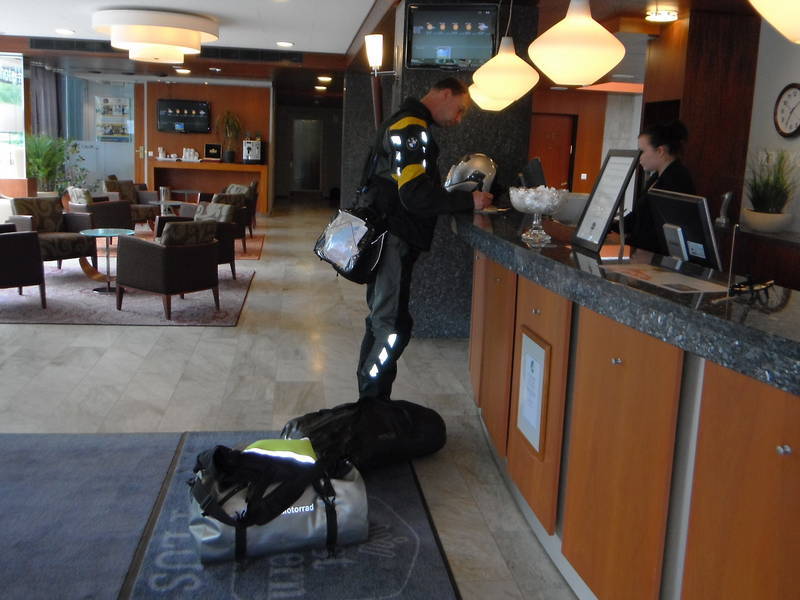
Nice welcome in the room

In the morning we used the hotel's enormous pool (17 metres long) for a refreshing swim and then went for the buffet breakfast. Bus 63 stopped a five minute walk away from the hotel and showed up a few minutes after we arrived. We got off when everyone else did and found ourselves at the main train station in the centre of Helsinki. We wandered around downtown and strolled down the Esplanade Park ending up at a market set up for cruise ship passengers. A cheese and tomato sandwich with a smoothie for lunch had us appropriately fortified to continue our explorations. A glorious church on a rock, Uspenski Cathedral was located near the harbour and was quite spectacular inside. In contrast the Helsinki Cathedral, situated on Senate Square, was very simple and elegant inside. Late in the afternoon we caught the Number 63 back to the Haaga area and had Nasi Goreng at a Chinese restaurant a few blocks from the hotel.
Esplanade Park in Helsinki

Market near the docks at the end of Esplanade Park
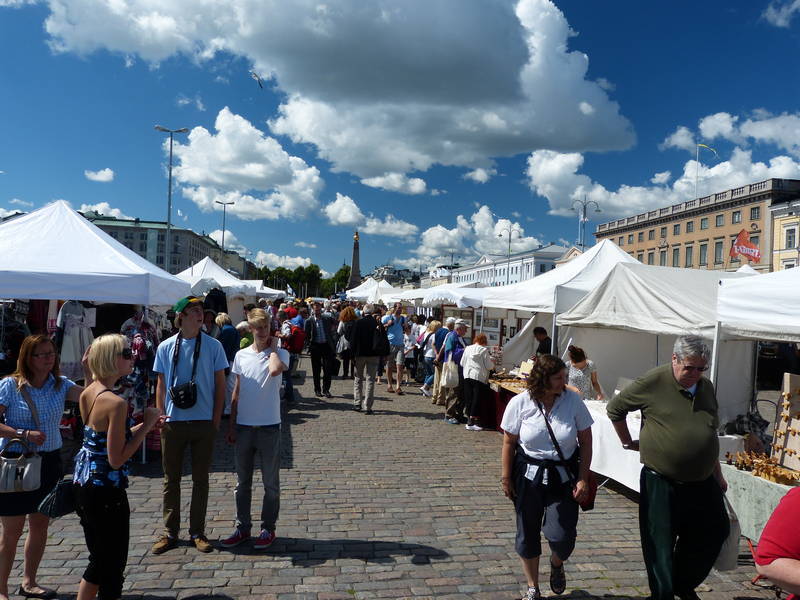
Uspenski Cathedral
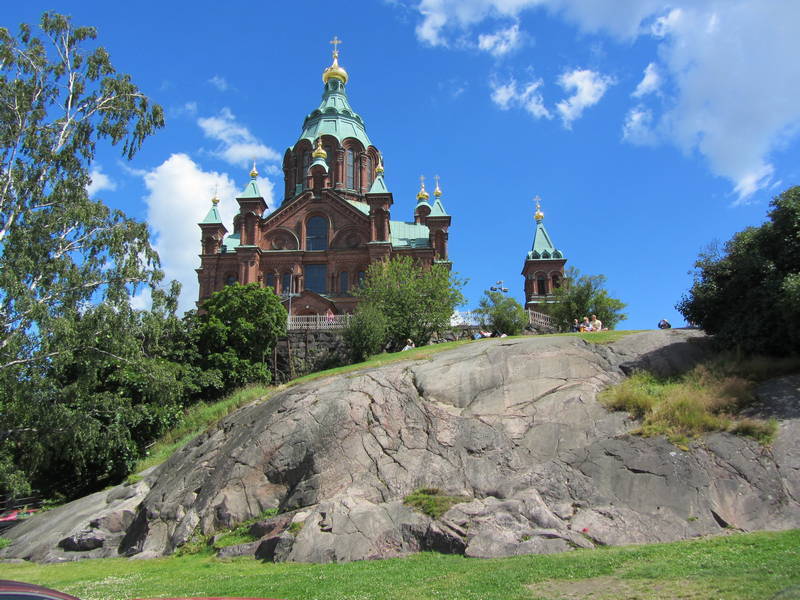
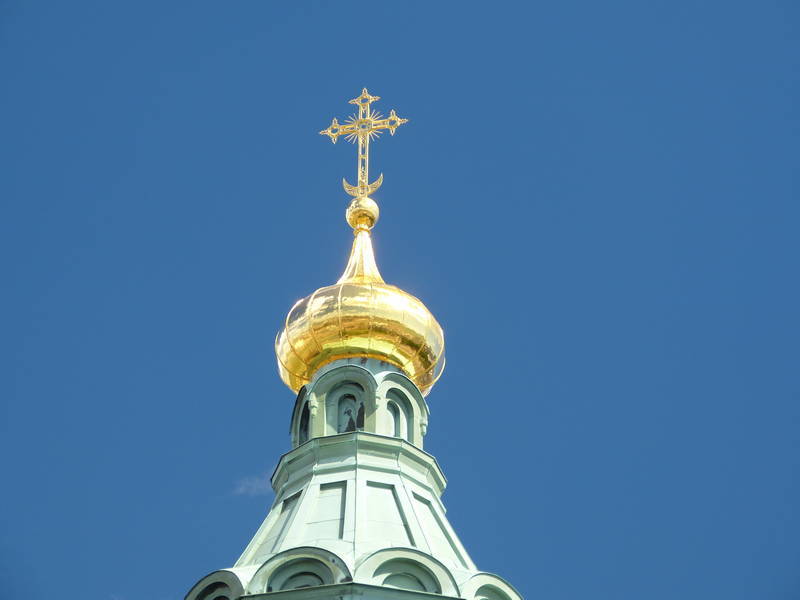

Taking a break
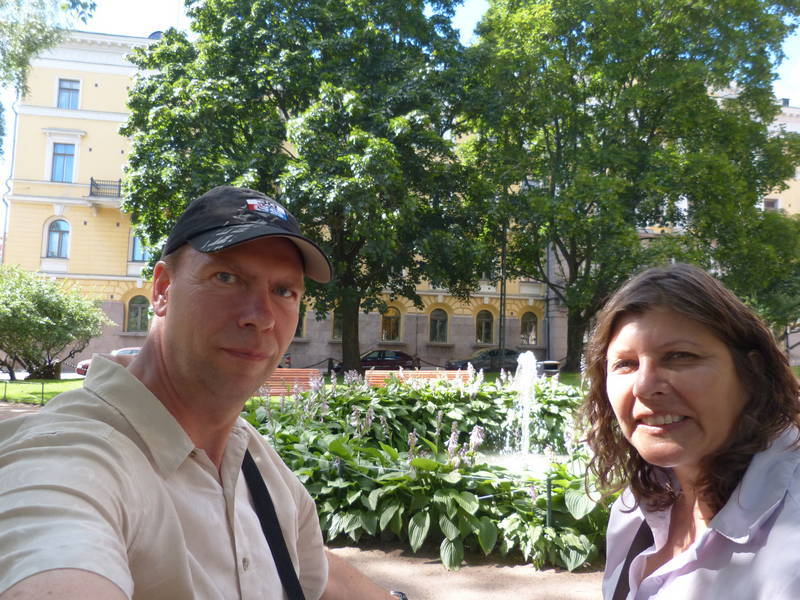
Helsinki Cathedral

Friday, July 20, we got an early start so that we could make it to the Russian border in plenty of time. One of the things that enabled the quick getaway was the checkout with the Best Western Rewards Travel Cards we had been using to pay for our hotel rooms. In every Best Western coming up from Germany it had always been a 45 minute process but in Helsinki it was a matter of moments and we were on our way. Finland was such an easy country to ride in compared to the Baltic States and especially compared to Poland. One could actually sit back and enjoy the ride rather than having to give 100% attention forward (cars passing without regard for oncoming traffic and slow moving vehicles in our lane) and backward (for cars coming up to pass and shoving us off to the side). The last outpost of Western Civilisation for us was a gas station with a market and café so we picked up a few last supplies and rode to the border. The queue of trucks was only a few kilometres long but we had heard reports that they could stretch for 50 or 60 kilometres waiting to enter Russia. We passed them and waited a few minutes to enter the border control point on the Finnish side. Once inside it was a quick stamp in the passport (the first one since landing in Frankfurt) to exit the Schengen countries and we entered no-man's land to Russia.
A stop at a highway gas station for the last taste of Western culture
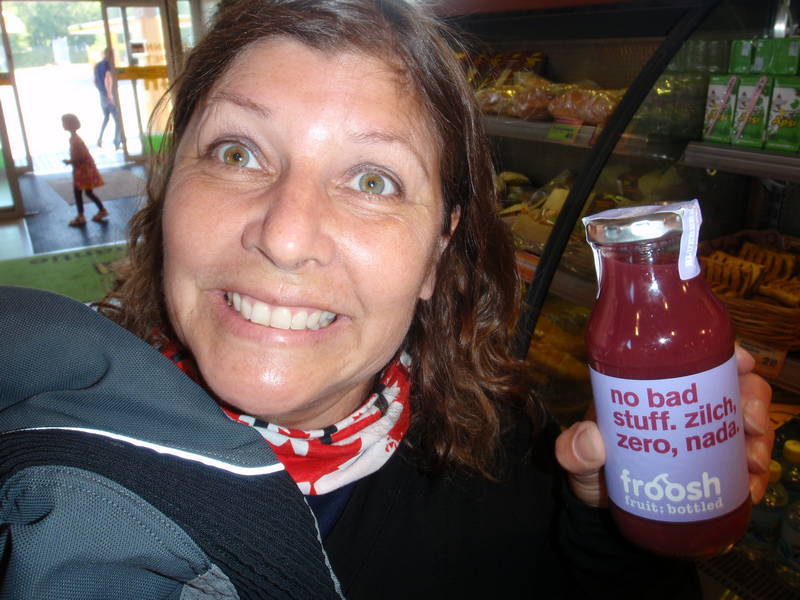
Line of trucks waiting to enter Russia
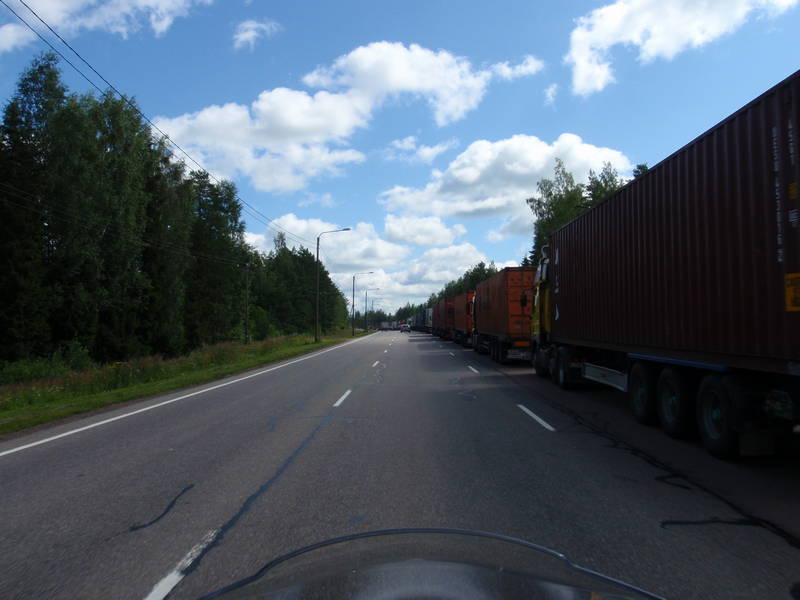
Map of our route from Kronwinkl to Helsinki and the Russian border
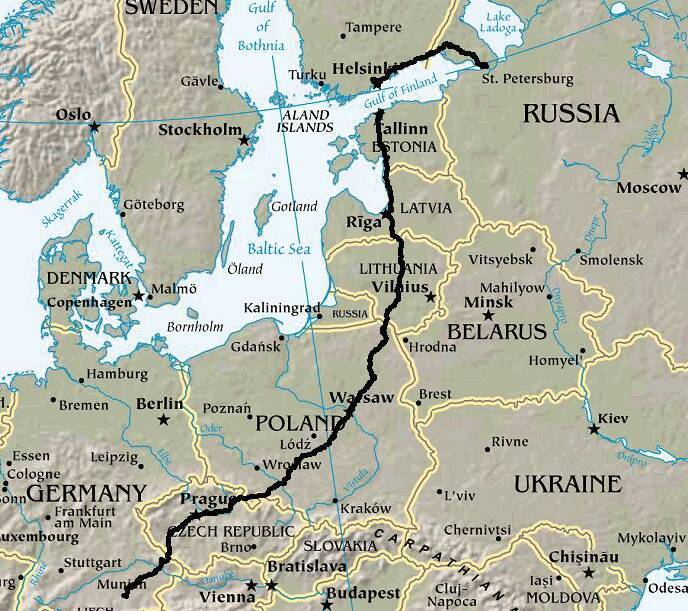
We rode a short distance to the Russian border and pulled up just short of four different queues of cars. A border guard waved us into a slot between queues and soon enough cars started to line up behind us. This was our first introduction to Russian queuing but we were certain it wouldn't be our last. The guard motioned us to a passport control station where we joined a crush of people gathered around a small window. Once up at the front it took quite a while for the official to process our motorcycles as he tried to read our registration papers to find out the colour and so on. We were then able to proceed to customs where we needed to fill in customs declaration forms (in duplicate) and queue up again to have them checked. Overall it wasn't so difficult, the officials were reasonably helpful and it only took a couple of hours or about half the time that it took to enter Egypt. Our European insurance wasn't valid in Russia so we found an insurance seller tucked in behind a gas station to buy it, but we didn't have enough rubles. We had only exchanged 1,500 rubles (about $50) in Canada and the insurance for the entire time we would be in Russia would cost 2,800 rubles. The nearest cash machine (according to the insurance sales person) was 40 kilometres away. Audrey hit on the idea of buying only enough insurance to get us to Kazakhstan so we purchased 15 days for 1,400 rubles.
The GPS showed an ATM in Vyborg so we headed straight there since 100 rubles wasn't going to get us very far. Vyborg was a real vacation town, full of Russian tourists enjoying the beautiful weather and the old town. While the GPS guided us to the right spot we still didn't find the ATM. It took a bit of snooping around to find it hidden inside an old, brick building. Once at the machine I had fun guessing what to do since there were no English language options. Everything was written in Cyrillic. Eventually it spit out 4,000 rubles rather than eating my card. With cash in hand Audrey went to an indoor market and bought lunch, which we enjoyed on the square while keeping an eye on the bikes, which seemed to draw a bit of a crowd. I went in search of a toilet at the market and after a while found a building outside a side door. When I opened the door I was promptly shooed out by a matronly lady. Through sign language she told me to wait and after a few minutes a woman came out and both of them were giggling. Then the matronly woman motioned me inside and pushed me into a filthy stall. When I left the stall the attendant asked for a euro so I showed her a handful of rubles. She took 25 rubles and then literally shoved me out. That was totally not worth it. Especially since I didn't really need to go. Next time I'm going straight to a bush, which is what Audrey did as soon as we left town.
Riding into Vyborg

Central square in Vyborg
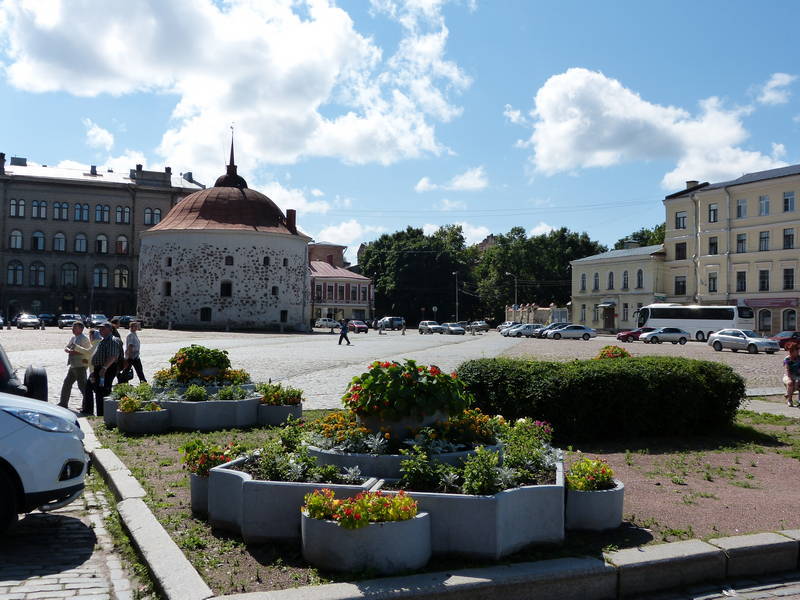
Audrey checks out the location of the ATM
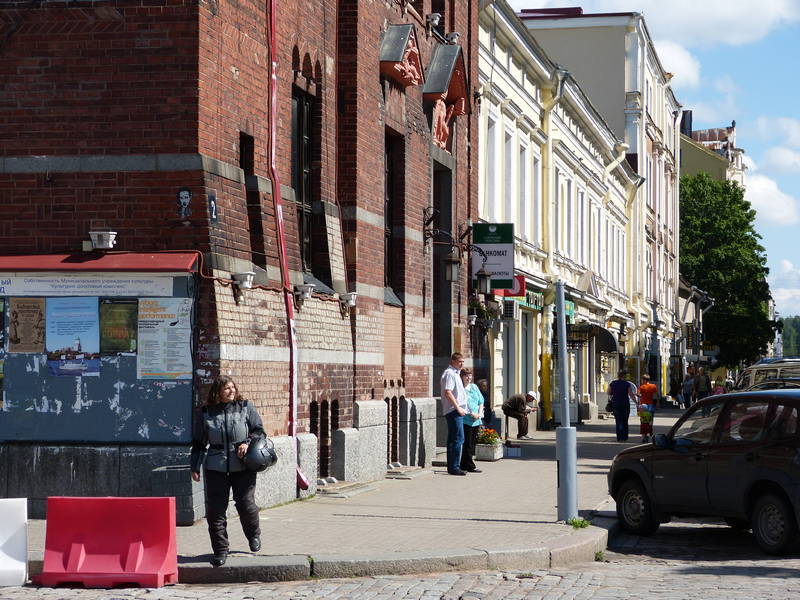
The traffic west of Vyborg was light and pretty good but east, in the direction of Saint Petersburg it got crazier. This was the usual situation where trucks would drive on the shoulder while cars passed on the centreline regardless of oncoming traffic. When we came to a town on the outskirts of St. Petersburg traffic came almost to a complete halt and we crawled along for a kilometre or two while my oil temperature gauge crept higher and higher in the 26 degree heat. With the engine making knocking sounds we squeezed between some cars and a bus to find a small side road that the GPS said connected back with the main road. It was good to move a bit and I think we cut off at least few hundred metres of the traffic jam. After joining up with the main road it wasn't too much further of squeezing between trucks and cars until we got out of town. It must have taken half an hour to go two kilometres.
St. Pete was having a bit of a construction boom that made the GPS maps a trifle inaccurate. As a result we got turned around and had a bit of a tour of the suburbs. Using dead reckoning we were able to go in the general direction of the Anichkov Bridge Hotel and soon found ourselves riding beside the Fontanka River. We parked the bikes and I walked up and down the street looking for the hotel but there weren't any signs for it. I walked around a barrier into a courtyard and there was a tiny plaque on a door with the hotel name. I was buzzed in and climbed to the second story where I confirmed I was indeed in the right spot.
Pulling up near the Anichkov Bridge Hotel
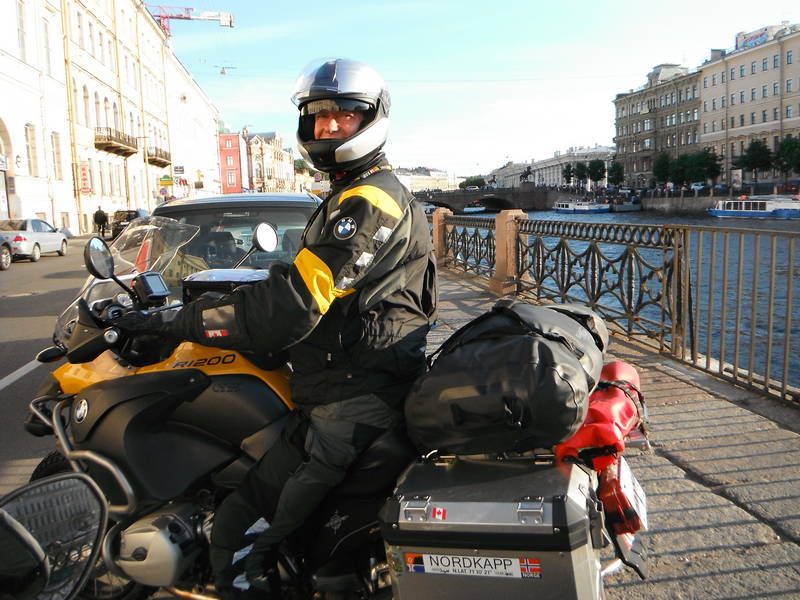
A small plaque on the door inside the courtyard is the only clue there is a hotel here
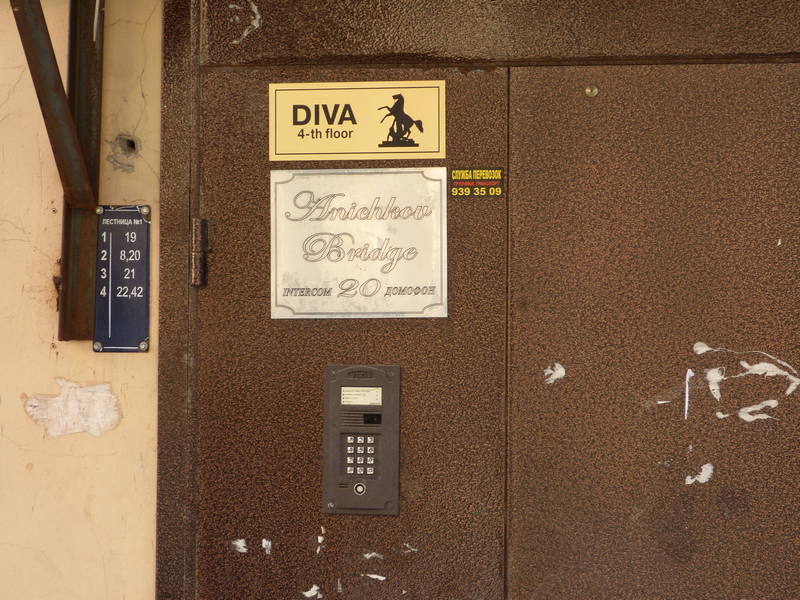
Audrey writes:
After a bit of a rough start trying to ride through the city, it was magical arriving on the street of our hotel beside the Fontanka River. Historic buildings lined both sides of the river, which really resembled a canal, and I could see Anichkov Bridge with its four horse statues. I had to shake my head - we were in St. Petersburg, and it was beautiful. After parking on the street, Ekke went to look for the hotel. The address was correct but we couldn't see any hotel sign at all. As I waited I chatted about our trip with a friendly local, Deima, who had pretty good English. The Alberta license plates are always a good conversation opener. He was curious as to where we were going and was quite impressed when I said we were riding to China. He probably knew about the interesting Russian roads that awaited us. I asked him how he knew English and he said they get some English classes in school but it was at college where he really learned it. Ekke had found the hotel through a courtyard opening between buildings, and there was a small sign over a door, 'Anichkov Bridge Hotel'. We rode right over the sidewalk, through an archway, around a barrier and then parked in the courtyard. The concrete stairway up looked very decrepit, so I didn't have high hopes but our room wasn't bad, newly renovated and clean. Also, it was very central, just off Nevsky Prospekt, a bustling street of restaurants, monuments, cathedrals and a historic shopping mall. Deima's suggestion of a little Italian restaurant for dinner worked out well, and we strolled along the canal, stopping to activate the Spot Tracker.
The stairwell doesn't look promising...

After a quick breakfast on July 21, we decided to do a walking tour laid out in Lonely Planet. We had lost an hour crossing the border to Russia, so it was difficult getting up early. It was very pleasant walking up Nevsky Prospekt and it was just unbelievable how many really outstanding buildings we saw. At one time, everyone wanted to live on lively Nevsky, and a lot of nobles built huge mansions with courtyards there, all highly decorated with classical statues or columns. Our walking tour went out the window when we looked down one street. At the end of the canal was the most beautiful sight. Golden domes sparkling in the sunshine, more domes a riot of colours, greens and blues and yellows, looking like giant soft ice-cream cones. We had to go check it out. The structure was the Church on Spilled Blood and was built on the spot where Tsar Alexander II was assassinated while riding in his carriage. What a great monument to him. After paying a small fee we were able to go inside. Every centimetre was covered in a beautiful mural depicting biblical scenes, gold and marble everywhere. We were awestruck.
Time for a quick breakfast
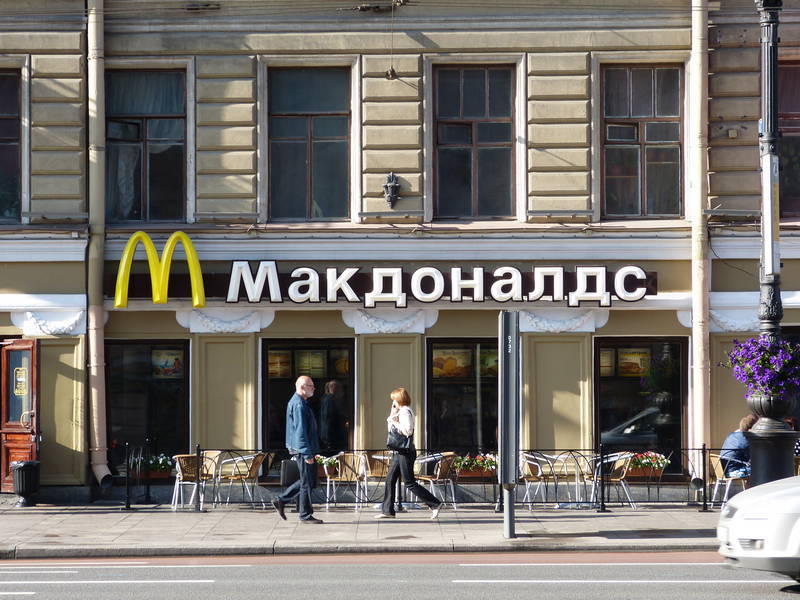
Wow, Church on Spilled Blood grabs our attention
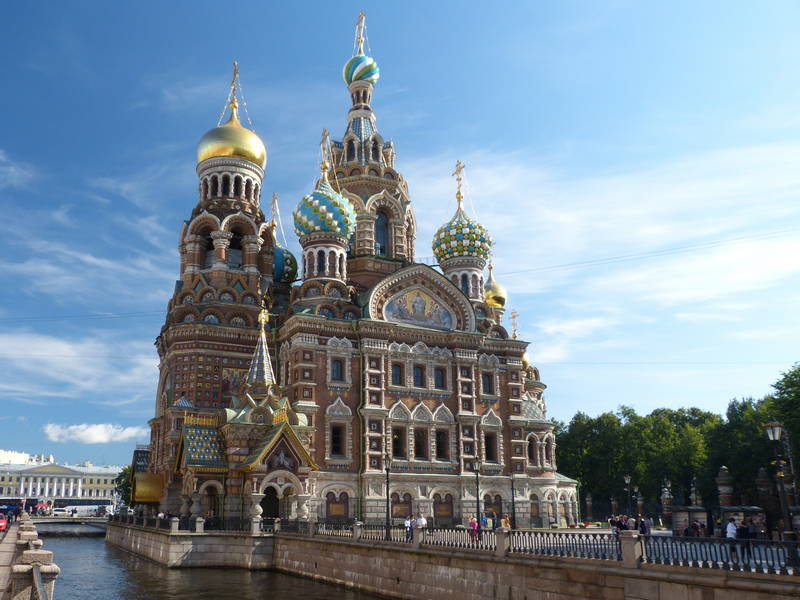
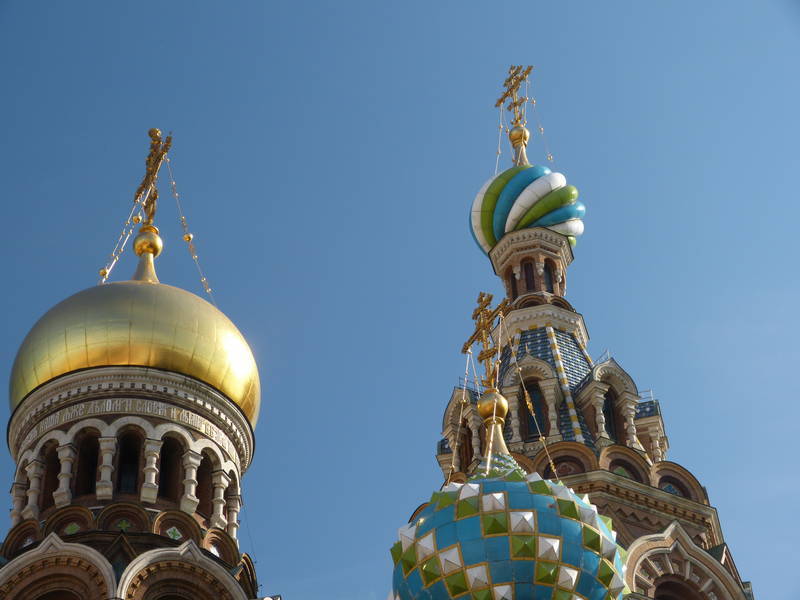
Stunning interior too
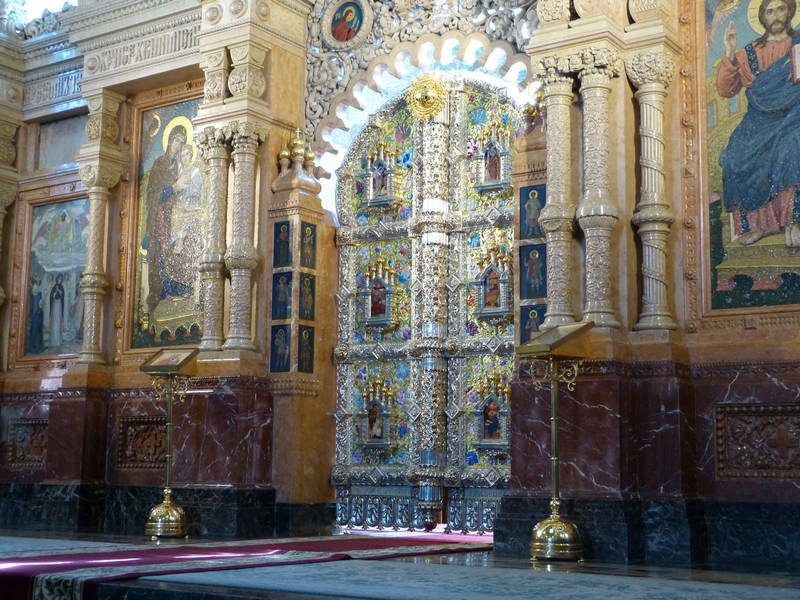

Our landlady told us to come back to the hotel between 11 am and 2 pm to register, one of those tasks that visitors to Russia must take care of. Usually a hotel can register for you, and it must be done within three days of entering the country. We came back at 11 but she told us she couldn't register us at that time, which was too bad because we'd walked back quite far just to register. But she said to just leave our passports and she'd get it done. Could we not have done that in the first place and not broken up our day coming back? We picked them up later that night with a new slip of paper inside.
Taking a break along Nevsky Prospekt after registering

Our priority in terms of sights to see in St. Petersburg was the Hermitage, a huge palace stuffed full of European art and artefacts from many different countries. The building itself is the former Winter Palace, and everyone from Peter the Great to Catherine the Great to Tsar Nicholas and Alexandra lived here, or in some version of it. It was quite stunning, painted mint green with white trim, tall pillars, and Greek-inspired statues lining the top. It's not the biggest art museum in the world, that honour goes to the Louvre in Paris but we were able to spend hours wandering amongst the priceless Da Vincis, Picassos and Matisses. Ekke loved the Dutch masters, like Rembrandt, especially the scenes of life in the Netherlands. What a coincidence that a Calatrava exhibit was on, the architect of the new red Peace Bridge in Calgary. He's designed some amazing structures and a lot of models were on display, mostly white suspension bridges, airports or train stations. No photos allowed, though. I got in big trouble from an attendant who said, "Nyet," when I touched one of the buttons to make some wings flap. I did notice, later, all kinds of buttons were being touched by others and they weren't getting into trouble. Sheesh. In one room, Ekke and I sat on what was surely the only bench in the Hermitage and stared at a beautiful painting for ages. We couldn't read who the artist was and neither of us was going to leave our seat to find out, so Ekke used his superzoom lens on his camera to take a picture of the info card across the room. Snyders. In the Egyptian room one sarcophagus was on display, protected in a hermetically-sealed case, so lovingly taken care of. Ekke and I just chuckled, recalling the hundreds of sarcophagi we had seen stacked in the Egyptian National Museum in Cairo in 2007, many of them covered in layers of dust. Lonely Planet suggested a few prized pieces of art to go see, so we followed the map through many of the 1500 rooms trying to find them. A display of Japanese armour and weaponry was interesting, as well as a hall full of portraits of Russian generals. And there was always more to see, room after room of beautiful furnishings, chandeliers and painted ceilings. So, we stopped when our feet got too sore to go any further. We weren't the only victims of the Hermitage that day; Some of the ladies hired to monitor the displays were definitely nodding off - I'm sure I heard snoring.
Sneaking a photo of a Calatrava model

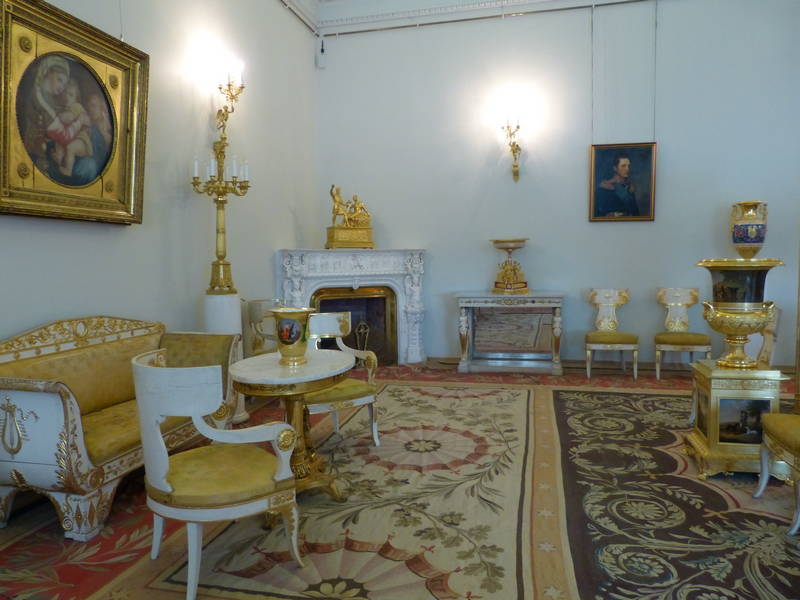
Hall of Portraits of Generals
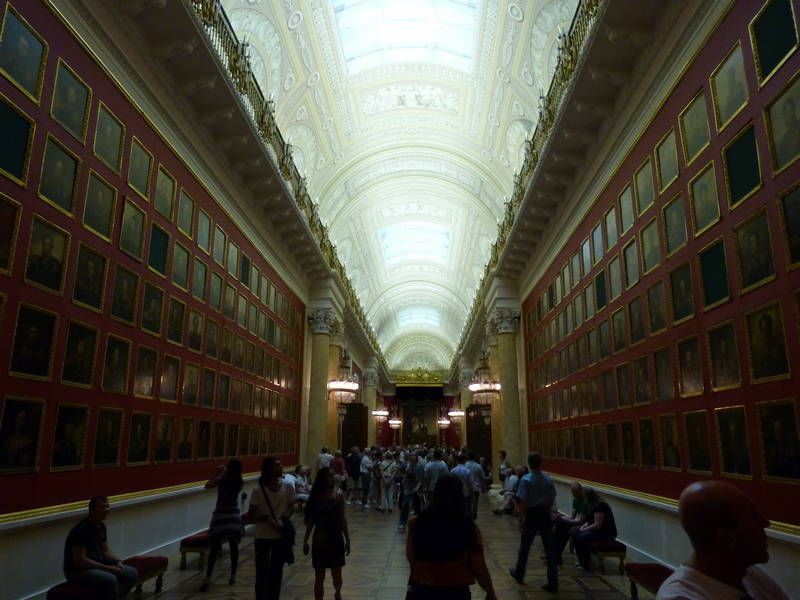
Ekke's favourite General


DaVinci

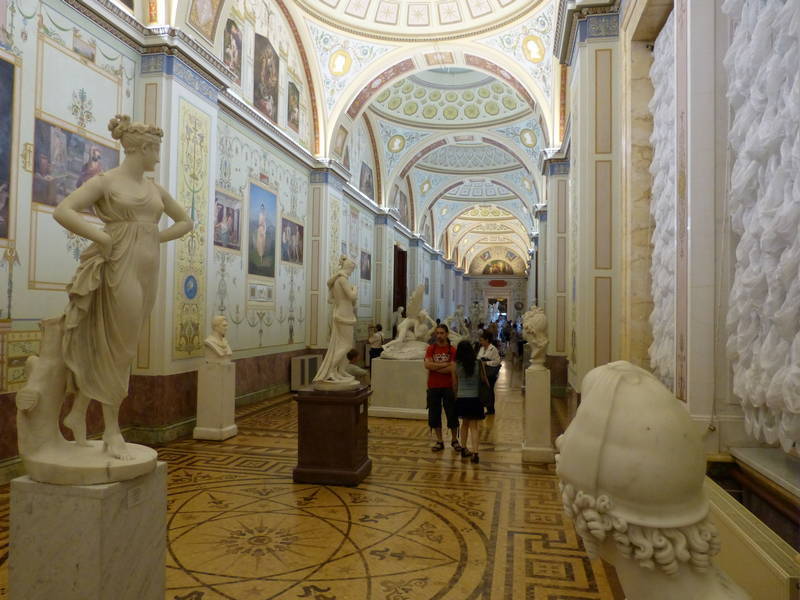

Rembrandt

A Snyder painting. Time to have some seafood?

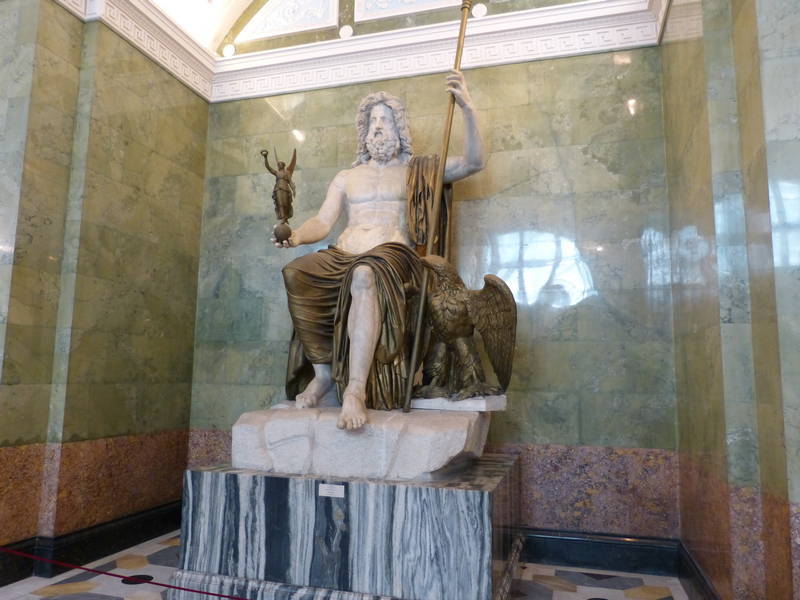
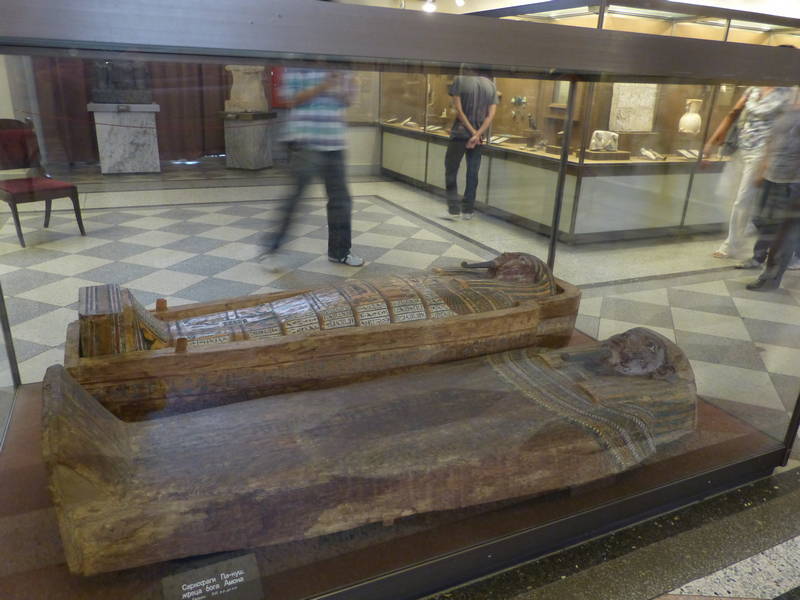
Picasso
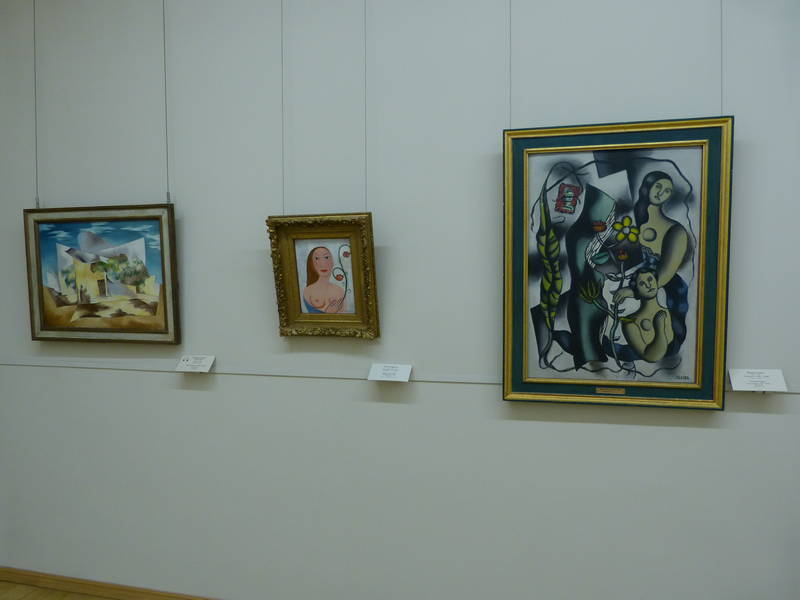
Van Gogh
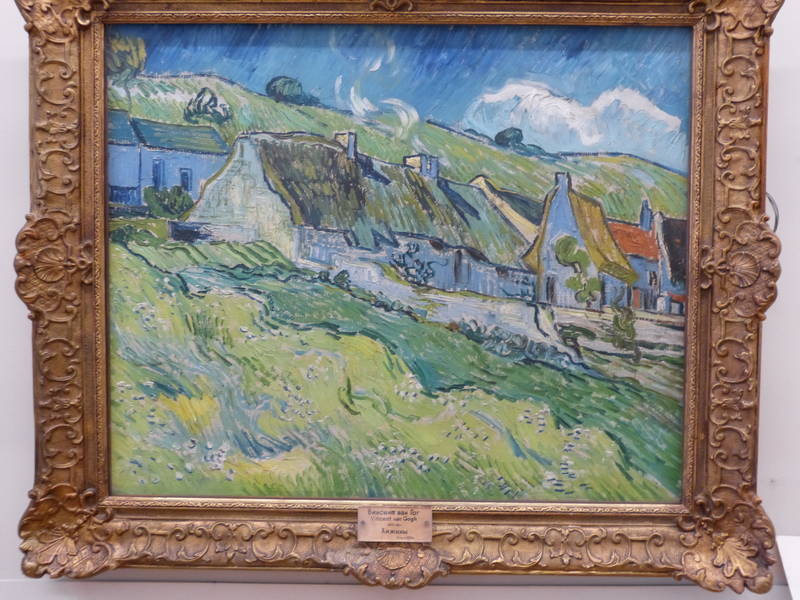

Does this look a little like the scene in Raiders of the Lost Ark?

Back outside, it felt great to walk along the Neva River at a faster pace than in the Hermitage, which is really more like standing. The statue of the Bronze Horseman dominated Senate Square near the river. It was quite spectacular to see, and is a symbol of the city. The rock it sits on took two years to be moved from Finland. Behind it was St. Isaac's Cathedral, one of the biggest in the world. Climbing the 227 steps of the belltower was something we chose not to do as we dragged our weary bodies through the streets of St. Petersburg. Across the street at a park we perked up when we saw hundreds of bear statues. When we went over to investigate, we noticed there was one bear for each country, all side by side, colourfully painted. It was fun to see how countries represented themselves, with painted landscapes or cultural icons. The Canadian bear was a bit of a mystery to us, but we interpreted it as the colours of the land from sea to sea to sea. I think St. Petersburg picked up the idea from Buddy Bears in Berlin and made it into United Buddy Bears, a symbol of peace and tolerance throughout the world.
Outside we had missed a rain storm but caught a nice rainbow over the Hermitage

Peter and Paul Fortress across the Neva River
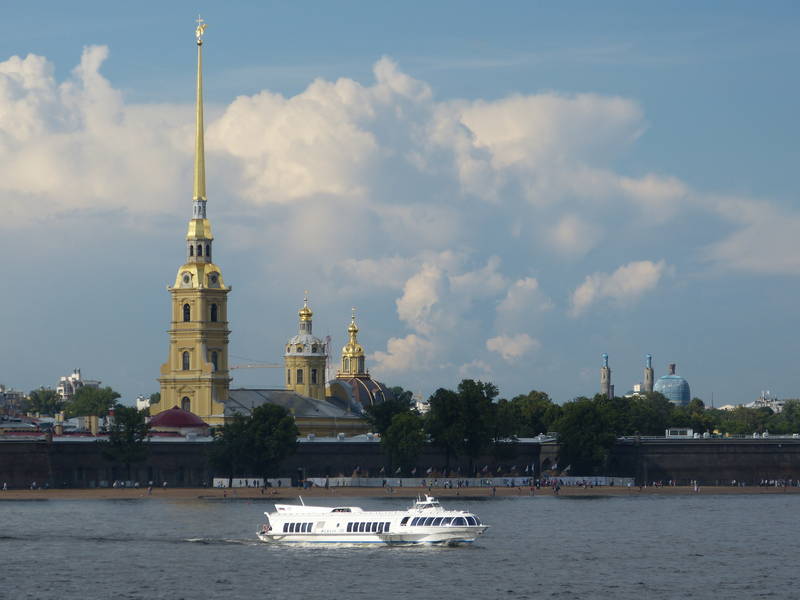
The Bronze Horseman

Loses the impact when Peter the Great checks his phone for messages
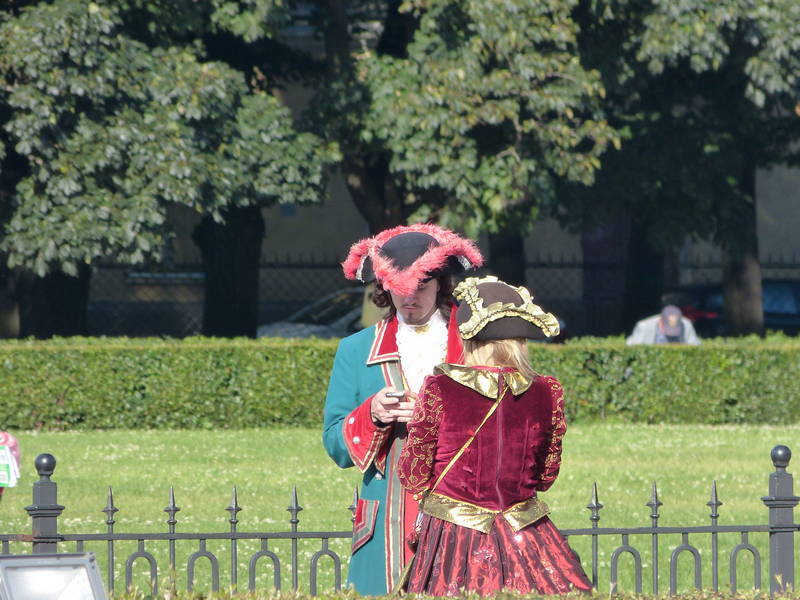
Pancakes and caviar! A bit too salty for Ekke's taste but something different
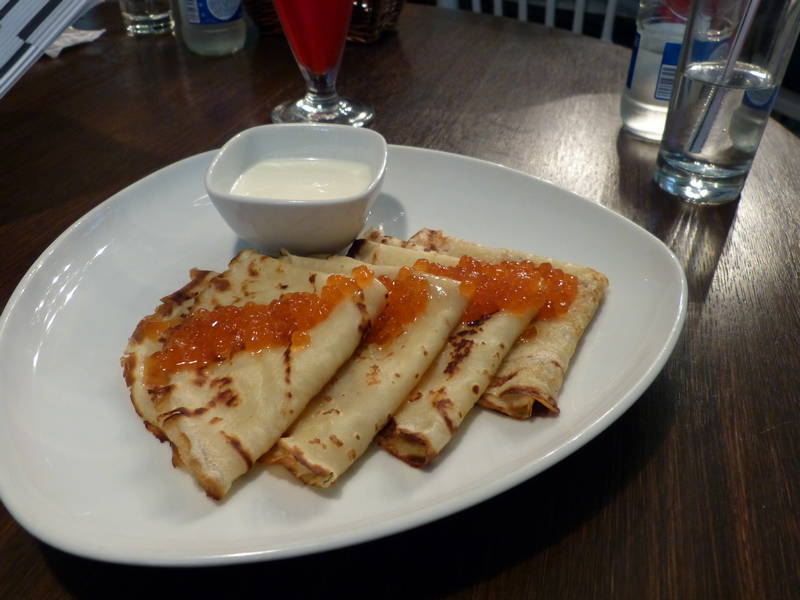
Ekke gets friendly with one of the Buddy Bears

The Canadian Buddy Bear
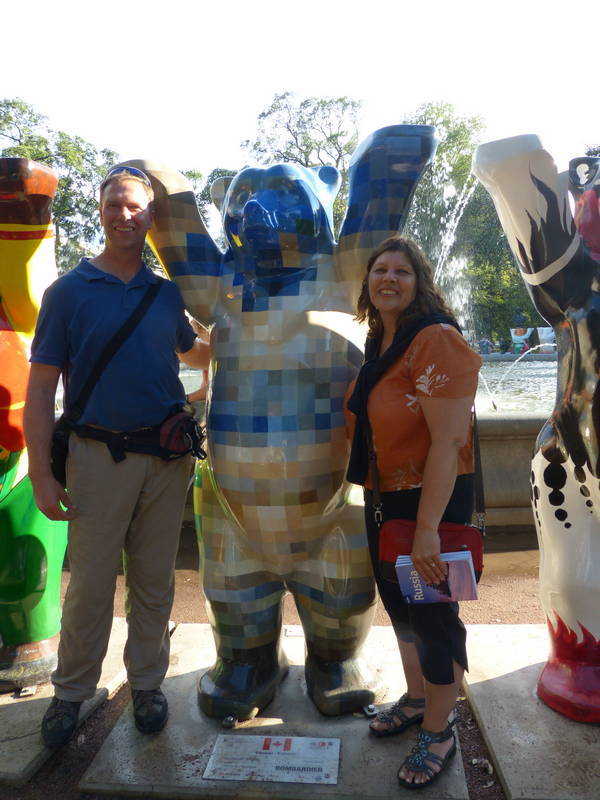
The light was good as we head home so took a picture of something...
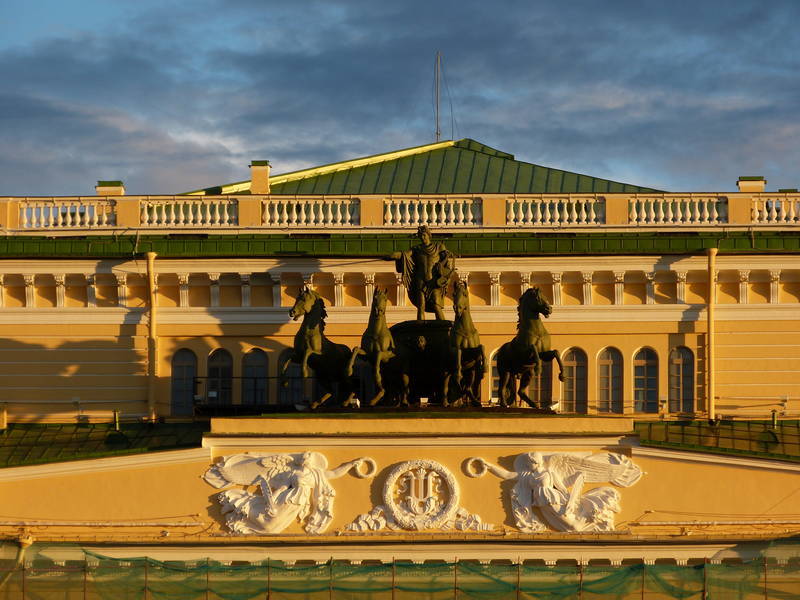
A short walk from our hotel the next morning, July 22, we found a great breakfast place, Pancake and Wok. I got a steaming hot bowl of oatmeal and Ekke tried the omelet. The choice was mushroom or cheese. Ekke asked if he could get mushroom and cheese, but the guy just said, "No." Ekke tried again, but there was no way they could do that for him. It was just one or the other. Very strange. Whenever we ordered omelets after that we were very happy when they let us have more than one ingredient. The hop-on hop-off City Tour bus was a life-saver that day as we walked a bit less and learned a lot from the English commentary through our headphones. But we had to change seats three times to find a headphone jack that worked. While the bus waited by the Winter Palace the commentary said that in the centre of Palace Square is the Alexander Pillar, the largest single piece of granite in the world, and at 600 tonnes, is supported by its own weight. The face of the statue of the angel on top coincidentally looks like Alexander I's face. We also learned that when the Bolsheviks took control of the Winter Palace, their armed guards helped themselves to the wine and emptied the wine cellar within a month.
Waiting for an omelet

Royalty in St. Petersburg

The Palace Square
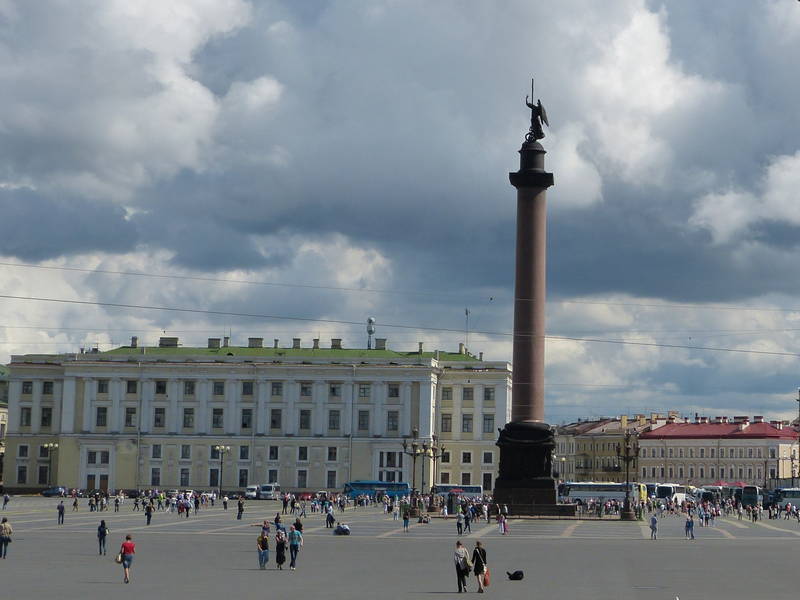
The bus took us across the Neva River to the Aurora, a huge Russian warship. This cruiser was used in the Russo-Japanese war but it is probably best known for having fired the first shot that started the 1917 revolution. A walk along the river took us past Peter the Great's cottage, the first residential building in St. Petersburg. The Peter and Paul Fortress nearby is a huge complex that has so much to see and do. It was built in 1703 for protection from Sweden. We walked by tombs of Peter the Great and Nicholas and Alexandra in the huge cathedral, a museum that took us through the building of the city, and the notorious high-security political jail. Dostoyevsky had a stay here before being sent to Siberia, and we found the cell that Trotsky stayed in. A sort of unrelated exhibit on Cosmonauts was actually quite enjoyable. It was very cool to see a replica of the Sputnik, space-dog photos, medals received by cosmonauts, and a re-entry capsule. We had to patiently wait our turn for kids to move out of the way so we could get our photos taken at the spacesuit display.
The Aurora

Wandering the park over to the Peter and Paul Fortress
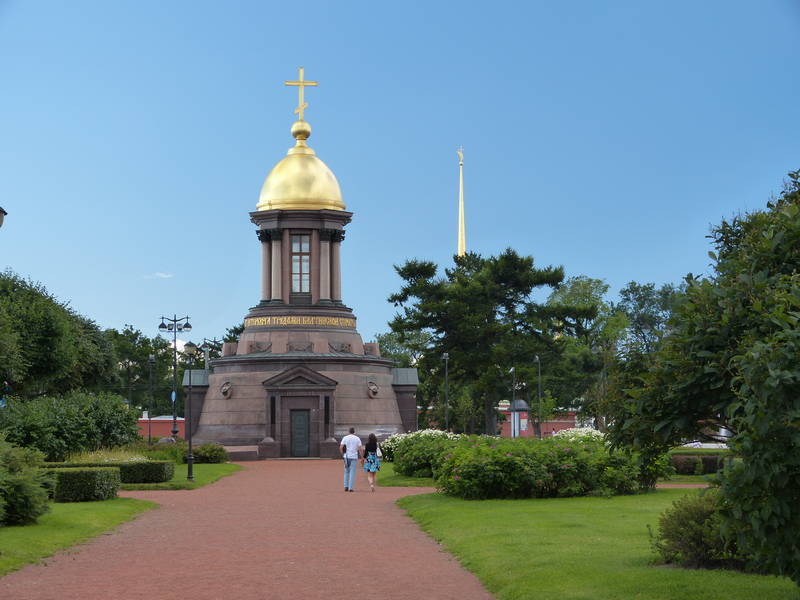
You could get a 15 minute ride in a Sikorsky helicopter for 3,000 rubles ($100)
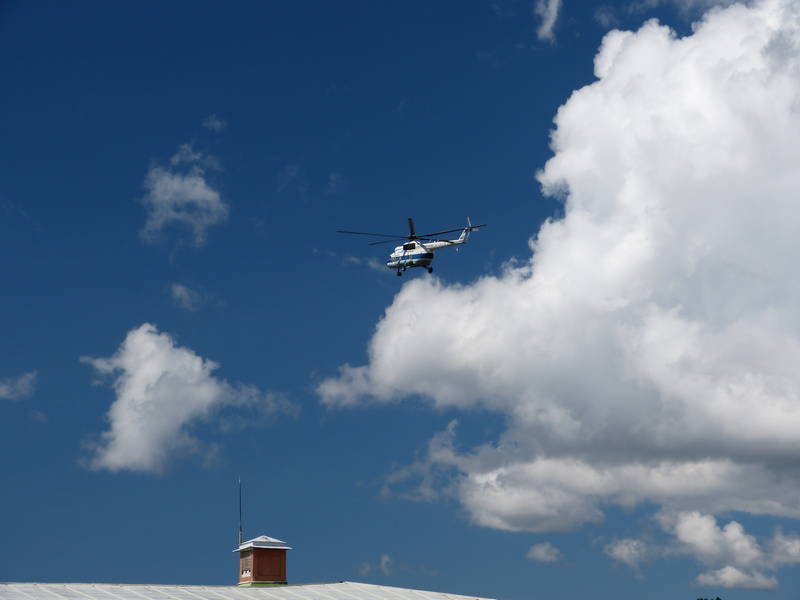
Saints Peter and Paul Cathedral inside the Peter and Paul Fortress

A Rodin exhibit was happening at the time so they had the Burghers of Calais on display outside
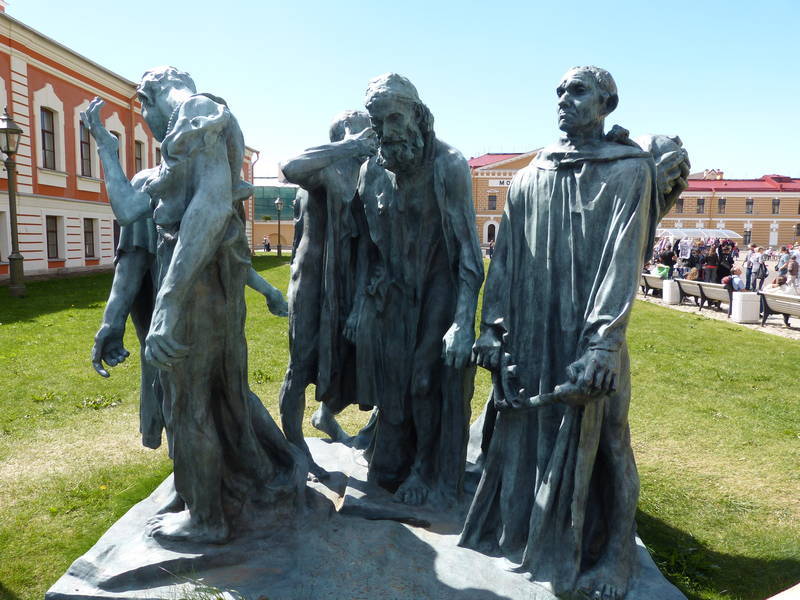
Ekke loves antique maps

And apparently antique dishware
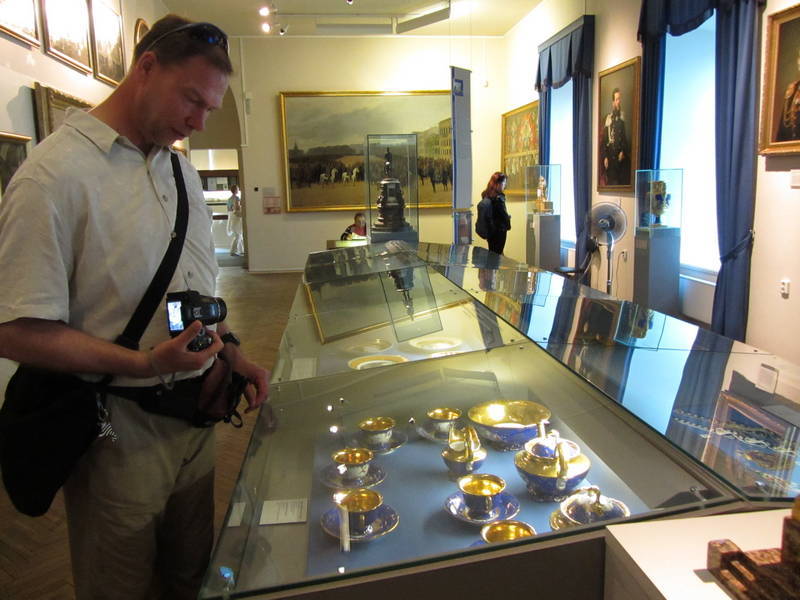
Trotsky's cell
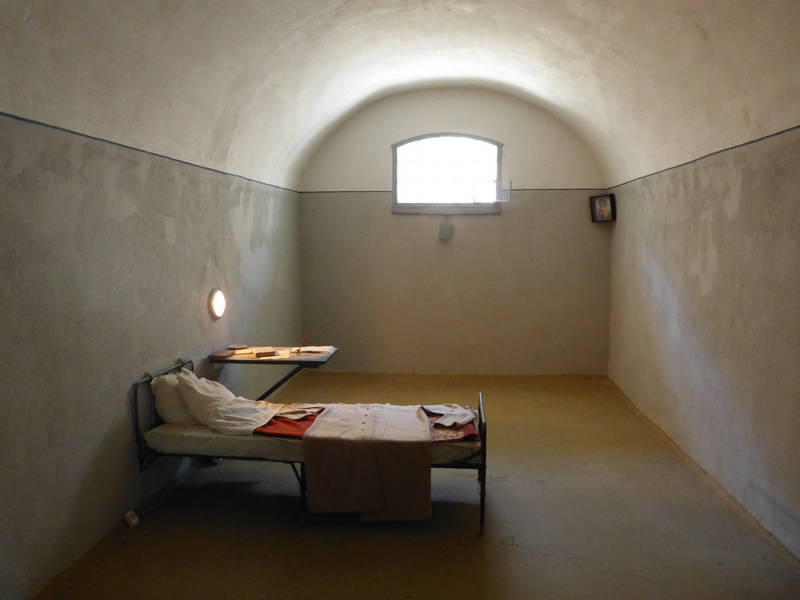
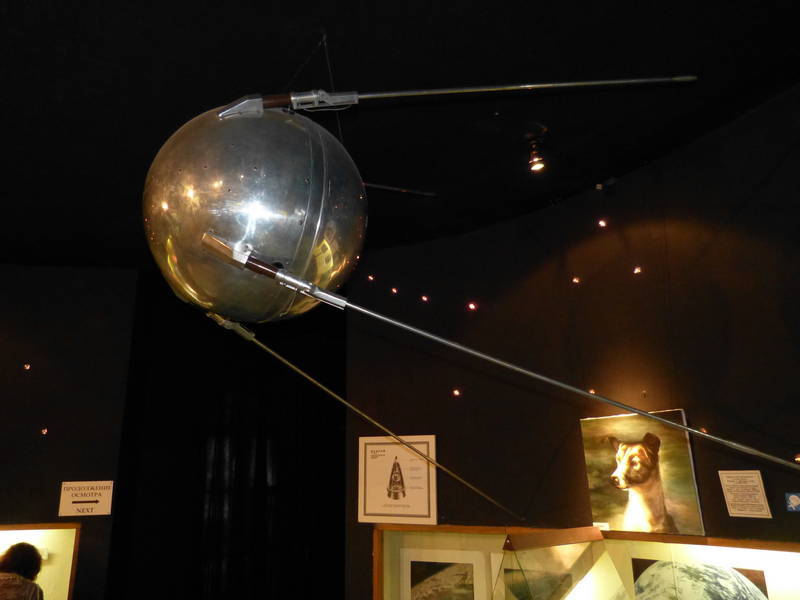 Life-size replica of Sputnik
Life-size replica of Sputnik
Audrey looks ready to be a cosmonaut. Not that much different from a motorcycle outfit.

The Fortress was great for weddings but this bride's wardrobe malfunction might push her over the edge

Tiny portions of fettucini at an outdoor cafe on Nevsky Prospekt were barely adequate for dinner so we made up for it with a couple of big desserts. I heaved a sigh of relief when I saw pictures on the menu and we could just point to lemon cake or tiramisu. The highlight of this cafe was the people watching. It was like having a front row seat at a fashion runway. There was barely a woman without high heels on, and we wondered how they could spend all day in them like that, and then go out for an evening stroll. They also put a lot of time, thought, and presumably money into clothes, mostly dresses and skirts, very stylish with a perfect fit. Men just dressed fairly casually, outdone by the women, and they got to wear comfy shoes. A lot of fancy cars went by like Bentleys, Hummers and even the odd Ford Focus or two. Motorcyclists used Anichkov Bridge as a launching point for block-long wheelies, sounding like a superbike race. The sight reminded Ekke of a Cycle Canada cartoon where a dad explains to his son to look both ways and listen for the sound of a grinning demento pushing the needle deep into the red zone before crossing the street. We noticed that there were mostly sports bikes in St. P., so our Gelande-Strasse bikes always got a lot of attention wherever we went.
People watching at a cafe along Nevsky Prospekt (this was the only woman in St. Petersburg not wearing high heels)

An English boat tour was leaving at 7:00 pm from a dock just outside our hotel, so we climbed aboard. Alas, there was no room on-deck, so we sat inside. The commentary was given by a real person, so we didn't have to search for headphone jacks that worked. The boat chugged up the Fontanka River past royal summer gardens and out onto the larger Neva River. Our guide showed us the huge marble palace that Catherine the Great had built for one of her lovers, and her own little comfy palace nearby. Bigger boats roared past our tiny craft, and we could hear squeals from the tourists on deck as they got splashed by the waves. Ha ha. The boat cruised by the only castle in town, Mikhailovskiy, fortified by Tsar Paul I with a drawbridge so that he would be safe from assassins. It didn't really work as he was assassinated in his bedroom 40 days after moving in. The boat took us back close to our hotel as the sun slowly sank over our last evening in St. Petersburg.
Starting the boat tour

A water level view of the Hermitage

Ekke writes:
We packed up on Monday the 23rd and walked over to our favourite pancake place on Nevsky Prospekt but were disappointed to find it wouldn't open until 9:00 AM. McDonald's seemed to be the only restaurant open at 8:30 so it seemed to be our only option. Getting on the bikes after checking out we thought we could try getting our bikes to the Palace Square at the Hermitage for a photo and sure enough it was easy. There were even a couple of young men that were happy to snap a few shots of us. Another volunteer was found at the Church on Spilled Blood to take our pictures with the bikes and church.
Heading out of town via the Palace Square at the Hermitage

Stopping at the Church of Spilled Blood

Catherine Palace on the southeastern outskirts of St. Pete was our next stop. We purchased tickets to get in the palace grounds and then were told to go queue up for the Noon entry. We joined the back of a queue at 11:30. At Noon about 30 or 40 people were let into the palace and then it was another twenty minute wait before more were let in while the queue didn't move at all. What was happening was that tour guides would hold the place for a tour group and then when the guide got to the front, the entire tour group would enter. Surely there must be a better way. In any case we got into the palace at 1:00 PM, put on special slippers and picked up headsets. The headsets allowed you to hear the Russian tour guide. There were no English guides so we returned the headsets, joined a tour and just ogled the luxurious, ostentatious palace. We were able to break free from our group and just walk around the palace following and passing other tour groups. The amber room was especially spectacular where the walls were completely covered in amber. No photos allowed here though. Seeing all of this incredible luxury really brought home why the Russian revolution happened when a very, very few had such incredible wealth and the bulk of the population had virtually nothing.
Audrey rides up to Catherine Palace

Queue up for 1.5 hours


Losing our tour group at the hall of mirrors
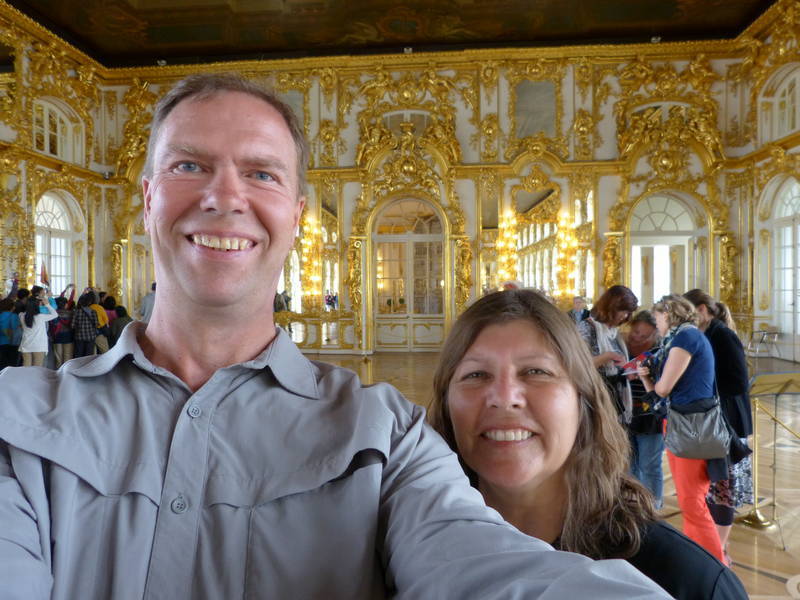
Catherine was a "hippy" woman
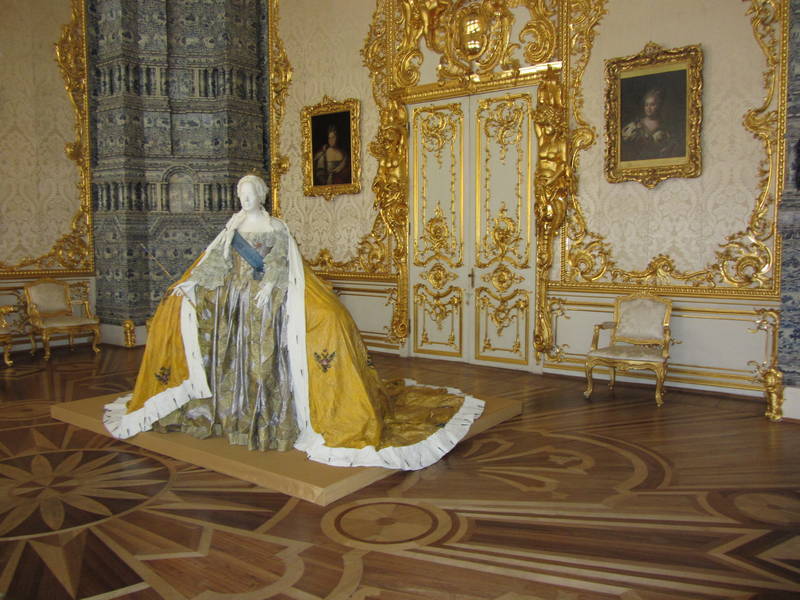
Slippers on so that we didn't mar the wood floor. Nice BMW roundel.
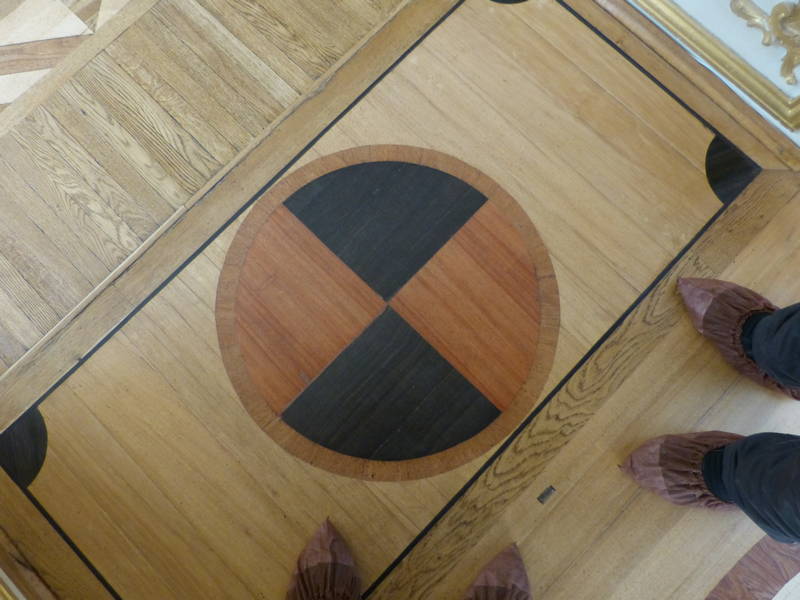
A discrete photo of the Amber Room from another room

After walking around the palace grounds in a light rain we went for a donair at a small restaurant on a side street. It seemed to be frequented by tour bus drivers as they waited for their passengers to tour the palace. Properly fortified we jumped on the bikes and rode to Novgorod, arriving at about 6:00 PM. The 4,500 rubles for the Volkhov Hotel was a bit steep but it was nicely located near the Novgorod Kremlin. After dinner at a restaurant down the block we walked to the kremlin and wandered around. The oldest building in Russia was to be found here; St. Catherine cathedral dated from 1050 AD. I really enjoyed wandering around the grounds and over the Volkov River without the madding crowds of the other sites we had visited.
Audrey strolls the gardens at Catherine Palace on the way to a donair

The Volkhof Hotel in Novgorod

The outer walls of the Novgorod Kremlin
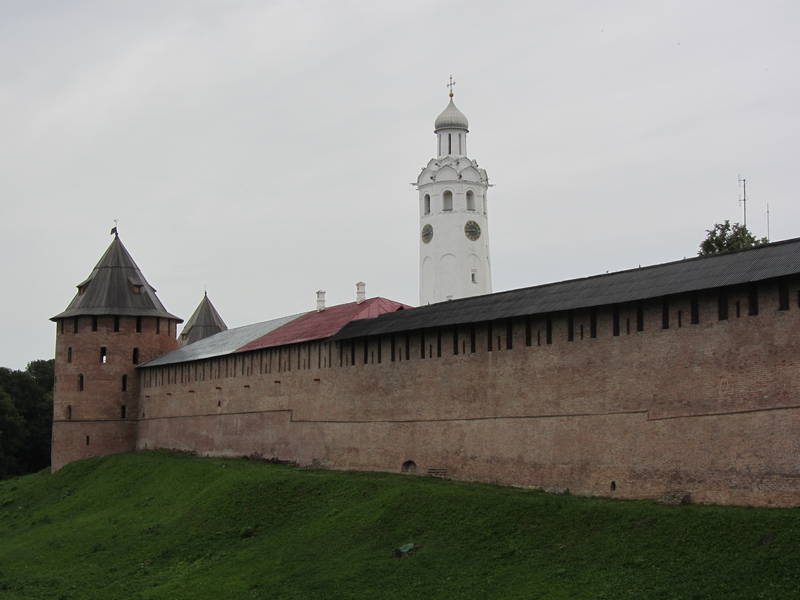
The oldest building in Russia is the Saint Catherine Cathedral from 1050 AD
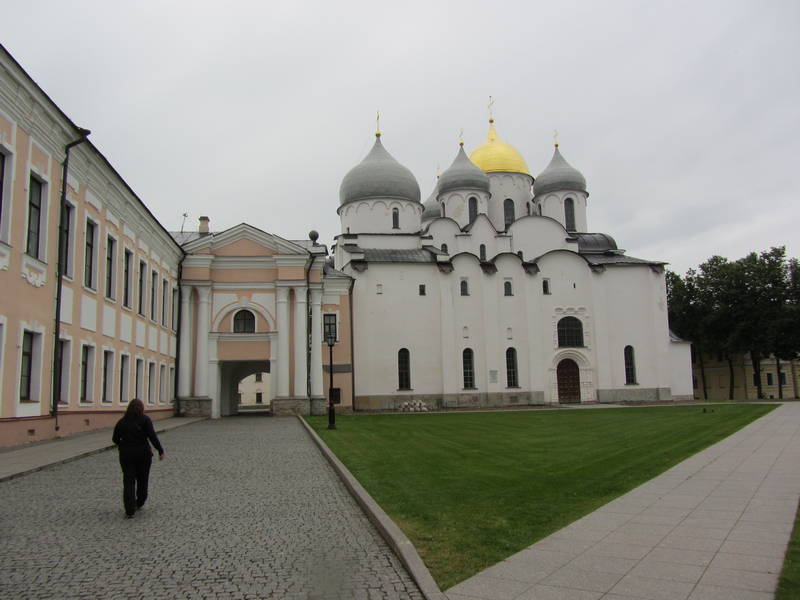
That is a big bell

The breakfast buffet at the Volkhov Hotel was quite good and even had flapjacks (at least that's what the name card said in English under the Russian name). The riding was pretty good (by Russian standards in any case) as we continued Southeast and we found a highway café behind a gas station around lunch time that was a cafeteria style. Perfect, we just pointed at anything that looked good. I ended up with fish and rice and Audrey had chicken and rice. Afternoon coffee break happened at a BP gas station that was so clean and bright that we could have been in Bavaria. A nice selection of pastries was available plus they had cappuccinos. Without meaning to, Audrey chose a meat filled pastry while I ended up with two sweet pastries (though I thought I only ordered one, honest!) Russia, since the border with Finland, was all trees and bog. Not much for scenery. The small towns that the highway bisected were only one or two houses deep on either side of the road and then spread for a kilometre or two along the length of the highway. It didn't look like a lot of fun to cross the highway that was jammed with mostly trucks and a few cars going at least 80 km/h. It really made me wonder why the towns were out here in the bush at all. Perhaps they were waypoints in the days of the horse?
Lunch time cafe

Yummy meat pastry for Audrey while Ekke enjoys two sweet pastries at a BP gas station
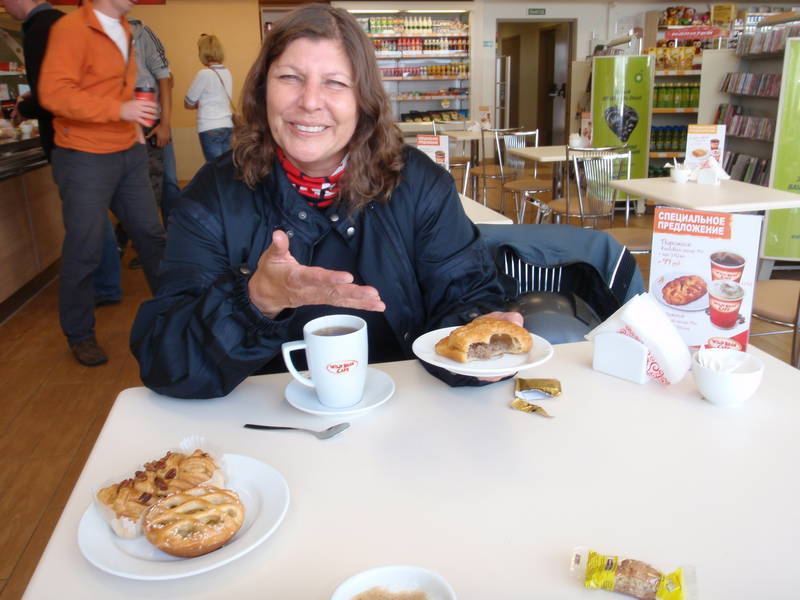
Splitting lanes in Russia is necessary and expected though this truck has brought the fun to a halt

As we got closer to Moscow the driving became more aggressive and at one point while stuck in a stau (the ugly German word for traffic jam that you might remember from Chapter 1) a Russian couple with him on a Yamaha FJR and her on a BMW F800ST overtook us on the dirt shoulder and waved us to join them in riding past the long line of stopped cars. The queue coming into the small town on the other side was about five kilometres long as we waved goodbye to other couple. What was strange was that there didn't seem to be a reason for the stau other than sheer volume and the capacity of the road in the town just wasn't high enough. When we got to Moscow proper we were on a 10 lane expressway (5 lanes on each side) when again traffic ground to a complete halt. We started splitting lanes and worked our way past the cars and trucks, sometimes with only a centimetre to spare on either side of the saddlebags. The Bentleys (we passed two of them in the queue) moved over quite promptly when we came up behind them. The cause of this jam was more readily apparent than the last one as a Lada had come in contact with a tractor-trailer and spun into the centre barrier, blocking three of the five lanes. Once past that mess it was an easy ride around the ring road to find the Vega Hotel, our last Best Western hotel. While the hotel was free with our Airmiles Best Western Travel Cards, the parking was 1,000 rubles per bike for the three days or about $10 per day per bike. As it had been pretty intense travel the last couple of weeks we decided to book the Vega for an additional night and took Wednesday, July 25 as a day off.
Five kilometre long queue of vehicles entering a town. Note police car stopping the car passing the queue.

Arriving at the Vega Hotel in Moscow
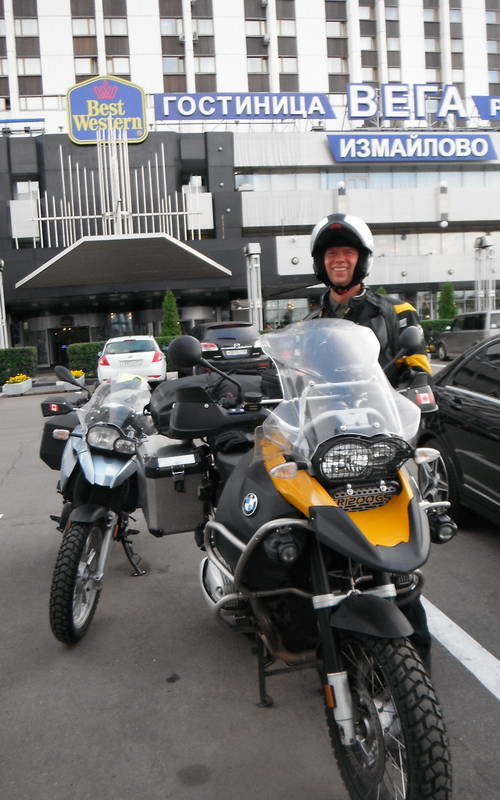
A billboard at a sports betting centre (or bar) showing a SAIT Trojan hockey player. Is he Russian?
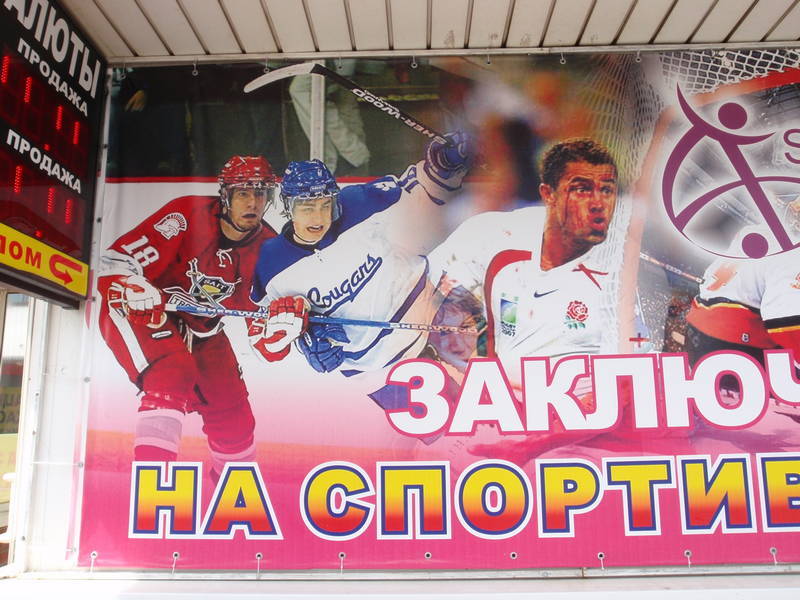
Thursday we were raring to go again and hopped on the Metro near the hotel, taking it to Revolution Square. We popped into the adjacent GUM department store mall for breakfast pastries and cappuccinos and then out to Red Square. There was a large queue, presumably to enter the Kremlin that Audrey joined while I went around to the ticket office. It was a good kilometre walk away to the ticket office and I was happy to see that there wasn't a queue. I was not so happy to see that the Moscow Kremlin was closed on Thursdays. Checking the guide book, sure enough it says open Friday to Wednesday. Must do better research next time. Walking back to Audrey I figured out she must be in the line to see Lenin's Mausoleum. She had made good progress in the queue but wasn't at the front yet. This gave me enough time to put my shoulder bag in the luggage lockup at the nearby State Museum. The guide book indicated that the luggage office was at the corner of the building. I tried every single door but nowhere was there a luggage office (though the security people at the actual entrance to the State Museum wanted to search my bag they didn't want to store it). Back at the front of the queue I rejoined Audrey and we decided to just try taking my shoulder bag in. When they finally let us in there was a door at the back corner of the State Museum only accessible from the queue side of the building. I dropped my bag there while Audrey queued up at the security checkpoint to get into the mausoleum. Queues are great sport as people try to work their way forward and ahead of others. We lost to a family who shoved their way past us to the security scanner but we passed them once beyond the scanner. The preservation of Lenin's body was amazing and a chill went down my spine as we walked around the tomb. The cool chamber was especially nice compared to the humid heat outside.
GUM mall on Red Square, now full of exclusive shops where people used to line up for bread

Red Square, Lenin's Tomb and Kremlin to the right and St. Basil's Cathedral ahead

Lenin's Mausoleum
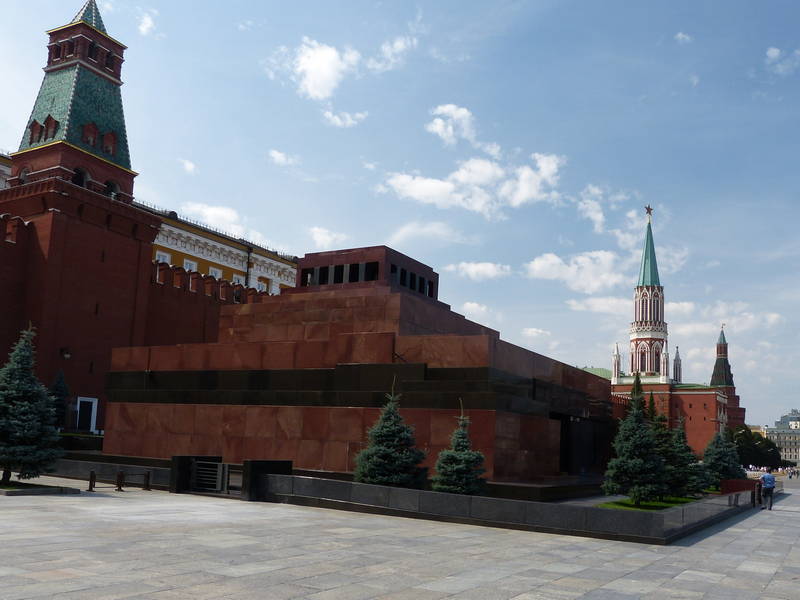
After a coffee break we went to the State Museum, which showed Russian history from the Stone Age on up. I was snapping photos of various interesting artefacts but by the Iron Age an attendant came over and asked to see my photo ticket. I hadn't purchased one so they suggested I go back to the ticket office and buy one. My alternative involved less hassle, I simply stopped taking photos. In a way this was too bad because further along the timeline we got into the really opulent tsarist times where a couple of shots would have been nice. What was really odd, and definitely worth a quick, illegitimate photo was the American Declaration of Independence. I wouldn't have thought that it would be in the Russian State Museum but rather in the U.S.A. somewhere. Overall though, I didn't think the State Museum was very good and given my druthers would probably give it a miss next time. On the other side of Red Square was St. Basil's Cathedral, probably the most famous Russian church and certainly its most iconic. Inside it was a confusing series of small rooms with religious artefacts, rather than a real cathedral. After an air conditioned break for a Big Mac (more fun queuing at the counter) we walked down the pedestrian mall in the Arbat district. It took a bit of searching to find the Metro station with the construction and then we took the twenty minute ride home, where a delicious donair at a nearby restaurant provided an inexpensive dinner.
Inside the State Museum
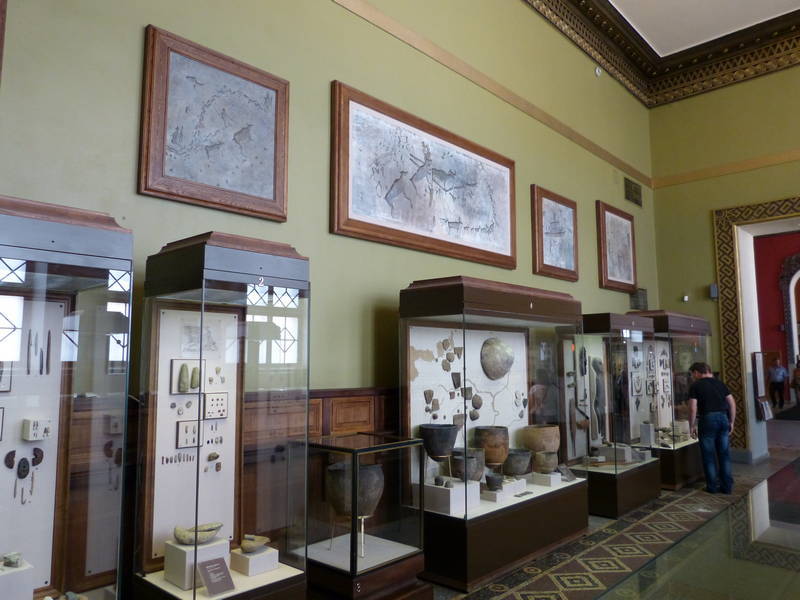
Ekke ponders our next trip

Audrey tries on armour (virtually)

The American Decleration of Independence?!?
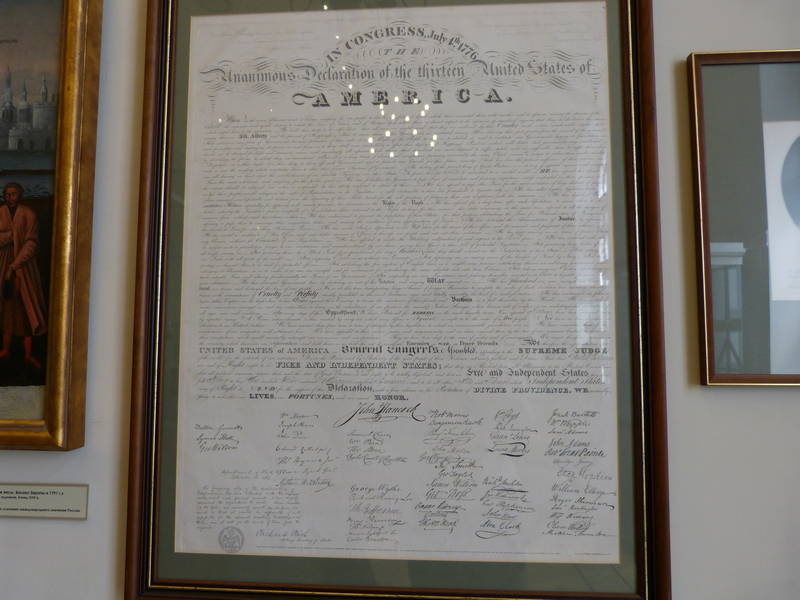
Coming back from St. Basil's Cathedral

Audrey grabs the cow by the horn in Arbat

Bentleys seem to be the most popular super luxury car (this one is parking to go to Wendy's)

Thursday was our day to visit the Kremlin so we jumped on the Metro and went straight to the ticket office. There were no Armoury tickets available so we decided to just purchase the Kremlin tickets and then went for breakfast. Over breakfast we decided we really wanted to see the Armoury since that is where the really opulent stuff is kept, like the Fabergé Eggs. Back at the ticket wicket we joined the queue for the 11:15 purchase time in order to enter the Armoury at Noon. When we got to the front there were no Armoury tickets left as they only sell a certain number. Perhaps there were announcements in Russian saying that they had sold out but it was awfully frustrating to have spent all that time in the queue and come away empty handed. We went into the Kremlin and looked at the stunning buildings and cathedrals before returning to the ticket queue. We figured timing was everything. Get in line too early and you'll end up at the front of the queue before the Armoury tickets go on sale. Get in line too late and the tickets will be sold out. We timed it perfectly and were at the front of the queue at 1:45. Of course, the people that had lined up too early now budged their way to the front as per any normal Russian queue but we did end up with tickets. It was truly worth it. The sheer spectacular decadence was something that truly has to be seen to be appreciated. The Fabergé Eggs were a perfect example as they started as simple Easter gifts and evolved into the most intricate designs imaginable. My favourite had a model of the first train that went from Moscow to Vladivostok in it. The detail was stunning. The entire Armoury was choc-a-bloc with over the top opulance, everything from clothing made with gold thread to bejewelled thrones to ornate carriages. Catherine's carriage that she rode in from St. Petersburg to Moscow was on display and because we could relate to the journey we could appreciate the improvement in suspension design. It took 23 horses to pull the carriage. A brief stop at the famous Pushkin Station MacDonald's before heading home to the Vega Hotel gave us time to think our options out for the next phase of the trip. The weather report for southern Kazakhstan was for highs in the high 30s and the roads were supposed to be terrible so progress would be slow and painful. The middle route through Urask and Aktobe to Aralsk was reported to have lots of 50 km long sections of construction with deep, soft sand. So we decided to take the northern route, staying in Russia through to Chelyabinsk and then dipping down to Kazakhstan towards Kostanay. The weather looked promising and we hoped the roads would be OK. We now had an extra day available so we used the last of our Best Western cards and took another day off.
Entrance to the Moscow Kremlin


The great cannon was a popular posing spot
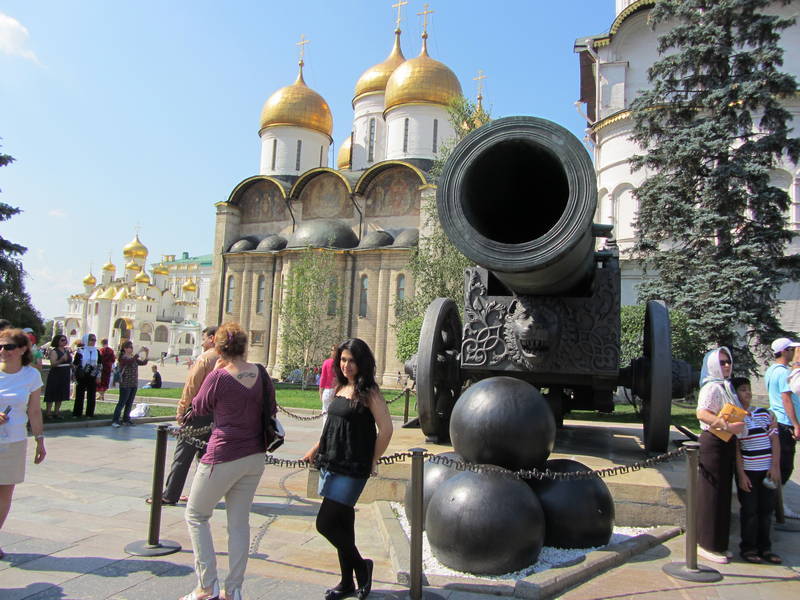
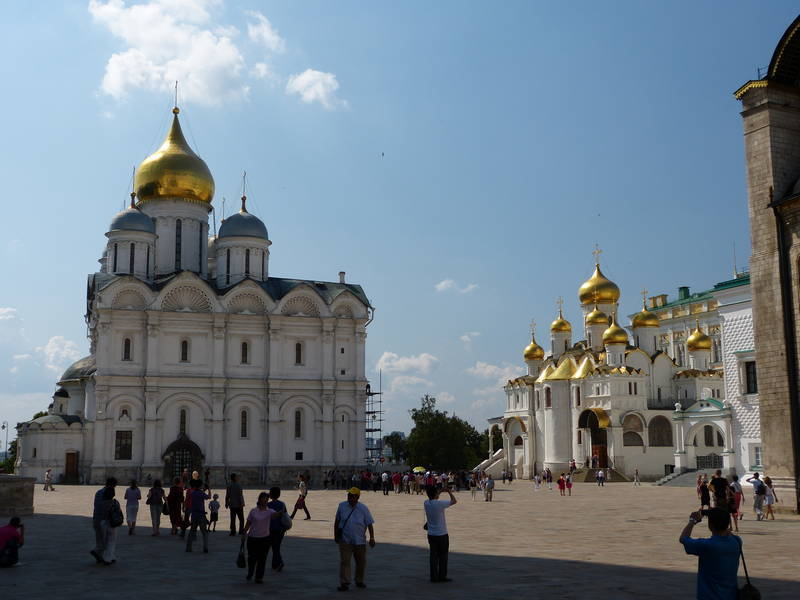


Trans-Siberian Faberge Egg (click on image to see the Wikipedia write up)

It has clouded over after our Armoury tour

Lots of guards everywhere (usually blowing a whistle as someone loiters in the middle of the road to take a photo)

Our transit stop near the Vega Hotel. On the right is a timer since the last train left. A train came every minute.

On our day off we thought that we could beat the crowds and go down to Red Square with the motorcycles for a photo opportunity. Sure enough we found a spot in front of (or more accurately behind) St. Basil's Cathedral and snapped a few shots before various tour groups came through. Every one of them wanted to take pictures of us. And pictures of themselves with us. I think there were at least four separate tour groups (Chinese, Japanese, Korean and German) that came through. A Russian guy even wanted his picture taken with himself sitting on my bike. It was rather fun being a celebrity but we were soaked in sweat from standing around in the heat in our full motorcycle gear. Back at the Vega we worked on the website while watching a rerun of the Olympic Opening Ceremony and a little of the Russia versus Canada (who to cheer for?) women's basketball before someone changed the channel. It was neat to be in a hotel that was used for the 1980 Moscow Olympics while watching the 2012 London Olympics. Tomorrow we would ride east.
Posing for photos at Red Square

Groups of tourist came by to take photos of us "celebrities" (the world map on Audrey's saddlebag was great)

Audrey checks out the Olympic Rings at the Vega Hotel
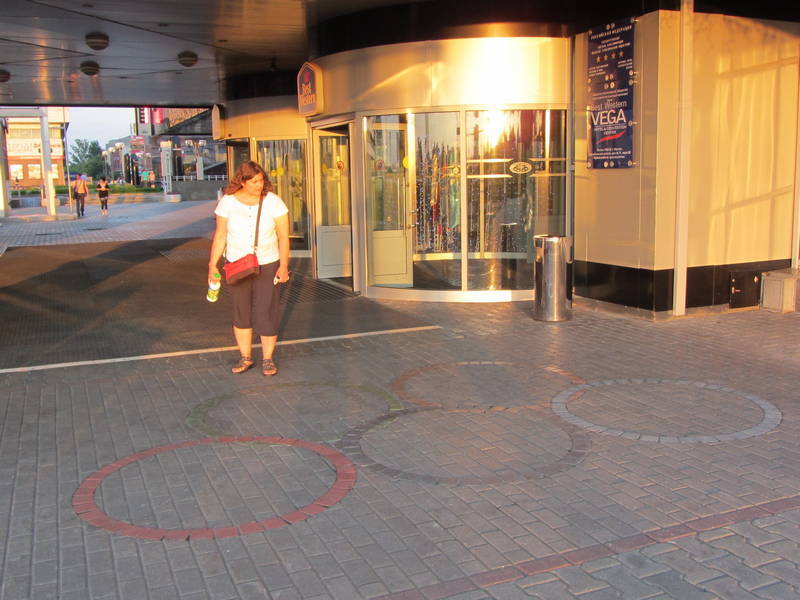
Finishing up Chapter 1 of the website while watching the Opening Ceremonies of the Olympics

Map of our route from St. Petersburg to Moscow
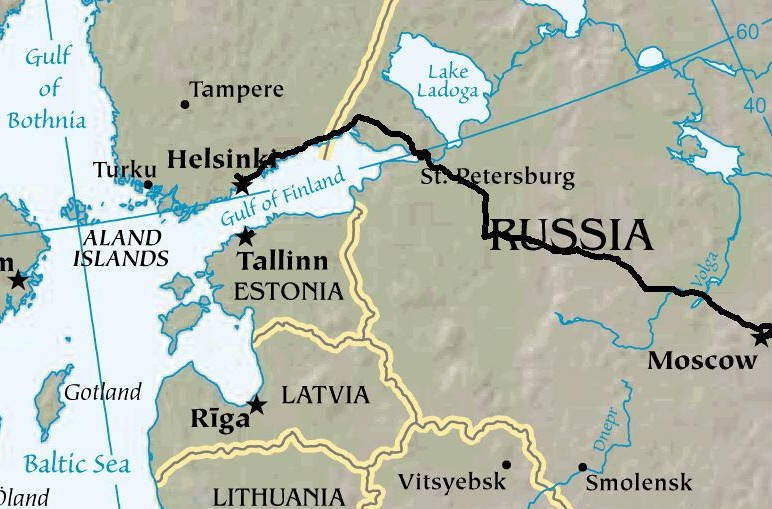
It was difficult on July 29th tearing ourselves away from the Best Western Vega and all its comforts. I will miss the cushy robe, which would have filled a whole saddle bag, but couldn't part with the spa slippers as they are so useful in hotel rooms. Our 15 days of Russian motorcycle insurance was going to run out so it was time to start heading toward Kazakhstan. The ride out of Moscow was fairly easy on a Sunday morning, but we still had to split lanes a couple of times. There's kind of a strange thrill when you see an opening between cars and then twist the throttle so you can dart through before other vehicles move or try to change lanes on you. Getting stuck between a couple of big trucks is a bit disconcerting, and there's nothing for it but to let traffic start moving and then finding your opening. The traffic lights here are different from the ones in North America. Before the light turns green there is a short yellow phase, possibly so you can get your vehicle into gear. But here in Russia, cars take off on the yellow, leaving us sitting there waiting for the green. I think it's a bit wishy-washy. Anyway, we rode out by some drab Soviet era apartment blocks, and headed out onto a fairly good four-lane. It turned into two lanes farther up but was in very good condition and easy to swerve out of the way if someone coming toward us misjudged their passing. Often they rethought passing when Ekke flashed his high-beam and they realized we were closer than they thought. We rode by leafy trees with red trunks, wooden houses, and a few golden fields and it was really rather pleasant.
Need to buy an inflatable dolphin?
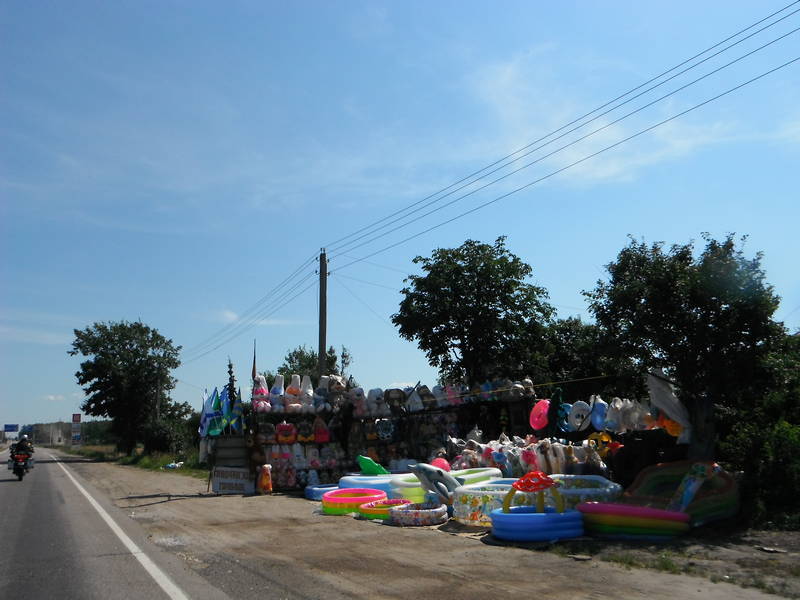
The Cyrillic sign for Cafe was easily recognizable to us now, and we stopped in at a little place that had three tables, blue checkered tablecloths and lace curtains. Unfortunately the menu was all in Cyrillic and we couldn't count on using pictures or pointing at food, like in a cafeteria, to help us. So we looked at what some locals were eating, and pointed to their spaghetti. The server said, "Macaroni", and we said, "Da." So, we got some pasta with a lovely meat stew and some chocolate-covered almonds for dessert. We definitely are not starving here. And, we learned a new Russian word, 'macaroni', that we would use many times.
At the the gas stations, we have to prepay now before the pumps will start. So, it's a matter of estimating how much fuel the bikes will need, pay for that much, and then get reimbursed. To save doing it twice, I just pull up beside Ekke and he fuels his bike and then fuels mine in one go. One time we looked down and noticed gasoline running all over the side of my bike. The shut-off valve on the pump was not working. No gasoline sprayed on anyone, thank goodness, as Ewan McGregor and I both know the fun of getting gasoline in one's eyes.
Working the pumps

In Nizhny Novgorad, construction was wreaking havoc with the GPS but Ekke eventually got us to the Ibis hotel. When we handed over our passports at the front desk, the receptionist asked us for another piece of paper. Ekke's registration paper, received in St. Petersburg, was missing from his passport. We searched everywhere but couldn't find it. The staff even called our last hotel to see if they had it. No luck. So, they said they could just issue another one, no charge, to be picked up in the morning. All that drama of the missing paper was for nothing. It was great to just sit in our nice hotel room for a while and watch some Olympics on TV. It was all in Russian, from their perspective with the focus on their athletes, but their programming looked very similar to what you'd see in Canada. They also aired a lot of commercials of cute kids performing winter sports for their upcoming Olympics, Sochi 2014. After dinner we walked up a lively pedestrian mall where everyone was dressed as if they were off to a fancy nightclub. Some young people had music blasting and were showing off their dance moves with everything from jive to The Charleston to hip-hop. The former 19th century market town had some great architecture and the bank building looked like a castle. The brick walls and towers of the 500 year old kremlin, or fort, were quite intact and we strolled beside cannons, tanks and small airplanes. There were great views of the Volga and Oka rivers, with lots of water craft out, including big barges. In the Soviet era, Nizhny was closed to foreigners to protect research and production facilities. I'm glad they let us in. In 2018 some of the FIFA World Cup games will be played there.
Ekke checks out a strange little car
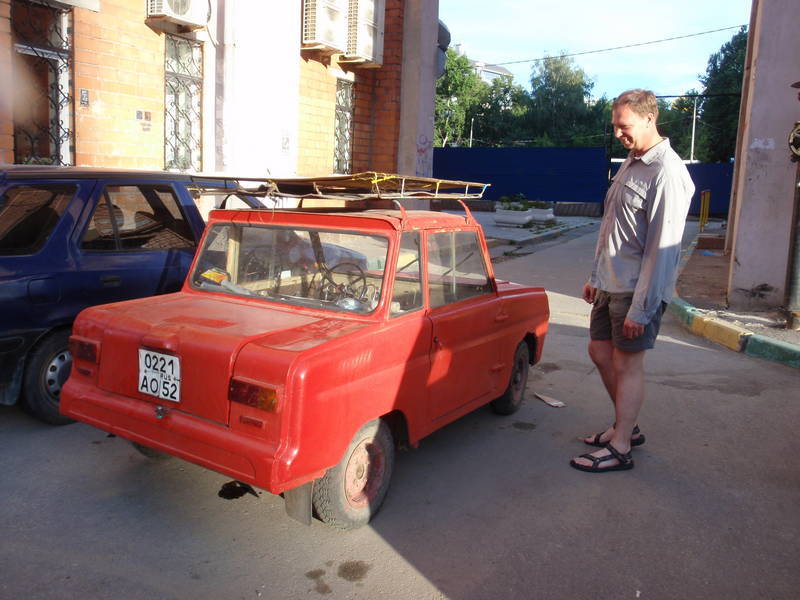
Walking the pedestrian mall towards the Nizhny Novgorod Kremlin

Castle-like bank. Now we know what they do with the money.
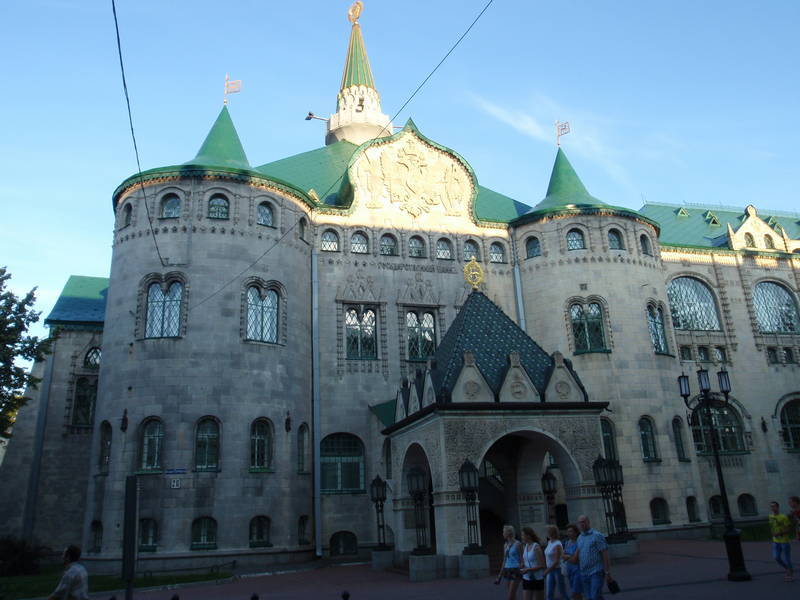
The opera house is beautiful

Break dancing on the mall

400th anniversary of Nizhny Novgorod Kremlin
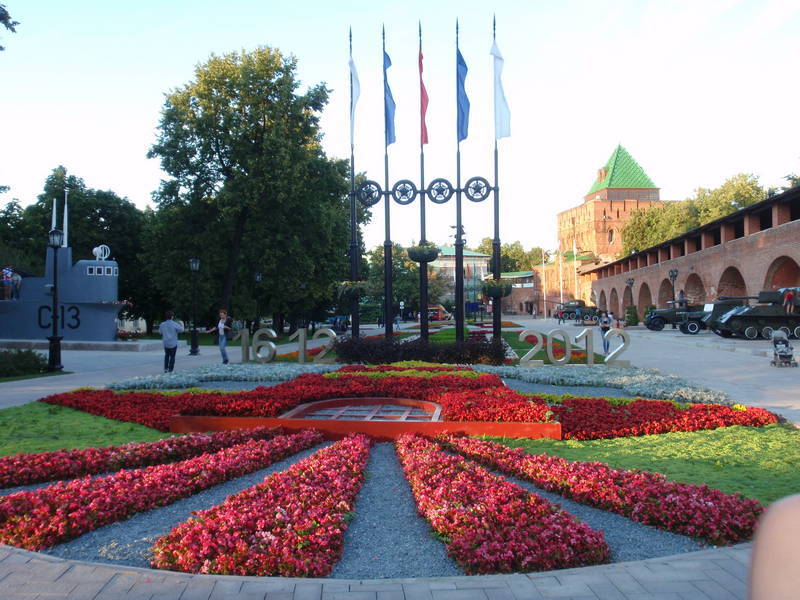
The eternal flame overlooking the Volga

Barge on the Volga
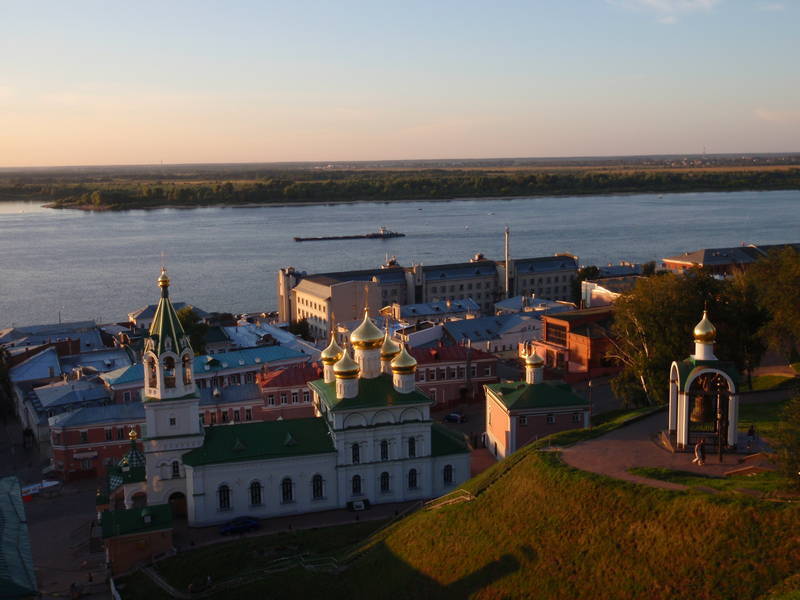
Walking outside the Kremlin wall

Ekke enjoys the interactive displays and grabs the goat by the horns

There was a lot of construction on the roads after leaving Nizhny Novgorod on July 30th so it was slow going at times. We did a lot of lane splitting as we rode through small towns as traffic could back up at any time. Lunch was at a big cafeteria, with a lot of tourists, all Russian as far as we could tell. So, we could point to the food we wanted, a broth-based soup with meat in it topped with sour cream - delicious. It was bright and sunny for most of the day and the sun was hotter when we pulled into Kazan. The ride over a big causeway afforded us views of a sandy beach with umbrellas set up and people swimming. Ahead of us lay a huge traffic jam that had us sitting there for quite some time. It was a great vantage point for a beautiful view that lay to our left - a huge blue and white cathedral sparkled in the sunshine, surrounded by a white wall. But sitting on the bikes in the heat was not good, no matter how fabulous the view, and as there were no lane lines painted on the road, cars were squished too close together to do any lane-splitting. Ekke's bike was making funny knocking sounds, probably because of the heat making the oil in the bike a lower viscosity. We noticed a bit of room on the far right, so wiggled our way between cars to get over beside the curb. People moved a bit and let us in if they could and not one car honked at us. It all went well until we came up behind a small taxi that was trying to do the same thing as us. We eventually got around him when he couldn't get over a couple of big sewer lids sitting on the side of the road. Our tires just squeezed in around them and we were on our way. I'm sure traffic just sat there for hours, all due to a road closed for construction. In fact, they might still be sitting there. Another predictably efficient and clean Ibis Hotel made things easy, and we had safe parking underground via a really steep ramp. Another busy pedestrian mall was just around the corner and we enjoyed an evening walk. There are advantages to being in a downtown hotel.
Cool monument in the middle of a roundabout
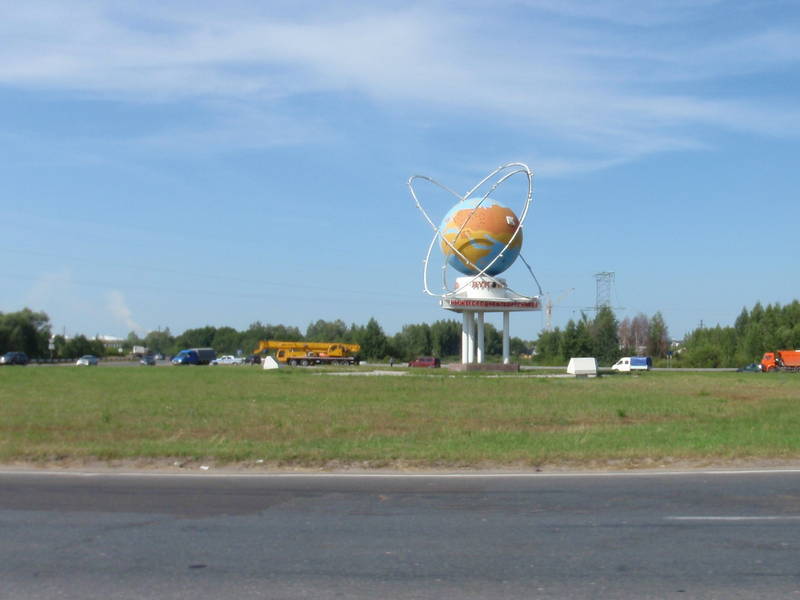
Tourist cafeteria for lunch

Pleasant riding
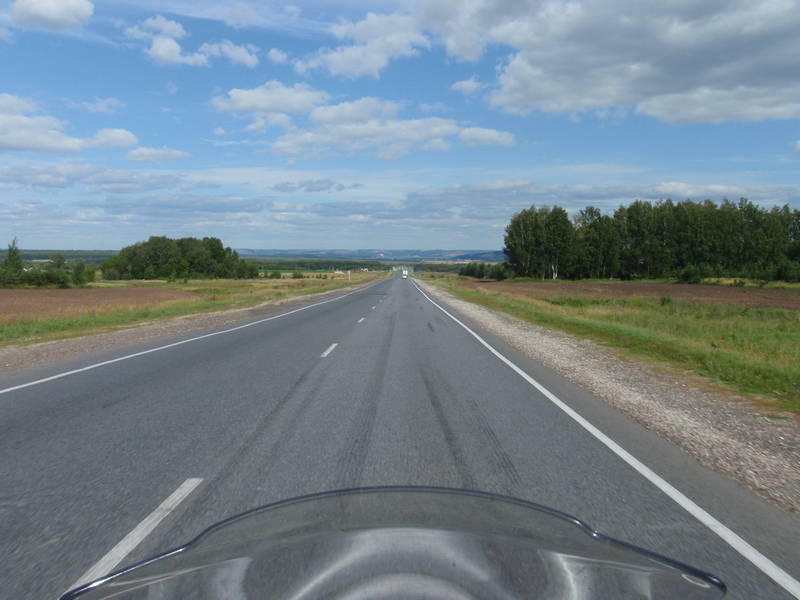
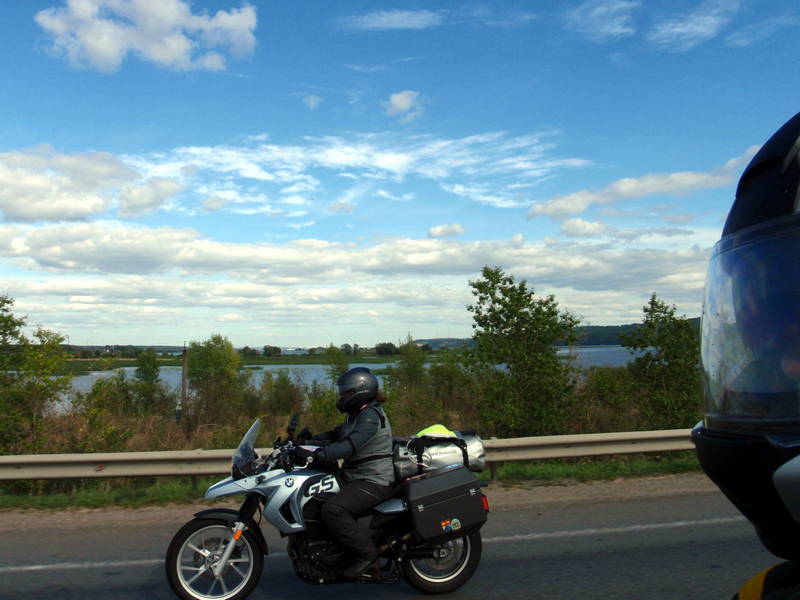
Entering Kazan and going by the Kazan Kremlin
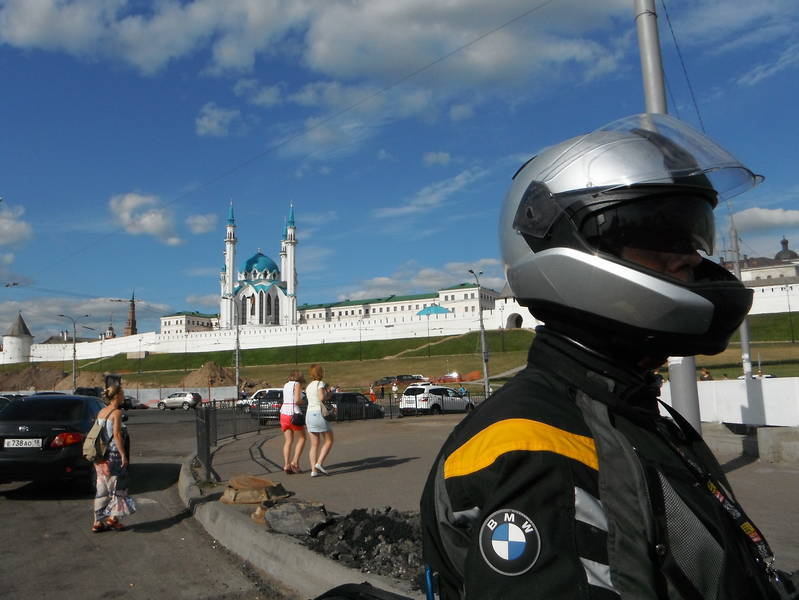
The hotel Ibis across the canal looks like it has nice air conditioned rooms
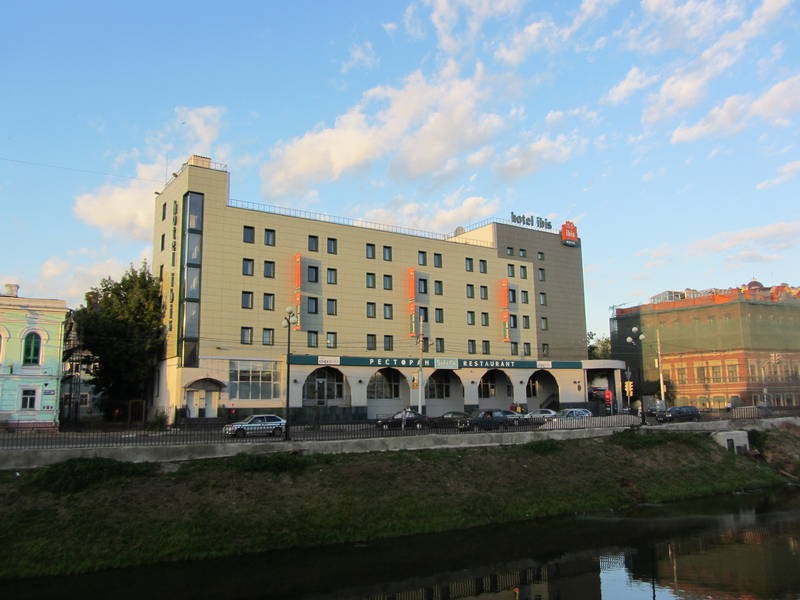
Going for a stroll after dinner

Ekke writes:
The knocking sound coming from my engine when we were stuck in hot traffic the day before was a bit worrisome and I thought it would be a good idea to change to a heavier weight oil. With that in mind I did a bit of research on the internet and found a motorcycle shop listed in Kazan. I programmed the approximate location into the GPS and rode over. When I got to the general area I rode around every single street and back alley I could find but no bike shops were found so I went back to the hotel, keeping an eye open for places to buy oil. In order to avoid the congestion along the canal that we had encountered the day before, I took a slightly different route back to the hotel. Coming by a market the road deteriorated to a pock-marked dirt track with 15 centimetre high tram lines raised running down the middle and traffic was completely jammed up as the engine started to overheat again. I arrived back at the hotel drenched in sweat from sitting on a hot motorcycle in traffic none the better since I didn't get an oil change.
We finished up the website and published Chapter 1 to the web then went in search of a post office to mail some stuff home. We had picked up a couple of souvenirs but mostly we needed to send excess stuff back, like Audrey's old motorcycle pants, in order to make some room and cut weight. As you can imagine, a Russian post office was quite interesting with several wickets and several queues. We lined up at a wicket that was near some boxes, hoping that we could purchase a box and then carefully pack our belongings into it to send home. While waiting for something on the order of twenty minutes I noticed that a woman in line ahead of us was reading the New York Times in English on her iPhone. I asked her if we were in the correct line to purchase and mail the box and she replied that we were and she would be happy to help us when it was our turn. Sure enough we needed a little Russian translation in order to buy the box so her help was appreciated. The mail clerk needed to see what we were mailing to make sure it was all appropriate (probably making sure we weren't sending home any Siberian tiger skin rugs) so we took our carefully packed belongings and dumped them into the box under her watchful gaze. I'm sure my parents will be absolutely delighted when they receive this parcel. While filling in the customs declaration form, Eugene came over and started speaking English to us. He has an '89 Cadillac that he absolutely loves and I'm sure it would have been nice to go see it if we had more time. He helped us with the last bits of translation as we paid for the parcel.
Sending a package home

After lunch in a cafe we went to the Kazan Kremlin and were absolutely stunned by its beauty. This was a UNESCO World Heritage Site and we could certainly see why. The beautiful mosque (the largest in Europe outside of Istanbul) within the walls of the Kremlin was inaugurated in 2005 on the same site as the original mosque that was destroyed in 1552. The bright white building shimmered in the sun. Also within the Kremlin walls was the Annunciation Cathedral from 1562 which was beautiful but didn't lend itself to photography as much as the mosque.
Walking towards the Kazan Kremlin after lunch
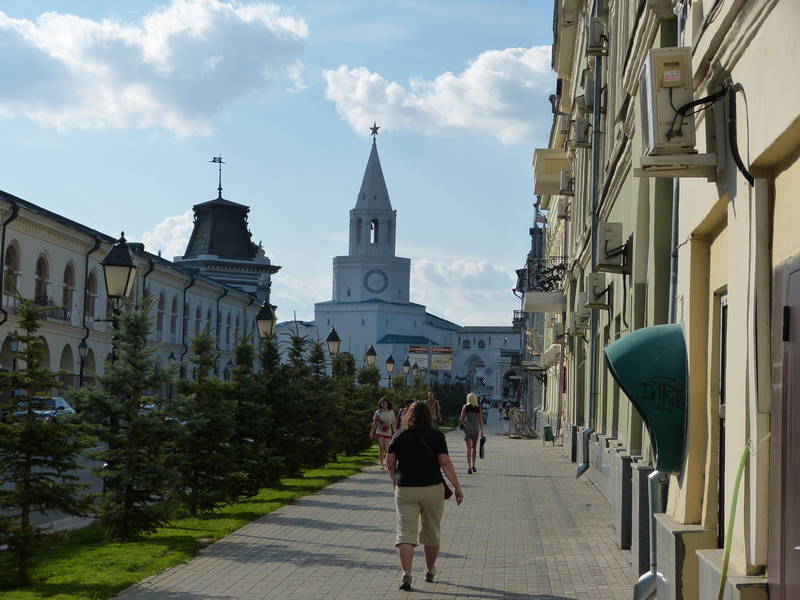
At the entrance to the kremlin stands a statue commemorating the fall of communism
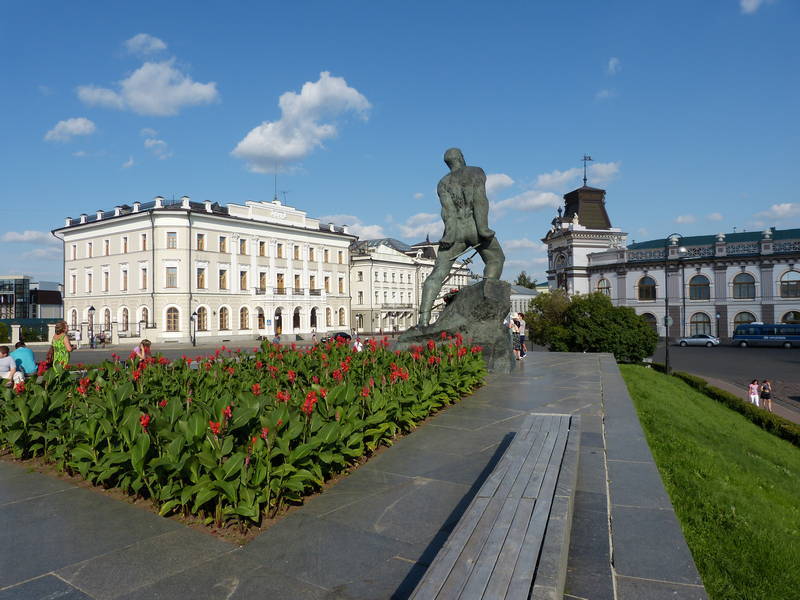
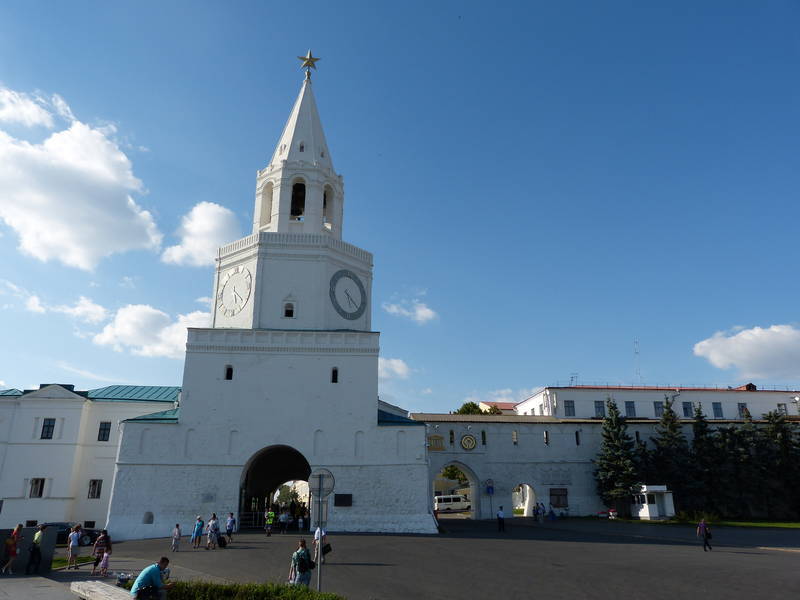
Climbing the tower for a better view

Mosque opened in 2005

Ongoing reconstruction as part of the UNESCO World Heritage Site

Annunciation Cathedral

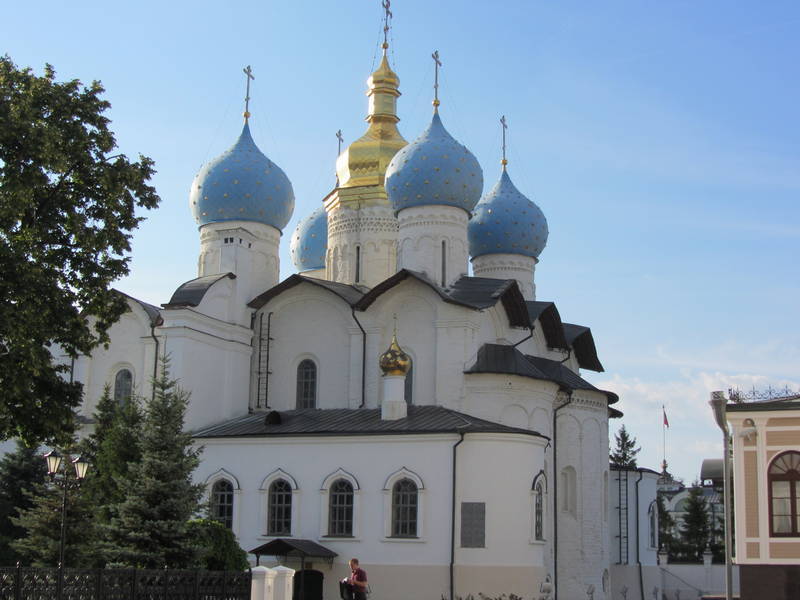
The faces on the statues seem to be changing to a more Eastern look

6,841 kilometres to go before we get to Japan, we're about half way then

Getting on the road on the first day of August at about 10:00 AM after the included buffet breakfast we stopped at a gas station to look for oil. The only heavier weight oil was a Mobil 1 synthetic 5W50 for the crazy price of 2,125 rubles ($62) for 4 litres. After a bit of hesitation we bought it since we didn't know if any normal 20W50 oil would be available anywhere else (and thinking back as I write this in Kazakhstan there was none). With the oil strapped to the back we got off the motorway for the first time since entering Russia and immediately the riding became much more enjoyable. There weren't nearly as many trucks and the traffic was light enough to be able to enjoy the scenery which looked a little like southern Alberta. The road quality also improved as it wasn't pounded by the heavy truck traffic. We were lucky to find an air conditioned café for lunch to get out of the heat. It was interesting to see the colourful houses in the village with satellite dishes in the yard. Later that afternoon we found an air conditioned McDonald's for an ice cream cone. A party of kids, about 12 years old, was happening outside and they looked at us curiously as we tromped inside. After sitting down and enjoying our cones a couple of the braver kids came over to our table and tried their English. It was much better than our Russian. Soon the whole gang was crowded around us asking questions through their best English speaker. When we left they all had to have their photos taken with us and the bikes so all the cell phones came out and we spent a few more minutes in the glare of the spotlight before hitting the road. Closer to Ufa we rejoined the M5 (a great name for you BMW car fans) and all the trucks again. On one particularly crowded section we saw a couple of BMW R100GSs parked at the side of the road going the other direction so we pulled over to see if we could give them a hand. They were two couples riding from Berlin to Novosibirsk with a quick pop into Mongolia and the speedometer on one of the bikes had quit working now on their way back home. They had the situation well in hand and didn't need our help so we continued onward. Only a few kilometres further on the rough, narrow two lane road we came upon a big, wide four lane divided highway that ran all the way to Ufa. Why the couples had pulled over at that particular spot on the narrow road was a bit of a mystery to us, if the bike would have quit it would be understandable but just to fix a broken speedo? When we started looking for hotels in Ufa we found them to be crazy expensive. The first one wanted 6,500 rubles, the second one wanted 7,700 rubles and the third one, the Hotel Astoria, came in at 5,500 rubles or $170 for one night. Ouch. There was no hot water in the afternoon and only one towel plus the two twin beds were super soft and uncomfortable. Having to save a bit of money we popped over to the local McDonald's for supper. One thing was for sure, McDonald's are super popular with Russians. It may be the best spot to go meet the locals and they're always air conditioned with clean bathrooms. We also realised that we had gone through a time zone change. We were no longer on Moscow Standard Time and had just lost two hours. We were having dinner at 9:30 PM. I don't recall ever having jet lag while riding a motorcycle but this certainly seemed to be the case.
Great riding
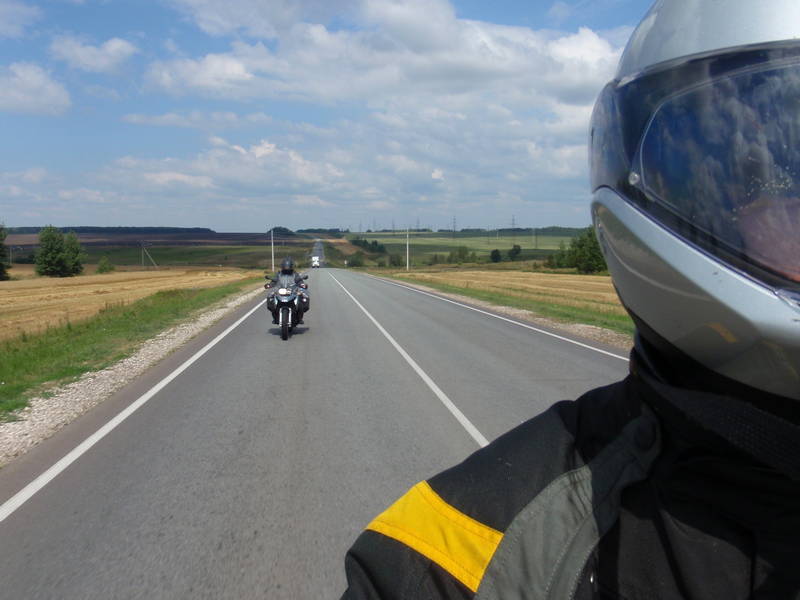
Lovely villages


Air conditioned comfort
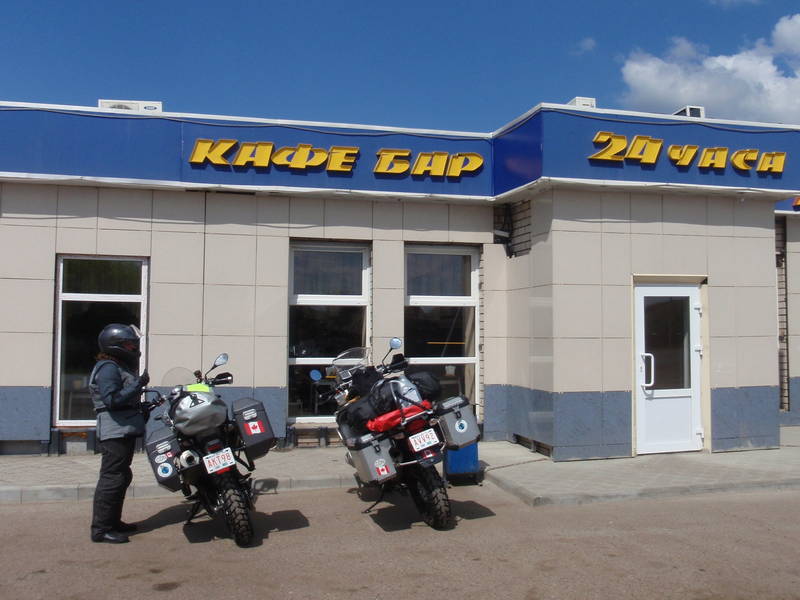
Love the satellite dishes
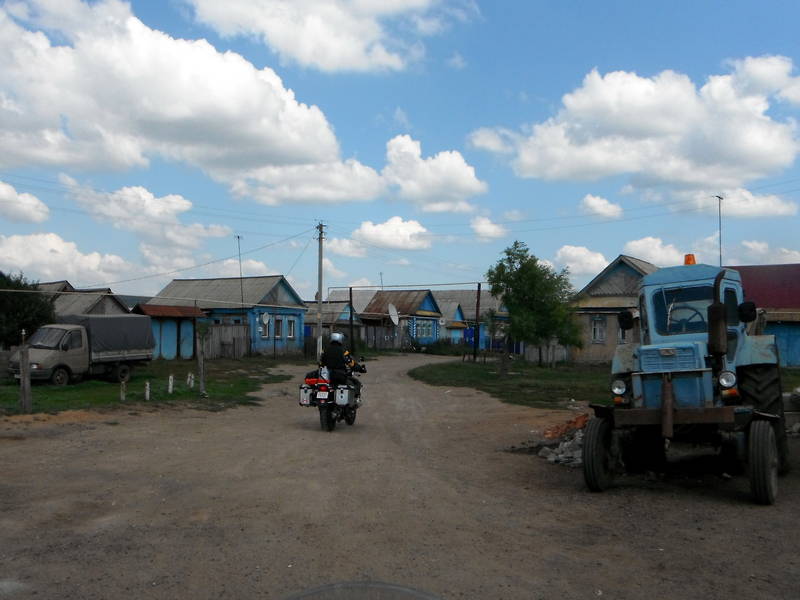
A new fan club

A broken speedometer
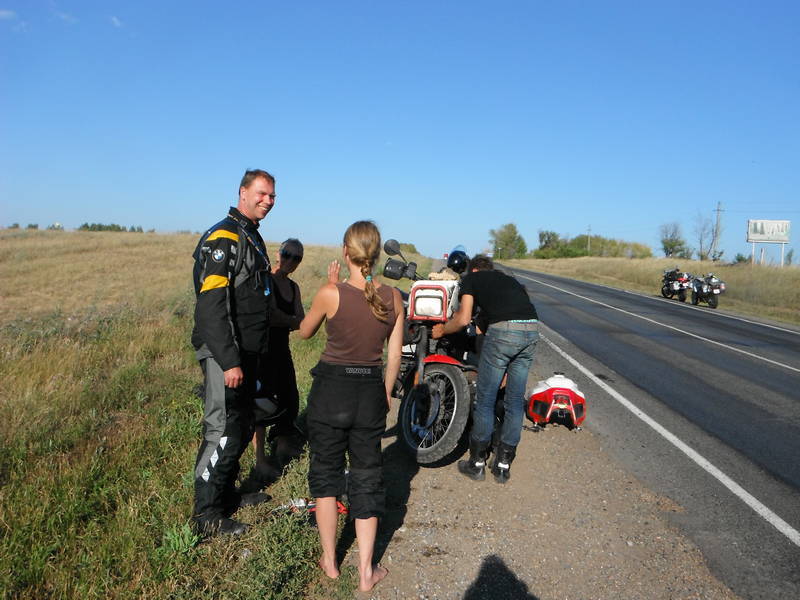
Ekke tries the "Furry herring"
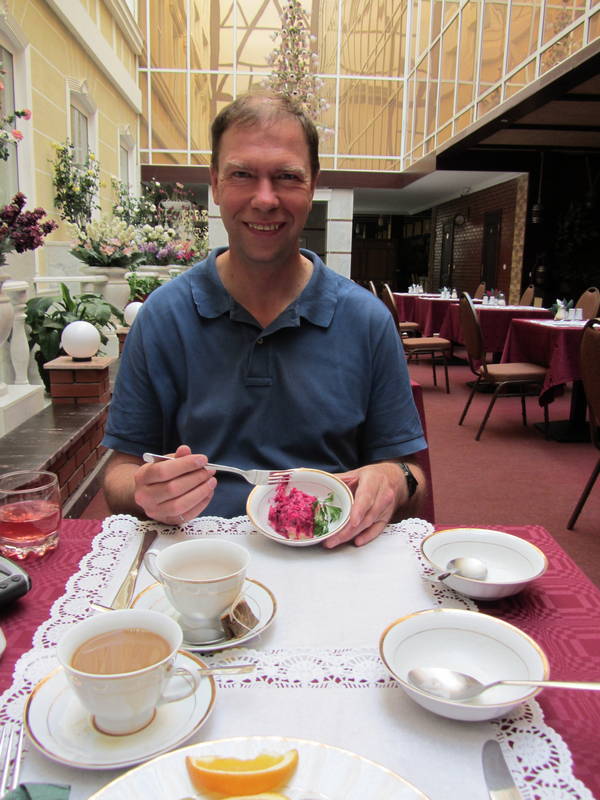
It was difficult getting up at a half way decent time but once we were on the road it turned out to be nice riding except of course for the trucks on the motorway. The road was rough from the truck traffic and it was almost scary riding behind a car carrier as the cars bounced around and shimmied from side to side. If you live in Chelyabinsk and the delivery of your new VW Polo has been delayed you might want to check the M5 in the direction of Ufa. Even passing trucks was cause for excitement as one of them jerked left to avoid a pothole just as the two of us were passing. At one point we came upon a queue of cars on the highway. After only a moment's hesitation we started riding down the gravel shoulder until we rejoined the front of the queue at a construction zone. Having a motorcycle sure is handy. In Chelyabinsk a Holiday Inn showed up on the GPS so we headed there, gritting our teeth at the thought of the price. Oh happy day, only 4,500 rubles with a large room and an enormous, comfortable king-sized bed. I had been schlepping four litres of oil along for a couple of days and I didn't really feel like importing it into Kazakhstan the next day so I went out to the parking lot and asked the security guard if I could change the oil right there. His only response was, "English, reception." I took that to mean, "OK, go ahead just don't make a mess." Using a pack bowl that had seen better days in Africa I drained the oil, poured the used oil back into the original container and found a dump. Recycling doesn't seem to have caught on in Russia yet.
Easy shoulder for riding means we can bypass the queue
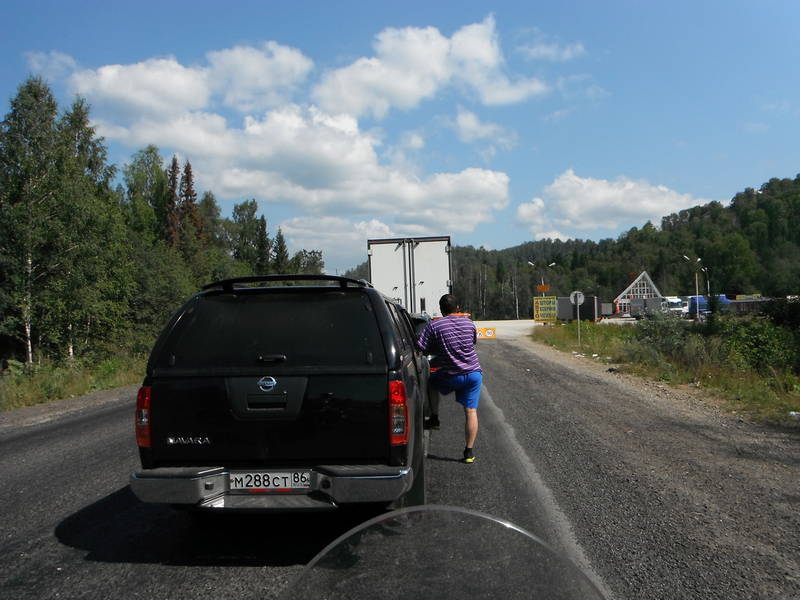
Forests for as far as the eye can see

Ekke looks happy to get lunch at a cafe - macaroni!

How do I get that bunny on the bike?
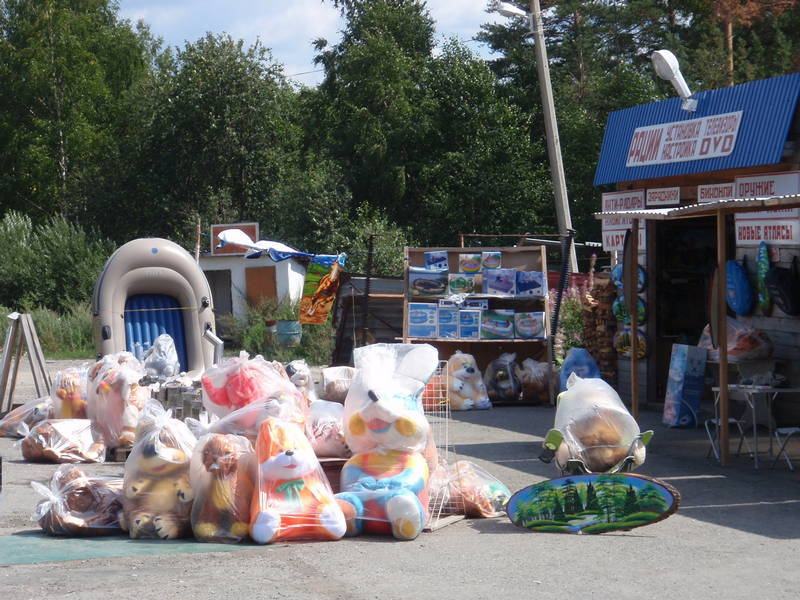
Don't get too close to the car carriers as they buck and sway down the rough road

Parking lot of the Holiday Inn, perfect for an oil change

While we would have liked to get an early start to the day in order to get to the Kazakh border before it got too hot we were still a bit jet-lagged and Audrey was having a few stomach issues that were better handled while being close to a toilet. We got out of Chelyabinsk at Noon after Audrey had gone over to a pharmacy to get the Russian version of Immodium. She was helped by a lovely lady, Olga, who walked her to different shops and translated when necessary. She didn't know the translation for Pepto Bismol, though. We headed south, again using the gravel shoulder to bypass a two kilometre long queue of cars entering a small town. Past there the traffic eased up and it was an enjoyable ride to the border. When we stopped for fuel just before the border we became instant celebrities again and people came over to have their pictures taken with us. One of them even gave me a good luck key fob. The traffic dropped to almost zero as we rode the last few kilometres in Russia and then we came upon two queues, one of trucks and one of cars. Fortunately the truck line up was to the west of the cars and we are able to stand in the shade as we waited to be let into the customs compound. Only a few vehicles entered at a time and the line moved very slowly. Two hours of standing in the heat beside the trucks was made more bearable by the friendly people we met and at one point standing in the shade of a cattle trailer. Finally when we were let into the compound we were one of the first there and the border guard must have stopped people right after us so that we weren't in a terrible crush at the wicket to get the passports stamped out of Russia. It was a fairly slow process, again with the motorcycle registration causing the most difficulty. At one point when the customs official asked where we're from we mentioned that we live near Calgary. All of a sudden he said, "Calgary Flames!" and we clapped with joy and shared a big grin. He tried to tell us of a Russian hockey player from the local area but we didn't understand. I recalled that in addition to our Canada flag pins I had also thrown a Flames pin into the bag so Audrey went back to the bike as the official continued to process my passport. When we gave him the pin he was very happy, with a huge smile on his face but it didn't make the process any faster. By this time a big queue had lined up behind us as more people were let into the compound so Audrey handed out a couple of Canada flag pins to apologise for the delay. Finally we were let through, after a cursory inspection of the bikes, and rode through to the Kazakh side of the border.
What really nice people, they were so excited to see us
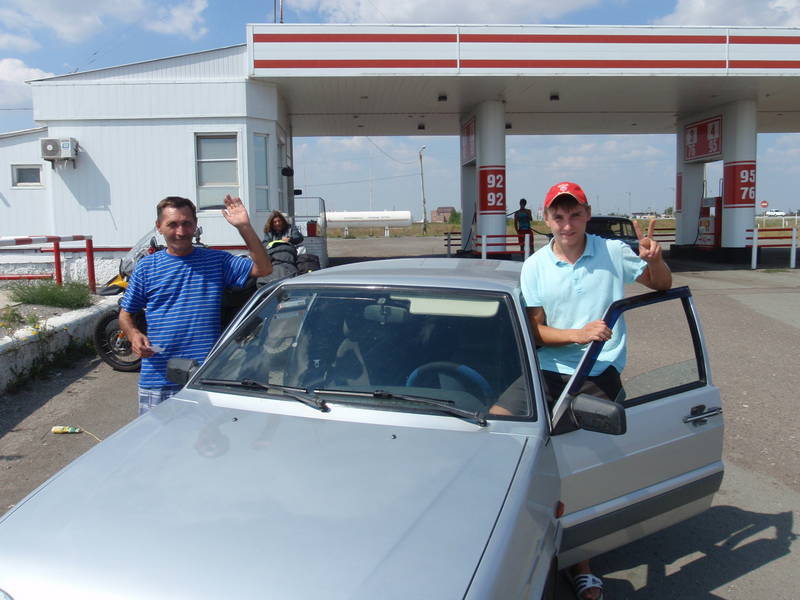

Cattle truck provides some shade and the cattle provides the entertainment

Map of our route
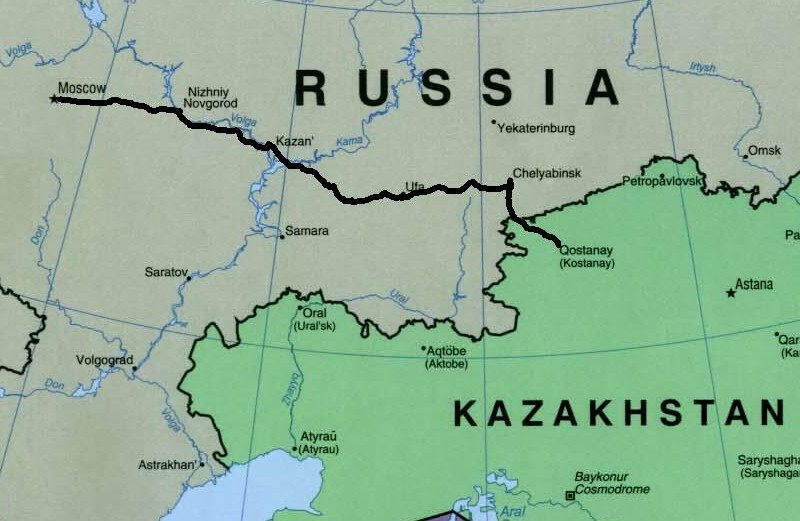
When we crossed the no-man's land between Russia and Kazakhstan we were greeted by a scene that was slightly more chaotic than the exit from Russia. A border guard motioned towards a booth where another guard handed us a couple of slips of paper each. One had some English on it so we were able to fill in a few blanks but the other was all in Cyrillic so we left it blank. Audrey then asked the first guard what to do next and he vaguely motioned in the direction of a couple of buildings. She heard something about "C" and sure enough one of the buildings had a "C" on it. The guard didn't stop us (or check our pieces of paper) when we rode past a few cars and straight to building "C". Inside the building (though a more accurate description might be shack) were two wickets and four or five people in queue. Soon we were motioned forward to an official and we started the entrance procedures. He asked what our final destination was so we said, "China!" It is always interesting as the officials try to decipher our registration documents, looking for the licence plate number and the colour and so on. This time we used our coats to describe the colours of the bikes, I pointed to a yellow stripe on my jacket and Audrey pointed at a light grey portion of hers. He took our pictures and when he was finished we asked where to go next. He said, "China!" With that we rode out of the customs compound and into Kazakhstan, in the blazing 33 degree heat. I stood in line at a currency exchange office for twenty minutes but when no-one showed up in the wicket the others in the line decided to leave. Joining them I went back to Audrey and said that not only was there no currency exchange but also the café next door with ice cold drinks didn't accept Russian rubles, only Kazakh tenge. Just then one of the others in the currency exchange line came over and said that the shack that Audrey had been standing in the shade of for the last twenty minutes also did currency exchange. Great! We exchanged a bunch of rubles and promptly crossed the street to the café. After a bit of a cool down I went to the insurance office and purchased Kazakh insurance. The total came to 760 tenge which I happily paid and went back to the café. There we did a bit of figuring and determined that insurance for the two bikes for two weeks was about $5. What would that cover exactly? Best to avoid any collisions.
Welcome to Kazakhstan
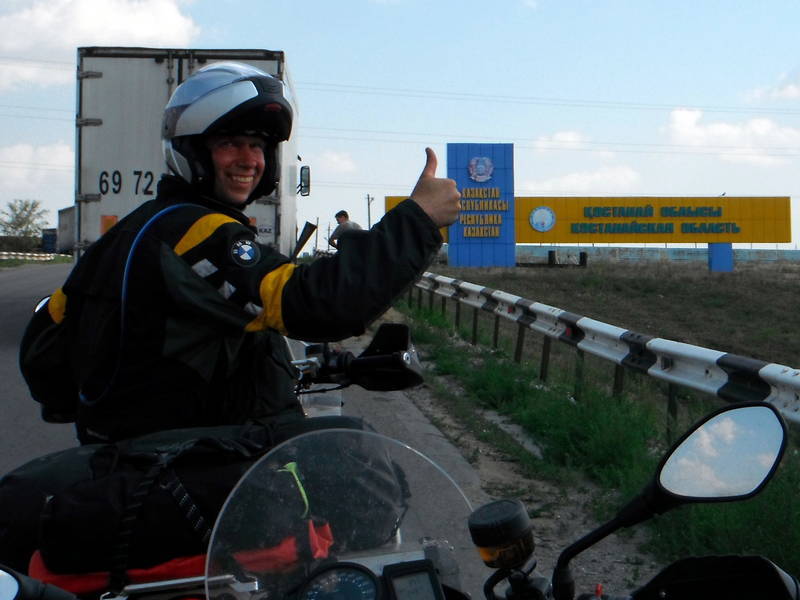
Now we headed east to Kostanay where a hotel showed up on the GPS. Despite the heat it was actually quite pleasant riding. The roads were good and the traffic was light. We passed kilometres and kilometres of grain fields. Sometimes the grain fields went right to the horizon and one could see the curvature of the earth, just like looking out on the ocean. What was very strange from a Canadian prairie perspective was that there wasn't a single farm house. Sure we have big farms at home but you'll always see farmhouses dotted here and there. Here there were none. Not even one. The only buildings were in small towns so perhaps these were a remnant of the communal system. It made us wonder though, how did these farms get transferred after the fall of communism? Were the farms still communal or were they privatised? After stopping at a roadside café for mashed potatoes and a meatball we got into Kostanay and went straight to the hotel where a room was indeed available though at 12,000 tenge ($80) it wasn't cheap. While Audrey collapsed in the room I took a short stroll down the pedestrian mall to where some celebrations were going on at a central square. There were marching bands and there was even a game show where contestants were selected from the audience. I made sure to be at the back and tried not to look like a potential contestant as I didn't understand even a single word of what they were saying. I suspected that saying, "I'll take' Kazakh Tidbits' for $200 Alex" wouldn't get me very far.
Taking a stretch while riding the steppe
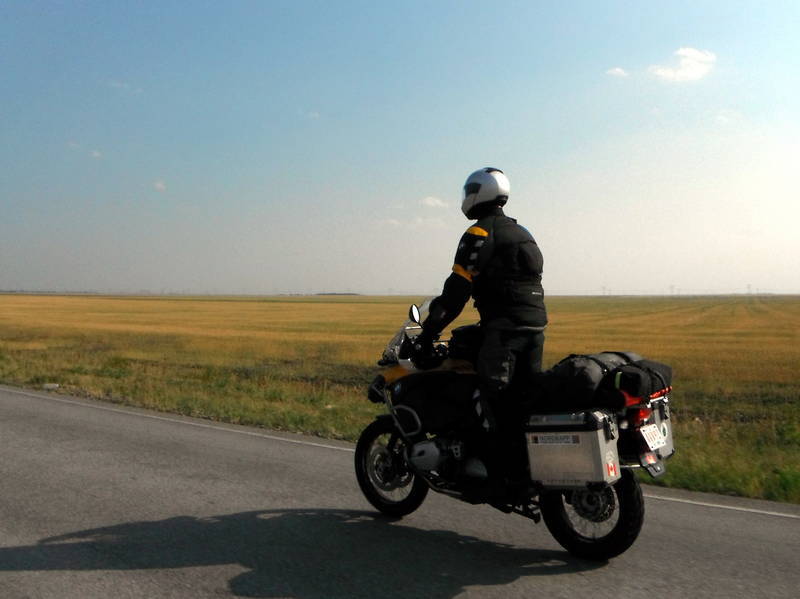
Dinner break
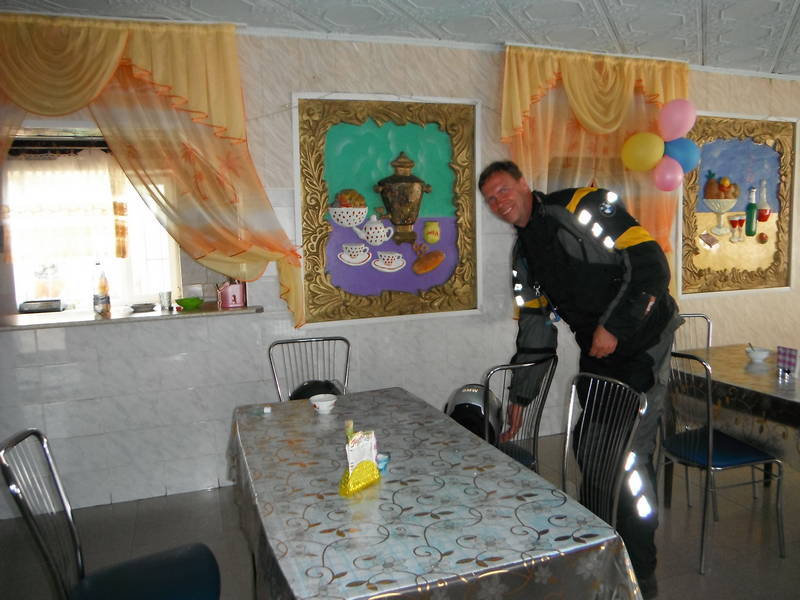
Kazakh game show
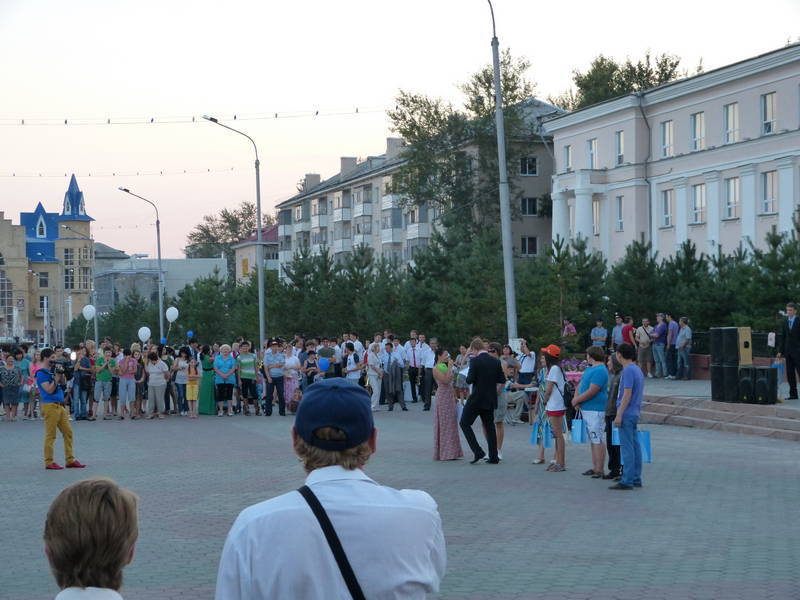
The hotel included breakfast and we had a choice of ten different set menus. All in Kazakh Cyrillic. The waitress wasn't able to help us with deciphering the menu, just grunting in disgust when we acted confused. She got the hotel receptionist but she wasn't much help either. So we chose randomly and ended up with fried spam, bread and a boiled egg. No luck trying to get some jam or honey for the dry bread either. While packing up back in the room we thought we heard thunder but the view to the east looked OK. Soon enough dark storm clouds swept overhead, lightning was flashing and the heavens opened up. The streets became rivers and pedestrians scurried for cover. We decided to delay our departure until the storm had passed and hoped that it wasn't heading the same direction as us. By 11:00 AM the coast was clear and we rode the wet streets out of town. Later, after filling up at a gas station, we asked the attendant for a nearby café and he pointed to a small building a few hundred metres away. Again the menu wasn't of much help and we had a lot of fun trying to communicate what we would like to have for lunch. I eventually resorted to flapping my imaginary wings and clucking like a chicken, this seems to have worked as we ended up with chicken and mashed potatoes. Audrey had a nice drumstick but I had piece that might have been a breast and no knife was provided to tackle the job of getting a few scraps of meat off it. When I mimed a knife the owner responded with, "Kazakh!" and mimed using his bare hands to rip the piece of chicken apart. We were having a great time and he then proceeded to tell us of a cosmonaut landing near the town and he saw its parachute as the capsule drifted onto the steppe. Cool! As we left, the proprietor handed us a little good luck medallion of a horseshoe encrusted with evil eyes. As the suction cup couldn't be reliably attached to the bike Audrey stuffed it into her tankbag and hoped that it would still be able to cast its good luck magic spell over us. As we continued riding east I started doing some mental arithmetic (the roads were that good) and determined that we were almost exactly 180 degrees around the world from home. That is, if we went straight over the pole we would be in Calgary. From now on, as we rode East, we would actually be riding closer to home rather than farther away. Riding into a small town we tried to find the hotel that was indicated on the GPS but we had no luck. Asking people at a restaurant and outside a grocery store seemed to indicate that the restaurant was still open but that there was no longer a hotel. The people outside the grocery store were super friendly, wanting to find out everything about our trip and getting their pictures taken with us. One even went so far as to go into the grocery store and buy us a couple of delicious ice creams and wouldn't let us pay for a big bottle of water when we went to leave. Nice people everywhere. We decided that maybe we should try to ride to Astana but keep our eyes open for wild camping possibilities. At a roundabout we turned off the main highway and went north a few kilometres before riding over a hill onto the steppe. Out of sight of the road we set up camp and settled down for the night.
Out of the storm we shed our rain gear
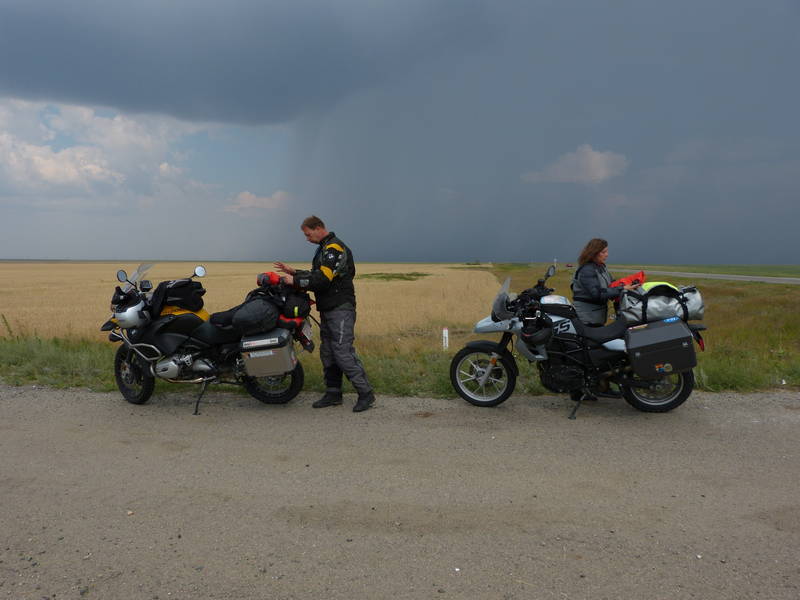
Wide open spaces and little traffic

Our new found friends (thanks for the ice cream!)
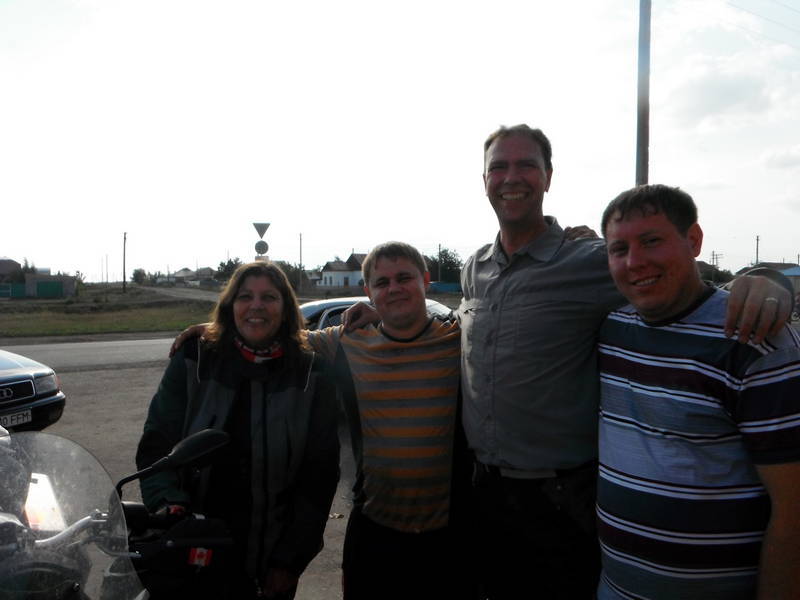
Stopping to set up camp on the vast plain

A breakfast of coffee/tea and instant oatmeal (purchased at some point in Eastern Europe as we were trying to spend one or the other currency before crossing a border) and then back out to the highway. When we went through the roundabout back onto the main road it immediately became very rough and soon we were pounding through twenty kilometres of a construction zone with enormous potholes, rough rocks and dust. Despite it being 10:00 o'clock in the morning it was already 27 degrees and we worked up a sweat passing the slow moving trucks. Apparently in Kazakhstan, when reconstructing a road the road itself is completely closed for up to 50 kilometres and a bulldozer driven beside the road to clear a path for the traffic. The construction was finished at a small town and we were able to pop into a café for lunch and refreshment. The hot dog was very interesting as was the pastry filled with mashed potatoes. It was also interesting to see the proprietor use an abacus to add up our bill. Continuing our ride we noticed convoys of Chinese trucks heading west, Dongfens and Shacmans, all nice and shiny and new. Will the Chinese start making inroads into the European truck market? As we approached Astana we could see an enormous black cloud settled over the city so we put on our rain gear, getting a bit of rain as we rode through the suburbs but the main reason for the gear was to keep ourselves a bit cleaner as the roads were extremely wet and dirty. We found a hotel and were settled in by 2:30 in the afternoon. A short walk away was Line Brew, a fine restaurant that was over our budget but had delicious food. Walking south across the river into a central park we encountered a huge fun fair with bumper cars, shooting games, cotton candy and loads and loads of people, all enjoying the lovely evening. Down the river was a stunning bridge that looked like it could have been designed by the designer of the Peace Bridge, Calatrava. Getting on the internet back at the hotel we did a bit of searching but could not find any reference to a Calatrava bridge in Kazakhstan.
Breakfast of instant oats
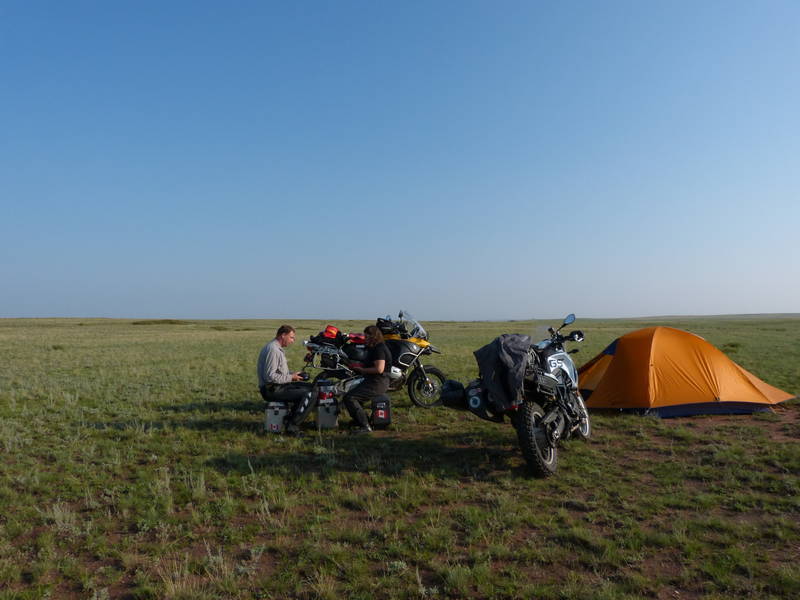
Leaving the camp spot
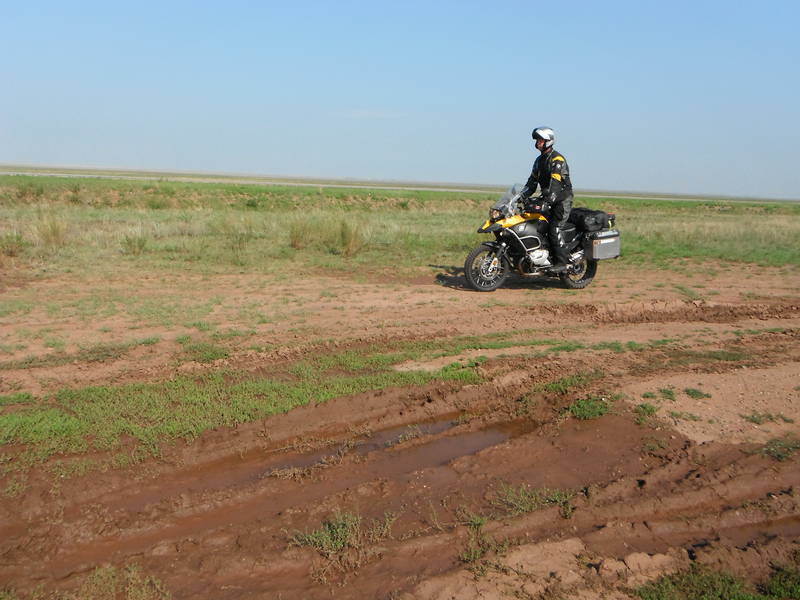
Car breakdowns are so common that ramps are often available at rest stops

Yummy dinner at Line Brew in Astana

Fun fair in the park

This doesn't look terribly safe (Dad is casually hanging on to the rope with one hand)
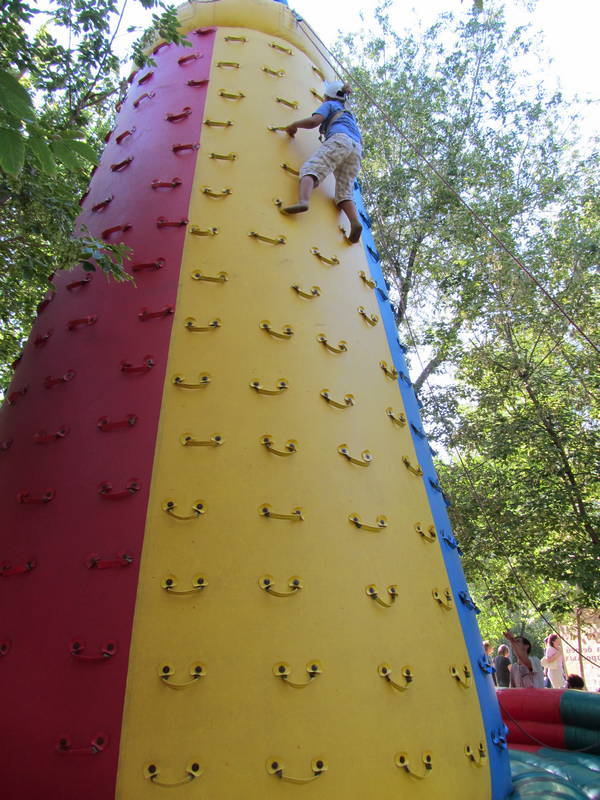
Ekke tries out the exercise equipment in the park
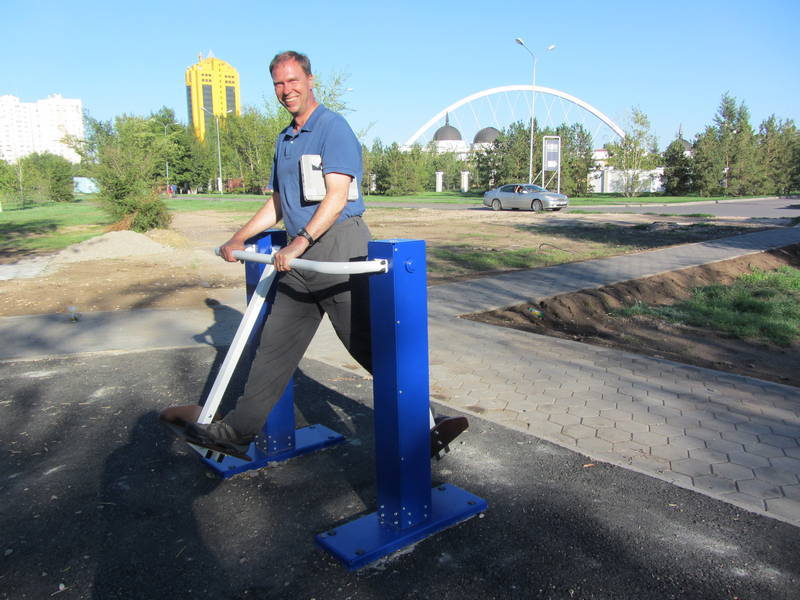
This looks like it could be a Calatrava-designed bridge but it isn't

After breakfast the next day we walked a few kilometres to New Town, where all the really stunning new buildings are located. Along the way we stopped off at a couple of shopping malls and found the same stores that you would see anywhere else, Adidas, Reebok, Tom Tailor, et cetera. Actually the two malls had exactly the same stores in them; it was like they were carbon copies of each other. The Khan Shatyr was an entertainment complex/shopping mall at the far end of the Nurzhol Bulvar and was our first destination. Sure enough the shops were identical but there was also an arcade and water park at the top of the transparent tent-like structure. The Norman Foster designed building is the highest tensile structure in the world. Even more interesting for us though was the discovery of a Cinnabon in the food court. Suitably sweetened we left the Khan Shatyr and started walking down the boulevard in the direction of the Presidential Palace at the far end. Wow, the shiny new buildings reminded us of Dubai with their out-of-this-world shapes and designs. After passing underneath the state gas and oil company headquarters we came upon the place I would work if we lived in Kazakhstan, the Ministry of Transport and Communications. I'm sure that they have an entire floor dedicated to transportation data. And a civic cafeteria on the top floor with all the mashed potato filled pastries you could eat. Half way to the Presidential Palace was the Baytarek Monument, a golden orb sitting high atop a structure that resembled the open petals of a flower. We took the elevator to the top for grand views over Astana. There were three levels in the orb and the topmost level had a golden hand print of the president, Nursultan Nazarbayev, where one could put one's own hand. We lined up and put our hand in his. As I was leaving a woman asked where I was from and gave me a brief rundown on the handprint. Apparently I was supposed to make a wish when I had my hand in there. Maybe next time. She also said that the handprint was at exactly 97 metres high, representing the year that the capital of Kazakhstan was moved from Almaty to Astana. I responded by saying that I was almost two metres tall, did anything interesting happen in 1999? Judging by her blank stare I assumed not. Back on the ground we walked the remaining distance to the Presidential Palace and then found a bus going our general direction back to the hotel. After a fast food supper at the first mall (Star Burger wasn't that great, give it a miss if you're in Kazakhstan, Audrey says the KFC was good) we walked back through the park to the hotel, stiff and tired from a full day of walking in 30 degree heat.
Audrey is ready for a day of walking in Astana
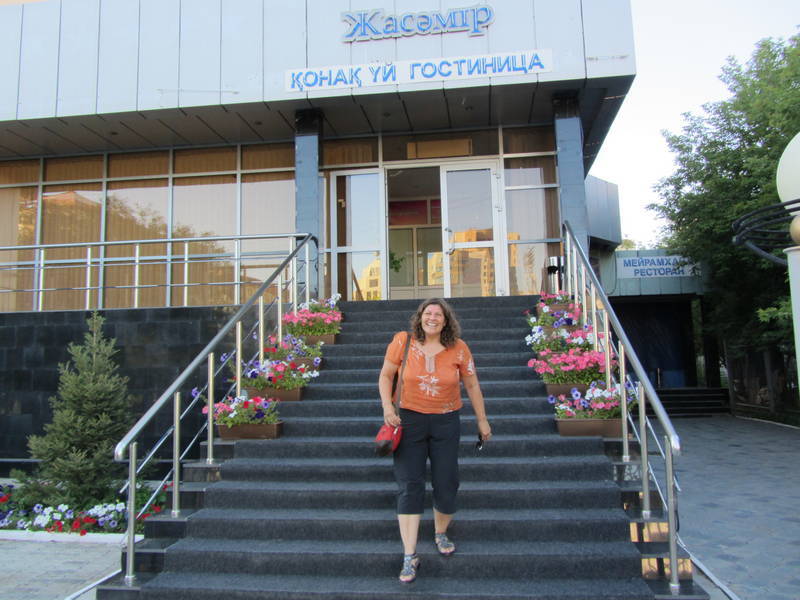
Khan Shatyr entertainment complex
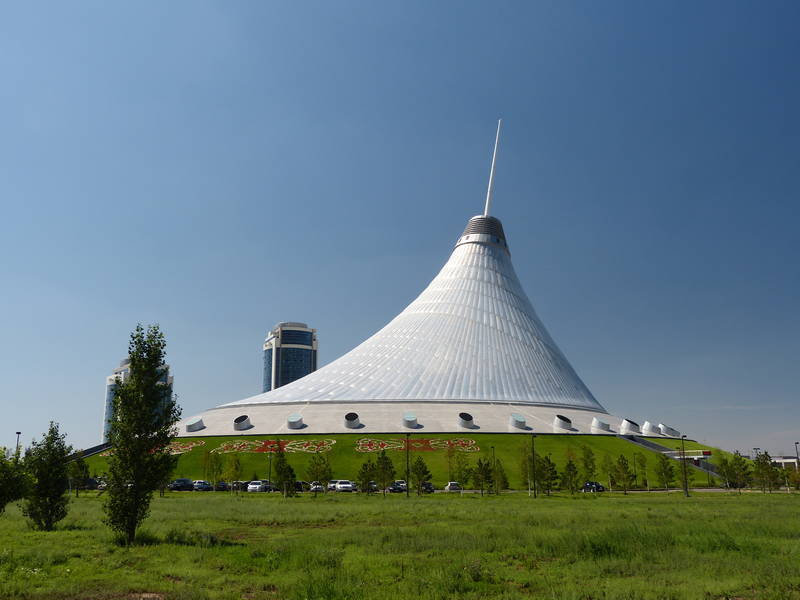
Amusement park is at the top of the tent

The headquarters for Kazakhstan's national gas and oil company
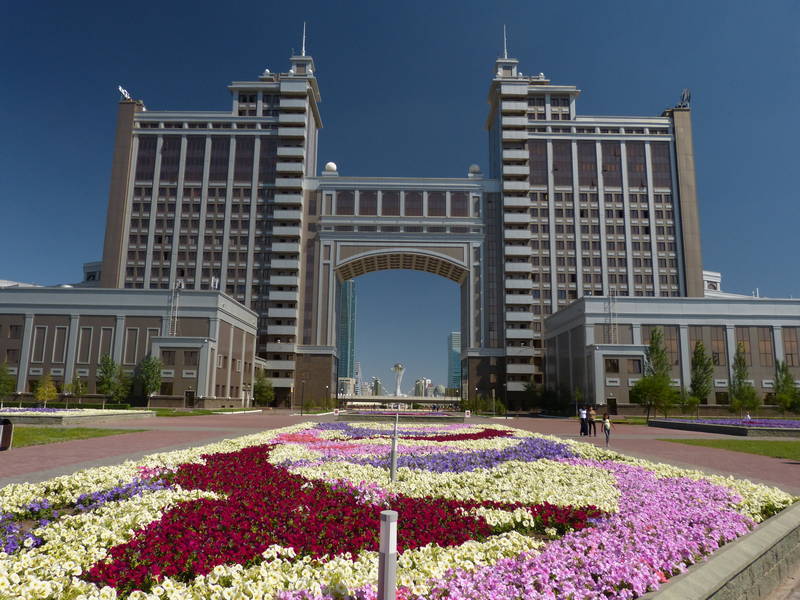
The Transportation and Communications tower on the left (transportation data probably has its own floor)

Beautiful Nur-Astana Mosque
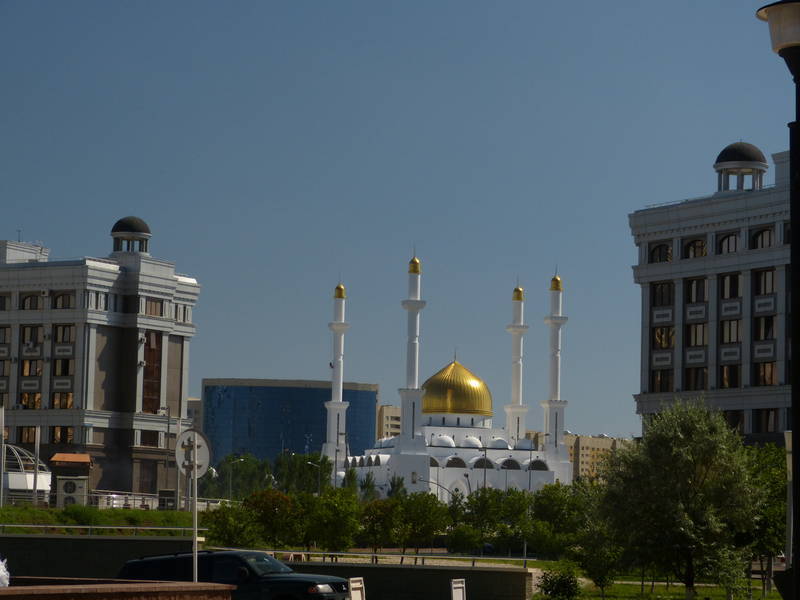
Wild architecture

Audrey checks out an artificial tree near the Baytarek Monument

Ekke puts his hand in the hand print of President Nazarbayev
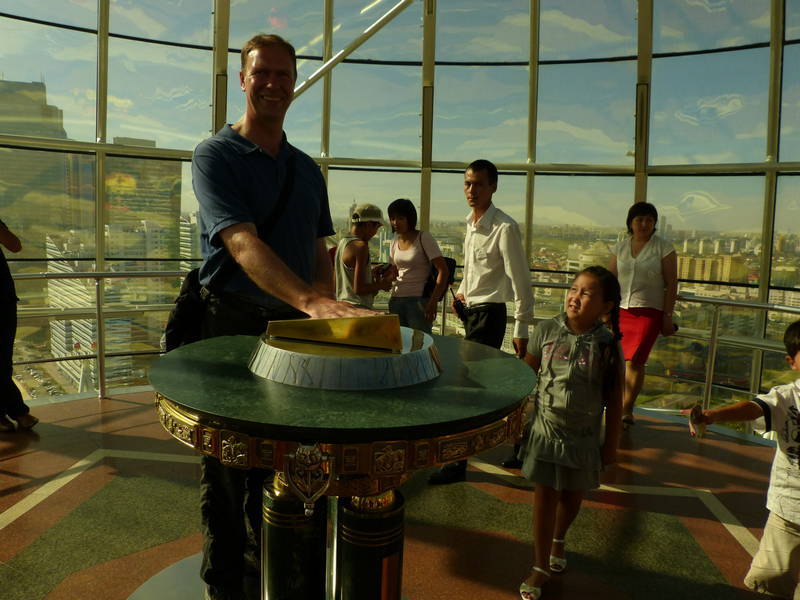
Spectacular view from the top of Baytarek Monument
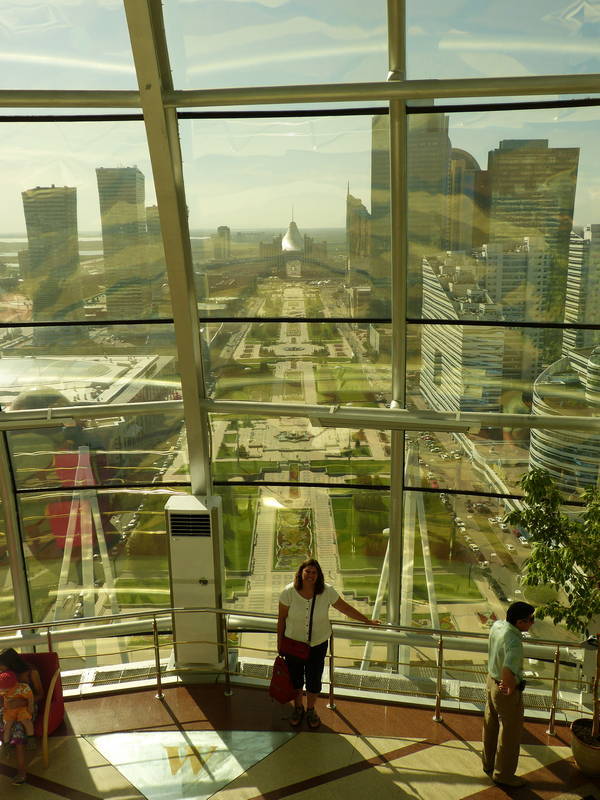
Walking towards the Presidential Palace

Audrey writes:
Our hotel had the option of staying for twelve hours or twenty-four hours with the checkout time being based on arrival time. In our case this was 2:00 pm. We took advantage of the extra time and internet in the room to upload our website, then went on our way. The ride out of Astana on August 7th was fairly easy. Our route took us past some landmarks we had seen the day before. Ekke found a parking spot for us in front of Bayterek Monument to set up a photo, but we would have to set up the tripod on the road. A guy walking past us offered to take our picture and seemed very interested in our trip. He invited us to stay with him when we came up through Astana again, and he did email us to reissue the invitation. Although busy, the road to Karaganda had good pavement and passing trucks on the 2-lane road was easy. As we approached Karaganda, the road just stopped due to construction. The detour indicated left, but it seemed to lead us out of town. Most of the traffic was going that way, so we just followed and eventually made it to the hotel by a very convoluted route. We had read about this place in a great little book called "In Search of Kazakhstan", by Christopher Robbins. If everything you know about Kazakhstan was learned from Borat, then you need to read this. He explains how apples came from here, spends some time with President Nazarbayev, finds out about nuclear testing, local gulags, Dostoyevsky's exile, and learns about the Russian Space program. He stayed in the Cosmonaut Hotel, so we decided to stay there too. The desk clerk was probably appalled at a couple of dusty motorcyclists walking on their marble floors, and seemed surprised when we agreed to pay $200 (cough, cough) to stay for the night. The cosmonauts land nearby and are put up here after their journey, so how could we not stay? It was a beautiful place with all the amenities and we kept anything that said Cosmonaut Hotel on it (slippers, shoe horn, etc). Dinner in the lounge was very western, an authentic clubhouse sandwich, hamburger and fries, and the Olympic balance beam event was on TV, in Russian.
Leaving Astana we stop off at Khan Shatyr
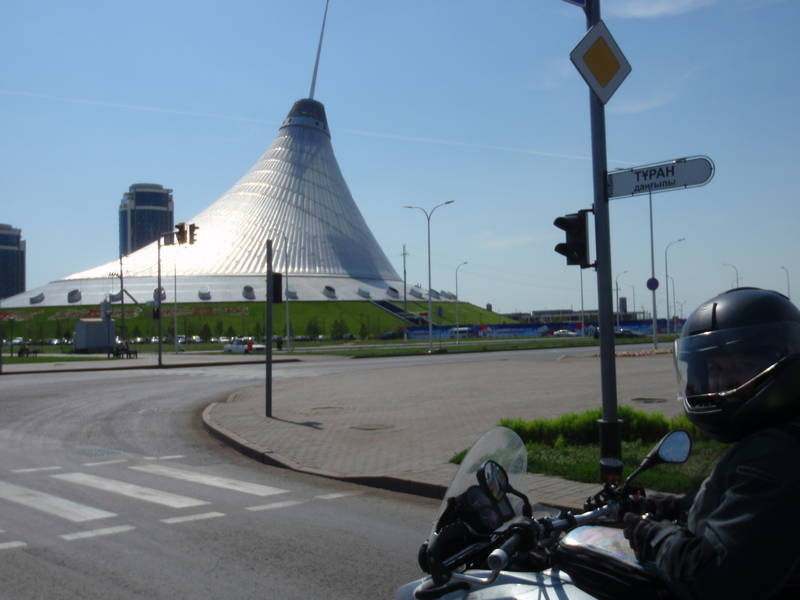
And at Baytarek Monument
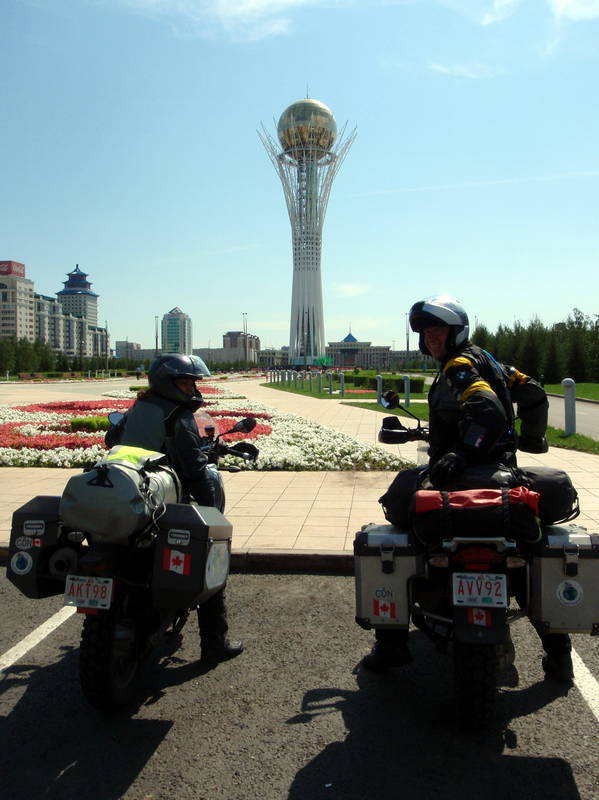
Tempted by roadside sales

Pulling up to the Cosmonaut Hotel in our own "space suits"

That robe looks comfy

The roads the next day were not bad, again two-lane with a few bumps now and again. Many big trucks meant lots of truck stops and we ate lunch at one of them. We had learned the word 'laghman', or long noodles and sauce, so Ekke confidently ordered it for lunch. I pointed at another customer's soup and it was delicious, with fresh vegetables grated on top. A truck driver, Suliman, sat down near us. With his three words of English and our three of Russian, we learned that he drove with his two brothers and son and they were on their way to Mongolia. About halfway through the day we arrived at the northern end of Lake Balkhash, a huge lake that is even on my world map. It was our constant companion for about half the day. Our destination was a hotel that Ekke had found on the GPS, near the lake. But, alas, the hotel was closed and we found ourselves in a small town with the sun about to set. We had something to eat at a cafe so we could sit down and have a look at the GPS. Luckily, we could just point to some food in a display case, but I wanted to know what was in the pastries. The lady got a big kick out of it when I mimed different animal sounds and actions, and she eventually sold us two "Moo" pastries. At the gas station, we ascertained that there was a hotel in town, so we rode in on one of the roughest roads we had been on so far. There were a few pieces of pavement in between big sandy bumps but that soon ended and it was just the loose sand. Some guys holding beers ran over to us and made us take our picture with them, and it was still unclear when we asked them whether there was a hotel in town or not. So, we rode around and came across a nice, new hotel. It looked a bit like a love hotel, with a symbol of a couple of intertwined rings on the front. But, it was too new, not yet open for business, so there was nothing else to do but head up the highway. There were some trucks parked down by the lake, and a 'P' for parking sign, so we rode down a hill and discovered that trucks parked there for the night. A small beach seemed like a great place to put up the tent. People were swimming and having a great time fishing from the dock. Just as the sun went down, all activity ceased and the people disappeared into a building or their truck cabs. We soon learned why when mosquitoes started dive-bombing us and we hurried into the tent. After killing about 20 of the little yellow critters, we were able to get some sleep until someone decided to walk around with a bright light at 1:00 am.
More wide open spaces

Interesting funiary structures
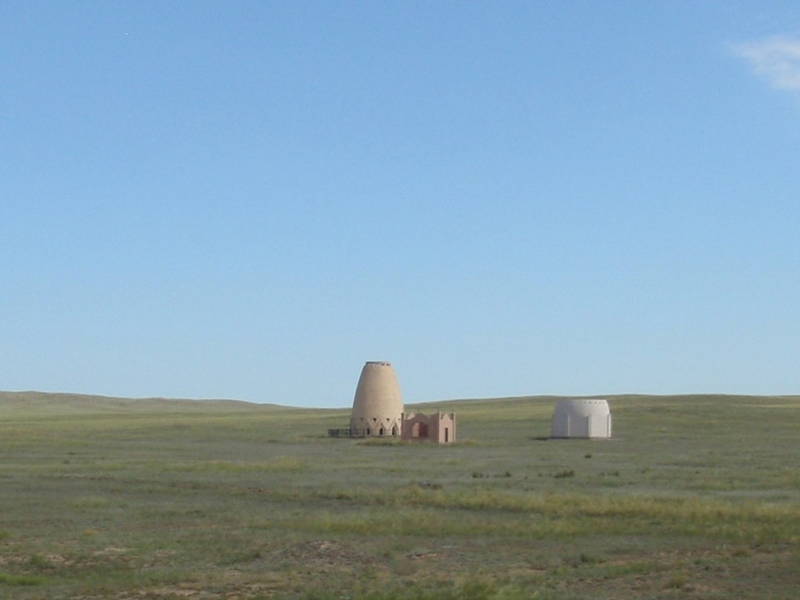
Taking a break

Young gentlemen insist on taking their photos with us

Riding into the sunset, it is time to find someplace to camp

The road deteriorated quite a bit the next day, August 9th, but the motorcycles could generally avoid the huge bumps and grooves. A group of huts appeared around lunchtime, with barbeques going out front, so we sat under an awning outside and enjoyed some grilled mutton. Then we rode and rode and rode, past the most uninspiring scenery we had ever seen. Dead grass to the right and left, the vast steppe stretching as far as the eye could see. The only thing of interest was a group of grazing camels, where we stopped for a photo op, but that was it. A camel herder galloped up on a horse shortly after and chased the camels away from the road. The temperature reached + 37 C. It actually didn't feel too bad and as long as we kept moving and caught a bit of a breeze. Also, wrapping the water in some clothing insulated it enough so that it was still drinkable. As we approached Almaty, it got a bit greener, and then there were trees, and we caught a glimpse of the snow-covered mountains through some clouds. The back road into town wound past wooden or concrete houses, trees on both sides of the road, through construction zones, and over some deep gravel where I almost lost it. Vehicles were passing the slow-moving traffic, probably where they shouldn't have passed, but it seemed the only way to get anywhere, so we did it, too. We were cooking along pretty good and came around a corner under a dark overpass when suddenly vehicles were in our lane, coming right at us. We were on a one-way off-ramp going the wrong way and we got some beeps and high-beams flashed at us. A quick u-turn set things to rights. Phew. The Uyut Hotel was nice, with parking right out in front of the main door, so we just locked up the bikes and left them there for four days. Parked nearby were several cars from the Mongol Rally.
Camped at the edge of Lake Balkhash

Truck stop restaurant wasn't open for breakfast

The ruts in the road can be pretty bad (these are OK, couldn't take a picture in the bad ones)

Lunch time kebap
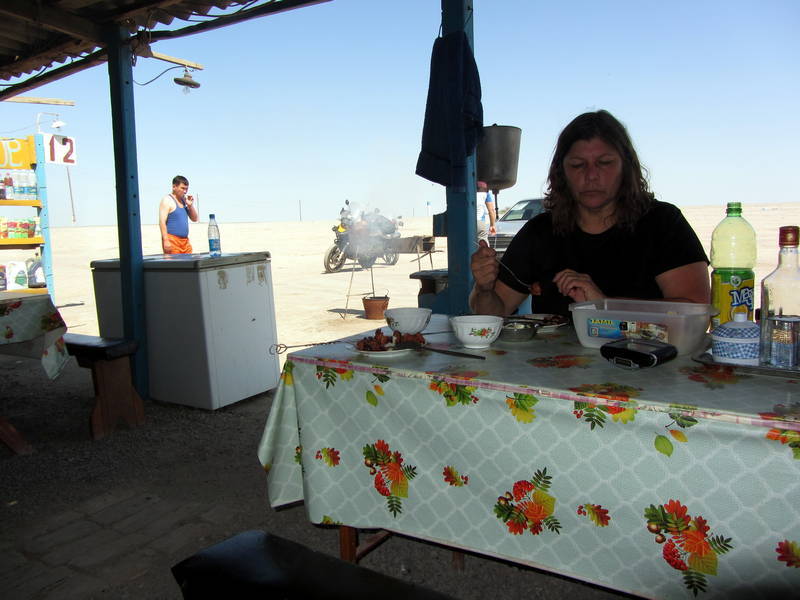
Camels (OK, dromedaries really)
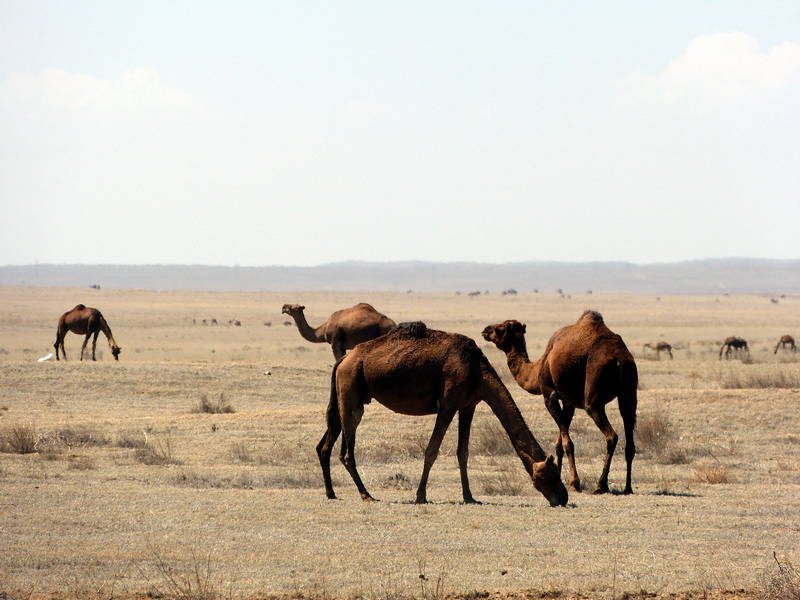
Once again we've ridden our motorcycles to a land where they have camels

The camel herder comes along to shoo the camels away from the road

Arriving at the Hotel Uyut

Lonely Planet found us a great restaurant, Mama Mia and the pesto penne was the best I've ever had. But I didn't know how to ask for no ice in my drink, (something)-On-The-Beach, and the next day my stomach rebelled. Some corn porridge was all it could take at our breakfast buffet. Job #1 in Almaty was to get our Mongolian Visa, so we took a cab for a fixed price of 1500 tenge ($10) to the Mongolian Embassy at 9:00 am. We should have asked the cab to wait, as the process only took fifteen minutes. A form in English was easy to fill out and we opted to pay double, or $232 for express service for two of us, so the visa would be ready by 1:00 pm that day. The other choice was to wait until Tuesday. Luckily we had brought enough U.S. dollars with us. Our GPS showed a shopping mall about three kilometres away, so we decided to walk there to kill some time. But, with fencing set up for a construction zone, we had to walk way around a residential area which took us in the wrong direction. The hot, dry, hilly walk turned into six kilometres, but at the end was a beautifully air-conditioned Mega mall. From there we wanted to catch a cab back to the embassy. Outside the mall, a guy approached us and said, "Taxi", so we said, "Da". He wasn't a real taxi driver and was just using his own car. But we knew this happened in Almaty, people just stand on the side of the road, hold out their hand and people with cars give them a ride for a fee. We said, "Mongolian Embassy" and he said "1000 tenge" without really knowing how far we were going, and we negotiated a lower price. He drove in the right direction at first, then he got on the phone and asked someone for directions, and then drove way past the turnoff to the embassy. Luckily Ekke had the GPS with him and showed him the map. We had to convince him to do a u-turn on a super busy road so he cut off an SUV, muscled his way between cars with millimetres to spare, hit the brakes hard several times, and eventually got us to the embassy. By now it was after 1:00 pm and the gate was locked. We were worried that they were now closed for the weekend and that paying for express service would be a waste of money. What a relief when the visa officer came out, handed us our passports through the gate and said goodbye in Mongolian. The 'taxi' took us back to our hotel, and I was so glad my seat belt worked. Ekke's didn't, so it was fortunate that we didn't need them.
Mountains south of Almaty on the way to the Mongolian Embassy
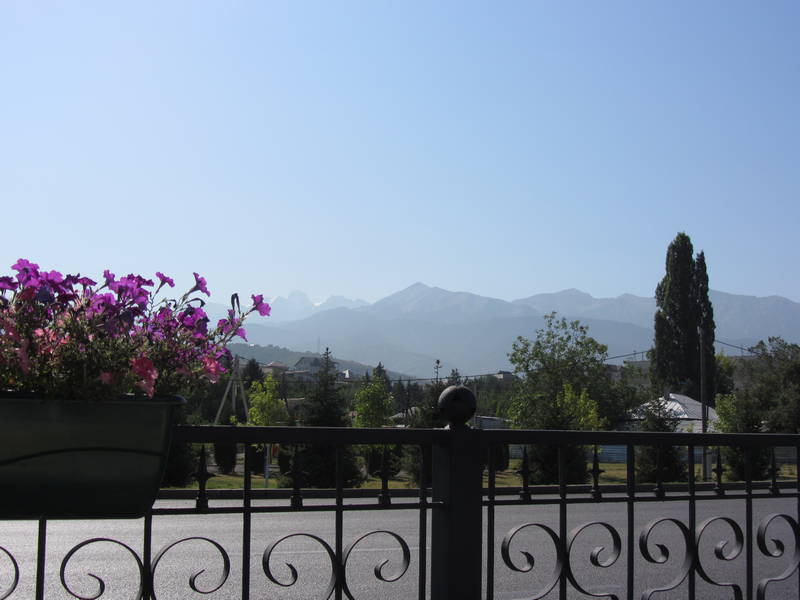
Happy to be at the Mega Mall

Air conditioning is turned up for the indoor skating rink
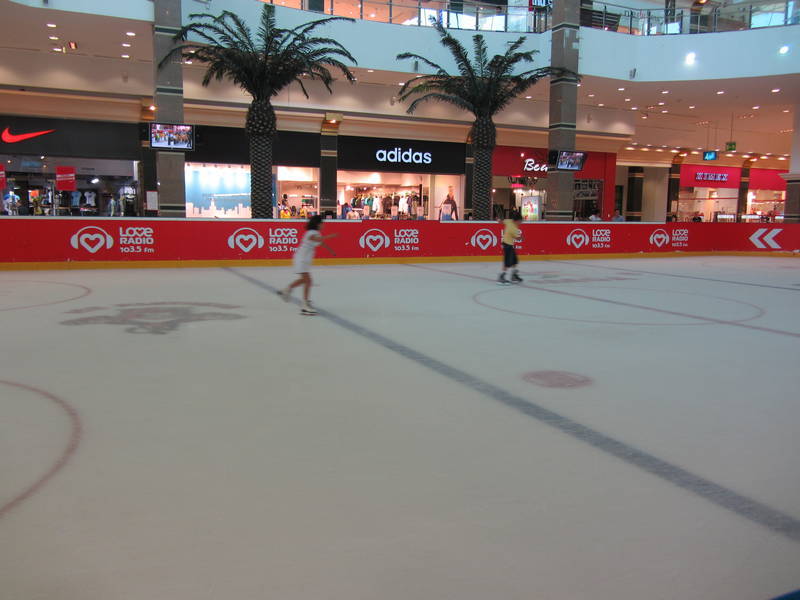
The description of the Zhety Qazyna restaurant in Lonely Planet sounded great, and it was beautiful inside. You could choose from three decors, European, Japanese, and Central Asian, which was our choice. Ekke likes to get adventurous with food, so he chose the camel milk, which, judging by the expression on his face, possibly came from the other end of the camel. I ordered spinach and cheese dumplings, which I thought would be about the size of your average large perogie. We had a great laugh when they brought them out - they could have fed a family.
Yes, camel milk tastes this good
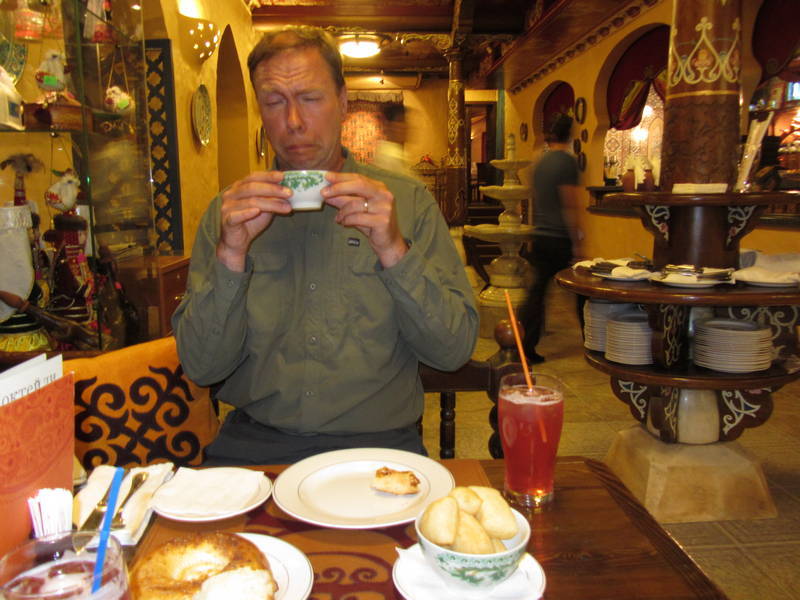
Audrey tries a delicious, though extra large dumpling (she has two more on her plate)
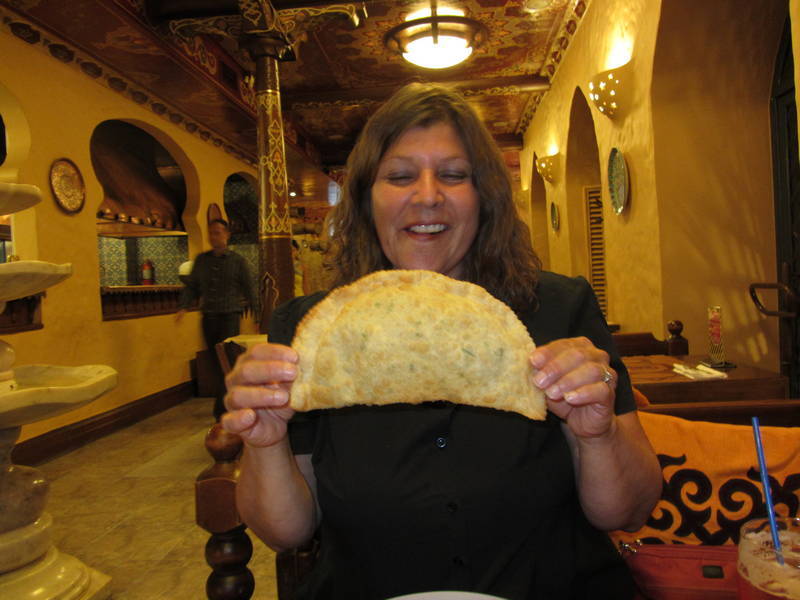
A lot of time was spent working on the Russia website in our room, but we did manage to fit in some sight-seeing. On our way out of the hotel we noticed a guy checking out our bikes. He was French, and was just riding back from Mongolia on his BMW R100 GS. He apologized for his poor English, which was way better than my high school French, but managed to tell us about the rough 'roads' in Mongolia. We wished him well on his trip home through the 'Stans. Looking at photos later, we realized we had taken a picture of his bike riding by as we were walking in Astana. Small world. Ekke and I walked to beautiful Panifilov Park to look at Zenkov Cathedral. The colourfully painted structure was gorgeous on that bright, sunny day and we got some great pictures. It is very interesting because it is made entirely of wood, even the nails. Inside, women had their heads covered but it is not required of non-Russian Orthodox visitors like me. Further along a path in the park was a gigantic war memorial honouring soldiers of WWII and the Russian Revolution.
Zenkov Chathedral made entirely of wood


War memorial
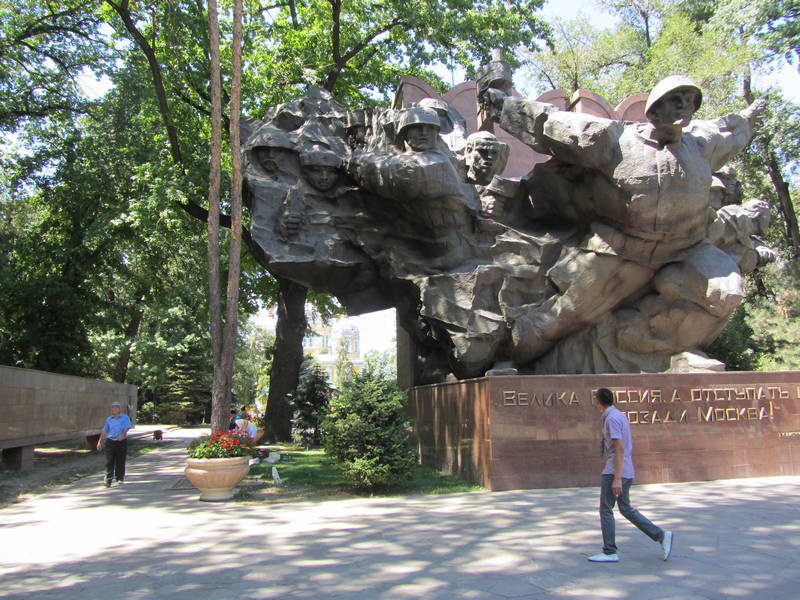
Almaty's a pretty modern city and has a huge department store on the pedestrian mall. An entire floor was devoted to cellphones. It seems everyone here has one and are always chatting or texting. We also wandered among a whole floor of Kazakhstan souvenirs but it was too overwhelming to buy anything. There was just time to jump on the metro and get to the state museum before closing. Each metro station was decorated differently and our favourite had murals depicting the silk road. Almaty was a centre of silk road trade and crafts in the tenth century. The metro was only eight months old, and just sparkled because of a team of cleaners pushing Swiffers all over the marble floors. Families were having a great time riding up and down the long escalators, taking photos of each other. The escalator to exit was humongous. We timed it: three minutes long.
Riding a three minute long escalator up from the metro
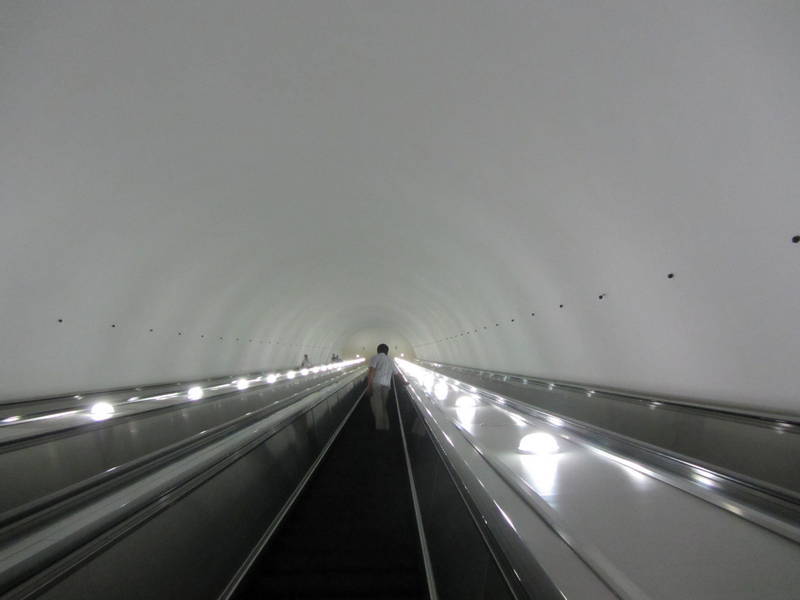
Silk road artwork in the metro station

The Central State Museum was just the right size and since all the info cards were in Russian and Kazakh, we saw everything in an hour and a half. No photos were allowed of the displays but we did get a photo of the Golden Man replica in the hall. The real Golden Man, found in a nearby tomb, is locked up in a bank vault at an undisclosed location as his warrior outfit contains hundreds of pieces of gold. The warrior is a sort of unofficial symbol of the country. There is evidence that it is really a Golden Woman, as all the other artefacts found in the tomb point to to a female being buried there. Among the historic displays was a full-sized yurt all kitted out with traditional carpets and cooking pots. I was looking forward to seeing a real one out there on the Steppe. Armour, weapons and jewellery were on display, and a huge pair of leather and fur boots that I'm sure are the original Sorels. The museum only cost 100 tenge (67 cents) each to get in but the clerk wouldn't tell us that. She kept asking us questions, very surly and annoyed. She was probably asking us if we wanted to buy tickets for the special room. After visiting the main exhibits we wanted to do just that. Ekke sent me back to buy the extra tickets and take the heat for not having bought them in the first place. They cost 1300 tenge ($8.67) each. Her annoyance was palatable. But, it was worth it. The extra exhibit included hundreds of gold artefacts found in Scythian tombs near Almaty. We walked into a vault and the gold fairly glowed from its perch on red velvet inside various display cases. Some of it was in the shape of jewellery, but most were little gold leaves that had been used to decorate clothing. There were lots of animal motifs like antelope, big-horned sheep, moose and some strange creature with huge, curled antlers.
Entrance to the State Museum
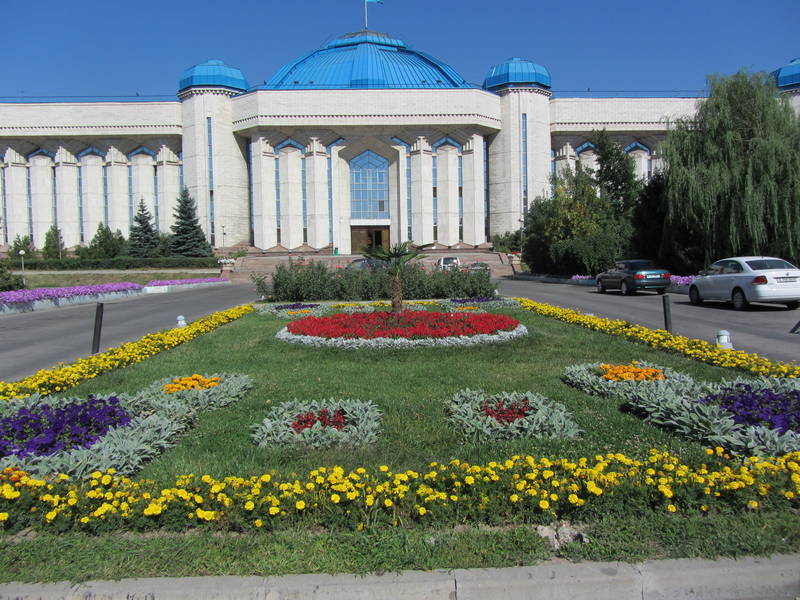
Replica of the Golden Man statue

Random motorcycle shot in Almaty
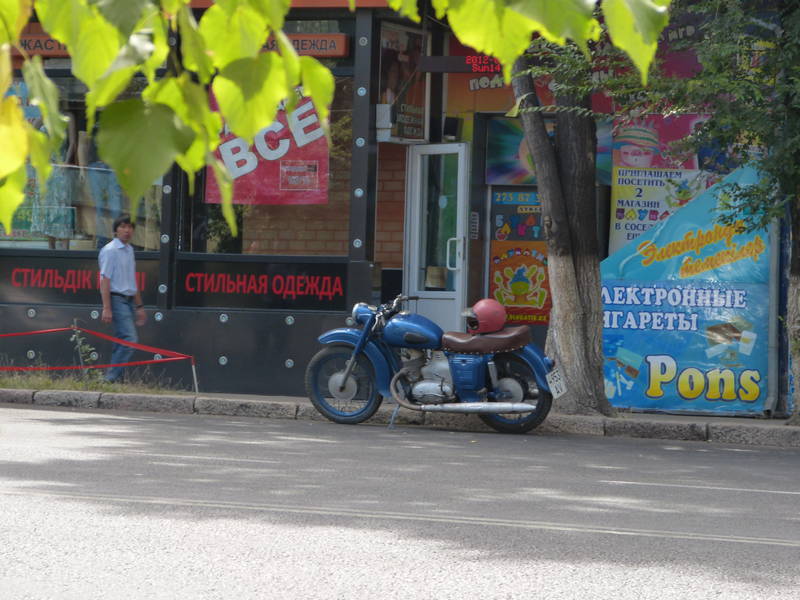
More time was needed to finish the website, so we stayed another day. It's so easy to get comfortable with a place, knowing where restaurants are, knowing how to use the metro, but we knew we'd have to get going for sure the next day. There was enough time to squeeze in a visit to Kok Tobe, a cable car up a small mountain. Views of the city were great, and it was a real family place with amusement park rides, a petting zoo with fluffy chickens, and of course, The Beatles statue. Why is there a statue of the fab four on a mountain-top in Kazakhstan? Read all about Kazakh's love of The Beatles in the book "In Search of Kazakhstan".
Riding the cable car to the top of Kok Tobe

Enjoying an iced tea in the shade
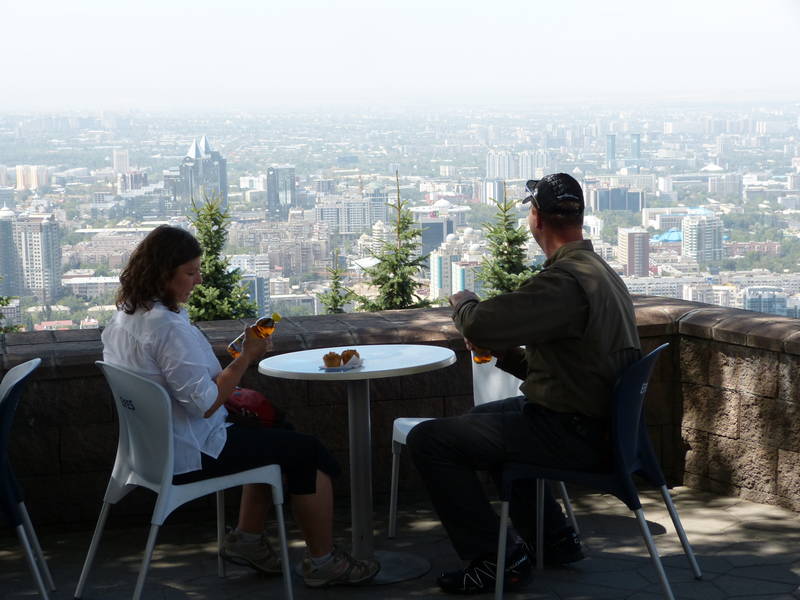
Lovely views of the mountain range to the south (Kyrgyzstan on the other side)
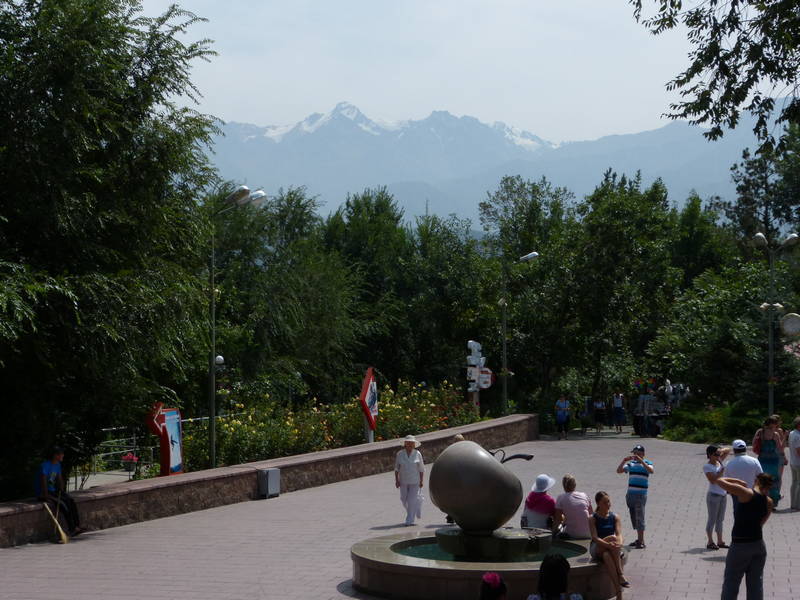
Souvenir stands at the top of Kok Tobe
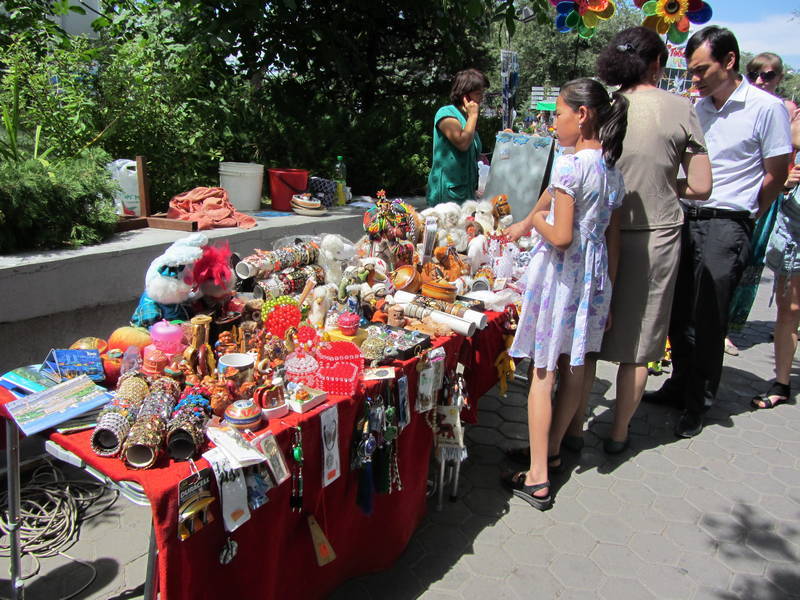
Fluffy chickens in the zoo

Of course we had to see the Fab Four
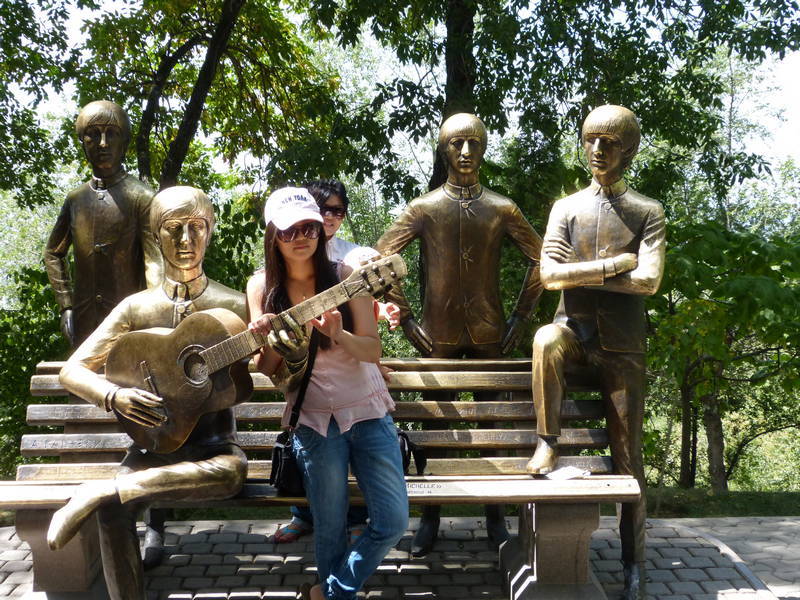
Walking through a market on the way back to the hotel

Ekke writes:
We did a quick write up of Chapter 3 of the website on Monday morning and then walked over to the post office to mail some souvenirs home before packing up and getting out of the hotel at Noon. Only a few crazy drivers made the ride more interesting and on the whole it was good riding going north. A bizarre little place adjacent to a reservoir was like a mini Las Vegas with a half dozen casinos scattered around the desert. Further along, we pulled over in the shade of a tree to drink a little water when a loaded motorcycle came to a stop beside us. It was Matt from the UK. He had ridden through Turkey and Iran, then the 'Stans and was now heading to Mongolia. His ultimate goal was to be in Kuala Lumpur for work. Since Matt was running low on gas after passing by several closed gas stations, and we were headed the same direction, we decided to ride together for a while. We rode behind him to the next gas station which, thankfully, was open. The three of us stopped at a café at around 6:00 PM and had a great conversation with the occupants of a Lexus that had passed us earlier and given us a big thumbs-up. The passenger, Paul, had a great sense of humour and had just enough English to get him in trouble. After dinner it seemed the shadows were getting quite long so we thought that we should probably find a place to camp for the night. While a road heading into the hills looked tempting, it was also a little exposed and it would be easy to see our bright orange tent, garnering unwanted attention. A little further north we found a small side road leading into a field behind some trees so we rode in a few hundred metres. A level spot looked good for the tent and Matt went over to the local melon farmer to ask if it was OK to camp there. He came back with the remains of a watermelon (fell off the bike on the way back), a couple of extra dog scrapes to add to his collection and the OK to camp. We washed off the watermelon and cut it up. Simply delicious. It was too hot for the fly on the tent so we left that off and slept under the stars, sort of.
Hopefully this is a right hand drive Toyota RAV4
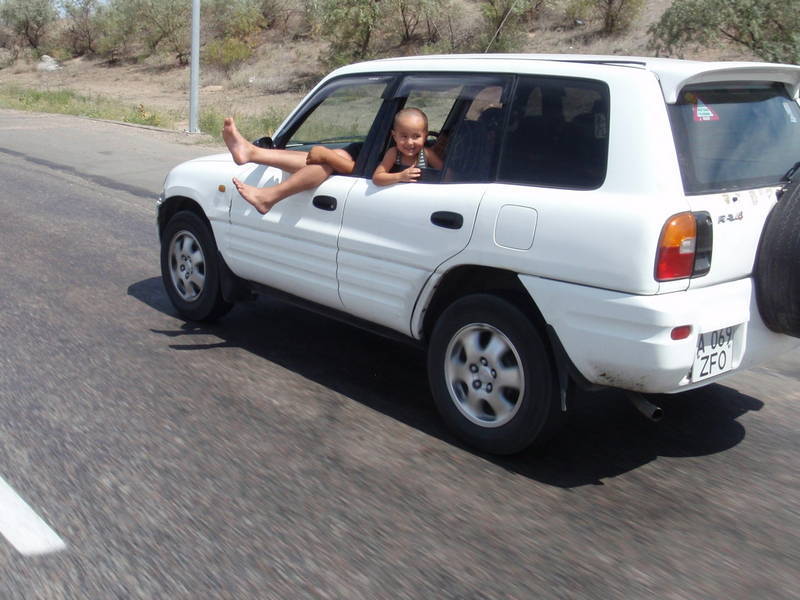
Aladdin Casino north of Almaty
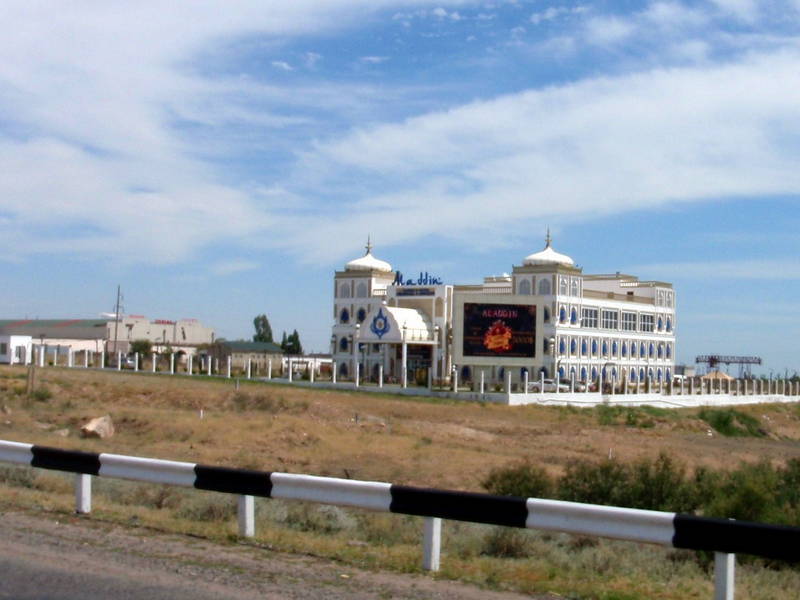
Ekke does a double take (A casino in the desert? It'll never fly!)
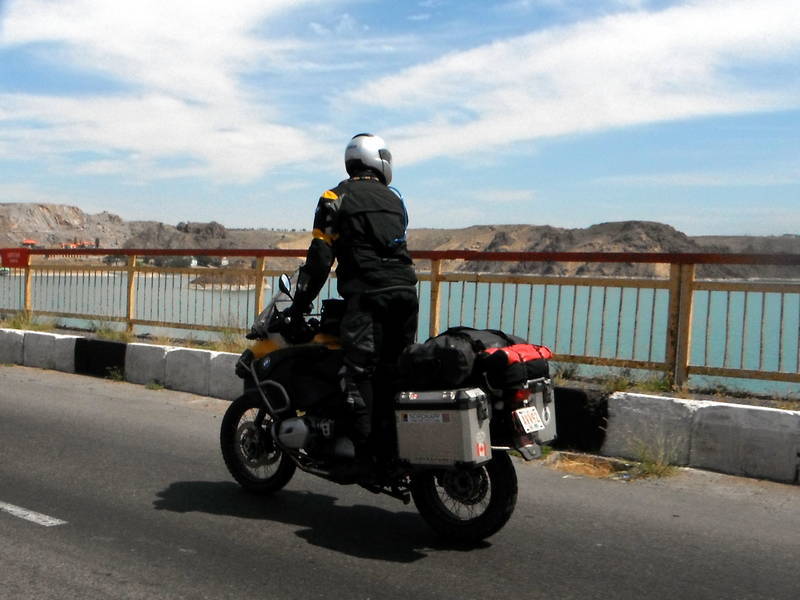
Ekke enjoys the first curve he's seen since the Ural Mountains
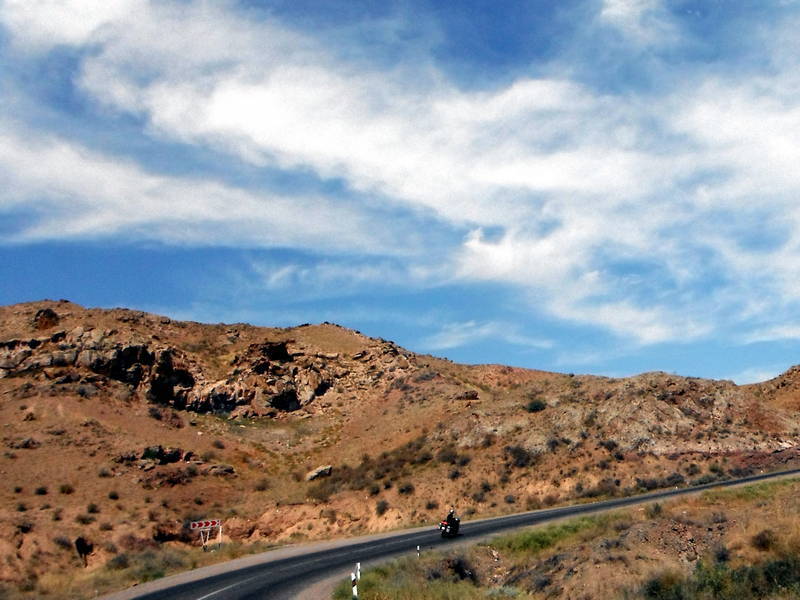
Matt pulls up
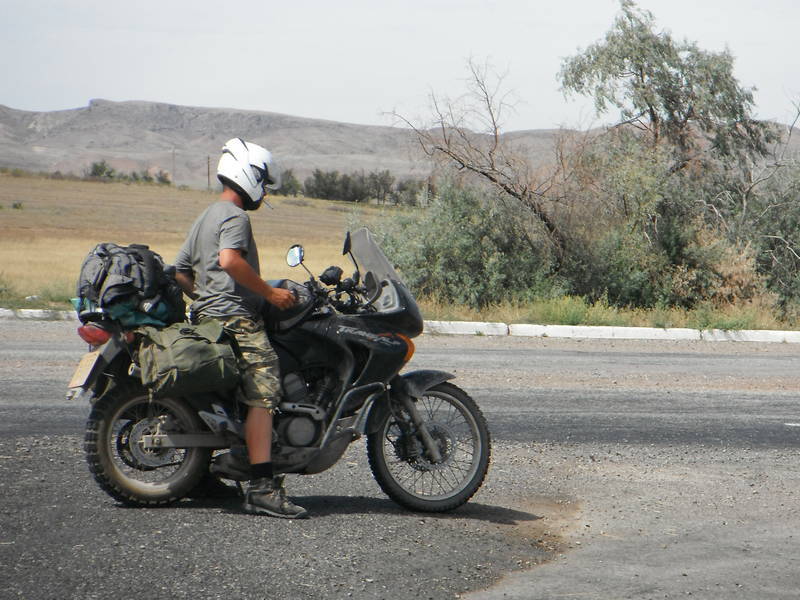
Following Matt on the way to a gas station
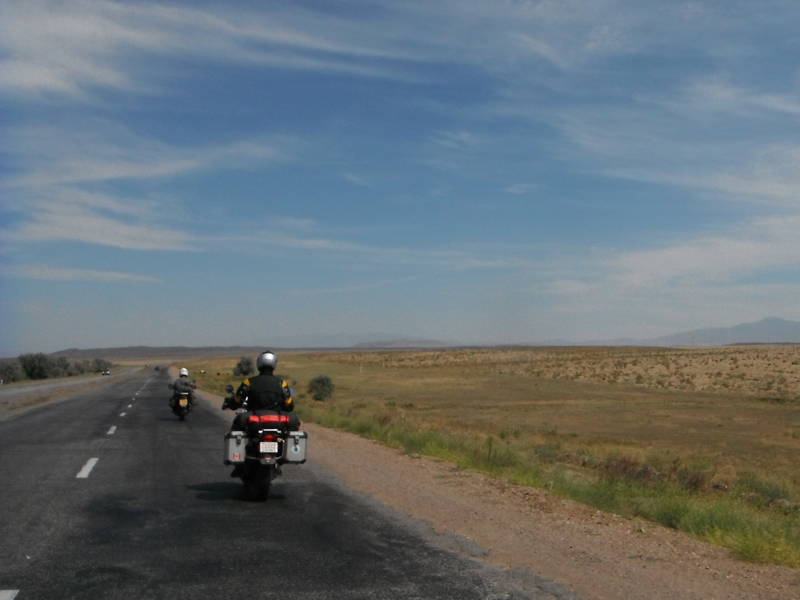
A yurt in the wild!
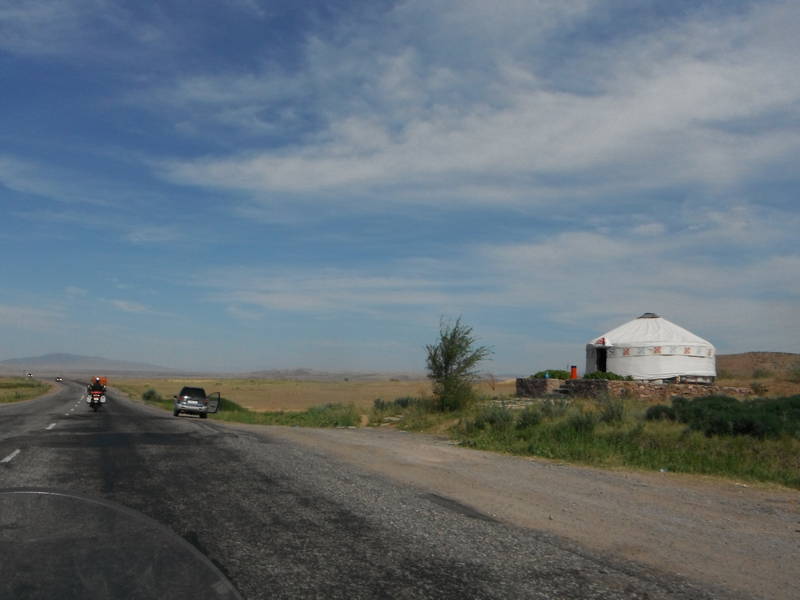
More interesting funiary arrangements

And of course those wide open spaces
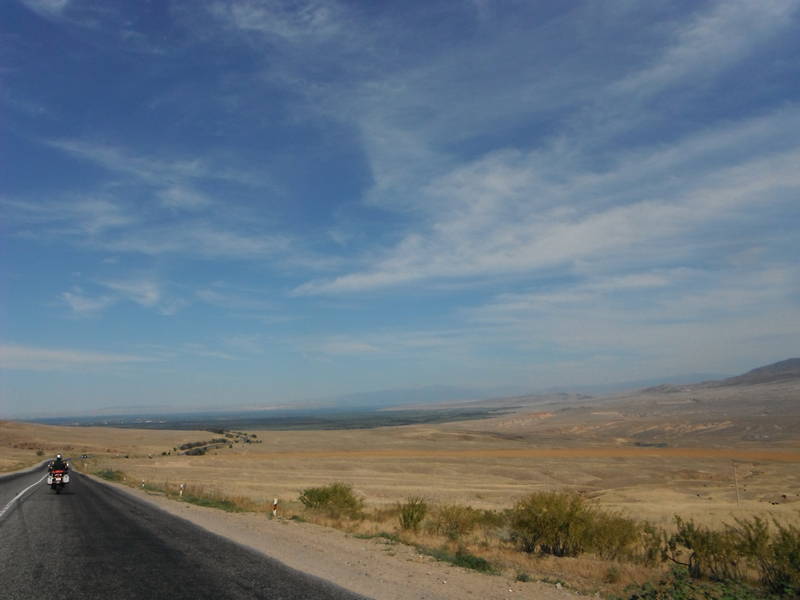
Entrance to a town
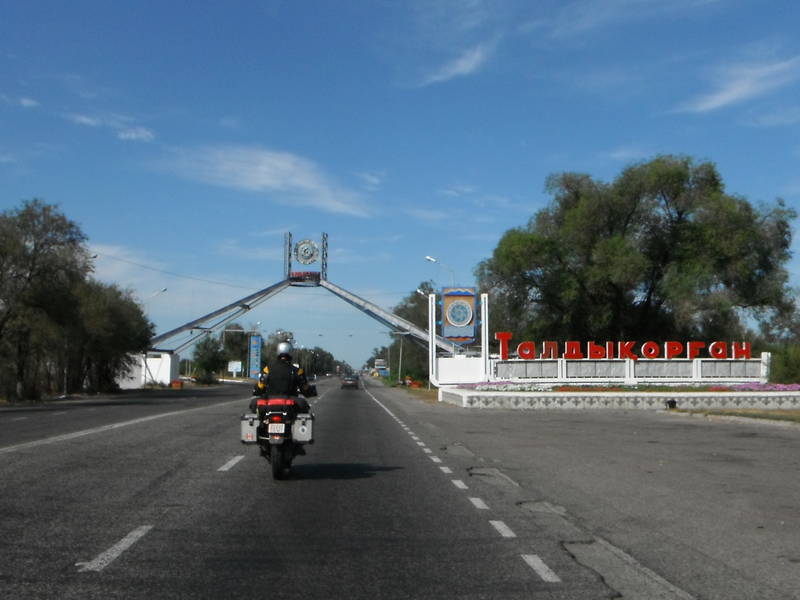
We meet Paul and his Lexus driving friend, lots of fun!
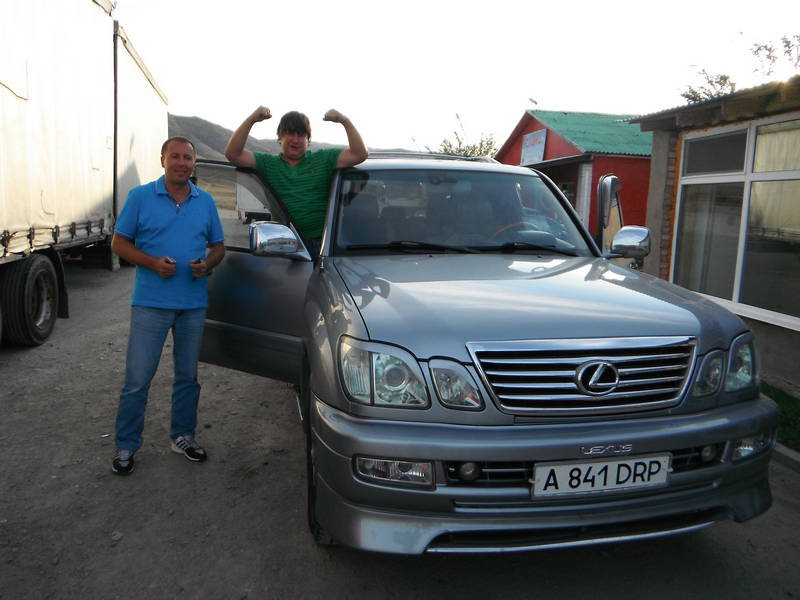
Matt comes back with the OK to camp and the remains of a watermelon
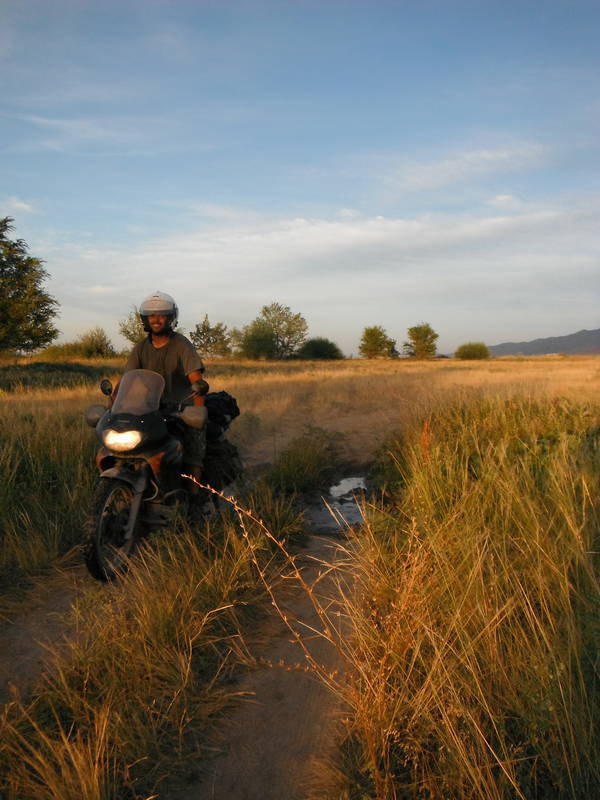

Setting up camp outside the melon patch

Delicious!
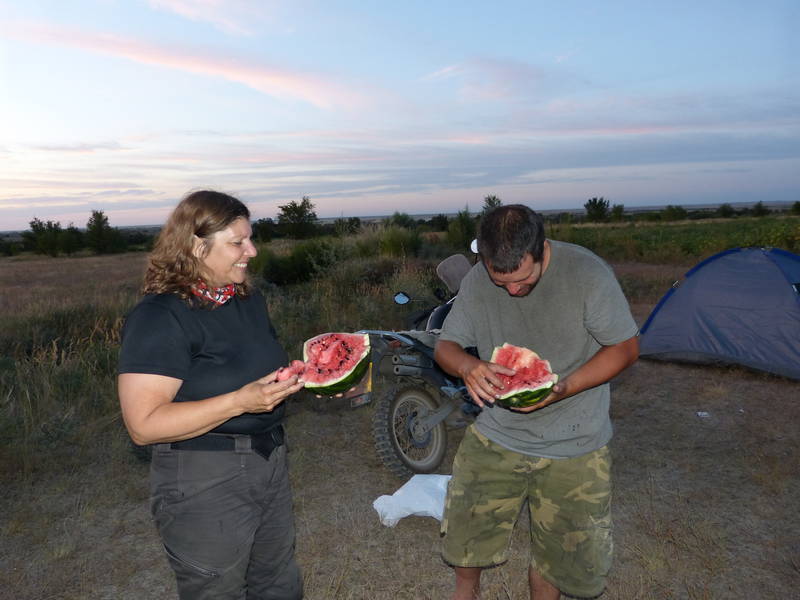
In the morning, the melon farmers drove by with their Lada full of melons heading to the market. They stopped by our tents and Audrey went over to thank them for letting us stay. The passenger reached into the back and handed us a couple of honeydews. What a perfect start to the day, the sweetest honeydew ever. At the next town up the road we found a café that didn't look terribly hygienic but rustled us up some fried eggs, over easy. It would have been nice to figure out how to order fried eggs so that we could have them more regularly. It was another hot day of riding in the mid-thirties. You know it is hot when it cools down a bit and you look down at the thermometer and see that it says 32 degrees. A small town had people sitting beside the road selling apples and since Kazakhstan is the home of apples we couldn't very well leave without having any apples. A small boy wanted to sell us an entire bucket of apples but we only wanted three as there wasn't room on the bike for a bucket of apples and a honeydew melon. When we were standing by the motorcycles and getting ready to go all of a sudden the boy ran over with an entire bag of tomatoes. How nice! But where to put them? Eventually some space was found in one of my saddlebags and we headed out. Having the melon and apples later in the day we found that the honeydew wasn't quite as tasty as the one in the morning but the apples were fabulous, crisp and sweet. The tomatoes weren't crushed yet so the tent wasn't soaked in tomato juice but we didn't want to take a chance and had to dispose of them. The GPS indicated an "unnamed hotel" along the road north so we headed there, arriving a little before dark. If the hotel didn't turn out we would need to find a wild camp pretty quickly. But, there really was a hotel behind the café. Only one room was available and it had two small beds. I volunteered to sleep on the floor on my nice comfy Exped but since we paid 1,200 tenge each ($8) I wondered what exactly I paid for since I had brought my own bedding. As we were having dinner in the café the woman who rented us the room came over and asked to have her photo taken with us and the bikes. Always willing to meet the fans we agreed and went outside. Strangely enough she didn't have a camera. Now we have a bunch of photos of her and her friend with us on our camera and she has none of us.
A couple of honeydew melons for us

Breakfast restaurant
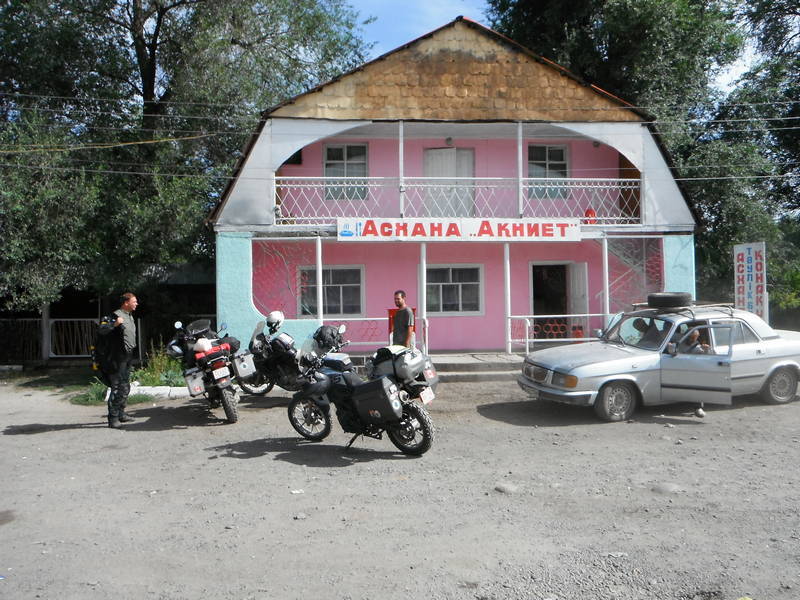
When in the land of apples we should really try the apples

Apple seller goes back to building a house of cards

Matt, "The Kazakh cemetaries are amazing. Rather than putting up a headstone they build entire castles when someone dies."
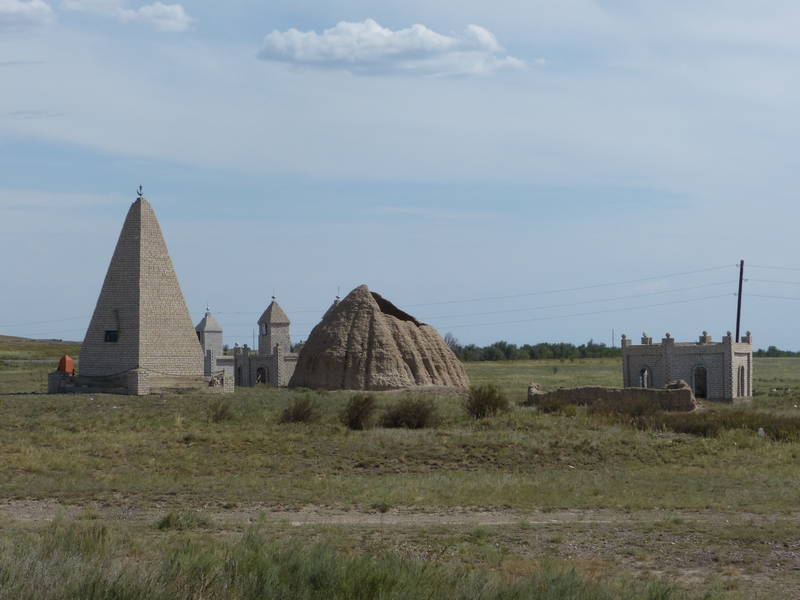
A wild grass fire relieves the monotony of riding the endless plains
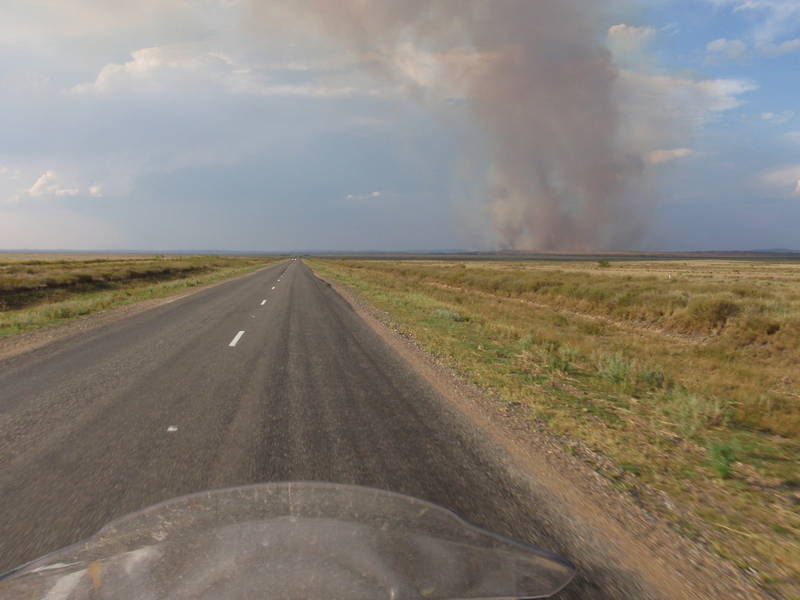

Audrey rides into the setting sun

With Matt not far behind
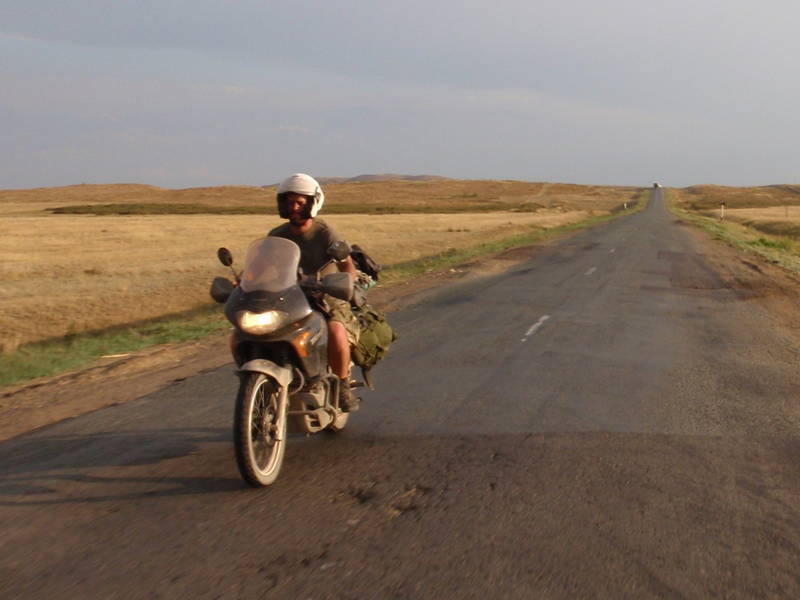
We find this three room motel behind a cafe (two of the rooms were taken)
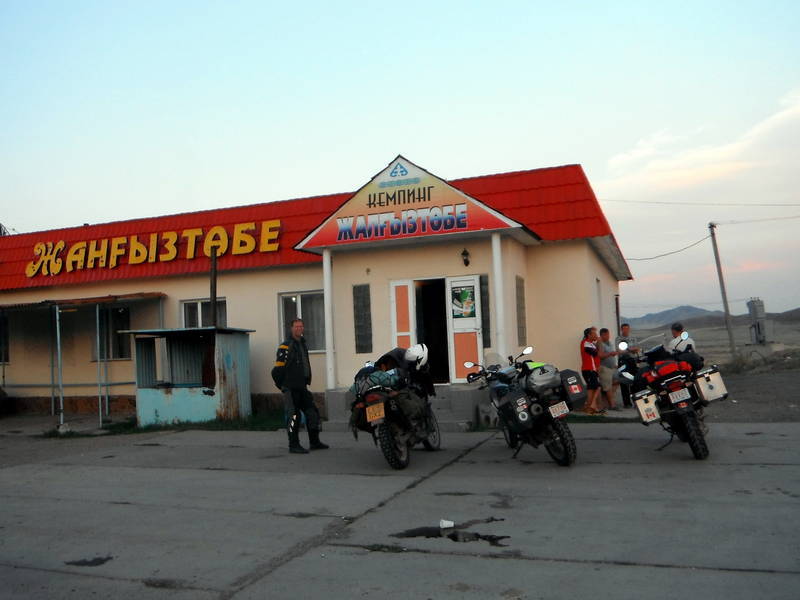
It was a hot night in the tiny little room since we didn't open the window in case strange insects came in but we did get some sleep. We asked about a shower the next morning and were shown a room out back where Audrey and I washed up. Very nice but now she wanted to charge us an additional 600 tenge each. We tried bargaining and suggesting that the photo of her the day before was 600 tenge but we don't think she understood and ended up paying the full cost at the time of breakfast. Breakfast consisted of a mashed potato filled pastry. We rode north a little ways to Georgievka and then, donning raingear after gassing up, rode east to Semey. A few kilometres out of town we found the most interesting construction zone yet. It was still raining when we hit the mud but the rain storm had filled all the holes with massive water puddles. The trouble was that when the holes were filled with water it was impossible to tell if it was going to be a small pothole or a motorcycle-swallowing monster. There was about 15 kilometres of this and then we had a section of bad pavement, back to the mud for a little more fun and then brand spanking new pavement for a while before getting a bit more of the really bad pavement. What made the bad pavement interesting was that the road was really wide and cars and trucks were using the entire width of the road to try and pick the best possible route through the mess, no matter which direction they were headed. Eventually, covered in mud, we arrived at Semey for lunch at a café, where the usual chicken dance had us eating chicken in no time. North of Semey, towards the border, we tried to spend our last tenge on snacks since, based on our experience entering Kazakhstan and that of other travellers using this border exit, we wanted to be prepared to spend three hours in the queue to leave Kazakhstan. Pulling up to the gate there wasn't much of a queue when we arrived, one car. And they entered the customs compound just after we parked. We obtained a couple of pieces of paper from the guard and waited a few minutes until he opened the gate to let us in. Then a matter of minutes in the queue for passport control, where our pictures were taken again and I received a lecture for not having registered at a hotel within five days of entering Kazakhstan but was let off with a warning not to do it again. Then we left Kazakhstan, snacks uneaten.
Riding towards Semey we run into a construction zone in the rain

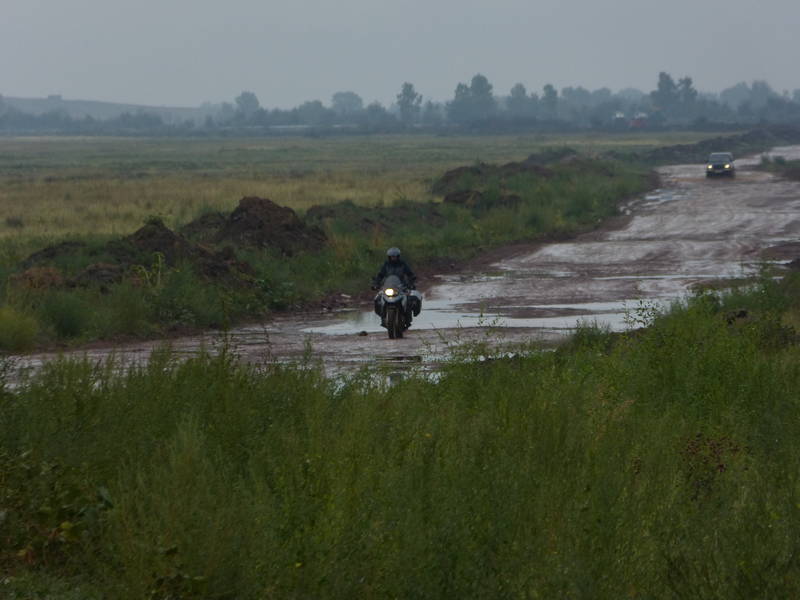


Matt doesn't look too impressed
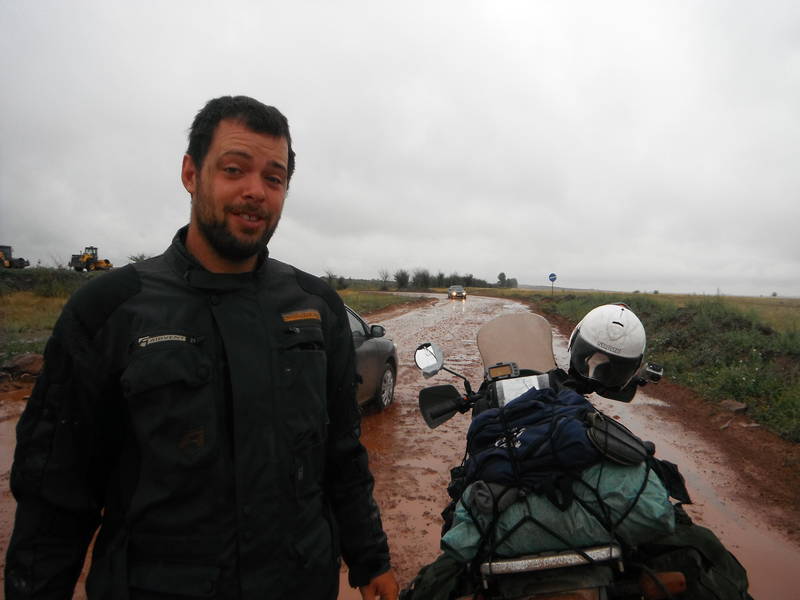
The pockmarked, wide pavement leads to interesting driving as everyone tries to take the best route
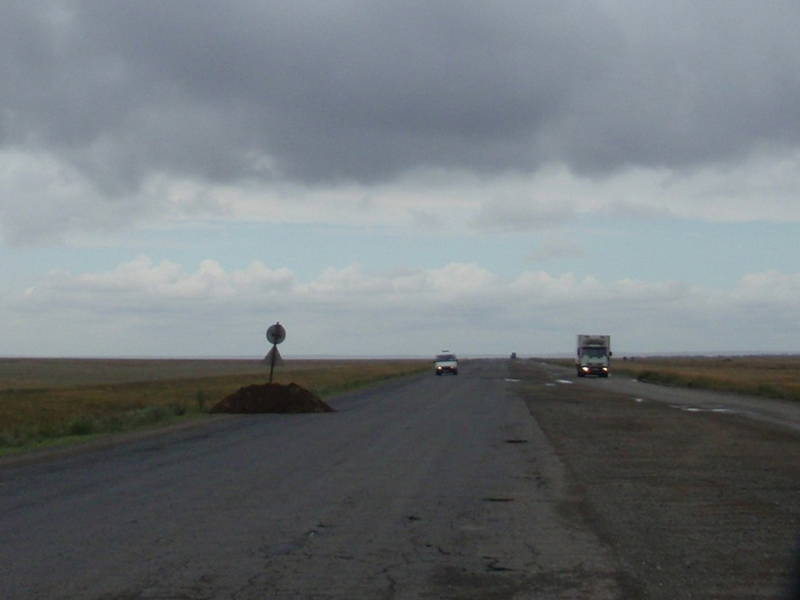
President Nazarbayev wishes us a fond farewell (at least that's we imagine the sign says)
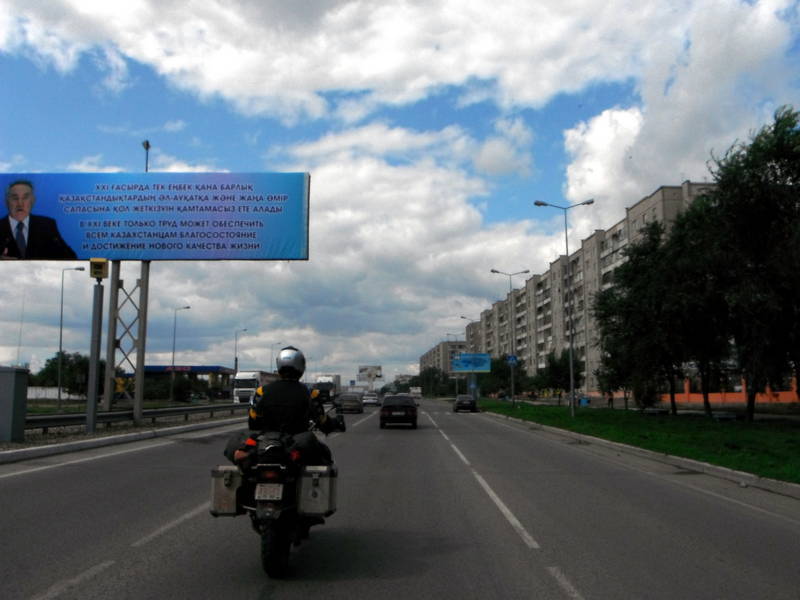
Map of our route through Kazakhstan
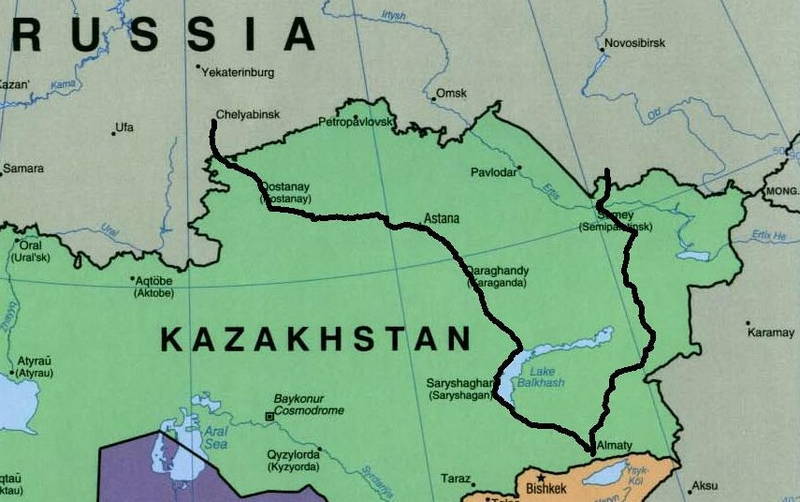
With our snacks still uneaten we left the Kazakh side of the border and went to the queue for the Russian side. Matt simply rode past the line of cars and trucks (accompanied by the sound of only one annoyed horn) to the gate so we followed him. The gate guard was just closing the gate but when he saw us coming he swung it open again and motioned us inside. There was only one vehicle in the compound so we parked beside it and entered the shack. We filled out the immigration documents and handed them to the official who then stamped our passports. As we left we asked where to go for the customs inspection and paperwork but he responded with a, "Nyet." Sure enough, outside there were no other buildings between us and the exit gate. Just as we mounted the bikes the same official came outside and asked us to open our saddlebags for a customs inspection. Proving once again that one shouldn't volunteer information at a border crossing, just keep your mouth shut. In any case, it was a very cursory inspection and we didn't need to fill in the customs declaration form that we had to do at the St. Petersburg end of things. We hoped that this wouldn't cause problems when we exited Russia. Outside the compound we went in search of an insurance seller and exchange office as Matt had no Russian rubles. There was no exchange so we simply paid for Matt's insurance and he could pay us back when we got to an ATM in the next town.
It was only 60 kilometres to Rubtsovsk where three hotels showed up on the GPS. The first hotel wanted 3,500 rubles ($110) per person for the night so we went in search of the next hotel. There was nothing resembling a hotel at that location so off we went to the third hotel. While trying to get there through a parking lot we asked a passerby where the entrance was. He indicated it was a bad hotel and that we should follow him instead to a good hotel. So we followed him in his CRV to the north end of town, the direction we wanted to go the next day. He pulled into a gas station and motioned to an apartment building that had Hotel written on the side. We thanked him and off he went. The main entrance was just to a restaurant, no hotel. At the side entrance to the apartment building was a sign (in Cyrillic of course) that might have indicated that a hotel was on the third floor. We rang the bell and a woman came online, sounding a trifle annoyed. We apologised and started to walk away. She came on again and buzzed the door open so we entered and climbed three flights to what appeared to be a hotel. We got a double room for ourselves and were able to explain (through a lot of gesturing) that we would like a single room for our friend. Since there was no real parking available except as part of the gas station and it wasn't very well lit we pulled up on the sidewalk and chained everything up. Inside we pulled out the instruction manual for the factory alarm system on Audrey's bike, figured out how to program the remote and then set the alarm for the first time. The landlady shooed us down to the restaurant and when we went inside, plates of steaming hot tortellini were placed in front of us. I asked for a chai which came quickly enough but when I asked for sugar I got a "Nyet". Soon enough we realised that they were closing because we had lost another hour due to a time zone change. All in all it was a strange evening. In other words, it was a perfect cap to an interesting day that included a wet construction zone in Kazakhstan and an easy border crossing.
Arriving at dusk in Rubstovsk
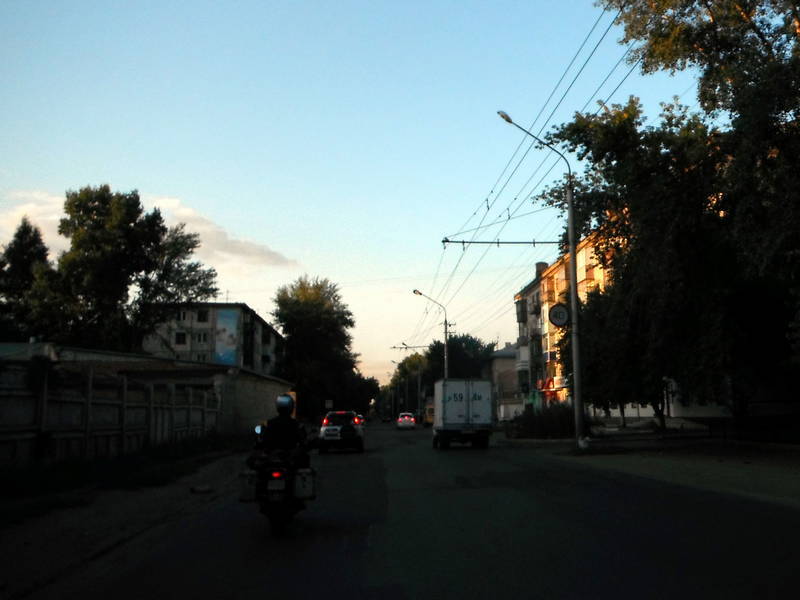
Guided to a better hotel

On Thursday morning, the 16th of August, when we popped down for breakfast we were pleasantly surprised to find our motorcycles still where we had left them. There were four possible menu choices for breakfast and since we couldn't read any of them we just chose the first three. I was the lucky one to have macaroni and a meat patty. After finding an ATM and getting some more rubles we rode north to Barnaul. It was the easiest ride of the entire trip. It had warmed up to about 24 degrees, there was a good tailwind, the road was good and the traffic fairly light. As we hadn't had Internet access in a while we wanted to check in somewhere in Barnaul. We couldn't find anything and were pondering our options at the side of a busy road in the middle of Barnaul when a local biker pulled up and asked if we needed assistance. He led us to what used to be an internet café but it looked like it had been long closed. Around the corner was a restaurant though so he popped in and asked if they had wi-fi. Sure enough they did and with a wave he was off. Nice people everywhere. We spent an hour or so getting caught up with e-mails and so on while having delicious sushi. It was getting on to 5:00 PM when I checked the GPS and found that if we left promptly we could make it to a wild camp spot 240 kilometres east of town around about sunset. After stopping for fuel once we were at the turn off to a dirt track about ten minutes after the sun had set. The track led to the shores of the Katun river and there were a few clear spots where a tent could be set up. There were already a couple of spots taken but there was still plenty of room for us. The tents were pitched just as darkness fell.
Yummy macaroni and a meat patty for breakfast
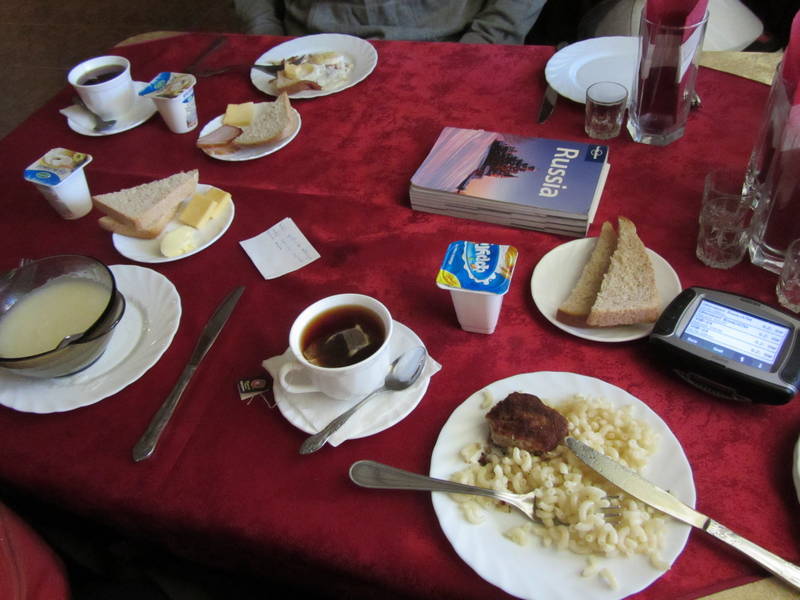
Easy riding, warm, tail wind, light traffic, good road
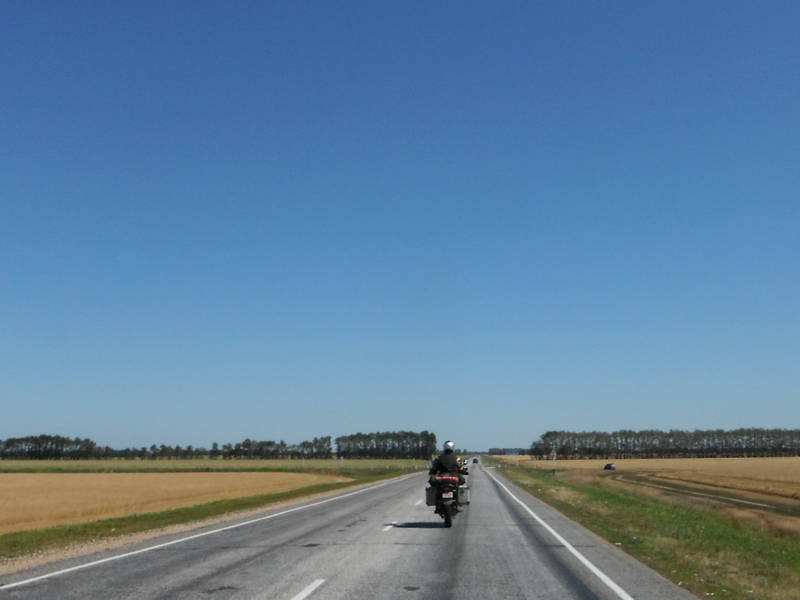
Arriving in Barnaul a local biker leads us to a wi-fi restaurant
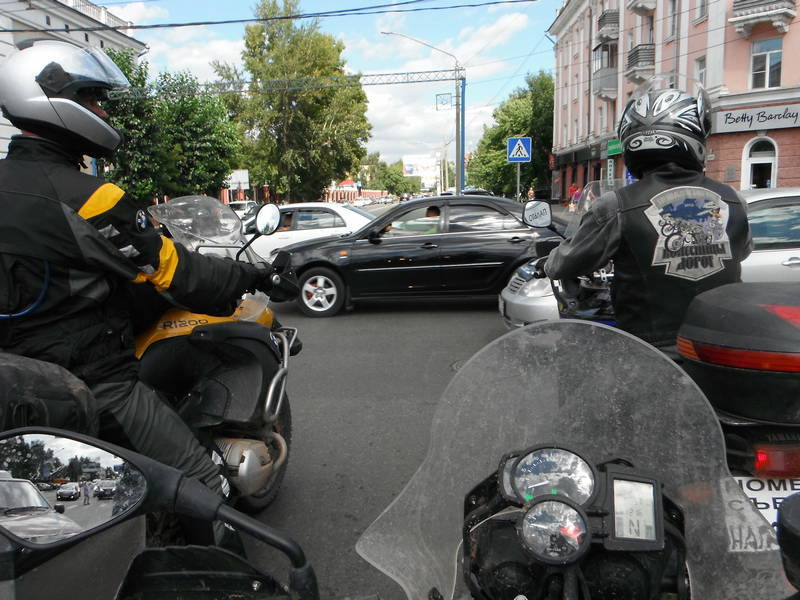
Getting caught up on e-mails and enjoying sushi
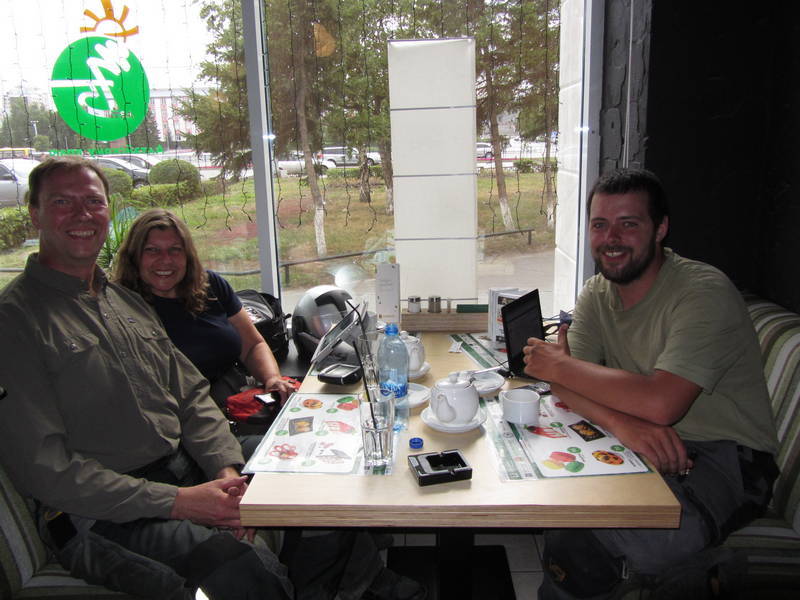
Riding into the Altai as the sun sets

Tents erected just as darkness falls

We hadn't packed any breakfast supplies so we rode a couple of kilometres to a small café where we did the usual mime/dance to order breakfast. This time however clucking like a chicken got us chicken and boiled potatoes rather than eggs. Still delicious though and of course the chicken dance is always a good icebreaker. With Matt concerned about the state of his front tire and needing to make it last until Ulaanbaatar (he had found a set of tires in UB via www.horizonsunlimited.com at the sushi/wi-fi restaurant) we decided to ride separately. This was a good choice as most of the vacation traffic turned off a few kilometres east of the café and the curvy road into the Altai Mountains became a fabulous playground better enjoyed at a brisk, though tire consuming, pace. When Audrey and I stopped for a break with a beautiful view of the river valley a young family stopped too. They came over and wanted their pictures taken with us while being amazed that we were from Canada and riding motorcycles here. Just before they left they went back to their car and grabbed a set of bicycling gloves. They gave these to us as a gift. Odd really, but a nice gesture. We climbed a pass that topped out at 1,700 metres where it was quite chilly and then rode on to another pass where a number of souvenir stalls were set up. There were lots of people and about ten 4x4s from Italy. We chatted with a couple from one of the 4x4s and they said that they had come from China up through Mongolia. They gave us some road information (this is always best from fellow travellers) that indicated that Western Mongolia was quite tough and that there were about 200 kilometres of bad road towards the Chinese border south of Ulaanbaatar. They were in a bit of a hurry as they needed to be back in Italy in September so we wished them good luck and then had a mashed potato filled pastry to eat. After photos with a few Russian tourists (one fellow simply plopped his kid on my bike without asking) we descended from the pass and went to the Kur Kechu cabins where we hoped to camp. It was no problem camping and the proprietor didn't charge us anything. After cooking up pasta for dinner we exchanged SD cards with Matt so that we would all have the same pictures of each other. Sitting at the picnic table it was getting quite chilly and for the first time on this trip I put on a jacket.
Packing up on the shores of the Katun river
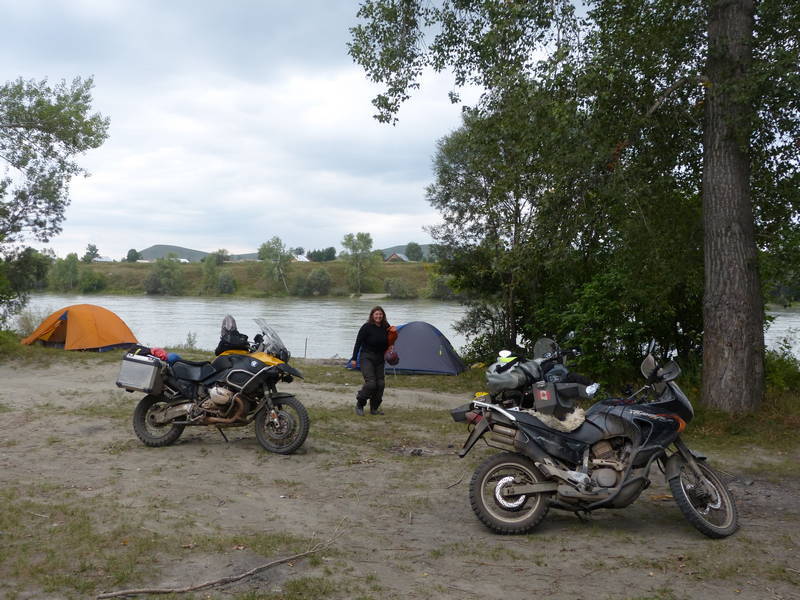
New cycling gloves!
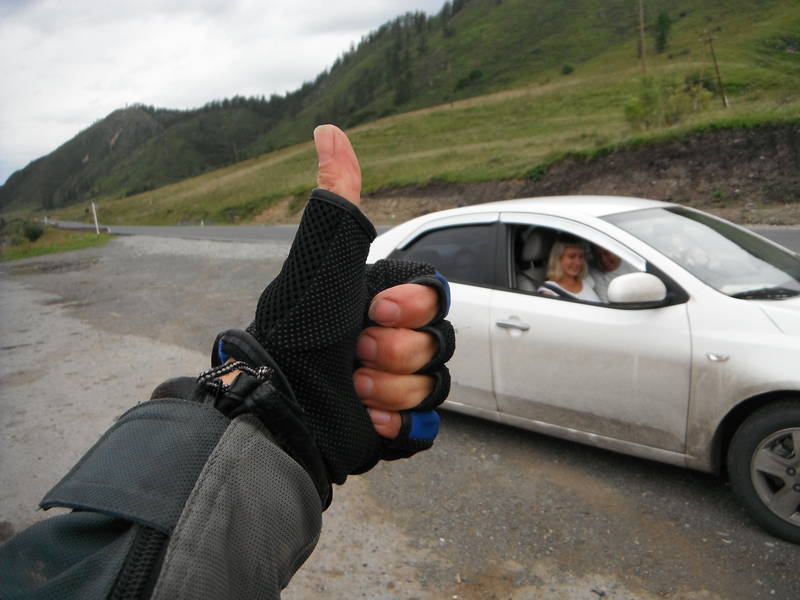
We pass Matt as he takes it easy on the worn tires
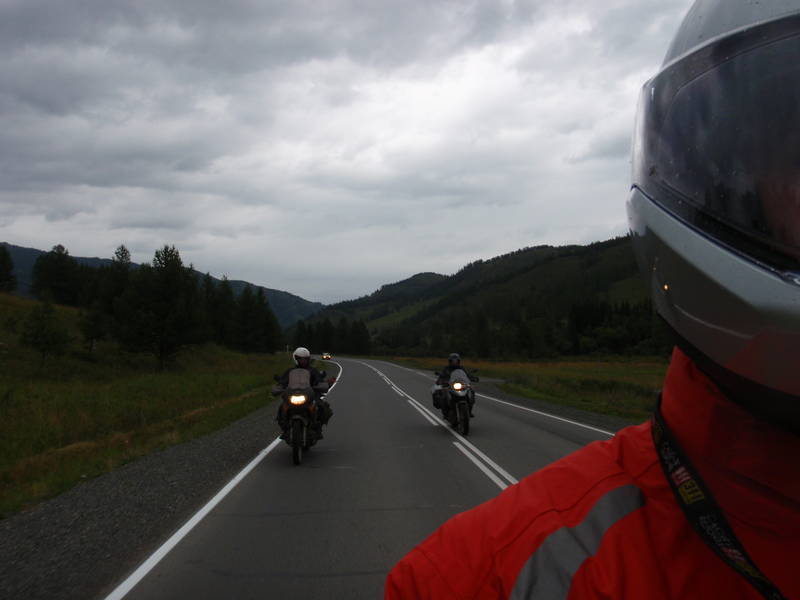
And enjoy some fantastic roads in the Altai

Picking up a bear shaped container of honey at the market

Leaving the market at the top of the pass
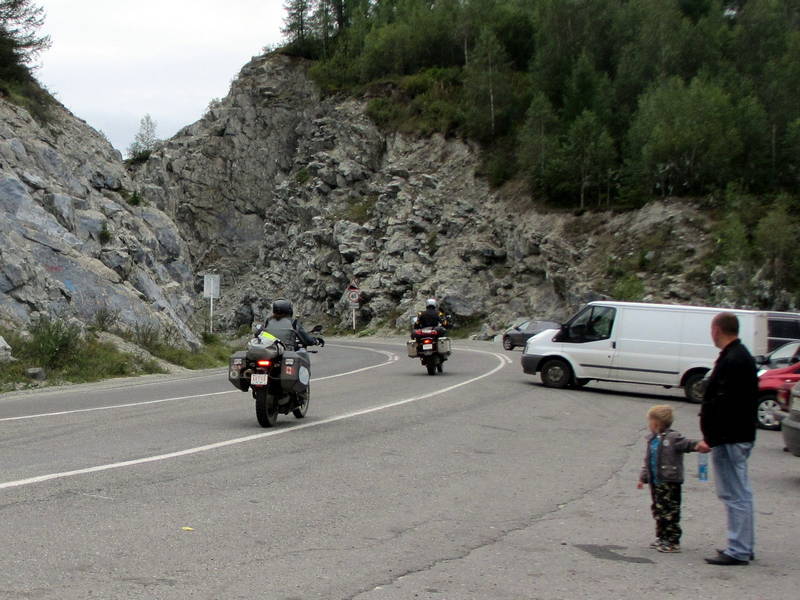
Arriving at Ker Kechu Cabins

Going over the map of Mongolia with Matt
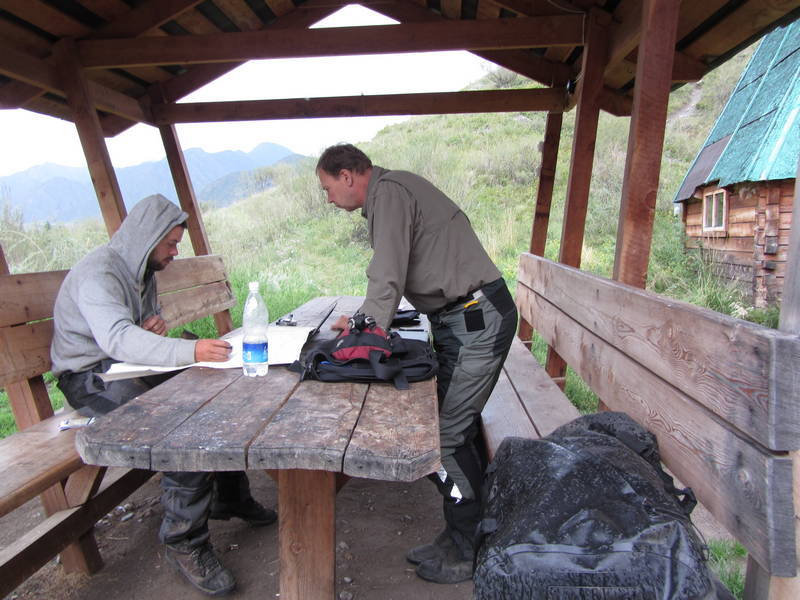
After a heavy rain in the morning, Matt packed up his tent and we rode with him for a short distance in the direction of Mongolia. First a stop at a roadside café to supplement our instant oatmeal breakfast was in order. While waiting for our pancakes (nee crepes) we chatted with Denis from Novosibirsk, his English was excellent, and he offered up his phone number and e-mail address if we needed anything in Novosibirsk. Again, nice people everywhere. The pancakes were the best ones on the whole trip, though a miscommunication meant that we didn't get any eggs with them. After saying good bye to Matt and wishing him the best of luck we searched out a stone idol at the side of the road near a rock wall with petroglyphs. We could just make out the moustachioed face and a sword on the standing stone idol a few kilometres out of a small village. We returned to camp at about 5:00 PM and had another pasta dinner. Just after dinner the occupants of a nearby cottage came over and offered us red and yellow peppers, tomatoes and cucumbers all from their own garden in the town of Biysk, near Barnaul. Who knew you could grow tomatoes in Siberia?
Stopping for best blynis (crepes) of the trip so far

Riding towards Mongolia
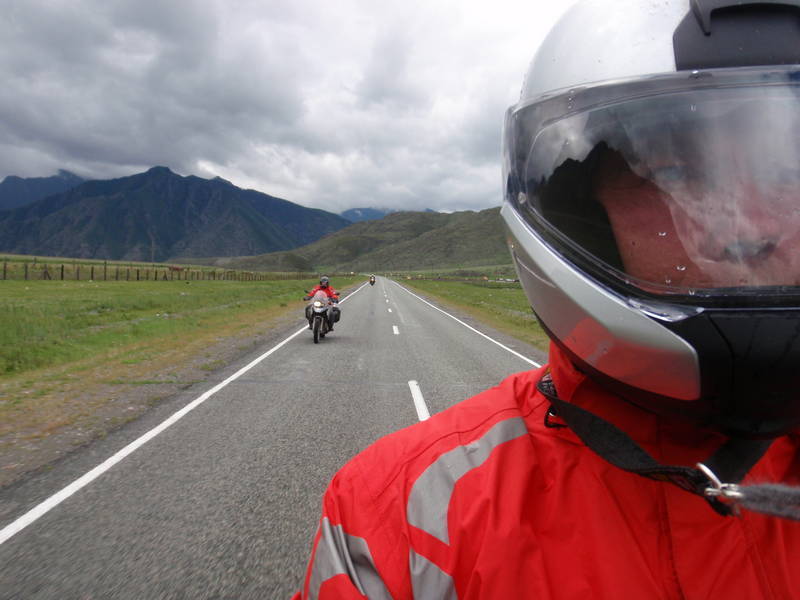
Saying good-bye to Matt as he continues on to Mongolia and we turn back to Novosibirsk
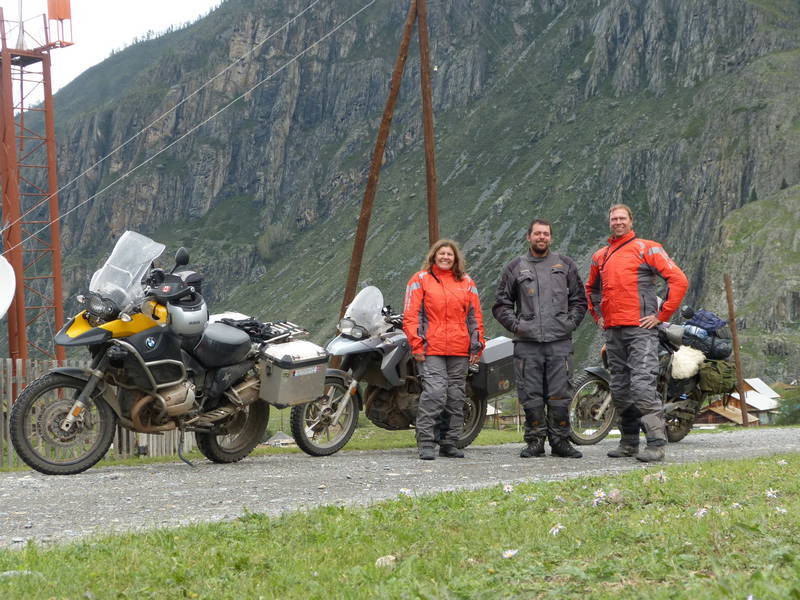
Riding up to a stone idol

You can just make out the idol's moustache

Nearby petroglyphs
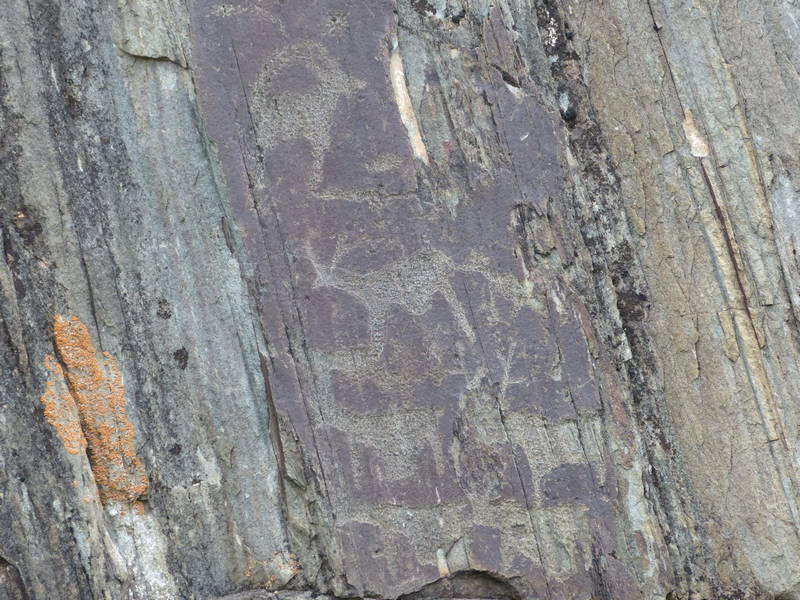
What beautiful riding
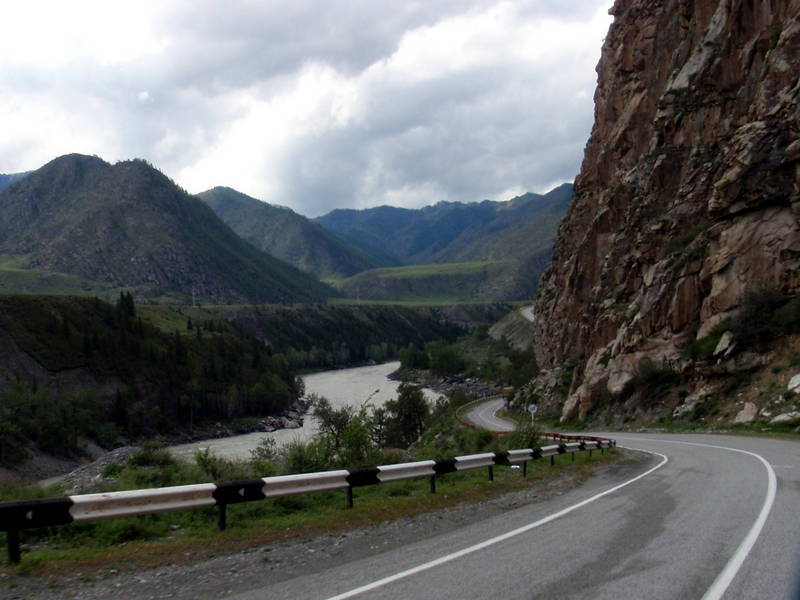
Stopping off at another stone idol

A Lenin statue with perhaps the best view

Making dinner back at camp
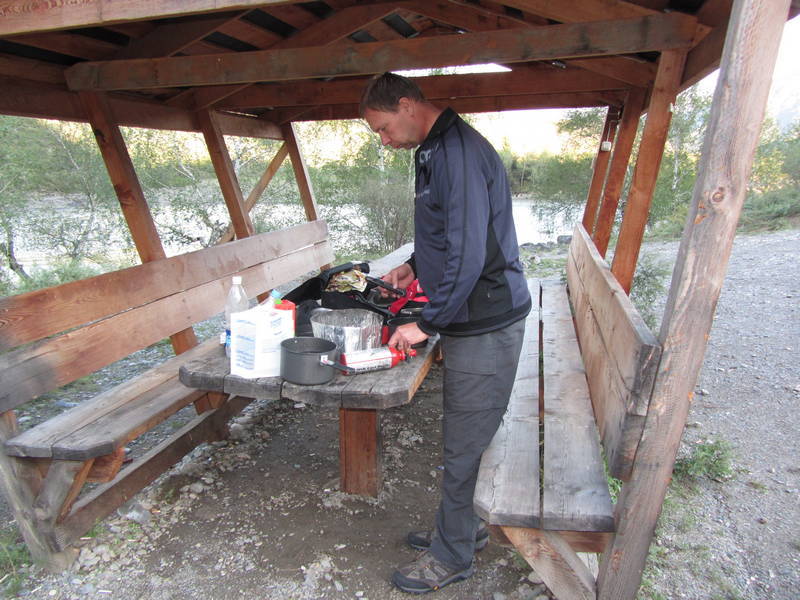
Enjoying Siberian vegetables (the peppers were so sweet they were more like a fruit than a vegetable)
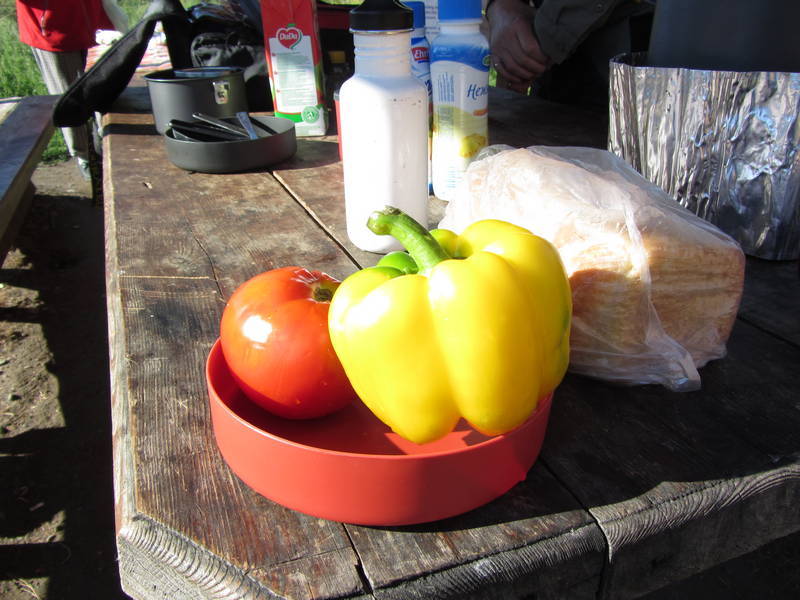
It was a bright blue morning as we packed up at Kur Kechu and then rode north back to Barnaul. We were working towards an August 31 deadline to be in Ulaanbaatar to apply for the Chinese visa. That would give a week's processing time and three days to get from UB to the Chinese border. We thought that the route through Western Mongolia, though very difficult, would take us two weeks to accomplish so we had decided to take the northern route through Russia instead. The riding through the Altai was simply fantastic and we stopped again at the café where we had breakfast a couple of days prior. No need to mime a chicken as we simply pointed at the kebabs by the grill. Traffic became heavier as we got closer to Barnaul but it wasn't too bad except for the right-hand drive cars. The further east we came across Russia and Kazakhstan the more right-hand drive cars were on the road. It got to be so that close to 90% of the Japanese cars on the road were right-hand drive. On the highway this led to sheer insanity when combined with typically Russian aggressive driving. You couldn't relax for even a moment if there was either oncoming traffic or traffic coming up from behind. The right-hand drive vehicles would pull half way into the opposing lane to see if it was clear to pass, forcing other traffic to the side of the road. While we saw quite a few collisions it was surprising that there weren't more. Not taking the advice of the GPS we took a shorter looking route into the centre of Barnaul but a few kilometres off the four-lane expressway we came to a queue of cars that wasn't moving. A quick U-turn and back to the expressway we went. From there it was easy to get to the Barnaul Hotel, which we had passed earlier when looking for an internet connection. We were able to get a room and once we had freshened up walked a couple of blocks over to the sushi/wi-fi restaurant.
Lovely morning ride

Ural parked at the side of the newly paved road

Kebabs for lunch
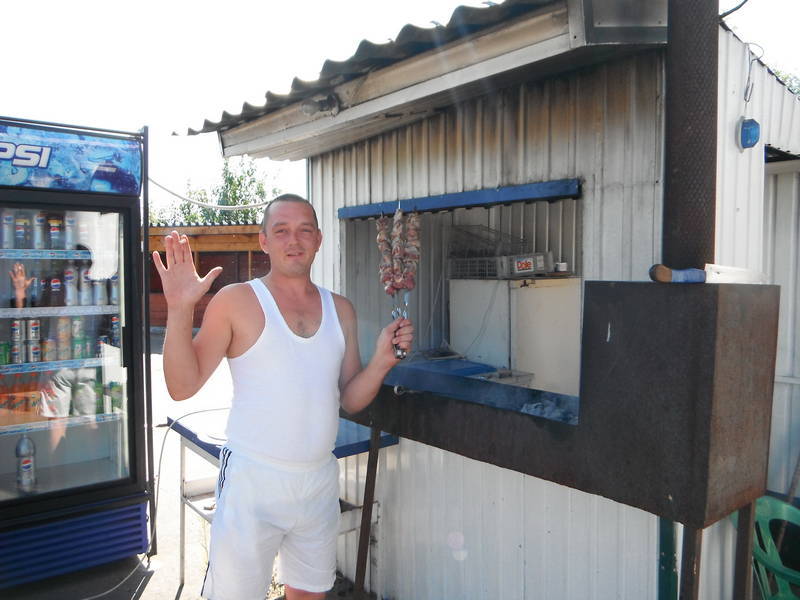
Beautiful wooden house in Barnaul

Nice welcome at the Hotel Barnaul

Audrey contemplates going back to school

August 20 we enjoyed a nice breakfast buffet at the hotel and then rode north to Novosibirsk. A four-lane expressway lasted for almost 50 kilometres and made for very easy riding though to be honest the road wasn't too busy and the pavement was good so it wasn't bad for the remainder to Novosibirsk either. Before leaving on our trip we had contacted Denis in Moscow to see if he could provide tires for us along our route somewhere. We had anticipated that we would not be able to source the correct size tires for our motorbikes until Japan and that would be more than 20,000 kilometres into the trip so looked to get new tires before entering Mongolia. Denis could ship tires to Novosibirsk which fit with our original plan of riding through Western Mongolia. Now that we were taking the paved route through Russia it wasn't as critical to have good tires and to be honest our tires were not in bad shape considering that they had about 11,000 kilometres on them. But we thought we had pre-ordered them so really should pick them up. Once entering the industrial city of Novosibirsk we followed the GPS to a motorcycle shop. Inside no-one knew anything about tires being shipped in from Moscow for us. They allowed us to use their computer and we checked our e-mails to confirm that Denis had indeed sent them. No such luck as there were no recent e-mails from Denis. They did have one set of knobby tires available but these wouldn't suit our purposes so we decided to leave Novosibirsk and ride to Tomsk. Easier said than done. The Open Source Maps we were using in the GPS weren't necessarily very accurate in some places (despite the best efforts of contributors) and Novosibirsk was one of those places. That meant that sometimes main roads didn't connect on the map though they did in reality and then the GPS would calculate a route that didn't necessarily make any sense. This seemed to happen in Novosibirsk as within a few kilometres of leaving the bike shop we were guided down a dirt path. The main road looked like it led to the centre of the city before heading back in the direction of Tomsk. Wanting to avoid the typical traffic jams of Russian cities we decided that since cars were going down the dirt track maybe it was OK. It wasn't. The track was extremely rough as it descended into a small coulee underneath a set of huge pipes leading from a smoking industrial facility. The climb out of the coulee was even more challenging as it was so rough that keeping up enough momentum to avoid stalling was difficult. After a few kilometres we ended up at rows of Soviet-style apartment blocks and back on the pavement. I decided that it might make more sense to take the GPS route suggestion with a grain of salt and just aimed for some larger roads. We worked our way through a traffic jam caused by a collision and after an hour or so we were near the edge of the city but the road that the GPS indicated as the main highway didn't look like a highway, more like an access road to an industrial estate. We tried it anyway and soon were actually out of the city where we heaved a big sigh of relief. A short while later the GPS led us slightly astray again when on the screen it showed that an expressway would be finished in 2010. Instead we found that the road we were on ended and we backtracked a little until we accessed a brand new four-lane divided highway. The remainder of the ride to Tomsk went much more smoothly though we needed to don our raingear as we turned north off the M53. Being a smaller city, Tomsk's traffic wasn't quite as bad and we had no trouble finding the Bon Apart Hotel. They only had a room with a single bed available so I unrolled my Exped mattress and slept on the floor again.
Ekke makes quick work of the expressway

Arriving at the Hotel Bon Apart
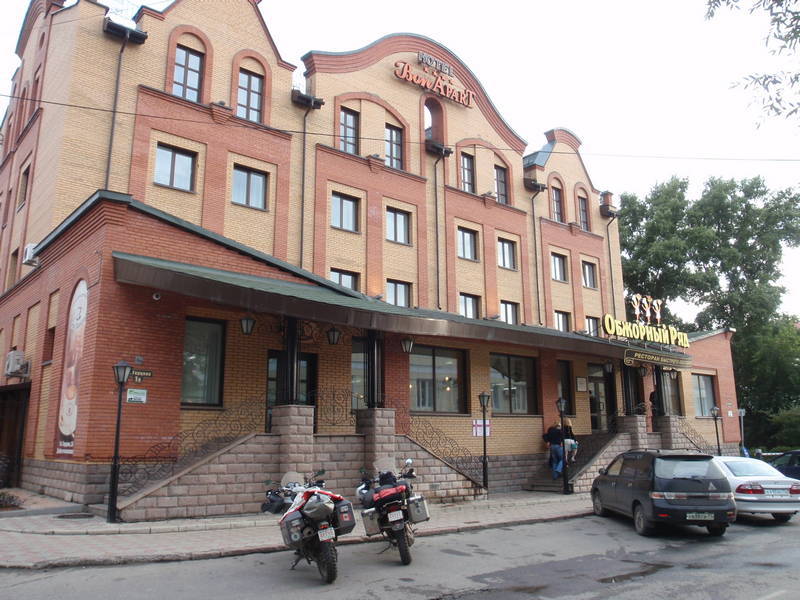
Audrey writes
The 12:00 pm checkout time on August 21st meant we could spend the morning wandering around Tomsk in search of its famous wooden lattice-decorated log architecture. A walk up the busy Ul Lenina took us to some great old houses, many with carved window frames. The fancier mansions were built of timber and had really intricate carvings, like dragons or peacocks. As we walked through town, my heart skipped a beat when I saw a familiar-looking sign? McDonalds? We had not seen the golden arches since western Russia. But it was not to be. A restaurant was imitating the famous M using the same colours and lettering. Disappointed. Riding out of town took a long time due to many stops. When traffic did move, it was fun weaving in and out of slow vehicles, zipping around traffic circles and gunning it past lines of traffic. Someone gave us a big "thumbs up", and someone else stopped, rolled down their window and said, "Canada?!" Our ride out took us past the main square with the historic theatre and cathedral alongside blocky Soviet era buildings. The inevitable Lenin statue stood in the middle of the traffic circle and I whipped out my pocket camera to take a photo while managing my throttle and steering with the other hand.
McDonald's!?! Nope.

Checking out the wooden houses in Tomsk

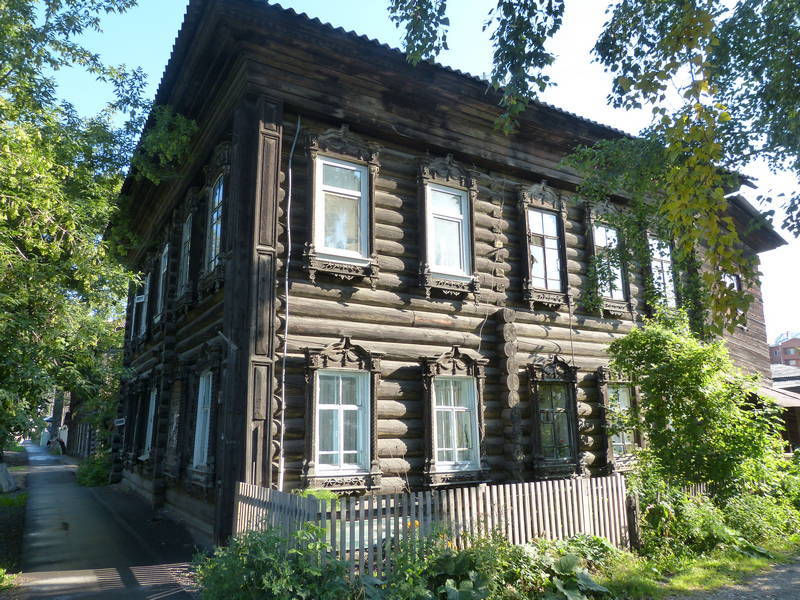
Love the dragons

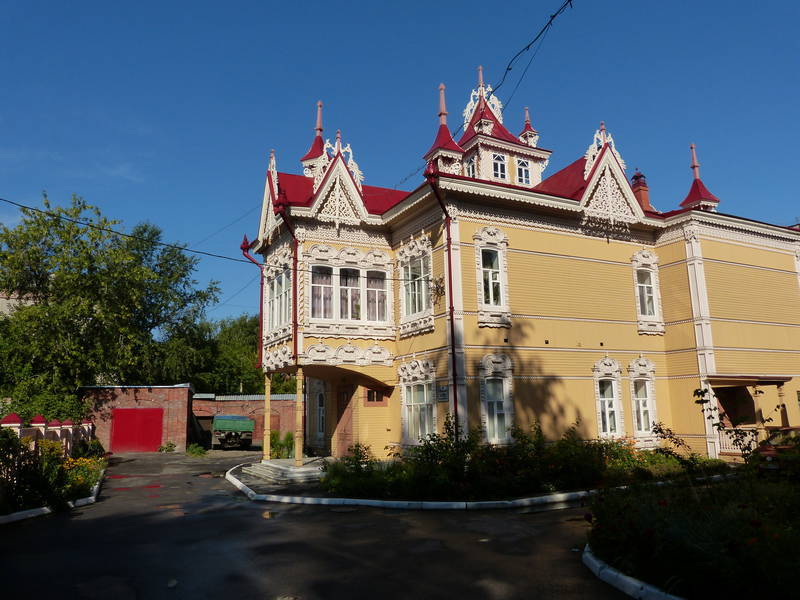
This one isn't looking so good

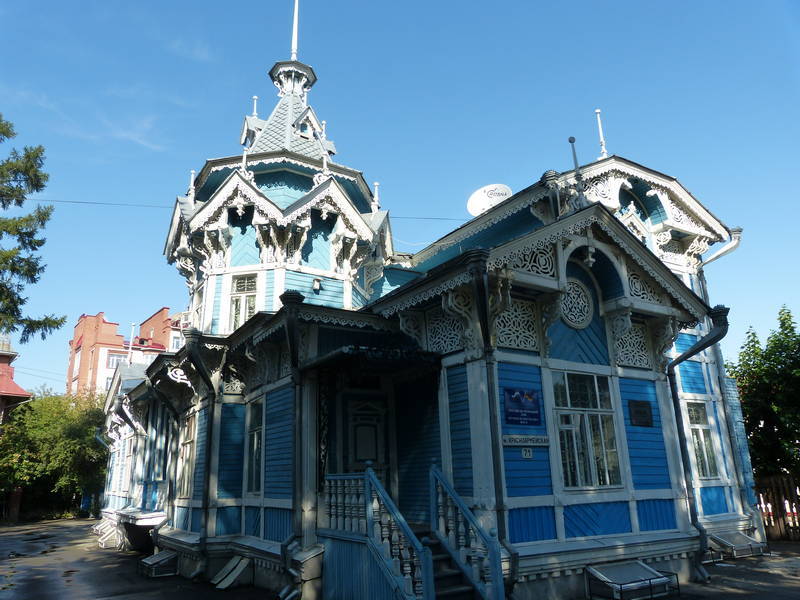
Leaving Tomsk
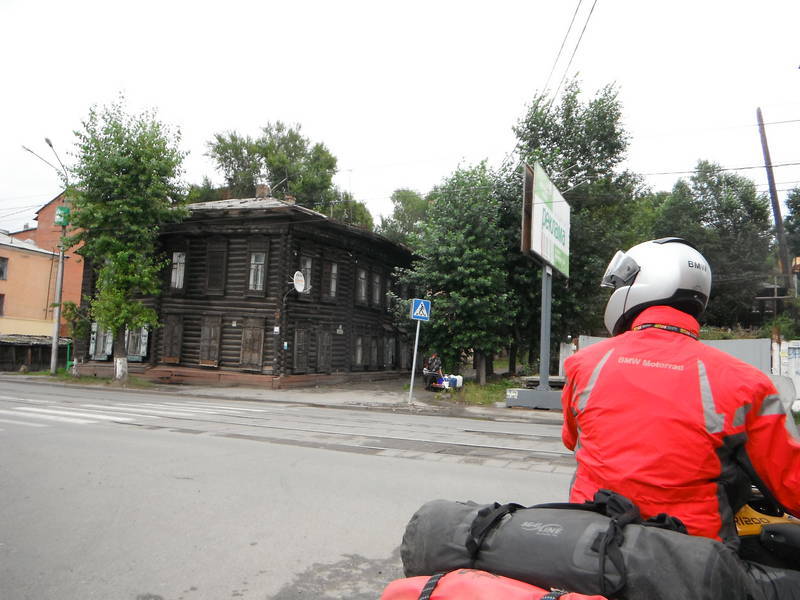
Our ride east took us through many forests and it was quite obvious why wood was the building material of choice. The streets of small towns that we passed through were lined with wooden huts that had carved window frames. Often the window frames were painted the traditional blue, but green was looking like this years' colour. The highway was not busy and it was very smooth until we came to some construction. The bikes just shook on the rough dirt sections and potholes that couldn't be avoided, especially when passing big trucks. Standing up on the footpegs stabilized the bikes, which was necessary when passing big trucks. Once, Ekke heard a thunk, and I saw the bag holding the tripod shake right off the back of his bike. Luckily there was no truck coming to run over it. Mental note: tighten all nuts and bolts. Coming out of a small town we saw another motorcycle, a Honda 650, 2-up, carrying a lot of luggage. It was an awkward spot to stop, so we just waved.
Ekke had found a waypoint for a wild-camping spot, but it looked a little damp when we rode by. So, we continued on to the next big centre that indicated a hotel, Krasnoyarsk. The ride through the city took us through a tree-lined park, and the twisty road was fun for us. Our hotel overlooked the Yenisei River. Clumps of huge apartment blocks in the distance stood like sentinels, all in a row on a big hill. The city of a million people was growing even more, and we counted at least a dozen construction cranes. We pulled in at around 9:30 pm, and were having dinner by 10:00. The time zone change really set us back, an hour in fact. We were now seven hours ahead of Germany, where we had started riding from, and fifteen hours ahead of Alberta. The next morning we decided to stay another day so we could write the Kazakhstan chapter. Or maybe it's because the porridge was so good. But, sometimes you just have to stop travelling and get the work done. It would mean a day less in the Lake Baikal region, but the reliable internet here and cheaper hotel prices were an advantage. There was a common room with sofas, so we planted ourselves there after the buffet breakfast. When the sun came out, we found a terrace outside, until the laptops ran out of power, so we moved inside again. Luckily, the hotel had a restaurant, which is super convenient when you're trying to just write. We didn't have to go in search of food. The website process also includes looking through hundreds of pictures from four cameras and narrowing it down to less than a hundred. All very time consuming, but fun reliving the trip.
Writing up the website in the gazebo

Mashed potatoes as a Borg Cube. Resistance is futile!
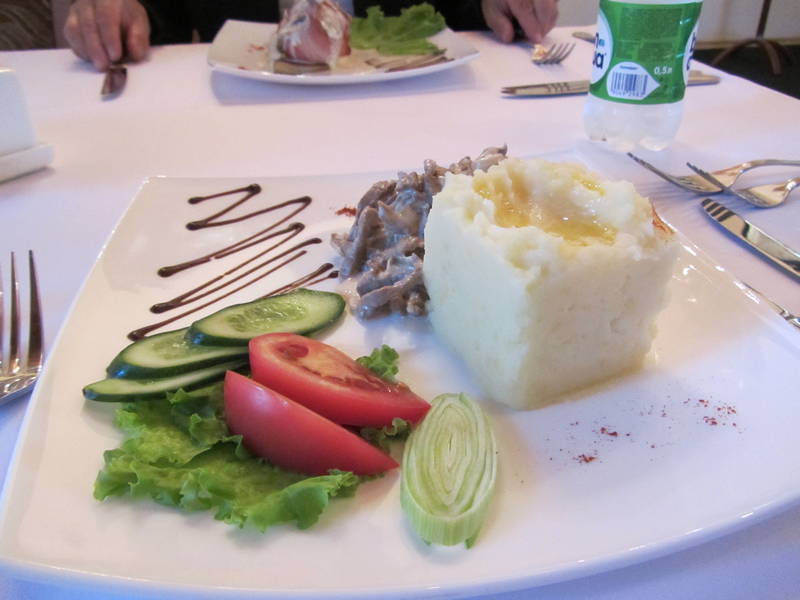
Krasnoyarsk websites say it has a World Heritage Site but I couldn't find it on the UNESCO list. I was still interested in finding it, a railroad truss bridge whose design won the gold medal at the 1900 Exposition Universelle, led by Monsieur Eifel himself. We thought we could locate it and possibly drive by on the way out the next day. A tourist map of the city didn't even list it, and I couldn't find its location on the internet. Ekke eventually found two railroad bridges on Bing maps, and perhaps one of them was it. As we were out getting supplies from the bikes, I looked down the river, and lo and behold, there it was, right in front of us the whole time. We took a photo, and (maybe) checked off another World Heritage Site.
UNESCO World Heritage Site with apartment blocks being constructed on the hill
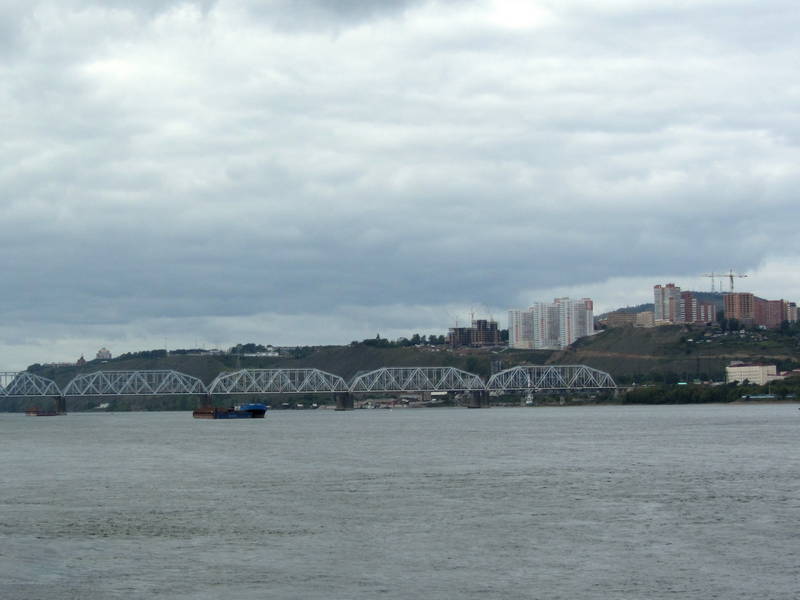
The temperature the next day, August 23rd, was 4 degrees celsius, our coldest yet. Feeling very glad that I hadn't sent my warm clothes home during the 37 degrees in Kazakhstan, we bundled up and walked like cosmonauts to the bikes. With the wind-chill from riding it felt much colder and the heated handgrips were a very welcome bike accessory. Our goal was to ride 670 kilometres, or to the next big place that would have a hotel. The riding was interesting, as it was quite hilly past Krasnoyarsk, and pine forests lined the two-lane highway most of the day. There were long stretches of construction zones and the bikes handled most of them well. But one construction zone didn't have the typical rock and dust combination. This one was dirt, and it looked freshly graded. We had to pick up speed to avoid getting stuck. I saw Ekke's heavy Adventure wobbling a bit as the dirt softened and his foot dabbed on the ground a couple of times to try to save it. Thankfully he hit the gas and escaped a face-plant in the dirt. I duck-walked through that section, staying on the throttle so I wouldn't sink in. By 6:00 pm we were still a long way from Tulun, so we stopped for a Nutella sandwich break by the side of the road. It felt very woodsy, like northern B.C., trees and rugged terrain all around. By 8:00 pm we came to a bigger town and asked by miming to a local if there was a hotel. She said, "Da" and drew a great little map for us. The route took us back over two bridges, two left-hand turns and the hotel was on the left. As it was my turn, I went in to enquire if this was a hotel. It looked like one, with a lobby and reception desk. But the clerk at the desk said, "Nyet". I don't know if she meant it wasn't a hotel, or there were no rooms available or if she wasn't renting a room to a motorcyclist covered in dust from head to toe. We had read that occasionally hotels were reluctant to rent to foreigners, possibly because of the registration process or language barrier. So, we decided to just ride the 117 kilometres to Tulun. We were making good time, and I was really looking forward to a shower and dinner in an hour. My hopes were dashed when I saw clouds of dust up ahead. Big transport trucks travelling over another construction area raised the huge clouds of dust on the rocky, potholed roads. We couldn't see a thing but our only option was to pass them or go their speed of 10 kph. Checking carefully for oncoming vehicles, we just stood up on the footpegs, shifted into third, and headed into the dust zone. Sometimes the trucks we were passing would put on their right signal lights, indicating that we could pass safely, but only when they could see ahead. It got really interesting when it started getting dark, and we couldn't see oncoming traffic or potholes at all. We rolled into Tulun exhausted, stressed and covered in dust. It was difficult to blink because our eyelids were caked with it. Thank goodness the hotel clerk spoke some English and asked if we needed registration. I said no, and we got a room for 2600 roubles ($86.00). They gave us the privilege of parking behind the hotel for 100 roubles ($3.30) each. Still in our motorcycle gear, we walked out to the street to see if we could find a restaurant. Ekke saw one nearby that looked open, but when we saw some women come out, dressed to the nines in stilettos and miniskirts, we decided to pursue another option, the grocery store. Sitting on a bench eating cheese and buns, pepperoni sticks and mini creampuffs in full motorcycle gear, we must have looked ridiculous to passers-by. Knowing we would just eat them, we offered half the pack of creampuffs to our parking attendant. He just smiled, touched his chest and said, "Me?" and seemed so happy to get those creampuffs.
Bundled up against the chill leaving Krasnoyarsk
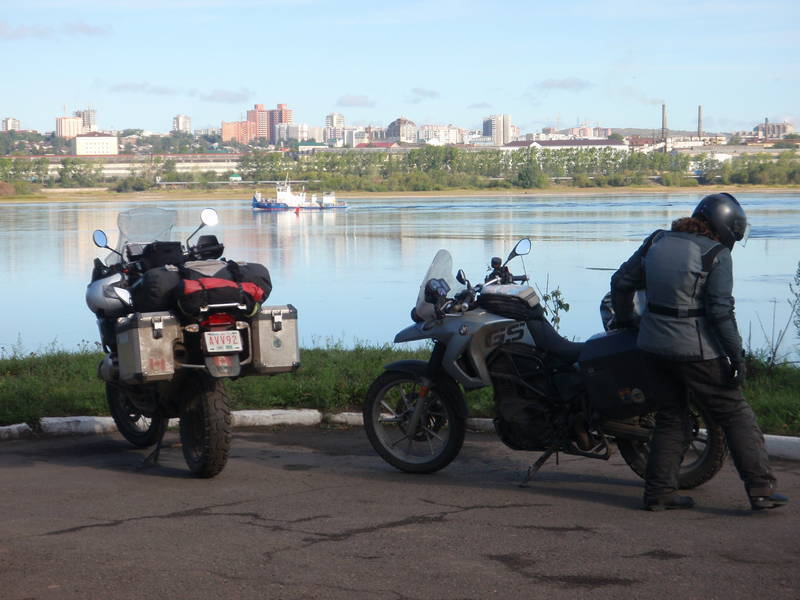
Here motorcycles are used as transportation not toys

Looking through the dust for a passing opportunity
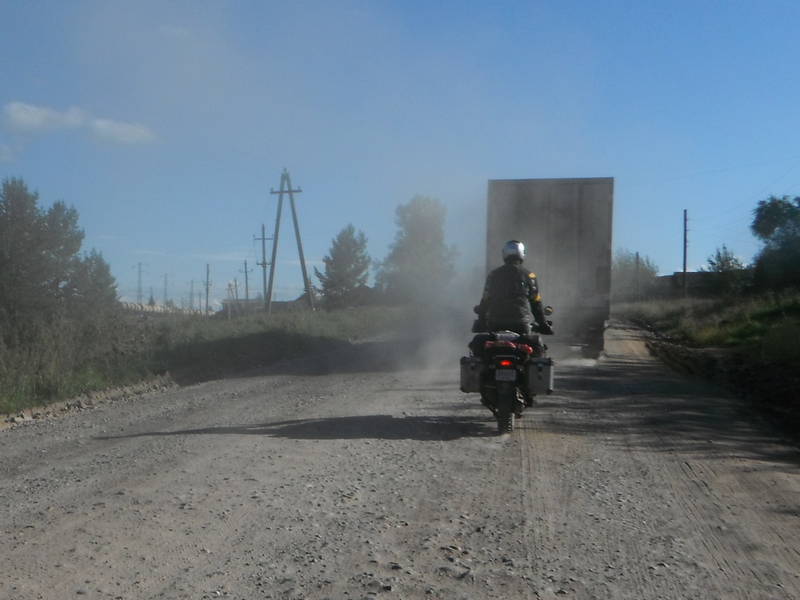
A Nutella break can rejuvinate the body and the mind
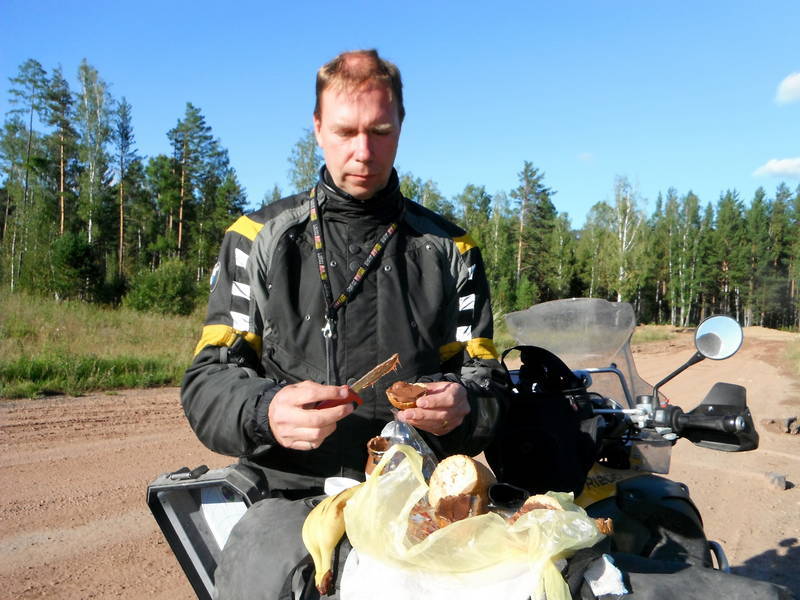
The shadows are getting longer and longer

Getting gasoline the next day was stressful. I gave the clerk 1100 roubles for gas and we tried to fill up. But the pump stopped at 860 roubles worth of gas, and I went in to see what was going on. I thought I hadn't gotten enough change back, but it turns out he had reset the pump after 30 litres and Ekke had then finished filling both tanks. In the meantime, I had bought a couple more litres of gas because I thought my tank wasn't full and that I hadn't received enough change back. Very confusing system. A helpful local went in and got the money back for us for the two litres that we didn't use. Sheesh. Nearby was a cute little cafe, where we mimed eggs and pancakes. A very smart server understood us and brought us eggs and pancakes.
The ride was very pleasant under sunny, blue skies. In Irkutsk, we meandered through traffic, past historic buildings and cathedrals. Ekke said that the GPS said to stay on the same road, but the roads did a lot of twisting and turning, so it was guesswork as to which was the right way. Our hotel choice, the Agara, was housed in an old Soviet-era blocky gray building. It had been fully renovated of course, with a beautiful lobby but was more expensive than we thought it would be. The room had nice decor, but was small, and the shower stall a bit plasticky and cheap. The hotel staff told us that we could park behind the hotel, but the parking attendant wanted 20 roubles per hour to park there, which would have been 500 roubles ($16.00). Also, he wanted us to park in the soft dirt, and not in a regular spot. So we just parked in front of the hotel. Our search for somewhere to eat took us to a lovely park across the street, all around the park, and eventually back to the hotel pizza place. On the walk back we had to cross a wide street and started across the crosswalk. About halfway across a Ford Focus drove right toward us at high speed and missed us by centimetres. He even made eye contact with us and I'm pretty sure he sped up. Scary.
Meeting friendly Russian motorcyclists near Irkutsk
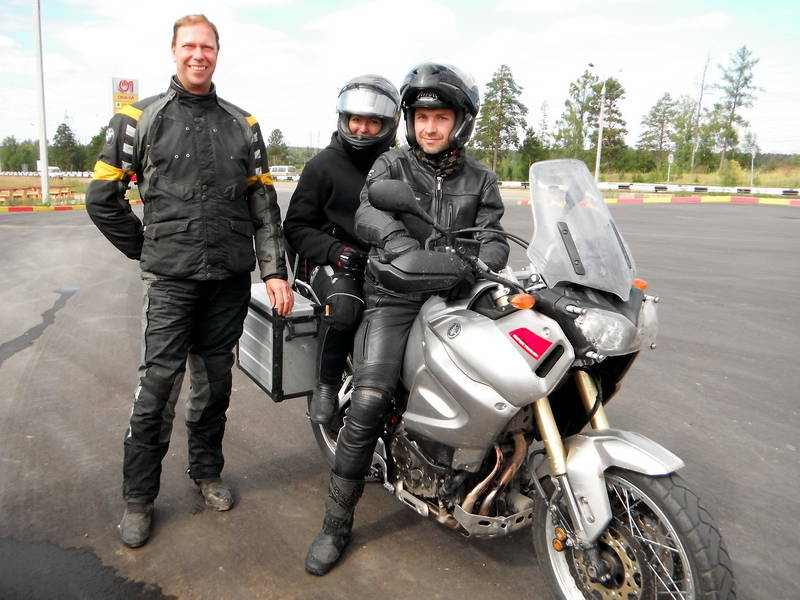
A couple of filthy bikes parked in front of the Hotel Agara
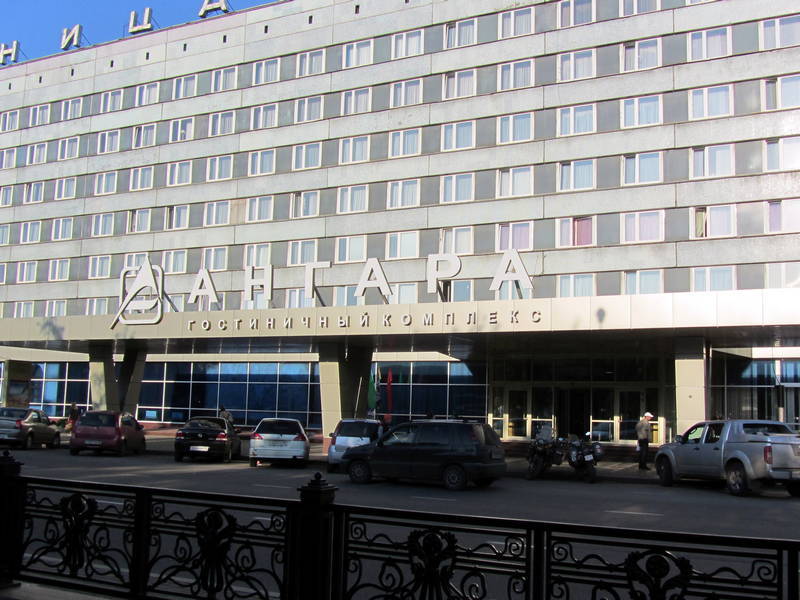
Fireworks in Irkutsk, why? We don't know but we enjoyed the show from our top floor room
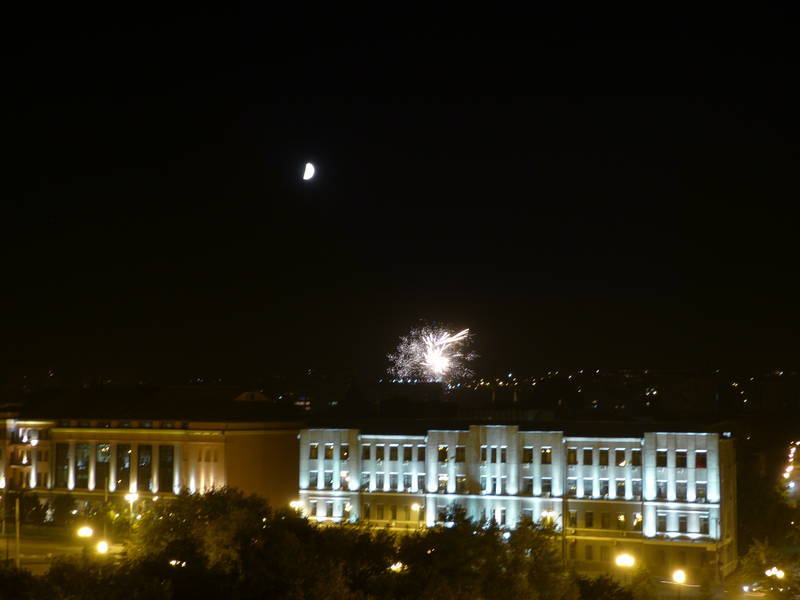
The hotel security insisted that the bikes would not be safe out front, so we moved them into the secure lot at 9:00 pm and got them out the next morning, thus paying a lot less than 500 roubles. Since we had checked into the hotel at 5:25 pm, our checkout time was 24 hours later, or 5:25 the next day. We took advantage of the hotel internet to get the Kazakhstan chapter finished and downloaded. Potentially there was enough time to also email a few photos to Grant and Susan at the Horizons Unlimited (world motorcycle travellers) meeting in Nakusp, B.C. as well, and then visit a historic mansion on the way out of town. The bikes were parked out front and we noticed that three KTMs with Swiss license plates had pulled up right behind us. They looked like some serious adventurers, and we left our website card on their tankbags. Inside the London Pub at the hotel, we saw three guys who totally looked like motorcycle adventurers. They had just ridden from Mongolia and said they did 3000 kilometres in the north and west of the country, camping out for a few weeks. They were shipping the bikes by train to Moscow and taking the Trans Siberian Railway themselves. Lunch was ordered, but we waited and waited for it to arrive. Finally, my shrimp and chips arrived, so I ate it, and we waited and waited for Ekke's pasta. We had waited at least an hour. Then we had a mere half an hour to send photos to HU, pack up and check out. No time to visit the mansion as we still had to ride to Lake Baikal. We rode the 70 kilometres to Listvyanka, and found Hotel Baikaliska, a quaint three story wooden structure.
KTMs from Zurich

Arriving at Listvyanka on the shores of Lake Baikal
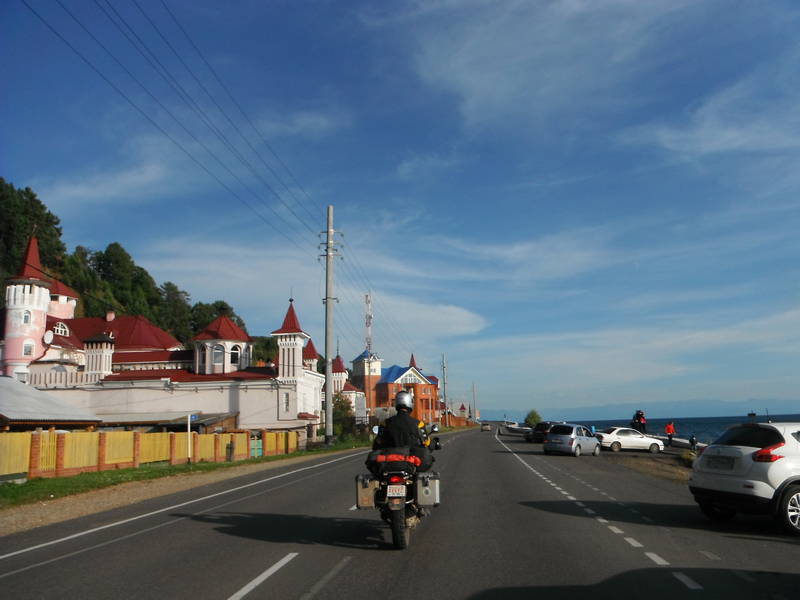
Lake Baikal is the deepest lake in the world at about 1600 metres, or a mile. It also holds 20% of the world's fresh water, more than all the Great Lakes combined. It's also 30 million years old. It was a beautiful blue colour in the sunshine, and Russian holiday-goers were out on boats or wandering the waterfront. A fifteen minute walk took us to a bankomat. Right outside, at a small market, a woman was selling charoite sculptures. I had read that this was a very special purple mineral only found in the Baikal area, so we bought a Nerpa seal sculpture for $80.00. The Chinese food for supper was surprisingly delicious, but we were, after all, getting closer to China.
Cool, a CCCP boat

Even cooler, CCCP ice cream!
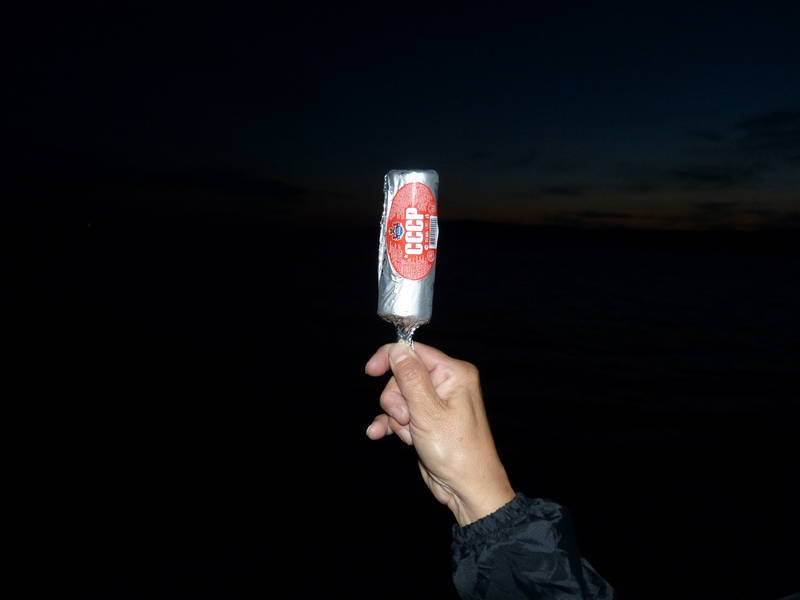
Listvyanka at sunset
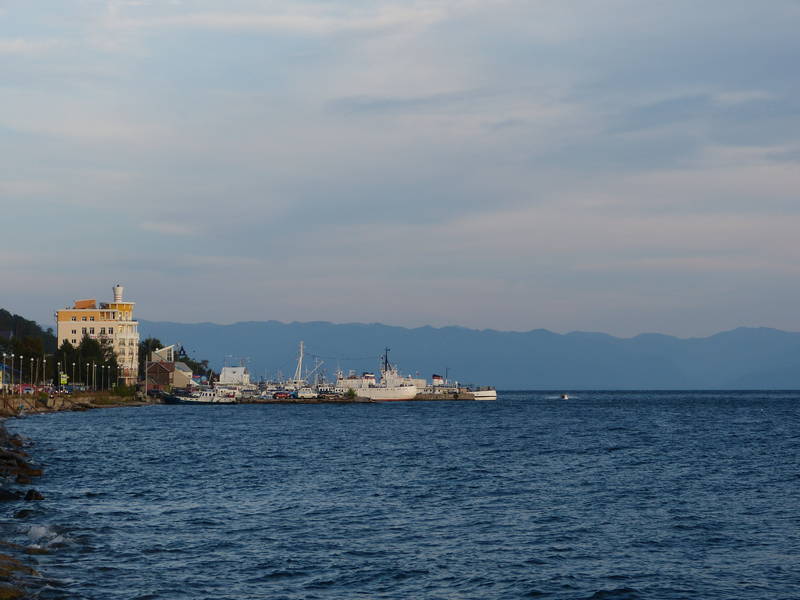
Baikal is famous for its changing weather and sure enough it poured rain the next day. A breakfast of wiener-like sausages (weisswurst?), cucumber and cold peas was one of our most interesting yet. The owner let us use the washing machine, so we did our first load of laundry in a machine since Germany. Handwashing in our collapsible packbowls was becoming second nature, but I don't recommend handwashing jeans. As it was Saturday night in B.C., world motorcycle travellers at the HU meeting in Nakusp were gathered, presenting or watching slideshows of each others' trips. Grant Johnson had suggested we try Skyping in. Noon Sunday worked perfectly as that was 8:00 pm Saturday evening and he put us on the big screen. The meeting had set a record for attendance, 210 people, making it the second largest in the world after Britain. We had a view of the audience on our laptop as we gave a brief ten-minute talk about where we had been and where we were going. A couple of questions were called out, and we heard, "Has Ekke broken his leg yet?" Everybody laughed. Jeremy Kroeker, (author of Motorcycle Therapy, which is available on Kobo and Kindle for $2.99, by the way) was referring to another trip in July of 2007, of course. After wishing Ekke's parents a happy birthday, we said goodbye. It was great to be part of the event, even from Siberia.
Internet did not work for the rest of the day, so I was forced to read 'Lonely Planet: Russia'. I finally discovered how to say the word for eggs, pronounced 'yie-tso', so now we could order breakfast. Some Russian tourists had taught us how to say crepes, or 'blini'. We walked into town to check out boat tours for the next day. The company had a one hour trip up the coast available for 6:00 pm, so we waited at the Chinese restaurant for a while, eating caramelized banana. But alas, the group that booked the boat cancelled because of the rain, so we got our money back. For dinner Ekke tried Omul, the local fish and declared it delicious. The next day, August 27th, after eating yie-tso for breakfast we caught a boat tour to the Circumbaikal railway coast. The weather had changed severely: It was gorgeous, clear, and blue-skied. Our boat was about ten metres long, with places to sit for about 12 people. It chug-chugged along the hilly, green coastline while we got an English commentary from the guide. She shared a few facts, stories and legends about Baikal, how it freezes on top and becomes an ice road in the winter, the endemic local wildlife like Nerpa seals and Omul, and how Lynne Cox, an American, swam across the lake. The boat was moored on a small beach and we hiked for 30 minutes, meeting the boat at another beach. Our walk took us on the Circumbaikal railway tracks, built by gulag prisoners in the early 1900s. Before we entered a 150 metre long tunnel, our guide handed out torches (flashlights). She also mentioned that if we heard a train coming, just move off the tracks and stand against the walls of the tunnel. No trains came, so we didn't have to do that. We ate some lunch on the rocky beach, and sat back enjoying the lake and sunshine. Our guide had mentioned that the high oxygen content of the lake makes people sleepy. I don't know if that's true but on the trip back most of us fell asleep.
Omul tastes much better than it looks

Repairing a loose bolt on the F650's exhaust pipe

Out on Lake Baikal

After an hour and a half the boat is beached for our walking tour of the train tracks
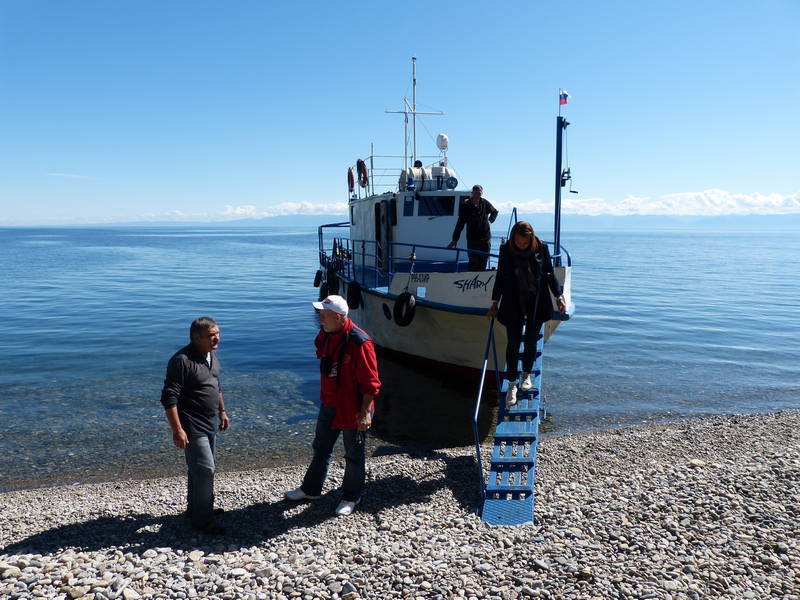
Walking down the tracks while the boat sails around to meet us further along the coast
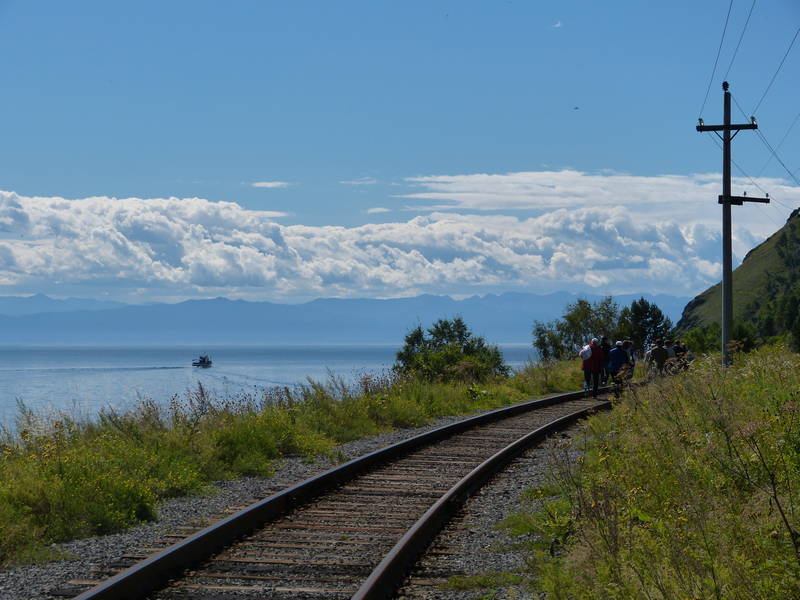
Keep an eye out for the light at the end of the tunnel

We have some free time to dip our toes (or more if you like) into chilly Lake Baikal

Checking out a geology museum (rock collection) in Listvyanka

Our route the next day took us back through Irkutsk where I really wanted to stop and visit the mansion we had missed a few days earlier. The failed Decembrist Revolt in St. Petersburg in 1825 meant that many Russian army officers and noblemen were exiled to Siberia. Maria Volkonsky and other women followed their husbands into exile, travelling thousands of kilometres by horse-drawn wagon and building a new life in harsh Siberia. The wooden Volkonsky mansion tells the story of these women and contains photographs, furnishings and personal items. It was very interesting to see how lives were rebuilt and the role the women played in it.
Leaving Lake Baikal

Inside the Volkonsky mansion


The Volkonsky mansion in Irkutsk
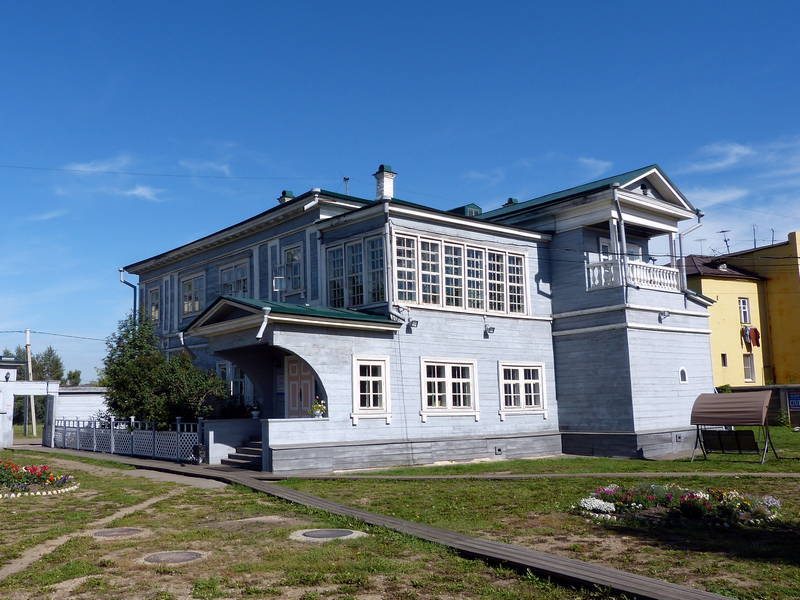
We stopped by Hotel Agara because we still had the internet code, so the coffee shop made a good place to sit and find out if our tires had arrived in Ulan Ude. Ekke had arranged for two rear tires to be sent there, and we would pick them up in a couple of days. Also, we had received, by email, a letter of invitation from our Chinese tour operator so that we could apply for our Chinese visas, and we printed that off at the hotel. It rained heavily on the ride out, but we still wanted to look at a marble train station in Sluydyanka, which we eventually found. It was chilly and wet, so we stopped a bit early in Baikalski, knowing there was a hotel there.
Another mansion on the way out of Irkutsk

At the southern end of Lake Baikal, near the current terminus of the Circumbaikal Railway
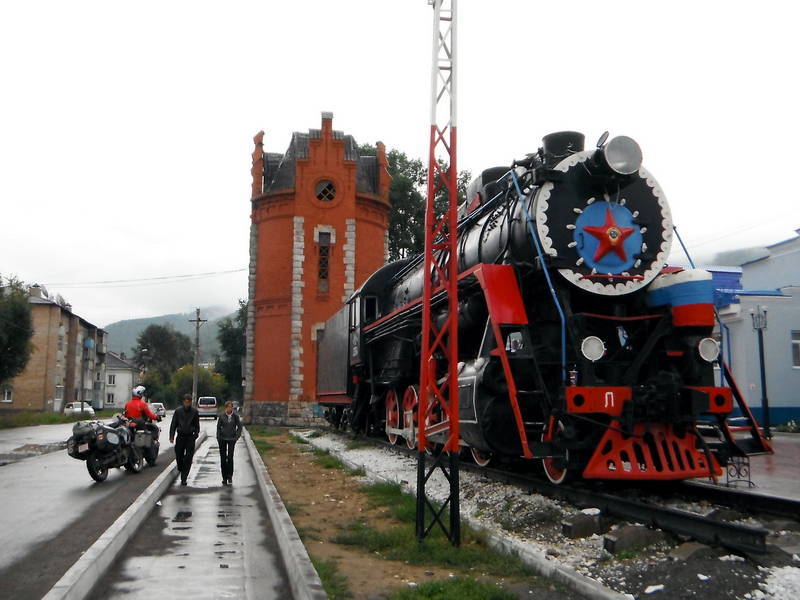
The train station in Sluydyanka

The next day, the ride around the south of Lake Baikal was a lot of fun as it twisted and wound through the mountains (foothills to us). The pavement was good, there was little traffic, and the bikes easily managed the curvy road. We had not ridden on such a road in a long time, and we could finally put a bit of wear on the edges of the tires as opposed to just the middle. The tires had really flattened out from thousands of kilometres of virtually straight roads. In Ulan Ude we decided to find a cafe with WiFi and work out where we would pick up the tires. On the way, we saw a beautiful town square and right in the middle was the Lenin statue. This was no ordinary statue, however. It was just the head of Lenin, and was quite impressive sitting atop its pedestal, 7 metres high. Nearby, the Marco Polo Cafe had good WiFi and burritos (best burritos this side of the Urals says Ekke). Our hope was to just pick up the tires and start riding toward Mongolia. We needed to be in Ulaan Bataar on Thursday night at the latest to apply for the Chinese visas on Friday morning. With some emails and a phone call with help from one of the servers, we ascertained that Victor, our tire-contact person, worked until 6:00 pm. Disappointed that we wouldn't get riding until later, we made a plan to meet at the airport and he would bring the tires to us. That would at least put us in a better position to ride a couple of hundred kilometres that evening so it wouldn't be such a long day the next day, Thursday. When we got there, he pulled up behind us in his Chevrolet truck, but, alas, did not have any tires. What he did have was a piece of paper saying that they could be picked up at the airport cargo the next day at 10:30 am. Our first reaction was to just say forget about the tires and just start riding south. But we calculated that if we left at 11:00 am and had a quick border crossing and a good road in Mongolia, we could make the 570 kilometres before dark.
Riding alongside the TransSiberian Railway
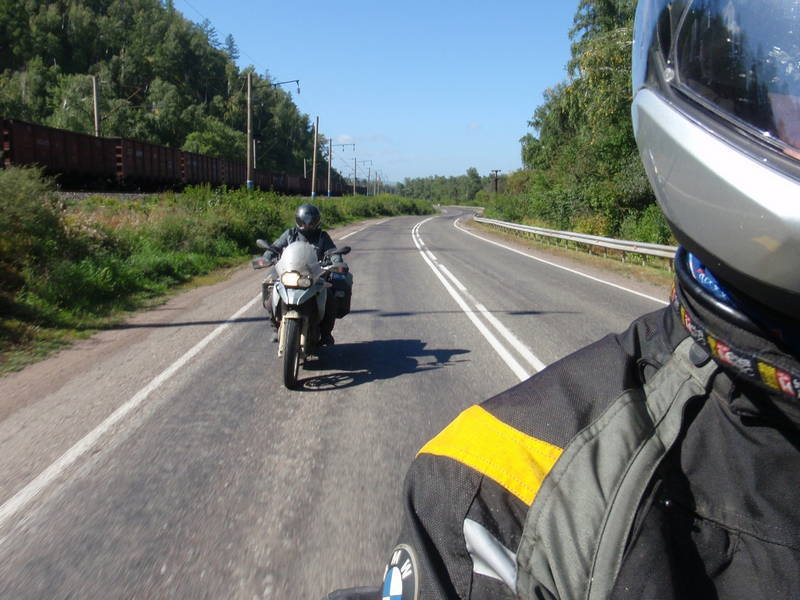
Meeting more friendly people
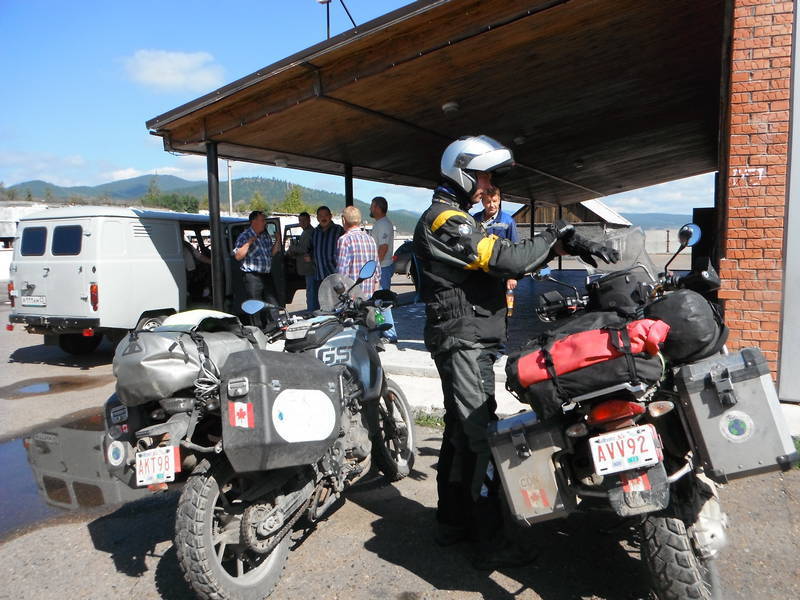
We arrive in Ulan Ude, site of the largest bust of Lenin... in the world
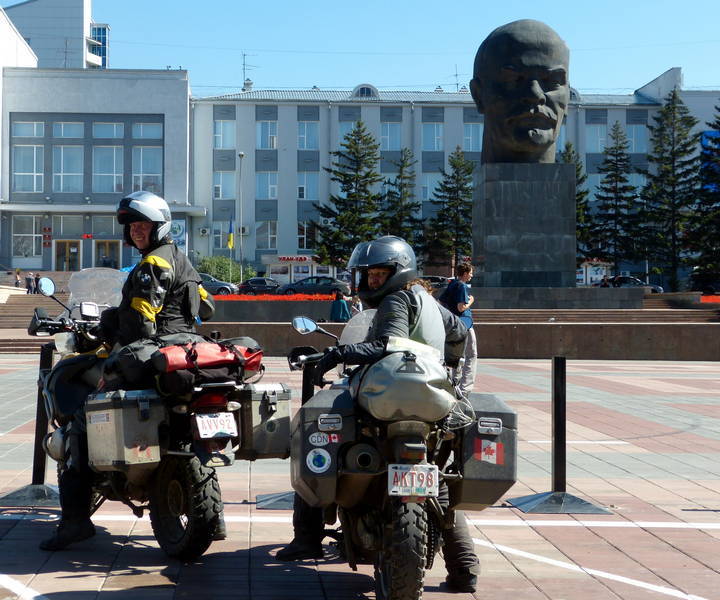
Ulan Ude traffic jam

We decided to just stay at a nearby hotel and meet Victor there in the morning. He spoke Russian only, so he called up his English speaking friend, Elena, by cellphone to translate. I went in to enquire about a room, and after much conversation between Tamara, the hotel clerk and Victor, agreed on the amount, saw the room and said we would take it. Tamara started hemming and hawing about registration, and there was a lot of looking for forms and conversation with Victor in Russian. In the end, she said we couldn't stay. In the meantime, a cyclist had ridden up. I thought he looked Scandinavian, thin and muscular with a huge beard. When I asked if he spoke English, he said, "Yeah, I'm from Alaska!" Myles had been on the road for 3 1/2 years and had just cycled up from China and Mongolia. We told him of our hotel plight. He was also looking for a place to stay. I asked Tamara if we could just put our tents up in the front yard, and she said no. Myles saw an open field further up the road and said he would just put his tent up there. We said we would join him. As he was putting it up a herd of horses trotted by. Tamara changed her mind and said to just camp near the hotel. Victor got in his truck and drove to the airport to check out a hotel there, but we didn't want him to. Tamara again changed her mind and said we could stay in her hotel using Victor's passport for the paperwork but by this time we were determined to camp with Myles, and finally set up the tent, just as the sun was going down, or right during prime mosquito time. I showed Tamara my downfilled sleeping bag because she was worried we would freeze. We invited Myles into the restaurant for a 10:00 o'clock dinner, and shared travelling stories.
Myles and Victor at the hotel
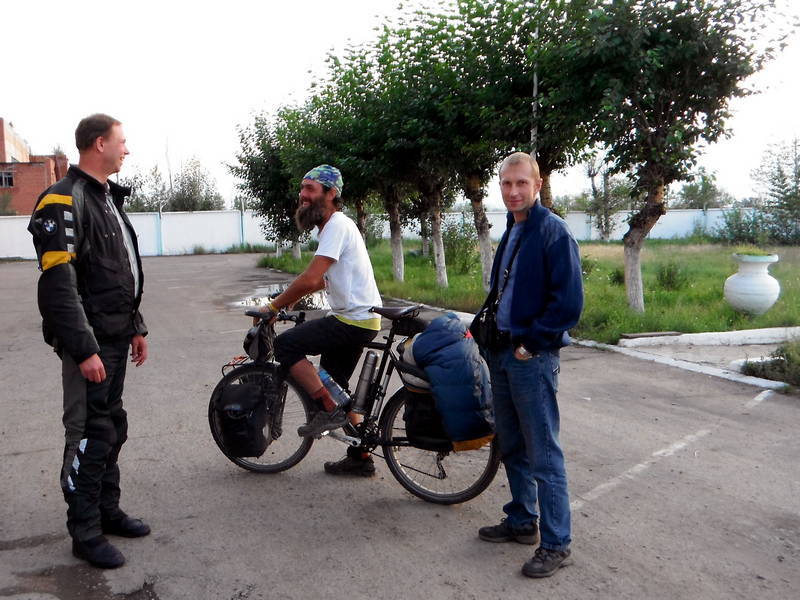
We set up camp in the tall grass of the hotel courtyard
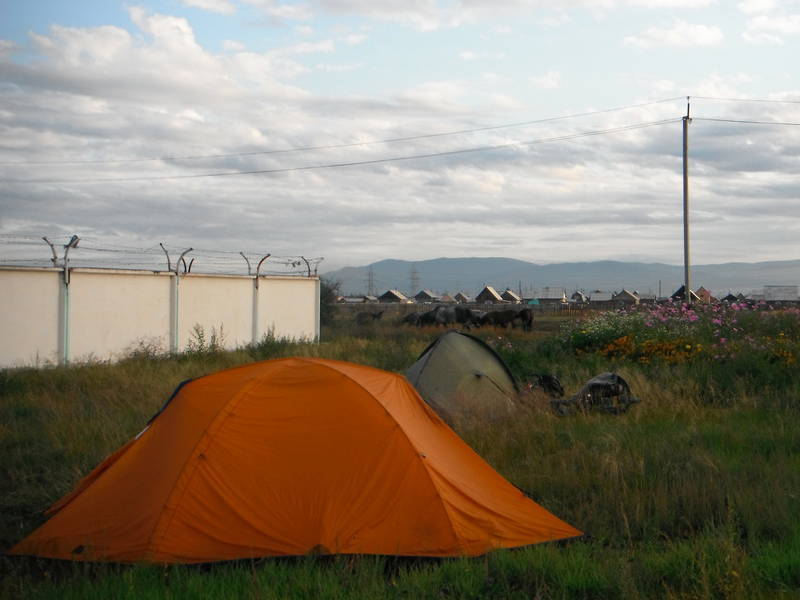
Victor met us at 10:00 the next morning and sat us down at a little cafe while he went to the airport to get the tires. Thank goodness there was no delay. We gave him the money, which he would send to Denis in Moscow who had shipped out the tires. We strapped them onto Ekke's bike and we were finally on the road by 11:00 am. The 200 kilometre ride to the Mongolian border was an absolute joy as we meandered through valleys and whizzed by pine trees in the glorious sunshine. We made good time as we pulled into Kyakhta, the last town before the border, to spend some roubles on gasoline and lunch. Young Russian boys came jogging after us, waving and giving us a thumbs up. I am always put on my guard when this happens, because when boys in Ethiopia or Jordan did this, it was usually to wing pebbles at us. But throughout Russia we received nothing but big smiles and waves and good wishes. From St. Petersburg to Ulan Ude, Russians always showed their appreciation of us two Canadian motorcyclists riding through their country. Many of them were possibly a bit wary of strangers at first, but once we smiled and spoke the three Russian words that we knew, they were very accepting of us. I will miss that.
Gorgeous pine forests and curvy road with little traffic leads to the border

After our last Russian meal of borscht and meat dumplings, we looked for an exchange place to buy some Mongolian Togrogs, but no one here dealt with that currency. A Mongolian fellow with a Harley t-shirt, who just crossed into Russia told us to just ride to the front of the border line-up. Inside, Russian officials asked for our customs documents that we had received upon entry into Russia a month and a half earlier. We searched our paperwork but could not find the documents. I thought we had handed them over when going out of Russia into Kazakhstan. An interpreter was brought in to impress upon us the importance of the customs papers. We told them that upon entering Russia from Kazakhstan, we had asked to fill out customs papers, but the border guard had said, "Nyet." We should have insisted, but it was late and we didn't really care. Paul, a 4x4 driver from the States whom we had met earlier in Listvyanka, told us that we would probably get through, but with a fine. The border official took our passports and vehicle registrations and was out of the office for a long time, photocopying. In the meantime, Ekke had a brainwave, looked in our old Russian vehicle insurance papers, and found his custom form. He then looked in my insurance packet and found mine. Feeling a bit sheepish, we presented the papers and were on our way. Goodbye Russia. What adventures would await us in Mongolia?
Our last Russian meal but someone back there thinks Ekke needs a haircut
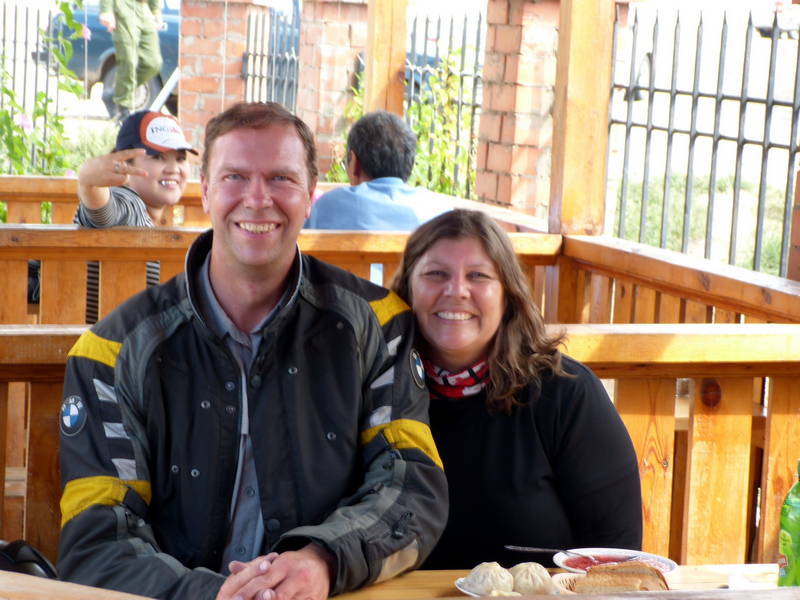
Map of our route through Russia to Mongolia

Mongolia was one of those countries that was exotic and mysterious to us. What would the landscape be like? Would it be too rough for my off-road skill level? How traditional would the people be? Did they really live in yurts? With the delay in picking up tires in Ulan Ude, Russia that day, August 30th, the 200 kilometre ride to the border, and the time it took to sort out our misplaced documents, we finally reached the Mongolia border crossing around 4:30 pm. Luckily, with the time zone change we could turn the clock back an hour. The immigration and customs agents were, surprisingly, dressed very smartly, sort of a retro flight-attendant look. The procedure going in was relatively easy, filling out forms that, thankfully, were in English, getting those stamped, back to the same desk to get more forms, and back to another window to get those stamped. There was a bank to exchange roubles into Mongolian togrogs (sometimes written as 'tugriks'), which was a relief because we were worried we'd be stuck with a bunch of Russian currency. Usually insurance was sold just after we cleared the border, and we really wanted to make sure we bought some. Matt from Britain had bought it when he crossed into Mongolia, and he had been stopped by police later and asked to produce it. We rode through the gate and there we were - in Mongolia. The border town was dusty, with brick or wooden shacks, and plenty of garbage strewn about - not a great first impression. Two huts had signs that said, ' Insurance', but they were closed. So, we just rode away on a paved road, having a brief look in the next town for an insurance hut, but with no luck. The narrow road wound its way through green hills and grassy fields and the dark, gray sky seemed to make the green appear more brilliant. Every now and again we would spot gers or cylindrical nomadic huts, known as yurts in other countries, with herds of sheep, cattle or horses nearby. Sometimes there were a few leafy trees, but it was mostly rolling hills and plains, stretching far into the distance.
Bringing tires into Mongolia
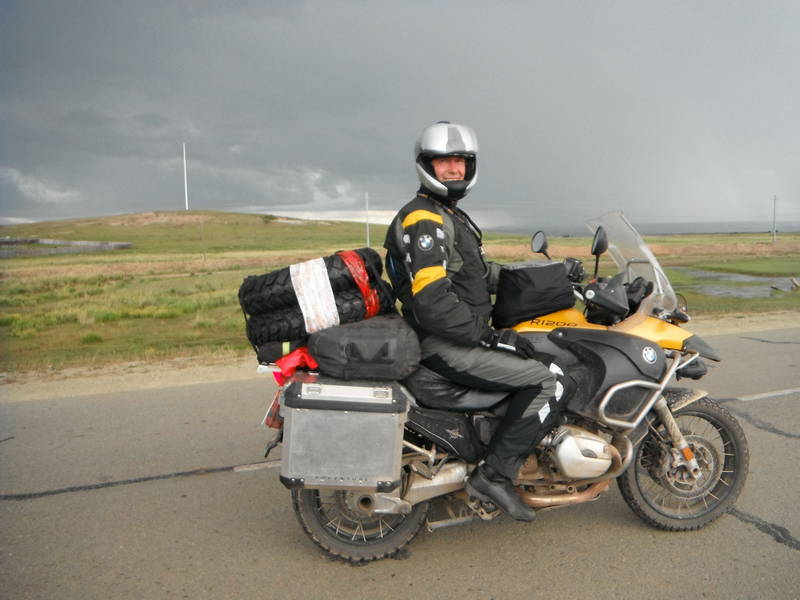
Leaving the border town and heading out onto the steppe

Putting on the raingear
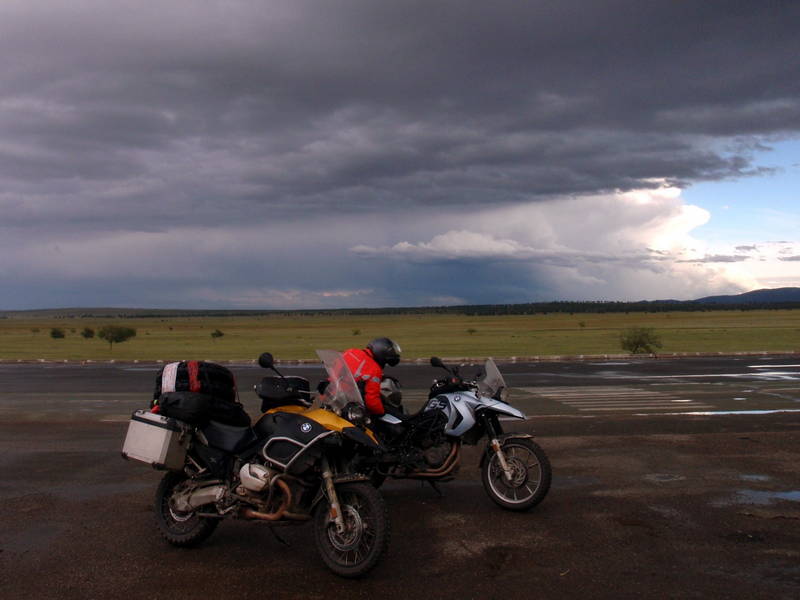
For a while we were making good time as the paved road continued with very little traffic and just a few potholes. Maybe we would make the 340 kilometres to Ulaanbaatar that night. A roadside hut appeared in the distance, and as we got closer, we could see a barrier across the road. I saw a uniformed officer come out and approach us. Oh no, was this where we were going to get caught and receive big fine for not having insurance? I was just getting my story straight in my head about how the insurance places were closed when he handed Ekke some little tickets. It was just a toll booth and they wanted 500 togrogs (35 cents) from each of us. Phew. The potholes seemed to get bigger as we rode along, and then there were more vehicles, 4x4s, big trucks, and cars. The sunset over the hills was really lovely, but it meant that darkness would soon be upon us, with Ulaanbaatar still quite far away. Drivers here showed us motorcyclists about as much respect as they did in Russia, or very little. Once oncoming vehicles saw that we were on bikes, they just headed into our lane, thinking we had enough room to just move to the side of the non-existent shoulder. After a few near collisions, we stopped for a break at a convenience store, bought some chips and yogurts, and assessed the situation. To go on in the dark was probably madness, but the thought of putting up the tent behind a gas station, in the dark, was not appealing either. We had reserved a ger at the Oasis Guest House in Ulaanbaatar, and it would be nice to make it there. Also, we wanted to be at the Chinese embassy first thing Friday morning to apply for our visas as they were closed on the weekend. Fortified with food, we got a bit braver and headed up the highway again. In the space of a few minutes, a car coming towards us pulled out to pass, saw us, and just kept going, forcing us to do some quick manoeuvering so as to avoid the head-on collision. We had several more close calls. Vehicles passing from behind came up way too quickly and nearly sideswiped us when they misjudged the pass and had to scramble back in. At about 10:00 pm we'd had enough. Ekke found a side road, and we headed up the rough gravel in the pitch dark. With our headlights to help us we located a fairly flat area on the steppe and managed to put the tent up. Exhausted from stress, sleep came easily.
Beautiful colours because of the rain
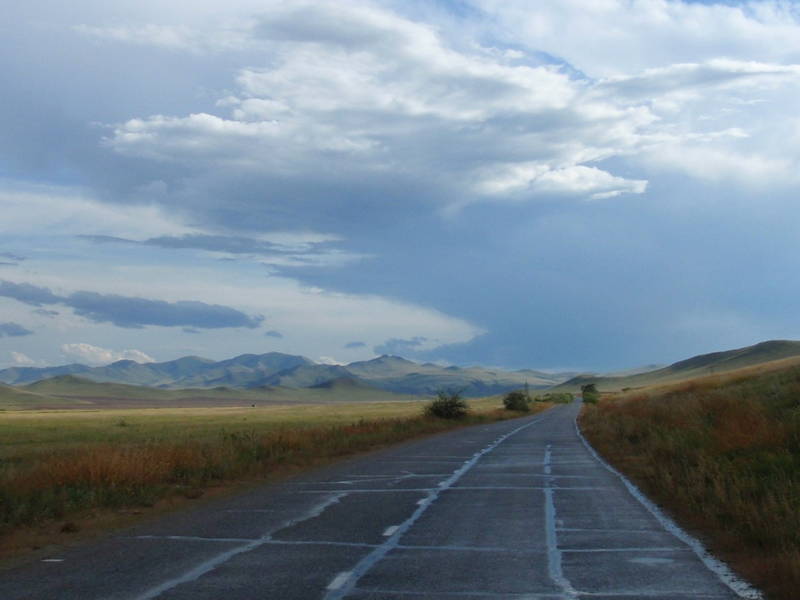
A herd of sheep and a few gers
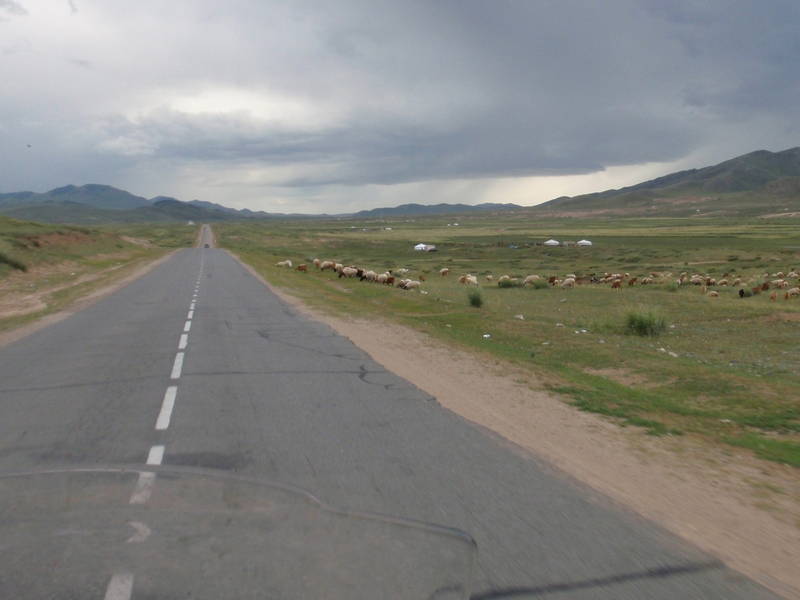
We check Sukhbaatar for insurance sellers but no luck
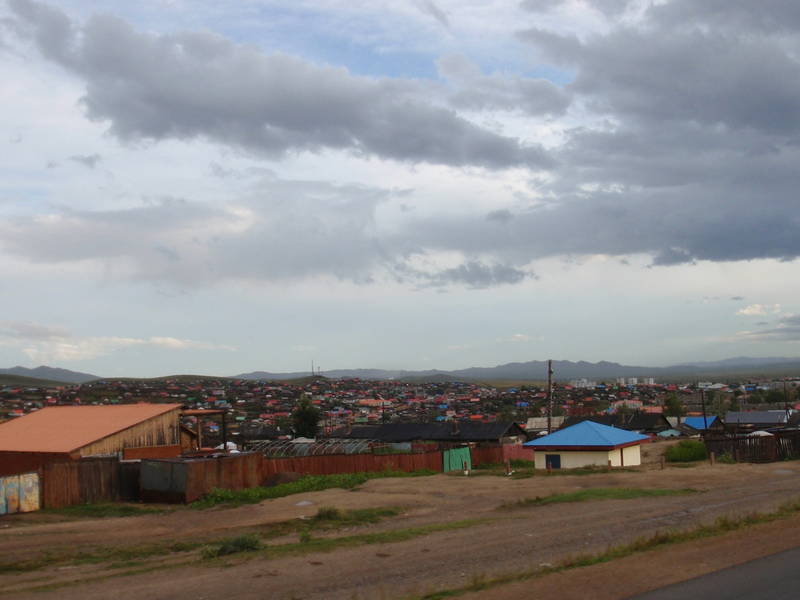
Getting dark as we ride south

Seven degrees Celsius was pretty chilly the next day, but we were warm with our trusty MEC (Mountain Equipment Co-Op) sleeping bags and Exped mattresses. I climbed out of the tent and looked around. Off in the distance a man on a horse near a ger was herding his cattle our way. I waved, and he rode over. His English was about as good as my Mongolian, so we spoke in sign language. Yes, it's really cold, nice horse, from Canada, thanks for letting us stay here, beautiful country, is a photo okay, what's the price of mutton in Mongolia? Ekke snapped a few photos, I gave him a Canadian pin and he rode away. Very cool. It was a real 'Ewan and Charlie', moment (Long Way Round). Our pack-up was super quick. We donned many layers of clothing and headed out onto the highway to ride the last 40 kilometres to UB. Drivers were slightly more civilized in the daylight, until we reached the city of course. Then it was just jockeying for position in heavy traffic, trying to avoid deep potholes and getting sideswiped. We had never seen such a bad road in a city before and there was nowhere to swerve to avoid big potholes except into other vehicles. So we just slowed down and rode over the huge holes. Eventually the gravel and potholes turned into pavement, and there were actual lines and traffic lights. Lots of traffic police all over the place seemed to have one job only - to keep traffic out of the bus lanes. The buses were the only vehicles that were moving. Sometimes, if traffic moved slowly or was stopped we could split lanes or go in between vehicles to get through faster. Our plans to go to the guesthouse first to unload the luggage were quickly changed when we saw how long it was taking to just move a block. It still took about an hour and a half to go nine kilometres to get to the Chinese embassy. It opened at 9:30 am and it was about 9:25 when we arrived. There was a big line-up of about 50 people outside the door as we went to find a place to park. I stood in line while Ekke secured the bikes, and completed a couple of forms while waiting. There were people there from France, Germany and Australia and who knows where else, all trying to get their visas. Scissors and glue were provided to trim and attach a visa photo onto the forms, and by 11:30 am we got to the window to submit the application. The place closed at noon, so we were lucky. We chose to pay $20 U.S. extra, or $50 each to expedite the process, and they told us we could pick up our visas on Monday versus the following Friday. It's always a good idea to carry plenty of U.S. dollars when travelling to developing countries. The ride to the guesthouse was exciting, splitting lanes and trying to get through intersections without getting hit by cars making illegal turns. Traffic was so congested that even after our light was green, it took too long to clear the intersection of other traffic and then our side would have to go on a red light. Pedestrians didn't help as they crossed against the light, walking out onto the middle of the road to stand on the lane lines, slowing everyone down. What a relief to pull into the Oasis Guesthouse, owned by Austrians. The place was just ship-shape and very well run with hotel rooms, cafe, laundry service, a garden area with gers, and a place to park overland vehicles. Matt, our British friend, was there and it was great to hear about his adventures in west Mongolia. We hadn't had a hamburger and fries since European Russia, so that was the first order of business. Delicious. What a treat to also have Austrian specialties on the menu like Kaiserschmeeren (chopped up pancakes), leberkase (meatloaf) and Wiener schnitzel, but also spaghetti, lasagna and bacon and eggs. It's amazing how a little western food is so comforting when everything around is so unfamiliar. Our ger had four beds but we rented the whole thing for ourselves for 68 000 togrogs ($48) per night. Quilts were provided and there was a sawdust-pellet stove, but we didn't take any chances on being cold and brought in our own sleeping bags and mattresses to put on the beds. Gers are made of felt, with a lattice wood frame and are the dwellings of Mongolian nomads. You see them all over the countryside as half of the population still follow their herds and move locations four times per year. The door was so short, however, that I kept bonking my head. There was a great variety of vehicles at the guesthouse many from Switzerland but also from Germany. A Swiss couple in a Sprinter van told their tale of coming through Ulaanbaatar. It took them so long that they gave up, pulled over onto a side street and camped there for the night to try again the next day. A French motorcyclist arrived on the edge of the city at 6:00 pm, happy he would get to the guesthouse for supper, but not arriving there until well after 8:00 pm.
Good morning! What's this strange little orange ger doing here?

Mongolian herder

Our own ger
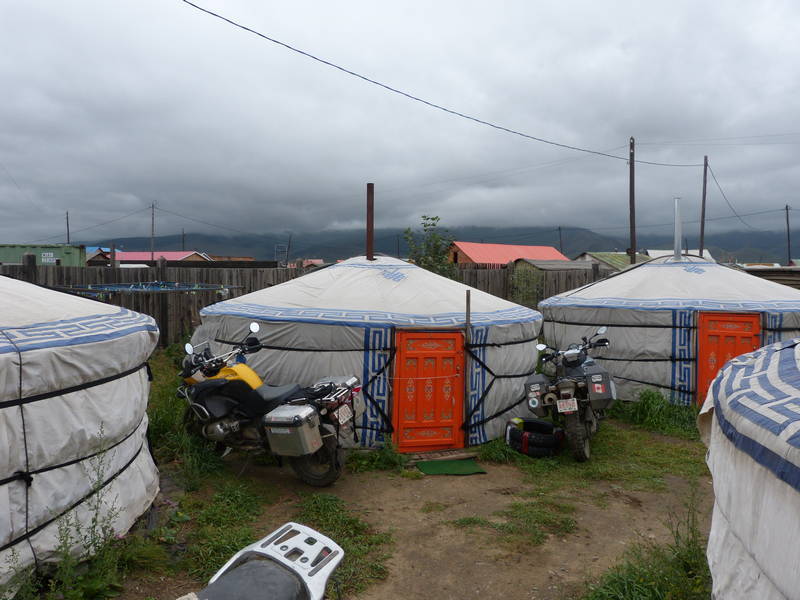
Quite roomy once past the low door

A cheeseburger, fries and a Coke. Life is good.
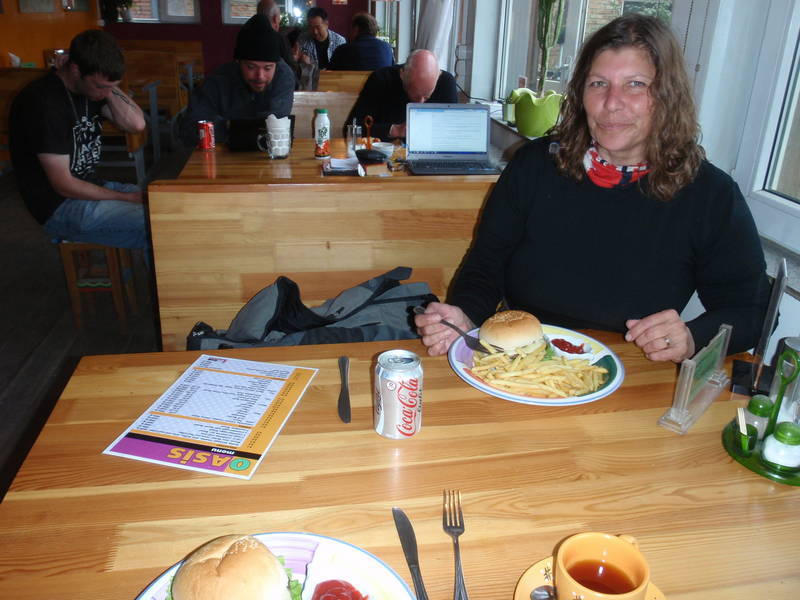
The first day of September was fairly cool. We submitted a couple of bags of laundry to guesthouse staff in the morning and it was done by noon, ready to hang up outside. Matt (Britain, Honda Transalp), Jan (France, Honda Africa Twin) and Uwe (Sweden, KTM 990 Adventure) were eager to help us put our new rear tires on our bikes. We combined expertise to break the bead on my tire using Ekke's sidestand and the weight of his bike, used an air compressor from one of the big overland trucks, and shared tools to get the tire back on. Then Ekke used our small air compressor to finish the job. After lunch, the same process was used for Ekke's tire. We got very comfortable at the Oasis which was a world away from the Ulaanbaatar traffic chaos just outside its gates, and it was really easy not to leave. That afternoon and evening and half of the next day were spent just sitting around eating and working on the laptops. But by late afternoon we had to get out. A group of us took a couple of taxis downtown, the cabs choosing little back streets that were in worse shape than the main roads but where traffic actually moved. If traffic stopped, vehicles would try to pass in the oncoming lane, blocking oncoming traffic and then it was gridlock. We finally made it to Sukhbaatar Square, built to commemorate independence from China, with a huge statue of Chinggis Khaan (sometimes called Ghengis) right in the middle of the marble entrance to the parliament building. A visit to the National Museum of Mongolia which housed Stone Age tools and weaponry, costumes of Mongolian ethnic groups, and a traditionally furnished ger, was very interesting. A Chinggis Khaan display was very insightful, as the focus was not on him as the brutal conqueror that he is well known for. Mongolians see him as a fair and responsible leader and advocate for the people. He promoted religious tolerance, diplomatic immunity, education and rights for women. After a couple of hours at the museum, we walked through a fairly modern shopping mall, bought some souvenirs, and ate supper at a restaurant called 40 K. Coincidentally an American named Brad (4x4, Mongol rally), a British guy (Range Rover) and Michael from Vancouver (rented jeep and backpacking) were also there, so it was fun. We saw the start of the Formula 1 Belgian Grand Prix on TV, and watched as Lewis Hamilton and Fernando Alonso immediately crashed and were out of the race.
Matt gives us a hand installing the new tires
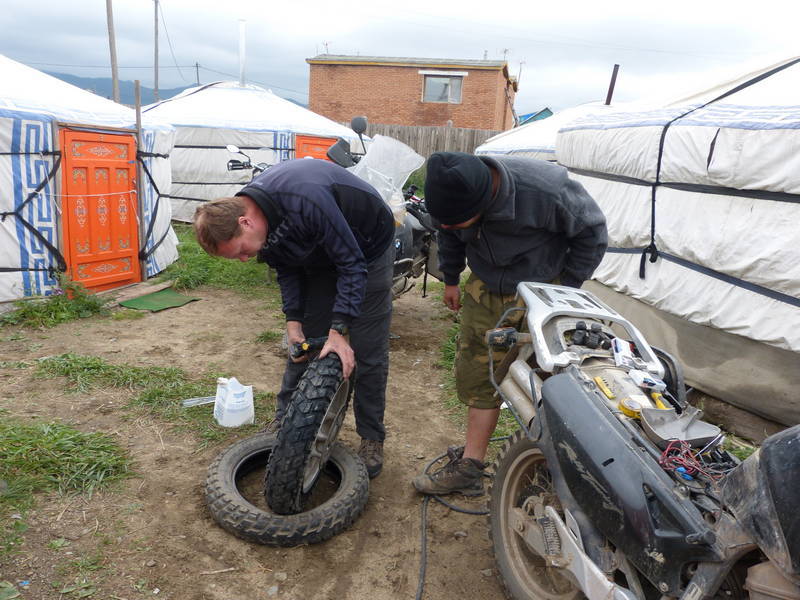
It's handy having an overlander's truck for compressed air to seat the bead
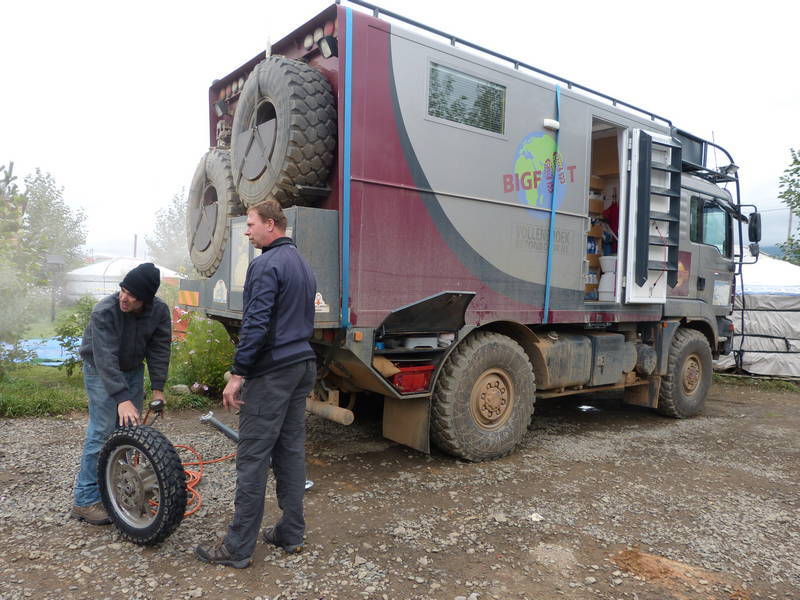
Uwe adjusts the chain
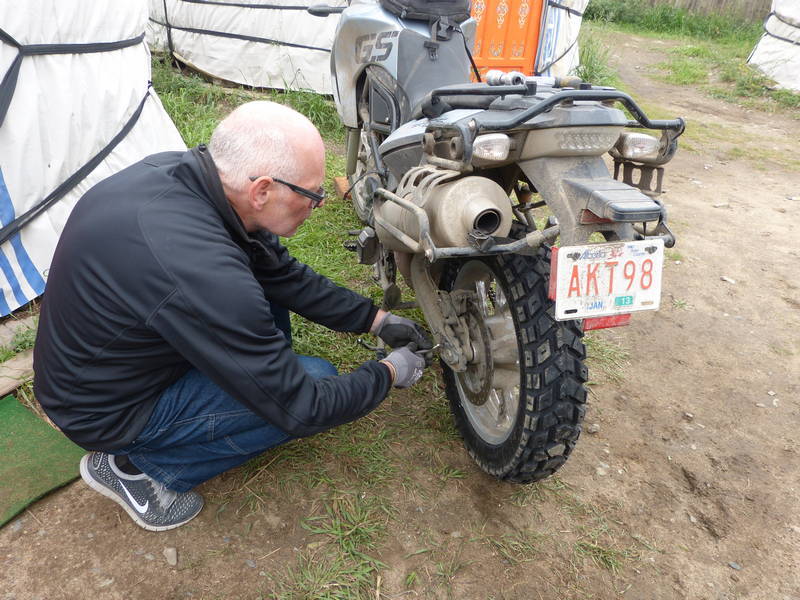
Mongolian Parliament Building
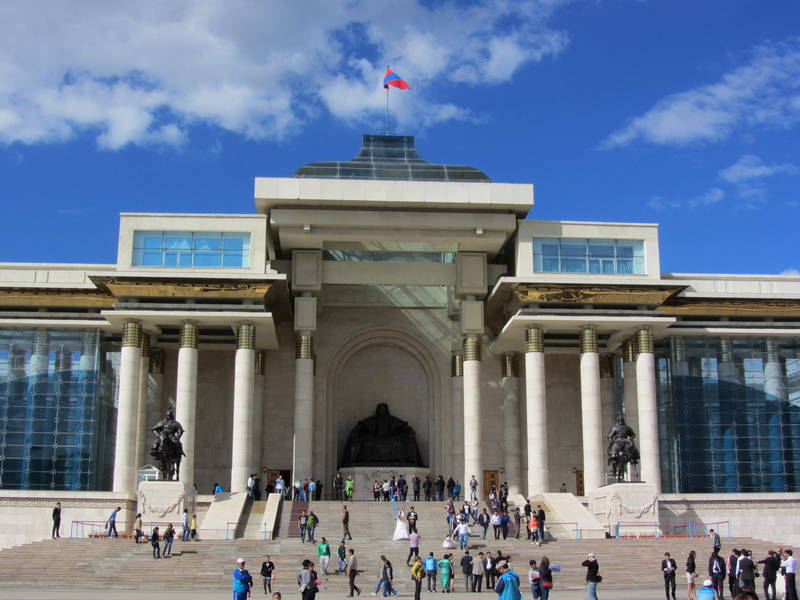
With an enormous statue of Chinggis Khaan
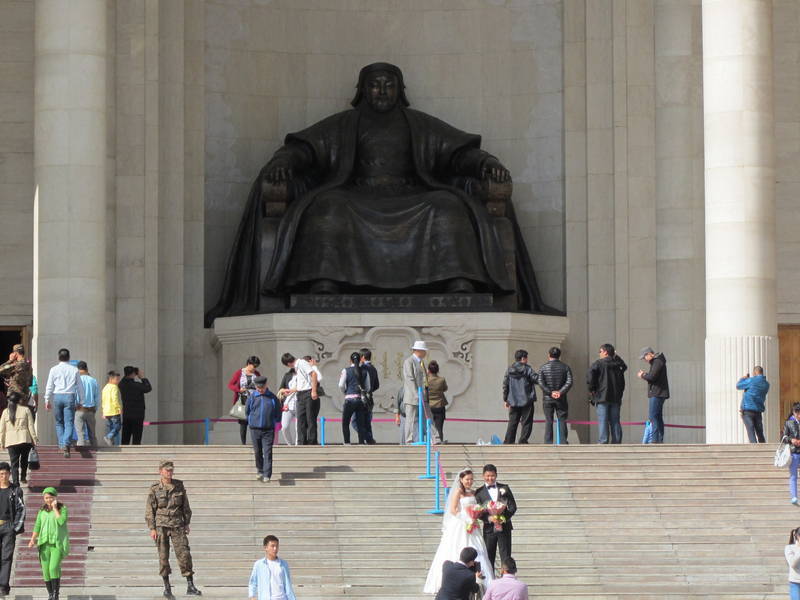
Sukhbaatar Square in front of the parliament

An afternoon in the museum
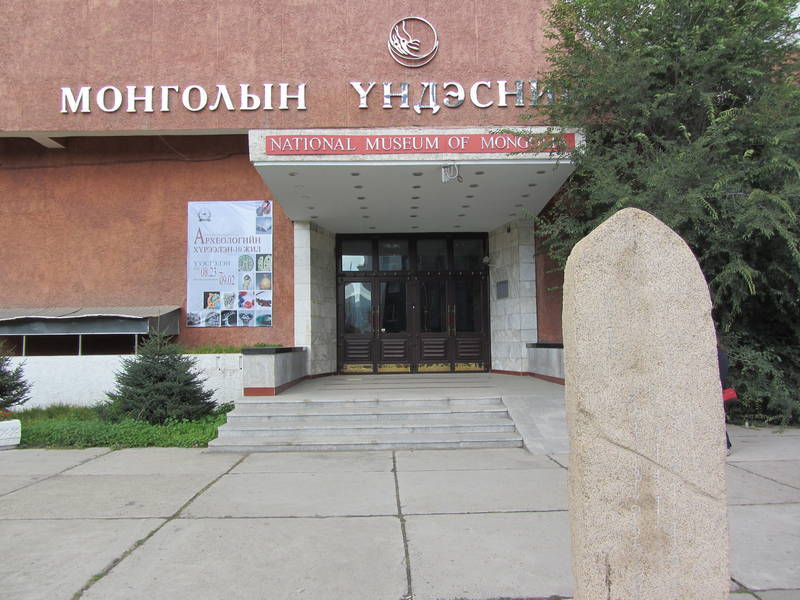
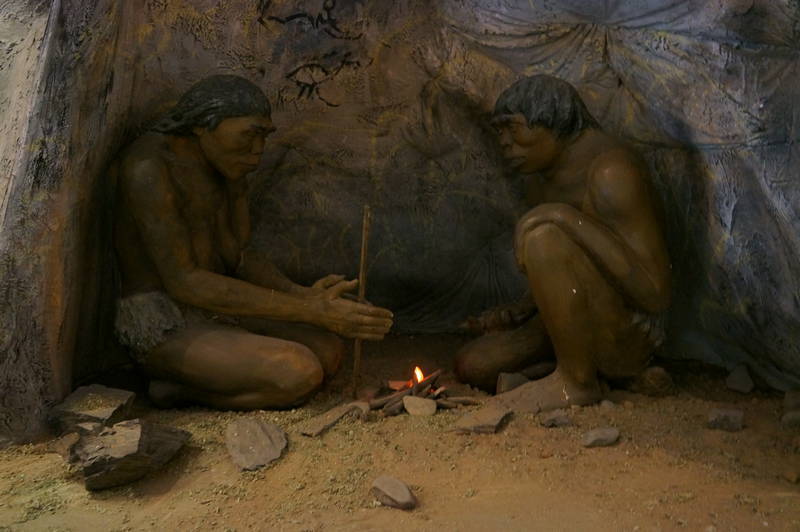
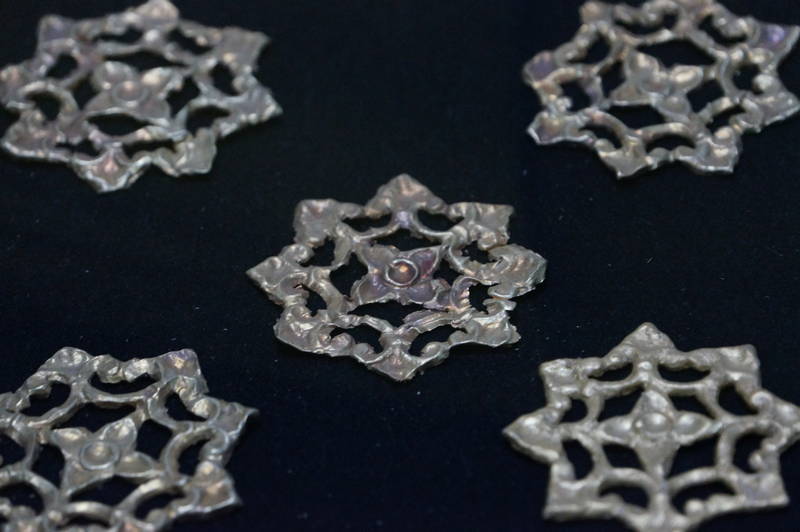
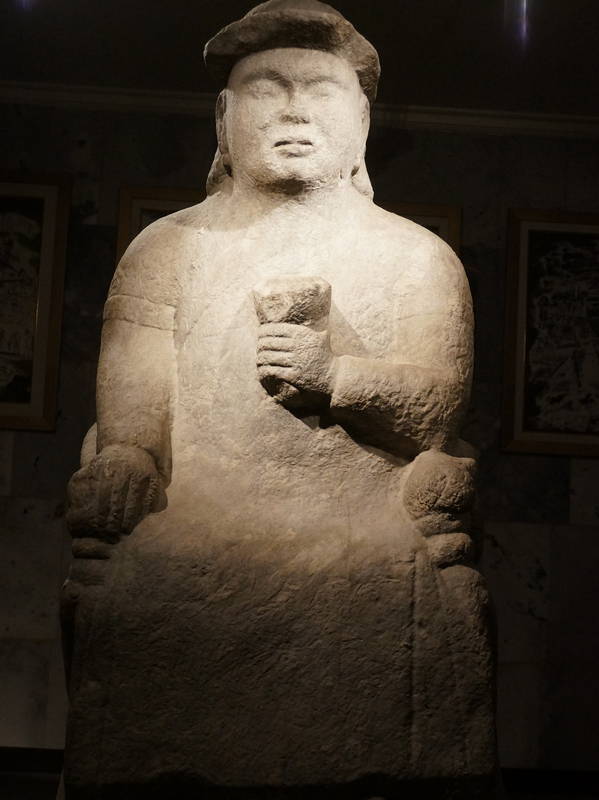
Where did George Lucas get the idea for Queen Amidala's hair?



Horse-head two string fiddle

Mongolia invented Speedos? Who knew?
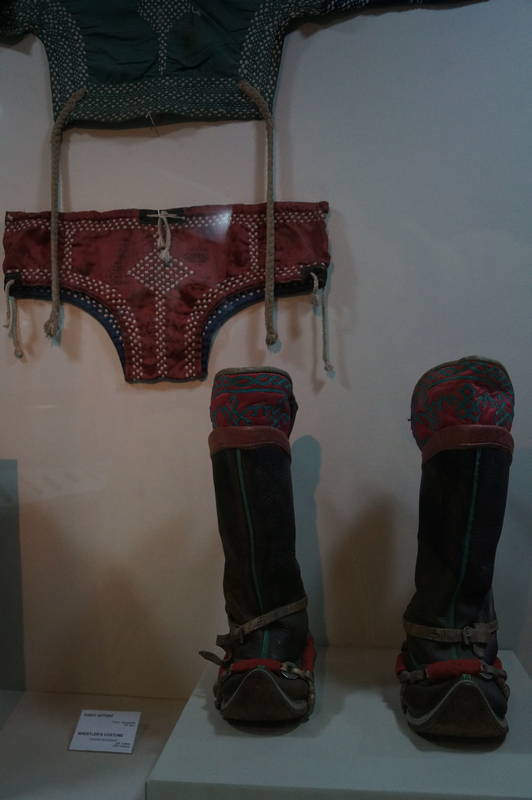
Going for a walk after the museum

Ekke helps to promote Mongolian tourism (Ekke Khaan?)
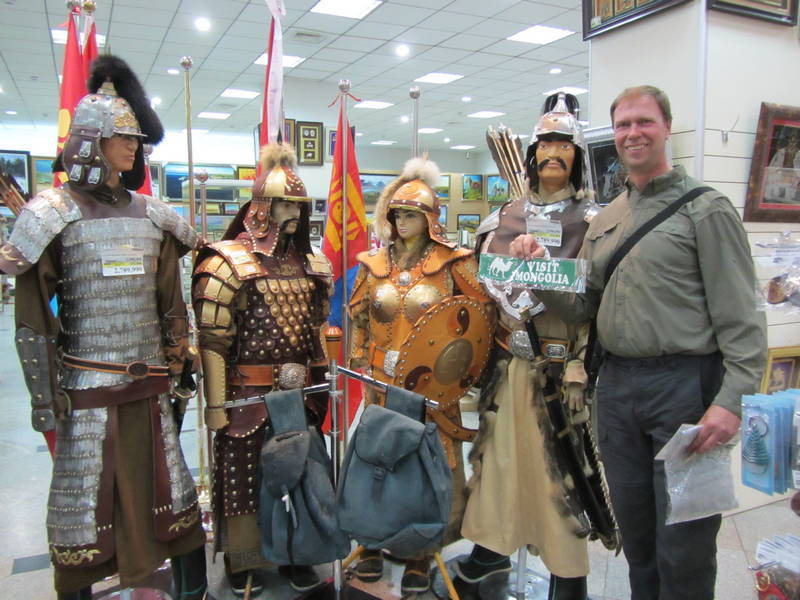
Matt, Jan and Uwe were hanging around Ulaanbaatar waiting for Jan's carnet (passport for his motorcycle) to arrive by courier from France. It arrived on Monday morning and we said goodbye as they rode off together with plans to go north to Russia and then over to Japan. The main reason for us hanging around UB for so long was to pick up our Chinese visas. The five kilometre walk to downtown on Monday was interesting, with dirt walkways that were sometimes just big holes in the ground or a narrow ridge of packed dirt. I grinned broadly as we watched little kids, all dressed neatly in uniforms, heading into class for the first day of school. But then I felt a bit nostalgic, and wondered how my former students were doing. School would start for the Calgary Board of Education the next day. Lonely Planet recommended Millie's for lunch and my grilled cheese sandwich didn't disappoint. Then Chinese visas needed to be paid for at the Golomnt Bank, easy to find at the Blue Sky Hotel, before we picked up the visas. After a 20 minute wait in line at the Chinese embassy, we picked up our passports with the Chinese visas attached inside. We were going to China! Very exciting. Taking our lives into our hands to cross the streets, we headed back to a theatre we had heard about from Heike, a BMW rider from Germany. She had said there was a fantastic cultural show, so we bought tickets for 25 000 togrogs ($17) each. They wanted 50 000 ($34) to allow us to take photos during the show, which we declined. After a delicious pastry at Wendy's Pattisserie, we took in a fabulous show. Several ethnic performances had a modern touch with great costumes and fast-paced dancing. A contortionist showed what amazing things could be done with the human body, tying herself into knots while balancing on her hands. There were so many great photo ops and people who had not paid to take photos tried to sneak in a few shots, but always got caught and sheepishly put their cameras away. The throat singing was really incredible. I thought that throat singing was unique to the Canadian Inuit, but apparently not. A unique instrument made from a cow's horn sounded deep and rich, almost like a clarinet. The show closed with traditional and modern music by the Mongolian National Orchestra playing a variety of string and percussion instruments that were unfamiliar to us, but it sounded fantastic. A female opera singer's voice was a bit high and twangy for our western ears, but the horse-hair cello solo was stunning. The orchestra finished with a lovely rendition of 'We Are the Champions' by Queen, much to the delight of the audience. Getting a taxi back to the guesthouse looked impossible as so many people were trying to wave them down, so, we braved the buses. All of them were stuffed to the gills. We pushed our way onto the Number 27 and Ekke and I just looked at each other, thankful that we didn't have to do this every day. More and more people pushed their way on and we couldn't breathe, jammed in from all sides. I had the 'Maps With Me' program opened on the iPhone and we followed our progress up Peace Avenue, getting off just near the guesthouse.
Saying goodbye to Matt again

With Uwe and Jan to Japan
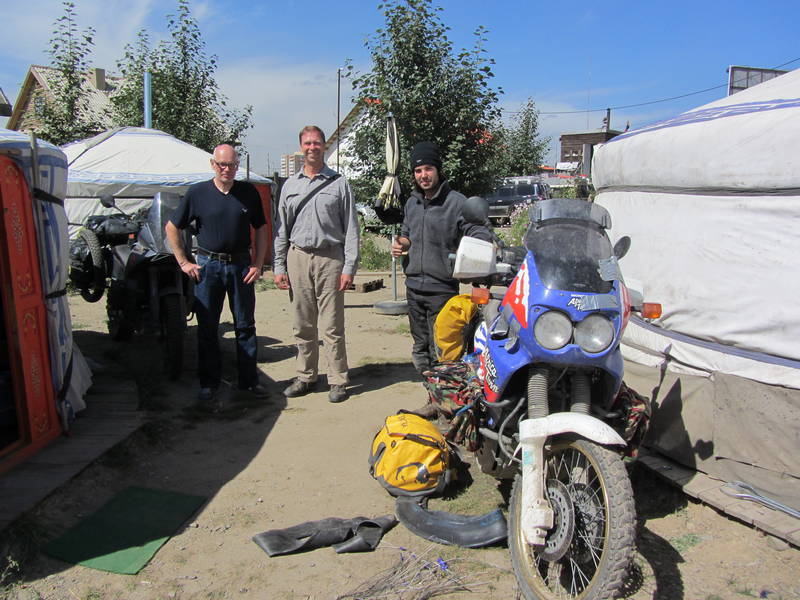
Pedestrian hostile environment in Ulaanbaatar
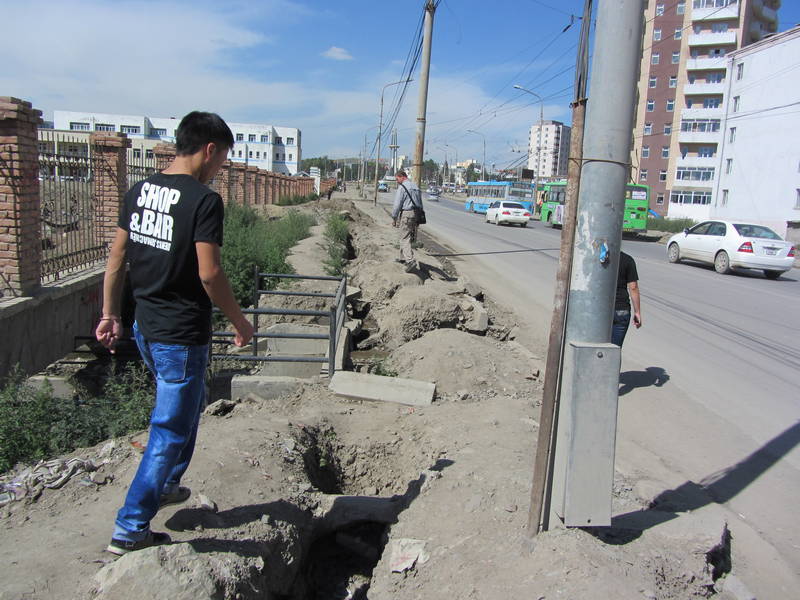
Walking at night was interesting

Audrey seems happy to see the kids head back to school
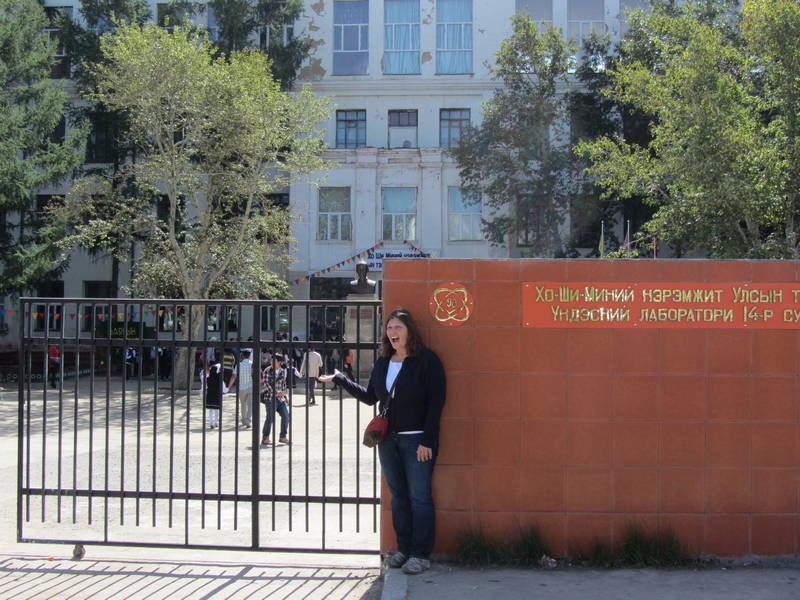
A speed bump? Really? The roads aren't rough enough?

The Blue Sky hotel towers above the Choijin Lama Temple Museum
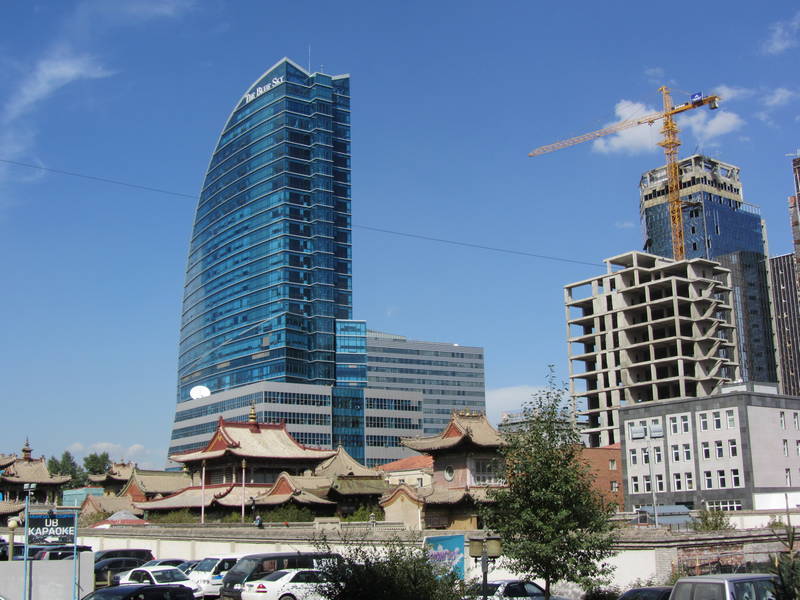
Statue of Sukhbaatar
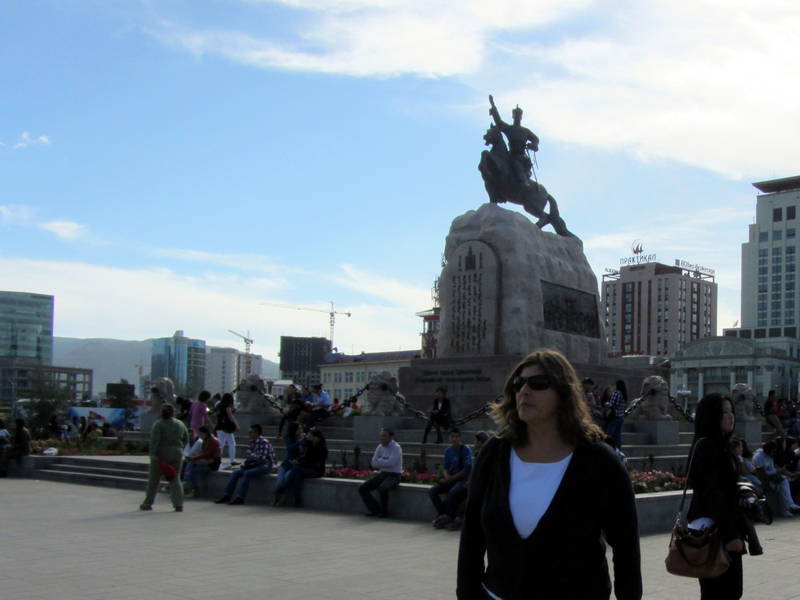
One of the costumes used for the dancing performance

With such reliable internet at the Oasis guesthouse, we stayed another day and finished a website chapter. In the afternoon we rode east on a fairly good highway to go see a statue. Through towns, the road got really, really bad and vehicles zigzagged their way around huge sandy holes in the road. In the distance, we could see the silver statue of Chinggis Khaan glistening in the sunshine, our destination for that afternoon. As we got closer, the immensity of the structure became very apparent. At 40 metres high, it was huge. A German in a Toyota HiLux pickup truck with zebra stripes walked over, introduced himself and offered to take a couple of photos of us with the statue. Karsten had driven to Vladivostock, Russia, and was now heading home to Hamburg via Mongolia. We told him about the Oasis Guesthouse and he said that he was already planning to go there. Ekke and I paid 8000 ($5.60) togrogs each to take the elevator up the tail and backside of the horse. Some stairs took us up to the top of the horse's head. There were great views of the Mongolian countryside and of our motorcycles in the parking lot. A museum downstairs showed warrior artefacts and a map of the lands controlled by Chinggis Khaan, from Southeast Asia to China to Russia to Eastern Europe and the Caucasus. On the trip back, we were just coming into UB, slowing down from the higher speeds on the highway. Ekke was on the left side of the lane, and I was on the right. He swerved to the left, and I hit the biggest pothole I had ever seen, each tire banging hard on the edges of the hole, too late to swerve. I hadn't seen it with the low sun obscuring my vision. It wasn't so much a pothole, I thought later, as the entrance into Middle Earth. As I emerged from the other side of the hole, I thought, okay, maybe I escaped damage. But the bike got more sluggish, and soon the steering felt like it was gone. Then it really felt like something was wrong, like a bent frame or damaged suspension. I could see my future ride through China fading before my eyes. I chug-chugged towards Ekke, who had stopped further ahead. He looked at the bike and said, "Uh, you have two flat tires". I couldn't put the sidestand down to look because the bike was now too low. The front and rear wheel rims were both bent, and this had broken the seals of the tubeless tires, letting the air out. We assessed our options, like getting a truck to take us back to the guesthouse or somehow pushing the bike. I didn't want to wait there in heavy traffic by myself. The Heidenau tires were pretty thick and still had some structural integrity. So I rode back very carefully in second gear, 4 1/2 kilometres to the guesthouse, on two flat tires. Every little piece of dirt or uneven pavement made the bike shimmy, and I hung on tight. But we made it. Feeling a bit disappointed that my China trip could be undertaken in the passenger seat of a pickup truck, the Tiger beer went down easily that night.
Using a motorcycle to herd sheep

And using a motorcycle for simple transportation
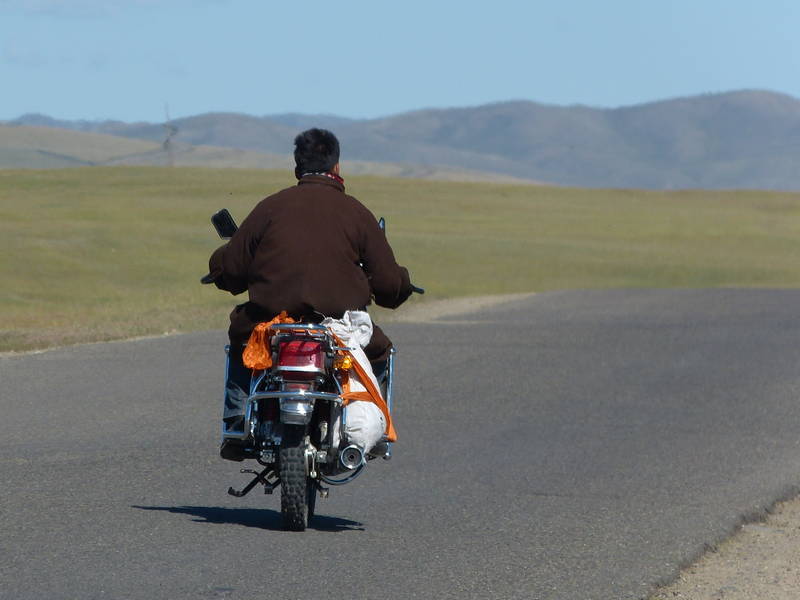
Gers on the steppe

Chinggis Khaan statue can be seen from far away

Pulling up to the entrance to the monument
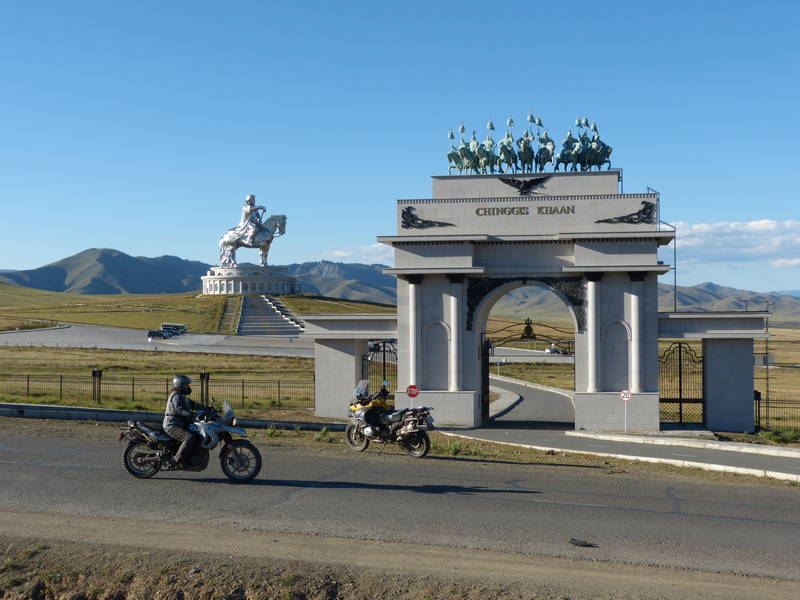
Wow, that's huge
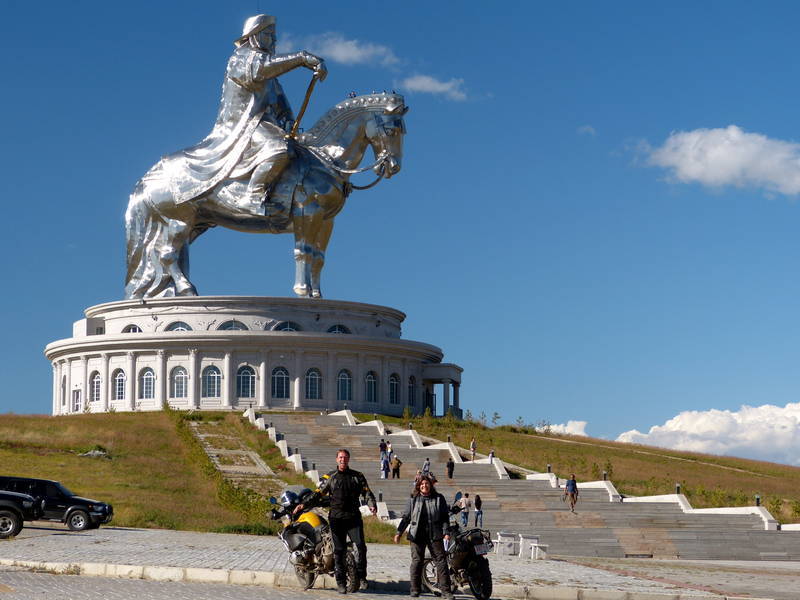
Are those people up there on the mane?

Chinggis looks to have had even bigger feet than Ekke

The view from the horse's head

Face to face with the "Man of the Millenium"

Ekke writes:
Returning from the Chinggis Khaan monument, riding into the setting sun, visors covered in dust, we approached the outskirts of Ulaanbaatar. All of a sudden the vehicle in front of me swerved to avoid a huge pothole. I was in the left of portion of the lane and swung into the opposing lane to go around it but looking in my mirror I saw that Audrey was unable to avoid it and slammed into it at full force. The enormous motorcycle-swallowing monster of a pothole covered most of the lane and she was riding in the right wheel track with a guard rail on the shoulder. As I continued riding I saw that Audrey had really slowed down, putting on her hazard flashers so I pulled over at the first safe opportunity to wait for her. When she wobbled up I saw that both tires had gone flat. Then, like a slap in the face, we realised that this could be the end of our China tour. In five days we needed to be at the border to start our tour and it was at least a three day ride to get there from Ulaanbaatar. There was no way that these wheels could be repaired or replaced in time. In the meantime we were still five kilometres away from the comfort of our ger at the Oasis Guesthouse as the sun was going down. With light fading and our options fairly limited we decided to ride back on the flat tires. There wasn't much more damage that could be done to the wheels and if we kept the speed down then hopefully the tires wouldn't be damaged either. As we rode slowly along the shoulder I watched Audrey struggle with the wobbly motorcycle, avoiding potholes and sandy sections. Eventually we made it safely home where we could start thinking about some solutions to our predicament.
Slaloming around some small potholes on the way back from Chinggis Khaan
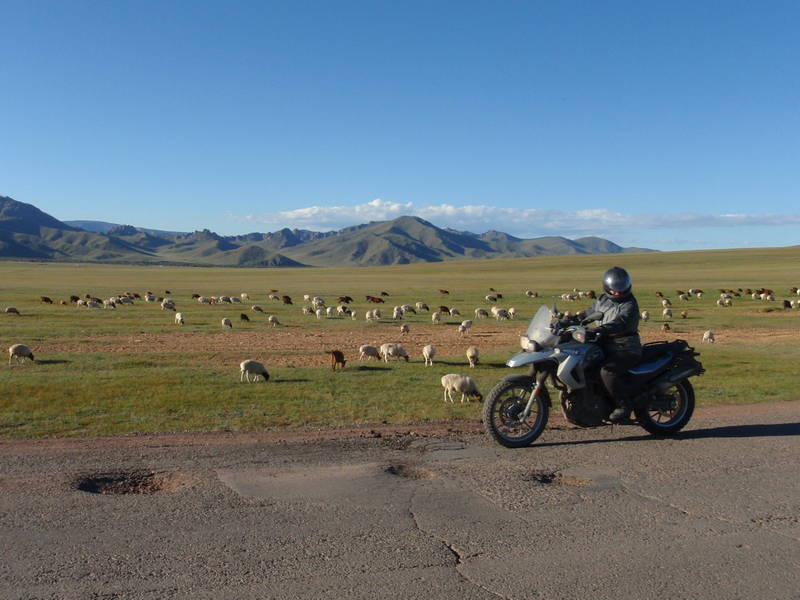
Two flat tires and almost five kilometres back to the Oasis

On Wednesday we did some research on the Horizons Unlimited Bulletin Board to see if there was a shop that could repair the wheels. I also e-mailed Chris at Jungle Junction in Nairobi to see if he had any suggestions on how to straighten the rims as I recalled that he had repaired the wheels on another F650 a couple of years ago. In the meantime Kurt, an ex-Californian now living in Thailand, said he knew someone that ran a motorcycle tour company who might have tubes in the correct sizes. It was difficult getting a hold of Vait as the Skype connection was very poor and for some reason his e-mail junk filter was blocking our Hotmail address but eventually we managed to connect. He did have heavy-duty motocross tubes available in the right sizes, what good news! He was also able to sell us an extra set so that we could have spares. We polished off the Russia chapter of the website while waiting for Vait to deliver the tubes. At 6:00 PM Vait arrived on a beautiful BMW R1200GS Adventure similar to mine, glorious new tubes in hand. While he was there he took a look at the bent wheels and said that his shop foreman might know someone who could repair cast aluminum wheels. With all the potholes in Ulaanbaatar there were bound to be a large number of bent automobile rims needing repair. Our research on the topic was quite divided; some people were saying that the wheels could be repaired by warming them and then using a press to straighten them and others saying that re-bending cast aluminum could lead to small stress fractures in the wheel, leading to catastrophic failure. It couldn't hurt to find out if a local thought it was possible so Vait said he would check with his foreman and call us back.
Bent rear wheel
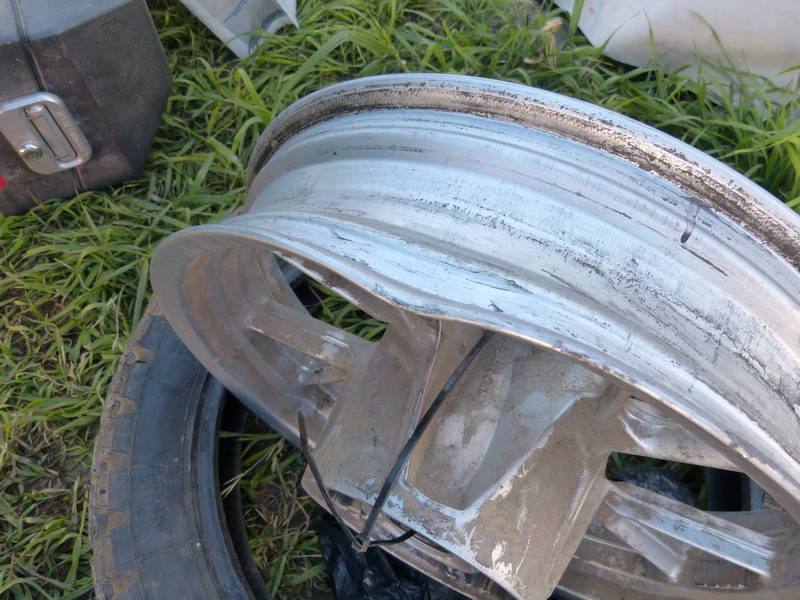
Bent front wheel (the strap is there to hold the centre stand so the bike doesn't fall over)
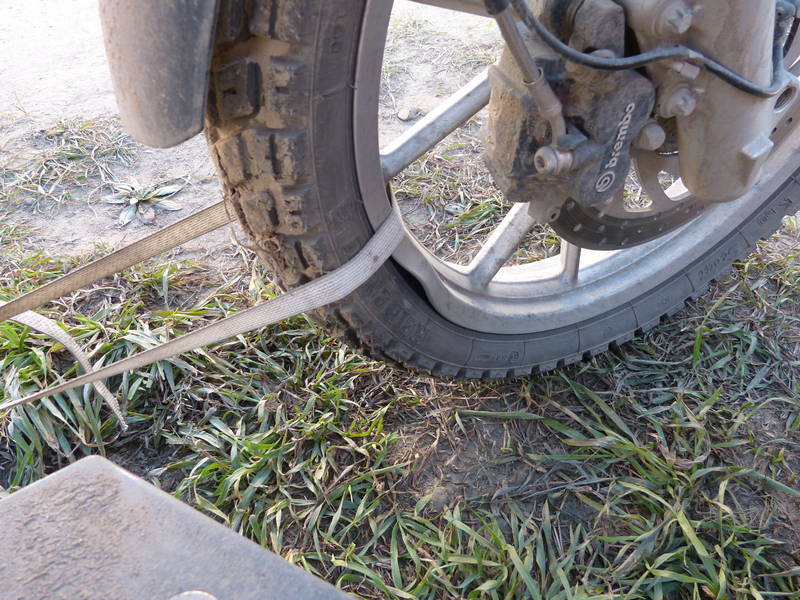
Thursday was simply a waiting game as we e-mailed back and forth with Vait to see if his foreman was able to contact the wheel repair shop. The waiting was certainly not easy as we needed to leave on Friday in order to be at the border with China by Sunday evening, 670 kilometres away. We rationalised that if the wheels could be repaired on Friday we could leave very early on Saturday and, if necessary, arrive at the border on Monday morning. Hopefully the roads wouldn't be too bad going south. As the hours ticked by we became increasingly more nervous. I contacted my brother, Onno, and asked him to see if he could order a new set of wheels for the F650 to have delivered to Japan and at the same time set up a long overdue service for our motorcycles at a Japanese BMW dealership. The ferry to Korea from Shanghai was being set up by the Chinese tour company so I contacted a Korean company to arrange the trip from Busan in South Korea to Japan. At $558 for both us and the bikes on a 19 hour boat ride to Osaka it looked like a pretty good deal. Eventually at 5:00 PM we gave up waiting for Vait and asked Kurt to help us install the tubes. We tackled the rear tire first. It was tricky getting the tube in with the stiff sidewall of the tubeless tire but we eventually managed it. Just in time to take a Wiener schnitzel break for supper with a piece of delicious peach cake for dessert. The front tire was even more difficult as it was almost impossible to lever the tire far enough away from the rim to stuff the tube inside. Kurt suffered some bleeding knuckles but eventually that wheel was also good to go. A test ride would have to wait until morning. Only after the test ride could we determine if it was safe to ride the bike to China or if we would need to arrange a truck or train to get the F650 to the border from where it could ride in the guide's pickup truck.
Some of the vehicles at the Oasis
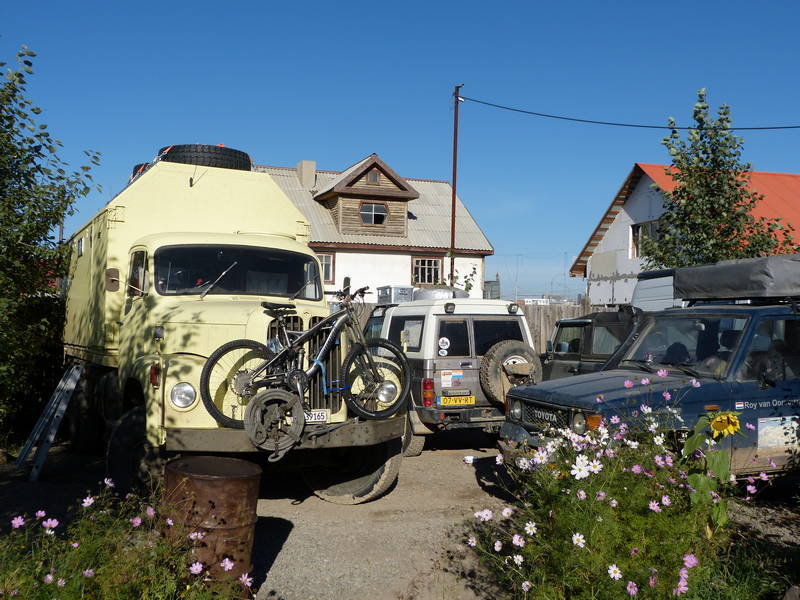
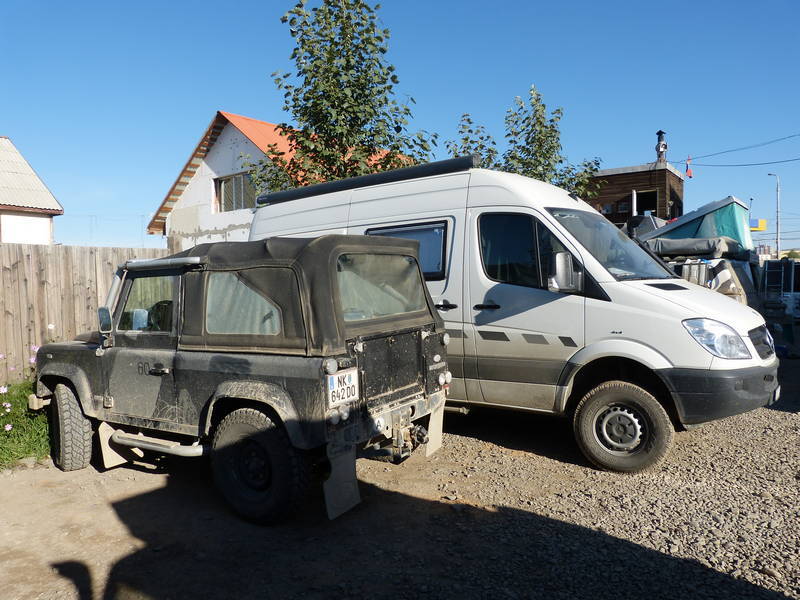
Karsten's Toyota
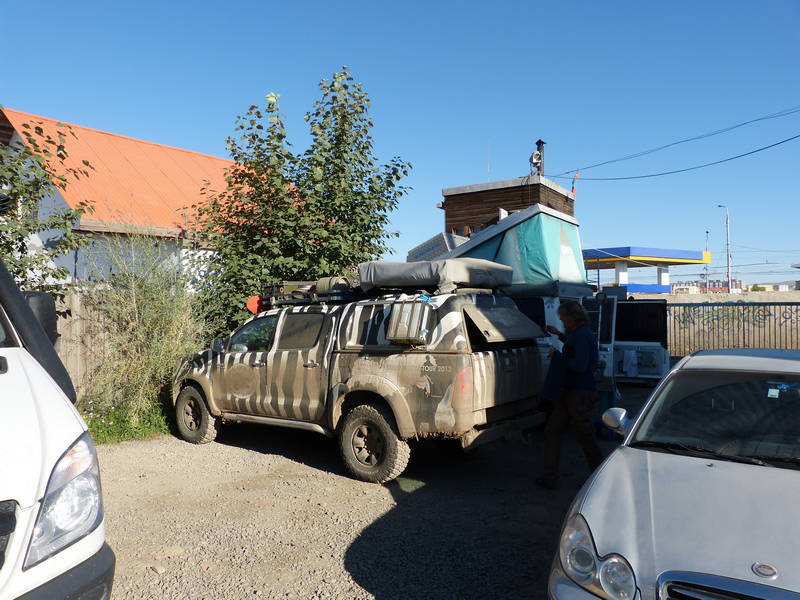
Kurt's KTM


Using the sidestand to break the bead really works
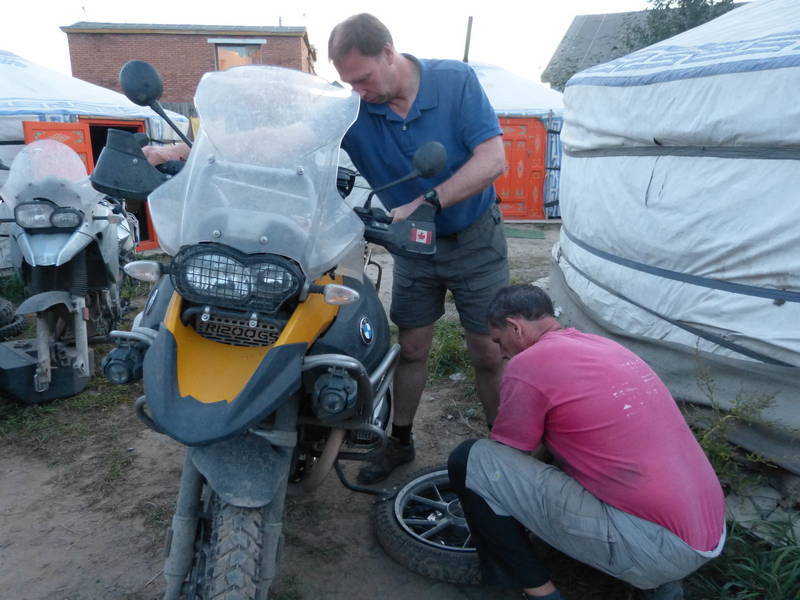
Tough getting that tube in

Friday morning I installed the wheels and checked the tire pressures. It all seemed to be good so I went out of the gate and rode out towards the edge of the city. A smooth, traffic free, section allowed me to get up to 80 kilometres per hour and I felt no vibrations or strange wobbles. The advantage of the cast wheels was apparent; while dented they were still running true. Back at the ger we packed everything up and then had Kaiserschmarn for breakfast. An e-mail from Paul at China Overland indicated that there are no combined passenger-vehicle ferries from Shanghai to South Korea. The bikes would have to go by cargo ship, taking three or four days, while we would have to fly. That would certainly impact our plans as it would leave very little time for actually riding in South Korea before heading to Japan to meet Onno. Putting that aside we finally rode out of the Oasis at Noon, pausing at the enormous pothole that had destroyed the wheels for a photo. Further along we were stopped at a police checkpoint, where we were a little nervous as we had not been able to purchase vehicle insurance for Mongolia. However, simply showing the International Driving Permit and a big smile was enough and soon were on our way again. We checked the tire temperatures and pressures regularly but everything was perfectly normal. 30 kilometres from Ulaanbaatar the road smoothed out and the traffic faded away, perfect riding with the wide open steppe before us. It was certainly difficult keeping the speed down in order to minimise the heat buildup in the tires. After 200 kilometres of this perfect riding we came to the town of Choir and south of town ran into road construction. We rode alongside the new road and on it when we could. Some of the sandy bits were a bit tricky. At a little after 5:00 PM we saw a tent with two bicycles off to the side but no people around. We contemplated for a moment to go over and set up our tent there as well but thought that we really should try to get as far as possible before dark in case the road to the border got more difficult. An hour later, where a maze of dirt tracks spread quite wide, we pitched our tent and cooked up tortellini for supper.
Checking out the pothole on the way out of Ulaanbaatar

Perfect road south running beside the Trans-Mongolian Railway
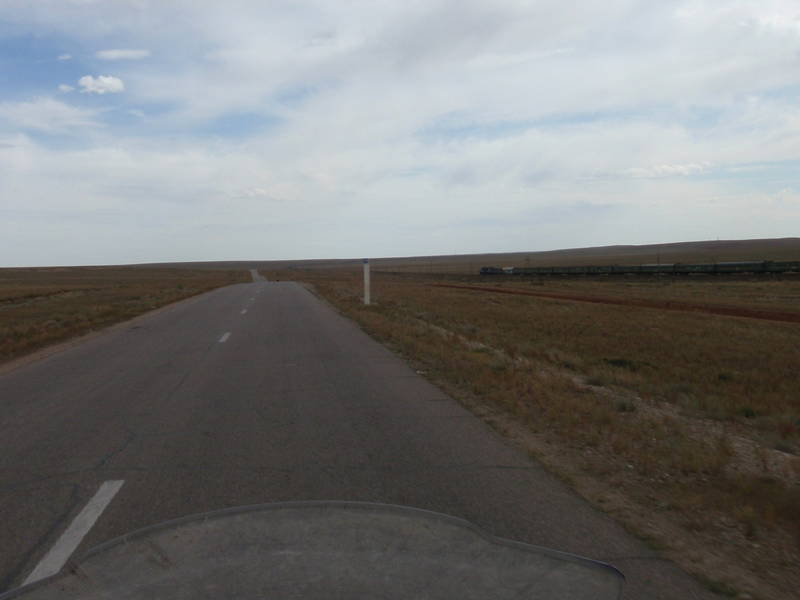
Camels!

The pavement ends south of Choir

Sand, lovely sand

Instant oats and coffee/tea for breakfast on Saturday morning and soon we were riding along sandy tracks again. We tried to ride on the road under construction as much as possible as it was quite well graded and firm but getting on and off the road was time consuming. Who knew that there were so many culverts in a highway? I suppose as a transportation engineer I should. In any case, our average speed was only 15 kilometres per hour, including time spent in a railway village looking for water. By 2:30 we had gone 100 kilometres. What I found interesting about the road construction was that everything was at the same stage. The entire length of almost 200 kilometres had a prepared subgrade and they were installing culverts. As a project manager I would have thought that doing small sections in various stages would be more efficient for the labour force as well as getting sections of the road into service sooner. In any case, 30 kilometres outside of Sainshand perfect pavement presented itself to us and after the ritual kiss of the pavement we zoomed south. At a gas station on the brand new bypass road for Sainshand we asked how much further the pavement would last and were pleasantly surprised to hear that it went on for another 80 kilometres. After 75 kilometres of easy riding the sun was getting low so we pulled off the highway and onto the steppe in the middle of nowhere. The Ramen noodles that we had picked up at the gas station made for a tasty supper. Here we were in the middle of the Gobi desert. It was very quiet and very alone. Audrey's imagination went into overdrive when she discovered that there was a fresh hole dug beside her motorcycle. It looked to be about the right size for the infamous Mongolian Death Worm. Audrey retreated to the relative safety of the tent (how is it that a millimetre-thick piece of nylon makes one feel safer?) while I stayed up and watched the stars come out. Without any lights nearby it made for spectacular star gazing.
Morning view from the tent


Yes, we've ridden our motorbikes to a land of camels
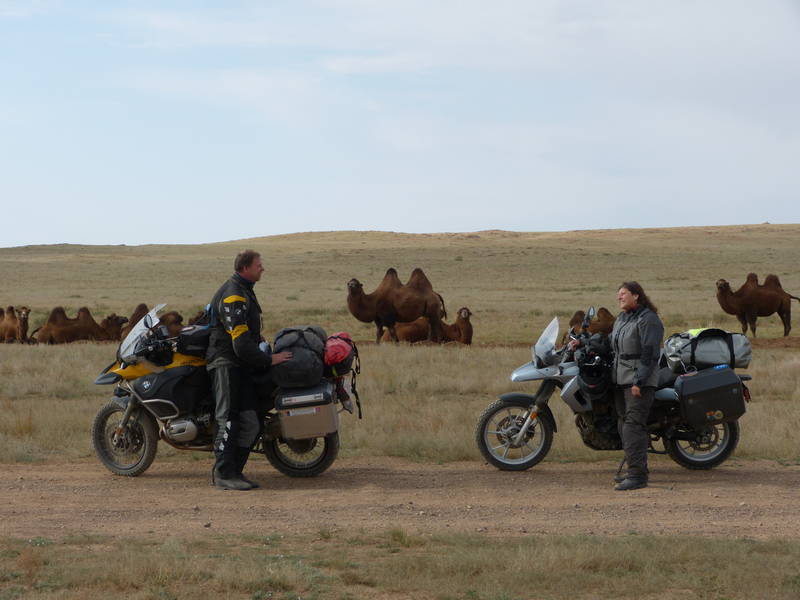

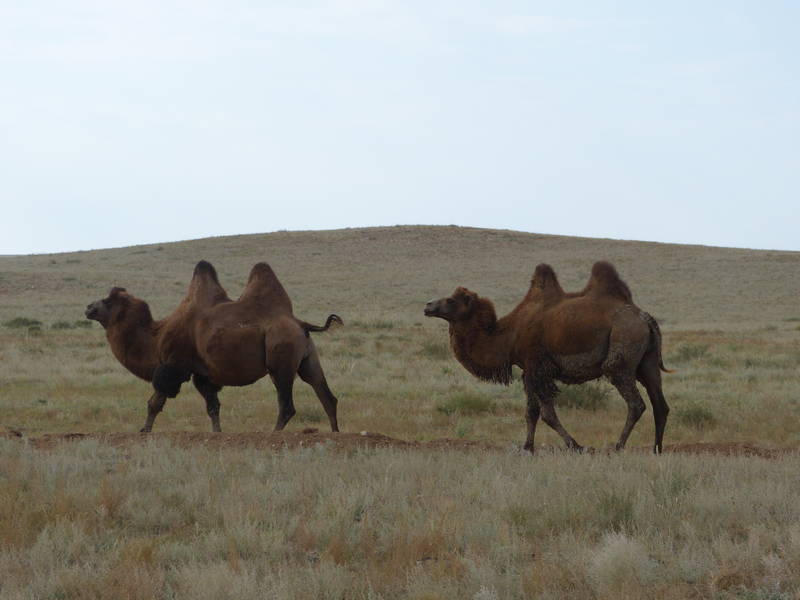
Finding a well at a railway town for much needed water
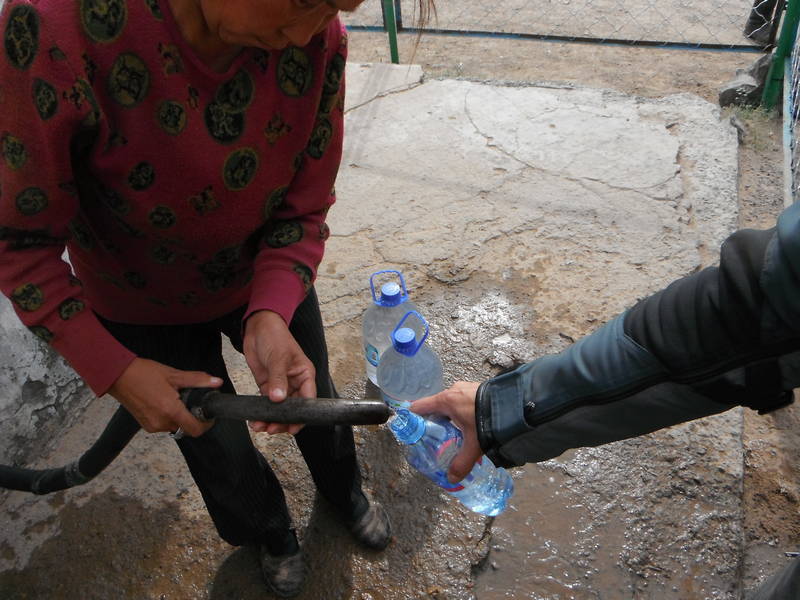
Still a long ways to go if this sand continues (Zamin Uud is at the border)
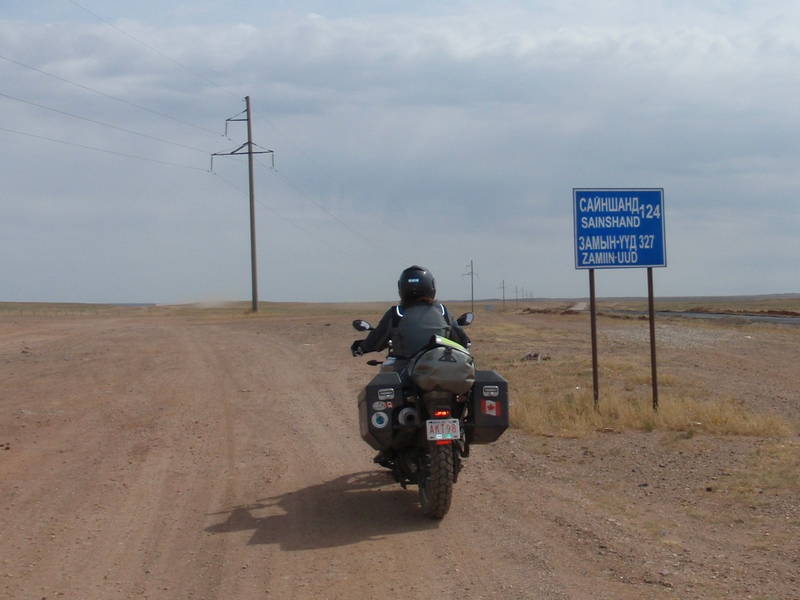
Ekke likes pavement. A lot.
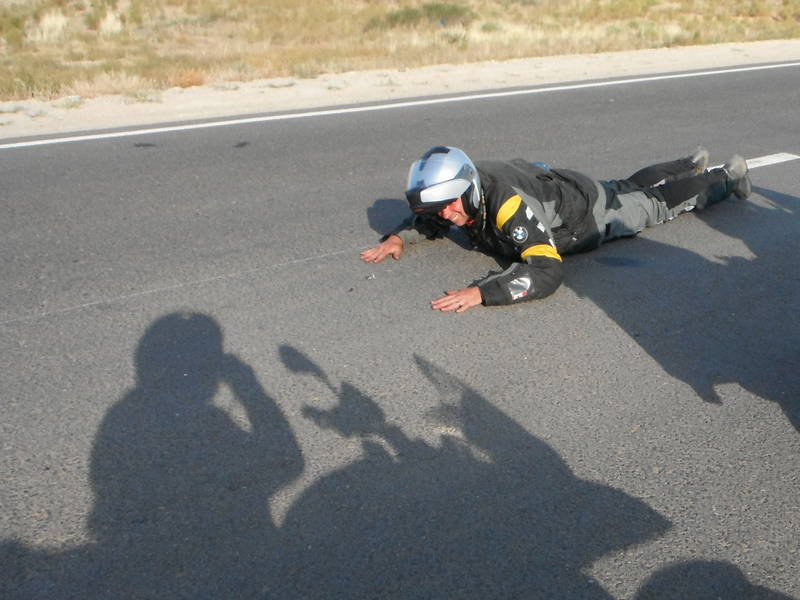
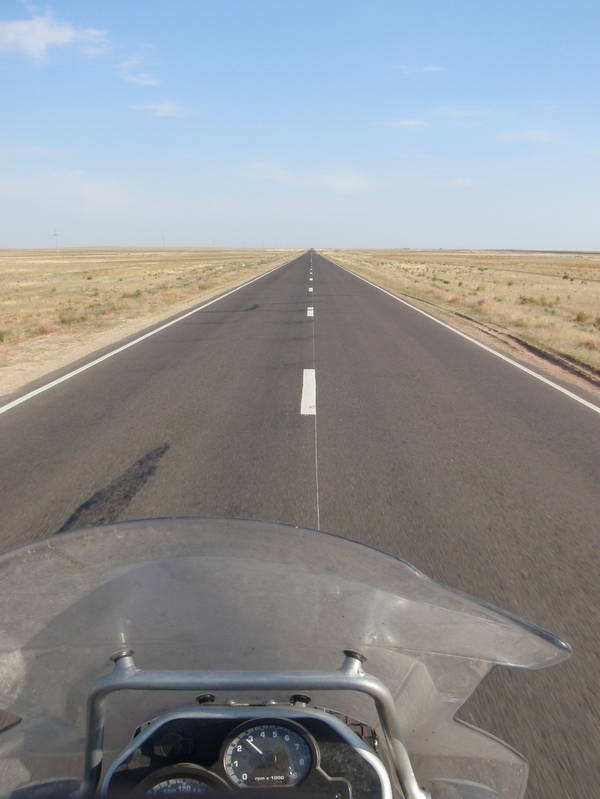
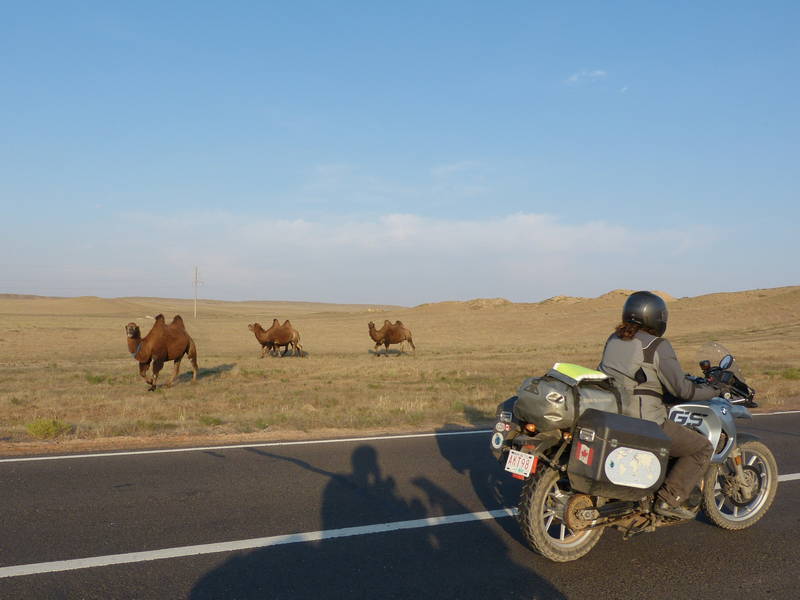

Cooking dinner as the sun sets

We knew that we only had five kilometres of pavement left when we got up on Sunday morning and if we had to ride in very much sand it would be a long, tiring ride of 140 kilometres to the border at Zamyn Uud. Sure enough after 5 kilometres the pavement ended and after a short detour of deep sand we had a decent gravel road with only a few interruptions for piles of dirt. The trucks weren't using the gravel road so presumably these piles of dirt were put there to discourage them. This lasted about 80 kilometres during which time we saw a few herds of camels. We still found it amazing that we could have ridden our bikes to somewhere where double-humped camels roamed wild and free. Then the fun ended. Dirt tracks meandered, seemingly aimlessly, across the desert punctuated by sections of deep sand. The last 30 kilometres were difficult as the sand became more frequent and we were becoming more and more tired. We stopped every few kilometres to take a breather and eventually made it to Zamyn Uud before dark where a long line of trucks outside of town suggested that the border might be nearby. After stopping at a small grocery store for liquid refreshment we headed to a hotel situated above a Topnnk Bank on the main road to the border. The town itself had a real border town atmosphere to it, noisy and brash, so we were quite pleased when the desk clerk guided us to underground, secure parking for the motorcycles. After dinner in the hotel restaurant we walked around town and it was clear that the main focus of attention was the railway, with people getting on and off the Trans-Mongolian train. Perhaps the trucks on the outskirts of town were actually waiting to load their cargo onto the train. That would make a lot of sense considering the atrocious condition of the road north and so these dilapidated trucks were only used to ferry goods across the border between trains.
Horses come to investigate the little orange ger

While we check out the burrowing hole of the Mongolian Death Worm
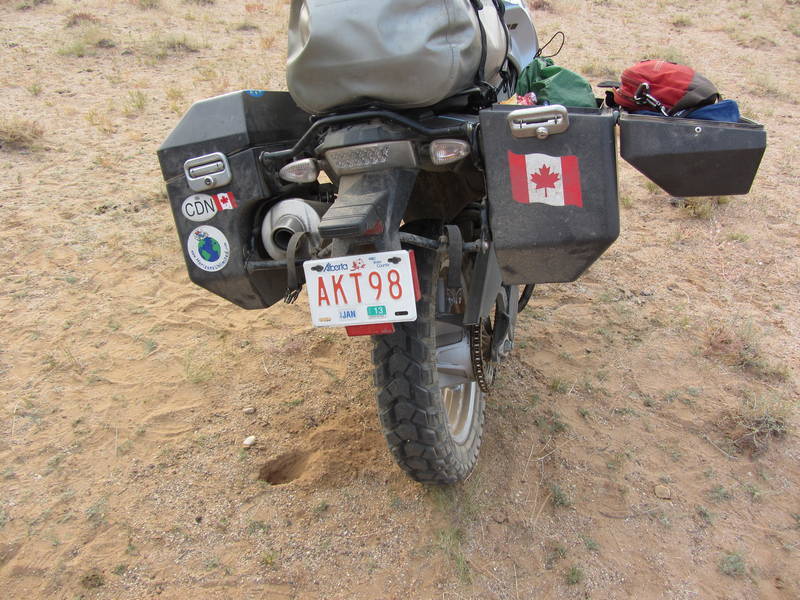
After 5 kilometres the pavement ends
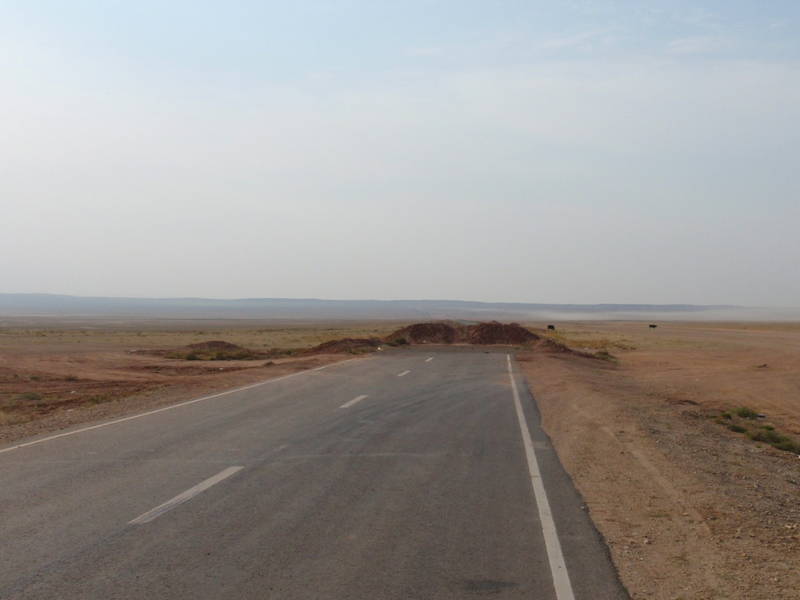

Lots of culverts

And sand

A box canyon where they haven't finished digging the road was a challenge to climb out of
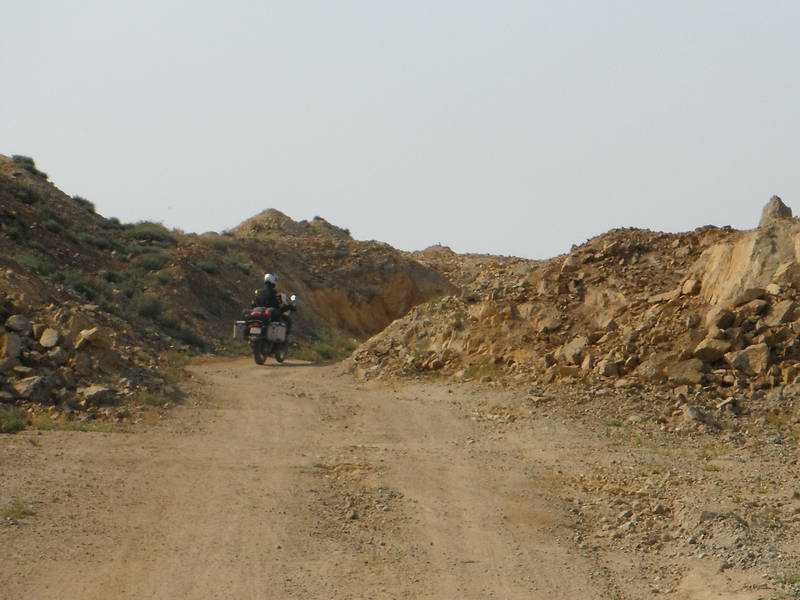
Camel crossing

Trucks trundle along a sandy path in the distance as they can't go on the gravel road
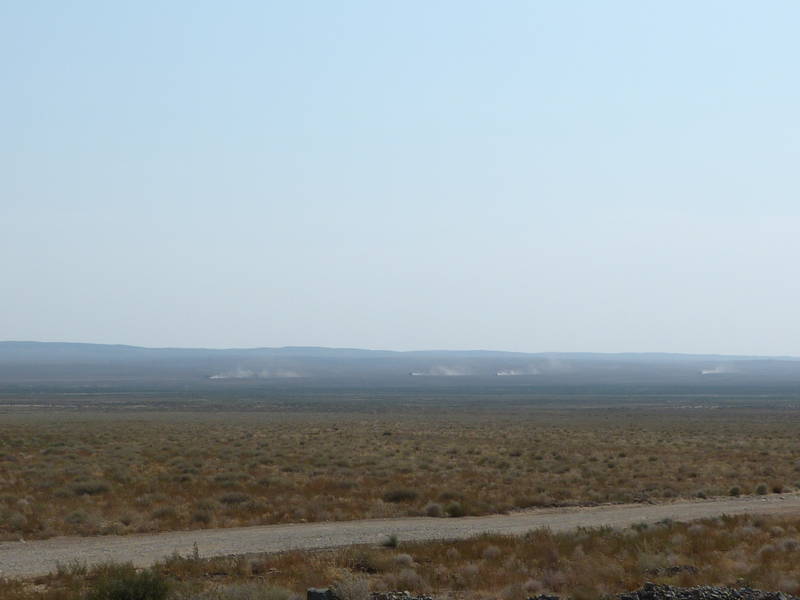
Dirt piles discourage trucks and slow our progress

Local herdsmen at a watering hole
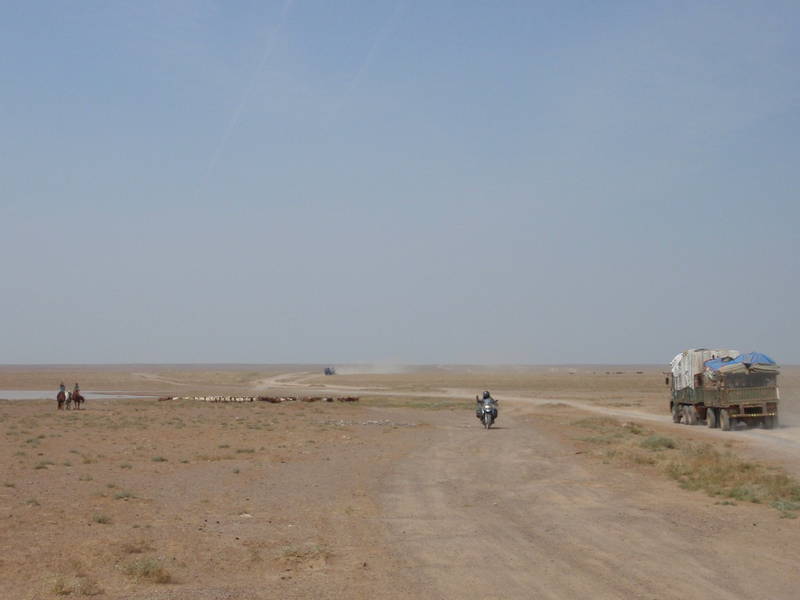
Which way?

Sand, sand
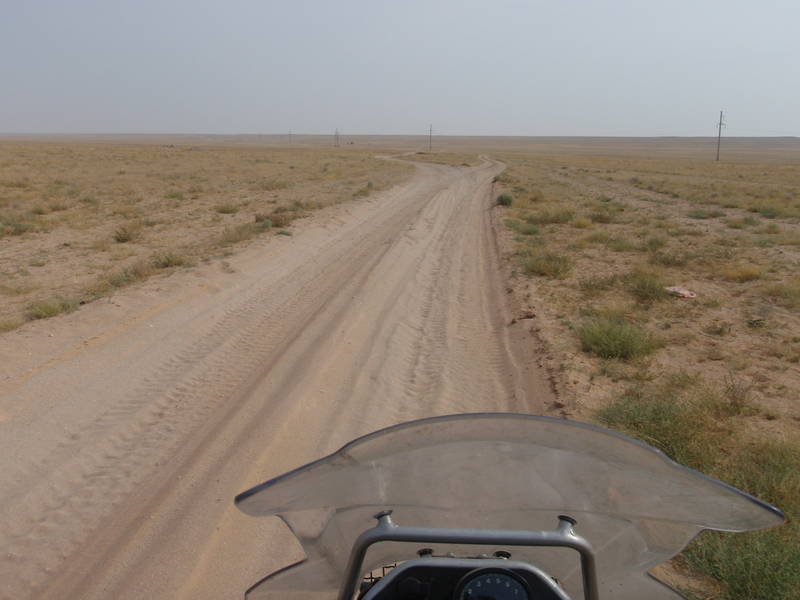
Exhausted
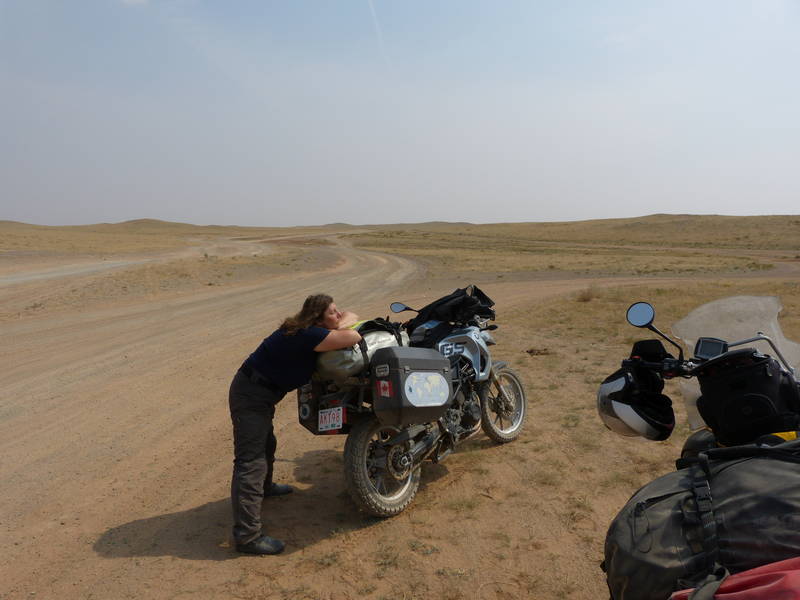
A long line of trucks outside Zamyn Uud with the highrises of Erlynhot in the distance
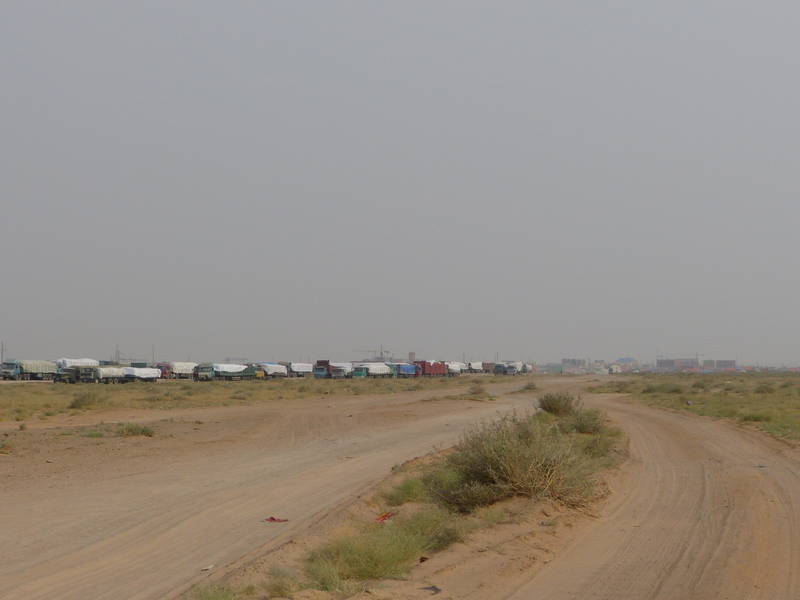
A hotel above a bank has secure parking

We went to the bank downstairs when they first opened so that we could exchange our Tugriks for Yuan but they couldn't do the exchange. Instead we packed up and rode our bikes over to the train station where there were a lot of foreign exchange offices. While one person waited with the bikes in the square, the other went in to exchange the money. It was amazing to see how private property was regarded in a completely different manner here. We had encountered curiosity in the past but these people were much more aggressive, touching the bikes, fiddling with the controls and even jumping on them without so much as a hello. With all of our money converted to Yuan we rode a couple of kilometres out of town to the border. Similar to the northern border when we entered Mongolia, we were greeted by confusion. First we were told to wait in a specific spot, and then we were told to move the bikes somewhere else and wait by a table. Eventually a younger official was assigned to get us through the process but even he was confused. We walked all over the compound, following him, looking for someone special to put a specific stamp on a specific piece of paper. At one point another customs officer left her post and guided our guide to another building where we climbed some stairs to an office that was closed. We waited a while then went back to the line where our bikes were and got someone to stamp another piece of paper before returning to the second floor office. The woman was back from her break and was able to create the export documents that we needed to enter China. Paul at China Overland had sent a copy of a form and given the exact information that needed to be entered on the form so that it matched the Chinese importation documents. The Chinese temporary importation process had been started in June so it was important that all the papers matched. With all the correct stamps in place we bid adieu to our customs officer and rode across no-man's land to the Chinese side. We were waved past a line of jeeps that were shuttling people across the border (no pedestrians are allowed to cross) and went to the front of the line. Standing on the steps of a building someone waved to us. It must be Frank, our English-speaking guide from China Overland. After the military officer waved us in we went straight to Frank and started the China side of the border processes. The first thing Frank wanted to see was the import/export form filled out by Mongolian customs. While the document for my bike was correct, the F650 form had the displacement where the weight should be. When Frank called the customs specialist who would be working our bikes through the border he was told that no mistakes were allowed on the form. So, we took it all back and returned to Mongolian customs. We parked the bikes, ignoring the waves and calls from the customs officials and went straight upstairs to the woman who had completed the form. She corrected her mistake, printed out new forms and then grabbed someone to sprint over to another office for a stamp. Now the form was ready for us to take to China. Back on the bikes, we cut across to the other side of the compound, finagled our way past the final guard who had taken our last piece of stamped paper an hour earlier and then back to China. This time for good.
Good morning Zamyn Uud!
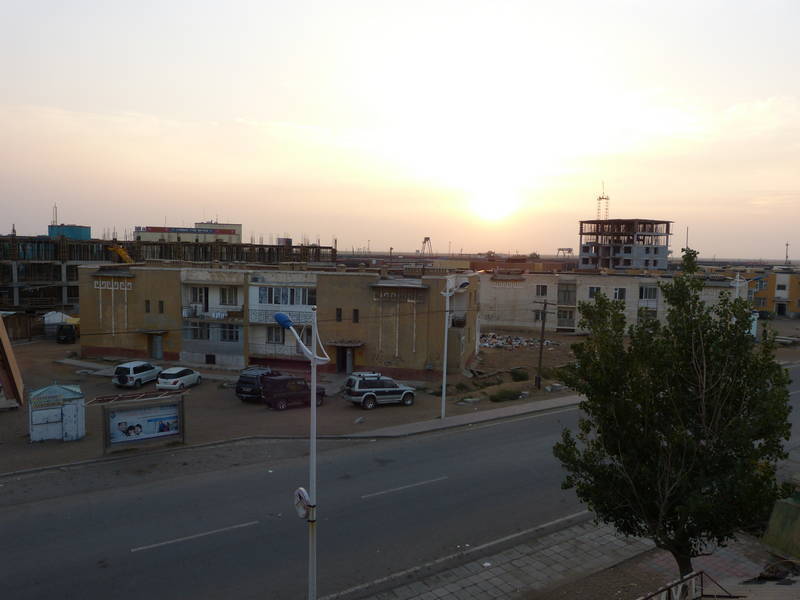
Curious locals
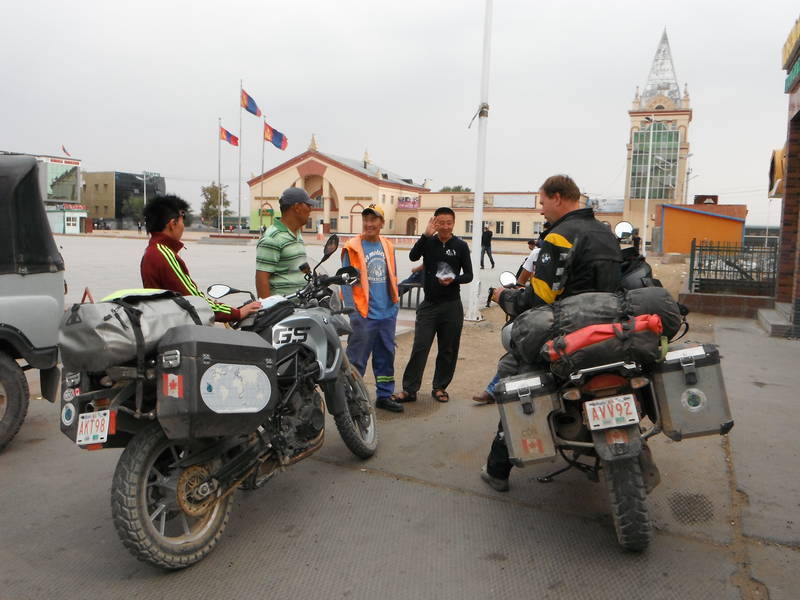
Map of our route through Mongolia

Riding through no-man's land for the second time, on Monday, September 10, we rode straight to the front of the line of jeeps and waited for the military guard to wave us in. In a matter of moments we were back in the building with Frank, our English-speaking guide, going over the importation papers. This time they looked good so now we were able to start the process. For us it was incredibly easy. A simple form, in English, needed to be filled in and then presented to the passport control officers. They were really easy-going and we were stamped into China in a matter of moments. Back to the motorcycles and this time it would be a bit more time consuming to get them imported. A specialist, brought in by China Overland, took care of the entire process. While we waited by the bikes it started to rain and a customs official came out and suggested we wait in the passport control building until the procedure was completed. Very nice! After about 20 minutes we were called back to the bikes to show the customs officials where the engine serial numbers are located on the two bikes. We had no problem finding the VIN but the engine numbers were tricky. We had been asked for these numbers when starting the process back in June and we had asked the mechanics at Motorrad Zierer to look them up and then we simply forwarded the numbers to China Overland to prepare the permits. We had never actually seen where the numbers were inscribed. So we searched high and low on our filthy motorcycles to no avail. Eventually it was decided that we could go, with the admonition to not sell the engine and install a Chinese motorcycle engine when we left China. OK. We met up with Geordie in his Griswold pickup truck (At least that's what the name of the truck sounded like when we asked) which we would be following for the next three weeks. Riding away from the border, behind Geordie and Frank, we were struck immediately by how perfect the roads were and how clean everything was. What an incredible contrast to Mongolia. This border crossing was as much of a contrast between countries as the one we experienced going from Sudan to Ethiopia. At a clean, comfortable hotel we paid for two rooms (one for ourselves and a second room for the driver and guide) at a cost of 128 yuan per room (about $20). After getting settled we then dropped the bikes off at a customs lot so that the Chinese traffic police could do their inspection and issue the road permits the next day. We jumped into the back seat of Geordie's pickup truck and went to a nearby restaurant specialising in northeast Chinese dishes where for some reason we ordered enough food to feed an army. The chicken stew came with the chicken's feet still in it but overall the food was delicious and hopefully a good sign of the culinary delights to come. Back at the hotel I sat outside for a while doing the SPOT tracker and simply watched the street life. It struck me how incredibly quiet it was. A lot of the traffic was modern cars which were very quiet and electric scooters which made almost no sound at all. There was certainly a lot less honking than in Ulaanbaatar.
Chinese customs officer poses with the BMW R1200GS Adventure

Clean, quiet streets. Can't understand a single character on the signs of the building across the street.
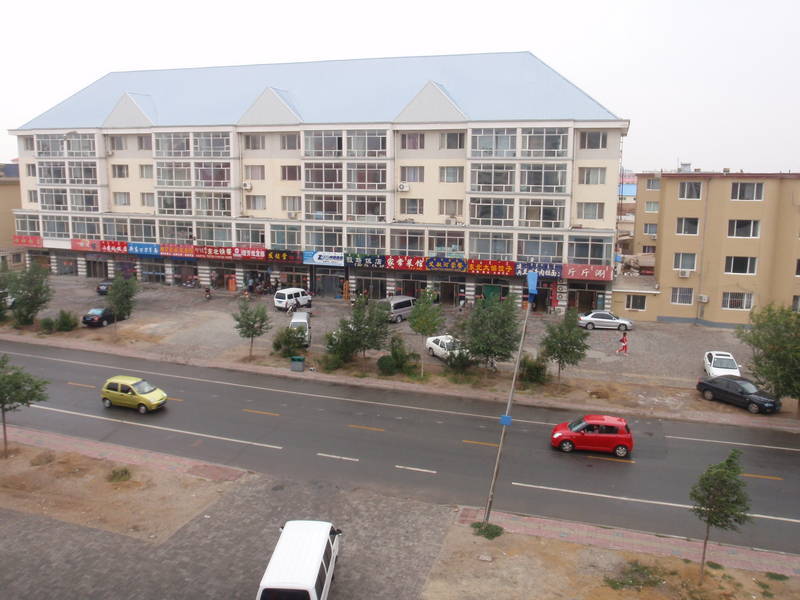
Yummy, chicken stew

Our first full day in China started with going across the street for a breakfast of pastries and boiled eggs. We received the news that the bikes had been cleared by the traffic police so were able to pick them up and then we headed to a car wash to hose them down, the first wash since Germany. It was getting on to lunch time after all of this and we went in search of a restaurant, ending up at Mastruchka, a Russian/Western place. I was certain we would encounter lots of real Chinese food in the coming weeks so it wasn't too bad having spaghetti for lunch. On the way out of town we stopped at a gas station and we were a bit confused. We were directed to the side of the station, away from the pumps and told to use cans to fill the bikes. The cans held 10.5 litres and since we thought we needed about 30 litres we had to go back and forth three times but we didn't want to buy too much fuel and have left over either. It turned out that we needed more than the 31.5 that we bought and as a result only one bike was topped up and the second bike could have taken another litre or two. The Adventure is a very tall motorcycle when on the centre stand so it was difficult to hold the can high enough to pour and not spill any gasoline on the hot engine. Through Frank we learned that this is the way the small Chinese motorcycles are filled because it is too dangerous to fill them at the pump. We of course saw the system as not only time consuming and awkward but also as much more dangerous than simply using the pump. What was also interesting was a comment made by Frank when we suggested that we could simply override the staff and fill the bikes at the pump. He said that the video monitoring would record our bikes and then China Overland would be fined for breaking the rules. We found it odd that video recording would be used to enforce an arbitrary rule and then fine the company but perhaps that is how a police state works. As we rode south, out of Erlynhot, in a cold, light rain with a serious cross wind we noticed a few dinosaur statues. And then more and more. They were everywhere. Apparently Erlynhot was trying to get into the book of records for the most dinosaur statues in the world. After a 300 kilometre ride through a cold, wet Gobi desert we arrived in Jining just after dark at 7:00 PM and went to a four star hotel. We weren't allowed to park the motorcycles near the entrance of the hotel but had to park them with all the tiny little scooters at the far end of the parking lot. Inside we had to ask ourselves in what universe this was a four star hotel. An open drain in the middle of the bathroom floor, filthy carpets and peeling wallpaper certainly didn't meet our expectations for a four star hotel. Then again the 234 yuan per room (468 for two rooms was about $74) wasn't a four star price either though having to pay for two rooms and meals for four people could add up. Over a delicious hot pot dinner (a pot was kept simmering in the middle of the table and we cooked our own food in it, almost like a fondue) at a nearby restaurant we decided that since a cargo ship would take so much time to get our bikes to South Korea we wouldn't have any time to ride them there so we might as well ship them straight to Japan. Frank would contact the China Overland head office and start making the necessary arrangements the next day.
Using 10.5 litre jugs to fill the bikes
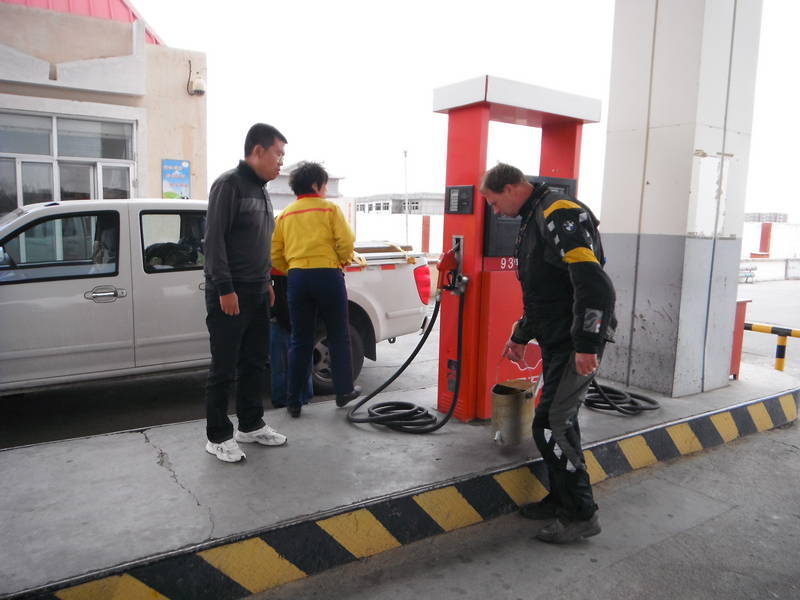
Wind farms and dinosaur statues, that's Erlynhot

Welcome to Erlynhot, China

Out of the rain, riding south
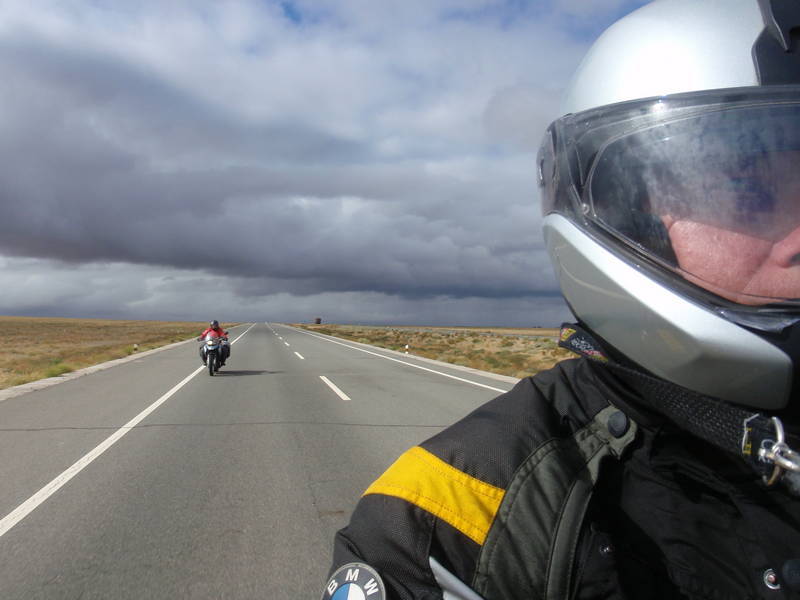
Hot pot dinner in Jining
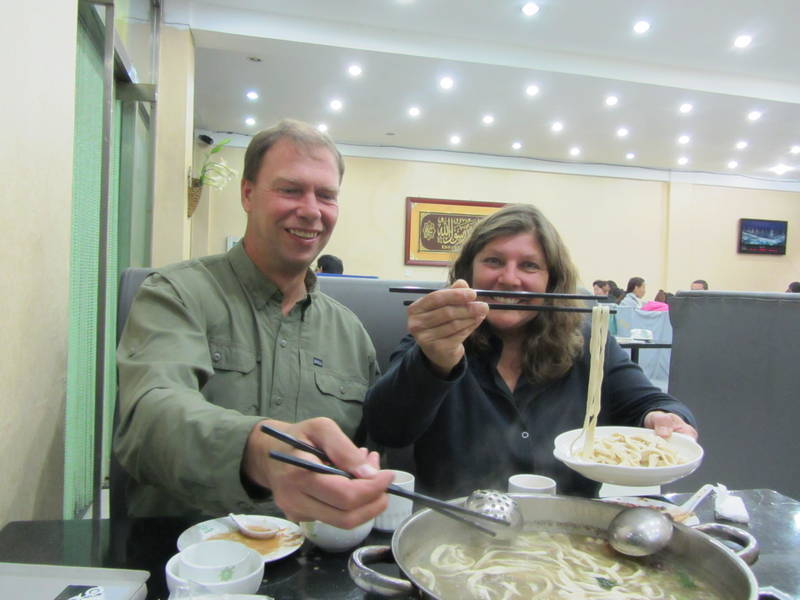
Wednesday was a complete contrast to Monday's entry into China and Tuesday's ride to Jining. We were now in a part of China with a lot of coal mines and coal fired power plants. Huge trucks with loads of coal ran every which way and everything was very dusty. Soon we were covered in black coal dust and I'm sure breathing the stuff wasn't terribly good for our health. Passing trucks made for very interesting riding but even more interesting was that the national highway was under construction. Our driver, Geordie, decided that it was more expedient to drive on the unfinished portion of the road rather than share the old road with the trucks. This meant that we had to climb and go around various obstructions as well as avoid other drivers doing the same thing. Even on the main road sometimes the traffic would peter out and then all of a sudden the road was blocked for construction. The traffic that had to go through, diverted to the adjacent expressway and local traffic simply found their way around the obstruction. Since motorcycles weren't allowed on the expressway we were forced to find our way around the obstructions somehow. It made sense that the small Chinese motorcycles couldn't use the expressway but our large motorcycles would be more than capable of maintaining 110 kph so it made no sense to us that we had go through active construction sites rather than detour on the expressway. When we suggested trying the expressway and pleading our case with the toll booth attendant both Geordie and Frank were very firm that we would not do that. Perhaps China Overland could get into trouble when foreign vehicles broke the rules and they didn't want to risk that. Riding along the national highway we came upon a queue of trucks going the other direction, stopped for no apparent reason. Five kilometres further, our side of the road also ground to a halt. There we were, all parked on the highway at a widening in the road with trucks pointing every which way. When Frank asked a truck driver what was going on he was told that the trucks had been instructed to leave the expressway and now the national highway was simply jam packed with trucks. The volume was simply too much for the single lane of traffic and we had stopped at a toll booth (there were tolls on the national highway too but motorcycles could simply go around and didn't have to pay). When I walked forward a few hundred metres I found the source of the problem. The toll booth was not operational and all the gates were open. The trucks going the opposite direction from us (the ones that were diverted from the expressway) were clogging all the lanes in their direction and ours. Our side was stopped because the trucks going the opposite direction were blocking our route. Crazy. The trucks jostled for position whenever there was an opportunity to move ahead a couple of metres and some drivers had used a break in traffic to go into the opposing lanes and were now stuck there. Gridlocked, no one moved. After a half hour of this Audrey decided that we should fix the problem. We rode our motorcycles around the parked trucks and squeezed through the toll lane to the other side and then parked in front of a truck so that it could not enter our lane. Then, as the trucks inched forward, the gap in our lane wasn't immediately filled by another truck going the wrong way. Eventually our lane cleared and vehicles started to come through in the correct direction so we rode ahead and cleared the shoulder of opposing vehicles in order for our pickup truck to get through. A little while later, we were riding through a coal dust-choked city, when we came to a railway crossing. The gate arm had just gone down and we were third or fourth in line in our lane. As time passed, vehicles started lining up beside us in the opposing lane as well as the shoulder on our side. Small motorcycles used the opposing side's shoulder. When the train cleared we could see that the same thing had happened on the other side and when the gate arms opened traffic was standing four abreast facing each other. Soon everyone scrambled for position and it took a while to get all sorted out. It appeared to us that Chinese traffic abhorred a vacuum so filled every possible space. The resulting chaos seemed to sort itself out eventually as the jostling was perfectly normal and no one seemed to get upset when one driver got ahead of another. It certainly explained how the queue of trucks had formed at the toll plaza and the horror stories we had heard of 50 kilometre long queues of trucks. As travellers we are accustomed to trying to adapt to every new country's driving style but it looked like China was going to be a challenge. As the dusty day descended into dusk we came upon a perfect road, lined by lovely vegetation and with very few trucks. As we found out later, we had entered the county of Beijing where everything is beautifully well kept as the nation's capital. Then a few kilometres later, riding a lovely curvy road in the mountains we could make out a wall perched on a hilltop. Spotlights were lighting the wall and it made for a fantastic sight. The Great Wall of China. Unbelievable. We had actually ridden our motorcycles all the way from Germany to the Great Wall of China. Our hotel for the evening was at the base of the wall at Juyongguan Pass. While it was relatively new it had been built in the traditional style and was simply beautiful as it was bookended by the inner and outer gates of the Great Wall. We had to pinch ourselves to confirm that we weren't dreaming. How could it be that we had ridden our bikes here? At dinner in the hotel that evening a company party was in full swing. It looked like the Japanese head of a branch of Nikon was visiting and all the Chinese workers were being appreciated for their hard work. A translator was at the Japanese person's side the whole time translating the Chinese into English for him to understand. By 8:00 PM the place had cleared out and we also went to our room.
The other side of the highway hasn't been finished yet so we ride the "wrong way" on the finished portion
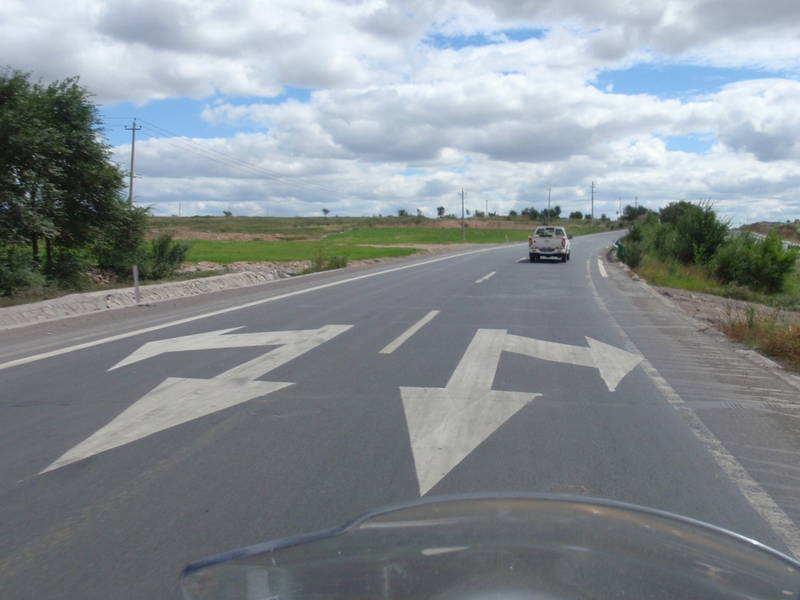
Everywhere in China apartments are being constructed at a furious pace

A queue of trucks about 5 kilometres long

Ends up with us in gridlock
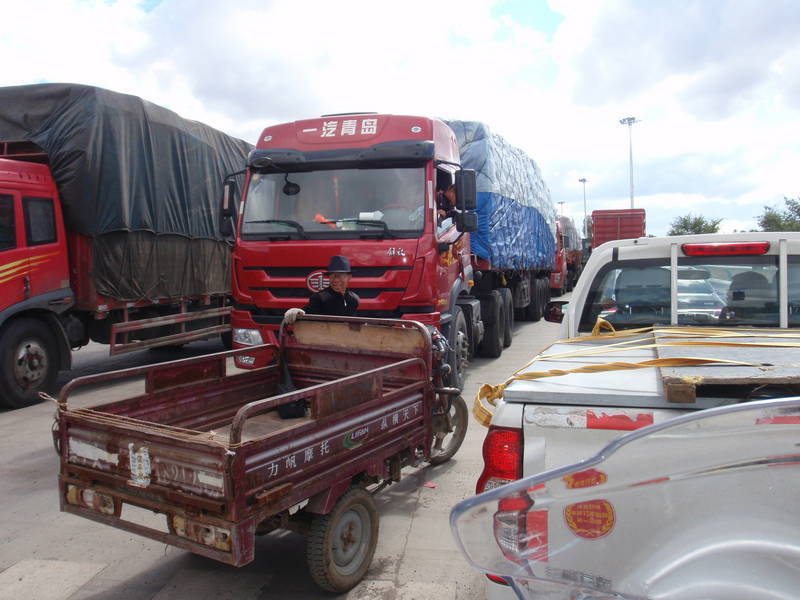
The ubiquitous three wheelers are used to haul everything from corn stalks to coal
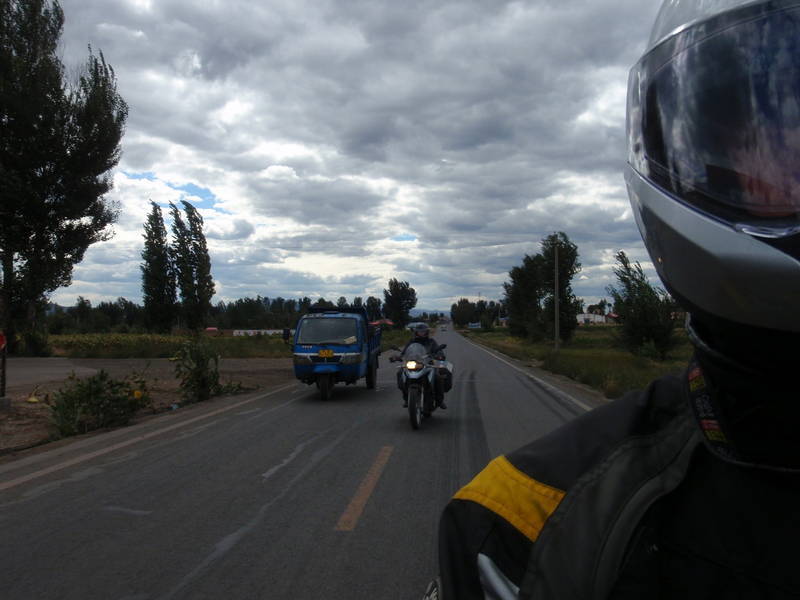
Our road twists underneath the expressway above
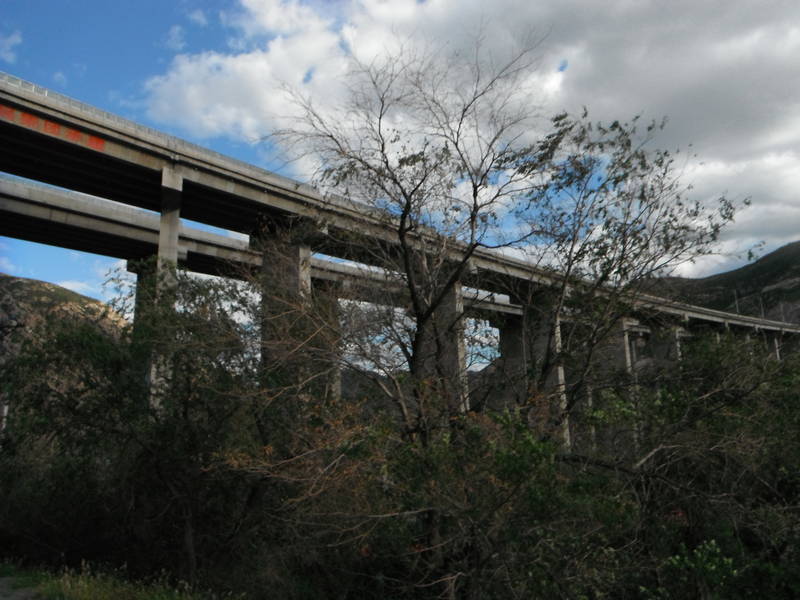
The Great Wall of China!

Thursday morning dawned bright and sunny; it looked like it would be a perfect day for a walk along The Great Wall of China. After breakfast Frank walked with us from the hotel to the base of the wall and when he wished us well he indicated that he had never made it all the way to the top. The bar was set and with that we set off. The climb started out quite steeply, with tall steps and it was very crowded. Even at this tourist site where there were more non-Asians than anywhere else we had been in China we were still being stopped and asked to pose for photos. One man simply grabbed me by the arm and dragged me over for a photo without so much as a "Nihâo". We were having fun with it but I could imagine that being a celebrity would get tiring. Using all of our training from climbing Kilimanjaro (thanks Stanley!) we went up "polé, polé", nice and slowly. Still we made steady progress and the crowds started to thin out. After a couple of watchtowers we shared the wall with only a handful of people bringing to mind a Wesley Crusher quote from Star Trek, "The higher the fewer." At the final tower we congratulated ourselves, enjoyed the view and then wondered if we could get back to the hotel from the other direction. The gates in the Great Wall are always doubled up for security. We had ascended the wall from the inner gate (closest to Beijing) and now we were wondering if we could go down to the outer gate. Thinking that there wasn't too much to lose except for time (and risking getting a bit of extra exercise) we tried it. This side was really steep and soon we understood why most of the people climbed the wall where we started. Some of the steep steps were really tall and were a stretch even for me to get down. But get down we did, right by the outer gate. As the hotel was located between the two gates it was perfect and we were back well before Noon, in time to pack up for the short ride to Beijing. After gearing up we decided to pose for a few photos of us on our bikes with The Great Wall of China. What a monumental occasion, it still hadn't sunk in that we had ridden our motorcycles here. After the photo shoot we rode through a passage in the inner wall and then on to Beijing. Apparently in the capital region it was OK for motorcycles to be on the expressway and we made good time on the perfect pavement. A stop for fuel along the expressway brought another surprise; we were allowed to get fuel directly from the pump, not having to shuttle back forth with ten litre jugs and spilling fuel over the hot engine. We pulled up outside a hotel that had been pre-arranged by China Overland but Frank took a long time coming back out. Apparently they could not accommodate foreign guests (and China Overland forgot to mention this in the reservations?). Fortunately the Super 8 (!) around the corner did accept us but we would have to leave the bikes parked on the street. The Super 8 was a pleasant surprise, being newly renovated and sparkling clean. It may not have had as many stars as other hotels we had stayed at but it was so much nicer because the little things were OK. There was no open sewer drain in the middle of the bathroom and the bathroom itself wasn't moldy. We locked the bikes up, set the alarm on the F650 and threw the covers over them, hoping that they would be OK. Since we had arrived early in the afternoon (it really was a short ride from The Great Wall) we had time to walk over to the nearby Bird's Nest Stadium, going via KFC (!) for lunch. The stadium was quite beautiful but because the 2008 Olympics were held while we were on our last trip (just riding across Canada at the time) we didn't have any memories of it. Inside the stadium a rehearsal for a musical was in full swing. It was a lot of fun watching them until the bad guys showed up on small electric chopper motorcycles with bat wings. Why are the motorcyclists the bad guys? Anyway back at the hotel we offered to take Frank and Geordie supper but they declined and we headed out to Cindy's restaurant for a pizza. Service was incredibly slow and it took forever to get our food but it was nice to be on our own for a change. Returning to the Super 8 rather late I did a little hand wash laundry since we were going to be in Beijing for a couple of nights so it would have time to dry.
From the hotel you can see the crowds on the wall

Where the wall splits to form inner and outer gates on the other side of the pass
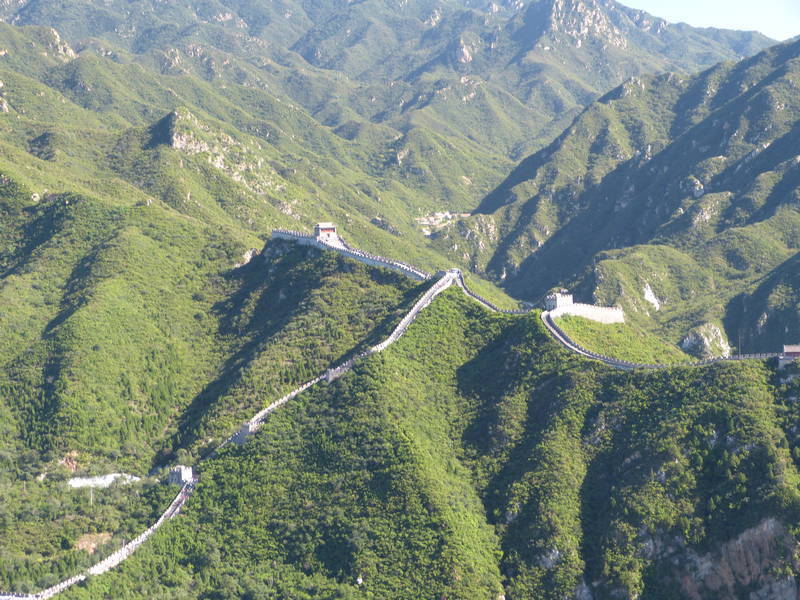
The higher the fewer

One of the watchtowers

Looking along the expressway to Beijing
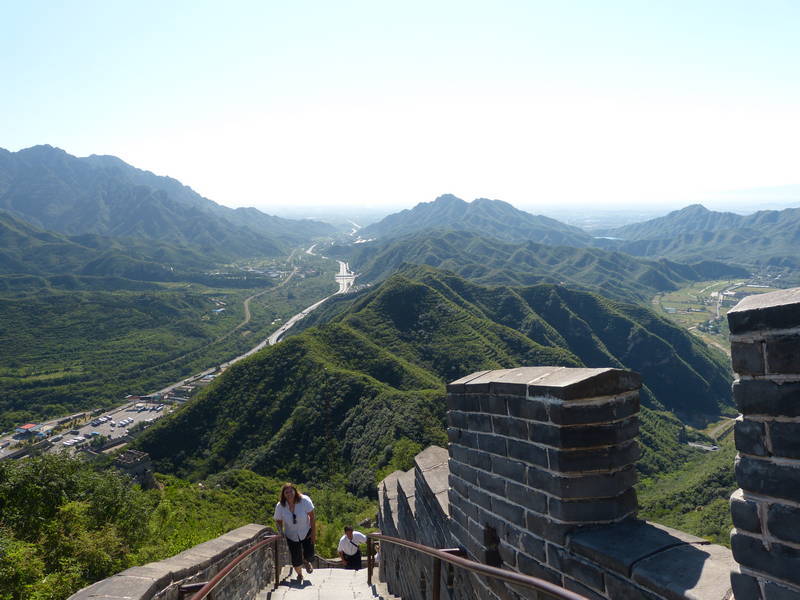
We made it!

Going down the other side was really steep with especially tall steps
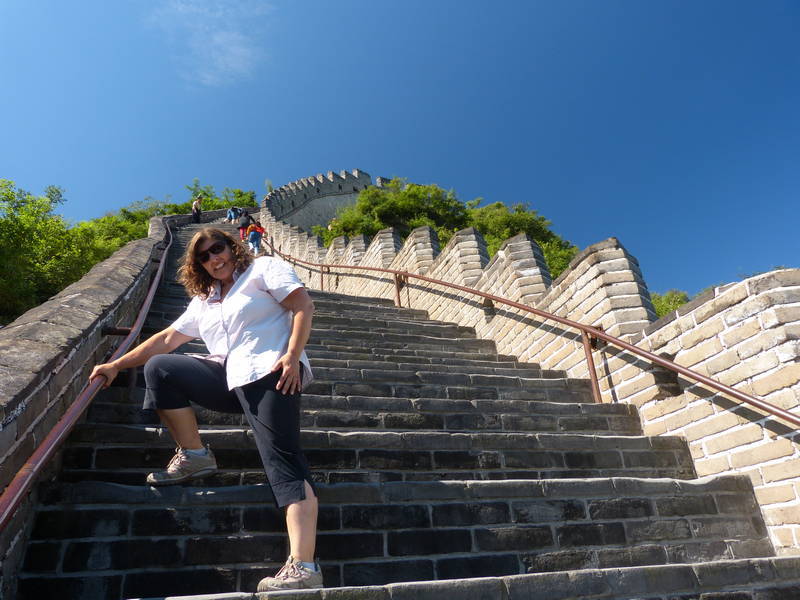
Nothing says, "Great Wall of China" like a Slinky
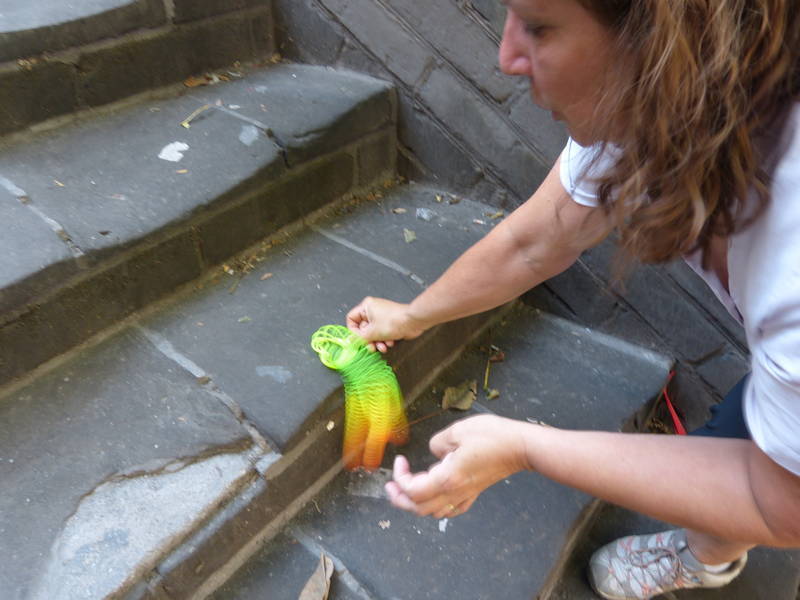
We have ridden our motorcycles to The Great Wall of China!


Too bad we have to follow the pickup truck, those lanes are made for splitting

"Smiling Beijing Traffic Police"
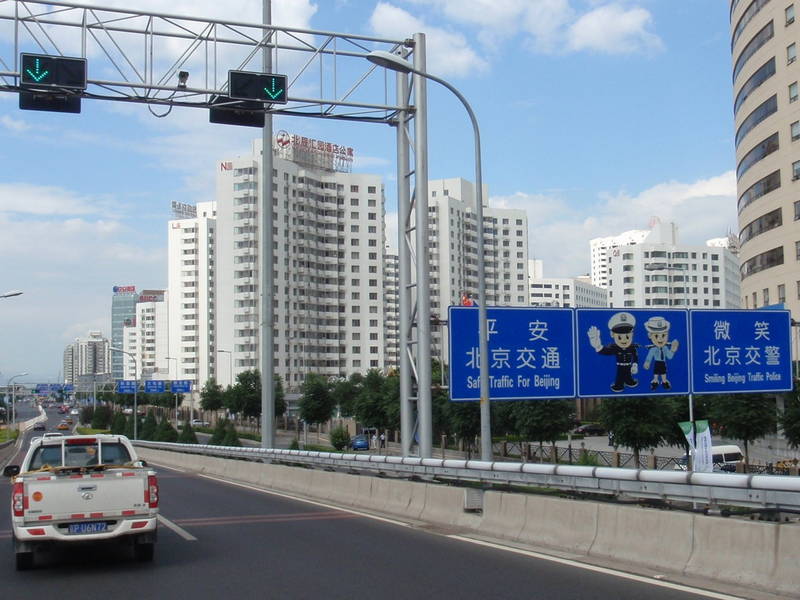
We saw a sign like this in Morocco ten years ago. We still don't know what it means. (Exploding cars not allowed?)
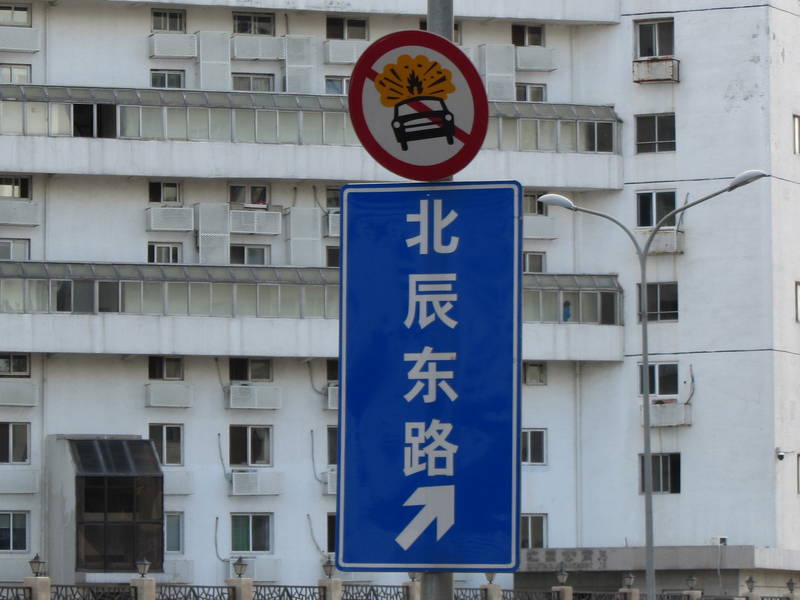
At the Bird's Nest Stadium

It's huge inside

Bad guys on motorbikes

The square between the Bird's Nest and the Water Cube

Audrey is congratulated with a Gold Medal

Love the pedestrian countdown timer (the bar graph and it is red when the "Don't Walk" is lit)
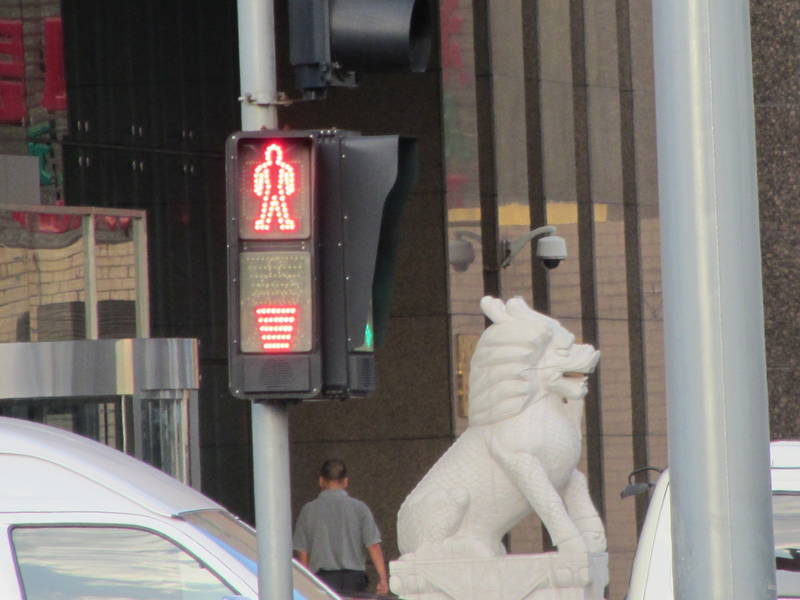
Hmmm, we don't see this in the Co-op grocery store at home...
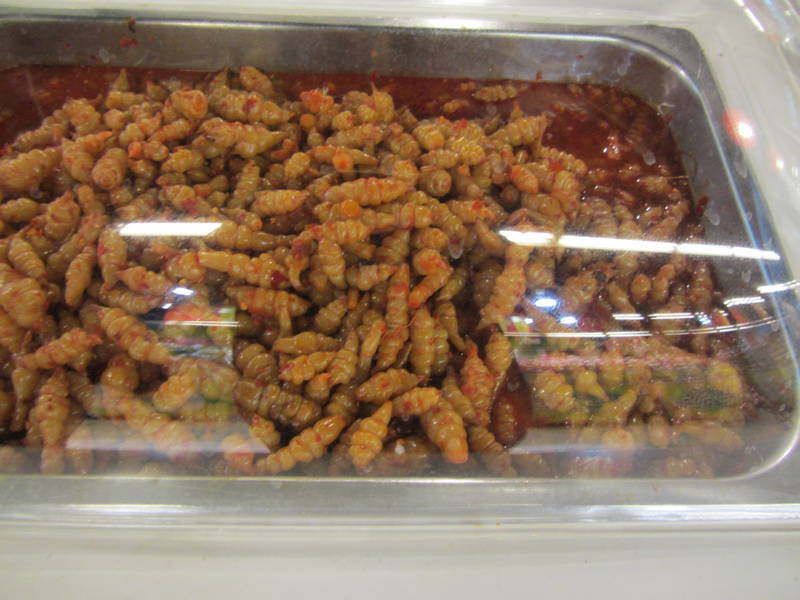
Overnight our driver, Geordie, decided that our motorcycles weren't safe enough parked in front of the hotel. Geordie had China Overland make reservations at another hotel and we now had to pack everything up, including my damp laundry, to move. It sure would have been nice to be involved in the decision making process to move. We wasted an hour and a half of our precious time in Beijing packing everything up, unlocking the motorcycles, riding a couple of kilometres to a 7 Days Inn where the bikes had secure parking and then changing back into our sightseeing clothes. This might have been made more palatable if the new hotel was nicer but it was worse in every way. The room was much smaller, the amenities weren't nearly as nice and to top it off they were in the midst of renovating so the room was a mess and the whole place smelled of paint and plaster. We put that out of our minds and took the subway to Tiananmen Square. The square, made famous by the 1989 protests that were quelled by military suppression, was located directly in front of the Forbidden City. The Meridian Gate was enormous and we jostled with the crowds to get in. We declined the use of a tour guide as we had Frank with us and then entered what is listed by UNESCO as the largest collection of preserved ancient wooden structures in the world. Inside the gate we crossed one of the five bridges over the Inner Golden Water River to the Gate of Supreme Harmony. Looking down from the gate onto a large square we could see throngs of tourists converging on the Hall of Supreme Harmony. On the stroll over to the hall Frank pointed out a number of enormous pots. Before modern firefighting equipment these pots were filled with water and used to protect the wooden structures. It must have worked as the Hall of Supreme Harmony was the largest wooden structure surviving in China. We climbed the raised marble platform and pushed our way with the rest of the crowd to the opening where we could have a view of the throne. Being taller than most of the other tourists I was able to see something without having to push to the very front. What a mad scramble though as everyone pushed and shoved to get a glimpse of the inside and then pushed their way out again. This process was repeated for the Hall of Central Harmony and the Hall of Preserving Harmony where crowds would push to the front for a quick glimpse and perhaps a cell phone photo of the throne. And then again for the Hall of Union and Peace and the Hall of Earthly Tranquility. By this time I was pretty much "Halled Out" so it was good that we now entered the inner court where the small Imperial Gardens were. Though to be honest the gardens were even more crowded than the rest of the palace. Rather than returning to the Meridian Gate, battling the crowds, Frank suggested we exit the Forbidden City at the Gate of Divine Might and walk back to the subway station along the moat and west side of the walled city. After the jostling in the crowds we readily agreed. Only much later did we realise that we missed the actual Palace Museum which is said to house more than a million rare and valuable works of art in its permanent collection. How could a tour guide in all good consciousness not explain the consequences of that decision?
Hall of Supreme Harmony

The throne inside the Hall of Supreme Harmony
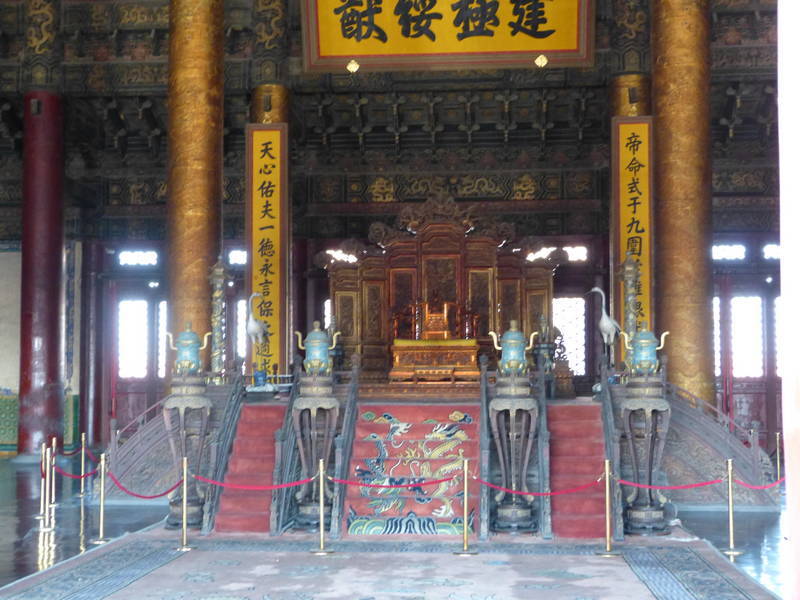
And crowds jostling to see it
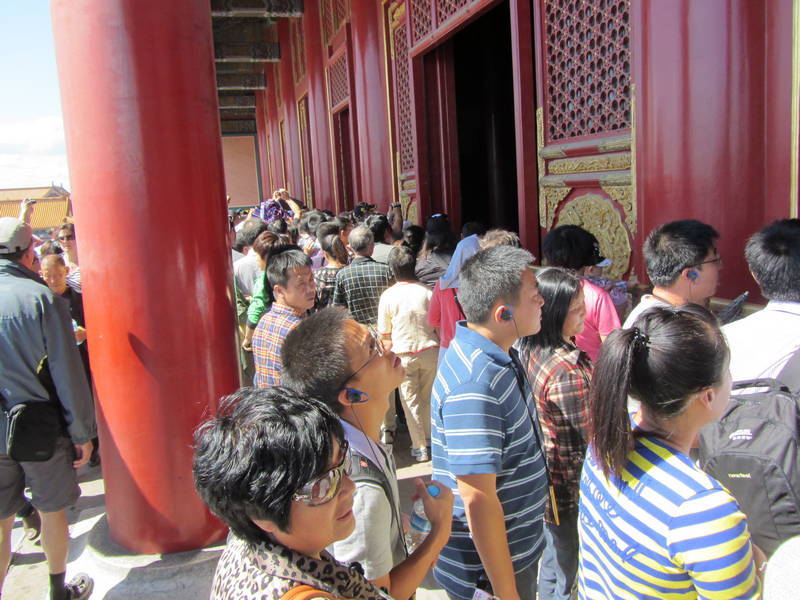
The throne inside the Hall of Central Harmony

A statue of a lion playing with its cub guards the entrance to the Hall of Preserving Harmony
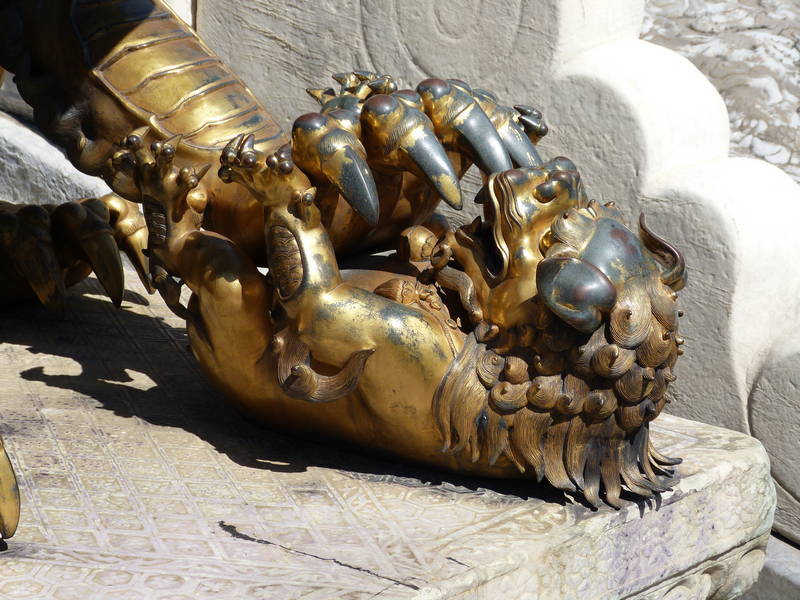
Throne in the Hall of Preserving Harmony

The compact Imperial Gardens were, if possible, even more crowded
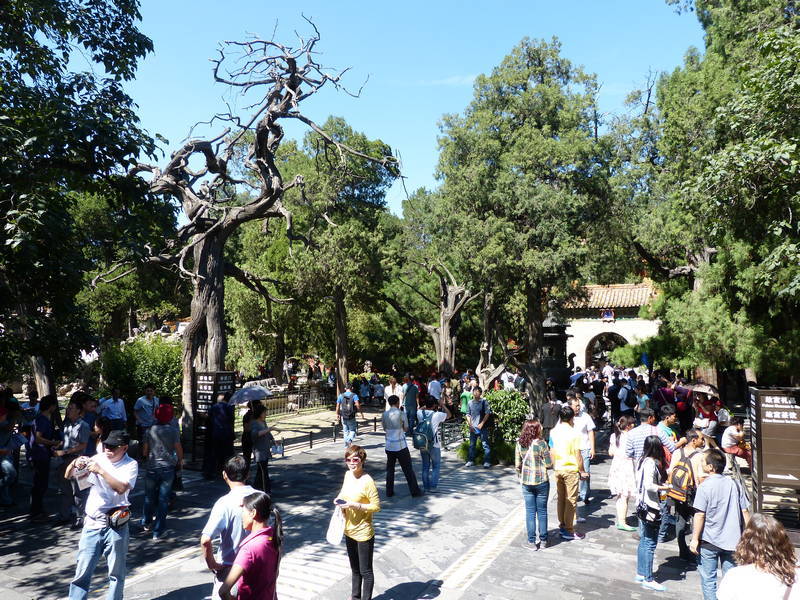
Walking around the outside of the Forbidden City

Apparently having three wheels makes the vehicle so much cheaper (taxes?) that they're quite popular
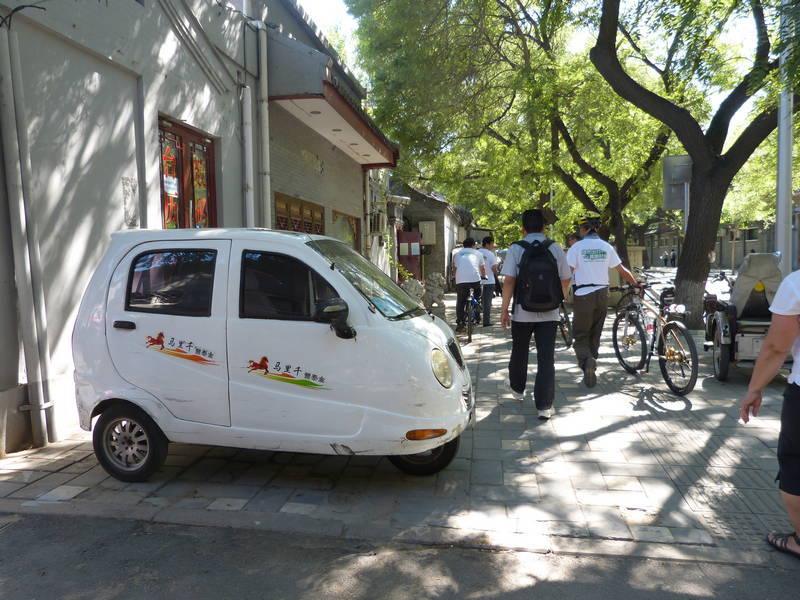
We detoured to a pedestrian mall for lunch at McDonald's, our first since Western Russia, and then took a convenient subway ride to the Summer Palace. The grounds of the palace were simply beautiful and near the North Palace Gate was Suzhou Street, a section of the park made to look like the canal streets of the city of Suzhou. It was beautiful and we could hardly wait to see Suzhou ourselves to see if it matched up to this replica. We walked west past the boat houses and the marble boat and then south to the lake shore. The Long Corridor, along the base of the hill, was over 700 metres long and contained about 8,000 different paintings depicting landscapes and stories from Chinese literary classics. We hopped on a boat across the small lake to the 17 Arch Bridge and back. The views from the boat of the Tower of Buddhist Incense were quite beautiful and it was good to rest up on the boat before climbing the countless steps to the tower. Perhaps someone should have counted them as there were a lot. Inside the tower was a statue of the thousand-handed Guanyin Buddha, standing five metres tall, cast in bronze and gilded with gold it almost glowed. The Tower of Buddhist Incense was near the centre of the park so it was only a short walk back to the north gate, near the metro station. Unfortunately the pathway was closed and we needed to descend all the way back to lake level and go around the hill to get to the exit gate. We eventually found our way out, passing by the Suzhou Street again but now in lovely light as the sun was setting, and back onto the metro for the ride back to the hotel. As this was our last night in Beijing we decided to splurge and go out for Peking Duck at a nearby restaurant famous for making it. A chef came to our table and carved the duck into bite-sized slices and placed the platter on the table. A moment or two later a selection of small crepes arrived along with a special sauce, peeled celery and lemon grass. The duck was placed on the crepe along with the celery and lemon grass and then drizzled with a little sauce. The crepe was then rolled up and eaten by hand. For some reason we had both envisioned that the duck would be eaten with chop sticks and accompanied by other dishes and a bowl of rice like most other Chinese foods we've had, so this was a bit of a surprise. What it did have in common with the Chinese food we had had on the trip so far was that it was delicious.
Ekke practises ordering Duck Feet Soup

Inside the Summer Palace is Suzhou Street
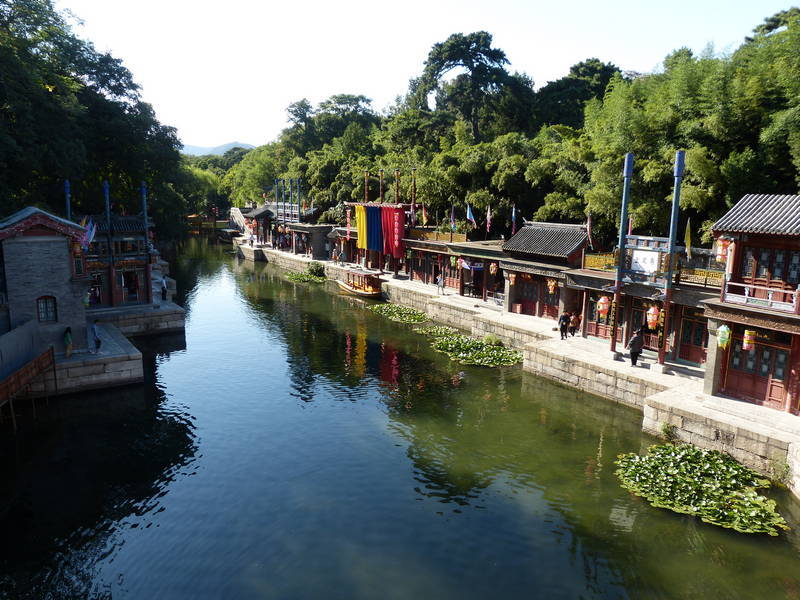
The Marble Boat

Over 8,000 paintings decorate the Long Corridor

Looks like lots of steps going up to the Tower of Buddhist Incense

Yep, that's a lot of steps
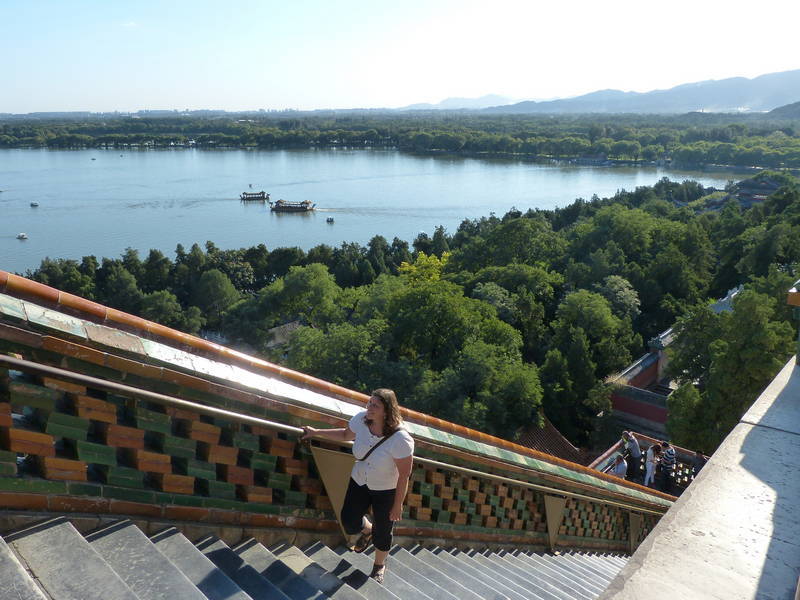
But the view is glorious

A glimpse of the thousand-handed Guanyin Buddha

If you're going to have a mythical animal statue why not have it look like a happy puppy dog?

Sun setting over Suzhou Street at the Summer Palace
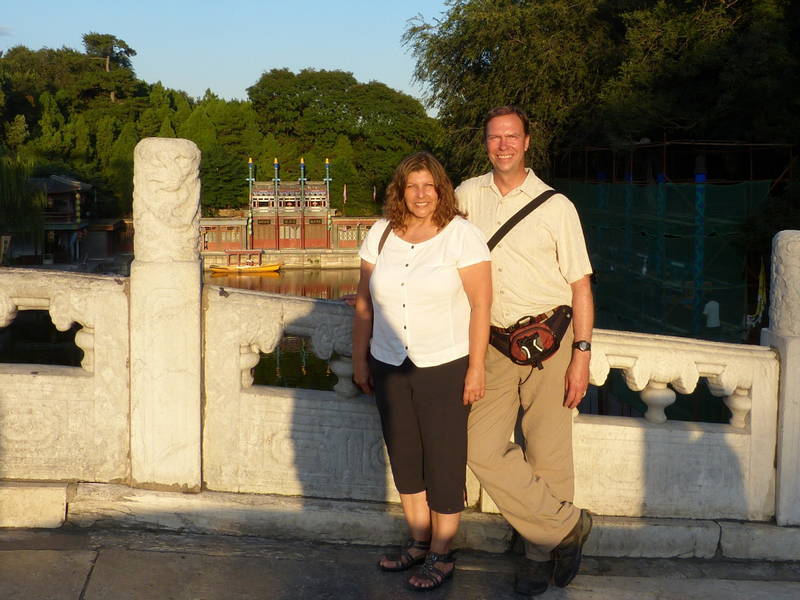
The chef carves the Peking Duck
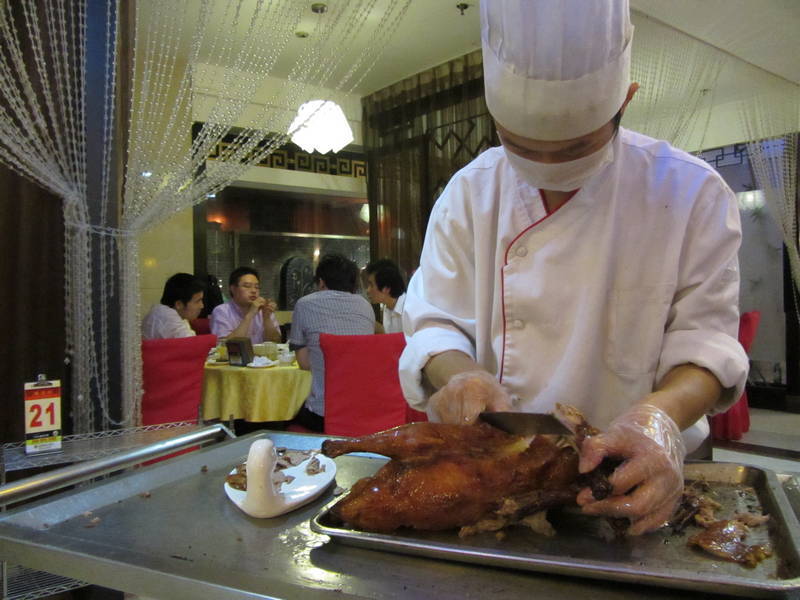
Who knew that you ate Peking Duck wrapped in a crepe?

Audrey writes:
A warm, sunny day greeted us on September 15th, and we were itching to get out on the road again. Geordie, the driver, informed us that there was construction on the highway ahead that day so we had better get an early start. Telling us the evening before would have been a good idea. So we had a quick breakfast in a rustic place near the hotel where meat-filled dumplings and won ton soup were ordered for us. The dumplings were in little steamer baskets and delicious, but I wondered if I could get used to having them for breakfast. The ride out of Beijing was an absolute pleasure on the expressway. Traffic was fairly light and calm, the highway was fantastic and it was great to look around and enjoy the scenery. Bush and tree-covered terraced hills lay before us as we left the highway and rode into the Taiyang Mountains. It was Saturday and there were plenty of bicyclists riding the hills, really kitted out with all the latest gear. I surmised that they were the nouveau riche of Beijing getting in their Saturday morning fitness and nature fix in the warm sunshine. Our route took us through small towns with roadside fruit and vegetable markets. Some very colourful booths lined the streets and I think they were selling firecrackers, maybe for the national holiday that was coming up in a few weeks. But later we saw some being set off in small towns, right beside the highway, with decorated wedding cars nearby.
Delicious dumplings for breakfast

Ekke gets ready to wave to another speed camera (he waved at every single camera on the trip, and there were hundreds)
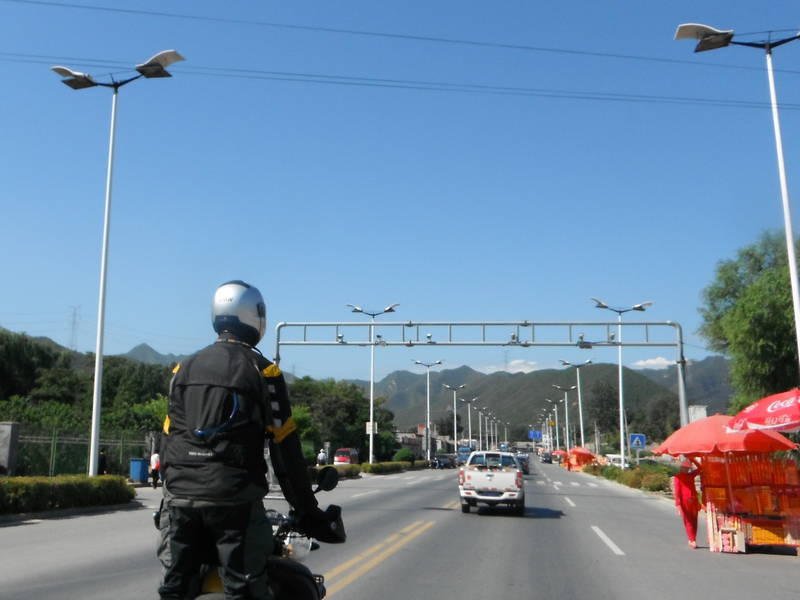
Into the hills
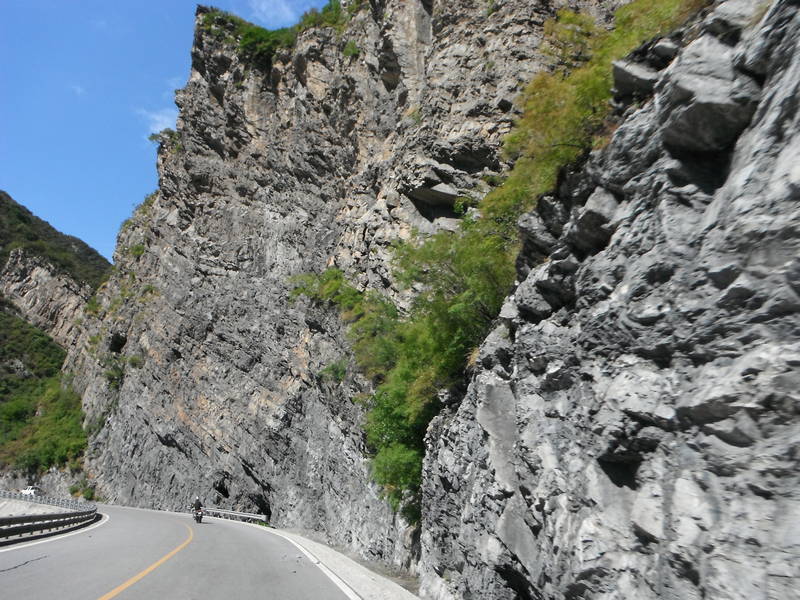
For the most part, drivers were not very aggressive and going reasonable, if a bit slow, speeds on the curvy mountain roads. But then a few individuals kind of ruined the peaceful ride. First a guy driving a Volkswagen Santana came up from behind, rounded a traffic circle beside us, and then pulled into our lane forcing Ekke over and me to get way too close to a bicyclist. Hopefully this would be the one unsafe driver we would encounter that day, as most of the drivers seemed to be fairly calm. But a few more drivers who came up behind us behaved as if they didn't know what to do with something on two wheels in their lane. Our bikes are wider than your average scooters, which stay on the side of the road. So cars just treated us like scooters, moving in beside us and forcing us over into a space that was way too narrow for us at highway speeds. It took a lot of energy to remain calm and try to claim our lane.
Traffic thinned out later, however, and we wound our way up on well-paved roads, into the hills. The twisty roads were really fun as we climbed higher, rode on the ridges, and ducked back down again into the valleys. With a big grin on my face, I hit the throttle, and the F650 GS twin glided into the third-gear corners effortlessly. I was living a BMW motorcycle commercial. The bent rims were a non-issue as I took corner after glorious corner, each more fun than the last. The mountains in the distance were lovely in the sunshine, and we could see peaks quite far down the valley, layer after layer of slightly different greenish hues. But as soon as we got out of Beijing County the road deteriorated. A half hour wait because of blasting turned out to have been unnecessary because there was a detour route that wasn't signed. The dirt detour 'road' was really rough but I thought that if the buses were doing it, I should be able to make it. A really steep climb on big rocks caused me a moment of panic but I just twisted the throttle and hung on tight. This unofficial detour went right under the avalanche slope of the blasting so perhaps safety wasn't as much of an issue here.
Looks like it will be fun up ahead
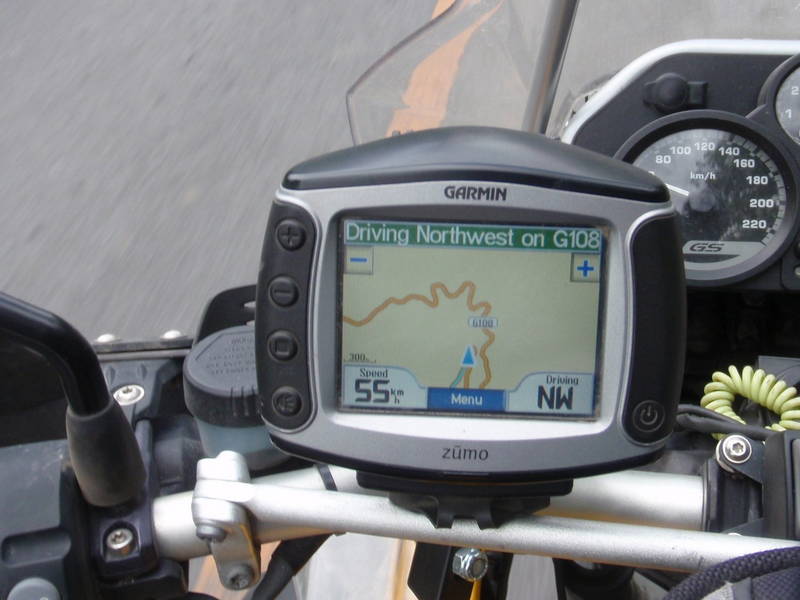
Yep, it is fun
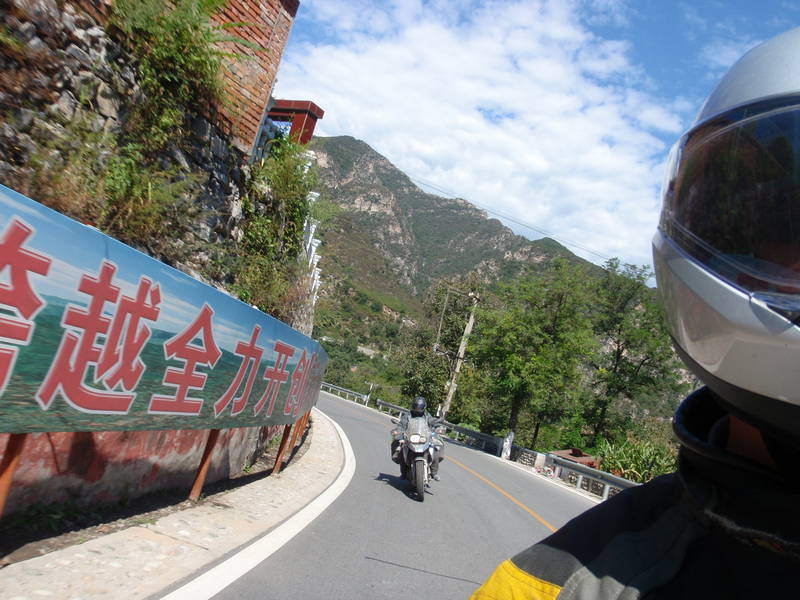
Construction on the National Highway so it's down to just one two-way lane
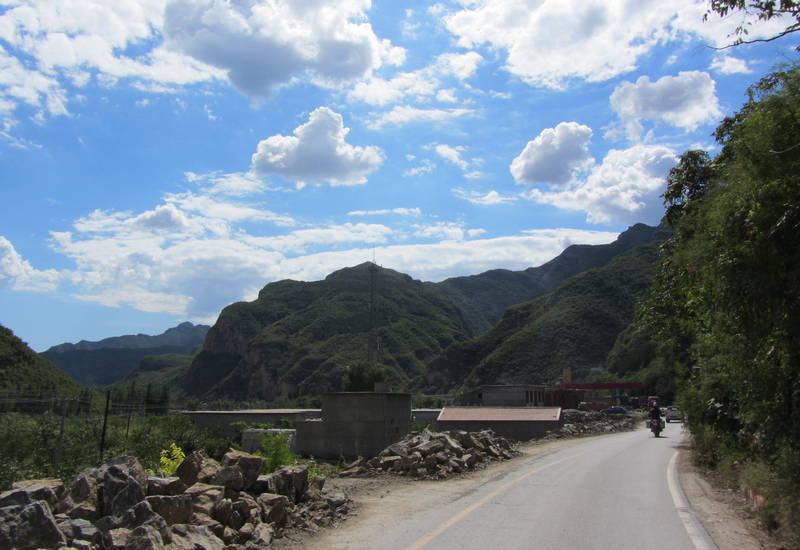

A bit of a detour
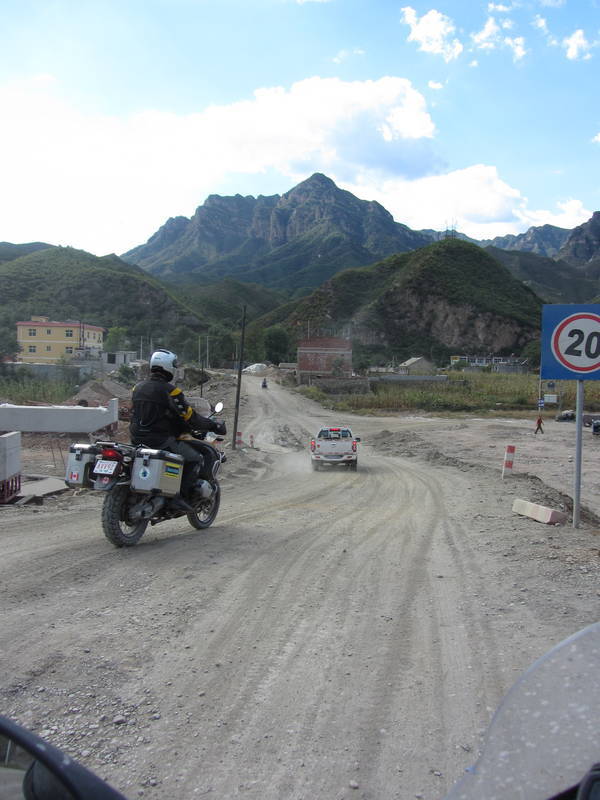
Later in the afternoon we came to another construction zone, also closed, but with no obvious detour route. A sign indicated that the highway was closed from 8:00 am to 6:00 pm. Great. Don't you think a tour company would know that the highway we were going to be riding on all day was closed? The expressway was nearby but we were assured that motorcycles could not get past the toll-booth operators, even in these circumstances. Ekke suggested that we should just try, as it was very obvious we were not scooters. But, Geordie wanted to try going around the closed sign, past a rock pile (put there to stop traffic), past active earth movers and diggers, over some big, sharp rocks in piles of really soft dirt. Really? And this was more 'legal' than trying to get on the express highway? He moved the sign, built up the area around the rock pile with smaller rocks and was able to get around with only a few scrapes to the bottom of the truck. He drove past the huge diggers and out the other side. I really didn't want to try it for several reasons, but mostly because of the really rocky, soft dirt piles that we would have to ride over. Did I have to? I suggested we could just put our tents up nearby and try it the next day. But as we looked at our options, the road magically got a lot better as the earth movers packed it down to get ready for opening. So, we went for it. Ekke rode across first, and then I tried it and got stuck halfway through. Ekke came to my rescue, rode another really rough part for me, and we got through at about 6:00 pm, just as the road opened. Crazy.
Geordie moves a pile of dirt and gets the truck around the obstruction
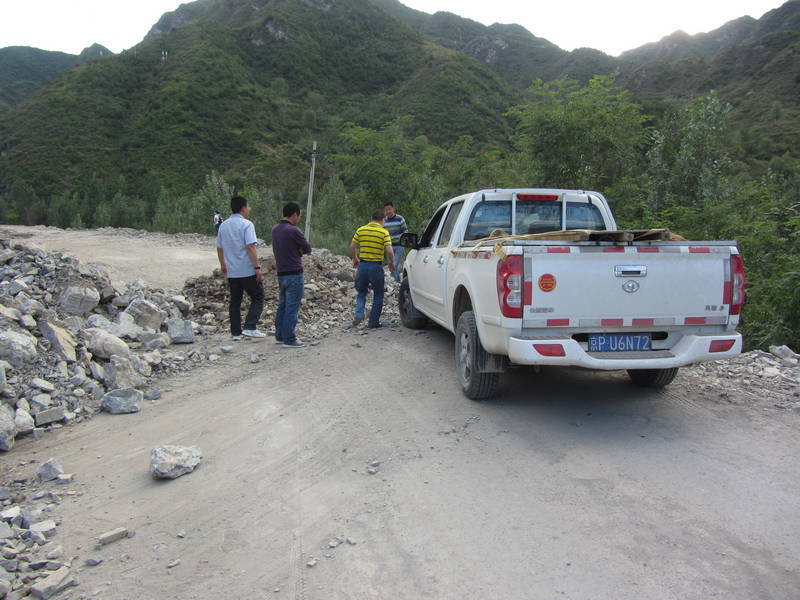
Loose dirt and sharp rocks plus active construction equipment, this is better than the expressway?
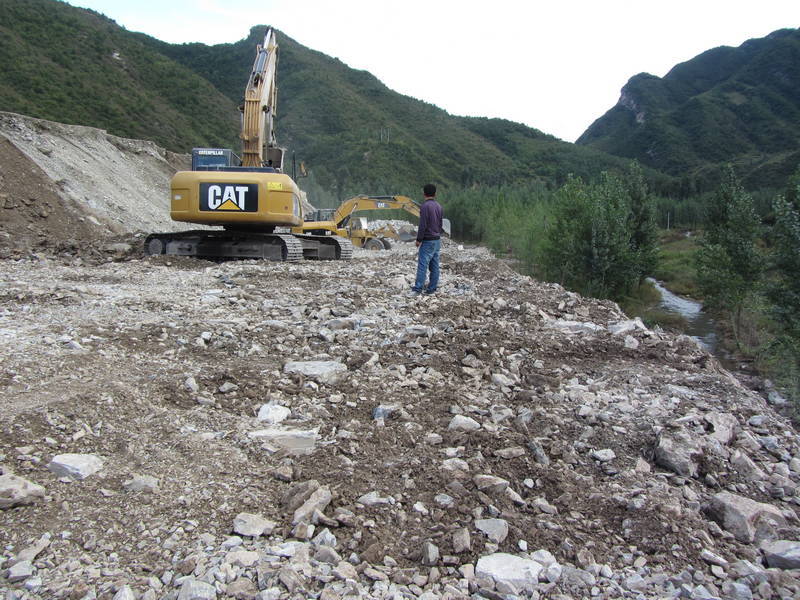
Ekke gets through the rough stuff and looks pretty happy about it

It was still 70 kilometres to the next town with a hotel, so we rode quickly to try to make it before it got too dark. As we were riding, I happened to look up into the hills and there, illuminated by the setting sun, was The Great Wall of China. I was flabbergasted. I did not know that we would be riding by a huge section of the wall that day. Good thing I had just looked into the hills at that moment. Even though it was getting dark and we were running late, I had to stop for a couple of photos. I was so excited about the discovery and pointed it out to Ekke, who was also very excited. Later, I shared my discovery with Frank, saying, "I saw the Great Wall, I saw it up in the hills! I didn't know we'd see the wall today." The way he answered was very indicative of his attitude on the whole trip. He bragged, "I, I saw Great Wall," gloating that he had seen it as well, and first, too. Uh, you're the tour guide. You knew it was there. I was seething at the way he just dismissed my excitement at discovering the wall, and never really warmed up to him after that. I was starting to think that we were just taking a couple of guys on a free holiday and getting very little in return. Anyway, a nice hotel awaited us in Laiyun for 400 yuan ($62) which we paid twice. We also paid twice for all meals, as Ekke already mentioned but is worth repeating. This is on top of paying $7200 for permits to get into China with the bikes, as well as the guide, driver and truck. For dinner Ekke and I had fun when he ordered duck feet soup by miming it. I got the whole thing on video. We talked a bit about what was coming up the next day as someone had neglected to tell us that we would see the Great Wall and beautiful shrines in the hills after leaving Beijing. Frank told us there was nothing much to watch for on our route tomorrow. He also said that it was too far to make it to Pingyao but that we'd get there early the day after that. We were happy that we wouldn't have such a long riding day ahead of us.
The Great Wall of China as the sun is setting

Duck's feet! (not quite as tasty as it sounds)
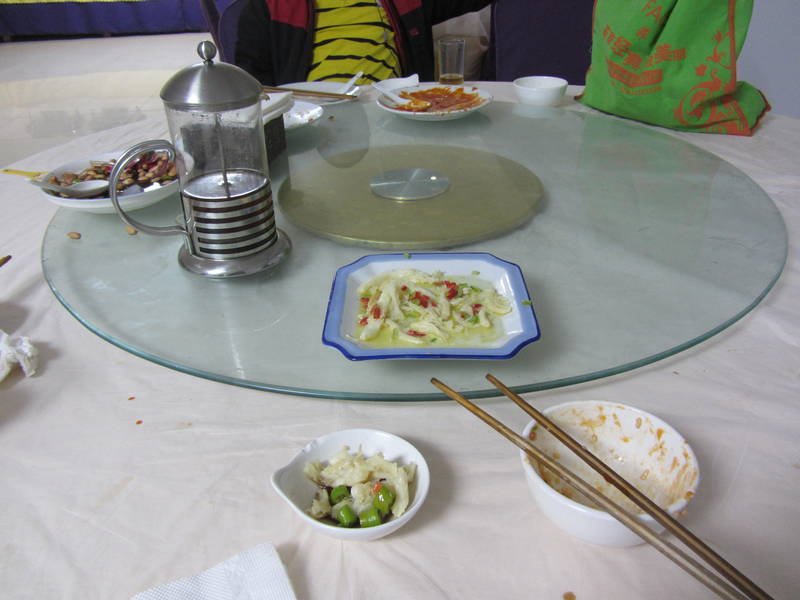
From the hotel in Laiyun
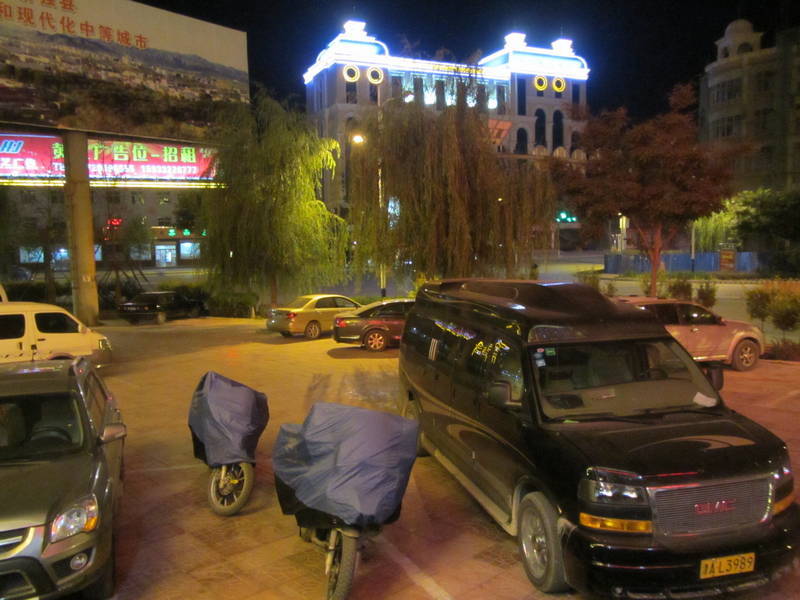
Four star hotel construction standards?

The gasoline 'dance' took us a long time the next day: Park the bikes away from the gas pump, get an attendant, fill a kettle, pour it into one of the bikes, go back and fill it again, spill it because of the awkward pouring position, clean up, gag because of smell, repeat. The novelty had worn off. We begged Frank to at least ask them if we could fill up the way the cars did but no luck. He said that with each gas station having cameras, the company could get into trouble if bikes were seen to be filling up directly from the nozzles. I wondered who would possibly take the time to send photos of a couple of motorcyclists using the gas station illegally, and who at the other end would care to see them.
The gas station manager comes out to fill the bikes
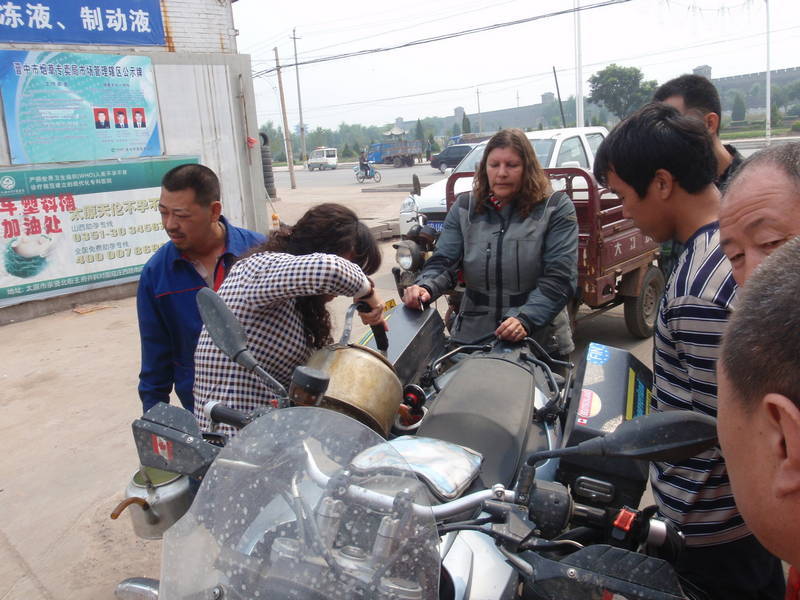
The ride the next day began with a beautiful stretch through the mountains, with curvy roads and very little traffic. We were making good time but then there was a 20 kilometre stretch with plenty of huge trucks and it was really slow going. Our route took us past more Great Wall towers, standing alone as the wall blocks had been taken down and used in other building projects. What a shame. Houses had heavy-looking slate roofs, a readily available building material here in the mountains. Later on we stopped at a fruit stand and got a few apples and apple-pears. There were several vendors sitting roadside beside their orchards and we stopped at one. The lady was so sweet and she wouldn't take any money for our purchases. So I rushed back to the bike and got a Canadian flag pin and our card with a photo of us in front of the pyramids and gave them to her. She looked like she was going to cry tears of joy and I could see her in my rearview mirror that she was sharing her little souvenirs with her friends as we rode away.
Up into the hills

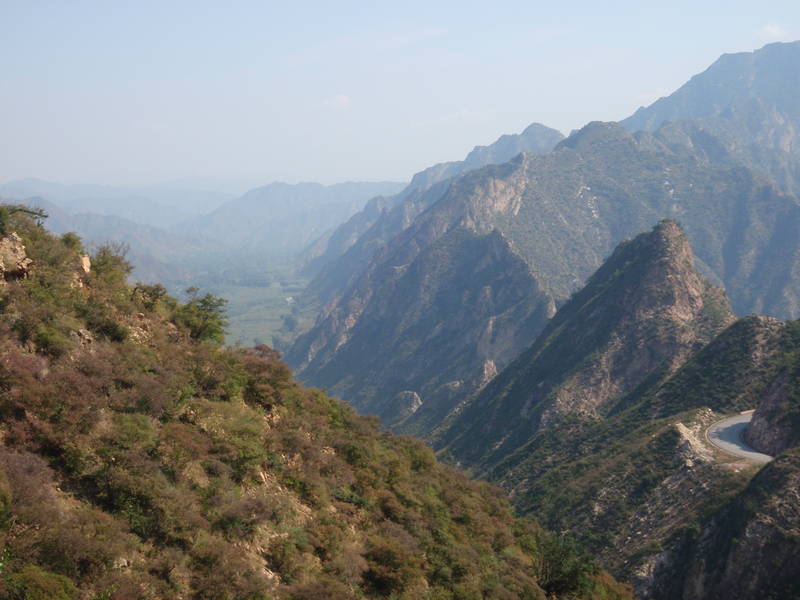
Audrey living the dream

Mountain village

Audrey checks out a small shrine
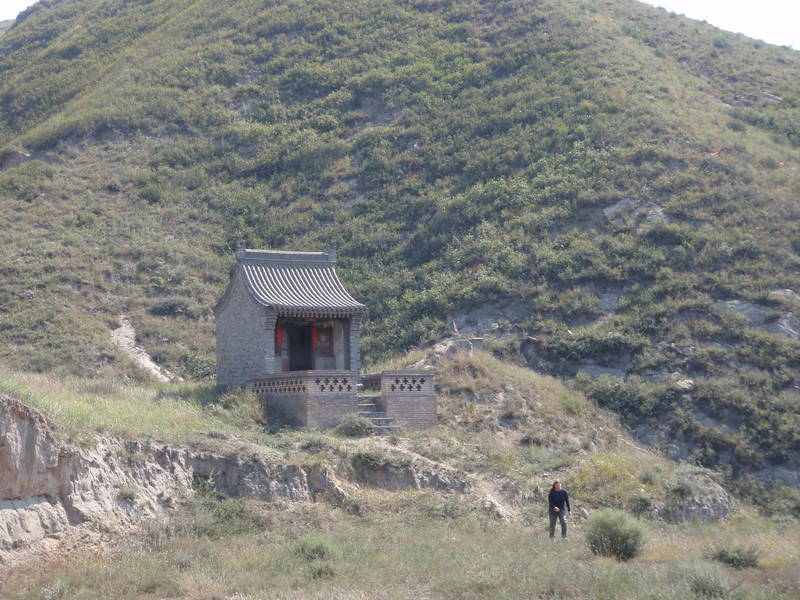
Delicious apple-pears
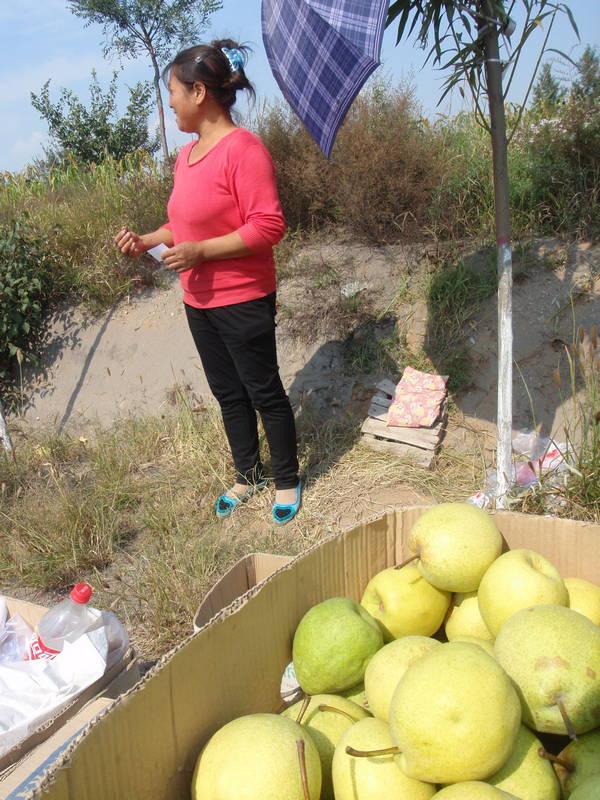
Rural traffic can be interesting
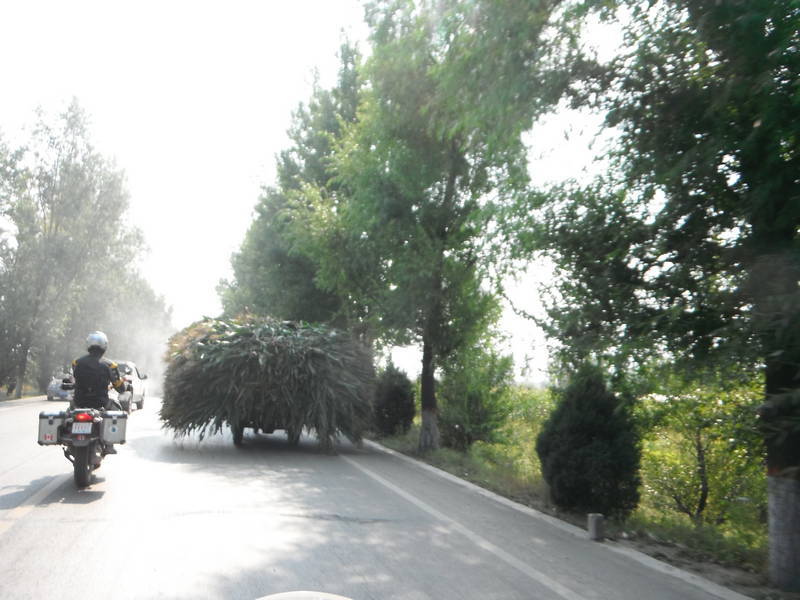
At lunchtime Frank mentioned that we would be going all the way to Pingyao that day, another 300 kilometres. Uh, wait a minute. He had told us the night before that it was too far. Doing the math we knew that it would be way after dark when we arrived. Ekke also mentioned that there was a big city of 9 million people coming up but Frank just brushed him off with "Yeah, yeah, yeah, I know". Not being able to go around Taiyuan on the expressway, of course, we had to ride right through it. It was nothing but stop-and-go, a very painful experience, especially when we noticed that scooters and bicycles were travelling a lot faster than us. Having to stay with the truck meant that we lost the advantage of being on motorcycles and couldn't just zip in and out of traffic and make it through the city a lot quicker. Every red light was timed perfectly so that we had to stop at all intersections. Sometimes Geordie would suddenly change lanes and run a yellow light to get through the intersection, leaving us to either run a red light behind him or come to a screeching halt. Was he trying to lose us? It was difficult to ignore pedestrians who were halfway out into the crosswalk, waiting for someone to slow down to let them cross. But we just couldn't do it, needing to be selfish to move ahead. The setting sun was quite an interesting colour in the thick pollution, and I hoped that we would be stopping at a hotel here. When I rode up beside the truck to ask, Frank just said that once we were out of the city, it would be just another 30 minutes to Pingyao on a good road. Geordie's frustration at the snail's pace traffic started to show. He started driving erratically and suddenly swerved off the road, over into a construction lane and gunned it through the gravel, raising huge clouds of dust and spraying rocks. Did he expect us to follow him into that unpredictable mess, in the dark? We didn't. Later, the road did change to four lanes and traffic moved a lot quicker. But by this time it was pitch dark on an unlit highway, and it was scary passing tiny 3-wheeled, slow moving vehicles that had no lights, unwittingly missing them by centimetres. Trucks just shot out onto the highway without looking and we swerved regularly to avoid being hit.
A couple of motorcycle tourists in Taiyuan (their guide was also on a bike so they could slice through traffic)
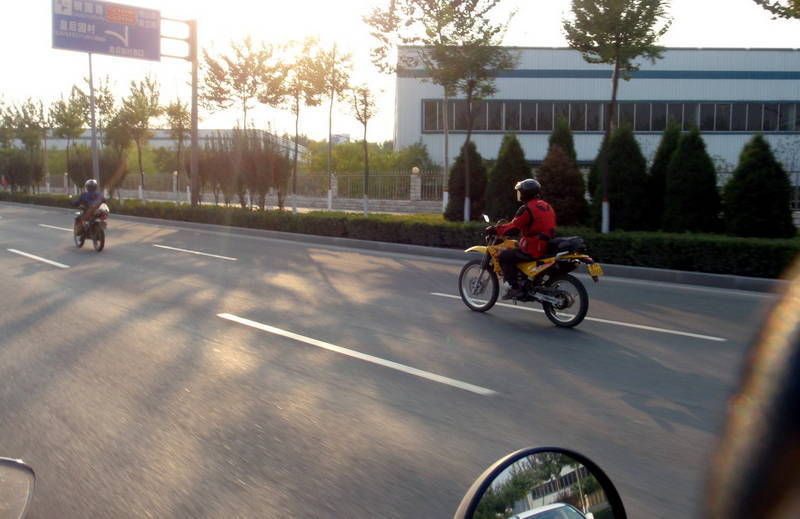
Whereas we were stuck in traffic behind the pickup truck

People everywhere were super curious about us, always taking photos and waving

Relieved to finally make it, we rode into Pingyao 90 minutes (not 30 minutes) later, at 8:30 pm. A wonderful hotel awaited us. It was a classic Pingyao historic courtyard building. Around back in the alleyway a couple of huge wooden doors were opened up for us so that we could ride the bikes right into the courtyard. All around us were wood-decor rooms with big windows facing into the courtyard, and we hoped we would get a room with a view of the bikes. Frank spoke with the desk clerk, and then they left for a very long time. We waited at a table in the courtyard near the motorcycles. And waited. None of the staff could tell us what was going on. Finally after half an hour, Frank returned. He had some bad news. The hotel could not accept foreign guests. As of when? As of today. You're kidding. No. From what we could get out of Frank we learned that there was some trouble recently in another hotel in town and now hotels were being careful about following the rules. Luckily there was an opening at a big hotel down the street, a non-courtyard, character-free hotel that would accept foreign guests. By now it was 9:30 pm and when Frank asked what we were doing for supper, we were so annoyed from getting there so late, we just said, "Nothing. Goodnight." We're not sure what they did for supper, but the instant noodles in our hotel room were not half bad.
The window of our room looked down on Pingyao's ancient Ming Dynasty city wall, quite intact and well-preserved. Ekke, Frank and I walked beside it the next day, September 17th, and entered the main gate of the ancient city. The little cobblestoned lanes were delightful and we meandered past quaint shops and temples. A visit inside a Taoist temple revealed a courtyard with trees and statues. Further in, monks were lighting incense and going about their monkly duties. Up some stone stairs was a huge bell with a horizontal pole on a rope, just begging to be rung. I hope we didn't scare the neighbours. One street after another offered up quainter, intricately carved wooden houses and shop fronts. Pingyao used to be a financial centre, and the old banks were lovely. I wanted to see inside of one because I had read that some of the first cheques in use, ever, were on display. But the admission charge of 150 yuan ($23) per person was too much as it included all of Ping-Yao's museums and temples and we couldn't just pay for the one we had time to visit. So, we just looked at the bank from the outside. A coffee break at a courtyard hotel was a bit frustrating as I tried to order my coffee without sugar. I sent back the first cup and tried to ask Frank if they were then going to bring me one without sugar, but I got another one with sugar. Aargh. And this is with an 'interpreter'. Taking photos of the beautiful buildings was also a challenge as Frank always seemed to be there in the front and centre and I had to ask him several times to move out of the way. I tried to get some information out of him about the ancient city but all he could tell us is that it was from the Ming dynasty. Occasionally he would read a sign and tell us what it said, but we already knew what it said because it was in English.
The Ping-Yao wall
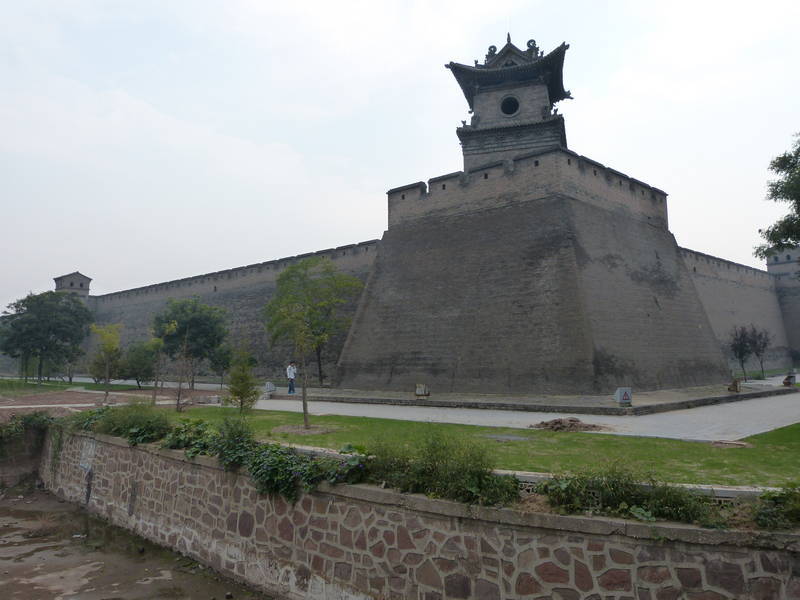
We pass by a courtyard hotel like the one we could have been staying in
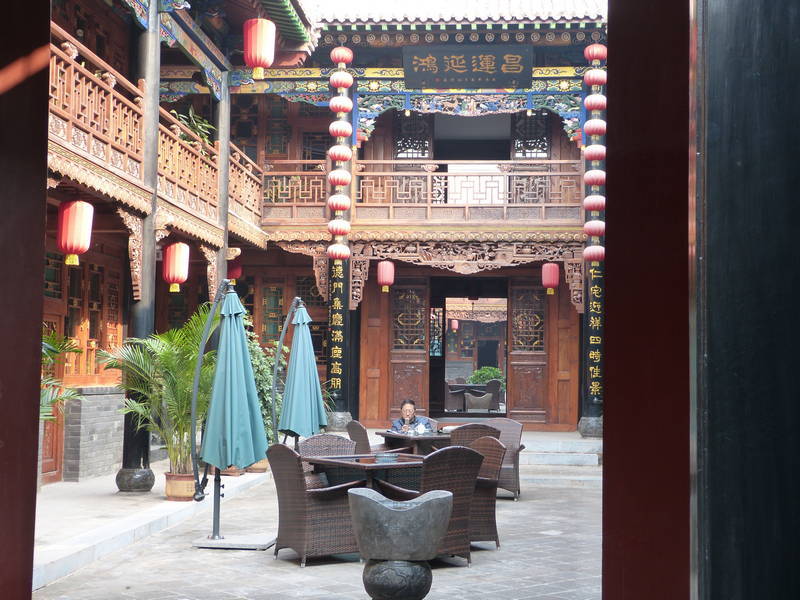


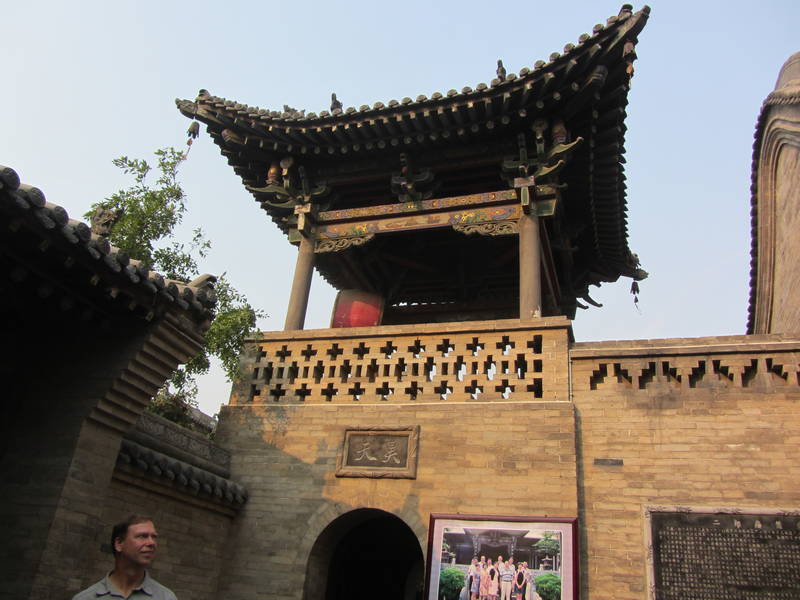
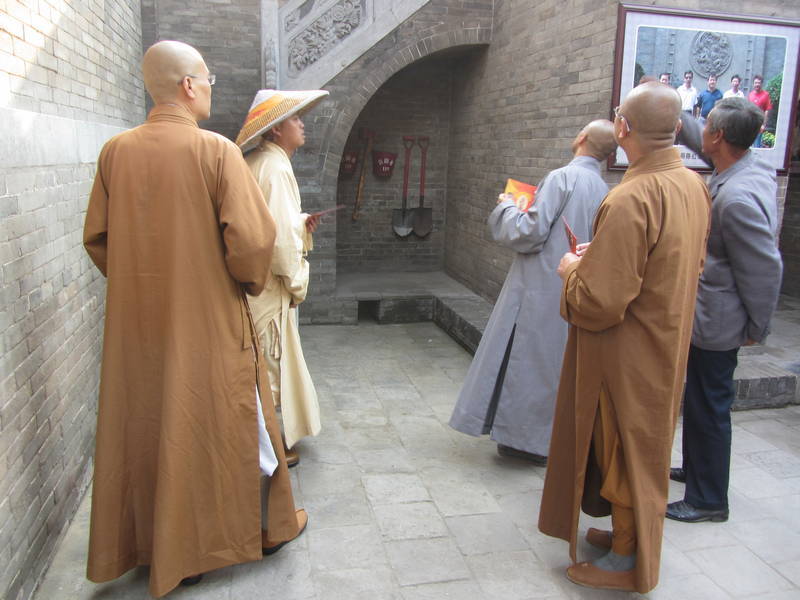
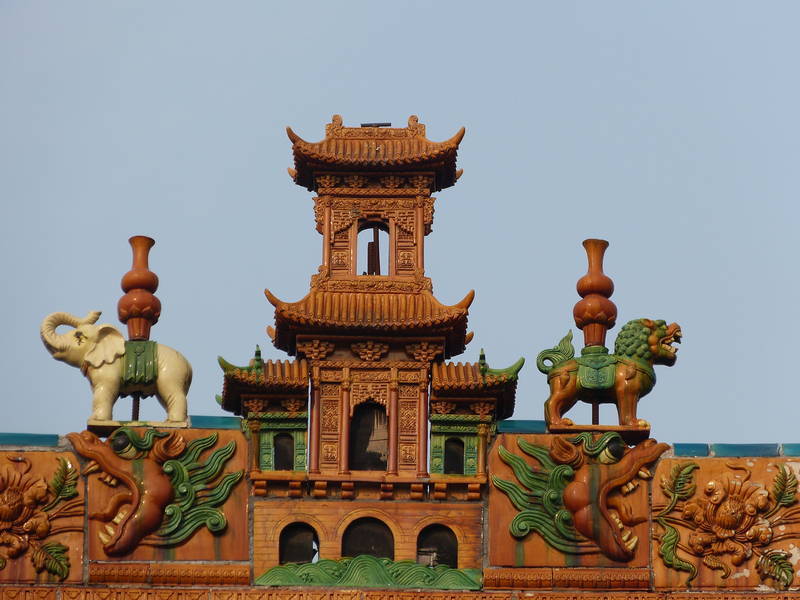
Hope the bell doesn't wake the neighbours

Making dumplings on the street
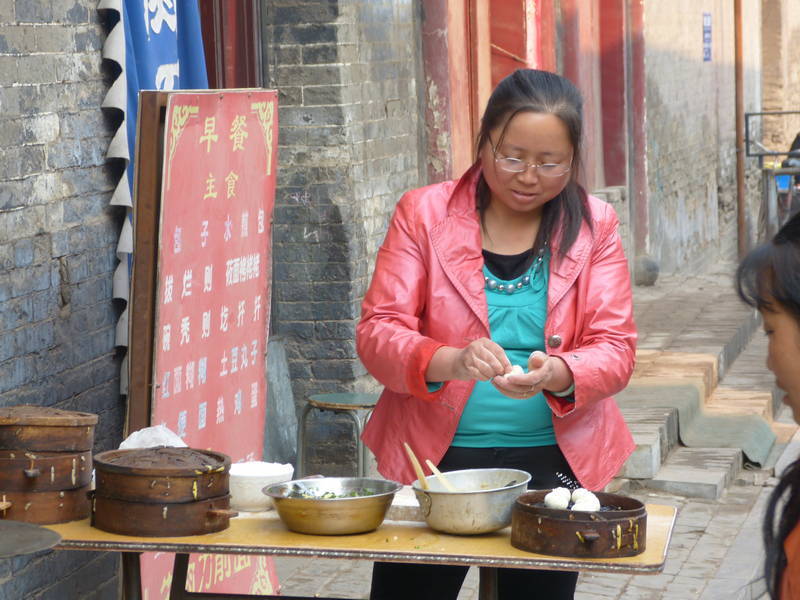
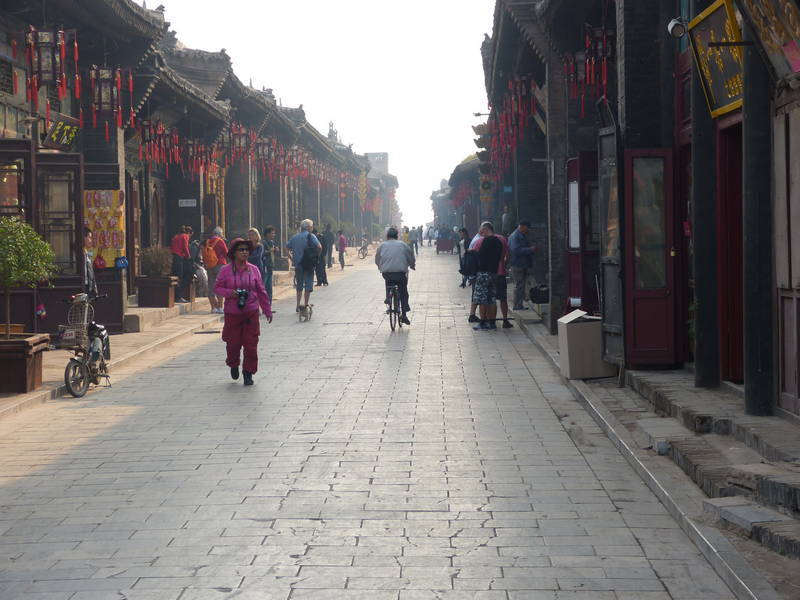
Coal is used for a lot of things in China, from heating homes to cooking. Here the delivery wagon is getting filled.

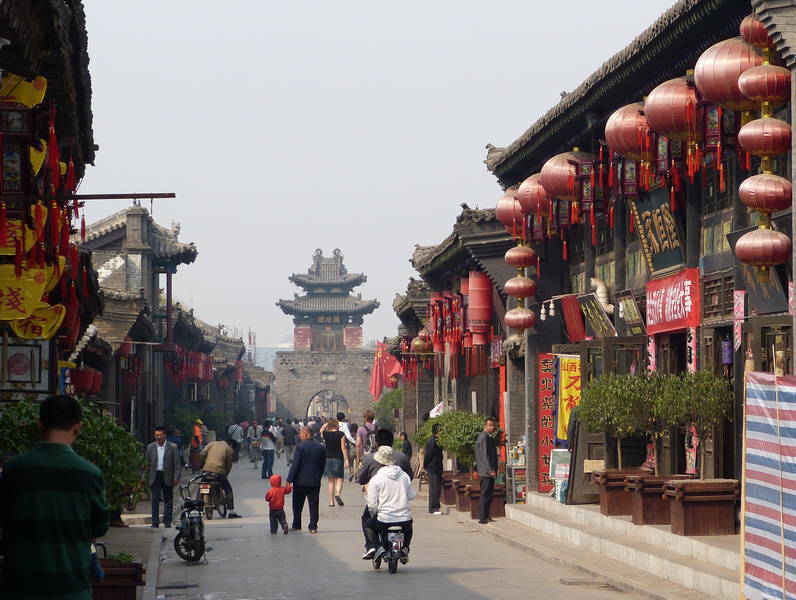

Geordie suggested that eating lunch on the road was 'eating' up our time. He always chose not to eat much lunch anyway as it made him too drowsy to drive. So we said we would try not stopping for lunch and just have a quick snack break instead. The old town of Ping-Yao was not exactly the best place to buy any decent snacks and we could find no fresh foods. There was a stand selling fried spiral cookies so we bought a couple of handfuls of those, a few drinks, and took some individually wrapped sausages from our hotel room. Filling up the bikes with gasoline took longer than ever because the 6.5 litre kettles were so small and they took 5 3/5 slow, careful pours to do it. By the time we finished filling up there were about 8 scooters waiting. The ride through the mountains was beautiful and we saw several troglodyte or cave houses built into the hillside. There were hundreds of these places, some of them with pretty elaborate entryways. Mao Tse Tung had lived in one of these in the early days of his foray into communism, with other members of the party. Good thing I had read about them in Lonely Planet as Frank neglected to tell us we would see them. A roadside 'lunch' of cookies and sausages was not very satisfying and Geordie looked disappointed when we said that we'd rather take the time out to have a proper lunch next time.
Drying the crop on the roadside
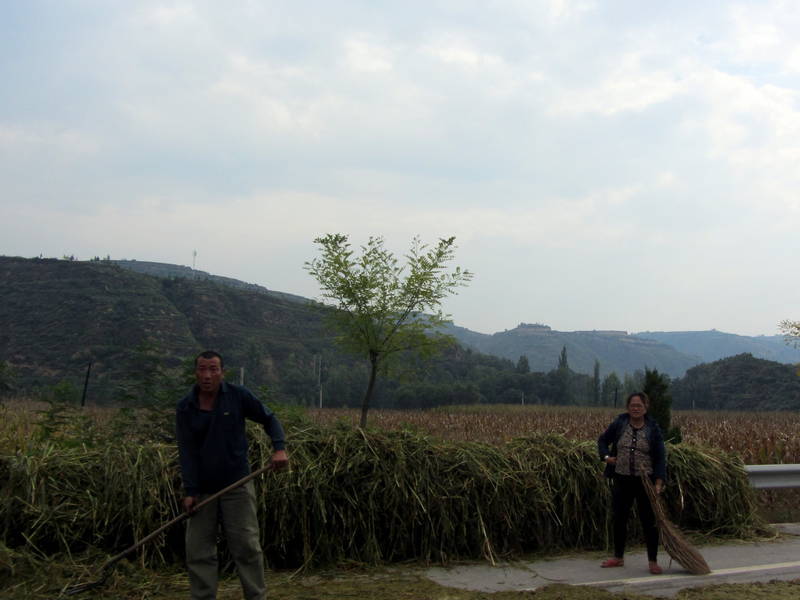
Constructing the retaining wall for the road

Cave houses were quite common
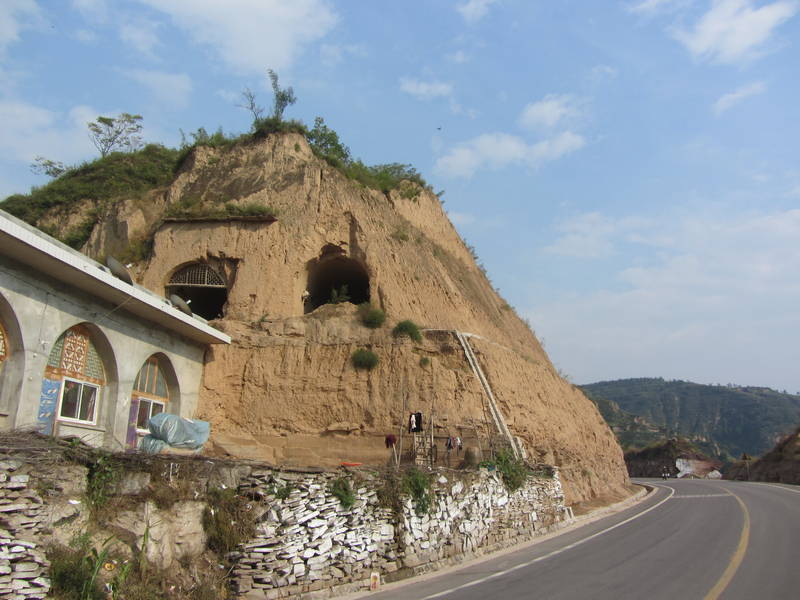
OK, does anyone know what a "Stuffed Highway Section" is?
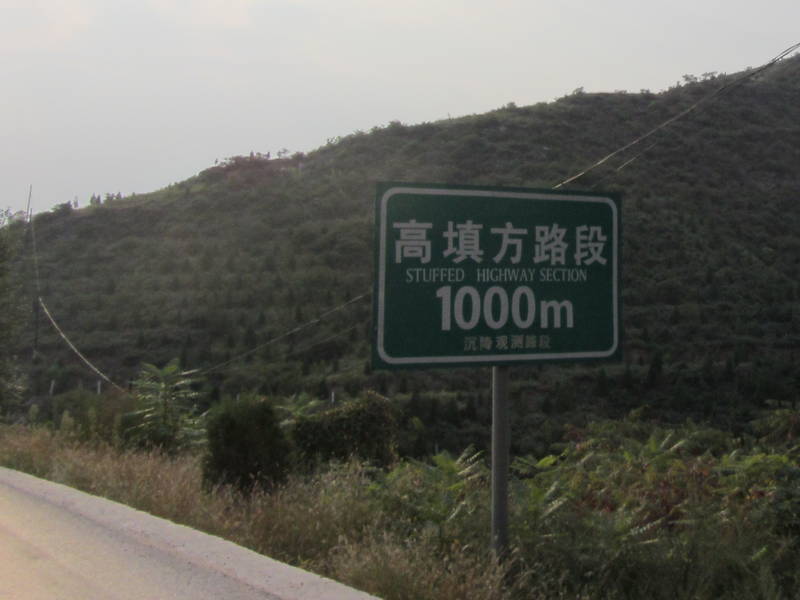
The skies of the mountainous area and high plateaus were bright and clear but as we descended into the valley, the air was thick and heavy. I don't know what kind of pollution the factories were spewing but it was like riding through a thick soup of filth, and an unpleasant stench hung in the air. Our faces and hands turned black, even with the protection of helmets and gloves. We wondered what the inside of people's lungs looked like, living in this environment, and they couldn't just leave the way we could. Arriving at Hukou Falls around 5:00 pm gave us time to visit the falls and take photos of people getting way too close to the edge. The falls on the Yellow River were spectacular. A bridged walkway took us out to some flat rocks where we could walk quite close to the dropoff, but not as close as others. The small fence would never save anyone if they had one misstep and slipped. On the other side of the river the falls fell off the side of a huge, wide cliff, water tumbling over the edge. Further downstream it looked like it was terraced, with falls bouncing down the flat rocks. Frank's only piece of information about Hukou Falls was, "Not as big as Niagara Falls."
Air is so thick that it is only possible to see a kilometre or so. People live in apartments next to the factories.
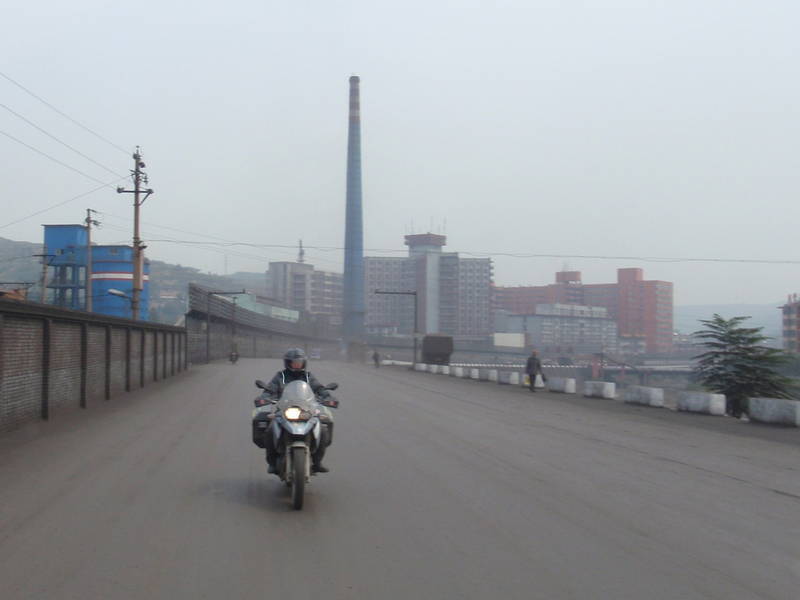
Walking the bridge to the edge of the Hukou Falls
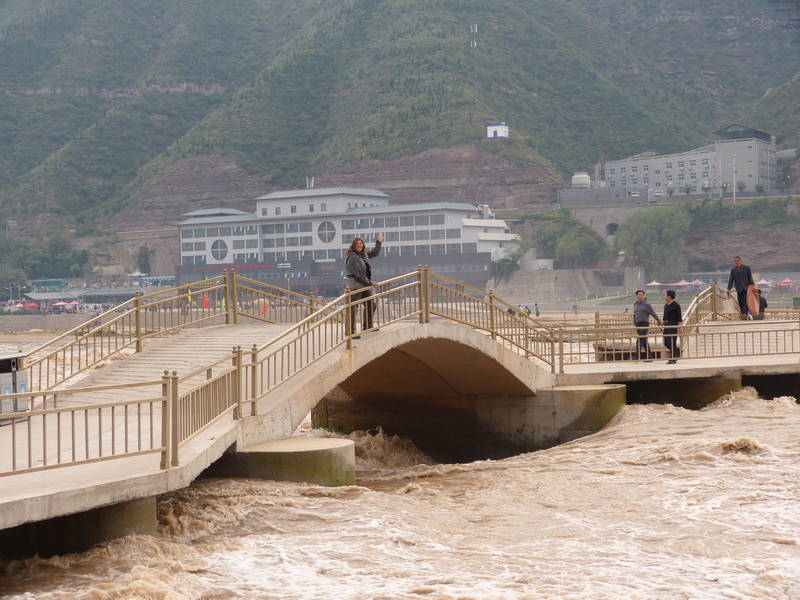
Not too close to the edge

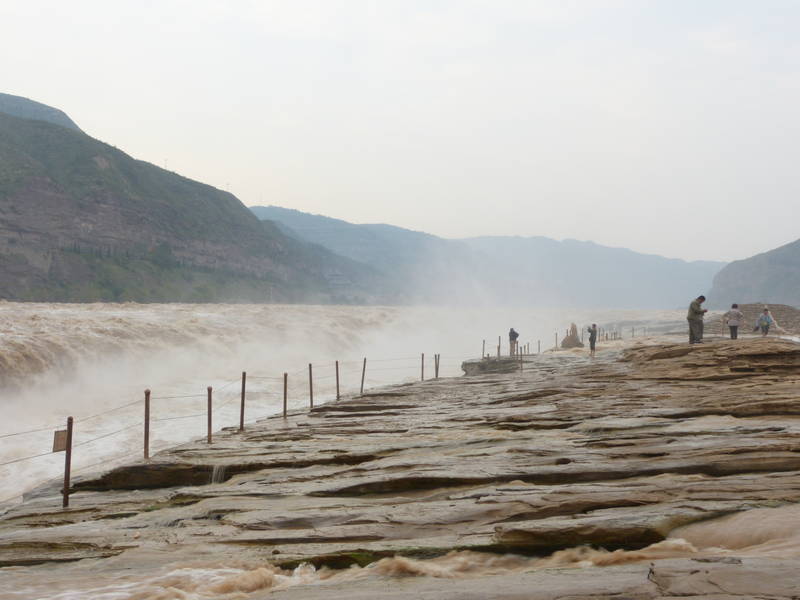

Delicious dinner back at the hotel

For breakfast the next day we walked to a small cafe and ate rice porridge and huge dumplings. When it was time to pay, Geordie and Frank tried to bully the proprietor into getting the meal for a few yuan less, making her show them the bill again and really causing an uncomfortable situation. They always had a way of making people squirm and look really unhappy with the way they treated them. Ekke gave the woman a big smile, thanked her, and her sour expression seemed to evaporate immediately. Before we left town we tried to fuel up but couldn't do so because of a power outage. Fifty kilometres up the road we found a gas station and just rode up to the pumps as if we were cars, hoping to fuel up without the gas cans. And it worked. They just started putting gas into the tanks and it took mere moments instead of half an hour to fill up the bikes. What a relief. Frank looked a bit uncomfortable with it, but, what are you going to do? Geordie had asked how far we could go on a tank of gas and we told him that my bike usually went about 300 kilometres before we had to fill up. He must have thought we were fibbing to him because in China, the bike was not even close to empty at the 300 kilometre mark, showing at least another 150 kilometres of fuel left. The average speeds of about 40 kph were giving us great fuel economy.
Motorcycle cops

Our route took us near the express highway, winding back and forth under it many times. Much of the ride was actually quite pleasant, and we passed by many more troglodyte homes built into the sand-coloured hillsides. The road climbed out of the valley and up onto a plateau at 1200 metres, and fruit orchards lined the road. I think persimmons and apples were growing there. The canyons below were quite stunning, with deep gorges, but we barely had time to get a glimpse of them as we had to keep moving, always trying to reach our destination before dark. At the top of one pass, Geordie suddenly stopped, right in the middle of the road, forcing us to hammer the brakes. I almost ran into the back of him. Was it a deer, a fruit wagon, a big hole in the road? No, he had stopped because he was checking out a restaurant on the side of the road. Ekke and I were quite angry that he had made such a stupid manoeuvre, putting us in a dangerous position, stopping suddenly and exposing us to highway traffic from behind. It took a while before the heart rate went down again.
While eating lunch, Ekke looked outside and noticed someone sitting on my bike. They never sit on Ekke's bike because their feet would be dangling, but always feel free to jump onto mine. Worried it would be dropped, Ekke ran out and asked the guy not to do that. Then, moments later, another guy tried it. Sheesh. I decided from then on to set the alarm, which would give someone a big surprise when it started beeping. The restaurant turned out to be very rustic and the proprietor apologized right away that the food would be very simple with little variety. But what a delicious meal! The flavours were simply fantastic and the people (as was everyone we met) were super friendly. Ekke still insists that the best food of the trip was at these roadside restaurants in small-town China. At the end of the meal, once again, Geordie and Frank started quibbling about the price with the lady, creating an uncomfortable mood. We gave her a 9 yuan ($1.50) tip and she was just over the moon with thankfulness.
Later that day, we were waved over by some police officers who wanted to check Geordie's paperwork. They didn't need to see any of ours. We gave them big smiles and called out, "Nihâo" (hello). Frank explained who we were and what we were doing and one police officer asked me a question. Frank interpreted and he asked, "What do you think of Japan? The Japanese are bad." He was obviously referring to a conflict that had just arisen where the Chinese said Japan had tried to claim Fishing Island for themselves. I'm sure there was a different story out of Japan in the age-old conflict. The Chinese government was urging their people to protest, sending text messages by phone. Anyway, I just said something noncommittal to the police officer and we rode off. Later Frank told us that he had seen on the news that three Japanese-made cars had been burned in Xi'an. Then we noticed that people who owned Japanese cars were flying the Chinese flag. We assumed they were showing support for China so that their cars wouldn't get burned, too.
Arriving in Lingtong, near Xi'an, just before the sun went down, we spied our first terracotta warrior statues, just outside the hotel. There were copies of them everywhere, in all shapes and sizes. It was very exciting seeing them and we couldn't wait to see the real thing. At dinner, Ekke and I told Frank that we wanted to see Emperor Jingdi's tomb as well as Emperor Qin's because from the description in Lonely Planet, it sounded amazing. They described it as one of the most underrated sites around, just the kind of thing we like to see. Frank said, "It's not interesting. It's just a hill."
"Have you been there?"
"No."
"How do you know, then?"
"Because we don't take tour buses there."
"Oh."
But we were persistent and eventually had a plan in the works to see Jingdi first the next day and the Terracotta Warriors later on that morning. The next day, September 19th, all four of us travelled in the truck. Geordie got so lost trying to find the Jingdi tomb that it took us an hour and a half to travel what should have been a half hour trip. He also stopped many times and asked roadside workers or people at bus stops where the tomb was and scowled when they couldn't tell him. Ekke knew where the tomb was by using the map in Lonely Planet in conjunction with the Maps With Me program on his iPad. He tried to show Frank and even pointed out a sign to the place but Frank just brushed him off. So, our time at the tomb was sparse. But it was magnificent. The tomb itself was just a grassy hill but it was in the midst of an archaeological dig and was fascinating. A film about the emperor's life was very cool as it looked like the characters, played by real actors in period costume, were holograms projected onto painted 3-D scenery. Emperor Jingdi of the Han Dynasty, 188 B.C., was known for lowering taxes and saving money by being diplomatic instead of warring. One of the good guys. A wide entrance-way led down to the most interesting part of his tomb and we walked through tunnels underground to where thousands of artefacts had been buried. They were exposed in long pits, row after row, and the fun part is that they were covered in Plexiglas and we could walk right above them. We looked down on terracotta figurines that had once been dressed in silk costumes to represent eunuchs, servants and male and female warriors. There was also a section just for domesticated animals like pigs, goats and horses. It was great to see a 'regular' tomb and what the emperor took with him to the afterlife. Frank even said, "That was very interesting!" so perhaps he would be taking tours there in the future.
Arriving at the hotel in Lingtong

Ongoing excavation work at Emperor Jingdi tomb
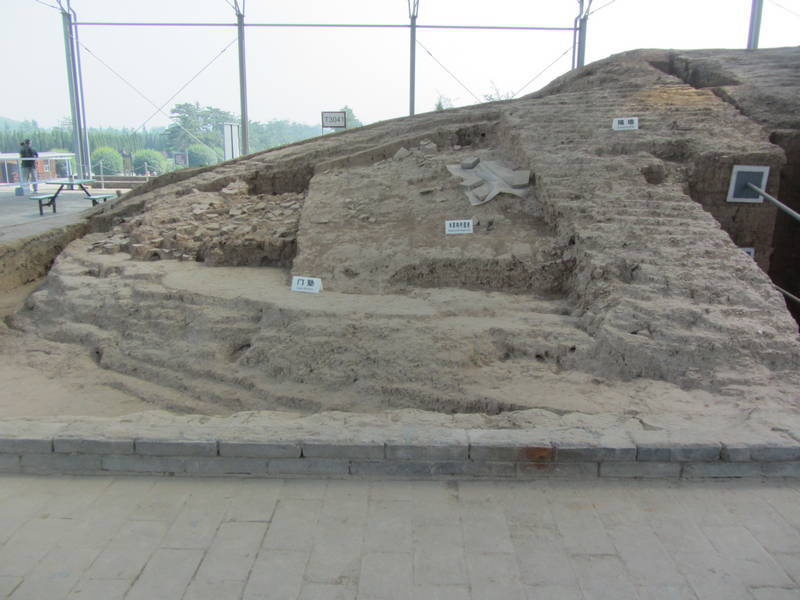
Another burial mound at the Jingdi site

Walking in our plastic booties on the Plexiglass floor above the tomb
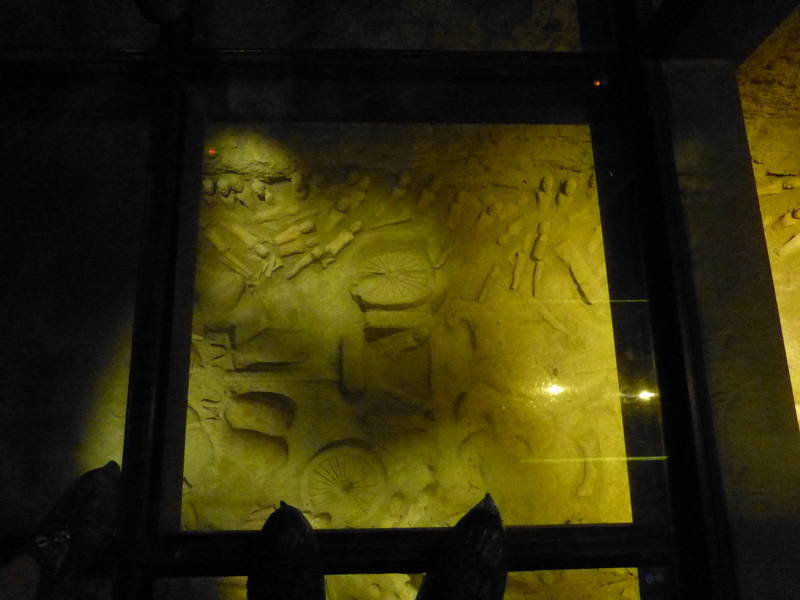
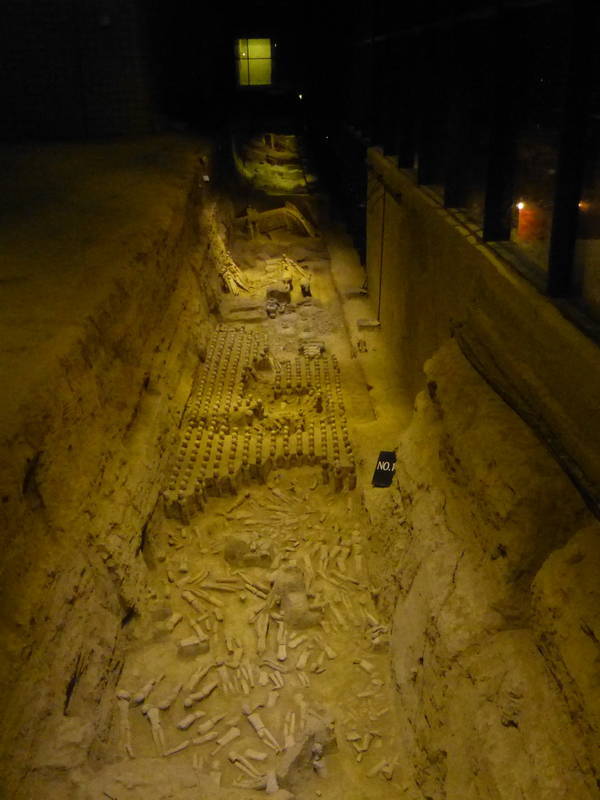
Emperor Jingdi's tomb had normal life scenes in addition to the usual warrior scenes

The site of the Army of the Terracotta Warriors was totally different. I've never seen so many tourist booths, restaurants and shops lining the walkway to a World Heritage site. We ran the gauntlet past hawkers calling out to us, trying to sell us anything they could - terracotta warrior fridge magnets, statues and old communist memorabilia. At the gate they would not let Frank in with his tour guide pass. So we visited the site on our own and it actually felt good to be free of the 'Frank and Geordie show' for a while. We were so giddy and giggling like schoolchildren at the thought of just going where we wanted to, at our own pace, at the one of the most important archeological finds in history. LP had suggested watching the introductory film and then seeing the pits in a certain order, pit 3 then 2 then 1, going from sort-of spectacular to semi-spectacular to super-spectacular. The film was in a theatre where we stood in the middle with a big 360 degree screen. It talked about Emperor Qin Shi Huang as the emperor who unified China two millennia ago. It also showed how the tomb was built and how the statues were made. The re-enactment of the discovery of the tomb in 1974 by some peasants who were digging a well in a field was very cool. Their digging revealed some terracotta pieces and after the site was partially excavated it was opened for public viewing soon afterwards.
Huge statue of Emperor Qin Shi Huang at the entrance to the Terracotta Warriors

The first pit contained a few statues of higher ranking officials and some horses, and the detail was amazing. The number of bows on a uniform indicated the rank. The second pit was mostly unexcavated with row upon row of mounds yet to be uncovered. But there were still a lot of warriors, including kneeling archers. Three archeologists were standing on top of a mound and lowering a weighted string down to measure depth. We approached the final pit with great anticipation. A huge crowd of tourists stood overlooking the pit and we peeked over top and around them to see the most amazing sight - 2000 terracotta warriors standing ready to defend their emperor. Each warrior was individually carved, with unique clothing and facial features. As people left we made our way to the front and the whole pit was laid out before us. Stunning. The enormity of it all was incredible. It is estimated that 6000 warriors are down there. We walked around the pit, looking at each other in amazement as we observed detail after detail in the warriors' hair styles, shoes, stance and armour. At one end we saw about 20 people sitting at tables with big lamps, attempting to put pieces of warriors together like a big jigsaw puzzle. We succumbed to the touts on the way out and now own a few little terracotta warrior statues and fridge magnets, great memories of a fantastic day. We were so excited by the amazing sights that we felt nothing could bring us down from this feeling of exhilaration. Stay tuned for the next chapter to see how long that lasts...
Excavation from Pit 3
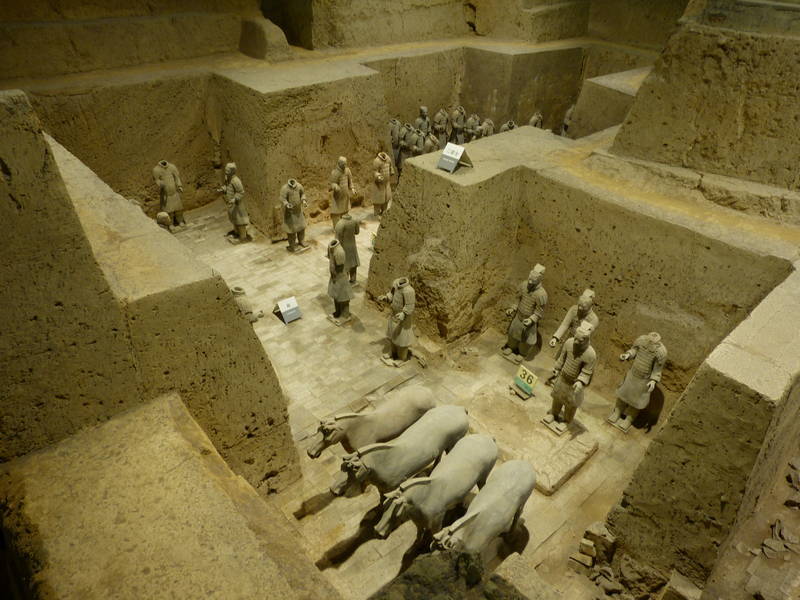
Archeologists working in Pit 2

Famous kneeling archer on display at Pit 2

We arrive at the amazing Pit 1
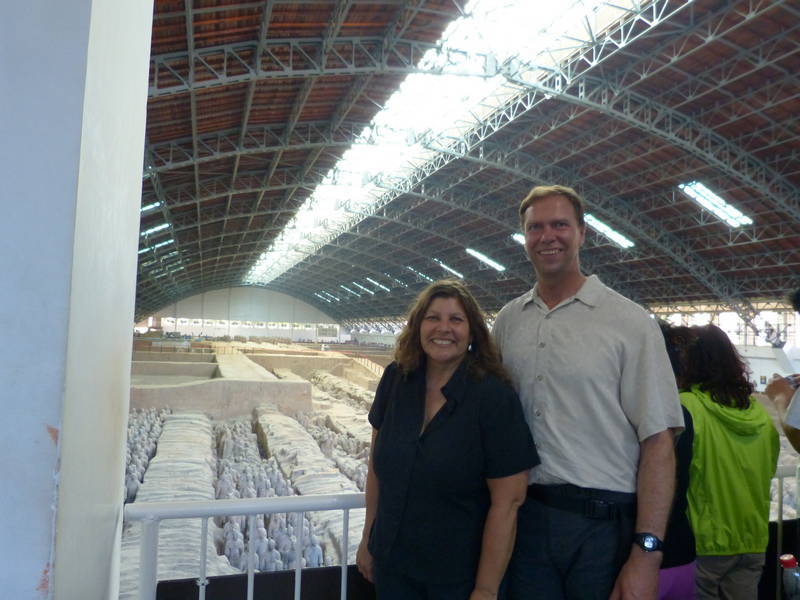
The sheer number is astonishing
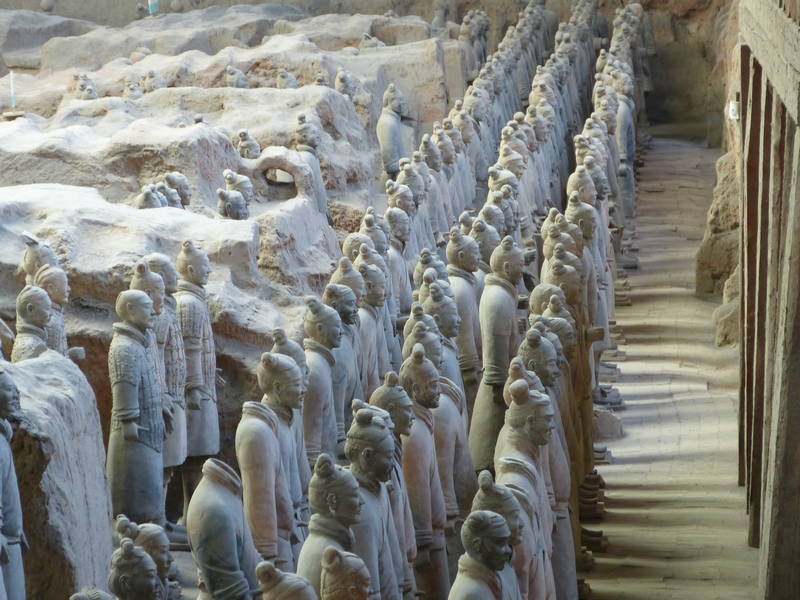
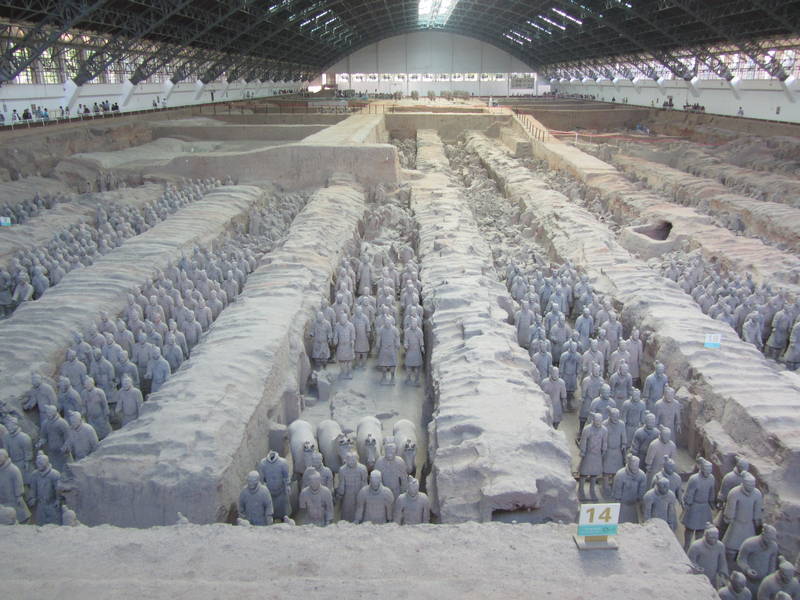
And the individual detail is amazing
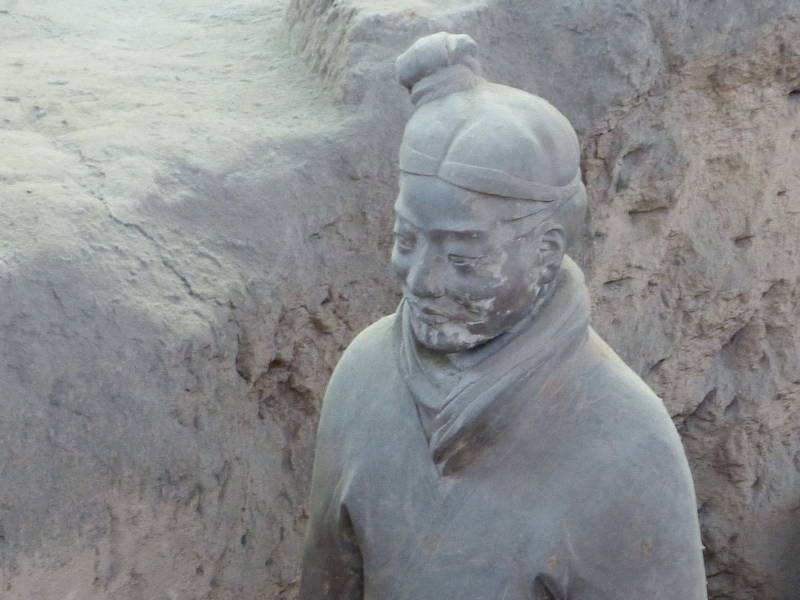

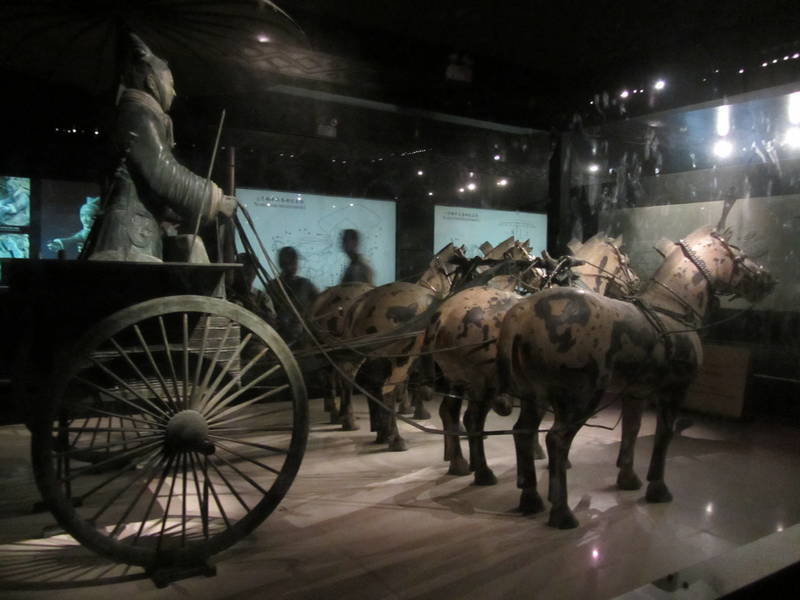
Map of our route to Xi'an

China continued to captivate, frustrate, enrapture and annoy. The Army of Terracotta Warriors and Emperor Jingdi's mausoleum had been stunning. This was why we travelled. All the frustration of the traffic craziness seemed to melt away when we looked into the eyes of a statue that had been buried for 2000 years, or saw locals break out into big grins when they saw us for the first time. We left the Xian area on September 20th and headed east. And yes, the traffic continued to be very frustratingly slow and congested, with our speeds averaging about 45 kph for the day. We knew it would be like this, so what was the problem? I think the big problem was that our tour company had planned way too many kilometres per day for us. When we originally looked at the itinerary, we were somewhat suspicious about the 400 kilometre days, but we rationalized it by saying that China Overland Tours were the experts and knew the roads and how traffic moved on the regular highways. Wrong. I don't know if either Geordie or Frank had travelled this route, and they didn't seem to have a sense of what to do if we happened upon an extraordinary situation, like a construction zone. Using their GPS often got them more lost than if they had used just plain common sense. We came upon a big barrier with a huge sign, obviously open for local traffic only and inevitably ended up doing a U-turn at the other end, wasting a lot of time. It would turn into a day of many U-turns. To us it was so obvious that we'd just have to find a detour or make something up, but going past a barrier would get us nowhere. So we had a chat with Frank, and suggested that we should go fewer kilometres each day. The really long days of sitting in traffic were getting to us. Hotel bookings needed to be changed or we would just have to find a place when we arrived at our destination. We came up with a plan and turned the next four days of our trip into five travel days, lowering the average number of kilometres for each day.
Leaving Xi'an
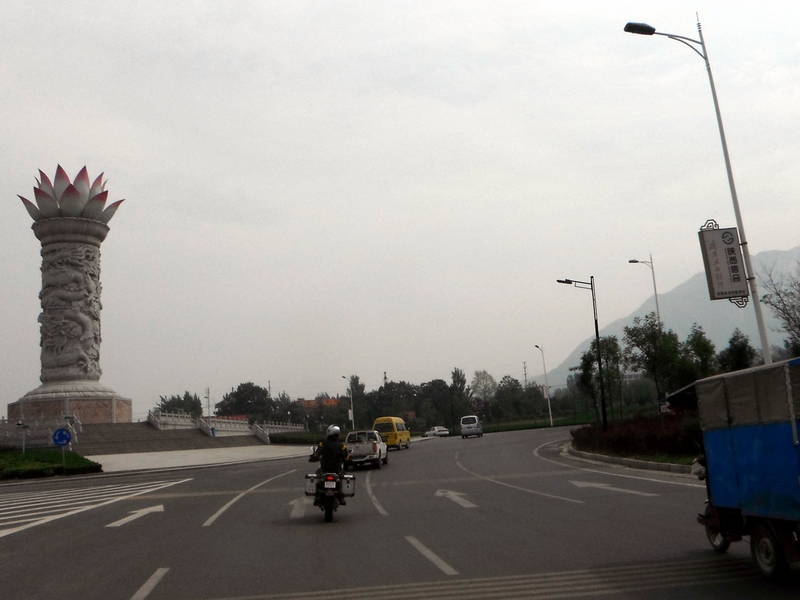
Bridge under construction

It was uncomfortable being on an unfinished bridge this high up
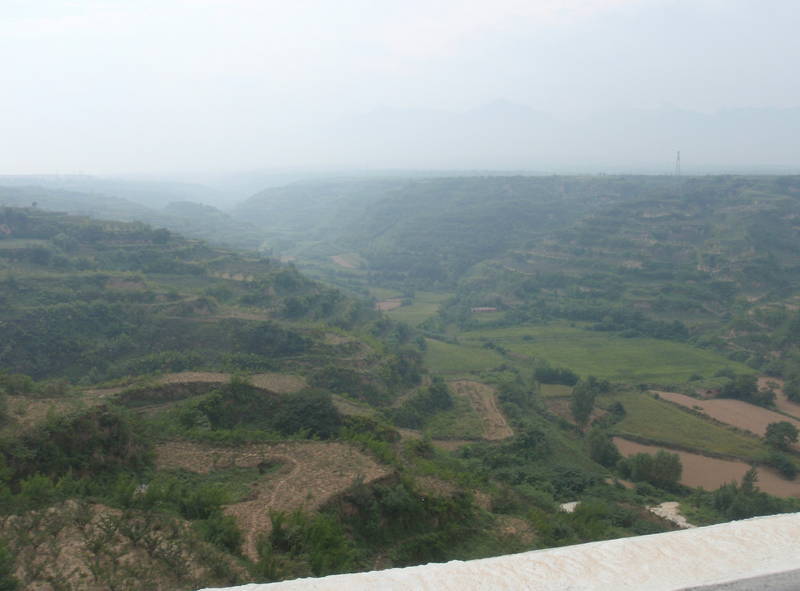
Communication problems continued. Lunch was delicious, but Frank ended up ordering seven dishes which was way too much food for four people, with three of the dishes going untouched. A bright point in our day was stopping at a small market. Ekke got us some fresh fruit and had a great time joking around with the locals, who were laughing at our lack of Chinese language skills. We had just let the truck go on without us. They would eventually notice we weren't behind them and stop or turn around. It was these times, without Frank or Geordie to do the talking for us that we loved, meeting the people on our own terms, trying to buy bananas or grapes and probably paying too much for them. It was also fun trying to explain our presence here, in their market town, on a couple of huge motorcycles from Canada. The locals' reaction to the bikes was always a lot of fun; their mouths wide open in shock. When we took our helmets off, revealing Ekke's fair features and the fact that I was female, their facial expressions were priceless.
Stopping at a local market
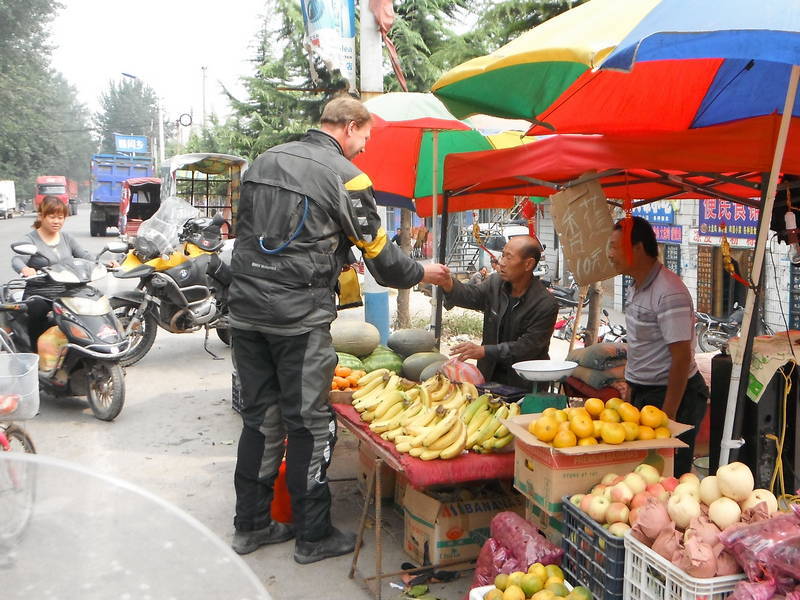
Sometimes it was just chaos at the construction sites

Each populated area seemed to run into the next populated area and it was like riding through one big town, the whole day. Pollution hung heavy in the air, and Frank told us that it would be like this all the way to Shanghai. Even with a shorter day we arrived at our destination, Xinan, at 6:20 pm, just as the sun was going down. Our only choice for accommodation was a government hotel (180 yuan or $28) because they were the only place in town that accepted foreign guests. So we took what we could get. The sweet and sour pork for supper did not disappoint.
Longmen Grottoes were only 40 kilometres away from Xinan but it took two hours to get there on September 21st. There were just so many vehicles like cars, scooters, semis, bicycles, bicycles pulling wagons, three-wheelers, three-wheelers pulling wagons. But it was worth the hassle. There were hundreds of caves, all containing Buddha and bodhisattva disciple statues, many of them hewn right out of the rock of the caves. We spent a couple of hours wandering around, climbing up hundreds of steps in our bulky motorcycle clothing to reach caves way up on the hillside. Many of the statues had been vandalized over the centuries, most recently during Mao's 'Cultural Revolution', but there were a lot that were completely intact. The Big Buddha was especially impressive. The ears alone were 1.9 metres high. Frank had been there before with his tour groups so he gave us a few facts about the place. He had never been to the other side of the Yi River but didn't think there was much to see over there. We insisted on crossing the bridge anyway and were stunned when we looked back at all the caves lining the hillside. The Big Buddha looked especially big from this vantage point, if a little washed out from the haze of pollution.
Longmen Caves

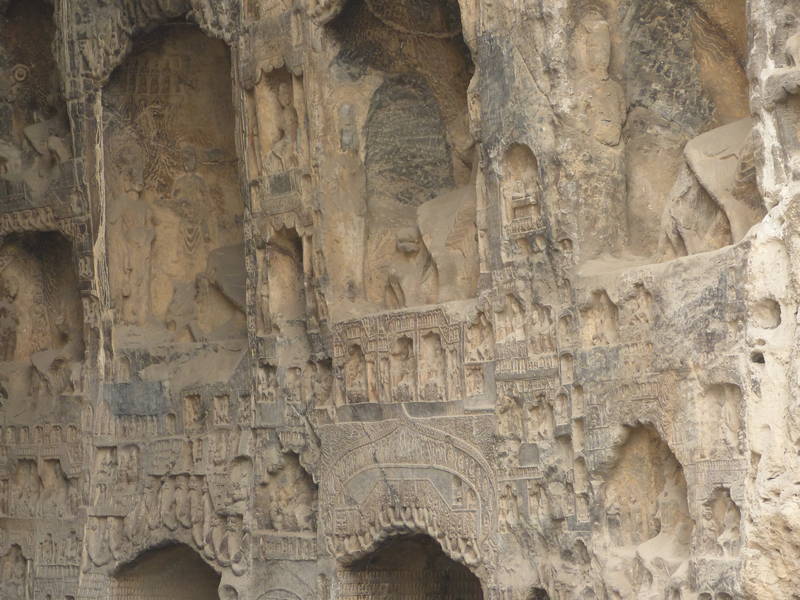
The ears alone on this statue stand 1.9 metres tall

From across the river one can really appreciate the scale of the enormous Buddha statue
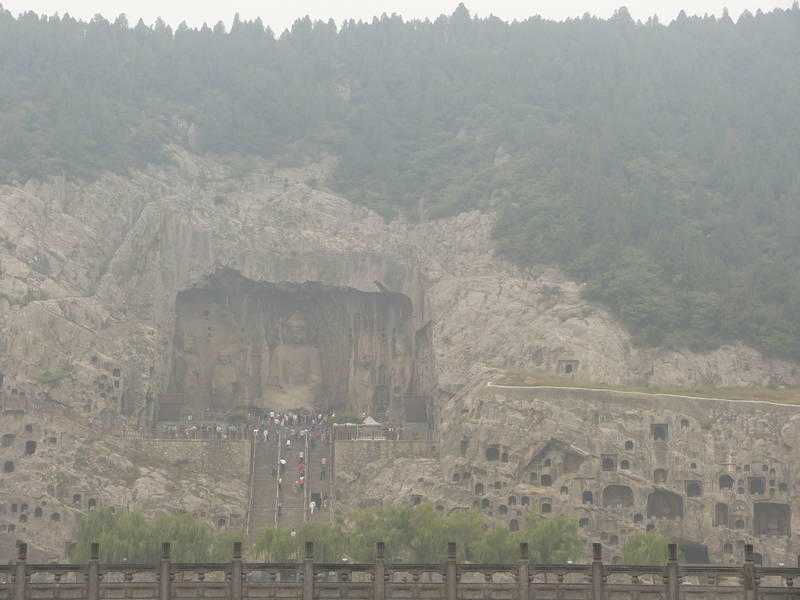
A cute train on wheels took us back to the tourist area where we saw a vendor stretching ginger toffee. Delicious. After a really expensive (tourist zone) lunch, 210 yuan or $33 we went back to the bikes. When I turned the ignition key, I heard a distinctive 'chirp' of my alarm system indicating that the bike had been moved into an upright position. Someone had sat on it. So much for Geordie watching the bikes for us. A security guard came over and pointed to my tire. It took a second or two to realize why he was pointing to it. There was a nail stuck in it. The tire was holding air as the nail was in a thick part of the tread. So after some discussion, we decided to pull the nail out just in case riding on it would push it further in, putting a hole in the tire tube. I held my breath as Ekke pulled out the 2 centimetre-long piece of metal with some vice grips. No air appeared to be escaping. Phew. And now I had a great souvenir of Longmen Caves.
Ginger toffee being pulled

A nail being pulled

Shaolin Monastery was our next destination, about 60 kilometres away, but traffic moved oddly quickly and we made it by 4:30 pm. The last entry into the facility was at 5:00 pm. Ekke and I just wandered around by ourselves as Frank's tour guide pass would not get him in. He and Geordie went back to buy their own tickets and we saw it as a great opportunity to go ahead on our own. The Shaolin complex was huge, housing several temples, training facilities and residences for Kung Fu enthusiasts. We hadn't had time to research the area, but we were pleasantly surprised with the World Heritage Site. This was where Jet Li had trained. Hundreds of young men, ages 8-18, were out in a field performing various exercises, guided by their instructors. There were a lot of visitors watching them, possibly proud parents getting a glimpse of what they were paying the big bucks to send their sons to.
Entrance to Shaolin Monastery
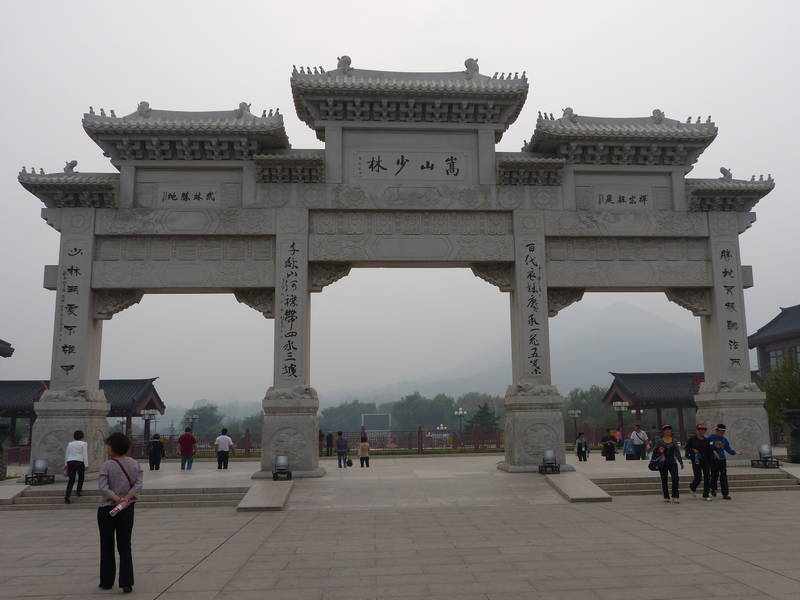
Huge excercise yard
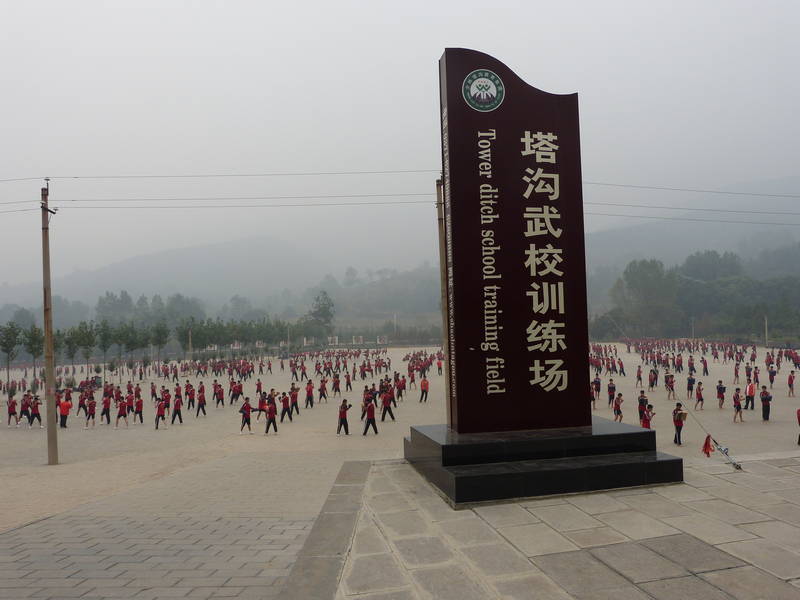
Practising their kicks

Ekke saw a queue forming up by a building which we thought was a temple. So, when you see a queue forming, you just join in, right? We had no idea what we were lined up for. Ropes delineated where to stand, so when a gentleman pushed passed us and got into line further ahead, it was obvious that we were getting 'budged'*. He waved to a couple of others to join him, so they pushed by us, too. I was a bit short-tempered after spending the day yelling at people trying to force me and my motorcycle off the road. So, here was a chance to confront a bully face-to-face. I called out to him and pointed behind me, saying that the line was back here. He snickered. So...I took a picture of him. In hindsight this was probably not the brightest thing to do but my cultural sensitivity meter was at an all-time low. Getting no response, I said, "Hey," and took another photo. I couldn't believe it when he started walking back towards me. Was I going to get pummelled? No. Thank goodness he just went to the back of the line, mumbling a sarcastic, "Goodbye" to me as he passed. I mumbled a sarcastic, "Xi-jen" (goodbye) to him in return, much to the delight of some ladies that had also been budged. Audrey: 1. Bully Budger: 0.
*'Budged' is the word for when an elementary-school student pushes in front of another student while standing in line. It may not be a real word.
So what had we been standing in line for? Well, we were ushered into a theatre with a stage at one end. Then we were treated to a spectacular display of Kung Fu mania, with several young men showing off their skills. There were the obvious high kicks and Kung Fu chops, all choreographed to music. A couple of stunts after that really amazed us. A pointed spear was placed on a Kung Fu-er's throat and he bent forward, bending the spear and it was amazing that he did not get pierced by the spear tip. A sheet of glass was brought out for the next stunt. A few audience members confirmed that it was real glass by touching it. An inflated balloon was held up on one side of the glass. The Kung Fu-er then got himself centred, took a deep breath, and with lightning speed, poked a hole in the glass and popped the balloon on the other side. The glass was held up and there was a little hole, about the size of a bullet hole, where his finger had gone through. Amazing. After the show we wandered through a gorgeous temple, bathed in a haze of burning incense. The grey-robed monks were going about their business, and it felt very spiritual with a bell gently gonging as the sun was going down. I was so excited about the whole experience that I shared a couple of stories with Frank when we met up later. He appeared bored with what I was saying, as usual, and went on to tell about his own temple experience. He was really bringing me down. He was definitely off my Christmas card list this year.
Kung Fu show
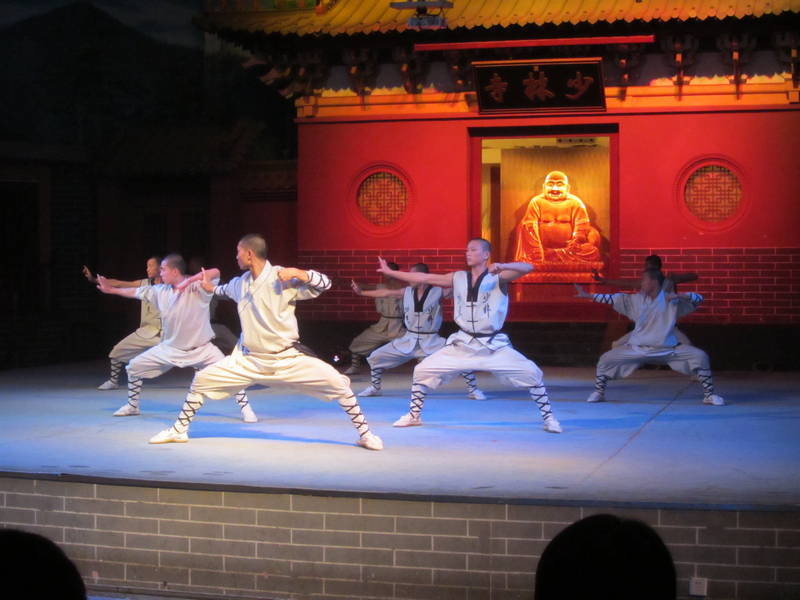
Popping a balloon through a plate of glass
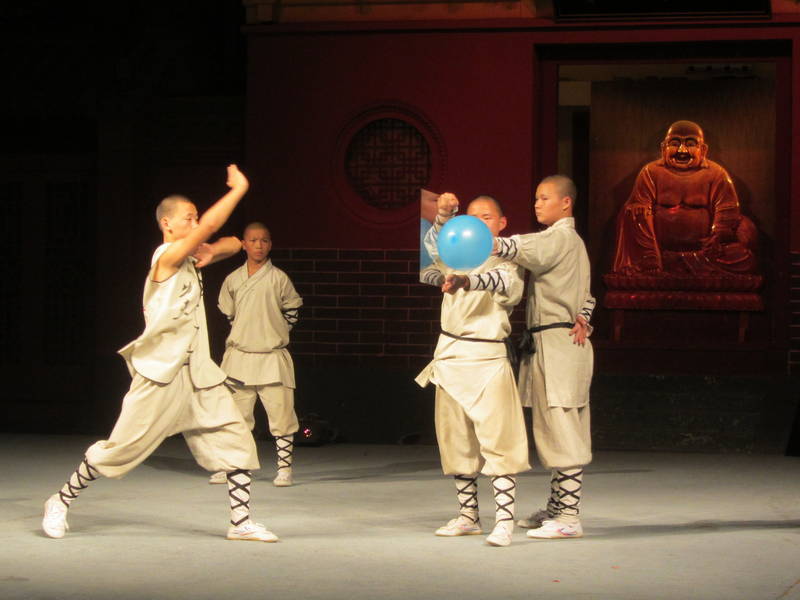
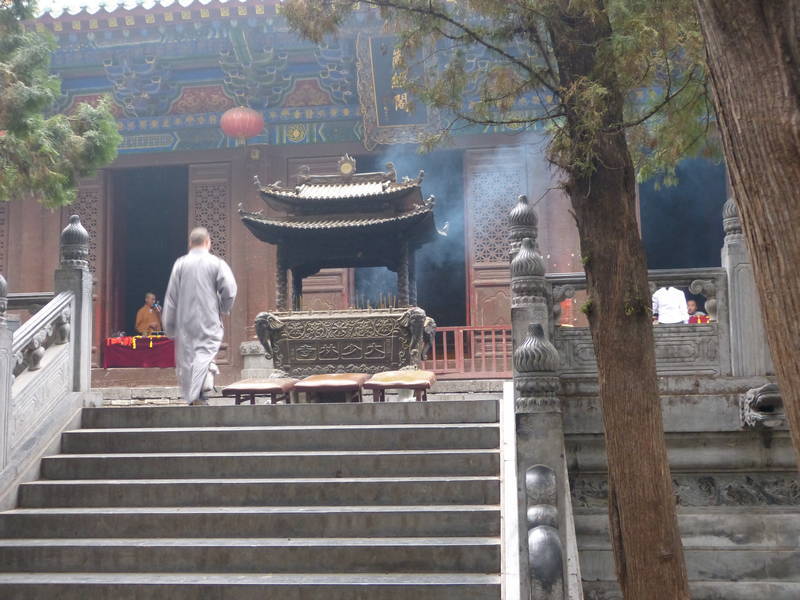
Good luck to rub the belly of the Buddha
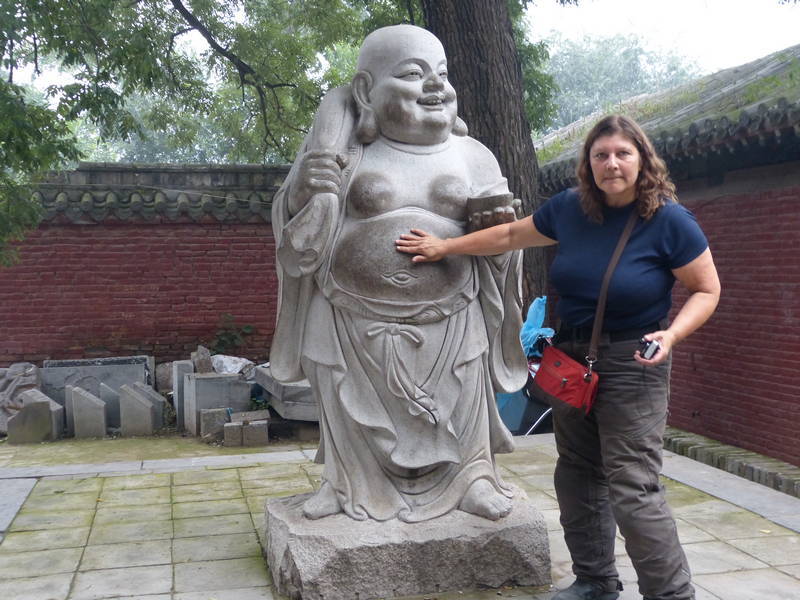
Frank and Geordie had found the most expensive hotel in town for us. They insisted that they could not find another one that would take foreign tourists, so we all had 4-star comfort that night for 418 yuan ($65) per room. But it was cool riding up to the posh drop-off area, jaws dropping all around. Ekke's always had this fantasy of riding his motorcycle up to valet parking and just tossing his keys to the attendant. This guy didn't look like he could ride a 1200 cc bike, though, so we just parked them ourselves. A security guard opened up a roped-off area for us right in front of the hotel, and we knew the bikes would be safe there. From our room we could see some boys dressed in Kung Fu gear doing calisthenics out in the parking lot. There must have been a training centre nearby. Free tickets for an evening performance were offered to us at hotel reception, so we quickly got ready to attend the 8:00 pm show. Frank had also scrambled for tickets from the front desk clerk when he saw we were getting them for free. But we didn't see him at the show. The performance was great, with orange-robed 'monks' displaying Kung Fu skills while telling about the history of the martial art, all in Mandarin. The highlight was when one of them put a bowl on his belly and had audience members come up and try to pull it off. A little boy 'monk' did the same stunt, this time getting picked up by the bowl, with the bowl remaining attached to his belly. We had to have a late supper (we had given Frank and Geordie 100 yuan to go find their own supper) and the restaurant staff seemed annoyed that we'd show up at 10 pm. So, we just got something quick, cheese balls and prawns. I guess they eat really early here.
Arriving at a posh hotel

Kung Fu show at the hotel

Cheese balls for a late dinner
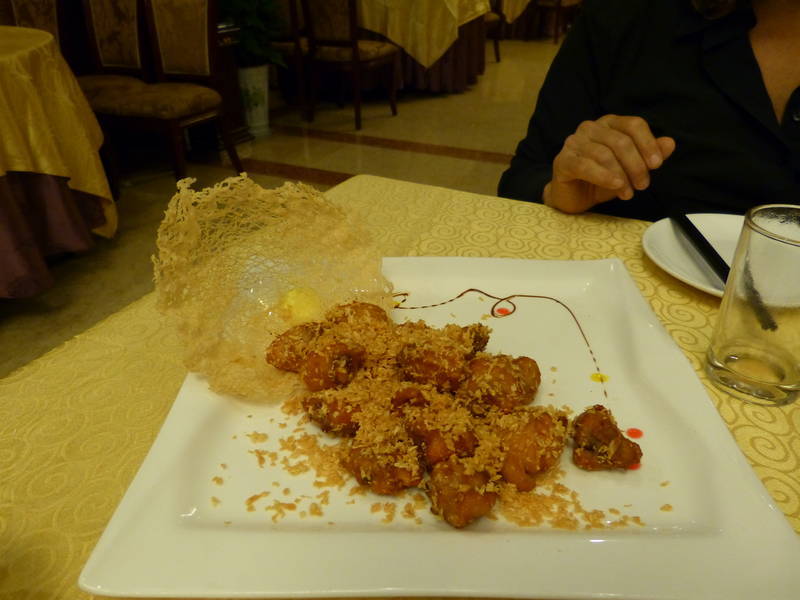
As we checked out of the hotel the next day, the front desk clerk asked me if we'd enjoyed our stay and if we'd visited the temple and where we were going. She seemed genuinely happy to talk to us, the total opposite of my 'favourite' tour guide, Frank. How refreshing to have someone show an interest in my thoughts and feelings about what I was experiencing. In front of the hotel, a crowd from a tour bus had formed around our bikes. A few English speakers chatted with us about our trip. An enthusiastic lady just came up to me, not even saying hello or anything, put her arm around me and got her husband to snap some pictures of us. We certainly were a curiosity wherever we went. Out on the road, the usual array of drivers trying to get into head-on collisions and side-swiping us greeted us all day. When we arrived at Kaifeng around lunchtime, the sun was shining brightly and we spotted a KFC for lunch near a lively market place. I also spotted a drugstore, which I had not been able to find in a very long time. The bikes were parked beside a scooter pathway when all of a sudden Ekke and I heard a crash. We then noticed that a man on a bicycle had lost his balance and fallen down, packages flying every which way. We ran towards him and helped him up, picking up his packages. Frank just stood by and watched.
Another hazy day greets us as the bikes wait for us in the roped off area
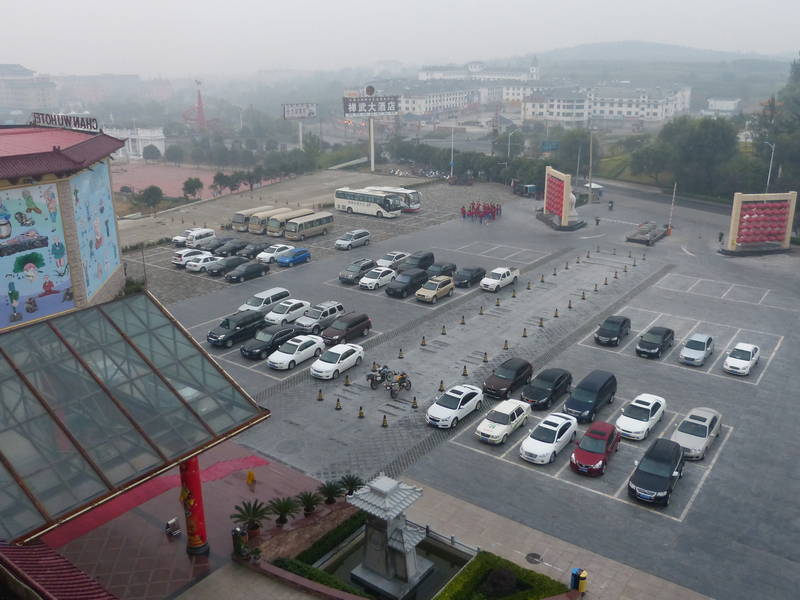
We received a couple of small stuffed bears from these two guys in Kaifeng (near the spot where the cyclist fell)

Further along in Kaifeng, Ekke and I were riding through a busy intersection, following the truck through a green light. Small vehicles often run the red light and try to sneak across the intersections, and today was no different. Usually we could slalom through these vehicles and Ekke did so between a scooter from the left, and a bicycle from the right. Hot on his heels, I just followed him into the fray, not able to swerve due to both vehicles coming at me from both sides. As I rode through, I felt a small tug on my rear saddlebag. I looked in my mirror and saw the bicyclist on the ground. OMG! You don't ever want to experience how I felt at that moment. Hitting a bicyclist in China was the last thing I wanted to do. I stopped my bike, put the sidestand down and ran back into the intersection. Traffic had stopped in all directions and there was already a crowd around the old man. I could see some blood on the bridge of his nose, so I ran to the bike, grabbed the first aid kit, and brought him a piece of gauze, instructing him to hold it on his nose, and found another piece for a cut on his hand. Somehow, I also produced a couple of Band-Aids. He just sat there. Ekke came over and eventually, Frank and Geordie. I told Frank we could offer to drive the man home, and throw the slightly damaged bike into the back of the truck. But then the police showed up. They got a statement from me, translated by Frank, and instructed me to move my bike to the side of the road. The man just sat there, and a student who spoke good English said the old man was telling the police that I ran a red light and ran into him. She offered to help us but I said we had a guide who spoke English. So, how would this all turn out? A crowd had gathered around my bike, and I was really hoping that the gentleman was okay. I just hoped Frank was getting the message across that he had run the red light. Eventually, the man was helped up, and ushered to a police car. We were asked to follow the car. On the way to the police station, we noticed several bicycles and scooters running red lights, right in front of us and the police car. I'm glad I didn't take out any of those.
An ugly crowd gathers

So, here I was at a Chinese police station, not exactly where I'd envisioned myself to be on my dream-tour to China. Frank assured me that they could just look at the video and confirm that I had the green light and that the man had run into the side of my bike. Video? At every intersection? Only in China I suppose. Anyway, the police officers were super congenial and seemed more interested in looking at our bikes than doing the paperwork for the accident. We stepped into the station office which had a desk and some wooden benches. The police chief got our Chinese licenses from Frank, and they had a bit of a discussion. Frank said that it would take a couple of days to get the video evidence, but if we paid the man for his injury and damage to his bicycle, we could just go. I was worried that if I paid the money, it would be like admitting guilt on my part. Frank said that it was the only way. I quickly saw that really, it was an easy 'out' for me and to just accept the deal. Thank goodness we had 500 yuan, or about $78.00 in our possession. I handed the money over to the old man while the police chief took a picture of the 'transaction'. I asked if we could take a photo, too. No problem. So, I took the money back and handed it over while Ekke took a picture. I told the old man that we weren't quite finished, that he owed me 2 yuan for the Band-Aids. The police laughed at my joke, thank goodness. We watched as the man got on his twisted bicycle and rode away. I suggested to Frank that we could still offer him a ride home. He said no way, explaining that perhaps the man's son would be there and demand more money from us. So, that was that. Except the police weren't through with us yet. We had to stand and pose for pictures with them in front of our bikes.
Paying off the injured cyclist at the police station
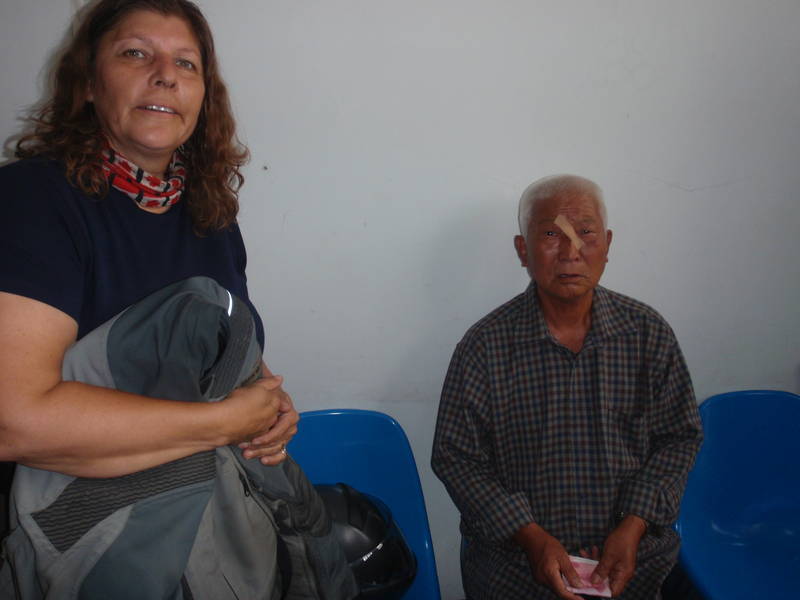
And then it's time for a photo op with the cops

So, I was super careful from then on and avoided riding too near anything smaller than me. When talking later, Frank said that when someone has an accident, like the bicyclist Ekke and I helped earlier that day, people don't rush to their assistance because the victim might say that it was the Good Samaritan's fault. So, if a cyclist runs into you in China, it is automatically your fault. Then the conspiracy theories started going through my head. Did the old man on the bicycle just put his head down and peddle faster when he saw us, running into the side of my motorcycle on purpose? We'll never know. I'm just glad he was okay. And the way Frank had handled the situation proved that he was useful to us at least in some small way. So, he was back on my Christmas card list.
Ekke writes:
Frank had informed us that because of the combination of the mid-Autumn Festival and the National Day holiday we needed to bring our bikes to the port in Shanghai a day earlier than planned and now our free day in Nanjing was lost. We had an early breakfast on Sunday, September 23 so that we could make as much distance as possible and then have the afternoon on Monday to explore Nanjing. At the bikes there was something a little odd and it took a moment to figure out what it was. The bike covers were inside out. Both of them. The chances that we both would have done that seemed awfully slim. Then we noticed that Audrey's alarm had been activated and I couldn't remove the U-lock from my front wheel because the bike had been moved. It was quite unsettling to have had the bikes tampered with so thoroughly. At least nothing was stolen.
A few random vehicles in China
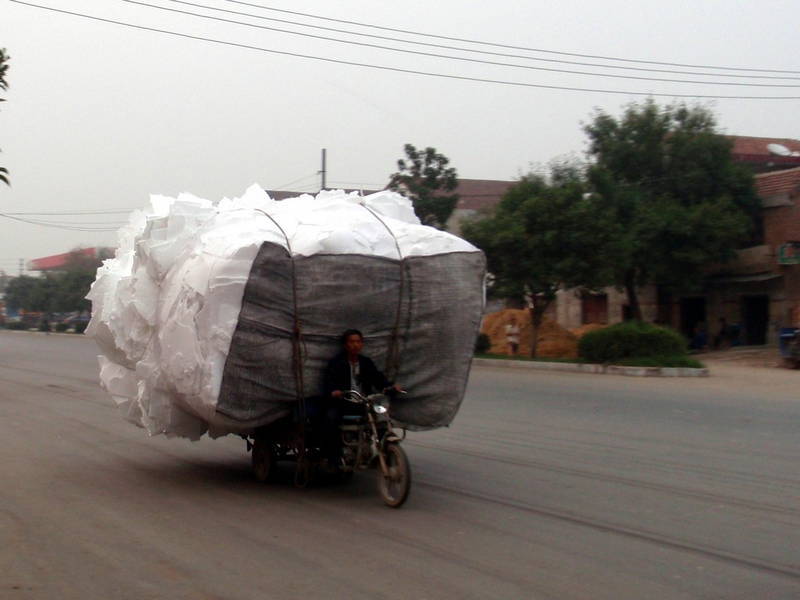
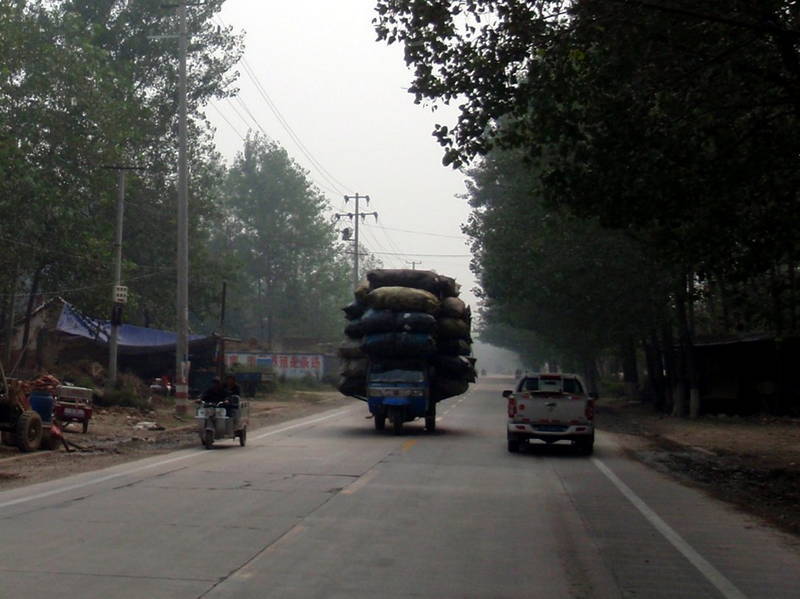

We packed up and got on the road. Traffic was even crazier today than in previous days as it seemed that everyone was out to run us off the road. Whenever we enter a new country we pride ourselves on being able to adapt to the different driving styles and then blending in. In China we found it difficult to determine the rules of behaviour. This day I developed a new theory and tested it. The theory was that as a driver if "I can't see you, I have the right of way." For example, if I were driving a three-wheeled scooter on the right shoulder of the highway I could simply turn left across the road anytime I wanted to because I couldn't see anyone behind me and therefore I had the right of way. Another example would be that when passing, as soon as the driver's door was past and the passed vehicle was no longer visible, the passing vehicle immediately had the right of way and could move back into the lane. Sure enough, the theory seemed to hold water. A huge dump truck blew through a red light while turning right and didn't look left so therefore would have had the right of way. A Honda CR-V provided the perfect test bed in heavy city traffic. The right lane was blocked and the Honda tried dropping back to change lanes but that didn't work so the driver scooted ahead until the driver's door was past me and I was no longer visible. Then he came into my lane. I guess by my new theory he would have had the right of way but I didn't really appreciate being sideswiped so I gave the door a swift kick. Now there is a CR-V driving around Southeastern China with a size 47 boot print on the door. He did pull back into his lane though. The scenery for this day wasn't terribly interesting as we rode through town after town with scattered farm land here and there on the flat land. After 380 kilometres Frank and Geordie found a halfway decent hotel in Mingguangshi. We paid them off for dinner and headed out on our own into town. They probably don't get a lot of Caucasian visitors in Mingguangshi and we got stared at even more than usual. It was actually kind of fun to watch people's expressions as they saw us and were startled by the freak show coming to town. We found a small fast food restaurant where I ordered something that looked like Nasi Goreng and Audrey had a skillet. The four or five young servers were enthralled to have us in their restaurant and peeked over the divider, watching us eat. They saw Audrey struggle with her chopsticks (a result of a volleyball injury many years ago) and then came over to show her a different way to hold them. It worked and now Audrey can use chopsticks! After dinner it was time for a photo session and there was no customer service while all the servers posed for photo after photo. It was a lot fun engaging with people directly rather than through Frank and everyone we met was so friendly.
At least motorcycles don't have to pay the tolls
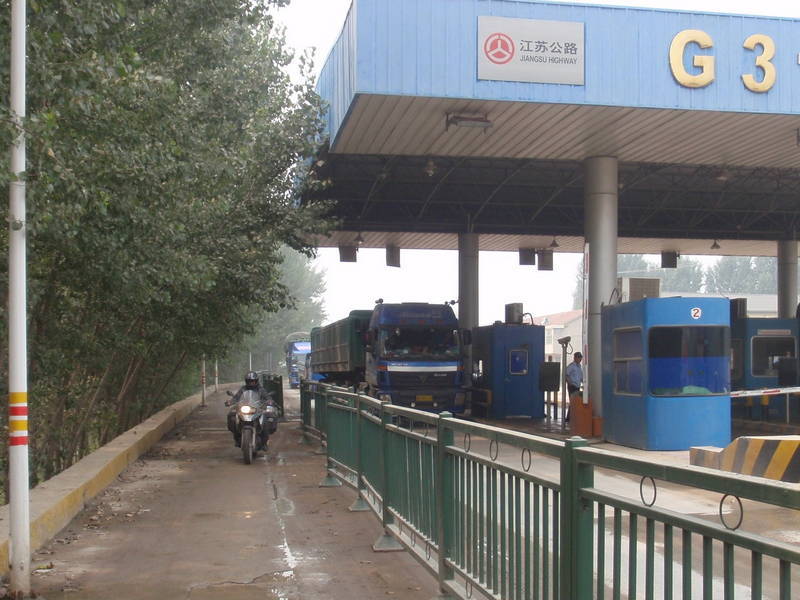
Grain being dried beside the road and any other open space

Apartment buildings under construction everywhere we went

Our super friendly wait staff
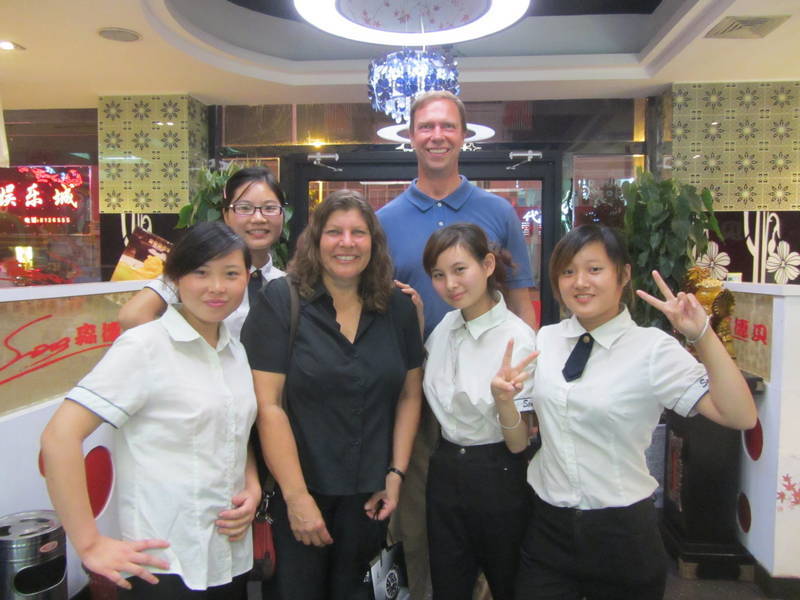
On Monday we only had to ride 140 kilometres to Nanjing so that we could do some sightseeing in the afternoon. When we get closer to Nanjing the traffic became much more aggressive, with faster drivers. Suddenly a Cadillac CTS bolted up the right lane, trying to get ahead of a few cars in the heavy traffic. As the right lane was blocked the driver weaved back into the centre lane, narrowly missing Audrey. He did that another time and then, in frustration, hit the gas to shoot ahead of me. As he was beside me he suddenly veered into my lane, coming between me and Geordie's truck, with only millimetres to spare from taking me out. The realisation that he could easily have killed us both got my blood boiling. At the next signal light, when I saw him at the head of the line, I squeezed through the traffic and pulled up beside him. When he rolled down the passenger side window I unleashed a blue streak of swearing that I didn't think I had in me. He responded with a blank, questioning stare and he honestly didn't seem to have a clue as to why I was upset. In the midst of this, the driver of a VW Passat came up and started yelling at me. I guessed that he was upset because I may have clipped his car on the way to the Cadillac. Audrey also came up between the lines of traffic and gave the Caddy a kick on the rear bumper for good measure just as the light turned green. The Caddy took off and I hit the gas too, leaving the Passat driver standing in the middle of the road, but I didn't pursue the Cadillac. A few hundred metres up the road Audrey and I pulled over to let Geordie catch up in the truck and then we tucked in behind him. At a roundabout the Passat driver was standing beside his car and motioned for us to pull over. I shook my head, "No", and we continued towards the centre of Nanjing.
Crossing the Yangtze River as we enter Nanjing

A couple of more close calls had our nerves completely frayed and I pulled up beside the truck to ask Frank to take us to the closest hotel immediately. They must have looked on the GPS because only a few blocks further Geordie pulled over onto a parking space beside the sidewalk and Frank jumped out to what might be a hotel. While we were waiting for Frank to return, the driver of the Passat pulled up. Uh oh. He started accusing me of scratching his car to which I responded by pointing at my bike which didn't have a mark on it. When Frank came out he was able to translate what the VW driver was saying and we went back to his car. Sure enough, there was a small scratch on his right, rear fender at about the same height as my saddlebag. He wanted 100 yuan to repair the damage. $16 seemed pretty reasonable and, trying not to show my relief, I paid the man. It must be said that while we weren't terribly happy with Geordie's driving and navigating nor with Frank's tour guiding they both stood up for us in this situation and in the situation involving the cyclist. I'm not sure what the results would have been if they weren't as aggressive in defending us.
After chilling out in the hotel room for a little while, we met Frank for lunch in the hotel restaurant. He ordered a "lunch for three" and the food started piling up on the table. Maybe it was lunch for thirteen. Then an entire fish showed up. The fish alone could have fed eight people. Audrey started to choke on a tiny chicken bone, having to induce vomiting to clear her throat. It was starting to feel like Nanjing was out to kill us today. Still, we weren't going to let this ruin our short time in Nanjing. Since we had to bring the bikes to the port in Shanghai a day earlier than scheduled we had lost the full day we had planned for Nanjing and so needed to see at least something in the afternoon. We got in the truck and drove to Dr. Sun's mausoleum. Dr. Sun is considered the father of modern China; he played an instrumental role in overthrowing the Qin dynasty and served as president of the Provisional Republic of China when it was founded. It would be an honour to visit his mausoleum. While Geordie waited with the truck in the parking lot the three of us started to climb the hill to the mausoleum, preparing for the 392-step stairway. We were surprised that there was no entrance fee as we had read in Lonely Planet that there was a charge but Frank assured us it was indeed free. It turned out it was free on this day because the mausoleum is closed on Mondays. We turned back at the closed gate, looking wistfully at the stairs that we could have climbed. On an area map near the mausoleum it looked like the Ming tomb was quite close so we proposed walking over there. Frank thought it was too far and suggested taking a trolley. Back down by the parking lot and at the trolley station Frank found out that the trolley would cost 200 yuan. Since it was so expensive and Frank said that it was too far to walk we decided to abandon visiting the Ming tomb and take the truck back to the hotel, stopping off at the wall in the centre of town so that we could walk around lovely Nanjing. That plan went out the window as Geordie missed the wall and we drove straight past it back to the hotel instead. We consoled ourselves with a walk to MacDonald's for a Big Mac. Later we found out that the Ming tomb is actually within easy walking distance from Dr. Sun's mausoleum and that according to "www.china.org.cn" the tomb, "Looking grand and magnificent, it represents the greatest attainment of architecture and stone-engraving art, having a great impact on subsequent emperors' tombs scattered in Beijing, Hubei, Liaoning and Hebei in the following 500 years." Drat.
Entrance to Dr. Sun's Mausoleum
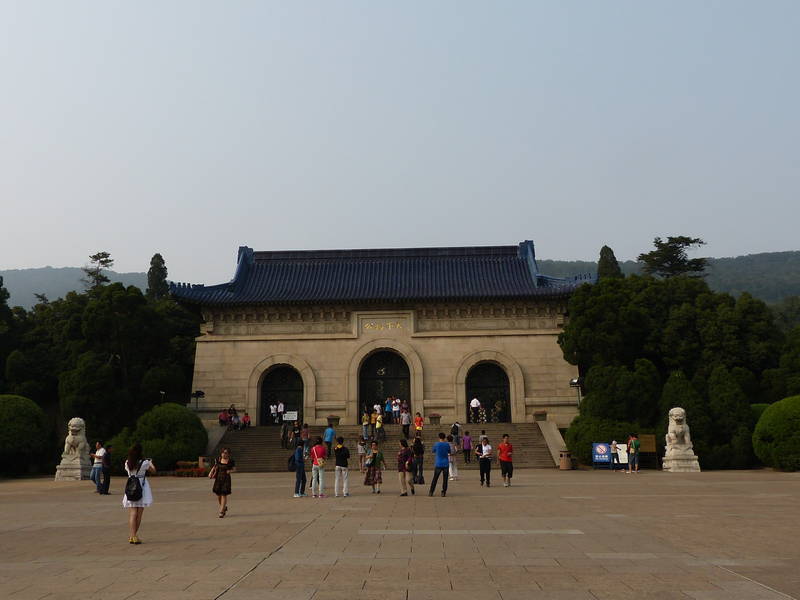
And another photo op

Tuesday, the 25th we rode mostly good highways to Suzhou with nice bypasses of Wuxi and Changzhou that were signed for "No Motorcycles" but for some reason Geordie led us there anyway. It was good looking down from the expressway onto the congested streets. It got to be a bit aggravating though when Geordie would insist on driving 70 kilometres per hour even though the speed limit was 100 kph and then driving in the left lane. Trucks would come up behind us and then move to the right lane to pass, making us feel like sitting ducks. Was he doing this in response to yesterday's nightmare traffic in Nanjing? On a wide open four lane divided road we were riding along at 70 kph when all of a sudden a Honda CR-V (what is it with CR-Vs?) entered the highway from the centre median behind the truck and just metres in front of us. The median was obscured by bushes so there was no warning of the vehicle's entrance and we needed to take emergency evasive manoeuvres in order to avoid slamming into the back of it. That certainly got the adrenaline flowing. A little later Geordie blew through a red light. What were we supposed to do? With trucks bearing down on us from behind we paused only slightly and then went through as well. No-one honked or did anything else untoward, almost as if it was perfectly normal for people to drive through red lights. Then, just to make our day more complete, Geordie missed a turn from the expressway. Rather than going down the road a little ways and pulling over, he stopped in the middle of the road, right next to the off ramp, cutting off a tractor-trailer and nearly getting us killed yet again. For someone who was supposed to have lots of experience guiding motorcycles through China he certainly didn't seem to understand our needs very well. Our main need at this point seemed to be survival.
On the way to Shanghai

Apartment buildings under construction, what a building boom
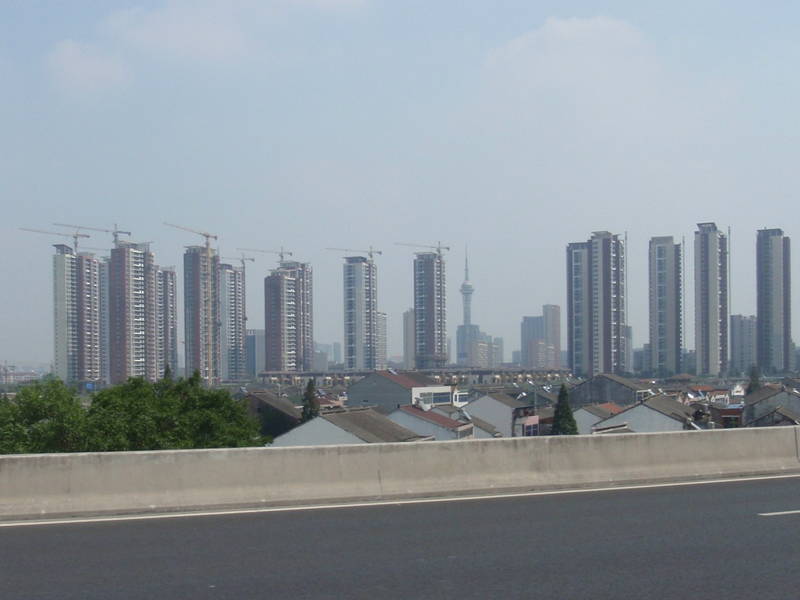
Thankfully we did make it to Suzhou in one piece and even though it took a while, we found a hotel near the Administrator's Garden. By this time we really needed some time away from Frank and Geordie so we gave them a hundred yuan for dinner and headed off to visit the gardens. The gardens were really beautiful and there were lots of people there enjoying them. Unfortunately Frank and Geordie were there too. Just the people we were trying to get away from for a while. After an hour or so wandering the lovely gardens we walked down the street to the Suzhou museum. We missed the last entry by five minutes so decided to walk to the old town, where the canals were supposed to be beautiful. The hotel had given us a map of the city with their hotel marked on the map as well some of the sights, like the Administrator's Garden and old town. We followed the map in what we thought was the right direction but it didn't seem quite right. Eventually we found a couple of street names and located ourselves on the map and walked in the right direction. It turned out that the staff hadn't marked the hotel's location correctly. We found Mei Mei selling silk near a pedestrian mall. She was great to deal with, explaining the differences between the various grades. We felt that this was the perfect place to buy silk as Suzhou was really known for its silk and was the beginning (or, depending on your point of view, end) of the Silk Road. What we really enjoyed though was being able to deal with people directly instead of going through Frank. Later that evening Frank phoned our room and mentioned that we needed to pay for the shipping of the bikes from Shanghai to Japan. He had forgotten to mention this to us when he had been told in Beijing. Apparently we wouldn't be leaving Suzhou until we paid.
Parking the bikes on the sidewalk in front of the Hanting Express Hotel
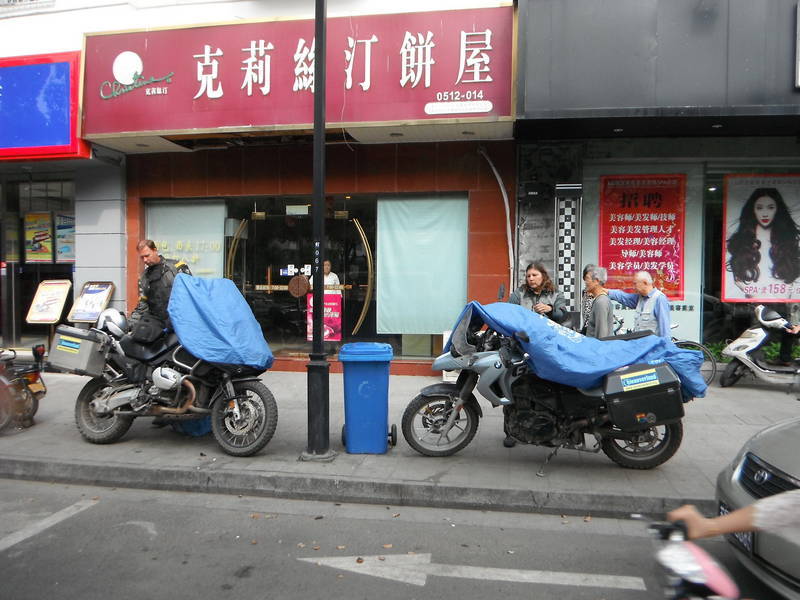
At the Humble Administrator's Garden
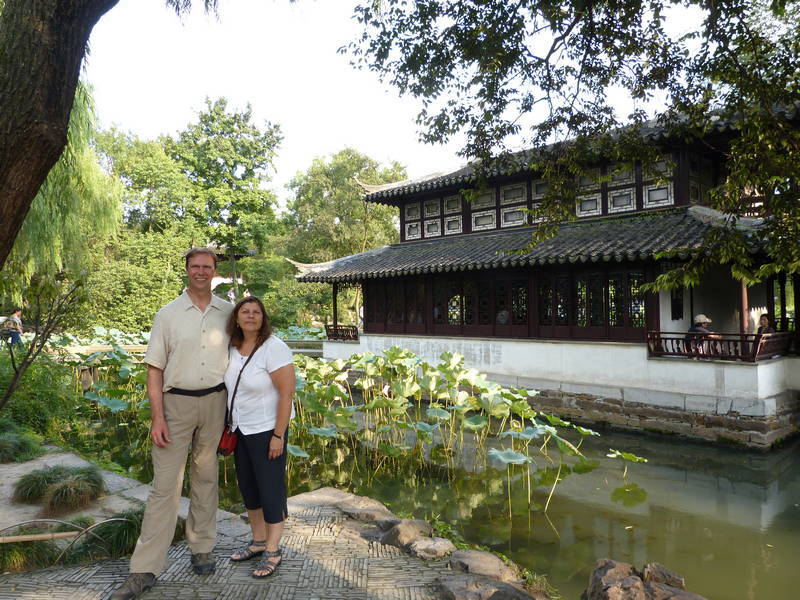


Parents waiting for their children after school

A lovely evening in Suzhou
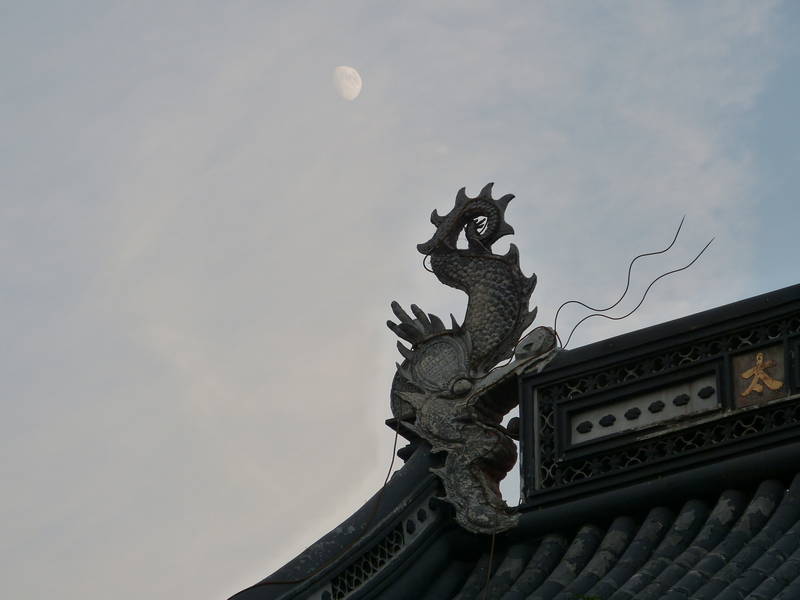
Mei Mei's silk shop
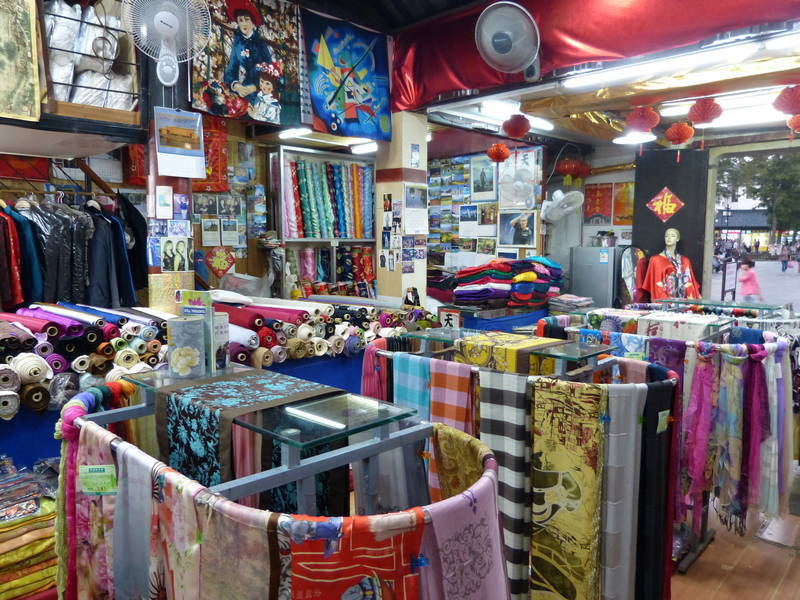
Beautiful canals in Suzhou

Wednesday morning we walked over to the Beisi Pagoda where we climbed up to the 9th floor for great views of Suzhou. One of the highlights of Suzhou for us though was a visit to the silk museum across the street from the pagoda. It was fascinating to see how silk was manufactured and woven. We had read that there were live silk worms at the museum but we couldn't find them. There was a small portion of the museum where a plastic mannequin was tending plastic silk worms in a diorama display but other than that we couldn't find any real silk worms. We asked one of the staff about the live worms and he motioned for us to follow him out to the yard. There he plucked a leaf from a mulberry tree (the only food that silk worms eat) and then went to the diorama. He tossed the leaf onto the tray where the mannequin was tending the plastic silk worms and all of a sudden the "plastic" worms started moving and munching on the leaf! How cool was that? Walking back to the hotel we stopped off at an ATM to withdraw as much cash as we could. We paid Frank U.S. $500 plus 7,000 yuan and then hand printed a receipt for him to sign so that we had proof of payment. After paying Frank sprung another surprise on us. Rather than going to the hotel in Shanghai that was close to the Suzhou side and dropping the bikes off at the port on Thursday morning we were now going to ride straight to the port clear on the other side of Shanghai to drop off the bikes this afternoon. We had planned to prep the bikes for shipment at the hotel, including making sure that we didn't have too much fuel in them. Then as an extra surprise he told us that nothing could be kept on the bikes. This was despite us asking him that exact question a week prior, at which time he had responded by saying that it was OK to leave all of our camping equipment on the bikes. Now we had to ride around a city of 20 million people and then strip our luggage off the bikes in the afternoon. Ugh. We did a quick walk through some nearby shops to see if we could find some duffle bags to put our stuff into but came up empty handed. We would just have to throw it all into the back of the truck.
Entering the Beisi Pagoda
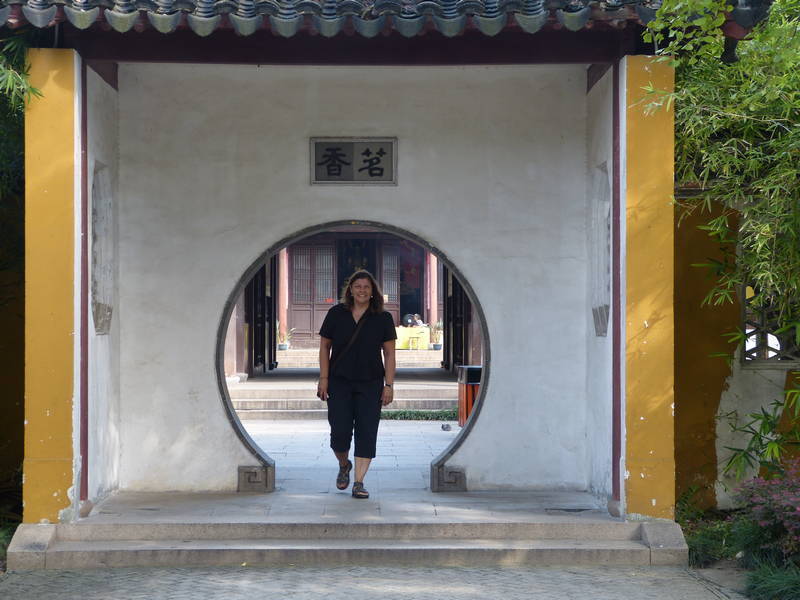
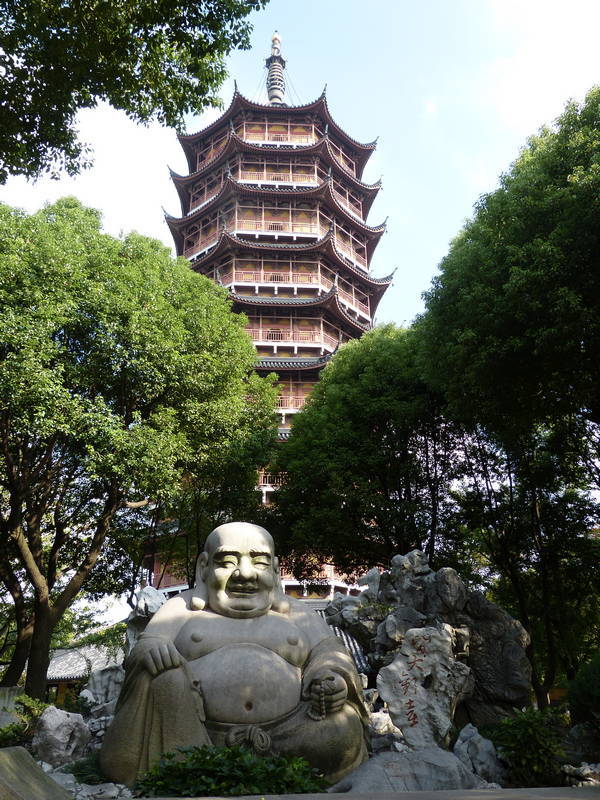
Lovely views from the 9th floor of the pagoda
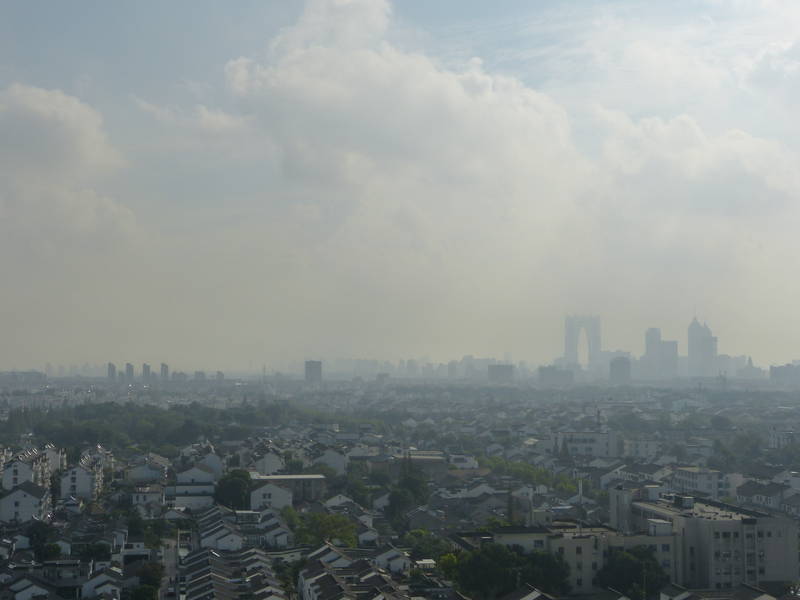
The Silk Museum
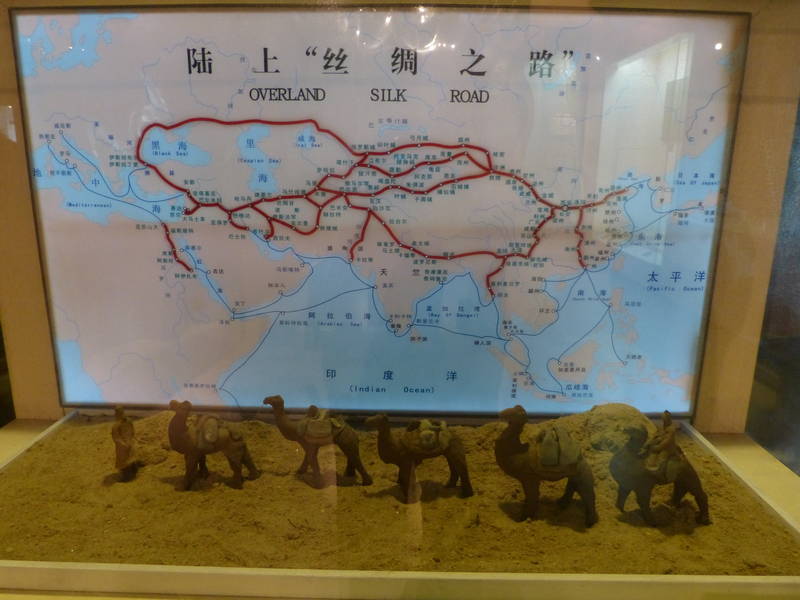
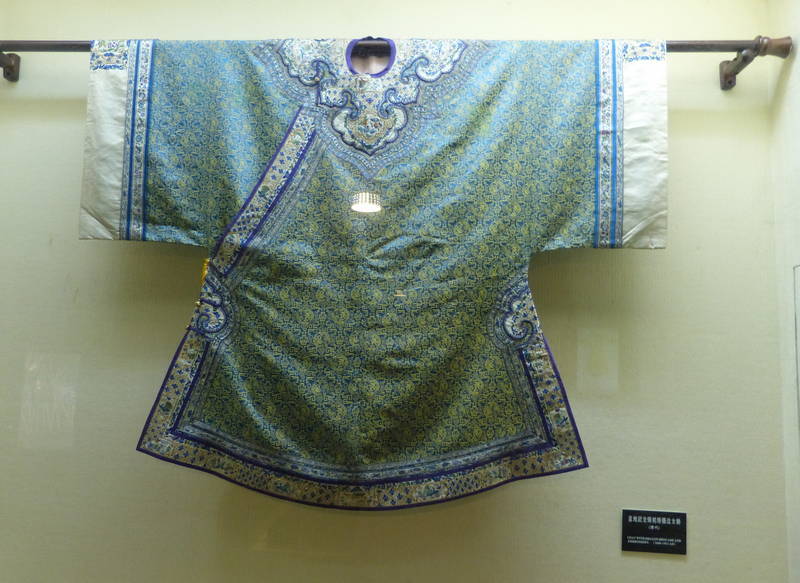
Mannequin and plastic silk worms

The world's ugliest cat guards the cocoons
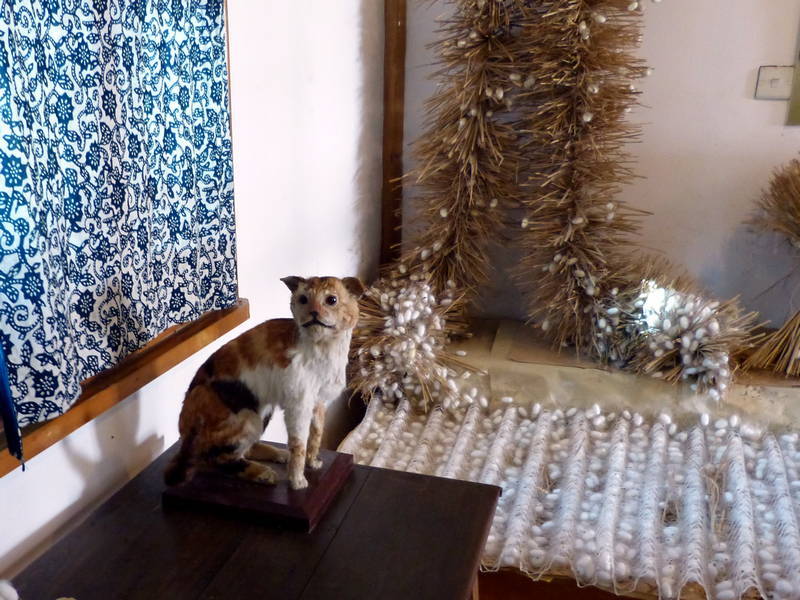
It takes two to operate this loom

Hey, those aren't plastic silk worms!
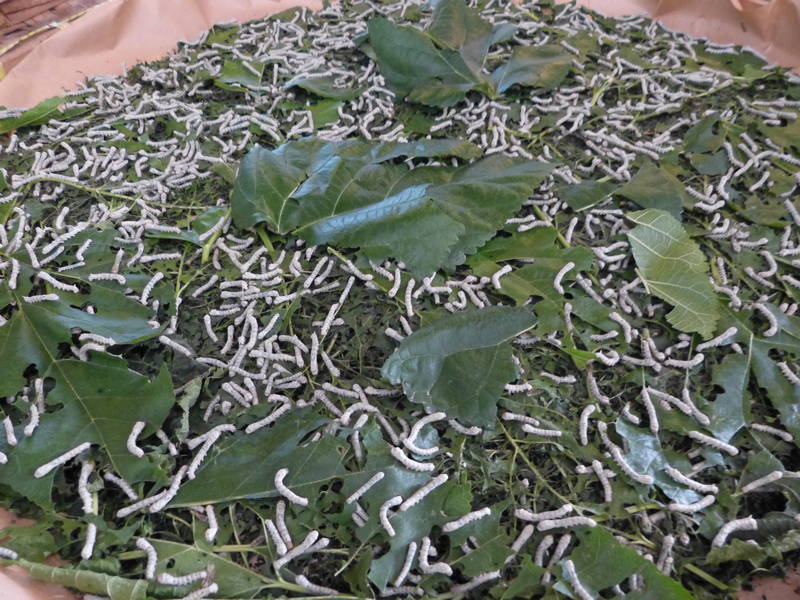
They're real
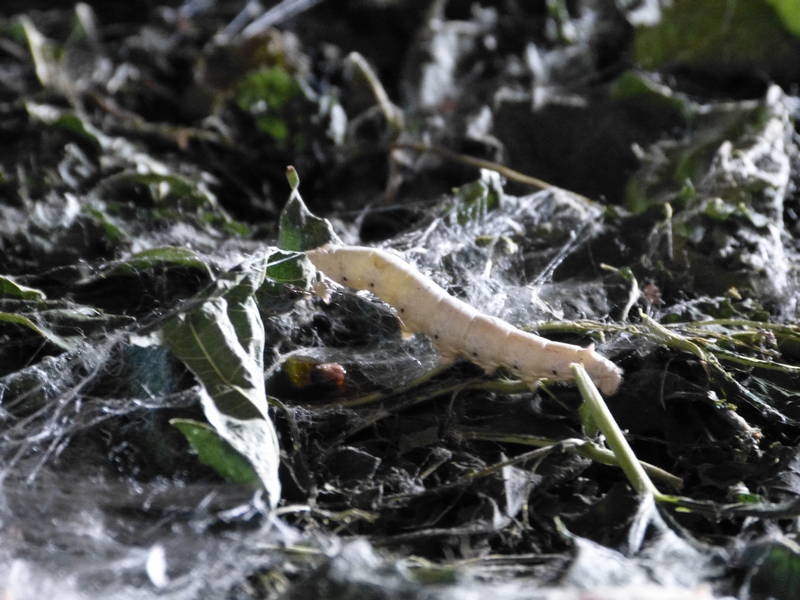
The canals of Suzhou in the morning

Riding from Suzhou to the outskirts of Shanghai was slow going with lots of traffic lights. Then as we got closer, the traffic really bogged down to a crawl. On my GPS I could see that there was a ring road around Shanghai and I was quite hopeful that things would speed up once we were on that. The hopes were dashed as traffic came to a standstill on the eight-lane divided highway. We were surrounded by idling trucks and because we were stuck behind Geordie's truck we couldn't split lanes. Then Audrey mentioned that she was running low on fuel. Right, we were planning to siphon some gas from the big Adventure tank to the F650 at the hotel. The trip computer on the F650 showed that we would just be able to make it to the port with a couple of kilometres to spare. Then the congested traffic caused the fuel economy to get worse. The countdown between distance to go to the port and distance to empty got closer and closer. Eventually it became apparent that we couldn't make it to the port without transferring some fuel. We hoped that we could do that as soon as we could get off the ring road where it would be safe to pull over. The trip computer started counting down in single digits and we were still on the highway, surrounded by slow moving trucks. We got some relief when the congestion eased up a bit and soon we were moving along at 80 kph but by now the trip computer showed zero kilometres left. Just then we entered a tunnel. No shoulder and surrounded by fast moving tractor-trailers in the dark. If the bike ran out of fuel here we would in all likelihood be run over. When daylight appeared we started moving over to the right shoulder and then a sign for a gas station appeared. Saved, we pulled into the station and heaved a huge sigh of relief. Wow, that was close. Since we weren't allowed to have too much fuel on the bikes we wanted to empty the Adventure rather than adding fuel to the F650 from the gas station. Using a siphon we had carried along for just this purpose we pumped a litre into the F650 from the Adventure and then rode the rest of the way to the port. After a few formalities we entered the complex and rode over to the shipping agent's warehouse facility. All the paperwork for leaving China was handled by the tour company so we busied ourselves with preparing our bikes for shipment. This entailed emptying our saddlebags and removing any other bags from the bikes and tossing all of our gear into the back of Geordie's dusty pickup truck. We then rode over to our container and waited for the paperwork and customs inspection to be completed. It was unnerving to have enormous forklifts zooming around carrying tractor-trailer size containers over our heads to say the least. The shipping company brought over a couple of people to strap the bikes into the container and then the doors were closed and a seal placed on the lock. We hoped we would be reunited with our bikes soon in Japan.
Riding to Shanghai
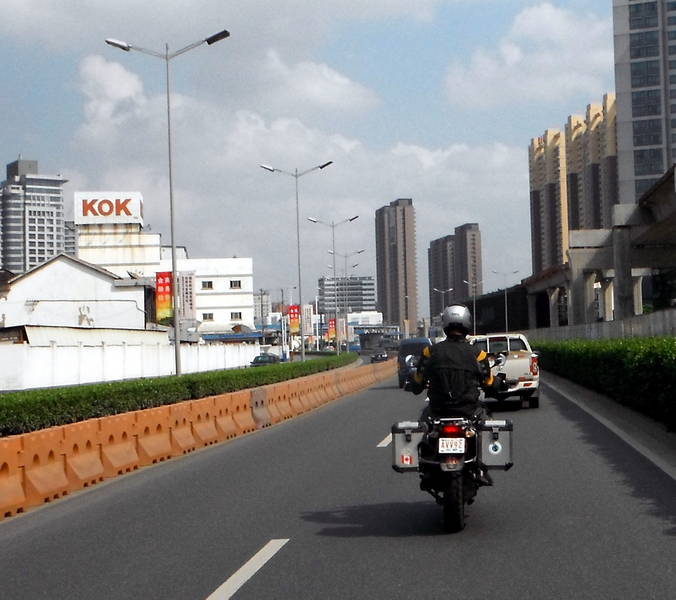
Stuck in truck traffic

Looks like congestion will ease up ahead
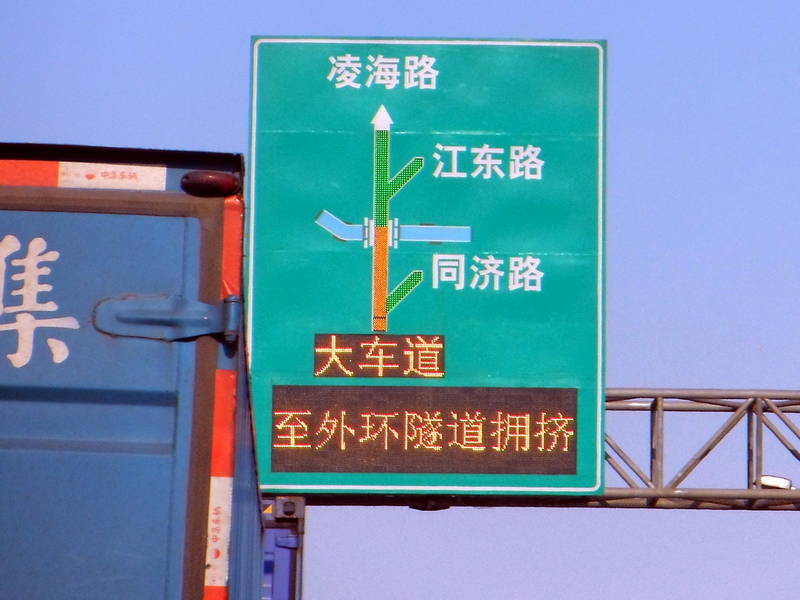
Fork lifts with enormous containers whizzing around
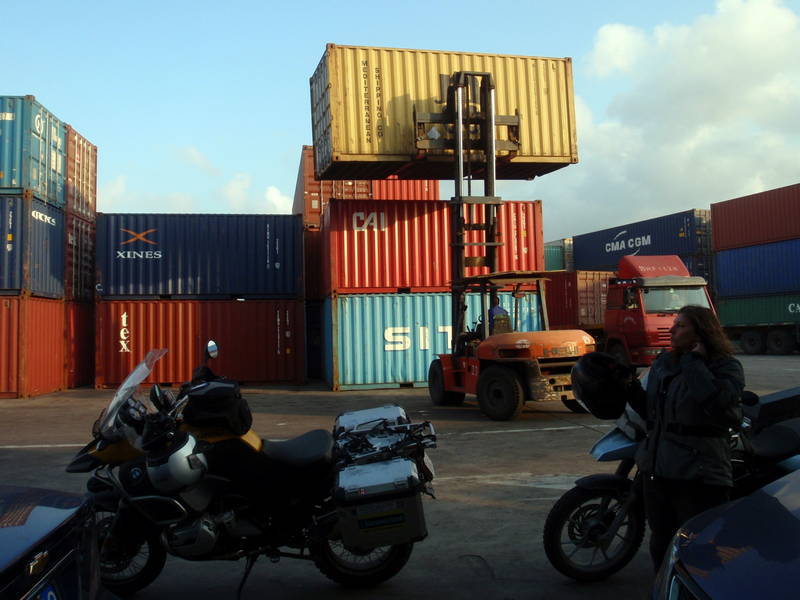
Strapping the bikes down in the container
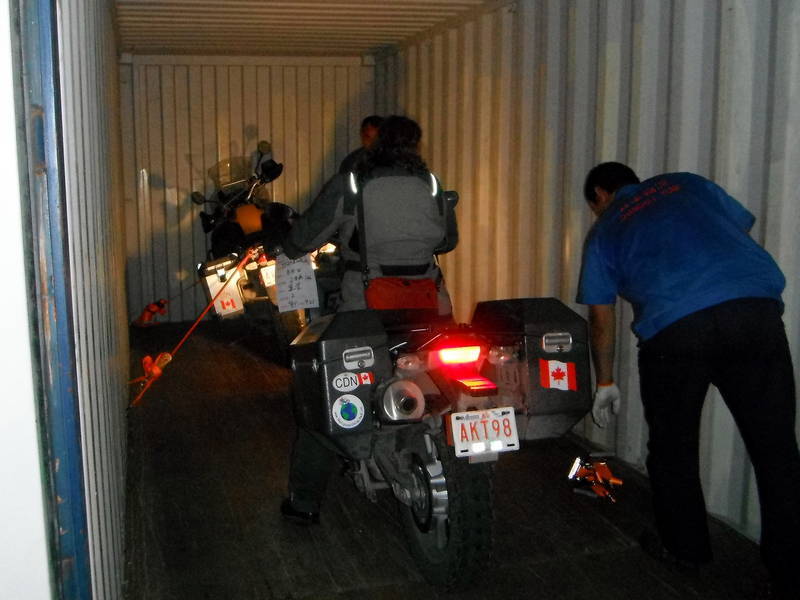
Sealed up and ready to go to Japan
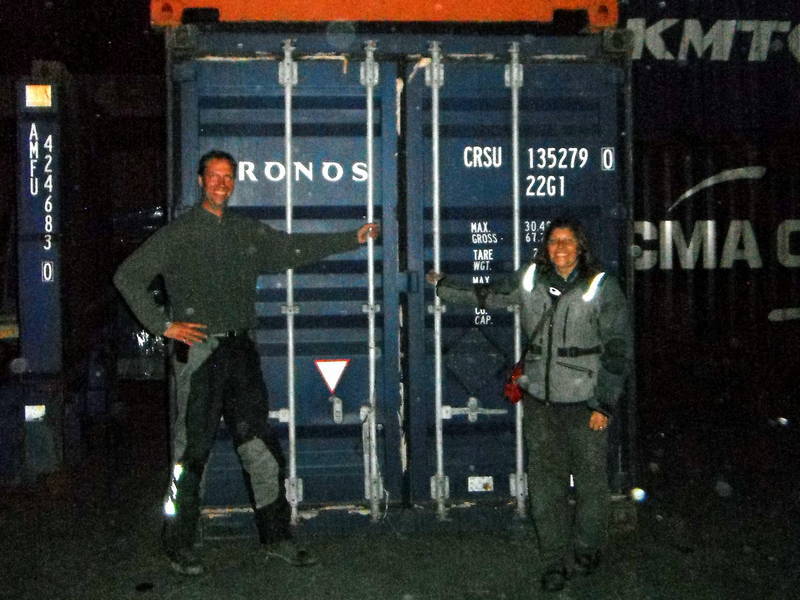
We piled into the truck and Geordie drove us to a nearby Ibis hotel where we then took all of our gear and lugged it up to our room. It took several trips. We were completely exhausted by the stress of the day so were happy when Frank said that he and Geordie would not be joining us for dinner. Instead they were meeting with his manager from China Overland. Since we wouldn't be seeing Frank and Geordie again we then had an awkward moment of deciding whether to tip them and if so, how much. While their service was actually quite poor we really did appreciated how they had stood up for us during the Kaifeng and Nanjing incidents. In the end we did give them a tip but as there really wasn't much precedent for us we had no idea whether we gave them far too much or not enough. In any case, this was the end of the Frank and Geordie show so we celebrated our newfound freedom by going to a local Chinese restaurant around the corner from the hotel. Later that evening Frank called to let us know that the shipping company needed an address and phone number in Japan. We booked a hotel in Fukuoka, Japan on Expedia and then I trotted downstairs to give it to him. Now we were truly free.
After the breakfast buffet we started to organise some of the pile of stuff we had pulled from our bikes. We needed to figure out a way of getting it all on the plane to Japan. So we jumped on the metro to a Carrefour department store and found some cheap, extra-large shopping bags. What a pleasure it was to ride the metro, so much less stressful than riding in traffic. Back at the Ibis we went across the street to the Crowne Plaza hotel for a special dinner. There we found that the special was New Zealand cuisine, with New Zealand meals and even New Zealand water. After our two and a half weeks of riding in China we were ready for a break. Maybe this was some kind of sign? Wouldn't riding in New Zealand be nice? We could spend a couple of months in New Zealand and then fly to South America to ride back home. It was certainly an interesting idea and it had appeal after this rather stressful time. We decided to file that thought away until after we were in Japan to see if our travel batteries could be recharged. We had options and the world was our oyster.
Picked up duffle bags at Carrefour and checked out the rice cookers
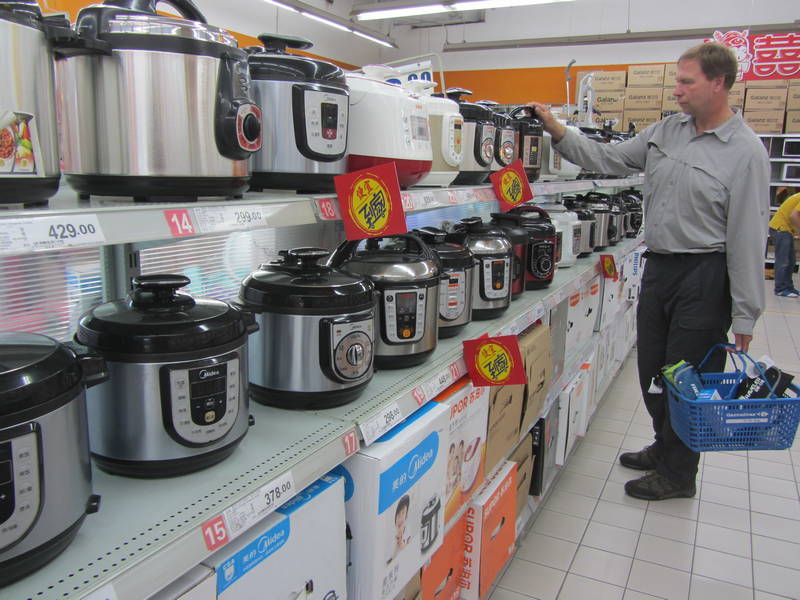
Hmmm, New Zealand? Wouldn't that be nice...
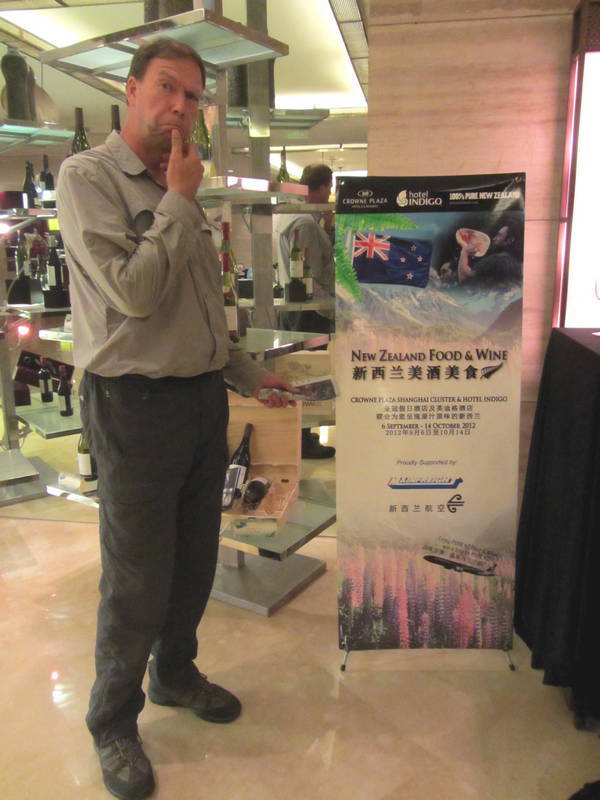
On Friday we moved to a new hotel, one that was more central for sightseeing and a bit more comfortable to spread out in. On the recommendation of a colleague from work we had booked the New Harbour Service Apartment Hotel. We had managed to stuff everything (camping gear, cooking gear, motorcycle clothing, helmets) into the four super-sized shopping bags in addition to our regular luggage and now dragged it all downstairs. A taxi was parked on the adjacent street so I showed him the address for the New Harbour but he simply shook his head "No". I took the address back inside to the front desk clerk and he translated it into Chinese. This also didn't work so then I asked the desk clerk to come out and explain to the cab driver what we wanted. After the clerk and the driver had a chat the clerk went back inside and retrieved more information about the address. Now we were good to go and the driver of the VW Santana lost no time in getting up to warp speed. I don't believe that there are any Chinese F1 drivers but this guy could have applied. We arrived safely at the hotel and after checking in we crossed our fingers as we opened the door to our home for the next week. Would it be like the other four-star hotels we had spent time in? No, it was beautiful, clean and spacious. Thanks Carie! After going shopping at the nearby Tesco and a bakery we had lunch (a Nutella sandwich, yummy) and then I decided to give my motorcycle jacket a wash. Considering how dirty our faces and hands were after a day of riding in China I imagined my jacket would be filthy. I wasn't wrong. At the first rinse I could stick my index finger into the tub of water and lose sight of the fingertip when the first knuckle was at the water line. Black, black, black. It took several washes to get to a point where the rinse water was reasonably clean. We had been breathing the same air that this jacket was passing through. What must our lungs look like?
Audrey washes her jacket
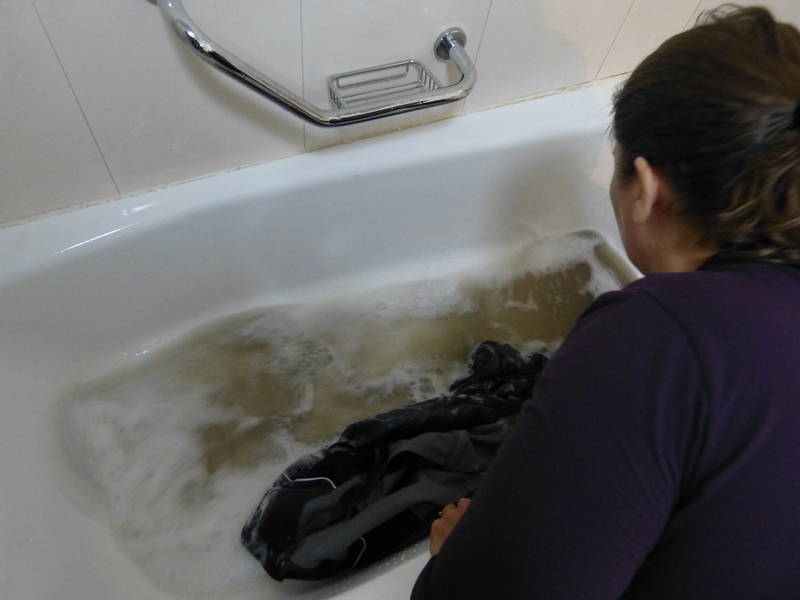
Over the next four days we worked on the Mongolia chapter of the website and did a lot of sightseeing. The Bund was a waterfront boardwalk with spectacular views of the ultra-modern Pudong district and Nanjing Street was an ultra-crowded pedestrian mall. Both were within easy walking distance of the New Harbour and we went first during the day and then again in the evening. The evening walk was incredibly crowded. Was everyone from Shanghai out enjoying the lovely evening? We were still objects of curiosity, even though there were other foreigners about, and had our pictures taken fairly regularly. The Shanghai Museum had interesting permanent exhibits but it was the temporary exhibit that really caught our attention. On loan from the Armoury in Moscow were all kinds of precious artefacts, including four Faberge eggs. My favourite, commemorating the Trans-Siberian Railway, was there and it was much easier to get up close to it than it had been at the Armoury a couple of months ago. We came back to it again just to marvel at the intricate construction. The Shanghai Urban Planning Museum was interesting not only for its historical displays but perhaps even more for its future plans in a giant model that showed the city with a few buildings that didn't exist yet. Since we had so much luggage it wouldn't be possible to take public transit to the airport on October 3 so we decided to ride the MagLev train to the airport and back just for fun. What an experience to ride along at 430 kilometres per hour. As the MagLev runs at that top speed for only a few hours per day we were lucky to experience the 430 kph ride to the airport and then the 300 kph (same as the Bullet Trains in Japan) ride back. 300 actually felt slow.
Pudong from the Bund
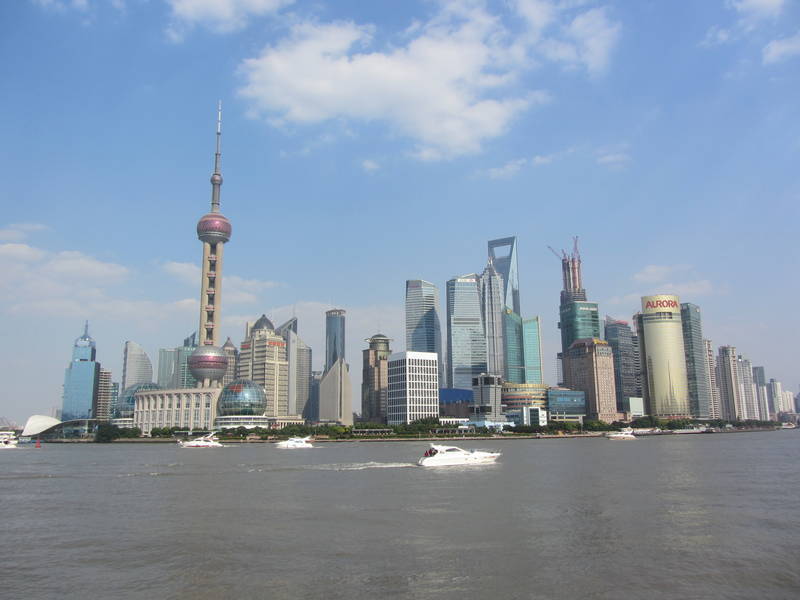
Another photo op
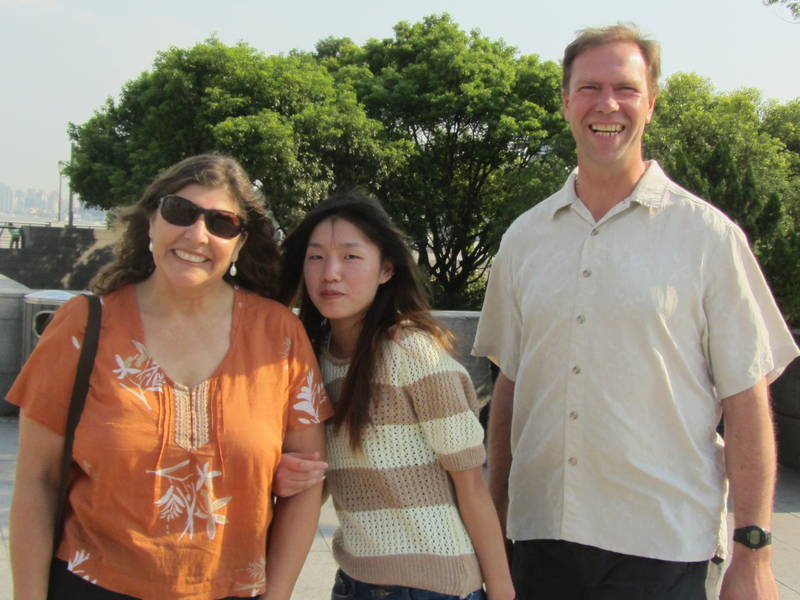
Busy Nanjing Street pedestrian mall

Audrey takes a break in People's Park
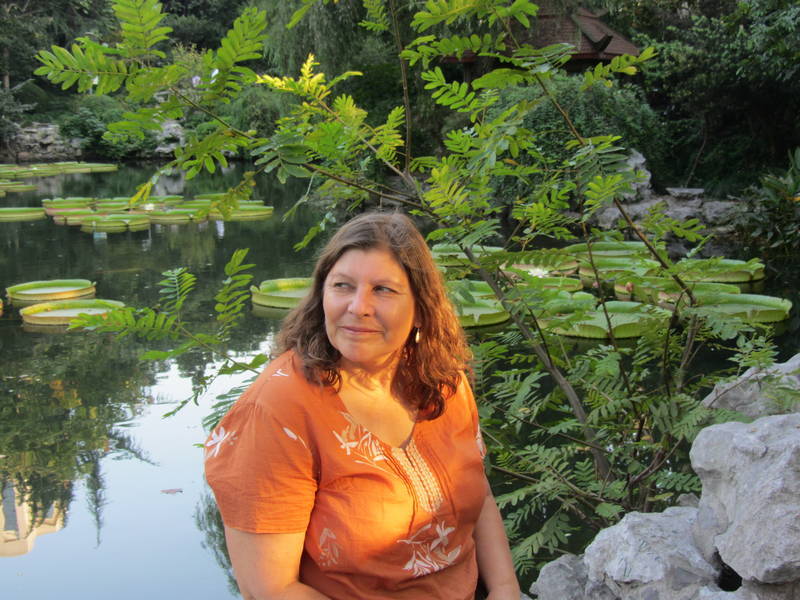
This could end badly in People's Park...
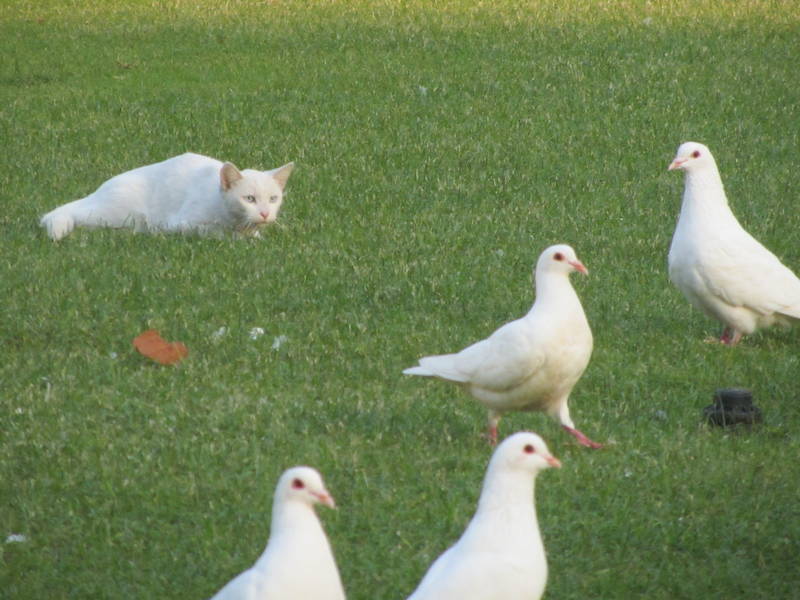
Shanghai Museum exhibits


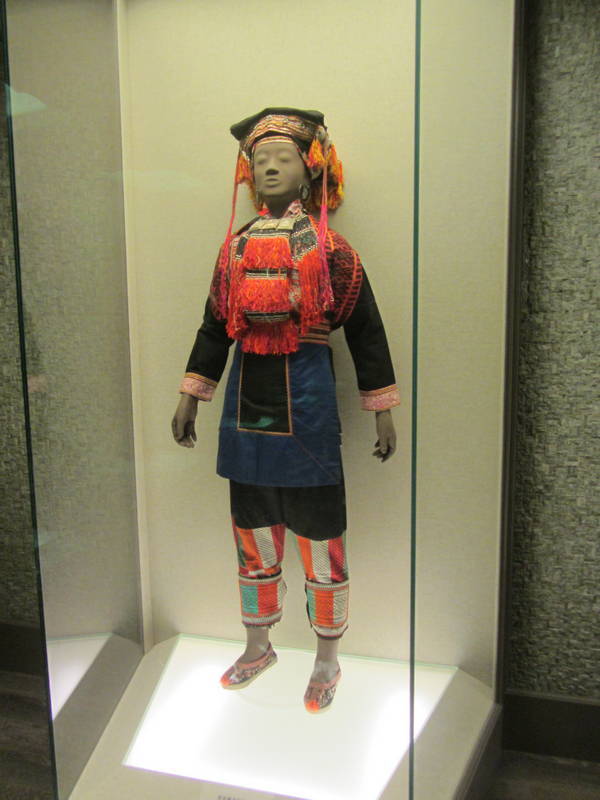
One of many Ming vases

Does this bust look like Zek, the Grand Nagus Ferengi from Star Trek: Deep Space Nine?
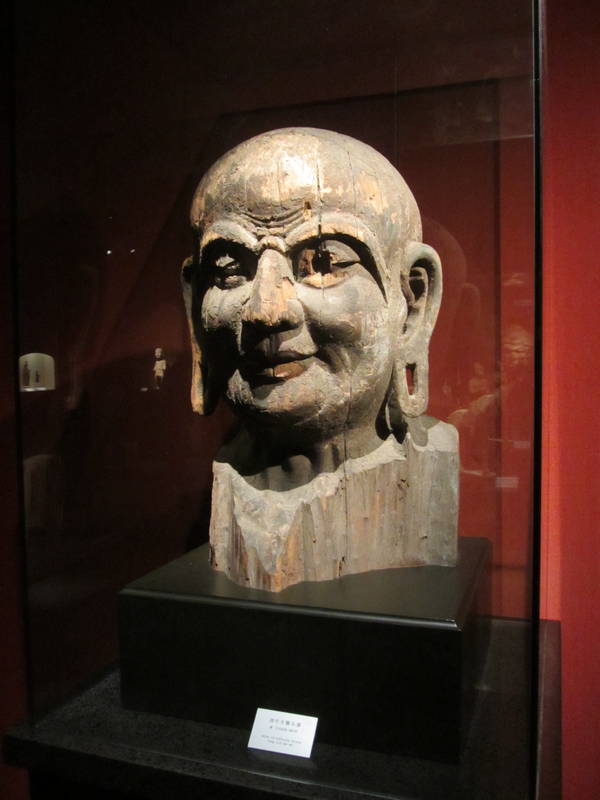
Shanghai Planning Museum model of the city
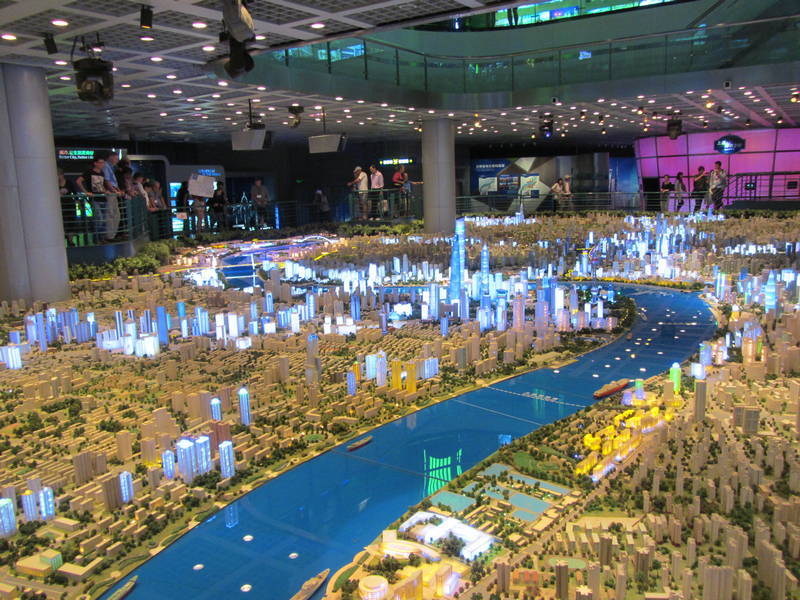
An interesting plan for a future city near Philidelphia has a "Home for Inebriates"
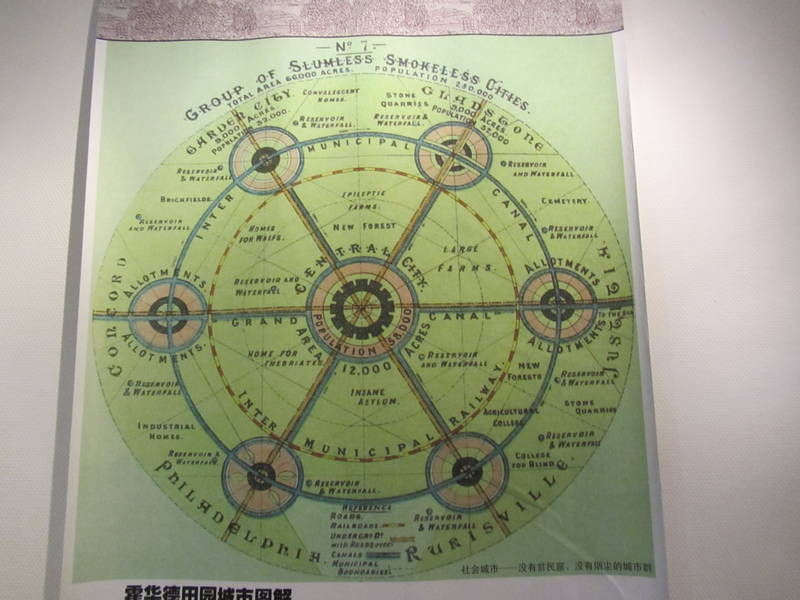
Riding the 430 kph MagLev to the airport
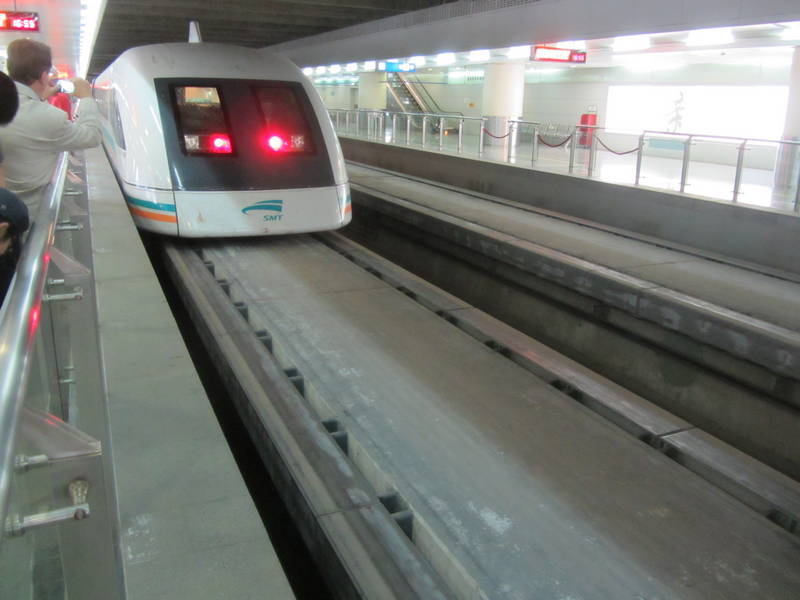
In the airport we know exactly where we are
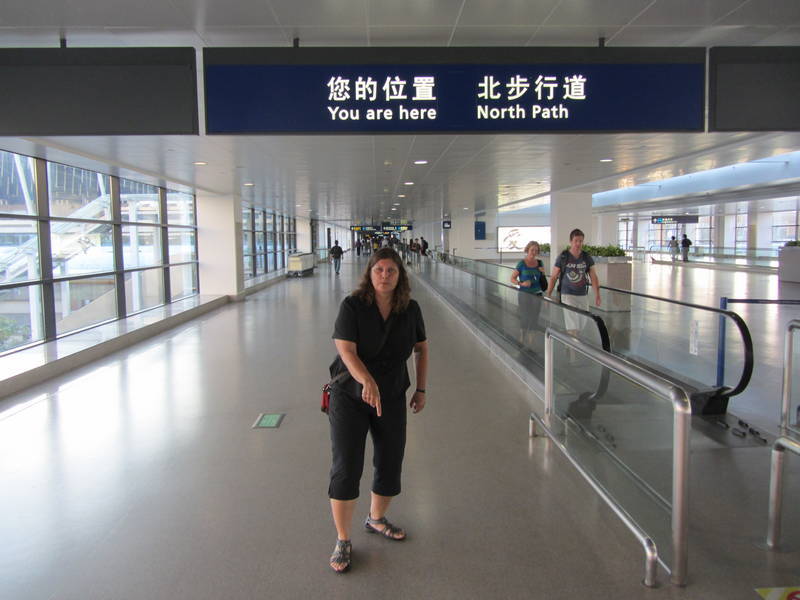
Nanjing Street by night is even more crowded
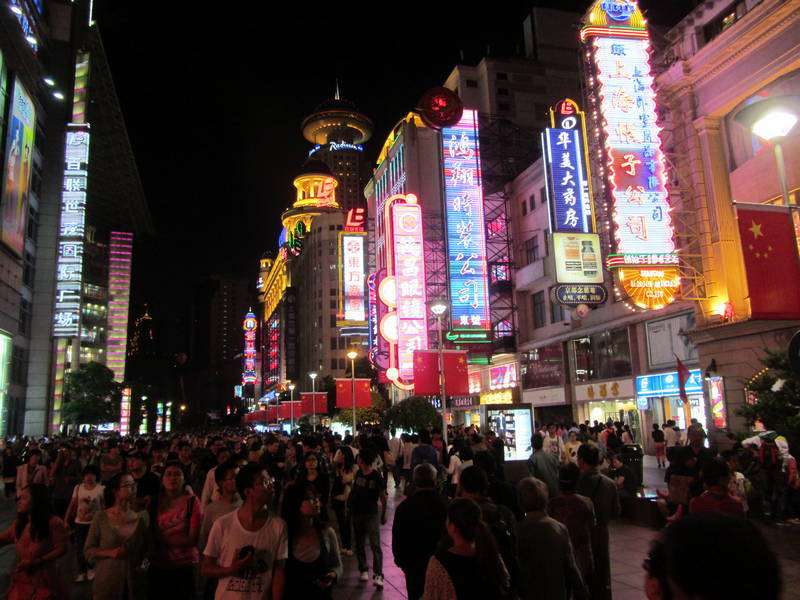
Pudong is spectacular by night
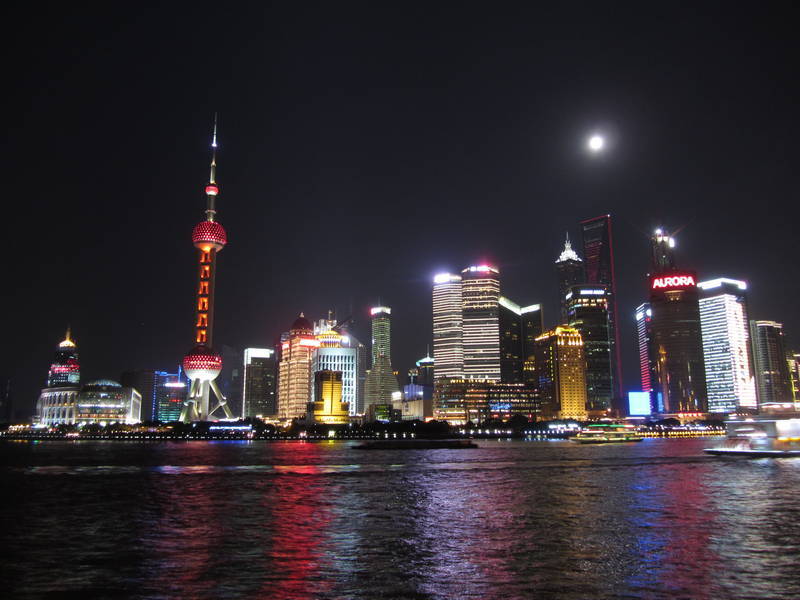
On October 1st, National Day, we walked over to Yuyuan Gardens. The crowds in the old district were, unbelievably, even denser than the walk along Nanjing Street had been. It was actually a matter of being pushed and pulled along by the crowds as we wound our way through the narrow streets. We were thus rather relieved to find that the gardens were less crowded than the surrounding streets. The next day we took the metro to Pudong and walked to the Financial Tower. It is really tall. Too high for me so Audrey compromised and we went up the adjacent Grand Hyatt to the 56th floor restaurant instead. We enjoyed delicious mango smoothies while admiring the view from up high.
Yuyuan Gardens
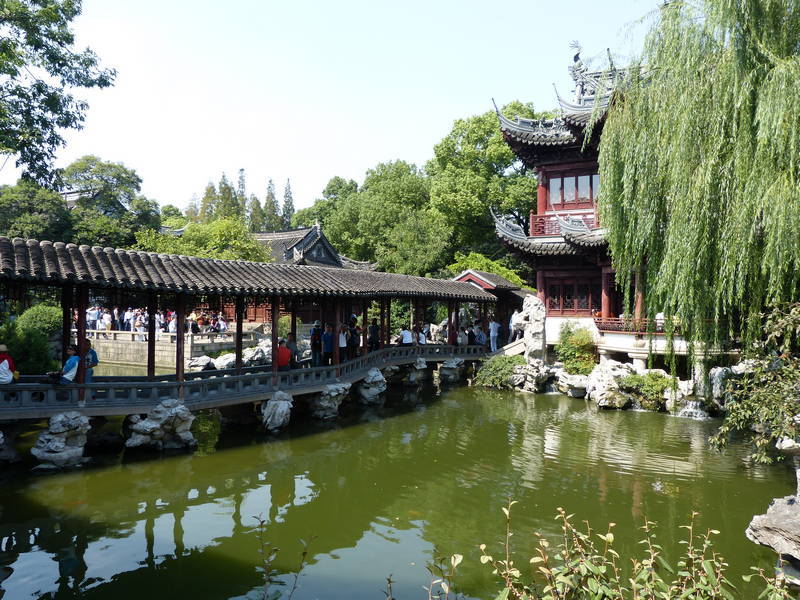
The streets outside Yuyuan Gardens are especially crowded
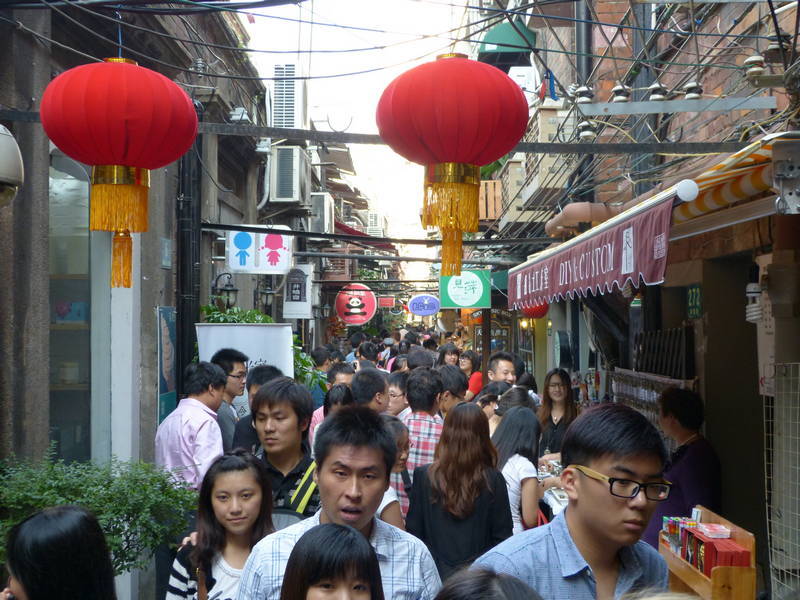
Enjoying a smoothie on the 56th floor of the Grand Hyatt
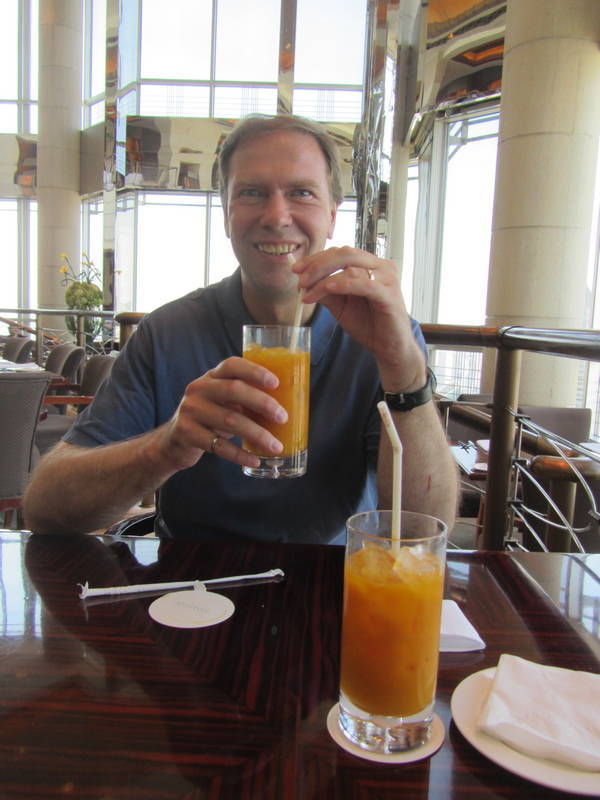
Wow, the sidewalks look crowded down there
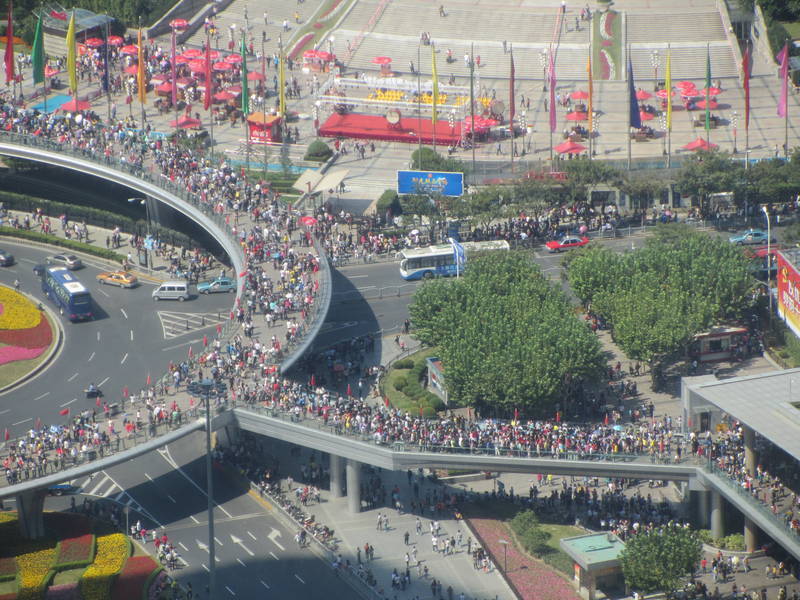
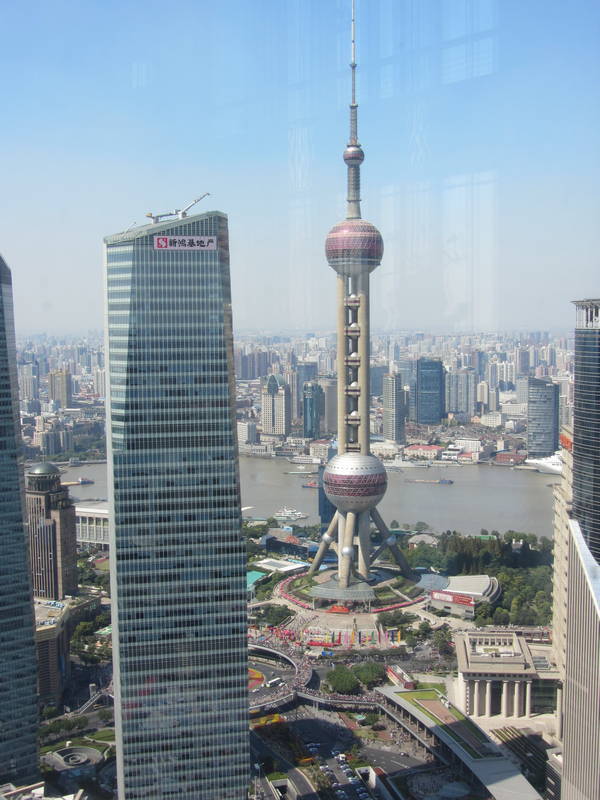
October 3rd we lugged four enormous shopping bags in addition to our regular luggage down to the lobby and asked for a taxi. Another budding Formula 1 driver made the trip to the airport almost as fast as the MagLev. We were prepared to pay extra for our luggage since China Eastern indicated that the maximum luggage allowance was only 20 kilograms and we were only allowed two pieces of checked luggage. At the check-in counter the clerk weighed all five pieces of luggage and then suggested that we lash the two lightest pieces together. A service near the check-in counters first used plastic straps to secure the two bags together and then wrapped the whole thing up in plastic wrap. We thought the plastic wrap was a good idea so we had them do the two remaining cheap duffle bags too. Back at the counter we got our wallets ready to pay for the 26 kilogram combined package. Instead the check-in clerk simply handed us our boarding passes and wished us a pleasant flight. Great! We'll have to keep that in mind the next time we fly with a lot of luggage, China Eastern Airlines has flexible rules.
Wow, what an adventure China had been. We never would have thought that one could actually ride a motorcycle to the Great Wall of China. But we did. Amazing. The people that we met were so curious and friendly that it was going to be difficult going back to being ordinary people instead of the celebrities we had become in China. And the food, the flavours and variety even in the simplest restaurant was fantastic. This was all tempered with the frustrations of trying to survive the motorcycle riding and spending three weeks in the constant companionship of the guide and driver. What would Japan be like?
Our luggage all wrapped up and ready to check in for the flight to Fukuoka, Japan

Map of our route from Xi'an to Shanghai

It was quite exciting to be in Japan. Of course we had heard so much about it from Ekke's brother, Onno and sister-in-law, Chieko and finally it was a reality. I looked out the window of the Kamenoi Hotel on October 4th and saw volcanic hills covered in greenery and a hazy blue sky. Jets flew overhead, taking off and landing at the nearby Fukuoka airport. We knew things would be very different in Japan, and it started with breakfast. There was a big vat of steamed rice on offer at the hotel buffet, and a bowl of eggs sitting by it. There was also an assortment of pickled things but I could never figure out what they were. And coffee. Thank goodness. Other countries were often a bit short in the coffee department. I was also very happy to see some bread and a toaster oven. I could make my own silver-dollar toast, as that was about the size of the delicate little pieces. I wasn't going to have rice for breakfast so I must have looked piggish to the Japanese patrons when I had six pieces of toast. And it would be rounded out nicely with a boiled egg, which had been a breakfast staple in China. I gently cracked open the egg but to my surprise it was not boiled at all. It was really runny. In fact, it was raw. Ewww. Ekke consulted Onno later and learned that the raw egg is mixed in with the rice with a bit of soy sauce. Mmmm. Ekke tried it and it was OK, but later substituted sugar and milk for soy sauce. The Japanese were aghast. Mmmmm.
The Kamenoi Hotel in Fukuoka - home for a week
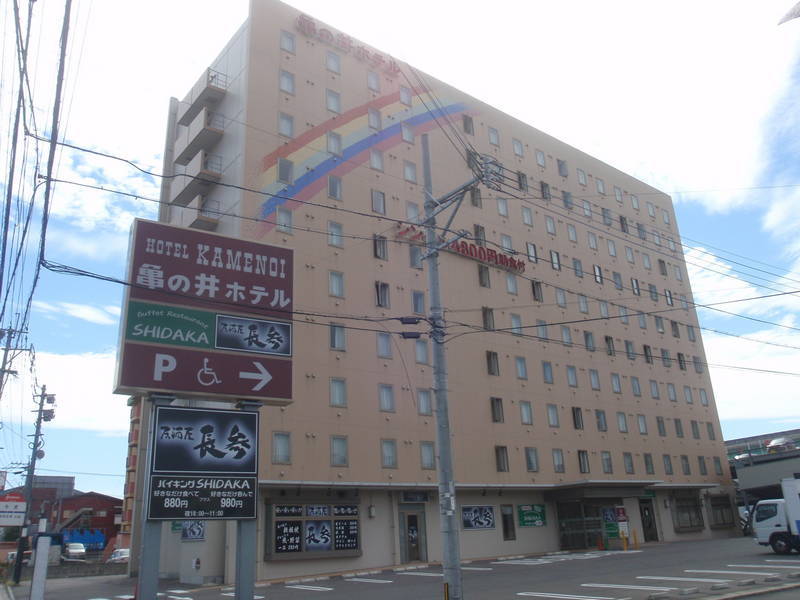
Our hope for the day was to get some paperwork done with the Japan Motor Association, pay some port fees, do something at customs and ride away on our motorcycles. Usually it was just that easy when getting a bike out of air cargo. Not so with shipping by boat. To try to get the ball rolling quickly, we took a taxi to the JMA, very expensive at 5000 yen ($58). But when the taxi driver got out and gave us the deepest bow I had ever seen, I thought it was worth the price just for that. After spending a couple of hours at the JMA to get papers that showed we had carnets for the bikes, we were told that we needed a freight forwarder to get the container out and then to put it on a truck to the customs terminal. We didn't know if the boat had even arrived, and were waiting to hear from Paul, our China Overland contact who had taken care of the shipping. So, we figured out how the metro system worked and took a train downtown. After a walk by the river, we sat down at an outdoor Yatai, or food stall and ate our first Ramen noodles. Delicious.
Which direction to the Yatai stands?
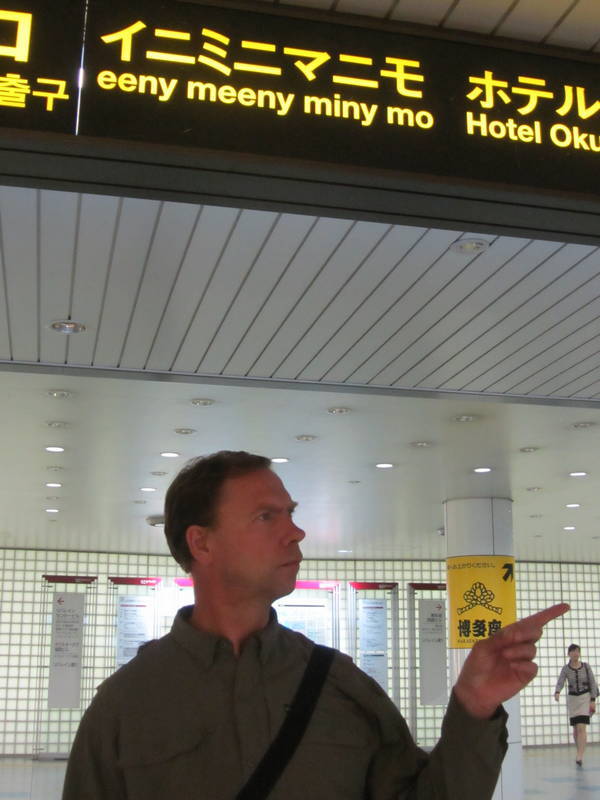
Yatai stand with our first Ramen noodles
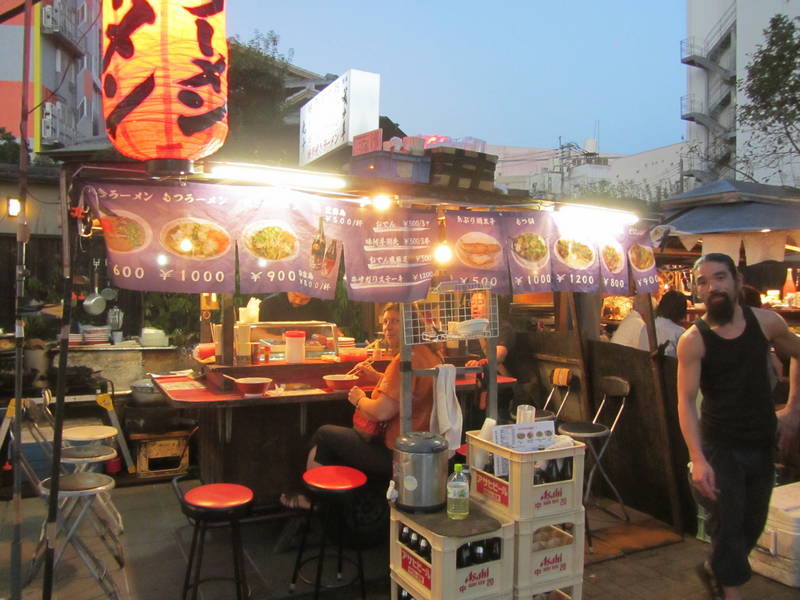
The bikes had been booked in for a long-needed service at Free Man BMW but that had to be cancelled because we had no bikes. The dealership was a couple of kilometres from our hotel, so we walked there the next day. Kentaro, who spoke good English, recognized us immediately from Chieko's description and easily cancelled the service. He also told us we could purchase bike insurance right from him - easy. Fluent in Japanese, Onno and Chieko were working hard for us in Canada, deciphering the bill of lading that Paul had faxed us and trying to figure out what our next step should be. Onno said that the document had a bottom line of 81,300 yen. I was hoping that this was just a confirmation of the money we'd already paid in China to have the bikes shipped. There wasn't much we could do about it right now anyway, so we just ignored it. Since we couldn't get the bikes yet we would need to stay at least a couple more days at the hotel but they said they were all booked up as it was a national holiday on Monday. After searching the internet there didn't seem to be any hotels available in Fukuoka so we envisioned ourselves just camping out somewhere. But no campgrounds were nearby and we only had public transportation to haul all of our luggage around. So, we went in search of a bakery cafe for some afternoon refreshment. A cream cheese-filled bun was surprisingly delicious. Back at the hotel our problem was magically solved - the front desk staff said they had a cancellation and would have a room for us. Phew. The hills were beckoning, so we wandered in that direction for a bit of exercise. But right where the road ended and the hills began, the foliage was so thick with bamboo and other trees growing, it was impassable. So, we stuck to the road, walking by groups of Junior High School kids being dismissed from school. They looked pretty formal in their uniforms, the girls in skirts, boys in pants, all wearing suit jackets. Some of the girls got brave and called out, "Hello" to us, followed by a wave of giggles.
The hotel had a different room for us the next day, happily with more space. The bathroom was still about the size of one in a motorhome, though. Not much could be done on the long weekend in terms of getting the bikes out of the port so we took a bus and metro to downtown Fukuoka on Saturday, October 6th. This area was formerly the city of Hakata where back in the 13th century Mongols led by Kublai Khaan tried to invade Japan. The invasion was not successful due to typhoons destroying their ships. The Hakata Machiya Folk Museum was on our list and was housed in a traditional two-storey merchant's quarters. It had some very detailed artefacts on display from the area like famous clay dolls depicting Hakata lifestyles. Some traditional skits called Hakata-Miwaka were performed by local men on a tatami-matted stage. The performers wore traditional masks and were accompanied by a shamizen (3-stringed instrument) player. They ad-libbed various funny, everyday situations, all in Hakata dialect. We didn't understand a word. There was a lot of laughing from the audience and the performers, so we had fun, too.
Hakata Machiya Folk Museum
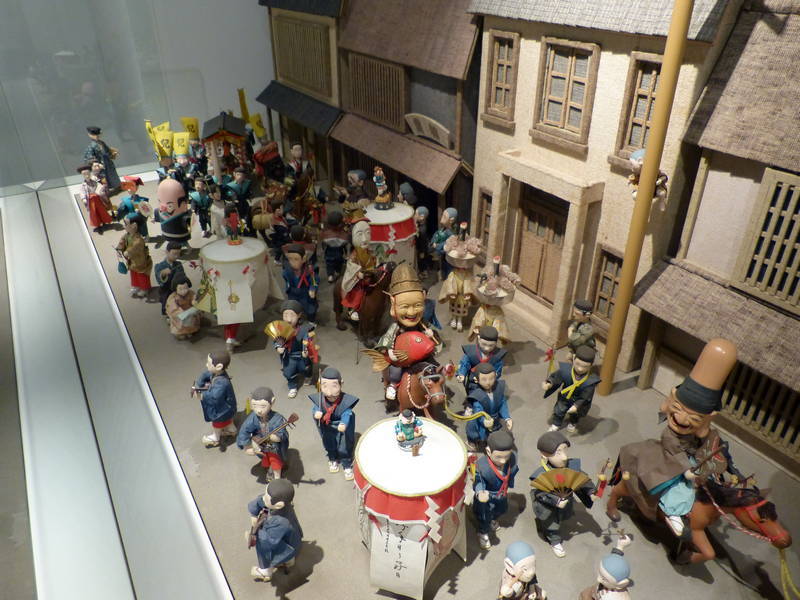
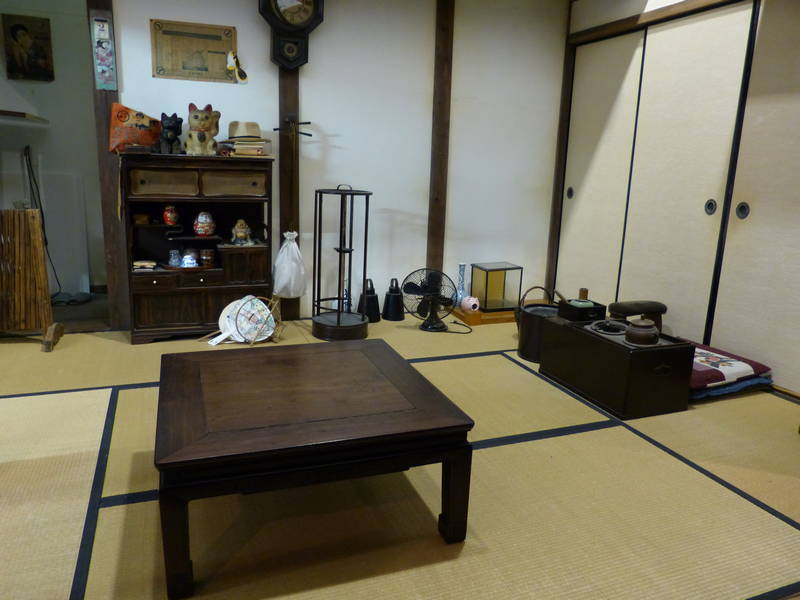
Hakata-Miwaka
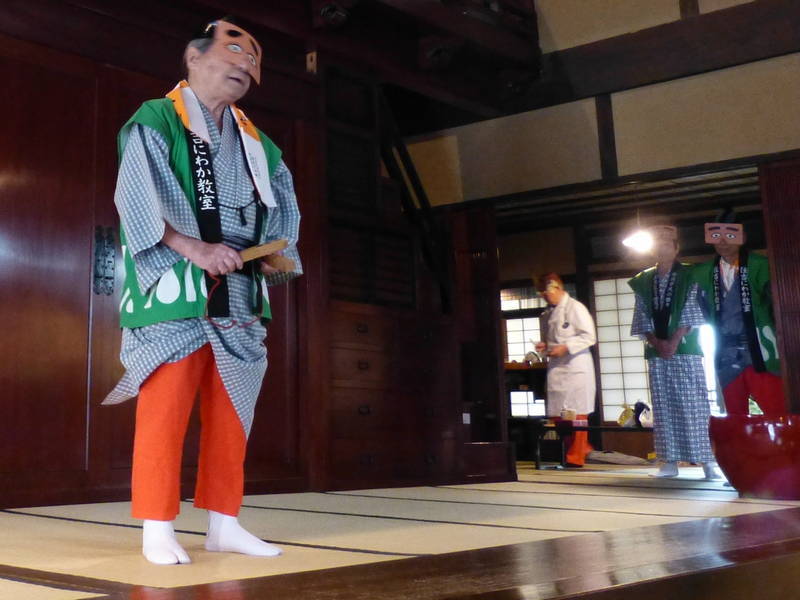
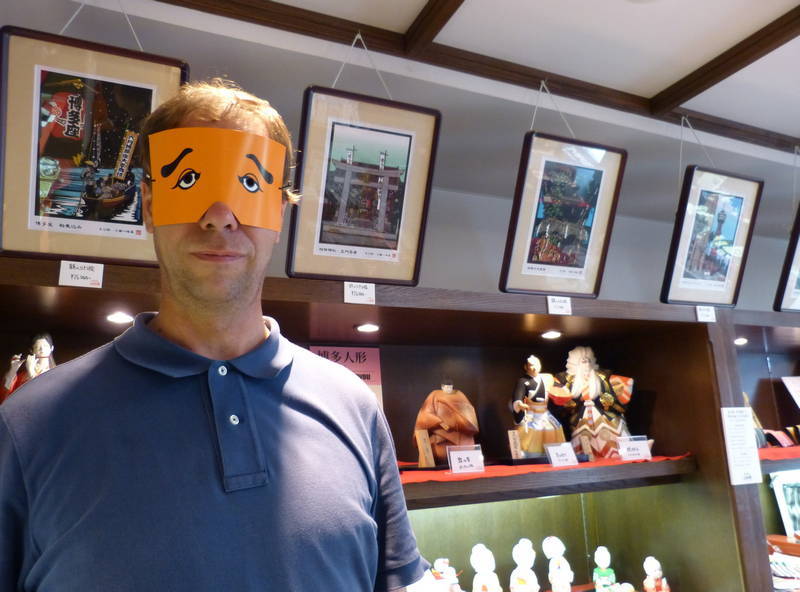
The Japan Formula 1 Grand Prix race was scheduled for Sunday afternoon and we tried to find a place to watch it, but with no luck. None of the restaurants or bars with TVs were showing it, and we weren't able to get it through the hotel TV so we watched a covered version on the internet. Partway through we took a chance that there might be a TV in one of the lounges at the airport terminal, so we took a bus there. No luck. But we did enjoy great views from the observation deck of planes taking off and landing.
Monday was a national holiday, Health and Sports Day, so we decided to try out the high-speed train, the Shinkansen. It went about 300 kph so obviously didn't feel as fast as the 430 kph MagLev we had ridden in China. But, the train was smooth and efficient with comfy seats and we were in Kumamoto in no time. A tram took us downtown and we walked up the hill to the gorgeous castle. Much of it had been burned down in a siege but it was rebuilt and some of the original fortifications of 1467 remained. The stone walls were really unique, the curved design meant to keep invaders from climbing up. The castle housed a museum on all 6 floors and we climbed the stairs for great views. The Satsuma Rebellion of 1877 took place here. Discontented former Samurai, Saigo Takamori and followers laid siege to the castle, and the new government within, for 52 days, but were defeated. The film The Last Samurai is loosely based on this character. Out front we were treated to a presentation of Samurai 'fighting' by several young men dressed in traditional garb. Their choreographed dance to some modern music was very cool. They happily posed for photos afterwards and really seemed to enjoy their celebrity status. Later we managed to get in on an English-speaking tour of the castle area but we had a tour-guide to ourselves as everyone else was on the Japanese tour. The tour-guides were dressed impeccably in yellow suits and white gloves. We would see elaborate uniforms like this all over Japan, from hotel clerks to restaurant servers to gas station attendants. A walk on tatami mats through Honmaru Goten Palace took us past beautiful rooms filled with murals of landscapes and wild cranes. Royalty really knew how to live decadently. It was so beautiful and peaceful and I could just feel all my stresses melting away. We happened upon a free outdoor concert with some rock groups on the castle grounds, not quite as stress-free, and then it was time to catch a the Shinkansen back to Fukuoka.
Preparing to board the Shinkansen to Kumamoto
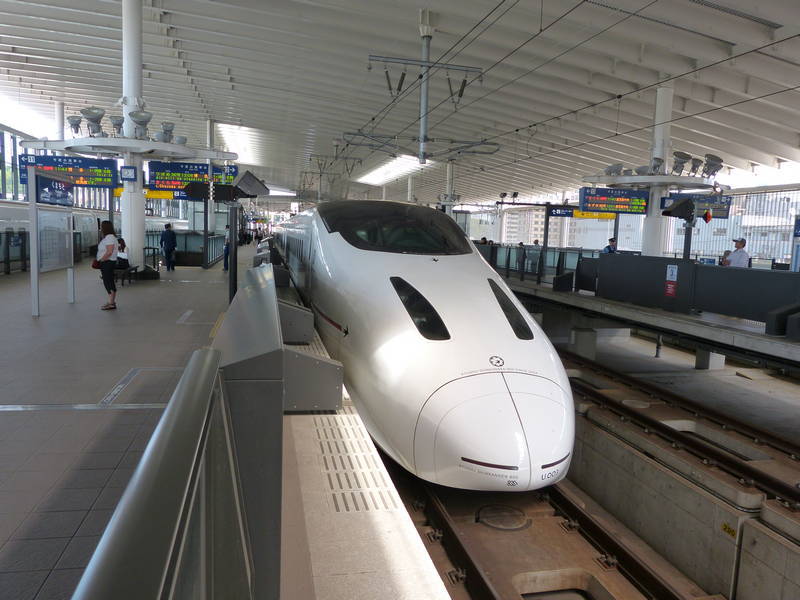
Kumamoto-jo
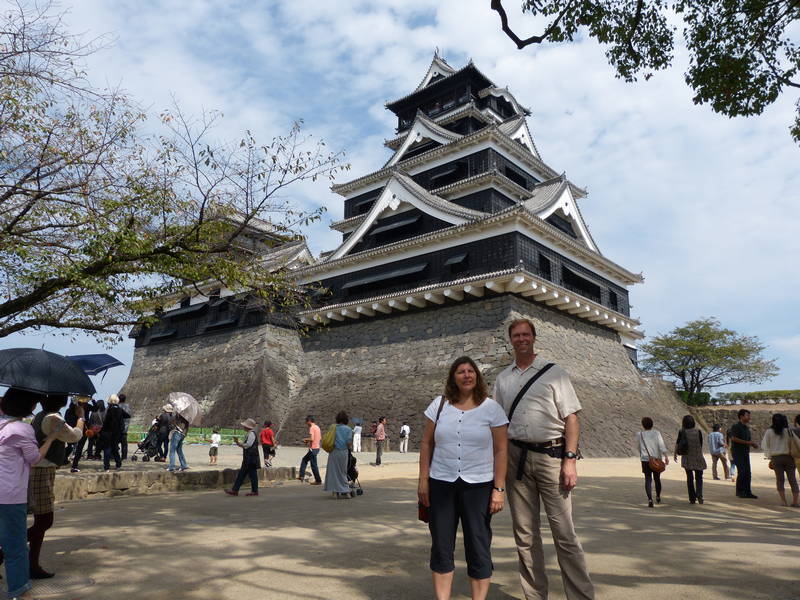
Get your photo taken by a Samurai

And this is how it will turn out...
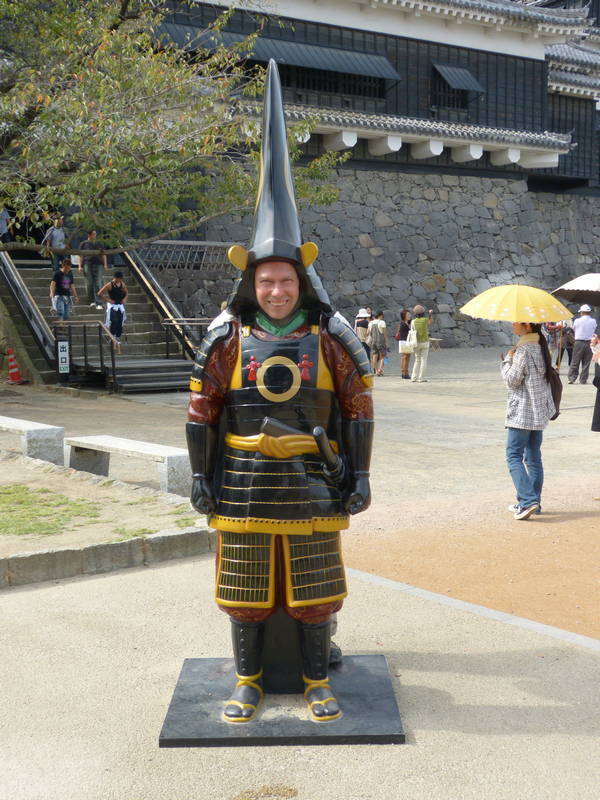
Samurai demonstration
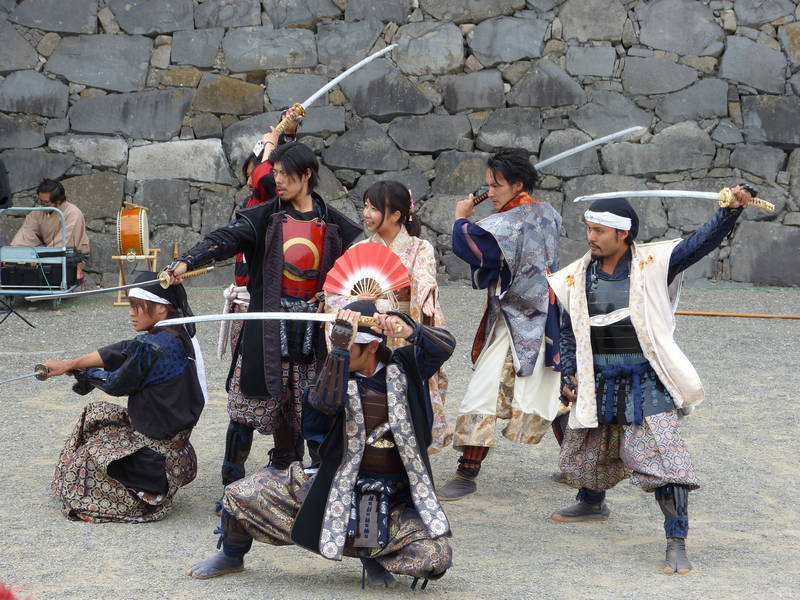


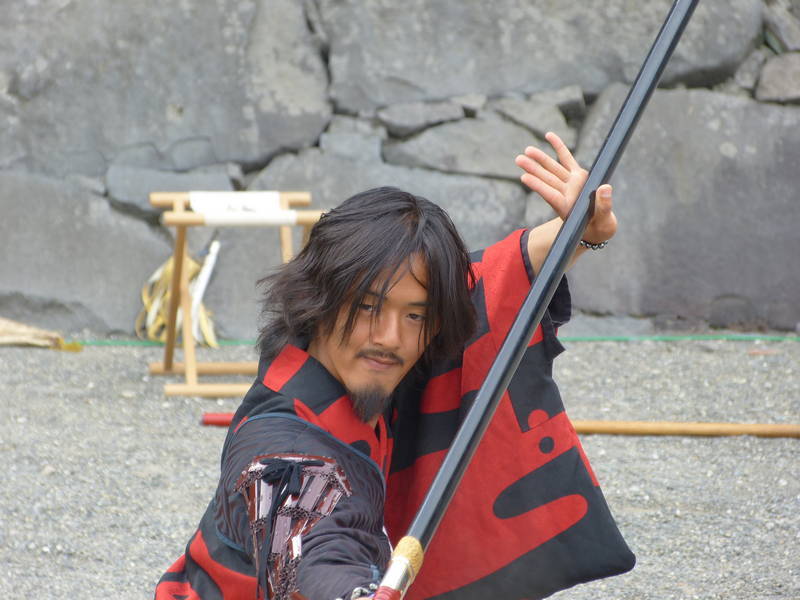
Spectacular Honmaru Goten Palace


The one original building still standing

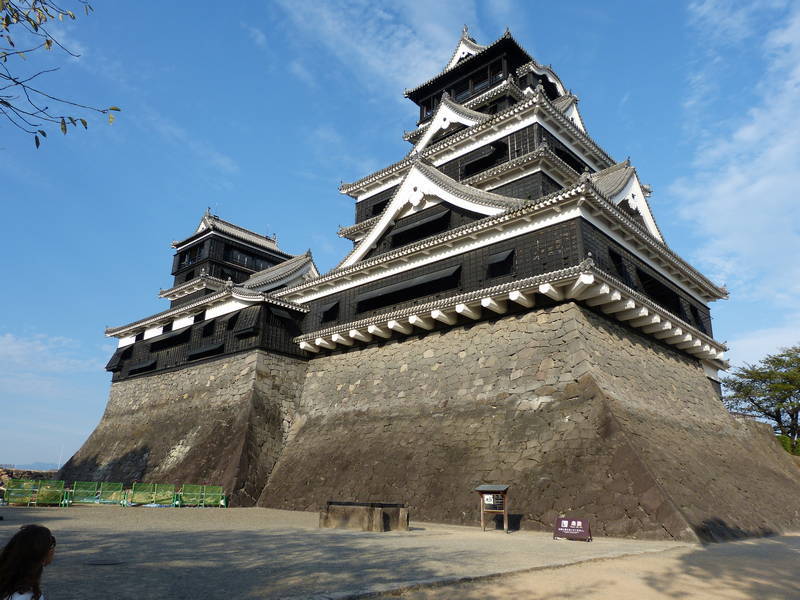
One Samurai stands on the ramparts wishing people goodbye

Finally, on Tuesday, we could take action on the bikes. Chieko started phoning as soon as offices opened at 9:00 am (5:00 pm B.C. time), and she found Mitsubishi Logistics, a freight forwarder, who might be able to help us. They suggested phoning the Canadian Embassy. Really? Well, it couldn't hurt. So Ekke phoned Ms. Cochrane at the embassy and she was super helpful. Ekke explained what we were trying do and apparently there was some confusion as Mitsubishi thought we had a container of household goods. But before they would release the container we would have to pay Tokai Logistics in Yokohama the 81,300 yen ($942.34) for unloading the container and various surcharges. Yokohama was near Tokyo, hundreds of kilometres away. Time was now a factor because we were getting charged 3000 yen ($34) per day for the bikes to be stored at the port. So, we hurried off to a local bank and someone there helped us use a machine for the deposit. We then faxed the receipt to Tokai and the Canadian Embassy. Then Mitsubishi wanted a copy of all of our documentation such as the carnet, passport, vehicle registration, bill of lading etc. before deciding whether or not they could work on our tiny container. Usually they dealt with big shipments. We waited while Ms. Cochrane faxed our info to Mitsubishi and then waited for their answer. And waited. Finally 7 minutes before the next bus and subway to the port, we got a call from the front desk to call the embassy. Mitsubishi said they would take care of our container, thank goodness, but it would cost 30,000 yen ($347). They could only do the customs that day and release the bikes the day after. We got their address from Ms. Cochrane and then ran out the hotel door with our bike gear in bags, hoping that we could make it to our bus and get the bikes that afternoon. The bus was slightly late, so we made it. Mr. Konishi at the Mitsubishi office spoke good English and explained some of the codes for the surcharges over a cup of cold, oolong tea. Then he took us over to customs where they took the JAF form and stamped the carnet. Mr. Konishi told us we could not get the bikes that afternoon as the container would be trucked over to their warehouse the next morning. So he drove us and our motorcycle gear back to Hakata subway station.
We weren't riding yet but could enjoy a cool chopper going by

What a relief it was to receive an email from Mr. Konishi the next day, October 10th, saying that we could pick up bikes. Finally. He found us some identification tags and stylish hardhats and drove us to the warehouse. Safety and rules were the order of the day. What a difference from the China port experience where fork lifts carrying containers the size of buses zoomed right over our un-hardhatted heads. The container was brought over to the warehouse door, opened up, and we got our first glimpse of bikes since September 26th. They looked great. After wheeling them out and doing a photo session with the staff, we rode away, making sure to ride on the left side of the road. My gas tank was pretty much bone-dry (with memories of nearly running out of gas in the tunnel on a Shanghai expressway still playing on my mind) so we gassed up right away. The attendant put the gas in and it was a relief to know we wouldn't have to fill the bikes one gasoline can at a time. Ekke's GPS mounting key was packed away somewhere, so we didn't have a map to lead us back to the hotel. Instead he found a major road heading in the right direction, noticed a plane coming in for a landing off in the distance, and followed that. This got us to a road that we recognized from our bus rides and then to Free Man BMW. Kentaro said that the service department was super busy that day but offered us loaner bikes for the next day while the bikes were being serviced. He had an R1200R and a G650GS. This was very similar to my old bike so I didn't feel I needed to test ride it, and I didn't want to slow Ekke down. Also, we understood that expressways were super expensive in Japan, so we checked the cost, 8000 yen ($92) return, for two bikes on the expressway to Mt. Aso, and decided to go on one bike the next day. It would be a good opportunity for me to do some videotaping while sitting on the back of the bike.
Our first glimpse of the bikes in the container
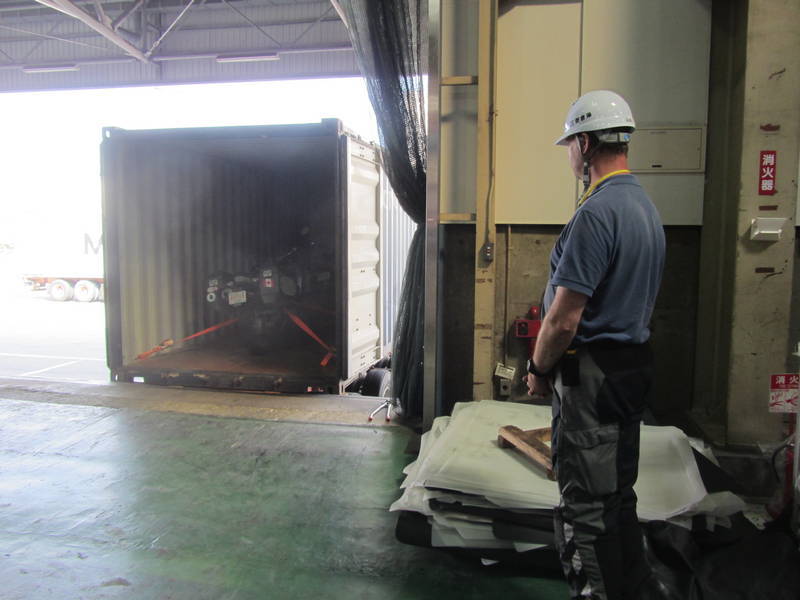
Audrey reunited with her bike at last

Ready to ride in Japan
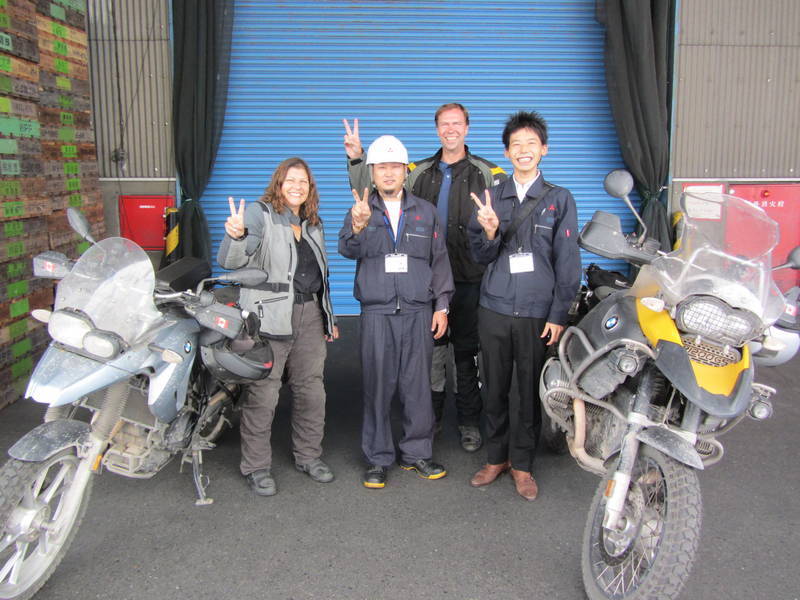
Straight to Free Man BMW for a long overdue service

While walking by a restaurant on the way back to the hotel we looked into the window and saw a strange sight. There were several dishes of sushi and sashimi, all moving around the restaurant on a conveyor belt. We had to try it. Sitting down at a table we just started plucking dishes of food that looked good from the conveyor belt. A 'menu' card indicated that the colour and design of the plate corresponded to the price of the dish. Very cool. The avocado and cream cheese with caviar was heavenly. The pile of dishes was added up and that was what we paid. Cool. Our walk back to the hotel took us past several interesting car dealerships and Ekke was in car heaven. So, he took lots of photos.
Hmmm, what to choose?

A few interesting Japanese cars


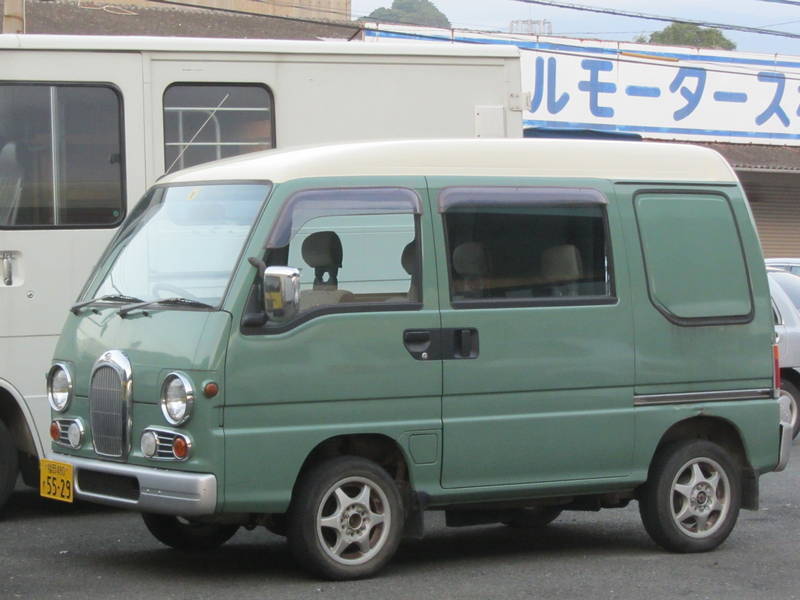

Making a Miata look large
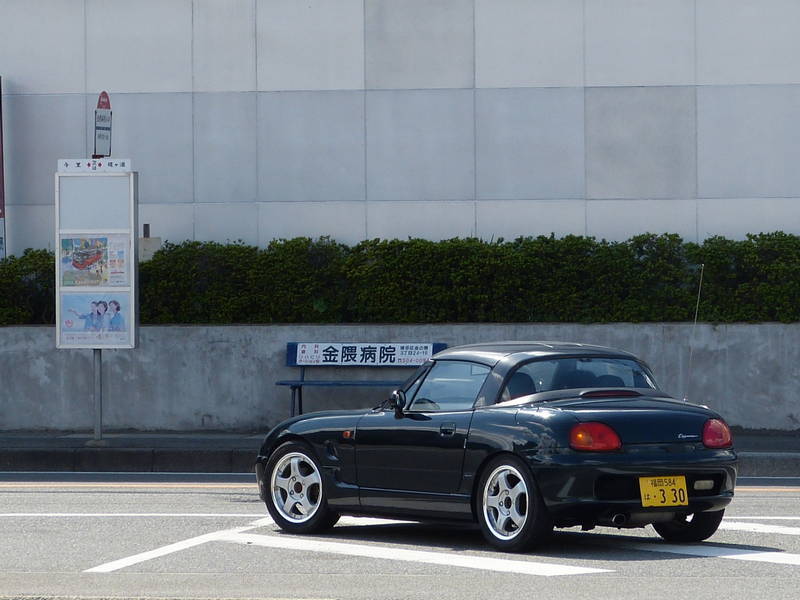
With the bikes getting serviced, we picked up the BMW R1200R at Free Man BMW and rode 2-up to Aso San. The bike was very quick on the expressway and about 100 kilometres later we were on the twisty roads leading up to the volcano. The landscape reminded us of Maui, with volcanic cones, covered in thick, green foliage and Japanese tourists all around. Towards the top, the landscape changed dramatically, rocky and barren. After a lunch of noodle soup and pork in a ropeway (sky tram) terminal, we paid a small fee to ride right up to the caldera rim. Other riders had just left their gear, coats and helmets, sitting on their bikes. Was there no theft here? So, we just did the same, here, and everywhere else we parked the bikes in Japan. We were really looking forward to walking around the caldera rim and started up with great anticipation. But, something was blocking the pathway. It was roped off. Disappointed! There were signs indicating that the walkway was closed due to unsafe levels of sulphur dioxide coming out of the volcano. Well, it was probably a good idea not to breathe in S02, so we took the closure in stride. Another walkway led further away and up to a lookout point where we met some American tourists who kindly took our picture for us. There were some interesting concrete 'huts' on what looked like old lava flows, and we realized that these were for evacuation purposes in case the volcano suddenly started spewing lava. On our walk back to the bikes, we noticed that the ropes had been lifted and we could do the caldera walk after all. Looking down into the volcano we saw clouds of poisonous vapour wafting over the lake far below. When the clouds lifted we caught a glimpse of the roiling, mint-green coloured water. Just as we reached the top of the walkway, I caught a whiff of a sulphur smell, and within seconds, the S02 alarm was going off. Everyone quickly evacuated the area and headed away from the caldera.
On the way to Mt. Aso
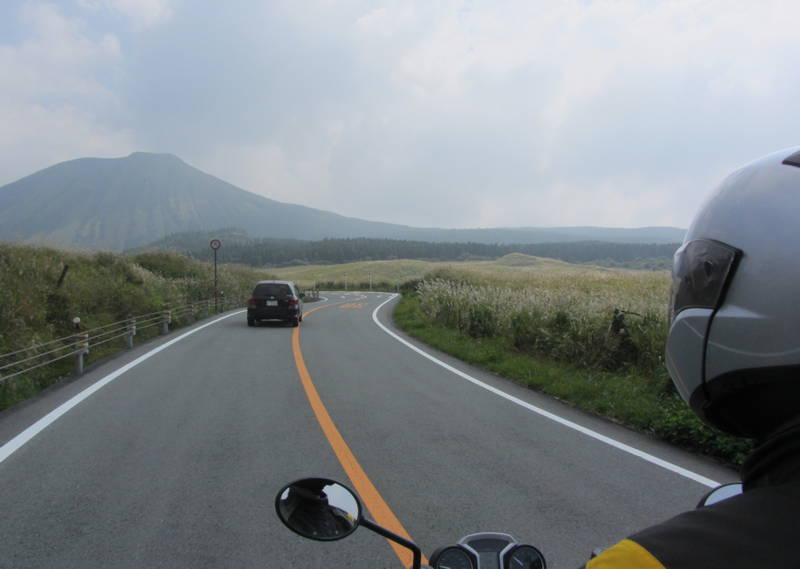
A smoking cone

Lots of bikes lined up at the top
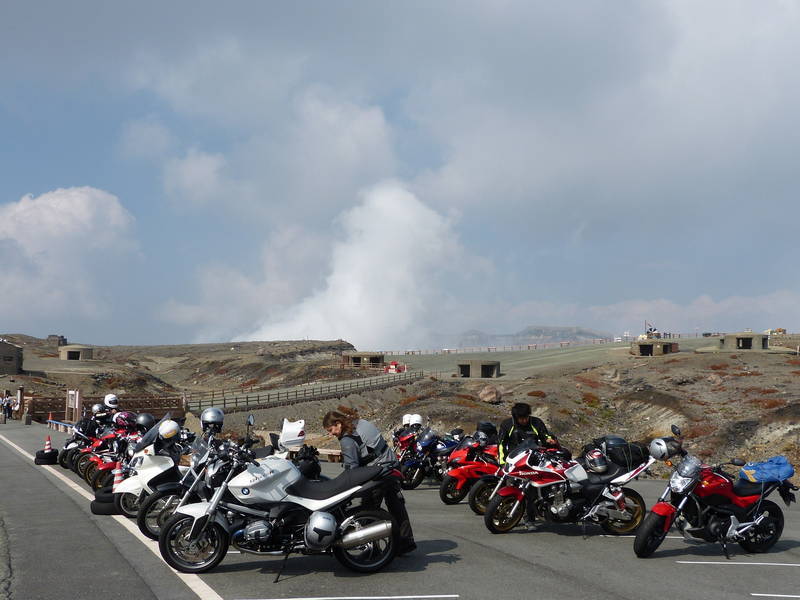
Drat, closed because of SO2 danger

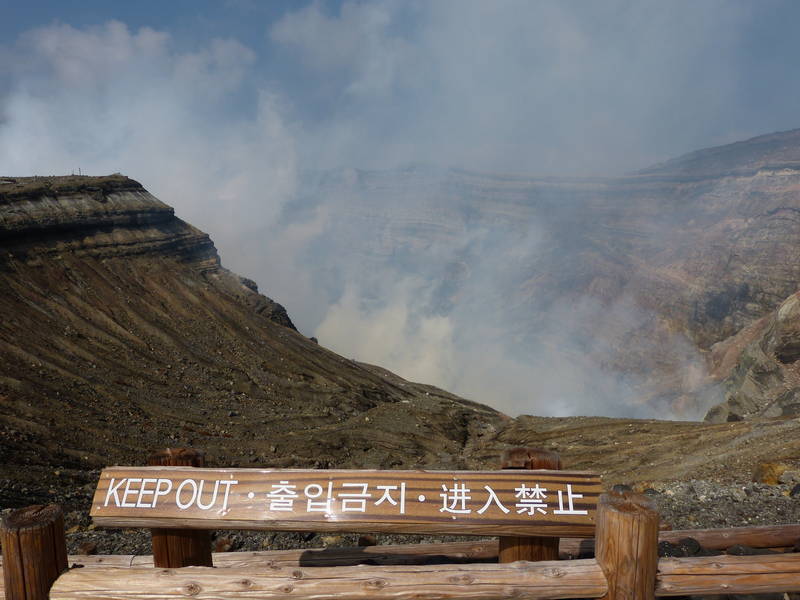
The walk opens up for a short time before the SO2 alarm goes off again
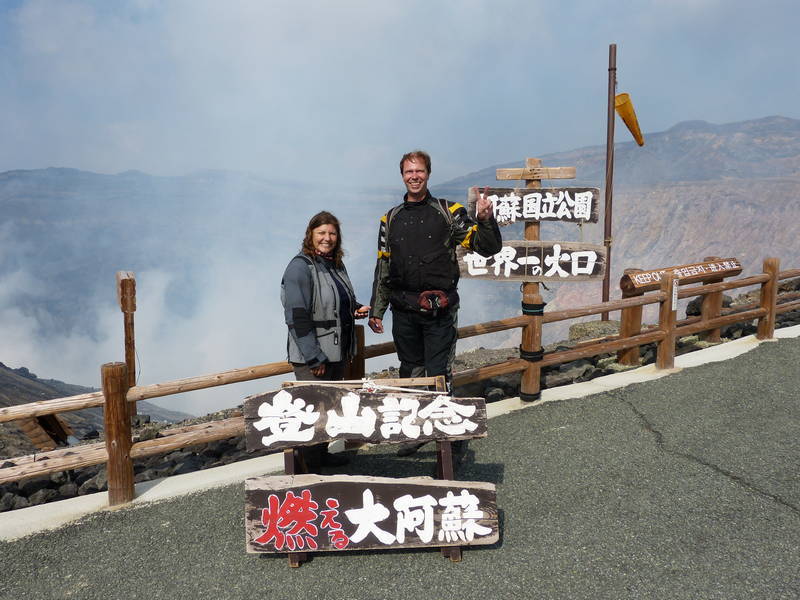

Ekke had a blast riding the R1200R down the twisty road off of the volcano, and only had to stop every now and again for workers cleaning up mudslides. Signs for the roadwork were always there well in advance, and someone would be waving a red flag or red stick to stop us. A big, wide valley that contained the volcanoes, volcanic cones, farmers' fields and a couple of towns was actually the caldera itself. It's one of the largest calderas in the world at 25 kilometres wide. At a viewpoint we saw a large group of motorcyclists just out for the day. What a great place to ride. A different route home beside a winding river took us past small towns, through tunnels and gorges, and over bridges. The bike was returned to Free Man BMW with big grins on our faces, we were so excited about our day. Thank you, Kentaro.
Heading back to Fukuoka
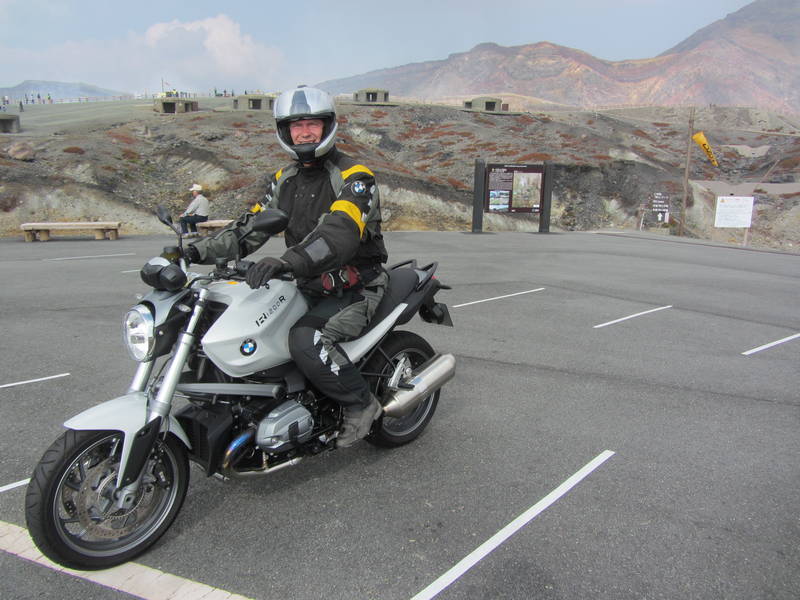
Construction zones seem better managed than in China

Lovely roads in the hills
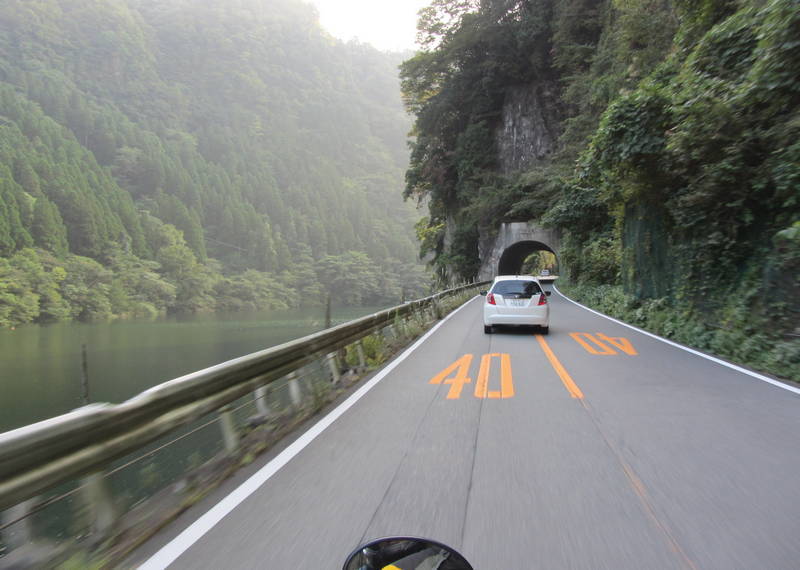
There was some time the next day to plan our journey ahead so we went in search of a map book. We settled on a Touring Mapple, maps that are made for motorcyclists. The fact that most of it was written in Kanji did not deter us. In our hotel room we could only plug one computer in at a time so we also perused the aisles of a huge electronics store to get an adapter that would get internet to all our devices at the same time. The bikes were not yet ready as Ekke's 1200 GS Adventure had a stripped cylinder head stud. We were trying to fix a time and place to meet Onno, Ekke's brother, who had flown in from Canada but he was way up near Matsumoto on the main island of Honshu and we were way down on the southern island of Kyushu. So, to meet him and get that part of the trip going, we could just start riding the 700 kilometres north on the expressways, pay the tolls, stay overnight in a hotel, and pay for gas money. Kentaro offered an alternative. He said that if you wanted to get north quickly, take an overnight ferry to Osaka. We calculated the costs of both options and the ferry was actually cheaper compared to riding on those toll roads. We'd also save a day because of the overnight ferry. Thanks again Kentaro. He downloaded a form from the internet and made our ferry reservation for us, recommending the room with 4 beds because it had a window. How's that for great BMW service.
There was some iffiness as to when Ekke's bike would be ready for pick-up on Saturday, October 13th, and we had to be on the road at 5:00 pm to make our ferry. So, our plan was to get a late checkout, pack up tonnes of stuff, and do some writing at the hotel for a while. We wandered down to breakfast and asked what time checkout was. 10:00 am. We then asked if we could have a late checkout. No. Right at checkout time a small army of cleaners would start tossing sheets and towels out of the rooms, bring in fresh ones, and vigorously begin cleaning rooms. This process could not be disturbed. It was 9:30 am. That was the quickest breakfast we've ever eaten and unfortunately I didn't have time to get my 6 pieces of toast down. The elevator couldn't take us up fast enough so we could start packing. With all of our camping and motorcycle gear all spread about to deal with, clothing, raingear and electronics, it was a big job. Within 15 minutes we had everything haphazardly tossed into bags, feeling thankful that we had not yet thrown out our $4 shopping bags purchased in China. We launched the stuff onto the elevator, and rode down, making the lobby just before 10:00 am. Phew. In Japan, one just feels that the rules cannot be broken.
Feeling a bit frazzled, I sat in the lobby with the luggage while Ekke went to pick up my bike so he could ferry our stuff to Free Man BMW. The bikes were fixed by 5:30 pm, and after the photo session and saying our goodbyes, we rode off to catch our ferry on Kyushu's northeast coast. The sun was just setting but riding in the dark in Japan did not feel dangerous in the least. Every vehicle had headlights. There wasn't anything with three wheels pulling a wagon. We saw no scooters going the wrong way down the highway. And we did see other motorcyclists being treated with respect by other drivers. The ferry process was a bit confusing at first, as the terminal signs were all in Kanji symbols. Luckily a port worker pointed out that we were at the wrong boat and sent us off in the right direction. Once there, it was easy as we just watched what the other motorcyclists were doing. To our shock and surprise, attendants on the boat found some tie-down chains for us and carefully secured our bikes. Usually that was our job on the ferries. The boat was very nice and I think we were the only foreign tourists aboard. We, thank goodness, chose not to try french fries from a vending machine, and had rice and yakatori (meat on a stick) at the cafeteria instead. The bunk beds in our room were a touch short for Ekke, but I slept well with the gentle chug-chugging of the engines in the background. Ekke got up in time to see the boat pass under some really magnificent bridges connecting smaller islands with Honshu.
Getting settled in on board the ferry

Passing under the bridge to Awaji Island
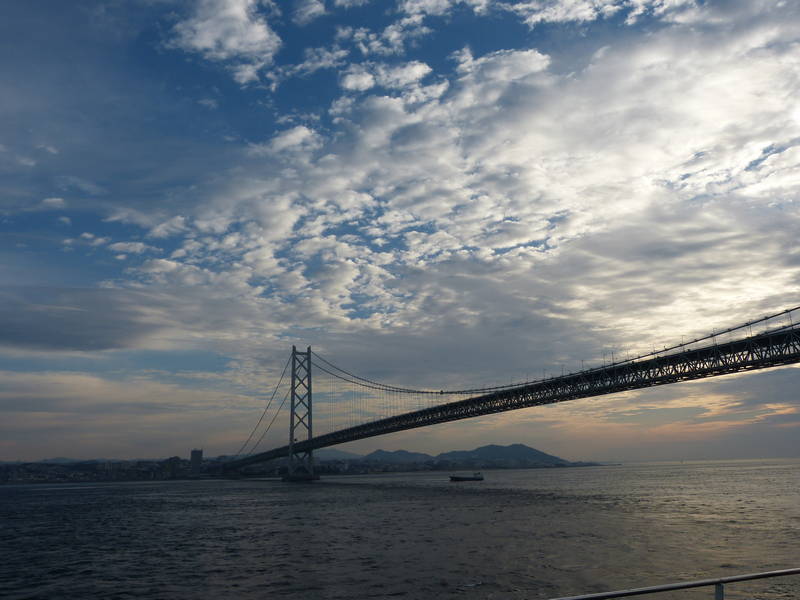
As we rode off the ferry into the port at Osaka the next day, October 14th, I saw someone standing in the parking lot waving at us. Oh, I thought. People are really friendly here. He kept waving. No, he was definitely trying to get someone's attention. I looked behind me. Everyone else but Ekke was already off the boat. Was he waving at me? Did I know anyone in Osaka? Then it occurred to me that it must be Hideki, a motorcyclist we had met in Switzerland in 2002. We had emailed him to say that we were going to be in the area sometime but didn't really know when. So, with big grins on our faces, we stopped, gave him a hug and told him we were really surprised he was there. He said he had been following the trip via the SPOT tracker on Facebook and saw a post indicating which overnight ferry we would be on. Great. When we met Hideki in Bern in 2002, he was at the beginning of a 5 year journey around the world on a Honda 400 motorcycle. Our paths crossed again when he came to a 2004 Horizons Unlimited motorcycle world travellers meeting near Nelson, B.C., still on his round-the-world tour. He stayed with us for a while after that and then continued on to South America. So, it was great to hook up again, here in Japan. Our rendezvous with Onno wasn't until later that afternoon, so after a bit of catching up, he asked if we wanted to see a bit of Osaka. We followed his van through the busy city and he led us to Osaka-jo, the local castle. Motorcycles parked for free, which was great. The moat surrounding the walled structure was fantastic, and we crossed a bridge and got our first views of the magnificent castle. The huge rocks for the stone walls and castle base were very impressive and came from islands far and wide.
Hideki meets us at the ferry terminal

The moat around Osaka-jo

Huge stones make up the wall around castle

As we approached the black, white and gold structure some familiar music started playing. It was Frank Sinatra, singing, 'You're Just Too Good To Be True'. Memories of doing the foxtrot in my grade 9 dance class immediately came to mind, but something was definitely going on here. Next thing you know, a couple of people started doing a kind of line-dance in time with the music. A couple more joined in and it was then that we clued in that this was a flash mob. Pretty soon there were about 20 people dancing, one of them dressed in a black suit. After the dance, he got down on one knee in front of a surprised-looking young woman, and presented her with the biggest ring I've ever seen, a joke ring, literally the size of a doorknob. She must have accepted, and all the dancers offered their congratulations. They enlisted Ekke to take photos of the group and one of the dancers told me that they were work colleagues, all in on the surprise together. Fun. The castle was almost anti-climactic after this, except for climbing up hundreds of steps to the top of the tower. But it did play an important role in the unification of Japan. There were interesting displays showing the way the Tokugawa clan had defeated the Toyotomis in 1615 becoming a very powerful ruling family. The dioramas of the battlefields and soldiers were really detailed.
Posing in front of Osaka-jo
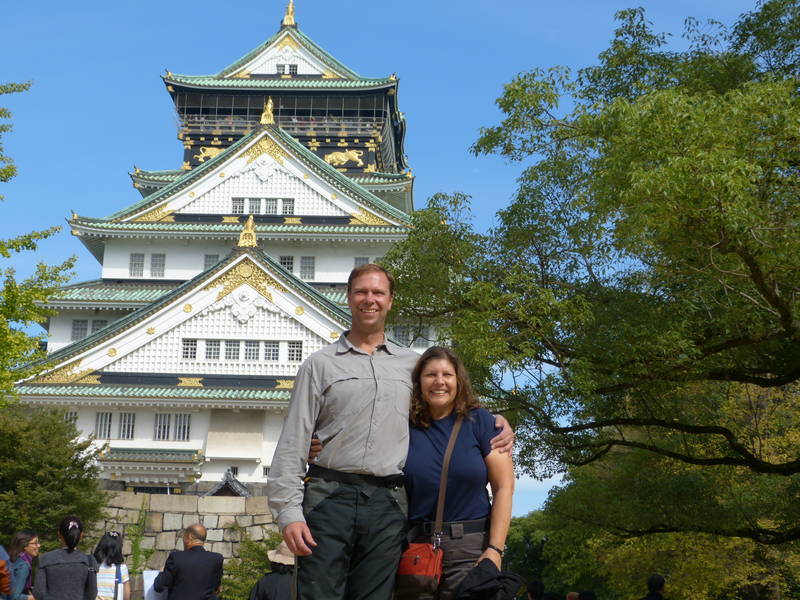
When a flash mob breaks out
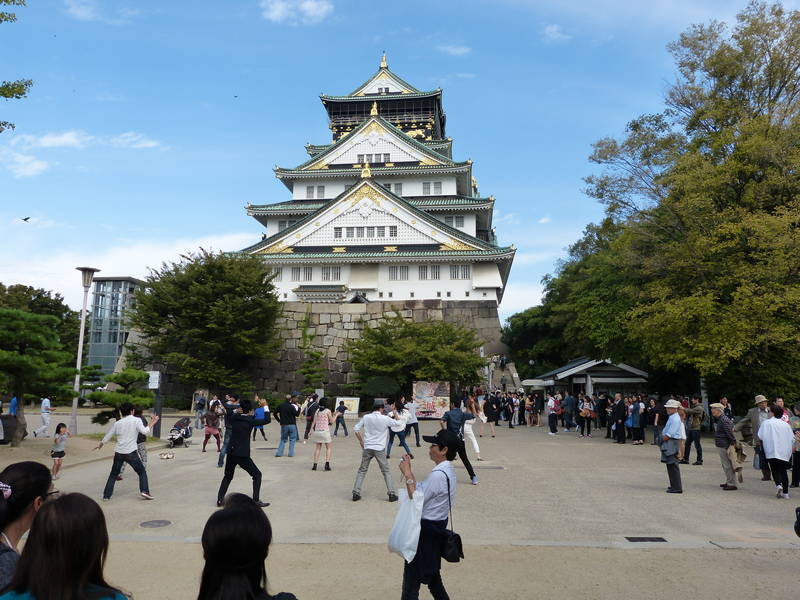
It's a marriage proposal
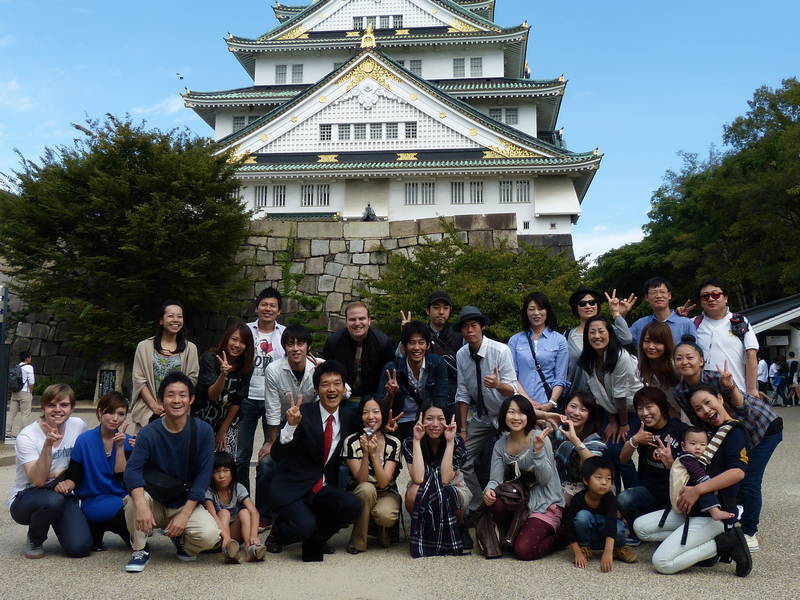
Lovely views from the top

Dioramas in the museum (Did George Lucas come here for Star Wars inspiration?)

Mock Samurais

After spending ages in the castle, we needed a snack, so Hideki suggested trying octopus balls. Wondering about the anatomy of an octopus, I soon learned that it was simply pieces of octopus, dipped in batter, then deep-fried and spherical in shape. After that, we wandered over to a Shinto temple, and crashed a traditional wedding. Well, it felt like we were crashing it as we stood and watched, but no one sent us away. The bride and groom led two lines of their family and wedding guests into the temple, and we followed them, peeking in and observing part of the ceremony. Beautiful. Hideki said that he would escort us into Nara with his van, about 40 kilometres away and we could visit there together. First we stopped for gas. This was no ordinary gas station, however. There were no pumps. Then I noticed some nozzles dangling and being pulled down from up above. Hideki explained that this is a space-saving mechanism. Only in Japan.
Takoyaki (Octopus in dough) Ekke thought they looked like Dutch poffertjes and dubbed them octopoffertjes

Yummy!
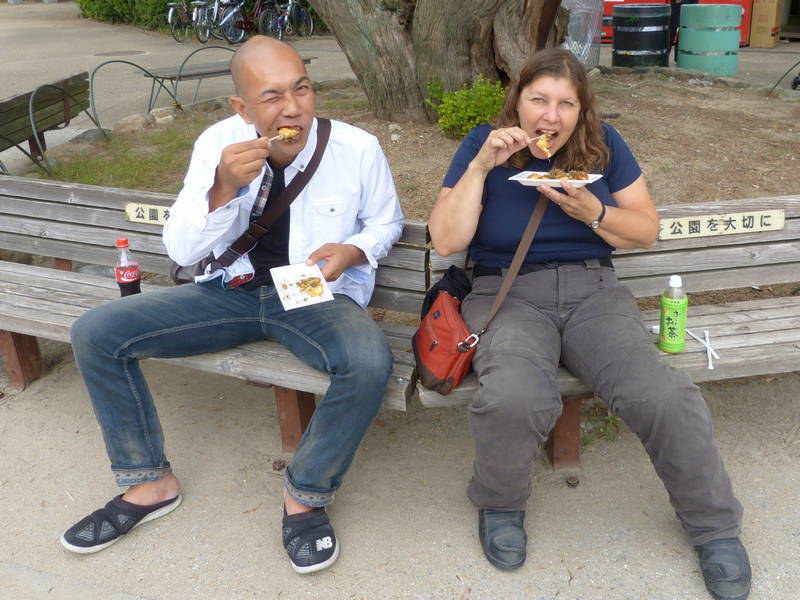
Traditional wedding near Osaka-jo

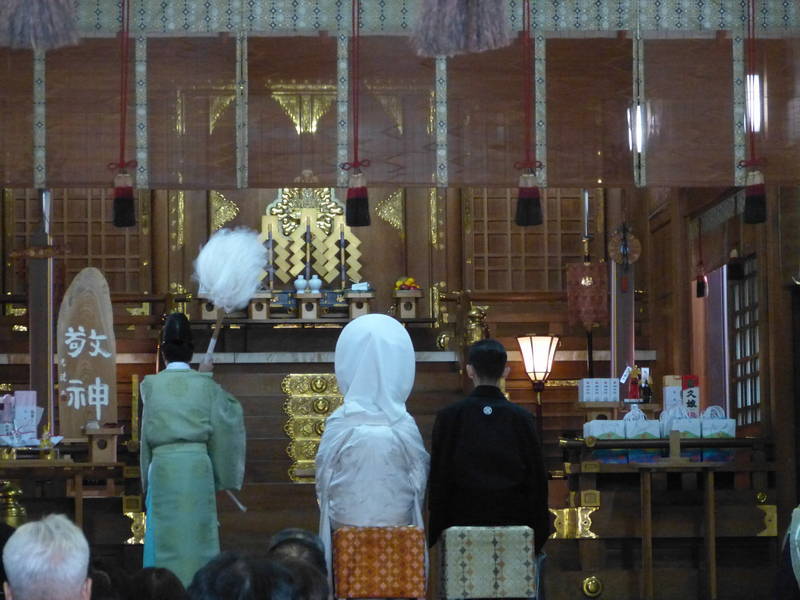
Where are the gas pumps?
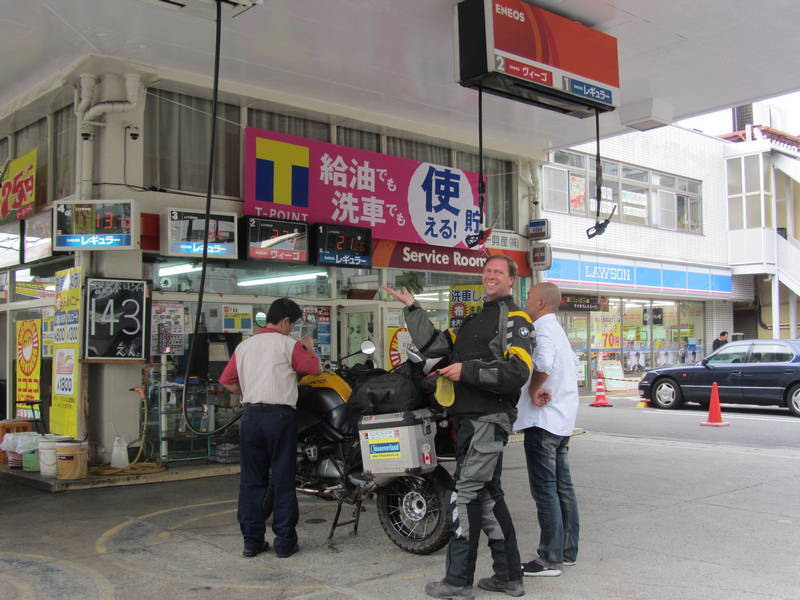
The route to Nara took us up and over big hills and it was fun riding the curvy roads. We stopped for lunch at Pokki. There was a big square grill embedded right into our table. Oil was poured on and various foods placed on to cook. Delicious. We parked at the Nara Backpackers Guesthouse and walked towards the temple area. Nara was the first permanent capital city of Japan and had a huge legacy in buildings and parks. Chieko had also lived here, so we had heard a lot about it. Deer wandered around everywhere, and we bought some shika sembei or deer biscuits to feed them. They got a little greedy though, and started snatching biscuits out of Ekke's hand, nipping at his fingers. When they started head-butting us, we knew it was time to move on. Our first stop was the Todai-ji Museum that housed ancient Buddhist bronze sculpture. Amazing how such detail in facial features could be achieved. Further along, the Nandai Mon Gate marked the entrance to the temple complex with a couple of fearsome Nil guardians flanking the side. Daibatsu-Den Hall, housing a huge Buddha, was magnificent. Lonely Planet had recommended a way to get a really stunning first glimpse of the Buddha within the hall. We took their advice. We walked up the steps, stood at the doorway, closed our eyes, centred ourselves, and, on the count of three, opened our eyes and looked up. The Great Buddha appeared before us in all its bronze and gold glory. This was a huge Buddha. We just stared.
Lunch at Pokki restaurant
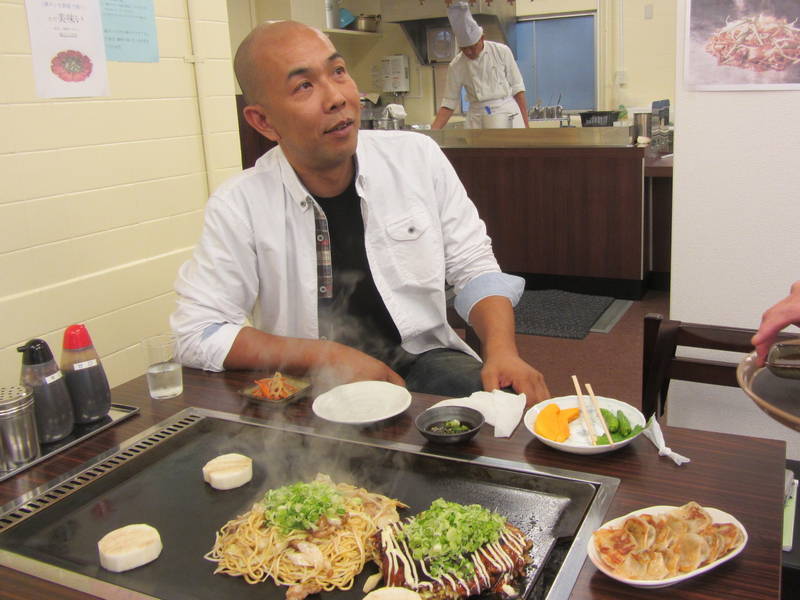
Nara deer get aggressive
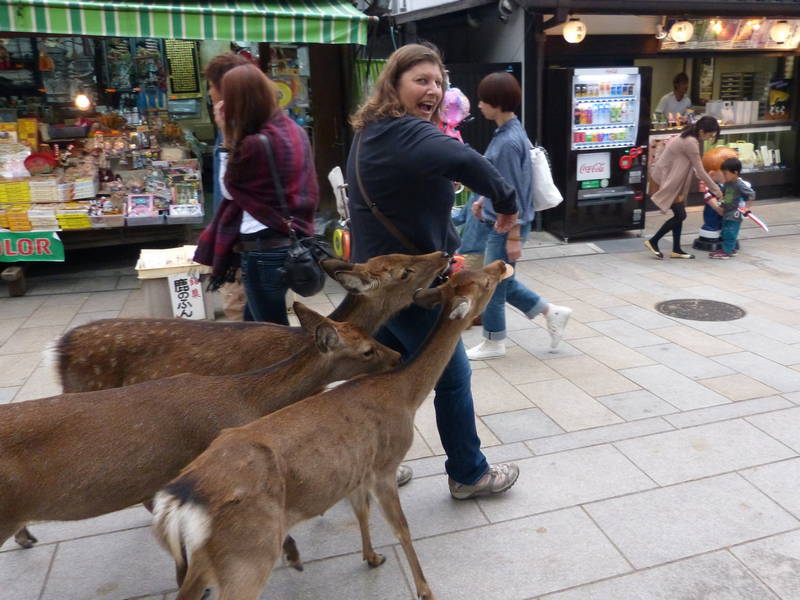
Daibatsu-Den Hall

Has an enormous Buddha statue

Which Audrey promptly "high fives"

Fearsome guardians
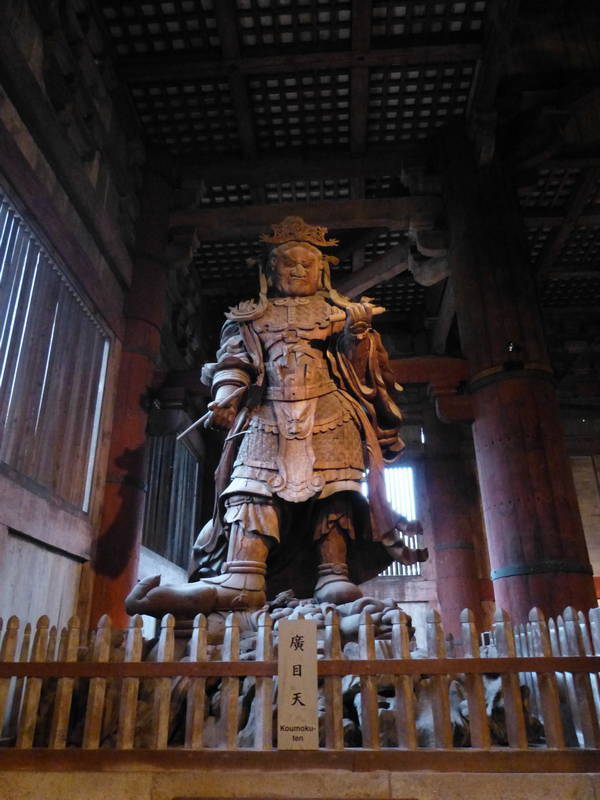
After a walk around Nara Koen park we stood and looked at a map of the whole area. A monk noticed us looking and suggested we walk up to a balcony of one of the temples for a great view. So, we did, and were rewarded with a sweeping view of the temples and of Nara. As an added bonus, it was a great way of working off those octopus ball calories. When we got back to the guesthouse we noticed a Honda CB 400F motorcycle parked in the lot. Onno had arrived. We hadn't seen each other since we had departed on our trip in July so it was quite a reunion. Hideki also knew Onno, having met him when Hideki stayed with us in Canada. Hideki treated us all to an incredible dinner, the colourful seafood, pickles and rice all presented in big square Bento Boxes. It was time for Hideki to drive back to Osaka, so we said goodbye, knowing we'd meet out there in the motorcycle travelling world again somewhere, someday.
Someone seems to have squeezed a Honda into our parking space
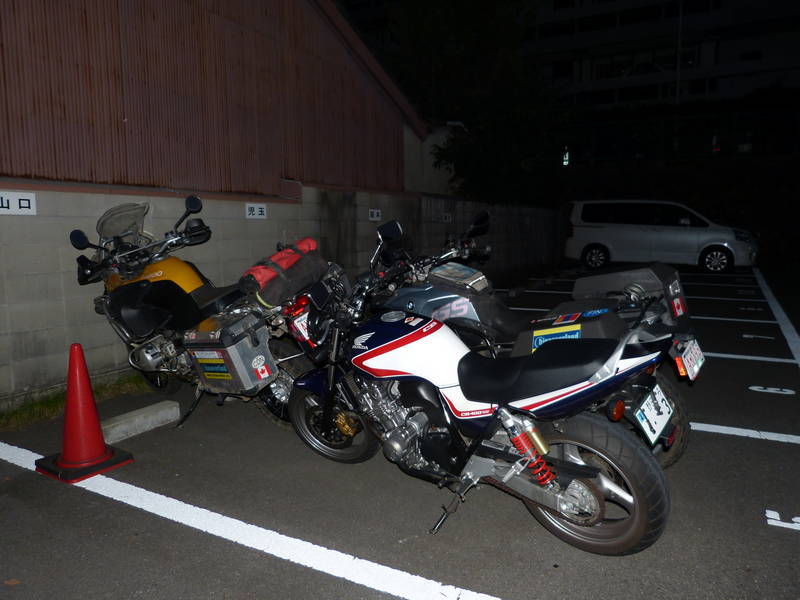
Enjoying a fabulous dinner
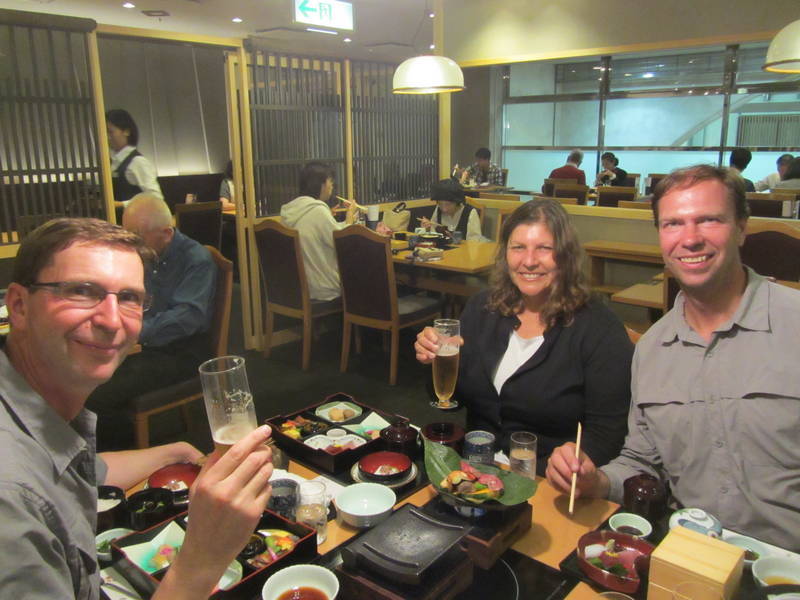
Perfect and colourful presentation
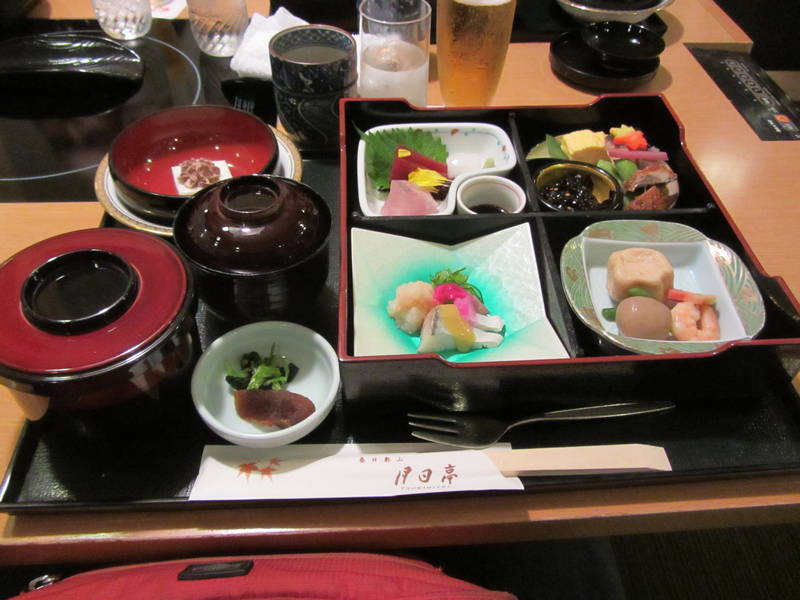
Chatting with Hideki back at the ryokan
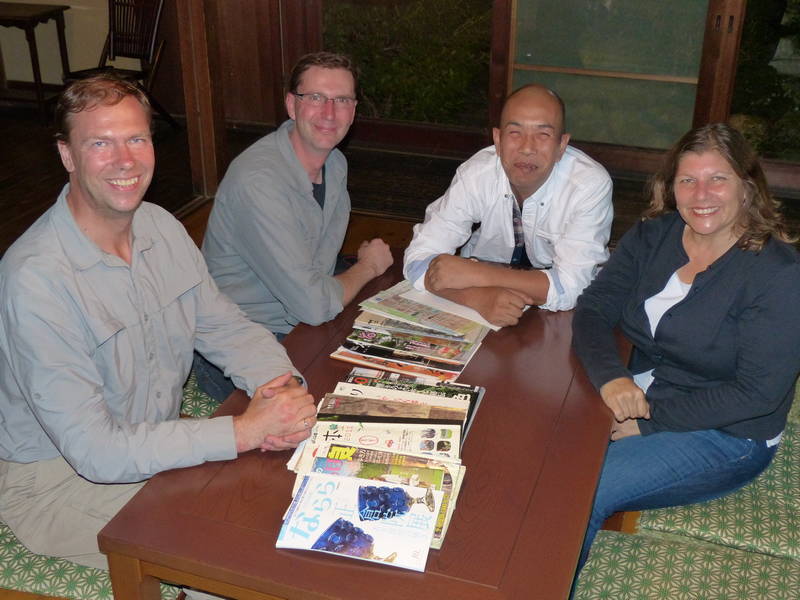
Ekke writes:
Monday, October 15, was our first day riding with Onno and also marked our first day of riding for the pleasure of riding. Up until now we had been riding purely to get to somewhere and if we found a nice road to get there, so much the better. Before setting off we wanted to visit Kasuga Taisha, a Shinto shrine established in 768 AD, and on the UNESCO World Heritage Site list. It was a lovely walk in the forest with many Nara deer, though not as many as the day before. The path leading up to the shrine was lined with stone lanterns and inside the shrine were beautiful bronze lanterns. Since we needed to be checked out of the ryokan by 11:00 we kept our visit short and hustled back, just in time to throw our stuff on the bikes. In the parking lot we had a look at the map and plotted a route south to the Kii Peninsula, getting underway by about Noon. After a bit of a false start leaving Nara on a dead end road, we eventually found our way to smaller country roads. Traffic wasn't terribly heavy but still, we rode through many small communities so it wasn't terribly fast riding either. At a rest area we had a decidedly unhealthy lunch of chips and a corn dog with cream puffs for dessert. Properly fortified, we then left the country roads behind and entered the hills. The traffic thinned out and what little traffic there was always pulled over to let us by. The roads weren't super twisty but had beautiful sweeping bends that were a lot of fun to ride. By 6:00 PM we had covered 140 kilometres and reached the town of Kumano on the coast. The easiest way to find accommodation in Japan is to head to the tourist office that is usually located at the train station. Following the signs to the train station in Kumano made it easy to find and as we dismounted our bikes we asked a couple of school girls if they knew of a hotel close by. Onno's Japanese is pretty darn good and it seemed to take people by surprise whenever he started talking Japanese. This time was no exception and the school girls were quite delighted to have this foreigner speaking to them, giggling almost uncontrollably. They weren't a lot of help in finding a hotel but it was a lot of fun chatting with them. Eventually Onno went inside the station and got a listing of hotels. We found a business hotel close by and bid adieu to our new friends. The rate of ¥8,000 ($90) for a double seemed steep for a fairly basic hotel and it wasn't terribly clean by Japanese standards but it was dark by now and we didn't have much in the way of options. The walk in the dark in deserted back alleys probably would have been uncomfortable in other countries but in Japan we felt perfectly safe. We ended up at a small restaurant where they put a charcoal grill in the middle of the table and then we ordered thinly sliced meats to cook. Delicious. This process was made much easier with Onno's language skills as he could actually order food whereas we had simply been pointing at pictures on the menu up until now.
Walking up to Kasuga Taisha
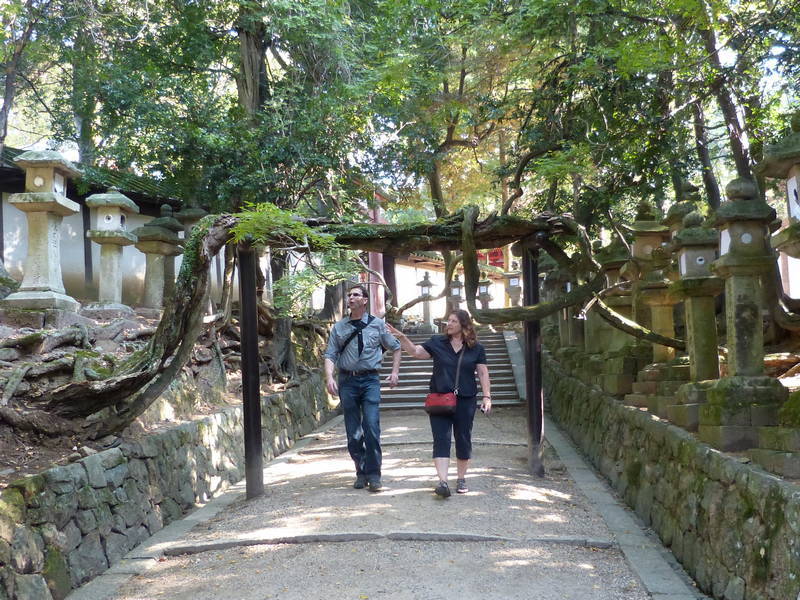

On the road with Onno

The road goes up into the hills of the Kii Peninsula
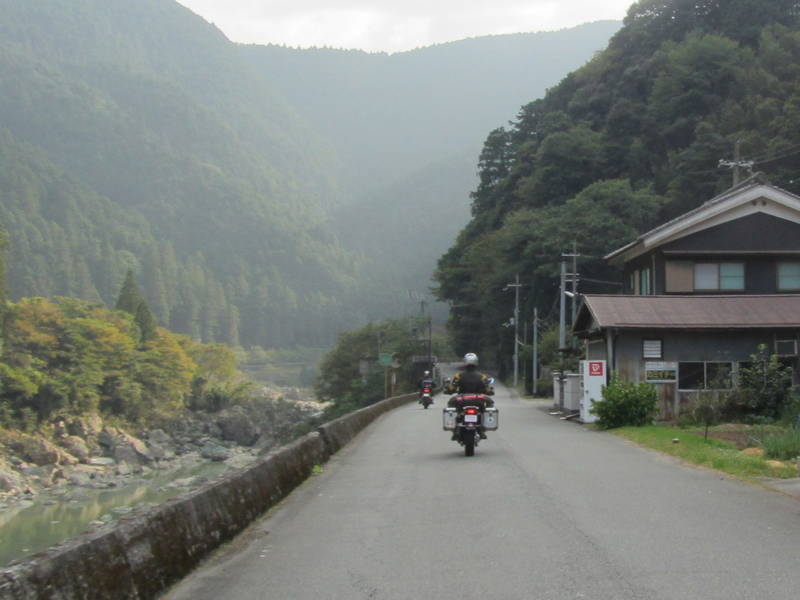
A couple of school girls are excited to see us in Kumano

Another in the series of Ekke and the low doors (at the hotel in Kumano)
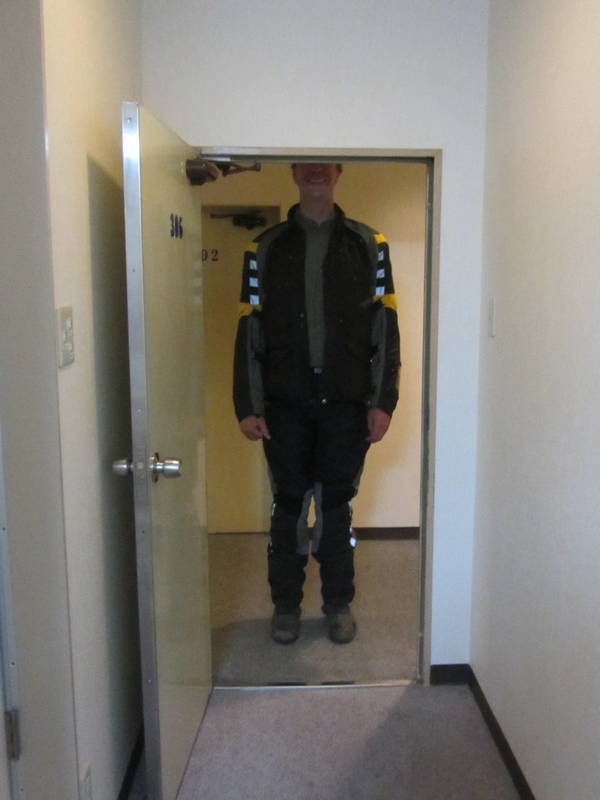
And another delicious dinner
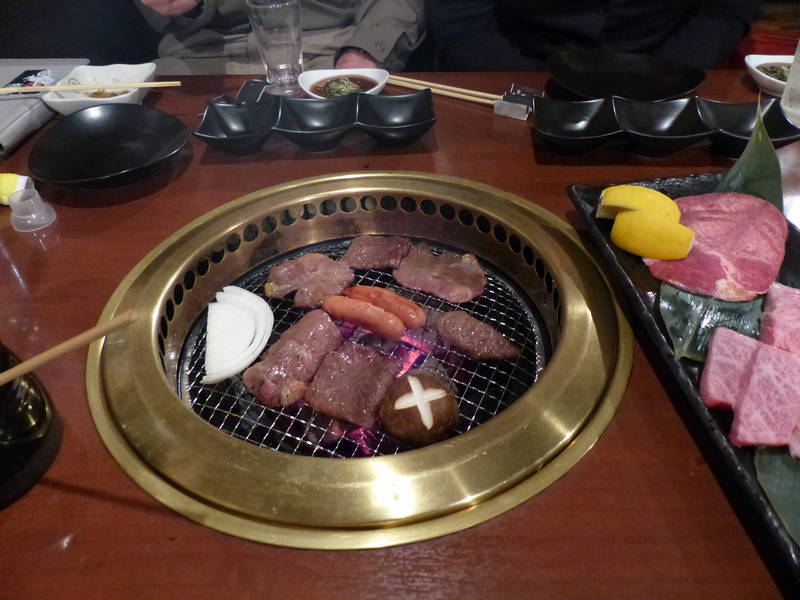
Tuesday we really took the riding for pleasure theme to a new high. Our plan was to ride a short distance south to a waterfall and then turn inland to ride mountain roads north, in the direction of the Japan Alps. We started off with the typical Japanese breakfast of fish and rice and then went for a walk along the beach. The small round stones were still a few millennia away from being sand but it was a lovely walk nevertheless. It's always good being by the ocean if you've grown up on the Canadian prairies. On the bikes it took an eternity of slow riding in city traffic to get to the Naicha Falls, 25 kilometres away. The falls and temple were quite beautiful though construction work was taking place to rehabilitate the river after recent flooding. This should have been our first clue. Our second clue should have been the "road closed" sign when we wanted to take the back road away from the falls in towards the mountains. We turned around, rode back down to the main road and used that to go up into the hills. Again a lot of construction work was taking place, cleaning up from recent flooding, adjacent to the road. Clue number three. The further we headed up, the narrower the road became and the fewer vehicles and people we encountered. What a joy to be riding these narrow mountain roads! We turned onto Highway 45, as that was the road that should be taking us north to Highway 44, through the interior of the peninsula. A sign with a large red X in a circle seemed to indicate the road was closed but short of turning around there was no realistic way to get north from here so we decided to try it. There was a fair amount of debris on the road (an affront to typical Japanese tidiness) indicating that the road wasn't used very much. After a few kilometres we found the source of the road closed sign. A large backhoe was parked where the road had washed away, down a steep hillside. We managed to get our bikes around the washout on a narrow dirt track and congratulated ourselves for overcoming the obstacle that was the source of the road closed sign. Taking lots of photos we then saddled up and rode 20 metres around a curve to find the true obstacle. The entire hillside had washed onto the road, trees and all. While it was possible to scramble over the obstruction, short of using a block and tackle it didn't seem feasible to get the motorbikes across. We had a long look at the maps and figured that we could backtrack to Highway 43 and then south to connect with 38 and 371 to get us back north. It was really slow going as we were now below the washout so the narrow road was covered in debris. There were no road closed signs though which we took as a good sign. However, the extremely slow riding meant that we didn't get to Highway 38 until almost 4:30 in the afternoon. As we hadn't seen a soul for the last several hours and no towns were indicated on the map along either Highway 38 or 371 we decided it would be safer to head for the coast where we knew there would be towns and hotels. As soon as we made that decision the road widened and straightened out so that the hour-long ride we were planning on to the coast only took 15 minutes. Going to the train station in Kushimoto we found the location of a nearby business hotel, checked in and walked over to a family restaurant for dinner. A standard menu item at family restaurants in Japan seemed to be a hamburger patty with some kind of tempura on the side, this one was no exception and it was delicious. The sundaes for desert were also quite special. The road along the coast hadn't been much fun for just the few kilometres to town so we thought we would give the mountain roads another shot the next day. We made 130 kilometres over the entire day, all of it in the exact opposite direction of our destination.
Breakfast at the hotel
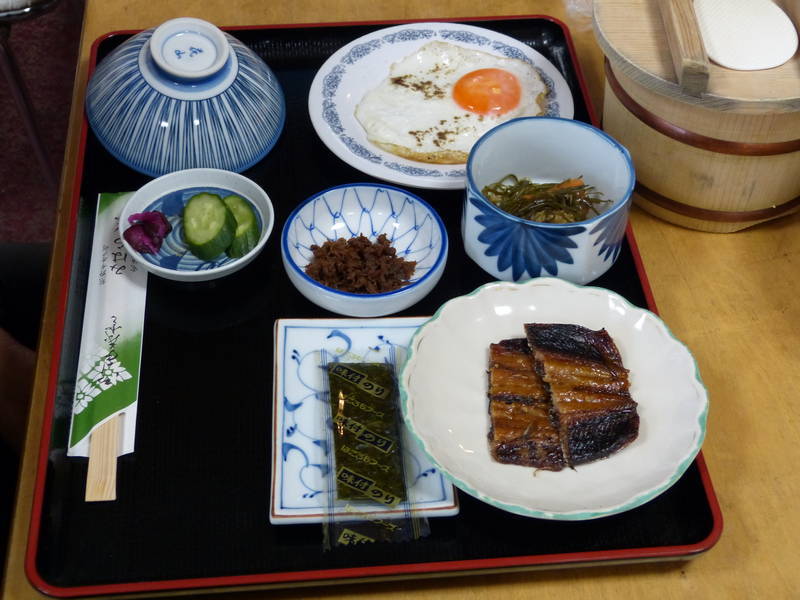
Onno plays on the beach
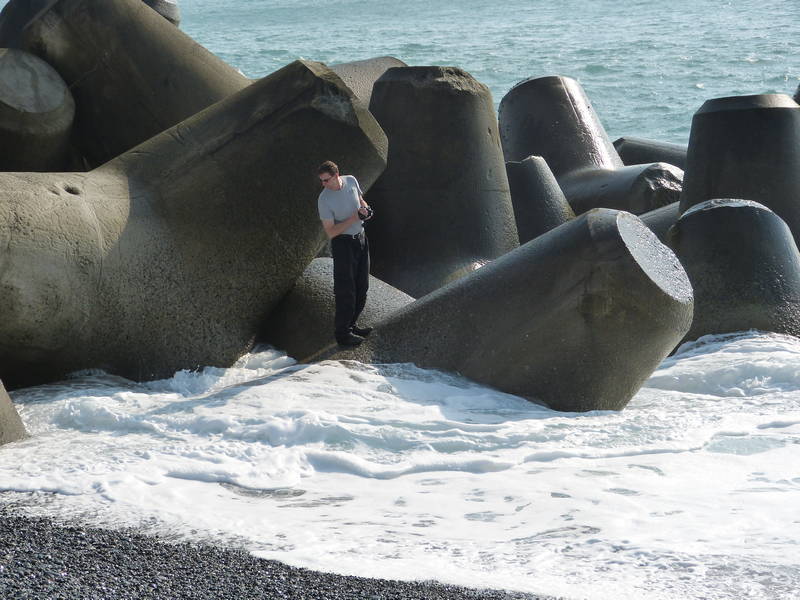
Riding south

Grabbing a nice hot coffee from a vending machine

Curvy roads heading up towards the falls

Naicha Falls
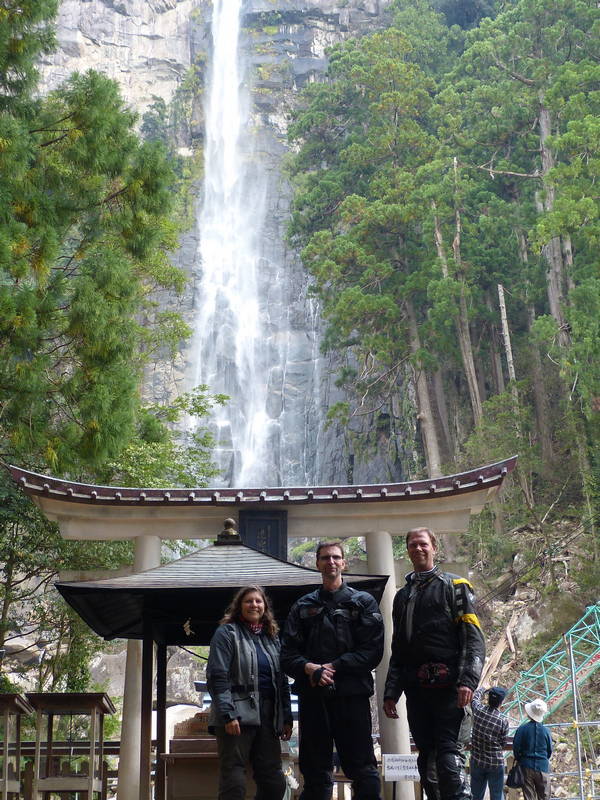
Backtracking to the falls after the first road closure
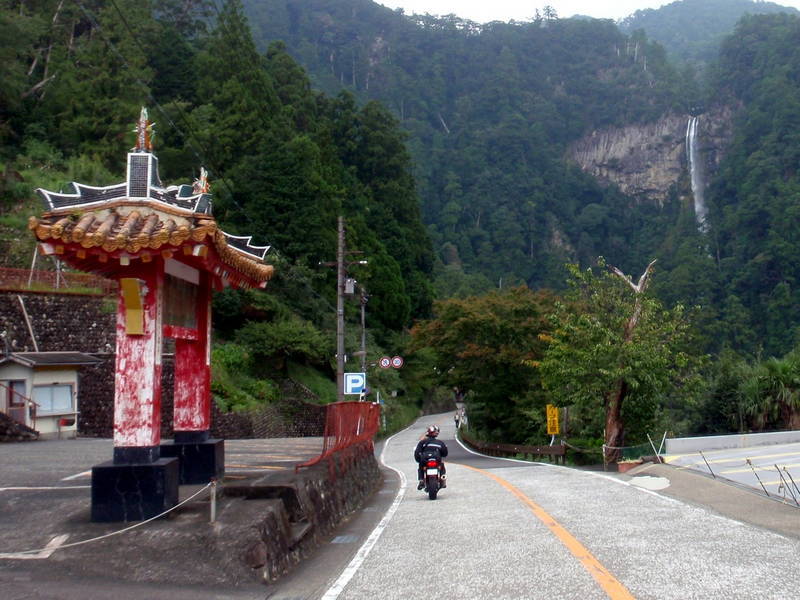
Lovely small roads are a pleasure to ride
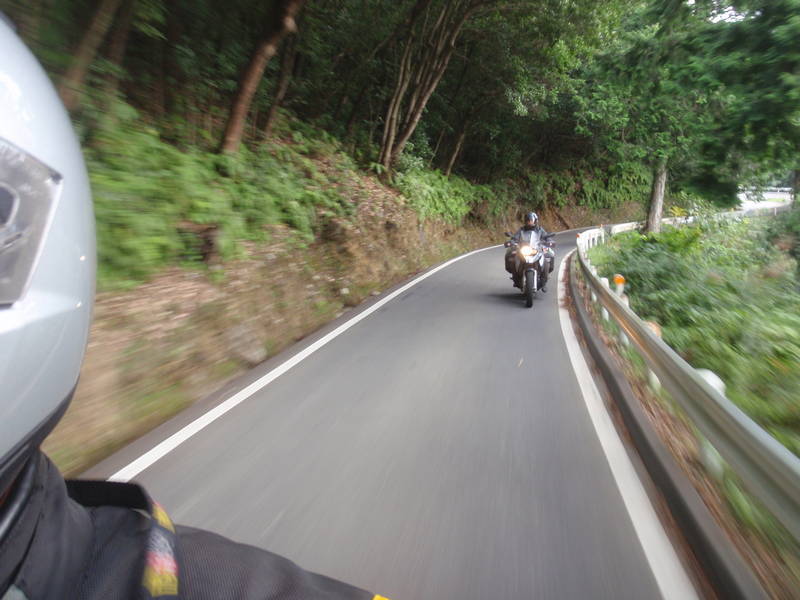
Repairing flood damage alongside the main road

Beautiful views when we're up in the hills

What great riding
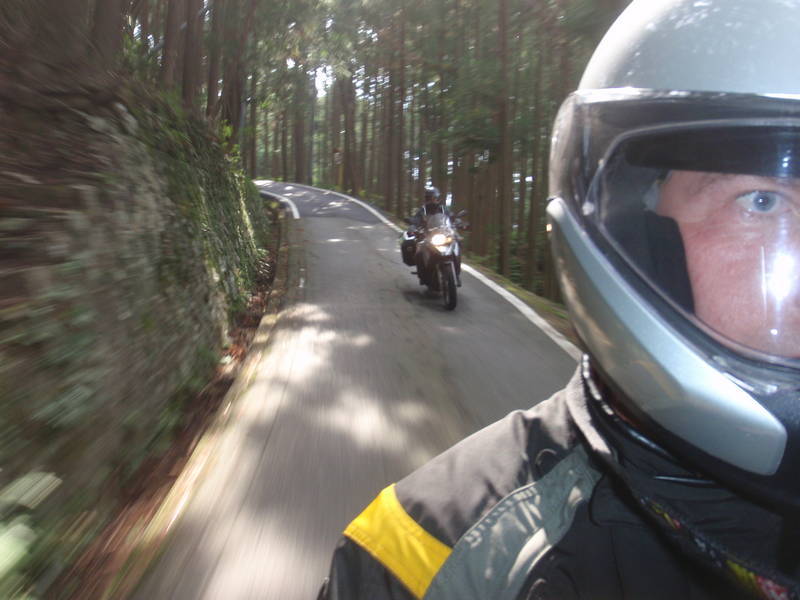
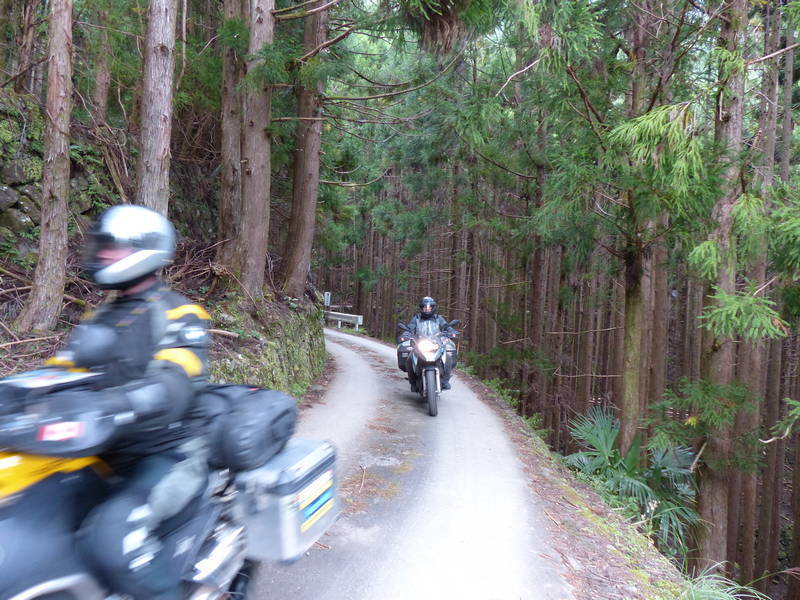
Hmm, what could a sign with a whale on it mean? Nothing says "road closed" like a whale.

Getting around the washout
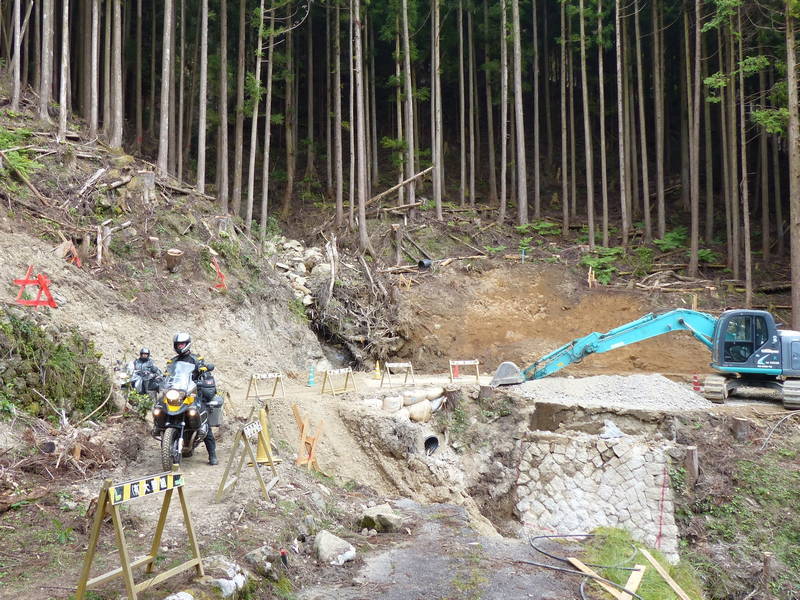
Clearing a stump
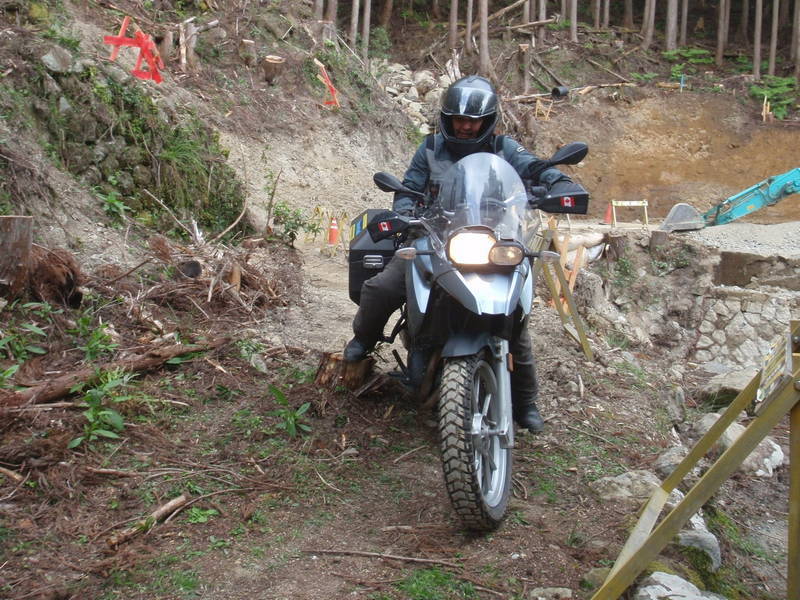
Only to find the real reason for the road closure

Checking the map on the iPad for alternative routes

Turned back we ride along tea plantations but see almost no-one
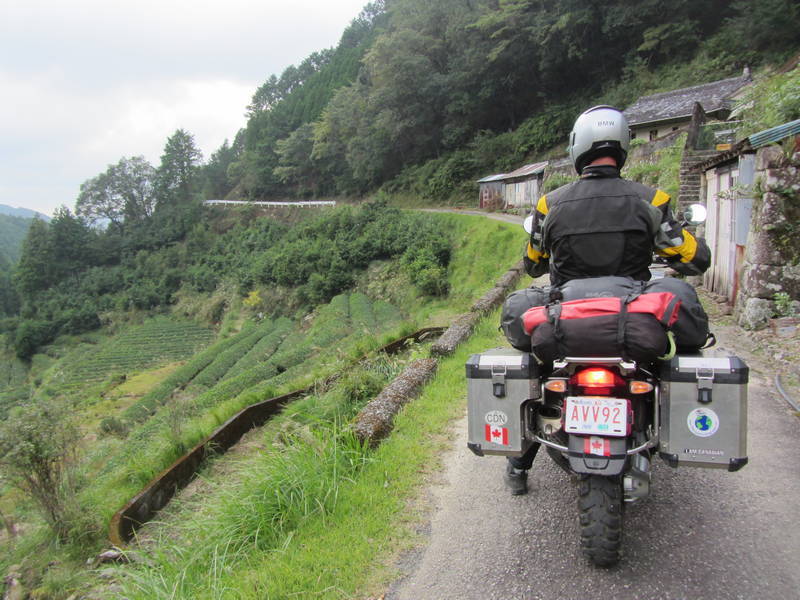
Debris covered road is an affront to Japanese tidiness but at least it isn't closed
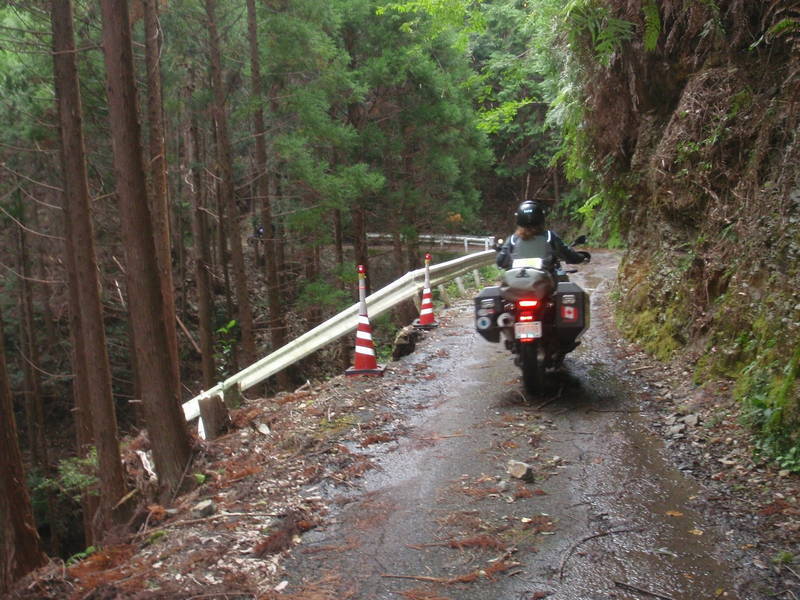
Ekke shows where we've come so far
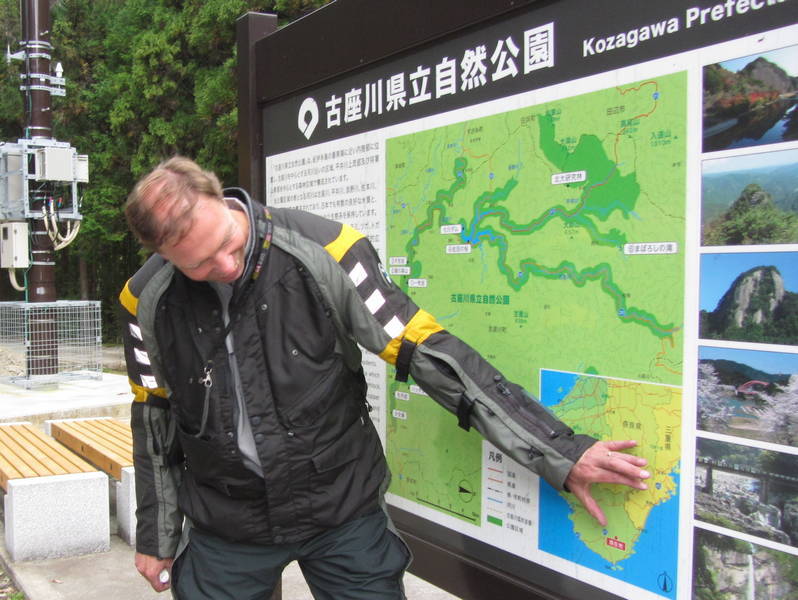
How do you make a sundae even better? Slap a creme caramel on top of course!
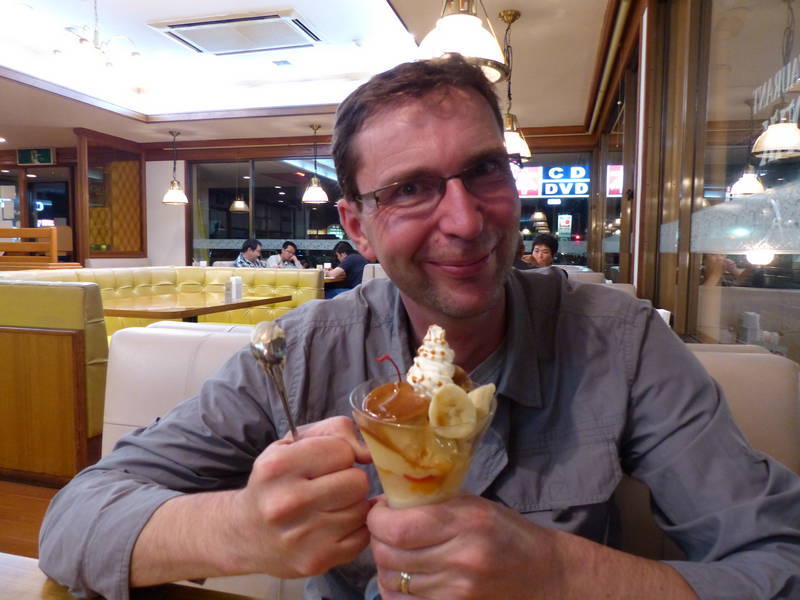
Wednesday we picked up breakfast at a Circle K convenience store and then rode in a light rain to a set of beautiful rocks we had ridden past the day before. An awning provided some shelter from the rain as we ate our breakfast and discussed what we should do. This rain, even though it wasn't terribly heavy, would make the narrow, twisty mountain roads even slower to ride as well as take out a lot of the fun. We decided to head north along the coast. At 20 degrees it wasn't too cold and the rain was intermittent so we only put in our Gore-Tex liners rather than the full raingear. North of Kumano, an offshoot from the main highway around a headland, had some nice twisty roads and beautiful views of tiny fishing villages clinging to the rugged coast. By this this time it was raining steadily and we were completely soaked. I'm sure this section would have been much more fun in the dry. Back along the main highway we commandeered an entire section at a McDonald's to spread our wet stuff out in the hopes of getting it a bit drier. 1.5 hours later we got all geared up again and stepped out into the rain. It was only a few kilometres to the toll expressway and there we could keep up a reasonable riding speed. It was clumsy getting the toll ticket, trying to keep it dry until we exited the toll way and then fumbling for the damp ticket and a credit card, but we did make over 200 kilometres before darkness overtook us. It was about 4:30 when we took the exit for Suzuka (the F1 race was here only a couple of weekends previous) and asked at a gas station for the location of a nearby hotel. They gave Onno directions and eventually we found the Route Inn. While the ¥15,000 ($175) was way above our budget it was dark and raining so we didn't have many options and took it. It didn't take long for us to hang all of our gear up to dry and then pop downstairs for a tasty dinner.
Beautiful rock formations on the way out of Kushimoto
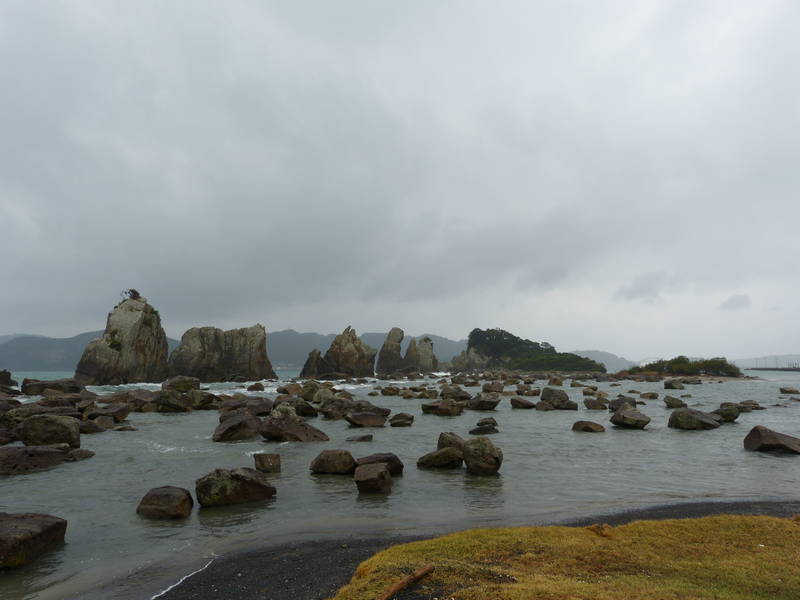
Stopping at a temple on the ride north along the coast
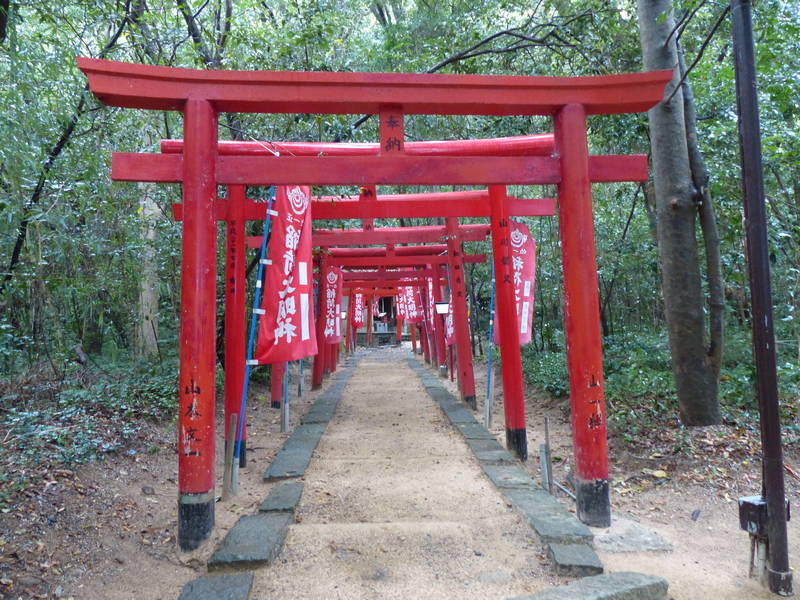
It starts raining more heavily

Villages cling to the rugged coastline

Covered parking for motorcycles at rest areas along the expressway are appreciated
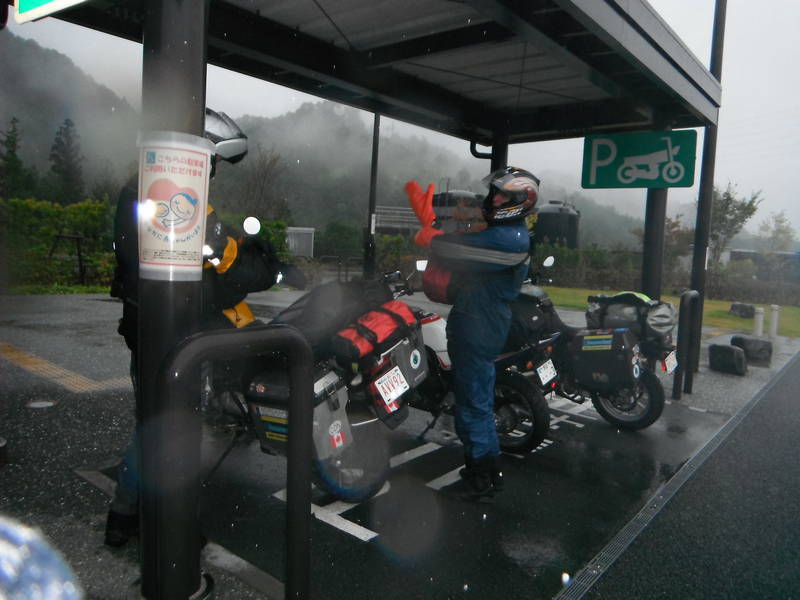
Audrey isn't too impressed by the water resistance of her Jesse luggage

Our destination of Takayama was a little over 200 kilometres away and it would be mostly expressway so we didn't need to rush out first thing on Thursday morning. Still, it was raining lightly so after yesterday's experience we thought it best to put the raingear on right away. At Nagoya the toll road ended and almost immediately another toll road started. This local toll road had a pay up front system so we needed to fish around for our wallets and dig out a few hundred yen to go around Nagoya. Back on the national toll way it was again a simple matter of taking a ticket at the start and then handing it, along with a credit card, to the attendant when getting off the toll way. This was certainly much more convenient but it was also expensive, as the 130 kilometre stretch cost us about ¥2,500 ($29) each. It was really enjoyable riding as the rain lessened and we were able to see the mountains, when we weren't in tunnels that is. It seemed that the Japanese expressways had as many tunnels as the roads in Norway did. According to the road signs we should have also been alert for monkeys on the road but we weren't fortunate enough to have to avoid any. We went to the train station in Takayama to find a place to stay and then rode over to a guest house. Despite looking high and low we couldn't find it so we pulled out the trusty Lonely Planet guide which recommended the Sozuke ryokan. Onno thought he had seen it on the ride in to the train station so we headed straight there only to find a tour group going in the front door. With fingers crossed, we entered and asked if there was room available for us. There was and we could sign up for a traditional dinner too. Perfect! We had enough time in the afternoon to explore Takayama and wandered around the old town before going to the festival floats museum. The highly decorated floats are carts used in the spring and autumn festivals when they are paraded around town at night. It was too bad that we had just missed the autumn festival as it was held the previous week. Back at the ryokan the supper was absolutely delicious as we sat around the low table with our feet in the pit below the table wearing our yukatas (robes). A nice hot bath in the communal tub (separate for men and women) after the cool and damp ride of the day was certainly nice.
Stopping for a hot tea and coffee break (Japanese vending machines are great!)

Caution monkeys!

Onno misses the heated grips from his K1200RS at home (and probably the 130 horsepower too)
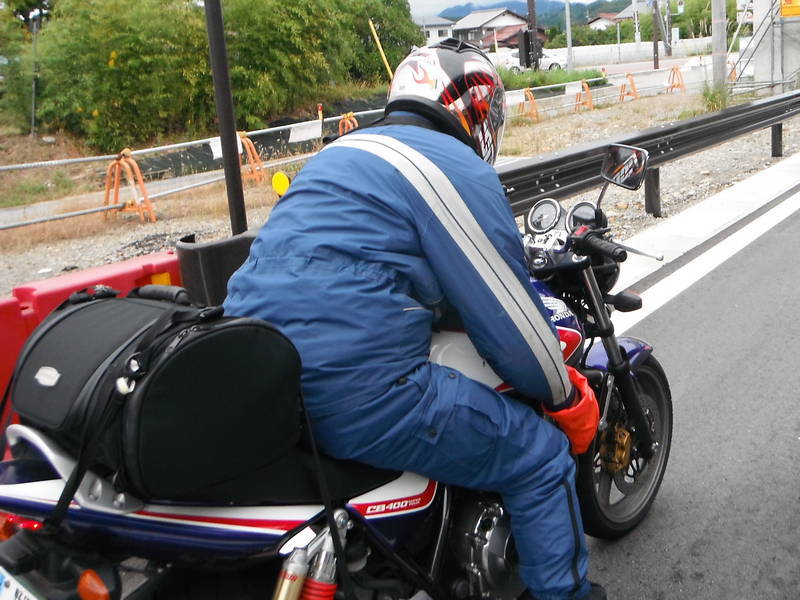
Arriving at our ryokan in Takayama

Delicious looking dumplings bring us in

Yummy!
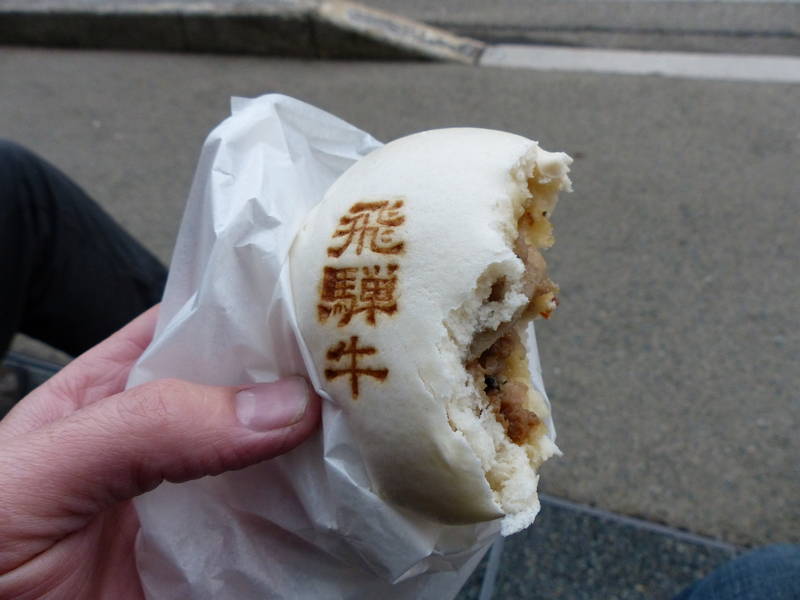
Wandering the old town streets
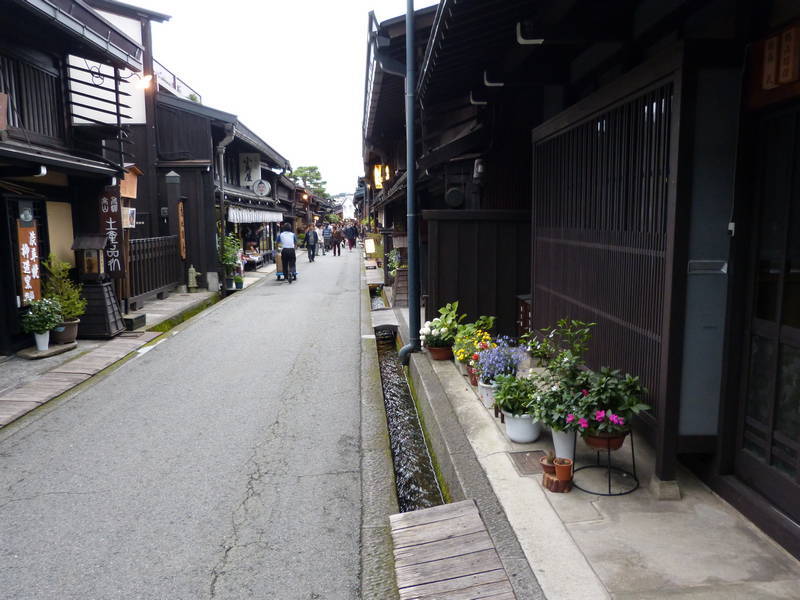
Sampling a little sake

Festival cart museum

Enjoying a traditional dinner in our yukatas

After a traditional Japanese breakfast we packed the bikes and rode a kilometre or so to Hida no Sato, which was a heritage park where old buildings had been moved to and put on display. The grass thatched buildings were beautiful and it was especially interesting to learn some of the history of the area. Each of the grass thatched buildings had a fireplace, this fireplace was important not only for heating the home in the winter but also the smoke from the fire kept the insects out of the roof and made the ropes strong. Looking for twisty mountain roads in the hopes of climbing to an altitude where we could see some of Japan's famous fall colours we spotted Highway 5 not too far out of town. When we got to the start of the road we were greeted by a toll booth attendant who indicated the road was closed. This seemed strange as a tour bus had gone in ahead of us. Onno got a little more elaboration and found out the road was closed to motorcycles but couldn't find out why. So we backtracked a little and took an alternative route. It was still nice with the autumn colours starting but the wet leaves on the road tempered our pace a bit. When faced with a toll tunnel we opted to take the old highway going over the mountain instead of the tunnel through it. This went well for a while as there was little traffic, the roads were curvy and the colours lovely but at the top of the mountain the road was closed. We had to turn around and use the ¥600 toll tunnel as that was now the only way for us to get to Matsumoto. The Japanese Alps made for cool riding at only 8 degrees Celsius but it was just beautiful arcing through corner after corner with the leaves starting to change colour in different places on the mountains. After another monumental day of 106 kilometres (did I mention it can be slow riding in Japan if you don't use the toll expressways?) we found a ryokan in Matsumoto. We unloaded the bikes, got settled into our tatami mat room and then walked over to Matsumoto-jo (the castle) to find it had already closed up for the evening. The light from the setting sun was beautiful and we shot lots of photos of the exterior of the castle. Dinner of fish and chips (and a Guinness for Audrey) at an Irish Pub was quite tasty and a change of pace from the Japanese food.
Hida no Sato

Ekke and Onno try a traditional game (without much success)
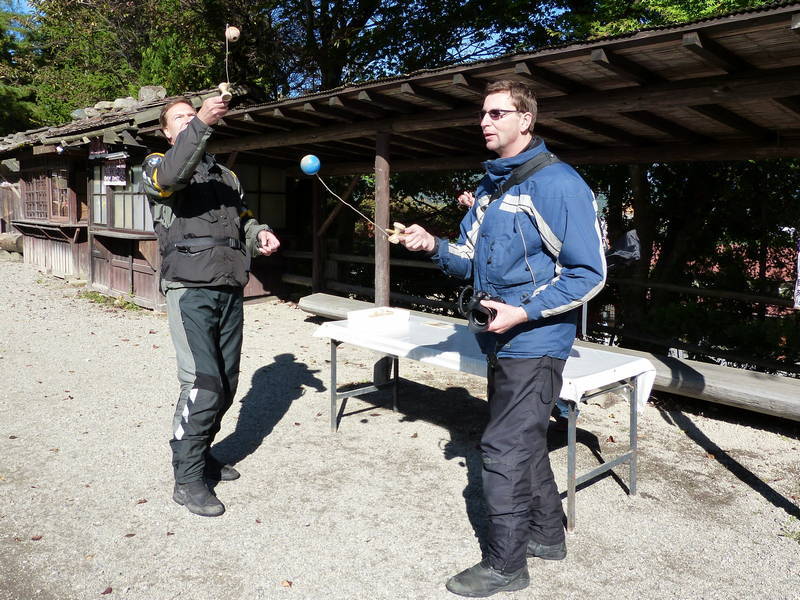

The fire not only heats the home but also keeps insects out of the roof and makes the ropes strong

How warm would straw snow boots be?
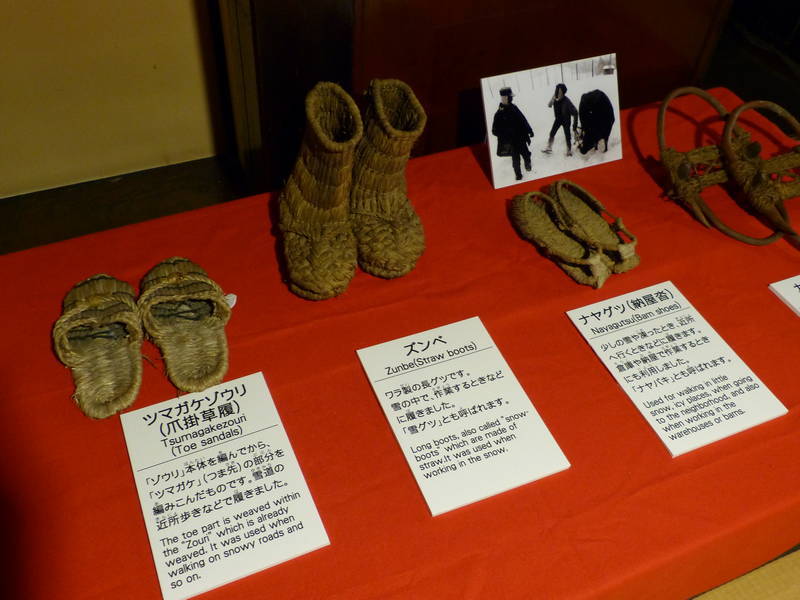
Audrey takes a break

The fall colours are starting in the hills
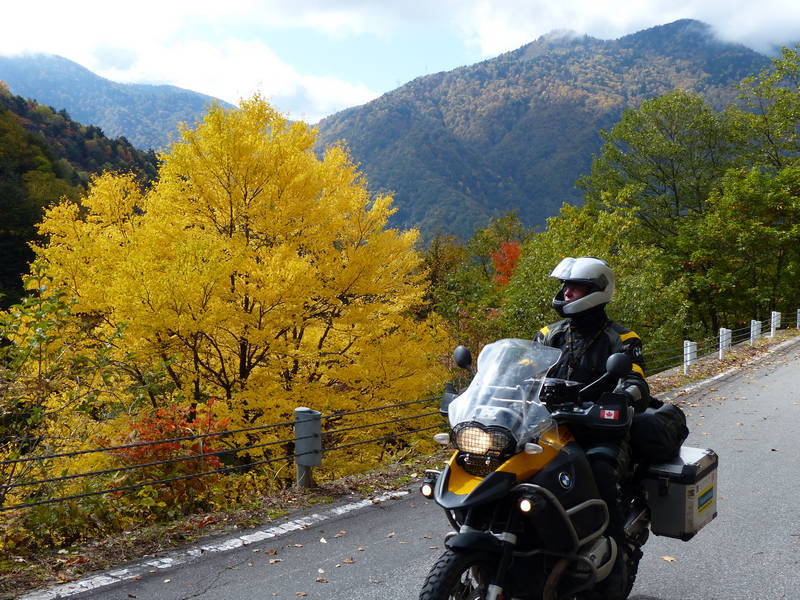
Arriving at our ryokan in Matsumoto we are greeted with a cozy looking tatami mat room
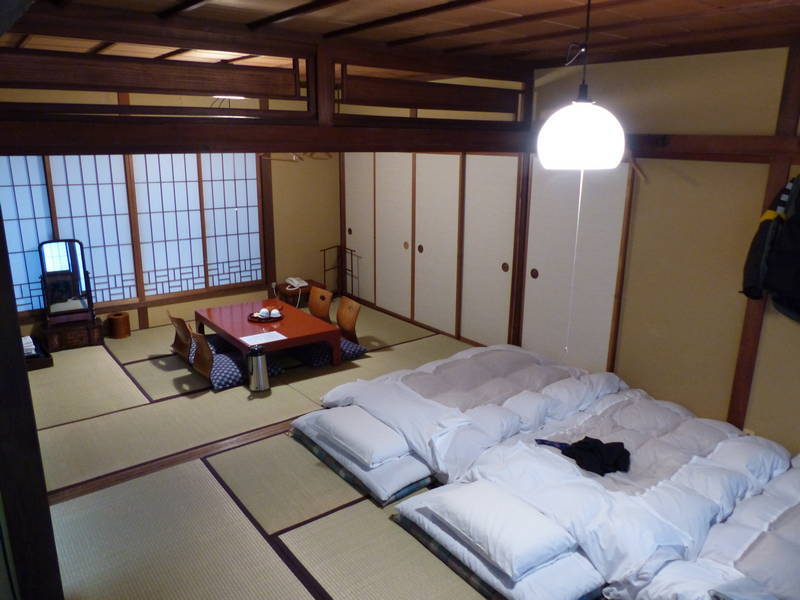
Matsumoto-jo looks beautiful as the sun sets
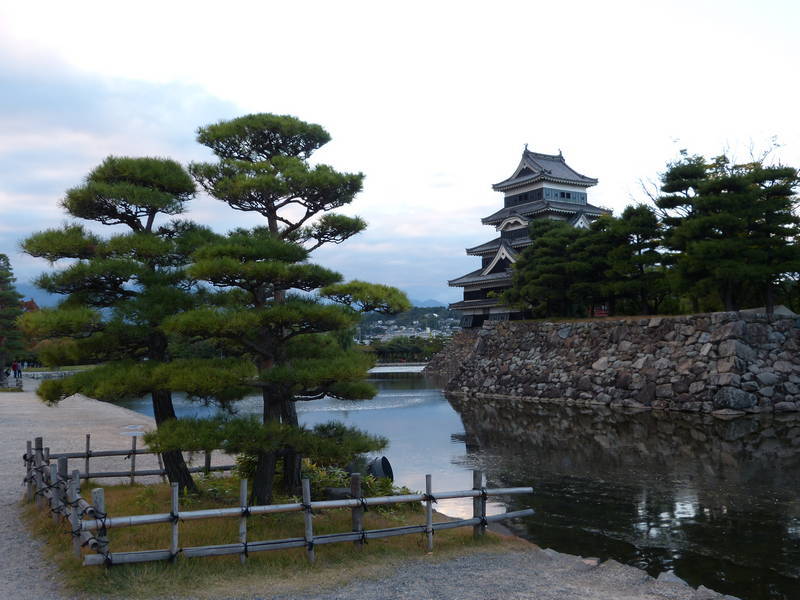

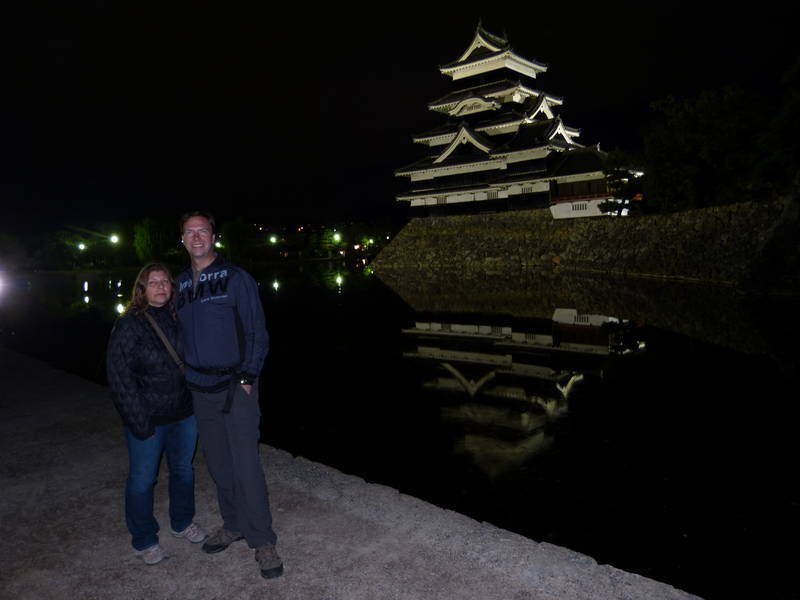
Relaxing back at the ryokan

On October 20 we wanted to experience as many twisty Japanese mountain roads as possible before heading to Tokyo, so we plotted a route up into the hills east of Matsumoto. We encountered another closed road (perhaps again due to flooding?) so had to do some backtracking but the riding was utterly beautiful on the steep, twisty roads. When we connected back up with the road that was closed we noticed that motorcycles were passing by the barriers so perhaps the road was open for bikes only. If only we could read Japanese. Also near the top was a campground that looked really nice, so that was something to keep in mind for when Onno had gone back to Canada. Camping might be a way to reduce our accommodation costs a bit in Japan. A few more lovely roads led us to a viewpoint where we could see the entire Matsumoto valley far below and the Japanese Alps in the distance. The tight and twisty roads had many really tight corners and switchbacks. Each corner had a mirror so that it was possible to see if there was any oncoming traffic on the narrow road. At one tight corner Onno, who was riding in front, suddenly pulled over to the shoulder, almost losing his balance at the drop-off to the ditch. With visions of an enormous Fuso dump truck I too slammed on the brakes and pulled over. Imagine our amusement when the tiniest of tiny Japanese pickup trucks rounded the bend. It reminded me of something from a Bugs Bunny cartoon. By this time it was past noon and we still had about 200 kilometres to go to Tokyo so we started heading in the general direction of the expressway. Fortunately we still had some great riding in the mountains to enjoy, and then unfortunately some city riding before getting to the highway. We ended up at Onno's father-in-law's apartment at about 5:00 PM and promptly called Motorrad Central to see if we could drop off Audrey's bike. With Onno's help we had ordered new wheels for the F650GS (after the pothole in Mongolia had dented the rims) and they had been shipped to Mr. Noguchi's house. He had been nice enough to store them for us for the last three weeks and naturally Audrey was anxious to get round wheels on her bike. Though to be honest, the dented rims had held up perfectly for the last 8,000 kilometres. Motorrad Central said we could drop the bike off before 7:00 PM on Saturday evening and the wheels would get installed on Sunday but because the steering head bearings also needed replacing it would be a day or two longer before we could pick the bike up again. (Most businesses in Japan only close for one day a week and that is a day of their choosing. Motorrad Central is closed on Tuesdays.) We lashed the wheels to the back of the Adventure and took about 30 minutes to ride the ten kilometres to the shop. The friendly staff at the shop (are all BMW Motorrad service managers in Japan named Kentaro?) took the wheels and had a quick look at them to make sure they were the correct ones before sending us on our way. I doubled Audrey on the back of the Adventure to Mr. Noguchi's house where we enjoyed a delicious home-made curry rice supper.
Enjoying a cup of tea in the morning

Riding up into the Japan Alps
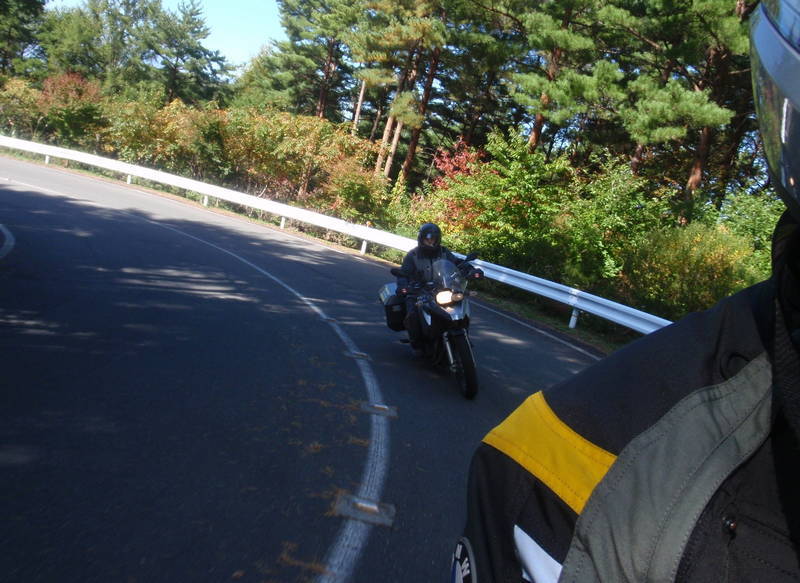
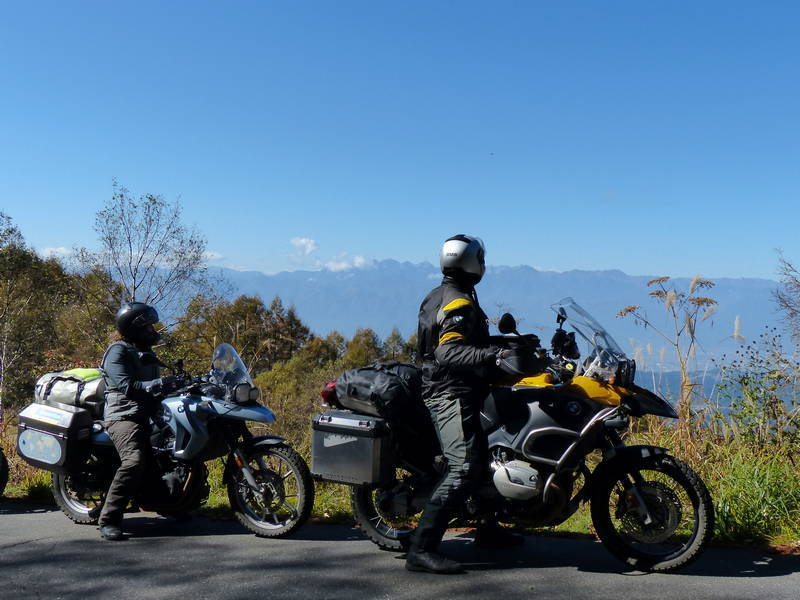


Lunch break at 7-11

Zooming down the expressway towards Tokyo
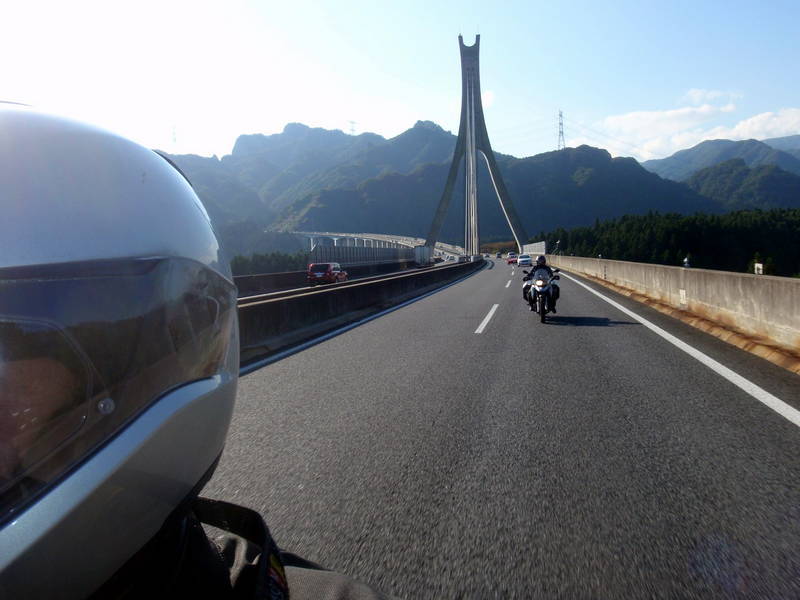
We had originally planned to drop the F650GS off on Sunday but now we had the whole day to do some sightseeing in Tokyo. With Onno, we walked over to the Omiya Japan Rail train station and hopped on an inbound train. First stop, Akihabara or "Electric Town". This is the place to go if you want to find bargains on electronics but it has also morphed into the centre of geek culture. This means that we wandered through electronics stores as well as a few anime shops. The sheer quantity and variety of electronics shops was stunning, it seemed to be possible to purchase any electronics related device known to modern (and perhaps not so modern) civilisation. Back on the train we headed to Tokyo Station which had been restored and opened only a few days earlier so was rife with crowds looking at the magnificent building. We walked over to the Imperial Palace grounds for a photo of the wall and moat (reservations to take a tour of the grounds must be made well in advance) and then over to the Mitsubishi Ichigokan. This was the area's first office building and had a fascinating display and video of how the area has changed over time. While the original 1894 building was long destroyed, the current building is an exact replica, based on the original blueprints, built in 2009. The next train stop (after again admiring the restored Tokyo Station) for us was the super-fashionable area of Harajuku where a stroll down Omote-sando-dori reminded us of Champs-Elysees with the fashion houses, such as Gucci and Prada, lining the street. There were even a few goth-loli girls standing around waiting for someone to come over and take their picture. A lunch of delicious pasta followed by a yummy cheesecake crepe at a roadside vendor and we were off again, this time to Toyota's Amlux building. There were lots of Toyota models on display in the five storey building, including cut-away Priuses and the latest Toyota Century which looked suspiciously like it came straight from the 60's. A Toyota racing car simulation was as much fun as the trailer of an upcoming anime movie in Japanese was confusing. The best part of the Amlux building had to be the girls who dusted the display cars. Six or eight of the girls would march out in unison and each go to a car. Then, perfectly synchronised, they wielded their feather dusters and sashayed around the car, removing any accumulated dust. When complete, they all came back together and marched over to the next set of cars to be dusted. Toyota could have charged money for this. Back in Saitama Mr. Noguchi took us out to a great family restaurant, Jonathan's, where, similar to other family restaurants in Japan, a delicious beef patty and tempura (oysters this time) awaited me. Canada Dry ginger ale topped off the event and the day.
The wall around the Imperial Palace in Tokyo

Practical bike for carrying the children
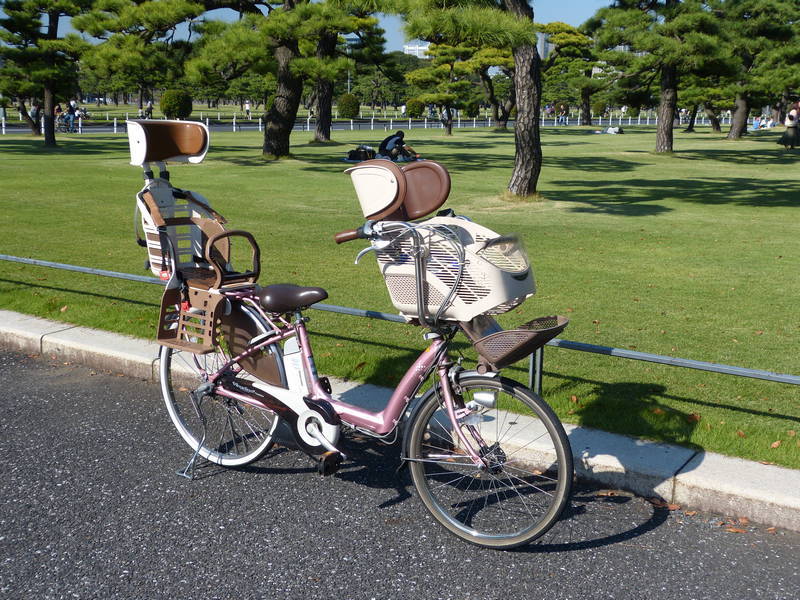
Electronics stores galore in Akihabara

The crowds in Harajuku
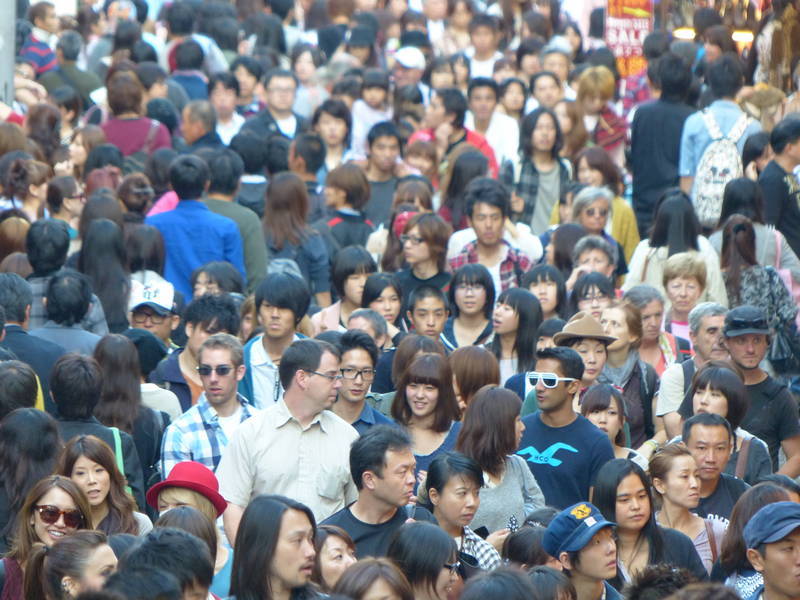
A "goth-loli girl" in Harajuku

Audrey tries out a Toyota racing simulation at the Amlux building

A cut-away Prius

The dusting girls were fun to watch doing their synchronised routines
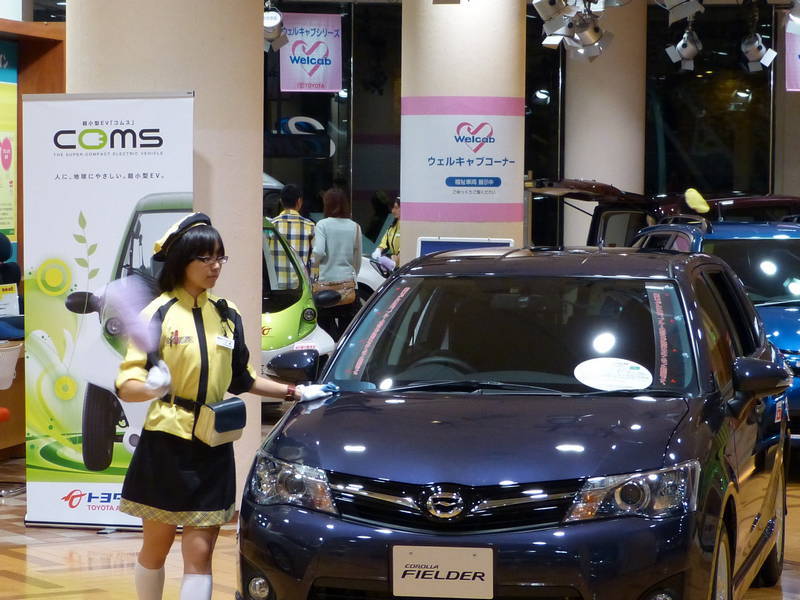
This brand new Toyota Century looks like it came straight from the 1960s

Onno and I cleaned up the bikes and then rode over to the rental agency to return the CB400F on Monday. It had been a great bike for Onno, if a trifle cramped. We doubled up on the Adventure back to the apartment after having a bowl of noodles for lunch. Later in the afternoon Onno and I went to Bic Camera, an enormous electronics store near the Omiya train station. Lots of cool, new gadgets on display but once we converted the price from yen to Canadian dollars there weren't any savings to be had, it was all about selection. At dinner time we met Onno's brother-in-law, Shinichirou at the train station and walked over to a yakatori restaurant. Here they kept bringing us yakatoris (meat skewers) until we told them to stop and then to pay the bill they simply added up the total number of sticks left behind. The crowd seemed to be mostly business men stopping off for a drink and a snack. After the appetiser yakatori we headed up to a restaurant on the ninth floor of a shopping centre and had tempura for dinner. It was great getting caught up with Shinichirou, whom we hadn't seen for many years. He was now running three dojos and had more than 300 students studying Aikedo.
Returning the rental bike

Slightly confusing signs
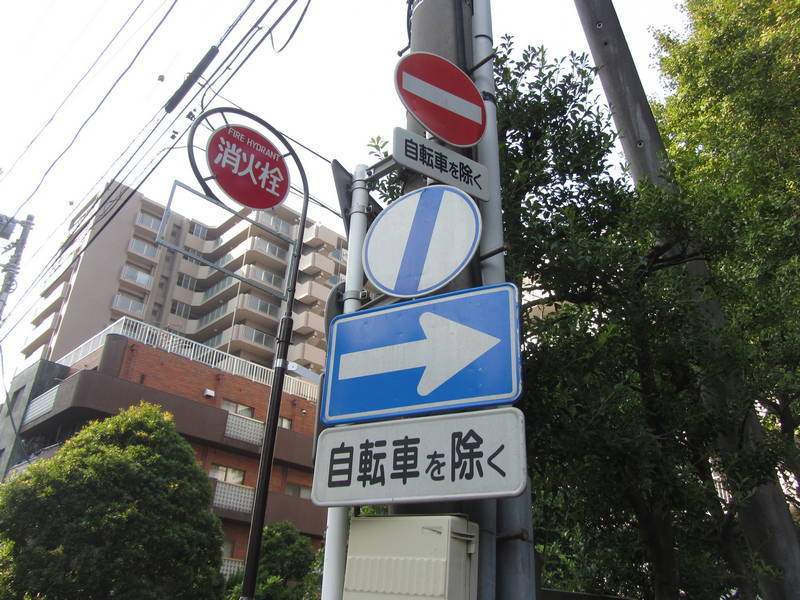
Dinner with Takehiko and Shinichirou
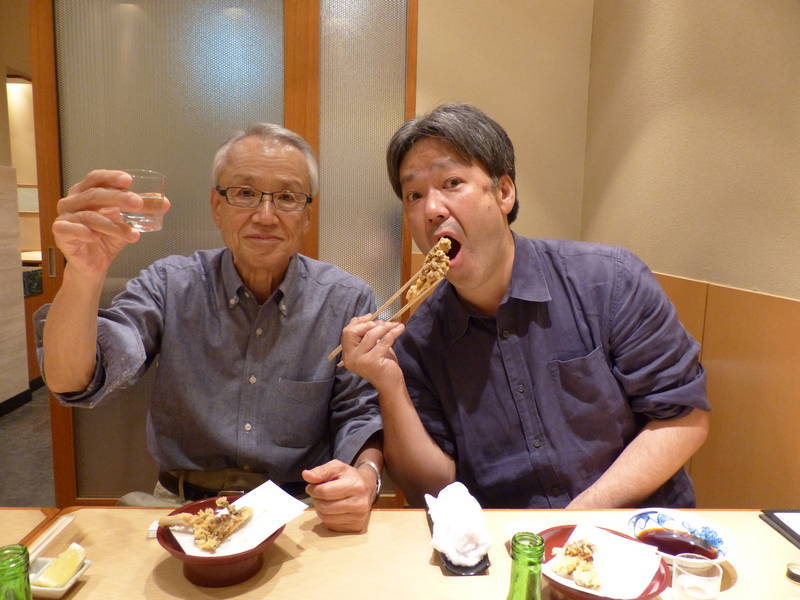
On Onno's last day in Japan we went to a local Costco (Onno is bakery manager at the Costco in Kelowna) to see how things were done here. Unlike the stand-alone shops in North America this Costco was attached to a shopping mall but otherwise it seemed like the same enormous warehouses at home. As luck would have it, the regional bakery manager was visiting the store and Onno had a chance to chat with him. I think he had a job offer within five minutes. We had to satisfy ourselves with trying various samples of chocolates and pastries as the lineups for the cash registers were enormous. I would guess on the order of an hour long. It really was too bad that that pumpkin pie had my name on it but Onno had a plane to catch so we hustled back to the train and to Mr. Noguchi's apartment. We picked up Onno's bags and then caught a cab to Omiya Station and all took the train to Nippori station where we said goodbye. Onno hopped on the Skyliner and was whisked off to Narita airport while we went with Mr. Noguchi to Ueno station, walking through Ueno-Koen gardens to the Tokyo National Museum. The museum has a fantastic collection of Japanese art and we perused everything from earthenware bowls to 15th century armour to silk prints to Prince Takamado's netsuke collection (toggles used to hold tobacco pouches in place). Back at Omiya station we had Chinese food before calling it a night and returning to the apartment.
Onno gets on the Skyliner to Narita
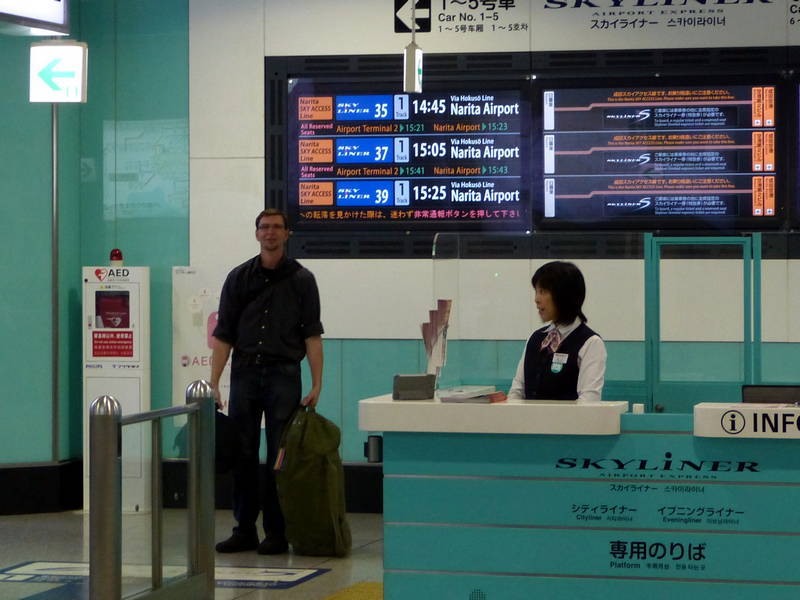
15th century armour at the Tokyo National Museum
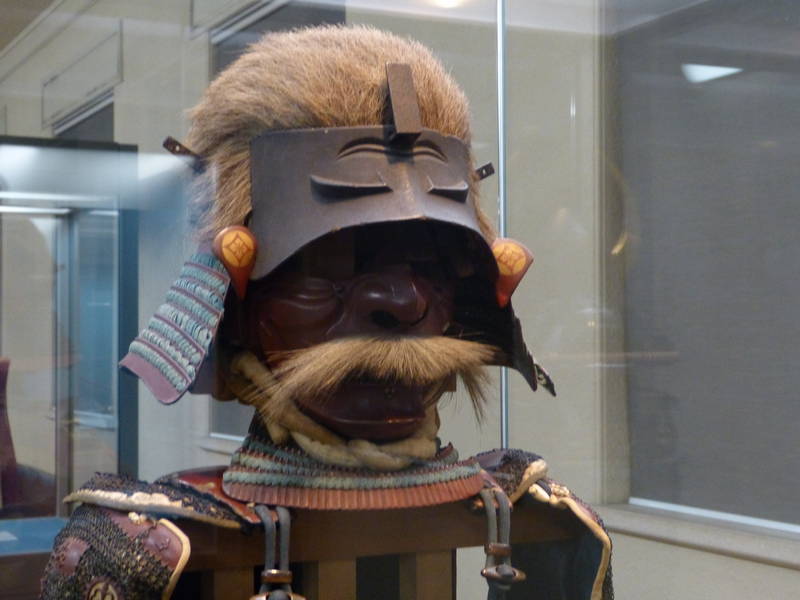
Admiring silk robes
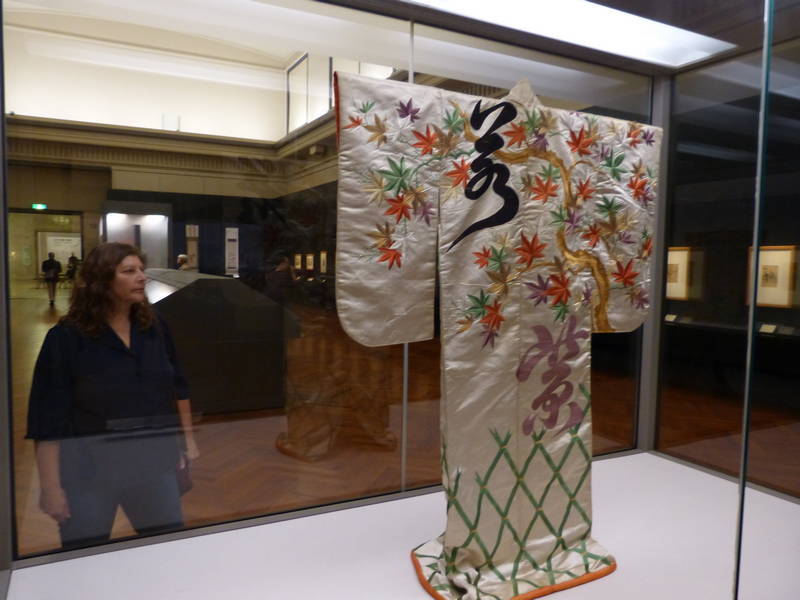
Enough museum time already, let's go outside!
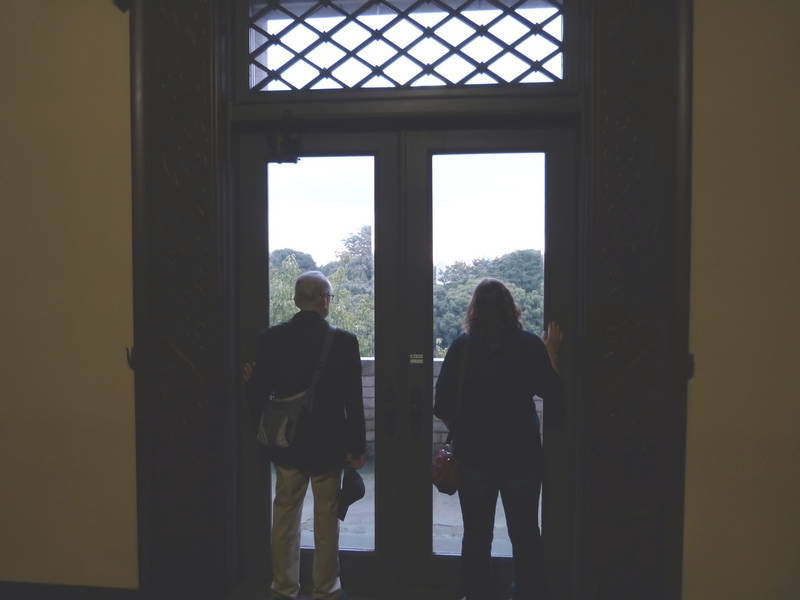
It had only been a little more than a week but we had done so much with Onno. The riding had been fantastic in the Japanese hills with not only great roads but even a bit of adventure thrown in. It had been so much fun riding for the sheer joy of riding, looking for those twisty roads in the mountains and not caring if we didn't make it to our planned destination that day. Onno was a perfect travel companion; knowledgeable, flexible and he could speak Japanese to boot. Hopefully we had learned enough to be able to enjoy the rest of our time in Japan on our own.
Map of our route through Japan
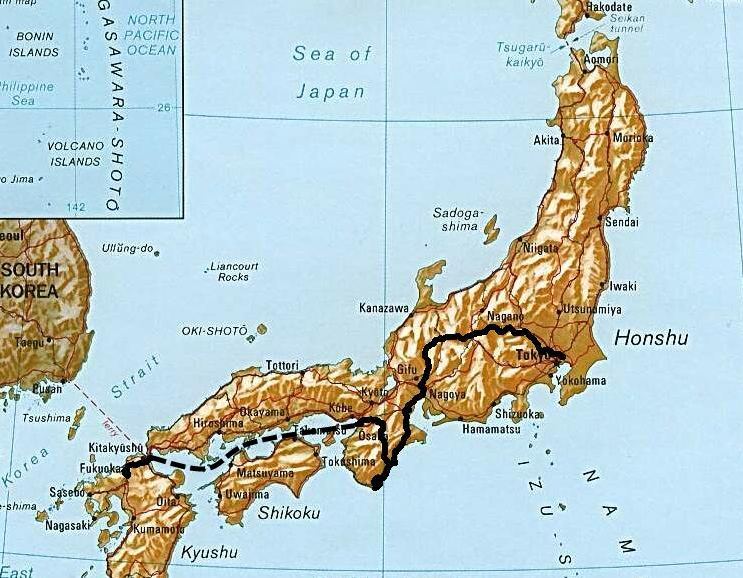
Thanks to Onno for a number of the photos in this chapter!
Tokyo continued to captivate us and we spent the day, October 24th, visiting places that our guidebook recommended. The train from Otosan's place (Chieko's father, Mr. Noguchi) whisked us into the city and we walked a few blocks in an underground tunnel to the Tokyo Metropolitan Office in Shinjuuku. An elevator took us to the 45th floor for fantastic views of the metropolitan area of 25 million people. It was a great orientation of the city. The subway had a direct line to Shibuya, famous for its busy intersection. The second floor Starbucks on the corner was a perfect vantage point for taking in all the action. 100 000 people per hour cross this intersection at peak times, and I think we saw them all. It is designed as a pedestrian scramble, where all traffic stops and people cross at any of the six crosswalks, the busiest being the two that criss-cross the intersection. Crazy. A statue of a dog near the station commemorated Hachiko, the dog who waited every day at Shibyua train station for his master. What is special is that he continued to go there every day, even 9 years after his master's death. Touching. This brought to mind the story of Shep, another dog loyal to his master in the Montanta town of Fort Benton. Our next stop was Rappongi where we walked to the base of Tokyo Tower. It was built in the 1950's and looks exactly like the Eiffel Tower. But it is painted red. An odd bit of architecture, but interesting. Ekke thought it looked like a cellphone tower. The Ginza area was a great place for lunch. Any large department store in the area has an amazing food department where you can take away culinary delights or eat in. There was a great tempura place where everything was so well done, with the pre-wrapped moistened towelette and disposable wooden chopsticks. Not exactly environmentally-friendly but consistently there in any restaurant. A stroll in the area took us by Prada, Dior, Chanel, Gucci, Louis Vutton and some other jaw-droppingly expensive stores, all doing a brisk business. Shopping seems to be a real pastime in Tokyo, at least judging by the haute couture style of many of its residents. A walk through the area took us to Hama-Rikyu Gardens, built on the sight of a royal villa of the Shogun Tokugawas. A stroll through the Japanese gardens were beautiful, and everyone was admiring the peony and cosmos gardens. A seawater moat, filled with water from Tokyo Bay, surrounded the park. A long train ride took us back to Saitama, and a bookstore in Omiya station had the English map that we'd been looking for all over Japan.
Hikawa Jinja Shinto shrine just down the tree-lined street from Otosan's apartment

Spectacular views from the observation level of the Tokyo Metropolitan Offices


View from Starbucks of the intersection outside Shibuya Station
Cell phone tower or Eiffel tower?
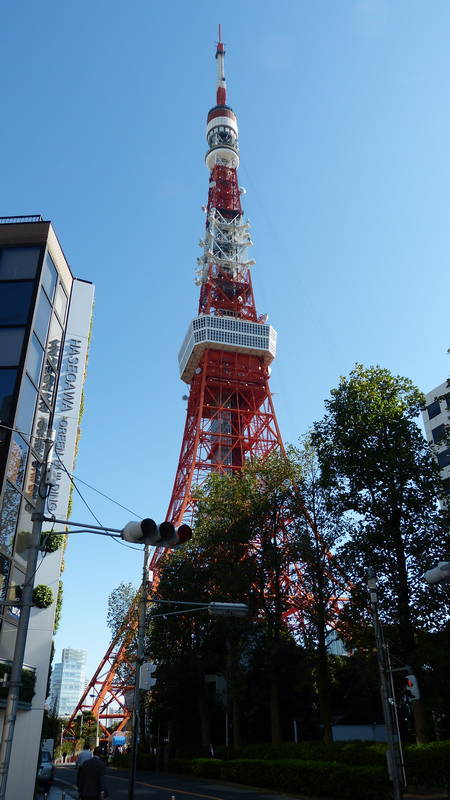
Ginza shopping district

Delicious department-store tempura
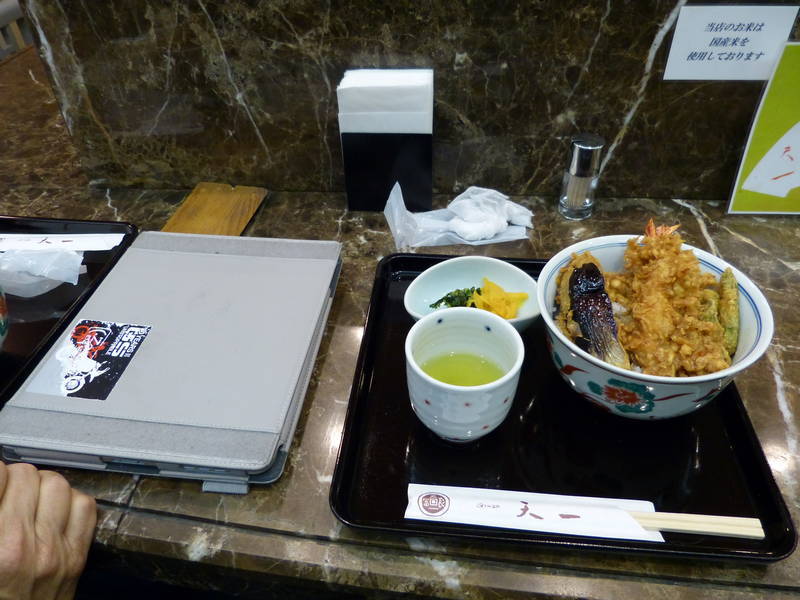
Hama-Rikyu Gardens
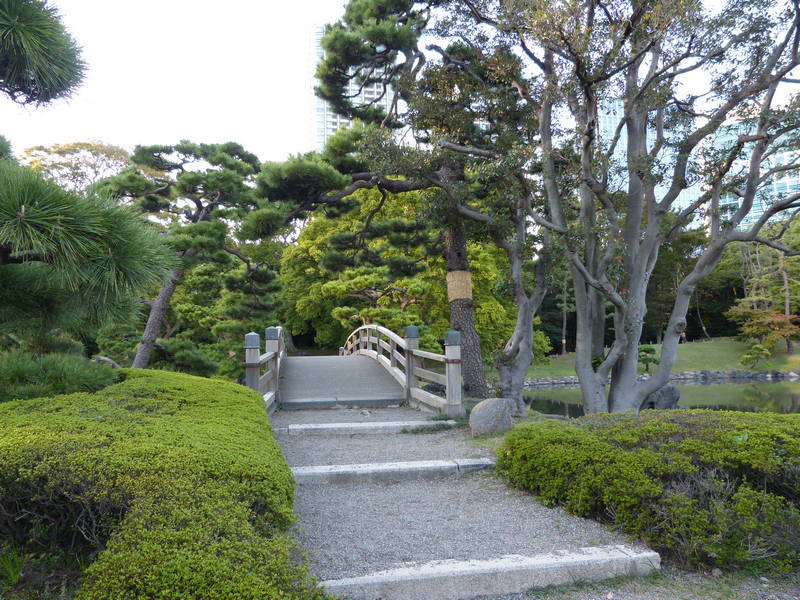
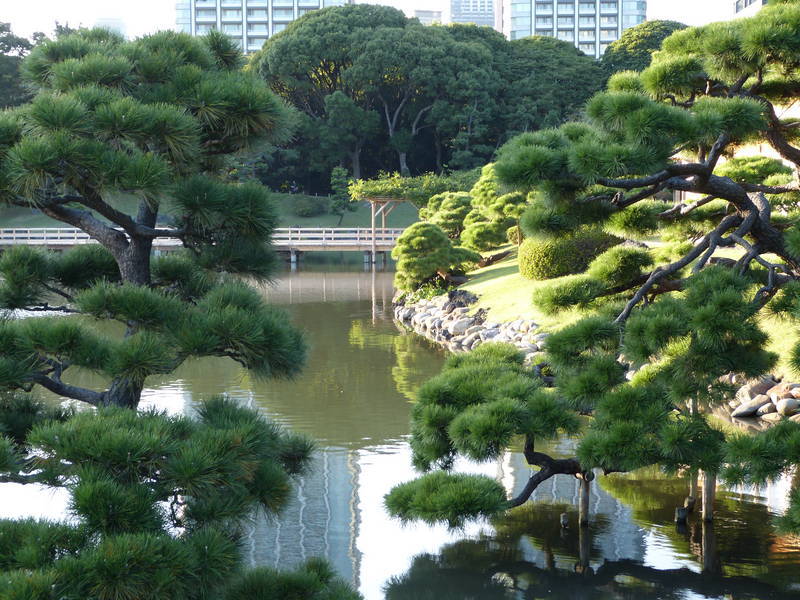
After getting new steering head bearings at Central Motors, my bike was ready to pick up the next day. We packed up, and Otosan sent us off with gifts of crackers, chocolate and coffee. The expressway was a good choice because it got us out of the Tokyo area very quickly and efficiently and soon we were riding the smaller, twisty roads south of Nikko. A boulevard of giant cedar trees that stood like sentinels watching for intruders lined the last few kilometres of our route. We saw a sign for the Windsor Hotel and had a look at the place. There were a few cabins but it all looked deserted with no obvious hotel office. Then we saw a signboard with presumably the cabin numbers, each with an individual light beside it, some of them lit. It looked like a self-service hotel. Then it occurred to us that it must be a 'love' hotel where couples go for privacy and rent rooms by the hour. We didn't stay there. Nikko was a mystical place with ancient, moss-covered shrines and monuments appearing every now and again in the dark forests. Hotels were a bit pricey here so we thought we'd investigate a hostel with camping opportunities near hot springs. A steep incline down a back road took us close to the river, but we never did find the place. It was also getting chilly at 12 degrees Celsius so we looked in our guidebook and found Nikko Guesthouse for 9900 yen ($110). They were a few kilometres out of town, so it was great that they served supper in their common area, curried rice and teriyaki chicken. The next day we took some time out to work on the website, and rode into town for lunch. While I caught up on some reading, Ekke went for a long ride into the hills to find some waterfalls. At first it went well, with some amazingly curvy roads and switchbacks ridden at high speeds. But it all came to a grinding halt with a traffic jam on the one-way road up the mountain. Lines of cars were stopped or moving at a crawl. Ekke's bike started overheating so he tried to split lanes, but this was awkward because the space between cars was often tight with the saddlebags, and the middle of the road had raised-up cat's eyes which made riding between the cars and buses even trickier. He eventually made it home after having seen waterfalls from a distance, not being able to get close enough to them to see if they were the ones he sought. We chatted with a lovely lady, Eve, from the States, at dinner and after I inquired, she gave us a working knowledge of how the presidential election system worked in the U.S. She also kindly inquired about our trip and it was fun reliving it by sharing some stories.
Mr. Noguchi (Otosan) checks our map before we ride towards Nikko (yes the Adventure is a tall bike)

Giant cedars line the road to Nikko
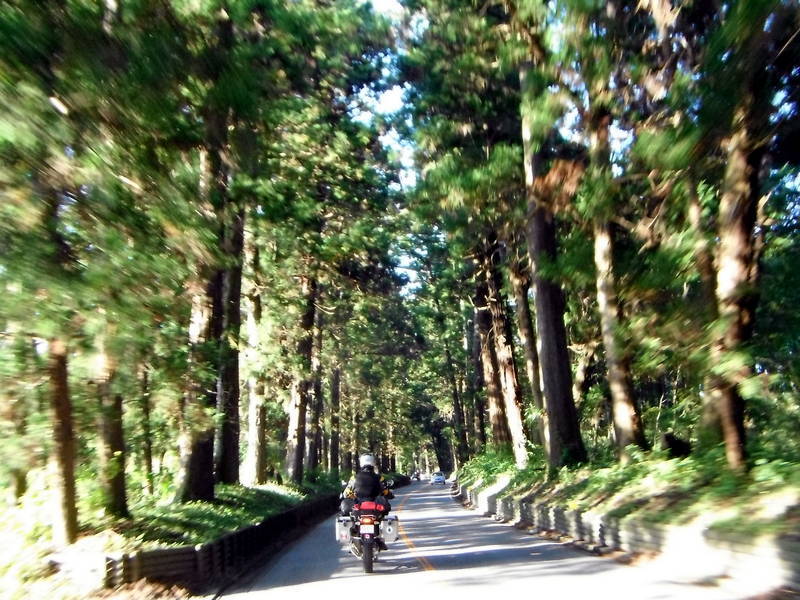
Congested road and unknown falls on Ekke's day trip
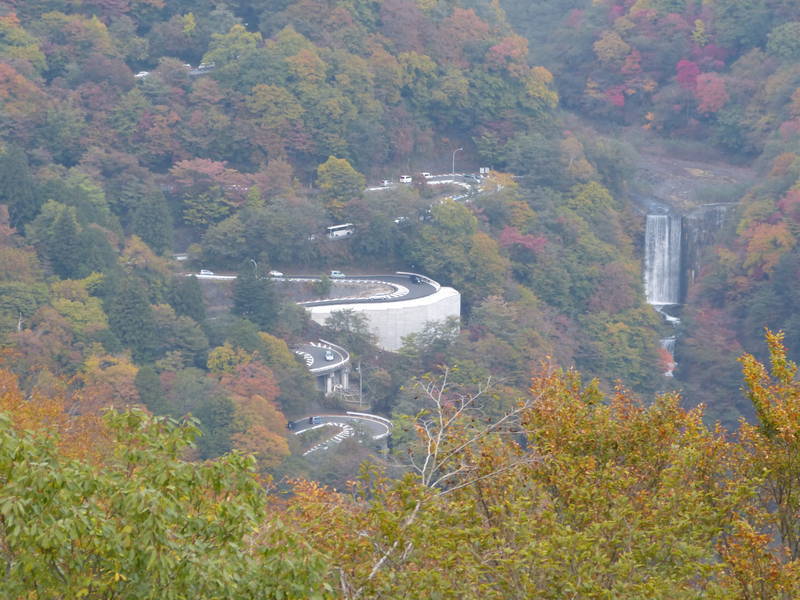
The guesthouse was fully booked the next night and we had not yet seen Nikko. So, with a bit of research, we found a resort with camping cabins and they had a place for us to put up the tent for 3000 yen ($37). The last time we had put up a tent was somewhere in the Gobi Desert in Mongolia, so it was a bit of a shock. A narrow road took us down, winding around the cabin area, then up some steep switchbacks up, and I mean steep, to a camping area. It was very isolated, with no other campers. But the views of the surrounding hills from up there was amazing, with red, yellow and orange fall colours at the higher elevations. The Nikko World Heritage temples were a few kilometres away and friendly attendant led us to motorcycle parking. One ticket booklet allowed us access to all the Shinto and Buddhist temples. The number of gates, pagodas, bridges, worship halls and so on was astonishing. Stone steps took us up through the Yomeimon gate, very elaborately decorated. Toshogu Shrine had monkey sculptures on some of the structures to embody the principles, "Hear no evil, see no evil and speak no evil". The sun made an appearance every now and again and gave the wooden structures a beautiful glow. Visiting a temple felt very spiritual, from the taking off of shoes, kneeling on the tatami mats on the floor, listening to stories told in Japanese, to the bowing and clapping. In the Roaring Dragon temple, a monk struck sticks together right under an acoustic sweet spot and the howling sound was meant to resemble the sound of a dragon. In one area, we donated a few yen to throw rings at posts, to ring a bell, and to clap and bow in front of a shrine. Others paid to write notes and then hung them up on special hangers. It all felt a bit arcade-like and not as spiritual as the other areas. I had read in our guidebook that the mausoleum of Tokagawa Ieyasu was not included in our ticket, so we paid 700 yen ($7.84) each to enter. The Shogun who had united Japan was buried here in 1617, and it was quite an ostentatious memorial, all guilt and lacquer. On the way out, we noticed that we did have a ticket for the mausoleum in our booklet and had therefore paid twice for visiting the mausoleum. Darn. As it was getting dark, we thought it a good idea to have supper at the campground restaurant and therefore would be closer to our tent. Another couple was there, also on a motorcycle, and it turns out that they were camped up where we were. This was great, as it made it feel a bit less isolated. Ekke guided me and the other bike down the road then up the steep switchbacks to the campsite in the pitch dark and pouring rain. Wet leaves on the corners made it just that little bit more exciting. We chatted with Tanaka for a little while and then sought refuge in our tents.
Fantastic buildings in Nikko
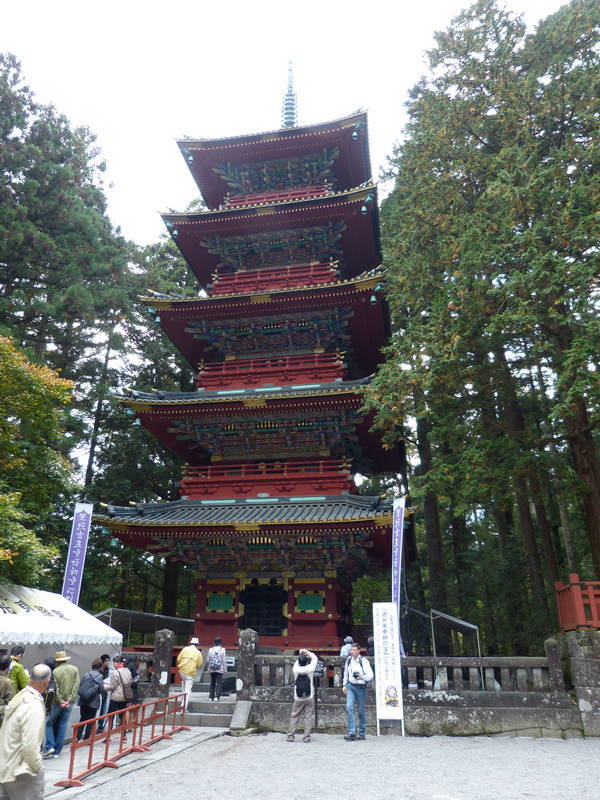
Love the elephants
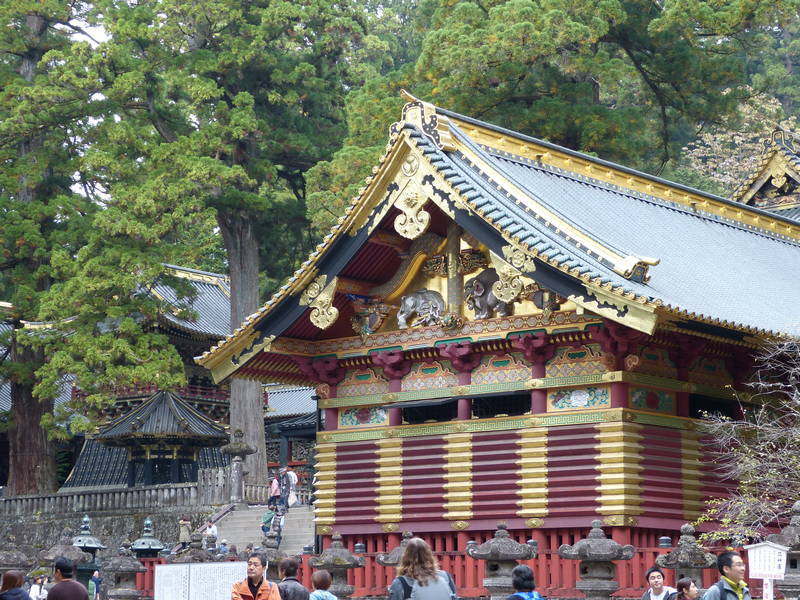
"Hear no evil, speak no evil, see no evil"

Quite a few crowds on this beautiful fall day
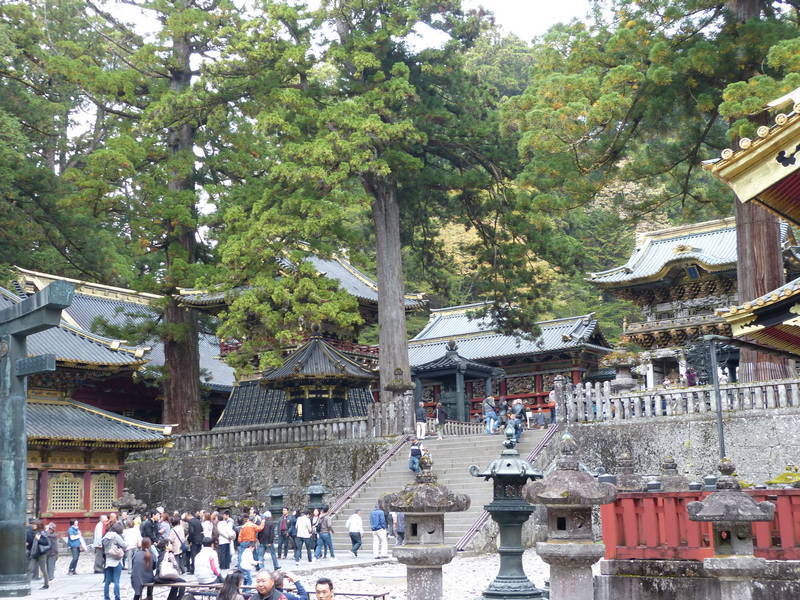
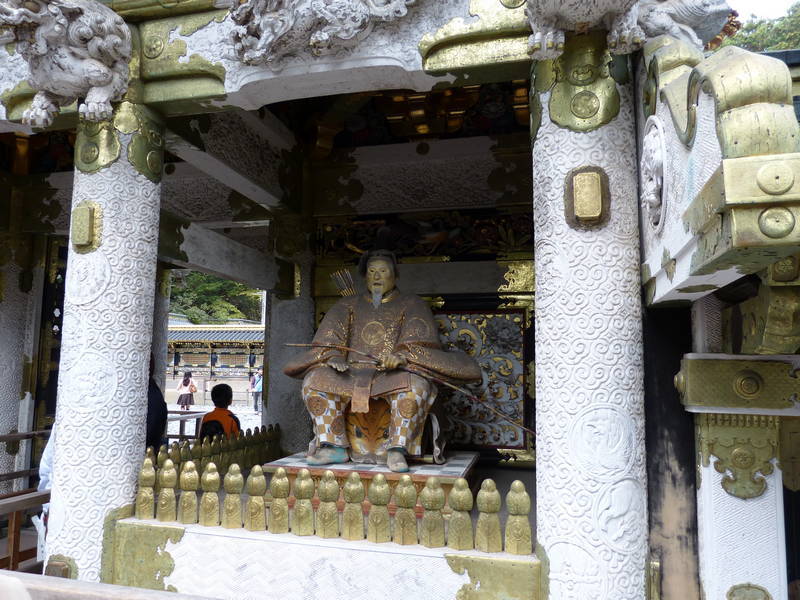
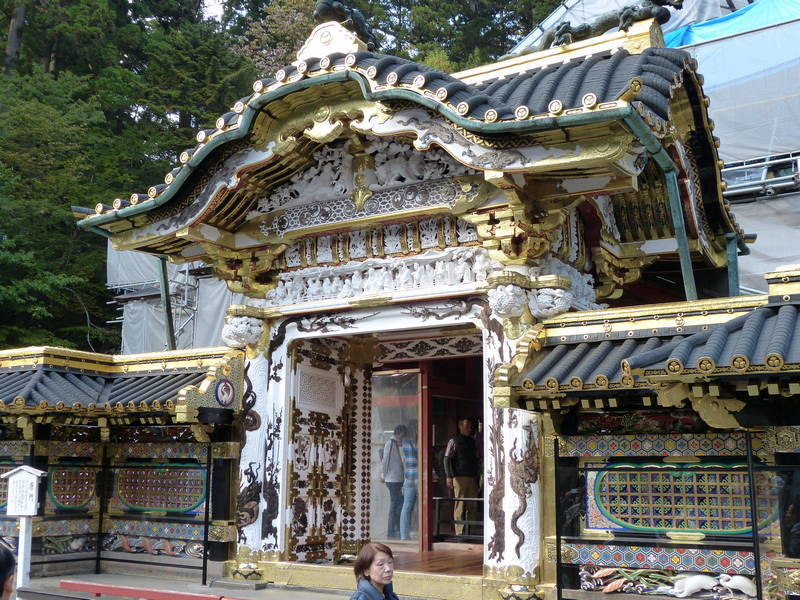


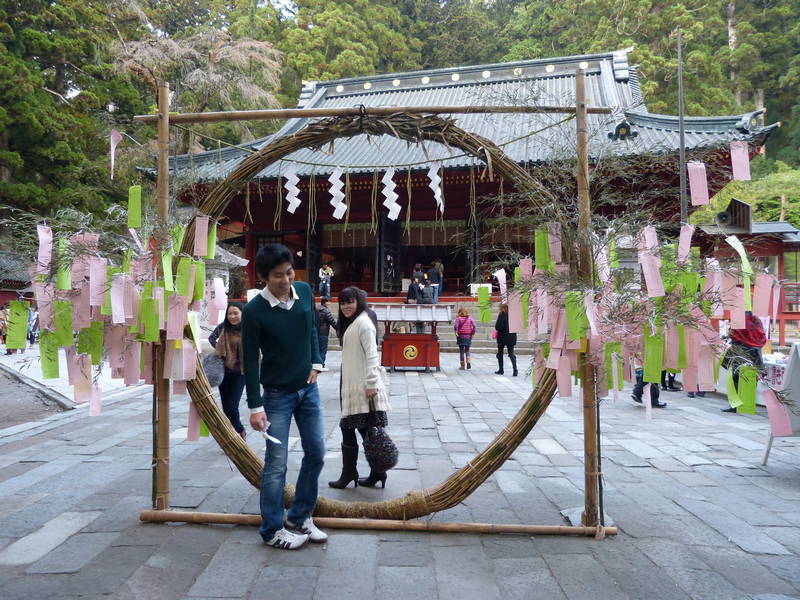
Mausoleum of Tokagawa Ieyasu

Peaceful gardens away from the crowds
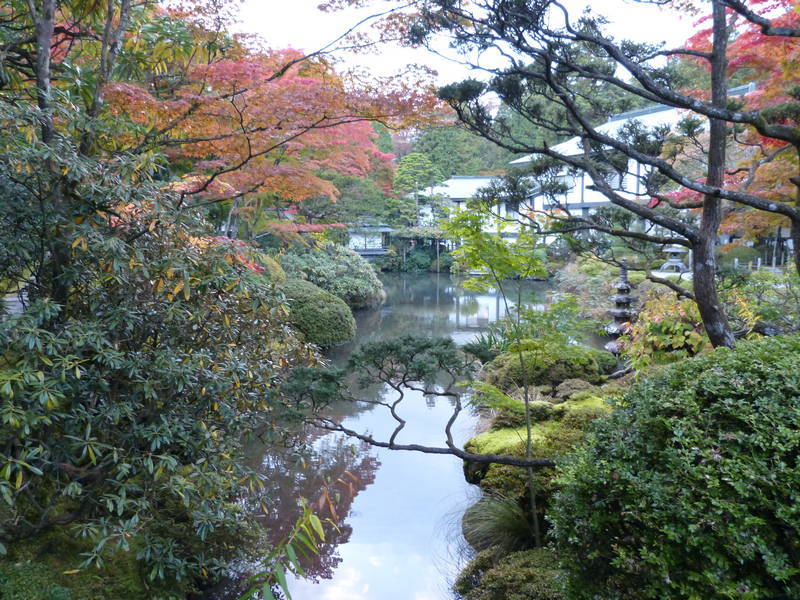
The rain the next day put a damper on things, so to speak, and we didn't want to pack up, so stayed another day. It was a good opportunity to sit in the campground restaurant and write. We rode to Hippari Dako, a restaurant in town, which only had three tables. But hundreds of business cards from people all over the world were pinned to the walls. Our 'anti-business' card was added as well. Our supper back at the campground restaurant was fantastic. A cover was taken off the table and there was a burner underneath. We ordered slices of raw beef and cooked them with onions, peppers, bean sprouts and skinny mushrooms with the cooking oil provided. The sauce tasted like teriyaki. The owner really wanted us to try the mutton and pork, as well, so he brought a plate for free.
Fog in the Nikko valley below

Leaving our "anti-business" card at Hippari Dako

Waking up to a bright, sunny day with no rain in sight was very welcome on October 29th, and it allowed us to get things dried out before packing up. The road north out of Nikko wound up into the hills and we enjoyed curve after curve on the beautiful highway. The fall colours just kept getting better the higher we went and it was difficult making good time as we stopped at several viewpoints overlooking Nikko along the way. A rest area parking lot was filled with motorcycles and Ekke was thrilled to see an early-'80's Suzuki Katana in absolutely original mint condition, pull up near us. So the tables were turned and we were the ones taking photos of another motorcyclist. Hot milk was served at a little booth, and it went well with our cheese (a rare find) and crackers which we enjoyed at a picnic table in the sunshine. Our route took us through vacation country and there was a lot of advertising for hot springs resorts and hotels in the woods. Riding 158 kilometres took longer than we expected, sometimes because of traffic congestion, so we arrived in Shirakawa in the dark. A Denny's restaurant was a welcome sight, and we sat down there and pondered accommodation choices. The server told us that there were plenty of hotels near the train station, which we had searched for earlier and not found. We settled on a Route Inn for 9000 yen ($98).
The steep road is easier in the daytime when it isn't raining

The view back over Nikko

Pristine Suzuki Katana at a rest stop

It was very pleasant riding past farmlands with rice and corn ready to be harvested, some rice already in neat stooks. The road wound down the hills and we stopped at Iwaki Beach on the Pacific coast. Powerful waves crashed up on the beach and new breakwater barriers had recently been erected. The 2011 tsunami had done its damage here. A bunch of wrecked fishing boats were piled on top of each other near the shore, with a wrecked van sitting nearby. I wonder if this wreckage had been left as a reminder of the great devastation that was done here? The ride up the coast was beautiful but there were fewer and fewer cars as we rode north. Looking up toward the raised expressway, we could see no traffic on it. It was closed. We were approaching the Fukushima Nuclear Plant. Then, we could go no further. Armed guards waving batons had set up a barrier and indicated that we had to turn around and go back almost to Iwaki Beach, then back through the mountains to catch a road heading north. We came upon towns that were really overgrown with weeds, which was very un-Japanese. Some houses looked abandoned and some inhabited. Some stores and gas stations were open, and some weren't. Workers in white coveralls and face masks were cutting and bagging the overgrown weeds. More roads were signed as closed, or had police turning people back. After trying a few smaller roads, all blocked off, we headed the opposite direction of where we wanted go, back south. There we encountered one of the narrowest, twistiest roads yet, with mirrors to see if there was oncoming traffic on almost every corner. And very little traffic to boot. We headed east, then west again, and finally found a road going north that was open. It wound through little villages, eerily abandoned, the usually colourfully lit vending machines turned off and collecting dust. Here everything was overgrown with weeds, everything dirt-covered, and farmers had barricaded their front drives. Coming upon an abandoned town we stopped the bikes and shut off the engines. The absolute silence was eerie, as if we were on the set of some sci-fi movie. The only signs of life were a few construction crews fixing the roads after some landslides, and a guy on a bulldozer pushing topsoil to the middle of a field. One could only assume that the winds had blown nuclear dust to this area and that it was still abandoned because of that. With the hair standing up on the back of our necks we continued north. A few kilometres down the road, the city of Fukushima was lively and fully functioning as far as we could tell. We pushed on towards Sendai as the sun was going down. Our hotel there was booked so we paid the toll to take an expressway the final 80 kilometres.
Harvested rice paddies
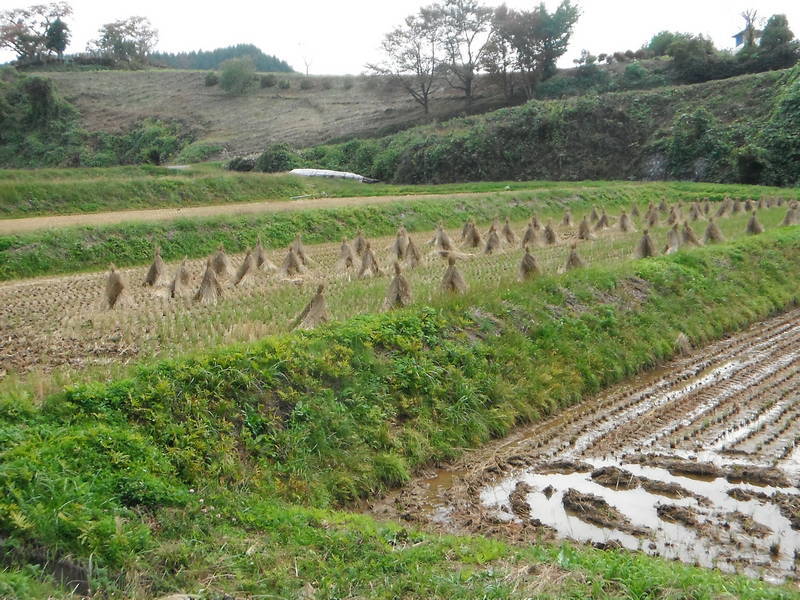
Fishing boats piled up after the devastating tsunami of 2011

Another road closed as we try to get north around the damaged Fukushima Nuclear Power Plant
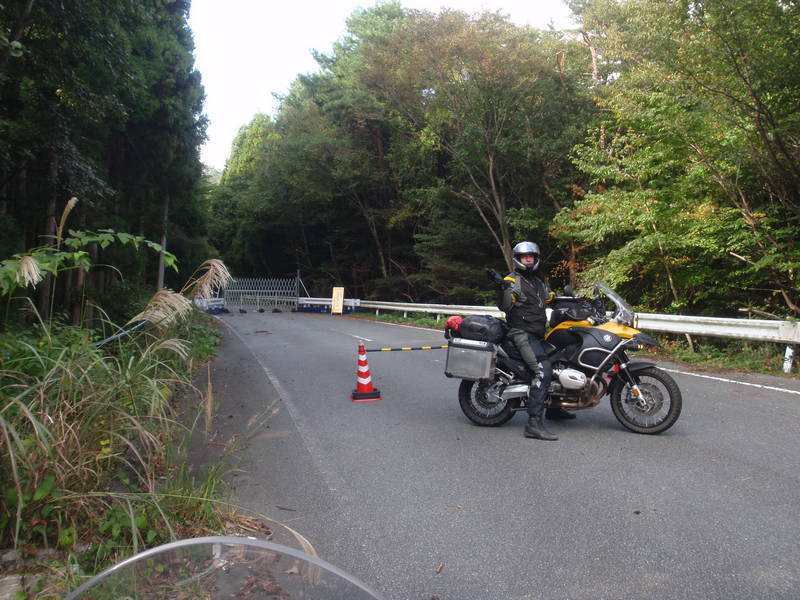
A helpful map (probably even more helpful if we could read Japanese)
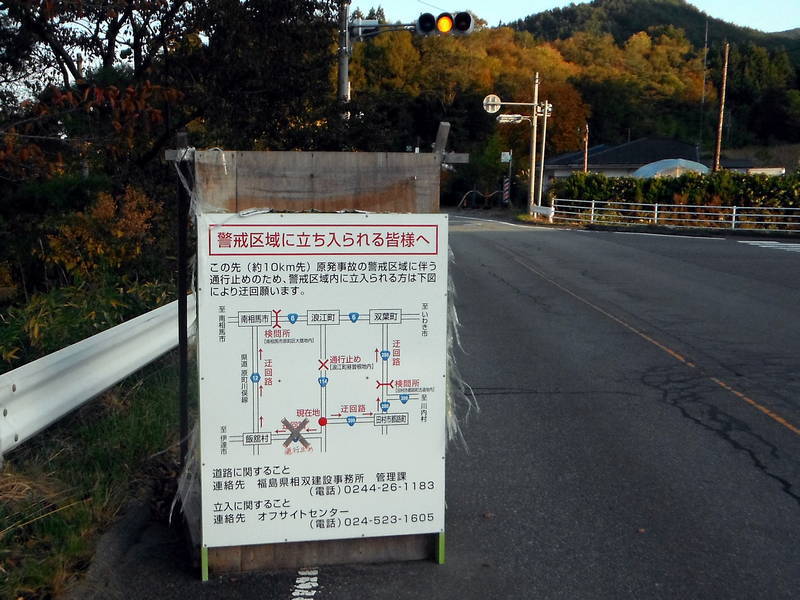
Eerie sci-fi movie set? No, abandoned town near the Fukushima Nuclear Power Plant.
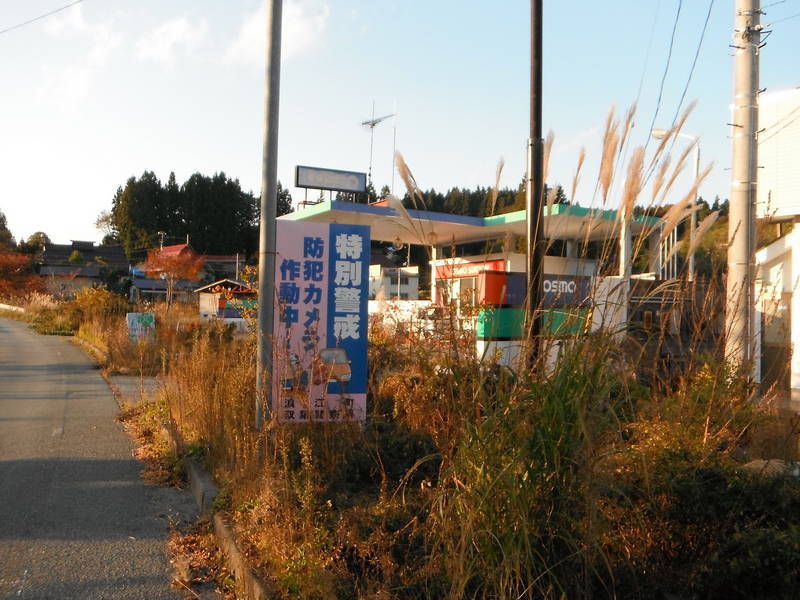
The next day, October 31st, we found a Doutour cafe for a great cup of coffee and breakfast sandwiches. At a nearby skyscraper an elevator whisked us to the 30th floor and we had city views east, right down to the ocean. There was definitely still evidence of the tsunami. Because of the shape of the harbour, Sendai had been hit hard. Although it had been completely cleaned up, we could see a huge swath of green fields where there used to be houses and stores and factories. Later, as we rode by the harbour, we saw more wrecked fishing boats piled up near the water's edge.
View from the 30th floor of an office building in Sendai (green fields used to be houses)

Riding along gently undulating roads, our route took us inland, past green fields and rice paddies. The fall colours were very evident higher up in the mountains, especially when a patch of evergreen trees was dotted with a few bright yellow or red deciduous trees. Forests here had been harvested and replanted, so all the trees were in neat rows, all the way up the mountainsides. A tourist information place was a welcome sight in Hiraizumi, and they helped us find a hotel room that would not break the bank. The only accommodation in town was for 18 200 yen ($204) per night, so they sent us back to a town we had come through where we paid 11 200 yen ($125) for two single rooms at Toyoko Inn. There was no double room available, and even though the bed in the single was big enough for two, rules are rules, and we had to get two rooms. So much for Ekke and I being together 24/7/365. Now it was 24/7/364. A little restaurant just back of the hotel served yakatori, or meat on a stick. We ordered some chicken, beef and tongue with soba noodles. The guys in there were super friendly and wanted us to sample different kinds, so gave us a stick of chicken neck yakatori for free. It tasted like chewy chicken.
A yakatori bar for dinner

The reason we were in Hiraizumi is that Otosan had suggested we should see Chuson-ji, the golden hall, if we were going up north. When we did our research, we realized that it was a UNESCO World Heritage Site. The parking lot was full but they could always squeeze in two motorcycles for a small fee. The parking attendants seemed so happy that we were gracing their lot with our presence, and went out of their way to show us where to park, grinning from ear to ear the whole time. A walk up a forested path with hundreds of other walkers led us to a group of temples. A ceremony was just beginning, with robed men and kimonoed women and children parading by us, into the temple. The Fujiwara family was the ruling family for a long time in this area, so maybe they were their descendants. They had built Konjiki-do, or the Golden Hall within Chuson-ji temple, the star attraction here, in the 12th century. The golden structure was protected under a wooden building, and was a mausoleum for four generations of Fujiwaras of the past. It wasn't solid gold but it looked solid gold, with every square centimetre covered in gold. Three Buddha statues, all covered in gold, sat on or beside an altar. All amazingly stunning and beautiful. Unfortunately, photos were forbidden. (Click here to go to the Chuson-ji website with a few photos of Konjiki-do) We stopped by a lovely museum that displayed statues and other artefacts used in royal ceremonies and admired a chrysanthemum display on the way back to the bikes. There, a couple of gentlemen, one from the States, came over to chat after having seen our Alberta plates. They were suitably surprised to see bikes from Canada over here in Japan. The ride into Yamagata took us past an odd sight: The UFO Hotel, which was in the shape of a big UFO mother ship (are we back on the sci-fi movie set?). Some prices were listed and sounded pretty reasonable. When we checked it out, it was fairly dark in that area and another hotel nearby was a love hotel. So, we thought the UFO was as well and moved on. While riding around Yamagata it started pouring rain as lightning flashed. We parked and stepped into a convenie and were helped by the clerks, who gave us directions to a Toyoko Inn. Parking on the entrance-walkway, under a canopy was very convenient. A grocery store across the street had a deli section where comfort food (pasta and cheese sauce) was reasonably priced.
A ceremony takes place as we walk up towards the Golden Temple
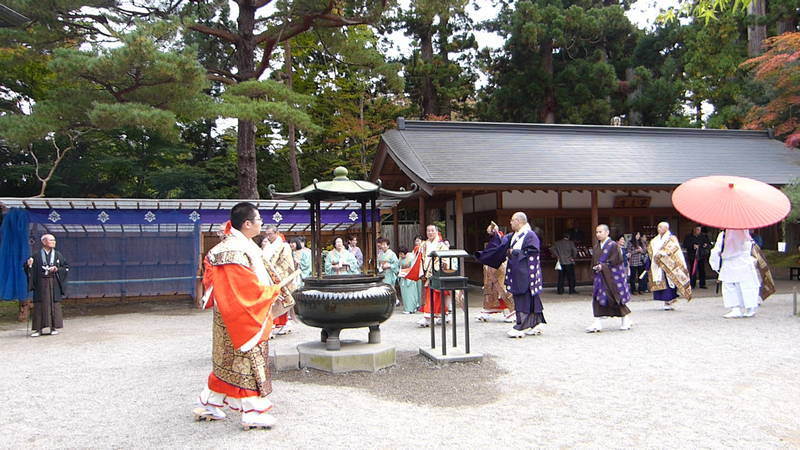
The Golden Temple itself (no photos allowed of the splendour inside)
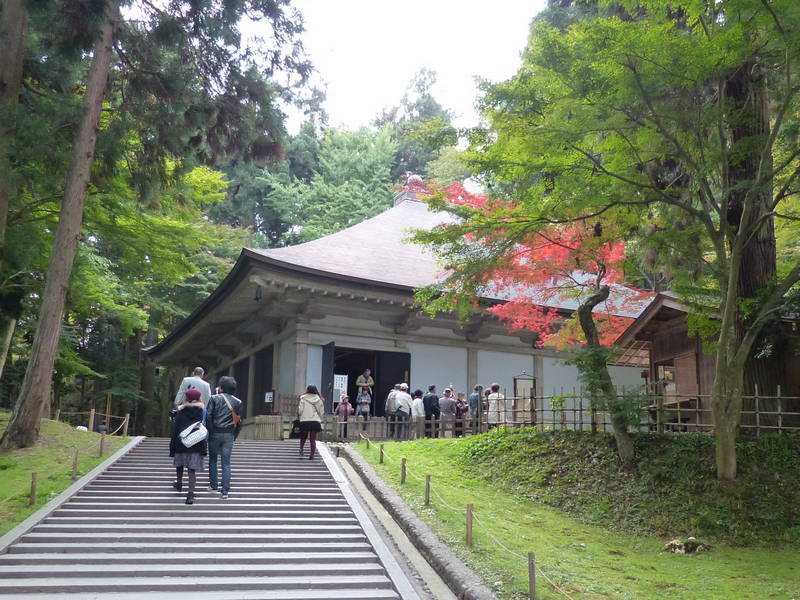
The decision to stay another day on Friday November 2nd was not a hard one, as the skies looked a little dark and dampish. The breakfast buffet was always a welcome sight and at Toyoko Inns they served pickles, seaweed, fish, potato salad and rice balls. I was always happy to see toast and jam, too, as I couldn't get used to the other stuff. I did try a small, round, red pickle, and it was so strong and sour that my mouth involuntarily puckered up in response. The ladies managing the buffet must have felt sorry for me and soon a plate of hot wieners with ketchup appeared at our table. How nice. Since I didn't eat fish before 10 am I did learn to bring my own jar of peanut butter to the buffet to get in some protein. The hotel was near the downtown area, so we had a great walk around and used the time to work a bit on our website in the afternoon in the hotel lobby. A businessman came over to chat with us about our trip and was fluent in English. Usually this never happened with the locals but he was very comfortable with westerners and said he had asked the front desk clerk about us after having seen our bikes. He said the clerk told him that we were from Canada and had just ridden up without a reservation. I don't think people here do things as unplanned or spontaneous as not having a hotel room booked. It was convenient to, again, have supper at the grocery store deli, and the clerk, who remembered us from the day before, was super friendly and was very interested in chatting about our trip.
Working on the website in the Toyoko Inn
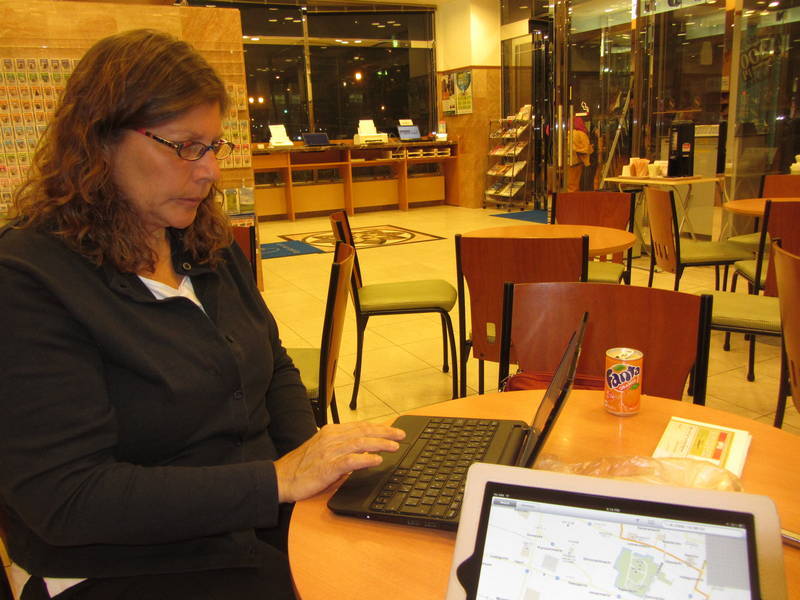
Ekke writes:
With all of our hard work going into completing the China chapter of our website on Friday, November 2, it was especially frustrating not being able to upload the chapter to the internet using the Toyoko Inn's internet. No matter what I did on Saturday I couldn't get the upload to work. I sent an e-mail to Dot Easy to see if they could solve the problem. At the Max Value grocery store across the street we picked up spaghetti and sauce for an emergency camp dinner and as we were leaving, the noodle lady at the in-store deli that we had met last night came over and wished us a great journey. When we rode away from the hotel she actually came running out from the store and gave us a big wave. Amazing, the Japanese people we had met were all so super friendly once over their initial shyness (or was it simply politeness?). The 245 kilometre ride was pleasant though by late afternoon it was becoming a bit cold. As it was Culture Day (Bunka-no-hi) and the fall colours were peaking in Nikko we knew that accommodation was going to be difficult to find. We started looking for hotels in a few towns before getting to Nikko as the thought of camping in the cold wasn't too appealing but with no success. Over dinner at an Asian Restaurant (Indian to us) in Nikko we decided that our only real option was to head for Kirifuri Camp where we had stayed last time and set up the tent. It was dark and only 3 degrees Celsius as we pulled up to the campground. When we asked if they had cabins available that said they did and the price was ¥8,400. We looked at each other and knew that neither of us wanted to set up the tent so we took it. What did we get for almost $100? An absolutely basic cabin with no furnishings (or heat) and just enough room for the four included futons to be spread out.
Leaving the Toyoko Inn on November 3
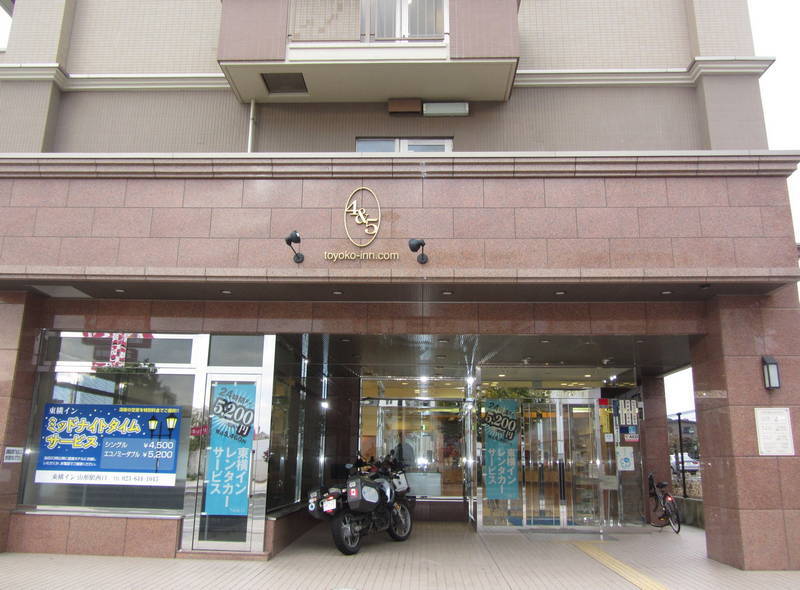
Snow in them thar hills!
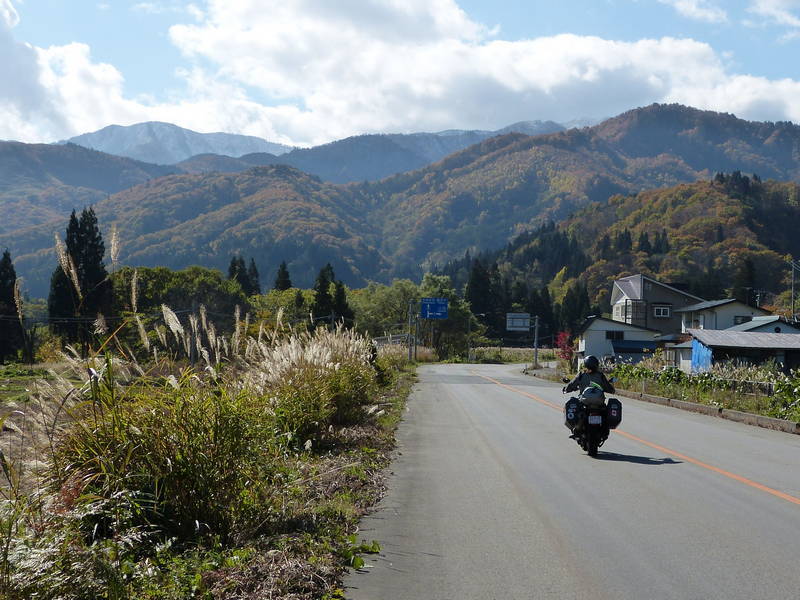
Doubling up our four futons in the cabin and with double thick blankets to ward off the chill
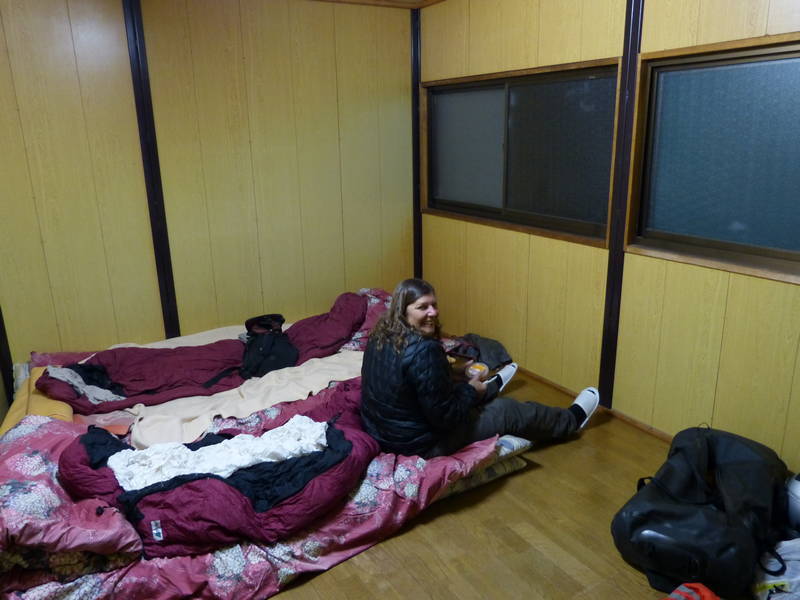
On Sunday morning we awoke to a hint of frost on the motorcycles but as the sun came out our tiny cabin warmed up a bit. Eventually it warmed up enough for the ride down to Nikko and after fueling up we stopped at a café for a western breakfast, Audrey even enjoying a stack of pancakes. Our planned route to Kusatsu took us along the one-way road I had ridden last time, hopefully with beautiful colours and a chance to see the waterfalls I had missed. We hadn't even left town when traffic came to a complete standstill. Soon my bike was overheating as we crawled to the intersection that would take us to the planned route. After 15 minutes of that we decided that the traffic certainly wouldn't get any better further up the mountain (where I had been stuck last week) so when we got to the intersection rather than turning off we continued straight ahead and took the lower, more conventional, route. There were still a few nice curvy sections for entertainment as we zipped around the Sunday drivers gawking at the colours. The snow-capped mountains in the distance (not that far!) looked beautiful in the sunshine. By 3:00 PM we arrived in Kusatsu and were very glad that Booking.com had included the GPS coordinates for the ryokan. The hotel was located on the main road into town but it was tiny and there was no English on the sign in front so it would have been very difficult to find without the GPS. After an easy check-in (they didn't even ask our names) we dumped our stuff in the tatami-mat room and walked a couple of hundred metres to the centre of town. Kusatsu is a real onsen (hot spring) town and people were walking around in their yukatas from one hot spring to the next. To us it looked like it would be freezing cold and a few less hardy souls had down filled jackets over their yukatas. Steaming hot water flowed into the central square and cascaded down a set of falls as everyone was taking pictures of each other. We walked through to the other side of town to a large outdoor hot pool. There were separate pools for men and women and it was possible to get a glimpse of the men's side from a nearby nature trail. It appeared that bathing costumes were not in use. A light repast at the 7-11 back at the town centre was our dinner and then we retreated from the cold to our ryokan. Like most hotels in town, this one too had its own onsen. We appeared to be the only guests staying at the ryokan as we went our separate ways, Audrey to the women's onsen and me to the men's. I jumped in after using the provided bucket to wash up and then jumped right back out again. It was way too hot. I managed to get used to it eventually but back at the room I found a completely dry Audrey lounging in her yukata. Apparently she had no desire to be boiled alive.
A bizarre Bimota (Italian, not Japanese!) outside our breakfast cafe
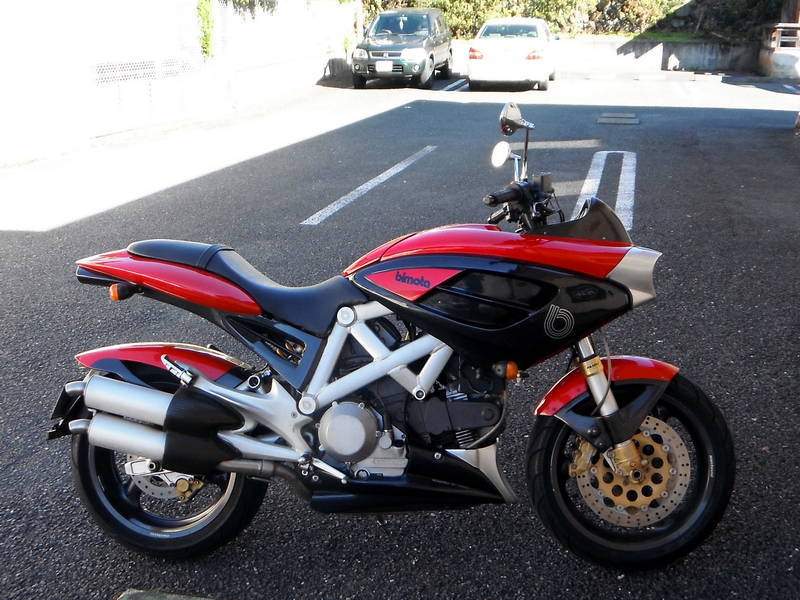
Traffic is already slow leaving Nikko

Watch for monkeys carrying babies, cool!
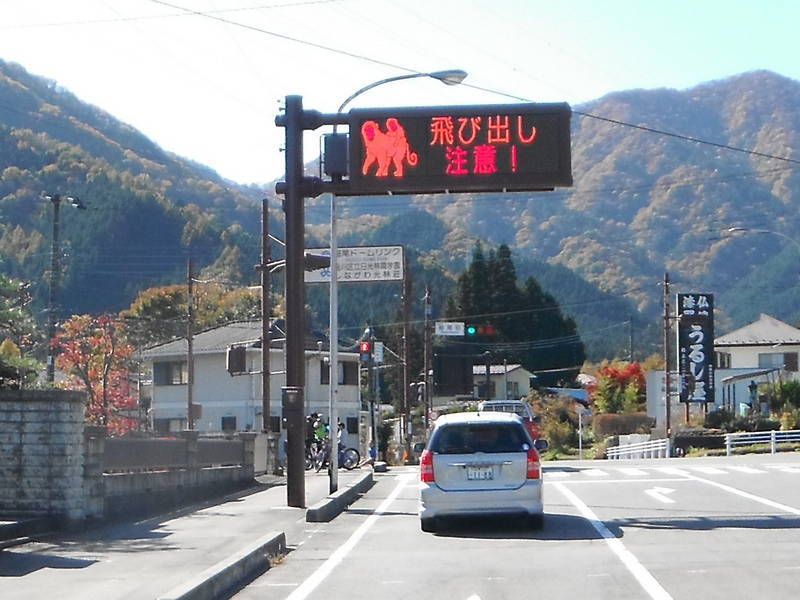
The ryokan would have been difficult to find without the GPS coordinates
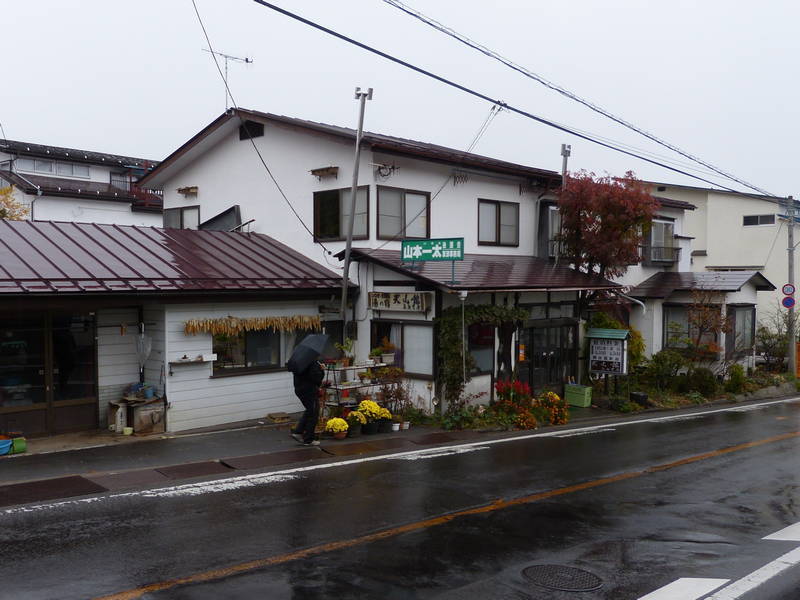
A couple of yukata wearing tourists head for 7-11
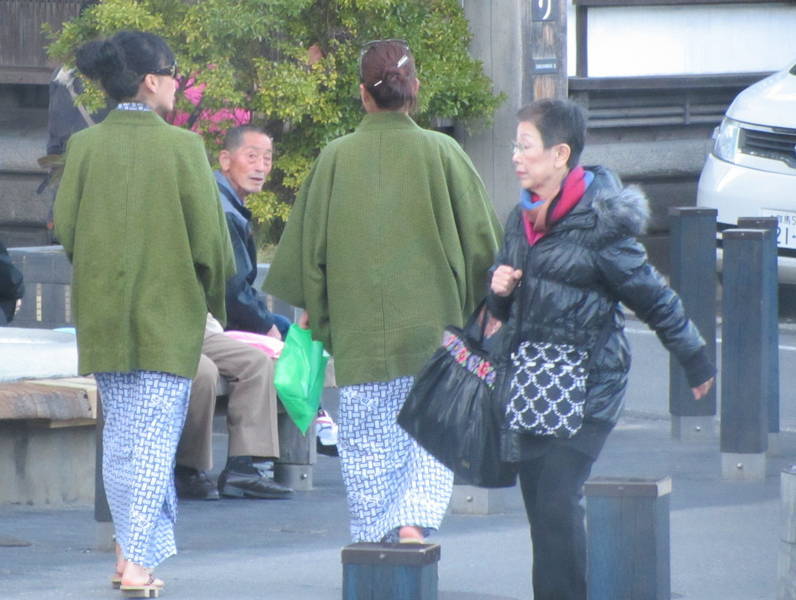
Everyone getting their photo taken in front of the cascading hot water

A Suburban looks completely out of place here
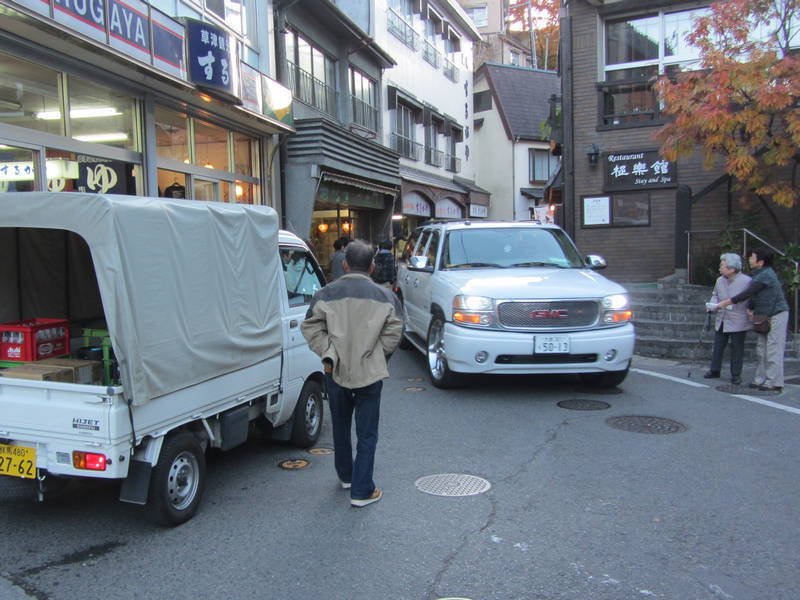
Enjoying eggs boiled in the hot springs, "onsen eggs"
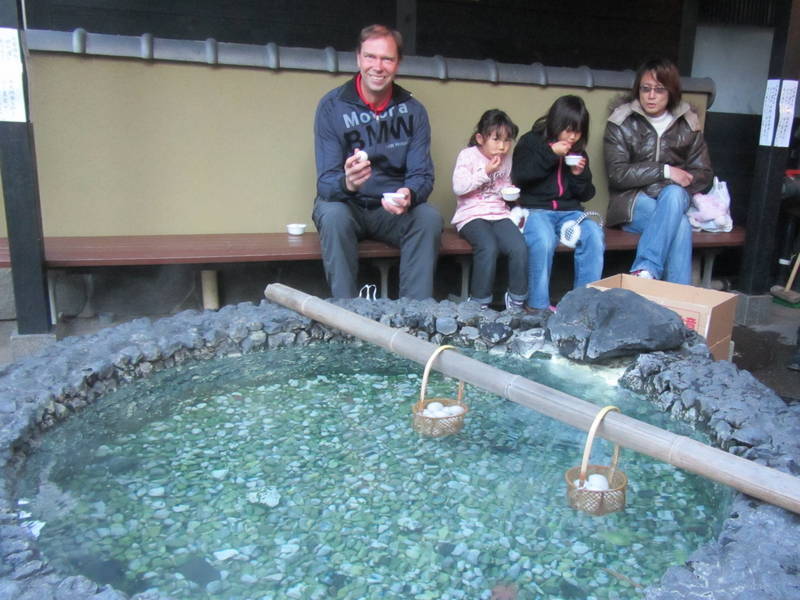
A walk up the nature trail beside the grand outdoor baths
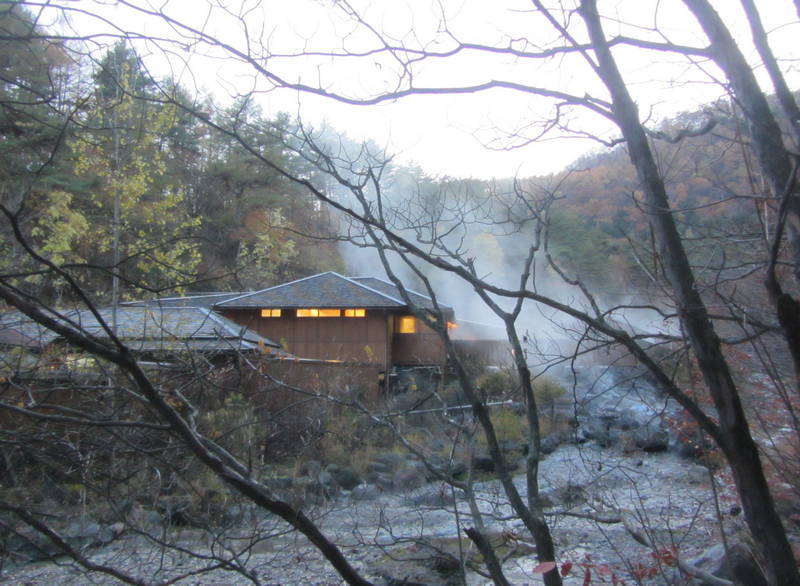
Stopping for a yakatori on the way back to the ryokan
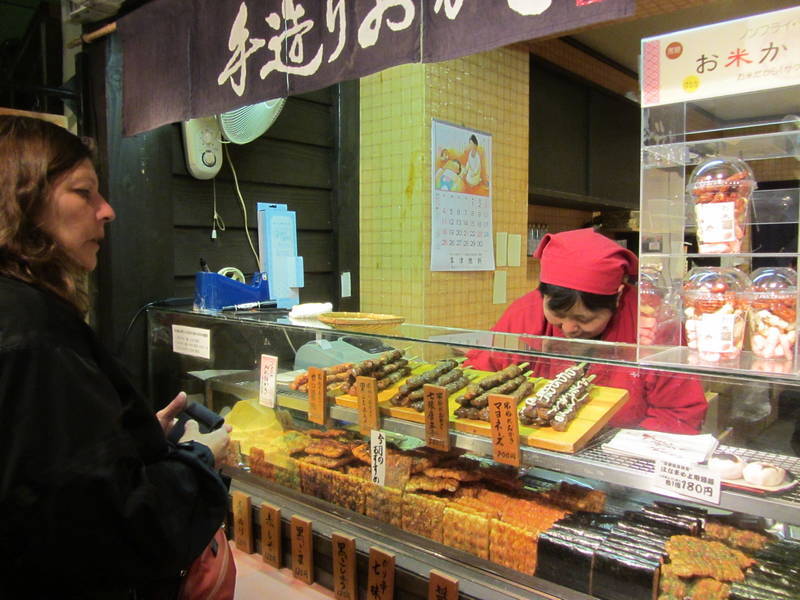
As we hadn't figured out how to work the small portable heater in the room it was rather chilly on Monday morning. It got colder as we started our daytrip out of Kusatsu and the road climbed higher and higher. Beautiful colours except for one; white. There was still snow alongside the road at the higher elevations but fortunately the road itself was only wet in spots. Down the mountain on the other side we rode into Yudanaka and started looking for directions to the famous snow monkeys. These monkeys live near a hot pool and have been "encouraged" to stay with handouts of food. They're supposed to be quite the sight with snow falling and piling on their heads as they sit in the hot pool. While we were glad not to have snow for our riding, it would be a shame not to get that great photo opportunity. Not finding any signs we went to the train station and asked at the tourist information booth for directions. She pointed us in the general direction but then when we were back at the bikes in the parking lot she came running out with a description of the snow monkeys in English. While studying the papers a tiny lady on a tiny scooter came up and asked if we needed any help. When we mentioned we were looking for the snow monkeys she promptly said to follow her. Without hesitation we jumped on our bikes and were soon zipping through Yudanaka following her. Her helmet was relatively large and had protrusions for the visor so it looked a little like a monkey's head from behind. What fun! After some twists and turns she stopped at the trailhead for a 1.6 kilometre walk to the onsen. We could park here for free and have a nice walk to boot. After thanking her profusely we had a lovely stroll through the forest and soon ended up at the entrance to the hot pool. We paid our ¥500 entrance fee and went in. There were monkeys everywhere! They were playing and running around and sometimes just sitting enjoying a nice hot soak. We watched them for close to an hour and then it was back over the mountains to Kusatsu. It was again quite cold and a light fog on the other side made it feel even colder than the 3 degrees C that the thermometer indicated. We needed a good hot soak ourselves and walked over to the grand outdoor bath. Thankfully modesty prevailed as we were each alone in our large, separate hot pools and it was dark to boot. Back downtown we went to a speciality noodle shop but found the ¥1,800 per person for the cheapest noodle set a bit on the steep side. Wandering the back streets we found a small local restaurant where the pork tenderloin was simply fabulous and there wasn't another tourist around. One last plunge in the hotel onsen and we were definitely ready to collapse on our futons for a well-deserved rest.
Looking back at Kusatsu as we climb up and over the mountains, into the snow
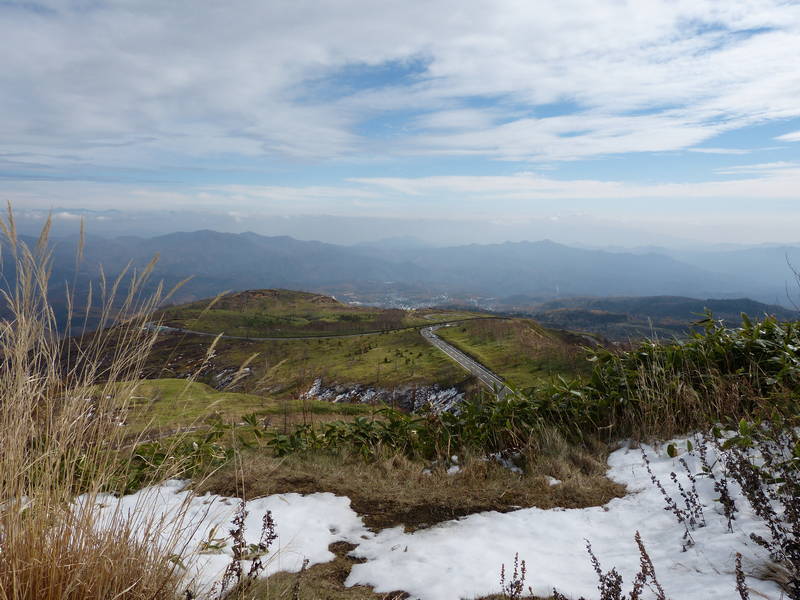
Are we in the Alps?
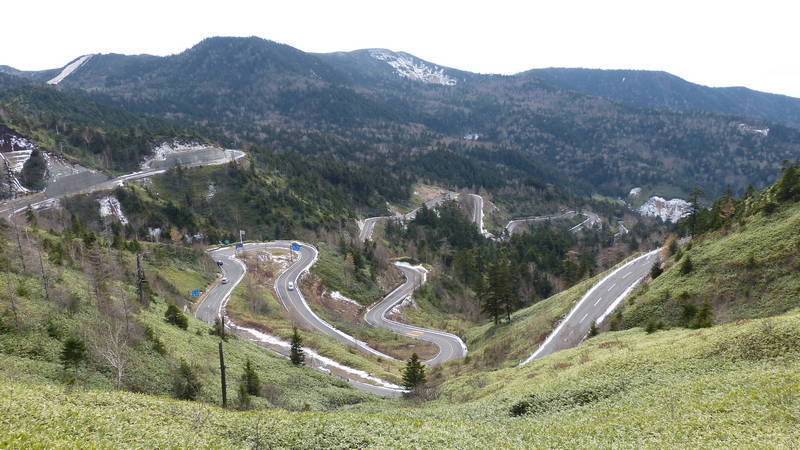
Zooming in on the sign, I would guess not

A Japanese rider enjoying his CBR1100, soon to be available in Canada for 2013!
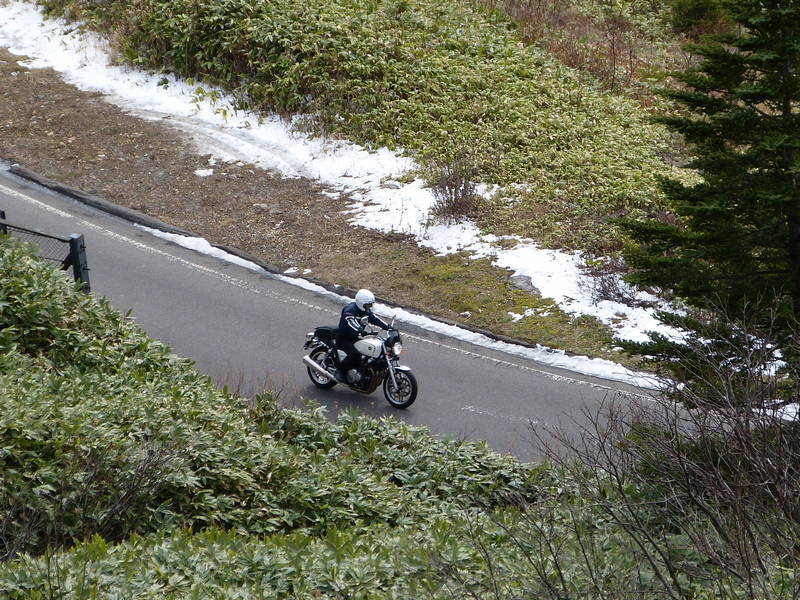
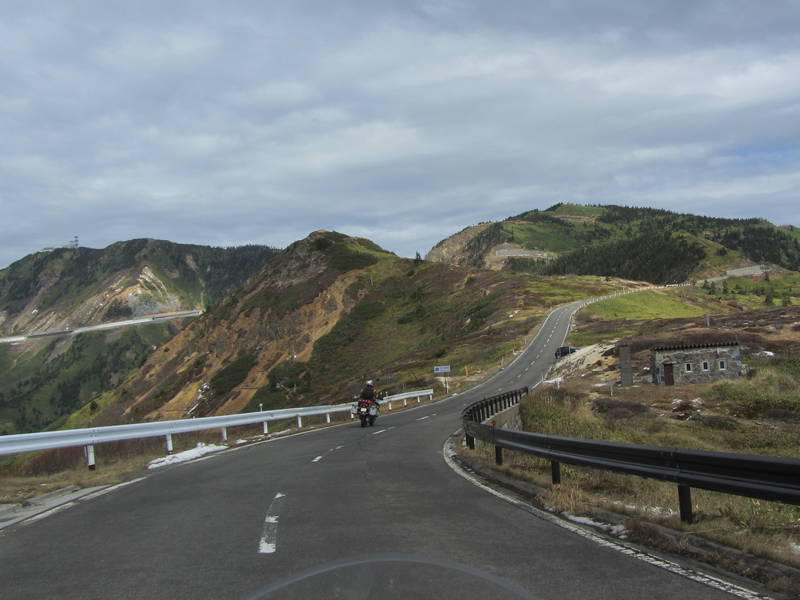
At least there is no snow on the roads
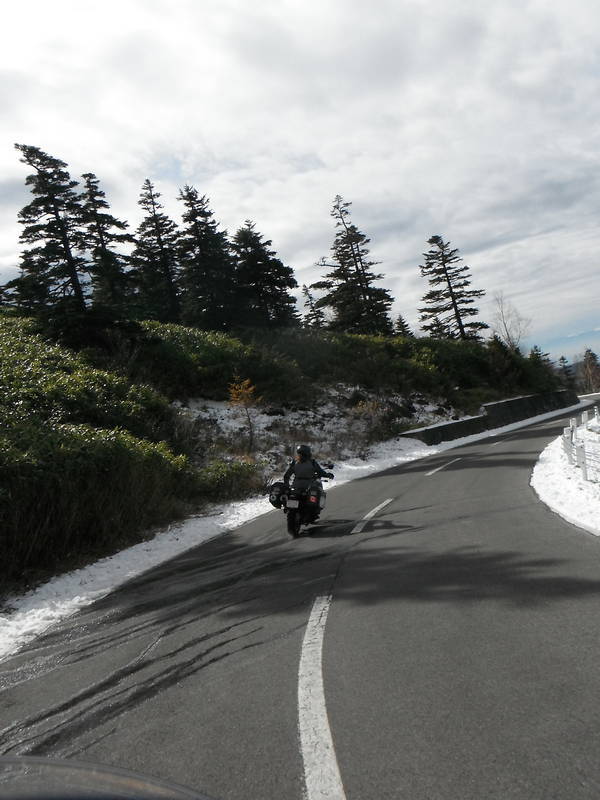
What lovely fall colours as we come back down
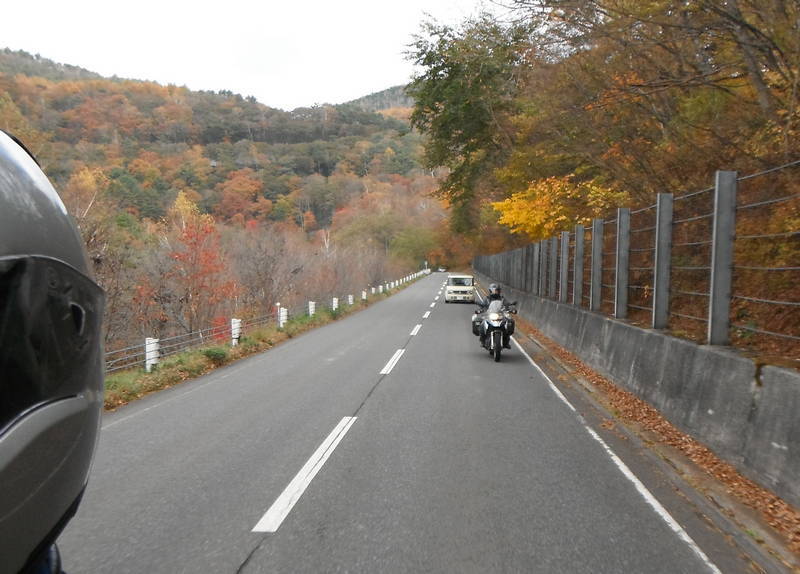
Following our helpful guide to the Snow Monkeys

An easy 1.6 kilometre walk to the monkey onsen
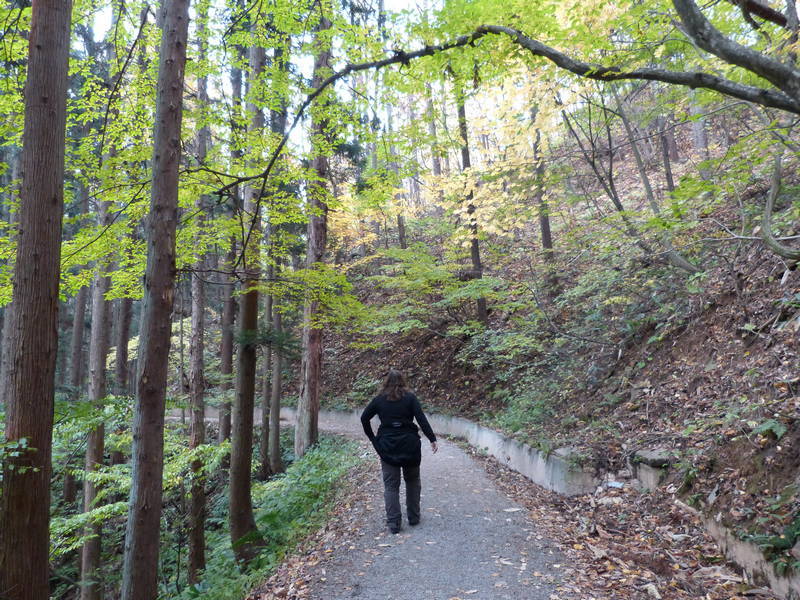
Our first monkeys were seen before the hot pools

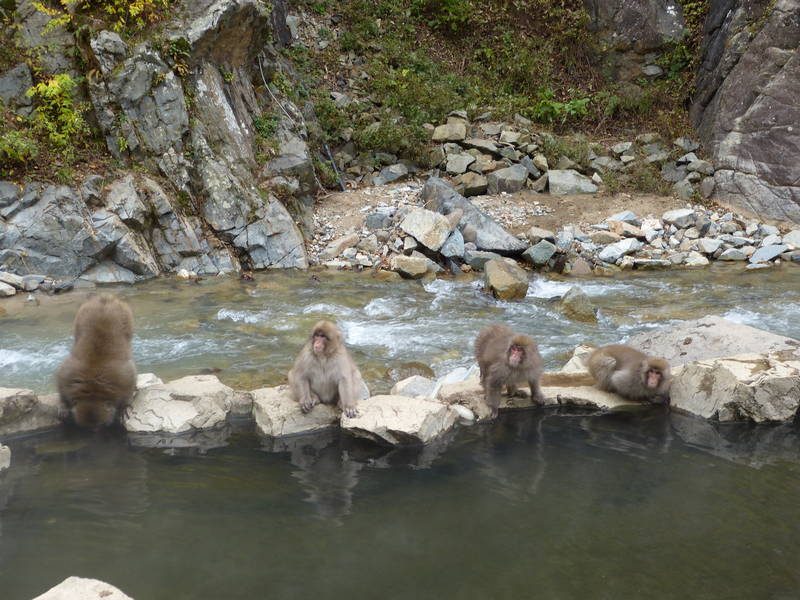
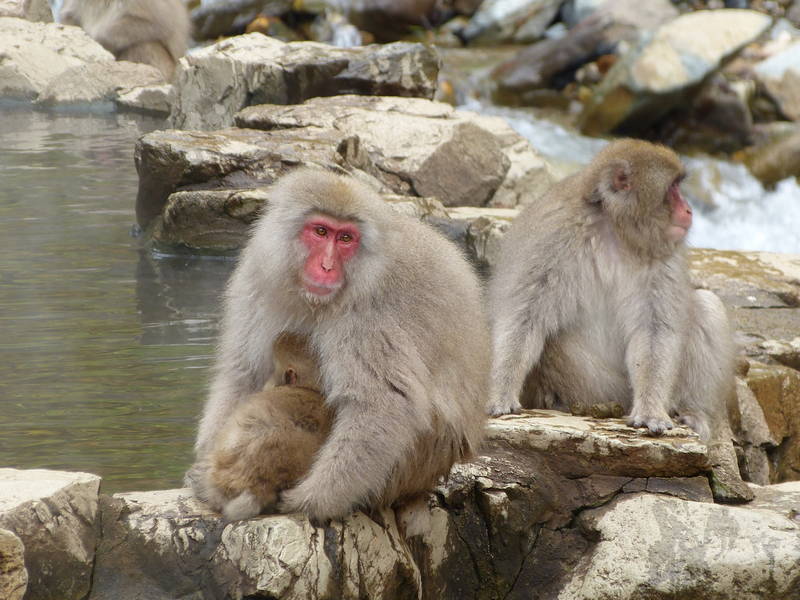
Audrey contemplates joining the monkeys to warm up after the cold ride
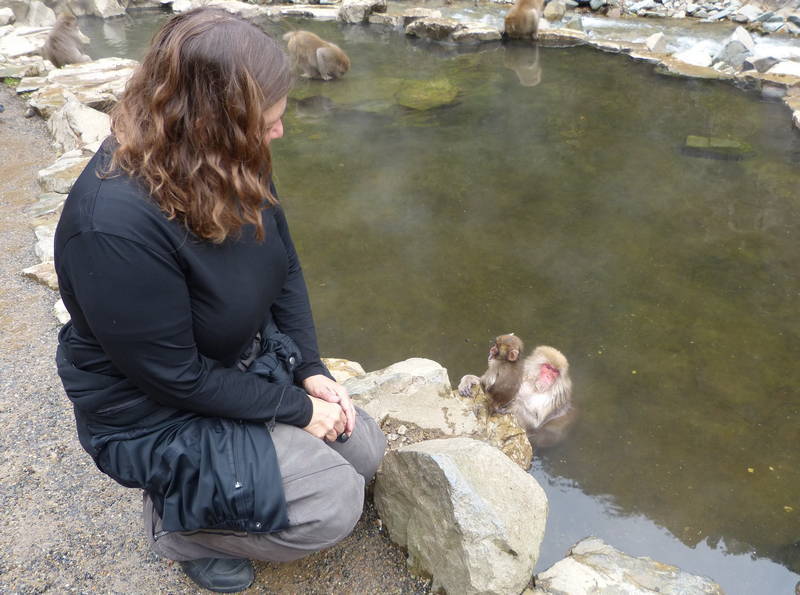


Bye bye monkeys

Back to Kusatsu as a chilly fog fills the valleys
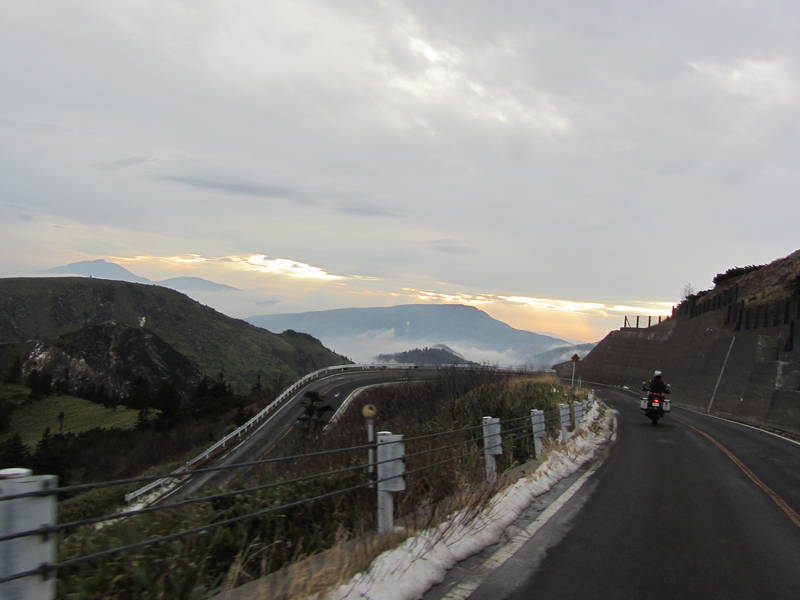
Posing in the central square in front of the hot springs of Kusatsu
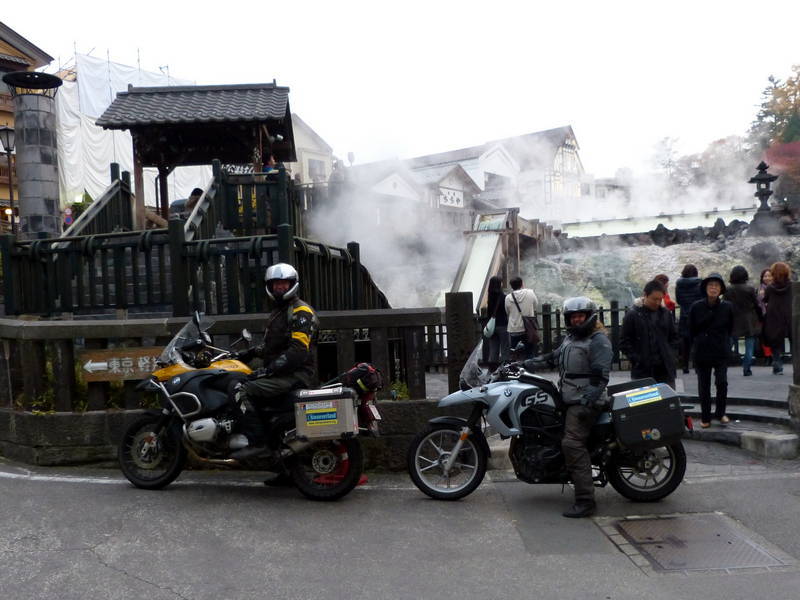
And then going out for a delicious pork tenderloin
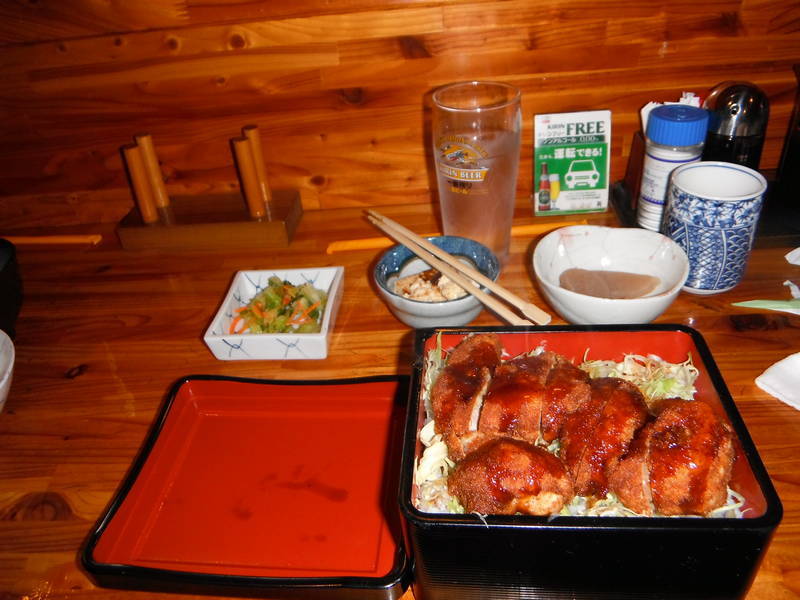
We awoke to the sound of rain falling outside our window and it looked quite miserable out there. Our destination for the day was in the vicinity Mount Fuji and it didn't look like we would get a look at Japan's iconic peak. We had missed a folk show the previous day so when we found out that there was another show at 9:30 in the morning we went to the central square before checking out of the ryokan. The show was quite entertaining as local women sang and stirred the hot waters of the onsen. Apparently the stirring cooled the water down from 95 Celsius to a more manageable temperature. Back at the ryokan we struggled into our rain gear and packed our bikes in the rain before heading up into the hills. By noon the rain had quit so we peeled off our rain gear at a gas station and then went to a Lawson Station convenience store for lunch. Lunch at "convenie's" was always great, with a nice hot Royal Milk Tea and sandwiches with the crusts cut off or sushi and edamame beans. 7-11s have the best cream puffs but Lawson Stations have the best corn dogs. All have spotlessly clean restrooms. We had downloaded a camping guide from the internet and it showed a campground on Lake Saiko but the directions weren't more detailed than that. After a short stint on the expressway we then crossed a small mountain range to get to the lake. By all accounts we should have been able to see Mount Fuji by now but the low hanging clouds obscured our view of the tops of even the low mountains we were riding through. A road circumnavigated the lake and we randomly chose to ride in a clockwise direction. We examined every sign and looked into every meadow for a campground. After half an hour or so we still hadn't seen anything but when I pulled over in a small town Audrey said that she thought she had seen tents in the trees a little ways back. We backtracked a ways and sure enough there were a couple of tents and what looked like camping facilities. A young man came out of a small building and indicated that we were in the right place. ¥2,000 per person, while expensive, was less than a hotel so we decided to stay a couple of nights with the hopes that we could ride up Mount Fuji if the clouds lifted. As it was dark after setting up the tent we didn't feel like cooking so headed over to nearby Kawaguchiko and found a family restaurant for dinner. Back at camp later that evening we received an e-mail that would change our trip. Audrey's Mom had had a stroke.
The folk show with women stirring the hot water to cool it off
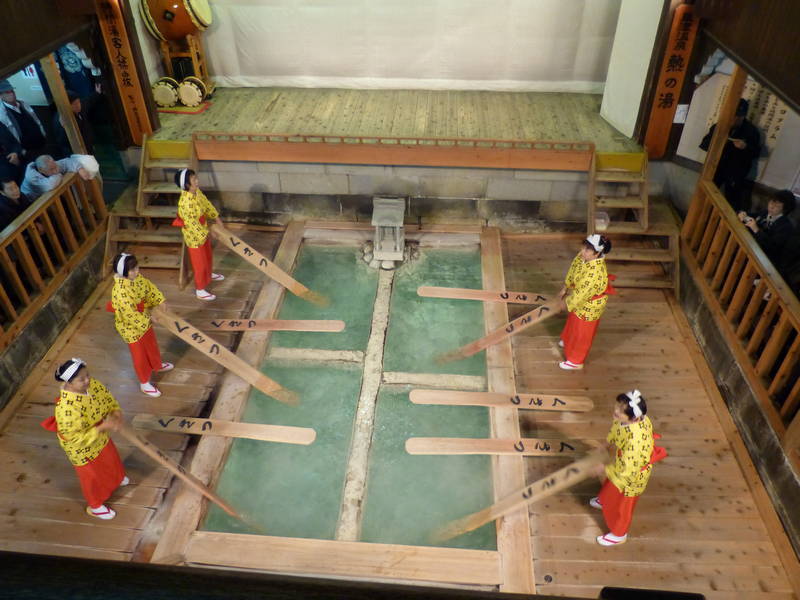
Followed by folk singing and dancing

Then we bid "sayanora!" to our hosts (standing on the steps up to the ryokan to get a little closer to Ekke's height)

A damp start to the day
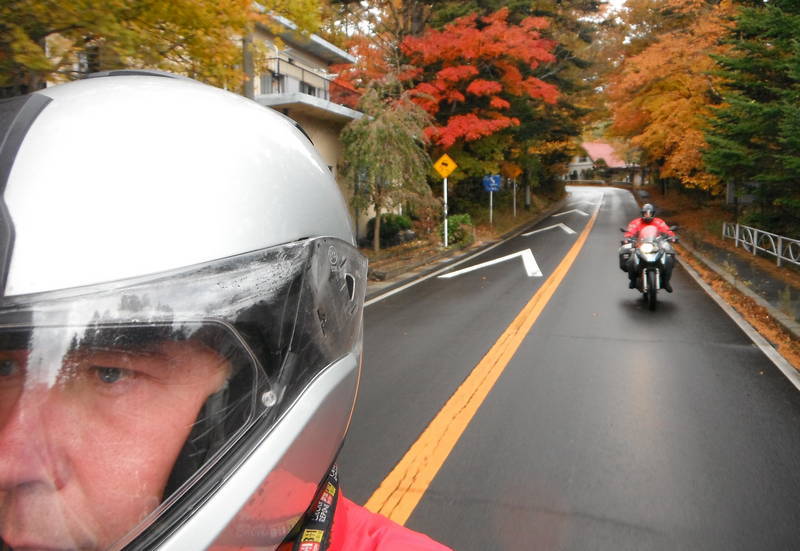
At least it isn't raining anymore when we find the campground at Lake Saiko
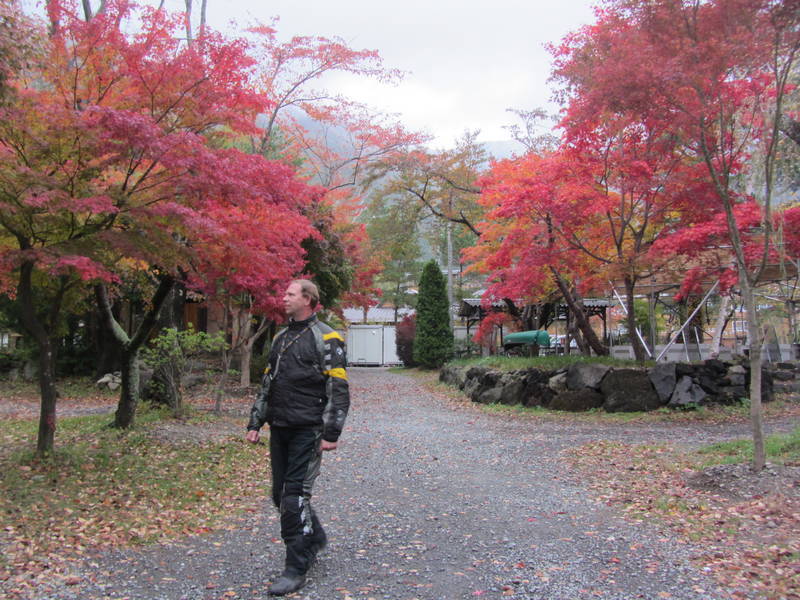
We tossed and turned as we worried in the chilly tent. Many thoughts ran through our heads and our first reaction was to jump on the next plane home. We managed to get through to Jackie, Audrey's sister in Carstairs, on Wednesday morning using Skype and found out that it was a minor stroke and Verna was recovering well in the Didsbury hospital. This really took the urgency off of getting back to Canada and we were now able to think a bit more clearly. We decided to ship our bikes to Singapore using a Roll On Roll Off boat (RORO) and while the bikes were in transit we could fly home. Checking with a shipping agent we found that the next boat left from Yokohama on November 26 and was scheduled to arrive in Singapore on December 17. This would give us a couple of weeks in Japan before going back to Canada and we would have a couple of weeks at home before flying on to Singapore to meet the bikes. We started making the necessary arrangements.
As the day had dawned with a thick fog we didn't hold out much hope of catching a glimpse of Mount Fuji. However, while we were Skyping Canada the fog started to burn off and soon there was a bright blue sky. The campground host had told us that Mt. Fuji should be visible from the campground and when we walked out from under the trees, there it was; the spectacular snow-capped peak of Fujisan glistening in the sun. We had to take advantage of this opportunity as apparently it was quite rare to see the top of the mountain. As we were leaving the campground the host came over and suggested a special view point. The ¥1,000 note has a picture of Mount Fuji on it and the spot where the picture was taken wasn't too far away from the campground. This sounded great so he gave us directions and we rode the 25 kilometres to Lake Motosu. The light wasn't quite right for the classic ¥1,000 shot with Mt. Fuji reflected in the lake but it was a beautiful scene nevertheless. By noon the temperature had warmed up enough that we dared to ride up Fuji to the end of the road at the fifth station, or about half way up. During the climbing season it is possible to hike the rest of the way to the very top, also known as the tenth station. We paid the ¥1,600 toll each and the road started climbing. The higher we rode the colder it got until the thermometer showed 2 degrees and the ice warning light was flashing on the dash. Fortunately that's about when we reached the end of the road so we were able to go for a walk and warm up in a café. An onsite post office allowed us to mail a couple of post cards home with Mt. Fuji stamps and then we rode back down to catch the sunset at Lake Motosu. The last rays of sunlight on Fujisan were simply breathtaking. As soon as the sun dropped below the horizon so did the temperature and it was a freezing cold ride to a steak restaurant and then back to camp.
A lovely camp spot
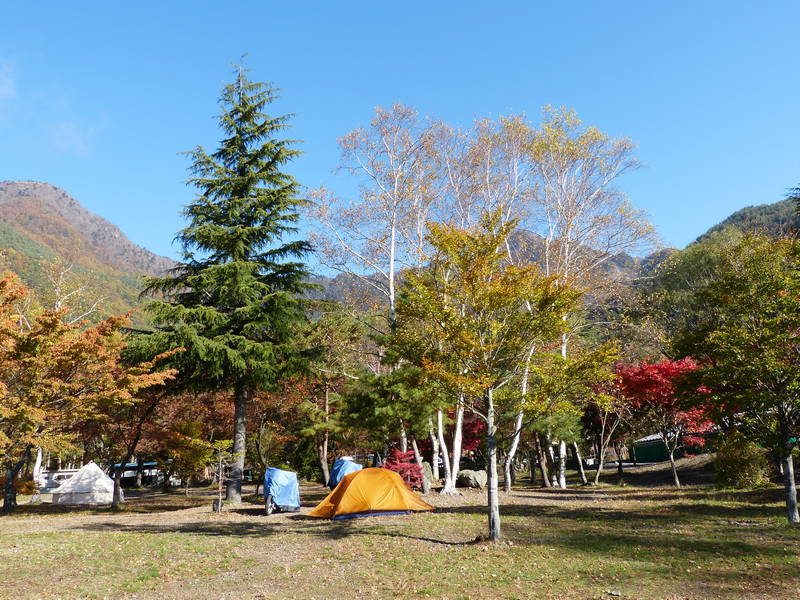
Mount Fuji as seen from the campground after the fog burns off
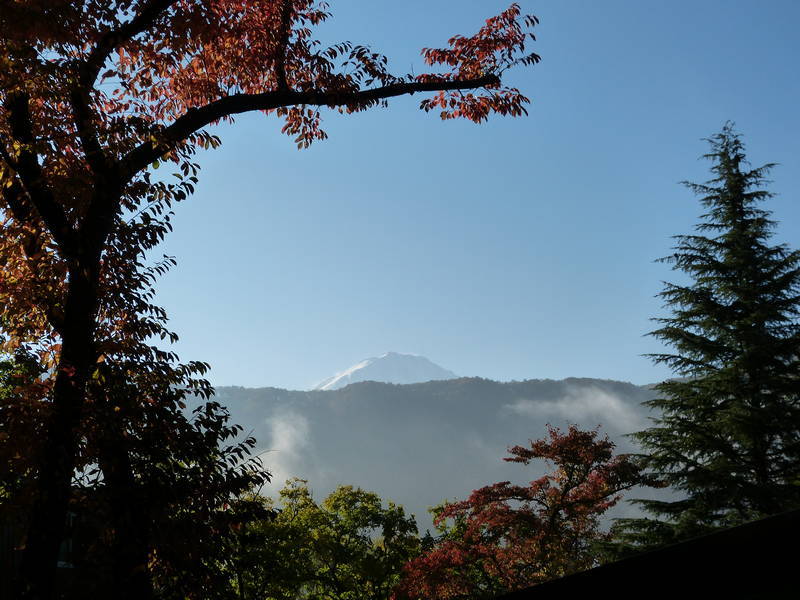
The ¥1,000 bill and a map to show us the way to the viewpoint to see the same angle

This looks like the right spot

That looks like a match
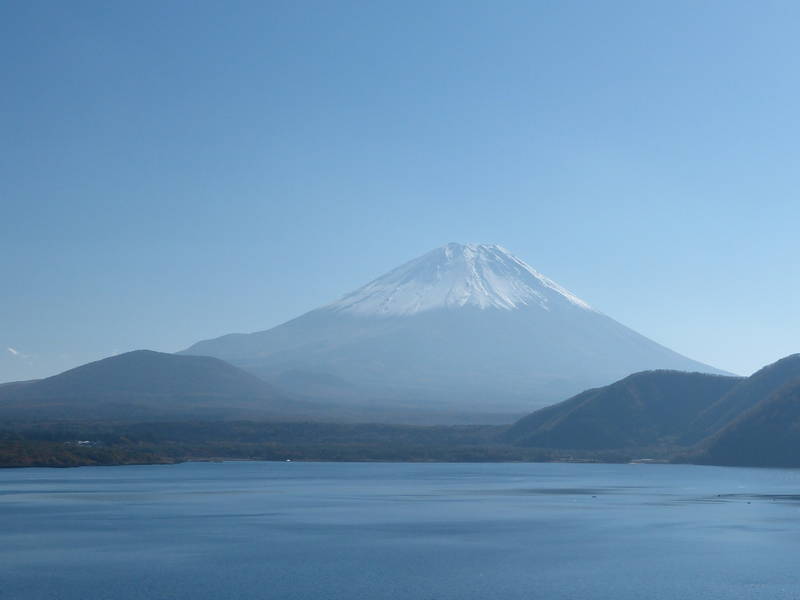
Riding back around Lake Saiko to see if we can ride up Fujisan
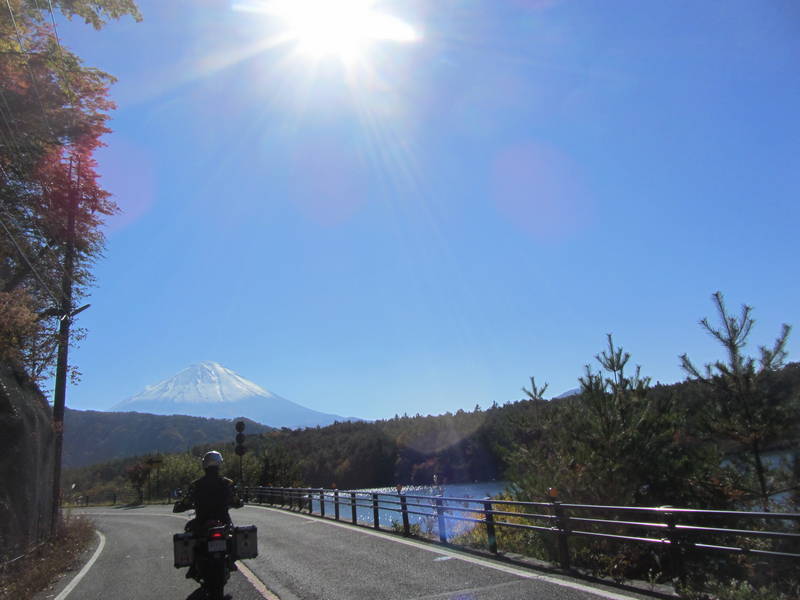
Yep, riding up the mountain
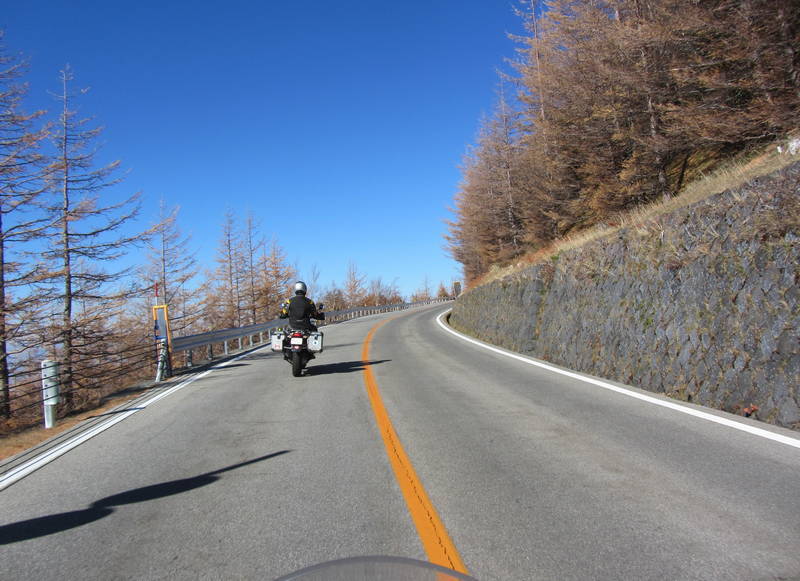
Parked at the fifth station (half way to the top)

Spectacular views of Kawaguchiko
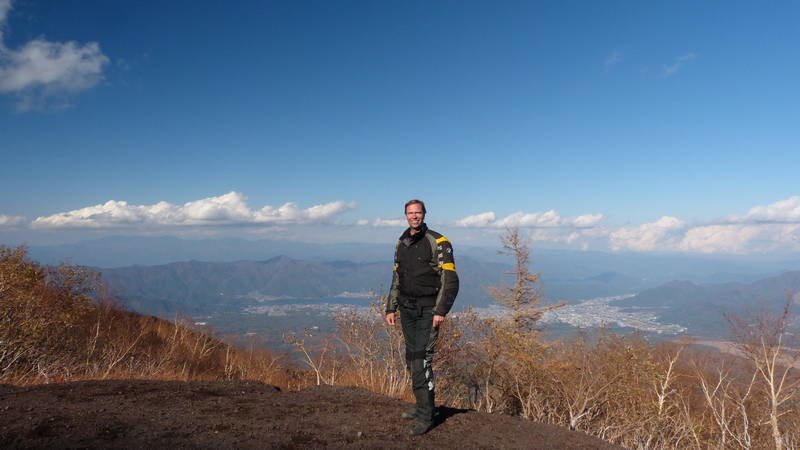
Writing post cards and having a delicious Fuji Cake while warming up in the cafe
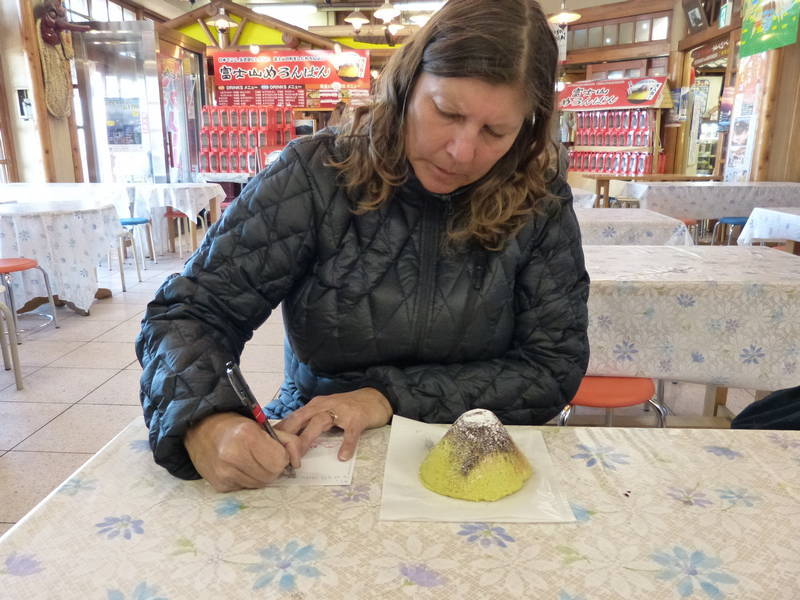
Back down at Lake Motosu for the sunset
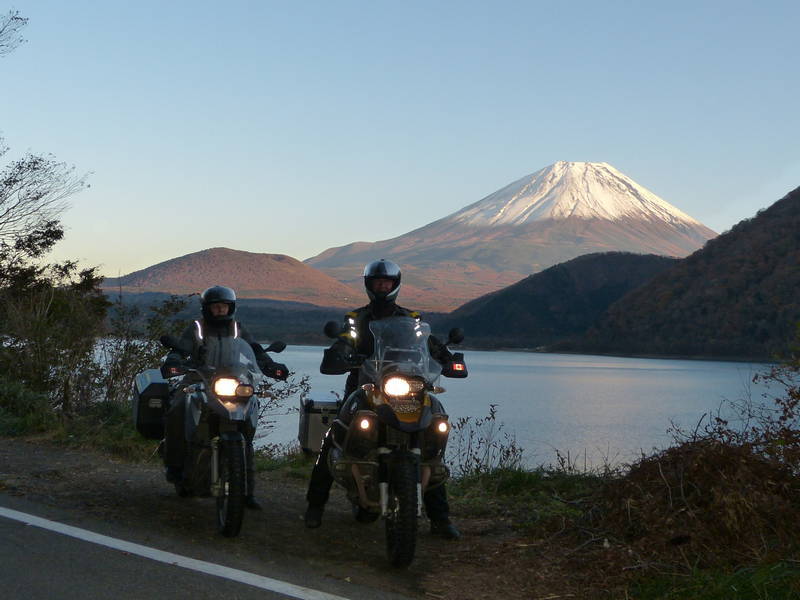
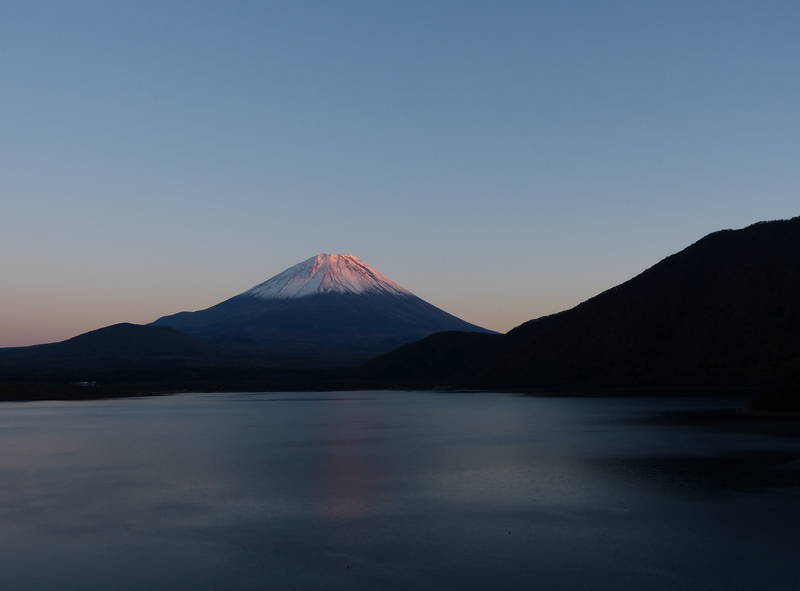
Another cool and clear day greeted us as we packed up the tent on Thursday and we rode in a counter-clockwise route around Mt. Fuji towards the coast. The views were once again simply beautiful and we had to stop numerous times for photos. The back roads were great fun to ride but of course slow going. We hoped that when we got to the coast things would speed up a bit. It didn't. We were beginning to learn that there were three types of Japanese roads: 1) fun, twisty, slow mountain roads, 2) straight, boring, slow city roads and 3) efficient, expensive, fast toll roads. Only one of the three could actually get you anywhere in a reasonable amount of time and that was the toll road. After a number of hours of riding and only getting 60 kilometres we had to admit defeat and jumped on the toll road to get to Anjo, near Nagoya. We finally arrived at a comfortable and clean Toyoko Inn as dusk fell. Good thing they had room for us. As usual the front desk clerk were usually rather taken aback when we said that we didn't have a reservation. We decided to start using www.toyoko-inn.com to make reservations if we could as it seemed that these business hotels were usually easy to find (the buildings had the name in huge neon letters), were near train stations (usually easy to find) and were reliably clean, comfortable with a decent price (for Japan). I had received an e-mail from Dot Easy saying that they had no problems with our website so I tried uploading the China chapter again. Still no success. We had dinner at a nearby Italian buffet restaurant where we found that an Italian restaurant in Japan is different from an Italian restaurant in North America or Italy for that matter. We had never seen tofu or seaweed at an Italian restaurant before. The pizzas were delicious.
A rest stop as we ride around Mount Fuji towards the coast (the UJM is alive and well in Japan)

Looking at the map, how can we be lost? Where's a good landmark?
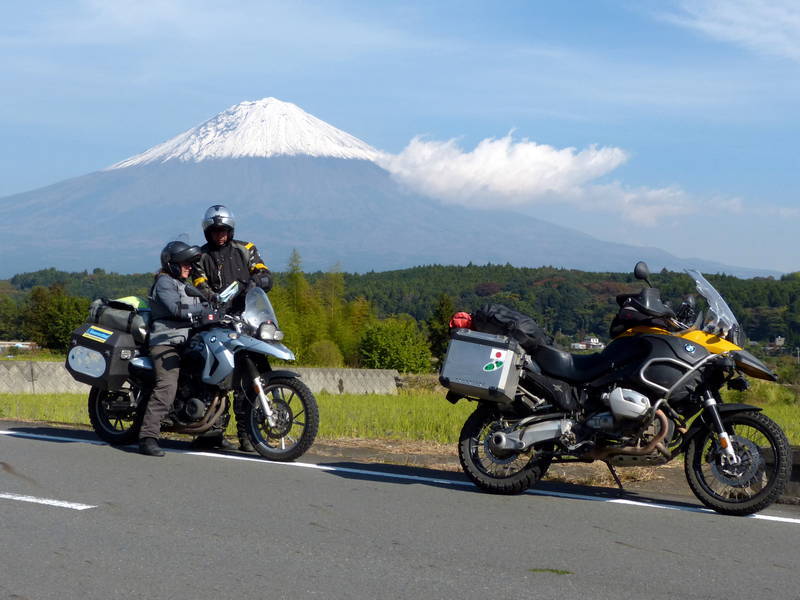
Before leaving the Toyoko Inn we booked our flights to Calgary. Our original plan was to fly to Calgary and then straight to Singapore but it turned out that a return flight to Tokyo and then a one-way flight to Singapore would save us several hundred dollars. The added advantage was that we could leave the bulk of our luggage (like the motorcycle clothing and helmets) with Noguchisan in Saitama and pick it up on the way through to Singapore. Finally getting underway at noon we stopped off at a local motorcycle shop to pick up chain lube for Audrey's bike. When the people found out about our trip they were so excited, insisting on taking lots of photos of us. The owner of the shop had rented a motorcycle and ridden from Calgary to Vancouver, right by our house, about 15 years ago. What a small world. Underway again we jumped on the expressway to get around Nagoya and rode towards Kyoto. As it was a weekend during the height of the fall colours every single hotel in Kyoto was booked full so we used our camping guide to locate a campground not too far out of the city. We found a youth camp in Nagaike that was an easy train ride from the centre of Kyoto. The access road didn't look very encouraging as the road was very narrow and overgrown with trees but a kilometre up were some buildings, volleyball courts and BBQ pits. There weren't any tents set up but there were a couple of small motorcycles in the gravel parking lot so we walked up to the large building and found that it was indeed a youth camp and they would be happy to let us set up the tent in an out-of-the-way spot. After setting up next to a bamboo grove we rode down to Nagaike where a shopping mall had a large grocery store to purchase breakfast supplies as well a McDonald's for a change-of-pace dinner. In the evening I tried uploading our website again using the campground's wi-fi and was surprised that it worked without a hitch. Perhaps the Toyoko Inn servers were blocking the FTP transfer?
The excited staff at Moto House 21st

Riding around Nagoya on the expressway. Yes, there are a lot of Priuses in Japan.
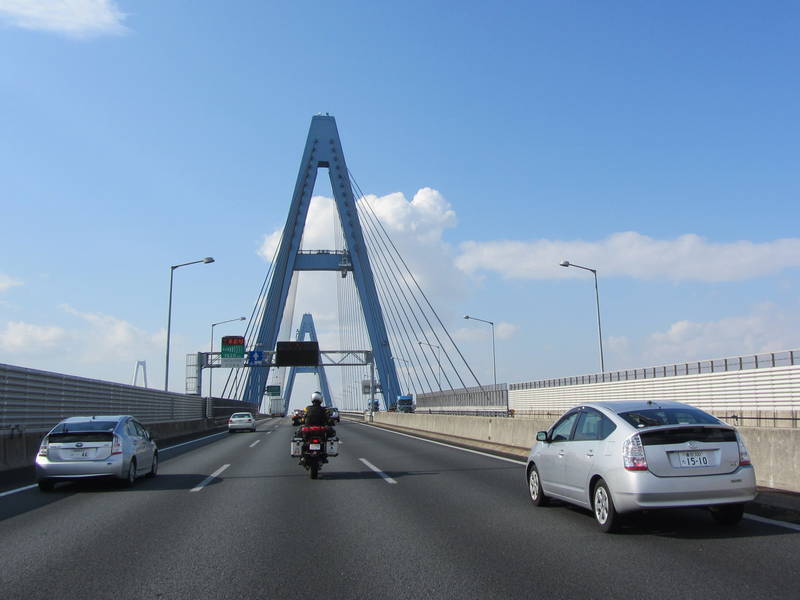
Expressway leaps across enormous valleys, the best way to make any distance in Japan (OK, the shinkansen may be better)

Setting up the tent beside a bamboo grove at the youth camp
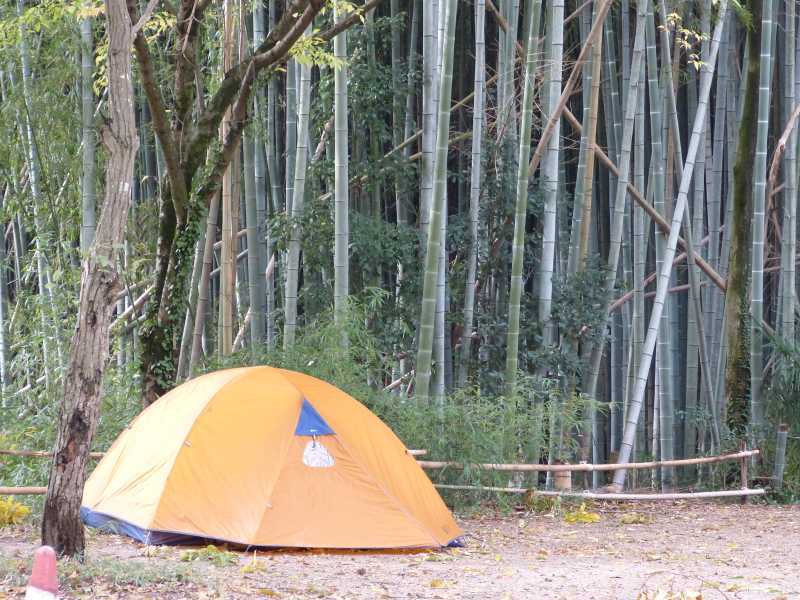
While it was expensive to travel in Japan, it was really starting to grow on us. The travelling was relatively easy, with fabulous infrastructure, but at the same time incredibly exotic with things that you would only see in Japan. We had now recuperated from our China experience and could contemplate something more challenging rather than spending the rest of the trip in an easy to travel place like New Zealand. We were also really looking forward to visiting Kyoto, a place that everyone had said would be the highlight of any trip to Japan, especially with the fall colours lighting up the temples and gardens.
A few transportation-related photos:
OK, the red light is on the other side compared to what we're used to but even so, what are you supposed to do here?

Data collectors at work (technology seems to be behind our electronic counters)
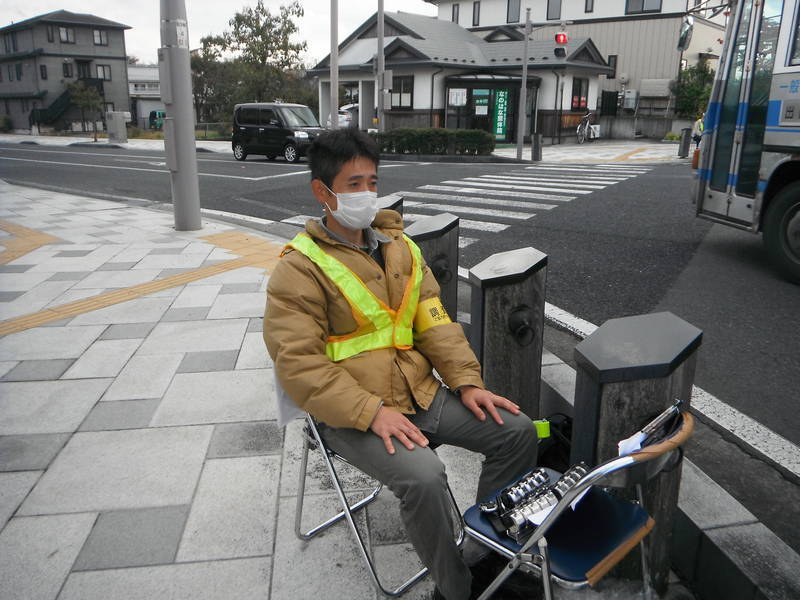
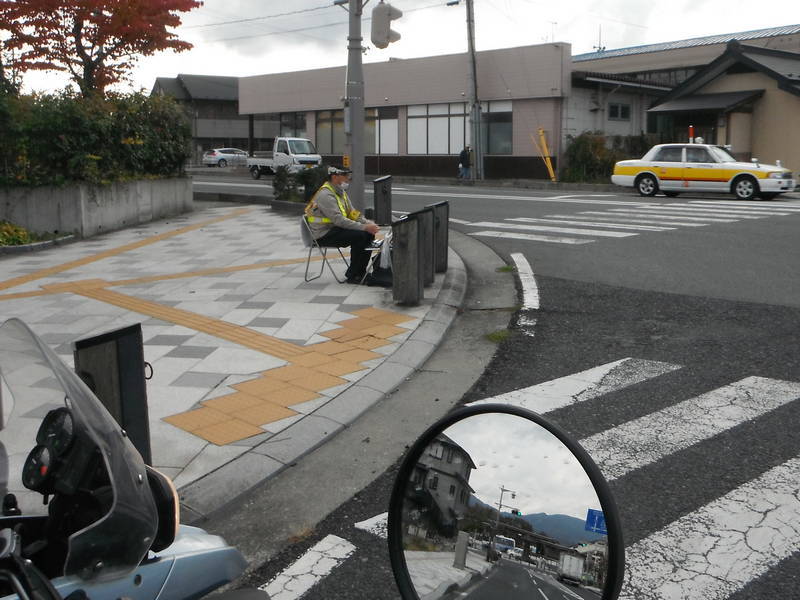
How would they count that scramble intersection?
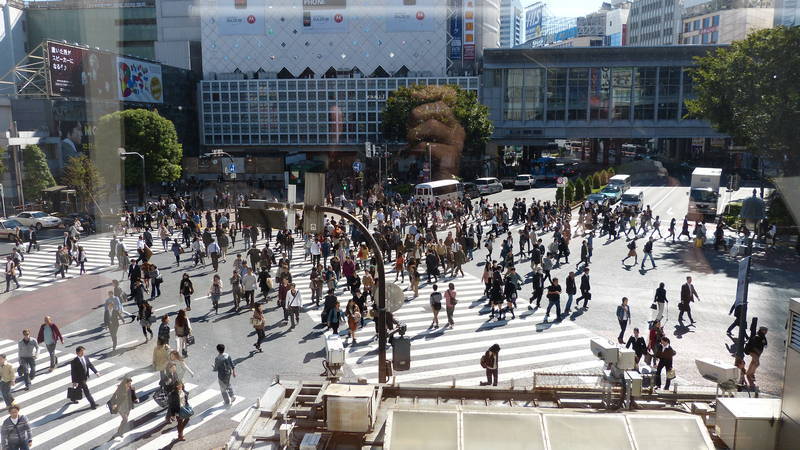
All throughout Japan different cute animals hold up traffic barriers
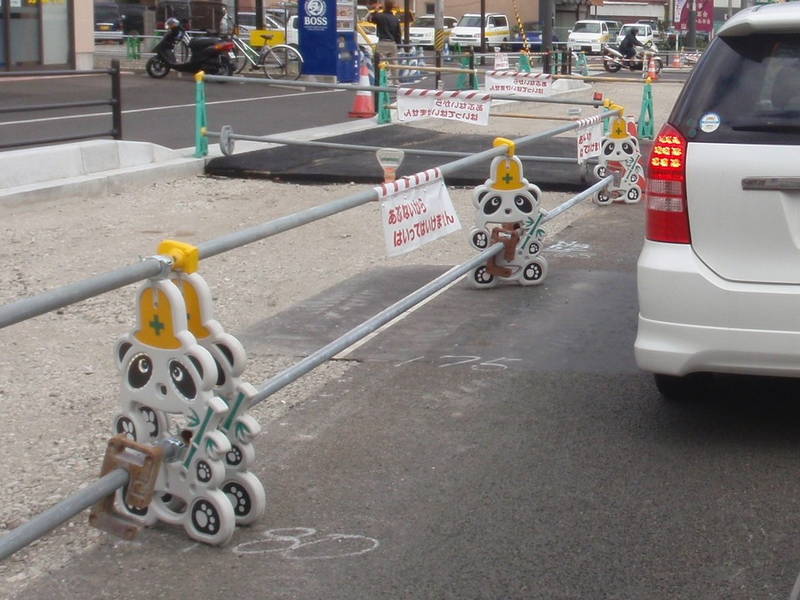
Knowing what these signs said might have been useful (guessing construction on the left but no clue what the cute cat is trying to tell us)
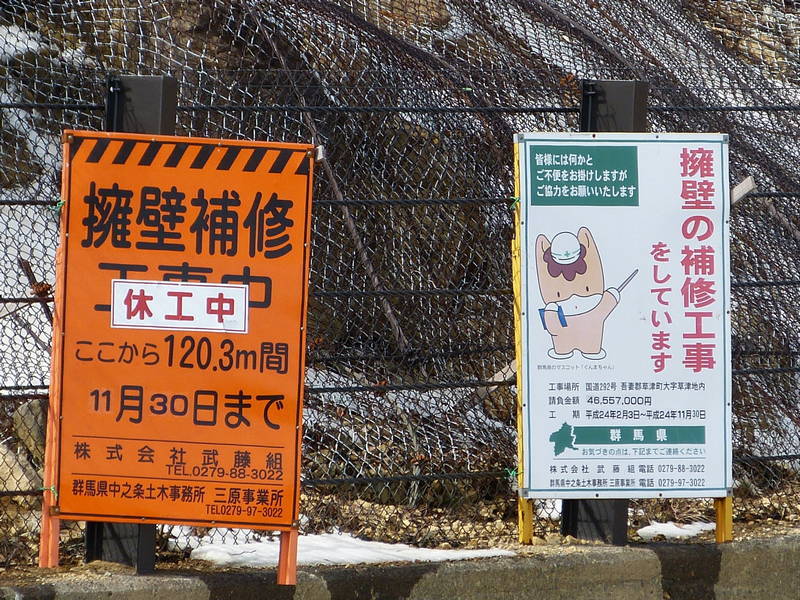
"Waffles" used to stabilise a cliff
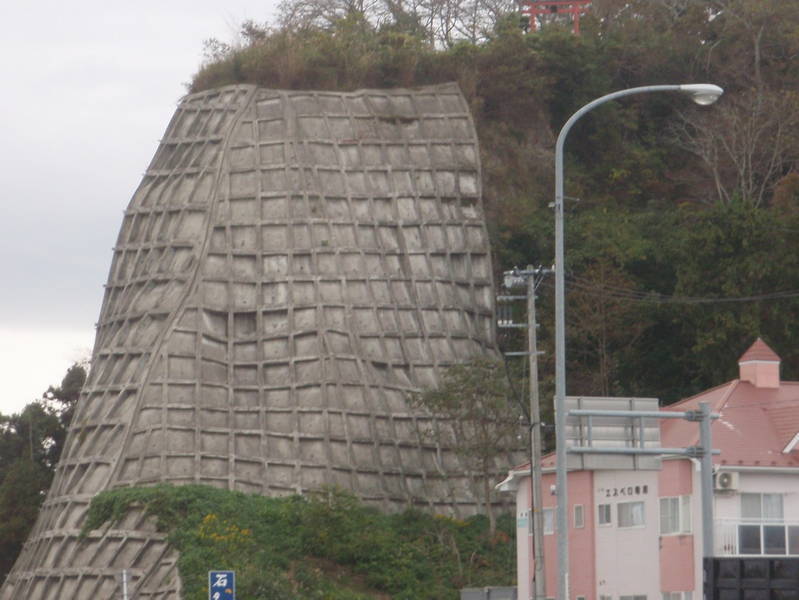
Electric charging stations not popular yet but a few rest areas along the expressway had them
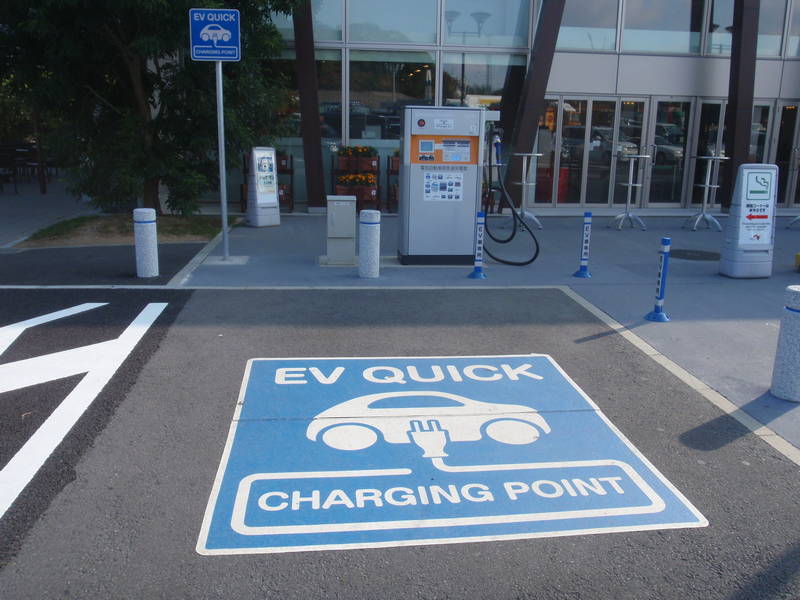
Map of our route through Japan
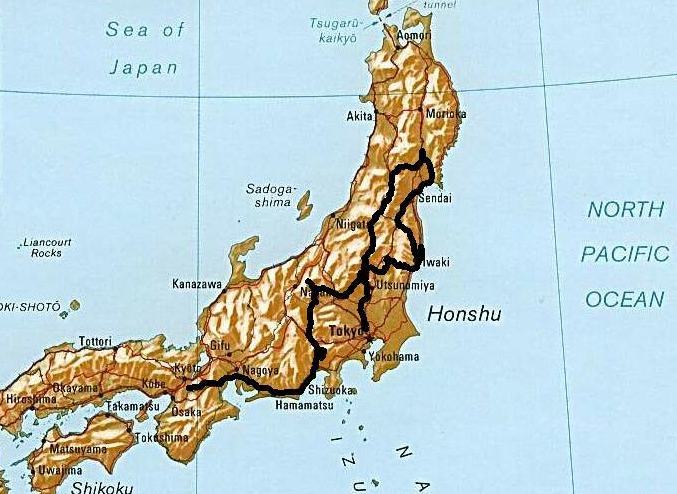
Kyoto, a former imperial city, is high on the list of places to see for most travellers, and we were no exception. It was time to park the bikes for a while after so many fabulous rides through the Japan Alps. It was also getting cold up in the hills, so we were hoping for some better weather down in the valleys. The trains ran with great efficiency and impeccable timing, and we just about missed ours on November 10th, having to run the last few hundred metres because the walk to the station had taken us longer than expected. Public transportation in Japan is fantastic, but it does put you on a schedule. The station at Kyoto was huge, with really high ceilings, and it felt like being inside a great cathedral. Our plan was to find a bus and go see a few temples and shrines. We saw a bunch of tourists in line for a bus so Ekke stood in line while I searched for tickets, and we got a couple of day-passes for about $5 each. The bus took a really long time due to traffic congestion, probably 45 minutes to get to the temple we were most interested in. We should have started with the closer temples. Ginju Temple was quite stunning, though, especially with the riot of fall colours adorning the trees. The garden was exactly what Japanese gardens should look like, according to pictures I had seen. Even with hoards of people, the place had such a peaceful feel with reflecting ponds, stone bridges and tiny, manicured trees. It was like wandering through a photograph.
Ginju Temple Gardens
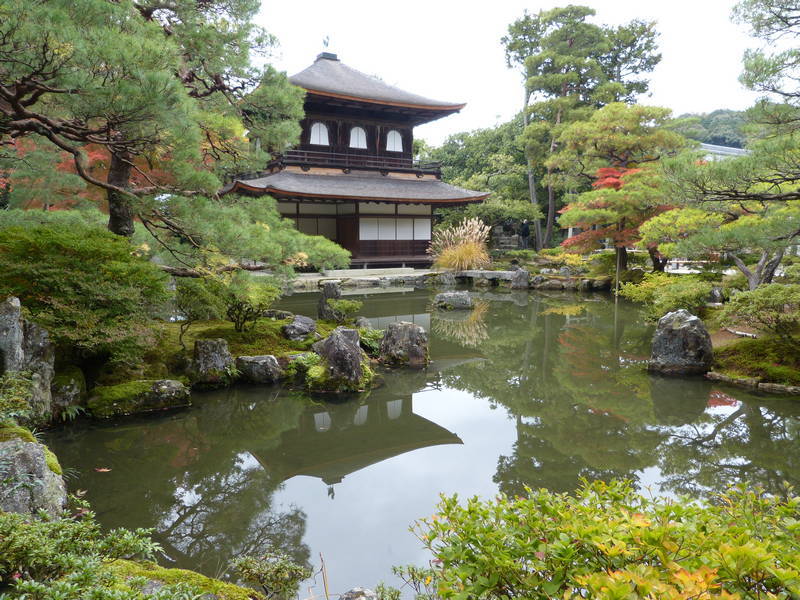
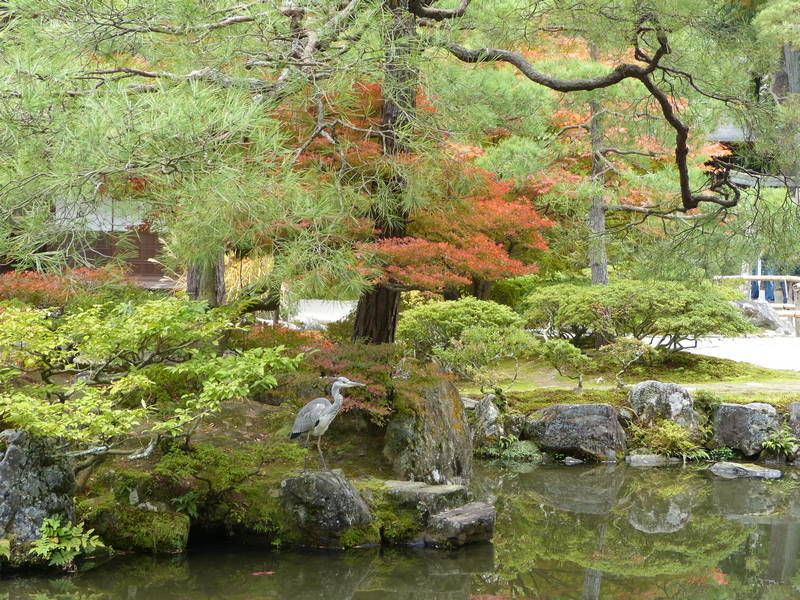
Audrey enjoys a "Handmade Ginkakuji temple cream puff"
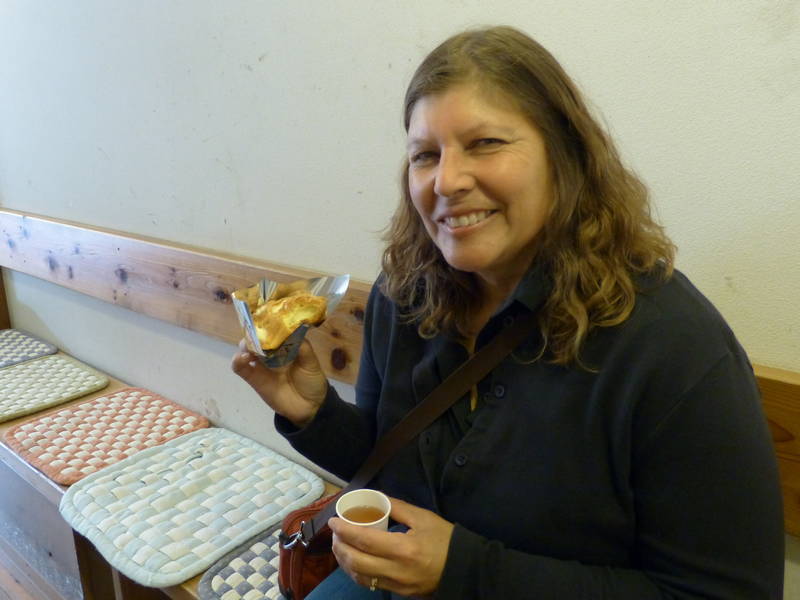
Outside the gate we strolled along the Path of Philosophy, a walkway along a canal that passed by several temples. A local stopped us and showed us some rocks he had painted with scenes of some of the temples. What a great souvenir of Kyoto. Honen-li temple was very simple in design, and we were impressed by the ancient stonework. We looked up in awe as we walked through the huge, intricately carved gate of Nanzen-ji, a temple complex of 13 structures. The gardens were so interesting to us with the sand raked into different patterns amidst little bonsai trees. Temple-visiting takes quite a lot of time, and with a lunch stop and coffee breaks, soon the day was over. Evening was nearly upon us but I still wanted to visit the area of Gion and see some of the places featured in the novel, Memoirs of a Geisha. There were some beautiful old restaurants where the Geisha would perform hostess duties, and locals and tourists alike were waiting outside one of them hoping to spot the elusive Geisha. Lonely Planet says that Geisha-spotting is a hobby for some people. We waited and watched for a while for someone to go in or come out and got bored very quickly. Also, we had seen Geisha wannabes all day long. They looked great but I knew they were not real Geishas. The hair was all wrong and there was no white powder on their faces. They were tourists, dressed up in rented Geisha kimonos for the day. It was almost like being at home during Stampede Week. A popular fish-wrap restaurant advertised that there were lovely Geishas inside, but it turns out they were mannequins. Still, Ekke got his photo taken with a Geisha so at least his dreams had come true.
A local artist sells us a beautiful handpainted stone and suggests we visit a nearby temple

The nearby temple features animal statues and shrines
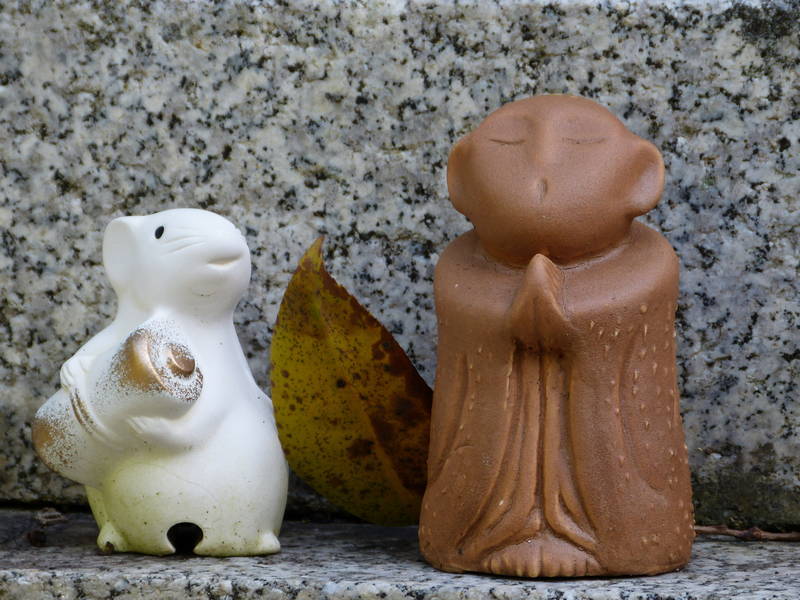
Time for an "octopoffertje" break on the Path of Philosophy
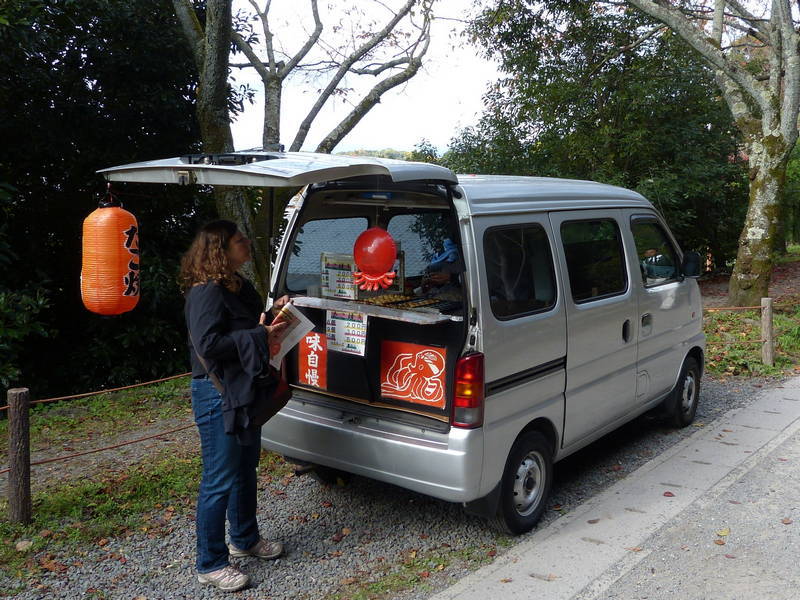
Lunch break has typical tables that are a trifle too low for Ekke's knees

Is it still called a Japanese Garden if you're in Japan? Isn't it just a garden?
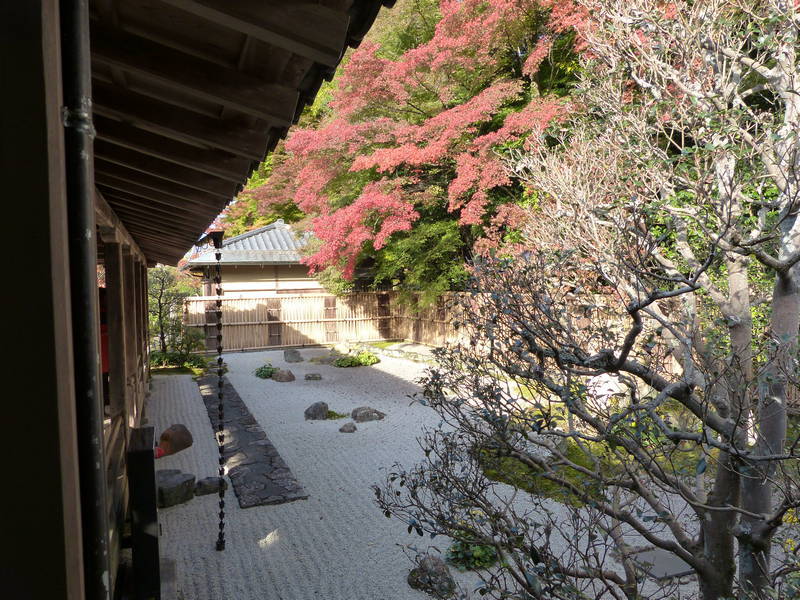


Dressed up for visiting Kyoto
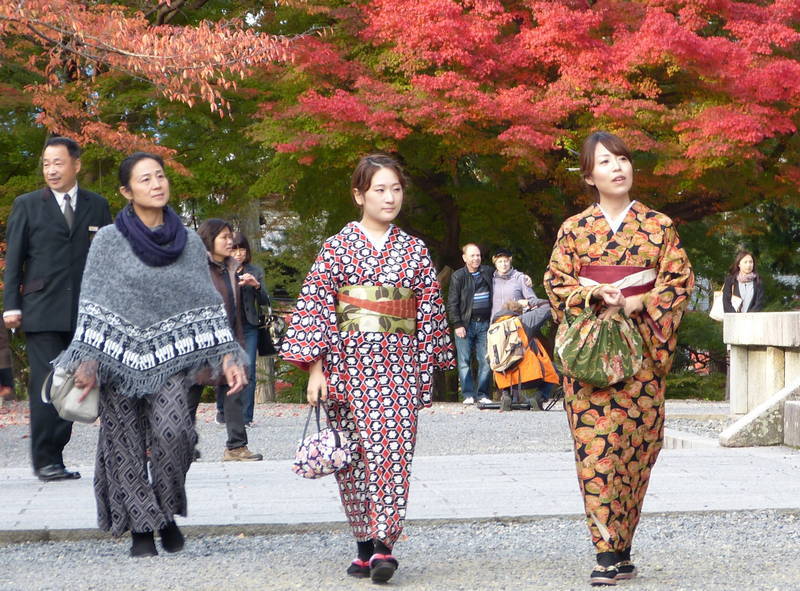
Ekke enjoys dinner with a Geisha
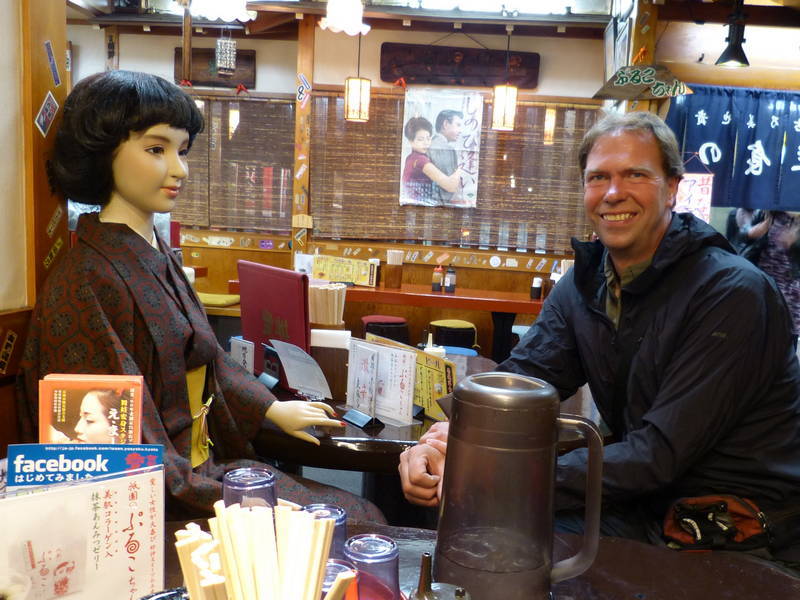
To heck with Geisha spotting, check out this nice Honda S800
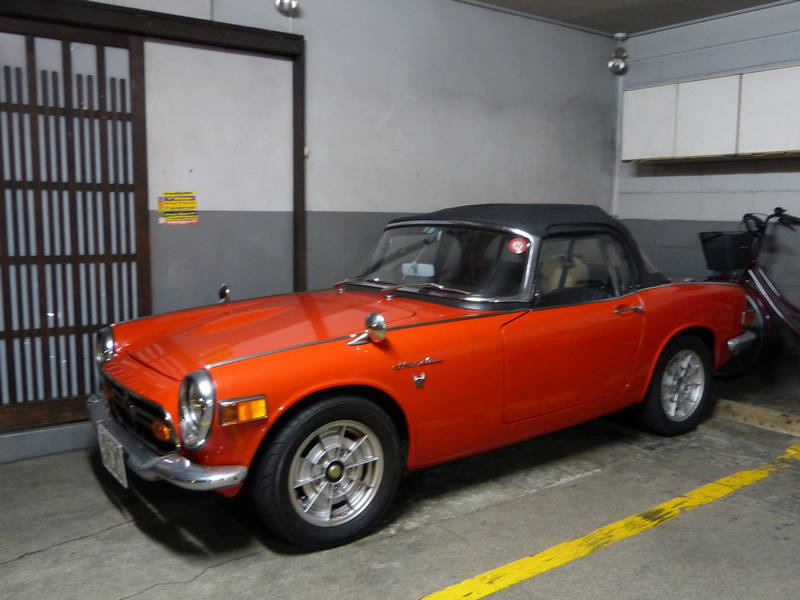
It was lovely waking up in the tent the next day, all snug and warm in our sleeping bags, a bamboo forest right outside the door. Granola and milk was also a special treat, a great change from hotel rice and pickle buffet breakfasts. Another train whisked us into Kyoto for round 2 of temple hopping. A Starbucks was a welcome sight as it had started to drizzle a little bit. The bus to Buddhist Kiyomizu-dera was quite quick. The temple, built in 778 AD, was very popular and here, even in the now-pouring rain, were the biggest crowds we saw all day. We walked along a big balcony, quite high up, with great views of the forest and city. Some young people were trying their luck by walking close-eyed between two big rocks. If they could make it to the other rock without opening their eyes, then true love would come to them. Mostly there were just people with closed eyes bumping into each other. Chion-in, further up the road boasted the biggest gate in the world and we climbed the tall steps up to the huge structure. A golden Buddha sat, just glowing, looking out at us from its perch inside the beautiful wooden temple.
Lots of rain as we visit the Kiyomizu-dera
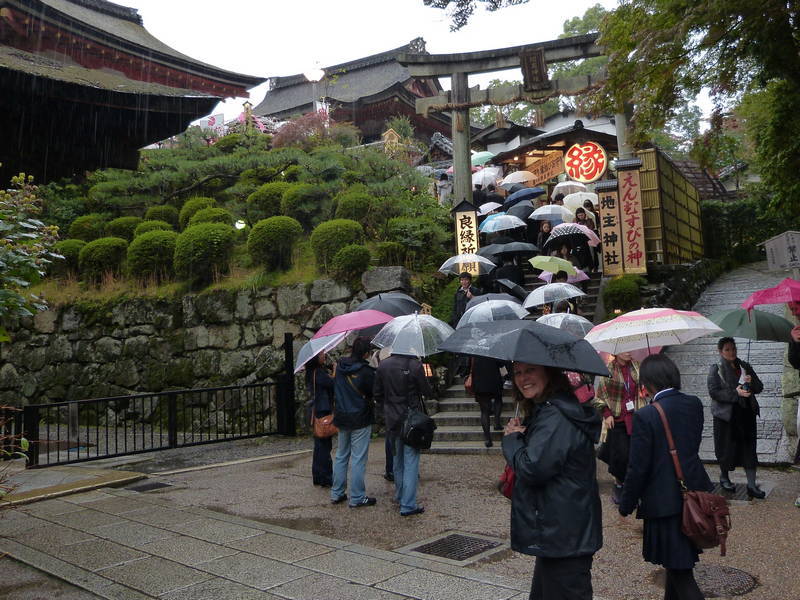
Rocks of love, try to walk to the other rock with your eyes closed. If successful you'll be lucky in love.
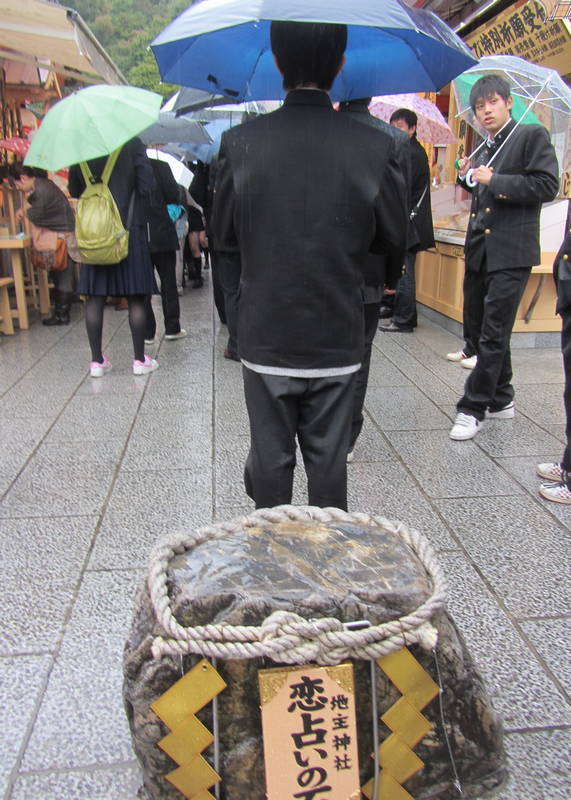
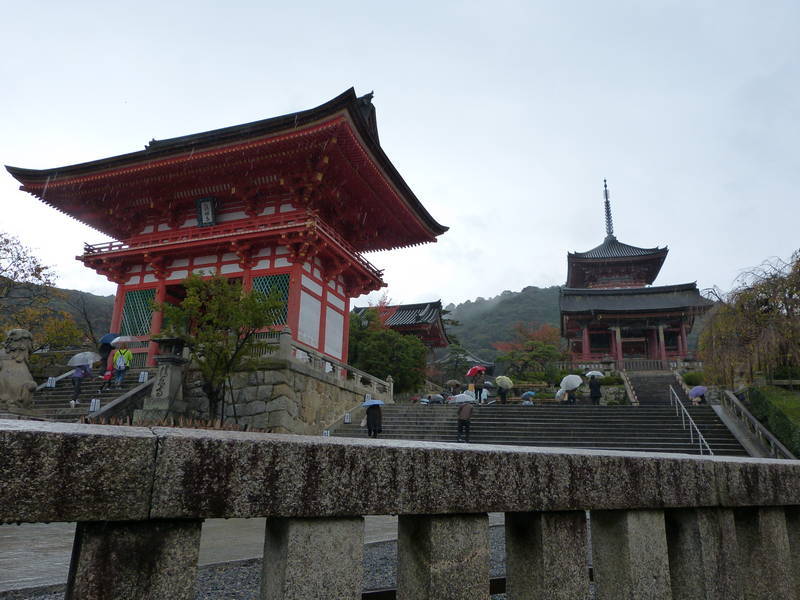
More tourists dressed as Geishas

The rain just wasn't letting up so we took refuge in Shonen-in, my favourite temple. It was so peaceful there, with very few people, and we wandered stocking-feet on hardwood floors through rooms lined with painted murals. Sitting on tatami mats on a lovely verandah was a great place to dry off, surrounded by impeccably landscaped gardens. After a short bus ride to downtown Kyoto we found the Opa department store, which had an extremely interesting Christmas tree out front. The store offered refuge from the rain, and we enjoyed some pasta and pizza at their upstairs cafeteria. But the really interesting foods were at Nishiki market, a centuries-old historic covered market street. There were lots of creatures on display that I did not recognize, many with extra tentacles.
Exploring Shonen-in Ekke didn't hit his head even once

Looking out at the lovely gardens, out of the rain

Umm, "interesting" Christmas tree
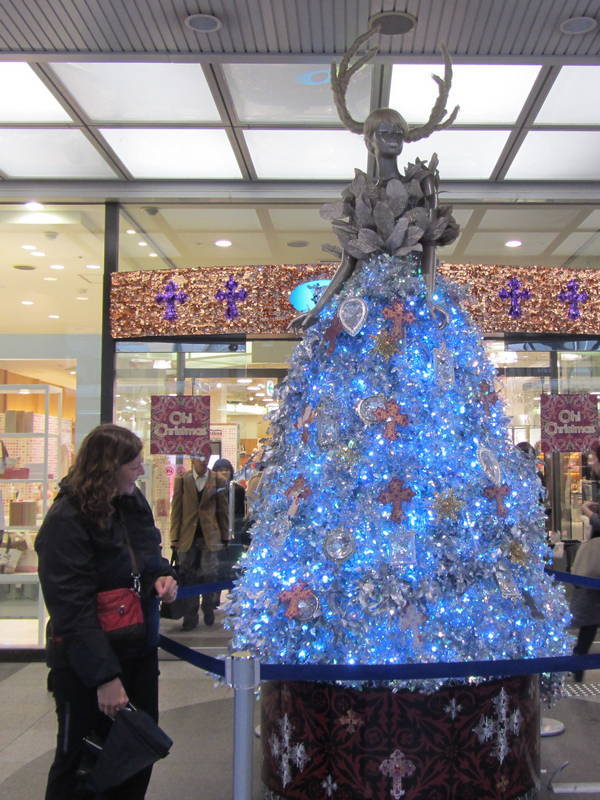
Octopus on a stick in the Nishiki Market

A big shopping mall near the station in Nagaike was the perfect place to seek refuge from the rain for the evening, and then we took a cab back to the youth camp. There was so much more to see in Kyoto, so we knew we'd have to come back sometime. But it was time to move on if we were to get the bikes back to Tokyo to ship to Singapore. We packed up a wet tent and then headed in the direction of Himeji. There would be no way to make it there in one day if we took the regular highways, as we had to go through or around Osaka. The GPS took us on a toll-highway right through Osaka but traffic moved quite well. There were a few tollbooths, however, always awkward while wearing motorcycle gloves. I dropped one of my receipts while I was lined up to pay, but taking the time to get off the bike and pick it up would have delayed the cars behind me. Then I noticed that Ekke was showing his receipt to the tollbooth clerk, so I scrambled to get off the bike and chase after my lost receipt. No one honked their horns at me though and I could prove that I had paid for this section of the toll road already. At another tollbooth the payment method was not obvious but an attendant came over and somehow communicated to Ekke that he had to pay 100 yen. Digging out some coins was awkward. Then Ekke noticed that there was a 100 yen coin sitting in the change slot of the machine, so he just scooped it up and put it in the machine. One free ride. We saw a sign for a restaurant, and pulled off into a parking area. Stairs took us up to the restaurant, a structure that straddled the highway, like an overpass. The staff inside were very helpful and we were able to enjoy a delicious lunch as expressway traffic whizzed above, below and beside us.
Riding through Osaka on the expressway
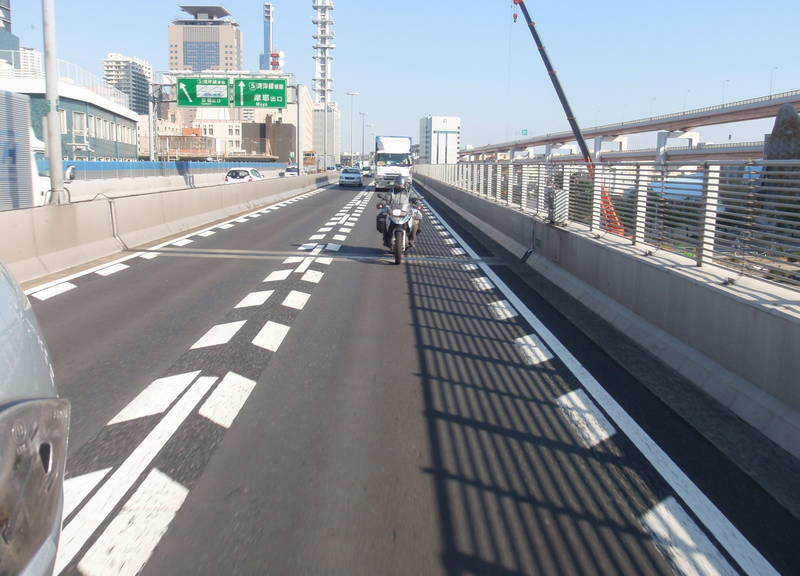
Our 3:30 PM arrival time in Himeji gave us just enough time to get over to the castle before last entry at 4:00. This is one of only 4 original wooden castles in Japan and it is the biggest. We knew before arriving that renovations were underway, so we weren't too disappointed that we could not actually see the castle. When renovating a castle in Japan, they don't just put scaffolding up. They build another castle all around it. At least that's what it looked like. The structure protecting the castle during renovations totally covered the whole thing, with big rooms and elevators and displays. So, it was a unique experience to be able to ride up in an elevator beside the castle and then look down on the roof of the castle. The displays explained how sand, seaweed and hemp were used in the clay to help fit the roof tiles together. The colours of the setting sun on the castle were just beautiful. For supper, we ordered our meal from a machine that had only Kanji symbols to identify the dishes. Good thing there were pictures of food up on a menu board, so we then compared the symbol to the dish we wanted, put money in the machine, and pressed what we hoped was the Soba noodle button. We then took to the ticket over to the staff behind the counter and they prepared our dinner. It is a very efficient way to order food if one knows Kanji, the Japanese writing system. Fortunately again, helpful and friendly staff made sure we had the food we wanted.
Himeji-jo undergoing renovation under covers
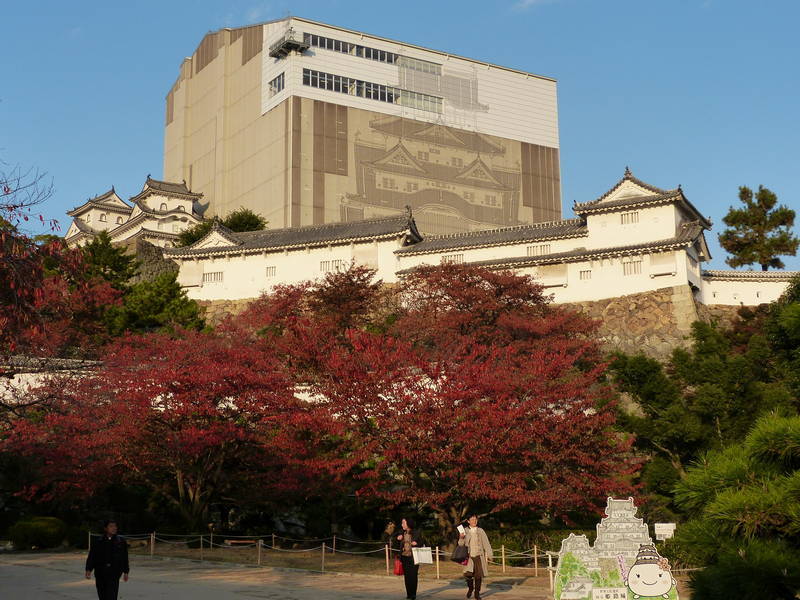
An elevator whisked us to the top for a lovely view over the city and to observe the roof restoration work
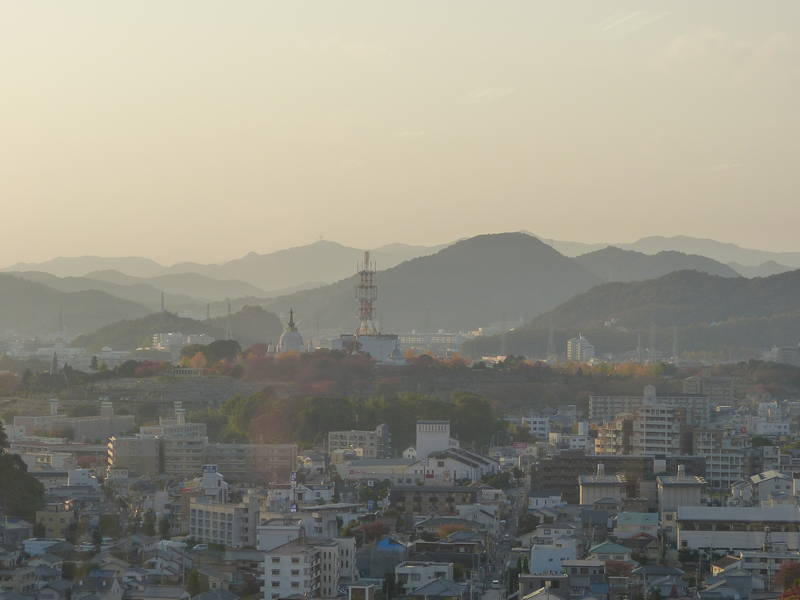
A video shows how the restoration work is done
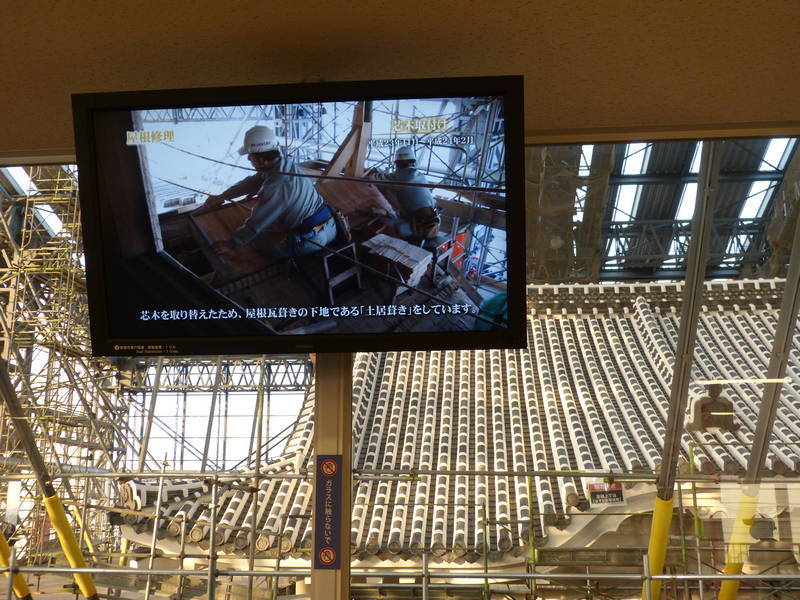
The roof ornaments are almost 2 metres tall
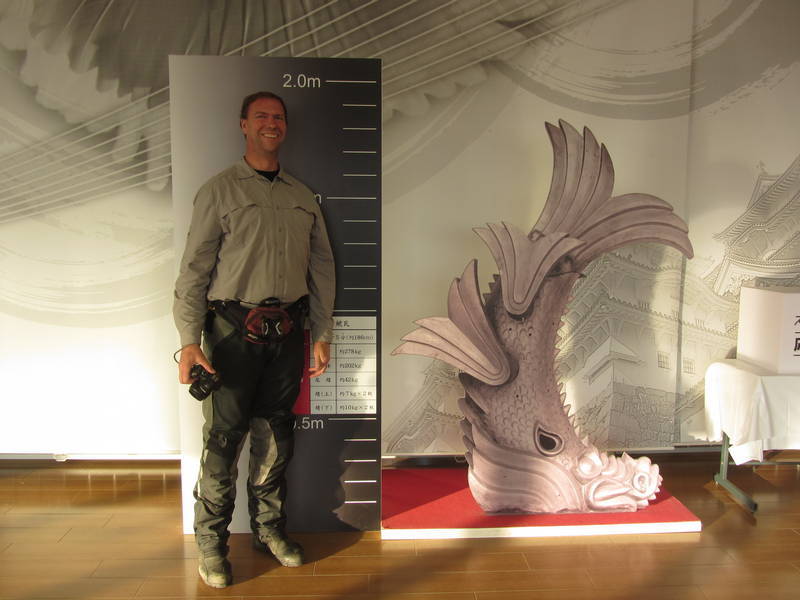
The restoration follows the original construction methods exactly

The setting sun shows how beautiful the castle will be when it's restored. We're coming back in 2015.

OK, look at pictures above the counter, memorise the kanji characters for the one you want and go to the machine

Match the kanji characters with your choice, insert money and then hand the ticket to the counter person

We checked out of our Toyoko Inn on November 13th and decided to try the regular highways. It was surprising how well traffic moved along, especially since it was a coastal road. All things maritime, like fishing boats and docks, were to our left as we manoeuvered our way along the twisty roads. An early afternoon arrival in Hiroshima was great as we then had time to catch the ferry to Miyajima Island and have a look at the Floating Torii gate at low tide. This shrine is part of the Itsukukushima-jinja temple complex and it looked amazing out there in the water. The tide was just starting to come in, so having Gore-Tex lined boots was a great advantage. Others who were trying to walk to the shrine on the wet sand, in stilettos, were finding it a little more challenging. The place was just crawling with tourists as well as groups of schoolchildren who weren't minding their teachers' instructions to avoid the incoming sea water. We decided to go in search of camping and have a closer look at the rest of the temple the next day. A ride up a twisty road took us to a huge recreational area with a park chock-a-block with wild deer. There was a reception building, but it was closed, so we just found the campground and set up the tent. A couple of young guys were there, also setting up a tent, so it was nice to know we were not alone. There was a shelter with a sink and table so we bought some supplies and cooked dinner. It was absolutely pitch dark when we heard a shuffling noise behind us. Our headlamp revealed a deer. Phew. But then our headlamps revealed another pair of eyes, these much lower to the ground. It was the strangest creature and clearly, it was just visiting us to see if it could snatch some of our food. This animal looked very familiar to me and I racked my brain to try to remember where I had seen it before. It looked like a cross between a dog and a raccoon. And then it came to me - a marderhund. I had seen one in Bielefeld, Germany, in a small zoo, in 2003. (Click here to see the 2003 visit to Bielefeld) Later, Ekke dug up a photo of that encounter, and the information about the animal indeed said that it was found in Southeast Asia. We kept shooing the little guy away from our dinner, and it eventually went away.
Lovely coastal road as we leave Himeji
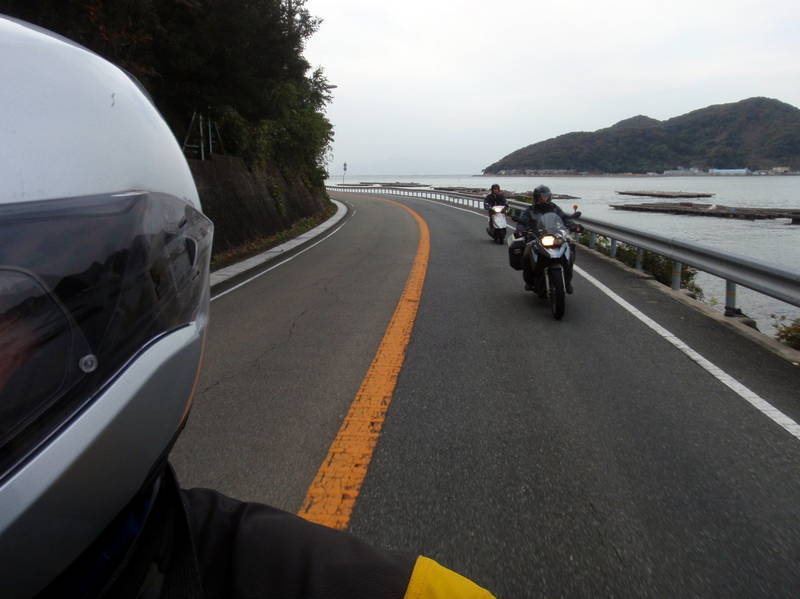
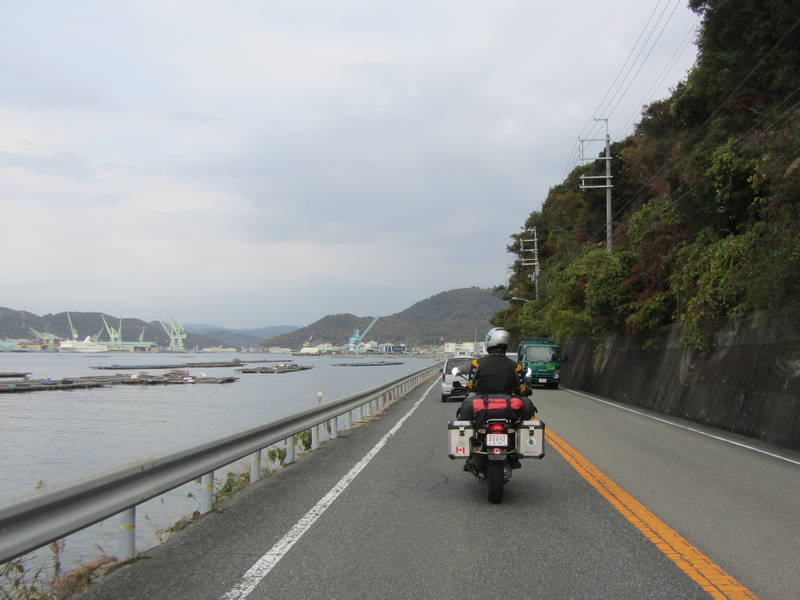

Nice warning sign. Should we put on the rain gear now?
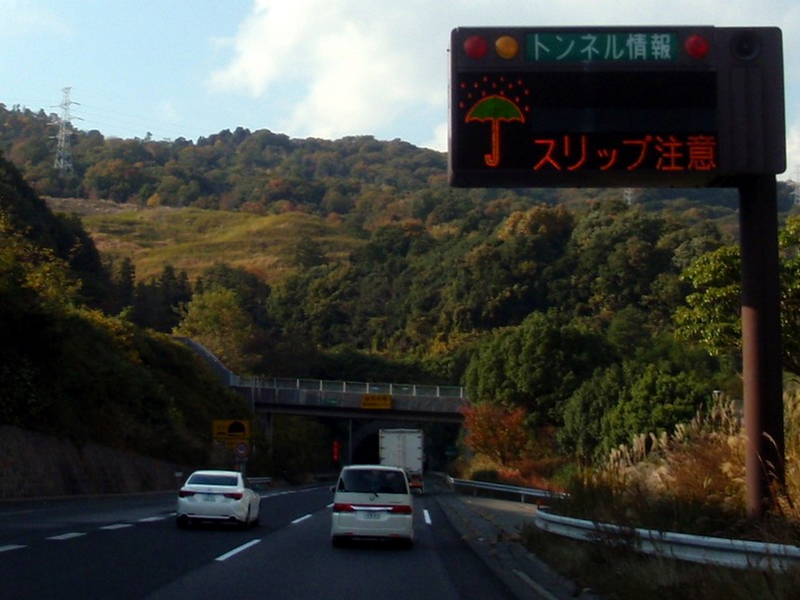
The Floating Torii as seen from the ferry to Miyajima, lots of people while the tide is out

Riding through town to park the bikes near the floating gate, don't run over the ubiquitous deer
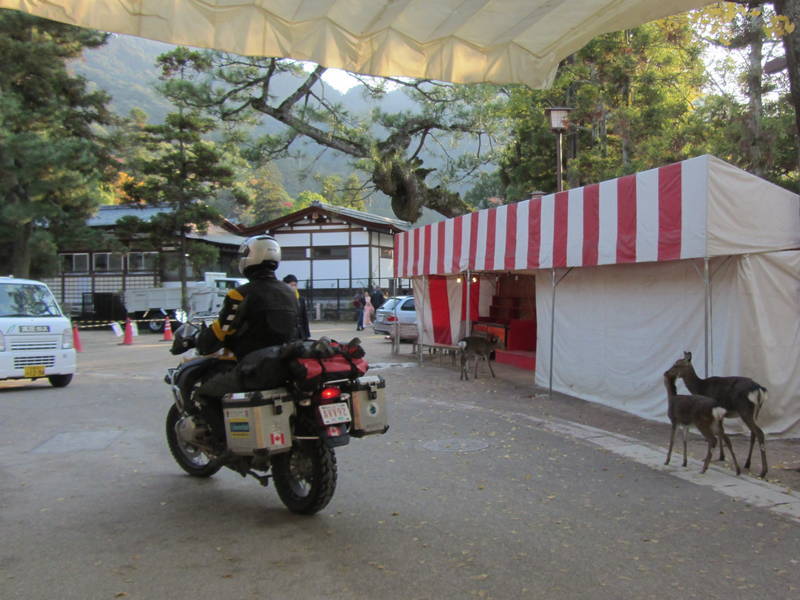
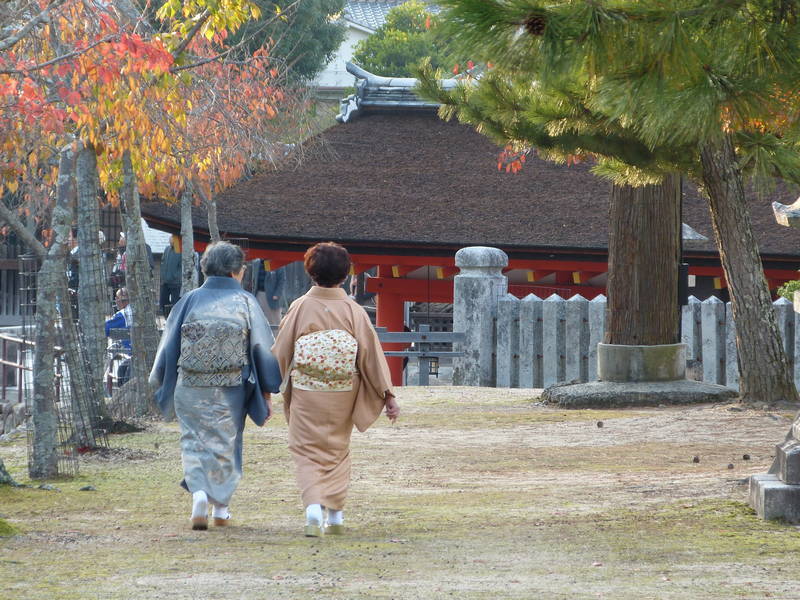
The tide is coming in

Fun tourist activities around the temple grounds

Tide is out
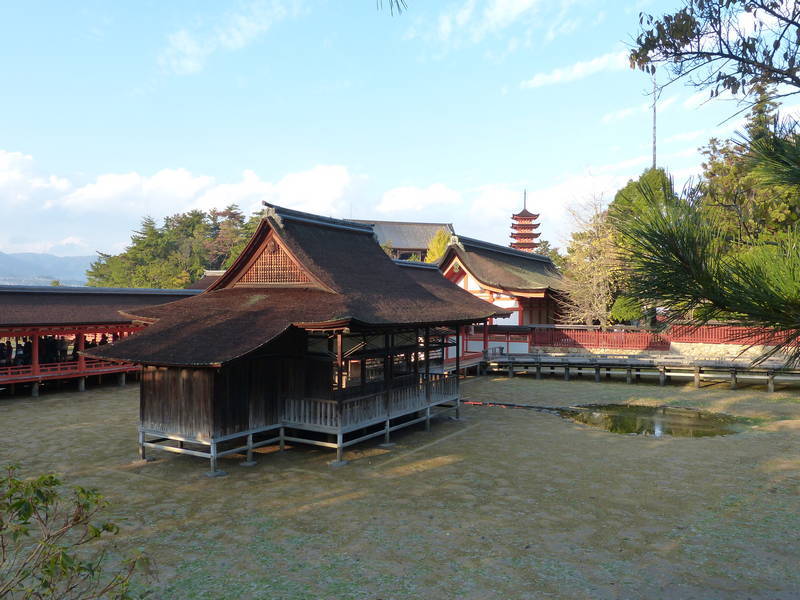
Riding to the campground on Miyajima
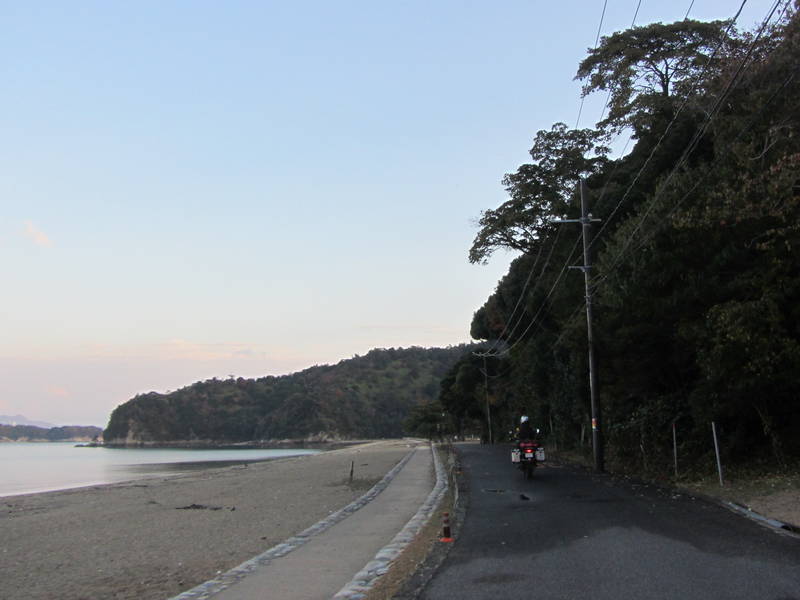
A deer watches Ekke prepare dinner

A Marderhund (?!?) shows up to check out dinner

The marderhund and deer confir on the best strategy to obtain a delicious morsel
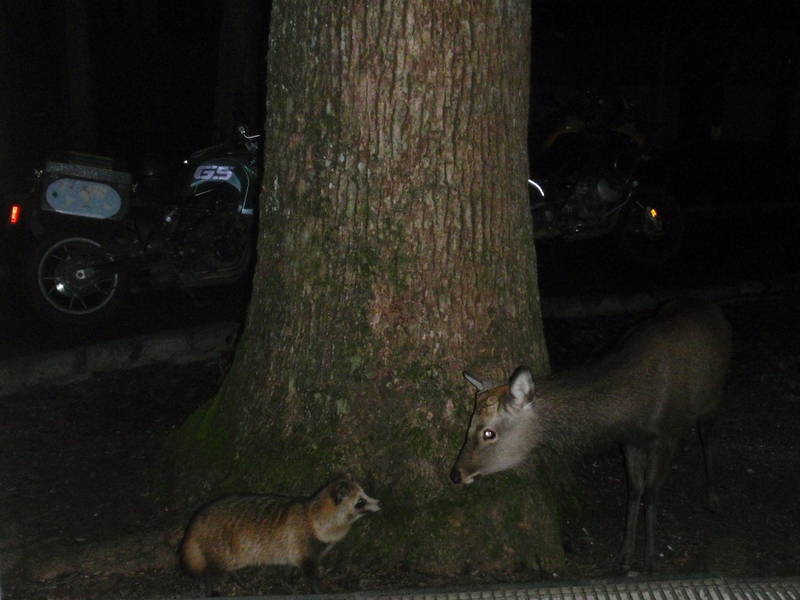
The next day we left the campground in time to see the Floating Torii when the tide was in and also to have another look at the Itsukukushima-jinja. The temples were built on stilts to allow for the incoming seawater and there were boardwalks connecting everything. The Floating Torii looked like it was out in the middle of the sea. A couple from Los Angeles, Akiko and Ken, kindly took our photo for us with the gate and we chatted a while about our trip. Then it was time to catch the ferry back and into the city of Hiroshima. Being too early to check into a hotel, we went straight to the Hiroshima Memorial Peace Park. Free parking is always high on our list of priorities so we rode around and eventually asked an attendant where we could park. He pointed left, to a small pathway, which took us toward a big open space in front of a fountain. Perfect. The bikes looked very good there. The fact that there were no other motorcycles parked there did not deter us from assuming this was the parking place. Later we found out that we were parked right in front of the Peace Fountain. We hoped that people who wanted to take pictures of it didn't mind having a couple of motorcycles with Alberta licence plates in their photos.
Before breaking camp and heading to the other side of the island
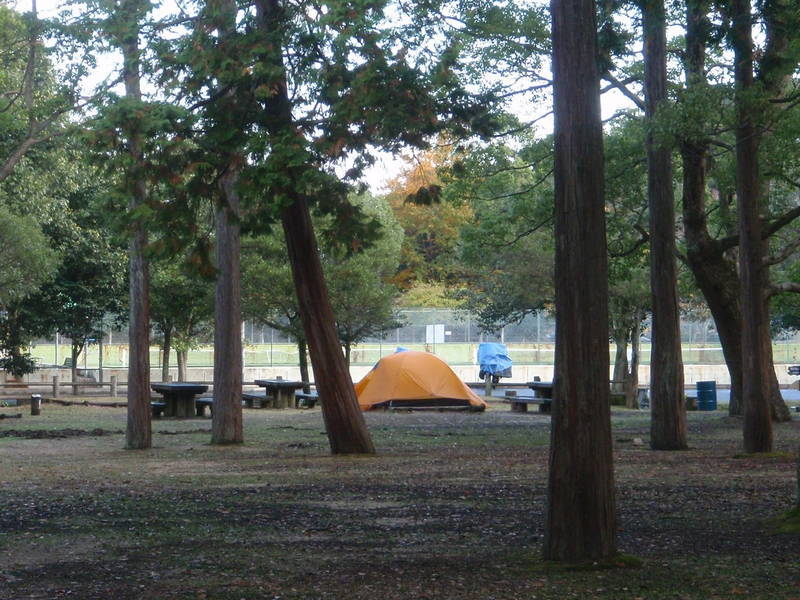
How are we ever going to find our bikes amongst all the other bikes in the parking lot when we come back?
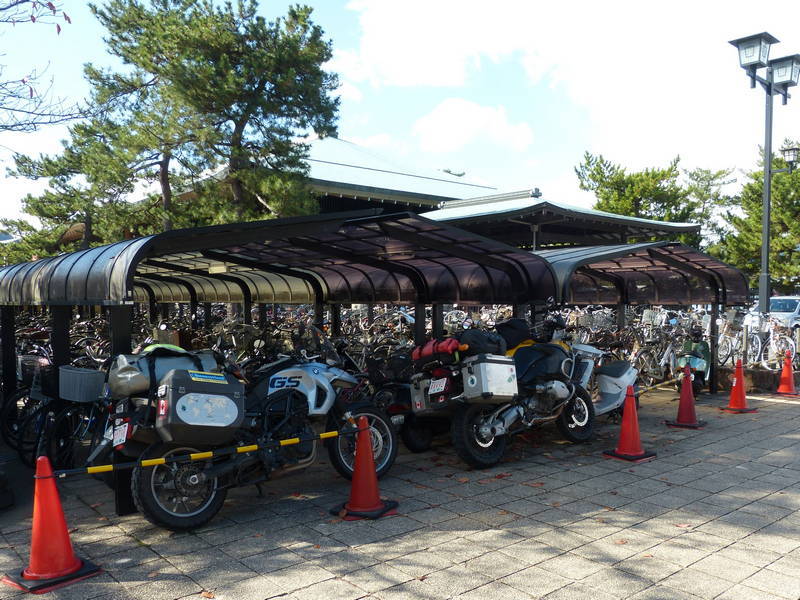
Tide is in
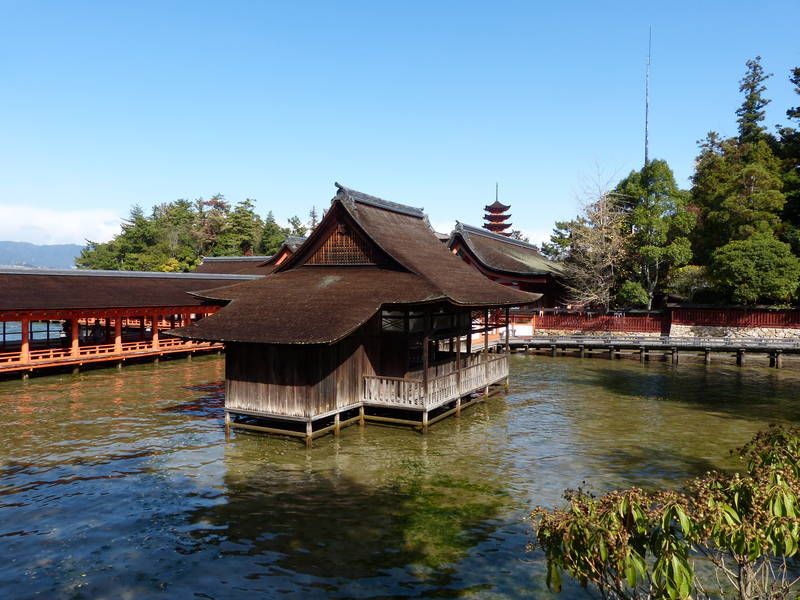
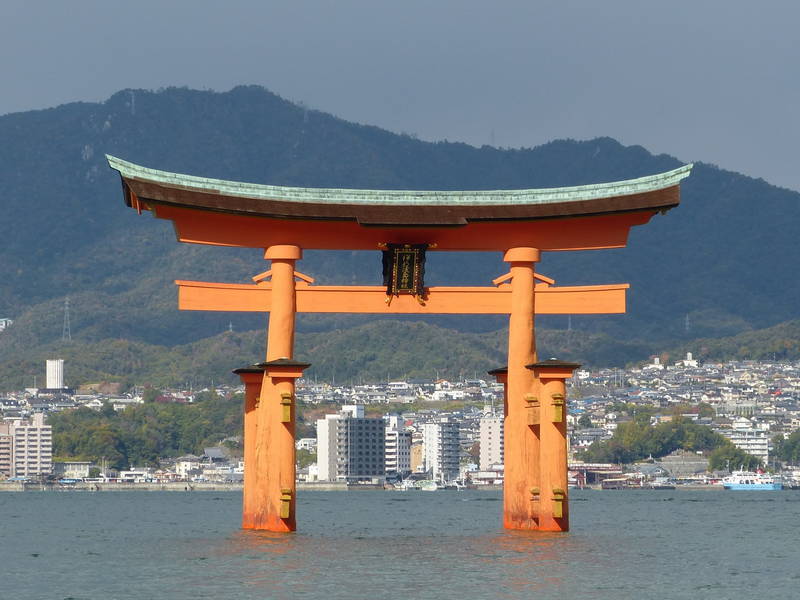
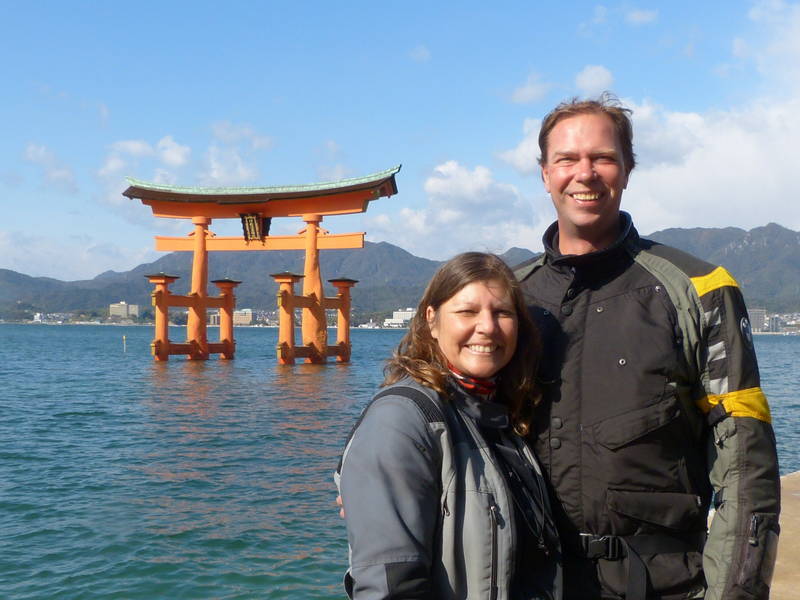
Beautiful rainbow ends in Hiroshima as we take the ferry back from Miyajima
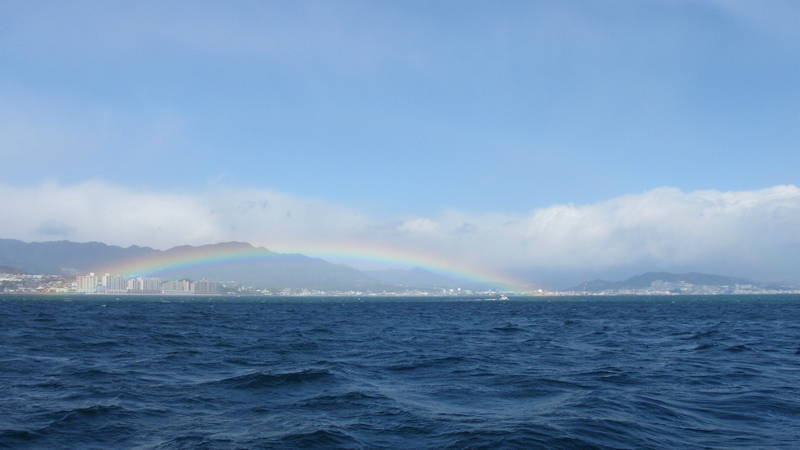
Nothing says "Merry Christmas" like a little tree by the remote control for the toilet

Parking at the Peace Park in Hiroshima (unbeknownst to us the fountain would be turned on later to soak the bikes)
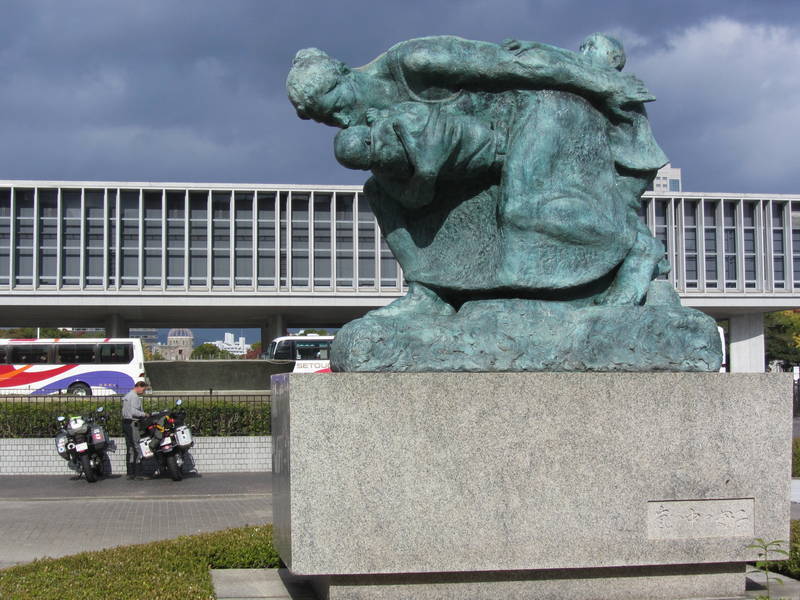
The Peace Park was built on the open space left by the devastation of the bomb, a huge area that used to be the busy commercial and residential part of the city of Hiroshima. There were over 50 memorials in the Peace Park. We stopped at the memorial to school teachers and students first. When the atomic bomb was dropped on August 6th, 1945, a lot of school kids were right at ground zero. They were on a temporary assignment to help the war effort by demolishing buildings to make a fire break. This was a memorial to all those who perished. In the centre of the park was the Memorial Cenotaph, an arched structure containing the names of all who died, 135 000 people by the end of 1945. Further along was a children's monument, a statue of Sadako Sasaki. The story of the young girl who died of leukemia a few years after the bomb dropped is told in a well-known children's book, Sadako and the 1000 Paper Cranes. Sadako hoped that if she made 1000 origami cranes, she would be cured. In front of a statue to honour her and all children who died, a school group was singing and playing recorders, surrounded by thousands of paper cranes sent in by children all over the world. It was extremely touching.
Monument Dedicated to the Atomic Bombed Teachers and Students of National Elementary Schools
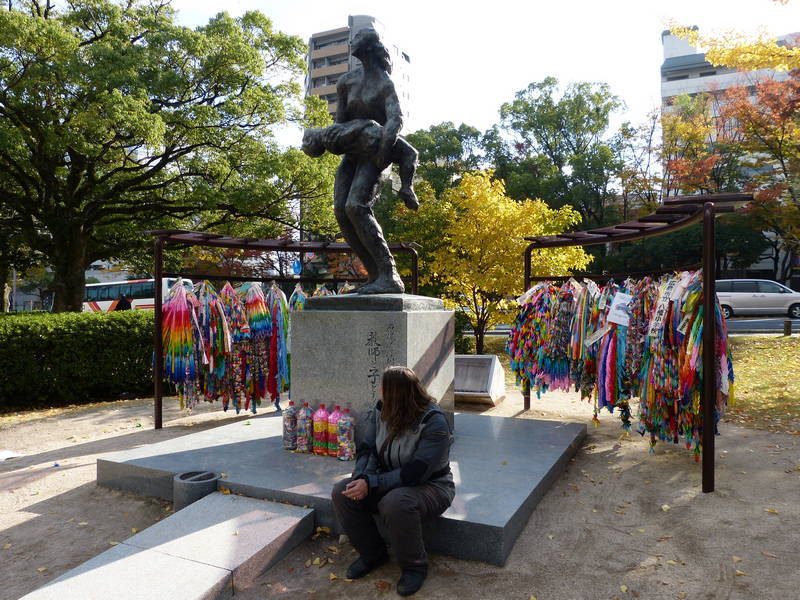
Memorial Cenotaph for the A-Bomb Victims
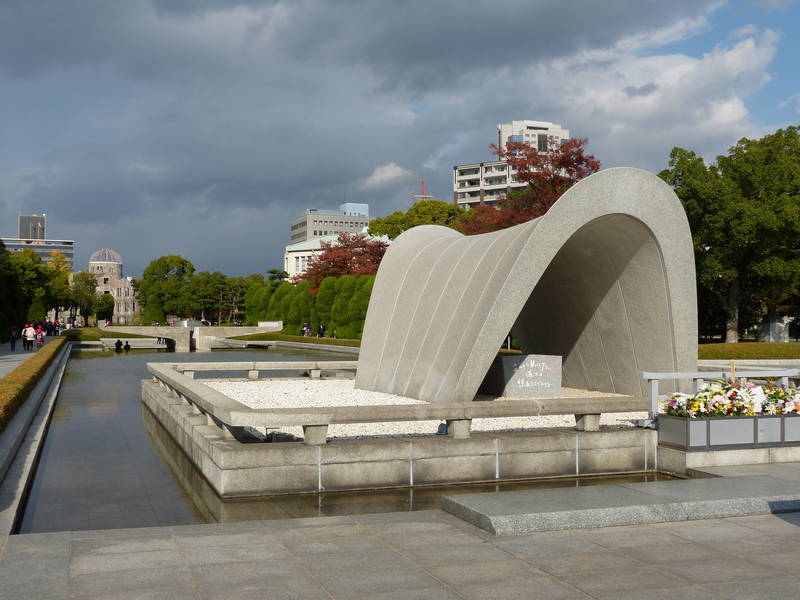
Some of the thousands of origami cranes at Sadako Sasaki's statue

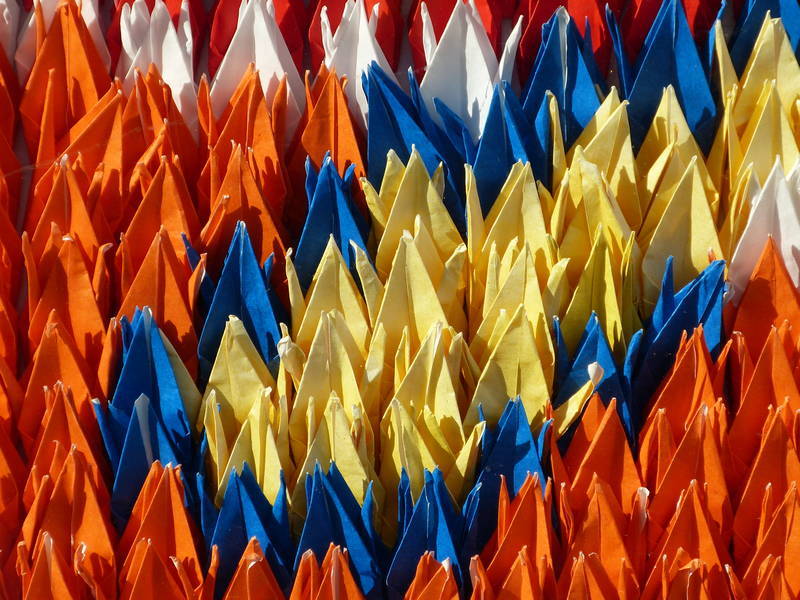
As we walked around the park, a group of school kids approached us and introduced themselves. They were doing a class project and asked us where we were from and what peace meant to us. We happily gave up some time to help them. Their teacher said they were using the survey to get peoples' opinions about the Peace Park and to practise their English. Another group approached us, introduced themselves and asked us the same questions. Then there was another group and a group after that. After about ten groups of kids, we finally had to start avoiding them in order to get to our next destination. So we just put our heads down and walked towards the A-Bomb Dome monument, a bombed office building where everyone inside had perished. All that remained standing was a shell of the former building and it was left standing as a reminder of the events of that day and was added to the UNESCO World Heritage List in 1996. At the below-ground National Peace Memorial Hall we saw books and video with stories of how people had to leave others behind in burning buildings. Artefacts on display, like a little scorched lunchbox, a pair of shoes and watch stopped at the exact moment the bomb exploded were very touching. We spent hours at the Hiroshima Peace Memorial Museum, reading about the events of the day the bomb was dropped. A model of the part of Hiroshima that was hit showing before and after the bomb really highlighted the instantaneous destruction that it endured. On display were copies of hundreds of letters from the various mayors of Hiroshima to leaders of countries all over the world, imploring them to ban nuclear weapons whenever there was evidence that that country was doing nuclear weapons testing. The most recent letter from the current mayor of Hiroshima to President Obama was only a couple of months old. Dioramas showing people in the midst of it all really brought home the immediate impact of the blast. The museum was really well done, with explanations of the decision-making process to drop the bomb. But it was hard to get my head around the whole thing. One point that was emphasized is that all countries involved had to take responsibility for what had happened, including Japan. And with all the visitors to the Peace Park who were learning about the devastating consequences of nuclear war, there was a sense of hope that it will never happen again.
Answering a survey with a group of school kids in the Peace Park

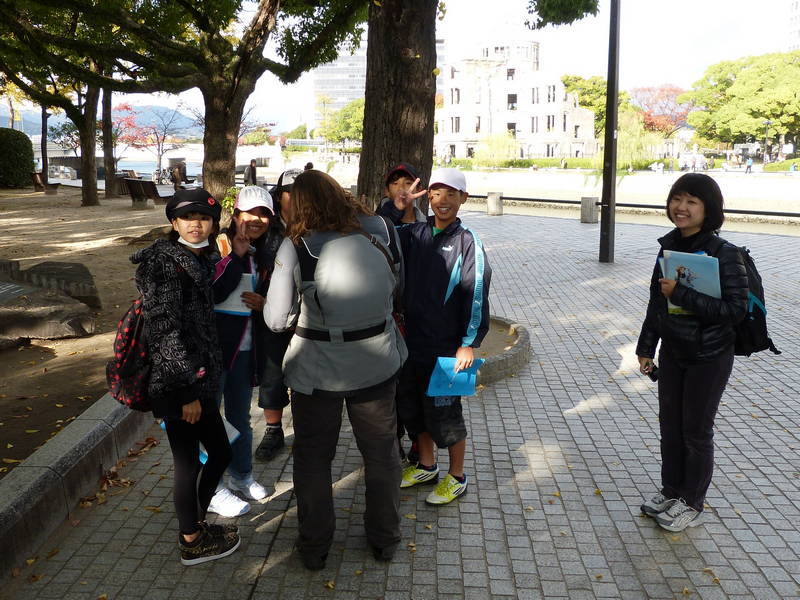
The Hiroshima Prefectural Industrial Promotion Hall was near the epicentre yet stood while everything else was vapourised
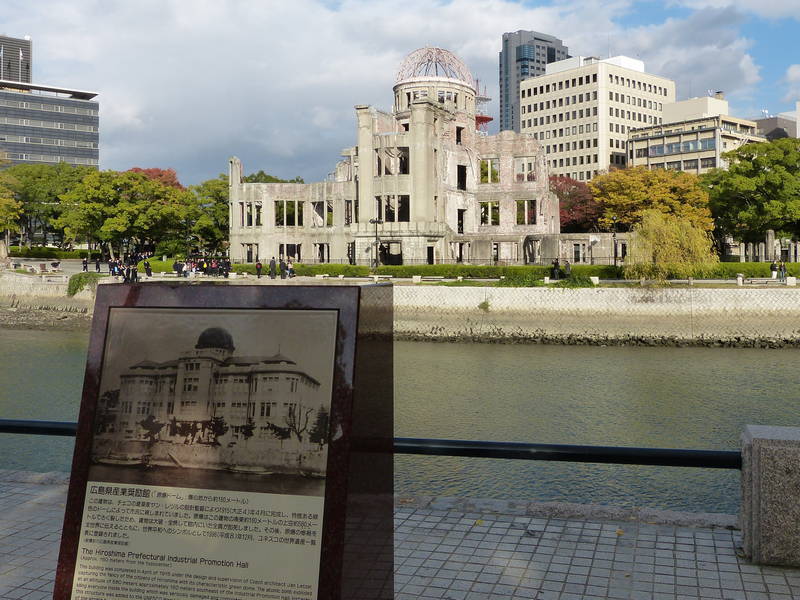
Screens scrolled with names and photos of those killed in the atomic blast, thousands and thousands
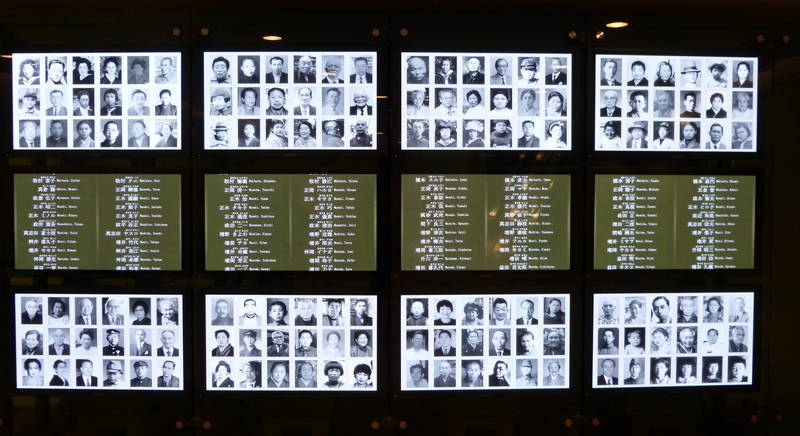
Personal artefacts like this lunch box were deeply moving

A watch stopped at the instant the nuclear bomb exploded over Hiroshima
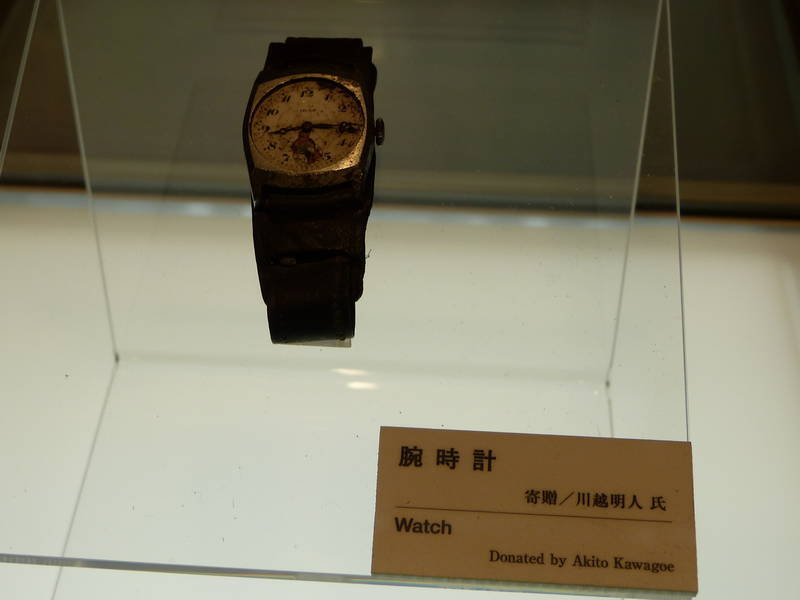
Ekke writes:
It was clear and cool as we left the city of Hiroshima on Thursday, November 15, tears still in our eyes after the previous afternoon's emotional visit to the Peace Park. After about 10 kilometres of riding it started to spit rain and we pulled into a bakery parking lot to don our wet weather gear. Surprisingly (if you know us) we didn't go into the bakery but continued up into the hills north of Hiroshima, protected from the elements. Still, we had to stop and warm up a bit as it was quite chilly on the ride to the UNESCO World Heritage site of the Iwami Ginzan Silver Mine Site. We parked our bikes near the edge of the old town, where a 3-D model showed the town and surrounding area and then we strolled into town. We were glad that the rain had stopped but the chill meant that our motorcycle gear was comfortable to wear. After a delicious pasta lunch at Roomin' Restaurant we went into an old home that had been turned into a museum. The Kumagai Residence, erected in 1801, had been home to one of the main silver merchants in the town's heyday from the end of the Edo period through to the Meiji period. What we found especially appealing was that the home was furnished, allowing us to really appreciate how their lives were lived. In addition there were museum displays of everything from clothing to sake sets. This was one of the best "museums" we visited in Japan. By 4:00 PM we were back at the bikes and still had to cover about 100 kilometres to get to Yonago and the comfort of the Toyoko Inn. While it was dark for the last hour of the journey we had made pretty good time on the expressway and had covered about 220 kilometres for the day.
Heading north from Hiroshima into the hills for a damp ride
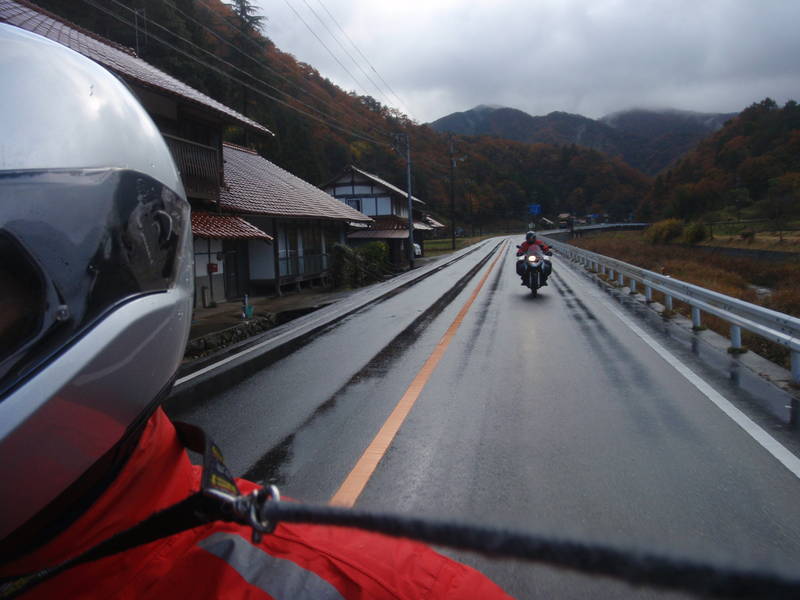
Walking around the Iwami Ginzan silver mining town


The drinks with blue buttons are cold and the red buttons have hot drinks. A hot coffee or tea anyone?

The Kumagai Residence
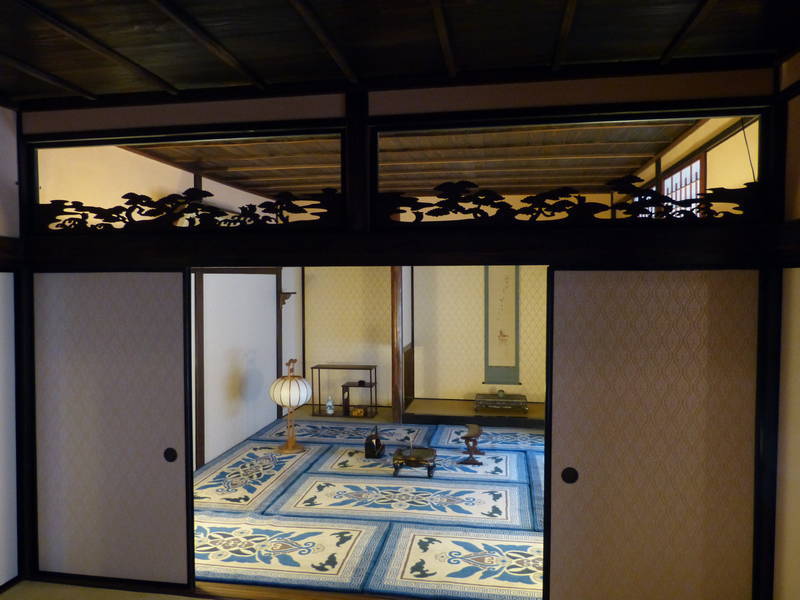
The Japanese were tiny back in the day
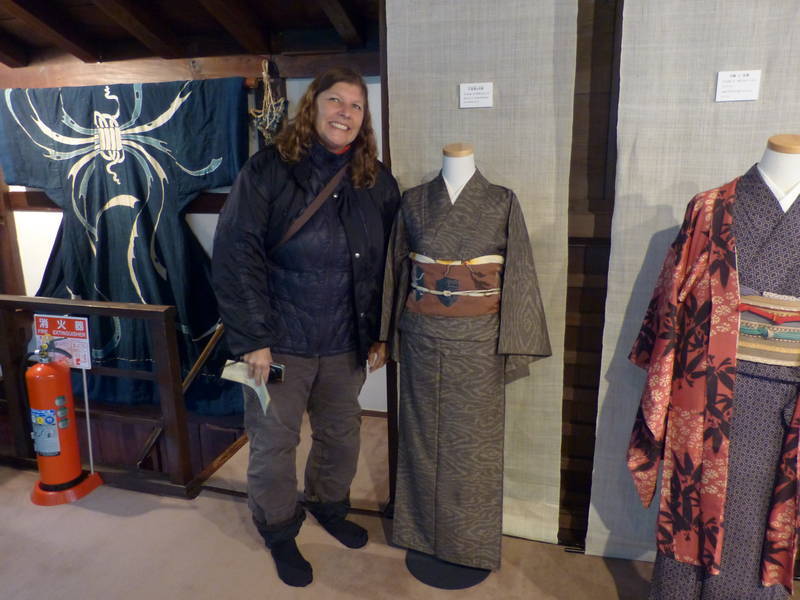
A dining room adjacent to the kitchen
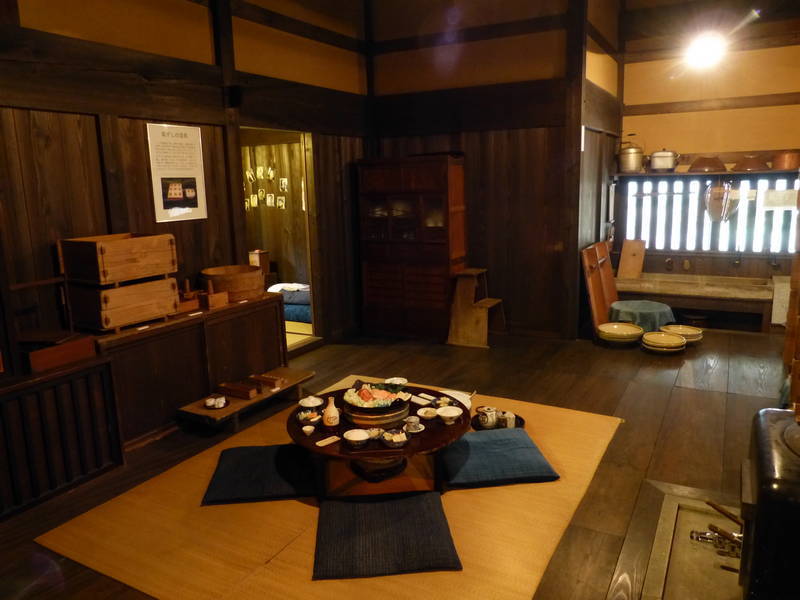
As we rode along the north coast of Japan on Friday we noticed that the water of the Sea of Japan seemed much wilder than on the Pacific coast side of the country. The surf was really crashing and we took the opportunity at a rest area to sit on the beach with a picnic lunch from a nearby Lawson Station convenience store. In the meantime we laid the tent out in the parking lot near the bikes so that it could dry out from our camping at Miyajima. The chain on the F650 seemed a bit loose so I adjusted that while Audrey corralled our tent as the wind tried to take it away. Back on the road we rode west, paralleling the coast, but without the benefit of an expressway it was slow going. To add some interest to the ride we came upon a rather puzzling sight. Sprinklers were pouring water out onto the road. At first we thought it was a water main break or something but upon closer inspection there were nozzles set alongside the road and on the centreline spraying water. At least we hoped it was simply water and not some chemical that would damage our clothing. There were a few locations where this was occurring and it seemed that mostly it was on hills. Eventually I came up with a theory but I have never verified it. I'll let you, dear reader, puzzle on it as well and give you my theory at the end of the chapter. E-mail me if you have an answer: ekke61@hotmail.com. With this puzzle rattling around in our heads (mine anyway) we kept going west towards Tsuruga where a nice hot Toyoko Inn shower awaited us after a 320 kilometre day.
Leaving Yogano and riding towards Mt. Yahazugasen
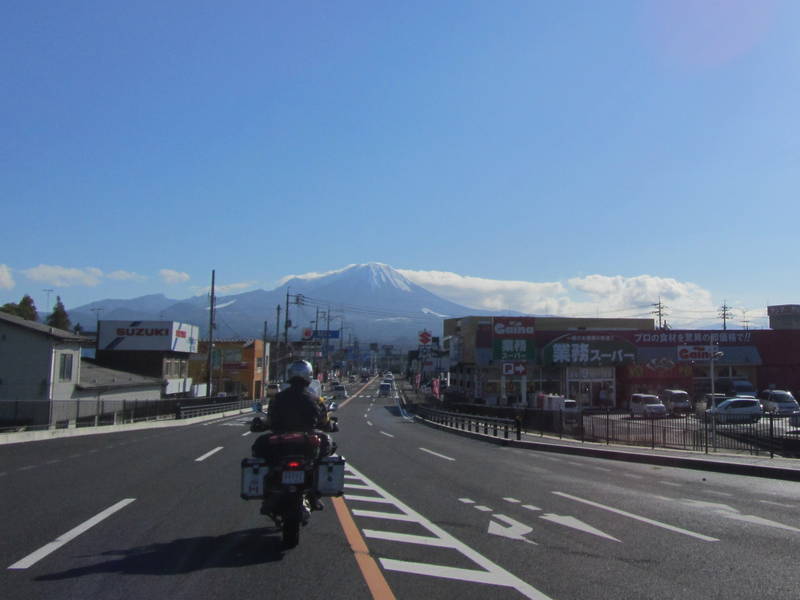
The wild coast on the Sea of Japan
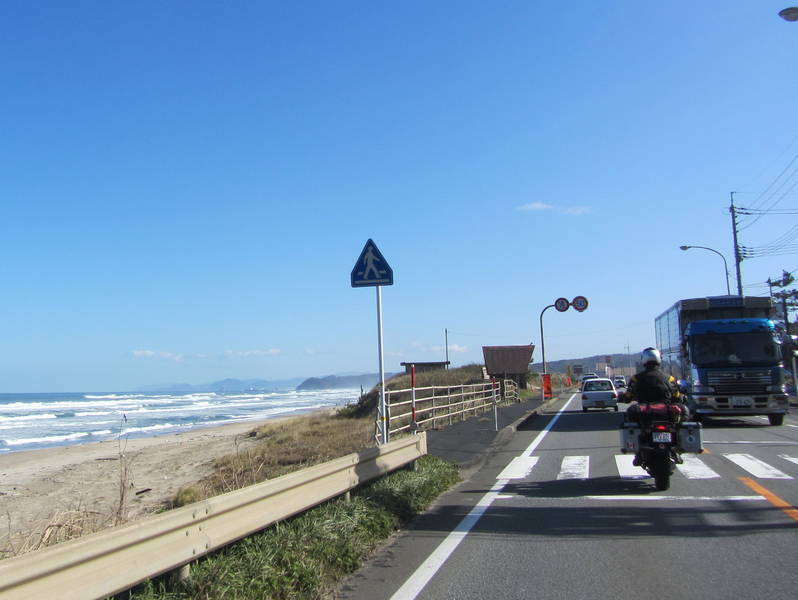
You won't find a sack of tentacles in a convenience store back in Canada
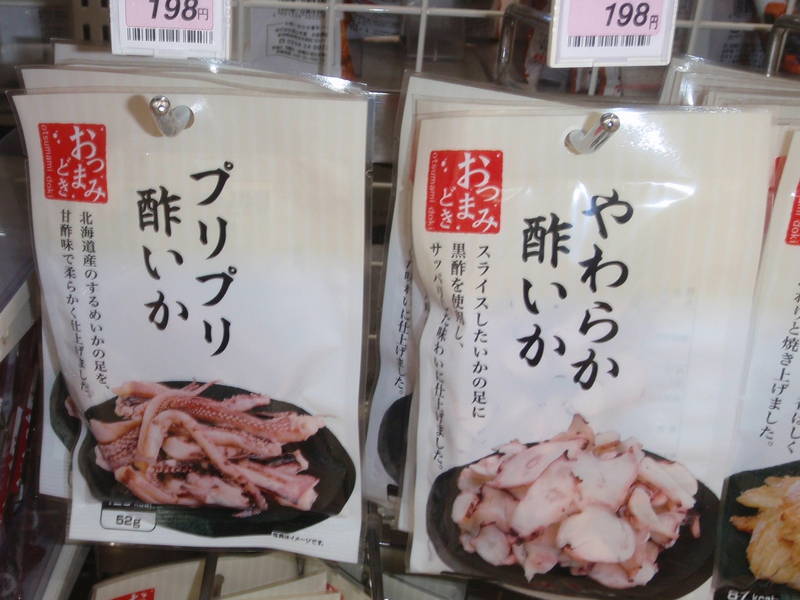
Delicious milk tea despite the name
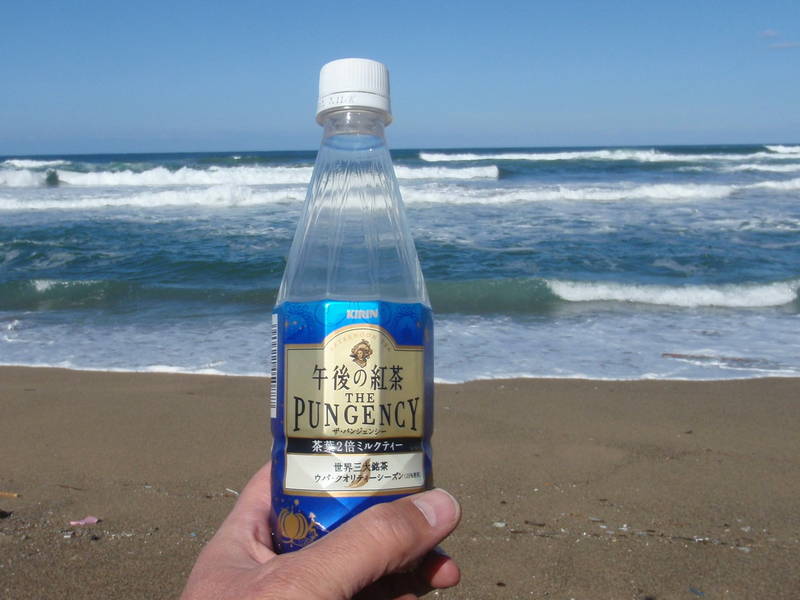
Some well-deserved beach time
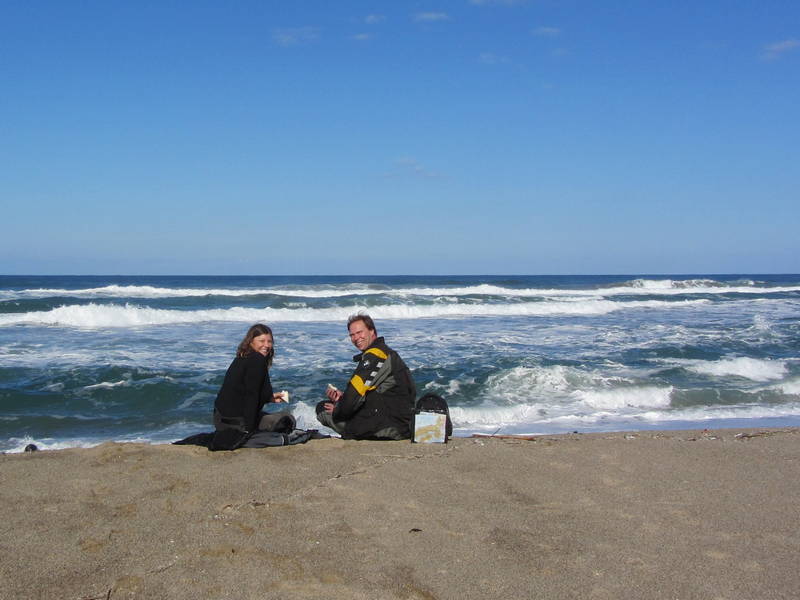
What the heck?!? What are they spraying on the road? And why?
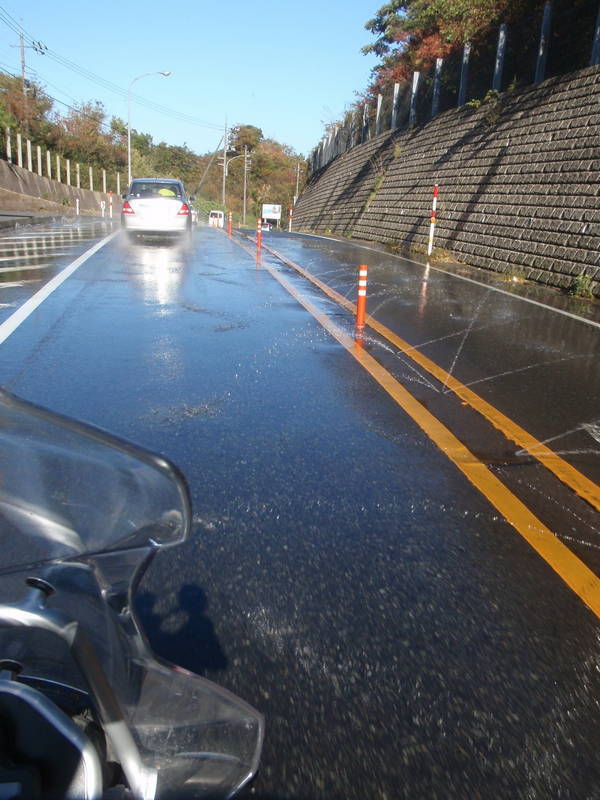
We hadn't done much research for things to see on our route back to Tokyo as we were quite focussed on making sure we got there in time to deliver the bikes to the port in Yokohama. So when we packed up on Saturday morning and plotted our route to Anjo (where we had stayed on the way to Kyoto a week and half before)we were pleasantly surprised to see that Hikone Castle was only a few kilometres off our route. Hikone-jo is only one of four castles listed as a National Treasure of Japan and the most significant historical building in Shiga Prefecture so it was quite a fortuitous find on the map. It rained all the way to Hikone and as we parked the bikes it seemed to rain even harder so we stored our gear on the bikes and then put the bike covers on, in the hopes that they would keep our stuff at least a little drier. We first walked through the adjacent museum before climbing the steps up to Hikone-jo under the cover of our umbrellas. The building must be beautiful in sunshine because even on this cloudy and rainy day the tower was quite spectacular, especially with some of the trees in the courtyard having changed into their fall colours. Inside wasn't as nice as some other castles we had seen but it did have that air of authenticity that only comes with being an original, unrestored building. The rain had intensified as we toured the castle and when we came back to the bikes we had to struggle into our waterproofs in the shelter of a nearby building in order to avoid drowning in the deluge. The bikes seemed to handle the inclement weather better than we did as they plowed resolutely through standing water on the expressway and we slowly became wetter and wetter under the raingear. The water always seems to find a way inside, no matter how cleverly we think we are dressing. For me the water was being soaked up by my bandana and then through the magic of wicking action transferred to my shirt. At the Toyoko Inn in Anjo they had washers and dryers so at least we had an opportunity to dry everything out. We set the dryers and then walked over to the same Italian buffet restaurant we had visited last time. They had changed their menu structure a little and now it was all-you-can-eat pizza available right on the buffet. Woo hoo! The feeding frenzy was topped off with the best dessert imaginable: a self-serve soft ice cream machine.
The entrance bridge to Hikone-jo
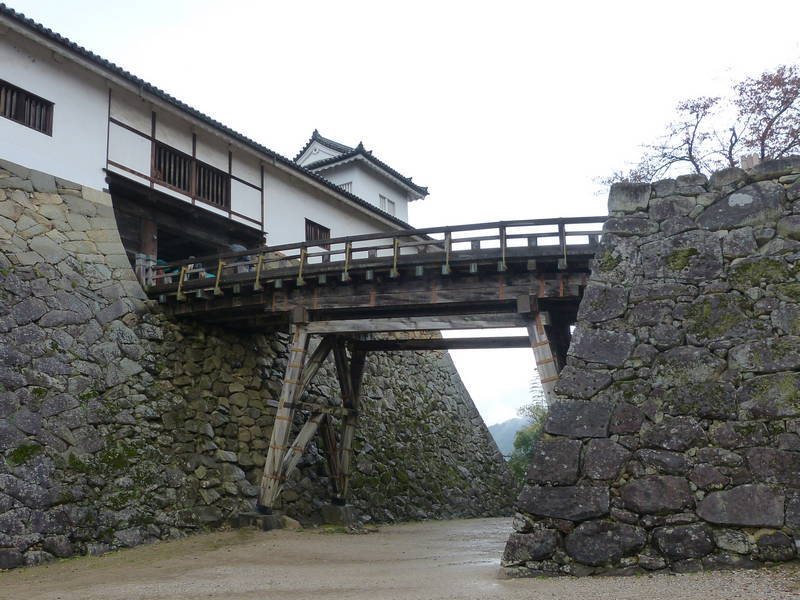
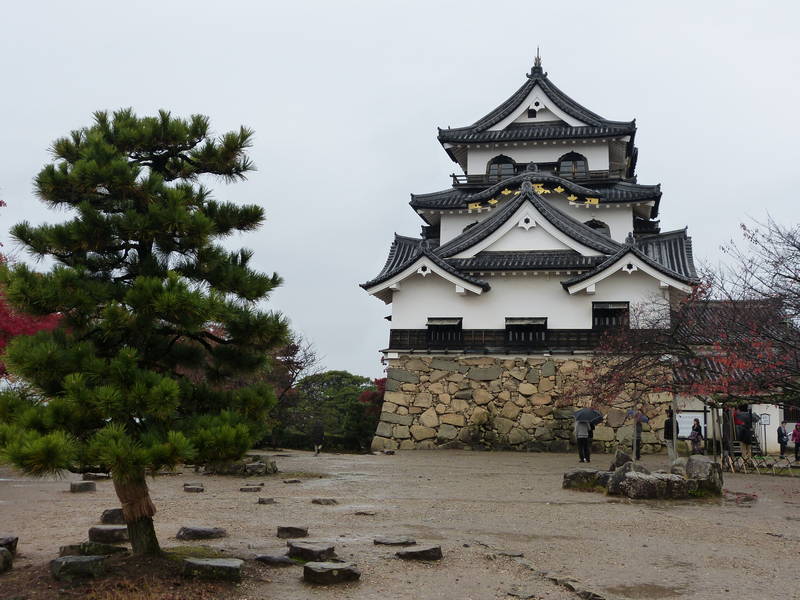
View from the top of the castle; rain and mist

On the way to the expressway from the Toyoko Inn in Anjo we stopped off at a motorcycle shop called Red Baron. They're a huge chain in Japan, specialising in selling used motorcycles, where I thought it would be cool to get a T-shirt. No T-shirts but the selection of older Japanese motorcycles was fantastic. Who knew that Suzuki made a classic early eighties Katana in a 250cc size? If you're interested in bringing a classic Japanese bike to Canada you can check out their website: www.redbaron.co.jp. Then, once on the Tomei Expressway we headed for Tokyo and Otosan's apartment in Saitama. While at a break at a Circle K convenience store I spotted a nice synthetic T-shirt and then had an animated conversation with the clerk who tried to describe what the Kanji characters said on the shirt. "I fight for love" was OK so I put the shirt on the counter with our other items. After paying and then going out for our coffee break by the bikes I had a look at the receipt and found that the clerk hadn't charged me for the shirt, it was a gift. Once again, we felt humbled to be in Japan, the people were so generous and friendly. Back on the expressway we knocked off another hundred kilometres and stopped for lunch at a rest area near Mount Fuji. Just as before, we were very lucky to see the top of the mountain. A lot of Sunday riders were returning from their weekend rides and the parking lot had many groups of bikes parked, with everyone trying to get a shot of the mountain and their bike. Near Tokyo traffic started to slow down and then stopped altogether so we joined the other motorcyclists and started to cut between the lanes of slow moving or stopped cars. In the eleven kilometres of the traffic jam we passed three Lamborghinis. Visions of a scuffed VW Passat in China were still lingering in my head as I tiptoed the wide Adventure by the hyper-expensive automobiles. We had a clear run to Tokyo after the jam and then once past the Tomei expressway toll booth, the road went down a spiral ramp. It was like entering the gates of hell as the lower we went the hotter it got. It was 13 degrees outside but in the tunnel the temperature was 30 degrees. It felt like we were on the Tokyo Metro system in the long tunnel. Navigation became a little more problematic as well since the GPS stopped getting the satellite signals underground. So it was more by luck than by skill that we took the correct exit and emerged back into the chilly evening some 13 kilometres after we had entered the tunnel. Once the GPS was back online it was a straightforward ride to Otosan's apartment where he made us a delicious pot of minestrone soup for dinner.
The weather has cleared up but all the rain of the previous day has Ekke thinking of a motorhome
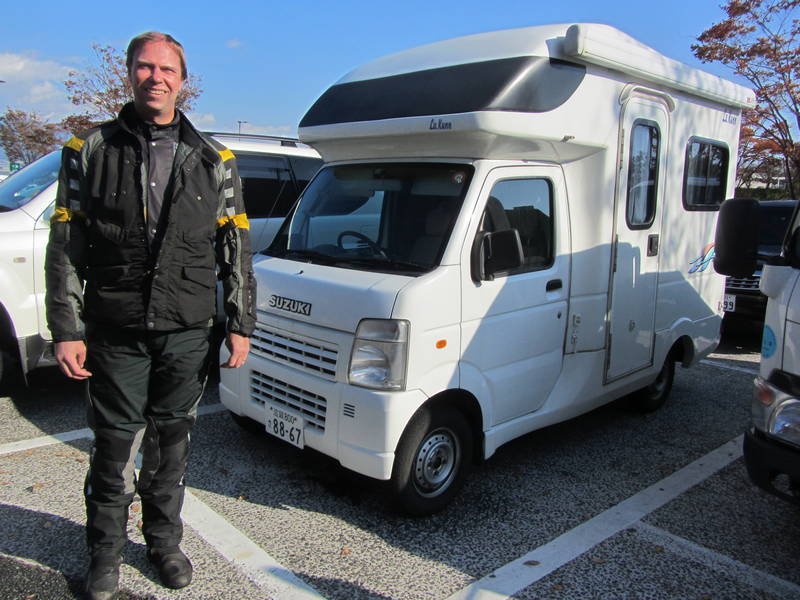
Ekke shows our journey so far on the map on Audrey's bike to a busload of tourists

You have got to love the electronic toilet information screen at this rest area

On Monday we popped over to Motorrad Central to have new front tires installed. While the front tires still had lots of tread on them they had over 23,000 kilometres on them and were starting to cup a bit. Also, we weren't sure if we could source the Heidenaus in S.E. Asia so we opted to get them before dropping the bikes off at the port in Yokohama. We waited in their showroom, enjoying a nice cup of coffee while they installed and balanced the tires. Back at Mr. Noguchi's apartment we arrived in time to watch sumo wrestling on TV from our former "home town" of Fukuoka. It would have been fantastic to watch this event live but it was prohibitively expensive to jump on the Shinkansen to pop back down for a day or two. Plus we had to get our bikes to the port this week. On Tuesday we received a note from Motorrad Central saying that Audrey's chain was almost worn out and should be replaced soon. Why they didn't replace it while the bike was in the shop for the tires was a bit of a mystery. So I hopped on the F650 and went to a nearby motorcycle shop to purchase a chain. As soon as I rode away I could tell that the steering head bearings were notchy again even though they were virtually brand new, having been installed less than a month and 4,000 kilometres ago by Motorrad Central. As Motorrad Central was closed on Tuesdays and the bikes needed to be at the port on Wednesday there was no opportunity for them to rectify their mistake. When I returned from buying the chain I e-mailed Motorrad Central and told them of the problem, hoping that they could formulate some solution to repairing the bike. Later we met Takahiko (Otosan) and Shinichirou at the Omiya station and then walked over to a steak house for dinner. Shinichirou asked us if we wanted to come to one of his three dojos where he runs Aikido training, of course we did! A few blocks from the restaurant we entered the small building and watched the end of a lesson as the students were leaving. Another lesson started and Shinichirou helped the other instructor out with some lessons. He then asked us to participate, showing how much more powerful we were when we were relaxed and flexible as opposed to tense and rigid.
On Wednesday we left Saitama at about 8:30 and promptly got lodged in heavy commuter traffic, including on the expressway. Even splitting lanes it took us almost two and a half hours to ride the 70 kilometres to the Yokohama port warehouse. Omori Kazuhisa, the freight forwarder who arranged for us to get on the RORO to Singapore, didn't seem too upset when we showed up about an hour later than we had told him we were going to meet but maybe that was just typical Japanese politeness. After a brief inspection of the bikes to make sure that there was nothing inappropriate in the luggage (the saddlebags needed to be empty) we went to the customs office to stamp the carnet des passages out of Japan. This only took a few minutes and then we returned to the bikes to give them hug goodbye before Mr. Kazuhisa drove us to the JR train station. The cheeseburger at Freshness Burger was quite tasty and then we hopped on the direct train back to Omiya Station. This particular route took a little longer but had the advantage of not needing any transfers. Even the long way back on the train was an hour shorter than the motorcycle ride to the port and helps explain why public transport is so popular in Japan; it's faster than private transportation (Top Gear fans will know this is not true as Jeremy beat James and Richard in a race across Japan). Watching sumo on TV helped to ease the pain of losing our motorcycles for a month.
One last view of Mt. Fuji from the bikes as we ride the expressway to Yokohama

Goodbye to the bikes until Singapore
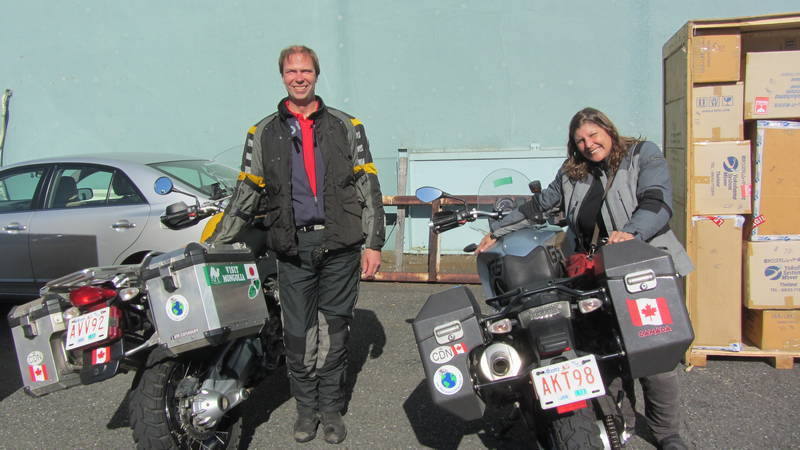
On the 22nd of November we took the train to Ueno station and then walked over to the Shitamachi Museum. The lower level of the museum had displays on life in the Shitamachi area as it was before the massive 1923 earthquake destroyed everything. The small wooden buildings had shops and living quarters all set up the way they would have been in the past. We had a wonderful tour guide explain the various exhibits. For example, the first exhibit was a shop set up to make and sell "geta" sandals, the Japanese raised clogs that look a little like flip-flops. Here the tour guide explained everything from construction methodologies to accounting procedures (with a primer on the abacus). I'm sure that we would have glanced at this display for a couple of minutes and moved on but now the fascinating and interactive discussion really brought the museum to life and we were completely absorbed. Upstairs was an exhibit on the earthquake itself. The 7.9 magnitude quake hit at Noon on September 1, 1923 so that most homes had fires going to make lunch. The destruction due to the earthquake was quite devastating but the ensuing fires, especially in the densely built up area of Shitamachi, levelled everything. 105,000 people died or were listed as missing while 370,000 homes were destroyed. Incomprehensible.
Shitamachi Museum with our tour guide providing a fascinating look into the past

From the Shitamachi Museum we walked via the Shinobazu Pond over to the Ueno Zoo where we especially enjoyed the cute ring-tailed lemurs and were amazed at how pink the pink flamingos were. The Ueno Zoo has been home to panda bears for 40 years and, since we didn't see any of them in China, we really wanted to have a look at them here. Our first walk by had them all sleeping or hiding but the second pass we got to see one munching on some delicious bamboo shoots. The bear that we were most impressed with though was the Hokkaido Brown Bear. It was enormous, like a grizzly bear at home, so apparently not everything in Japan is small and cute. Mental note, don't go camping in Hokkaido. From the zoo we walked through the Yanaka district, as it was littered with beautiful temples, and back to the Nishi-Nippori train station for the ride home.
Shinobazu Pond walking to the Ueno Zoo
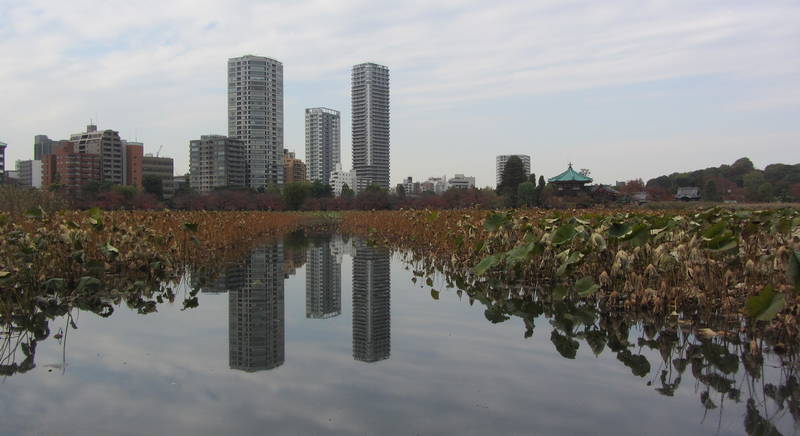
Shoebill Struk

Love the lemurs
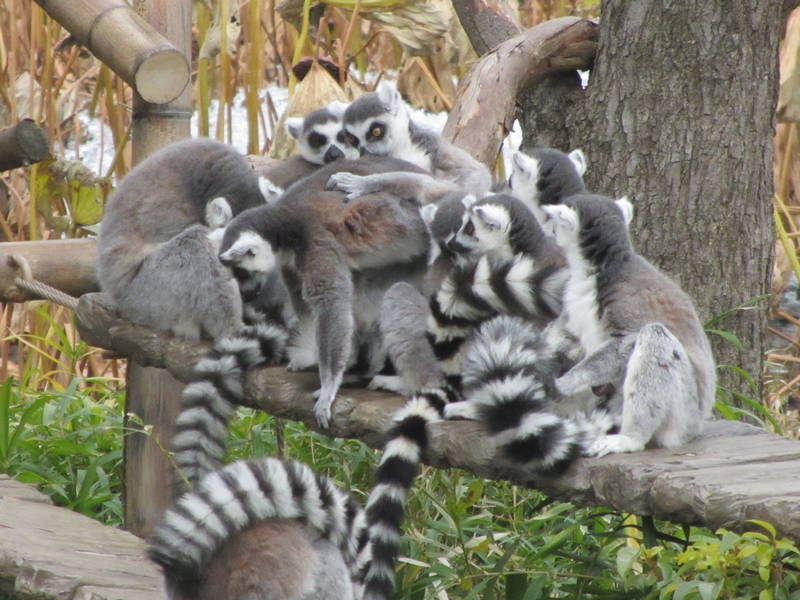
Prairie Dogs are pretty common at home but "zoo worthy" in Japan

Panda for lunch anyone?

Hokkaido bear is enormous, the size of a grizzly bear at home

The star of the show enjoys a bamboo break

Walking through the Yanaka district at sunset

On Friday, November 23, we planned to send our camping gear to Matt (see the Kazakhstan Chapter) in Kuala Lumpur but were informed that as it was Labor Thanksgiving Day the post offices were closed. Instead we spent the day packing the stuff to mail and preparing to fly to Canada on Saturday. The next morning we took a cab from Mr. Noguchi's apartment to the main post office in Saitama, as the local post office down the block was closed on Saturdays. There we tried to send the Chinese duffle bags (that we had purchased at the Carrefour in Shanghai) full of our camping gear to Matt but the mail clerks would have nothing of it. They insisted that we put our stuff into official boxes. It was a good thing that our flight to Canada didn't leave until late in the afternoon as this process was taking longer than we had planned. After getting the mail off we walked to the nearest train station and from there it took an hour to reach the Narita airport, getting there just before noon with plenty of time before our flight. November 24 was a day that seemed to us to last twice as long as any other day. We arrived at the Narita airport at about noon on the 24th and then landed in Calgary at about noon on the 24th. When we landed in Calgary we came from the west, while when we left in July we went east. Yes, we had actually gone around the world. First things first, lunch at Tim Horton's and then we drove (a car!) up to Carstairs to visit Audrey's mom. It was such a relief to see her and she was definitely her usual upbeat self.
From November 24 to December 12 we spent in Canada, visiting with friends and relatives, including the Calgary community from Horizons Unlimited and the Rocky Bow Riders BMW club. Before December 5 we drove over the Roger's Pass to get to Winfield, B.C. and celebrate Sinterklaas with my brother (hadn't seen him since Japan a month or two ago!) and his wife as well as my parents who had already booked a flight to Kelowna before we came home. At least we got to experience a bit of a Canadian winter even while on our year away.
If November 24 was the day we lived twice then December 13 was the day that wasn't. We woke up in Airdrie, Alberta at 7:00 AM, December 12, to catch a flight to Los Angeles and we landed at the Haneda airport in Tokyo at 11:00 PM on December 13. As we didn't want to risk riding the train to Omiya station late at night (not being sure when service ended) we had booked a "capsule hotel" at the airport. It was more of a cabin hotel as the deluxe cabins (one cabin on the women's side and one on the men's side) were just long enough for the bed and had a small aisle beside the bed but were high enough for me stand in. The business class cabins were only wide enough for the bed. I woke up at 4:00 AM and then dozed a little until 8:00 when I noticed a Facebook message from Audrey saying that she was up and in desperate need of caffeine. After breakfast we took the monorail and train to Omiya station where in the afternoon we made arrangements for picking up the bikes in Singapore. A juicy Mos burger for supper and then we collapsed into a fitful sleep at 8:30. This jetlag business wasn't much fun.
Cabin Hotel at Haneda Airport was a great place to collapse after spending almost 24 hours travelling
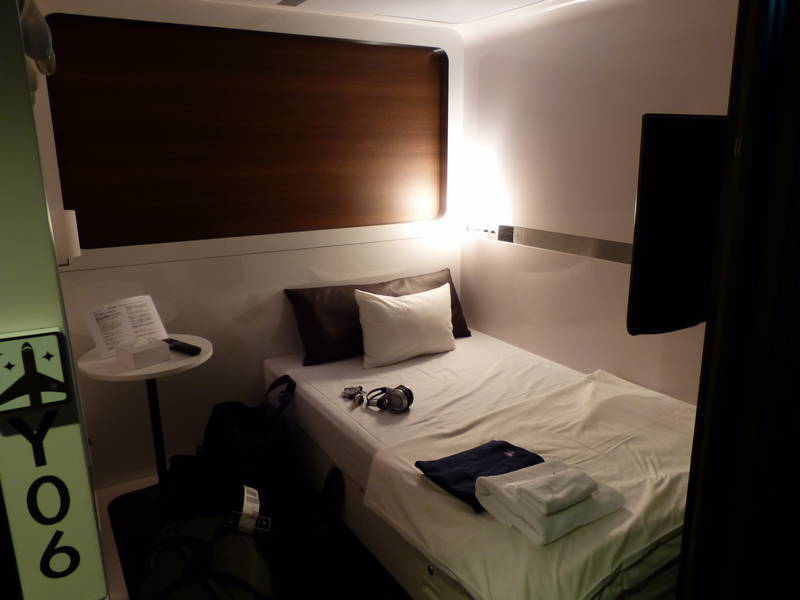
On Saturday, December 15 we went to one of Japan's most visited tourist attractions: Tokyo DisneySea. Considering how cold and, later in the morning, wet it was we were amazed at the number of people coming to play with Mickey and friends. As we thought that umbrellas would be difficult to manage on the rides we hadn't brought any with us and so were forced to purchase a couple of plastic ponchos for ¥500 each ($5.50). That helped, but those of us with longer than average arms couldn't keep our hands dry and out of the cold rain. My hands hadn't been that cold in ages and so I really missed the heated grips from my motorcycle. We had picked up a "Fast Pass" for the Journey to the Centre of the Earth ride that meant we could come back after 2:00 PM and just walk on rather than standing in line. This also meant that we couldn't pick up another Fast Pass until noon so we checked some of the rides to see how long the standby lines were. 120 to 180 minutes. OK, I'm not standing in line in a cold rain for 3 hours to do a 3 minute ride. Heck, I don't think I would stand in line for 3 hours even if the weather was beautiful. At one ride I was glad that I hadn't stood in line since there was actually a maximum height of 195 centimetres. While I'm only 193 cm tall I didn't think the risk of being decapitated (or whatever happens to tall people on these things) was acceptable. Fortunately there were plenty of things to do other than stand in lines to go on rides. My favourite place was the Society of Explorers and Adventurers where famous explorer's portraits were on display and science exhibits, such as Foucault's Pendulum, could be viewed. Even more fun were the remote controlled boats. While the Journey to the Centre of the Earth ride was good the real highlight of the day was the pyrotechnics and laser show with Mickey in the harbour at 5:30. We joined the crowds around the harbour and were entertained as boats with lights, fireworks and dancing Disney characters floated by. After the big show we got on the Disney monorail back to the train station and by 8:00 PM were back at Omiya station and Mr. Noguchi's apartment.
Happy to be out of the rain

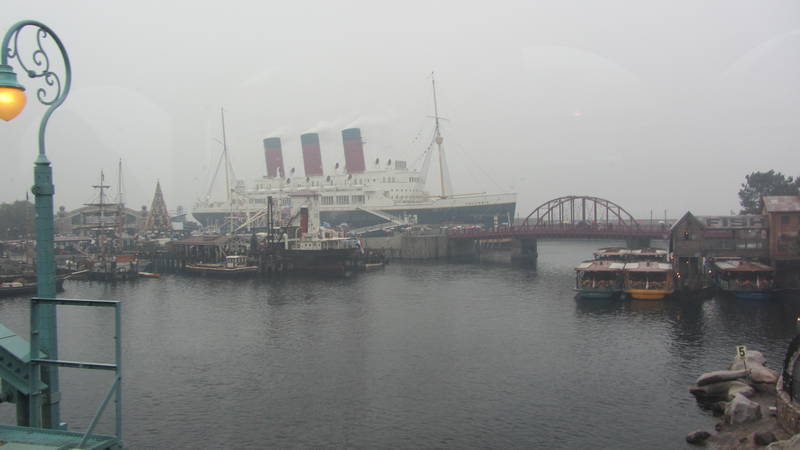
Foucault's Pendulum shows the rotation of the Earth
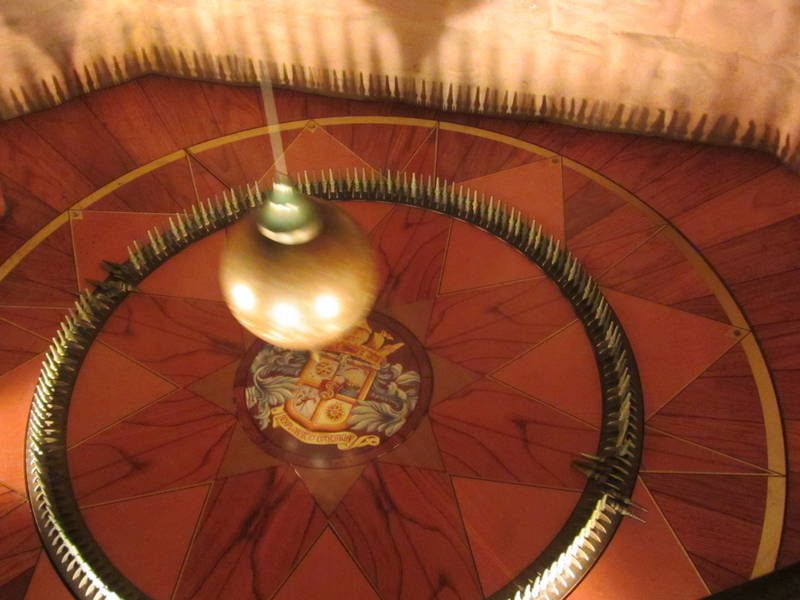
Mickey's amazing light and pyrotechnic show
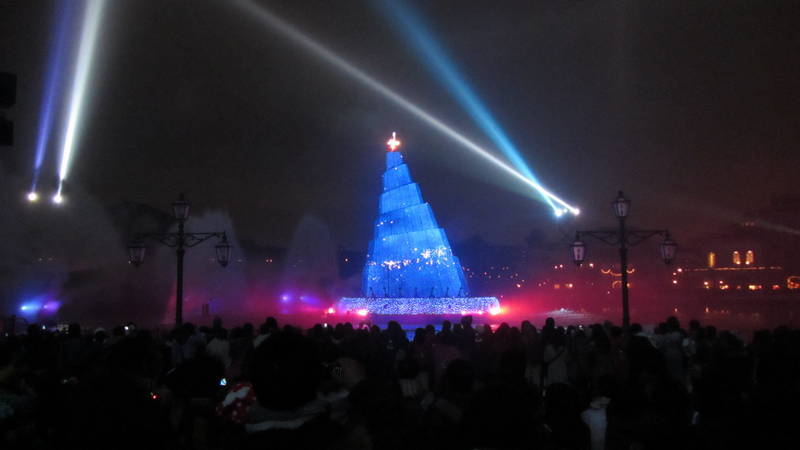
As the Narita airport was about two hours away by public transport from Otosan's apartment in Saitama we decided to stay in a hotel near the airport on Sunday night, our last night in Japan. On Sunday morning we thought we would do a bit of laundry before packing up but were having a spot of trouble figuring out the washing machine. Otosan had shown us how to use the device but because the machine could wash and dry there were a few options we weren't sure of. Audrey had received an iPad mini for Sinterklaas/Christmas and now had an opportunity to use it. We used Facetime to call Chieko in Winfield who then looked at the symbols on the machine and interpreted them for us. Thanks Chieko! After laundry we packed everything up, including all of our motorcycle gear and strapped it to a set of luggage trolleys we had just purchased at the Haneda airport. The trolleys were invaluable for the 800 metre walk to the train station and then across the airport to the shuttle bus that would take us to the Narita Hilton (it wasn't that expensive!). On the morning of December 17 an absolutely stunning breakfast buffet awaited us in the Hilton restaurant. We had wanted to have a light breakfast before our flight but in the end resistance was futile, "Is that a stack of pancakes I see?" The convenient shuttle bus dropped us off at our terminal after a few minutes' drive. Before checking our luggage with China Eastern Airlines we strapped our lovely luggage trolleys to our bags in the hope that they would prove to be just as useful in Singapore as they had been here. Then we were off to start a new adventure: S.E. Asia here we come!
Audrey leaves Mr. Noguchi's apartment on the way to Singapore
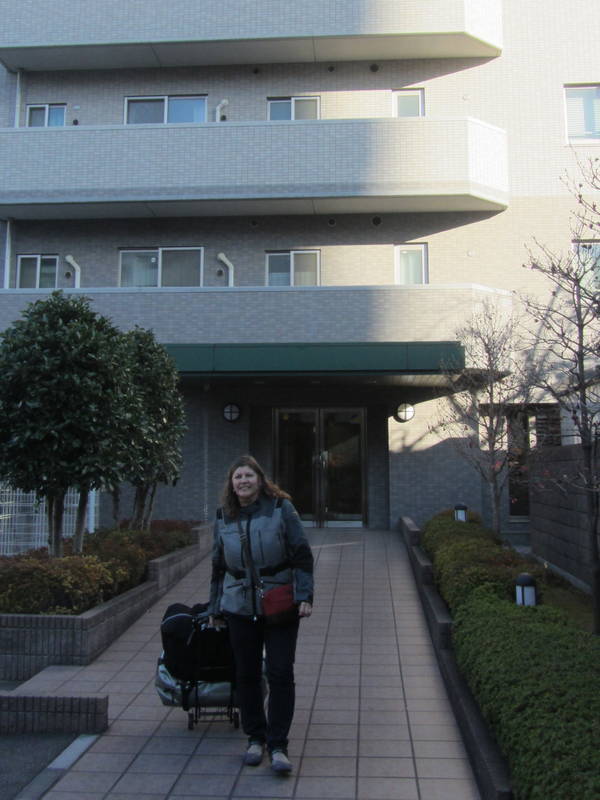
P.S. My theory on the water sprinklers? I think that they were clearing out the system in preparation for winter when a de-icing solution is sprayed onto the road.
Map for Japan Part 3
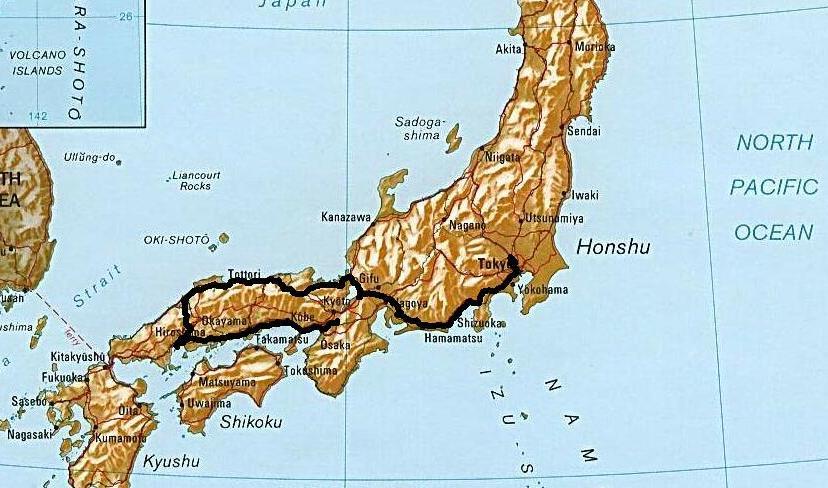
Map for our entire time in Japan. We'll have to come back for Kyushu and Hokkaido!

We left Japan from Narita airport on Monday, December 17 and flew via Shanghai to Singapore. After being out of China for a few months it was immediately apparent we were back the moment we landed. No more courteous and polite people. The lady at the international transfer desk (so we could stay in the airport and not have to get Chinese visas) was very gruff and sullen. We just had to laugh as she looked condescendingly at us and grunted at us to move over to a roped off area when she was done with us. It was so familiar. Then, sitting in the waiting area (at the same gate from which we flew to Fukuoka two and a half months ago) a group of Chinese tourists heading for Singapore sat down near us. They had lively animated discussions in very loud voices and then one of their group laid down across a few seats and started watching a video on a portable player. He didn't use headphones and had the unit cranked up loud enough for everyone to enjoy his show. Yep, we're not in Japan anymore. Fortunately it was a pleasant flight on China Eastern and we landed in Singapore at 10:30 PM local time. We had thought that Japan was going crazy with Christmas displays but in Japan it was only at shopping centres. Here in Singapore even the airport had a fabulous Christmas tree set up and people gathered around it taking pictures. Rolling the luggage out on our new luggage carts, we hailed a Chrysler 300 taxi and checked into the Fragrance Hotel. Our first impressions of Singapore were very positive as the driving was good and it was quite clean. No, not Japan clean, but Canada clean anyway.
After a relaxing break back home in Canada it was nice to get to S.E. Asia

Christmas in Singapore at the airport

While our primary purpose for being in Singapore was to pick up the bikes, Singapore has a lot to offer the tourist. As the boat with the bikes had been delayed another day we made the most of our time in Singapore. It was a good walk from The Fragrance Hotel to the Mass Rapid Transit system and there was an Indian restaurant on the way. Prata (a fried flour-based pancake served with curry) with onions and cheese along with a milk tea made for a great way to start the day. The MRT was a bit crowded but there was no pushing and shoving as there had been in China so the ride to downtown was quite pleasant. We weren't used to the heat and humidity but still it was pleasant walking around downtown, through Esplanade Park and past lovely terraced houses. The Fullerton Hotel and the iconic Marina Bay Sands hotel and casino made great Singapore backdrops for our photos. We had to make the trip to the Raffles Hotel, one of those classic (but seriously expensive at $600 to $8,000 per night) hotels that define a city. Perhaps the most famous signature of the Raffles Hotel and therefore Singapore was the Singapore Sling drink ($23 per glass) and we couldn't very well come to Singapore and not have one at Raffles. OK, I had a ginger ale, but I did have a taste of Audrey's and it was very nice. While the thought of a botanical garden didn't really excite me I was pleasantly surprised how beautiful and relaxing the place was. Even the warm afternoon rain made it more interesting, especially in the rainforest portion of the park. The park is famous for its National Orchid Gardens and one section had celebrity orchids that were specially bred and then presented to distinguished visitors in order to promote goodwill and foster closer ties between nations. The Jean Chretien and Princess Diana orchids stood out in my mind. In the evening we went to Orchard Road for its Christmas displays. The famous shopping street is home to expensive, designer outlet stores and the road itself had many exotic automobiles ranging from Porsches and Lamborghinis to the occasional Bentley. As dusk fell and the lights came on, a magical glow transformed the busy shopping street into a glittering Christmas display.
Iconic Marina Bay Sands
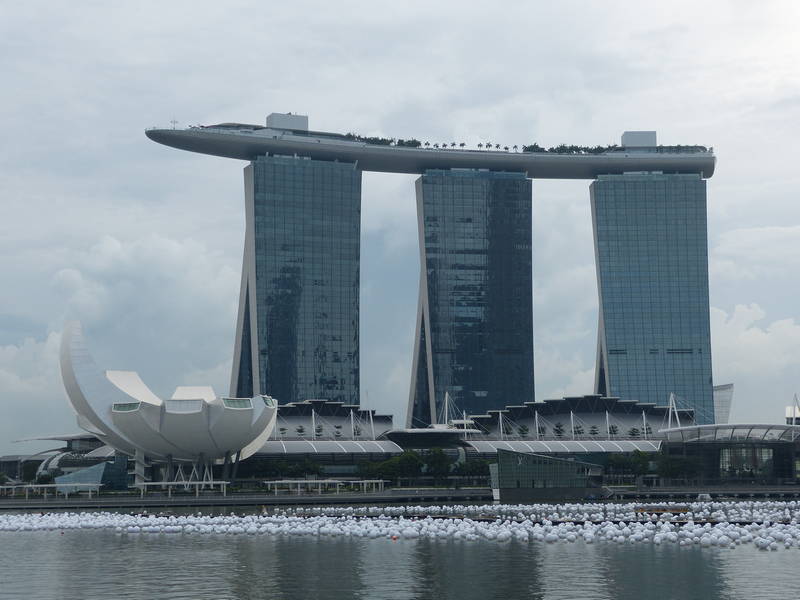
Ekke grabs the bull by the horns
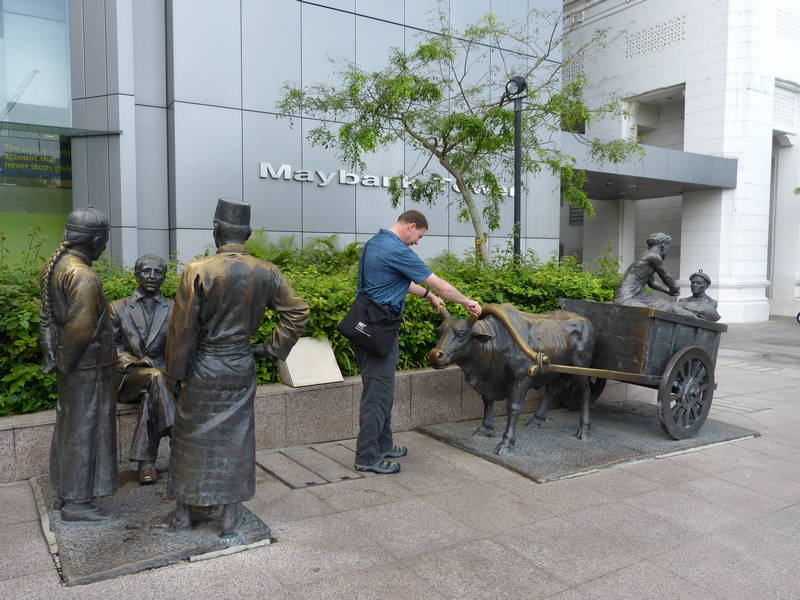
The Raffles Hotel
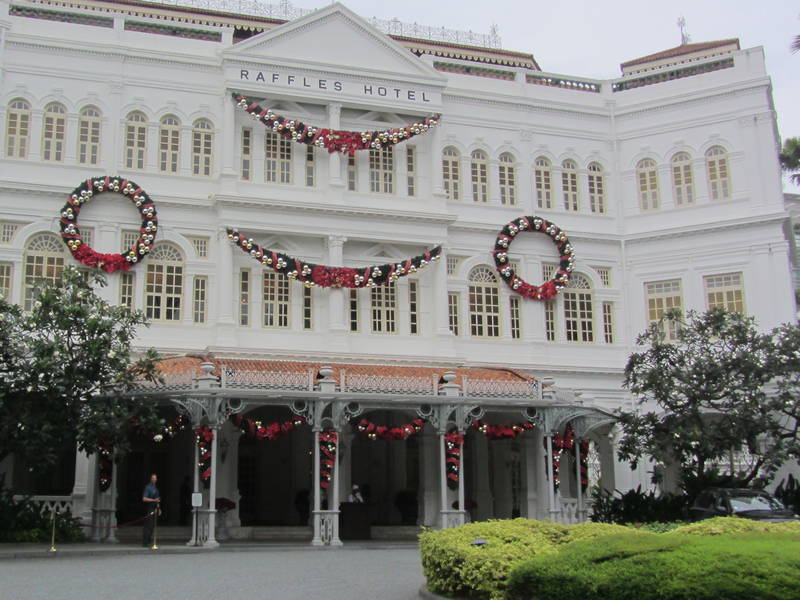

OK, a ginger ale and a Singapore Sling

Stopping for a fresh sugar cane juice (and not shown is the Belgian fries with mayonnaise at the adjacent stall)
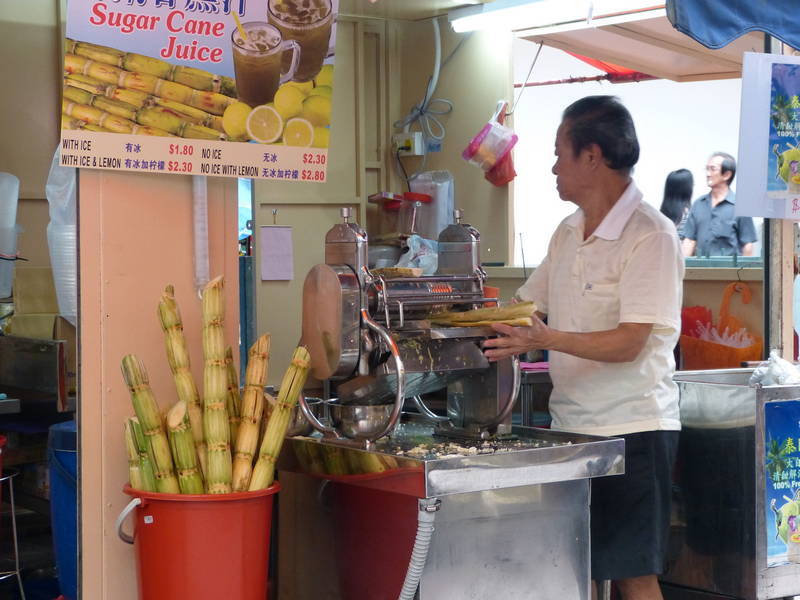
A walk through the rain forest in the Singapore Botanic Garden (with authentic rain)
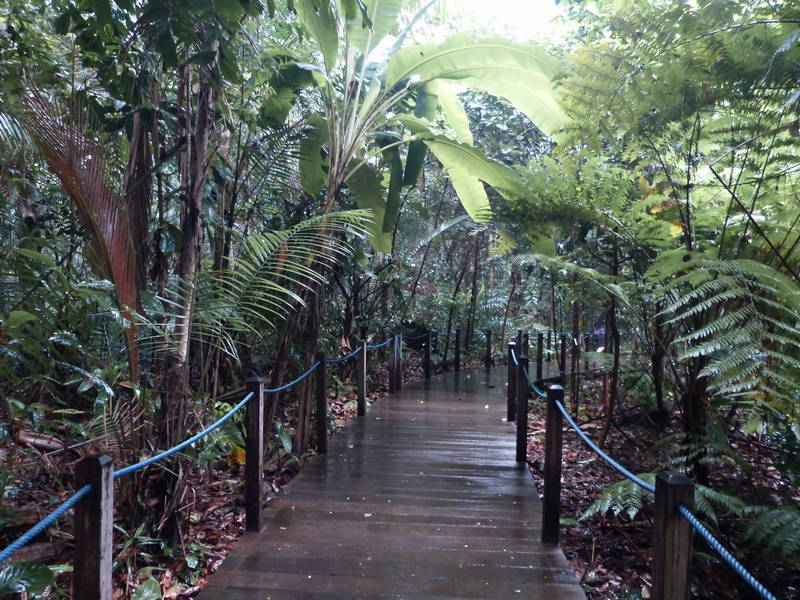

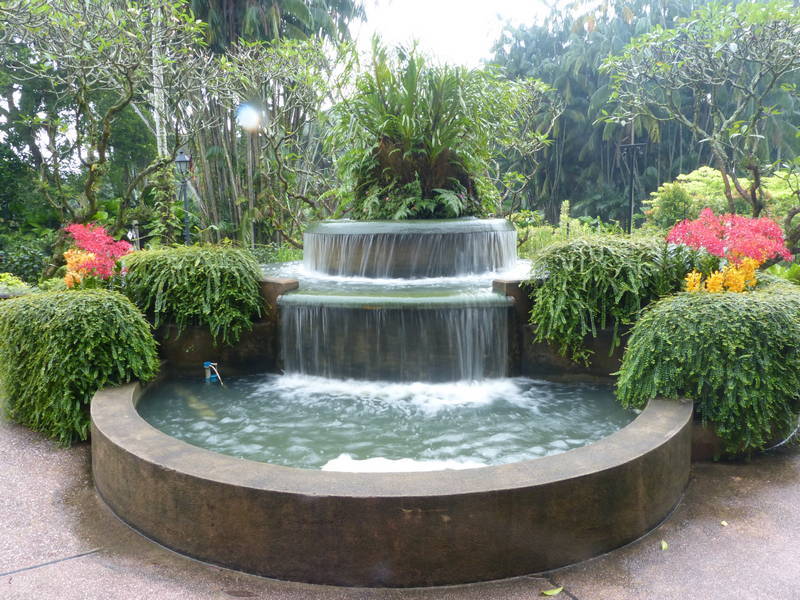

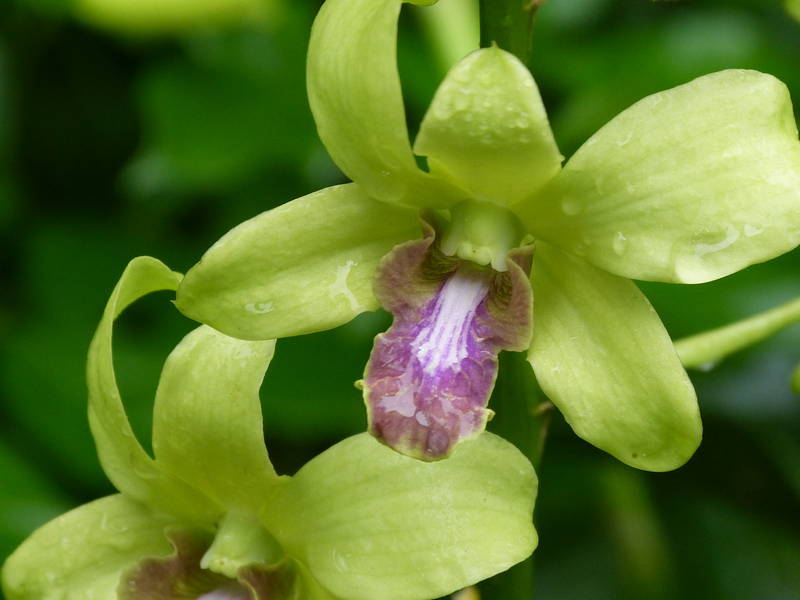

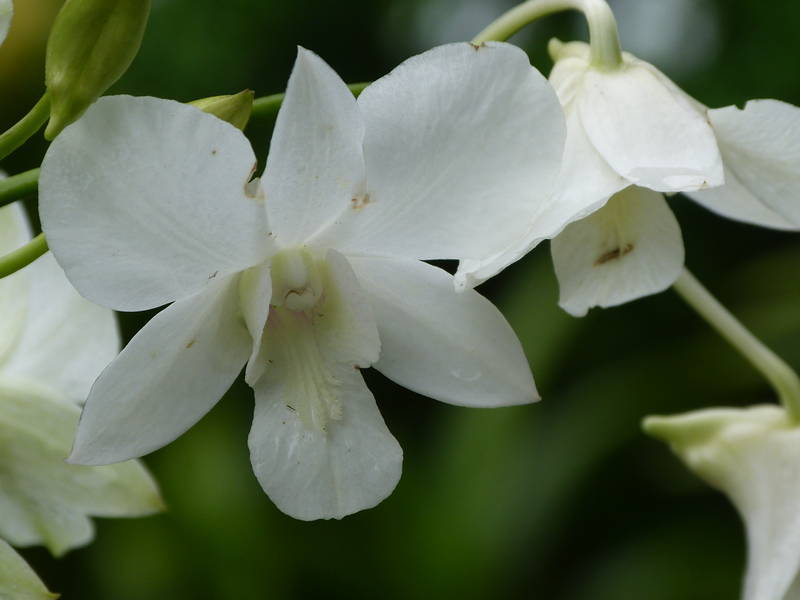
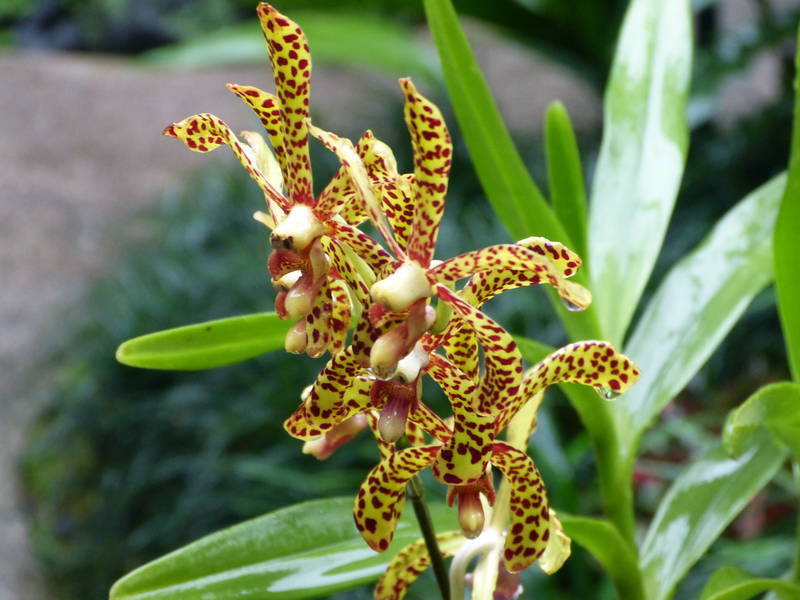
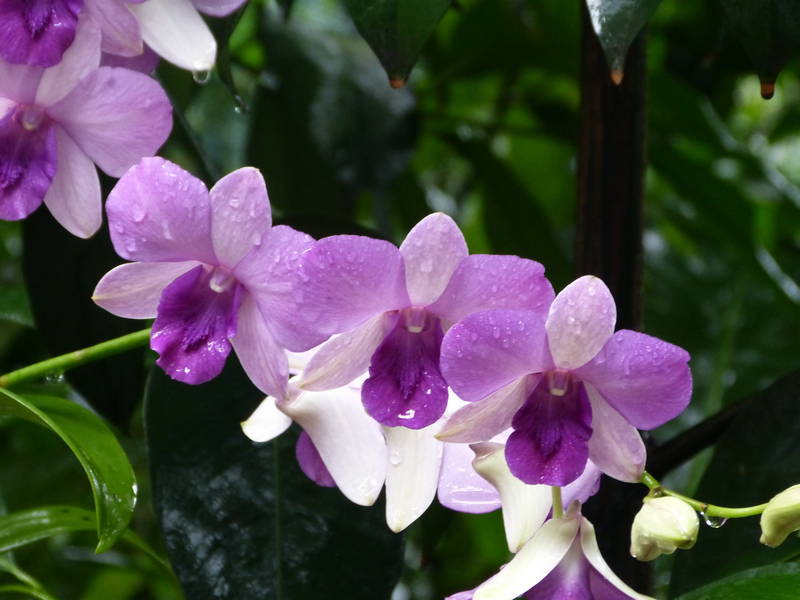
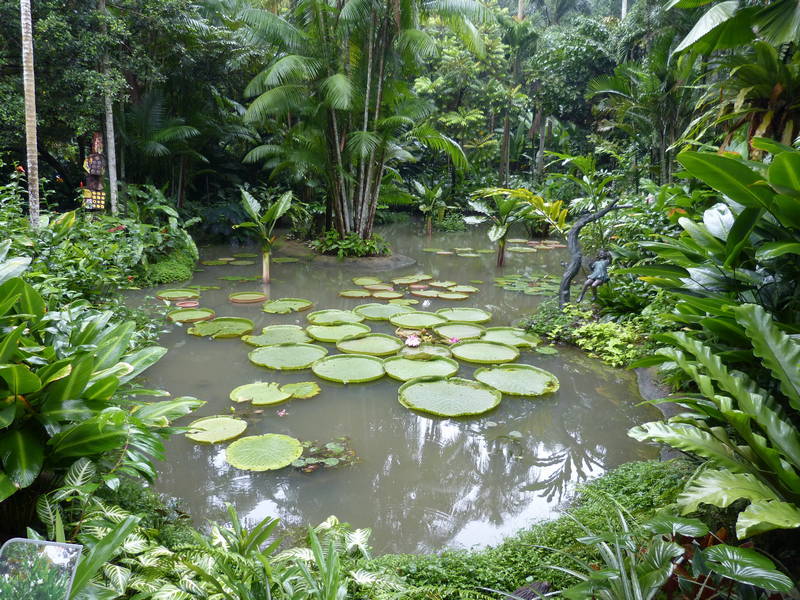
Orchard Road Christmas lights

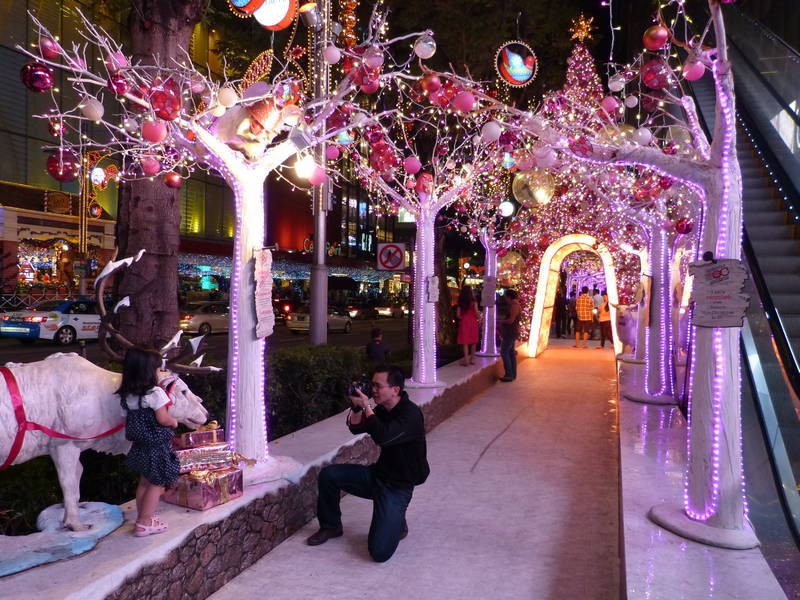

Another day was spent going on a boat tour of the canals as well as going to the offices of WWL (the owners of our Roll On Roll Off Boat) and the Automobile Association of Singapore to arrange the pickup of the bikes. We had heard that it would be prohibitively expensive to ride the bikes in Singapore and our visit at the AAS confirmed that. We would have to purchase insurance for the bikes (and no-one seemed to know where that could be purchased) as well as an electronic toll card, topped up with at least a minimum amount even if we weren't planning on taking any toll roads. In the end we decided to follow the advice of Matt (who had gone through this exact procedure the month before) and Dr. Greg Frazier both of whom indicated that it was much better to simply put the bikes on a truck and have them taken from the port to the border with Malaysia. The boat was scheduled to arrive on Friday, December 21 so we made arrangements to meet at the AAS office then. A call to the stevedores in charge of unloading the boat on Friday morning indicated that the boat was delayed yet again and the bikes wouldn't be available until 9:00 PM Friday night. That was way too late to do all the necessary paperwork and then cross into Malaysia so we called Rosie at the AAS and let her know that we would be picking the bikes up on Saturday morning. At the front desk of the Fragrance Hotel we were told that they were fully booked for Friday night so we made a quick trip to Expedia and found the Robertson Quay hotel which, aside from being downtown, had the added advantage of being much closer to the AAS office. With Friday now relegated to another waiting day we decided to make the best of it and took the MRT to the other side of the city, to the Jurong Bird Park. There were lots of fascinating and beautiful birds but the most interesting was a live demonstration with birds of prey. The usual tropical rain in the afternoon was a tremendous thunder storm and despite our umbrellas we were completely soaked quite quickly.
Walking to the MRT station

The Sands and the Fullerton
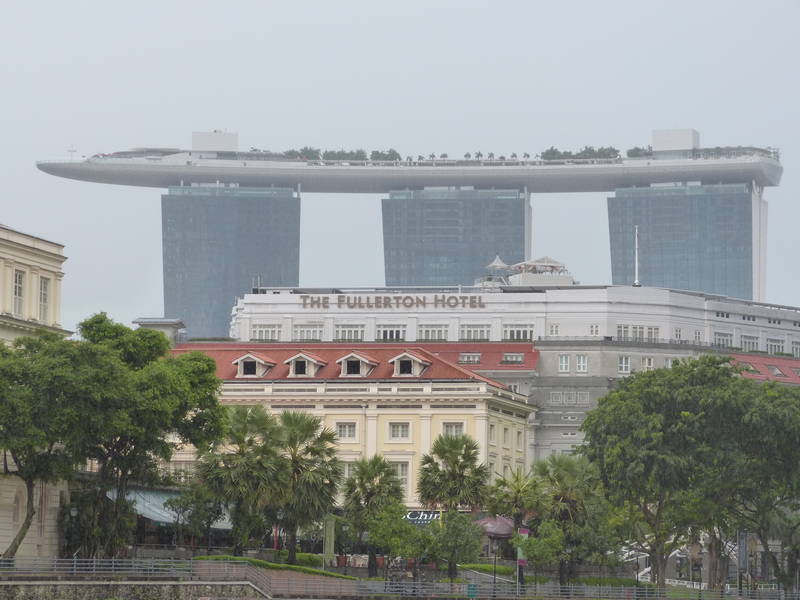
From the boat tour the Sands looks even more amazing

The financial district towers

Ekke tries his hand at driving the boat but decides to stick to riding motorcycles
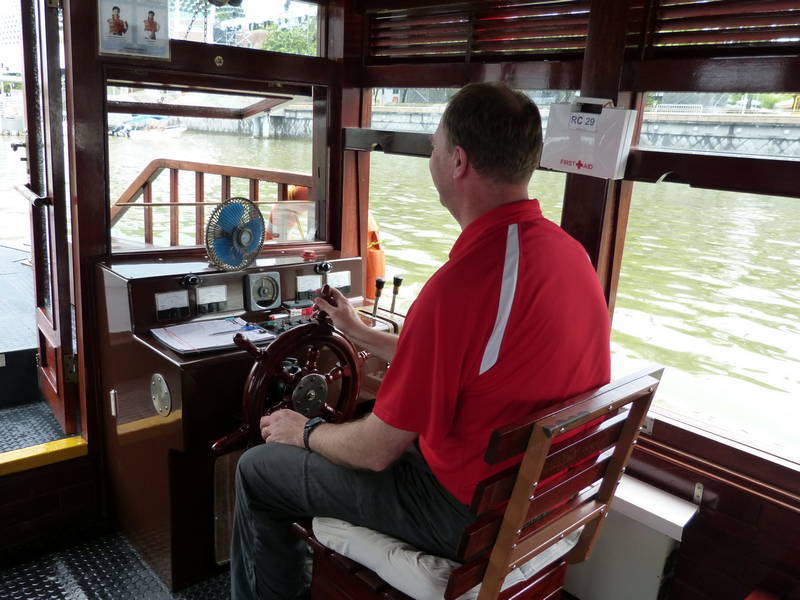
Playing in the fountain at Robertson Quay
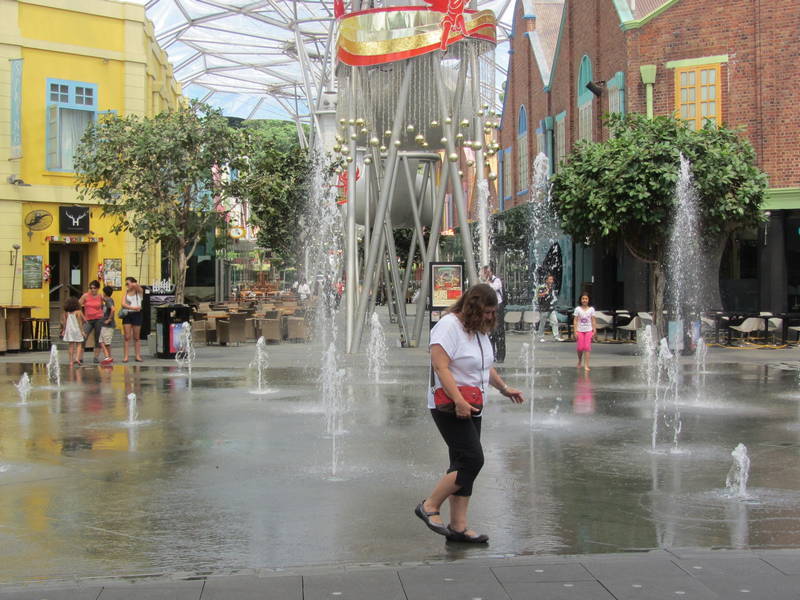
Entering the Jurong Bird Park while it is still nice and sunny

Our first birds in this tropical bird park are penguins
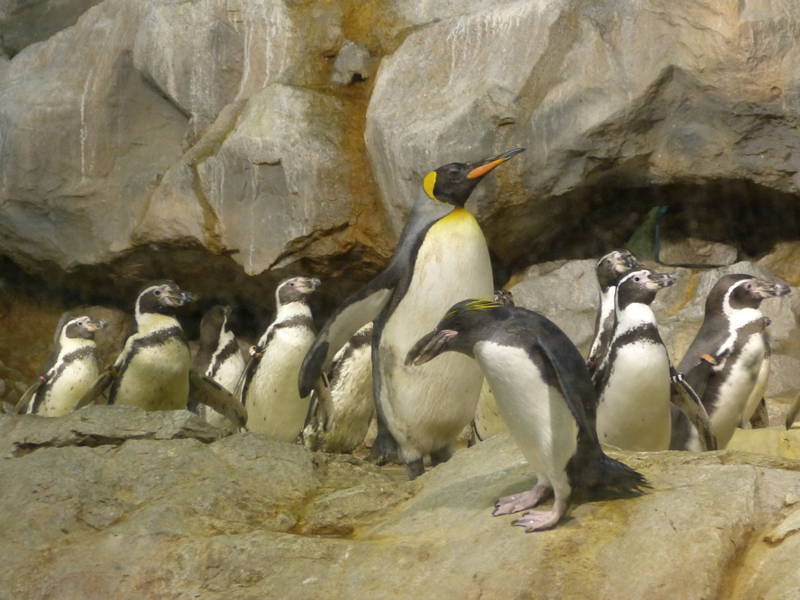
Hey, we have puffins at home in Newfoundland
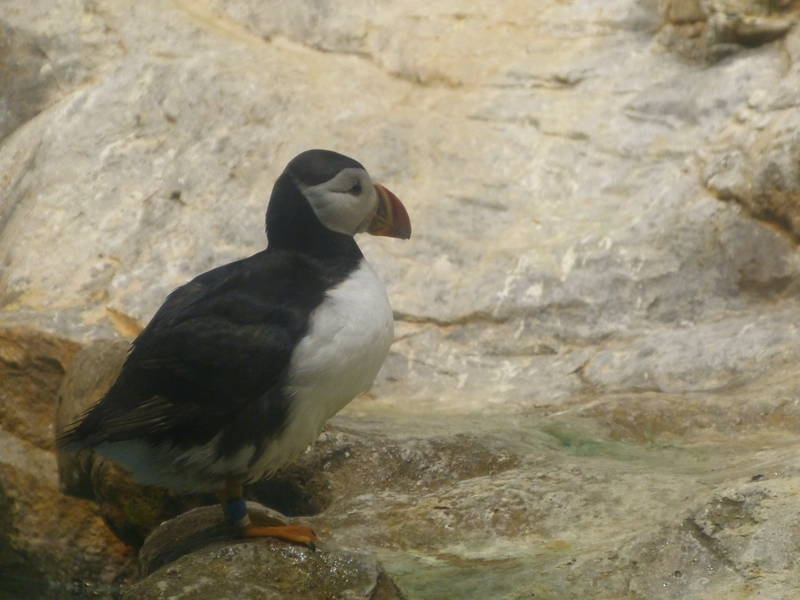
OK, these look more tropical
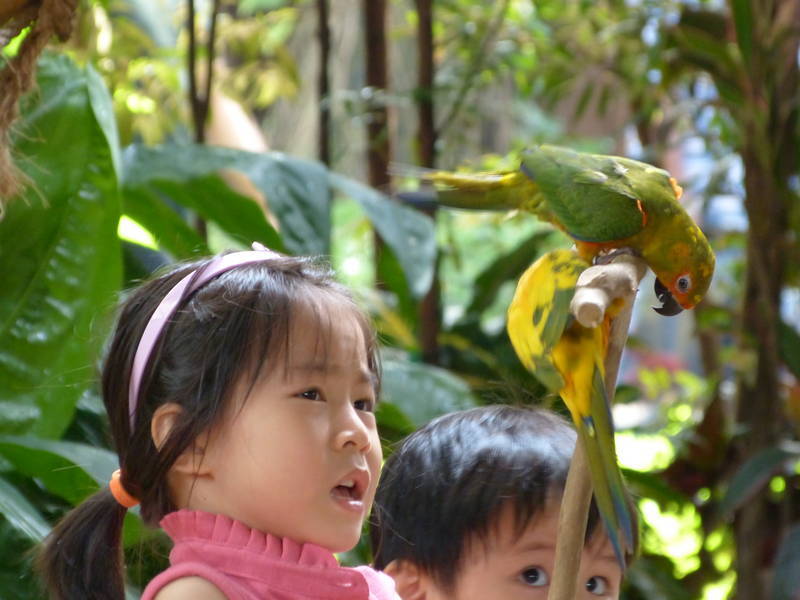
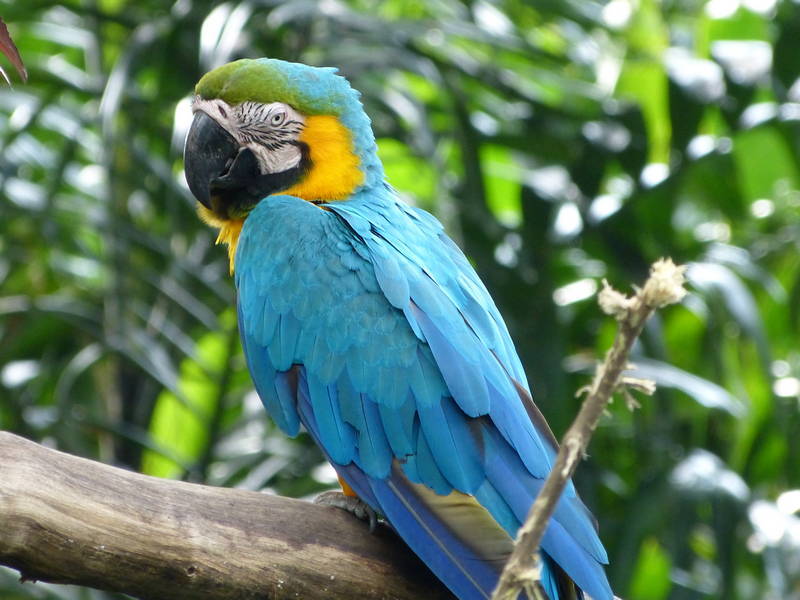
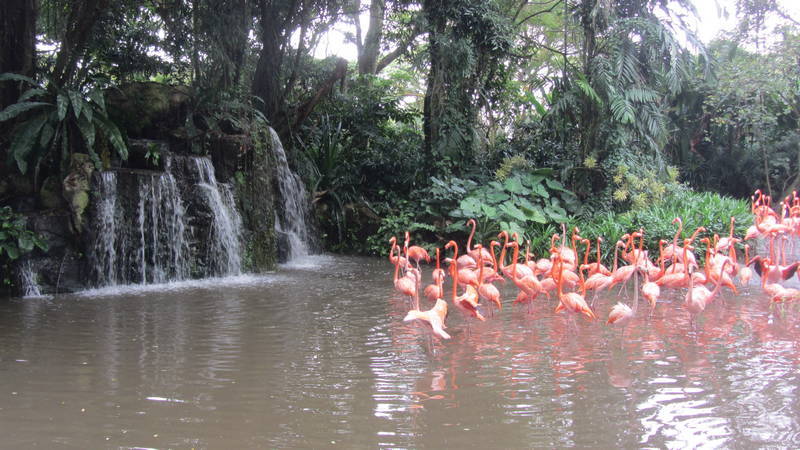
Mongolian horse and bird of prey demonstration
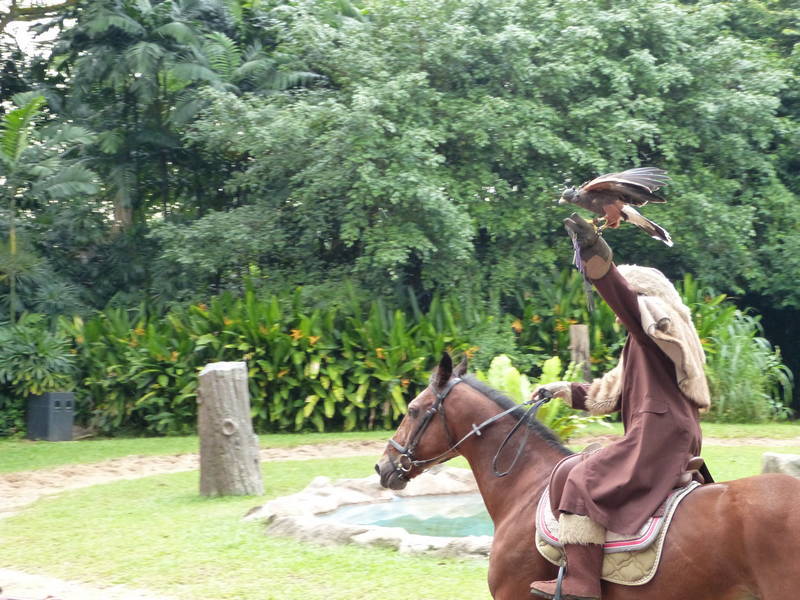
Hmm, he doesn't look very Arab


Audrey finds some new feathered friends
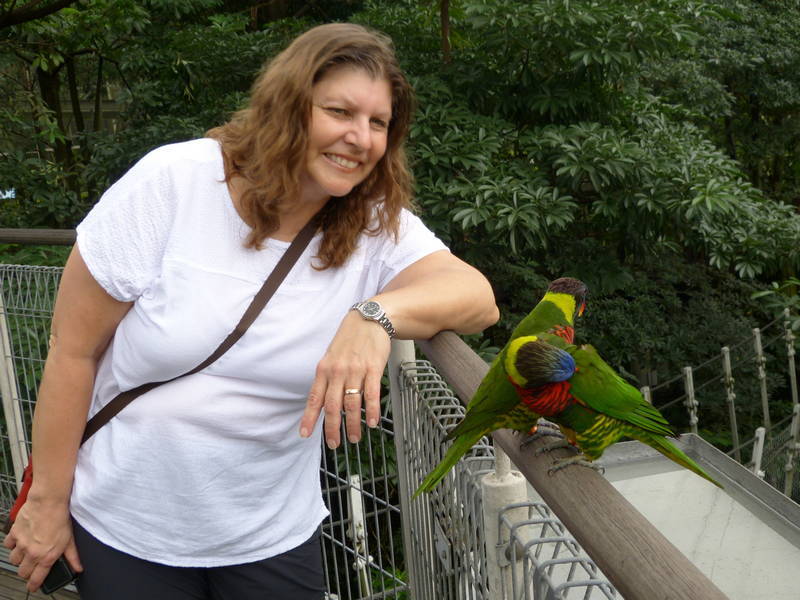
And then it pours with fantastic thunder and lightning to match
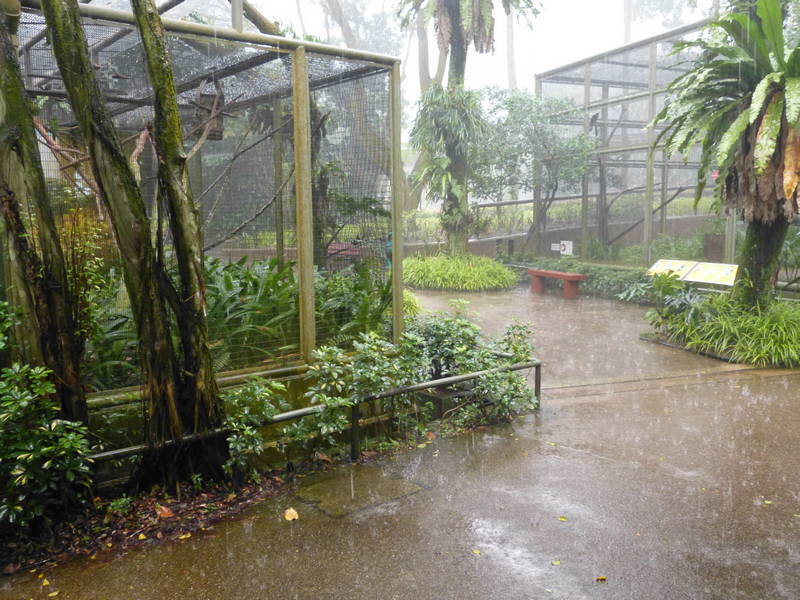
Leaving the bird park a little damper than when we came in
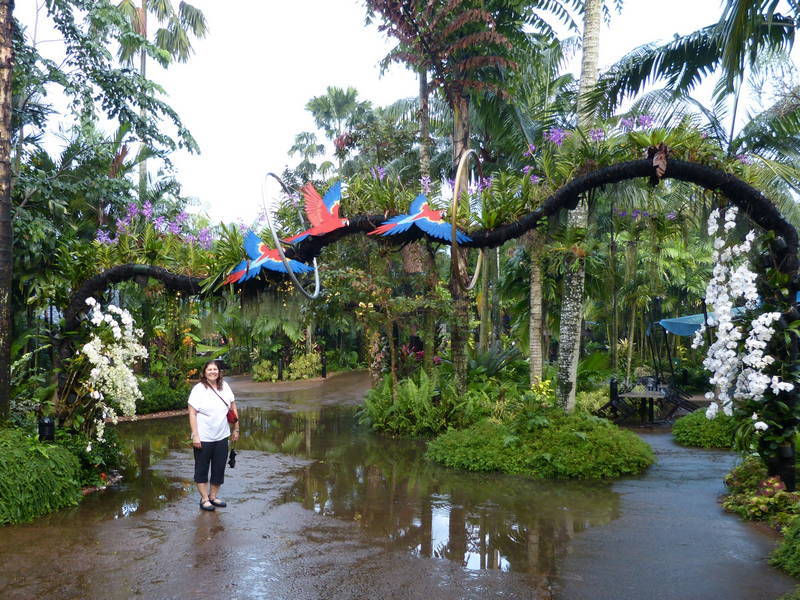
Finally, the day had arrived when we could get our bikes. Saturday morning we packed all of our stuff and hailed a cab for the short ride to the Automobile Association office where we met Sam, a tow truck driver who would help with extricating the bikes from the port. We threw our luggage on the back of the tow truck and jammed into the cab for the twenty minute ride to the port. There we queued up to get passes to enter the port itself and soon Daniel from Bikebulance (a company specialising in transporting motorcycles in Singapore) showed up too. As the port would have greatly diminished services over the Christmas holidays it was extremely busy December 22 and it took almost two hours to get the port passes. The Bikebulance truck only had room for three in the cab so Audrey waited in the air conditioned comfort of the port pass office while Daniel, Sam and I collected the bikes. There they were, looking well rested after their time at sea and ready to tackle S.E. Asia. Sam and I lined up at another office with the paperwork from WWL so that we could take the bikes out and then we went back to the warehouse where Daniel manoeuvred the bikes into the back of his truck. I was amazed how easy he made it look. The Adventure went first. He fired up the motor, put it in gear and then ran beside it, the bike going up the ramp to the truck before he leaped into the truck bed at the last minute still holding onto the handlebars. He had obviously done this before. The F650GS seemed a little easier as he simply rode it up the ramp with enough speed to balance on the narrow ramp and then skidded to a stop before hitting the Adventure. At the port exit we waited while customs stamped our Carnet de Passages and then we said goodbye to Sam as Audrey joined us in the Bikebulance truck. By now it was well past lunch time and we bought Daniel a Big Mac on the way to the Second Link Bridge. A Singapore motorcycle enthusiast noticed our bikes in the back of the truck at McDonald's and was amazed that we had travelled so far on them. He insisted on getting photos of us and the bikes. We were celebrities again. Only an hour after we had our Carnets stamped into Singapore we had them stamped out again. Daniel drove into "no man's land" between Singapore and Malaysia and stopped on the Second Link Bridge on the shoulder of the road. This was as far as he would go. The bikes were unloaded and then he did a U-turn at a break in the median to return to Singapore.
Sam, the tow truck driver from the Automobile Association of Singapore gives us a ride over to the port
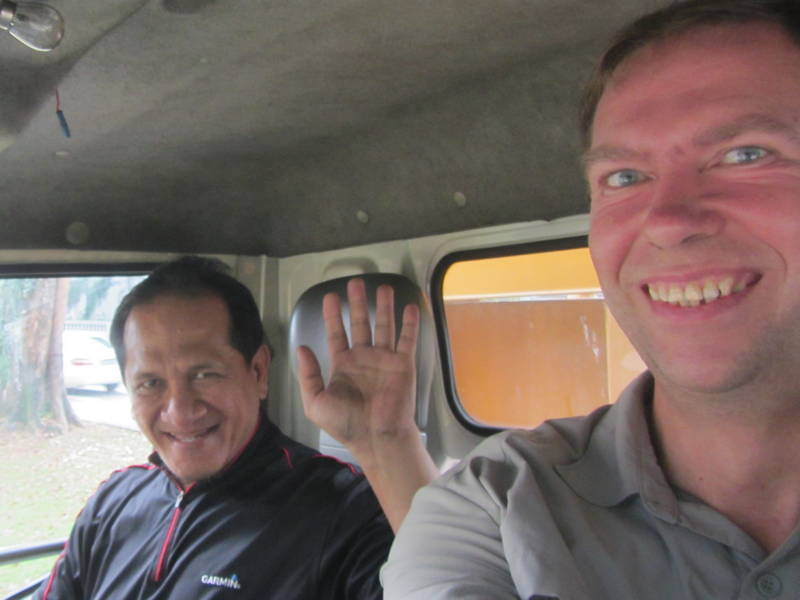
Daniel rides the F650GS up the ramp at the warehouse

And then takes the bikes off the truck an hour later on the Second Link Bridge to Malaysia
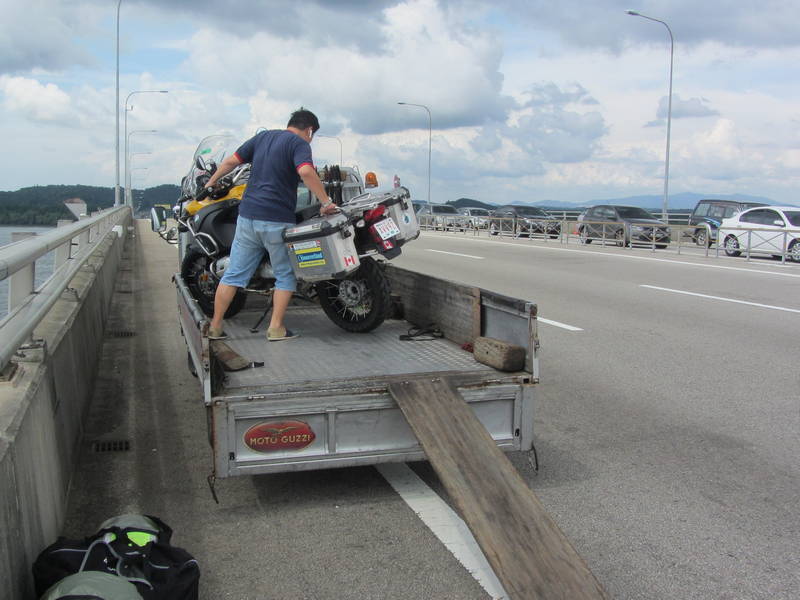
Ready to ride to the Malaysian border (while another tow truck deposits more vehicles to transfer to Malaysia)
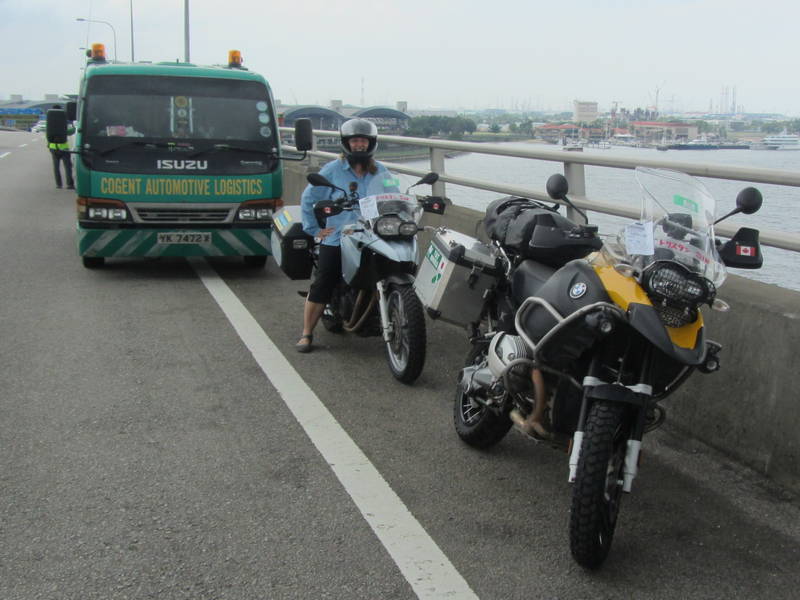
We packed our bikes but didn't put on our full motorcycle gear in the heat as we anticipated spending some time standing around for passport control and customs to enter Malaysia just a few hundred metres up the road. The queue for cars entering Malaysia was quite long but motorcycles were heading to the left so we simply followed them. There we found small motorcycle-width pathways leading to a series of booths. I pulled up to one and Audrey to another where our passports were promptly stamped. I asked about the Carnet but was waved away. Audrey and I stopped after the passport control booths and conferred if we should pursue the Carnet issue any further by finding a customs office. In the end we decided that it wasn't worth the hassle, what's the worst that could happen? Then we rode a couple of kilometres further to a gas station (the bikes were on reserve when we dropped them off in Yokohama) where we changed into our full motorcycle gear. The expressway went all the way to Kuala Lumpur and was easy riding. The drivers weren't as polite as Japanese drivers (and who is?) but on the whole it went well. Except for the massive tropical afternoon rain of course which seemed to cause a few hydroplaning incidents based on a few single-vehicle collisions we saw. I decided that since we were entering and leaving the isolated storms I would forgo putting on the rain gear in the heat. Wow, I was completely soaked in mere moments and my motorcycle jacket and pants got a good washing. After the first storm and drying out a bit I thought better of my strategy and put on the rain gear for subsequent storms. This was made all the easier by the special motorcycle stops that the Malaysian authorities had placed under overpasses where one could get out of the rain and change. Nice! We arrived in Kuala Lumpur at about 8:30 and after checking in at our serviced apartment called Matt who came over and met us in the lobby. He was joined by his sister Rachel and her husband Steve who had arrived from the U.K. only a short time before us and, while jet-lagged, were happy to go out for a bite to eat at a local restaurant. We spent the entire evening getting caught up with Matt whom we had last seen in Ulaanbaatar in September.
Riding into another tropical rain storm on the way to Kuala Lumpur
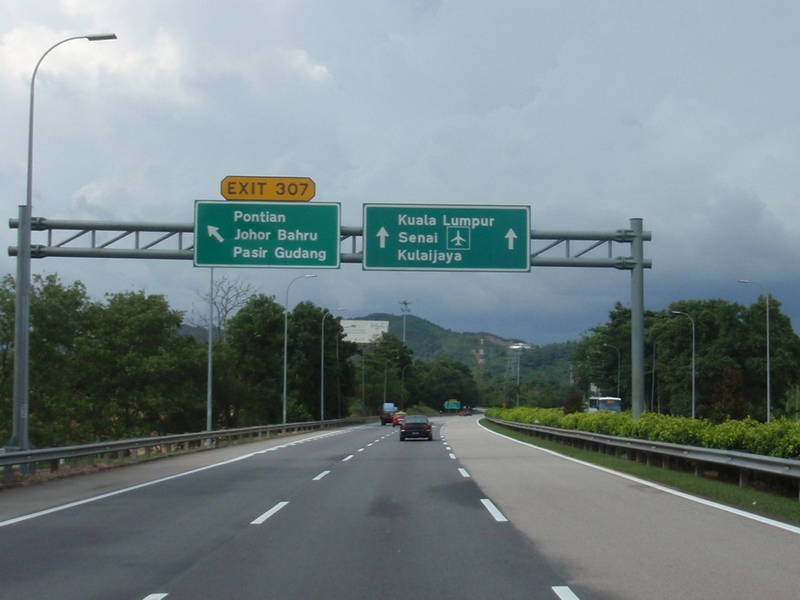
On Sunday morning, after a nice buffet breakfast in the hotel, we went over to Matt's apartment. Matt, Rachel and Steve brought down the boxes of gear that we had sent from Japan. We talked a little as we unpacked the boxes and then started strapping the paraphernalia to our bikes. By 11:30 we were on the road and working our way out of Kuala Lumpur. Once on the expressway we made very good time heading north. Since we had reserved the week of Christmas at a resort near Krabi, Thailand starting on Christmas Eve we were on a bit of a schedule so it was a real pleasure to have easy riding on the toll-free (for motorcycles!) expressways. At 6:00 PM we started looking for a hotel near Alor Setar but it took almost two hours of riding around the city and checking out hotels before we found the Star Hotel. At 170 ringgits ($60) it wasn't too expensive and had a nice, clean room for us. We had covered about 450 kilometres so had about 400 kilometres with a border crossing to go on December 24. We got a reasonable start and were at the border checking out of Malaysia in short order. Again, leaving Malaysia was super simple with a special lane for motorcycles where our passports were stamped and we were in "no man's land" in less than a minute. The Thai side was a bit more problematic with filling in "Arrival" forms for passport control and then taking the Carnet de Passages over to customs to have a special import paper drawn up. Soon we were riding in Thailand and the differences with Malaysia were immediately apparent. It seemed a bit rougher around the edges; with dirtier streets and a four lane divided road had replaced the grade separated expressway. I had my doubts that a divided road with a barrier in the middle and U-turn spots every few kilometres could work very well and, sure enough, we soon noticed scooters and the occasional car going the wrong way on our side of the road. On the other hand, this made it easy to get to things on the side of the road such as convenience stores (our friend from Japan: 7-11) and other things. We stopped at a pineapple stand and chatted with a lovely woman and her daughter for a little while as we enjoyed their fresh, sweet pineapple. At a gas station, Café Amazon provided air conditioned comfort for a break from riding in the heat. With the help of the GPS we took some back roads around Krabi to Ao Nang and the Andamanee Resort. It was situated away from the busy beach area, back in the jungle and had an, oh so lovely, swimming pool. "Last one in is a rotten egg!" What a perfect Christmas Eve, topped off by dinner in the hotel restaurant of pineapple and chicken rice for me and a mild curry for Audrey.
Matt, Steve and Rachel bring down our boxes of camping gear sent from Japan
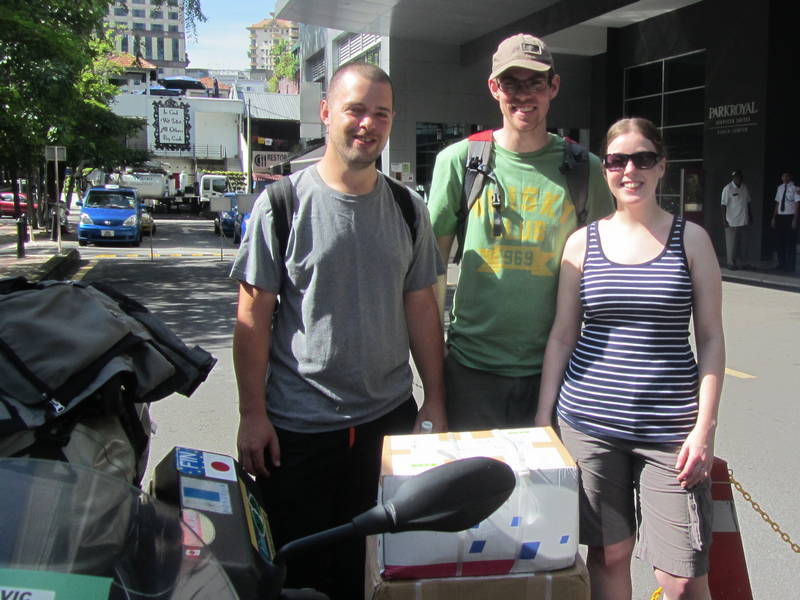
Leaving Kuala Lumpur the expressway is still good for riding

A Malaysian motorcycle club riding north
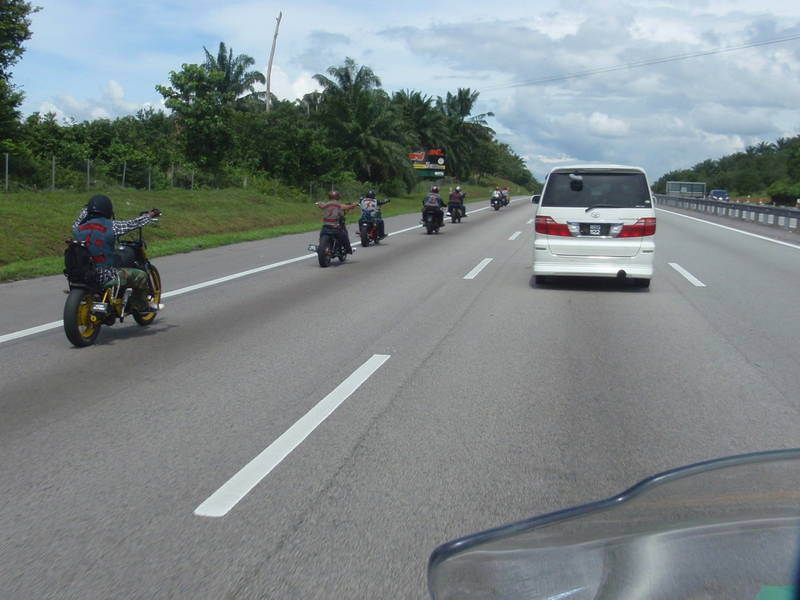
Fantastic, a place to pull over and put on the rain gear. Malaysia is obviously a great place for motorcyclists.
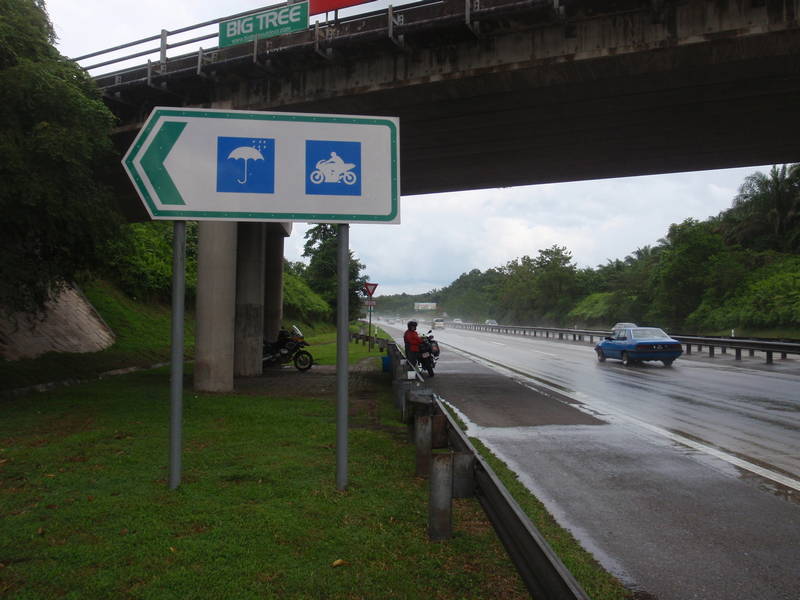
Some change into rain gear, others just wait it out

Motorcycle bypass around the toll booths
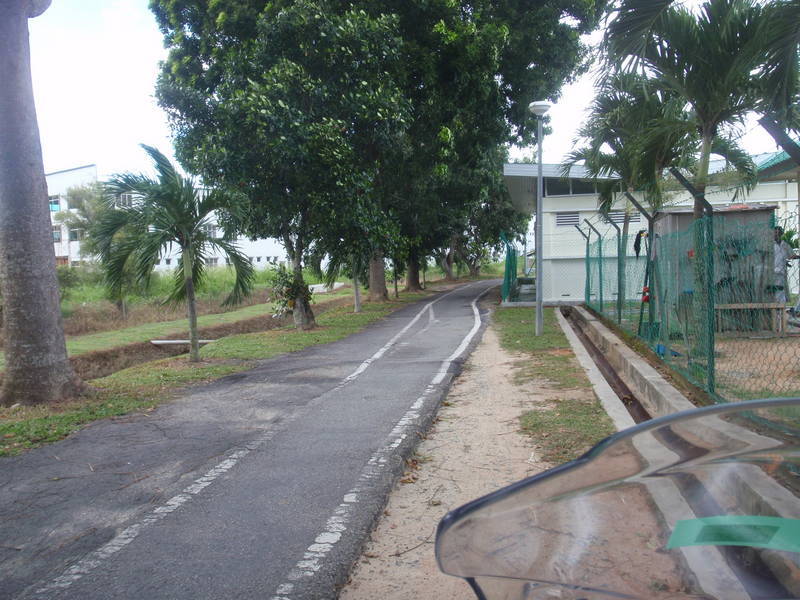
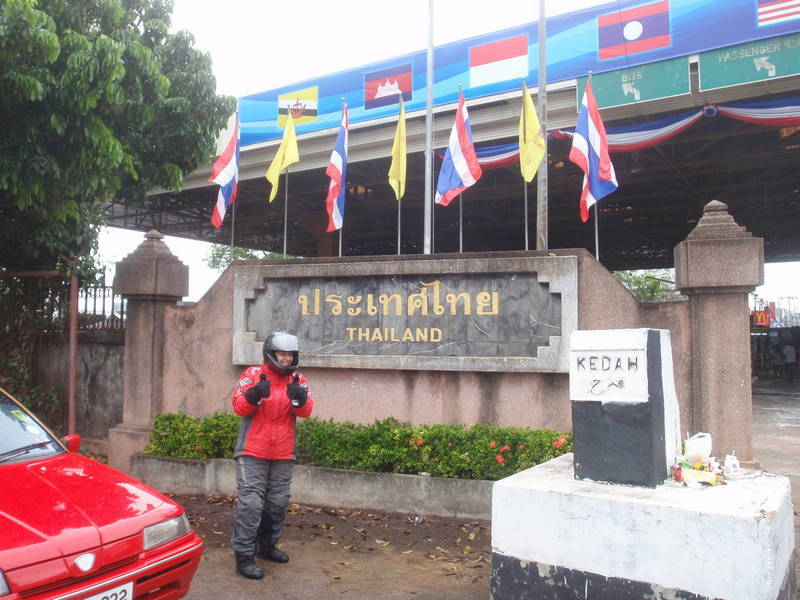
Stopping for a fresh pineapple break in Thailand

Taking the back roads to Ao Nang

Checking in at the Adamanee Resort
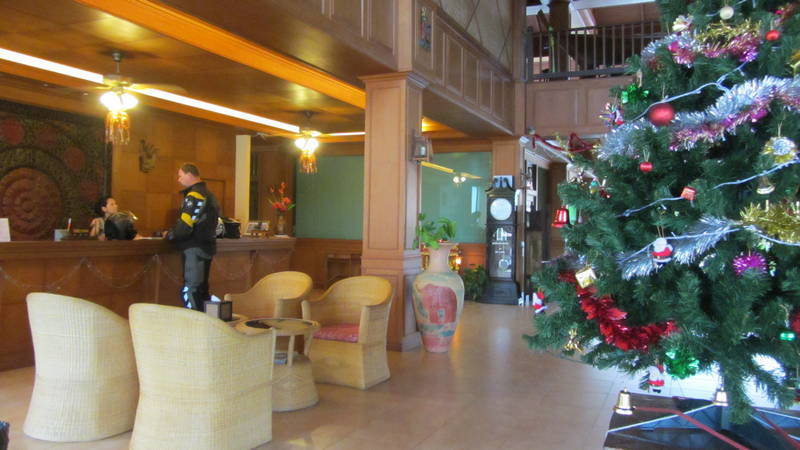
Then we spent a most relaxing week in Ao Nang. The Andamanee Resort seemed to be hacked straight from the jungle and so it was in a really quiet location. We tried walking to the beach, but only once, as the walk was along a stretch of road without shoulders. From then on we simply jumped on the motorcycles if we wanted to go to town for lively restaurants and shopping. The main street of Ao Nang was the exact opposite of our little hide-away in the jungle, crowded with T-shirt shops and crawling with sunburnt tourists. This was the Thailand that was so popular with Europeans coming for a break from winter. We used our week to good advantage, going swimming every day, updating the website and installing Christmas presents (lower footpegs promised to make my bike even more comfortable).
Audrey relaxes in the Andamanee Resort's pool
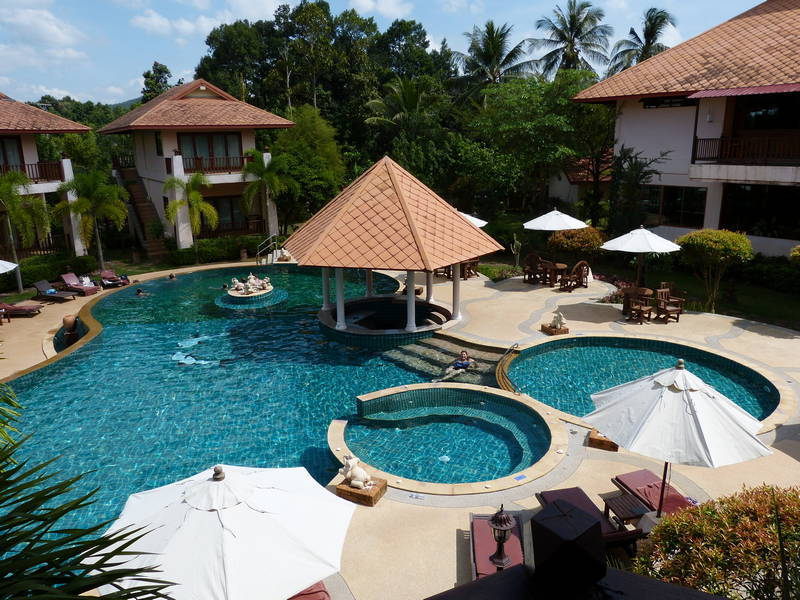
Ao Nang beach is beautiful but a bit of a walk from our jungle retreat
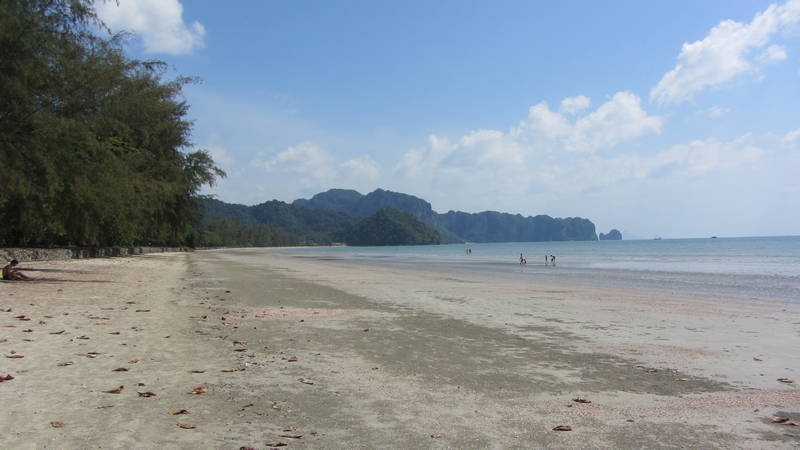

We did take a short trip out to Railay Beach, where the only access is by boat. The long-tail boat ride was fun and then we spent time wandering around the resorts and areas there. The beach itself was quite beautiful with glorious sand and surrounded by limestone karsts. A cave further inland was also fun to explore.
Down to the beach to catch the long tail boat to Railay Beach

Long tail boat has car engine driving the propeller out back, no I don't see a muffler either
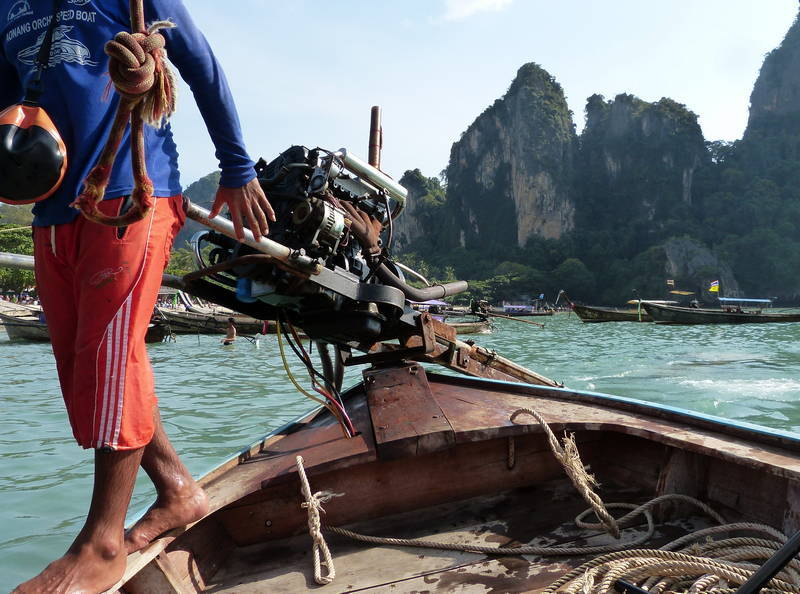
Fantastic scenery just on the boat ride


Tham Pranangnai cave near Railay Beach

Soft, white sand was actually a bit too hot to walk on with bare feet

New Year's Eve day was our last day in Ao Nang and we spent it going on an all-day boat tour to Phi Phi Island. The speedboat allowed us to see a bit more than the slower long-tail boat and provided free showers as the boat pounded through the waves. We were soaked before we even went snorkelling. Because this was high season everywhere we went, the tour was absolutely crowded with other tourists and speed boats. Still, we could appreciate the beauty of the islands we visited with their perfect sand beaches framed by cliffs and jungle. We stopped at a couple of bays and jumped in the warm water to snorkel with the fishes in the deep blue sea. The tour included a trip to Phi Phi Don where a buffet lunch was set up and one could see that this was a pretty slick operation, speed boats coming and going, tourists given set times to visit and then on to the next sight. I think everyone dreams of islands like this, pure paradise, but the reality is that indeed everyone does dream of this so everyone is here, in paradise. Maybe it was just because it was high season but the sensation of being herded along with everyone else was a bit jarring after a week of relaxation at the Andamanee. Another free shower on the speed boat coming back to Ao Nang and then the shuttle bus (a small pickup truck with a bench on either side of the bed) took us to the hotel for a quiet New Year's Eve. My back was quite sunburned, presumably from snorkelling, so I should definitely remember the sun screen next time. The fireworks at midnight were spectacular and we were glad that we could enjoy them from the comfort of our balcony so that we could collapse back into bed, tired from our adventures at sea. 2012 had been an amazing year of adventures (I still can't believe we rode our motorcycles to the Great Wall of China). Who knew what 2013 would bring? One thing was for sure, it was a long way home from Thailand so there were bound to be some more adventures along the way.
On the speed boat headed for Ko Phi Phi and a free shower as the boat pounded through the waves


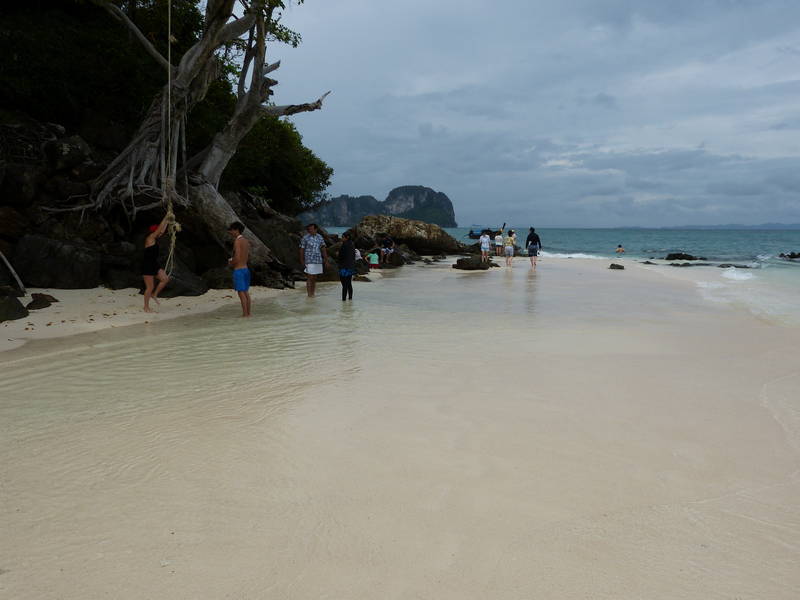
Snorkelling from the boat in a bay was a lot of fun

Breadcrumbs in the water seem to attract the fish
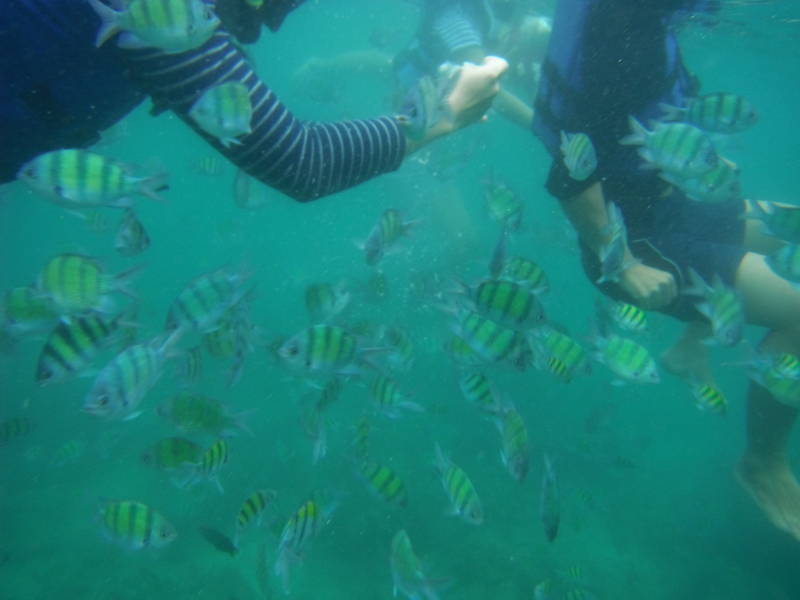
Speed boats lined up along the shore at peak season (location of the movie, "The Beach")

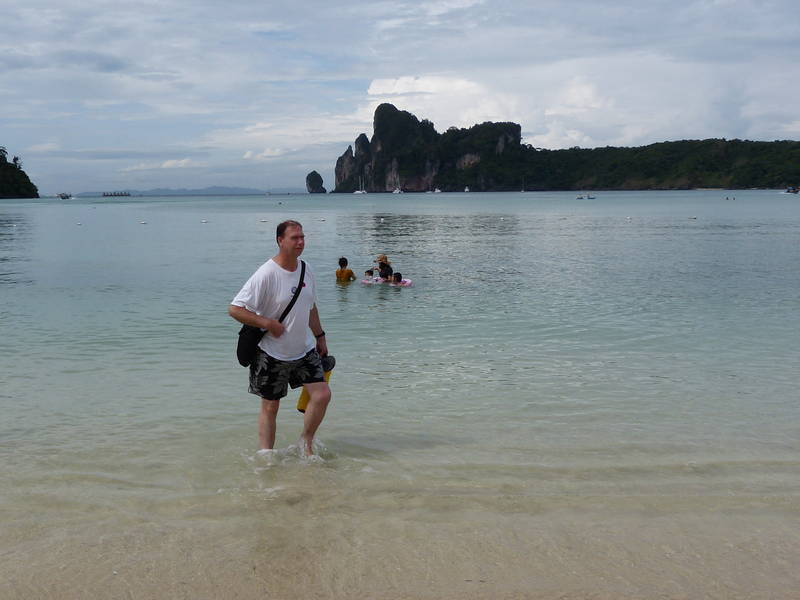
Packed and ready for the New Year

Map of our ride from Singapore to Ao Nang

It was time to move on after a fantastic Christmas to New Year's 'vacation' at the Andamanee Resort in Ao Nang. We had really enjoyed the limestone towers rising out of the ocean, golden beaches, coconut curries, mango smoothies, and swimming in the lovely pool every day. What would the 'real' Thailand be like?
Our route took us through lush forests of banana and palm trees as we wound our way around limestone peaks. We passed by small settlements, the houses usually made of wood. The locals were always smiling and calling out a friendly 'Sawadee Ka' (hello) to us as we rode by. The small, quaint road didn't last for very long and soon we were on a four-lane highway heading north. Traffic moved very quickly and getting tailgated at high speeds was a bit unnerving. The busy road passed by houses and small shops, with vehicles backing out of their driveways right onto the busy road. Scooters often rode the wrong way on the highway, generally out of necessity as there were very few places to cross over to the other side. Sometimes there was a U-Turn place for drivers needing to go the other direction, but U-turning into oncoming vehicles going 130 kph felt somewhat unsafe. We had to do it a couple of times to get to a gas station and then to our hotel. There was a fairly rustic little restaurant that we tried for lunch, and my chicken and rice was so spicy that I could feel the burn for hours afterwards. Ekke found a small road on the GPS which twisted and turned its way through a forest of coconut trees. The road was made of concrete and in great shape and it was fun zooming past scooters, swerving to avoid overzealous dogs that came out to greet us.
Leaving the Andamanee Resort
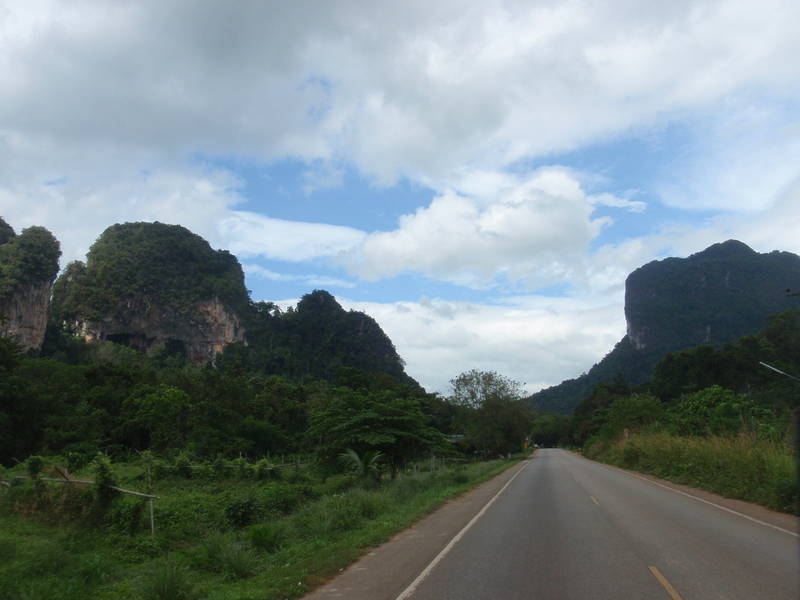
Our wish was to stay at least two nights at every place we stopped while riding north so that we could have a day to get to know the area a bit. We were also easing ourselves back into third-world travel after such an easy time of it in Singapore and Japan. Resorts up the coast were quite reasonably priced, so we booked the Novotel Beach Resort on Expedia. It was a fantastic place with a beautiful pool and we spent ages swimming and relaxing.
Nice bike parking at the Novotel in Chumphon
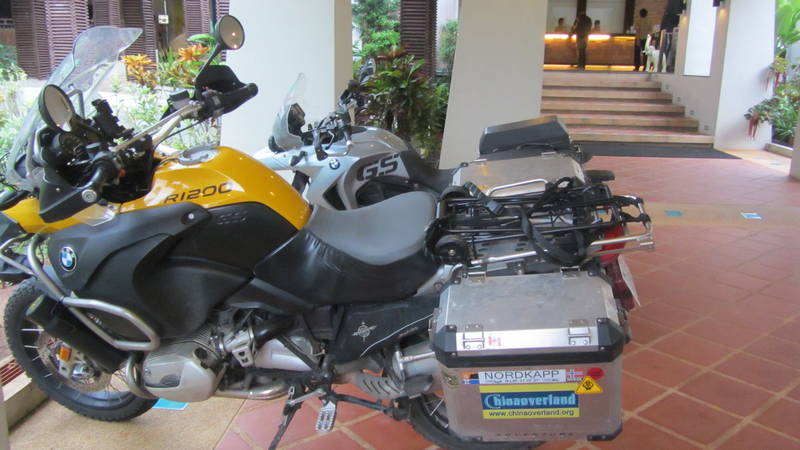
The most interesting thing on the breakfast buffet the next day was the coloured sugar to sprinkle on the fresh pineapple, dragon fruit and banana. It turned out to be spicy sugar and my mouth is still burning. We loaded up on eggs, pastries and pancakes, knowing this would probably be one of our last Western-style breakfasts in a long time. Why take any chances? The sky was a little grey, but we got brave and decided to try the beach across the street. We came down some steps and around the corner and... were hugely disappointed. The beach looked more like the local garbage dump with flotsam and jetsam covering about 90% of the sand. We did try a bit of a walk but were hard-pressed to put a foot down without stepping on plastic bottles, Styrofoam or pieces of wood. Back to the beautiful pool instead. The hotel was a true oasis from the reality outside. Ekke found a Petenque pitch, so we played a couple of rounds. Metal balls were thrown at a smaller ball and not knowing the rules, we just made up our own. I'm pretty sure I won. The tables under a gazebo were a perfect place to settle in and write the Japan website. Planning a day to write is the only way to get it done. You just have to stop travelling every now and then to write about it.
The road north up the coast to Hua Hin was pretty similar to the highway the day before, busy, with many drivers going too fast for highway conditions. We came across a truck overturned on the road, and how it happened I have no idea. But, we made it to Hua Hin unscathed. The city was a busy place, chock-a-block with tourists and locals, tuk tuks and taxis. A huge portrait of the king greeted us on almost every street corner. The royals have been coming here for years, building summer palaces at the edge of the ocean. We rode like the locals, or at least like the scooter-riding locals, splitting lanes and heading right to the front of the pack of vehicles at stop lights. There was a countdown timer on the traffic lights: 3,2,1, go. The result was reminiscent of the start of a MotoGP race, but we usually won, having muscled our way into pole position. The hotel staff greeted us with a cool beverage and cold, jasmine-scented towel, always a welcome sight for dusty motorcyclists. A long, very cold swimming pool awaited us.
Riding north was interesting

Hopefully the driver of this little truck was OK

An ice cold pool is always nice after a hot ride
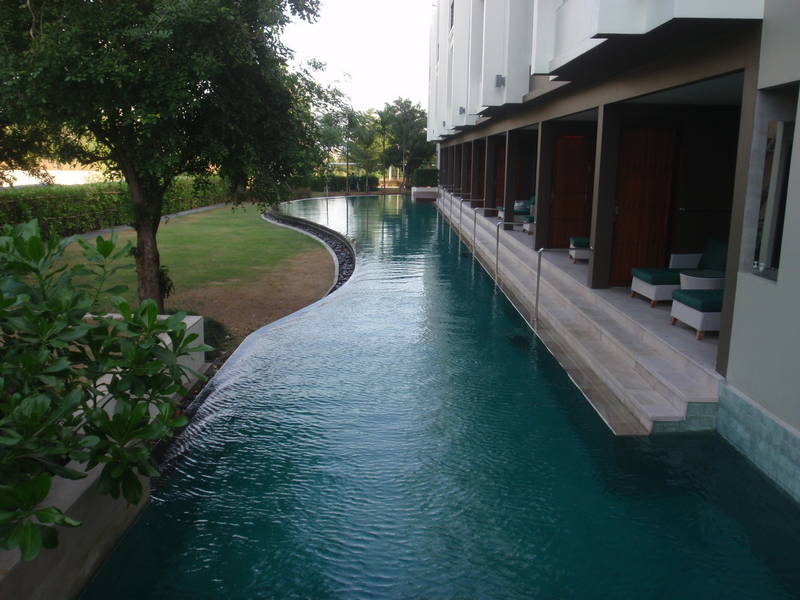
Posters of the King of Thailand were everywhere, even the login screen for the hotel's internet
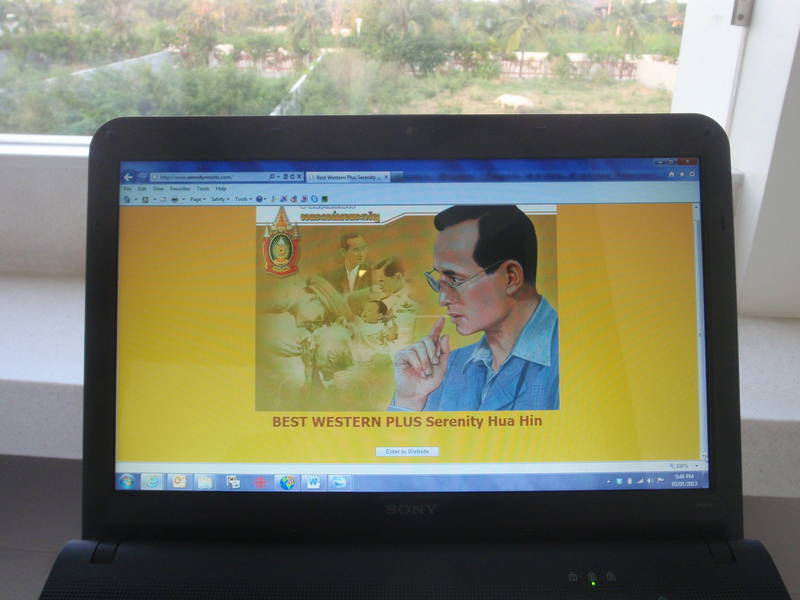
The hotel provided a free shuttle 'bus', really a small pickup truck with some bench seats in the back, to the beach. The main attraction of Hua Hin was its five kilometres of gorgeous crescent beach. It was also relatively close to Bangkok, so it got a lot of weekend visitors. Perhaps half the city was on the beach that day, sitting on rented beach chairs that covered the best of the lovely sand. Waves lapped up against some interesting rock formations and horses with tourists on the back trotted by. The Gulf of Thailand was a perfect temperature and we swam for ages. It was fun getting jostled by huge waves that rolled in with a mighty force. Another pastime was avoiding getting our heads sliced off by the kite surfers doing 360s in the air. What a popular place for this sport, perhaps because of the high winds and big waves. We could only take so much of beach sitting, and we were also feeling the effects of the strong sun. Ekke spotted an Erdinger Weissbier sign which turned out to be a nice restaurant. After some mango smoothies and lunch, we took a long walk around Hua Hin. The local shopping mall still had its Christmas decorations up. We walked to a historic train station which had been converted into Centara Grand Beach Resort with beautiful, lush gardens and oceanside swimming pools.
Hua Hin beach
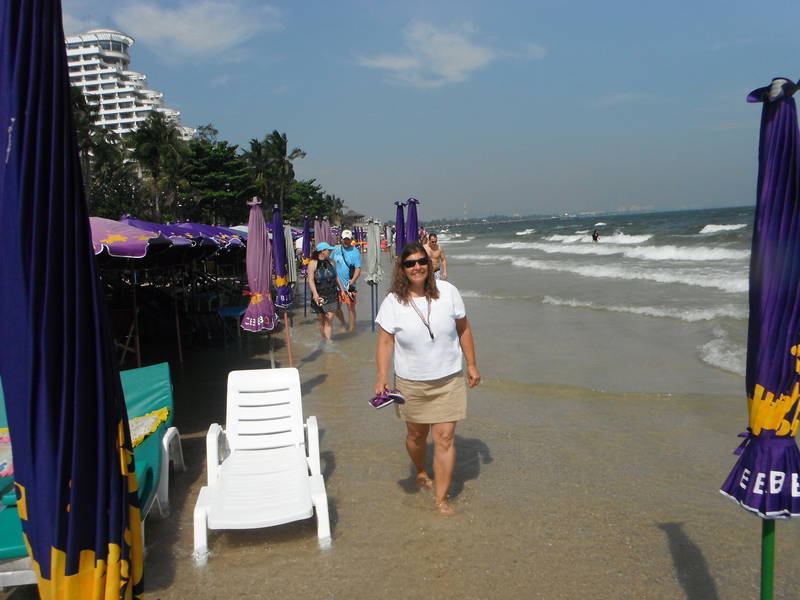
Going for a swim

Kite surfers
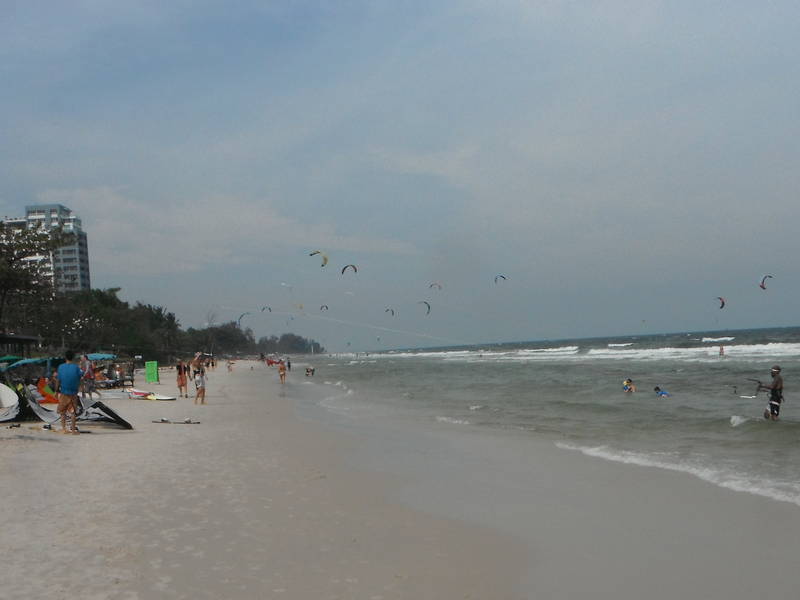
Yummy lunch at a restaurant that serves Erdinger Weissbier
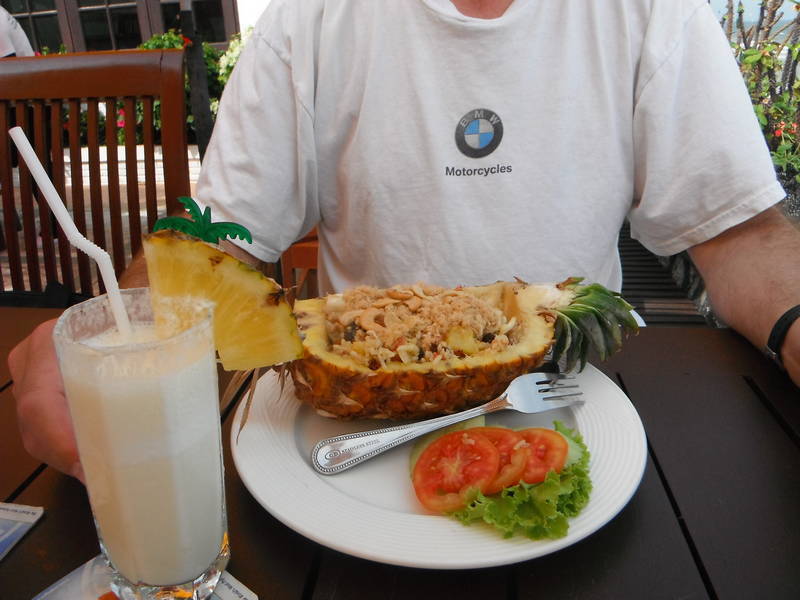
Since this might be our last Western breakfast buffet, we ate up and headed further north, this time inland. There was no time to visit Bangkok as we were on a schedule to be at the motorcycle world travellers' meeting in Chang Mai in about a week. We would visit Bangkok on our way back south, barring any unforeseen circumstances stopping us (foreshadowing). After riding past areas that had been slashed and burned to make way for new farmland, the landscape got more lush and green again. Our destination was Kanchanaburi, a 230 kilometre ride. Booking a hotel the night before was working well for us, and we rode confidently up to the Felix River Resort, knowing that our room and a swimming pool awaited us. The problem with using the internet to book a place was that the pictures of the pricier resorts were so beautiful and enticed us in. And they were not too unreasonably priced for what you got, usually $60-$70 Canadian. What a gorgeous place, beautiful gardens, two pools, and our own bungalow. There were a few mosquitoes about, but we had started taking our malaria pills, Malarone, a few days prior to arriving in this jungly area. The items on the menu at dinner at the Chinese restaurant were very familiar, but did not taste quite as authentic as the real thing in China. Ekke tried the gelatinous dumplings for dessert, and despite the appetizing name, they were not to my taste. Music was playing on the other side of the resort, so our evening walk brought us in that direction. A stage had been set up, and swarms of convention-goers were sitting at tables, dutifully listening to what looked like the big bosses singing karaoke.
Coffee break!
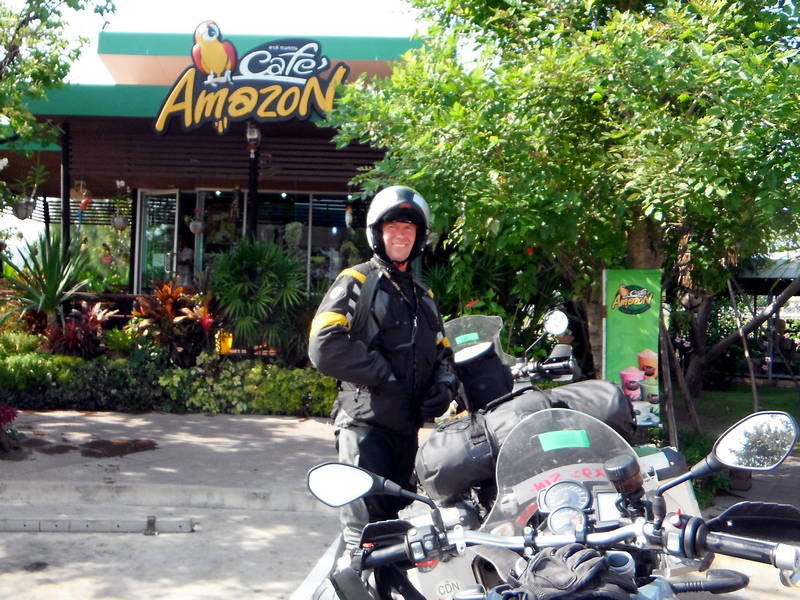
A bridge over the River Kwai

Arriving at the Felix River Resort

Gorgeous grounds
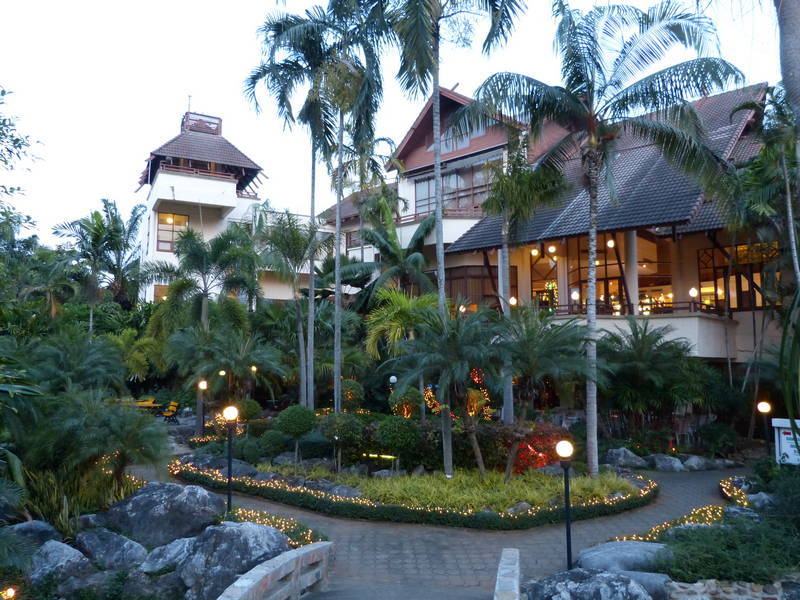
But we didn't stop in Kanchanaburi just for the beautiful jungle resort. The place has a lot of World War II history. American, British, Dutch, Australian and other allied POWs were brought here on trains after Japan captured Singapore. Under terrible conditions with little food, shelter or medical care, they built the 'Death Railway'. It was named thus because 15 000 allies and 100 000 locals died while trying to build it. The story was made famous by a Hollywood film, The Bridge On The River Kwai, starring Alec Guinness, the script based on a book by Pierre Boulle. After the film won a best picture Oscar in 1958, tourists started flocking in to the area to see the famous bridge. The bridge had been blown up by Allied forces and then rebuilt, so the only original parts were the outer curved spans. Also, it crossed the River Mae Klong and not the nearby River Kwai. The author liked the name Kwai better so he used that name in the book. To keep the tourists happy, the Thai government renamed the river 'Kwai'.
Using the bikes like scooters, that is, lower speeds and no motorcycle protective gear except helmets and gloves, we rode into town. A wander through the Allied War Cemetery the final resting place of so many young men who had died far from home, was very touching. The area was extremely well-kept, row after row of graves amidst flowers, trees and a green lawn. The small museum, the Thailand-Burma Railway Center across the street told the story of the Death Railway. A model of a train car showed the small amount of space that 28 POWs had to crowd into, standing room only, to get to Kanchanaburi. Dioramas depicted poor medical conditions, kerosene-laced rice, and 'beds' made of bamboo poles rife with insects. The Japanese were charged with getting this railroad built in record time, and people were worked to death to get it done. Terrible punishments were meted out for any insubordination. Ekke was struck by the fact that, after having just visited Japan with its gentle, polite people, that the military from that society could act in such a brutal manner. Later, we walked over to the actual bridge, a short walk from our hotel, and crossed over the River Kwai. It was super busy, and thankfully, no trains came while we were crossing.
One of the steam engines used on the "Death Railway"
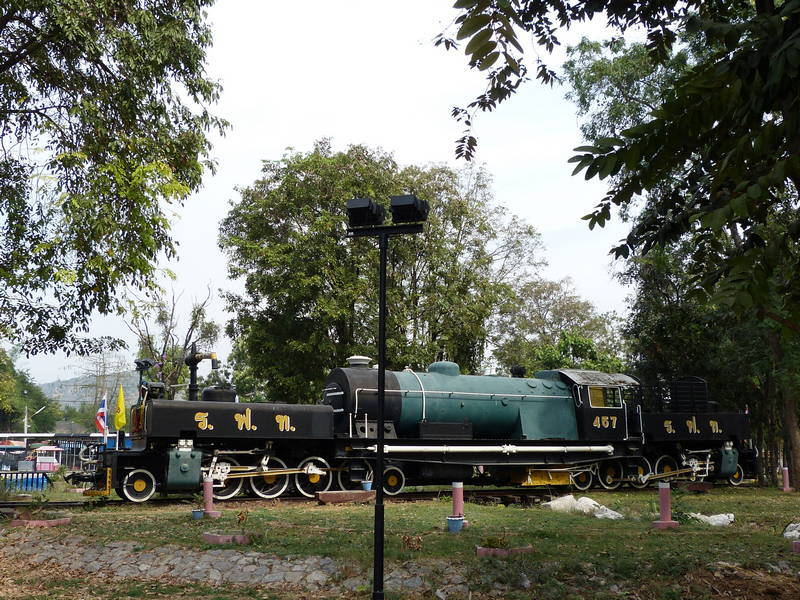

The bridge over the River Kwai as seen from the Felix River Resort

Walking across the bridge

The 400 kilometres to Sukhothai was a pleasant ride on a two-lane highway, past green fields and small forests. We did have to avoid a few head-on collisions. Oncoming traffic expected us to move over onto the shoulder as they passed other vehicles. They also seemed to misjudge our speed, assuming we were scooters, and thought they had plenty of time to pass, which they didn't. Ekke found us some smaller roads as we got close to Sukhothai, and we rode past wooden houses on stilts, surrounded by rice paddies. The GPS showed an ancient temple ruin on our route so we stopped and had a look before heading to the Orchid Hibiscus hotel. This turned out to be a typical 'Boutique' hotel, with rooms decorated with local artwork and artefacts. The price was right at 900 baht or $29. The owner was a very interesting Italian fellow, Paulo, who looked like he came straight out of the 1970s. There were old photos of him playing his Thai equivalent of a sitar, dressed in typical hippy garb. He must have lived there for ages, and he and his Thai wife had built a lovely little resort. As he was checking us in, Ekke happened to notice the date of the Thai stamp in his passport. The expiry date of our Thai visa was... today. We had only been in the country a couple of weeks in total, so how could that be? Paulo insisted that it was a mistake, that they should have given us a thirty day visa when we crossed the border from Malaysia. But the dates stamped in our passports indicated that we only had 15 days. Ekke had checked the bike paperwork upon entering the country and remembered that they had given us 30 days for the bikes. Paulo said there were fines for overstaying a visa, and suggested we go into town the next day, to the police station, to get our visa stamp changed. But it was an iffy thing to do, as they might charge us with being in the country without a valid visa. After doing a bit of research, we decided to ride to Burma (Myanmar) the next day. While many countries of the world have officially accepted the newer name of Myanmar, Canada has not and refers to the country as Burma.
Riding north past one of the many temples in Thailand, all more glittery than the last it seemed
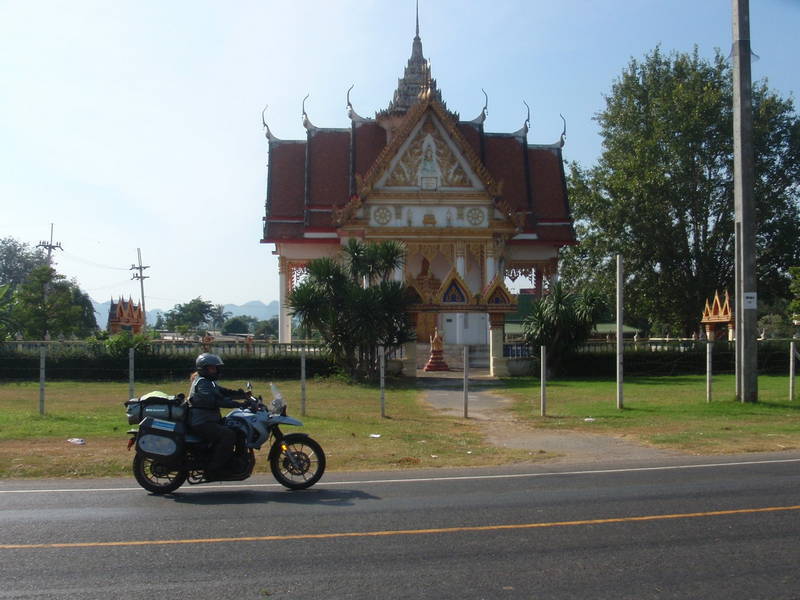
Typical Thai traffic, overloaded sugar cane truck with a pickup pulling out to pass, better move over
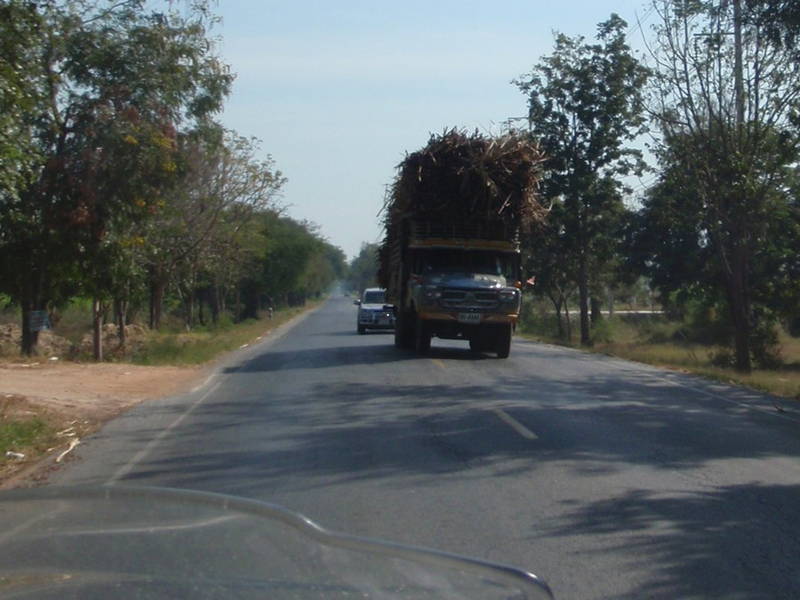
We spotted an elephant and its mahout walking down the sidewalk and had to stop

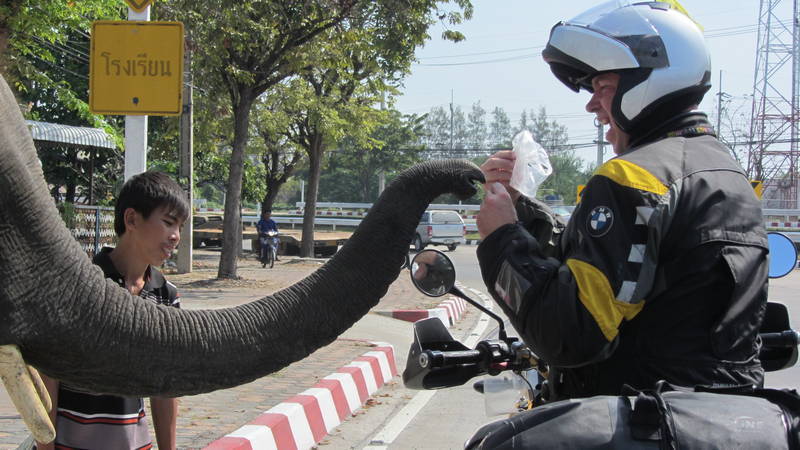

Just outside Sukhothai at Wat Mum Lanka
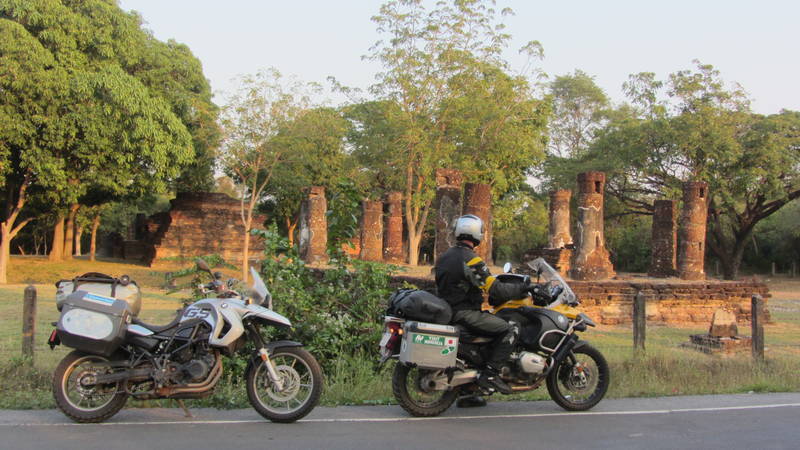
Lonely Planet declared that our hotel, the Orchid Hibiscus, prided itself on its 'incredible breakfast'. As we sat down in the outdoor cafe the next morning, we noticed there was something very strange in the middle of all the tables. It looked like an old log, sitting in some liquid. Paulo brought us some little packages of banana leaves, and unwrapping them revealed some white coconut custard. He told us to slice a banana, put it on top of the custard, and drizzle it with honey. Honey? Oh, so that was what the log centrepiece was: a fresh honeycomb. It really was incredible. The meal was rounded off with some eggs and toast and then we were one our way. It was only 150 kilometres to Burma where we could cross the border, renew our visas upon entering back into Thailand and be back in time for afternoon tea. So, riding with visas that had expired the day before, we headed west. After passing through several towns on a fairly straight road, we started climbing into the mountains. The paved road became wonderfully twisty, and we leaned into the curves with joyous abandon. There were many slower vehicles on our route and the bikes easily overtook them. Oh, the power of BMWs. Occasionally a suicide lane appeared, a third lane in the middle meant for passing slow vehicles while climbing up into the hills. Often vehicles coming toward us thought, erroneously, that it was their lane, so we had a few close calls and had to be careful when using that lane.
"Incredible Breakfast" at the Orchid Hibiscus

It was really warm when we reached Mae Sot, the Thai border town. As we approached the border post, I heard a clunk and my bike would not move anymore. My chain had fallen off. I really had to get into the habit of checking the chain tension, but it was on the right side of my bike, where I could generally ignore it. Ekke rolled the bike to a shady spot, and a small audience watched his every move as he put it back on. No harm done, but I'm glad it happened in town, at slow speeds.
Re-installing the chain at the Thai - Burma border
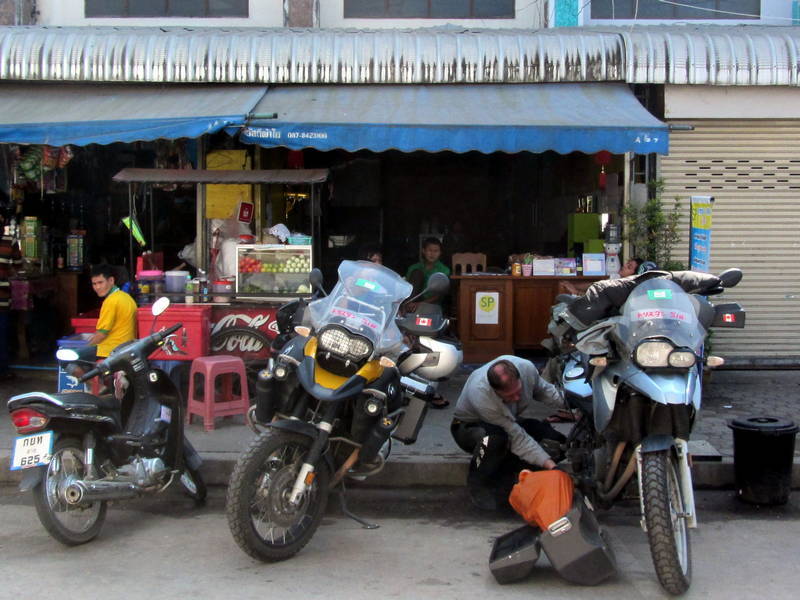
At the Thai passport control office, we asked if we could take our bikes over to Burma. No. Then, the border official noticed that our visas in our passports had expired the day before. Really? The fine was 500 baht ($17) each. I tried very hard to argue our way out of it, of about how they should have given us a 30 day visa at the Malaysian border, how our motorcycles were valid for 30 days, but no luck. We paid the 1000 baht. The official also explained that for every day our visas were invalid, we would have had to pay the 500 baht. Good thing Ekke noticed the expiry date when he did. We had visions of leaving Thailand in two weeks with 14 000 baht ($484) worth of fines for invalid visas. Phew. We did check our guidebook later for what the rules are for land border crossings. While issuing 30 day visas at Thai international airports, they do just issue 15 day visas at land border crossings. Never assume that if your bikes can stay in the country for 30 days that you can, too.
So, we walked across the Friendship Bridge into Burma after parking the bikes just near the border post. The friendly folk at the Burma border post kept our passports and said that we could pick them up when leaving the country later that day. We were immediately struck by all the evidence that this really was a third-world country. Garbage lined the riverbank, sidewalks and buildings were crumbling, many people were begging, stray dogs were running around, and overall, people looked impoverished. But, it was a border town, which are often notorious for having a wide variety of 'characters' so perhaps the country was different further inland. Young men sat at tables on the sidewalks with stacks of local currency, the kyat. We changed some Thai baht into kyat and continued to walk up the street. We wanted a cold drink but it was difficult to find a place that had a refrigerator. Eventually, we found a little place with a few tables and some cold pop. A monk was just sitting down and we chatted for a bit and offered to buy him a cold drink. He accepted but took hot tea instead. He explained that he was on his way to a hospital in Thailand. He also showed us a picture postcard of a beautiful temple at Sukhothai and suggested we visit it at sunset. His Burmese accent made it difficult to understand what he was saying, but he chatted for quite some time. He gave us the postcard as a gift when we were leaving and we gave him a Canada pin in return.
Going for a walk in Burma
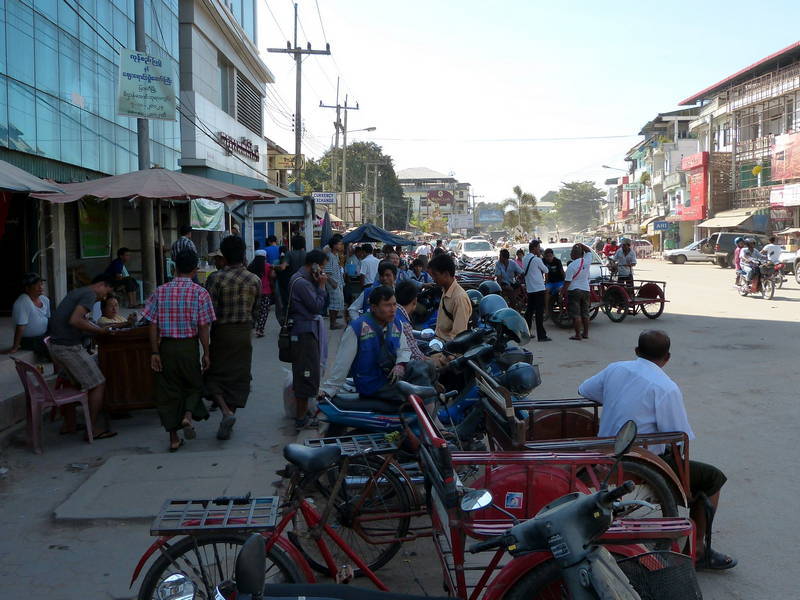
Or did we just enter the set for another "Mad Max" movie?
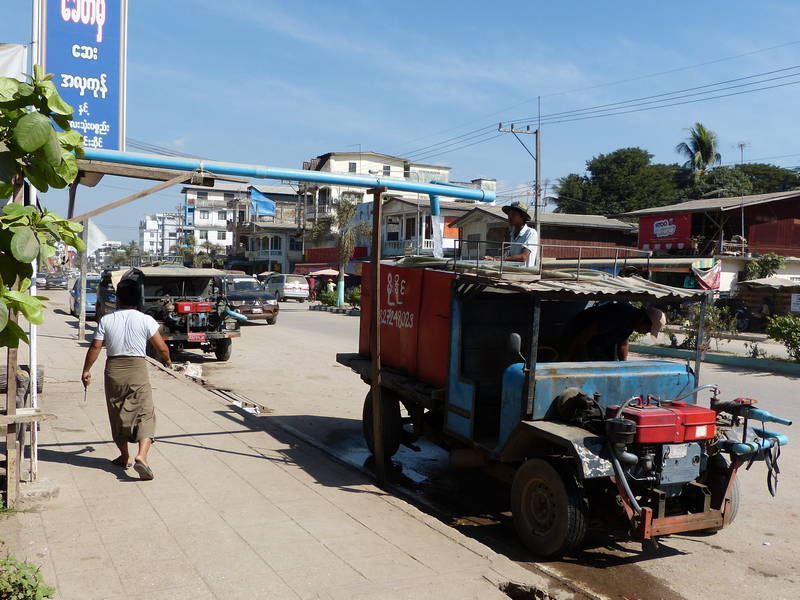
We meet a friendly Burmese monk and talk over a beverage
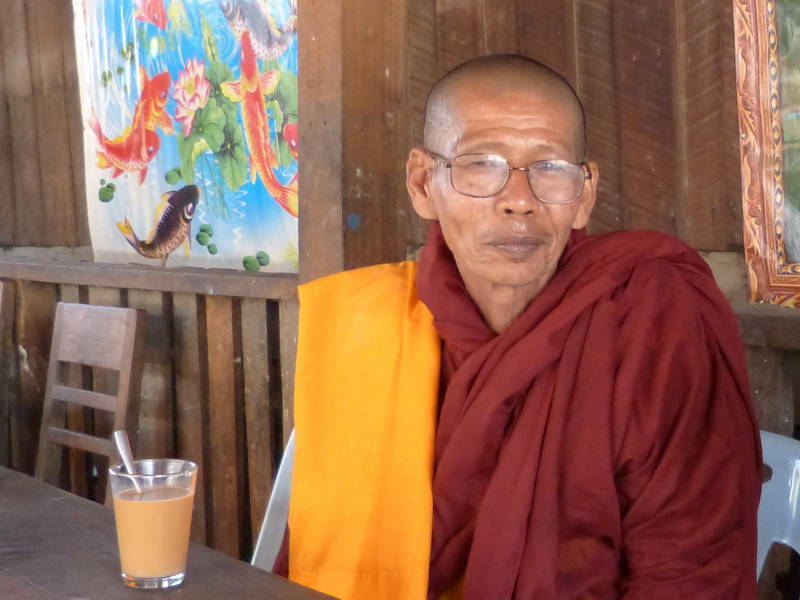
With a 150 kilometre ride ahead of us, we had to make our Burmese visit short. We retrieved our passports and walked back across the Friendship Bridge. The amount of pedestrians crossing back into Thailand was way more than when going into Burma. A huge lineup at the Thai border post greeted us. It looked like the wait would be at least an hour to cross the border. We decided to go to the front of the line and there we saw a special window just for foreigners. It was easy to get a new Thai visa, valid for 15 days, free of charge, jump on the bikes and be on our way. LP suggested the Canadian cafe for lunch, run by an expat Canadian. The menu was had very familiar items on it, like poutine and A&W Rootbeer. The curvy road was very fun going down, and we made it into Sukhothai at dusk. Nearby temples were lit up and we got the tripod out and took some photos.
Back in Sukhothai for sunset
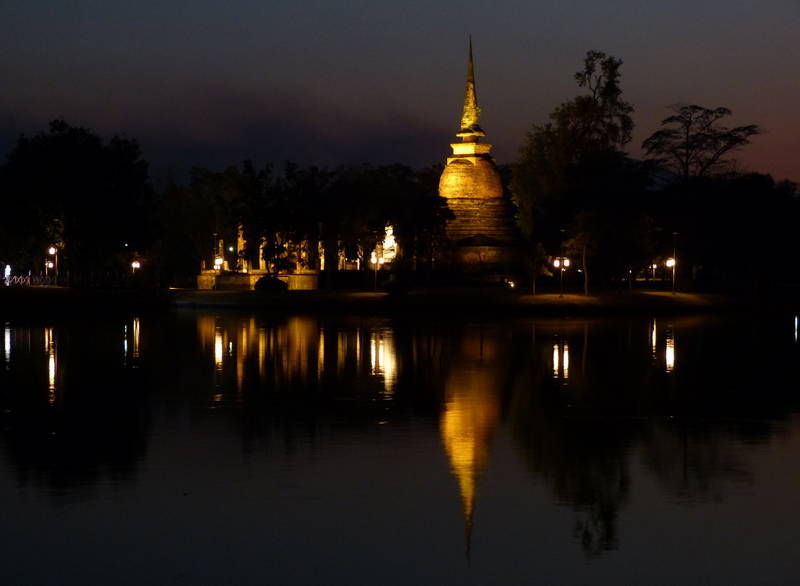
We parked at our favourite little cafe for dinner. As we were leaving, a couple of women came in and were smiling at us. Then, three guys came in and said hello, that we must be the motorcyclists. They had seen our bikes parked outside. Ekke looked at one fellow and said, "Are you Tom?" He said yes. I said, "Big Tom?" He said yes more emphatically. We had read (Austrian) Big Tom's website about his trip through India, Nepal and Tibet on his BMW 1200 Adventure and had lost track of him when he rode through China to Laos. And here he was. The other fellows were also motorcycle adventure travellers, Heiko from Germany on a BMW R100GS with a sidecar, and Bryn from New Zealand on a BMW R100R. One lady was Cuki, who rode a Honda Transalp, and her mother (Cuki-Mama) who was on holiday from The Netherlands. We sat down again and immediately got questioned about where we were going, where we were coming from, how long, etc., and also learned about their travels. They were on their way to the Horizons Unlimited motorcycle travellers meeting in Chiang Mai, just like us. Tom suggested we all meet and ride there together in two day's time.
After an incredible breakfast of coconut custard again, we scootered on our motorcycles over to the Sukhothai Historical Park, a World Heritage Site, the next day. Once inside the gates, we rode around to the various archaeological sites. Sukhothai was the capital of a huge kingdom, starting in 1238 and lasting for 200 years, Thailand's golden age. Wat Mahahat, with 198 chedi or towers used for meditation and the storage of relics, was one magnificent temple. We watched groups of schoolchildren running around it, enjoying the different levels, nooks and crannies. The Buddha statues and chedi here are quite well-preserved and indicative of Sukhothai's contributions to the art and culture of Southeast Asia. What a pleasant morning we had, riding around to several of the ruins. We crossed a footbridge to Wat Sa Si, a simple temple on a little island. As we were wandering around, we saw someone looking closely at our motorcycles and taking photos. It turned out to be Bryn, and we chatted about the temples we had seen and about meeting the next day for our ride to Chiang Mai. Si Chum temple was a few minutes' ride away on the bikes. The Big Buddha peeked out from between the temple walls; its right hand covered with thin gold leafs that were rubbed on by practising Buddhists. Some smaller roads took us out into the countryside where we watched the sun set over Wat Chang Lom, the Elephant Circled Monastery.
Riding around the temples of the ancient city of Sukhothai
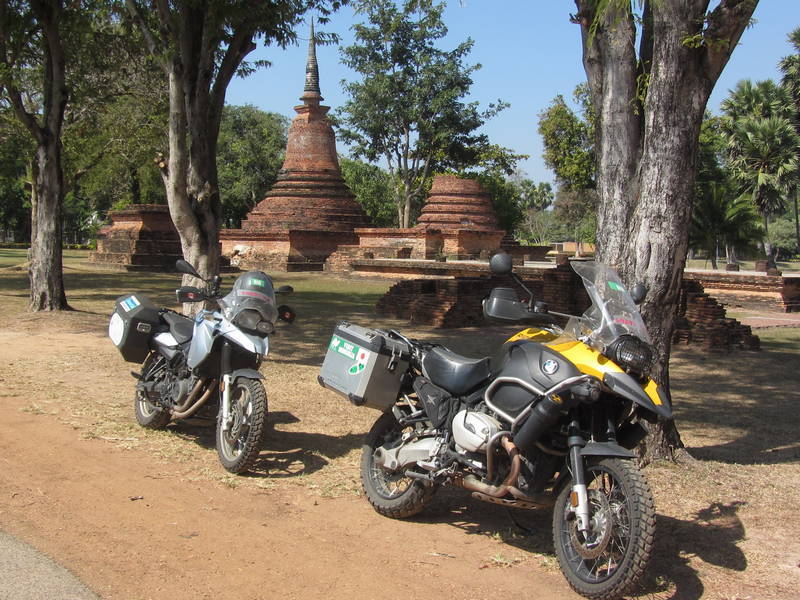

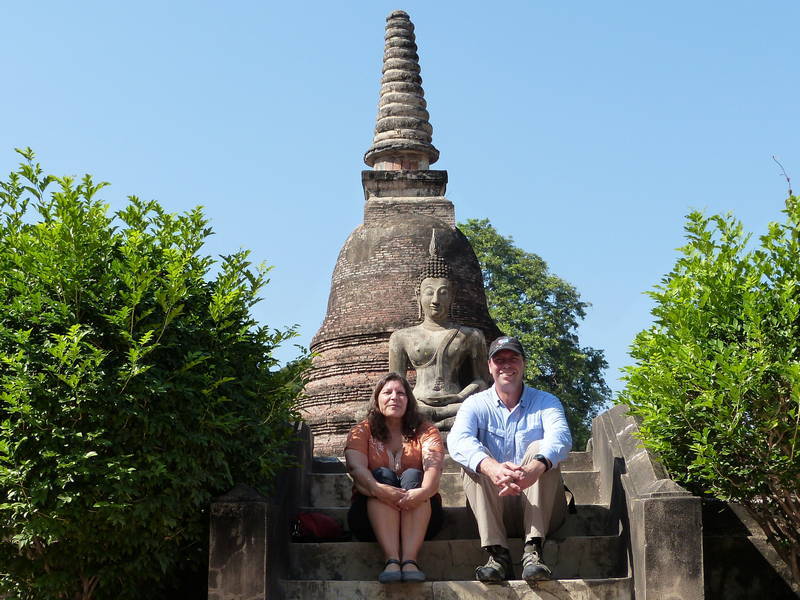
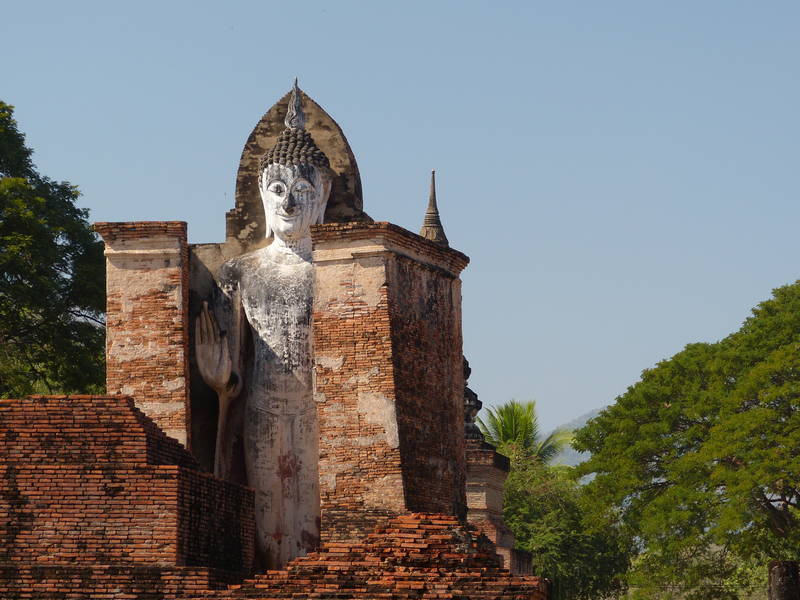
Kids will be kids

Definite Khmer influence
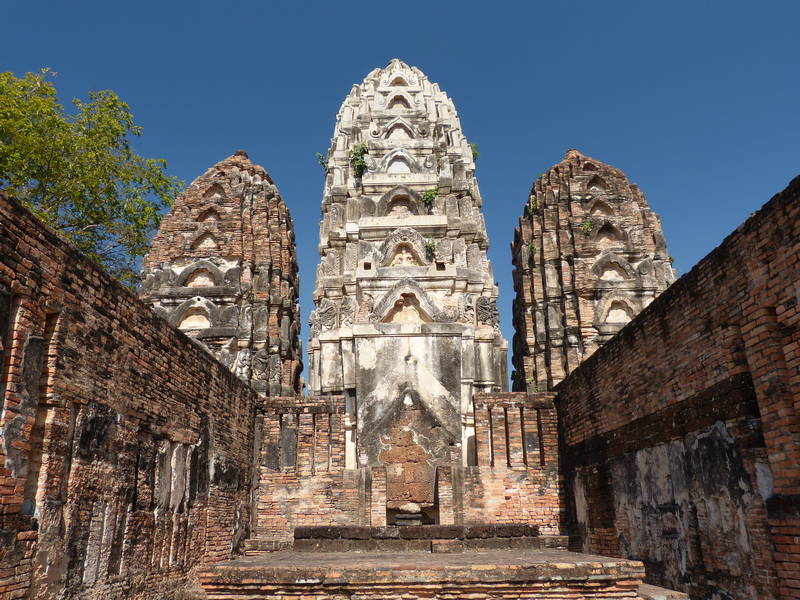
What a great place for wedding photos

Tom, Cuki and CukiMama rent bicycles to tour the historic site

Sunset at the temple recommended by the Burmese monk


Ekke writes:
We enjoyed our last "incredible" breakfast by taking a second helping of the banana drizzled with honey, cut up on top of coconut custard laying in a banana leaf. It is worth going to Thailand just to come to the Orchid Hibiscus for their breakfast, it's that good. Tearing ourselves away we rode into town and met Tom, Cuki (Cuki's mom was already on a bus headed for Chiang Mai) and Bryn at the same coffee shop where we had met on Tuesday. Over a cappuccino we discussed possible routes north to Chiang Mai and decided to take the smaller, country roads. This was a great choice as there was very little traffic and we could relax and enjoy the ride. Just before crossing the busy Highway 1 (the direct route to Chiang Mai) we stopped at a roadside restaurant for a big bowl of noodles and meatballs. I had really enjoyed the morning's ride, which surprised me as I normally don't like group riding. Highway 106, west of Highway 1, went up into the hills and soon the road became more entertaining as we were thrown a few curves. We really had a blast and considered going even further afield on another side road but stuck to the 106 as we didn't want to arrive after dark. The last 20 kilometres was hot and slow going as we got caught up in the traffic of Chiang Mai and its suburbs. Eventually we made it to Rider's Corner, the bar where the Horizons Unlimited mini-meeting was to be held, and then went to our nearby hotel to check in. The parking lot was around the back and the bell hop struggled to give us directions through the maze of narrow streets. I suggested that he jump on top of the duffle bag and give us directions from the back of my bike. He seemed to get quite a kick out of the experience. Back at Rider's Corner for dinner we had an opportunity to chat with Cuki's mom (who took the bus from Sukhothai) was visiting Thailand from the Netherlands. They were from Venlo, Limburg, very close to where I was born and lived the first seven years of my life before my parents immigrated to Canada.
Meeting Bryn at the coffee shop in Sukhothai

Group riding north

Rice paddies just getting started
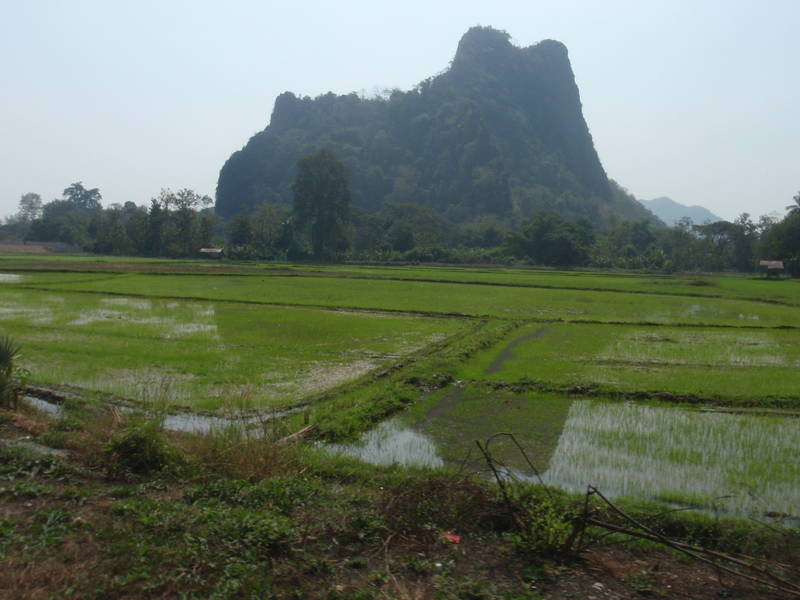
Lunch break
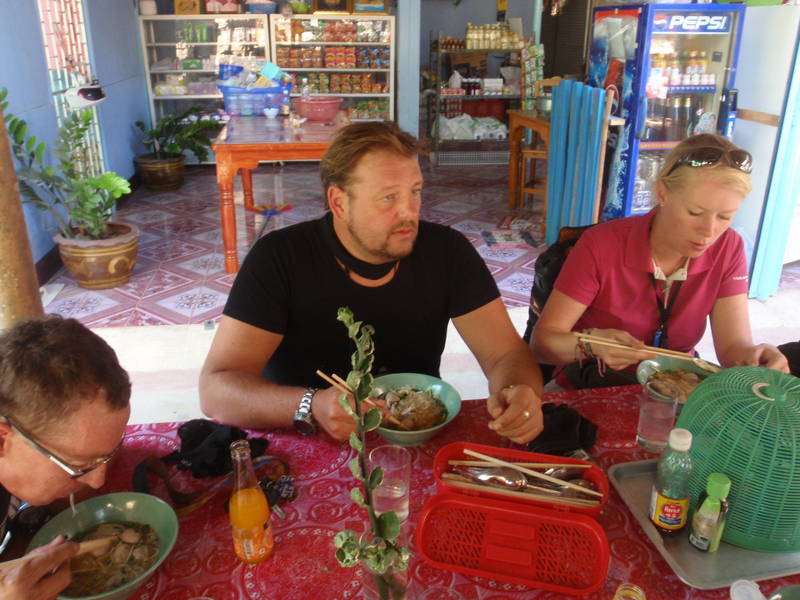
The road becomes more interesting west of Highway 1

It is a blast travelling with Tom
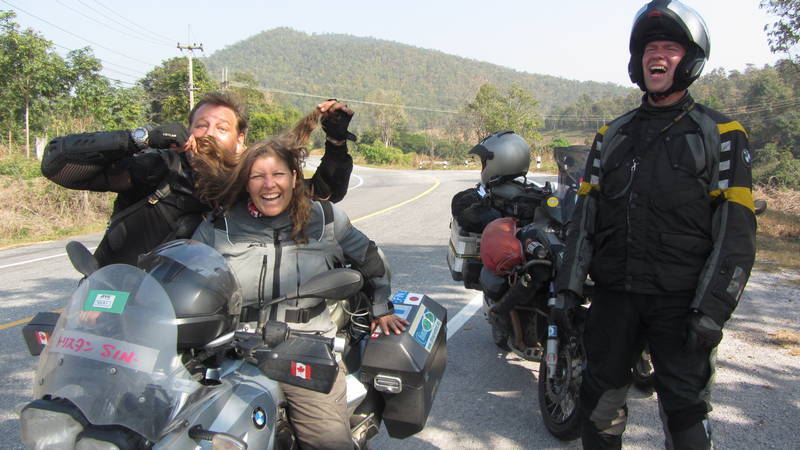
Checking out one of the many temples along the way

Cuki and Tom

The group lined up for an afternoon break
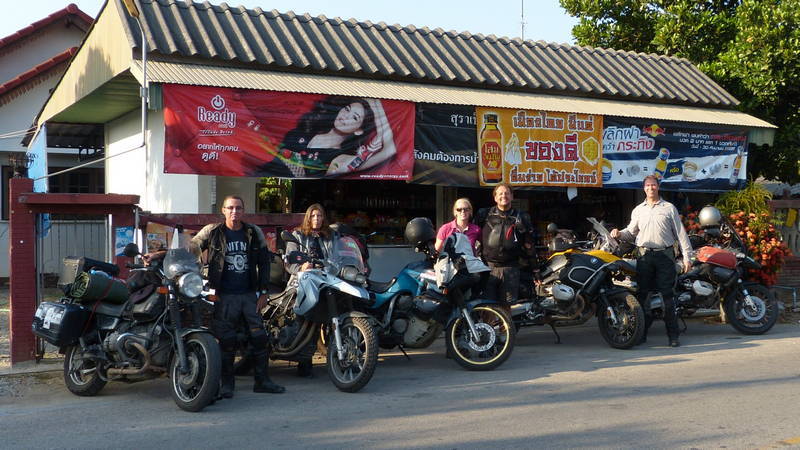
Cuki in the traffic leading up to Chiang Mai

Bellhop gives directions to the parking lot perched on Ekke's duffle bag

Friday was an opportunity to get caught up on laundry as well as getting the new chain and steering head bearings (brought from Japan) installed at the Brit Bike shop. With that out of the way we spent a great evening at the Horizons Unlimited meeting at Rider's Corner, chatting with other world travellers and locals alike. Heike and Fillipo did a great presentation on riding across Iran and Pakistan and then Heike and Jeorg did a presentation on the first ride ever in Myanmar (Burma) with big motorcycles. The country is slowly but surely opening up and with any luck one day it will be possible to ride across Myanmar to India, cutting out either the flight over the country or riding all the way around it by going through China.
A few of the bikes lined up at Rider's Corner
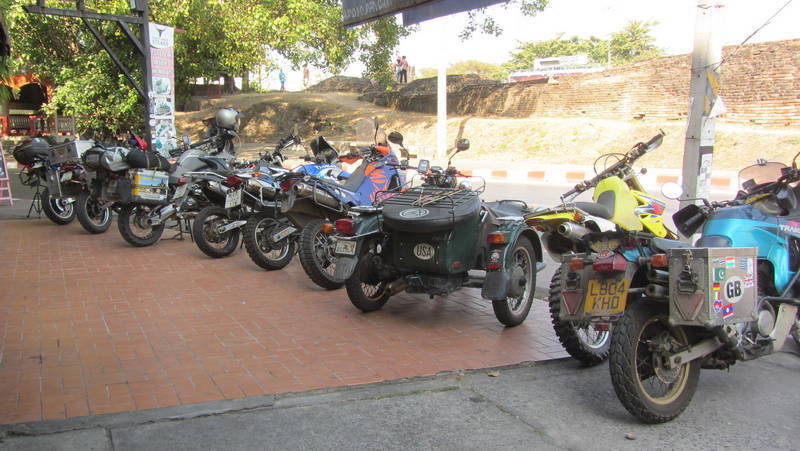
Sylwia is quite fond of her yellow F650GS

Heike giving her presentation on their ride through Iran, Pakistan and India
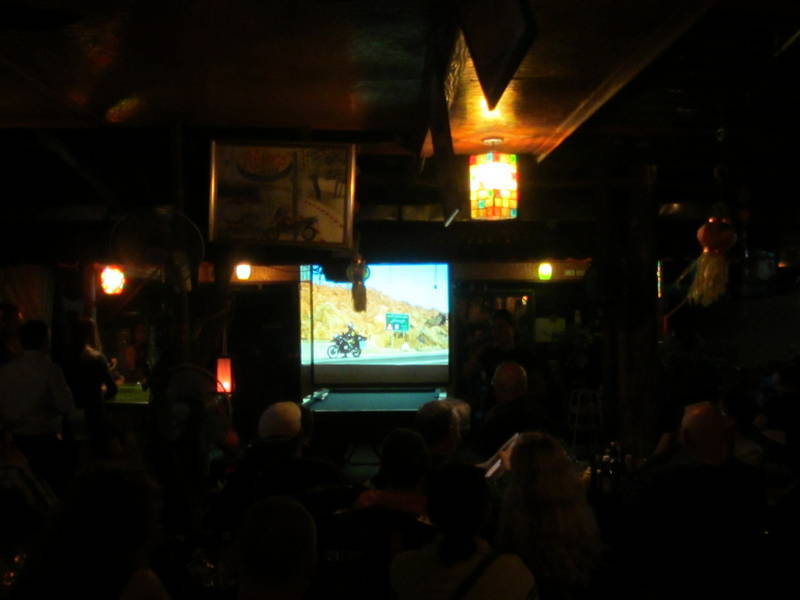
On Saturday we were scheduled to give a presentation in the evening so spent some time polishing our Africa slideshow. We thought that the Africa presentation might be a bit different from the normal presentations done here and besides, we weren't quite ready to give a presentation on our ride across Russia and China. It took quite a bit of cutting to get the number of slides down to a manageable amount so that we could complete the presentation in the allotted 45 minutes. A group photo in front of Rider's Corner at 2:00 PM allowed us to meet some of the evening's audience and then at dinner time Rider's Corner put on a fabulous BBQ. The first presenter had a great sense of humour so we had a tough act to follow and as the bar was open to the street there was also quite a bit of traffic noise. Still, it seemed that the presentation went well and we weren't booed off the stage. Richard, the third presenter wasn't as diligent in keeping to the 45 minute time limit but the presentation on the misadventures of his trip to China was interesting enough that Rider's Corner offered to let him come back on Sunday evening to finish up. As was usual with HU meetings it was just wonderful to talk with other travellers, sharing adventures and getting information for the rest of our trip, both in S.E. Asia and further along to Nepal, India, Pakistan and Iran.
Sunday morning we phoned MasterCard as for some reason our cards weren't working. It seemed that the PIN numbers had been compromised, probably at a gas station where they weren't used to the chip cards. We were promised that new cards would be delivered to the hotel within a couple of days so we booked two more nights at the Eurana with its lovely pool. At 10:30 Dr. Gregory Frazier arrived on his Kawasaki KLR and we went to a restaurant for brunch while he interviewed us for an upcoming article. Greg is an author of numerous books, organiser of the HU mini-meeting in Thailand, has gone around the world five times and is one of our "road heroes". We had seen him give a presentation at a BMW MOA rally in 1999, providing at least some of the inspiration for our own world travels so it was a real pleasure to meet him and listen to his stories. That evening we returned to Rider's Corner to hear the rest of Richard's misadventures in China. The Chinese government had changed some rules regarding travel in China while Richard was enroute from Europe. All of his plans had to be changed as he could no longer ride across China to Laos, instead having to exit to Mongolia and then come down the same way we had come via Ulaanbaatar and Erlynhot. To compound the troubles, he then had to contact all the other travellers that were joining him on the tour (to help defray the costs of hiring the guide and driver) while they were enroute to China. Then, as he was in Ulaanbaater (about a week after we came through) he got a message that the tour was cancelled completely and they would not be allowed to enter China. What really brought Richard's troubles into focus for us though was the sudden realisation that we had communicated with Richard about a year ago via Horizons Unlimited about joining him on his trip. In the end we had decided that being in Laos in October wasn't good for us as we still would want to go to Japan and India, opposite directions from Laos. So we let him know that we would not be joining him but it could very well have been us as part of Richard's misadventures.
Monday we did a bit of sightseeing in Chiang Mai as we waited for our new MasterCards to arrive. After finishing up a Japan chapter of the website we then walked to Wat Phra Sing via the UN Irish Pub. The Guinness beef pie was delicious. Wat Phra Sing at the opposite side of the central part Chiang Mai from our hotel was a large temple complex of beautiful buildings. A lot of young monks walking around in their saffron coloured robes (and lined up at the nearby 7-11 buying chips) made the temples much more colourful and lively. Back at the Eurana the MasterCards still hadn't arrived so we arranged to stay another day.
Scooters seem to be a popular form of transport in Thailand

Young monks at Wat Phra Sing

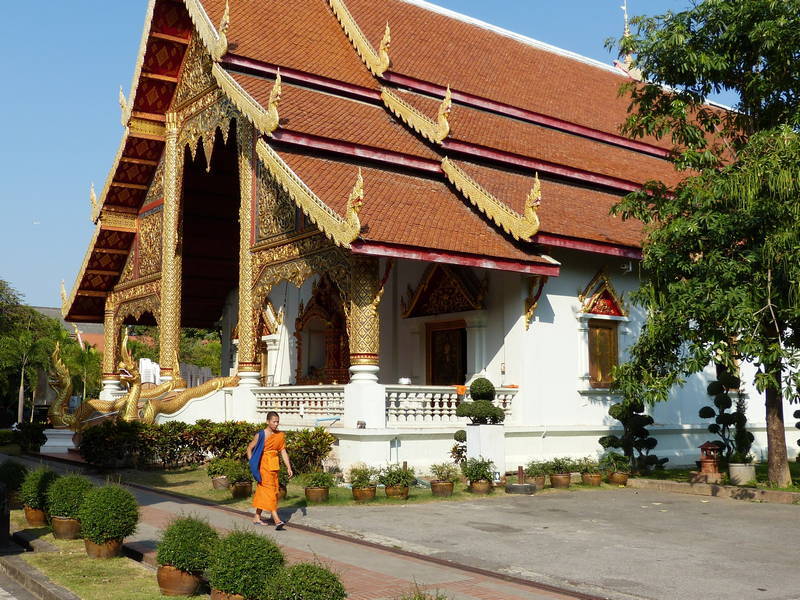
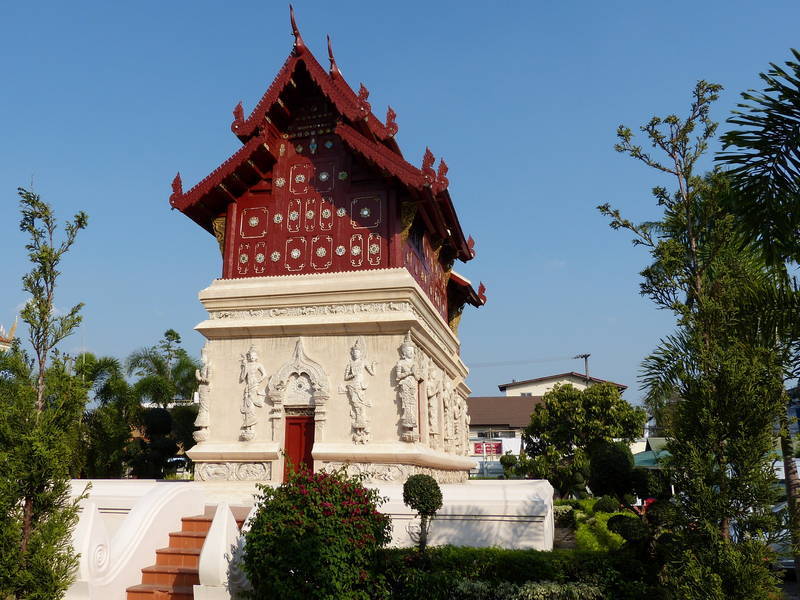
Beautifully polished image of Buddha
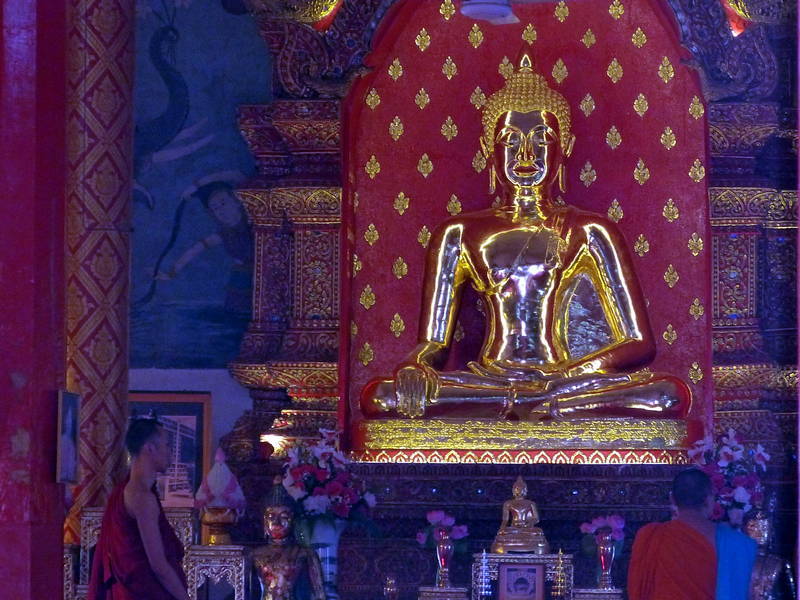
Not Lord Buddha but rather monk Tan Pra Maha Kajjana, an arahant (or enlightened one)
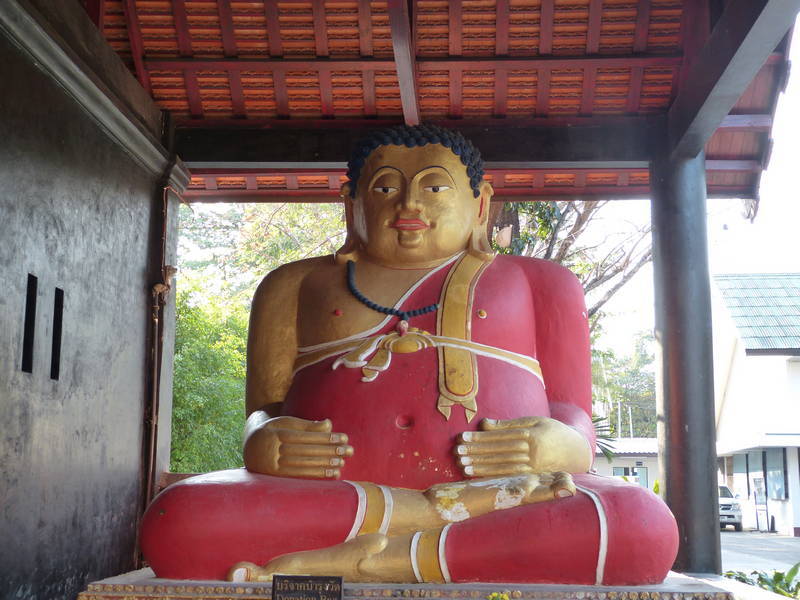
Reclining Buddhas are the best
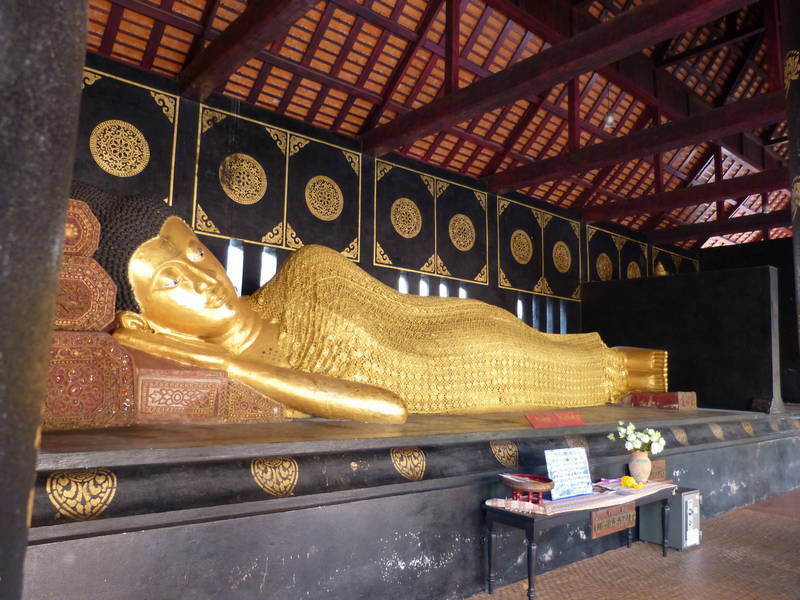
Wat Chedi Luang
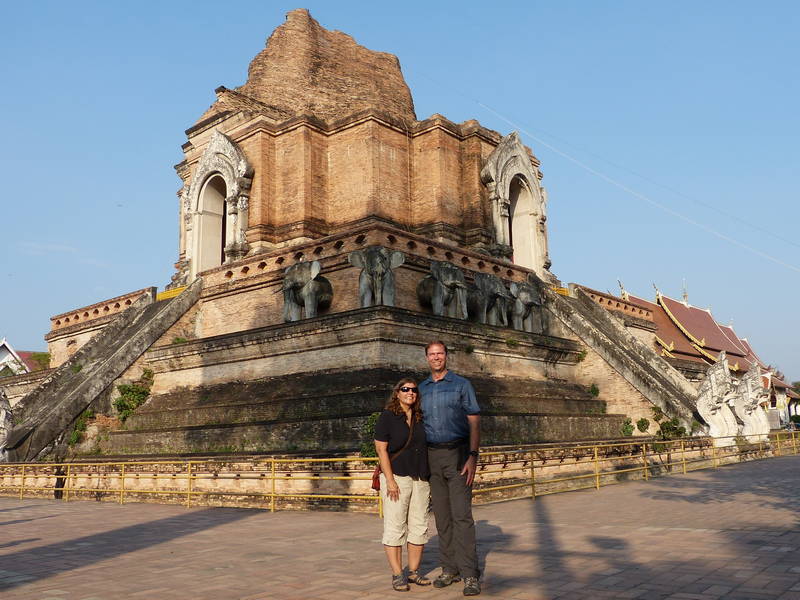
For a donation one can bang the gong
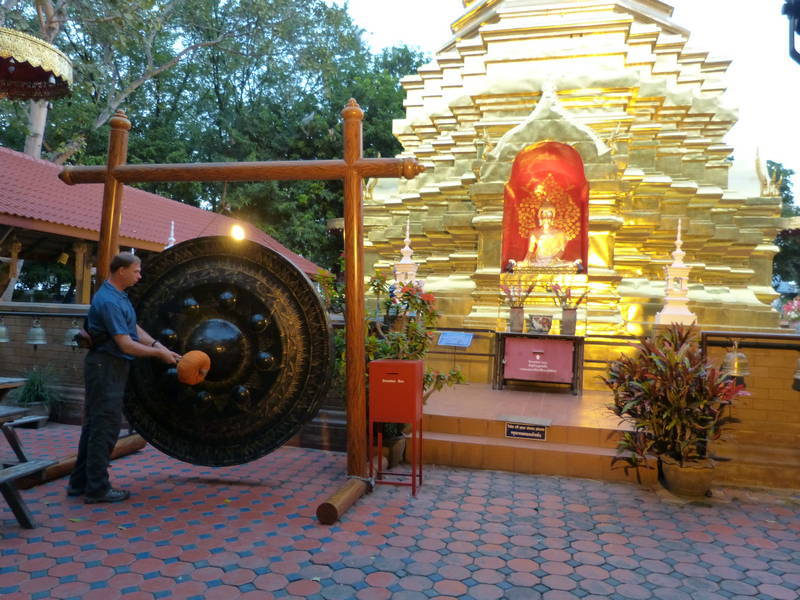
It was good that we stayed in Chiang Mai an extra day as on Tuesday Audrey discovered that a filling from one of her front teeth had dropped out. Chiang Mai is a medical tourism destination of sorts so it was no surprise that we found a few dental clinics nearby. The Big Smile Dental Clinic had the best name so we walked over to their office and Audrey was able to get in right after lunch. While I downed a couple of smoothies in a nearby café Audrey had a new composite resin filling installed for the amazingly low price of 700 baht. I don't think you could even walk into a Canadian dentist's office for $25, never mind getting anything done. And the workmanship was beautiful, perhaps even better than the original filling done in Canada. Back at the hotel the MasterCards had arrived as well as an e-mail from Voyage Vietnam, the tour company that we had contacted regarding riding our bikes in Vietnam. Like China, special paperwork is required to bring big bikes into Vietnam and we had arranged with Voyage Vietnam to meet us at the border to do the paperwork. The e-mail said that since we were planning to ride in Vietnam during Tet (Lunar New Year), when most Vietnamese take to the road heading home to visit family, they were concerned for our safety and suggested that we take the guided tour rather than ride on our own. The cost for the guided option was quite expensive so we really had to think about it.
On Wednesday morning, before leaving Chiang Mai, we e-mailed back and forth with Voyage Vietnam about the tour options. In the end, we took their advice and signed up for an escorted, all-inclusive tour albeit shortened from our original plan to cut the costs a bit. We then e-mailed copies of all the documents they needed (except for the Vietnam visa which we didn't have yet) and rode over to a bank to transfer the deposit to their bank in Vietnam. By 1:00 PM we left Chiang Mai and rode up to Doi Inthanon, the highest point in Thailand. Being over 2,500 metres high meant that we were now above the perpetual haze that always seemed to plague lower Thailand and could enjoy true, blue skies. It also meant an escape from the warmth as the temperature dropped to 13 Celsius. We dropped down the mountain and then headed west into the setting sun. The road twisted and turned, with the occasional rough spot to keep things interesting. By 6:30 PM it was dark and we weren't looking forward to dodging potholes on the twisty road. Fortunately we turned right on Highway 108, north to Mae Hong Son, and the road was in perfect condition. New asphalt, bright painted lines and very little traffic. The twisty road was so much fun to ride that we temporarily suspended our belief that riding in the dark in a foreign country should be avoided at all costs. Arcing through corner after corner without the pesky distractions of gorgeous scenery made this a veritable playground for us. All too soon we arrived at the point where the GPS indicated the Fern Resort should be but there was no resort to be found. We rode up and down the highway, stopping to ask various people if they knew where to find it and eventually backtracked about ten kilometres where a small, unlit sign pointed down a narrow road. Then three or four kilometres riding down the narrow lane brought us to the entrance of the eco-lodge. As soon as we took off our helmets and removed the ear plugs we heard a familiar sound. Almost like drums but not quite. We couldn't quite place it. After checking in we followed the bell hop through the garden to our bungalow and saw the source of the sounds we had heard. Just like the heritage park Hida no Sato near Takayama in Japan, bamboo tubes were placed in small streams and as they filled and tipped over they made a characteristic banging sound. At Hida no Sato these were used as scarecrows so we wondered what they were scaring off here. With the hotel's restaurant closing at 9:00 PM we quickly dropped our stuff in the bungalow and hustled over to grab a bite to eat before returning to the bungalow to collapse into bed. Thank goodness someone disconnected the bamboo scarecrows and the banging didn't go on all night. On the other hand, did that mean various and sundry animals would now be free to come into the garden?
Filling up on the way out of Chiang Mai
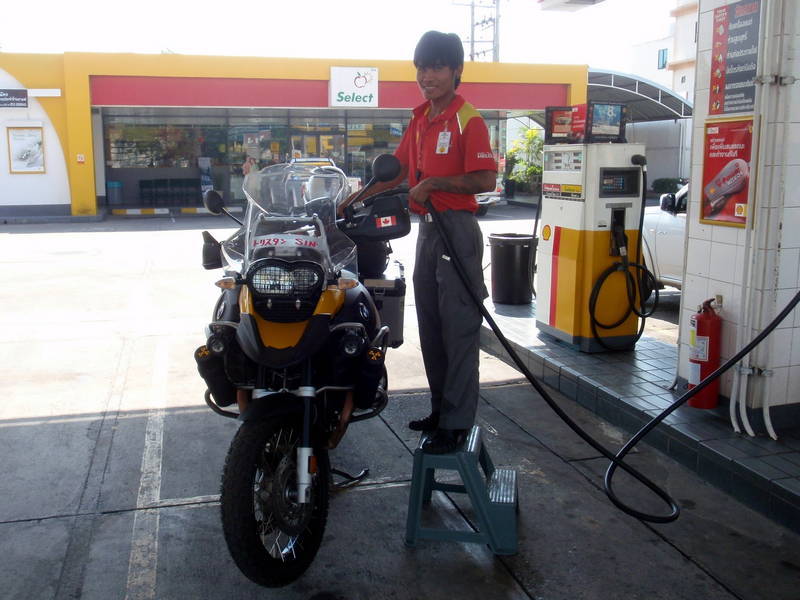
Beautiful temple near the top of Doi Inthanon
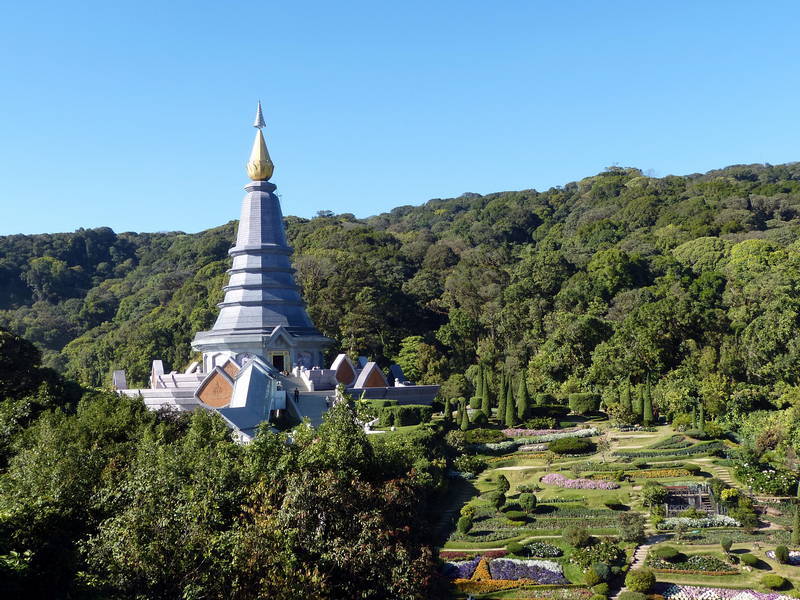
2,500 metres means it is cool enough to walk around with the motorcycle gear on

Heading west before sunset with 182 kilometres to go
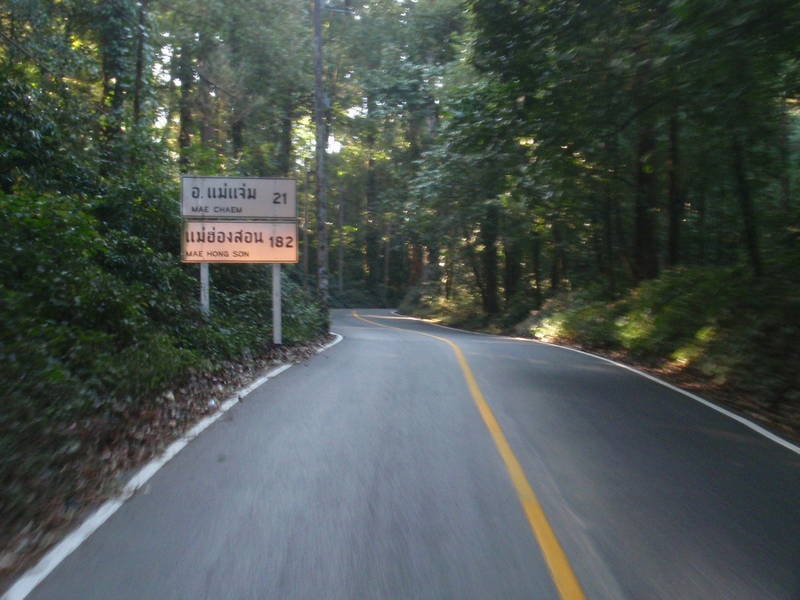
Lovely room at the Fern Resort

Having not been eaten by wild animals we celebrated by having another helping at the breakfast buffet. Then we got on the bikes and rode west in the direction of Myanmar on some small local roads. We hoped to be able to visit the Long Neck Karen tribe, famous for the women wearing rings around their necks in order to stretch them. Using the hand drawn map provided by the hotel as a guide we followed a small road up into the hills. A few water crossings made the ride even more interesting as some had slick algae on the bottom of the creek bed. Easy on the gas. We made it to a small town where a sign for the Karen people pointed down a well-worn pathway. There, at souvenir stalls selling all manner of handicrafts, were women from the Karen tribe. It was almost like we had walked into a National Geographic magazine. In the research we had done prior to coming here we found that a fair bit of controversy surrounded the Karen tribe in Thailand. Apparently they were escaping persecution in Myanmar and Thailand was granting them sanctuary but only the Long Neck Karen were granted that sanctuary. Other tribes weren't as lucky. The theory of course being that the Long Neck Karens were a tourist attraction and so were welcome to help Thailand's burgeoning tourist industry while the other tribes were not. In any case, political ramifications aside, we found our visit very interesting and hoped that buying a few locally made souvenirs would help their cause. Back through the slick water crossings (at one point I felt both wheels slide ever so gently in a two-wheel drift downstream but managed to avoid doing anything rash and thereby not crash) and down the narrow, twisty road back to Mae Hong Son. We stopped off at the Imperial Hotel (where we had asked directions the night before) for lunch and decided that it was so lovely in Mae Hong Son that we should spend another day. Back at the Fern we booked another night and then relaxed at poolside. The water was absolutely freezing and the staff looked especially shocked when we jumped in. In the evening I popped into Mae Hong Son for a few sunset photos and met Heike, from the HU meeting. Her and Fillipo were planning to enter Laos at Chiang Khong a couple of days ahead of us so we might meet up with them there.
Audrey tackles a water crossing
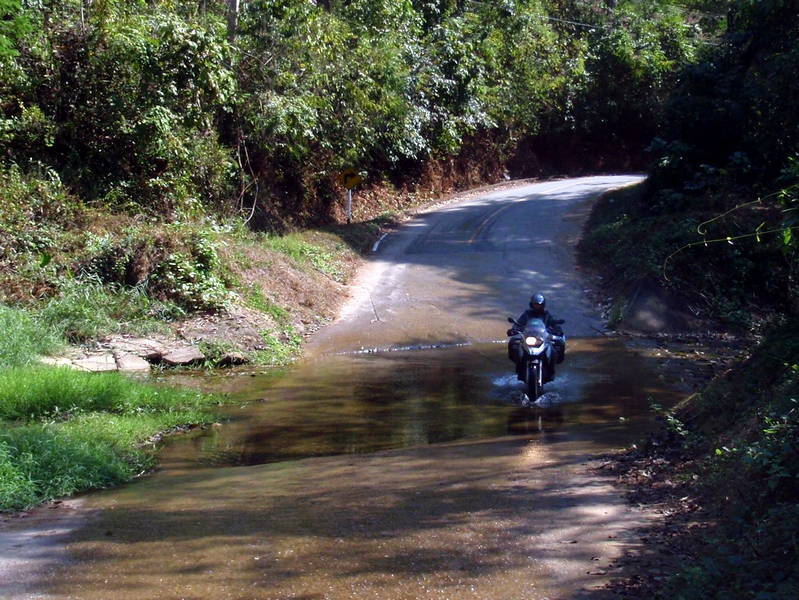
Ekke arrives at the Long Neck Karen village

Tourist neck rings

The older women in the tribe certainly had the longest necks
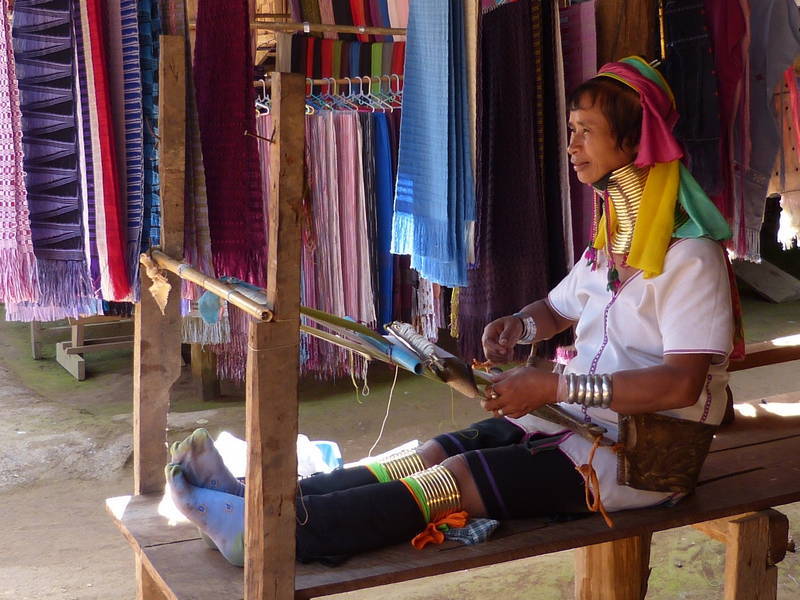

Algea in the stream made this crossing quite slippery as Ekke does a two-wheel drift
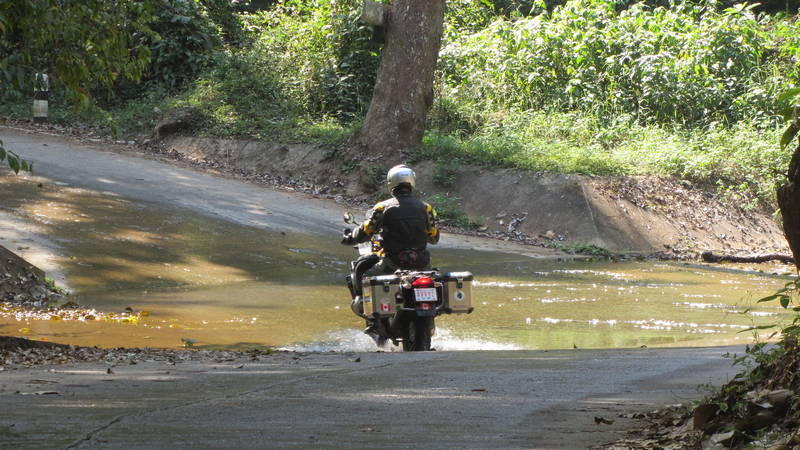
"Lovely" lunch at the Imperial on the way back
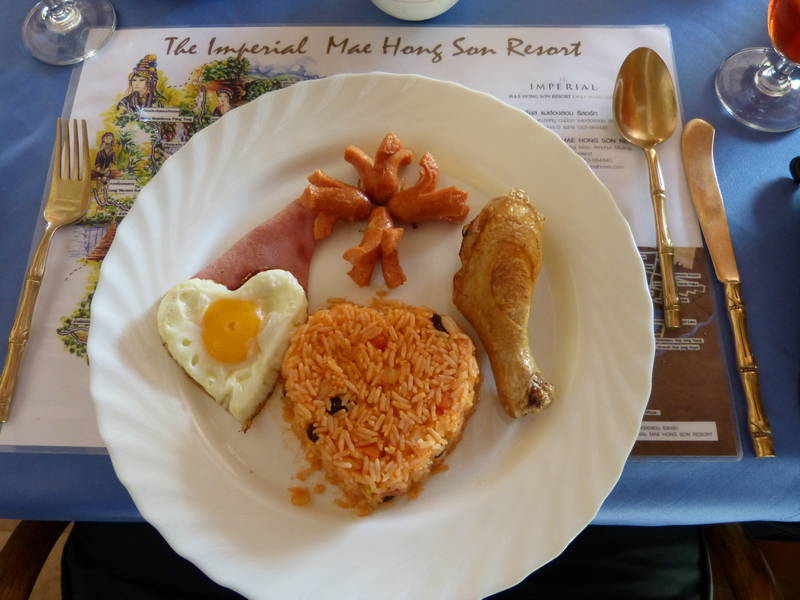
Evening in Mae Hong Son

Friday was a day of relaxation, enjoying the fabulous eco-lodge. Photos at the front desk showed the famous Hollywood couple of Brad and Angelina, apparently they had stayed at the resort a few years ago. We recalled a newspaper article back home where Brad rode an R1150GS Adventure and Angeline an F650GS near Edmonton and wondered if they too would have ridden to a view point up the mountain behind the resort. If they did, they might have been surprised, I know we were. It was only a few kilometres further up the road, in a park and looked easy enough on the hotel's map. After only a few kilometres though the road soon turned into a rough and sandy affair. Then as it climbed steeply up the hillside the switchbacks on the sandy surface became quite challenging. To top it off, the hazy view from the top wasn't especially interesting so going down the switchbacks and back to the comfort of the Fern Resort was a bit of a relief. While doing some internet in the hotel lobby I met Kerry and Laura from Winnipeg. Apparently it was quite chilly there.
Enjoying the gardens at the Fern Resort
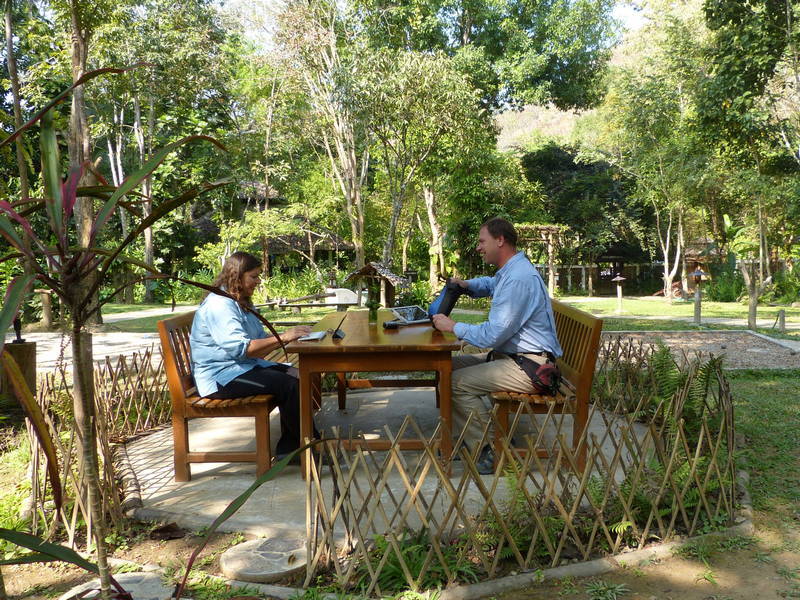
Steep climb on the sandy road

At the top
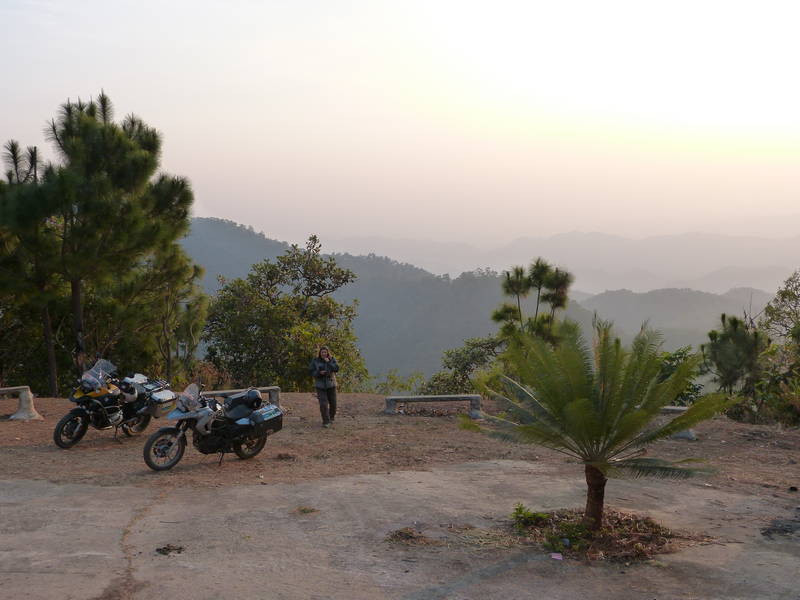
Saturday morning we completed the Mae Hong Son loop, famous for having 1864 corners. The ride to Pai was quite entertaining with lots of great curves and not too much traffic. At a viewpoint a couple on a BMW Adventure pulled up beside us. Rainer and Sheila were from Munich and left from Garmish-Partenkirchen on July 7, a couple of days before us. They had come over the southern route to Turkey (while we went north to Finland) and then flew to India where they toured around before flying to Bangkok. As usual, sharing stories with fellow travellers was a lot of fun. Riding with them was the manager for BMW Motorrad in Penang, Malaysia where we were thinking of getting the bikes serviced when we came back down to Malaysia. It's always good to have a contact. After Pai the road was just as twisty but it was absolutely jam packed with every imaginable kind of vehicle coming up from Chiang Mai. Herds of Harley-Davidsons, swarms of buzzing Vespas, crazy supermotard riders and VW Beetle, Mini and Porsche clubs, all using the road as their own personal race track. We spent more time worrying about head-on collisions than enjoying the sinuous pavement. It was almost a relief to come to the four-lane divided Highway 107 heading north. As soon as we turned east again, off the 107 and onto a much quieter Highway 1150 we really enjoyed the ride. With almost as many curves as the road from Pai but way less traffic (and what little traffic there was, was local farm traffic) we had a great ride for most of the way to Chiang Rai where we checked into the Imperial River Resort.
Not too much traffic on the Mae Hong Son loop before we reached Pai
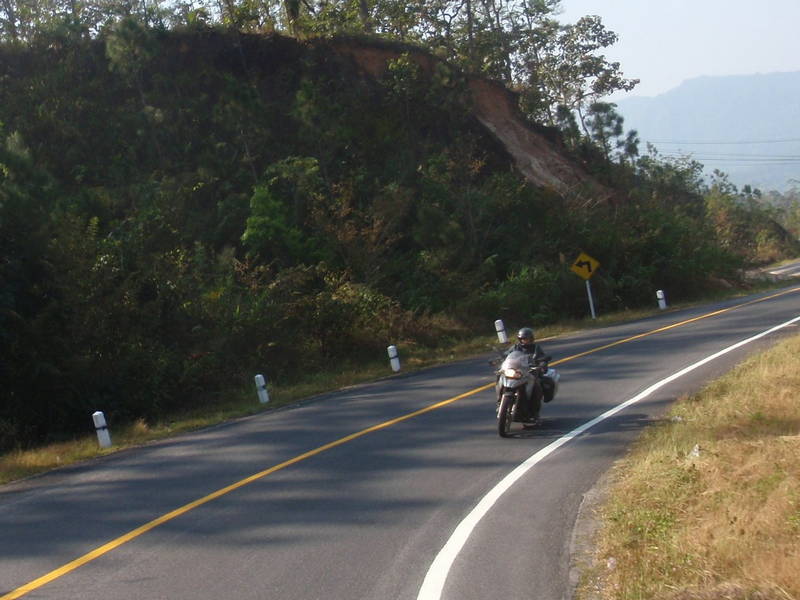
Rainer and Sheila from Munich
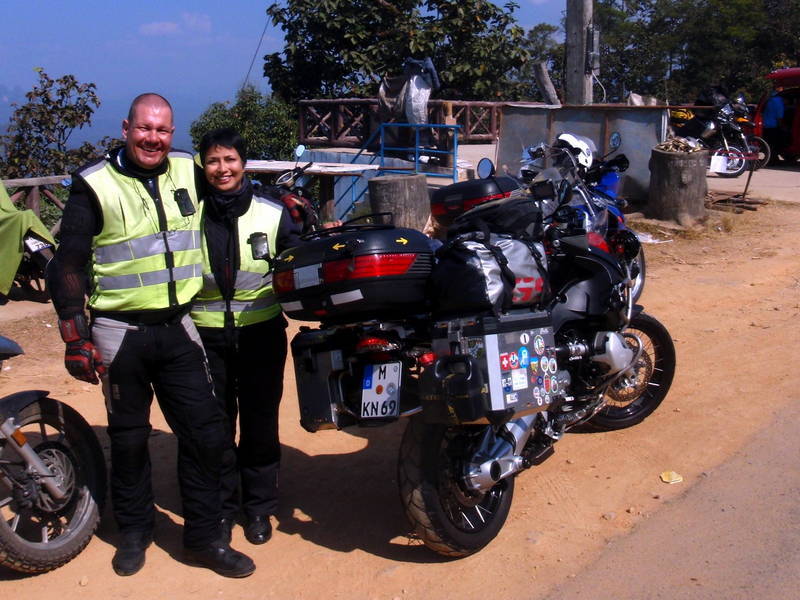
Riding behind some slow Harley Davidsons

Swarms of buzzing Vespas on the Mae Hong Son loop

Away from "The Loop" it was much quieter and enjoyable
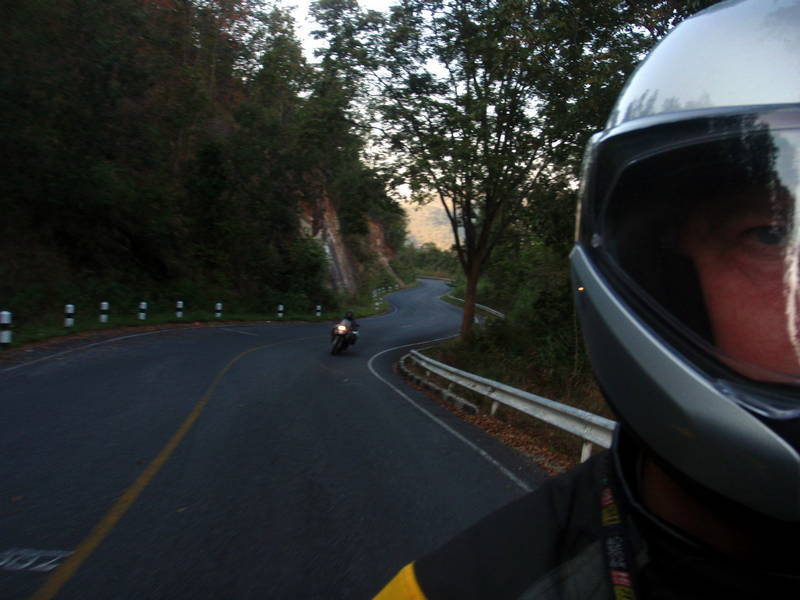
Sunday morning we woke up to a lovely view from our room of the Kok (!) River and the hotel's gorgeous pool. The pool was perfect for swimming and we spent most of the day there. We did take a bit of break and popped into town to check out a shopping mall. It was amazing, like being dropped back into North America. It had all the same stores one would find in Market Mall in Calgary. We had one more swim in that fantastic pool on Monday morning and then were ready to ride to the Laos border by 11:00. Rather than go straight to Chiang Khong we decided to take the longer way, going along the Laos border, up in the hills. About 70 kilometres out of Chiang Rai we turned up a hill and were greeted with a set of steep switchbacks on severely potholed tarmac. Once past this challenge the road climbed along a ridge into the hills with spectacular views in both directions. The road followed the crest of the hill as it went from village to village. The altitude must make it better for farming certain crops up here rather than the more convenient valley floor. Just before stopping for lunch at a small Chinese restaurant (authentic based on our experience in China) I noticed that the GPS showed we crossed the border into Laos and back. This brief taste surely had us prepared to formally enter Laos on Tuesday. At about 4:00 PM we checked into the Teak Garden in Chiang Khong, our bungalow having a fantastic view over the fabled mother river; the Mekong. We took a stroll over to the docks to get a feel for the place and then stopped off at Rider's Coffee, where an old Harley-Davidson was parked out front, for a smoothie. In town for dinner that night we popped into a Mexican restaurant where not only the enchiladas and nachos were delicious but they also had the most amazing freshly baked bread. We would have to see if we could come back tomorrow before catching the ferry.
Pool at the Imperial River Resort was perfect for swimming
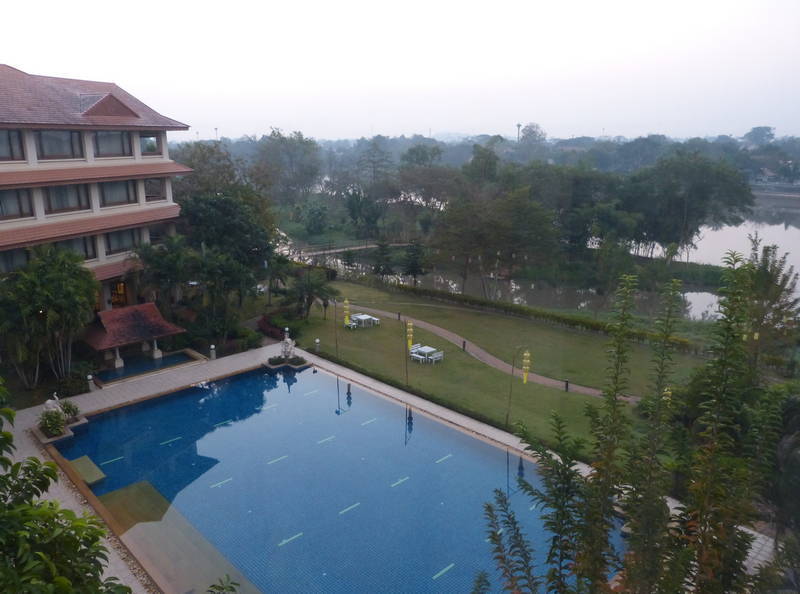
Ekke dips his hands in the Kok River

A small bike might be fun to ride...

The road climbs up into the hills near Laos

Riding along the ridge the views are great
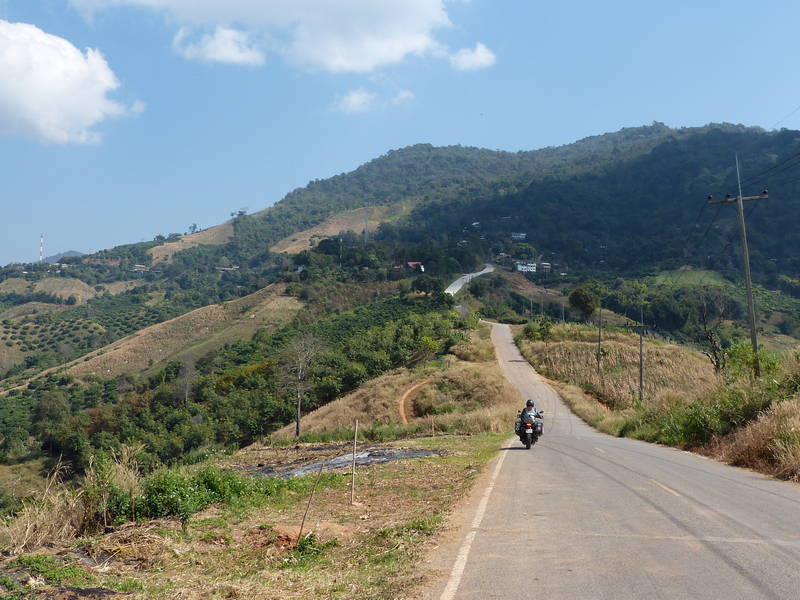
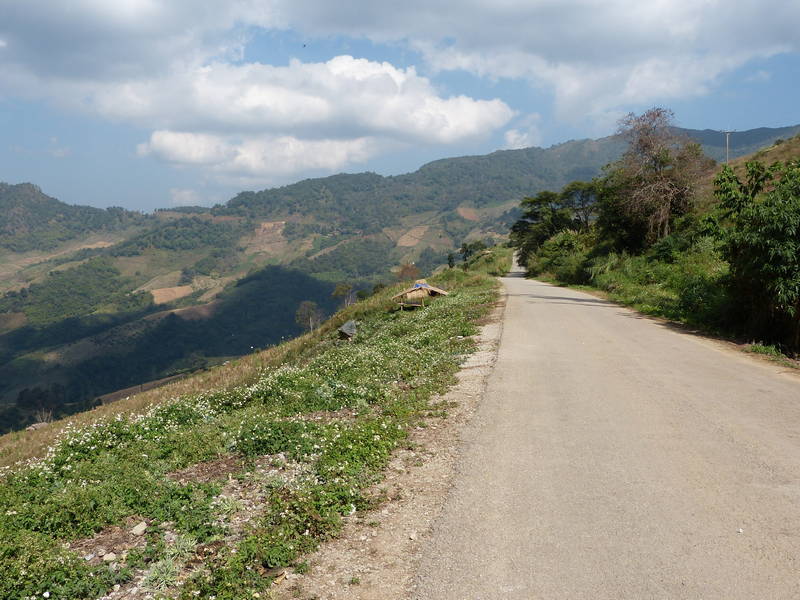
Authentic Chinese food
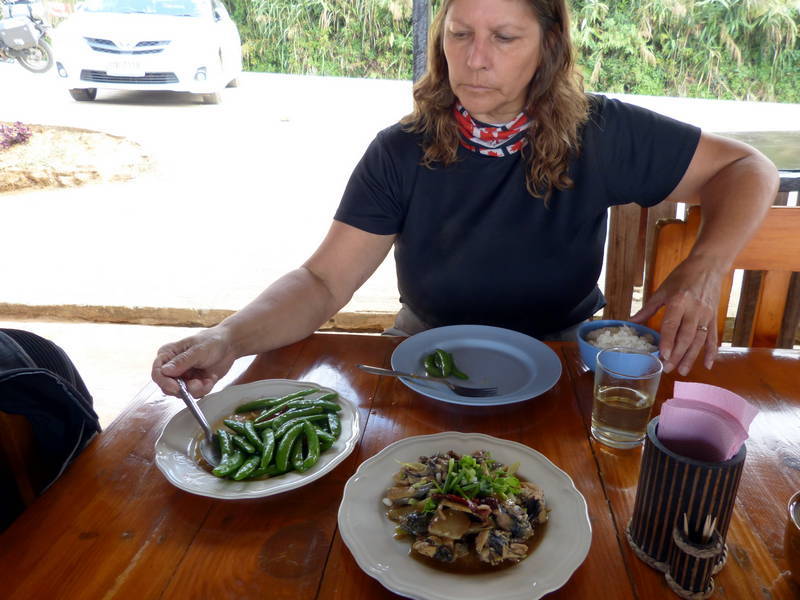
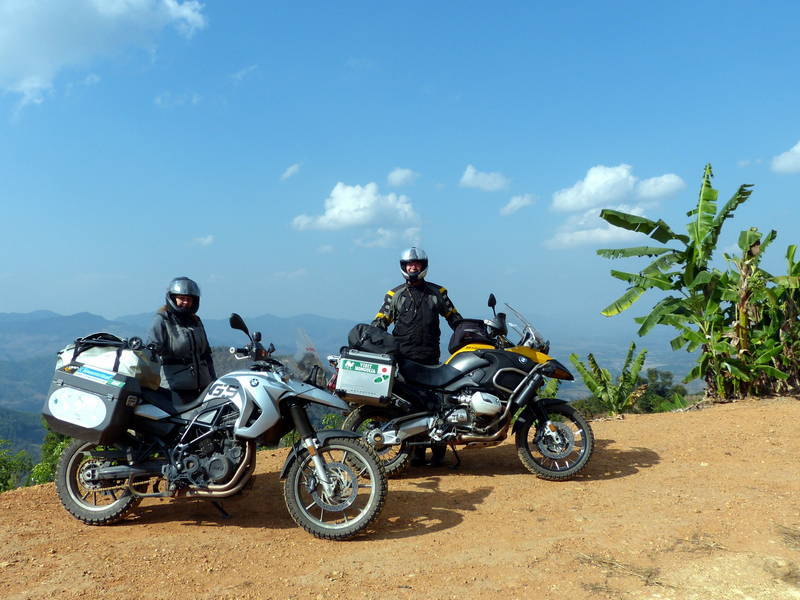
View from the Teak Garden bungalow of the Mekong River

Stopping for a smoothie at Rider's Coffee in Chiang Khong
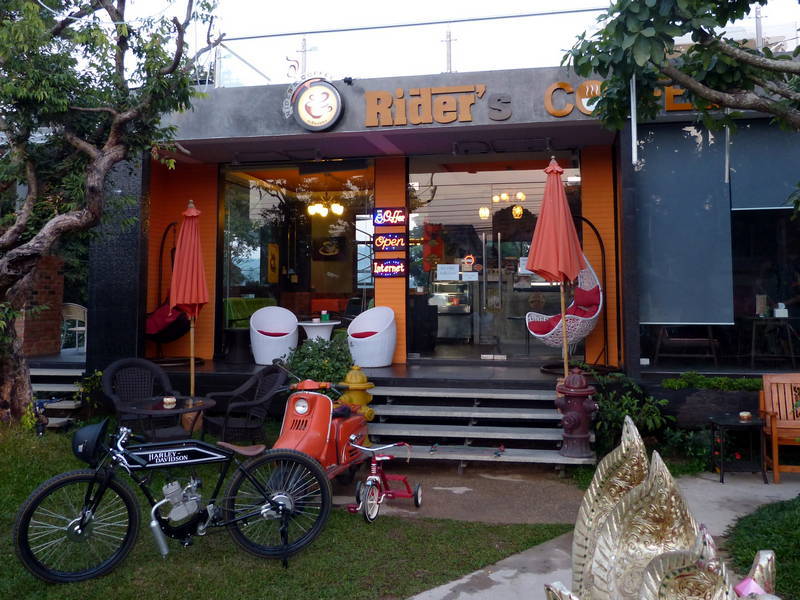
Sitting on the balcony of our bungalow at the Teak Garden, watching the sun rise over the Mekong was simply magical. It was especially cool to put a Skype call through to my parents so that they too could see this amazing scene as long-tail boats surged up stream and fishermen cast their nets. Sometimes technology can be pretty darn neat. After breakfast we had to go back to the Mexican restaurant for fresh bread and jam and then we rode over to the ferry dock. A little bit of confusion ensued as we tried to check out of Thailand, eventually having to pay 200 baht each for a "conveyance" form. We then purchased the boat tickets and since the boat wasn't scheduled to depart until 1:00 PM headed back to Rider's Coffee for a frappe. At 1:00 PM there was no boat at the treacherous looking "dock" but eventually a number of tractor-trailer trucks came down the steep ramp and then a boat jockeyed into position. The trucks were loaded and we were motioned aboard. The sandy approach was pounded into large potholes by the trucks so it looked like it could be challenging. In the end it wasn't so bad and we both managed to get our bikes aboard unscathed. Once we pulled out onto the river I had to have Audrey pinch me. Could this be real? Could I really be with my own motorcycle on a ferry crossing the Mekong River heading to Laos?
Sunrise over the Mekong

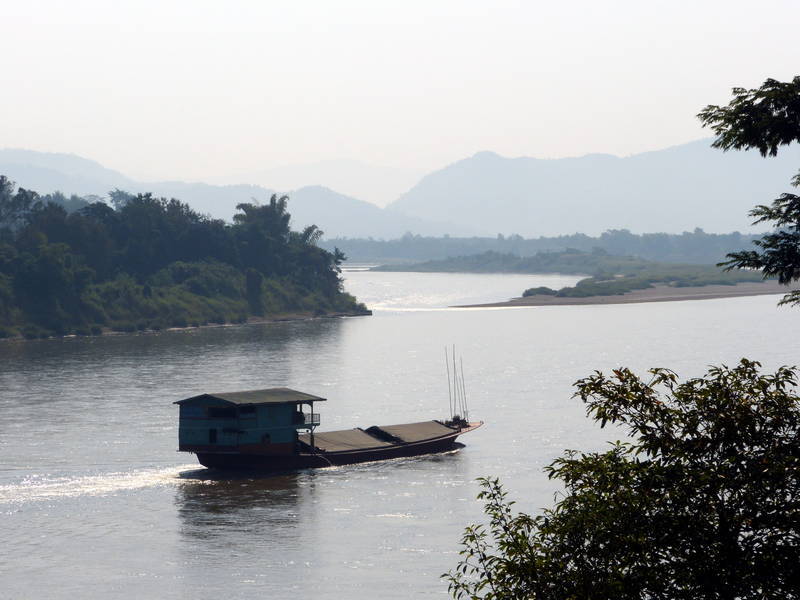
This looks like it could be tricky
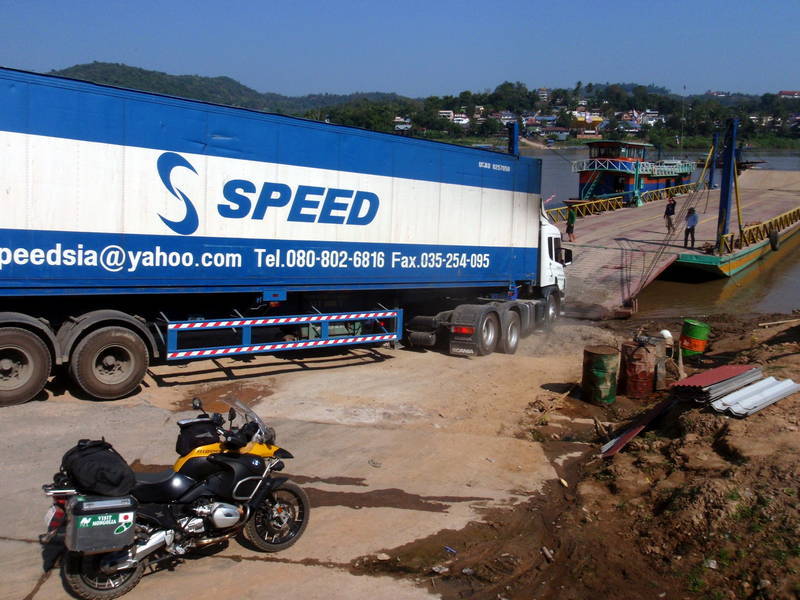
On the way to Laos, crossing the Mekong
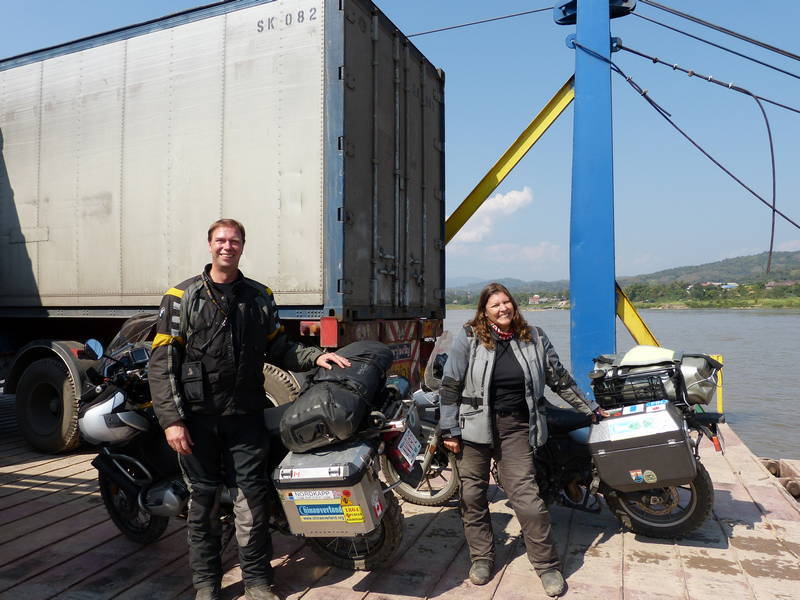
Audrey looks pretty happy about pinching Ekke to confirm that he is not dreaming

Map of our route through Thailand
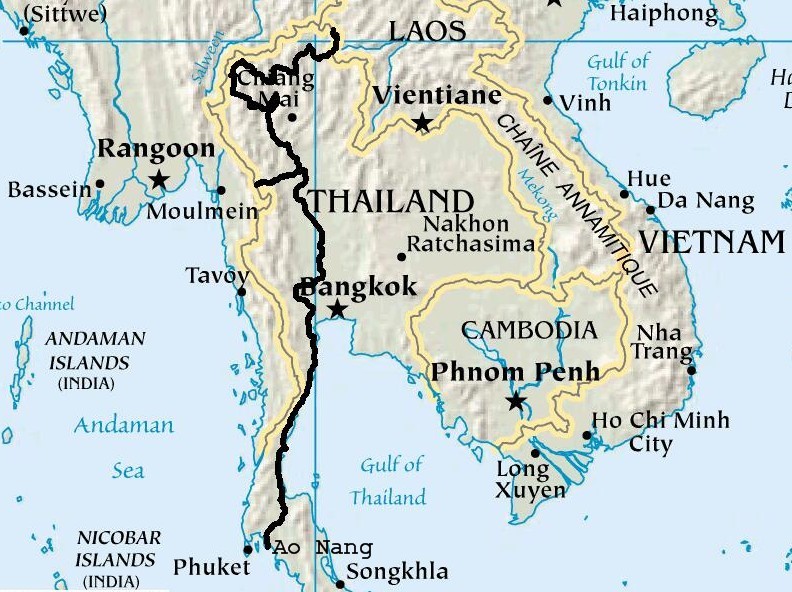
Laos was an unexpected surprise. We had heard bits and pieces about it from other travellers, about rough roads, river crossings and thick jungle. I was a bit wary on the ferry ride over the Mekong, especially after riding the muddy approach onto the boat. To disembark, the ferry staff had two big semis pull up right to the edge so that their weight would stabilize the boat while we rode off. Easy. The Laos side of the Mekong did not look as prosperous as the Thailand side with crumbling buildings and infrastructure. As we rode up the hill, we were greeted by a pleasant scene. A group of Triumph motorcycles! The riders were on a trip with Edelweiss Tours and were just heading back to Thailand to fly home. Ekke stayed and chatted while I went to change some Thai money into Lao kip. A store up the road had an exchange sign out, and it was a good thing I had studied the exchange rate as the clerk tried to give me way less than what was due to me. But that was to be the only time in Laos that there was any hint of a rip-off. Customs and immigration were a bit awkward to find, in separate areas, but eventually we did. We paid $42 U.S. each for a visa. Two riders from Germany, Heike and Fillipo had emailed us about which hotel they were staying in, so we found a room at the same place. The Sombounsub Guesthouse in Huay Xai was simple, but spotlessly clean, for about $12 per night. As we went for a walk to find a cold drink we ran into Sarah and Tony whom we had met at the Horizons Unlimited Motorcycle Travellers Meeting in Chiang Mai. We sat down in a small restaurant for mango smoothies. They had just done the Gibbon Experience, and told us all about zip lining and staying in tree houses. Sounded amazing. We told them we were meeting Heike and Fillipo for dinner, so they joined us. Sylwia, who had ridden up by herself from Chiang Mai because her Thai visa was expiring, was also there. Her riding partner, Jens, was still in Chiang Mai getting his Honda Transalp fixed. Seeing Sylwia's yellow BMW F650GS parked in front of the hotel made me feel nostalgic for mine, the same bike I had ridden through Africa. What a great evening we had at the Hay Bow restaurant listening to stories about riding through India and Nepal. I hadn't laughed so hard in a long time. We ate an interesting potato dish for dinner, washed down with the local brew, Beerlao. Heike was a beer connoisseur and declared it to be very good.
Ferry across the Mekong
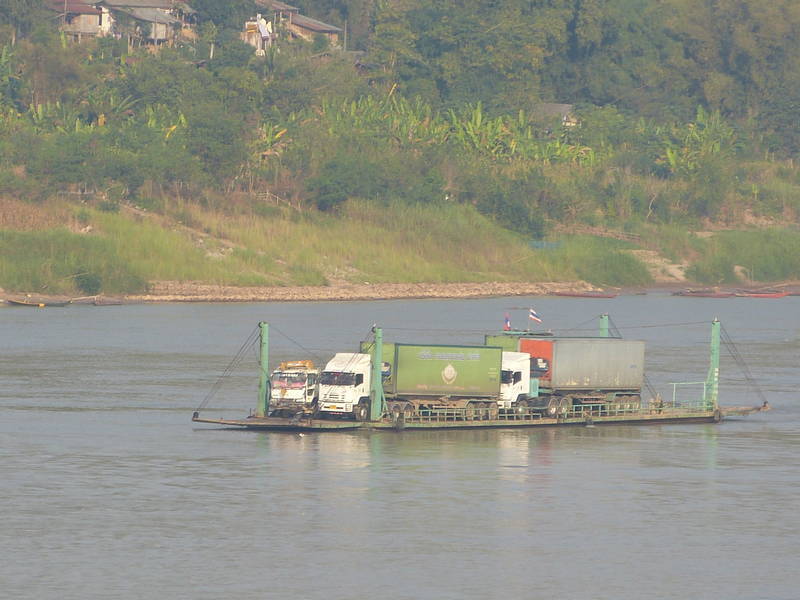
Triumph Explorers from an Edelweiss tour group wait to board the ferry to Thailand
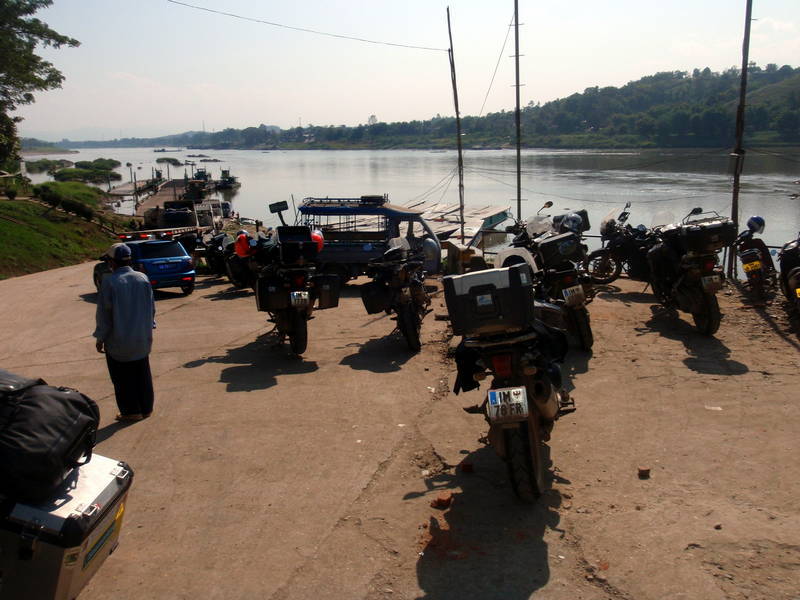
Sombounsub Guesthouse in Huay Xai with a few travellers' motorcycles

HU Mini-meet in Laos, clockwise from lower left: Tony, Sylwia, Heike, Fillipo, Ekke, Audrey and Sarah
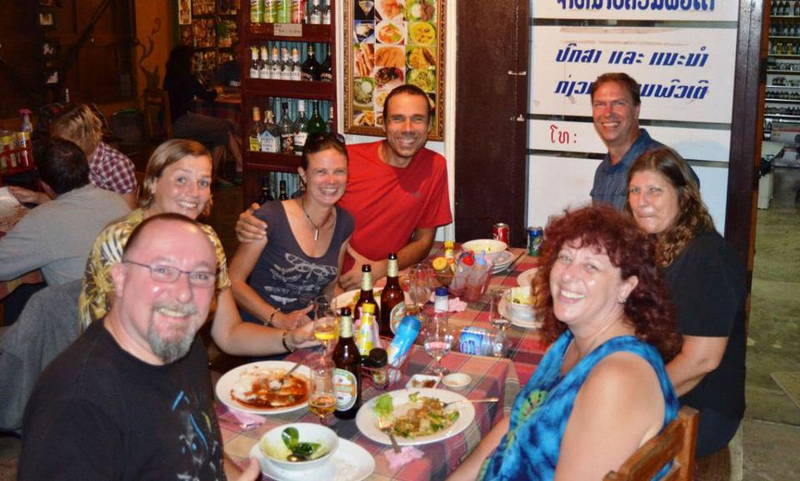
Heike and Fillipo left the next morning, riding towards Luang Nam Thang. Tony and Sarah had rented bikes in Thailand for a reasonable price but renting bikes in Laos was too expensive. They took a long-tail boat to Luang Prabang instead. We stayed another day and spent some time with Sylwia, hearing tales of her ride through Pakistan. The next day we packed up the bikes and rode north. After riding on the left side of the road for so long in Thailand, Ekke was not taking any chances and made a sign, 'Keep Right', to display on his tank bag. But the change to riding on the right side of the road was seamless. The beautifully paved highway lasted all the way to Luang Nam Thang, twisting and turning through the hills with very little traffic. Children laid out stalks of grain on the side of the road using the hot pavement to help dry it. Then we saw them take a handful of stalks and bang them on the road, over and over, wondering what they were doing. Later we learned that these stalks, called khere, were sold for 5000 kip ($0.67) per kilogram and made into brooms. The banging shook all the seeds off. After a really fun day of riding we arrived at Boat Landing Eco Lodge. Our own bamboo bungalow awaited us, overlooking the Nam Tha River for a very reasonable $55 per night. Little kids were snorkelling, trying to catch something in the water. Fishers in small dugout boats threw nets into the river. We rode into town and found the Green Discovery office. There we booked a kayak river tour for the next day. We had met a scooter rider from Bangkok earlier, checking out our bikes. When we got back to the bikes after some shopping, there he was again, leaving a map of Laos, Cambodia and Vietnam on Ekke's tankbag. He had purchased it just for us. How nice was that. Dinner at the Eco Lodge was amazing - Laos lap or ground chicken with mint leaves and a little basket of sticky rice on the side.
Fishing in the Mekong
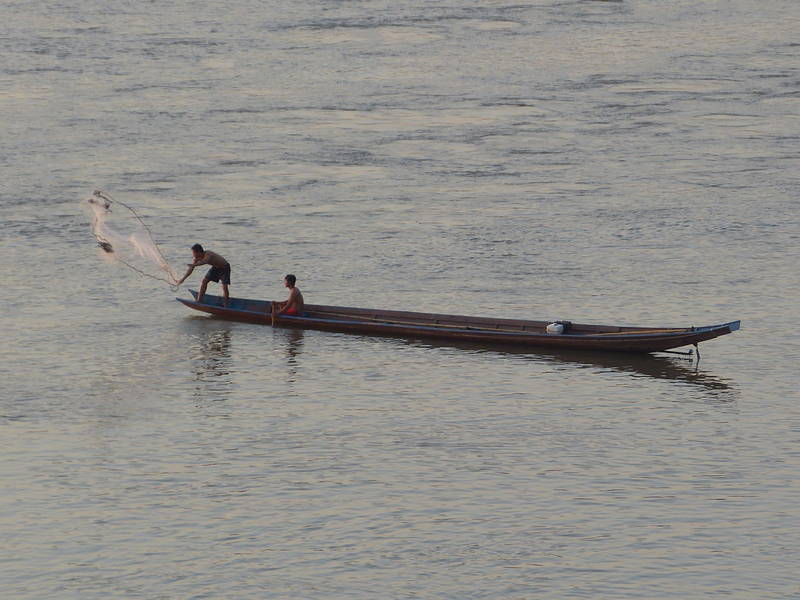
Does anyone else think that the yellow centre line used in North America is a great invention?
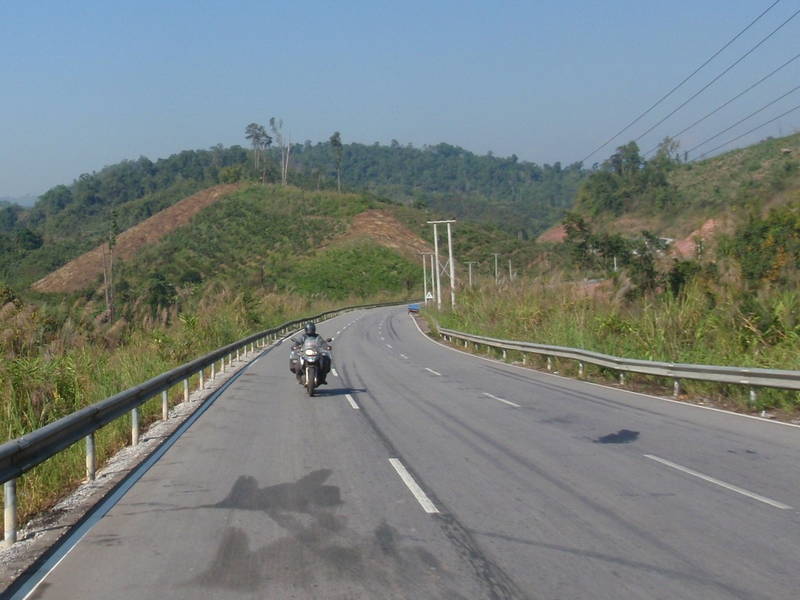
Laos houses on stilts, keeping the floor dry during the wet season
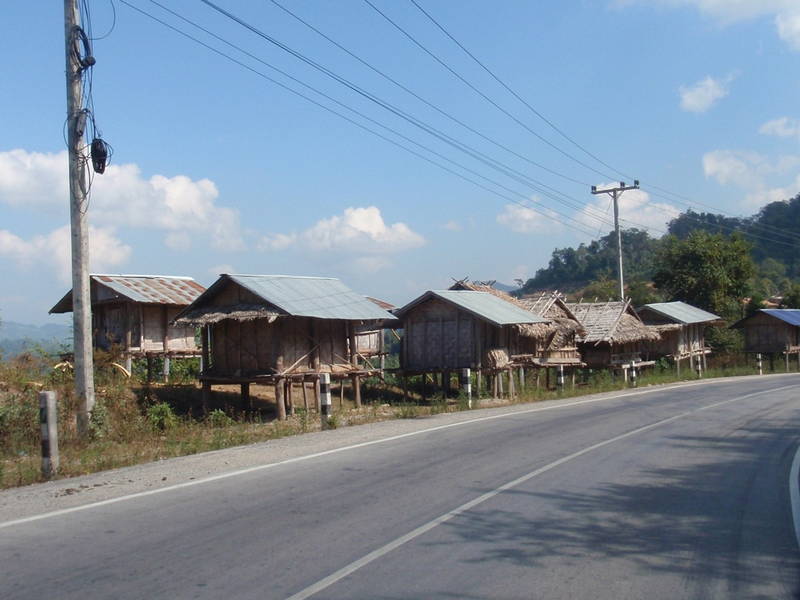
Cabin at Boat Landing Eco Lodge

Kids in the river outside our cabin
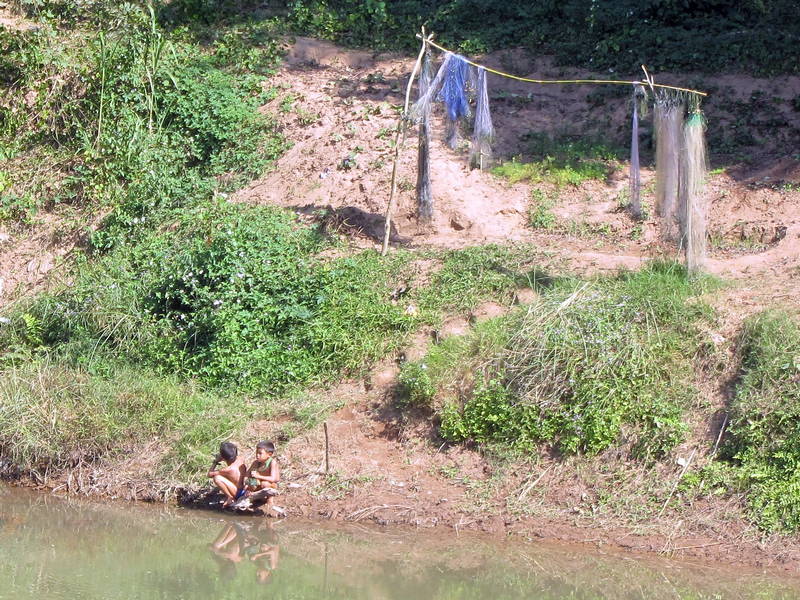
After breakfast the next day, January 25th, a van with two kayaks strapped to the roof showed up to take us out for the day. We drove out about 5 kilometres, unloaded the inflatable kayaks and our guide, Oun, gave us a few minutes of instruction as to how to paddle. He checked our helmets and life jackets and we launched the kayaks into the water. The area to the right of us was a National Protected Area and was pristine jungle with banana trees, hanging vines and coconut palms. To the left, the jungle had been cut down and replaced by rows of rubber trees. Oun told us that China planted the trees, and then gave some of the profits to Laos. They had also built the beautiful new highways through the country, in exchange for some of Laos' natural resources. What a pleasant paddle down the peaceful river. Oun had a great sense of humour and told us a lot about the local area. When he learned I was a teacher, he told us stories of how adults in his village disciplined kids. They told them that the Falang would eat them if they didn't behave. Falang was a Laos word for foreigners. We docked beside a little settlement, a Lanten hill tribe. As I stepped out of the kayak, a strange thing happened. My leg promptly collapsed. Next thing I knew I was in the water, on my side, struggling to gain back my dignity as some villagers watched from the hill up above. My leg had charley-horsed, which had never happened to me before to that extent. After dragging myself to shore and taking a moment to recover, we wandered through the village. No photos were allowed. All the houses were made of wood and bamboo, on stilts because of the annual flooding of the rivers. The women wore cloth leggings and Oun explained that if their hair was in a bun and their eyebrows were shaved off, they were married. Around the corner some men had recently cut the head off of a huge pig. A few of them were scraping the pig's black hair off. Oun told us that one of the villagers was sick and that a village healer was making an offering of the pig to increase the wellness-odds. As we launched our kayak into the water, we could see the bloody pig also being launched into the river, quite a sacrifice, really. As Ekke and I paddled into some small rapids, our boat suddenly stopped. We were stuck on the rocks. Some little boys from the village, who looked to be about 5 years of age, saw our predicament and immediately swam over to help. I really wished we had photos of these three little kids, completely nude, pushing the 'Falang's' kayak over the rocks, a dead pig bobbing in the distance.
Starting off on our kayaking trip we happen upon a couple of fishermen
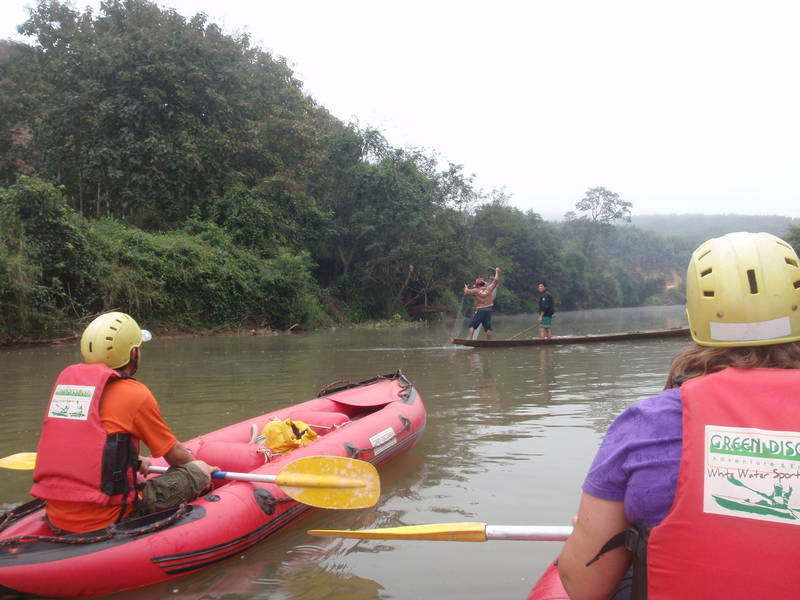
Lanten hill tribe village

Oun had us paddle over to a little beach in a really lush part of the jungle for lunch. He started a fire, produced three fish from a plastic bag, stuck them on a stick and placed them over the fire. He then paddled away and brought back some huge banana leaves that he used for a tablecloth. He emptied more plastic bags full of vegetables, sticky rice and sauces for the fish onto the leaves. We dipped the fish in chili and mint sauce and ate it with our fingers. I'm not generally a fan of fish, unless it comes in a blue box and says 'Captain Highliner', but this was amazing. The afternoon paddle was very pleasant, and we thought we were getting pretty good at paddling through rapids until our boat spun a full 360 degrees through some really fast moving water. No harm done though. But further on we were paddling really hard through a deep, fast flowing channel, trying to keep the boat straight. I'm not sure how, but the boat tipped sideways, and next thing you know I was in the river, struggling to keep my head above water. Oun had told us that if we did go into the water to aim our feet downriver and cross our arms over our lifejacket. I tried it and it worked quite well until I got stuck on some rocks. I was able to grab the kayak but the river tugged it downstream and I had to let go. Oun paddled upstream to rescue me. He had even saved my flip-flops which he had found floating further downstream. We laughed about the whole incident, later. Especially about the fact that I had fallen into the same water as the dead pig. At another village, we carried the kayaks and gear up the hill, and the driver and van were there waiting. Some construction on the gravel road on the way back made for a bumpy ride, and the van had to move right over to the edge of the cliff in order to pass by. The graders and backhoes stopped for us as we drove by.
Pulling up onto a beach for lunch as Oun gathers some banana leaves

Ekke shows off lunch before it goes on the fire
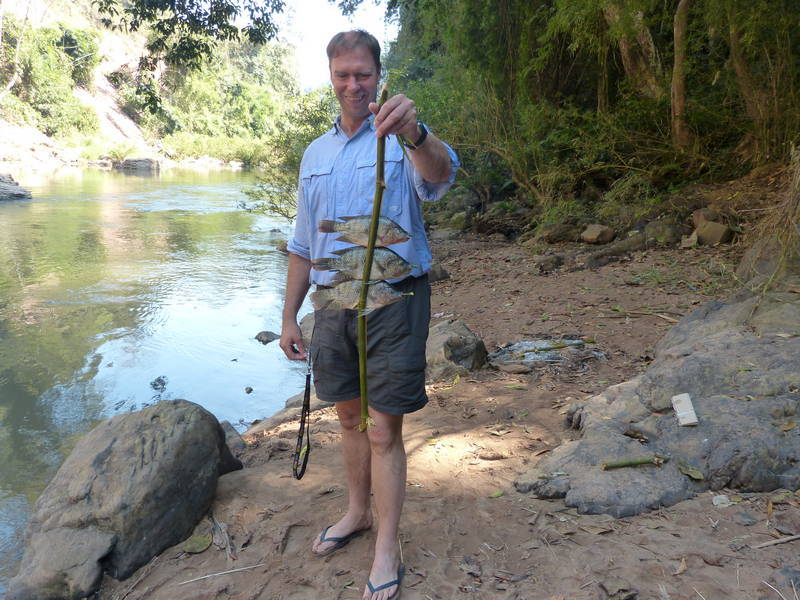
Oun rubbed some spices on the fish before putting them on the fire

Banana leaves make good seats, tables and plates
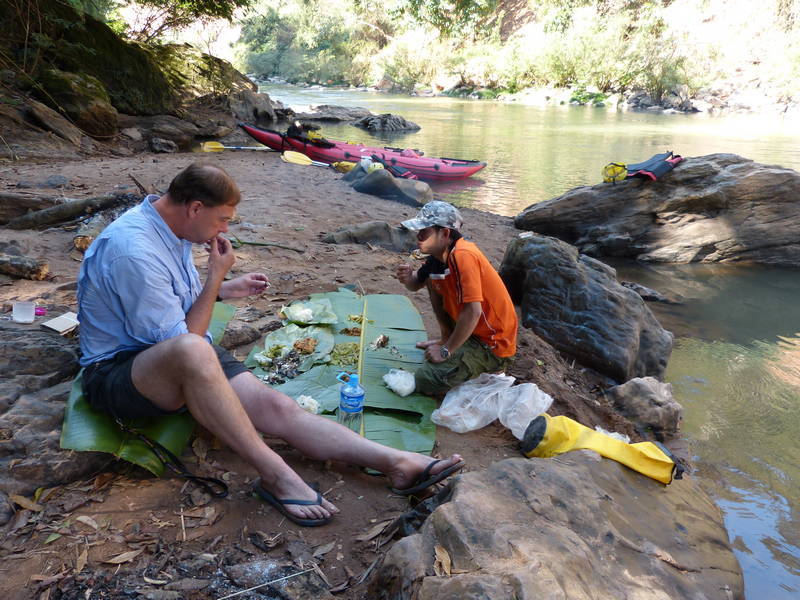
Surrounded by jungle (don't those vines look perfect for Tarzan to come swinging by?)
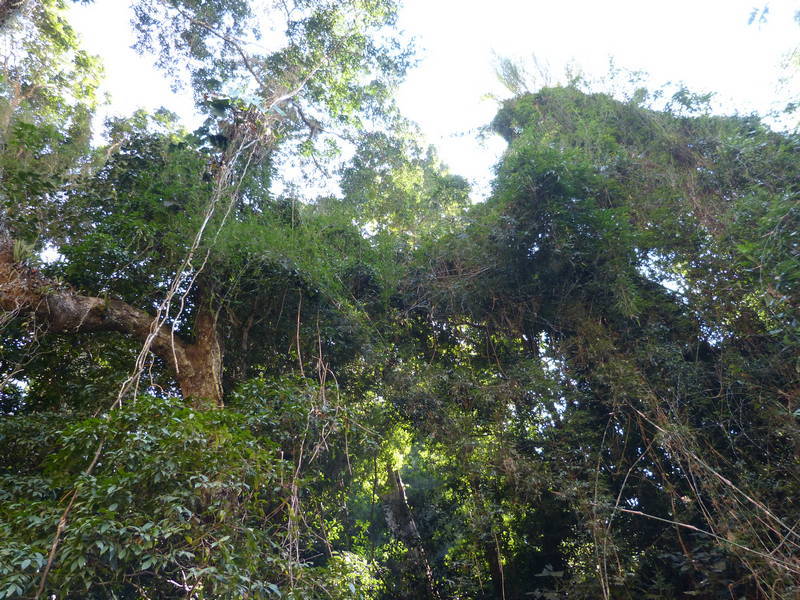
Oun rescues Audrey after she abandoned ship
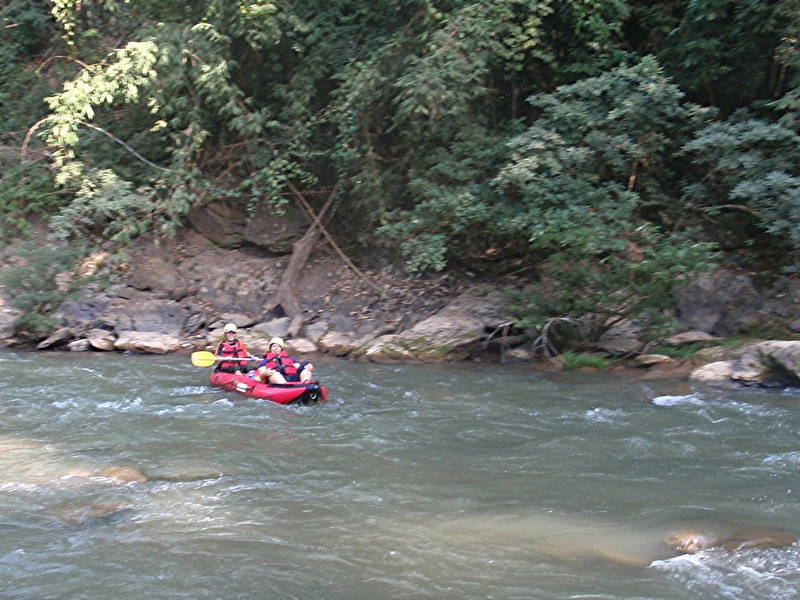
Working on our website sitting on the veranda of our cabin

A ride to Muang Sing the next day was very pleasant, the motorcycles winding their way up a mostly paved road past some rich jungle foliage and more stilt-house villages. Inevitably a bush-bathroom break was necessary. Our guidebook had warned us that there was still a lot of UXO or unexploded ordinance in the countryside and advised being careful when walking. As many cluster bombs still remained hidden, it was recommended that we only walk on well-trodden paths. A small track down a hill provided a good spot, and Ekke was careful not to step off the track. I decided to wait until we reached town. Muang Sing was a dusty little place but the market was fantastic. All kinds of fruits and vegetables, clothing, and woven goods were for sale. Locals and ethnic hilltribe people brought their wares here to sell. We sat and enjoyed a bowl of noodle soup and took it all in. When we parked in front of the information centre, some ladies in traditional Hmong dress approached us and sold us some woven bags and stone beaded bracelets. One lady had a quick look around and then held open another bag. It looked like dried marijuana leaves. I put my fingers up to my mouth as if smoking, and the lady nodded. She then looked around again and then showed Ekke the inside of another bag, this time with some little rocks. We had read that the hilltribe people still traded in opium and it is likely that these were little rocks of the illegal drug. We just shook our heads, no, and quickly rode away. On the ride back, we could see some hills in the distance - China. I didn't think we were so close, but there it was. The border to Burma (Myanmar) was also fairly close, thus accounting for the variety of hilltribes in the area. We stopped at a little village for a cold drink. Two plastic chairs were produced for us, and soon a crowd gathered to look at us and our bikes as we sipped our Coca Colas. Instant celebrities. But, our celebrity didn't last very long as a pickup truck stopped nearby soon garnered more attention than a couple of Falang on motorbikes. Villagers rushed over to them carrying bundles of khern, or broom-grass. The driver weighed them and then gave them their 5000 kip per kilogram. In Luang Nam Tha we noticed a familiar couple walking down the street. It was Sylwia (Poland) and Jens (Germany). At a little pizza cafe, Jens told us about getting his bike fixed and then meeting up with Sylwia in Huay Xai. They also told us stories about getting stuck in a Pakistani hotel while demonstrations took place on the streets below. I was riding so I didn't partake of the Beerlao, but we sat there a long time together, swapping motorcycle adventure travel stories and eating fresh bread with hummus.
Riding to Muang Sing past more stilt houses
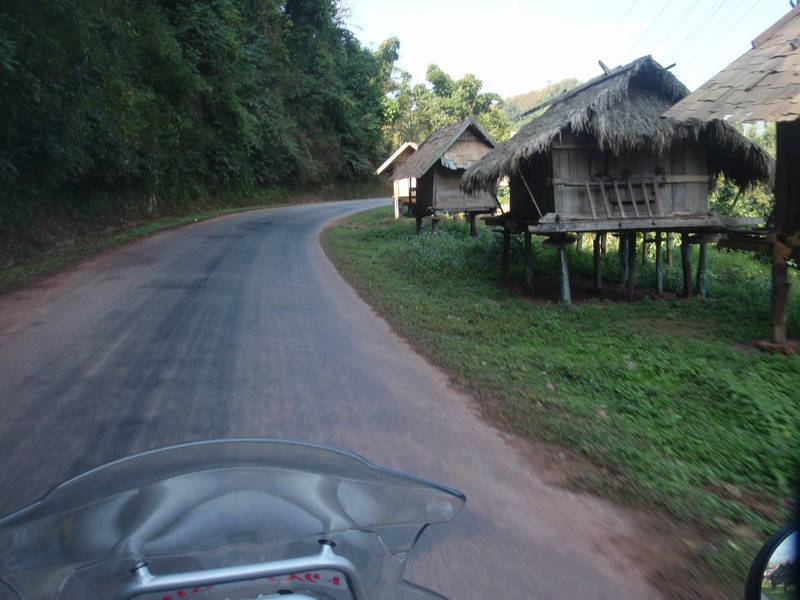
Lunchtime at the market in Muang Sing
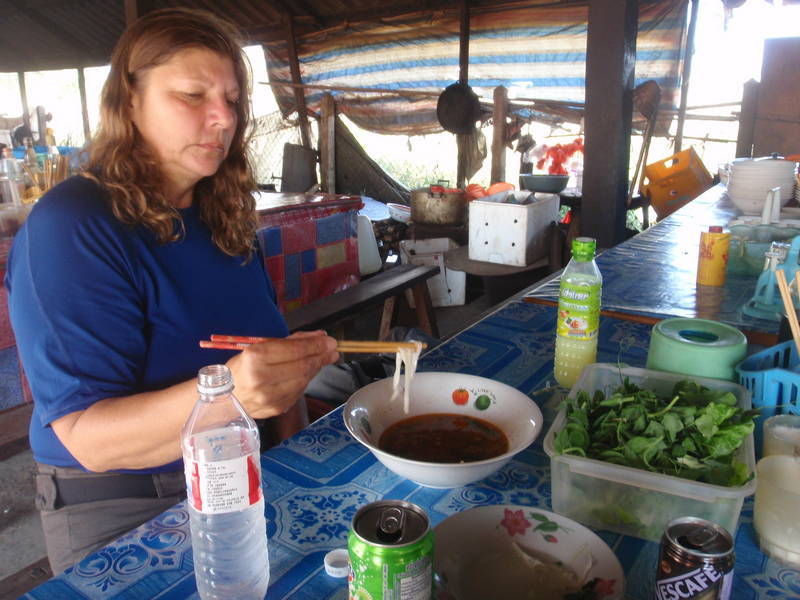
Some interesting market items
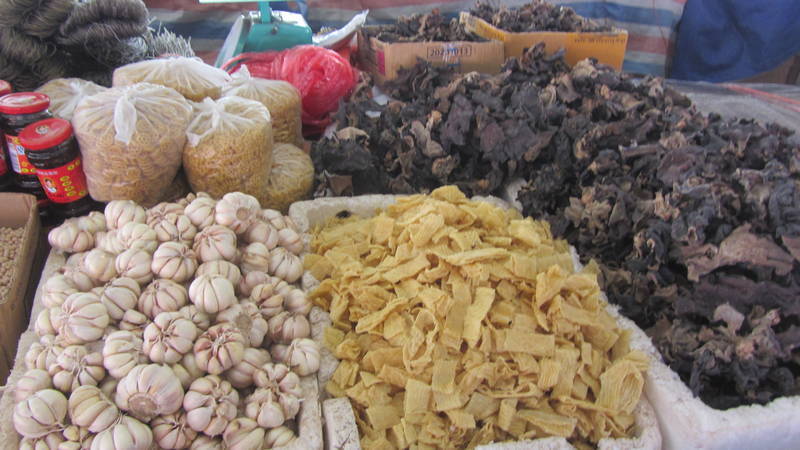
Audrey mimes 'marijuana', and the dealer confirms it with a nod
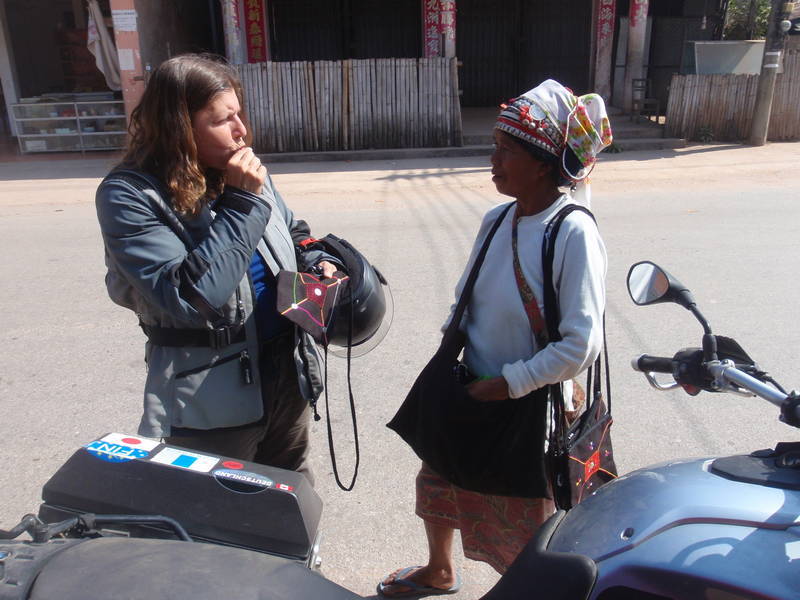
The bikes always draw a crowd in a small rural village
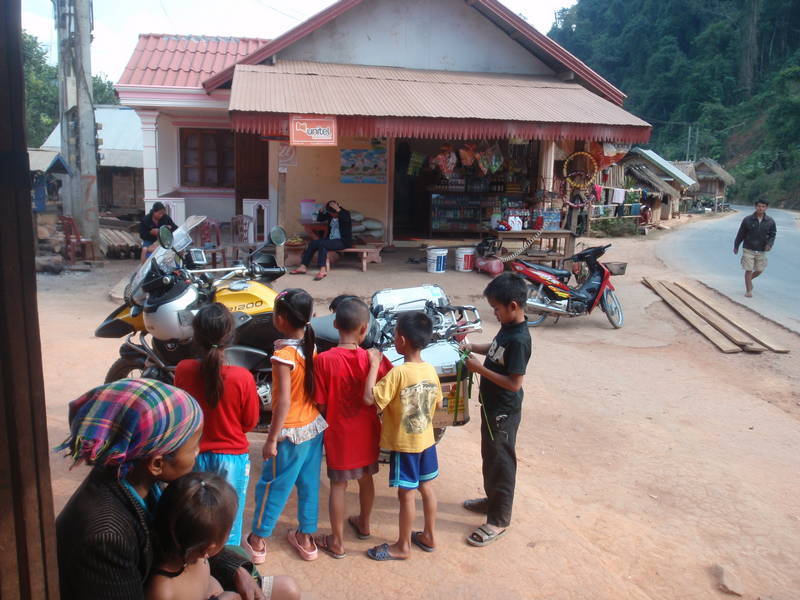
We meet up with Sylwia and Jens back in Luang Nam Tha
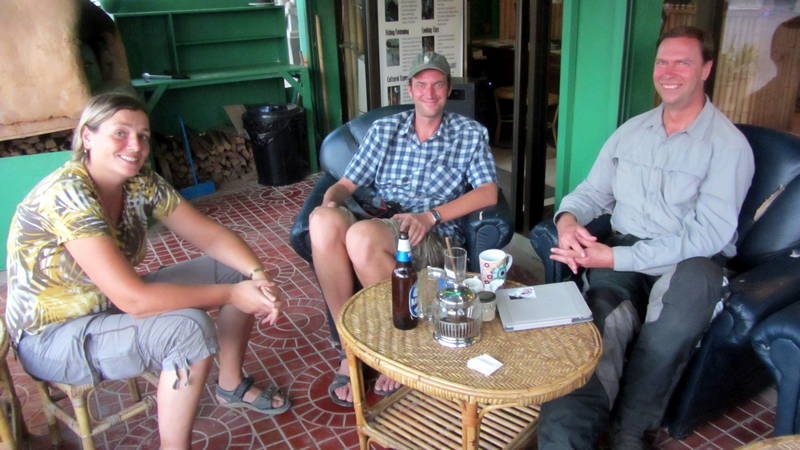
Hanging out at the bungalow was all we wanted to do the next day, writing, reading, and sending river-soaked laundry in to be laundered. Breakfast was lovely, consisting of a baguette, fried eggs, papaya, apple, banana, and mango. We rode into town for lunch and found internet at a little cafe to catch up on our emailing, Facebooking and news. Also, the internet was useful for booking a room in Luang Prabang. Ekke took a shortcut route out the next day, January 28th which consisted of gravel, dirt and big potholes. Just a bit of off-roading to start our day. But it took us past some little neighbourhoods and we saw how the locals lived in their stilt houses, children waving and chickens with really long necks strutting about. The paved road wound up and down hills, lush and green everywhere and we made good time for about 100 kilometres to Ooudomxay. The pavement came to an end, however, and we rode a dusty, potholed road for about 90 kilometres to Pak Mong. We averaged about 35 kilometres per hour as we were constantly forced to brake for the big holes in the road. Our GS (on-road, off-road) bikes handled it all beautifully, though. The drivers here were gentle, speeds fairly low, staying on their own side of the road. Oun had told us that his home village was on this route, so we stopped nearby to take a photo. The sun was just setting as we reached Luang Prabang. We rode around the bustling city in the dark for a while, trying to find our hotel, the Luang Prabang Oasis Villa Namnuea. Ekke had a general idea as to where it was and eventually we saw a sign that looked just like the one on the website. We unloaded the bags, walked up to the front desk and were told that they were full, even though we had booked ahead. One of the staff got on a scooter and took us to the Tam Tam Hotel, which was really nice except for the little tiny ants in the kettle. And our motorcycle earplugs could not drown out the thump thump thump of the disco down the street. The next day, we went back to the original hotel but a room wouldn't be ready until noon. So, we rode to a lovely bakery, le Bannetton, housed in an old French villa, right across from a Buddhist temple. Our bikes, with their Alberta licence plates, got a lot of attention.
Shortcut leaving the Boat Landing Lodge

Dodging the local traffic

Beautiful scenery as we rode from Luang Nam Tha to Luang Prabang

Lush jungle
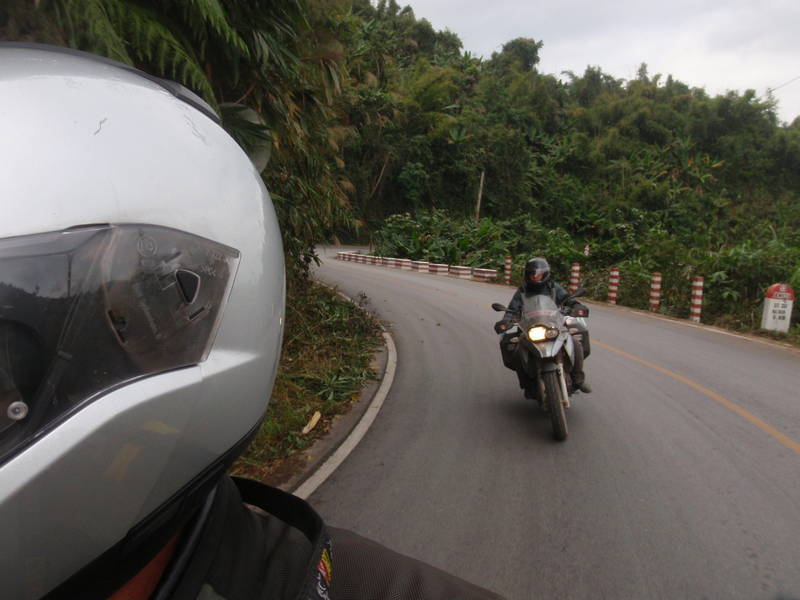
Arcing through small mountian villages

Barry Gibb (?!?) on mudflaps. Why?


Hauling khere to market
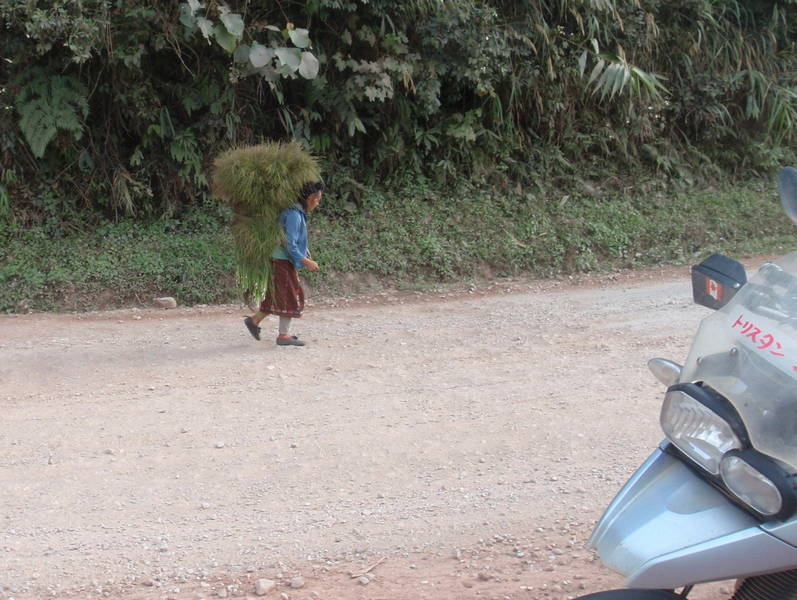
Rice paddies look freshly planted

Parked in front of Le Bannetton Cafe in Luang Prabang

That afternoon a ride up to Kuang Si Falls was a lot of fun, with a paved road winding through small villages. The roadside foliage was very tropical featuring banana plants and palm trees and sometimes beautiful little vegetable gardens or rice paddies. There were a few hardy tourists on rented bicycles, riding the 30 kilometres to the falls, bravely tackling the hills. The parking area was surrounded with booths selling everything touristy, so we knew this must be a popular place. The walk to the falls took us past a Bear Rescue Center. It must have been nap time as none of the sun bears or Asian black bears moved even a centimetre when we were there, but they were still interesting to look at. The falls were absolutely breathtaking. Mint-green pools of water glistened in the sunshine. Limestone formations allowed the pools to form, and little waterfalls flowed from pool to pool. There were squeals of delight as Tarzan-wannabes swung from a rope dangling from a tree hanging out over the water and landed in a deeper pool. Further up, the biggest falls dropped from a tall cliff. We walked on the smooth, slippery rocks just underneath, our Gore-Tex lined boots coming in very handy. Our hotel room was ready for us when we got back into town. The rather rustic wooden buildings overlooked a beautiful lily pond, just adjacent to a restaurant that had a live floor show. We watched the traditionally-dressed Laos dancers from across the pond. Beautiful. LP suggested a good restaurant, The Blue Lagoon, and it didn't disappoint. I don't know how many servers came to our table but I'm sure it was in the double digits. After eating plenty of rice dishes lately, we were ready for some western food, and Ekke declared the beef stroganoff to be excellent. The chef even came out and asked us how everything was. A magic bread basket just kept filling itself up over and over again and a delicious mango flambé was done just right.
Riding over wooden bridges framed by lush jungle on the way to Kuang Si Falls
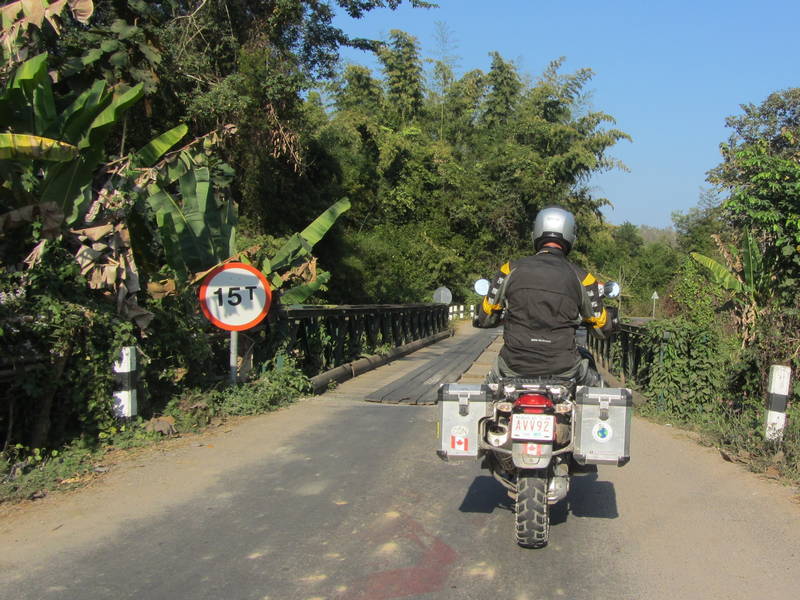
Bear sanctuary on the way to the falls

Kuang Si Falls started out as small falls going from pool to pool
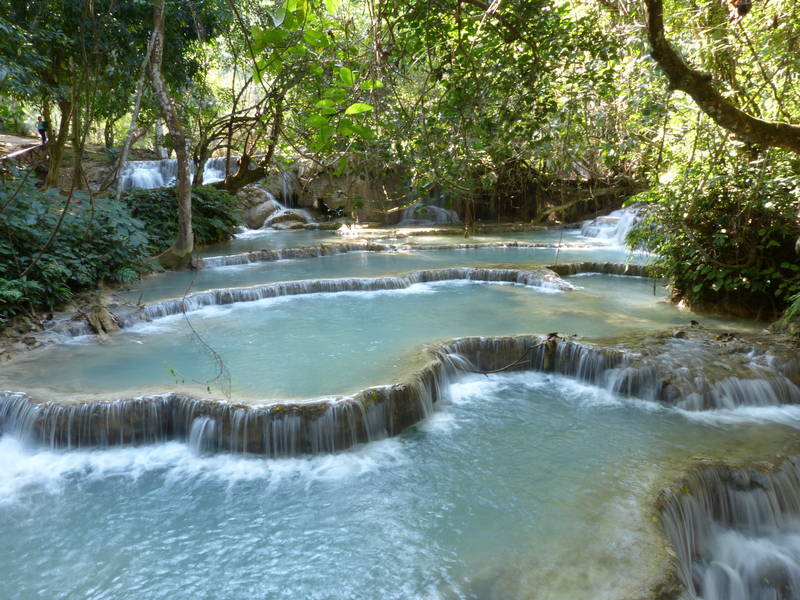
Getting larger the further we went up the trail
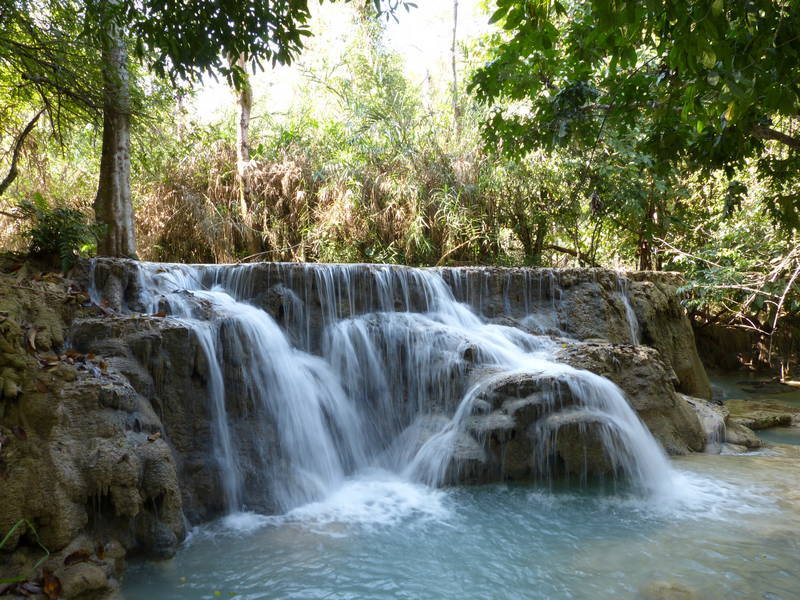
And then Tarzan imitators started jumping in
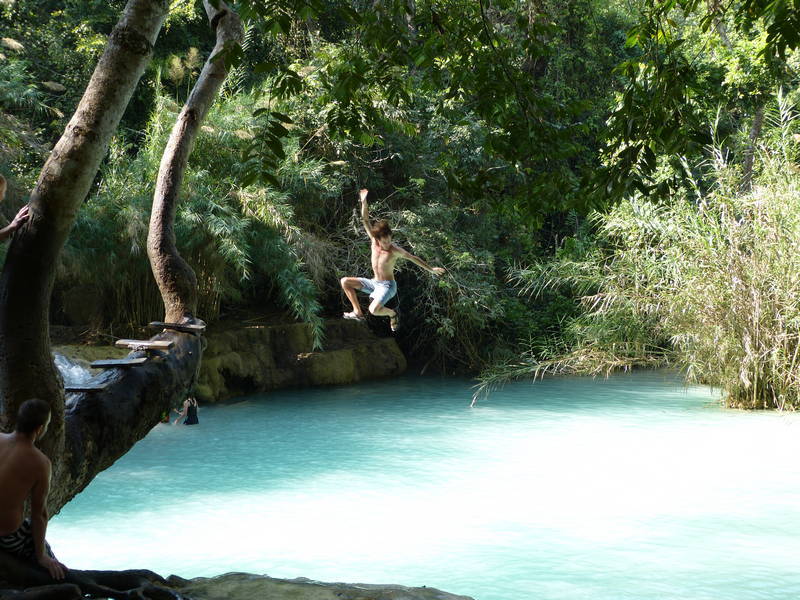
At the top of the valley were the true Kuang Si Falls
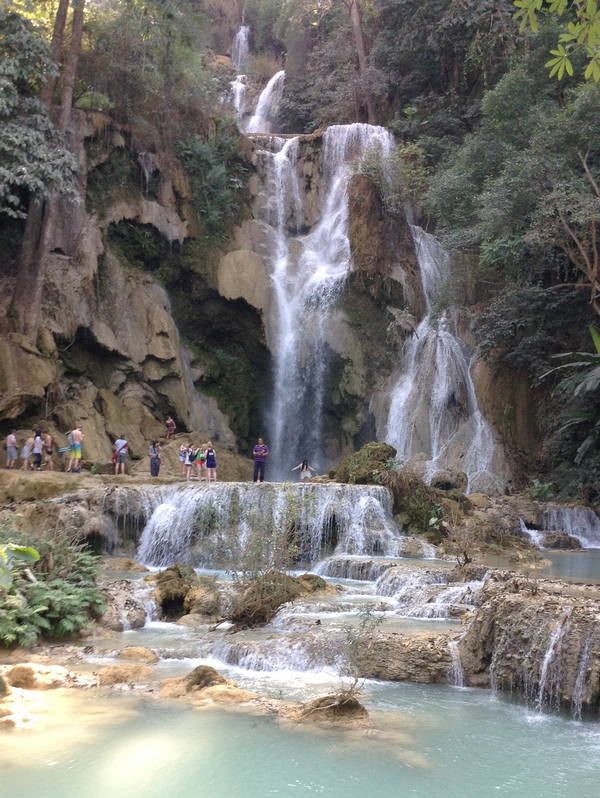
Getting fuel on the ride back to Luang Prabang at a full service gas station

Breakfast restaurant is near the folk dancing stage
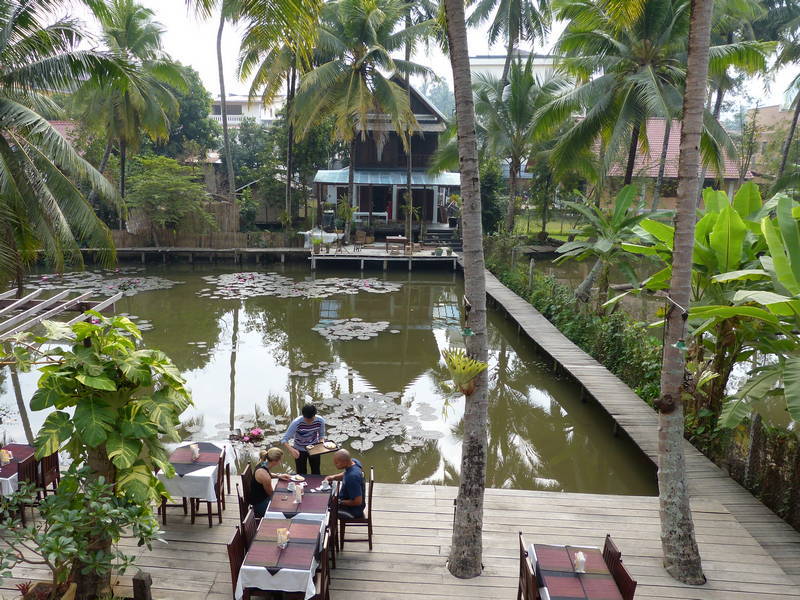
A walk up to Wat Phu Si the next day helped burn off a few of the calories from the previous night's dinner. Buddha statues appeared at every corner as we huffed and puffed our way up to the giant stupa including a Buddha footprint, a reclining Buddha, and a Buddha in a cave. Views of the Mekong River and surrounding peaks were spectacular. A small museum down below called the TAEC was delightful displaying traditional tribal clothing, baskets and dwellings of the Hmong, Akha and Khamu tribes. In the Royal Palace Museum we wandered around in stocking feet on hardwood floors. The royal family was exiled to some caves in northern Laos so the palace was converted into a museum. The king and queen's bedchambers were intricately decorated, along with a beautiful throne room. Rare Buddha statues were displayed as well as silver ceremonial artefacts, robes and masks. Out back, in a big garage we walked through what Ekke declared as the lamest car museum ever. The dilapidated Lincoln Continental, an old Citroen and rickety old speedboat had been used to transport the royal family, but they weren't really in any condition to be on display. (Good thing no photos were allowed inside)
Climbing the stairs to Wat Phu Si

With many statues of Buddha along the way
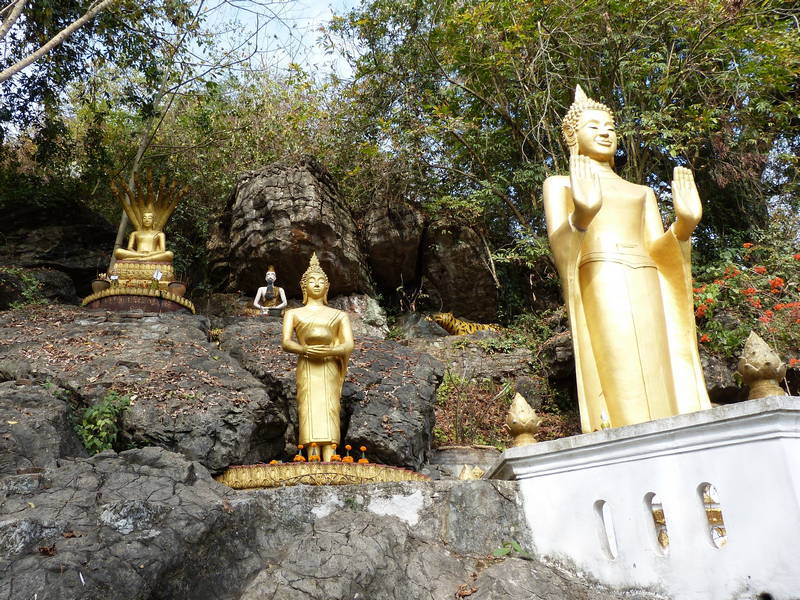
Tuesday Buddha looks pretty relaxed
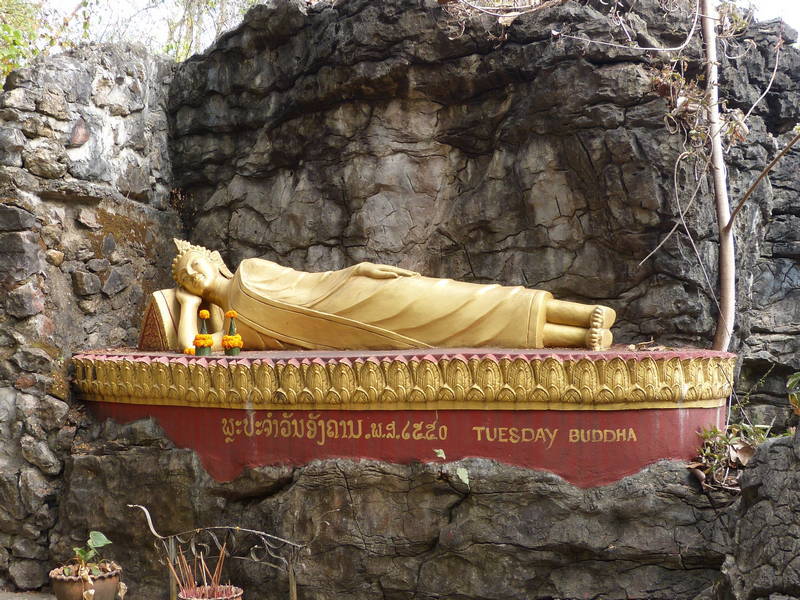
Teacher Buddha is one of Audrey's favourites

In the TAEC museum
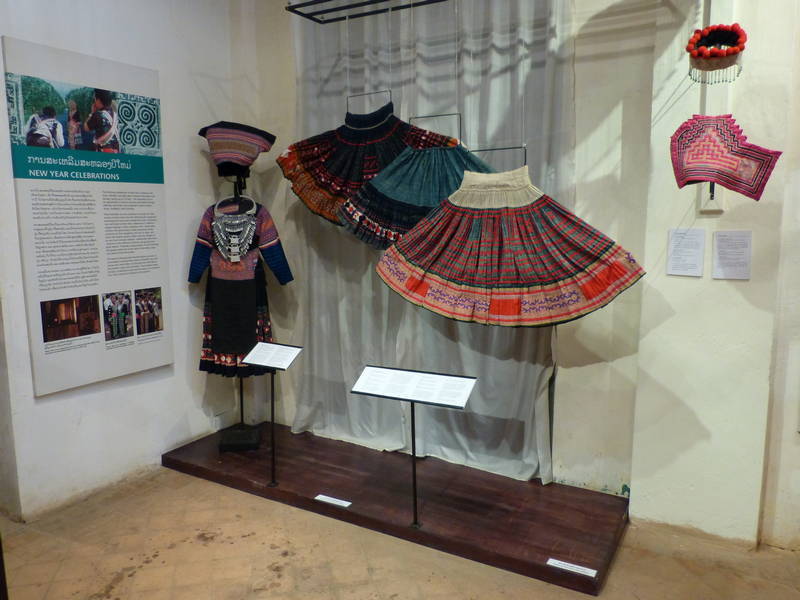
A temple outside the Royal Palace Museum
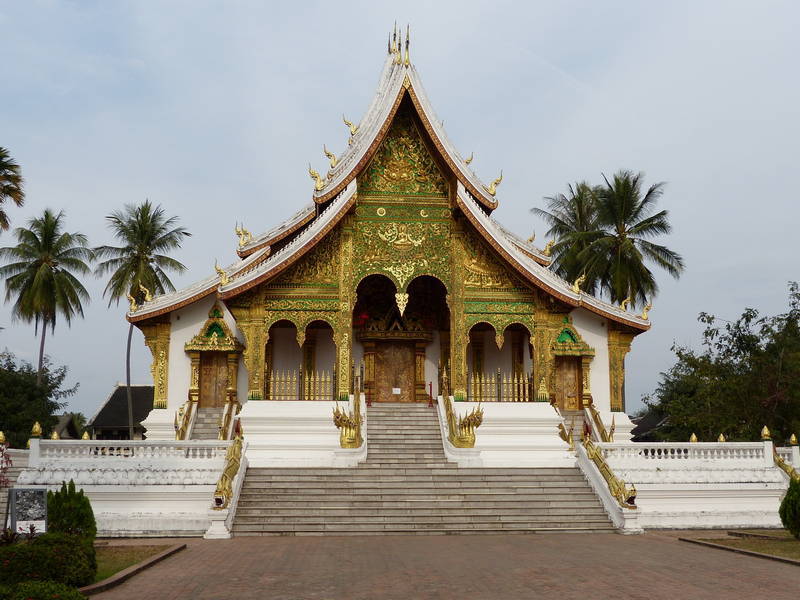
Joma cafe was on our potential list of places to eat, so we tried it for lunch. It was quite well done, with wood decor, made-to order sandwiches, lasagnas and quiches. As we ate, I observed that everything about the place seemed oddly familiar. The lasagna wasn't quite Italian and the quiche not quite French. It was all really, well... Canadian. It was confirmed when Ekke spied the Nanaimo bars. Nanaimo bars, right in the middle of Laos! When we Googled it later, we found out that Joma was owned by two Canadian couples from British Columbia, Canada, thus explaining why everything felt so familiar and to our tastes. Fantastic. They serve fair trade Lao Arabica coffee and donate a percentage of their profits to the 'For People and Planet' plan.
A Nanaimo Bar in Laos?!?
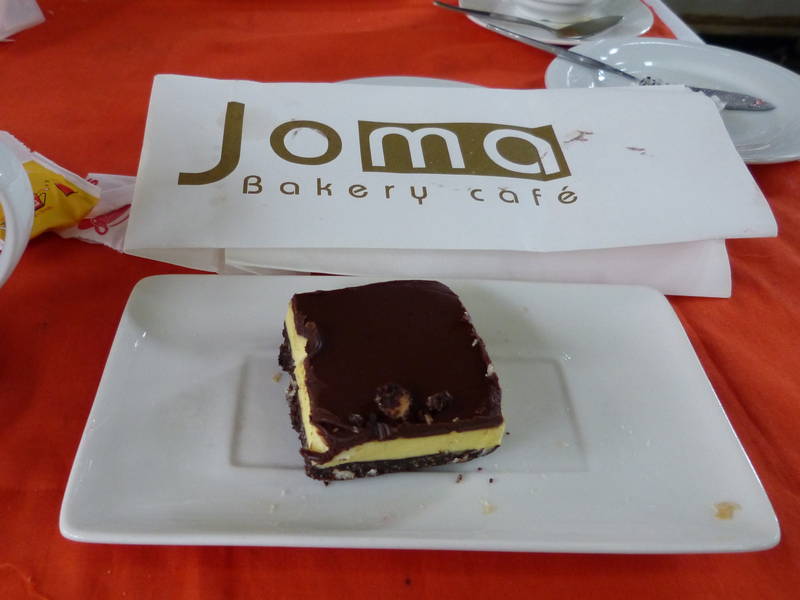
It rained heavily all night long, which was a bit of a worry as we had booked an elephant trek for the next day, January 30th. We had seen elephants in Africa, but they weren't for riding so we were really looking forward to this. The rain had let up by morning and a van picked us up at our hotel at 9:00 AM. The elephant camp was a few kilometres out of town and construction had made the road so muddy that the van slipped and slid its way along. Another van was stuck, the passengers standing in the mud outside awaiting another van to pick them up. The elephant camp was a short walk up a muddy hill, and we climbed stairs up to a raised platform. It was raining a bit so we donned our raingear. A purpose-built bench was placed upon thick blankets on our elephant and then strapped down. I said that I was worried that we were too heavy for the elephant but was assured that it could carry 500 kilograms. Good thing we had a small breakfast. When we climbed aboard it felt really tippy and our mahout, the elephant manager, told us to shift our weight to the middle. He rode on the neck and we headed into the jungle with two other elephants. It felt pretty comfortable and just as I was getting used to it, we approached a steep hill. I thought, we must be going around it somewhere because it looked too steep for the poor elephant to make it up. Our mahout told us to lean forward as we went up, the elephant carefully stepping up the muddy slope. It really felt as if we would tumble off with the angle of the slope but the elephant persevered with instructions being called out by the mahout and a few tugs at its ear with a stick. Soon we were on flat ground again. Later, our mahout got off and took some photos of us. We felt pretty regal up there, like the king and queen, and we understood why people enjoyed it so much. The path turned unbelievably steep and muddy, and then a few big rocks were thrown into the mix. The elephant stepped carefully through it all and took us back to the camp. After feeding our elephant some well-deserved bananas, purchased from a small shack nearby, we wandered back to the platform area. Another couple had just ridden in on their elephant. All of a sudden the huge beast turned and trotted toward the banana shack, scooping up a bunch of free bananas with its trunk. The clerk leaped back and along with several others, made for the safety of the raised platform. The rogue elephant then just wandered away, the surprised couple still sitting on it. They were rescued by another mahout who rode a huge elephant that nudged the rogue elephant back. The couple transferred onto the big elephant, and all was well again.
Audrey checks out the elephants, looking for the best one
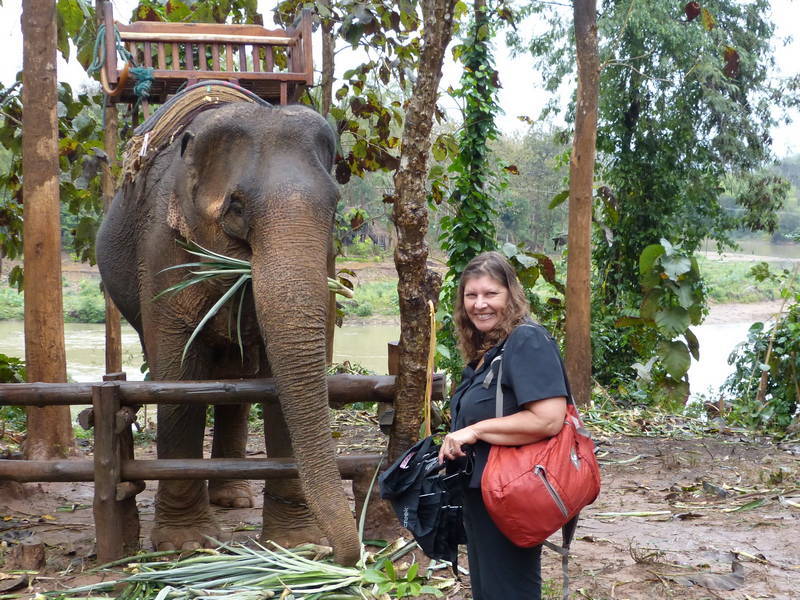
Our elephant's mahout sits on the neck of the great beast and steers it with his feet in the ears

Whoa, that looks too steep

Stop for a photo op of us on the elephant

And a photo op of the mahout

Water crossings are taken in stride
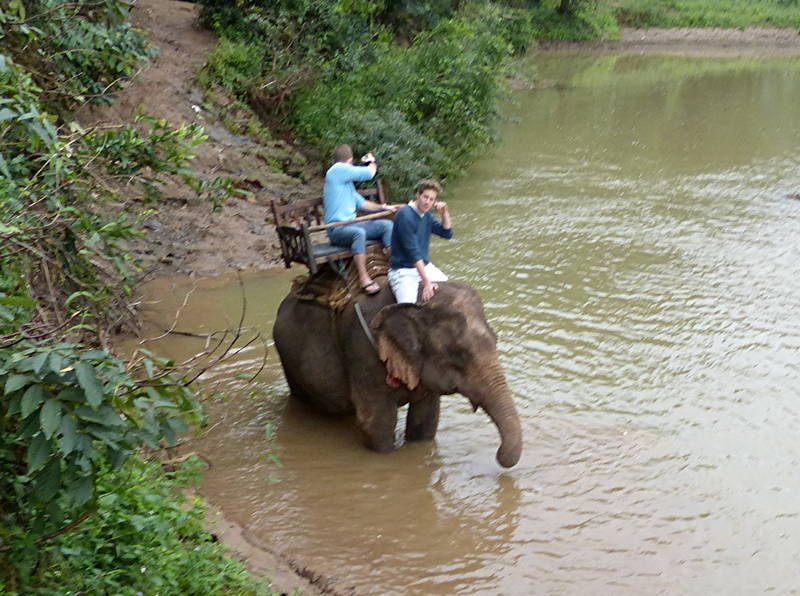
Giving our elephant a tip for a job well done
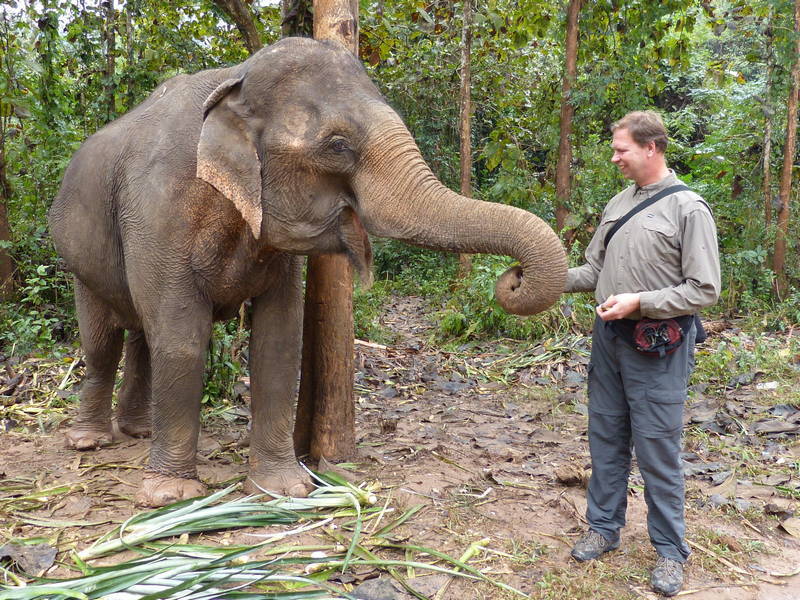
While a rogue elephant takes his own tips at the food stand
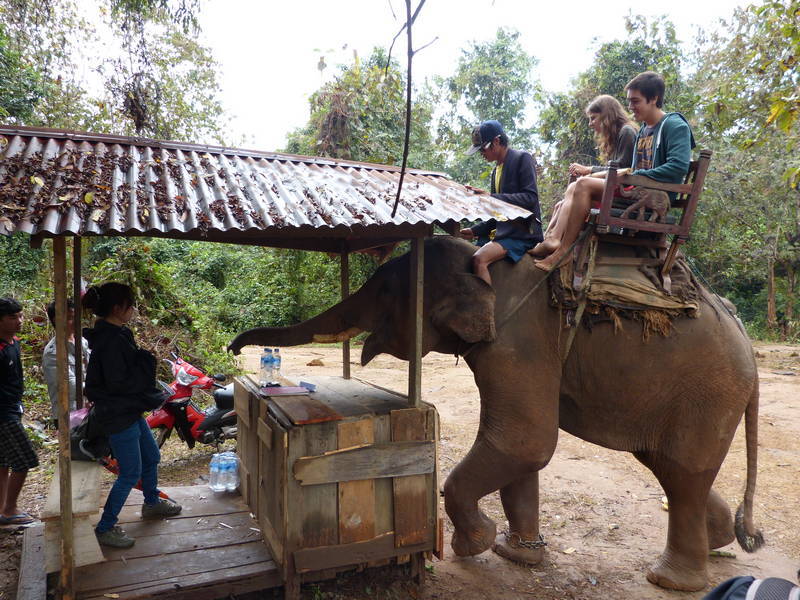
After another lunch at Joma, our new favourite cafe, we took a long walk around town. Many of the 600 former French villas were on the UNESCO list, waiting to be restored. Many were left to crumble, but it was that which gave Luang Prabang its quaint atmosphere. Some of the villas had become boutique hotels, way beyond our price range. It was pleasant just wandering the streets, a temple here, a villa there. Down some steps to the Mekong, we got on a longtail boat and went on a sunset cruise. The Mekong was quite wide here and it was bustling with activity. There were fishers throwing out nets, locals eating fresh fish at riverside shacks and kids playing soccer on the beaches. A rustic, wooden funicular leading up to a villa was for transporting goods up the hillside in a big wooden cart. On our walk back to the hotel we passed by a bustling night market, just packed with tourists shopping for woven goods and elephant slippers.
Beautiful French-era villas abound in Luang Prabang
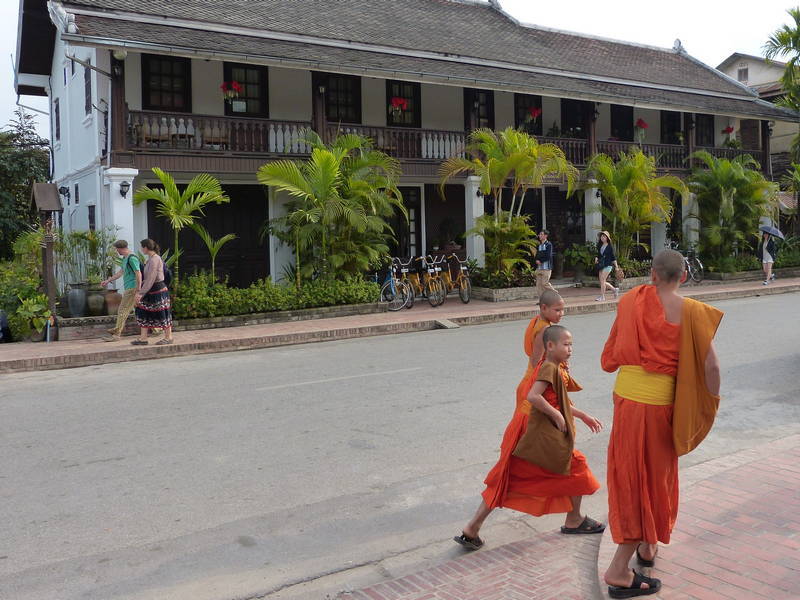
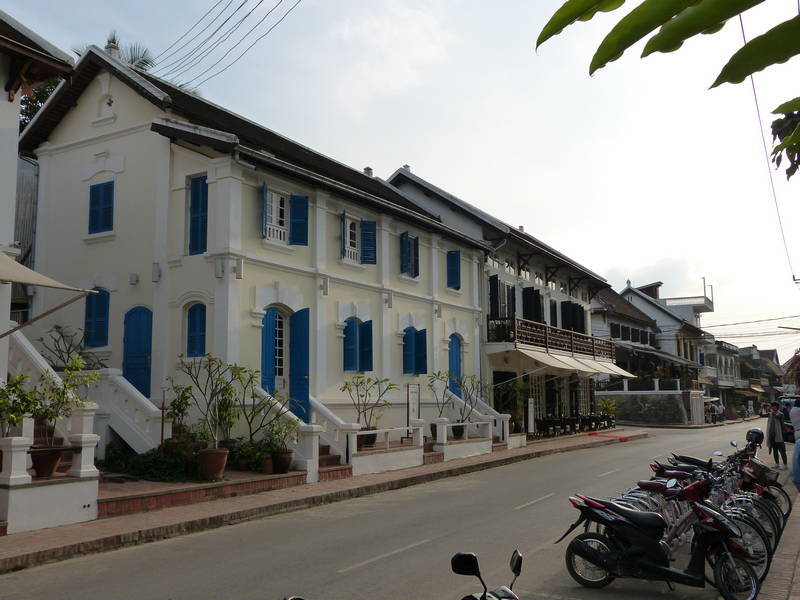
Luang Prabang is liberally sprinkled with temples
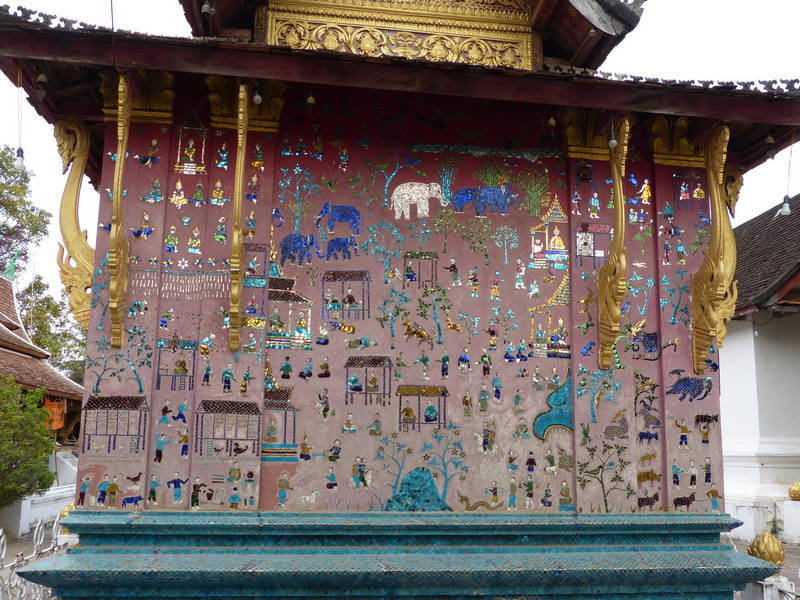
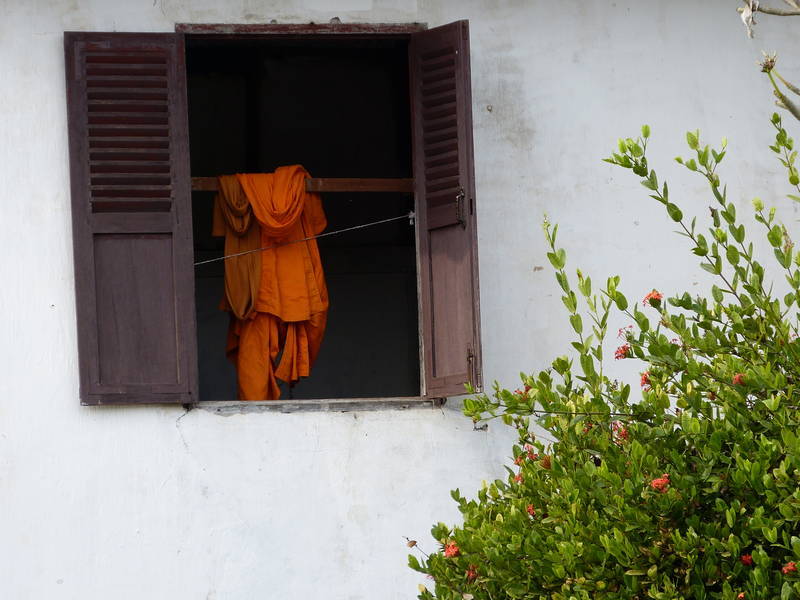
Rickety bamboo bridge across a tributary to the Mekong gets washed away every wet season
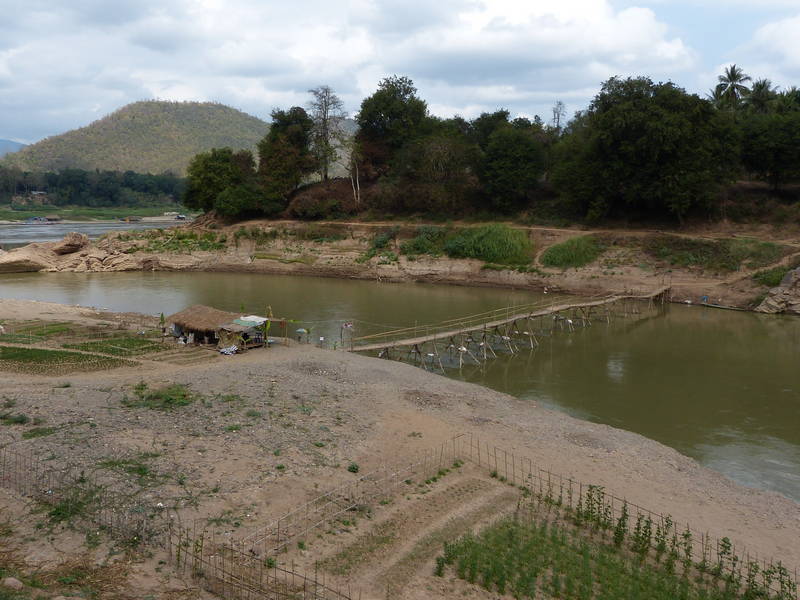
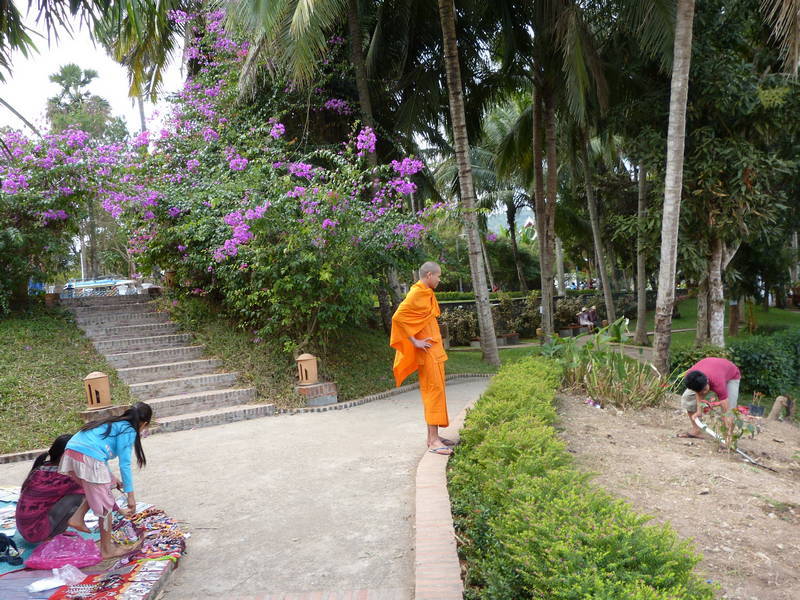
The Mekong looks inviting for a sunset cruise
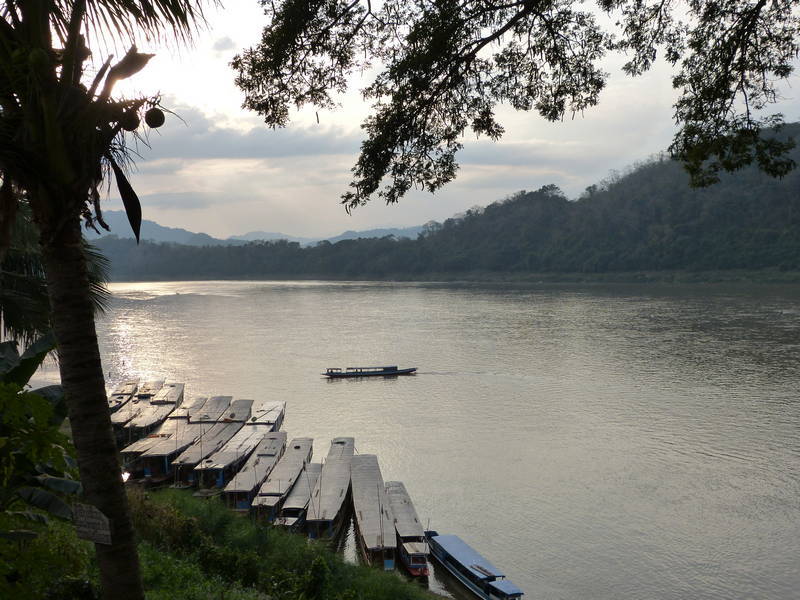
Steps down to the boat landing


Neat funicular for taking supplies up to the villa
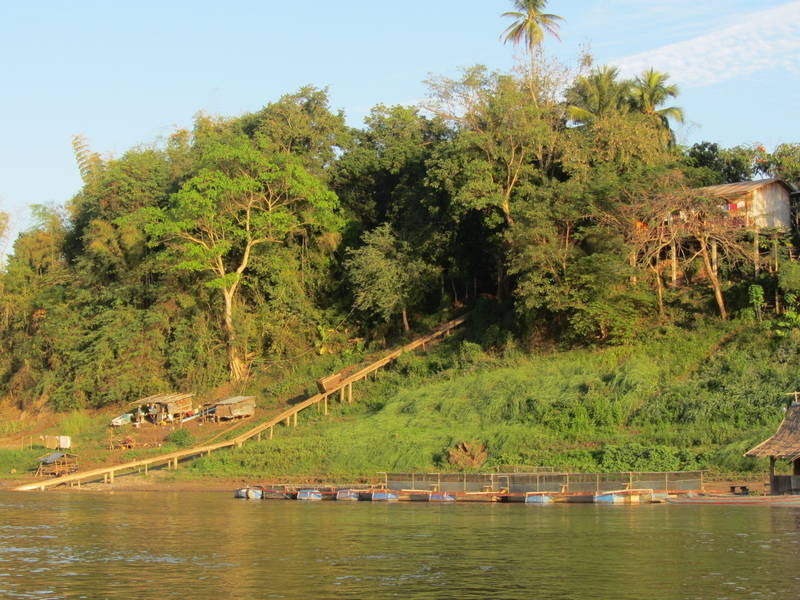
The moment we've been waiting for, sunset

Strolling Luang Prabang in the evening
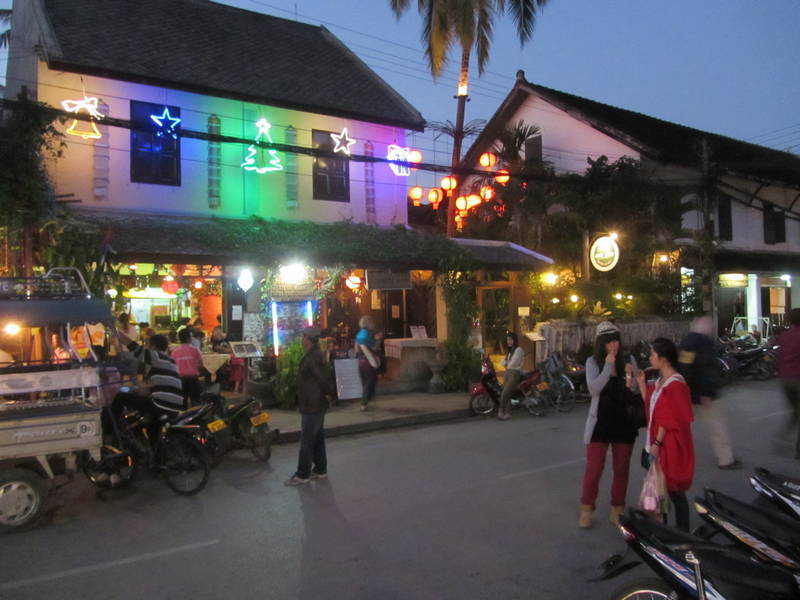
And stopping for a delicious smoothie
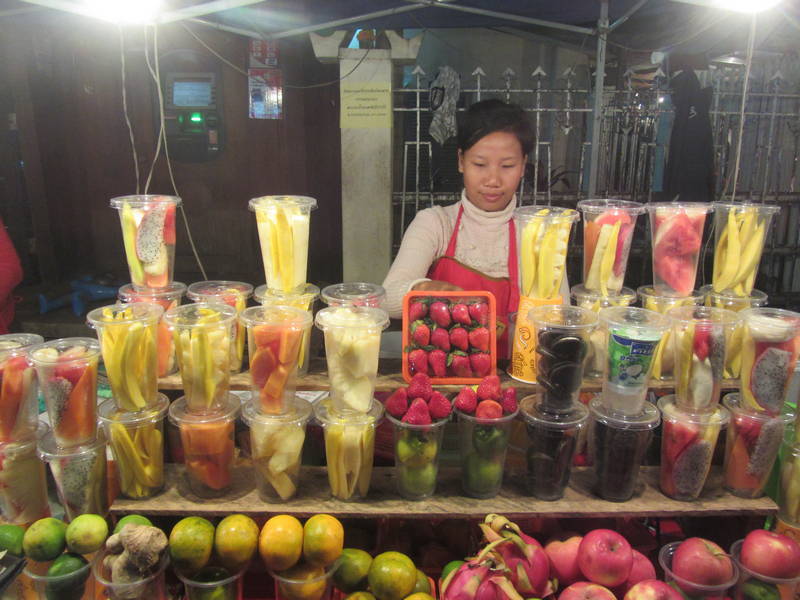
Our stay in Luang Prabang could have gone on much longer, but it was time to move on if we were to make our tour to Vietnam on time. The morning of February 1st we rode out into the countryside and the curvy road started almost immediately. It was motorcycling heaven for most of the day. As we climbed higher into the mountains, the fog started to burn off and the sun appeared. Our lunch spot provided spectacular views of karst formations sticking up like medieval fortresses in the distances. The chicken fried rice with a fried egg on top was delicious. It would almost have been a perfect day of riding but then we came upon a construction zone that consisted of deep dirt with a couple of tire tracks running through it. Ekke just hit the gas, whereas I wanted to slow ride through it, just to be sure I made it through in one piece. I rounded a corner, and there heading right toward me was a huge bus. We shared the same track, with dirt mounds to the right and left. I had nowhere to go. The driver beeped as we stood nose to nose. I looked up and just shook my head, no, I couldn't move over. After waiting each other out, the bus driver gave up, steered right and headed over the mound of dirt on his side. I just held my breath as he went past, the huge vehicle coming within millimetres of my saddlebags. Phew.
Riding south from Luang Prabang and up onto the mountains
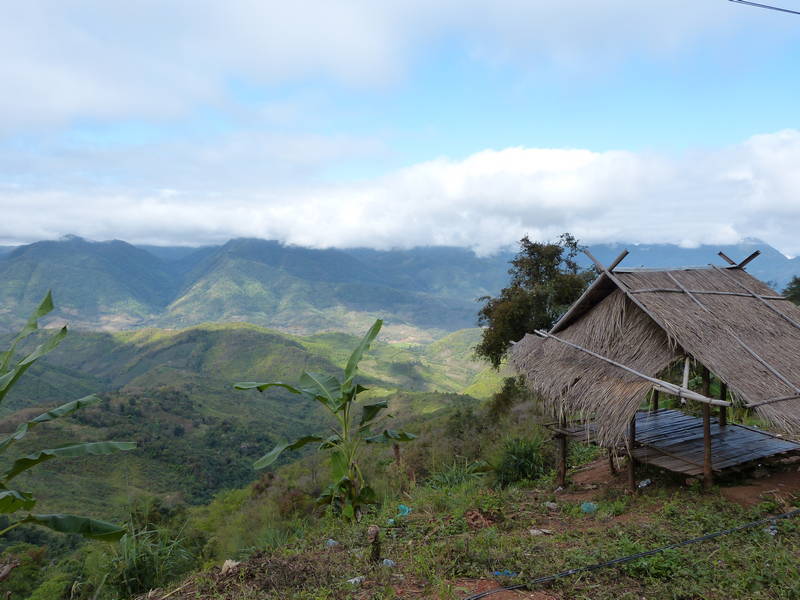
Curvy roads
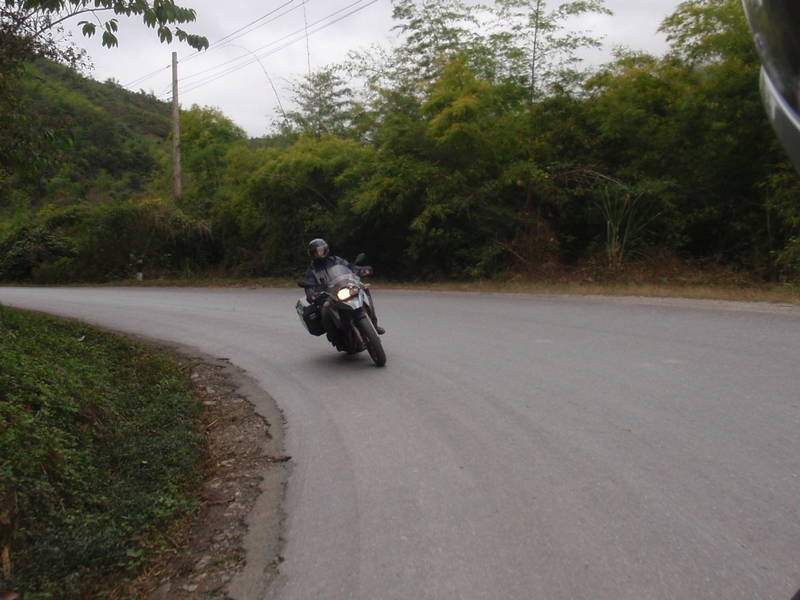
And lush jungle

Misty mountains
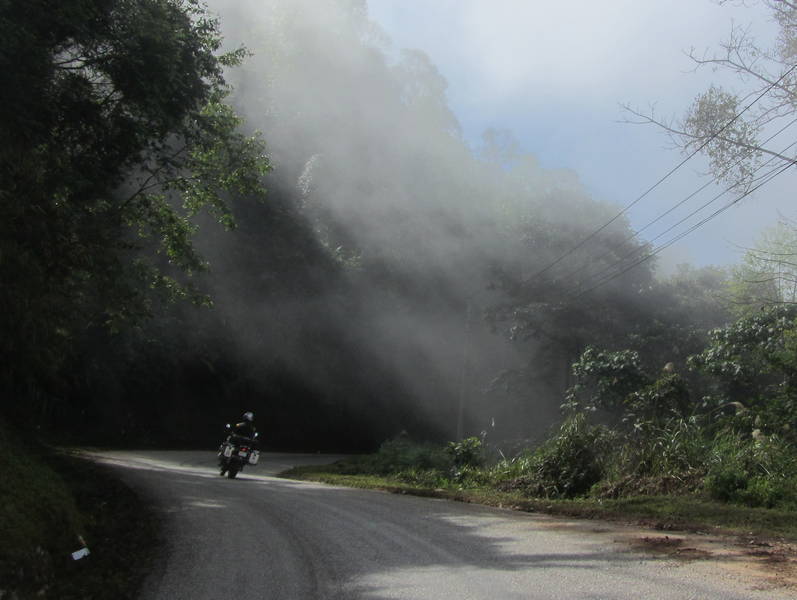
Other motorcyclists enjoying the great riding

Getting closer to Vang Vieng the scenery (if possible) became even more amazing

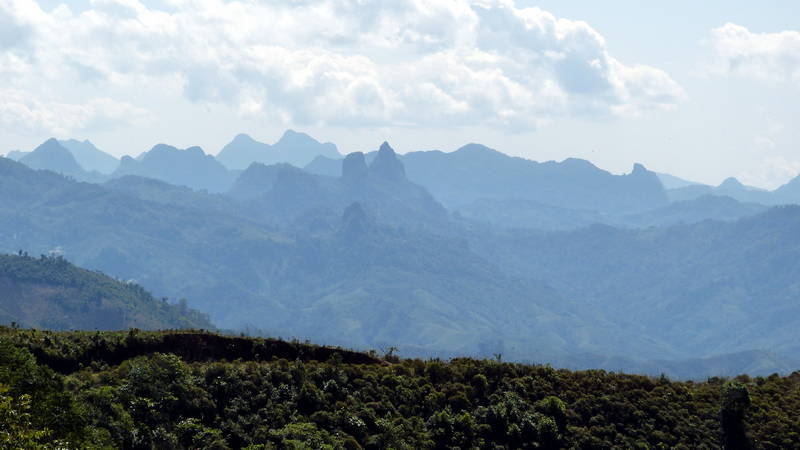
Parked for lunch
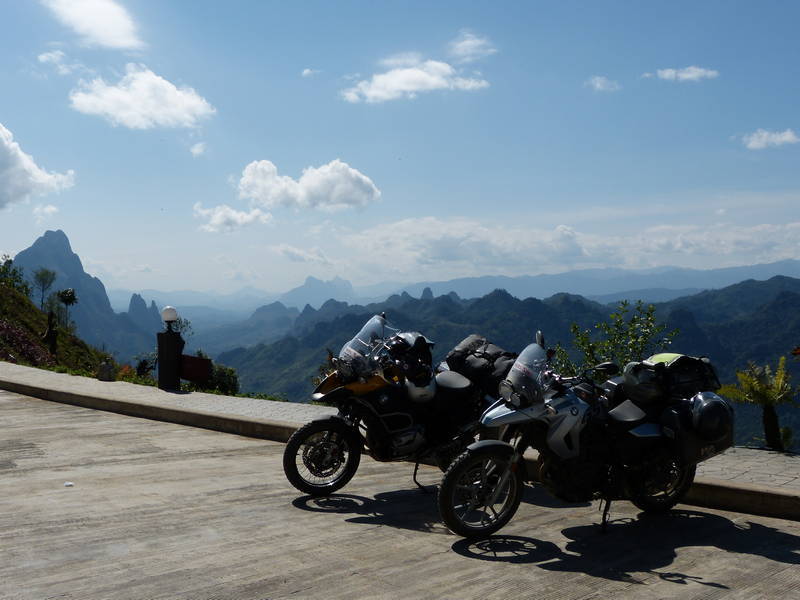
An after-lunch photo op
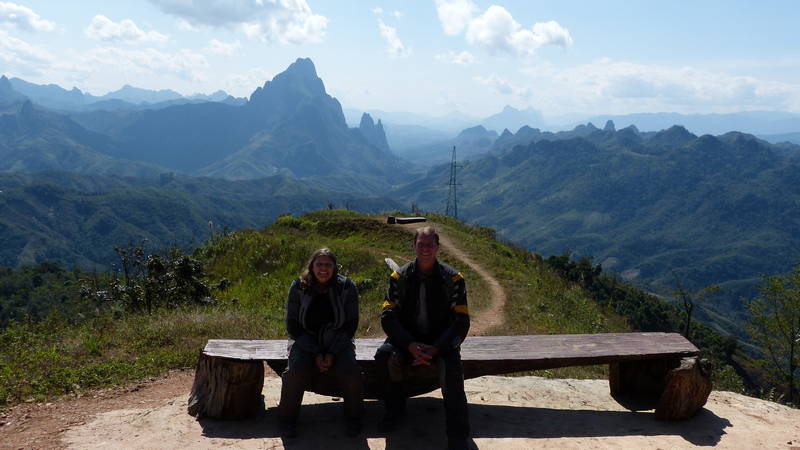

Approaching Vang Vieng as school lets out
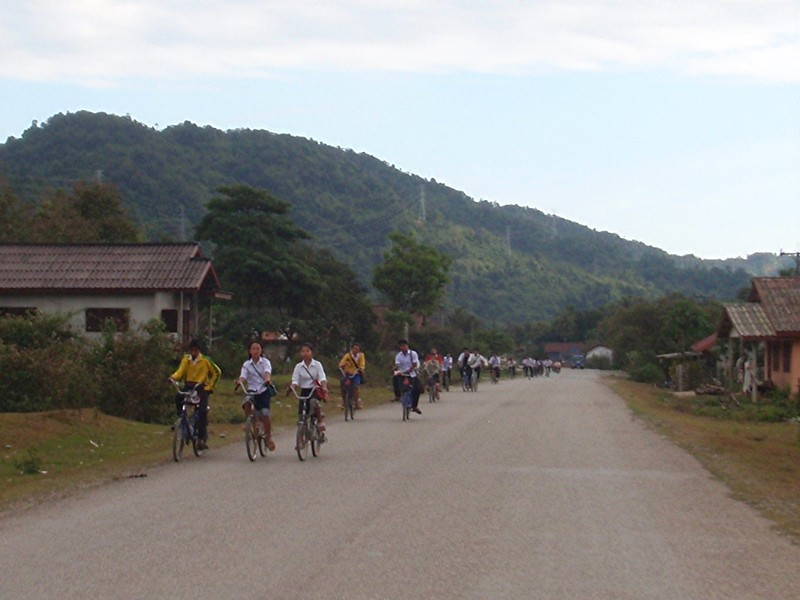
Our hotel in Vang Vieng, the Thavonsouk Resort, had a view of the Nam Song River where people were floating down in kayaks and tubes, taking advantage of the sunny afternoon. I was dogged after a long day of riding and just relaxed in a deck chair, taking it all in. The town is known for climbing and caving, surrounded by craggy karst peaks. After a great pasta dinner, we enjoyed banana flambé for dessert, and it really flambéed when the half a cup of brandy was poured over top and lit.
Sitting at the Thavonsouk Resort on our deck

Watching the lazy Nam Song
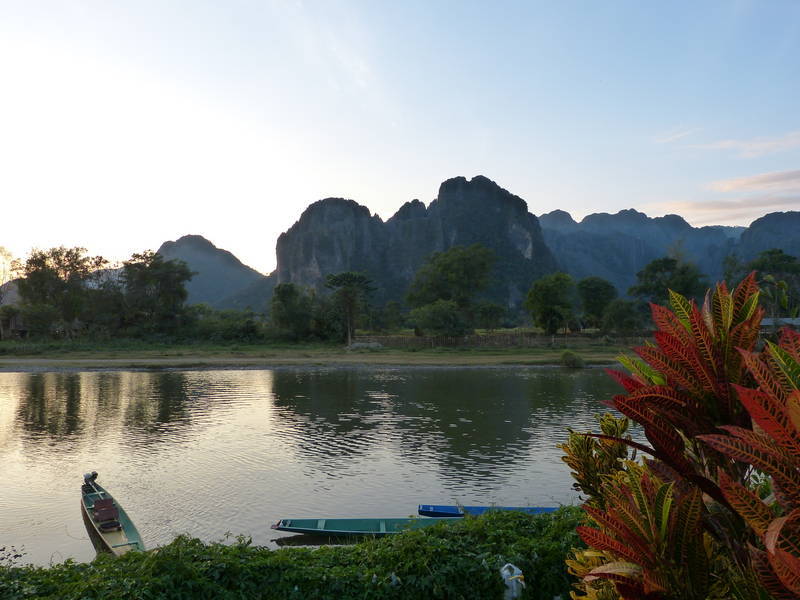
We thought this was a pedestrian-only bridge but scooters proved us wrong

A lovely walk in the morning, February 2nd, took us to a car bridge over the river. Unfortunately it cost us 4000 kip ($0.53) return per person. The unfortunate part is that we found a little suspension bridge further upriver, with no toll. As we got back to the hotel, we noticed a couple on mountain bikes starting their daily cycle. We left late and eventually passed them, about 45 kilometres out of town. I wonder if they made it to Vientiane that night. The road was hilly and pleasant at first, and then got straighter and busier about 70 kilometres from the city. When we stopped for gas and a cold drink, we noticed a crowd forming across the road. The gas station attendant said it was a wedding. A voice started yelling across the P.A. system and gave us a bit of a start. Then a band started playing, and it was unbelievable how loud it was. When we put in our earplugs and rode away, we could still hear a thumping beat, way too loud for us. We came across a few wedding receptions later in Laos and the loud music, whether a live band or cd's, was definitely a pattern. Vientiane was an easy city to navigate through and our Best Western hotel easy to find. The only parking was on the sidewalk, but we felt the bikes were safe, especially after putting on disk locks, bike covers and activating my alarm system. February 2nd means 'Groundhog Day' and we sat on our sofa and watched the movie on the laptop, a once-a-year tradition. The most memorable February 2nd so far was in 2008, when we sat in a tent in Marsabit, Kenya, enjoying Bill Murray's comic genius.
Nice breakfast overlooking the Nam Song
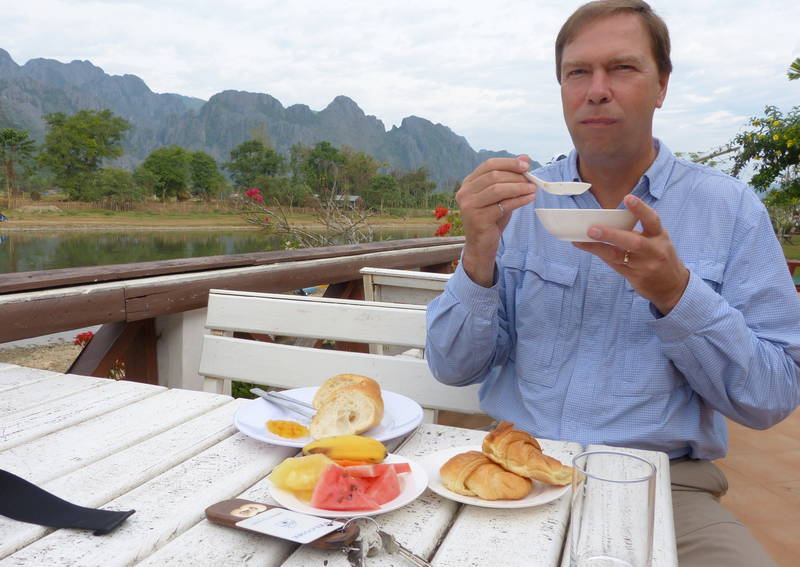
Stopping for a seaweed-flavoured Pringles break on the way to Vientiane (memories of Japan)
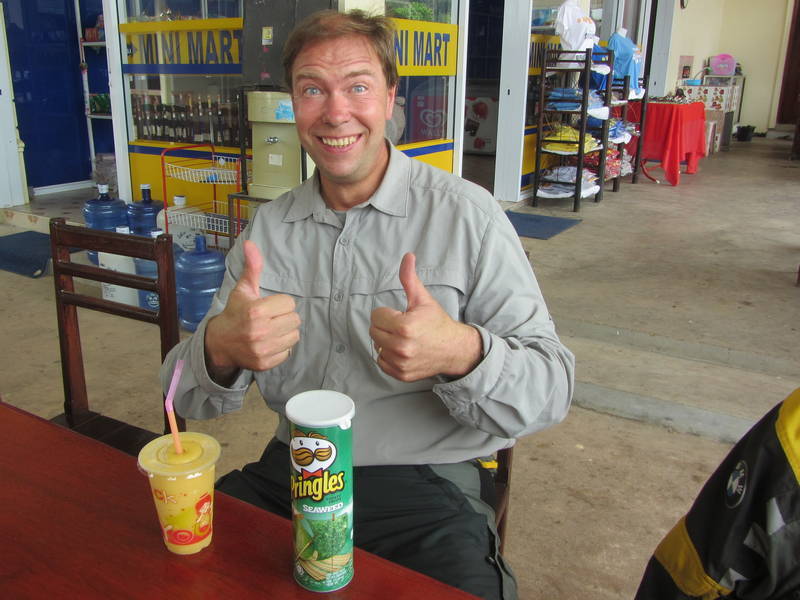
Temple just down the street from the Best Western
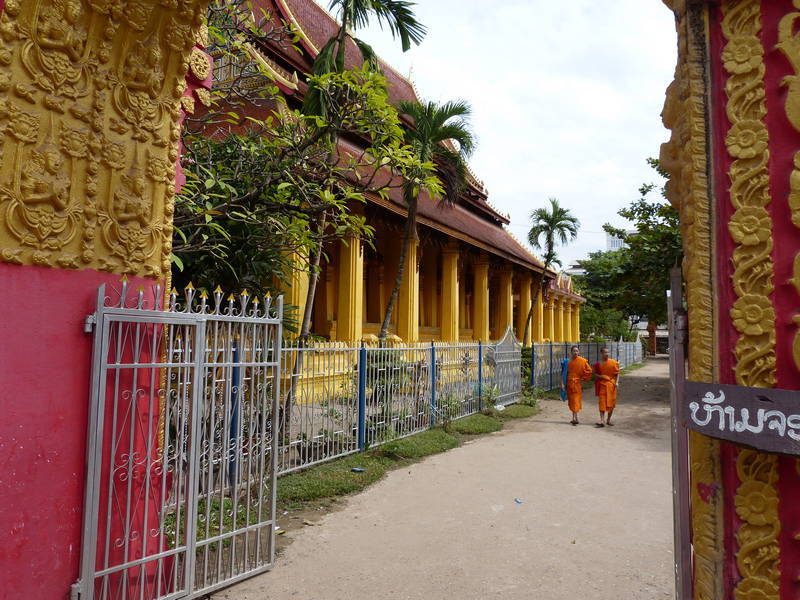
Audrey checks the bikes outside the Best Western

Being the capital city, Vientiane has some really interesting things to see. We walked by the Presidential Palace, and it really reminded me of the Winter Palace in St. Petersburg, Russia. Across the street was a beautiful wat or temple, the Wat Si Saket. This one was very special because the arcade surrounding it contained thousands of little Buddha statues, each in its own little niche. We walked to the museum across the street, Haw Pha Kaew. It was purpose-built to house the Emerald Buddha, which had found its way to Vientiane in 1564. The Buddha was transported back to Thailand in 1779. Walking up tree-lined Lan Xang Avenue was a bit like walking the Champs Élysées in Paris. At the end of a big, wide boulevard stood a huge triumphal arch; the Patuxai. We climbed up to the top for some exercise and great views. For dinner, Fuji Japanese restaurant was conveniently located near our hotel, so we went in to see how authentic it was. The sushi, porkrolls and tempura were all fantastic. The only thing that was not authentic was the price. $22 for everything was amazing. It would have been double that in Japan.
Presidential Palace in Vientiane
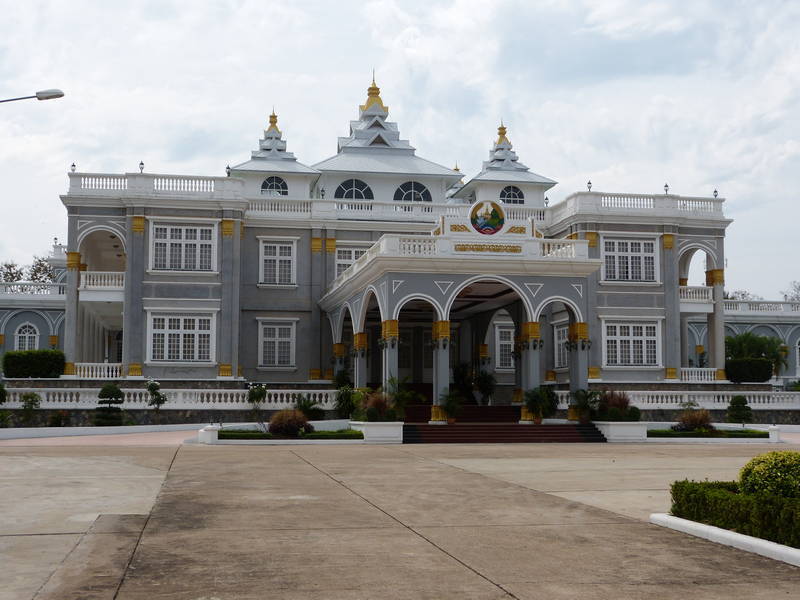
Wat Si Saket
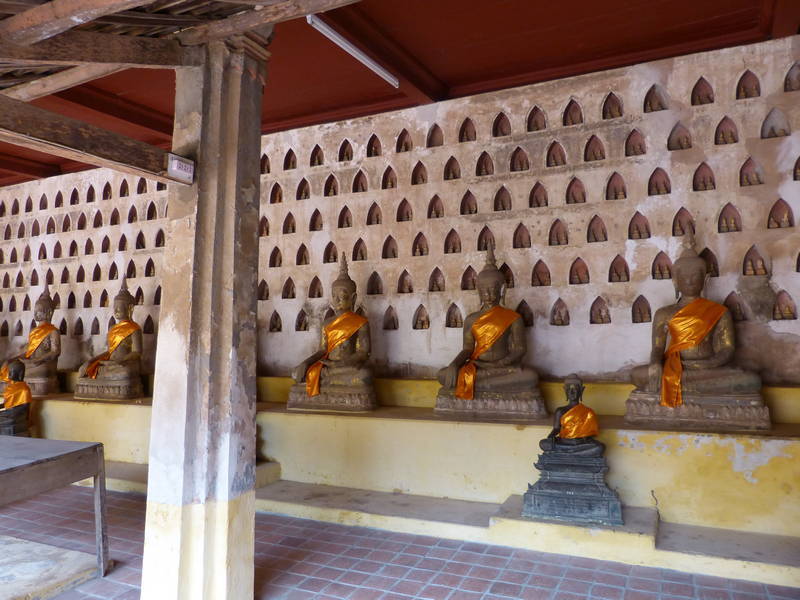
Patuxai (Victory Gate), dedicated to those who struggled for independence from France
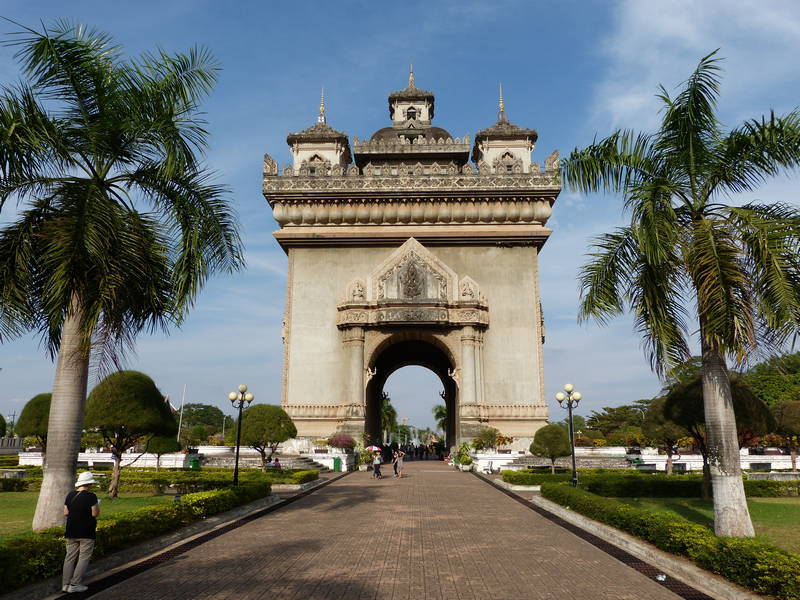
Has nice views from the top
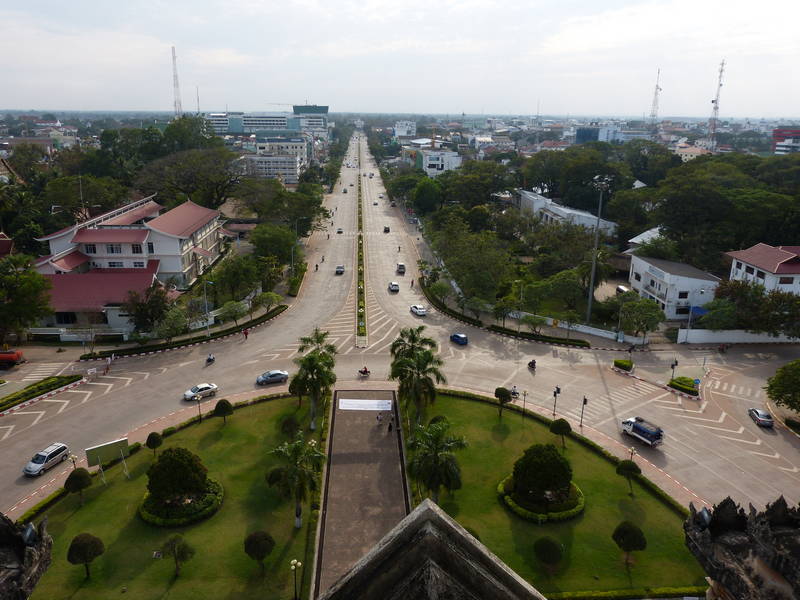
We caught a tuk tuk to the Vietnamese embassy the next day, February 4th, to see if we could get visas. As we waited outside the gates we chatted with a former StatsCan worker who loved Laos so much that he decided to live there. They finally opened up at about 10:00AM (we thought they opened at 8:00 AM) and a crush of people moved into the visa office. Filling out the forms while standing in line worked well, and, just as we had glued on visa photos we were at the front of the line to submit the applications. Because of a price increase as of February 1st, it cost $70 U.S. for same-day processing. From experience we thought this meant picking up the visas later that day. They asked us to wait for a few minutes and then called us over. Maybe our application was incomplete? No, the visas were ready, glued into our passports. The fastest visas ever. We tuk-tuked over to an international clinic to have my leg checked out. It had been swollen since the kayaking incident, so I thought I'd better have it looked at. I got a complete blood test and was asked to return for an ultrasound the next day. The facility was a little rough around the edges, but to get the results of tests almost immediately, and have them in my hand to look at was impressive. After a quick Joma run, (yes, they had the Canadian restaurant here in Vientiane), I rested at the hotel while Ekke wandered the market, searching for souvenirs to send back to Canada. He found some great elephant sculptures. (Happy Birthday, Chieko).
Nice shiny tuk-tuks lined up

Laos wiring
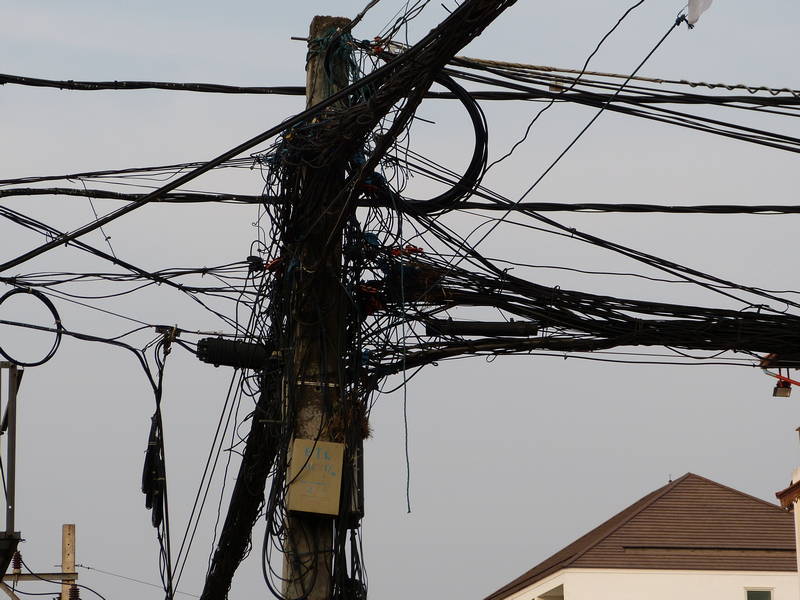
Ultrasound results confirmed that I had DVT, deep vein thrombosis in a knee vein. The doctor said that as long as I took medication, I should be able to continue the trip. It would mean staying in Vientiane a bit longer, for more tests, but we were enjoying it here. We only had to step outside the front door of our hotel and there were restaurants, temples, and a night market by the Mekong. Ekke used the time to research shipping companies and contacted Thai Airways Cargo in Bangkok to get quotes for shipping the bikes. He was told that we needed a freight forwarder. After contacting them, we discovered that it would cost about $3000 to ship two bikes to Kathmandu.
On February 7th, we took advantage of the gift of time and worked on the Japan chapter. Good thing we had eaten Japanese food recently, as it brought back all the great memories. A long walk beside the Mekong afforded us great views of Thailand on the other side. The waterfront area had been really developed nicely, with pathways and parks.
Visiting one of the many temples
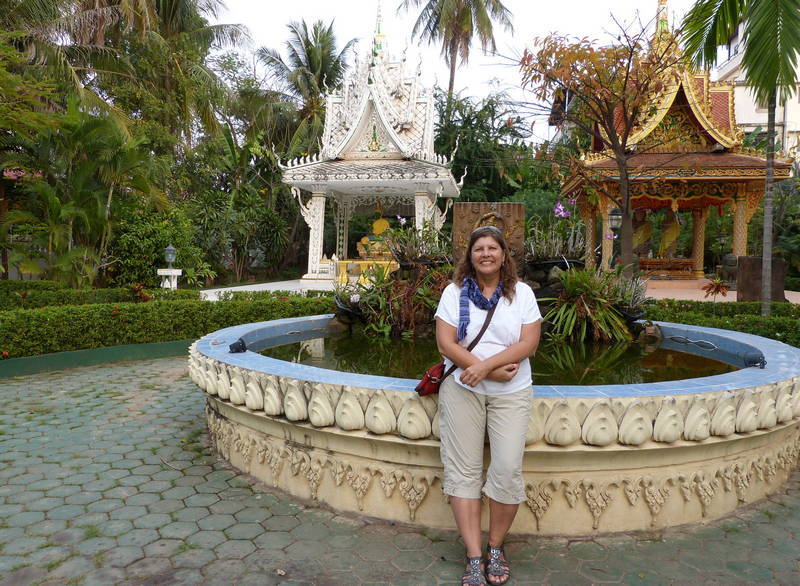
After breakfast, always fantastic at the Best Western, Ekke went to wash his bike. When he came back he told me that he was going to wash the F650 for me and I felt sorry for him that he was exerting himself in such heat. (I found out later, through Facebook that he sat back and watched while others did the washing - busted). We tried the Istanbul Restaurant across the street and agreed that we really liked Turkish food. We also got to use our limited Turkish, saying Merhaba (hello) and Teshikir Edereem (thank-you). We discussed how the trip would be impacted by the DVT and what level of risk was acceptable. Back at the hotel, I phoned my doctor in Canada at 11 PM, 9 AM Calgary time. He confirmed that the trip could continue as long as I got regular blood tests, was near consistent medical care and avoided high altitudes. Okay, so this would take the Himalaya of Nepal and northern India out of our plans. Also, how consistent was the medical care in rural Pakistan? Disappointed.
"Ekke" washes the bikes

Nice clean bike in front of the Golden Stupa is checked out by a local
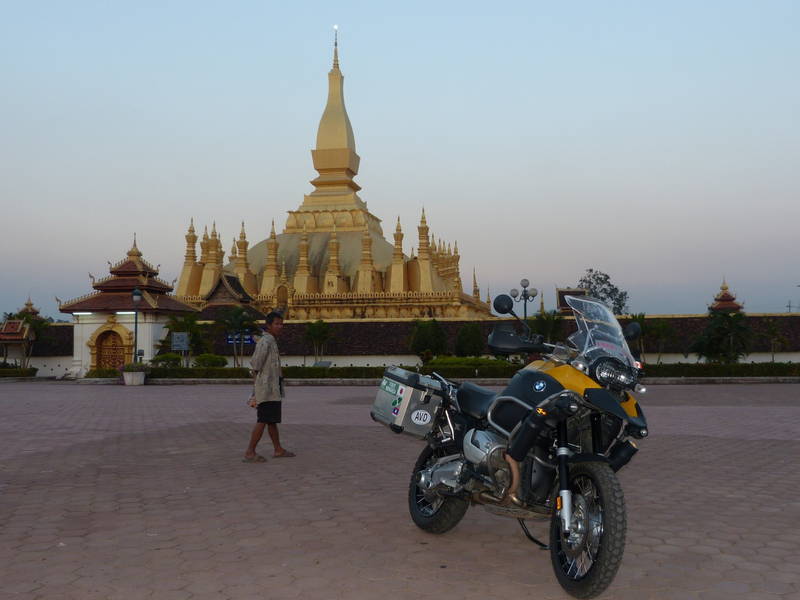
The next day, it got even more disappointing. I received an e-mail from my travel medical insurance company, Europ Assistance. They indicated that repatriation was medically necessary for my insurance to keep covering anything DVT-related. We were floored. Was this the end of the trip?
So, we made the tough decision for me to fly home, get better, and then resume the trip in, hopefully, a few weeks. Europ Assistance checked my policy and said that as soon as I landed on Canadian soil, complete travel coverage would kick in again. We made plans to change hotels and chose the Mercure for their secure parking which the Best Western lacked. We rode to the Golden Stupa and Reclining Buddha for a photo op with the bikes. Our motorcycle gear felt so hot but we persevered as we had found an excellent location to take the picture. We just rode through the temple grounds, positioned the bikes in front of the huge Reclining Buddha, and put the camera on the tripod. I expected an orange-robed monk to come over and send us on our way, but it never happened.
Reclining Buddha
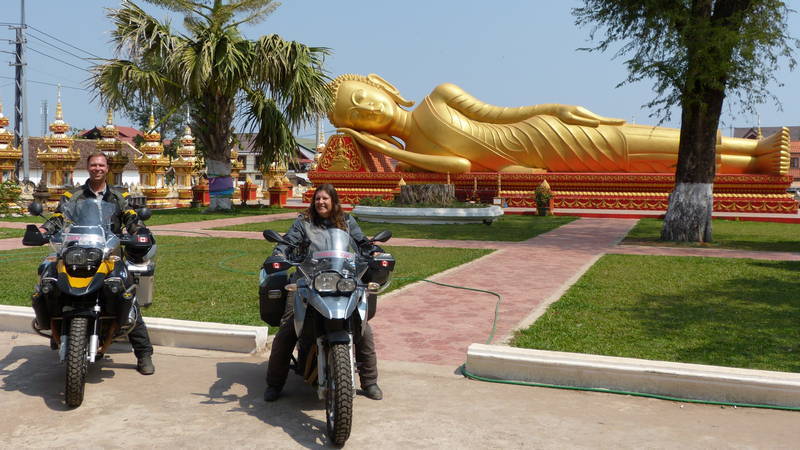
From our hotel room window at the Mercure we could see the motorcycles parked in the scooter-parking area. Apparently we could also hear what was going on down there because my security alarm started wailing. When we looked down we saw a guy climbing sheepishly off my bike. I love that alarm. At dinner we discussed what we should do about our tour to Vietnam. It was definitely out for me. I was fine with Ekke going on the tour without me, and it meant that he would have someone to ride with for a couple of weeks while I was in Canada.
Europ Assistance booked me on the first available flight. They needed to make sure that I had medical clearance from all the airlines and that each leg of the trip was in business class. On February 11th at 5:00 PM I took the hotel shuttle bus to the Wattay International Airport just outside of Vientiane while Ekke rode his bike to see me off. During dinner at the airport, the restaurant played non-stop 'missing you' songs the whole time, which didn't lighten the somber mood. I walked through the security gate, sad to leave Ekke, wondering, "When will I return?"
Leaving on a jet plane back to Canada

Map of our route through Laos to Vientiane
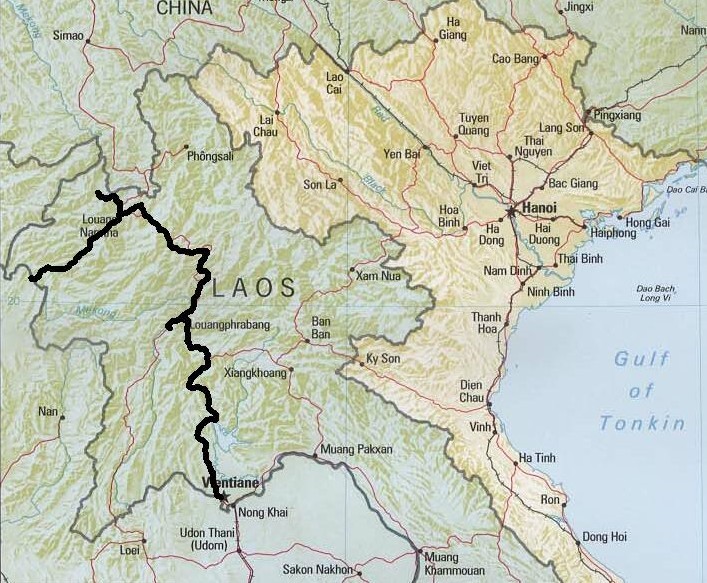
Bonus scooter section! Photos of nothing but scooters at the bottom of the page.
Ekke writes:
After Monday evening's tearful goodbye and a night spent in a large, empty hotel room at the Mercure it felt good, if strange to get on the road again. I made sure Audrey's bike was securely stored and her helmet and other motorcycle gear was safely packed away at the hotel's luggage storage and then hit the road on Tuesday, February 12. In order to be at the border with Vietnam to meet Tuyen, of Voyage Vietnam, on the 14th I had to put in a couple of pretty good riding days. First I backtracked north, past Vang Vieng to Phoukhoun before turning east. Leaving Vientiane it became immediately apparent that riding would be completely different for the next few weeks. Slicing through traffic was easier as I didn't need to ride for two bikes, I could flow through gaps that closed right behind me and not worry about losing Audrey. Out of the city my mirrors were empty; the comforting glow of the F650's headlight missing. North of Vang Vieng I climbed into the hills and the road twisted along the hilltops, going from village to village. It was fun but slow riding with convoys of Chinese cars (that is, cars with Chinese licence plates) providing some entertainment value. Were these Chinese tourists visiting Laos during the Lunar New Year holidays? Turning east there were fewer of the convoys and the empty road invited some spirited riding. I arrived in Phonsavan late in the afternoon, going straight to the Vansana Plain of Jars hotel where an e-mail response before I left Vientiane said they would have room for me. They did, and after dragging my stuff the length of the hotel (they gave me a room at the far end) I freshened up and had dinner. A large table with twenty Chinese tourists made for a lively evening as I enjoyed pumpkin soup and Lao lap (the national dish of Laos, a kind of spicy minced meat salad) with steamed rice.
Audrey's bike tucked away at the Mercure Hotel in Vientiane

Does anyone else think that having a beer company sponsor road signs is a bad idea?
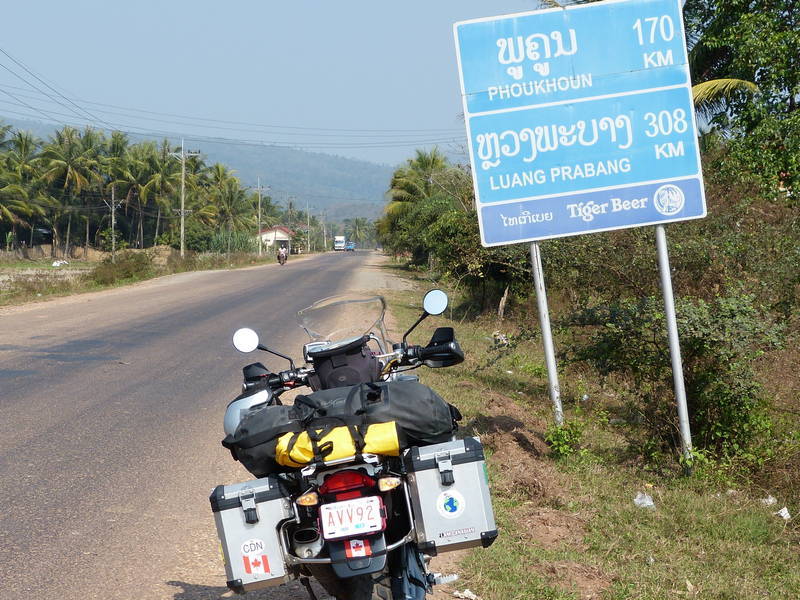
Great riding in the hills
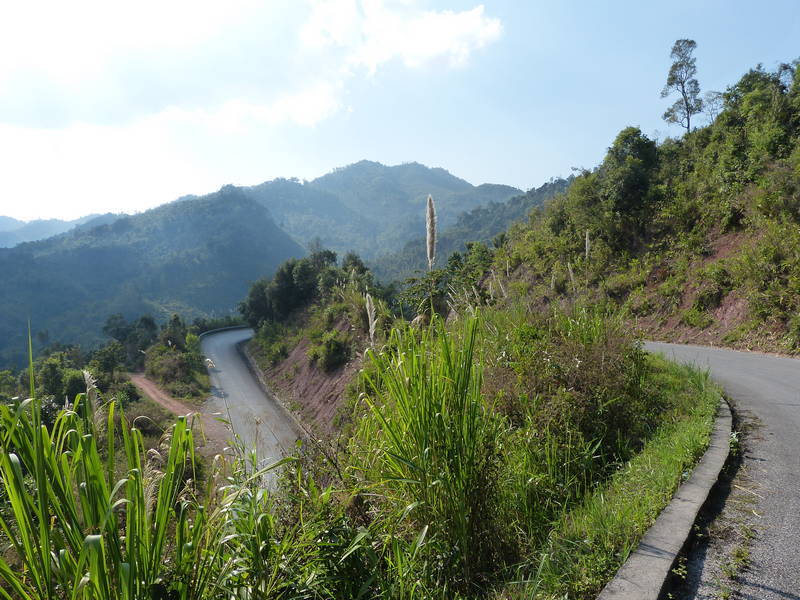
In the morning I knew I had a fair distance to go but I couldn't come to Phonsavan and not see the famous Plain of Jars. There are thousands of megalithic stone jars scattered around the plains near Phonsavan and I went to Site 1, the closest site. The damage inflicted by American bombs during the Vietnam War appeared to be relatively minimal, one just had to pay attention to the marker stones that indicated where it was safe to walk, hopefully not encountering unexploded ordinance. The large stone jars appear to have been used as part of prehistoric burial practices. After my short visit, I rode up out of the plains and back into the nearby hills. Again the road followed the hilltops where the villages were located. This was quite different from the roads through the mountains at home or in Europe where the roads and villages were in the valleys with only the occasional road over a pass. It was quite cool at the higher elevations with only 14 degrees showing on the thermometer when I was at 1,500 metres. But working the gearbox between 2nd and 3rd gear for most of the day kept me warm. A small village had a couple of tanker trucks parked in front of a restaurant so I stopped for lunch. I thought I ordered fried rice with egg but I received fried rice with little bits of mystery meat, gristle and bone instead. Still, at 15,000 kip ($2) for lunch you can't complain too much and then the proprietor gave me a bunch of bananas when I left. The road got a little worse in the afternoon and it was slow going dodging the potholes. A delay on a steeply cambered curve where a truck had lost its load meant that I didn't arrive in Vieng Xai until late in the afternoon, looking for a place to stay. I rode around town looking for guesthouses mentioned in Lonely Planet but the nicest sounding place was under renovation. Riding up and down the two main streets I did find some of the caves where the Pathet Lao lived during the Vietnam War. Up to 23,000 people lived in these caves to hide from the American bombardment and the caves held everything from bakeries to a theatre. I eventually chose what looked like the nicest of the guesthouses and got a small, clean cabin for what I thought she said was 20,000 kip ($3), certainly a good price if it was true. I appeared to be the only person at the guesthouse as I sat by myself in the chilly outdoor restaurant. This time I received an egg with my fried rice and didn't have to pick out gristle and bones. I read up on the Vietnamese border crossing in LP and was encouraged to read, "This remote, seldom-used and often difficult border is an adventurer's delight."
Plain of Jars near Phonsavan
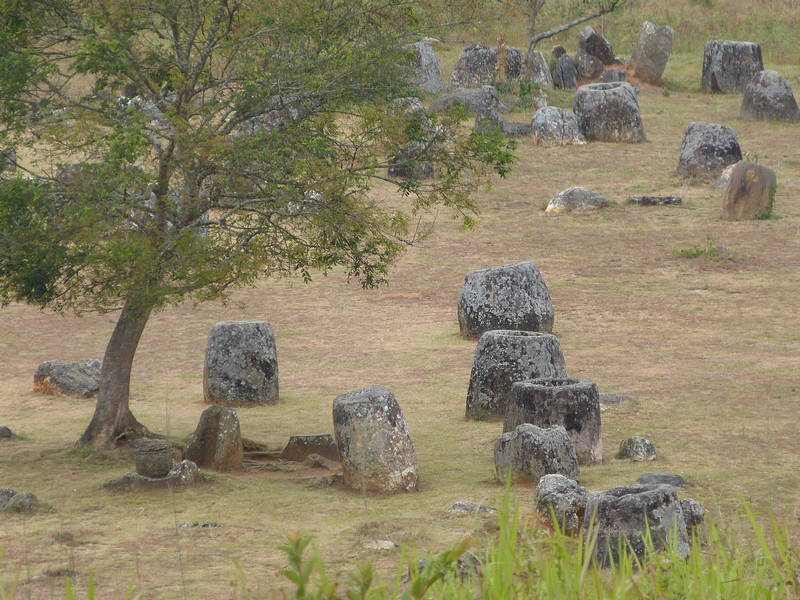
The largest of the jars
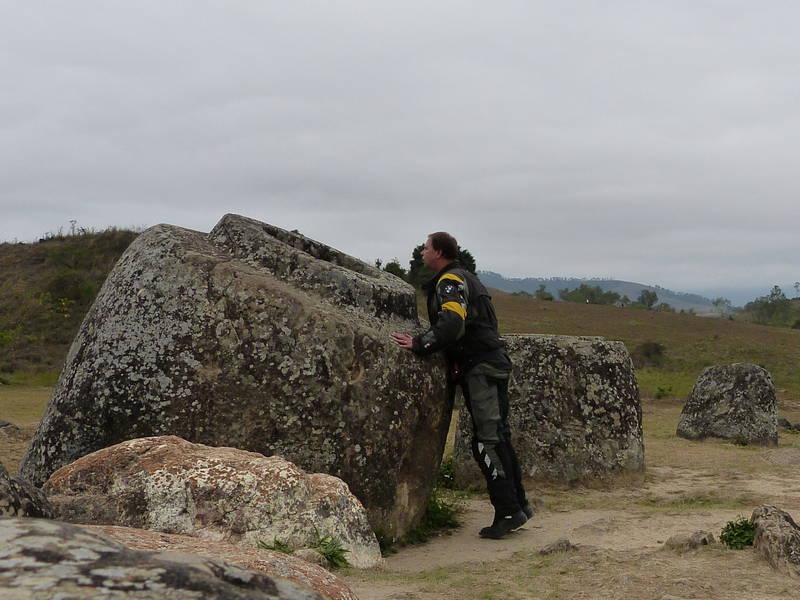
The road east winds up into the hills past stilted houses

The villages are up on top of the ridges as opposed to down in the valleys

Really? I didn't see any sliders though.
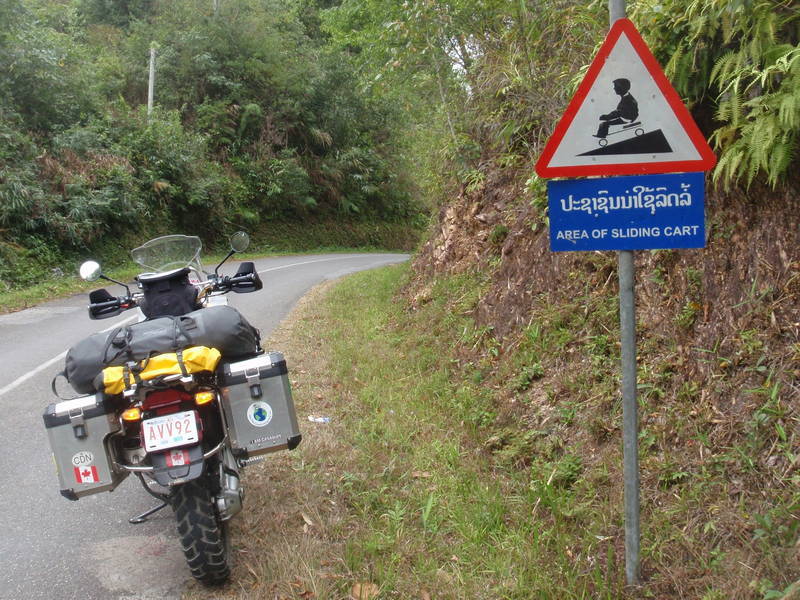
Curious locals inspect a horizontally opposed twin cylinder engine
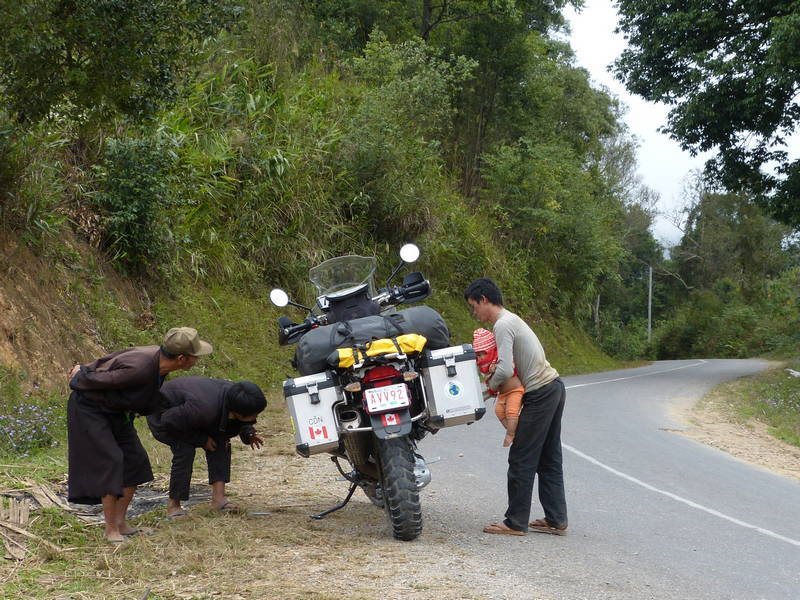
Lunch break at a roadside restaurant
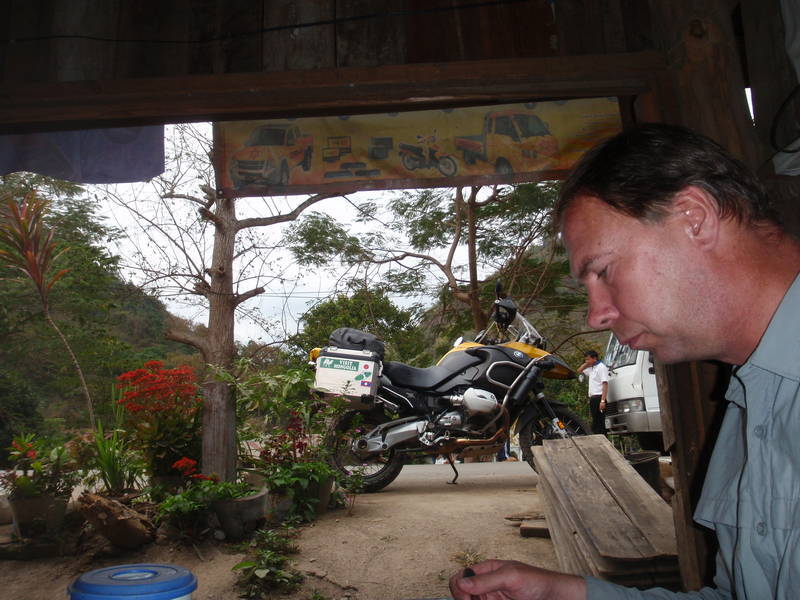
At breakfast I thought I would order something simple so that I could get on the road quickly and make it to the border in time to meet Tuyen. Boiled eggs sounded quick and easy. A few minutes after ordering the boiled eggs I heard a scooter fire up and then I saw the proprietor zip out of the hotel to return after a short while carrying a plastic bag. While I waited patiently for the eggs to arrive (a six minute egg shouldn't take too long should it?) I hoped that I would also get some bread to go with the eggs. Half an hour later five boiled eggs arrived at my table but no bread. Well, I guess there will be lots of protein for the day. The total cost for my stay was 95,000 kip ($13), including dinner and breakfast so I must have misheard the 20,000 kip quote the previous day. It was really 70,000 which still isn't a bad deal. The ride along the hills towards Vietnam was 58 kilometres long and consisted mostly of 2nd and 3rd gear corners again so it took about 1.5 hours to reach the border. Because this is quite an isolated border post I was the only one there and it was easy to take the time to explain the carnet de passage and how it should be stamped. After twenty minutes I was released into no-man's land and rode to the Vietnamese side of the border.
Rice paddies below

Heavy jungle as I ride east towards the border with Vietnam
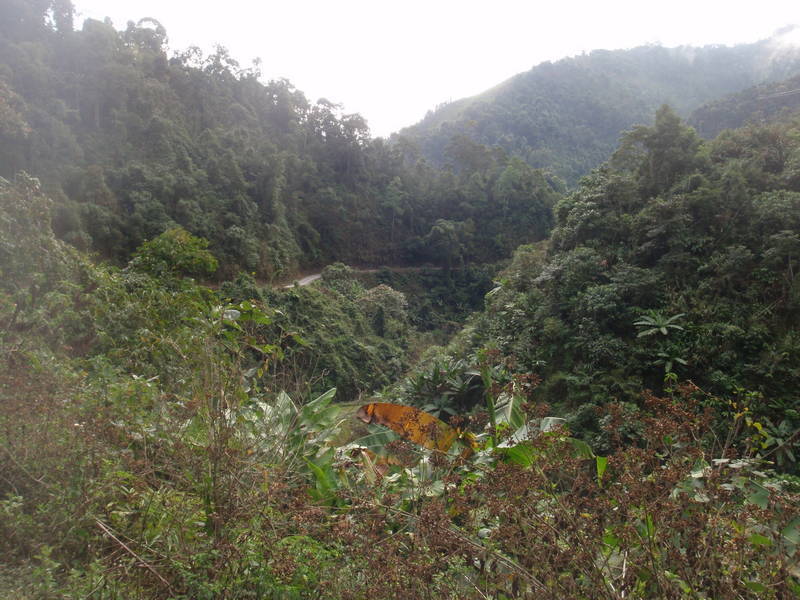
I assumed that the only person standing at the border was Tuyen, my guide for the next couple of weeks, and sure enough it was. We went in together to the customs office and got to work on the paper work to enter the bike into Vietnam. Getting my own passport stamped was easy but as usual the bike was a bit more complicated. Eventually, with Tuyen's help, they got it all figured out and we were free to go. It was slow riding as the road was really quite rough and I was in 1st and 2nd gear riding behind Tuyen's tiny scooter. As the Tet celebrations (Lunar New Year) were still impacting local businesses, most shops and restaurants were closed and it wasn't possible to have lunch. Good thing I had five eggs for breakfast. Tuyen had planned ahead and brought along a few sesame and rice crackers for just this occasion. Vietnam seemed to be ahead of Laos for rice planting and as we rode along we saw rice paddies filled with water and a few green sprouts. This made missing Audrey even harder since I remembered her talking about rice paddies and how she was looking forward to seeing them in Vietnam. I knew that she would have loved this ride. At 4:30, after about 150 kilometres, we pulled into Mai Chau and rode past the rice paddies to our home stay. There, a large one room building on stilts awaited us. The room had a bamboo floor and through the cracks I could see the bikes below. A couple of mattresses were laid out with mosquito nets spread over them. I took a quick shower and then Tuyen and I walked down to the rice paddies via a set of souvenir stalls. Mai Chau is a popular tourist destination for both foreign and Vietnamese tourists as it is close enough to Hanoi to make a weekend getaway. Out in the fields were tens of workers from the local villages planting rice. It looked like back breaking work. At the home stay a dinner of fish, caviar, fried pork rolls and kale was served and, as was customary, we toasted the host with a shot of sake. In the evening a folk show across the street provided the entertainment and then I got the global roaming cell phone fired up to call Audrey. She had arrived safely in Calgary and while the insurance-provided business class was fantastic she was sick during the flight and couldn't really enjoy it.
At the Vietnamese border post, official hats wait for officials

It's a rough road for the first few kilometres in Vietnam following Tuyen on his scooter
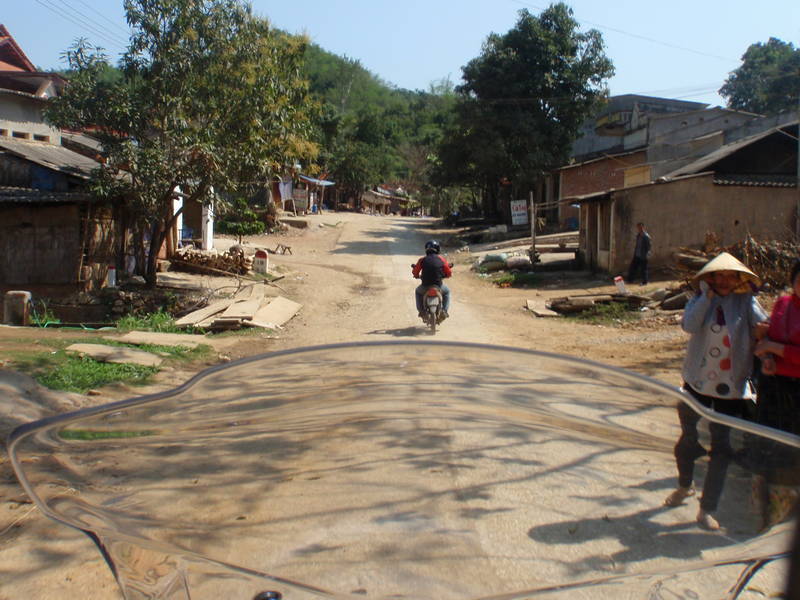
Thank goodness we didn't need to take this swaying suspension bridge
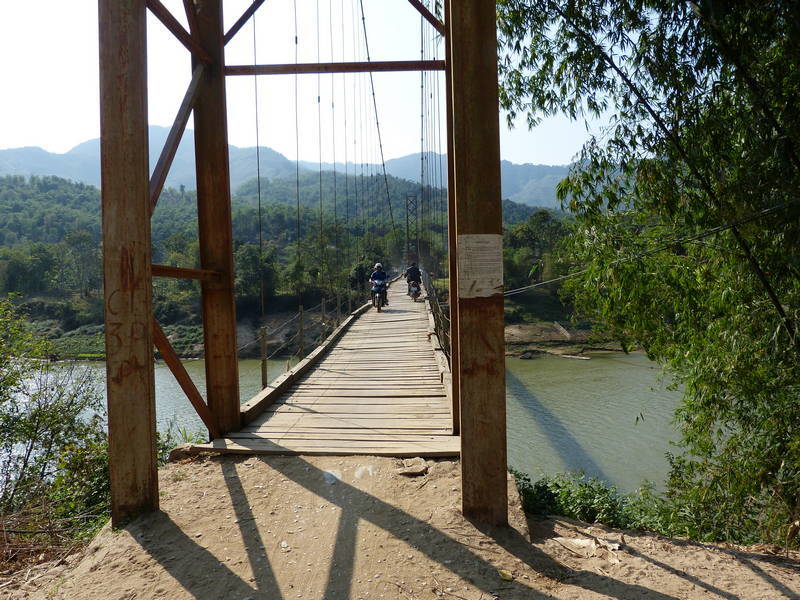
Looks like back breaking work, planting rice fields
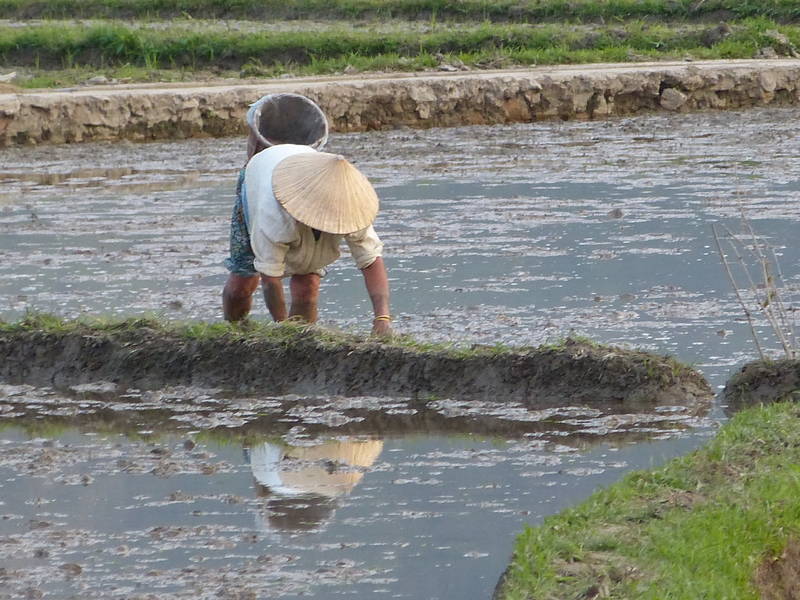
Arriving at the home stay in Mai Chau
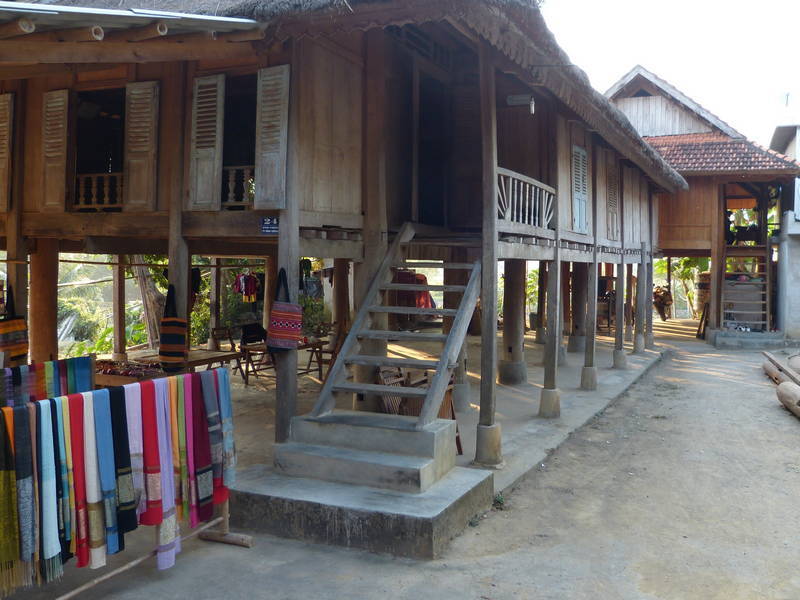

A stroll before dinner, Hanoi is on the other side of the mountains

Dinner at the home stay
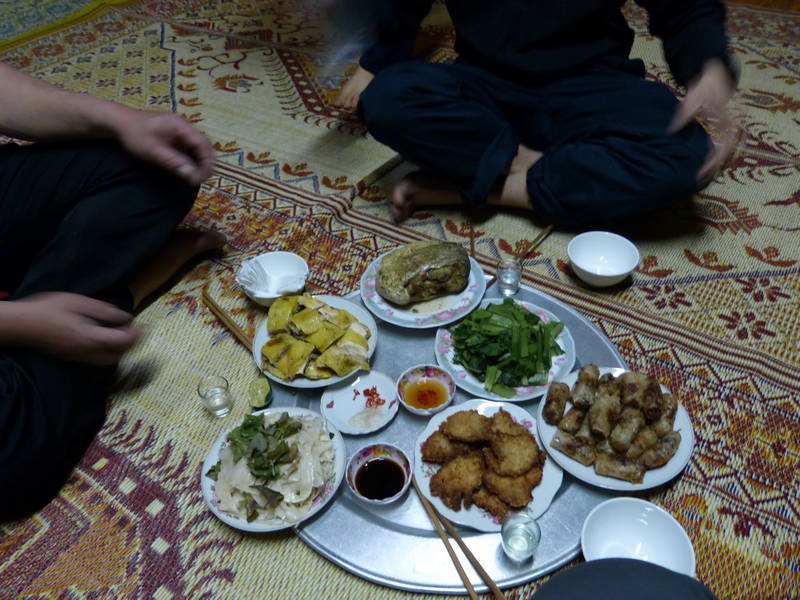
Good morning Vietnam! Over breakfast of noodle soup with an egg stirred in, Tuyen mentioned that once we crossed the mountain range between Mai Chau and Hanoi it would get more "humid." Sure enough, after stopping at the top of the ridge and looking back on the rice fields in the valley of Mai Chau, it did get damp with a heavy mist. Not enough to require rain gear, especially as the R1200GS Adventure has pretty good weather protection as is. While the roads heading into Hanoi were better than the road coming from the border the day before, the traffic was much heavier. Oncoming traffic didn't hesitate to pass even if they saw us and a few times we were forced onto the shoulder. Vietnamese traffic was certainly more aggressive than laidback Lao traffic. As we got closer to Hanoi, Tuyen took us on some quiet secondary roads for a truly nice ride. The limestone cliffs in the mist were simply beautiful. Once we got to Hanoi the calm of the country deserted us and we sliced and diced with the scooters in the heavy traffic to the Voyage Vietnam office. We arrived fairly wet as the heavy mist had turned into a light rain. The hotel originally planned for Hanoi, near the office, was not able to provide secure parking for my motorcycle so another hotel was found. Going there it appeared that the secure parking was in the lobby, up a set of high steps. Once the hotel staff saw the Adventure they seemed to have second thoughts on the possibility of getting the bike up into the lobby. Tuyen and I went for lunch while they pondered possible parking options. Calgary has a lot of Vietnamese restaurants so when we went to a restaurant in Hanoi I was immediately greeted with fairly familiar food. I didn't see my favourite though, the #25 on the menu at Pho Pasteur Saigon. After lunch I said goodbye to Tuyen, as I would be on my own for the weekend on a boat tour of Ha Long Bay, and then went for a walk around the old town. It was quite interesting to cross the busier streets and it took a little practice to be able to do it like a local. It seemed the best strategy was to have a quick glance at the oncoming traffic to make sure there weren't any buses or cement trucks coming and then slowly cross the street. The scooters flowed right around you. While it was unnerving it seemed to work well enough. Back at the hotel the staff insisted that it wasn't safe to leave the motorcycle parked on the sidewalk overnight and they told me to come down after 10:00 PM to move it into the lobby. I came down at 10:00, the big glass doors were opened and they put down some small ramps to ride the bike up. Discretion being the better part of valour I decided not to ride up (with visions of losing my balance and falling through the doors) but rather to walk beside the bike and slip the clutch. It worked! Unfortunately the dirty, wet roads from the day's ride meant that the bike was filthy and didn't grace their lobby as nicely as I had hoped.
Tuyen tries out the Adventure
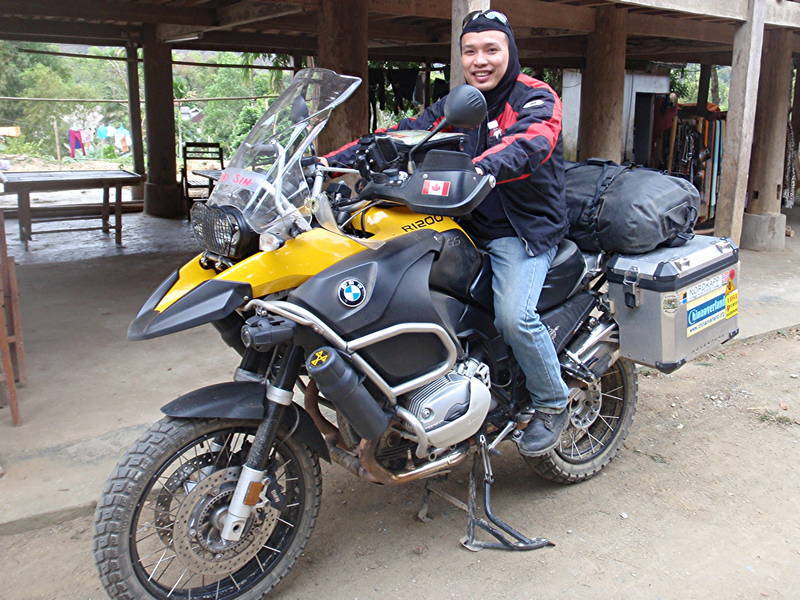
Looking back down at Mai Chau

Riding quiet country roads near Hanoi

Secure parking

I packed up my luggage and a bag of laundry on Saturday morning and dropped it off at the front desk, then waited for the mini-bus to take me to the Ha Long Bay cruise. The Adventure looked secure in their lobby (as long as no-one tried sitting on it) and would remain there until I left Hanoi next week Tuesday. At 8:30 the mini-bus, already mostly full, came by and I jammed myself into a seat near a few Aussies who had partied a bit too hard the previous evening. They spent the four hour bus ride passing a puke bag back and forth. Four hours is a long time to spend with my knees jammed into the seat in front and I was happy when we stopped at a tourist trap for souvenirs. At 12:30 we arrived at the port and we were ferried to the cruise ship at 1:00. The cabin was very nice, even including a tiny, private balcony. There was a delay in our departure as apparently the captain was unable to file the necessary forms over the internet but eventually we headed out into the misty bay. There wasn't much to see because of the mist and fog but it was a relaxing ride nonetheless. At a bay amongst one of the thousands of islands there were a lot of overnight cruise ships parked (anchored would probably be the nautical term) and we found a spot as well. Then we took the tender to a floating town and hopped into kayaks to paddle around the bay. As I was the odd man out I got to paddle with our guide and, unlike Audrey on other kayaking trips I could mention, he didn't jump out. Dinner back on the boat and then it was time to mingle with the ten or twelve other guests before calling it an early night and sitting on the upper deck.
Home for the next couple of days; Imperial Cruiser

Nice little cabin with a balcony
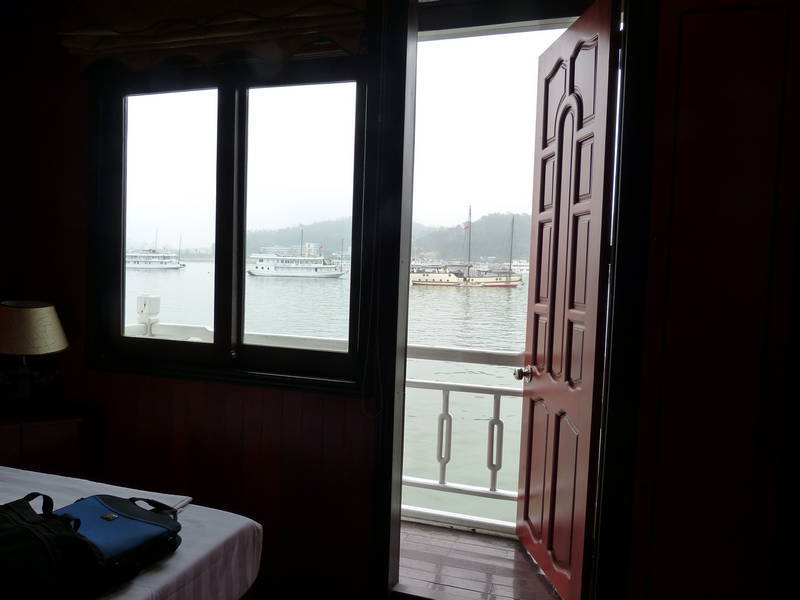
Arriving at the overnight stop there are already a few kayaks out
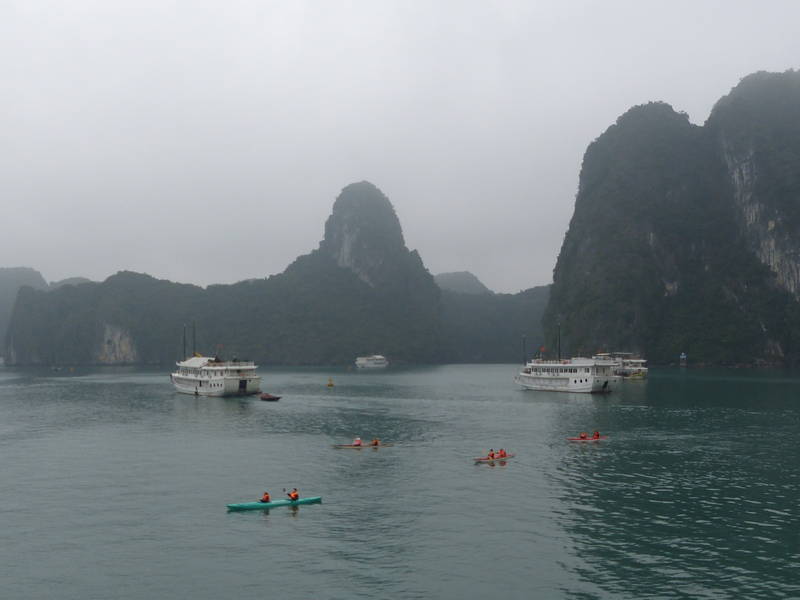
We pick up our kayaks at the floating village
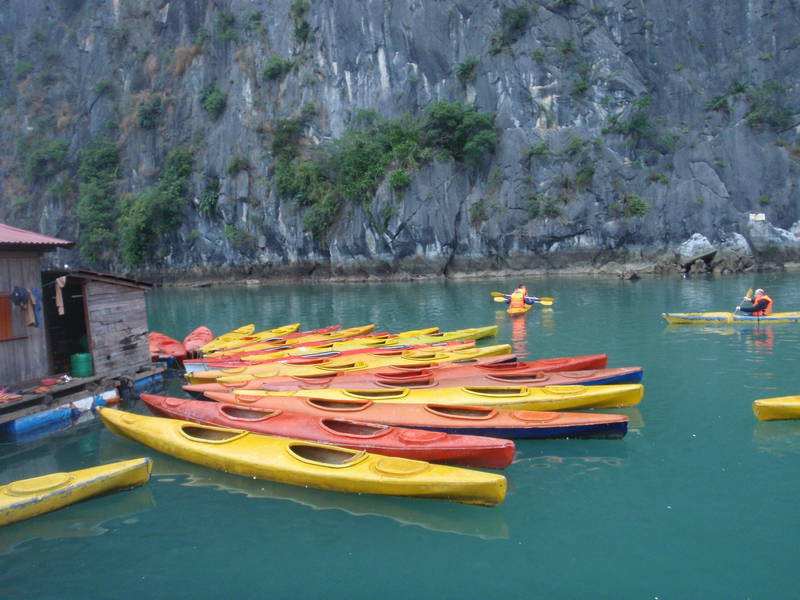
Looking back at the floating village
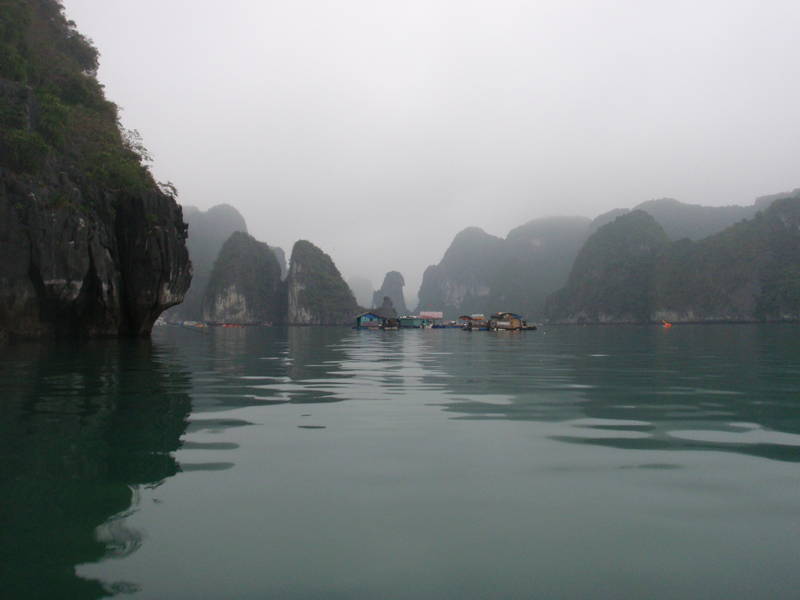
Paddling with the guide
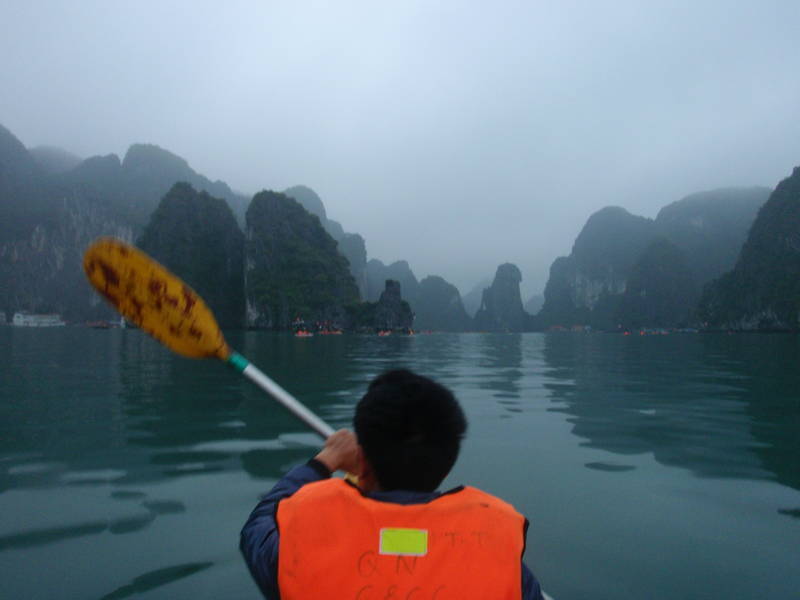
An evening in Ha Long Bay

The original plan was to have visited a big cave in one of the limestone cliffs on Saturday but as we were delayed leaving port we had to have an early breakfast to squeeze it into Sunday morning. The Hang Sung Sot cave was large and our guide used a laser pointer to show us various people and animals in the rocks. The best part though was when we exited the cave mouth and found ourselves high up above the bay. What a fantastic view. Back on the boat we checked out of our rooms and then sailed over to meet another boat. Here passengers that were on the three day cruise transferred to the other boat and other people came aboard our vessel. When the new people were settled we had a cooking class. Well, cooking class is a bit of an exaggeration. Basically the guide had the ingredients for spring rolls and then showed us how to wet the rice paper, spoon the filling on and roll them up. We then had the opportunity to assemble our own spring roll and the instructor deep fried them. The best part of all that hard labour was that then we got to enjoy the delicious morsels that we had made "ourselves." We enjoyed a little free time after the cooking class as the ship started cruising back to port. When we were called for lunch I had lost my seat mates from the previous day and was placed with a threesome of French passengers. After a brief "hello" they then ignored me for the rest of the time, conversing purely in French amongst themselves and occasionally grunting approval if I asked to have a plate of food passed over. It really felt rather rude and I made a note to myself that if I'm in a similar group situation I would try to be as inclusive as possible. Back at the Ha Long Bay port we all jammed into another minibus for the 3:30 hour long bus ride back. It was really rather unpleasant being stuffed into a seat, unable to move, watching the scenery glide by. I much prefer motorcycle travel to bus travel. The bike was still in the lobby and looked as incongruous as ever. The motorcycle clothes looked great after the laundry, now I just needed to wash the bike to match. I walked over to Joma Café (the same Canadian owners as the Joma in Vientiane) for a BLT with pumpkin soup.
Hang Sung Sot cave
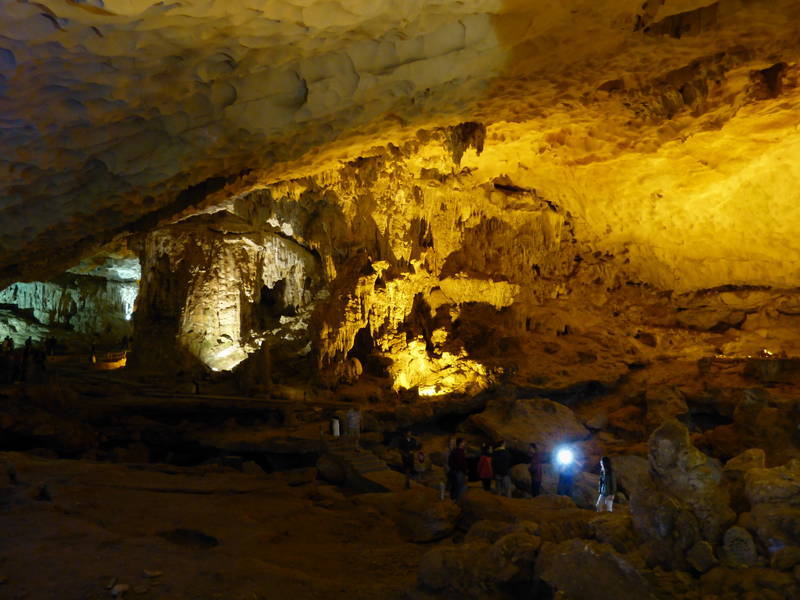
Fantastic view from the cave's mouth
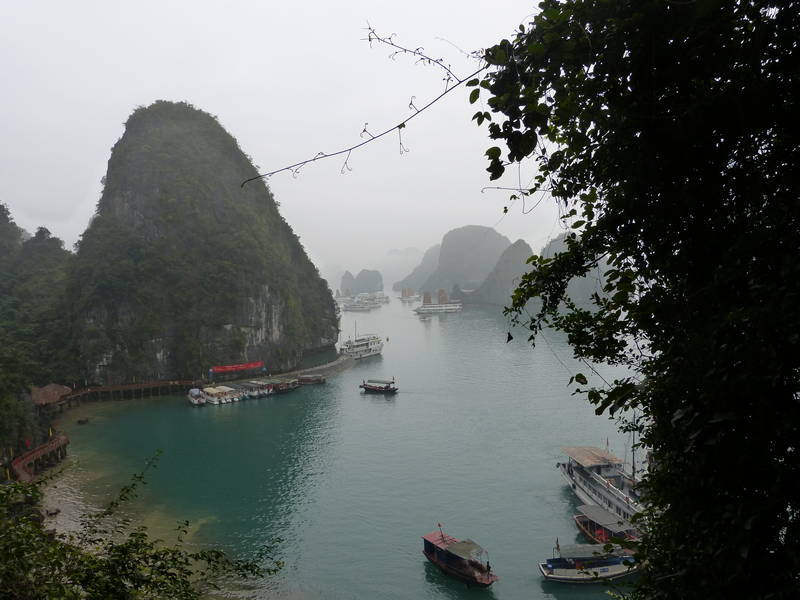
Cooking class; spring rolls
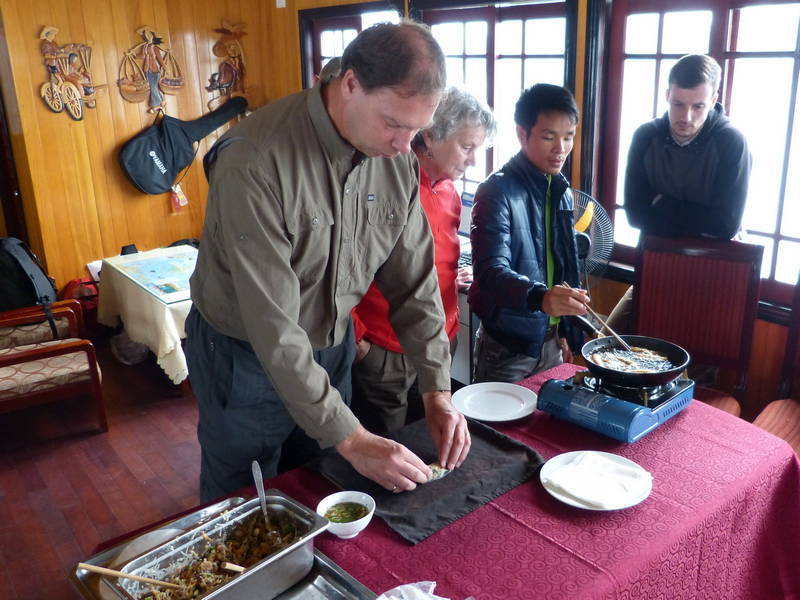
Enjoying the fruits of my labour

On Monday morning I walked over to the Voyage Vietnam office and met Tuyen. After a cup of tea we walked to a nearby bank so that I could use MasterCard to pay for the tour. They weren't able to do a MasterCard transaction so sent us to another bank. That bank spent quite some time trying to make it all work but in the end the system just wasn't working so we had to go a third bank. At the third bank I was told that they couldn't process the MasterCard because the new card (sent out to us in Chiang Mai, Thailand) didn't have a bank name on it so I ended up using Visa and that worked. Because it was a cash advance, interest would be charged from the moment it was withdrawn. Back at the Voyage Vietnam office I met up with Tan for a city tour on the back of a Royal Enfield motorcycle. I got a Harley Davidson pudding bowl helmet and jumped on the back. Tan is a great rider and the Enfield is actually quite roomy so it was an enjoyable ride to the Temple of Literature, dedicated to Confucianism. The temple was constructed in 1070 and people come to pray and make wishes at statues of various instructors. After the temple we got back on the bike and took a tour around West Lake, ending up at the Voyage Vietnam office for lunch at a nearby restaurant. I wanted to see a museum about the American War so Tan took me to the War Museum after lunch but it was still closed because of Tet and it was the same for the Military Museum. A third museum was also closed but out front they had a few artefacts from the war, including a B52 bomber shot down over Hanoi. It was interesting to read the plaques describing the imperialist, evil Americans and the brave defenders of Hanoi. Certainly a different perspective from the one I grew up with in Canada.
The last time I wore a "pudding bowl helmet" I was five years old (and it didn't say Harley Davidson on it)
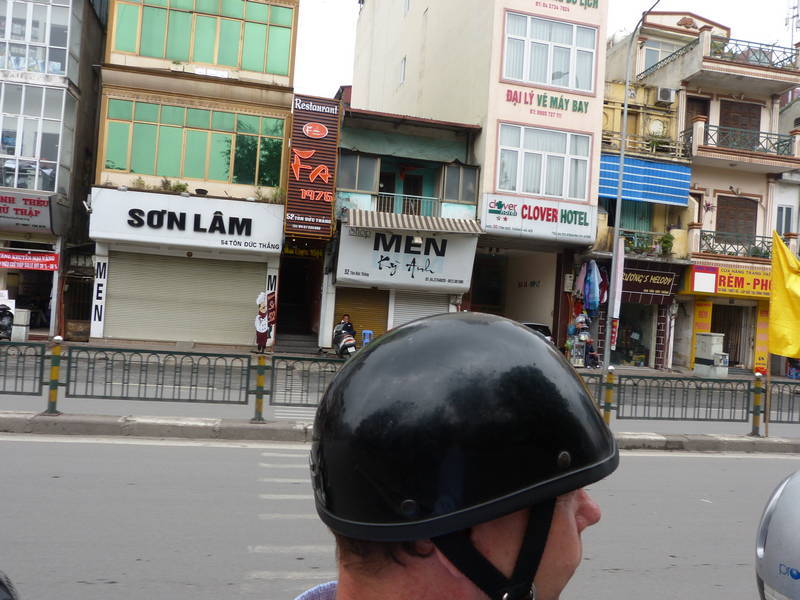
Tan shows off the damp Royal Enfield in front of the Ho Chi Minh monument
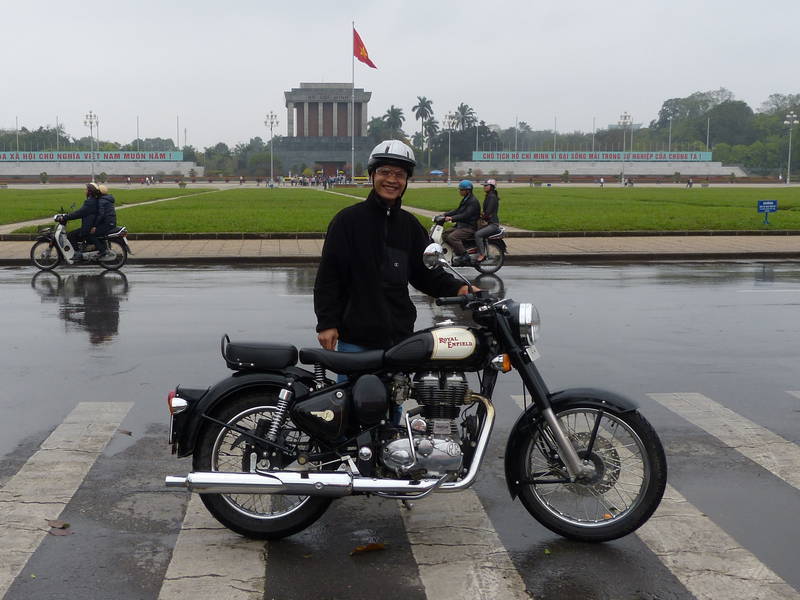
Temple of Literature
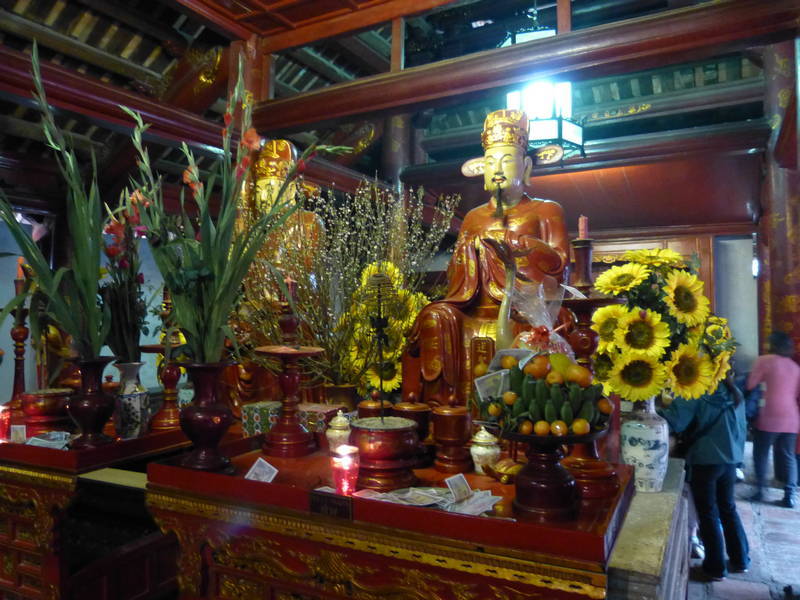
Riding around West Lake and back to the Voyage Vietnam office
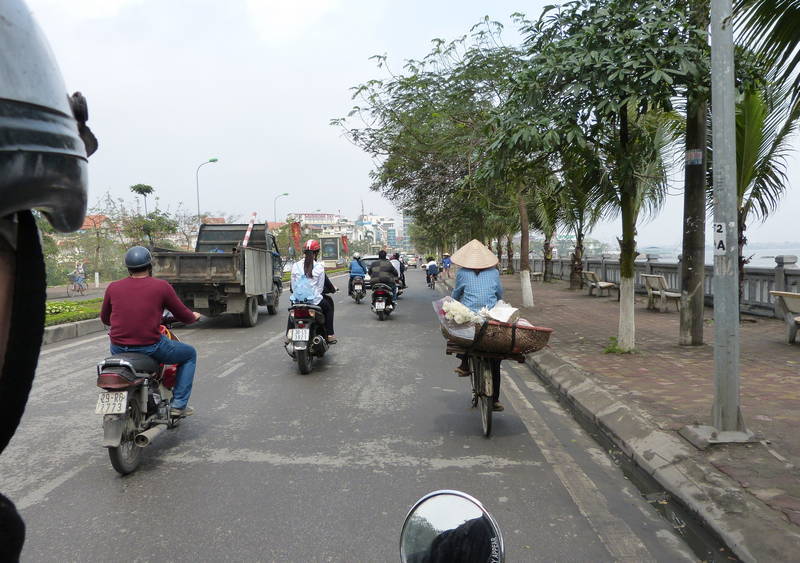
A change of helmet for the afternoon's ride (Tan's a great rider, super smooth)
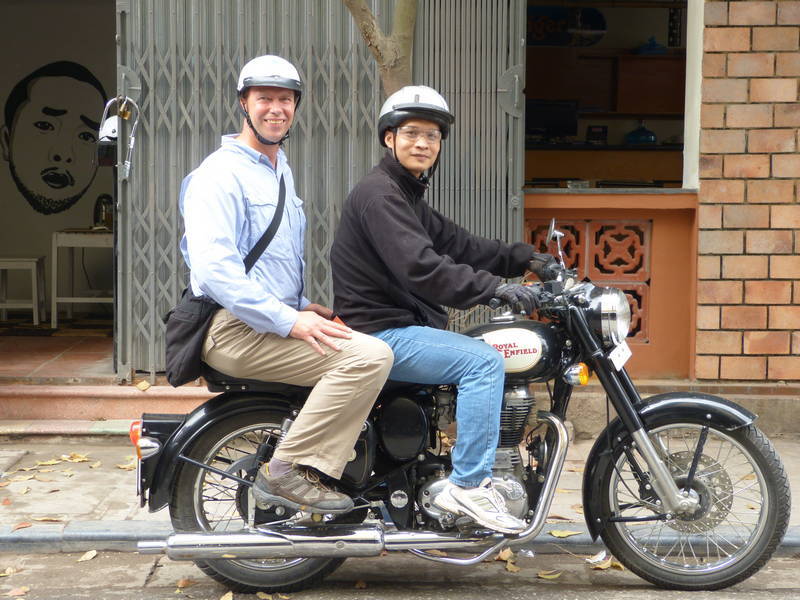
Remains of a B52 shot down over Hanoi

The Mig-21 that shot down a number of enemy planes

The museum grounds being cleaned up after Tet
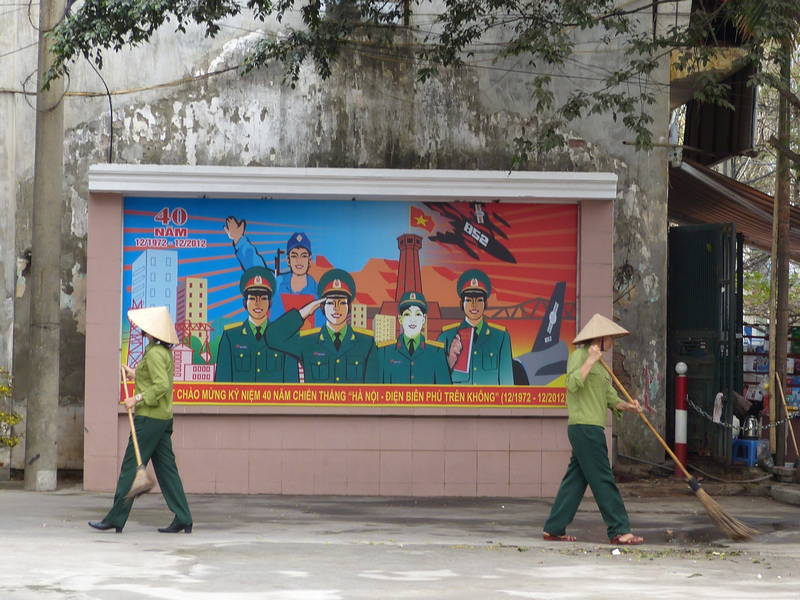
We stop off at a spot where the undercarriage of a B52 landed in a Hanoi neighbourhood
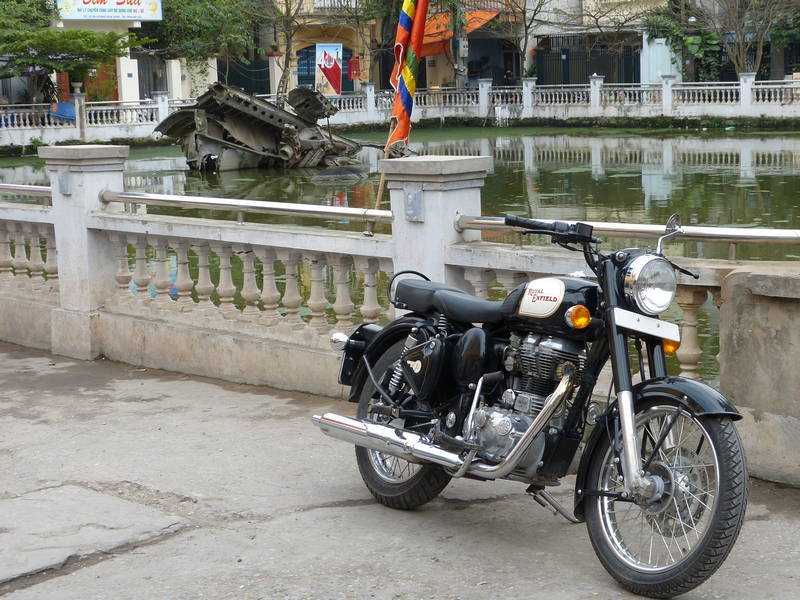
A final Joma stop: Tea, Nanaimo bar, wi-fi. Life's good.
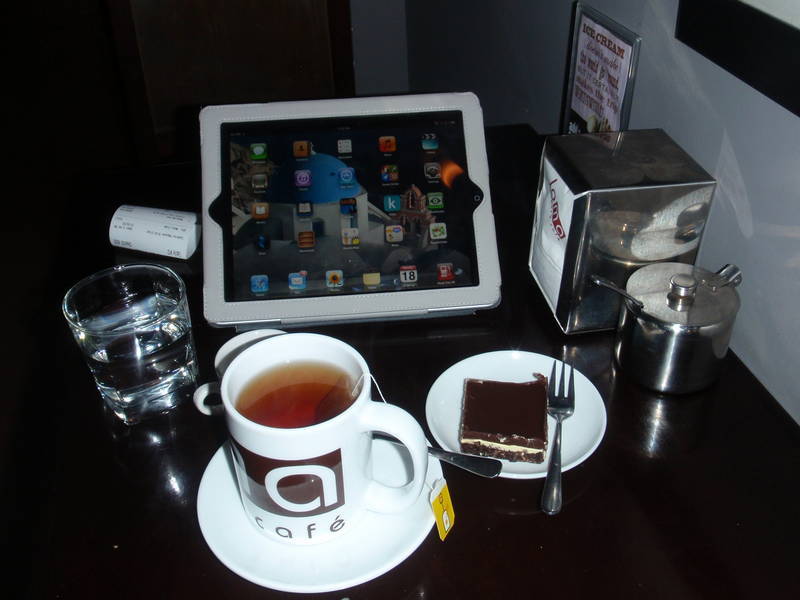
On Tuesday morning I managed to get the bike out of the hotel lobby without damaging anything and rode over to the Voyage Vietnam office to meet Tuyen for a coffee before we headed south. I mentioned that I would like to give the Royal Enfield a try and Tuyen let me take one around the block. It was an interesting bike to ride, at least at the low speeds of the congested streets of Old Hanoi. With its relaxed engine and roomy riding position it might make a neat bike to ride around the world though we would need to pack a bit lighter and perhaps take along more tools and spare parts. As it was raining lightly I put my rain gear on as I mounted my thoroughly modern BMW and we left Hanoi. Well, easier said than done as even Tuyen, a local, got a little turned around in the big city and I received an extra tour, stopping beside a very tall pagoda before getting directions to the highway. I found Hanoi one of the easiest big cities to ride in once I got accustomed to going with the prevailing scooter flow. While it looked like absolute chaos from the sidewalk, once riding in the traffic it was, if not orderly, at least not indecipherable. Out on the country roads that Tuyen led us to, the traffic eased up and it was enjoyable riding near lovely, mist-shrouded cliffs. We had to stop a few times to remove the rain gear and then put it on again a little while later. At our coffee and lunch stops locals always seemed stunned by both the big motorcycle and my relative height, coming over and standing beside me as if I was some kind of human measuring stick. As we got closer to Vinh we had to rejoin Highway 1 and the traffic was much heavier. Oncoming traffic, especially the long distance buses, would pull out to pass, pushing us onto the shoulder quite frequently. In this respect, riding with Tuyen who had now switched to a 125cc Honda from the scooter with which he picked me up at the border, was better than being on my own. He rode more like a scooter so our speeds were lower and we were usually over near the shoulder anyway. Just as we pulled off Highway 1 the little Honda sputtered and Tuyen coasted to the side of the road. It seemed like it was either out of gas or perhaps the electrical system was damp from the day's rain. With a bit of coaxing the little bike got going again and we rolled into Vinh as dusk fell. It took a little riding around until we found the Media hotel. This three star hotel really reminded me of the hotels in China; the shower leaked water all over the bathroom, there were bare wires sticking out of the walls, the beds were rock hard and the room had been fumigated to within a millimetre of its life. In another comparison with the China tour, I found that I still didn't enjoy riding behind a tour leader as much as riding on my own, but it was indeed much better riding behind a motorcycle as opposed to Geordie's pickup truck. While decision making was taken away (when to stop for rain gear, where to stay tonight, where is the next gas station) and hence some of the "adventure" it was almost like taking a vacation. Following Tuyen on the motorcycle was much easier as we could split lanes through traffic when needed and we could ride on the shoulder when getting passed. It also seemed better somehow knowing that the guide was experiencing the same environmental conditions as me; if I was wet and cold then so was he. After a long, dusty, hot day of riding in China it was sometimes frustrating to see Geordie and Frank bounce out of their air conditioned truck fresh as daisies.
Wheeling the Adventure out of the Camellia Hotel lobby

Crossing the street is easy. Just focus on the other side and walk slowly across. The scooters flow around you.
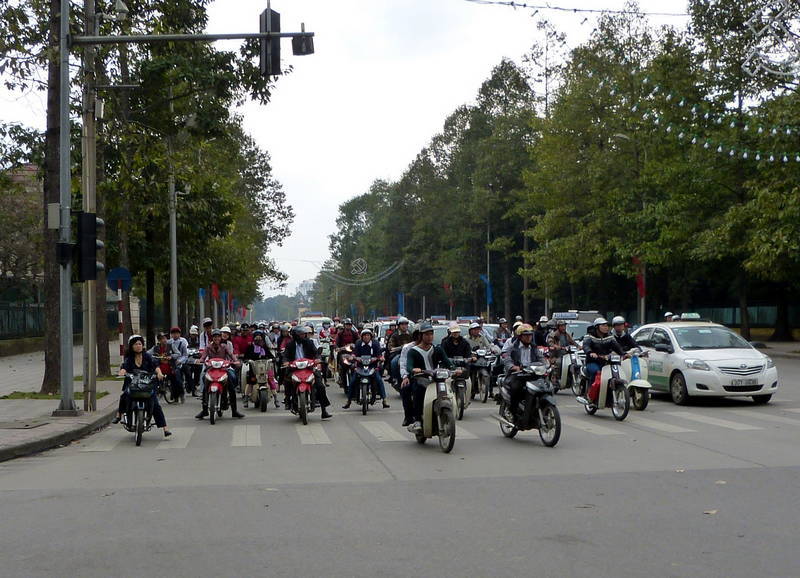
Taking an Enfield for a spin around the block
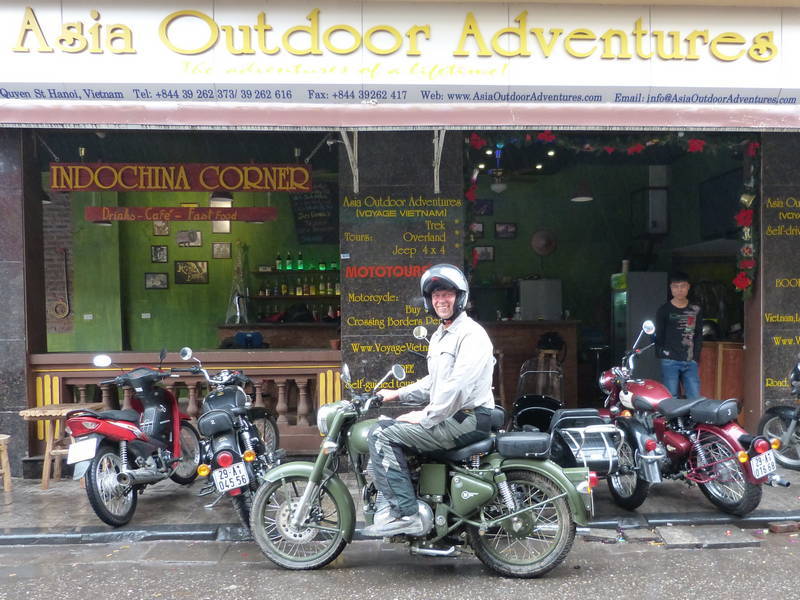
Leaving Hanoi in the mist

These chairs are just way too small
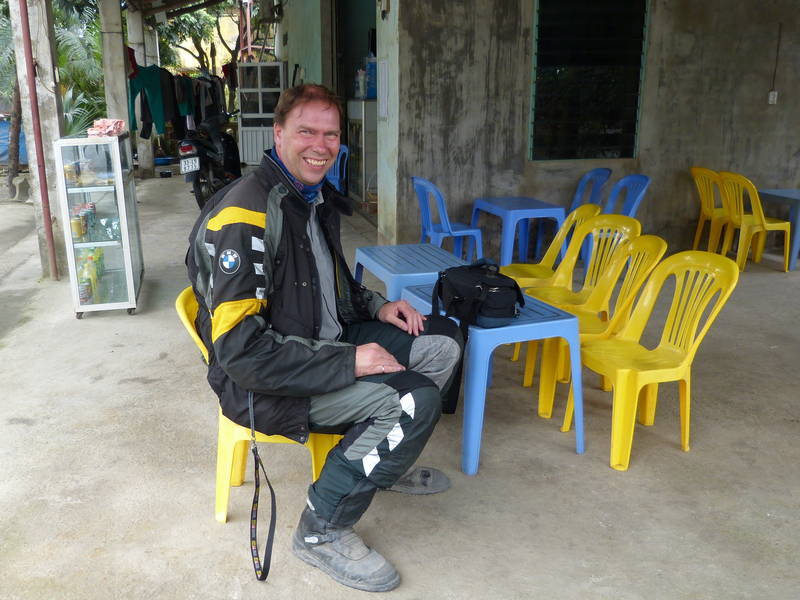
After a typical Asian breakfast we put our rain gear on for the ride to Ho Chi Minh's home. This is where Ho Chi Minh grew up, in a modest bamboo and wood house. There were some of Ho Chi Minh's sayings sprinkled around the grounds like, "Nothing is more valuable than independence and freedom." Tuyen lit an incense candle for me so that I could make a wish at one of the altars. I wished for world peace. After getting all sweaty walking around in full motorcycle clothes and rain gear we rode for a few kilometres before joining up with the Ho Chi Minh Highway to continue our journey south. I found it interesting that the Ho Chi Minh Highway had a yellow centre line. It was the only road in the whole country (and perhaps S.E. Asia) to have the yellow line. As a North American, where we always have yellow centre lines, I was happy to see it. In Huong Khe we stopped for lunch of noodles and beef and fried rice. As this was an all-inclusive tour Tuyen paid for all the meals and that made for a nice vacation too, not having to worry about money. I only had to pay for gas and incidentals. With the steely grey skies we left our rain gear on, especially as our route took us over a mountain pass. The road was a lot of fun as it twisted up and down the hills. On the other side of the pass Tuyen suddenly pulled over. The Honda's chain had fallen off. We spent a little while putting it back on but a few metres down the road it fell off again. It seemed to be very worn out and there was a sound like the wheel bearings were shot as the sprocket wobbled on the axle. The remainder of the ride to Phong Nha was done at 30 kilometres per hour, stopping every now and again to reinstall the chain, and we arrived at 5:30 PM. Too late to go to the famous, UNESCO Heritage listed Phong Nha cave so we would have to go first thing Thursday morning. Tuyen went in search of a new chain (and perhaps sprockets and wheel bearings) while I took a bit of a lie down, feeling like I had a touch of a cold or the flu. Over dinner of vegetable fried rice Tuyen said that he would get a new chain installed in the morning while we took a boat ride into the cave.
Ho Chi Minh's modest childhood home
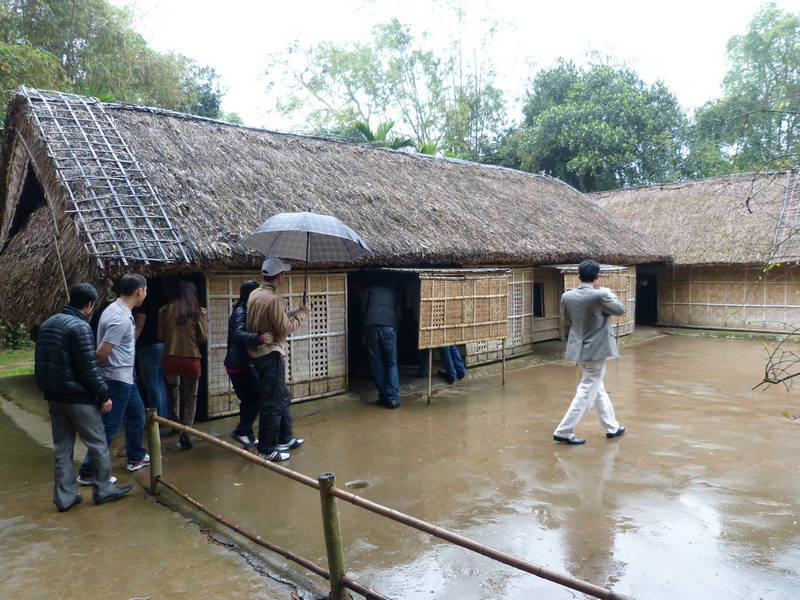
Making a wish at Ho Chi Minh's statue
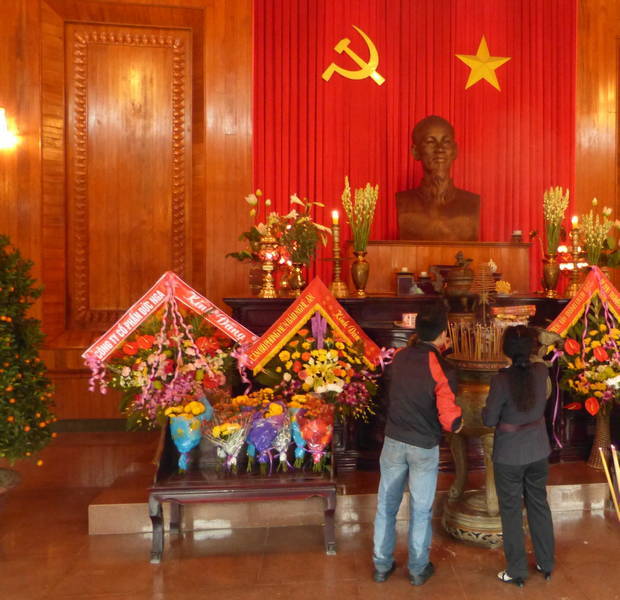
School's out on a rainy day
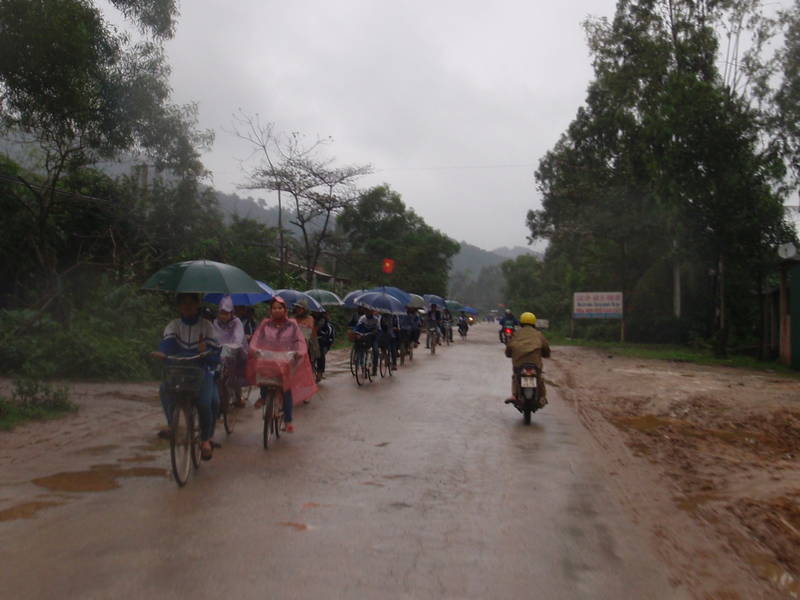
Milestone marker on the Ho Chi Minh Highway
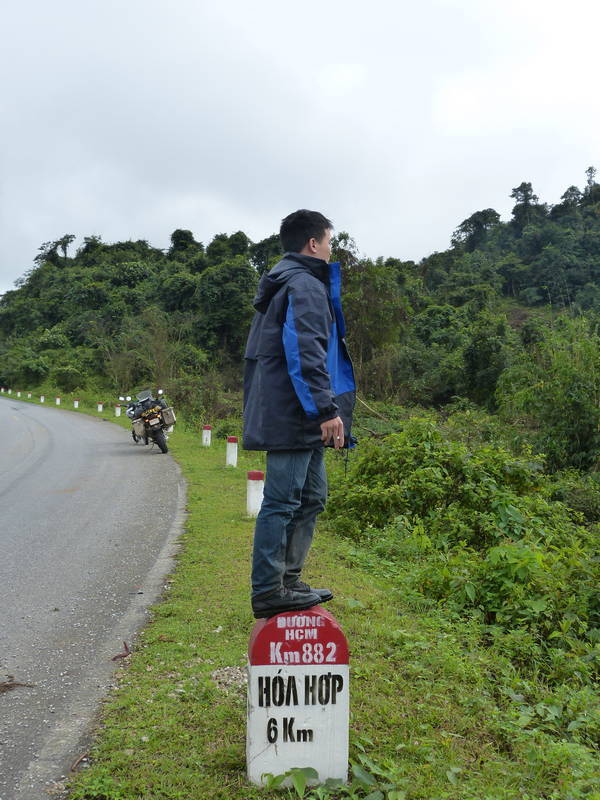
The chain falls off Tuyen's Honda
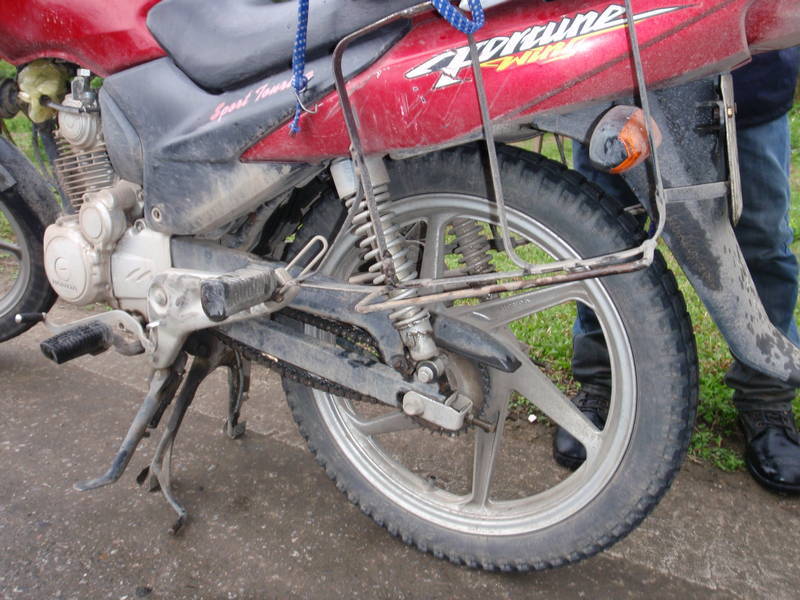
Slow riding means it is easier to take pictures of the wonderful scenery that we pass through
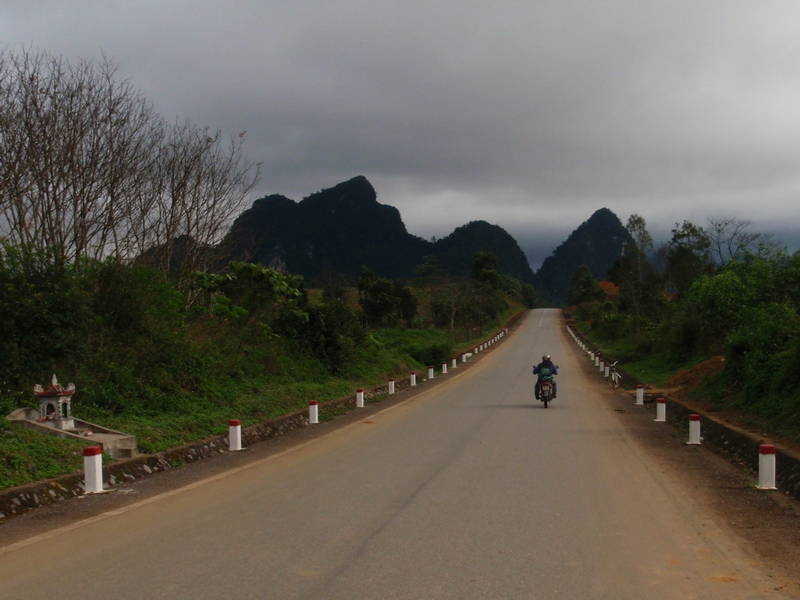
This looks like it would have made a good runway during the American War

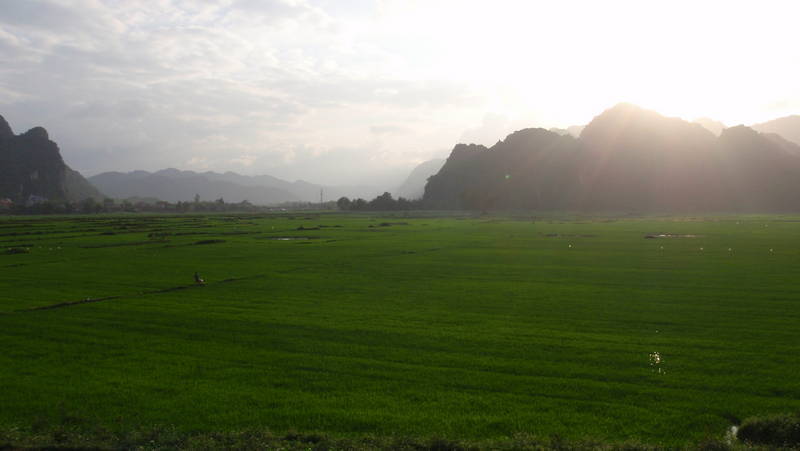
February 21 Tuyen dropped his bike off to get a new chain installed and then we walked over to the boat docks where we found a small group of tourists from Saigon ready to board a boat. They were happy to share the costs and we jumped aboard. It took half an hour in the motorboat to go up the slow moving river to the cave's mouth. At that point the motor was turned off and the crew started paddling into the darkness. It is a large cavern but we only went in about 600 metres before sliding the boat up onto a sandy beach. A small opening led into the remainder of the 7.5 kilometre long cave but it was only accessible by kayak from that point on. We walked around the lit cavern and then back to the boat for a short trip back downstream to another beach. Here we were let off and allowed to wander through the cave and exit at another point, near where the boat had entered the cave. We had only seen a small portion of the cave network but I imagine that exploring the further reaches of the cave by kayak would be quite exciting. We needed to get riding though as it was still a couple of hundred kilometres to Hue and it was already past 11:00 AM. As we rode towards the coast, again Tuyen pulled over suddenly. I thought that the new chain would have fixed the bike but that wasn't the reason he had stopped. In Calgary I have a favourite Vietnamese dish and I hadn't found it in Vietnam yet. I had explained what the dish was to Tuyen, and with the help of a photo that Audrey had taken of the menu in Calgary, he knew what to look for. He had seen a restaurant advertising "Bun Cha" and that's why he had stopped suddenly. The BBQ pork and noodles tasted a bit different compared to the dish at Pho Pasteur Saigon but still tasty. 60 kilometres after the lunch stop we took some small roads to get to the Vinh Moc tunnels. In these tunnels near the Demilitarized Zone hundreds of people had hidden and lived their lives during the American War. Tuyen handed me over to a local tour guide and we entered the network of tunnels. The tunnels were obviously not made with Dutch people in mind as they were mostly 1.6 metres high with the largest "room" being 1.9 metres tall. It was uncomfortable for me doing the tour but imagining what it must have been like to live down here with B52s dropping bombs brought home how arduous it must have been. The maternity "room" was nothing but a small niche dug out of the side of a tunnel. 17 babies had been born here during the war. It was a short ride to the DMZ, the 17th parallel that divided North and South Vietnam where Tuyen gave another brief lesson on the history of Vietnam. He really was quite knowledgeable and able to impart the information in an easy to absorb manner. As we had a fairly late start it was after dark when we arrived in Hue. Night riding in Vietnam was no fun at all as oncoming vehicles typically ran their high beams and continued to pass even if there was oncoming traffic, forcing us onto the shoulder where pedestrians and bicycles didn't have any reflectors, never mind lights. After checking in at the Ideal Hotel we walked over to the DMZ restaurant for a bacon cheeseburger.
Phong Nha is almost as pedestrian friendly as Ulaanbaatar
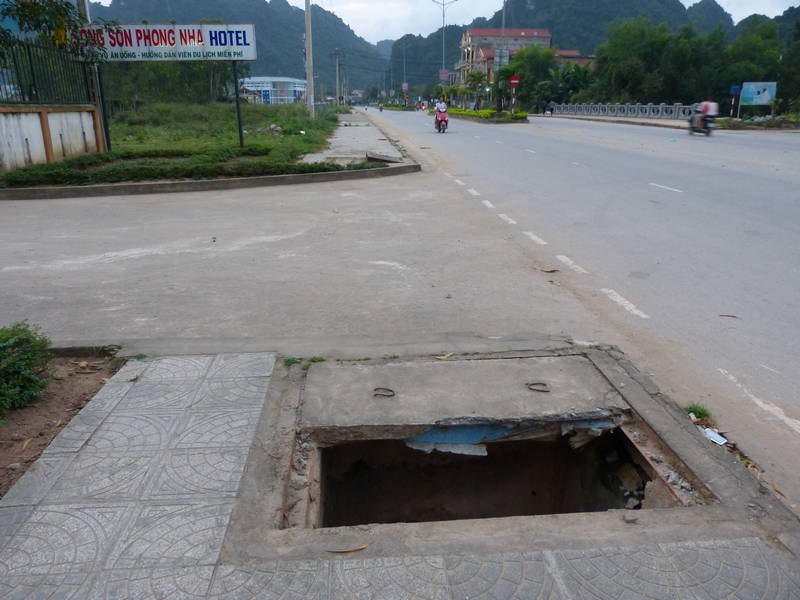
Entering the Phong Nha cave we shut off the motor and paddle into the darkness

Beached up inside the cave, to go any further and you'll need a kayak and a light

Entrance to Vinh Moc tunnels

Not made for Dutch people

Riding along the coast a short distance to the Demilitarized Zone
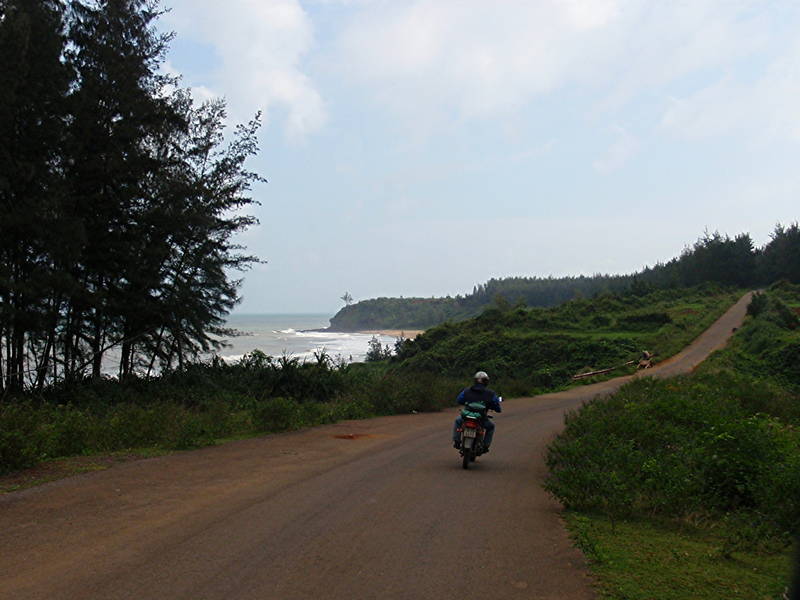
The Demilitarized Zone that separated North and South Vietnam

On Friday Tuyen and I jumped in a cab to the ancient Imperial City from the time that Hue was the capital of Vietnam. Inside the walled structure, known as the citadel, was the Purple Forbidden City where the Nguyen imperial family lived. It had a plan very similar to the Forbidden City in Beijing but during the Tet Offensive in 1968 when the North Vietnamese launched a major attack to capture Hue, 150 of the 160 buildings in the Imperial City were destroyed. Ongoing restoration was visible as we walked around the site with scaffolding up around some buildings and painting going on in others. From the Imperial City we walked over to a market and when I saw that there was an entire road fronted by barber shops I couldn't resist the urge for a haircut. 50,000 dong later I was nicely trimmed and when Tuyen saw what a nice job was done with me he went under the knife as well. Both all spiffed up we took the afternoon off and then met for dinner at 6:30 after which we went on a boat cruise of the Perfume River. Well it wasn't much of a cruise as the boat left the dock and then went upstream about 100 metres before dropping anchor. Then a small band started playing traditional music and five women performed traditional folk songs. The truly traditional tunes were very similar to Chinese opera in that the sound was similar to stepping on the tails of five cats at once. Fortunately a few more modern tunes crept into their repertoire and these were much more pleasant to listen to. Just as we returned to dock a very heavy downpour started and just as abruptly ended, leaving the streets soaking wet but us relatively dry, scampering back to the hotel.
Entering the Imperial City

One of the gates to the Purple Forbidden City
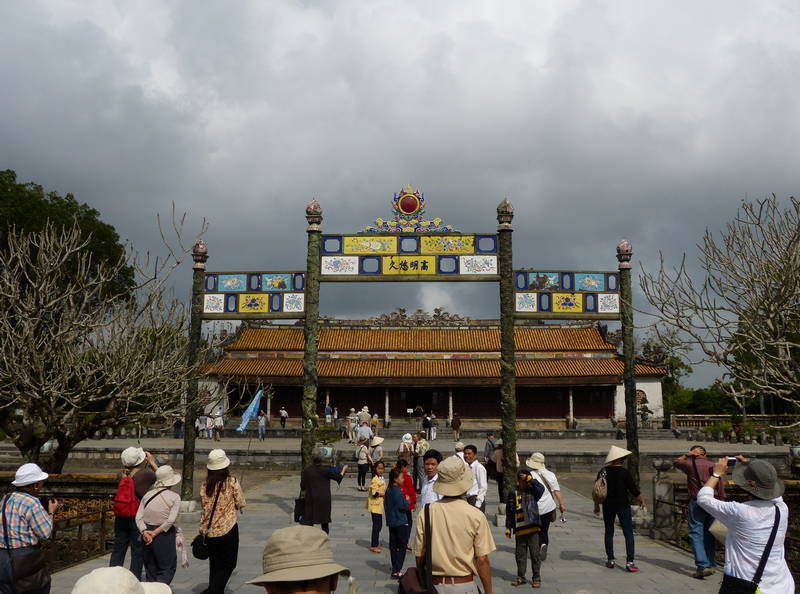
Ongoing restoration work
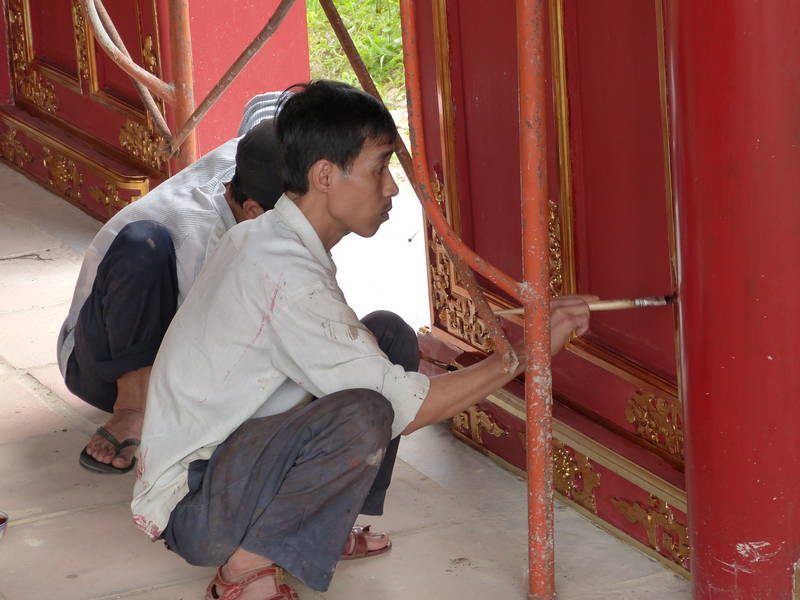
The theatre

A Huey helicopter captured during the Spring Campaign of 1975
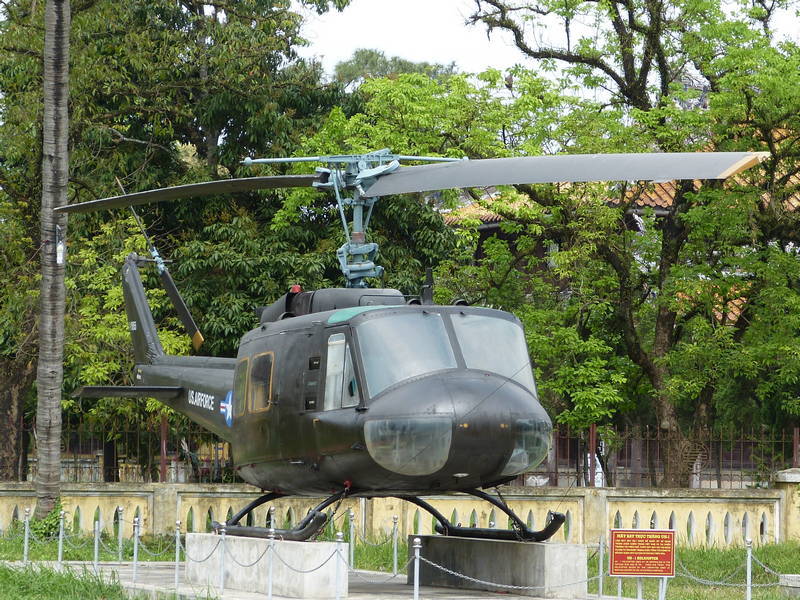
It's interesting seeing the other side of the American War
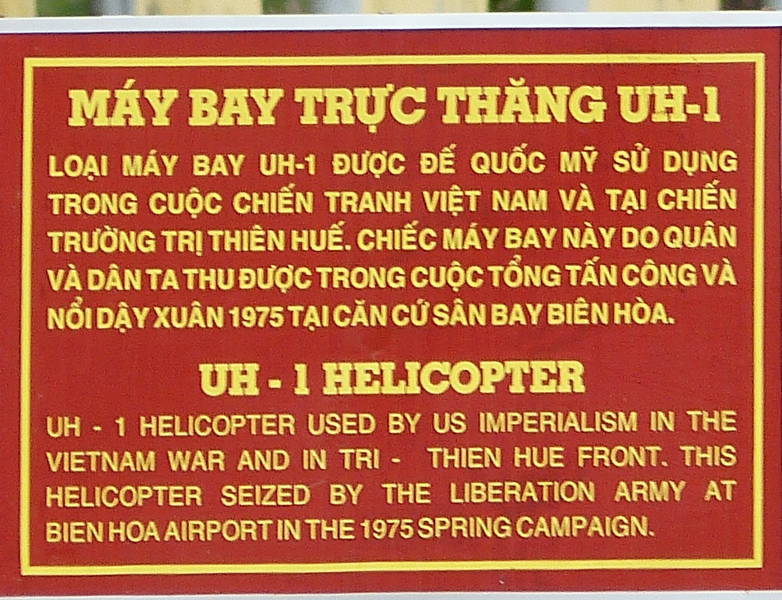

Checking out the market

Hey, a helmet to match the iPhone!

Haircut time
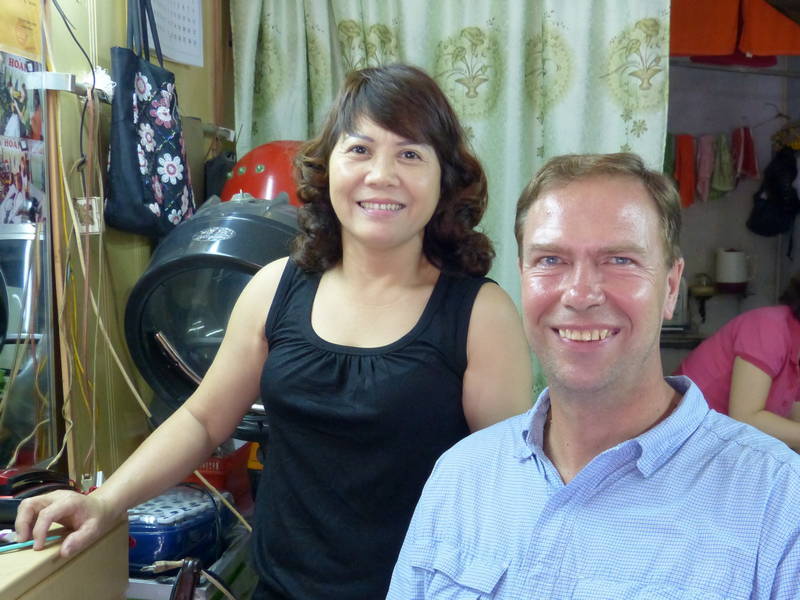
The five ladies singing traditional songs on the cruise

While it rained some more overnight by the time we had finished breakfast it had let up and we didn't need to don our wet weather gear. Leaving Hue by small country roads was relaxing and we stopped at a small village where the entire GDP of the village looked like it was spent on building funerary monuments. Each grave in the cemetery seemed to be bigger and more elaborate than the last. Speaking of money, while this was an all-inclusive tour I still needed to pay for gas. I stopped at a couple of ATMs but both of them showed a Windows "Blue Screen of Death" so Tuyen spotted me half a million dong at our next gas stop where my bike took 800,000 dong (about $40). After the fill up we left town and turned off the main road, which entered a tunnel a bit further on. Instead of going into the tunnel, we climbed over the mountain, on the road made famous in the Top Gear Vietnam Special. The reason the road is so good is because most of the through-traffic bypasses the mountain road in favour of the tunnel, leaving only the tourists and tanker trucks (not permitted in the tunnel) on the curvy road. While Jeremy Clarkson declared the road one of the best coast roads in the world I can't quite agree. It is a lovely road alright and the sparse traffic makes it quite enjoyable but best in the world? I don't think so; how about the coast road in northern California near Petrolia? Or Cabot Trail in Nova Scotia? Or Chapman's Peak Drive near Cape Town? Or the Atlantic Highway in Norway? I think that Jeremy was having so much fun on his scooter that his judgement may have been addled. We stopped at a beautiful stretch of beach in Da Nang but it was still a bit too early in the season to fully enjoy the beach time. In Hoi An, after checking into our hotel, I popped around the corner and was fitted for a custom suit. $150 for a custom made suit is quite a deal and they were fast, saying to drop by at 9:30 PM for a test fitting. Tuyen and I walked around Hoi An, which would have been much nicer if it wasn't pouring rain. Still, watching the candles float down the canal was quite pretty. At the tailor the suit fit quite well and just needed a couple of minor adjustments to be perfect. They said to come back at 9:30 AM the next day for a final fitting and then to ship it home to Canada.
Cemetery of a small village is incredible for its over the top funerary monuments
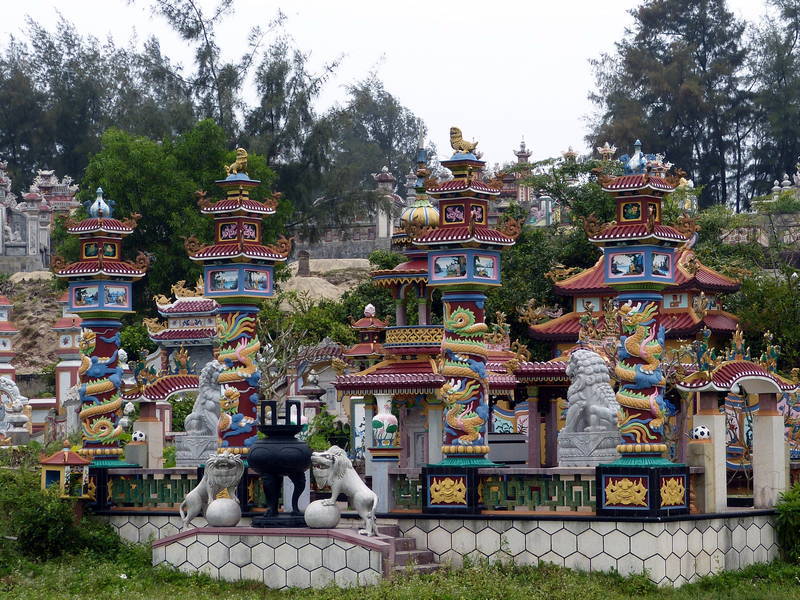
Water buffalo in their natural habitat
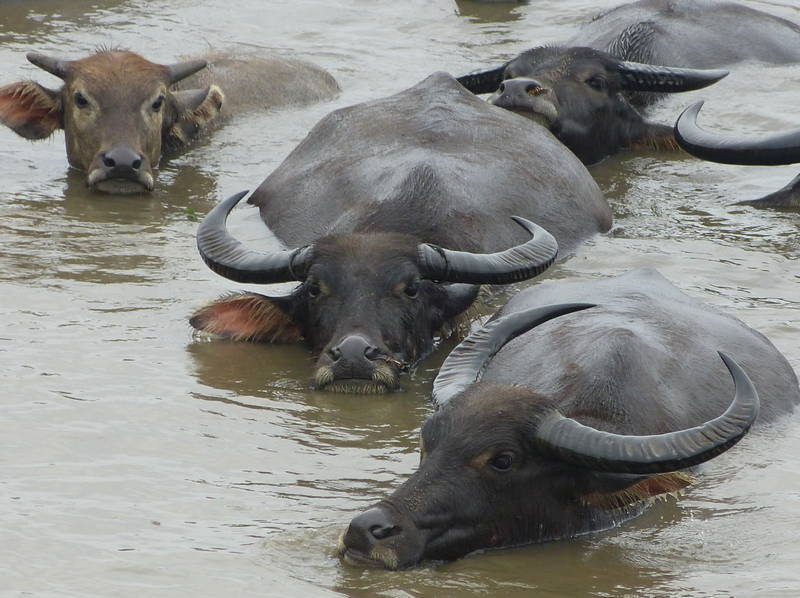
And at work

Starting the ascent of the pass made famous in Top Gear with a beautiful view of the town below
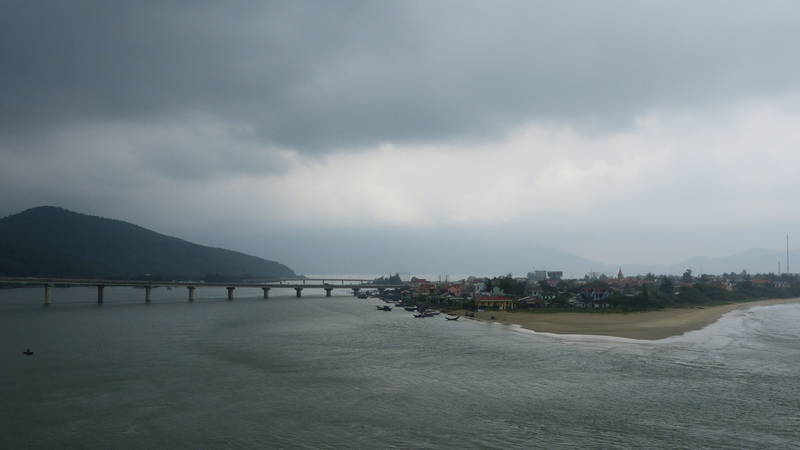
The road curves and twists through the fog

At the top of the pass
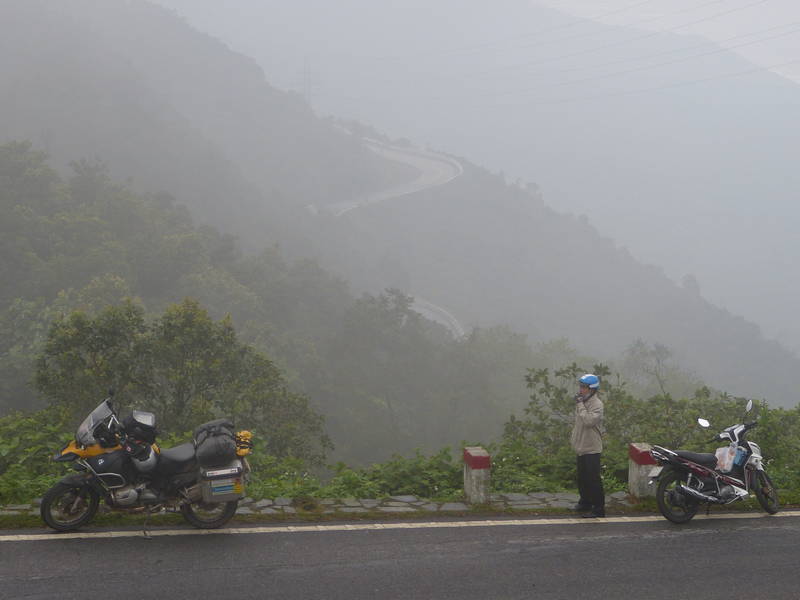
Enormous!

Quality beach time (like the Stig on vacation)
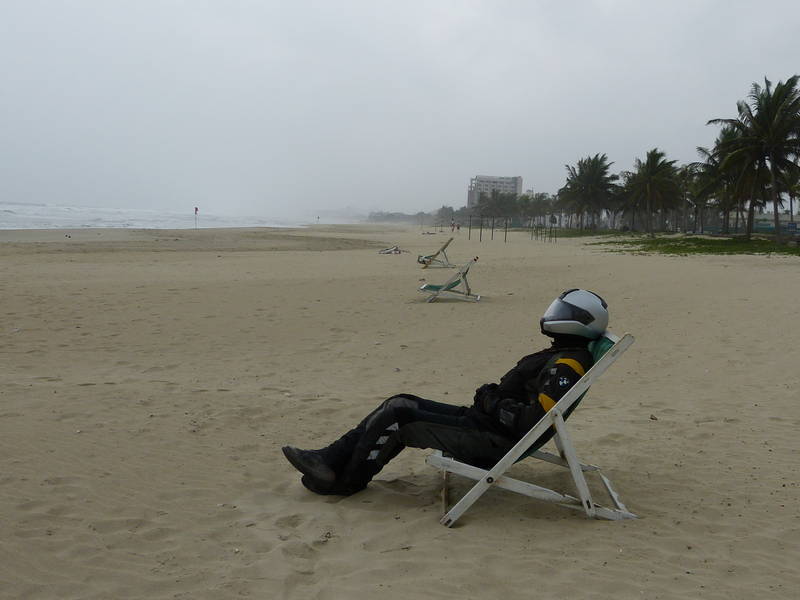
The security guard at the hotel in Hoi An is dwarfed by the Adventure

Candles floating down the canal in Hoi An
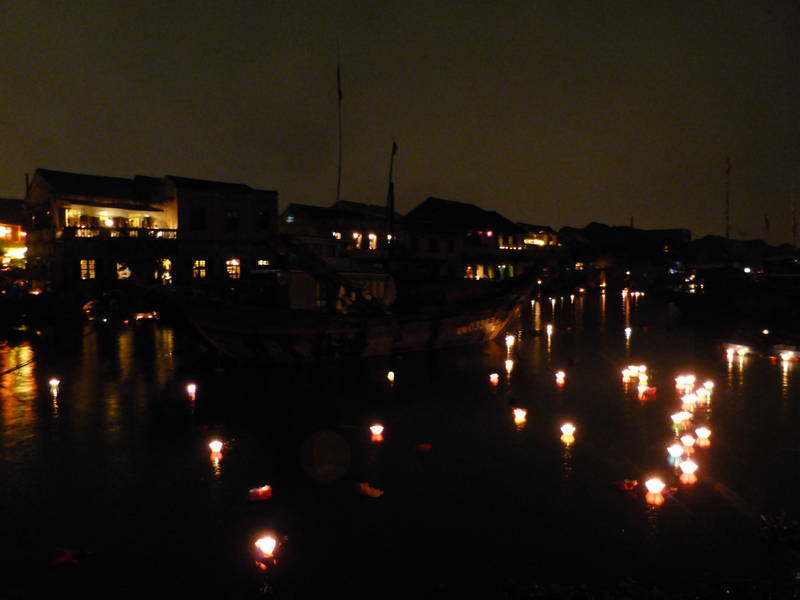
On Sunday morning (did the tailors work all Saturday night?) the custom tailored suit fit perfectly. The attendant said that I looked quite handsome in it to which I replied, "Is it a magic suit?" She called the post office and a few minutes later a postal clerk came over, carrying everything necessary to make a nice little package. They proceeded to fold my new suit into a small parcel and I asked for it to be sent using the cheapest method possible. They protested saying that it would take three months to arrive back in Canada and I said that I wouldn't need the suit until August when I went back to work. So 510,000 dong for shipment ($25) added to the cost of the suit and it was still less than an off-the-rack suit at home though I suppose that if I added the cost of getting to Vietnam in the first place it might be more expensive. Back at the hotel we packed the bikes in the rain and headed off at about 10:30. We took small country roads for 110 kilometres until we reached the Ho Chi Minh Highway (love that yellow centre line) and turned south once again. The rain had been quite steady all day and it was a great relief to cross a mountain range late in the afternoon and get out of the incessant dampness. Why is it that a motorcycle suit that costs more than a new Vietnamese scooter can't keep me dry? After a couple of hours of riding our wet gear had dried out and we arrived in Ngoc Hoi at the BMC hotel. I opened the saddlebags and the left side had a few hundred millilitres of water while the right side bag contents were merely damp so the evening was spent drying everything out.
A magic suit
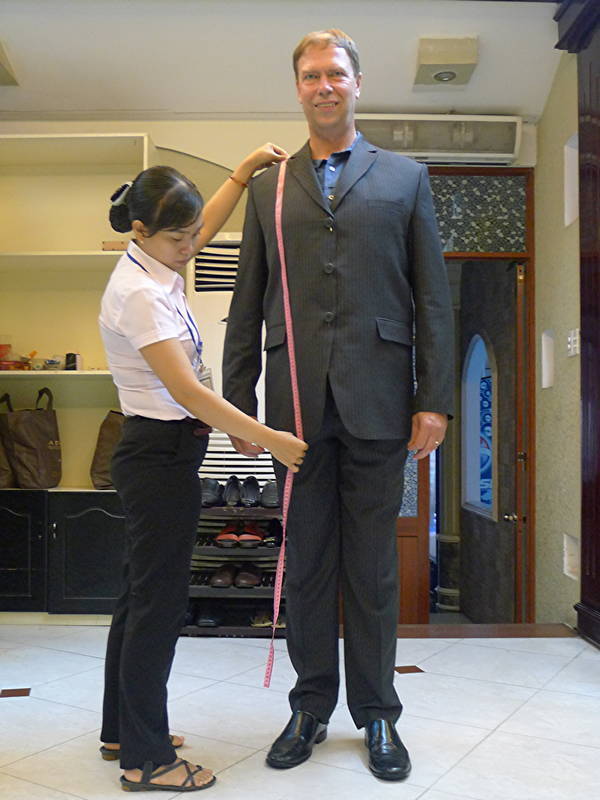
Another damp ride
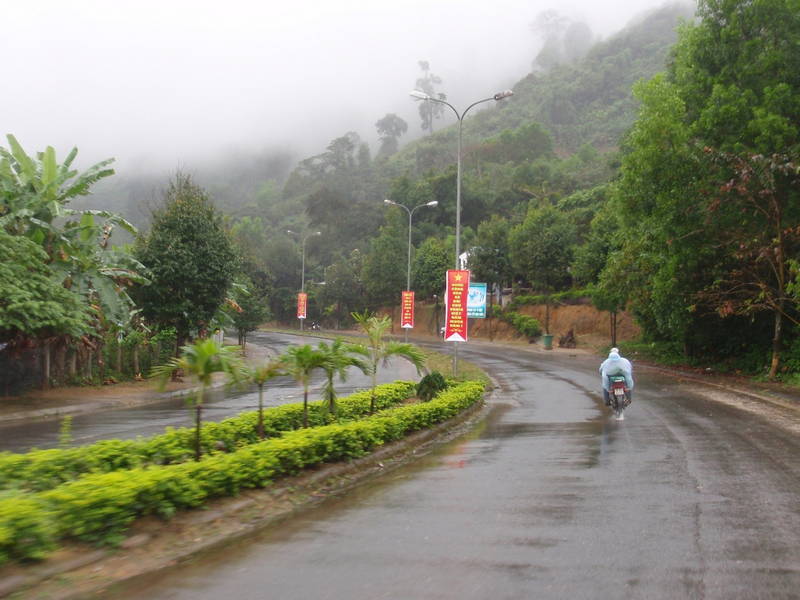
February 25: Audrey's birthday. This was the first time since we had known each other (1987) that we weren't together on one of our birthdays. Using Skype I gave her a call as she was visiting my parents at lunch time in Airdrie enjoying a delicious homemade cake. It sounded like she was doing well and all the tests performed on her looked OK so that she would be able to rejoin our tour soon enough. In a way it was nice for Audrey to be home when her Mom was moving to a new place so she was able to help out. We hadn't planned to ride a great distance on Monday so we had lots of time to stop and see things. A beautiful day greeted us as we rode a short distance to the only wooden church in all of Vietnam. It really reminded me of the stave churches of Norway but only in that it was made of wood, not in its design. Nearby, a traditional meeting house stood with its characteristic tall, steep roof and on stilts. While the original building had been burned down in 2006 the new structure from 2011 was now used for meetings of the local communist party. We didn't have to ride very far to a restaurant that had the best BBQ chicken in all of Vietnam; yummy. In the afternoon Tuyen pulled off the road and down a dirt path into a suspiciously artificial forest. Rubber trees. Tuyen explained how the rubber is harvested twice a year. All I could think of was that it flows out just like maple syrup in Quebec, yummy. At about 3:00 we went to a large hydro-electric dam in the hopes of getting a tour of the facility but Tuyen was told that the place was closed for maintenance and we couldn't have a tour. A few minutes later, as we were enjoying a cold beverage, a bus pulled into the parking lot. Apparently the plant wasn't closed for maintenance anymore and they could get a tour and we were able to join them. We hopped on the bus and drove across the dam and down the valley on the other side. Four large turbines whirred away underground, generating up to 720 Megawatts. While this was the largest generator in Vietnam it was soon to be eclipsed as another, larger facility was being built north of Hanoi. It was a short ride to Pleiku and the final night of the tour. Over dinner Tuyen and I talked about the tour. I told him that the tour certainly met all of my expectations and I really liked following a motorcycle much more than following a car. (If you're thinking of riding in Vietnam check out their website at http://www.voyagevietnam.net/eng/) That evening I prepared for entering Cambodia by checking my paperwork, making sure I had a passport photo handy, had enough U.S. dollars on hand to purchase the visa and learning how to say hello and thank you in Khmer.
Audrey at my parent's house with her birthday cake

The only wooden church in all of Vietnam
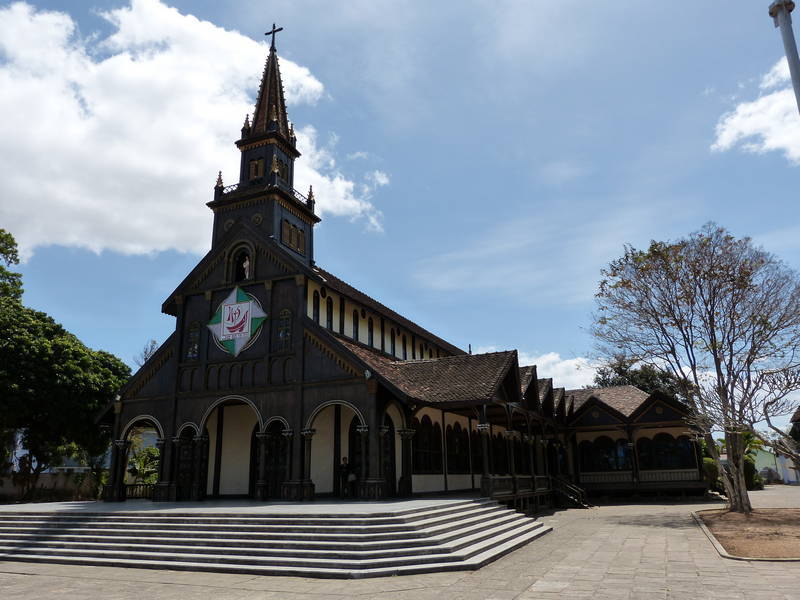
Traditional meeting hall, now used for communist party meetings. Easier to back down the steps cut into a huge log.
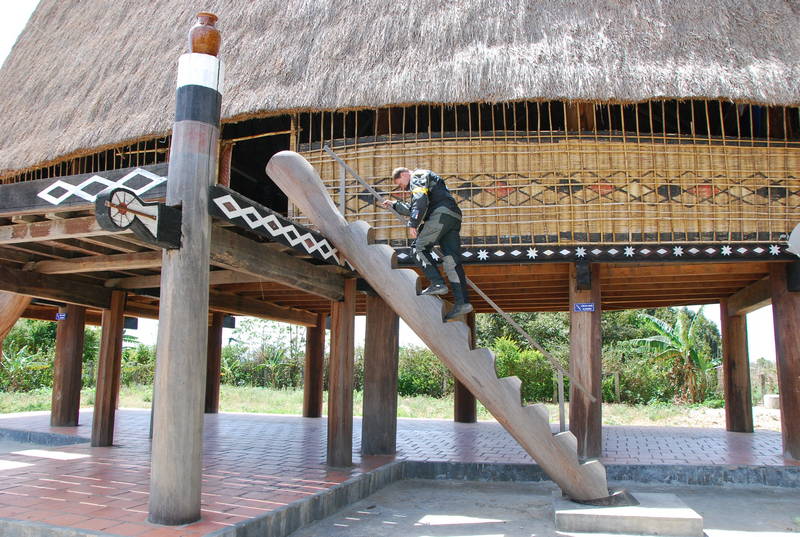
Maple syrup in Vietnam? Nope, rubber trees.
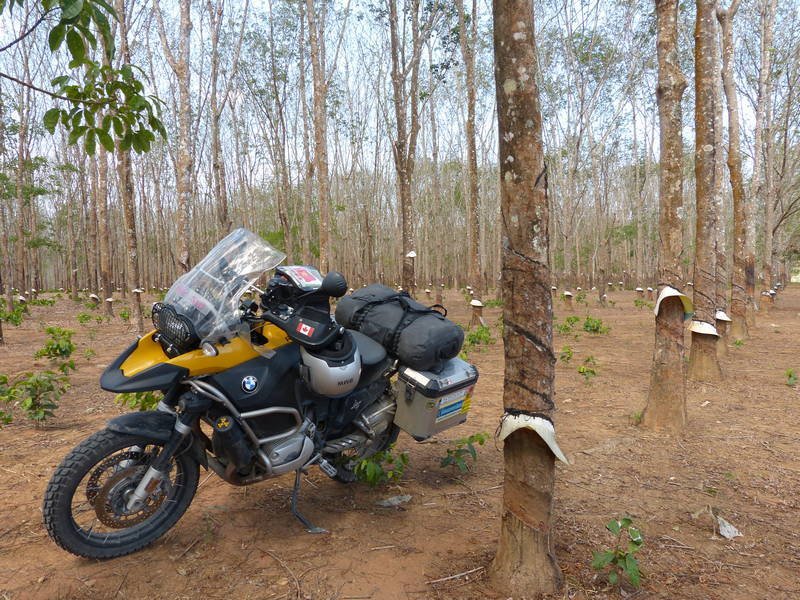
What could have been a romantic dinner on Audrey's birthday in Pleiku
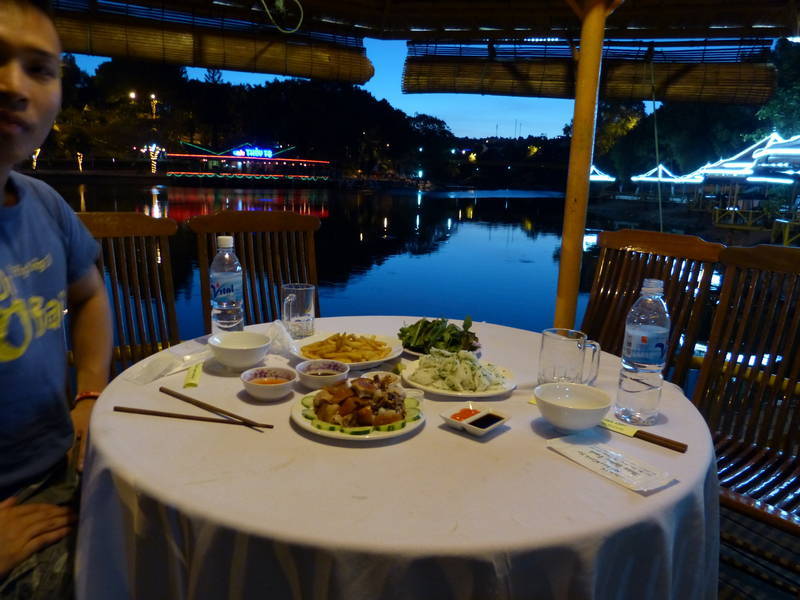
Since breakfast wasn't included at the hotel we stopped off at a roadside stand on the way out of Pleiku for a Vietnamese sub. A baguette with a delicious filling and a couple of fried eggs on top along with a Vietnamese coffee was a great start to the day, better than some of the buffets we had had. As we rode west on a fairly new road to the border Tuyen pulled over at a coffee plantation. Some of the best coffee in Vietnam was grown in these hills west of Pleiku. I didn't recognise any coffee beans on the trees so maybe it wasn't in season when we were there. We arrived at the border at 10:00 AM and the paperwork to exit Vietnam was done quite expediently. It looked like these customs officials had seen a carnet de passages before. With a big hug I said goodbye to Tuyen (how different it must have been for him to lead a tour "group" of one, non-drinking rider!) and then rode into no-man's land.
I was a little concerned that the roads in Cambodia would be very rough and it would take some time to ride across the country back to Thailand to await Audrey's return. The rough dirt path between the two border stations didn't inspire any confidence in my ability to make good time. I got the visa for Cambodia at the border after filling out a form and handing over $20 U.S. I then took my passport with its fresh visa to the passport office next door for a stamp before heading to the customs shack to explain the carnet de passage. It didn't take too long, with a little guidance from me, to figure it out and get me on my way. As there wasn't a currency exchange office at the border I stuffed my dong back into my pants and rode off. Once out of the border zone the road was fantastic. I couldn't believe my eyes, decent pavement and almost no traffic meant that I could ride at 100 kph without any trouble. I stopped at a small town bank to see if I could exchange Vietnamese dong for Cambodian riel but was told that they didn't do that, however I could go to the market in the centre of town and find someone who could do the exchange. I didn't want to waste time wandering around the market (especially in full motorcycle gear now that it had warmed up to 38 degrees) so got back on the fantastic road and did the 200 kilometres from the border to the intersection with National Highway 7 in a tick over two hours. I had planned to go to Stung Treng that evening but with the excellent time I had made from the border I thought I might be able to make it to Kratie. I pulled out the iPad and did a little research at the side of the road as a crowd of kids gathered around. As I opened the Lonely Planet guidebook I could hear "murmur, murmur, iPad, murmur…" LP said that Kratie had a few tourist facilities so I hoped that the road would be as good as the road from the border and headed south. There were stretches of broken tarmac and there was a bit more traffic but I made the 120 kilometres to Kratie well before dark. I rode around town, looking at the places mentioned in LP, but since LP is oriented more to the backpacker crowd it isn't as concerned with secure motorcycle parking as I am. The You Hong guesthouse was on a busy, narrow street in the centre of town with no parking visible so I went back to a large hotel I had spotted near the Mekong River. The Santepheap had a large parking area surrounded by a wall that looked secure so I went in to check it out. $15 for an air conditioned room sounded reasonable and as it was 39 degrees out I didn't bother asking how much a fan-only room was. Yes, the price was in U.S. dollars. Conveniently that's all the ATMs would spit out, no riel. After cooling off a bit in the room I took a walk and found that the You Hong Guesthouse had a nice restaurant. It had easily the best spaghetti Bolognese in S.E. Asia and a great smoothie to boot. I thought I could get to like Cambodia.
Excellent roads in Cambodia mean it is possible to average 100 kph
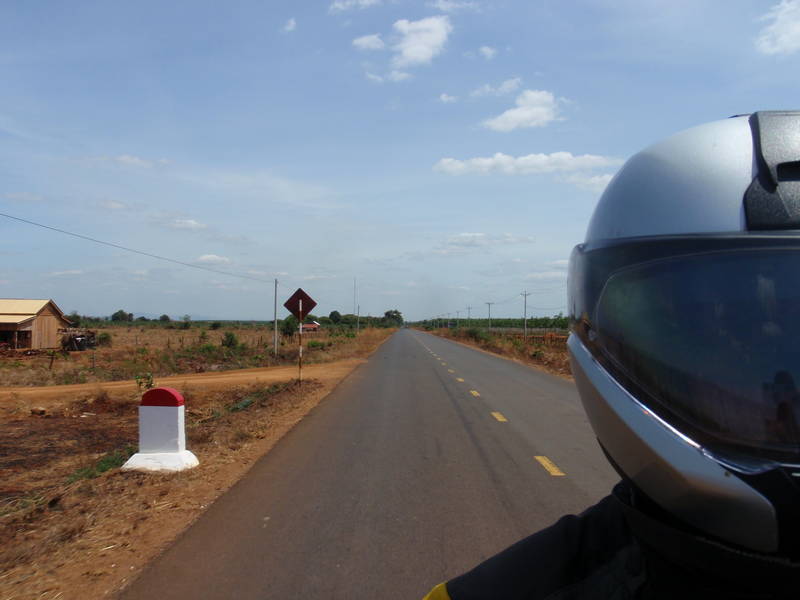
Though you have to watch for slower moving traffic
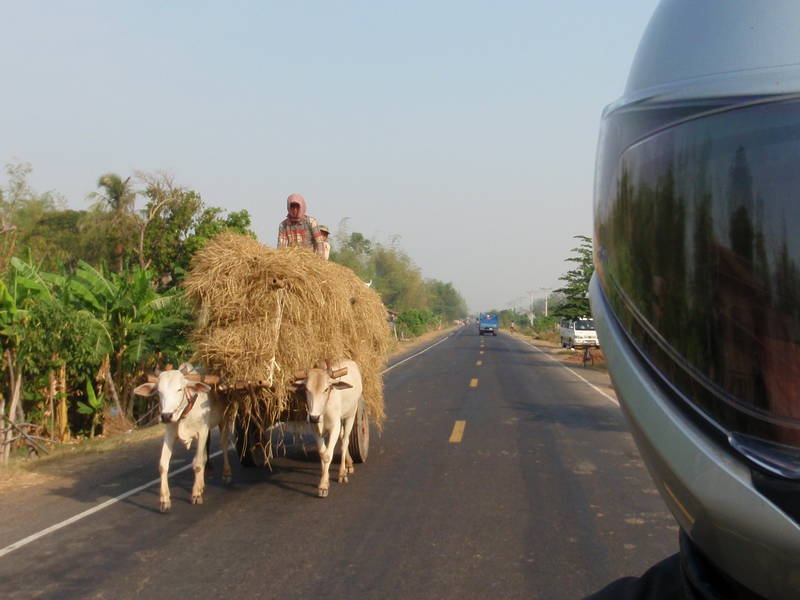
Back at the Mekong River
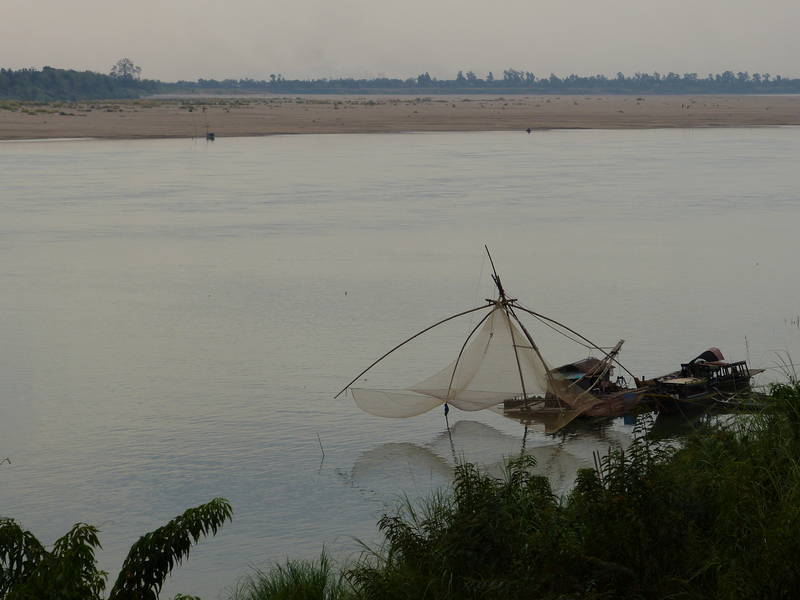
After a $2.50 breakfast at the Santepheap I headed south at 8:00 in the morning. It was already 28 degrees so I wanted to make some distance before it got too hot. The road I chose hugged the Mekong River and passed through little villages, each one with an enormous temple. After about 70 kilometres I turned east on National Highway 6 in the direction of Siem Reap. The highway was quite a bit busier and passing was a bit more aggressive with the expectation being that I pull over onto the shoulder to avoid getting flattened. I started to wonder if the problem really was that I was riding my motorcycle like locals drive a car and other drivers were expecting me to be going slowly like a small motorcycle on the shoulder. That certainly seemed to be the case in Vietnam where following Tuyen on his tiny bike going 70 kph instead of 100 felt safer with oncoming traffic. Nevertheless, I had no intention of riding along the shoulder at 70, not while expecting to reach Siem Reap in one day, so I just pulled onto the shoulder whenever there was oncoming traffic and stayed on the gas. I stopped for fuel (the only stop I would need in Cambodia as the Adventure's tank lets me do 700 kilometres between fill ups) and the price on the pump was in U.S. dollars. $1.25 seemed pretty reasonable and after the attendant topped it up he gave me a complimentary bottle of ice cold water. Cambodia could really grow on a person. I arrived at the Frangipani Villa in Siem Reap at about 2:30 and was pleasantly surprised at how nice this boutique hotel was. Clean and modern with super friendly staff who promptly gave me an ice cold welcome drink. One thing I had noticed at the Santepheap was the same at the Frangipani; they both had the softest bath towels I had ever used. Was this a Cambodian thing? I would have to wait until I returned with Audrey to confirm my theory. My plan was to get to Bangkok on Thursday, about 460 kilometres and one border crossing away so I made reservations for the Viva Garden Serviced Apartments in Bangkok and did a little research on the route. I had heard that not only are motorcycles not allowed on the toll highways in Bangkok, they're not even allowed on the expressways. I couldn't figure out a route that didn't involve at least some expressways so I knew I was going to have to play it by ear tomorrow.
OK, this doesn't look very safe (and see the oncoming scooter being pushed onto the dirt shoulder?)

Scooter transporter

In a way it was a shame to be so close to one of the wonders of the world, Angkor Wat, and yet not go to see it. I wanted to experience that in its fullness when Audrey returned. So on Thursday morning I tried to beat the heat and got going at 7:45. It was already 27 degrees and I did the 150 kilometres to the border before 10:00 AM. It was easy enough getting out of Cambodia once I had walked back to the customs office for the carnet de passage stamp. Right beside the passport office was an exchange booth so I thought I would try to get rid of my Vietnamese dong. No problem. I rode past the casino in no-man's land (?!?) to the Thai border post where an unofficial looking couple of men were doing all kinds of vehicle paperwork. They said to get my Thai visa and passport stamp first and then come back to see them. OK, I picked up the "arrival" card and turned to walk into the passport control office when, with a loud bang, I slammed my head against a low hanging metal sign. The crowd lined up for passport control all went, "Oh!" in unison so I responded in a loud voice, "Welcome to Thailand!" It was quite a long queue at the five or six passport booths and it took a long time to get stamped in. Once back outside the young men took copies of my driver's licence, vehicle registration and passport. They then filled in some kind of import form that I signed and was sent on my way to the customs office. There they took all the paperwork I had just done as well as my carnet de passage and a few minutes later came out with the temporary import document. Overall it took about an hour in the heat to get it all done. Riding in Thailand on the left was easy to adapt to and soon enough I was zipping along the four-lane divided highways heading to Bangkok. When I stopped for fuel there was a convenience store directly adjacent to the gas station where I had lunch. I had missed that in Laos, Vietnam and Cambodia. Closer to Bangkok the traffic became busier and of course more aggressive but I was able to hold my own. The expressway was flowing very quickly without delays underneath the toll highway above. About 60 kilometres out from Bangkok proper this worked well enough but when I got to within 15 kilometres or so I noticed that the car drivers were being much more aggressive towards me, cutting me off, tailgating or encroaching into my lane. I realised that there were now frontage roads and all the motorcycles were over there so I worked my way over and by the time I got off the expressway I was pretty close to the turnoff for Sukhumvit Road where the Viva Garden was located. The frontage road was heavily congested and the width of the saddlebags precluded a lot of lane splitting, even the scooters were stymied and forced to go around obstructing vehicles. It was 3:15 PM when I pulled into the parking lot of the Viva Garden and after sitting on a hot motorcycle stuck in traffic for the last half hour I must have looked quite bedraggled. My registration was expedited and soon enough I was in a cool shower and headed down to the swimming pool. I had put the Kok in Bangkok.
Underneath the tollway entering Bangkok
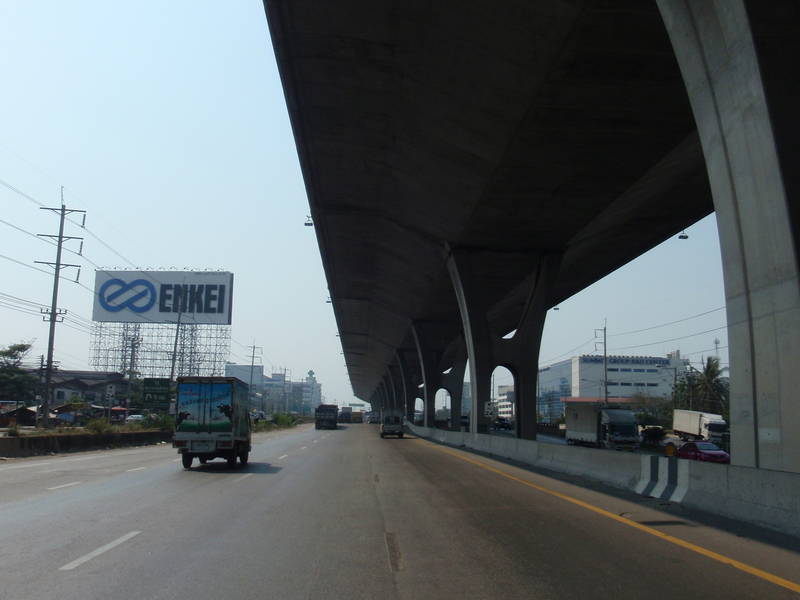
Home sweet home for the next week

Talking with Audrey we determined that the best thing to do would be for her to fly back to Vientiane. Her motorcycle was parked at the Mercure (hopefully!) and we could simply resume the trip as soon as she returned. We arranged a flight for her to Bangkok (via Toronto and Abu Dhabi) and then a separate flight onward to Vientiane. For some reason if booking directly to Vientiane from Calgary the flight on Expedia was about $1,000 more expensive than two separate flights. She would arrive on Saturday, March 9 in Vientiane so I would have a week in Bangkok to do a couple of things. I had the bike serviced at BKK Motorcycles and I also wrote up a full chapter of our website during the week. Audrey and I discussed where we would like to go after our time in S.E. Asia and since her doctors had said that at high altitude she was at increased risk of blood clots we decided to abandon the idea of returning to Europe via Nepal, India and Pakistan. We decided to fly to Istanbul and spend some time exploring Turkey and maybe head east as far as Iran before going up Eastern Europe back to Germany. I contacted a few freight forwarders and started making arrangements for getting the bikes air freighted to Istanbul.
Friday March 8, I said goodbye to the friendly people at the Viva Garden, promising I would be back with my wife in a month or so. The 8:00 AM traffic was at least going in the other direction so there weren't too many delays in retracing my route from a week ago. Still it was 31 degrees and it took two hours to ride 90 kilometres in the heat. A lunch break at a 7-11 when I fueled up provided some air conditioned relief from the heat as did another break in the afternoon for an iced green tea. I pulled into Khon Kaen at 4:30 and aside from missing one turn when I went under an underpass instead of up to the intersection to make my turn it was fairly easy to find the Centara Hotel where I had made reservations. Workers were still building the bar by the pool, the hotel was that new, but the pool was OK to use and I plunged in after peeling off my sticky motorcycle clothes. Ah, blessed relief.
In the morning I checked my e-mail to confirm that Audrey was on her way to Vientiane and found that she had been delayed leaving Toronto. That meant she missed her connection in Abu Dhabi to Bangkok and consequently would miss her flight from Bangkok to Vientiane. I called Expedia and was able to change her flight from an 11:45 AM departure out of Bangkok to 7:55 PM then e-mailed her back with the new information. This gave me some breathing room as well since I had planned to ride the 200 kilometres to Vientiane in the morning and meet her at the airport. Now I could take my time and wasn't under any pressure when I arrived at the Friendship Bridge between Thailand and Laos. Leaving Thailand was quick and easy and then crossing the bridge was also nice as there was a toll for all vehicles except motorcycles. For some reason Laos was a little more difficult, first obtaining the visa upon arrival and then paying the fee, which included an extra dollar for working overtime on Saturday. When I showed my carnet de passage to the vehicle inspection officers they motioned me to another building where I wandered around until I found an office where a guy was dozing behind his desk. I knocked loudly to wake him up and then he promptly filled in the appropriate spots on the form. I returned to the other officers and showed them the carnet and much discussion ensued. As the discussion was in Lao I didn't understand any of it. So one of the vehicle inspection officers motioned for me to follow him and led me back to the building where I had the carnet stamped. I tried to tell him that I had already done that. Just as we were to enter the office again the officer had a closer look at my carnet. Then he found the reason for the confusion. The Thailand portion of the carnet was still attached which is what they had been looking at. The new page below had been properly filled in by the Lao officer I had roused from his noontime nap. Now everything was OK for them, but I was a bit concerned that the bike hadn't been properly stamped out of Thailand. Would this create problems later when re-entering Thailand or when we returned home and tried to get our money back for the carnet? I rode across familiar Vientiane to the Mercure hotel and was delighted to see that Audrey's bike was still there, tucked under its blue cover. My delight faded somewhat when I tried to check in and was told that my reservation was for exactly one week later, March 16, not March 9. I pulled out the iPad and was able to pull up my e-mail which showed the confirmation for March 9. The mistake was theirs and fortunately there was a room available. I whiled away the afternoon by going to Joma for lunch, working on the website and reading a book all waiting anxiously for 9:05 PM to arrive. I had arranged for the hotel shuttle to meet Audrey at the airport but decided to ride there myself to greet her as she came off the plane. What a great reunion! It was so good to see her, knowing that now we could resume our adventures together. And the adventure started right away as the hotel shuttle didn't show up. There were a few options available to us but the one that we chose was for Audrey to ride on the back of my bike while resting her duffle bag on the saddlebag. Since she had on exactly the same protective gear as the vast majority of scooter riders in Laos (i.e. none) we rode very slowly along the side of the road for the three or four kilometres to the hotel. Let the rest of the adventure unfold from here.
Leaving Thailand and crossing the Friendship Bridge to Laos

A bonus section! Here are a few scooter photos I took on the ride:
Who knew an umbrella would even work on a scooter?
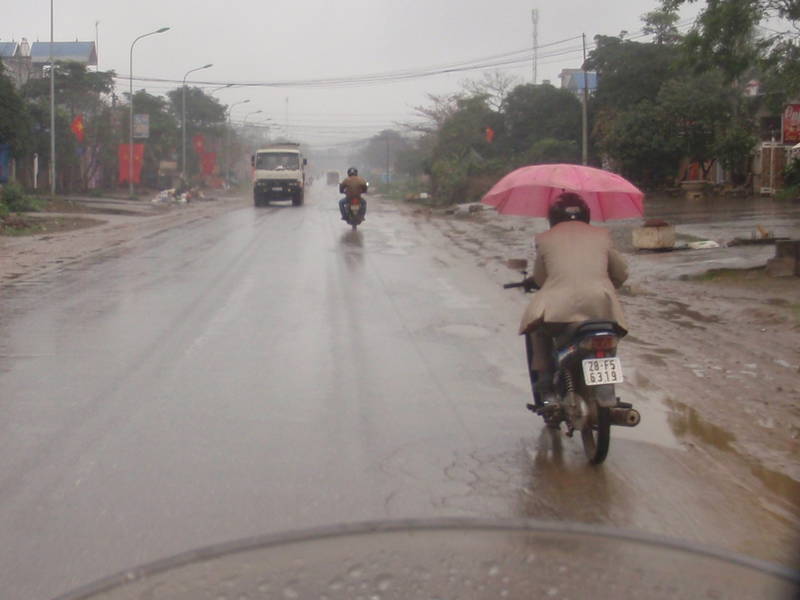

Entering Hanoi

That's got to be pretty heavy

Yes, he's texting on the cell phone
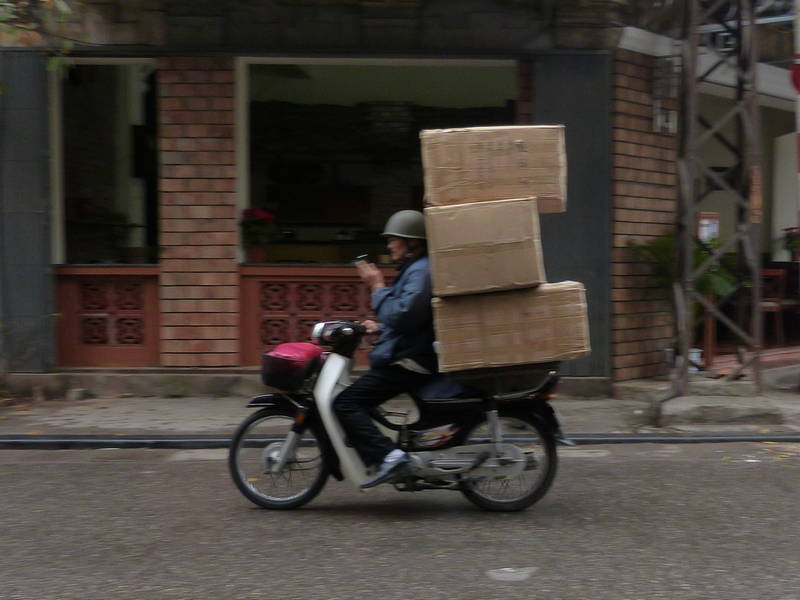



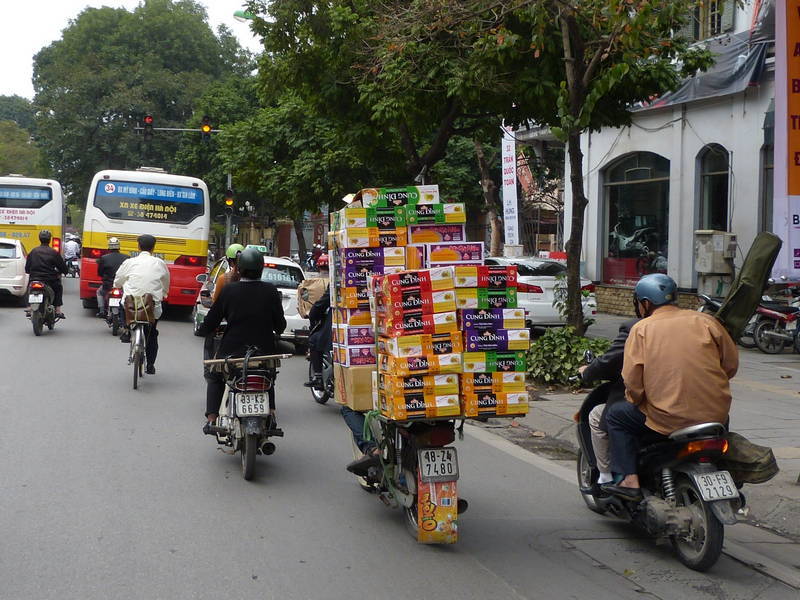
The orange tree after Tet
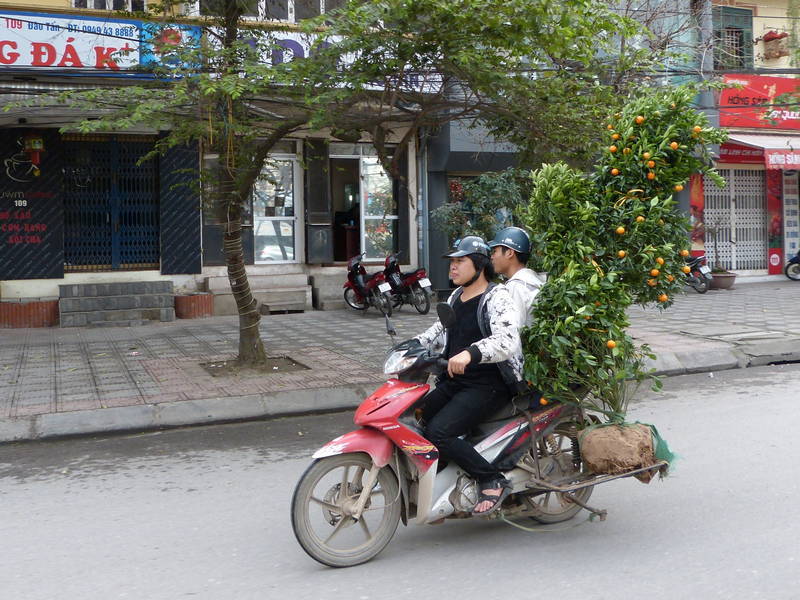
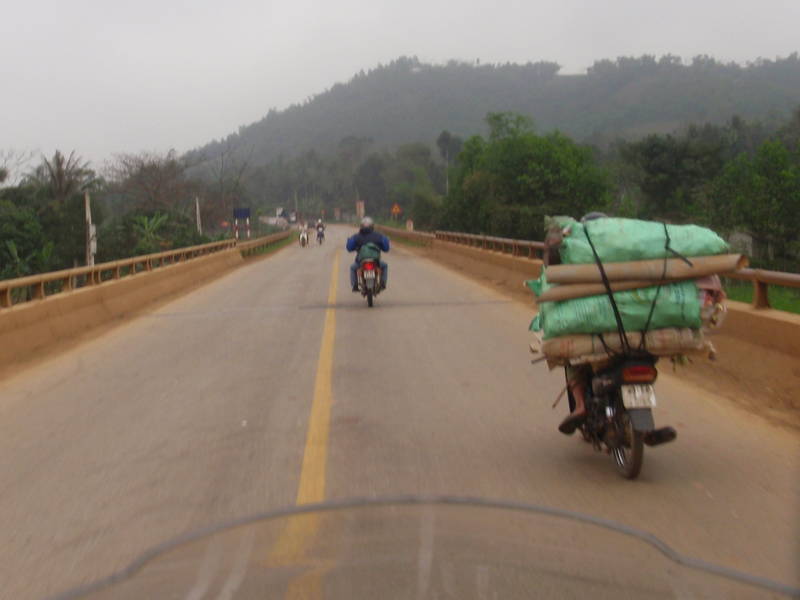
Fuzzy picture of pigs off to market

Why not?
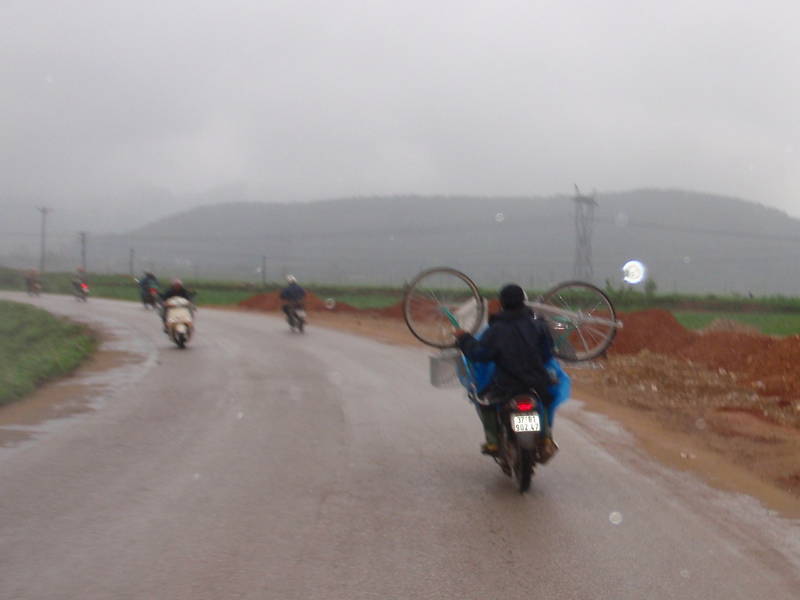
Bananas anyone?
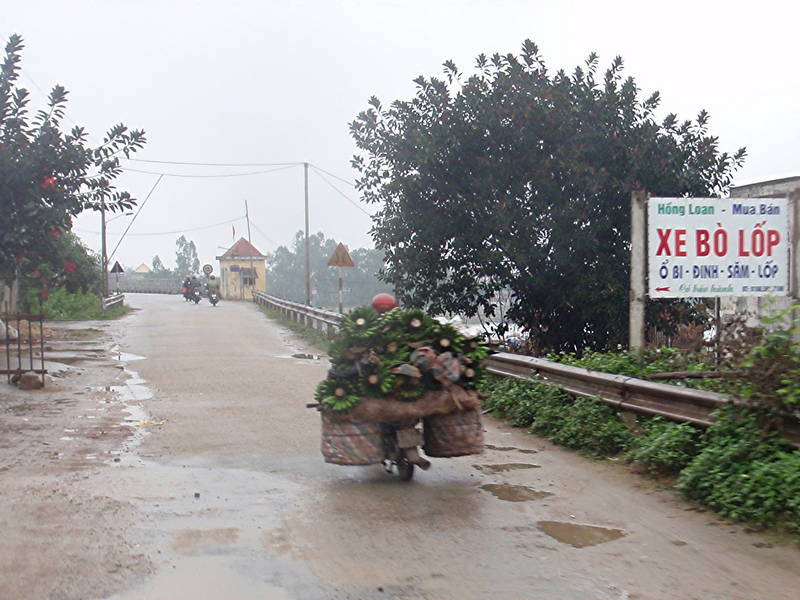
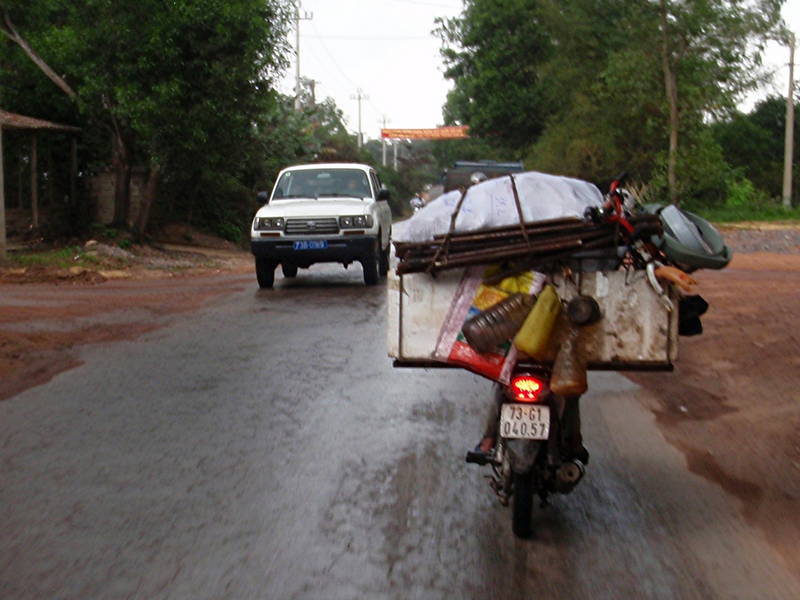

Scooters are the predominant mode in Vietnam


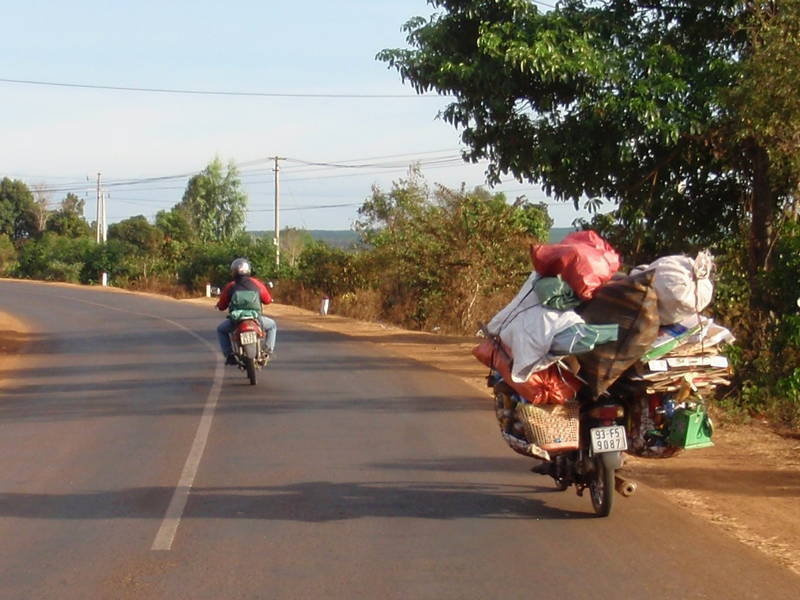
Cambodia had a few of these travelling salesmen travelling in convoys of three


Yes, Thailand has scooters too
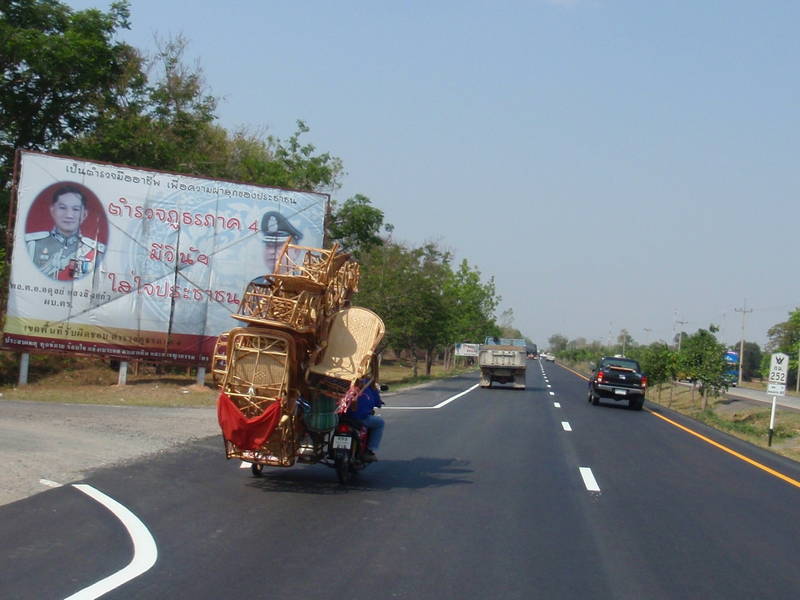
Map of Ekke's route to and through Vietnam

Sunday, March 10, was a day set aside for Audrey to try and get over a 14 hour jetlag. Some time in the Mercure's pool and fitness centre seemed to help and having her bike fire up on the first push of the button felt good too. On Monday we decided that since we hadn't done a lot of touristy things when last we were here in Vientiane we should do a little something now. A nice walk of about one and a half kilometres to Joma Café for breakfast was great and then we walked over to the National Museum. A good selection of displays ranged from prehistoric and tribal artefacts all the way to the modern era. I found it interesting that the displays on the American bombing referred to U.S. Imperialism, just like in Vietnam. Back at the hotel we relaxed by the pool for a little while before going over to COPE (Cooperative Orthotic and Prosthetic Enterprise) a non-profit organisation that provided rehabilitation for survivors of unexploded ordinance (UXO). The impact on people's lives, especially in rural Laos, was simply staggering. People couldn't work the fields without risk of having a leg blown off. Even children were out finding scrap metal (in the form of UXO) to supplement the family income. I found it especially curious that the people who dropped the bombs in the first place (the Americans) weren't the ones out there cleaning them up; instead it seemed to be mostly not-for-profit humanitarian organisations. On Tuesday we went for a ride out of town to a Buddha park. As Audrey hadn't ridden her motorcycle for a month it made for a nice dry run and it was really neat to see this park where hundreds of Buddha statues were on display from the tiny to the enormous. While the statues appeared ancient they were in fact relatively new as the park was started in 1958. The integration of Hinduism and Buddhism resulted in some interesting sculptures, the most interesting being a three storey high pumpkin that we could climb up. Apparently it represented Hell, Earth and Heaven and the view from Heaven was a treat. At the top, precariously perched on the rounded top, three stories above the ground, a young monk came over and practiced his English with us. I found it difficult to have a conversation in that situation so went down while Audrey continued to chat.
Entrance to the National Museum (no pictures allowed inside)
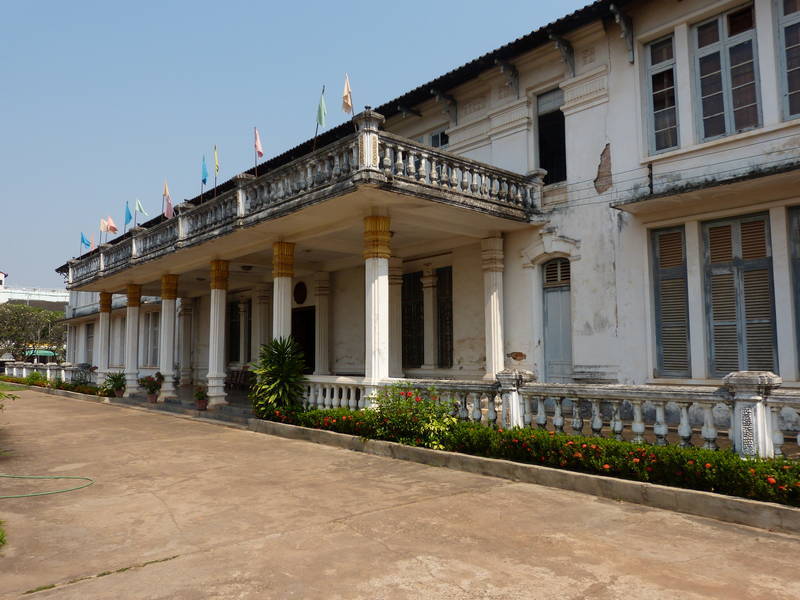
Samples from the Plain of Jars
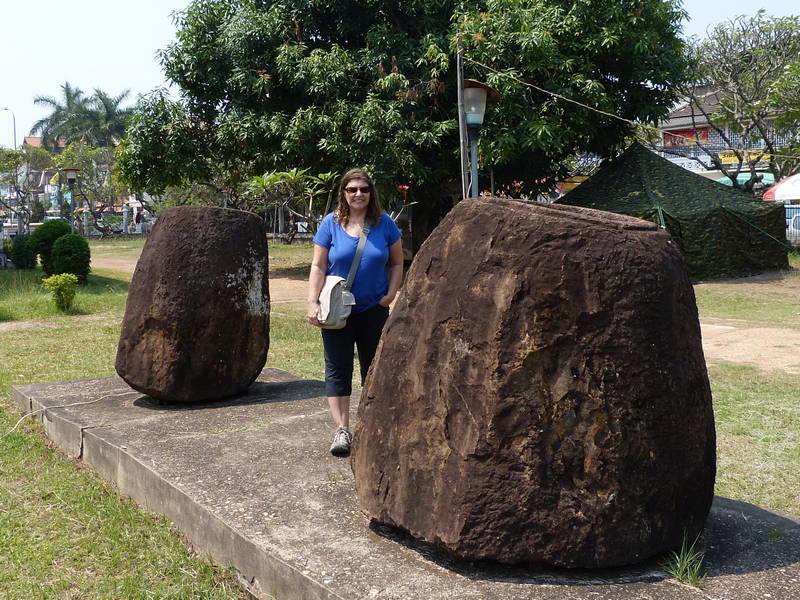
An interesting carving in front of the museum

Wow, how many years would the average Laotian have to work to pay for a Bentley?
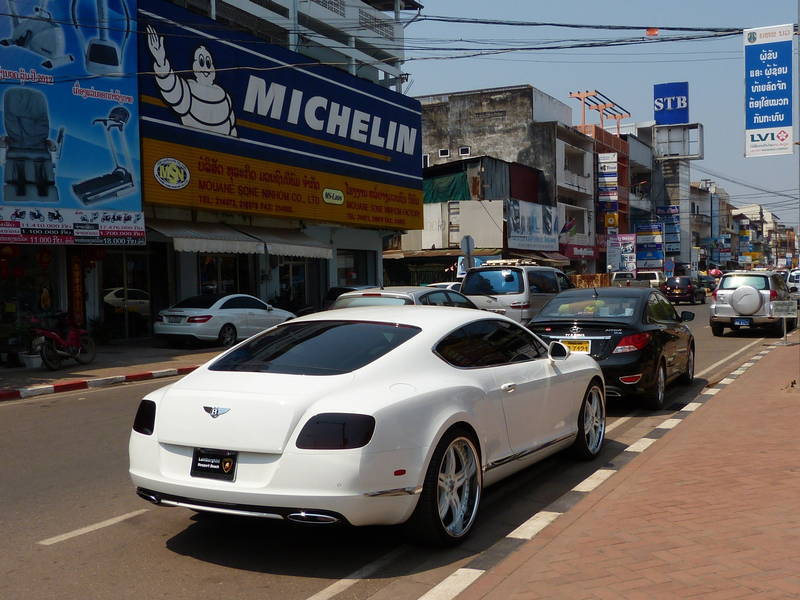
OK, I looked that up. As per the World Bank the Gross National Income per capita for Canada is $45,550 annually. So it would take the average Canadian a little more than four years to pay for a $200,000 Bentley. GNI for Laos? $1,130 per year. It would take 177 years for the average Laotian to pay for the Bentley. Wouldn't you feel awfully self conscious driving a car like that in such a poor country? Off soap box...
A cluster bomb display at COPE
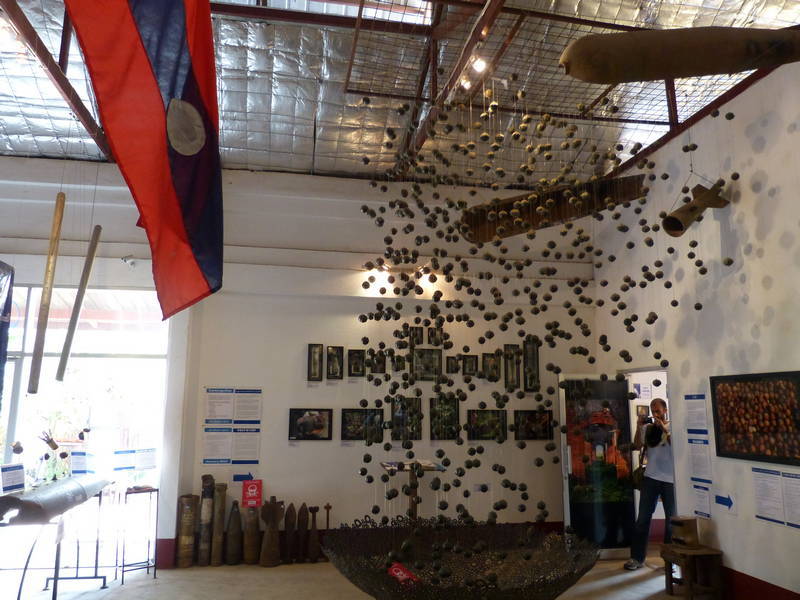
Interesting statues at the Buddha Park just outside of Vientiane
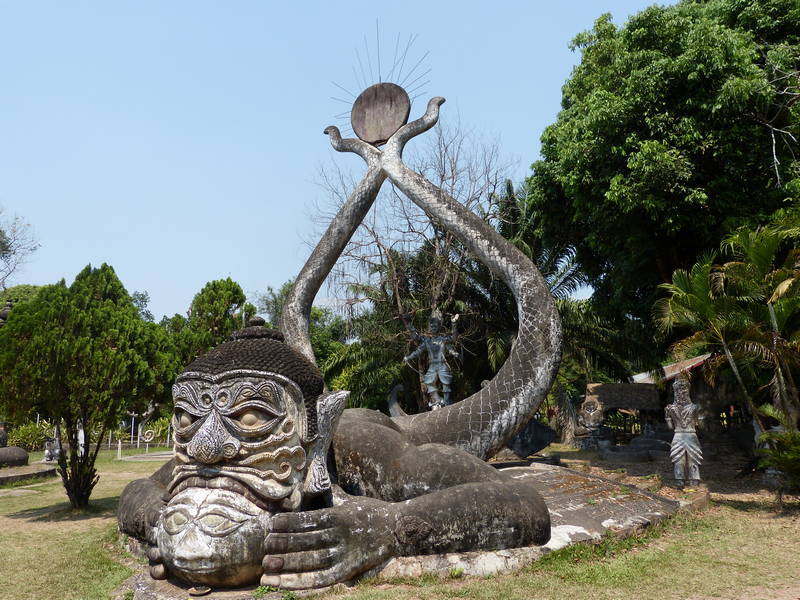
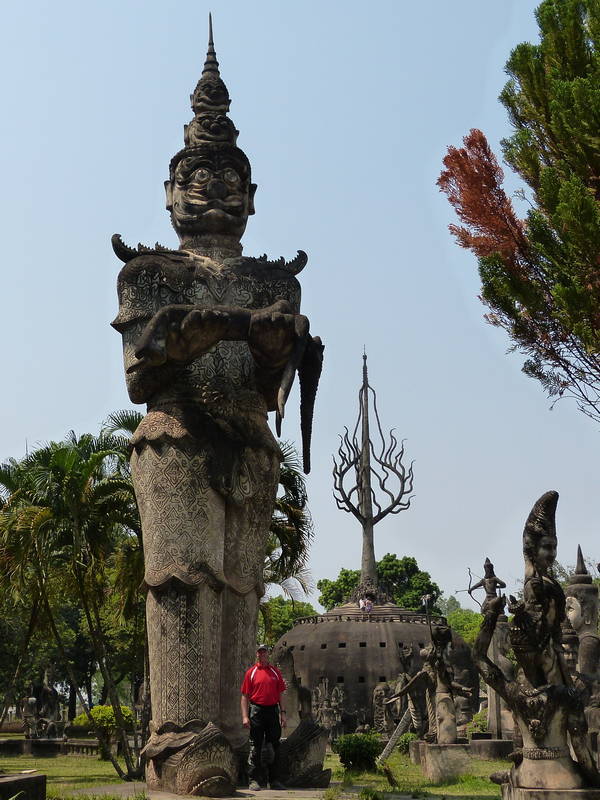
Audrey does her best Reclining Buddha imitation
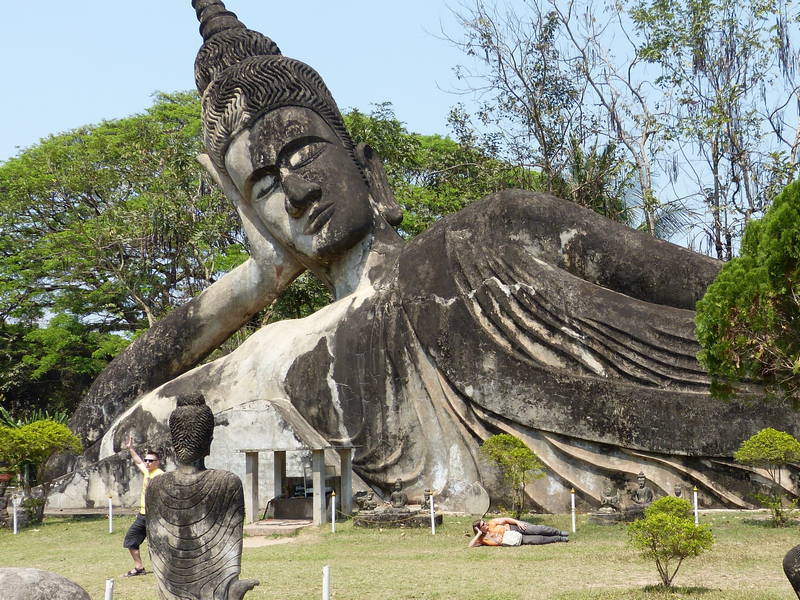
View from the top of the "Pumpkin"
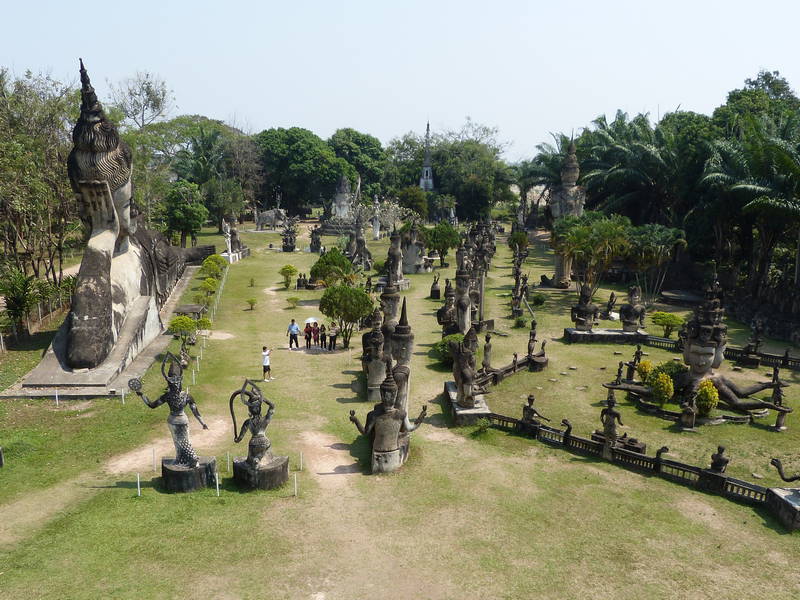
Wednesday it was time to start travelling again. We planned for an early start with breakfast at 7:00 AM and then to ride a fairly short distance to Paksan. We packed up and rode into the centre of Vientiane where we had dropped off our laundry the day before. While picking up the laundry and packing the bikes a few tourists stopped by and we chatted about our trip. The owner of the laundry was originally from Hanoi and was going back home for a visit soon so it was interesting getting her perspective of both Hanoi and Vientiane. We ended up leaving Vientiane at about 9:00 AM and after a refueling stop and then a water break we arrived at Paksan at 11:30 AM. That was indeed a short ride. The VIP suite was only 180,000 kip ($24) so we decided to splurge and then went for a walk. That evening I met Pascalina and Phillip just as they were leaving the hotel to get some sunset photos on the Mekong. They had bicycled all the way from Switzerland over Iran, Mongolia and China. Wow! As they were off to take photos we decided to meet up for coffee in the morning.
Leaving Vientiane

Back out in the Lao countryside
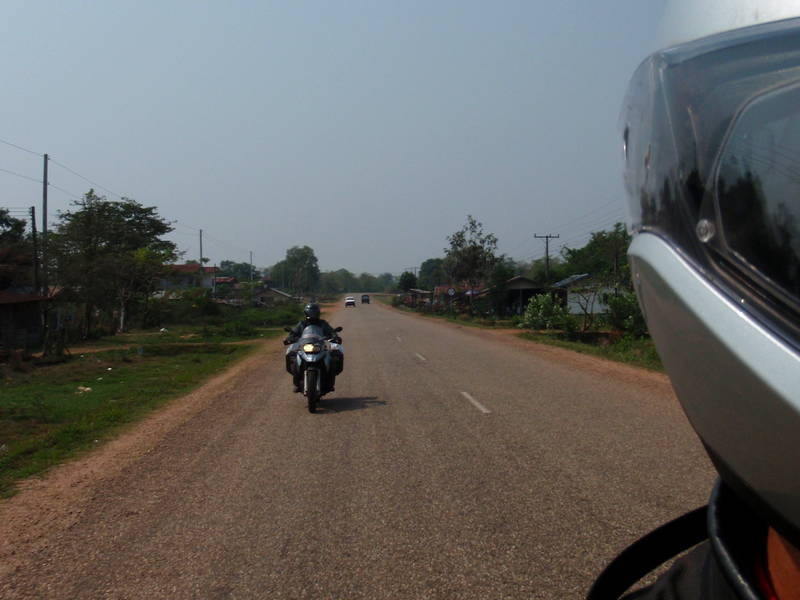
On Thursday Audrey and I walked across the street to a coffee shop at 8:00 AM and shortly thereafter Pascalina and Phillip joined us. We must have talked for two and a half hours. It was great sharing experiences from on the road, especially as their journey had covered similar ground. One comment we found interesting was that they had obtained their Iranian visas in Trabzon, Turkey without the need for an authorisation number in just one day. We filed that information away and hoped that we would still be able to visit Iran, even if it meant coming from Turkey rather than Pakistan. It was already 33 degrees as we left Paksan at 11:00 AM and rode southeast. We turned off the main north-south highway onto Highway 8, running east. Up into the hills we climbed and it was fun playing on the twisty road before turning south and riding along the flat valley floor to the Auberge Sala Hinboun, an eco-lodge near the Kong Lor cave. Arriving at 2:30 meant that we probably had enough time to visit the cave but we decided to spend a couple of nights at the lodge instead so that we could take our time on Friday. A great walk along the road highlighted once again how friendly the Laotians were as everyone greeted us with a cheery, "Sabaydee!" A frozen orange juice on the way home made for a great refreshing Popsicle. Back at the lodge an e-mail from the shipper who would get our motorcycles to Istanbul said that the Songkran festival would be taking place in Thailand from April 13 to 16. They suggested that we should avoid that time for shipping as a lot of places would shut down for the festivities. They needed a couple of weeks to arrange the paperwork so we set our plans to enter Thailand on April 1 and then send them our Thai importation documents.
Meeting up with Pascalina and Phillip
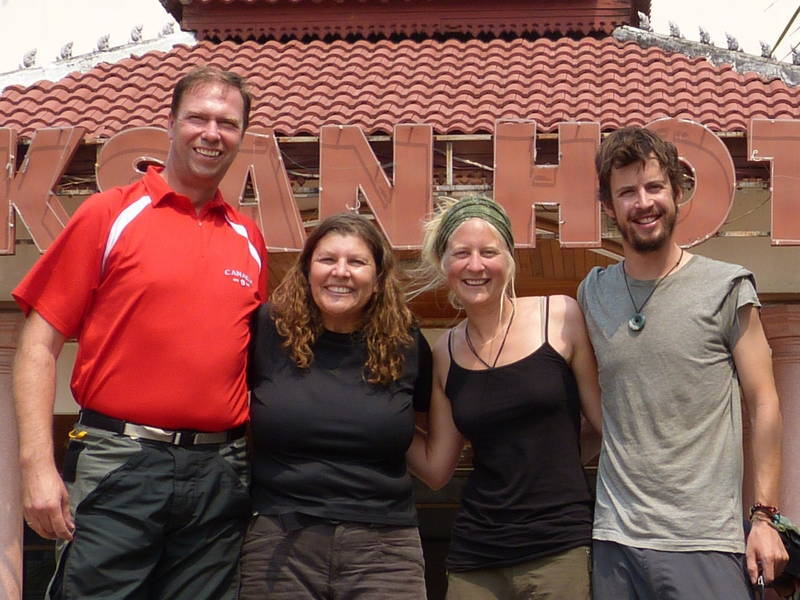
Before they head to Vientiane and us to Kong Lor Cave

Riding into the hills away from the Mekong
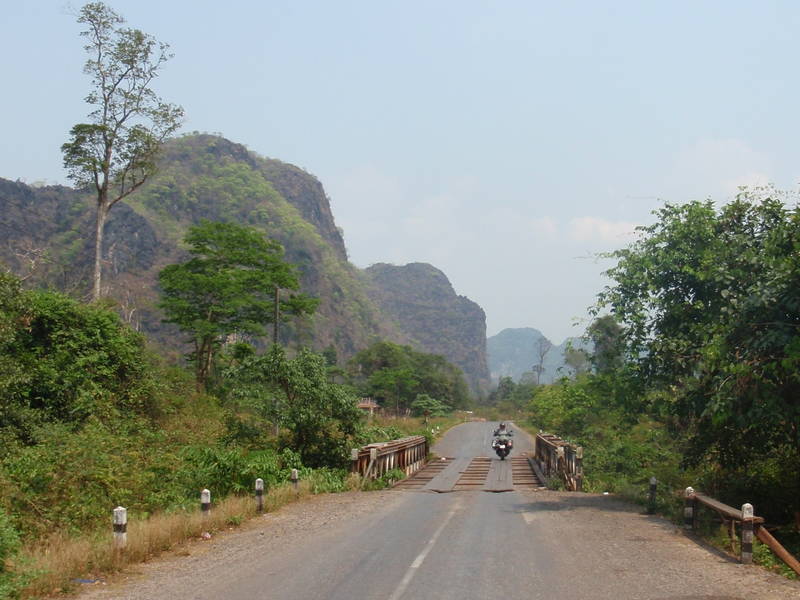
Past Water Buffalo
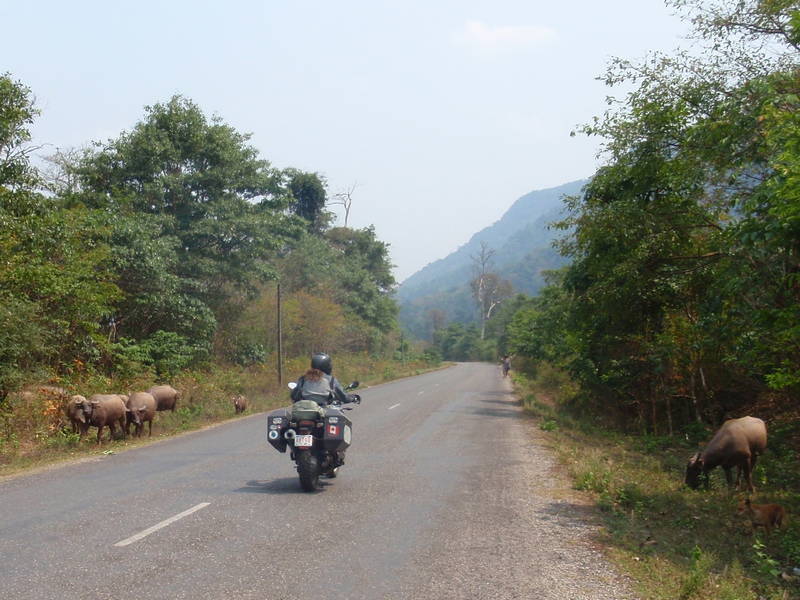
To a stunning viewpoint
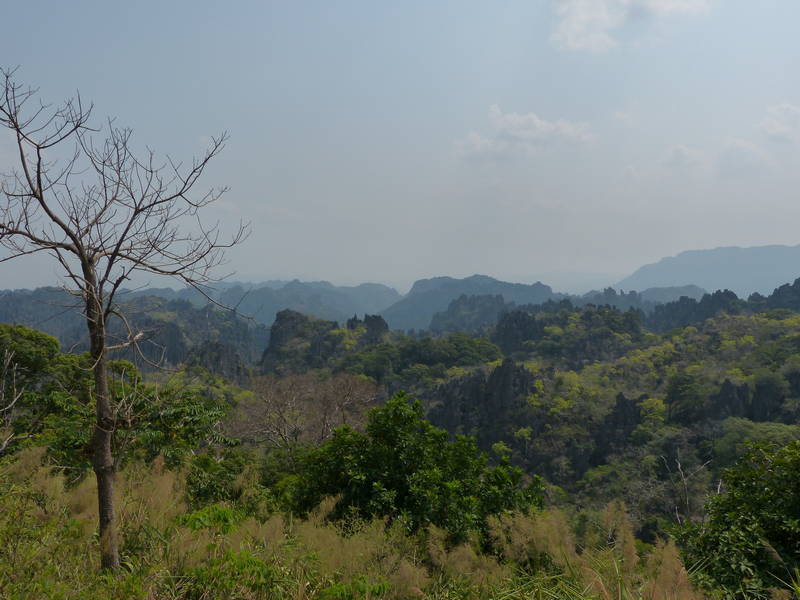
Arriving at the Auberge Sala Hinboun

View from our balcony

Going for a walk we came across these kids who had caught that evening's supper
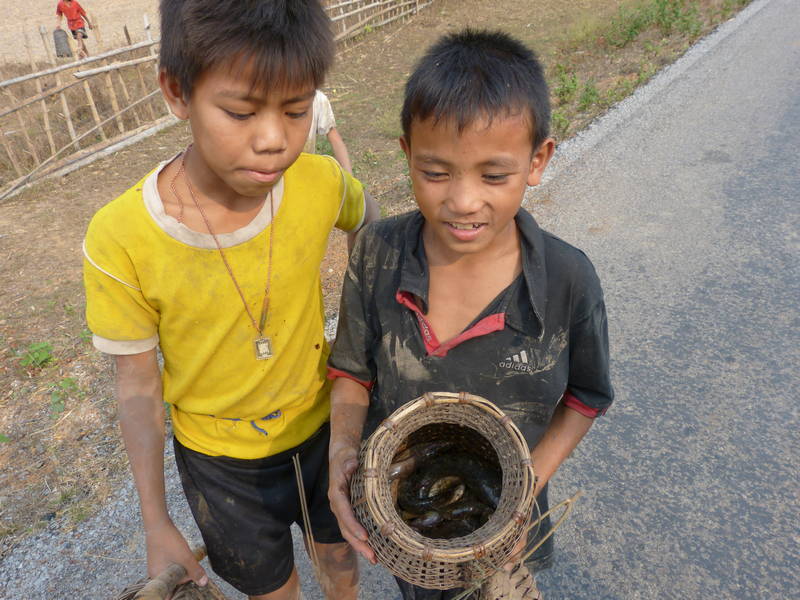
While we had bananas flambee
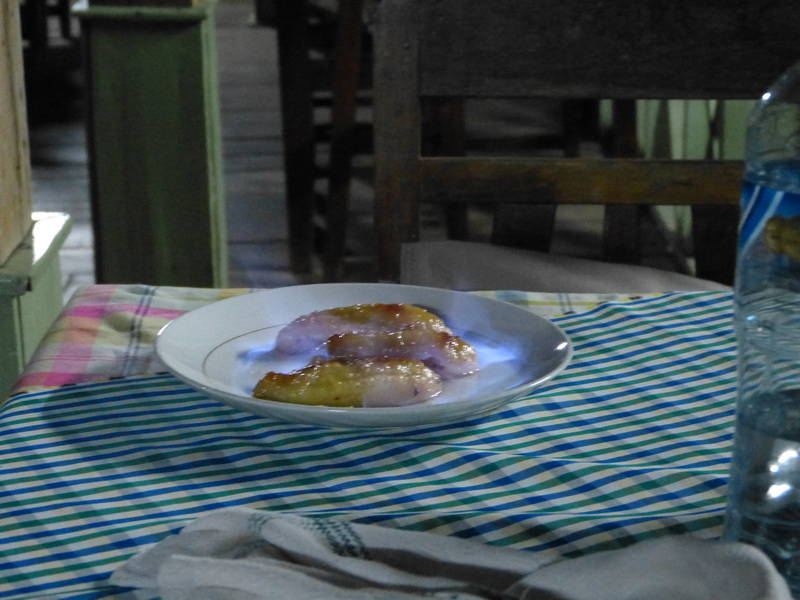
Sleeping at an eco-lodge can definitely have a down side. In this case it was a loud, unidentified bird that would make a call every twenty minutes or so. All night long. Right underneath our room on stilts. Just as I drifted off the darn thing would cry out again. I finally grabbed the ear plugs out of my motorcycle jacket at 2:30 AM and managed to get some sleep. Later in the morning, after breakfast, we rode 12 kilometres south to the Kong Lor cave park. Now, I'm not normally a fan of caves and from the stories I had read I wasn't really looking forward to this one either. I mean, who wants to wander around in the dark, bashing their head into a rock only to have spiders the size of your palm walking around? At the dock we boarded a boat and motored into the cave mouth set into the side of a cliff. Our headlamps (mine could use new batteries) only provided the slightest illumination so it was good that the boat crew had massive flashlights. The underground river was amazing as we wound our way underneath the mountain. The ceiling was really high, at times simply disappearing into the darkness above with my weak headlamp unable to find the top. We beached beside a set of rapids and walked amongst stalactites lit up by floodlights. In the meantime the crew dragged our boat across the rapids and we boarded again on the other side. There were a few more rapids to negotiate where we walked in the water upstream with the boat and then we were out the other side. We had gone 7.5 kilometres through the mountain. A few stalls set up near the beach allowed us to purchase some refreshments for ourselves and the crew. The guide (as opposed to the motorman) had a Beerlao so hopefully it was still early enough in the day that he hadn't had too many to navigate our way back. It seemed to go well enough and we actually shot a few of the rapids going downstream that we had walked up previously. This was easily the best cave I had ever been in. After a delicious can of coconut juice ("with coconut flesh") we rode back to the lodge and packed up before the noon checkout time. After doubling back the way we had come the day before we rejoined Highway 13 southbound. We stopped for lunch at a small village with a lot of open air restaurants lining the highway. The displays were quite interesting and if we had a little more culinary adventure in us we could have tried the rats or frogs or even baby chicks roasted on skewers. As it was, just a photo and then some sticky rice with fried eggs satisfied our lunchtime cravings. After a hot but easy ride we arrived at Tha Khek and checked in to the Inthira Hotel. It seemed to be a bit of a backpacker joint (being mentioned in Lonely Planet can do that) but it had a nice room and the food in the restaurant was tasty. We went for a walk around town and when we came back I noticed that I had left my key in the lock of a saddlebag. I looked over at a gentleman sitting at the hotel café and smiled. He said he had seen it there and was keeping an eye on it for me. We struck up a bit of a conversation and afterwards Audrey and I thought about the backpacker crowd in general. For some reason it seemed that most backpackers ignored us. Other travellers would always come over and chat to us, amazed that we had ridden our motorbikes here but for some reason backpackers (and I'm generalising here) seemed to be in their own world.
Going south from the eco-lodge towards the Kong Lor Cave

The cave mouth just past those fallen rocks in the cliff face
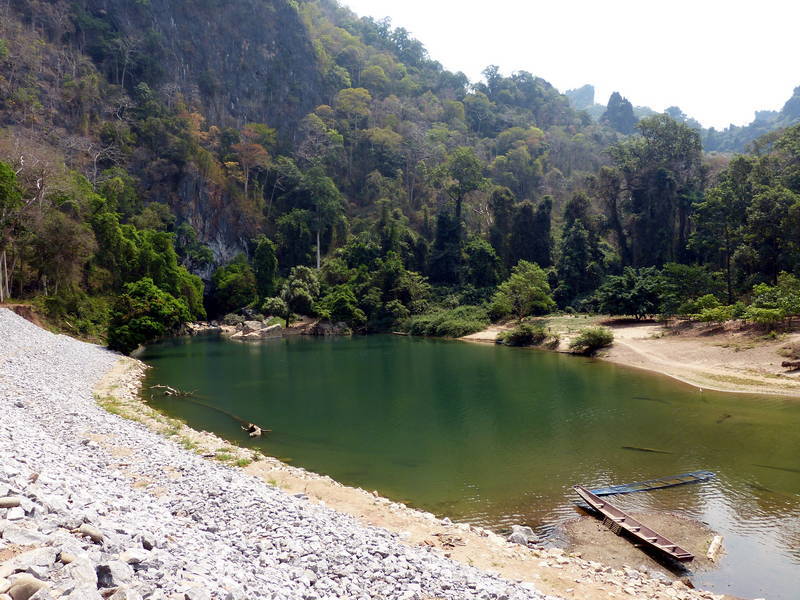
Ready to jump into a boat and go into a cave

The motorman's headlamp was very powerful

Walking around the rapids through the stalactites

While the crew pulled the boat through
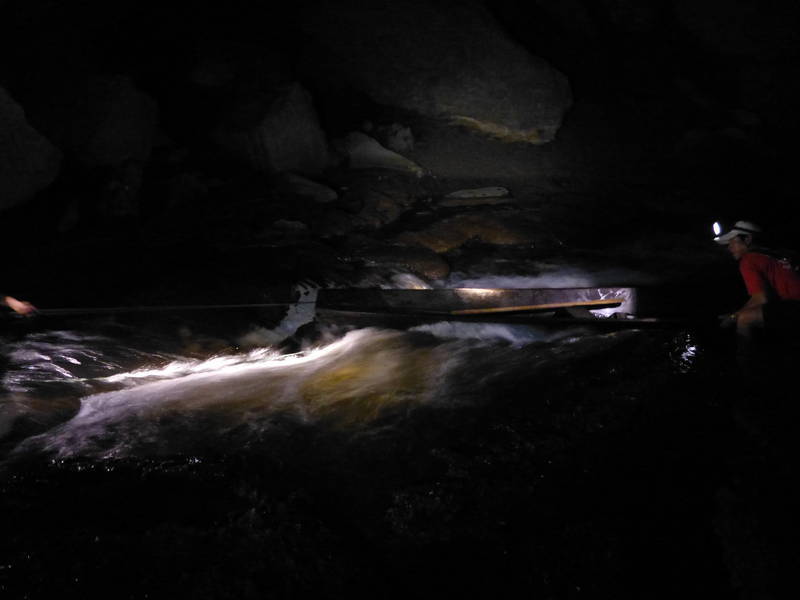
Other shallow stretches we had to walk in the stream
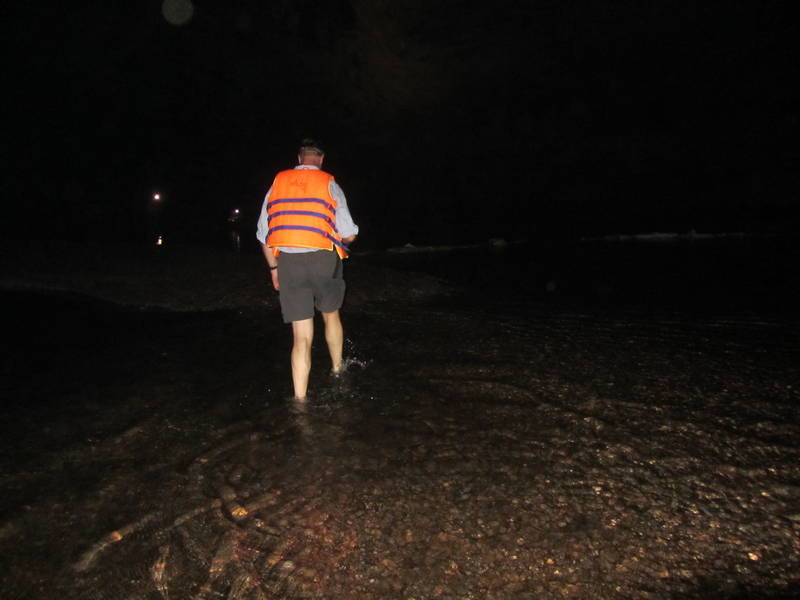
Out the other side
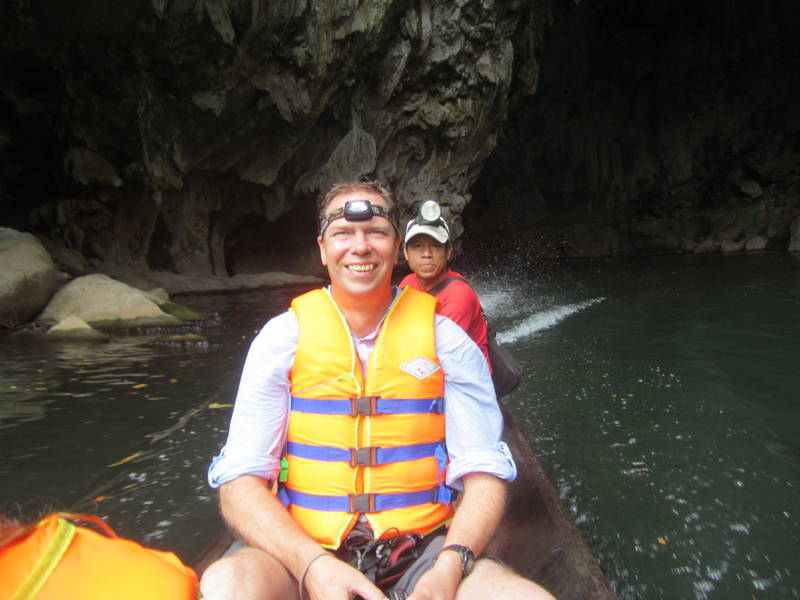
Colourful fish live just outside the cave

Leaving Kong Lor Cave

Lunch time; choices, choices

On Saturday we tried to get up early and on the road before it got too hot. Even leaving at 8:00 AM it was already 28 degrees but it was a comfortable temperature. With the easy ride we found ourselves just outside Savannahket at 10:00 AM. Audrey was still feeling OK so we decided to press on. It was a good 200 kilometres to Pakse but there were no other major centres along our route so we would have to ride in a bit of the day's heat to make it the whole way. By 11:00 it was getting on 34 degrees and we tried to stop for breaks as much as we could. We arrived at 1:00 PM just as it was getting good and warm and found that the Residence Sisouk had rooms available. It had been a hot ride and we were happy to relax in air conditioned comfort before going downstairs to the bakery restaurant for lunch. By 5:00 PM it had cooled down enough for us to go for a walk around town and we ended up at an Indian restaurant for supper. The chicken misala and lassi were delicious but would turn out to have an impact on us in ways we hadn't anticipated.
A Vietnamese travelling salesman came over to chat when he saw the Vietnamese flag on Ekke's bike

Another well-signed construction zone
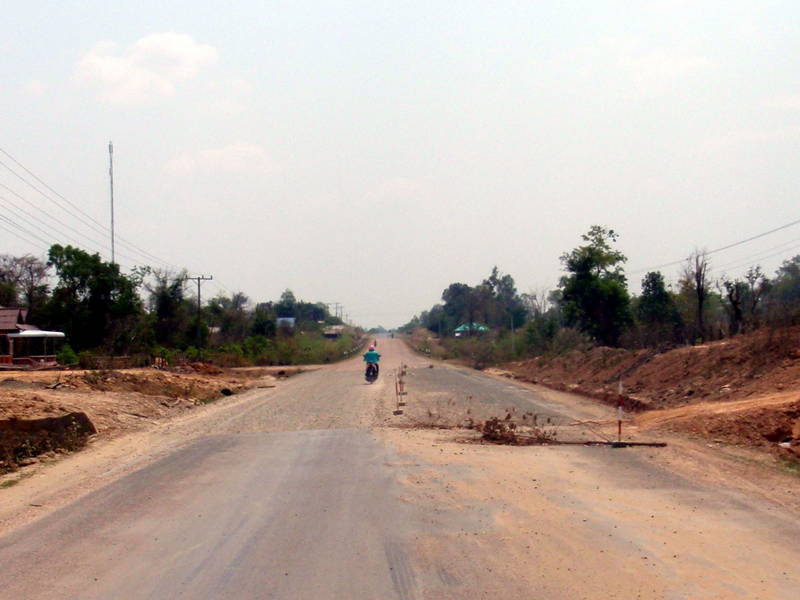
Arrived at Residence Sisouk
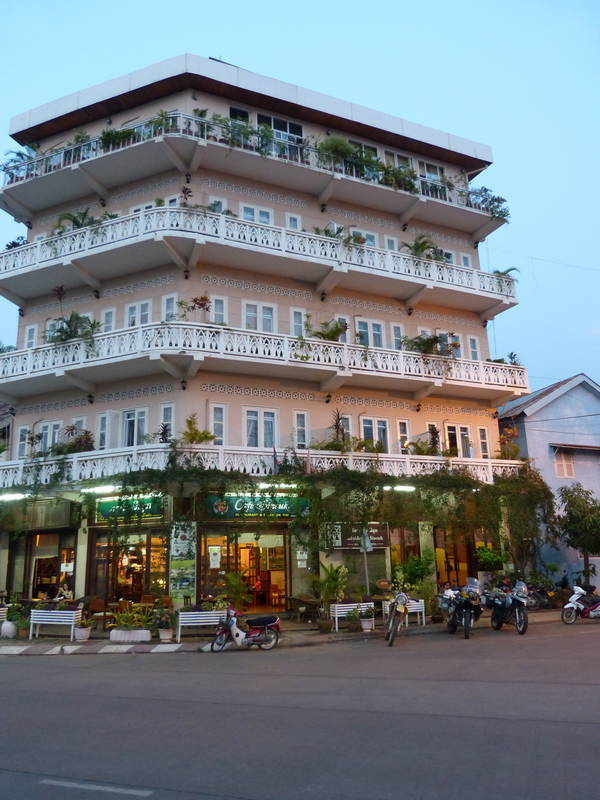
These drums were also at the National Museum but we weren't allowed to touch them, here it's a coffee table

OK, now we know we're in the right place
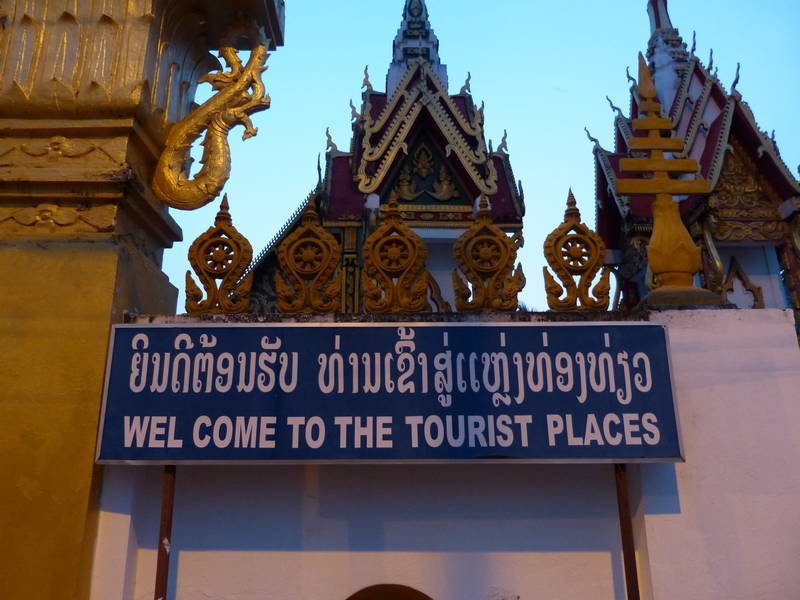
On Saint Patrick's day we both woke up feeling a bit green and not terribly hungry for the skimpy breakfast provided by the Sisouk. It was a very short ride of only 30 kilometres to Champasak, on the other side of the Mekong, where we planned to stay at another Inthira hotel. We were riding on a beautiful, freshly paved road when a group of young men on scooters broke into an impromptu drag race ahead of me, I downshifted the Adventure a couple of gears and pinned the throttle. Flying through their little group at 150 km/h, I scattered them in my wake. That put a smile on my face. At the hotel both Audrey and I were really not feeling well at all and even quite irritable. Collapsing in the room we barely moved from bed except to vomit every now and again. When we did a bit of research as to what our ailment could be we surmised that it might have been a combination of food poisoning (the Indian food?) and dehydration from the long, hot ride the day before. The next to two days were a complete blur as we barely moved from our room at the Inthira.
Short ride to Champasak on a perfectly paved new road
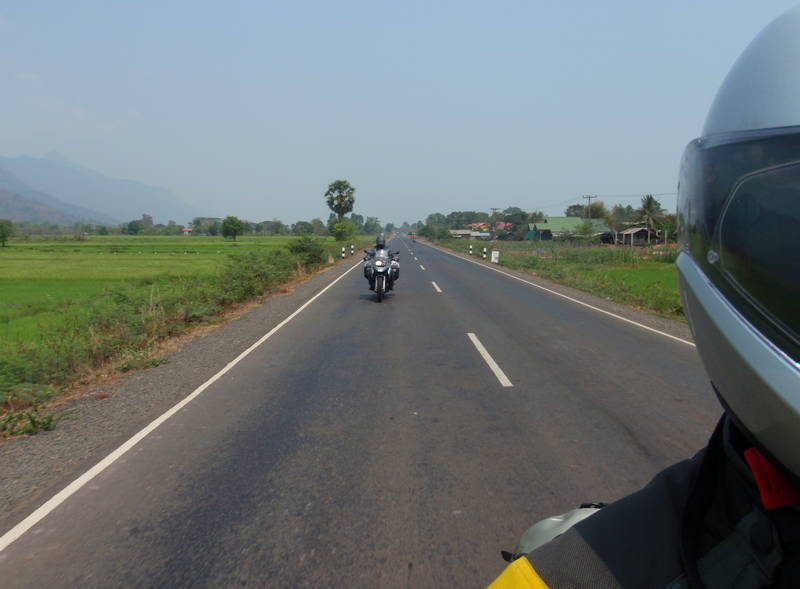
Let's spend a few days locked up in this lovely room
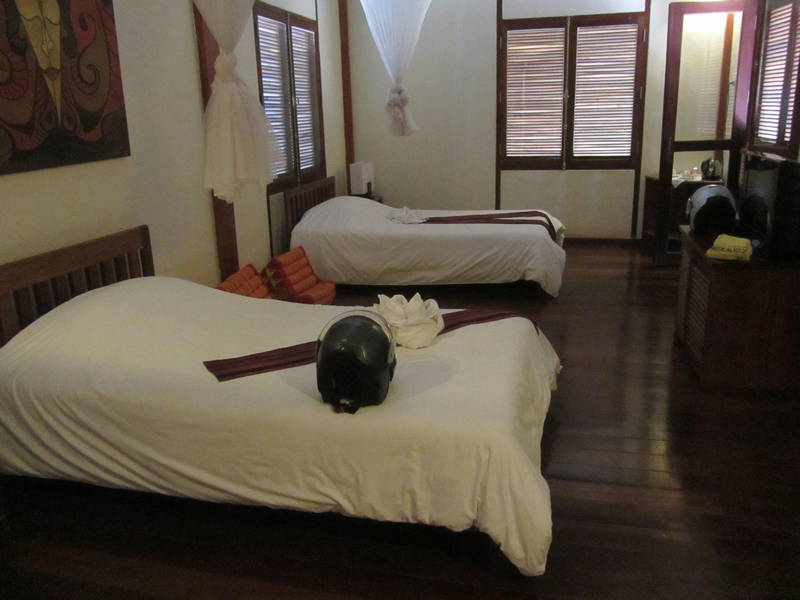
Beautiful temples all around

On Wednesday we rode two-up on the F650GS to Wat Phu (the main reason we had come to Champasak in the first place). As we walked up a short distance Audrey started to feel a bit woozy (it was already approaching 30 degrees at 8:00 AM) and she decided to stop there. I continued the climb up to the temple and marvelled at how different this was from the temples we had been seeing for the last couple of months in Thailand, Laos and Vietnam. Apparently Wat Phu is thought to have been a precursor to Angkor Wat. The sun broke through the haze just as I reached the upper temple and put a lovely golden colour on a Buddha statue. After I came back down we went back to the hotel for breakfast and then rode into Pakse to go to a medical clinic so that Audrey could get her INR tested. This number allowed her to adjust her medication to prevent further blood clotting. The reading was good so she could maintain the same dosage but the doctor didn't have any comment on her other, current health issues (vomiting, lethargy, wooziness). After the ride back to Champasak in 38 degree heat it was a pleasure to stand under a cool outdoor shower in our hotel room.
The climb up to Wat Phu is framed by two buildings currently undergoing restoration

Audrey not feeling well, heads back down
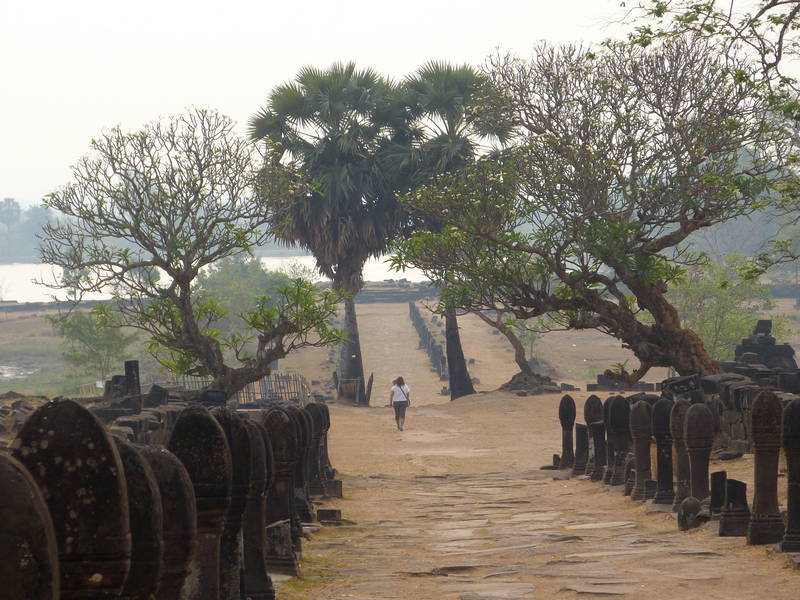
Climbing the uneven steps up to Wat Phu
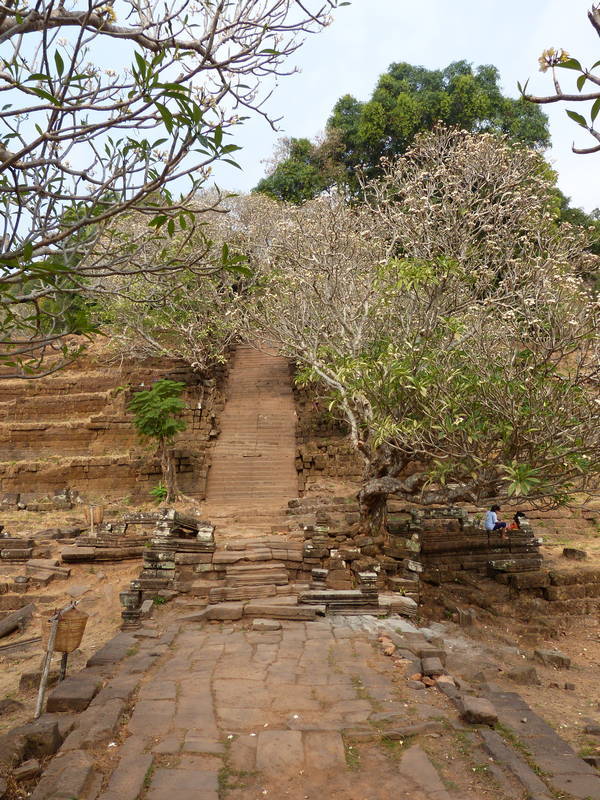
The sun breaks through the early morning haze to light up a Buddha statue

The Hindu influence on this temple is clear
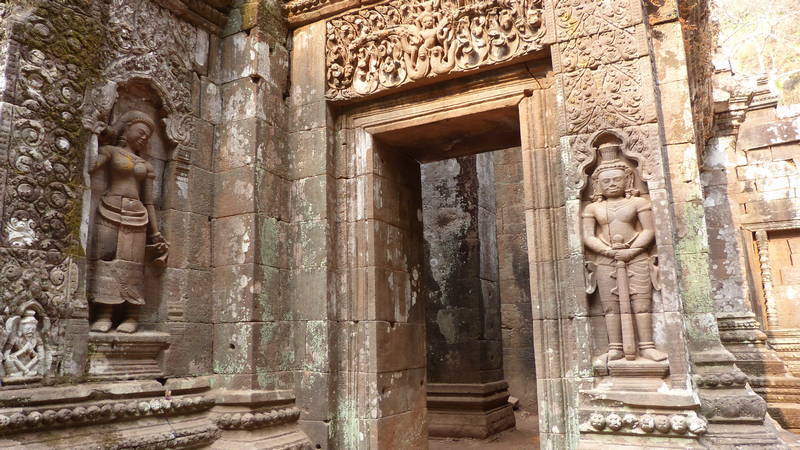
Elephant rock
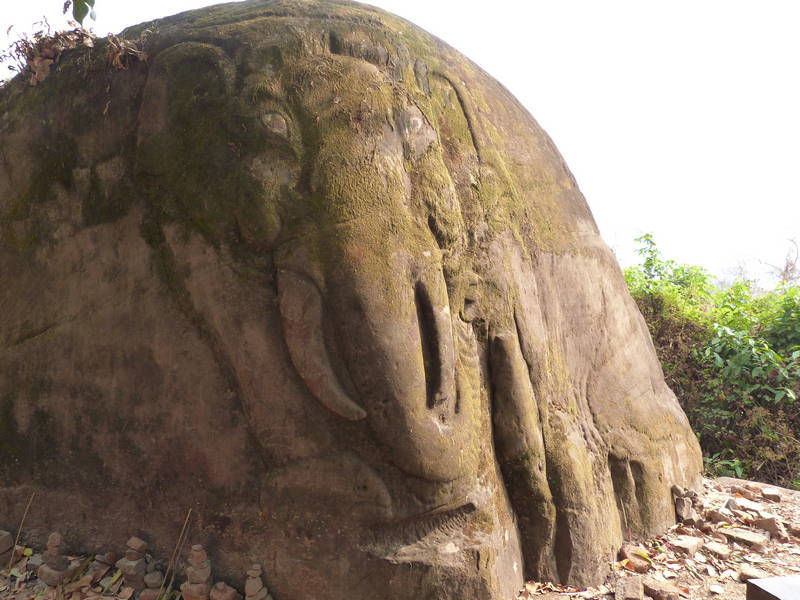
Looking back down from Wat Phu

Time for a cool, refreshing outdoor shower

We were both feeling pretty good on March 21 and happy to be on the road again at 8:00 AM. Our first adventure was only two kilometres away at the crossing of the Mekong. We could have backtracked to Pakse and used a bridge to cross the Mekong but what fun would that be? Instead we rode our bikes down a sandy shore onto tiny wooden rafts lashed together and balanced on top of a couple of pontoons. One of the pontoons had an outboard motor attached for propulsion. Getting on the rafts was quite interesting as the rafts were docked next to each other. It was necessary to ride across one raft in order to get on the one furthest out. As the F650 was much lighter than the 1200 we loaded that first and it was quite easy. But when I pushed the 1200 up the ramp and onto the raft the boat operators both gasped as the boat sank more than they were used to. It still seemed to be floating so it was deemed safe enough to cross the Mekong. Off we went, carefully watching the water levels in relation to the pontoons. At the far side there were already two rafts tied up and Audrey's raft pulled up to the outer one to tie up. My raft was then the fourth boat out from shore. I rode the F650 across the first raft and down the gangplank to the shore without too much trouble. But when I went to bring the Adventure ashore it was a bit more challenging. My raft was about 30 centimetres lower than the next raft so I had to use the engine to climb up onto it and then it sank 30 centimetres so the process could be repeated for the next raft in. At the final raft a scooter coming the other way decided that this was the perfect time for him to board. This made it a bit more challenging getting the heavy bike balanced on the bobbing boat so I could get on it to ride down the ramp. Audrey filmed the whole event at both ends but just as I was getting on the Adventure to ride down the ramp (i.e. the most exciting part) the camera battery died. And I wasn't going back for a re-take. Fortunately no bikes or operators ended up in the Mekong and I got the bike safely ashore. From there it was an easy 100 kilometre ride south to another ferry for the ride across to Khong Don, an island in the middle of the Mekong River. The operator of the raft, Mr. Phousy, asked the weight of the bikes and didn't seem too enthusiastic when I said the Adventure was on the order of 300 kilograms. He suggested we go 10 kilometres downstream to an official vehicle ferry. While that wasn't nearly as much fun the cost was exactly the same as the raft crossing earlier in the day at 50,000 kip ($7) per bike. We arrived at the Pon Arena hotel on the island and were immediately impressed by the beauty of our room and the lovely small pool. What a relief from the heat to soak in the cool waters of the pool overlooking the Mekong. In fact from the pool we could see Mr. Phousy and his raft on the other side of the river. Later in the afternoon we took a ride around the island and then picked up yoghurt and iced tea for a light supper. As per Dave Coulson, whom we had met in Switzerland many years ago (See the Switzerland chapter from 2002 here), the best thing to keep your stomach attuned to local foods is to have local yoghurt. This had worked for us throughout our travels but I was a bit skeptical when I had a closer look at the yoghurt I had picked up. On the label were pictures of corn and beans. Hmm, I wonder what Dave would have thought of this? It tasted… interesting and I'm sure that it helped my stomach to recuperate from the recent bout of food poisoning.
On the way to the ferry we passed an old colonial mansion, slowly decaying in the heat
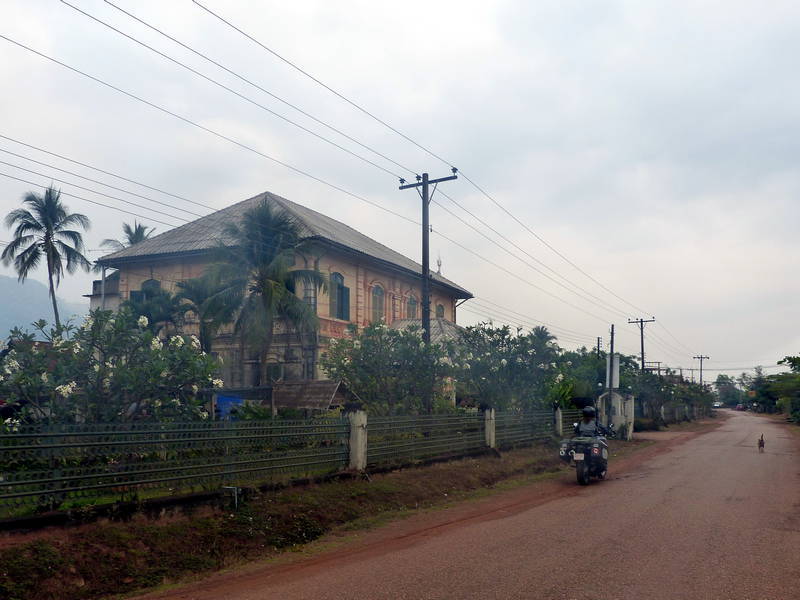
The F650GS is aboard
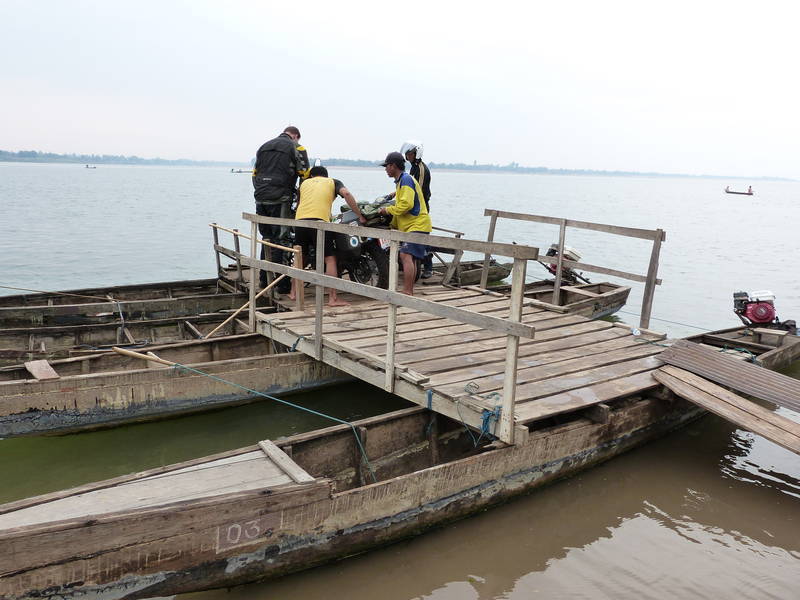
The stern of the boat looks perilously close to the water

Riding across the Mekong River
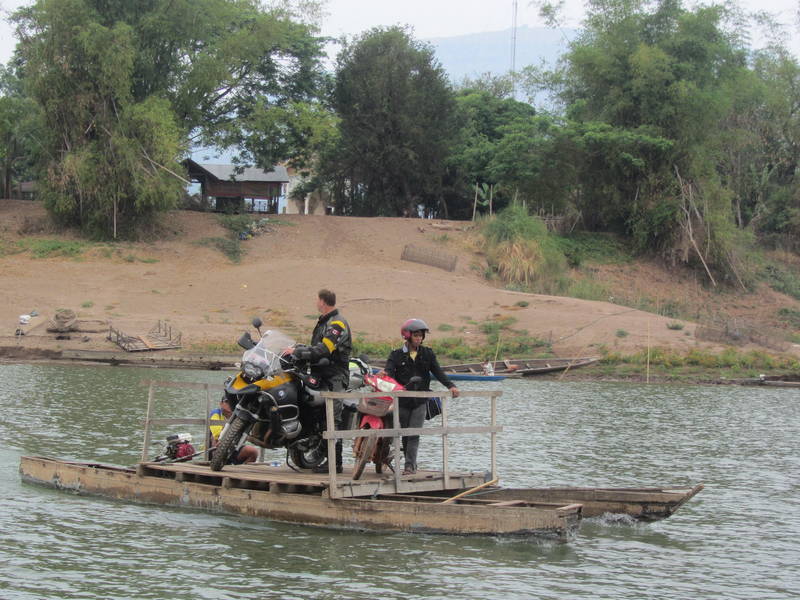
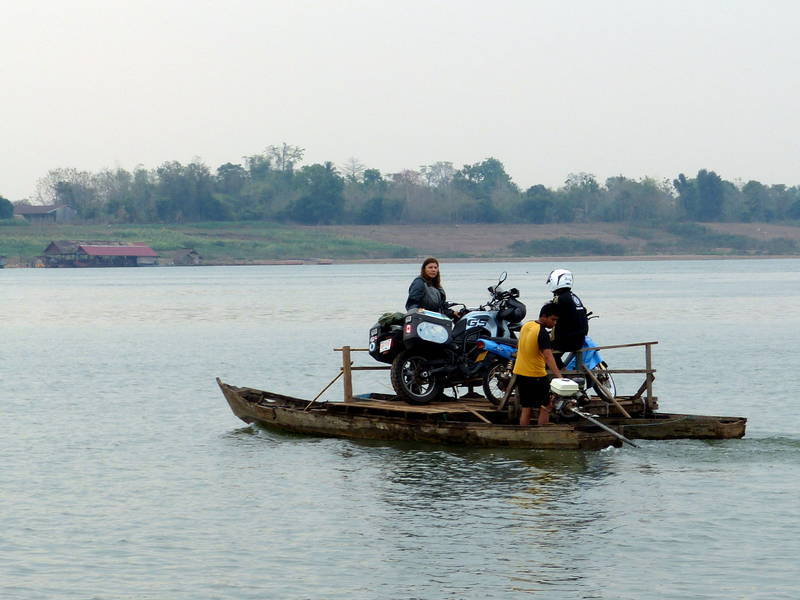
OK, now to get the Adventure to shore.
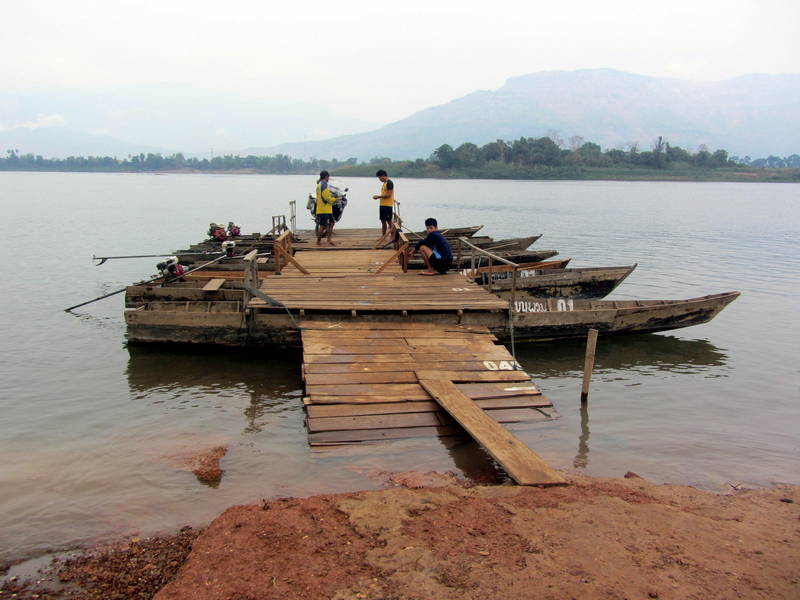
Pon Arena hotel from across the Mekong River at Mr. Phousy's raft

Mr. Phousy thought the Adventure too heavy so we took the boring, safe vehicle ferry across instead
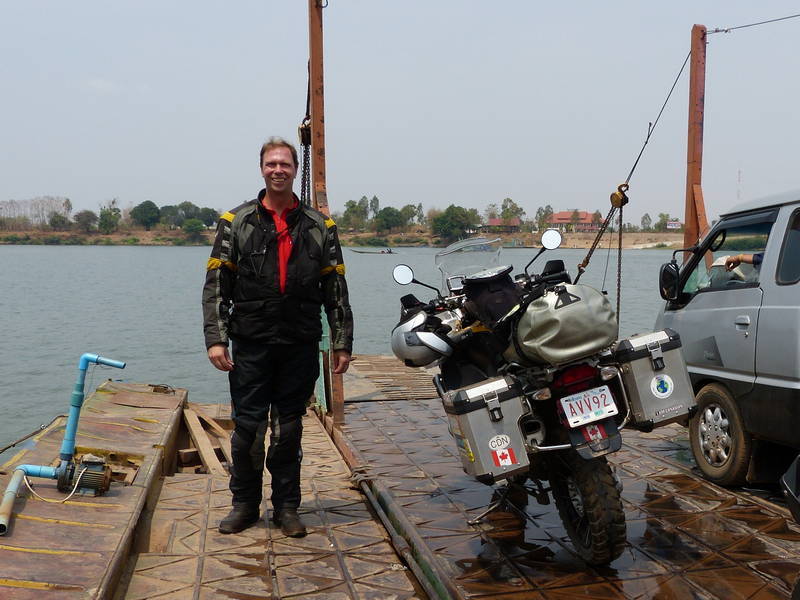
Refreshing pool at the Pon Arena hotel, watching the kids play in the river below
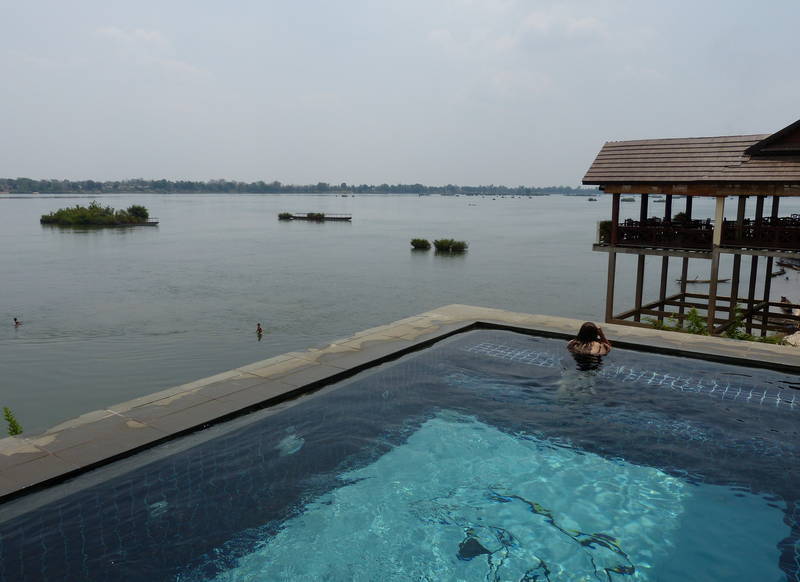
Huge Buddha statue across the river
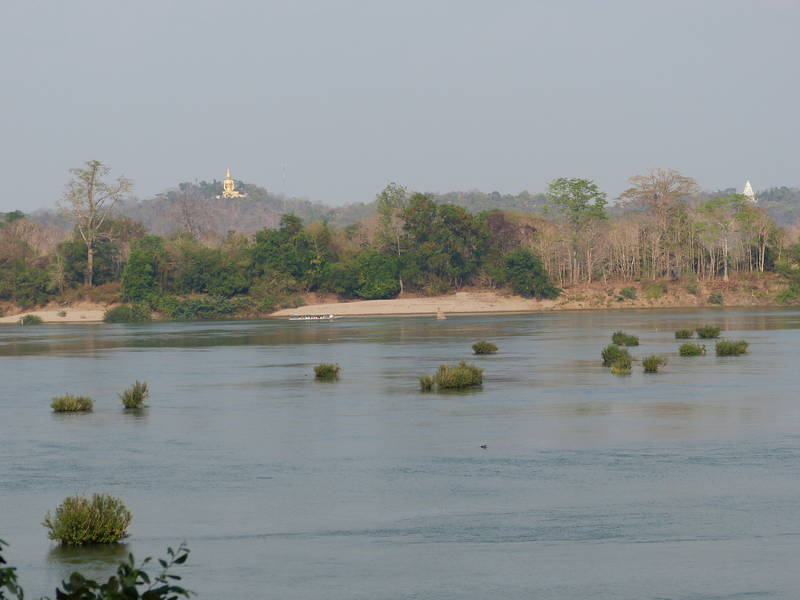
A bridge will soon take all the fun out of crossing the Mekong River to get to Khong Don
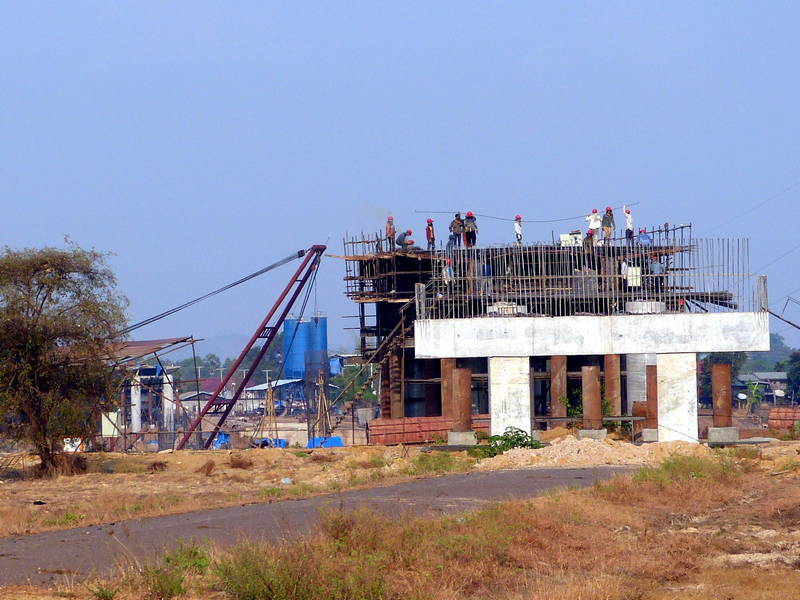
Interesting corn and bean yoghurt
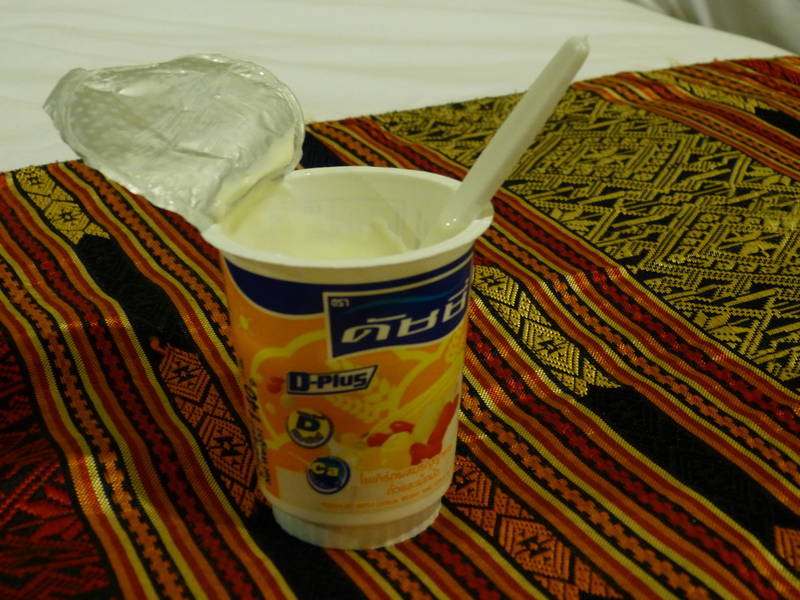
We took the vehicle ferry back across the Mekong and rode south on Friday, March 22, to the Khong Phapheng Falls. The 30,000 kip entry fee allowed us to enjoy the park for the entire day but we only stayed for half an hour, enjoying the largest falls in all of S.E. Asia. From there it was only a few kilometres to the border of Cambodia. A kilometre before the crossing, a customs station allowed us to get our carnet de passages stamped out of Laos and then at the border station itself we found a wooden shack where our passports were also stamped out. The ride across no-man's land was quite short and soon we were pulled up at a barrier across the road, getting ready to enter Cambodia. After riding across Cambodia solo I was eager to share my enthusiasm for this warm (both temperature and people) country with Audrey. Would the towels be as soft as I remembered?
The Khong Phapheng Falls are the largest (by volume) falls in all of S.E. Asia.

Yes, we had a great time in Laos

Map of our route through the second half of Laos
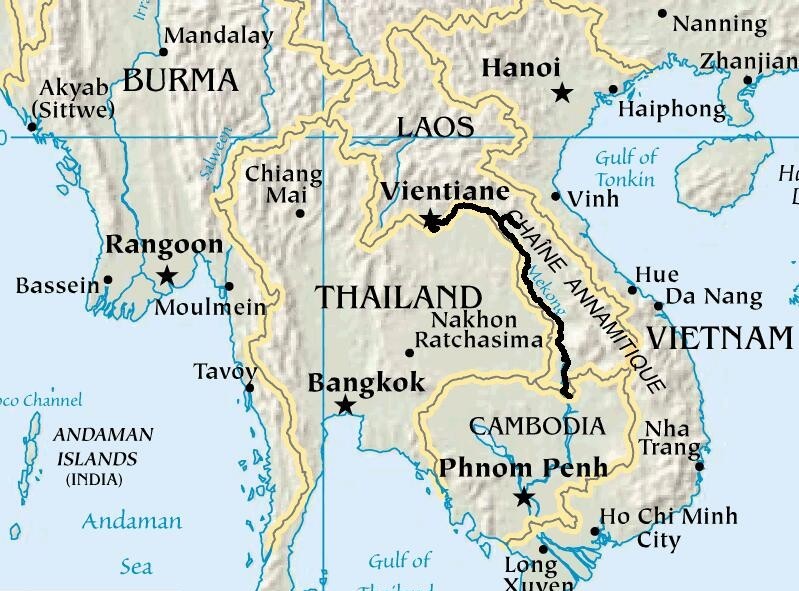
So, what new, interesting and exciting things awaited us in Cambodia? What would the roads be like, the people, the culture, the food? Let another motorcycle world travel adventure begin...
On March 22nd, 2013, the border crossing was upon us and after we had our temperature taken in our ears to ensure that we had no strange Laotian fevers, we went to find customs and immigration. The bored officials must get a big kick out of us clueless tourists, wandering around, trying to guess which building we go to next, no signs in English anywhere, just a vague wave shooing us away from them to somewhere else. We eventually found the offices we needed, and, eventually, in the right order. Then they asked for $25 U.S. each for a one-month visa and Lonely Planet had said to make sure that we only pay $20 and no more. Ekke said that he had only paid $20 when he entered Cambodia from Vietnam only a week or two ago. Oh well. Sometimes you just don't feel like arguing about it. We rode out of the border compound, wondering if all the paperwork was completed, but no-one chased after us as we rode away.
The imaginary line that is a border is a strange thing. There was such a different feeling about Cambodia immediately upon crossing that line, but it was hard to put my finger on what it was. Perhaps it was the houses, which all looked a bit rundown, or maybe it was the charred forests, recently slashed and burned to make way for more farmland. Most people were dressed in modern 'Western' clothing but we did see a few ladies dressed in traditional pyjamas. The city of Stung Treng was definitely a little 'rough around the edges', with crumbling sidewalks and buildings and garbage everywhere. The Gold River Inn was very simple, but clean, thank goodness, with the amazingly soft, fluffy towels of Ekke's dreams. We found Ponika's restaurant for lunch and just after we ordered, some movement caught my eye. I saw two little beady eyes peeking out from behind a flower pot - a rat! I ate my lunch with my feet up the whole time.
Slash and burn farmland greets us in Cambodia

A lot of women in Cambodia seemed to be wearing pyjamas
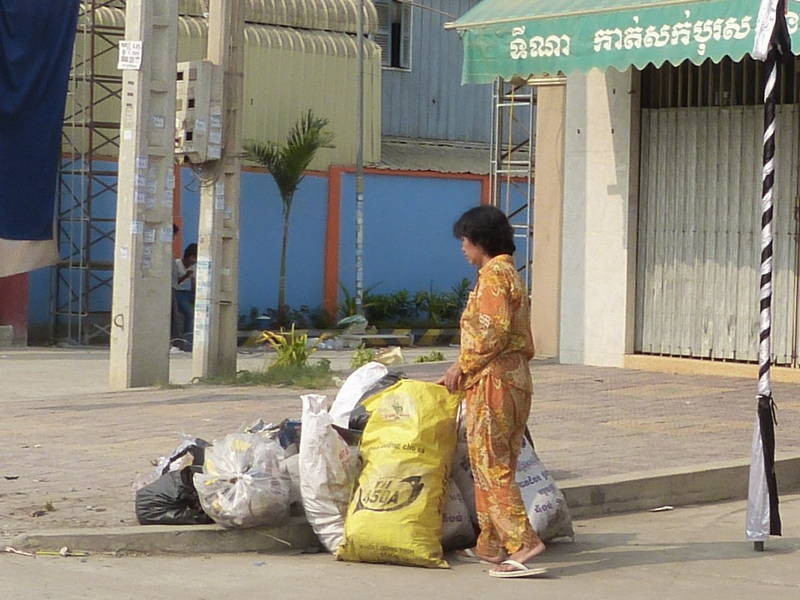
With no breakfast available at the hotel, we found the most promising choice for food in a rundown little cafe that served baguettes and eggs leaving us suitably fortified to tackle whatever Cambodia threw at us that day. And not a rat in sight. The ride south was quite pleasant on a good road, past stilt houses and small farms. Something drying on the warm pavement on the side of the road caught our eye. It looked like some sort of root vegetable, white in colour and cut into small chunks, but we never did find out what it was. A few potholes appeared and slowed us down, and then the potholes got bigger and soon there was nothing but gravel with a bit of intermittent pavement. The dust layers on our bikes and motorcycle jackets reminded me of our rides through the desert and we coughed and choked our way through it for a few hours. Most of the morning was spent standing up on the footpegs to stabilize the bikes in the unpredictable terrain, leaving me quite exhausted. The town of Kratie was a welcome sight, and we got some juice and 'nut' mix (I think they were dried chick peas) at a local mini-mart to recharge our batteries. The landscape changed further down the Mekong, becoming wonderfully lush and green, with tall stilt houses tucked in behind banana plants and palm trees, the good road winding gently past. But with good roads come higher speeds and much of the afternoon was spent swerving for oncoming vehicles to avoid head-on collisions. The road narrowed for construction, leaving only our lane open, but oncoming traffic just kept coming as if it was their lane. A huge bus, going way too fast, forced Ekke off the road onto the gravel, missing him and his bike by centimetres. Scary. Drivers here were definitely a lot more aggressive than in gentle Laos. What a relief to make it to Kompong Cham and the Monorom 2 VIP hotel. This hotel room definitely gets our 'Ugliest Hotel-Room Furniture' award, and you'll understand why when you see the photo. After something to eat, we tried to go for a walk to get some exercise, but the oppressive 38 C heat sent us scrambling back to the relief of the lovely air conditioning of the ugly hotel room.
Drying vegetables (?) along the roadside


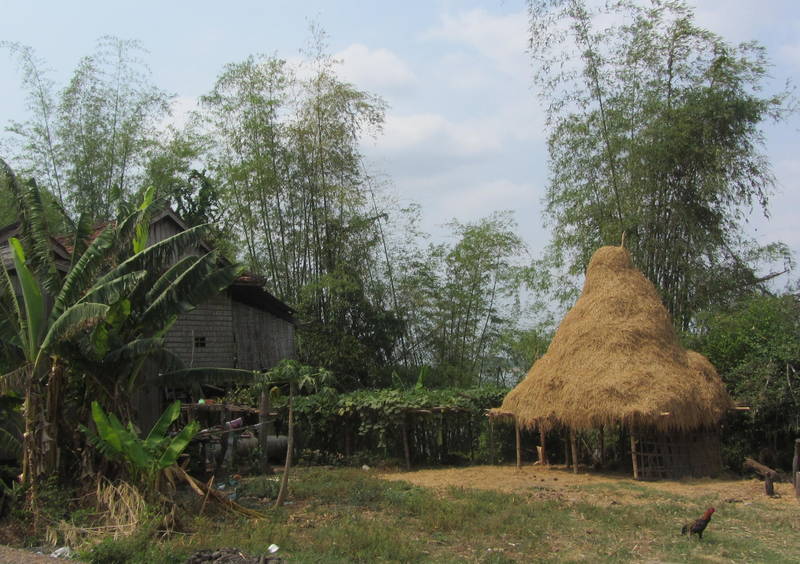
Prime river front real estate
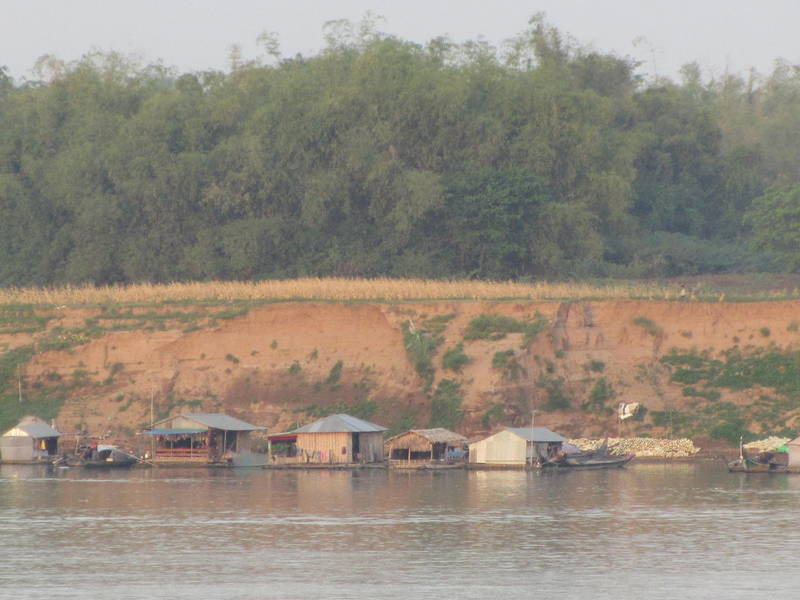
Walking around Kompong Cham we came upon a dangerous elephant
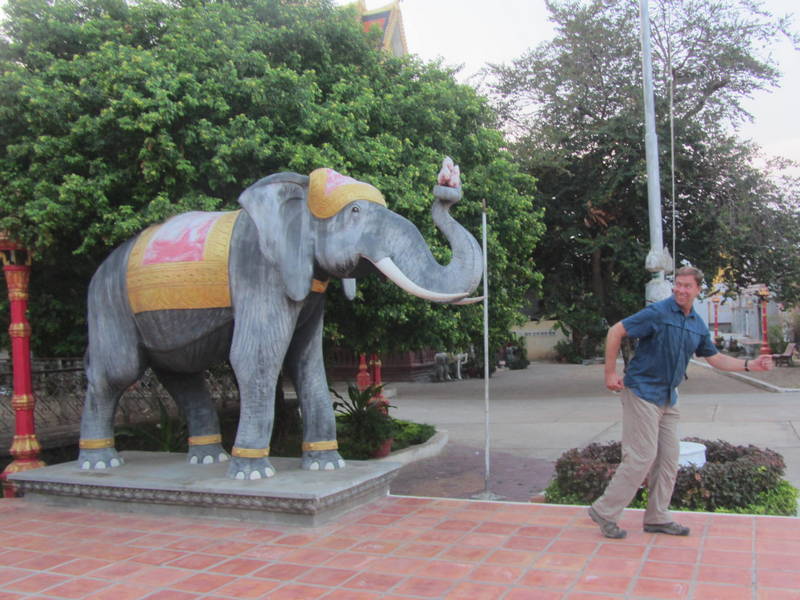
Travelling salesmen in their trucks camp for the night in Kompong Cham

And we spend the night in a hotel room with the most overwrought furniture

After attempting to make it to Phnom Penh the next day, March 24th, on smaller, more interesting roads, we had to give up because the construction zones made our route impassable. There was no rhyme or reason as to why the left lane was open or why it was our lane open and never very clear which lane to ride on to make it through. At one point there was a huge pile of dirt in the middle and we chose to ride on the right side of the road to get around it. The road became really rough and Ekke was able to ride over the top of the dirt pile to the other side of the road but I stopped to take a picture and missed my chance. As I rode further ahead I came nose-to-nose with a big dirt-grinding machine and it was a bit iffy as to whether it would stop or not. The driver didn't run me over, thank goodness, and after I shook my head indicating that I had nowhere for me and my bike to go but forward, he actually backed up! I was able to find a track over the mound of dirt and congratulated myself on playing chicken, and surviving, for the second time, with a vehicle way bigger than mine (The first time was 'Audrey vs. Bus' in Laos). We pulled over to the side of the road in a shady spot for a well-deserved water break. A young girl riding a scooter stopped beside us to say hello and to practise her English. She was in grade 12 and lived in a village a few minutes up the road and we chatted for quite some time, with her doing most of the chatting. She really wanted us to visit her home, and pleaded with us to come, but we couldn't afford the time and gave her a Canada pin and then went on our way. A missed opportunity, yes, but we didn't want to face riding in Cambodia after dark.
Checking out of the Monorom 2 VIP hotel

What could go wrong?
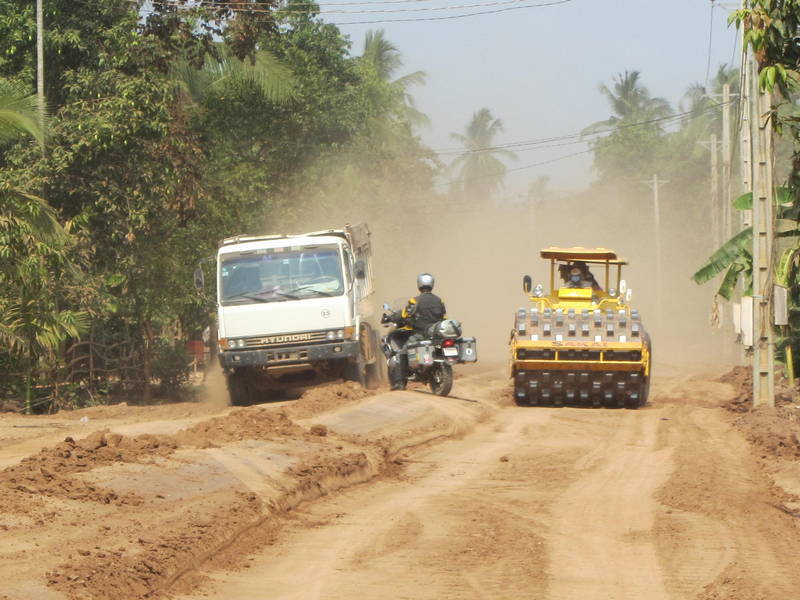
The main highway was no better than the smaller roads, all construction for most of the way to the city. Why a 100 kilometre stretch of road would all be torn up at the same time confounded me. Couldn't they just rip up and fix one part at a time? It was just a huge dust bowl, and I felt badly for the people in houses and businesses that lined the road. The ankle-deep layer of dust hid huge potholes, and when I hit them at higher speeds I was concerned that I would have another wheel rim-bending incident like in Mongolia. But, we made it through unscathed except for maybe a new coating of dust in our lungs. Ekke spied a dust-covered cooler and umbrella in front of a small shack on the side of the road and we stopped to buy a drink. Plastic chairs were produced for us, and the family seemed quite surprised that tourists would stop at their little place of business. The kids were very shy when we tried to speak with them, but they eventually squeaked out a few 'hellos'. With a bit of miming, the father was able to ask where we were from, and with more miming and the sharing of the map on my saddlebag we were able to explain our journey.
Stopping for a drink in another construction zone

Using the map on the saddlebag to explain our trip
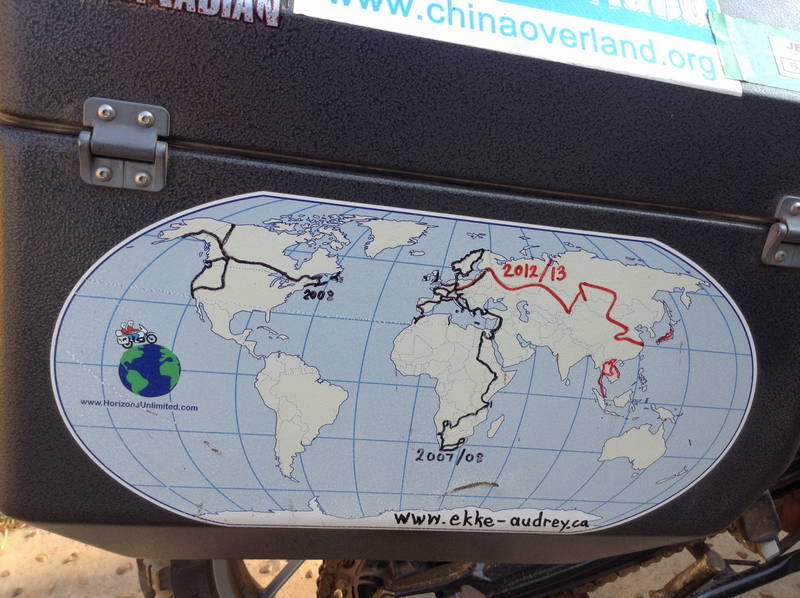
It was with great anticipation that we arrived in Phnom Penh, the nation's capital, but riding through a run-down industrial area made it a bit anti-climactic. Ekke found his way through the busy city using the GPS and we only had to do one u-turn, but it was an exciting one. Just as Ekke put on his left turn signal and began his u-turn, a scooter suddenly tried to pass him on the left, nearly running into the side of his bike, with both bikes coming to a screeching halt. Close call. The appearance of the city improved as we rode in closer to the centre and our chosen hotel, the Blue Lime. A sign on the door announced that sex tourism was not allowed. Okay. As we dragged our dust-covered bodies through the lovely lobby, we looked out into a sunbed-lined courtyard and saw a shimmering blue swimming pool shaded by palm trees. It was like an oasis in the desert. But then we got some bad news. The hotel was fully booked. What? This never happened to us and we were floored. The staff recommended another hotel, and after partaking in their delicious passion-fruit welcome-drink, we sadly shuffled out the door, looking longingly back at the cool swimming pool. It was a few blocks to the Tea Garden Hotel, which was no Blue Lime, but it would do. The pool was a welcome sight, but was quite tiny and warmish from the sun beating down on it. Oh, the hardships we must endure.
Welcome/good bye drink while programming the GPS for the Tea Garden Hotel

Moving hotels the next day, back to the Blue Lime, was a possibility, but we decided that it would just break up our day too much. Upon further inspection we found that the Tea Garden Hotel had some nice features, like a buffet breakfast with made-to-order omelettes, and some inviting sofas beside a water-lily pond. A $2 tuktuk ride to the palace took about five minutes, and we arrived just as the temperature was reaching the high 30's. The palace was breathtaking, all gold and marble, and inside crystal chandeliers hung from a ceiling painted with murals. A walk through a garden with colourful flowering trees offered some shady relief from the sun beating down, and the path took us to the Silver Pagoda. Lonely Planet had said something about silver tiles, and I assumed they would be on the roof, or the side of the structure, but we saw nothing resembling silver. After removing our shoes, we joined the hoards of tourists for a wander around the inside of the pagoda. A life-sized golden Buddha covered in diamonds was the big draw, and it really sparkled. As we walked out, we saw some tourists studying what appeared to be the old linoleum floor. Or maybe they were just trying to get some airflow from a nearby fan. Disappointed that we had not seen any silver in the Silver Pagoda, we sat in the shade and studied Lonely Planet. We learned that the silver tiles, weighing 1 kilogram each, covered the entire interior of the pagoda, on the floor. We had another peek inside and indeed, there were silver tiles there, but they needed a good polish so they didn't look so much like old linoleum.
Relaxing in the tea garden

Gardens of the palace


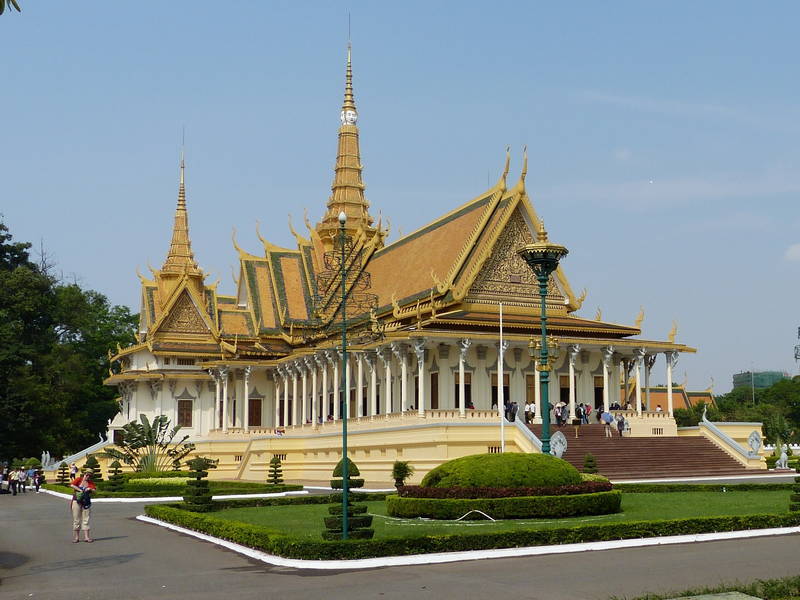


Monkeys provide entertainment at the palace walls

Revitalized by a cold drink at Dairy Queen (really, Dairy Queen in Cambodia) we decided to tackle the National Museum, hoping that it would be air conditioned. No such luck, but the terracotta structure was open and airy, and we didn't suffer from the heat too much. The building itself looked like a temple, with peaked roofs topped with pointed spires and a flower garden in a central courtyard. We spent a long time wandering among the statues, dating from prehistoric times to the Khmer Empire period, both Hindu and Buddhist. Many came from Angkor Wat. It was lovely. For lunch we chose the Foreign Corespondent's Club, a former haven for journalists from the chaos of Pol Pot's regime. Now it is a swanky bar overlooking the beautifully redeveloped Tonle Sap Riverfront. Phnom Penh was really starting to grow on us. We enjoyed a walk back to our hotel, and finishing our sight-seeing day in the mid-afternoon was a good idea as temperatures climbed even higher. A wonderful chicken and broccoli dinner at the hotel that night was finished off with some sticky rice crème brûlée, blue in colour from some leaf used to flavour it.
Outside the national (not air conditioned) museum
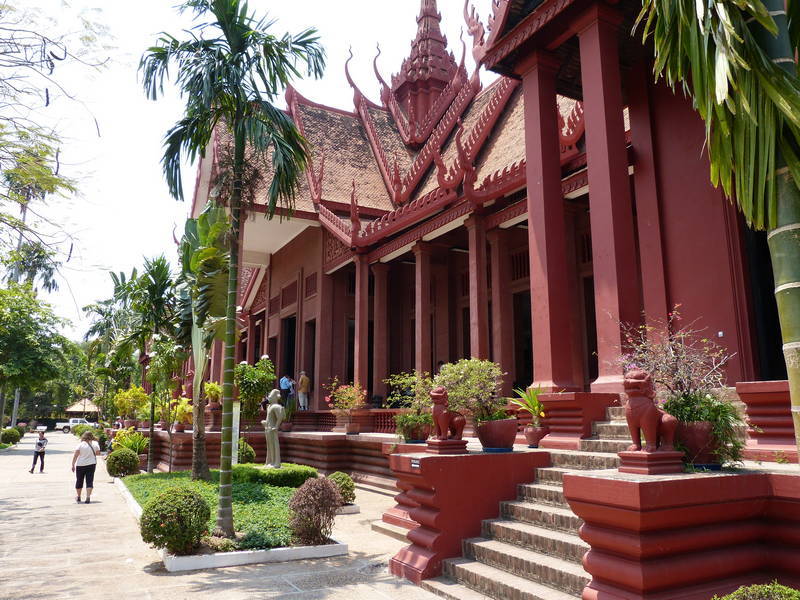
Delicious Cambodian food (Fish and chips is Cambodian right?)
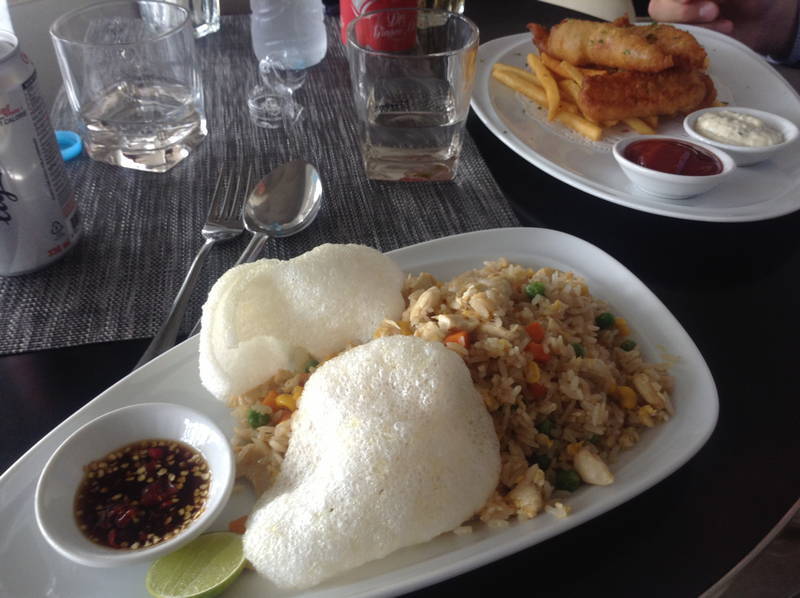
Another hot, sunny day greeted us and it made it hard to face the idea of putting on any protective motorcycle clothing for a trip out to Choeung Ek, so we decided to take a tuktuk. We had met a very friendly driver the day before, Paul, and he offered to take us the 28 kilometres there and back again for $15. Our tuktuk wove in and out of the traffic chaos of Phnom Penh, and with several near misses and potential accidents later we were at the historic site. The Choeung Ek Genocide Center is more commonly known as 'The Killing Fields'. Prisoners from the Tuol Sleng prison in the city were taken here for execution, and the fields have remained as a memorial to those who perished. Free audio-guides with information about the genocide were given to us at the entrance, and we must have spent at least 2 hours wandering around mass grave pits, listening to the stories in survivor's own voices on the audio-guide. A memorial stupa contained 8000 human skulls, evidence of what happened here. Paul waited for us, then took us to the Tuol Sleng prison in Phnom Penh. In the time of the Khmer Rouge regime, Pol Pot rallied the peasants to turn against city dwellers, sending them to forced labour camps or to prisons. Professionals like doctors, lawyers and teachers, anyone wearing glasses or who spoke a different language, artists, or anyone with 'clean' hands were rounded up and made to confess to crimes they did not commit. The prison, now a museum, had a photograph of every single person that was detained there, 17 000 of them, with many signed confessions on display. It was a pretty intense morning, difficult to get our head around how all of this could have happened. How could the Cambodians that survived have ever recovered?
Letting someone else do the driving
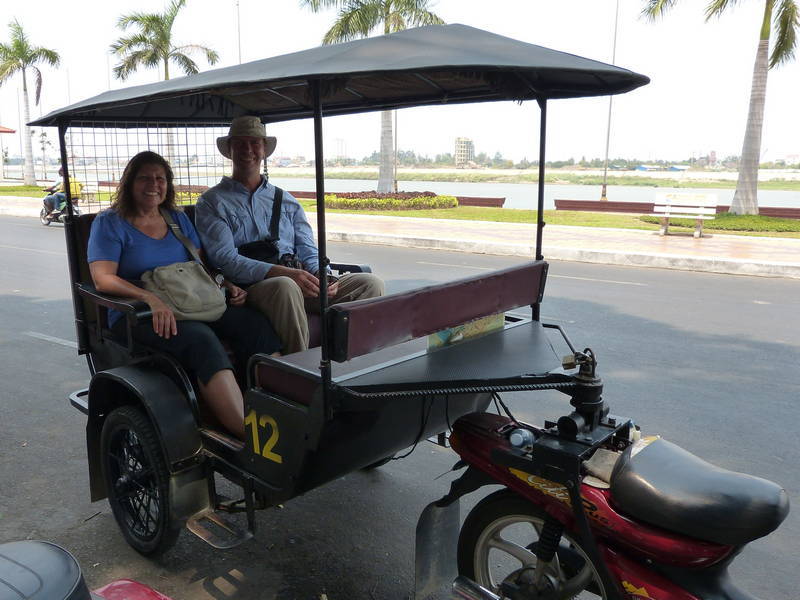
Paul navigates his way through the Phnom Penh traffic
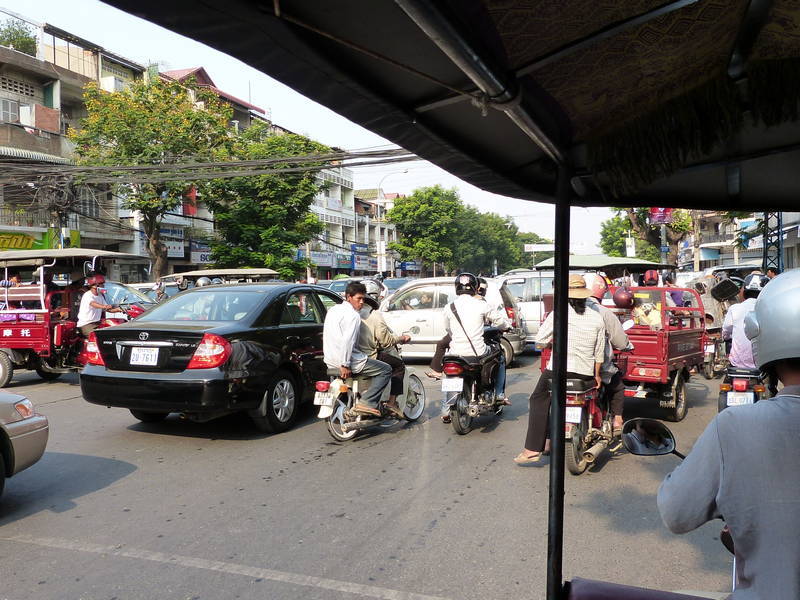
The Memorial Stupa at the Killing Fields has 8,000 human skulls

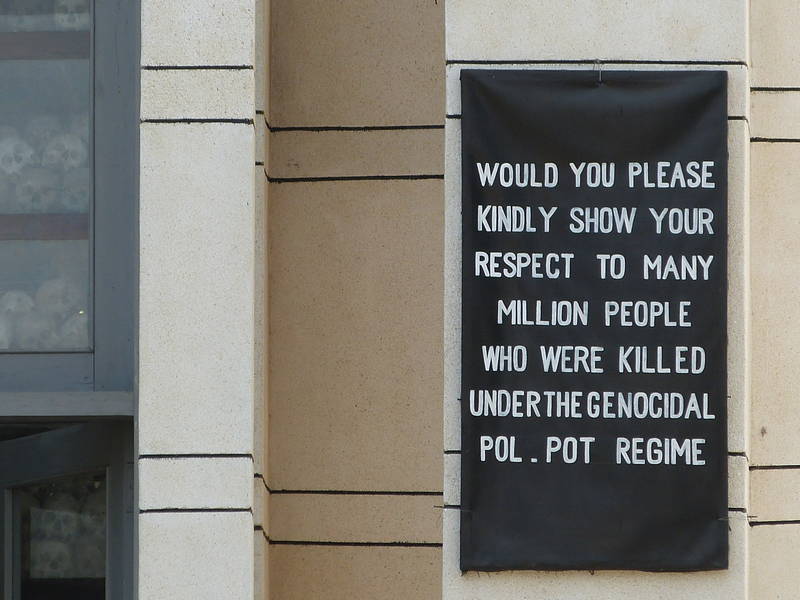
Tuol Sleng prison in Phnom Penh
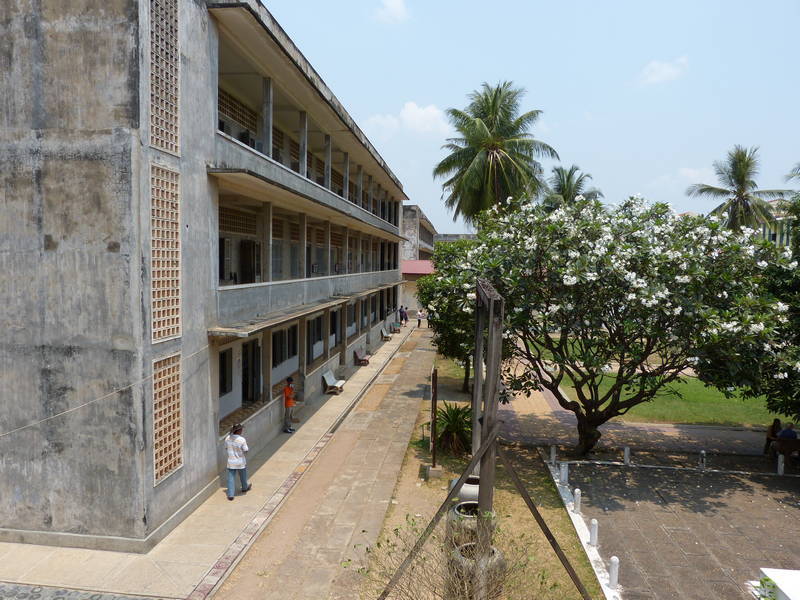
The walls were covered in photos of those imprisoned here
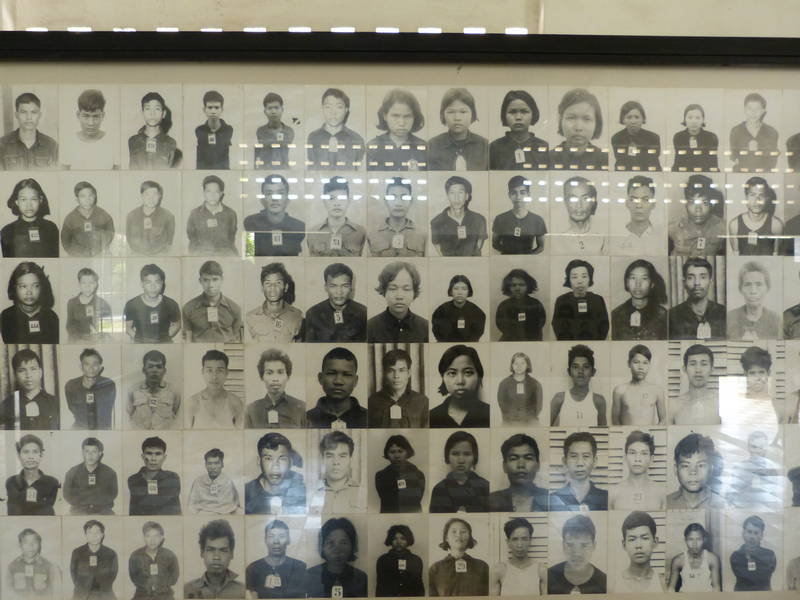

Walking around Phnom Penh at the riverfront

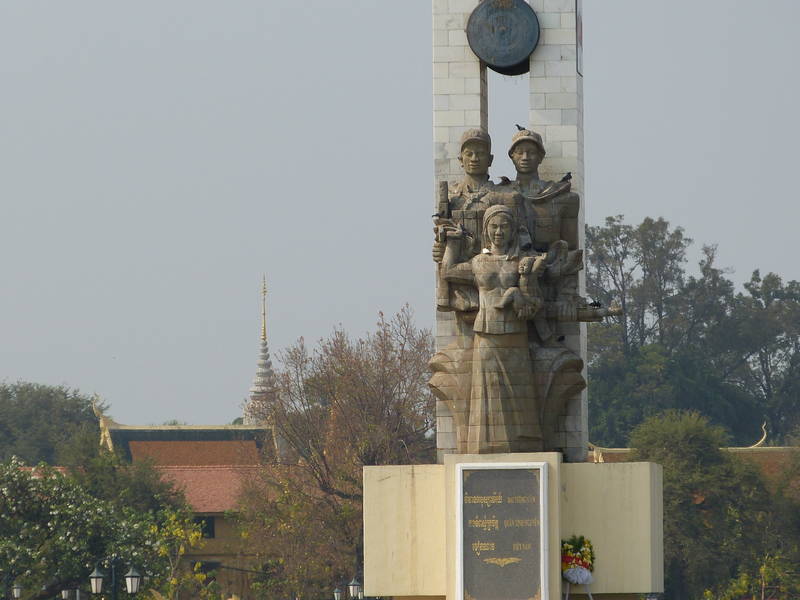
Police bike stands at the ready
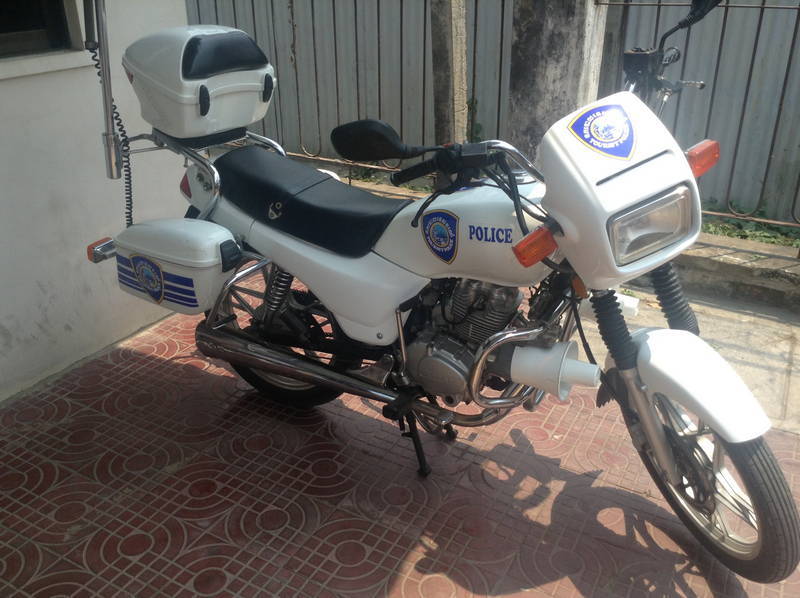
We were ready to go by 7:00 am the next day, March 27th, so we would avoid the intense heat of the afternoon. Our ride out was fairly uneventful, now that we were used to scooters and bicyclists riding the wrong way toward us and cars ignoring the traffic signals and coming way too close. We had to back track over some of the dusty construction work, and it didn't seem so bad first thing in the morning. The ride to Sambor was quite pleasant, and when we stopped for a cold drink at a small cafe, several huge tour buses zoomed by, all going to Angkor. And so it begins (ie. mass tourism). A little boy stopped by our cafe table to say hello, curious about us western tourists. An early arrival at our hotel in Sambor was a blessing and, after dropping our luggage off in our bungalow, we made good use of the huge pool by doing laps for half an hour under the shade of coconut palms, mango trees and banana plants. A small mango had fallen into the pool and it became an impromptu ball that we tossed back and forth in the wonderfully cool pool. Our plans of working on the website soon went awry, as Ekke 'discovered' a download of the Vietnam Top Gear episode on his laptop. We sat at the cafe by the pool watching Jeremy Clarkson ride a scooter in the same places Ekke had ridden, enjoying the comic antics that never disappoint in a Top Gear episode.
Leaving Phnom Penh
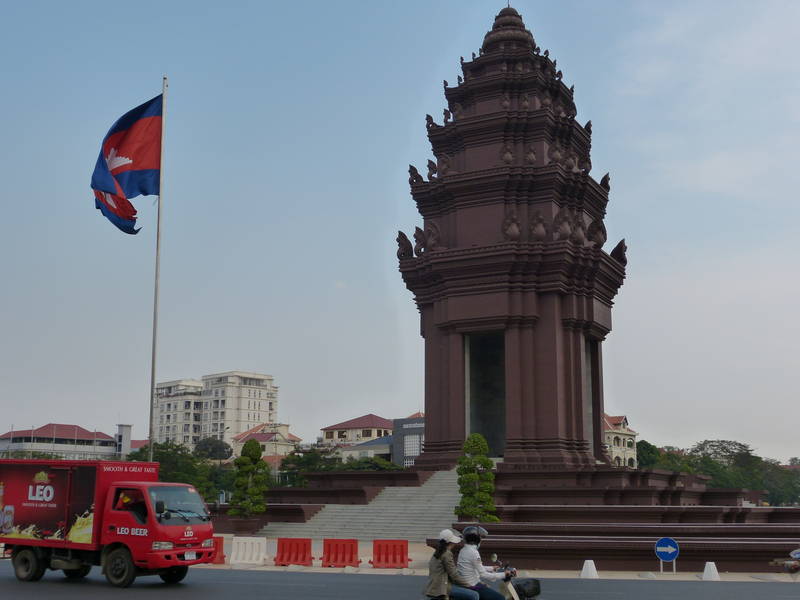
Dusty construction for the first 50 kilometres
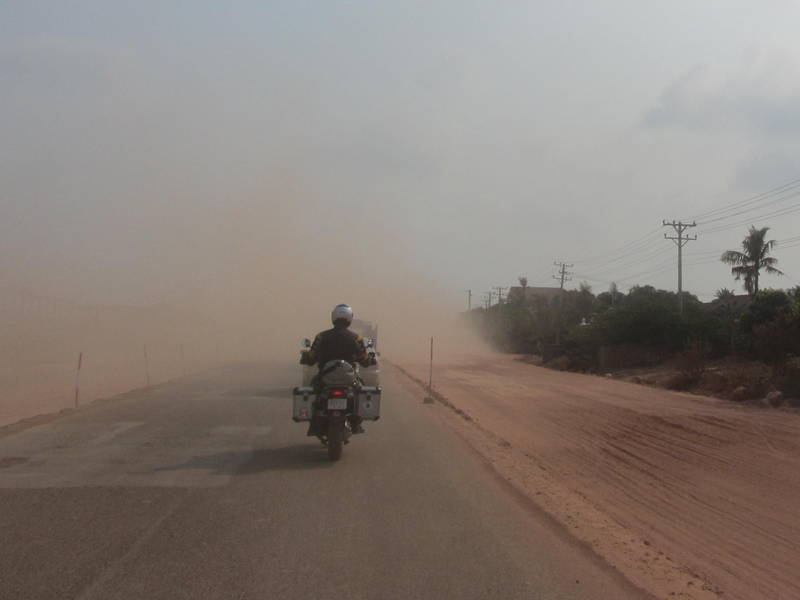
Green fields near the rivers
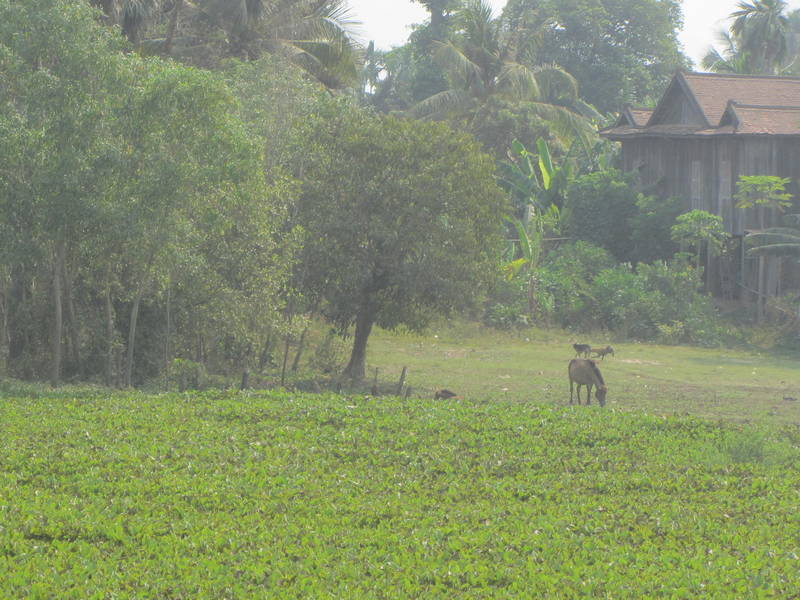
Lunch time

We get a curious visitor

Walking home from school alongside the busy highway

A cool and inviting pool


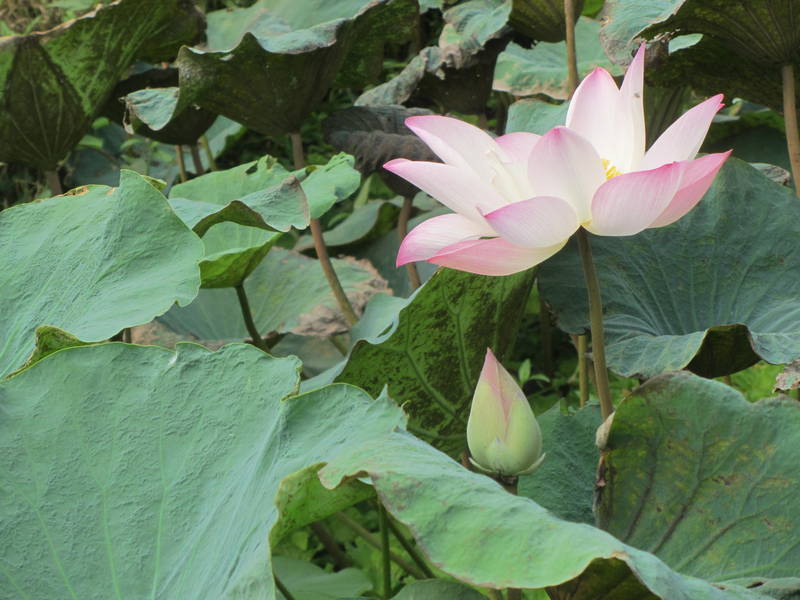
As we rode closer to Siem Reap, the highway improved immensely and we enjoyed looking at smiling kids, all happily waving at us, and two-story well-maintained wooden stilt houses along the way. Clearly this area enjoyed more prosperity than the northern areas. The city of Siem Reap was very well-kept, nicely landscaped and very touristy. It was too early to go to our hotel, so we rode over to Angkor. Our plan was to get a few photos of the motorcycles and us with Angkor Wat before the temperatures climbed too high. To ride into the temple area we had to buy a ticket, so we thought we might as well buy a three-day pass for$40 each. Our photos were taken and were printed right on our tickets. The ride along a tree-lined boulevard was so lovely, and we rode around a corner and there it was... Angkor Wat! This was huge. Yes, the temple was physically huge, with its famous towers, the largest religious structure in the world. But the idea of being here was huge, right up there with the Great Wall of China, the Pyramids or Petra. But it was too hot to just stand around and be amazed. We parked and took some photos, a German tourist obligingly taking a few shots of us and the famous wat (temple). Exploring the inside of the temple would have to wait as we thought it best to get photos of more temples in the park with the bikes while we could, so we rode around to see what we could discover, catching a bit of a welcome breeze during the ride. Our bikes were able to squeeze past a queue of vehicles waiting to get through a narrow stone gate. It was decorated with a big head statue and lined with deva (guardian) and asura (demon) statues engaged in a snake tug-of-war to cause the churning of the ocean (amazing what one learns from a guidebook). This took us into the Angkor Thom area. We parked in front of the impressive-looking temple and Ekke set up the tripod to get some photos. Our ride then took us past many smaller wats, a shimmering lake, a few monkeys, and some souvenir sellers. We stopped and bought a DVD that explained the history of the place, and a few little bronze Hindu figurines. We eventually made it to the Frangipani Hotel a few kilometres away in Siem Reap and parked the bikes in a driveway in front of the hotel. The hotel staff gave us a cold, ginger-flavoured welcome drink and greeted Ekke as if he were a long lost friend. He had stayed here one night on his ride from Vietnam to Bangkok and had been in Siem Reap for about 15 hours in total, possibly less, and every staff member recognized him. That was great fun.
Riding towards Siem Reap behind the truck delivering shiny new bicycles
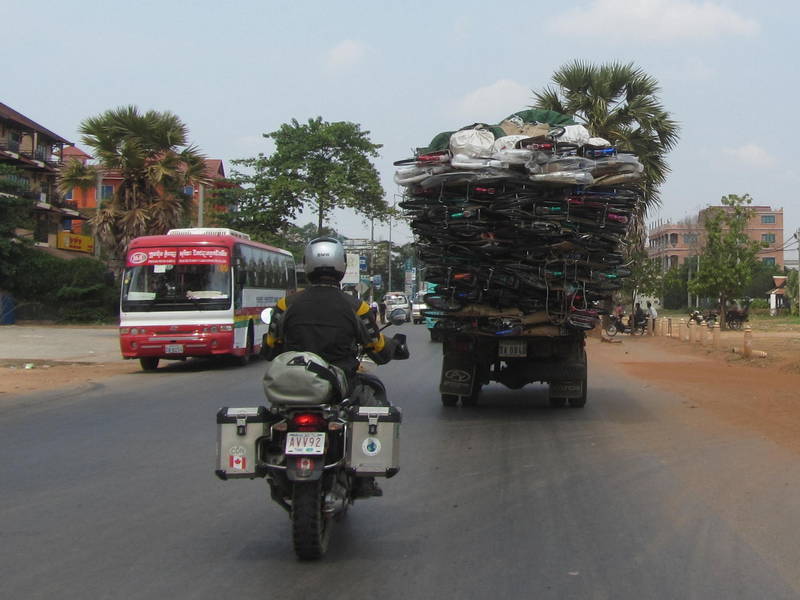
No cones or flashing lights here, just a branch to warn of the blocked road

A German tourist snaps our photo in front of Angkor Wat
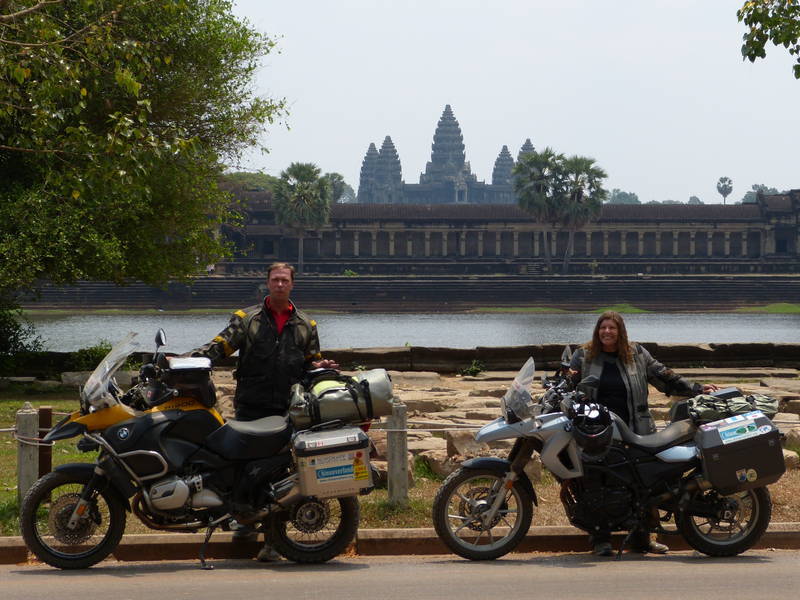
Boy it's getting hot in all the gear!
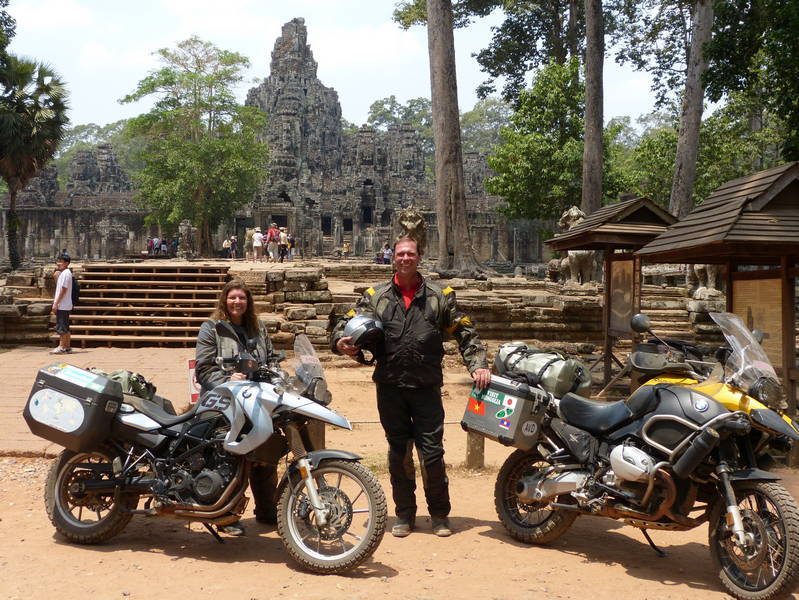

We inhaled the scent of fresh, white frangipani flowers in our lovely hotel room and looked down on an inviting, sparkling blue swimming pool. Umbrellas provided some very welcome shade as we lay around and read novels and motorcycle magazines - heavenly. We really wanted to see Angkor Wat at sunset so we managed to haul our lazy selves up, scooter over to the base of Phnom Bakheng Wat and walk the wooded pathway amongst hoards of other tourists. The problem was that most of these tourists were coming down from the wat, the opposite direction of the sunset-viewing area. Did we miss it? We arrived at the base of the wat at 5:29 pm. A sign indicated that entry to the wat closed at 5:30 pm. Just made it. Steep stairs took us up and the views of Angkor Wat were fantastic. But we immediately saw that low clouds were obscuring the sun and there would be no spectacular sunset at Angkor Wat that night. That's why all the tourists were retreating before sunset.
Checking into our lovely room at the Frangipani
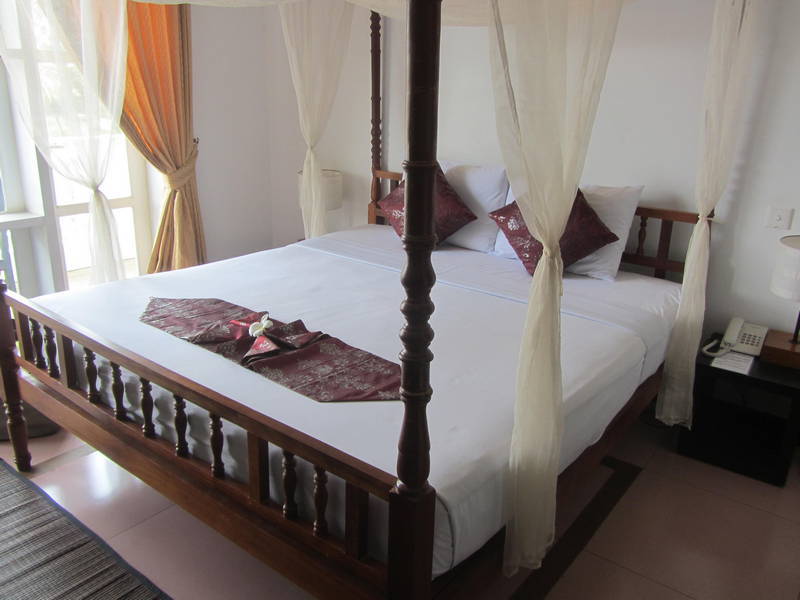
Oh, that looks good; last one in is a rotten egg!

At the top of Phnom Bakheng Wat for sunset

Wow

After checking our guidebook for restaurant possibilities, we parked downtown and set off to find our choice for dinner. The restaurant was not there, so we wandered up a busy pedestrian street to see if we could find something else. A young couple came up to us and introduced themselves - Terri and Thomas from Austin, Texas. Thomas had observed the BMW stickers on our motorcycle helmets that we were carrying and said that we must be the riders of the BMW motorcycles parked in front of their hotel. After learning that they were motorcycle enthusiasts and had bikes back in the States, we chatted about our trip and then heard about their plans to go to Vietnam. We found ourselves sitting down to dinner together at a, coincidentally, Vietnamese restaurant. It was a lot of fun, sharing stories about motorcycle rides, and we really enjoyed their lively tales. They had clearly made travelling a part of their lives, and it was great to talk with such like-minded people. We sat down to breakfast with them at the Frangipani Hotel the next day, and they invited us to Austin to see the Moto-GP races on the new track there, Circuit of the Americas. Thomas produced a cellphone-photo of Terri standing beside Colin Edwards, a famous Moto-GP racer. Very cool.
Breakfast at the Frangipani with Thomas and Terri
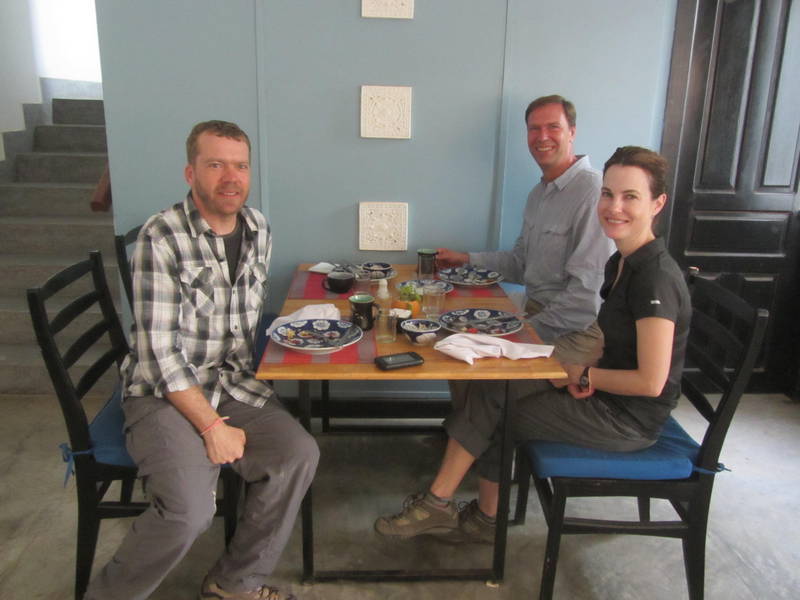
Knowing from our explorations the day before that it was easy to ride around and park the bikes at the temples, we scootered over early in the morning. The sun was already beating down as we walked across the bridge to Angkor Wat, a Hindu, later Buddhist, temple built by Suryaverman II, in the 12th century AD. We thoroughly explored the huge structure. 800 metres of bas reliefs lined the walls of long hallways around the outside of the temple depicting Hindu scenes. We climbed up and down stairs, through passageways and courtyards. I was very impressed with the detail in the wat, the rugged towers, the Buddhist altars, the carved columns. Dripping with sweat after a big climb up to the top, we stopped in some shade for a drink. After recovering, somewhat, we rode to Ta Prohm and parked in the shade by the stone wall. Nature runs amok here, the roots of trees strangling sandstone blocks of the temples, and we were astonished. Every corner we came around offered some new delight, a huge tree embedded in a stone wall or roots choking stone archways. This was one of the temples where the movie, 'Tomb Raider' was filmed. One could just picture Lara Croft racing through the courtyards, under gates, swinging from jungle vines from high ceilings, pursued by the bad guys.
Walking across the bridge to Angkor Wat
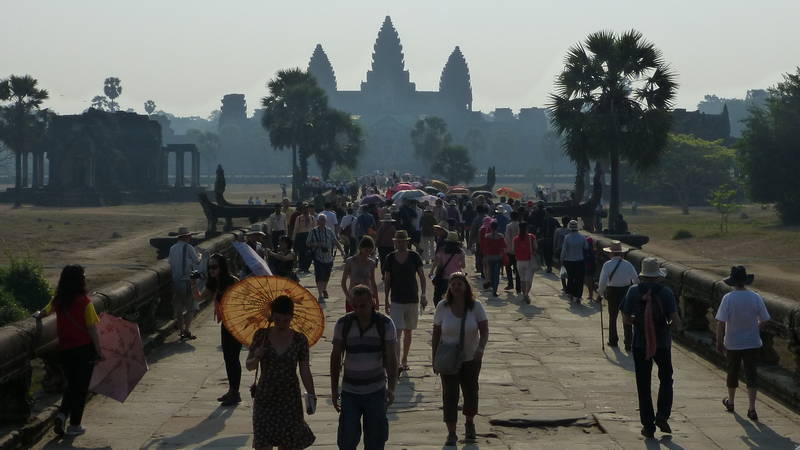
Amazing reliefs
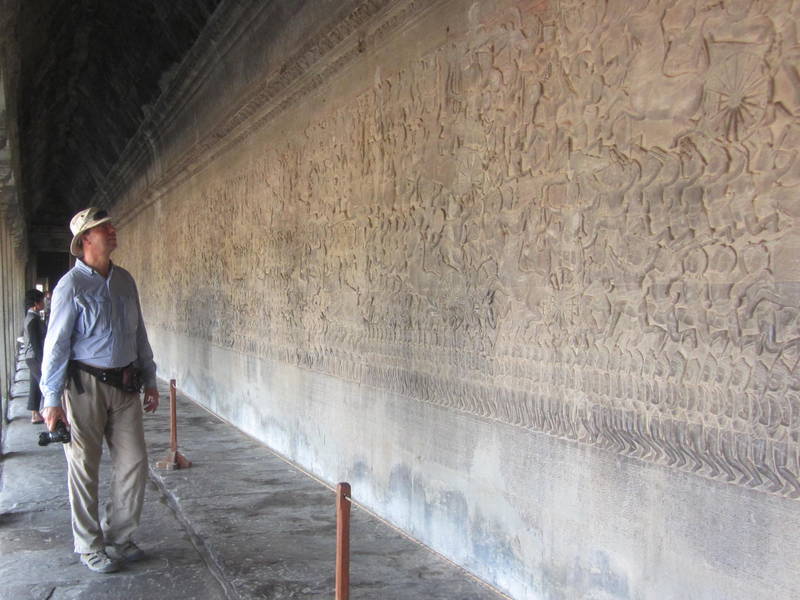

The back of Angkor Wat

What a steep climb

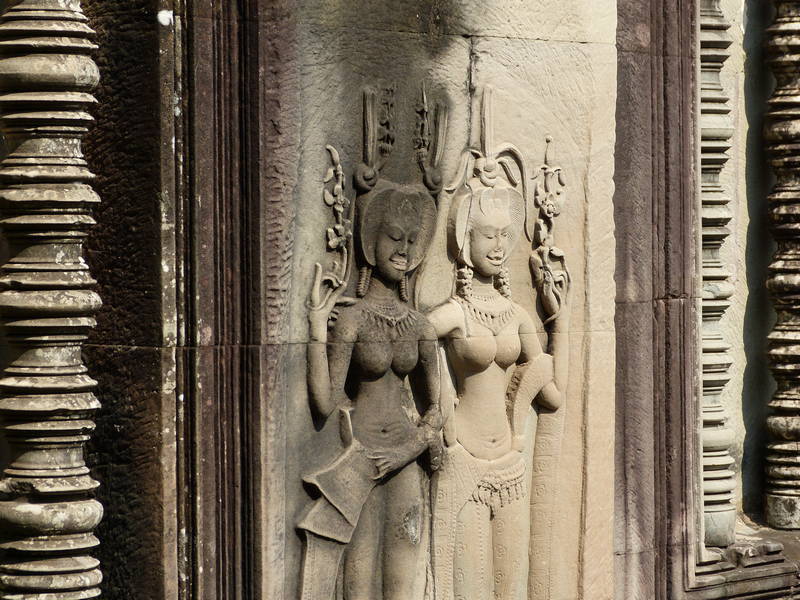
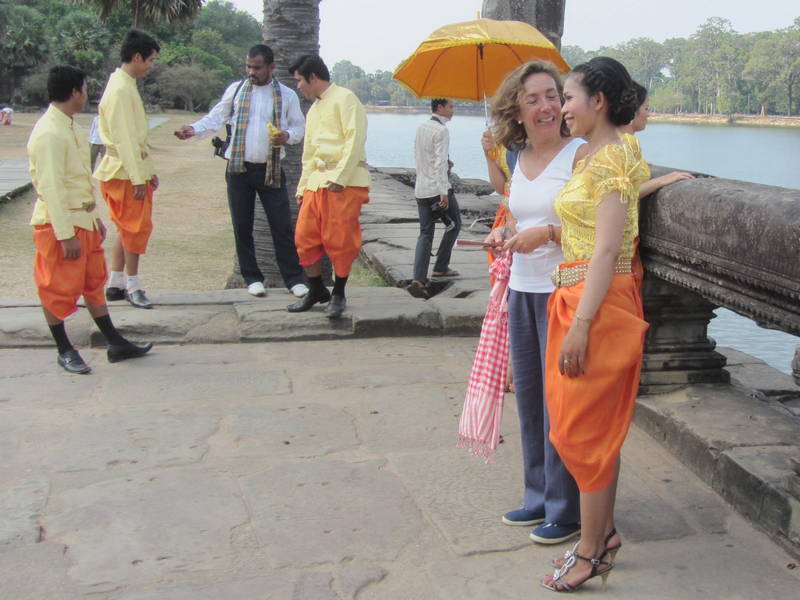
Riding over to Ta Prohm as the day heats up
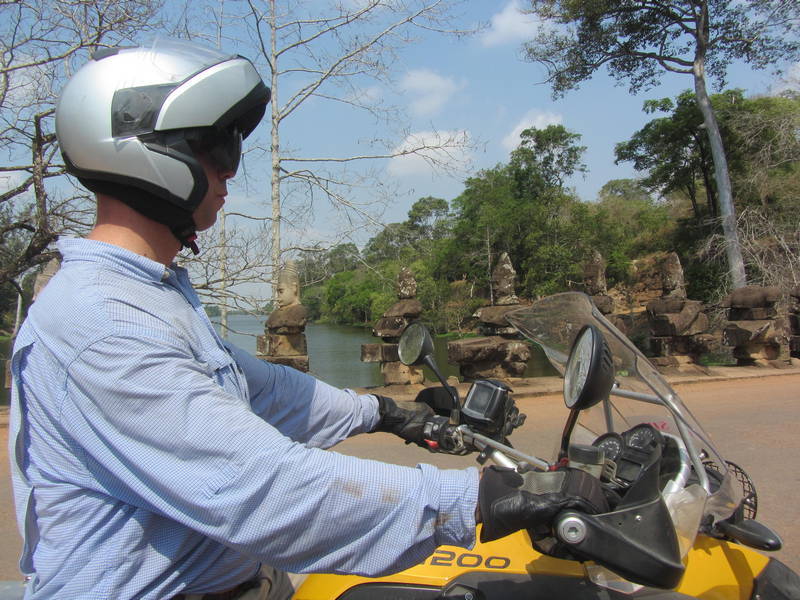
Maybe riding naked is the way to beat the heat?

Passing through the gates at Angkor Thom
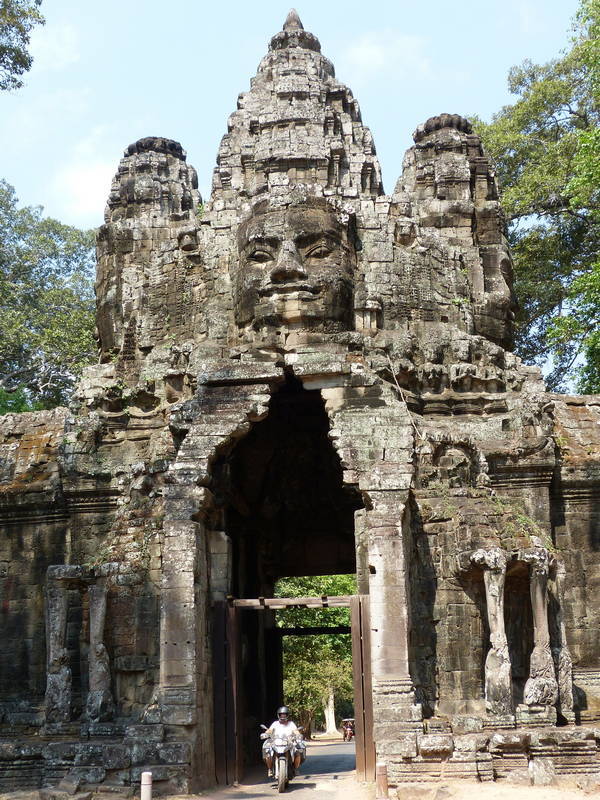
Ta Prohm is the jungle choked temple we had envisioned



Ekke gets ready for his best Tarzan swing from a vine
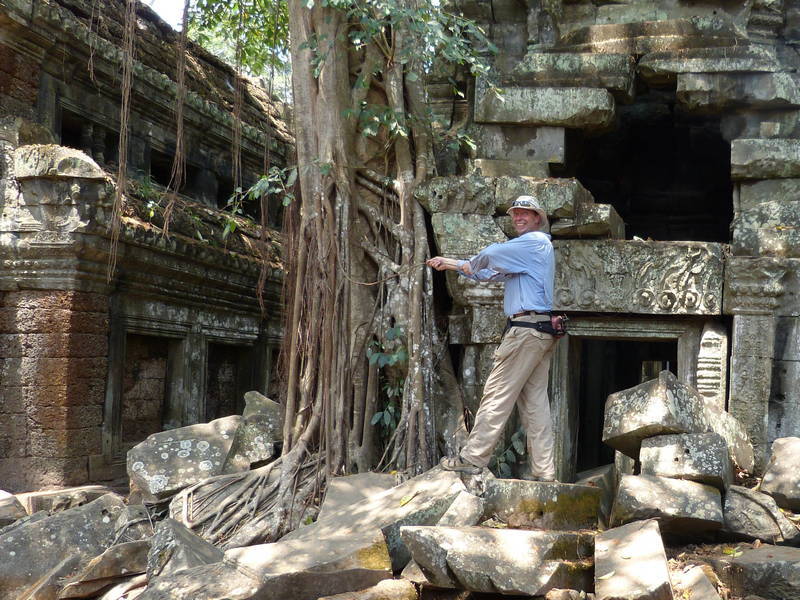
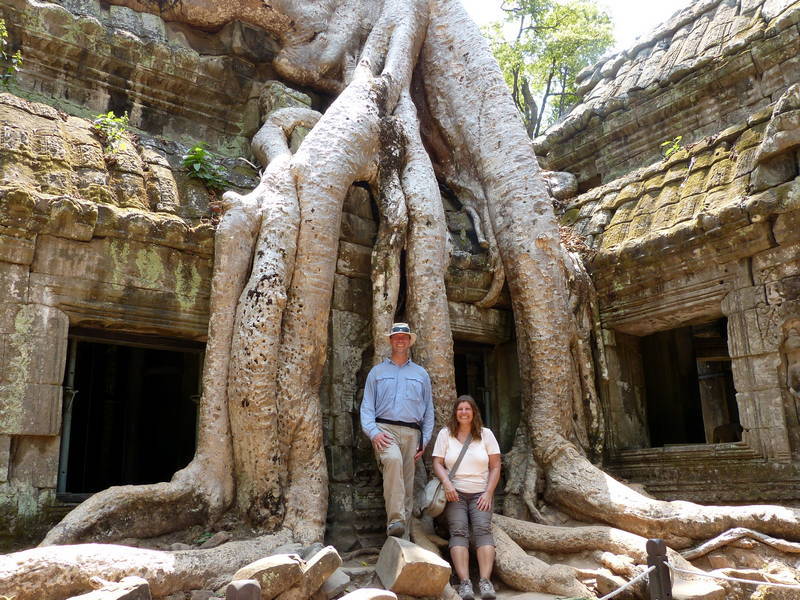
Before/After photo shows results of restoration work

Nice that they have a sign
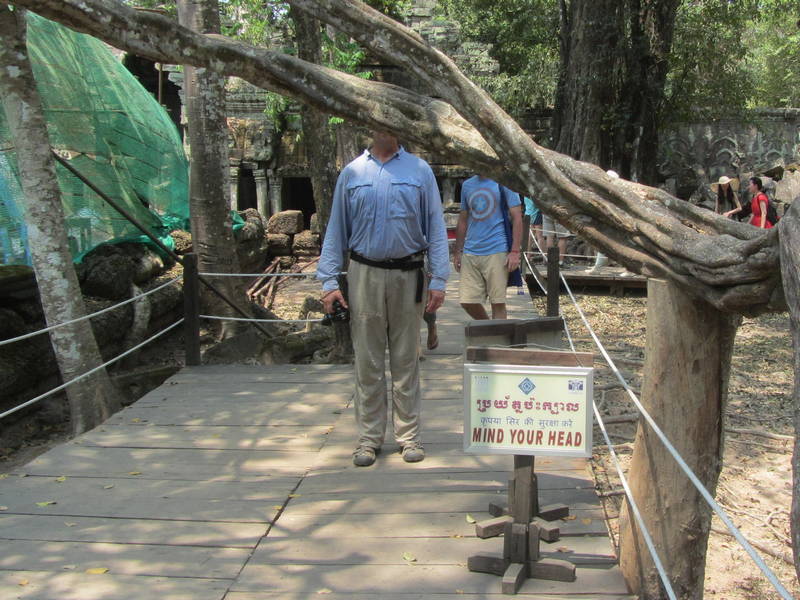

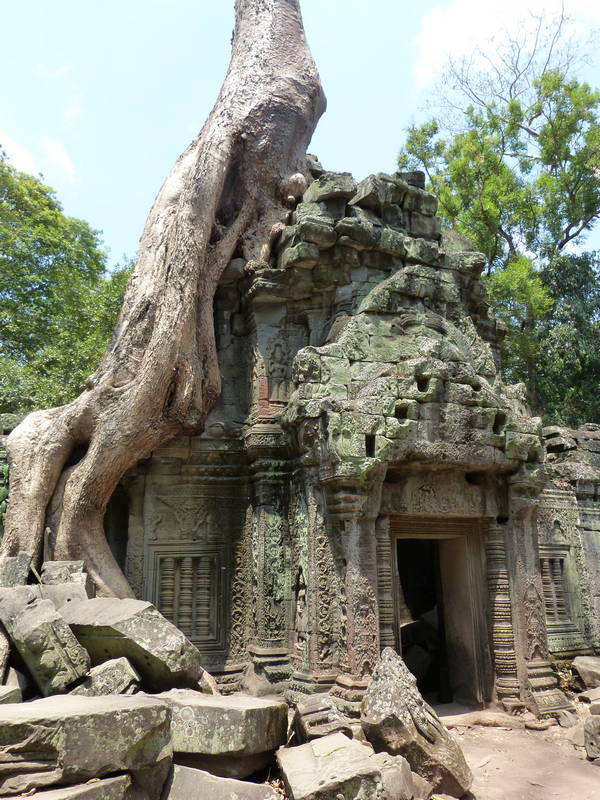
Leaving Ta Prohm
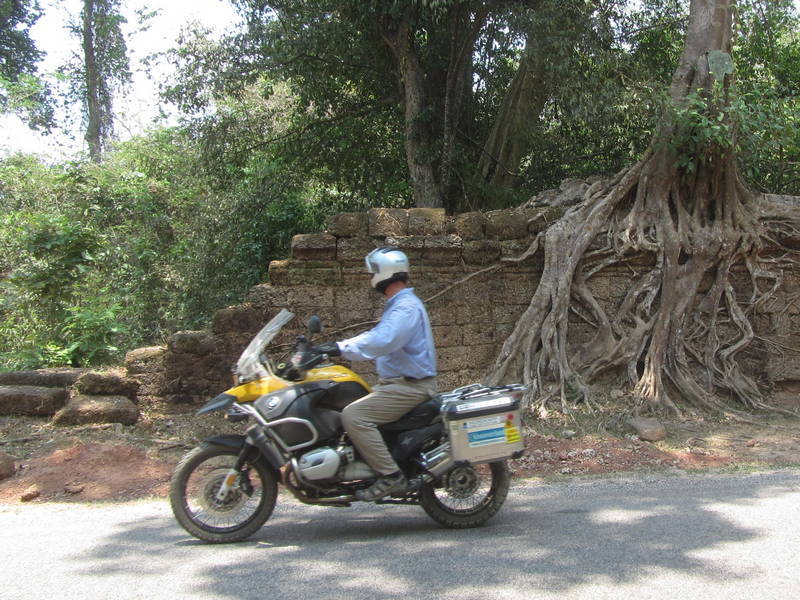
Visiting two temples in the morning, with temperatures getting up into the high 30s was enough for us for one day. On the ride back into town we spied a restaurant sign at the Sofitel Hotel, and sat in the shock of their air-conditioned piano bar eating some really expensive pizza. A headline in a hotel copy of a Phnom Penh English newspaper caught my eye and I read how satellite photos showed 60% of 'protected' forest in Cambodia had been cut down. We recalled that we had seen a few fully loaded logging trucks on the roads, and fields that had once been forested. Sad.
With the heat there was nothing for it but to enjoy the pool all afternoon and then find an air-conditioned restaurant for dinner. A local hotel restaurant offered us the Cambodian food of our dreams, a set menu which included salad with fish sauce, garlic bread, corn chowder, stuffed leg of chicken with spinach and mashed potatoes. They had run out of the creme caramel for dessert so substituted deep fried ice cream. I don't actually know how authentically Cambodian it was, but it was definitely delicious.
On our last day of temple-hopping, we rode right to Angkor Thom, the mother of all temple complexes. As we parked under a shady tree and locked up our helmets, a family from Germany came over and chatted about the bikes. I love the expression on peoples' faces that inevitably comes when we explain how we flew the bikes from Canada and then rode across Russia to China. The Horizons Unlimited world map on the side of my bike was, again, a great visual aid to show the extent of our journey.
These map stickers are available from Horizons Unlimited and are great conversation starters

Angkor Thom was built by Jayavarman VII after Angkor Wat was sacked by the Chams and what is unique is that commoners were allowed to live within the walls of the temple complex. The city is surrounded by a huge wall and moat which kept out those pesky invaders. And if that didn't work, seeing the 54 towers of Bayon temple with 216 really big carved faces on every side would surely scare anyone off. The faces were supposed to represent Avalokiteshvara, the Buddhist Bodhisattva of Compassion but coincidentally bore a striking resemblance to the ruler, Jayavarman VII. The carved faces, all exactly the same, were impressive, not only by their size, but by the sheer number of them in a single temple. We climbed up stone stairs into the temple through little corridors and hidden passageways and got close-up views of the carved faces. They all had cheeky little grins that a stone carver with a good sense of humour probably added just for fun. Bas-reliefs on the outside showed everyday Cambodian life in the 12th century, mostly of farmers working in the fields.
Angkor Thom and a few of the 216 faces of Avalokiteshvara
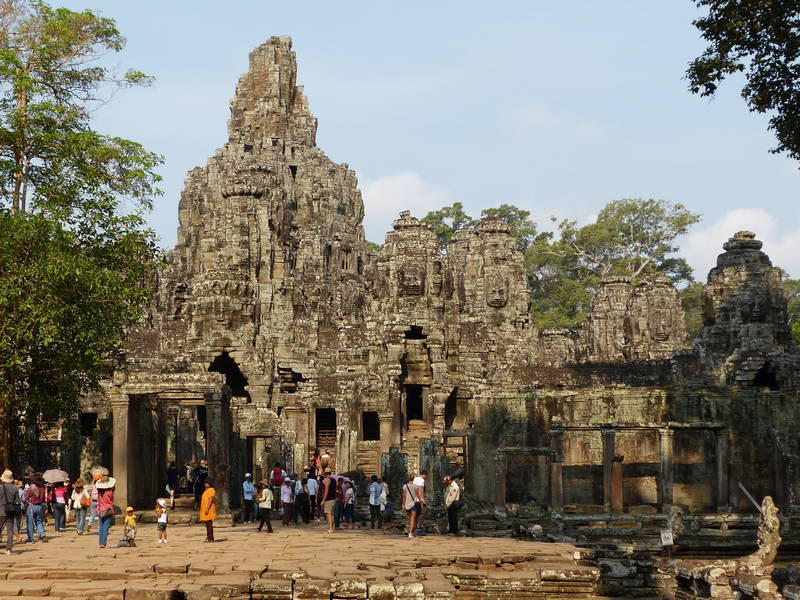
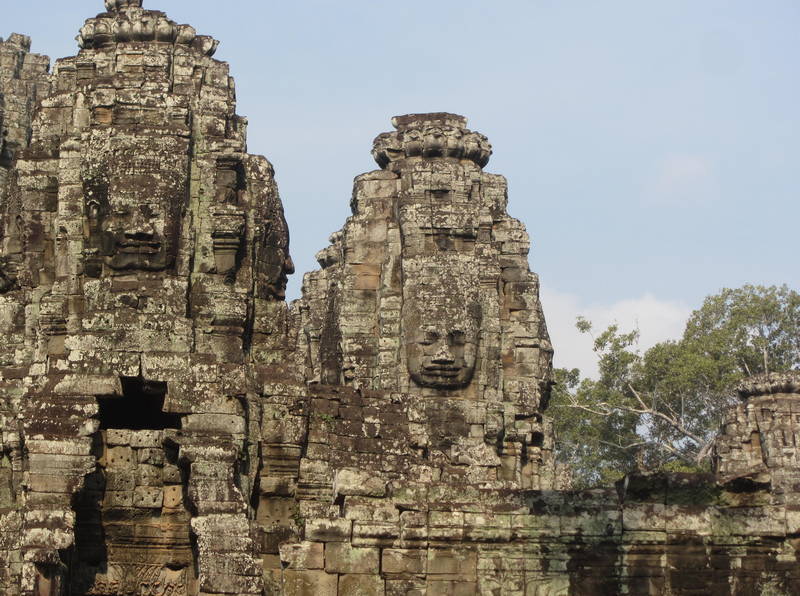
This is not the face of Avalokiteshvara or Jayavarman VII

Locals dressed in period costume
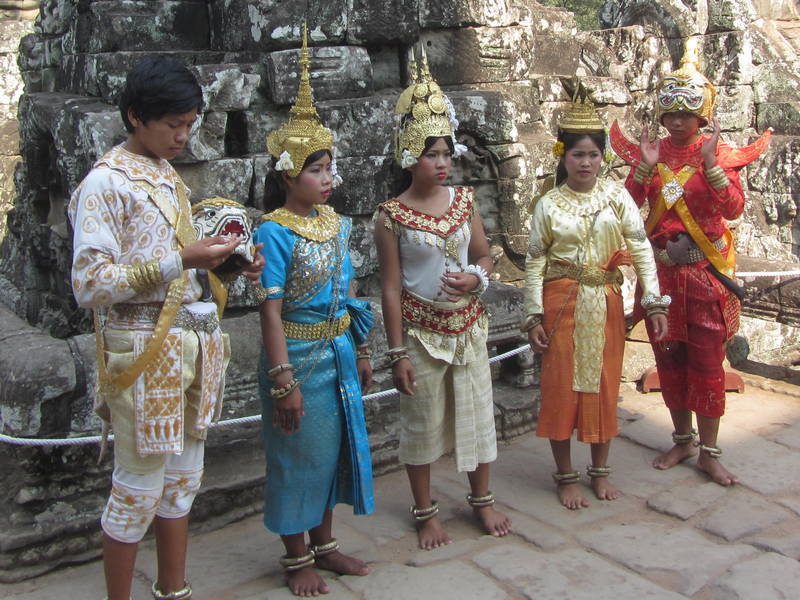
More faces around back

And the side...

Another temple further along, Baphuon, was meant to resemble sacred Mount Meru and allowed for great views after a climb up hundreds of steep steps to the top. As we strolled through covered walkways which surrounded each level of the temple we admired the renovation work that had been done. The Khmer Rouge had destroyed the temple records and a French archaeological team that wanted to make the big pile of rocks into a temple again had a giant jigsaw puzzle on their hands. But they did a great job. I descended the steps and headed for the cool shade of a tree while Ekke stayed up. He told me later that he had found a reclining Buddha image embedded in the rock of one wall, about 60 metres long. I wasn't going back up to have a look. An outdoor cafe offered relief from the heat and we effortlessly downed a huge bottle of water. While walking out we noticed some T-shirts for sale, and Ekke found one that would fit. Looking at the tag after he bought it, he noticed that it said 'Old Navy, XXL, Maternity Wear'. Better stop eating that Cambodian fried ice-cream.
Baphuon
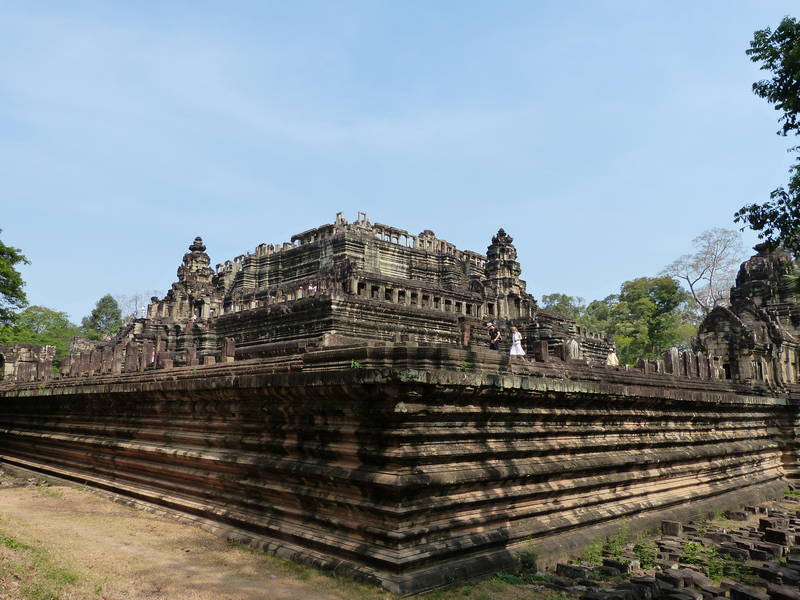
Can you make out the enormous reclining Buddha?
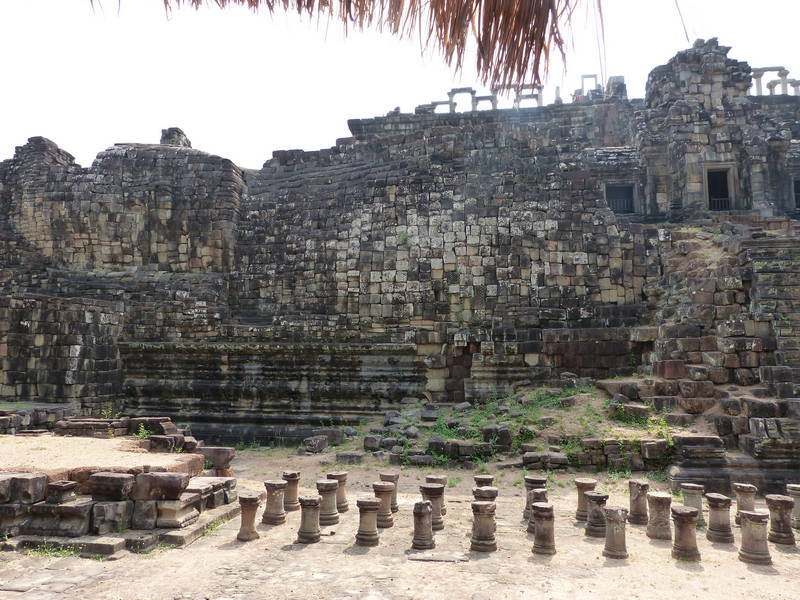
Ekke finds Cambodian clothing that fits (Ekke says, "Oh come on, maternity?!?)

There were many temples in the Angkor Thom complex so we had to pick and choose and walked to the Terrace of the Leper King next, thought to be a royal crematorium. On the walk back to the bikes we saw the Terrace of the Elephants, a platform where royalty watched grand victory parades, its walls decorated with parading elephants.

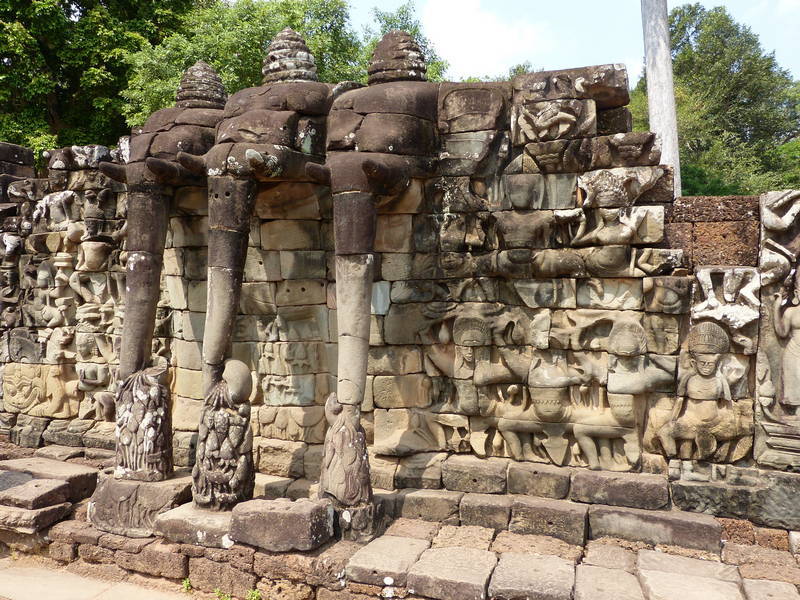
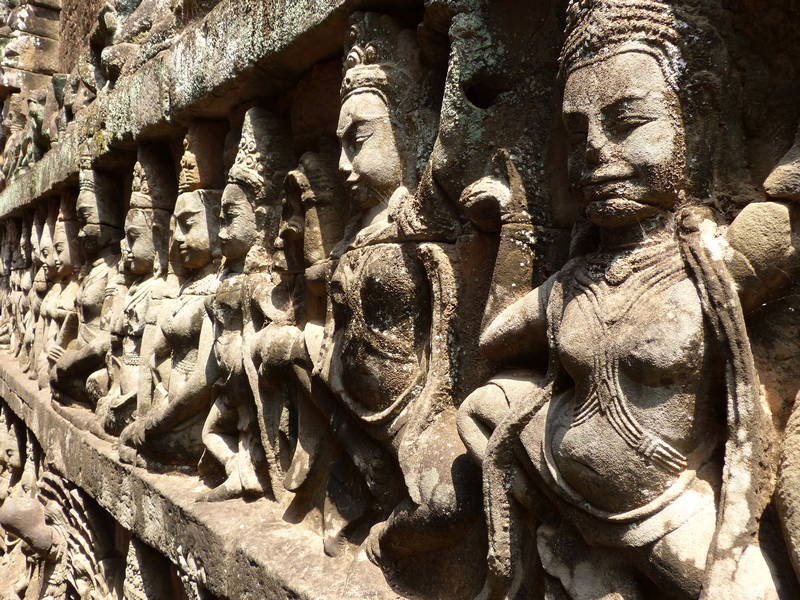

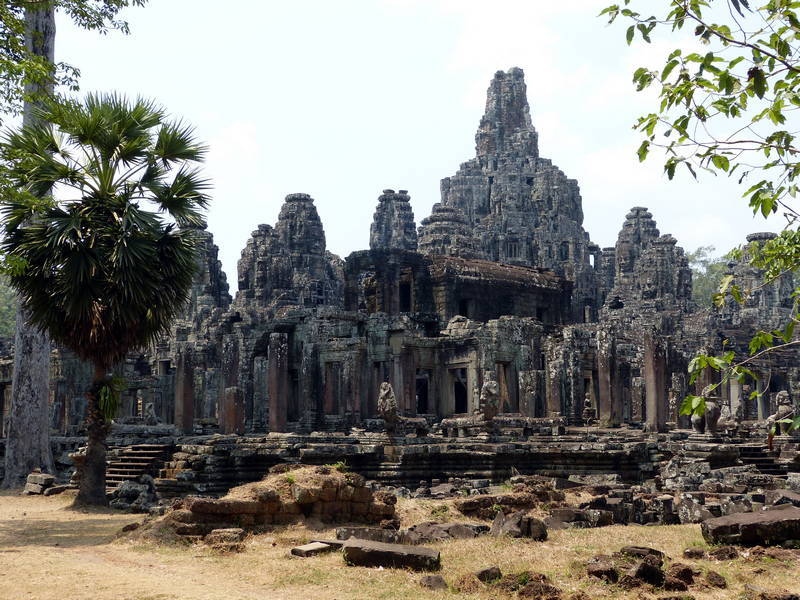
Although we were physically 'done' because of the heat and all that walking, it was the final day to make use of our 3-day pass, so we decided to ride over to one more temple, Preah Kahn. It was unique because it combined Hinduism and Buddhism into one big fusion temple, with statues from both religions. While taking some photos, a member of the tourist police came over and started telling us about the statues. It was really quite good information. He also pointed out some areas that we would have missed, hidden corridors and gates. He showed us how the Buddhist entrance had doors of equal size, but the Hindu entrances of Vishnu, Shiva and Brahma had successively smaller doors. We gave our impromptu tour guide a tip as we left. Since it was on our way back we did a quick trip to Neak Poan, and Lonely Planet said that if Las Vegas ever developed an Angkor theme, this should be the model for the swimming pool. A long boardwalk took us past a forest partially submerged in water, where a young boy was standing in the pond, catching snails. When we arrived at the site we saw a tiny temple, decorated with intertwined snakes, sitting in the middle of an ablution pond, flanked by statues of horses. It was a place of healing, and we both felt much better as we left the beautiful site.
On the ride we noticed this sign warning of land mines, don't go off the marked trails
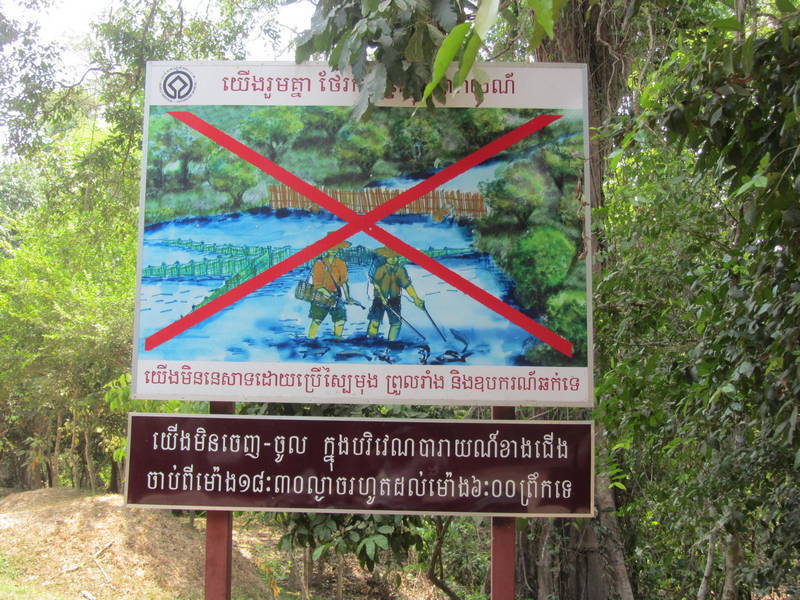
Preah Kahn

Our informal guide

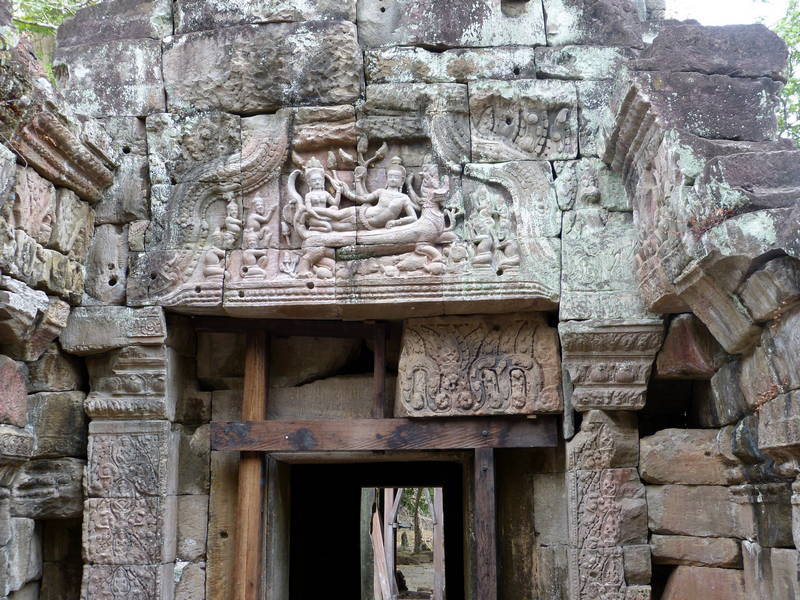

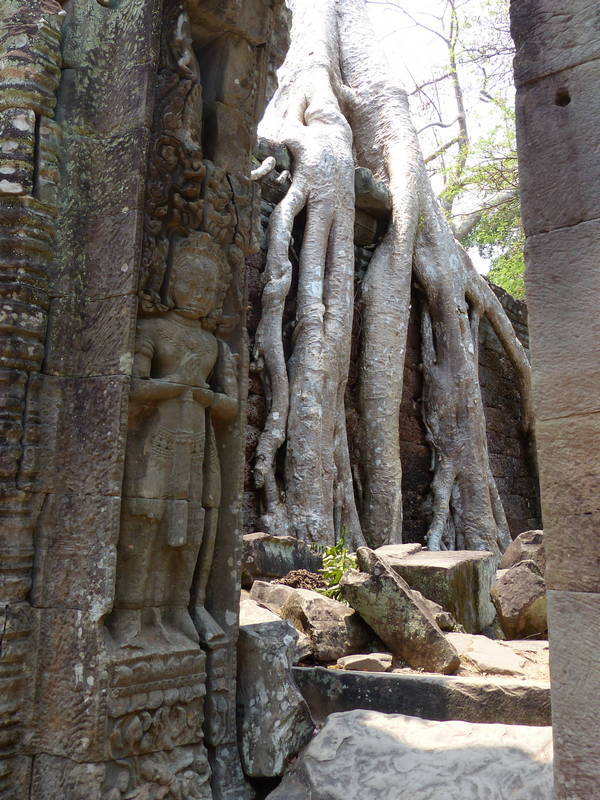

A young boy gathering snails just outside Neak Poan

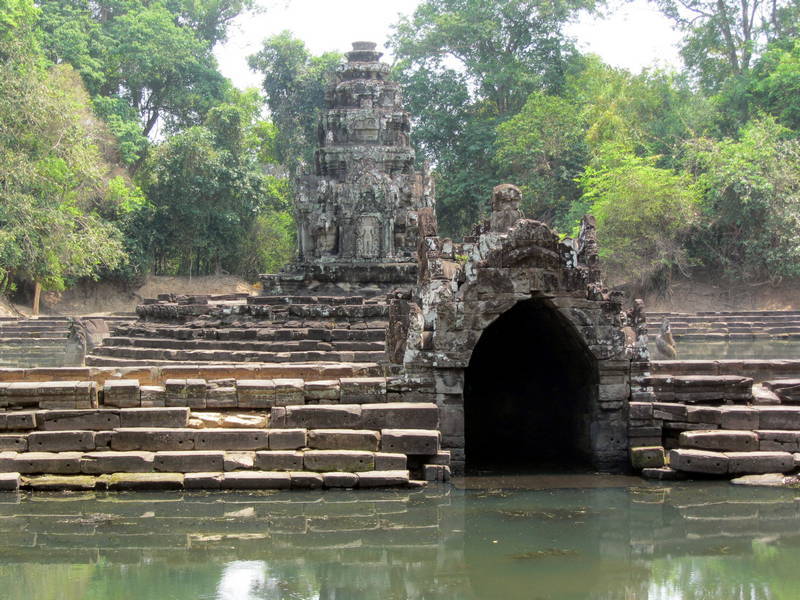
I don't think we saw half of what Angkor and the surrounding area had to offer. There were so many more temples here and further north in the jungle. Just another of those places that we will have to return to. (While writing the Cambodia website here in Tirana, Albania I saw an article on CBC.ca that announced how evidence of a huge city around Angkor Wat had been discovered using laser technology. Neat).
One last shot at Angkor
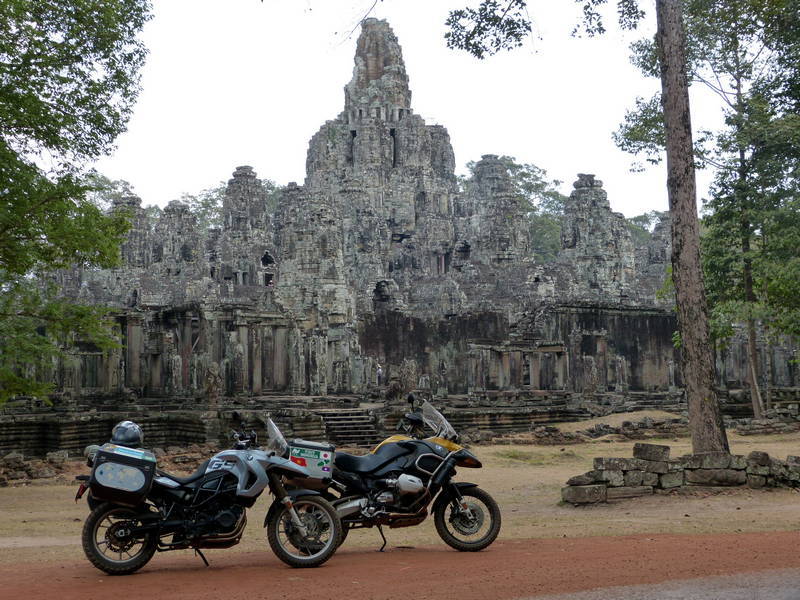
And then it's time for reading at the pool with the iPad. What could go wrong?
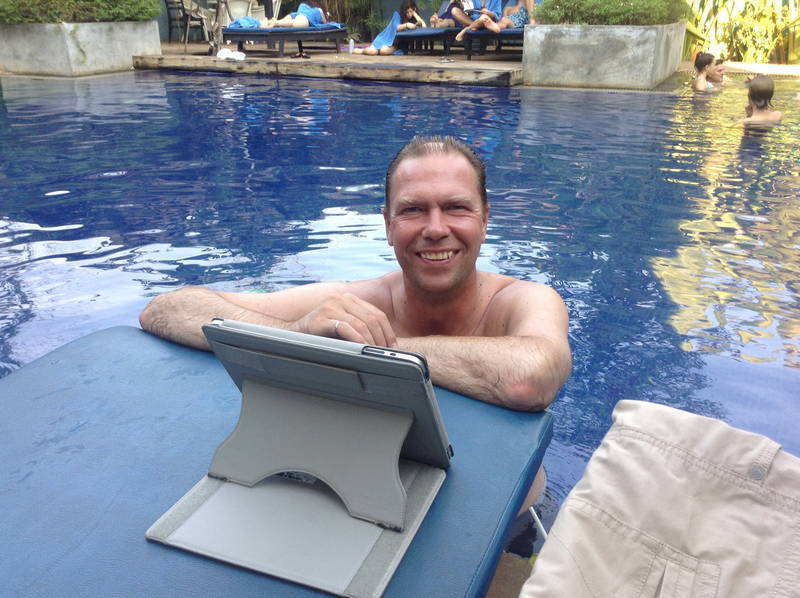
The next day, March 31st, 2013, we rode 150 kilometres to the Thai border. Getting stamped out of Cambodia was easy, and after a quick scan of our fingertips, we were done. We said goodbye to another wonderful country that exceeded all our expectations for exciting motorcycle world travel.
Traffic safety is not Job #1 in Cambodia
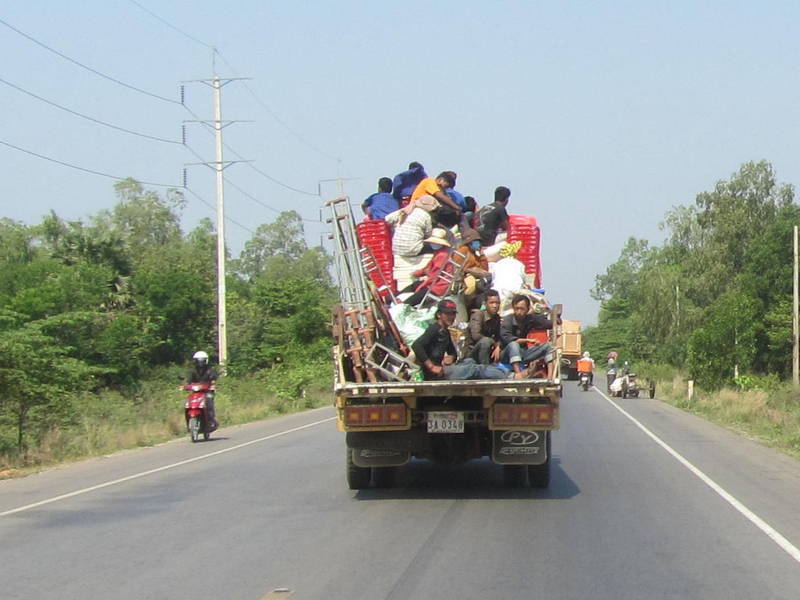
Chicken on the way!

Map of our route through Cambodia
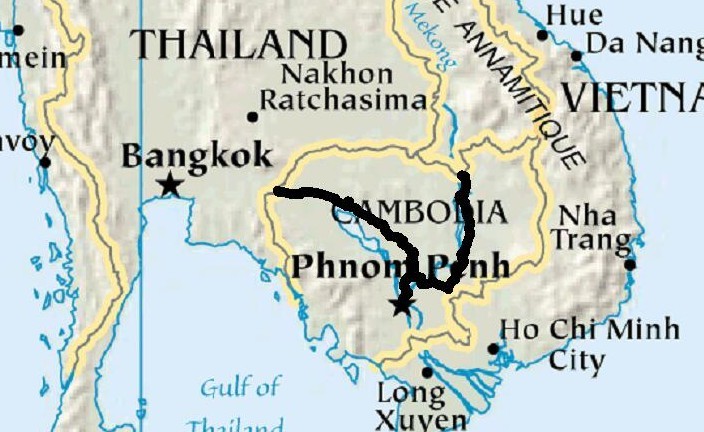
After an easy ride from Siem Reap to the border on Sunday, March 31, 2013 it was also an easy exit process from Cambodia. The entry into Thailand (the fourth time for me) was a bit more convoluted as we had to fill in a number of forms, including the temporary import document. This document was perhaps the most important as it needed to be sent to the motorcycle shipping company ten days prior to shipping the bikes so that they could complete all the necessary export paperwork. After standing around in the blazing heat for so long it was nice to see a 7-11 a few hundred metres into Thailand. Air conditioned comfort and a chilled beverage. Ahhhh. The steamed bun and hot dog went down well for a cheap lunch and then back into the heat for the 50 kilometre ride to the River Resort in Sa Kaeo. 2000 baht (about $65) got an enormous suite with a fabulous shower and even a full kitchen. While the pool was a bit on the small side and could have done with a bit of maintenance it was a great place to spend a relaxing afternoon before dinner in the hotel restaurant.
40 Celsius makes for a hot ride but a great excuse for an afternoon in the pool
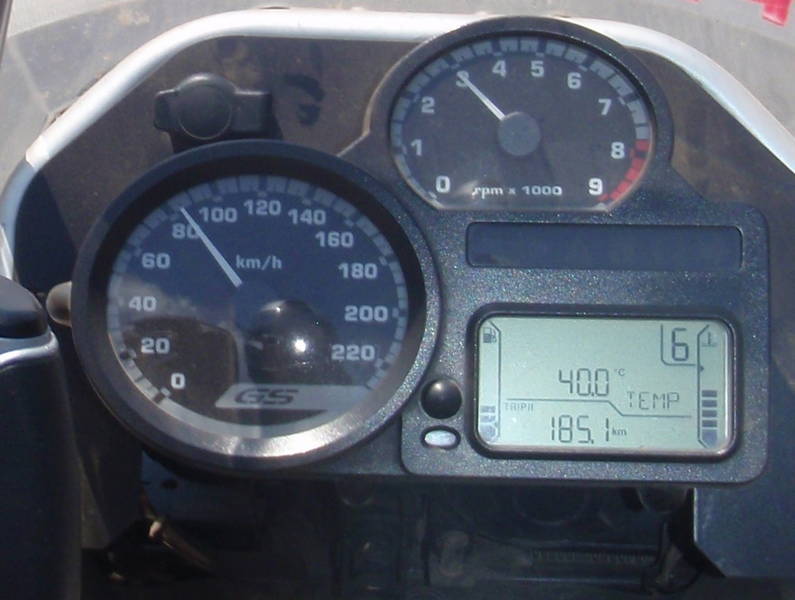
Fried eggs and toast in the hotel restaurant for breakfast and we were fortified for the 200 kilometre ride to Ayutthaya. This close to Bangkok we had to think about our fuel strategy as we didn't want to arrive at the shipping agent with too much fuel in the tank or, like in Shanghai, run out of gas on the way there. I didn't fill the Adventure and Audrey only put 10 litres into the F650 so we crossed our fingers and hoped it would all work out. Near the gas station was one of our favourite cafés in Thailand, Café Amazon. They have great beverages and cool air conditioning. There were a lot of military personnel at the café with lower ranks sitting outside and the higher ranking officials in air conditioned comfort. Once inside we ordered our drinks and a snack while the officers made room for us at a small table. Once seated we started chatting with the officers and the colonel mentioned how his daughter was in school in Portland, Oregon. We told them about our trip and they told us about life in Thailand. It was a fantastic experience made all the better when Audrey went to the cash register only to find out that the colonel had already paid for us. What wonderful people! As we approached Ayutthaya we hooked up with Highway 1, the main route to Bangkok, and suddenly we were off the lightly travelled rural highway and surrounded by fast moving cars and trucks. A slow truck pulled out to pass and with nowhere to turn I hammered the brakes while Audrey slalomed between cars into the passing lane. That was close. It probably won't be a very relaxing ride to Bangkok in a couple of days. We arrived at the Classic Kameo hotel to find a beautiful, brand new hotel. So new that construction and painting wasn't quite finished at the pool. Not that that stopped us from enjoying a lovely afternoon poolside.
High ranking Thai military personnel, colonel (standing between us) buys our drinks

Pulling into Ayutthaya and getting ready to do a U-turn at the stupa in the roundabout
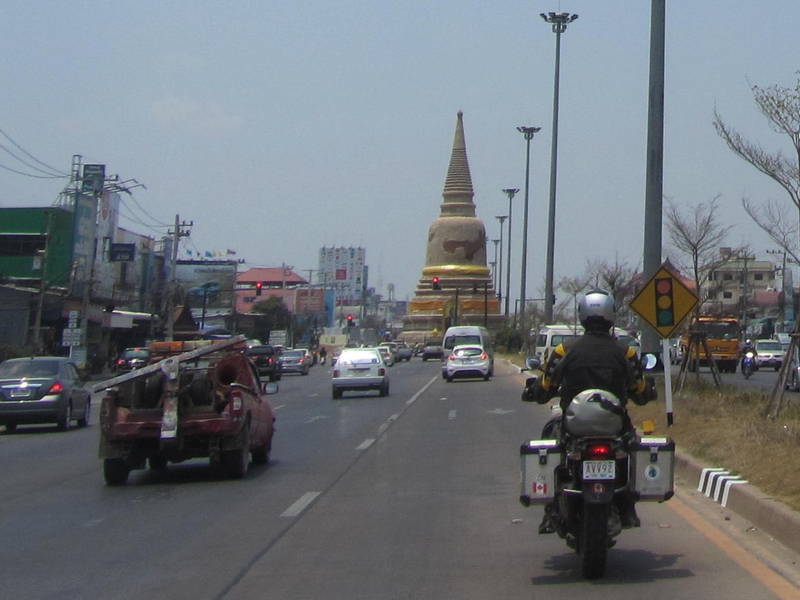
After a fantastic buffet (I don't think I want to go near a weigh scale after our time in S.E. Asia) we hopped on the bikes and rode into the centre of Ayutthaya. We explored a series of temples, the remnants of a time when Ayutthaya was the capital of Siam (second after Sukhothai which you can read about in the first Thailand chapter here). After being the capital for over four hundred years Ayutthaya was sacked by the Burmese in 1767. We visited the UNESCO World Heritage Site of the Ayutthaya historical park, the site of the ruins of the former capital. Wat Phra Si Sanphet was one of the larger temples and the condition of the temples led us to believe that it had been restored; they were simply beautiful. A stop at the air conditioned (it was already heating up) Historical Study Center proved quite interesting as we discovered some of the Dutch history here. Apparently the Dutch arrived in 1601 and stayed around until the sacking. So it was with some amusement that I noted the last king in Ayutthaya was named Ekkathat. Did one of the members of the Dutch East India Company come home and christen a new baby boy "Ekke" in honour of the king? We stopped off at the tallest Buddha statue in Ayutthaya on the way back to the hotel and then chilled out for the afternoon.
Ayutthaya historical park
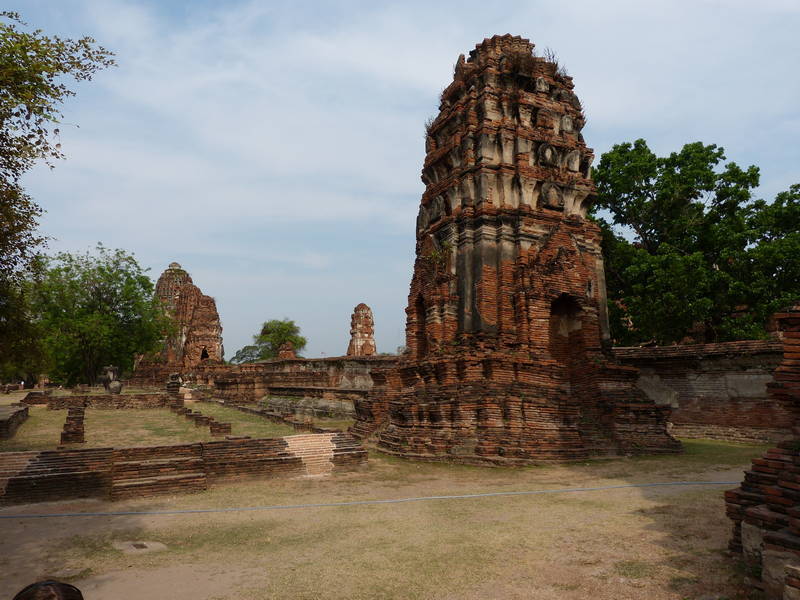
Buddha head trapped in the tree
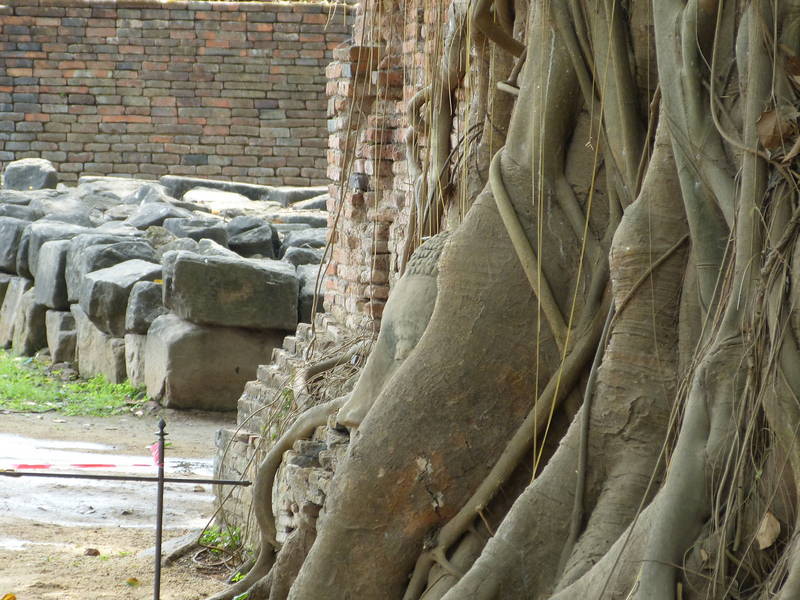
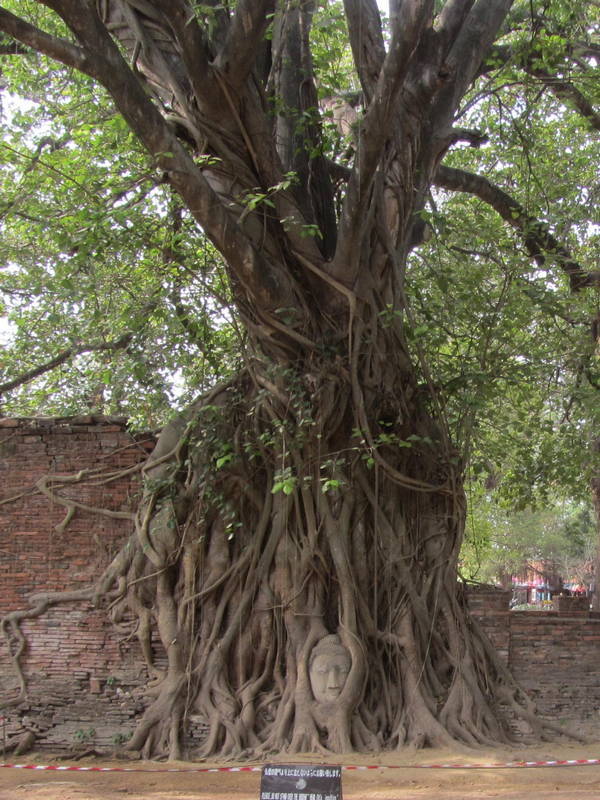
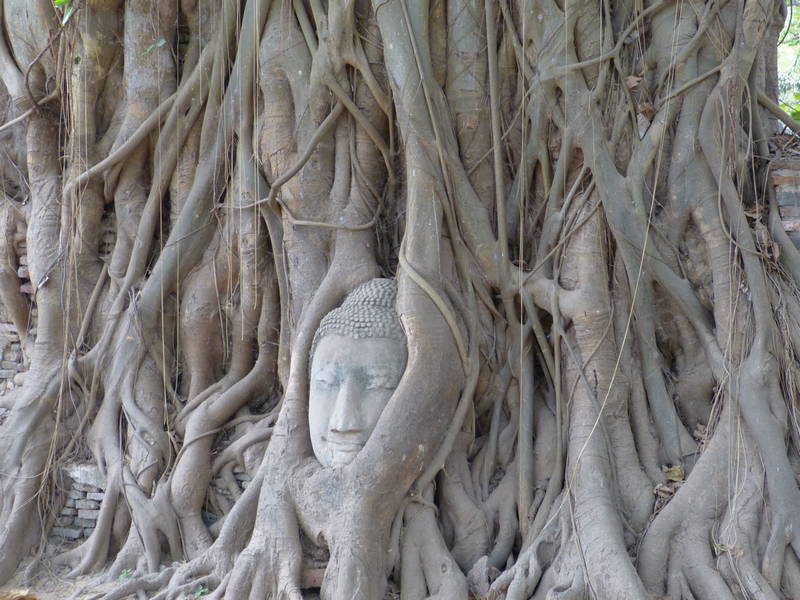

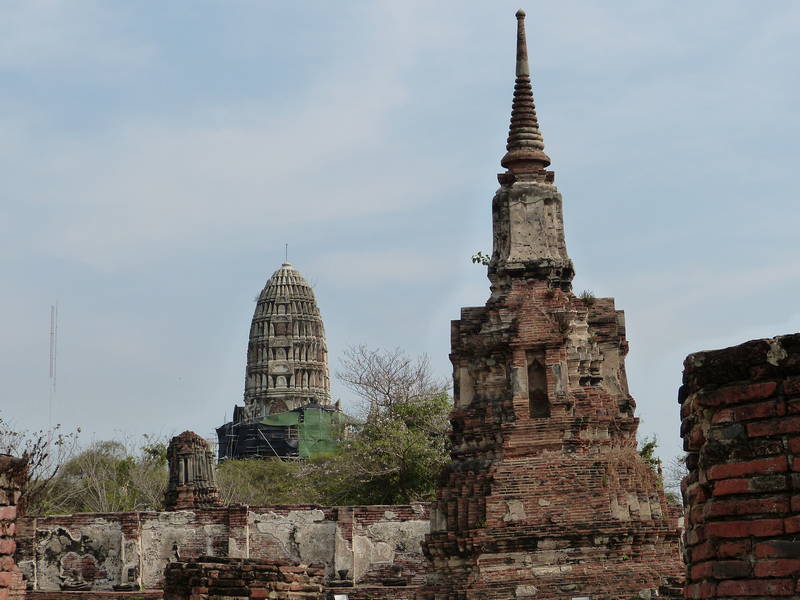
Would it be a bit cooler riding an elephant?

Wat Phra Si Sanphet
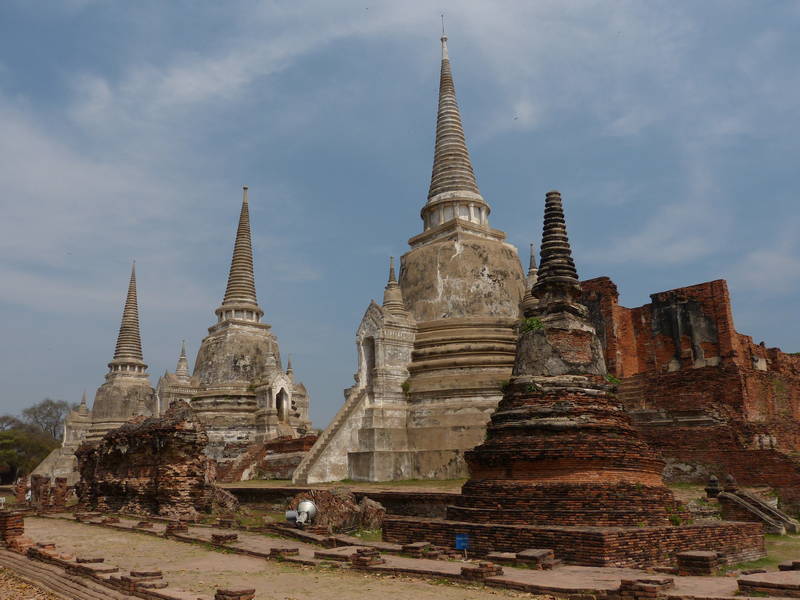
The usual traffic chaos

Wat Kaitia

Ayutthaya has some unique tuk-tuks
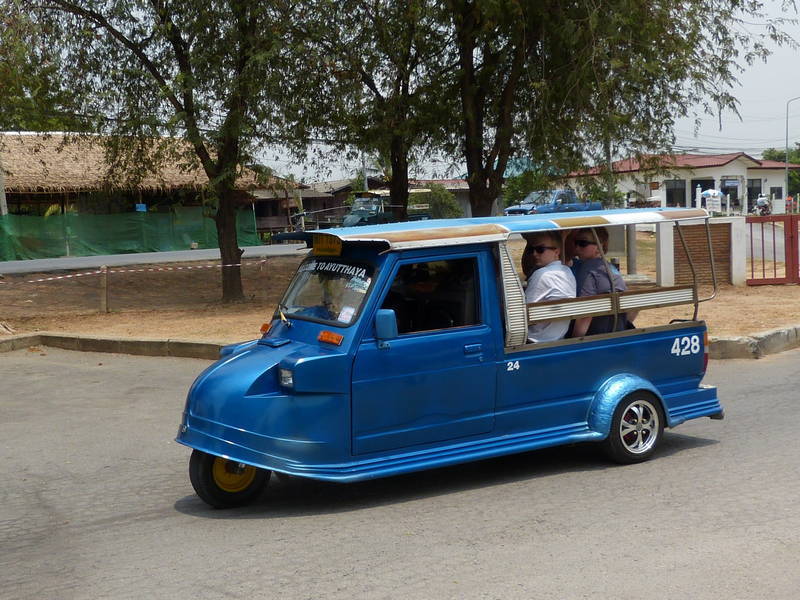
The tallest Buddha statue in Ayutthaya

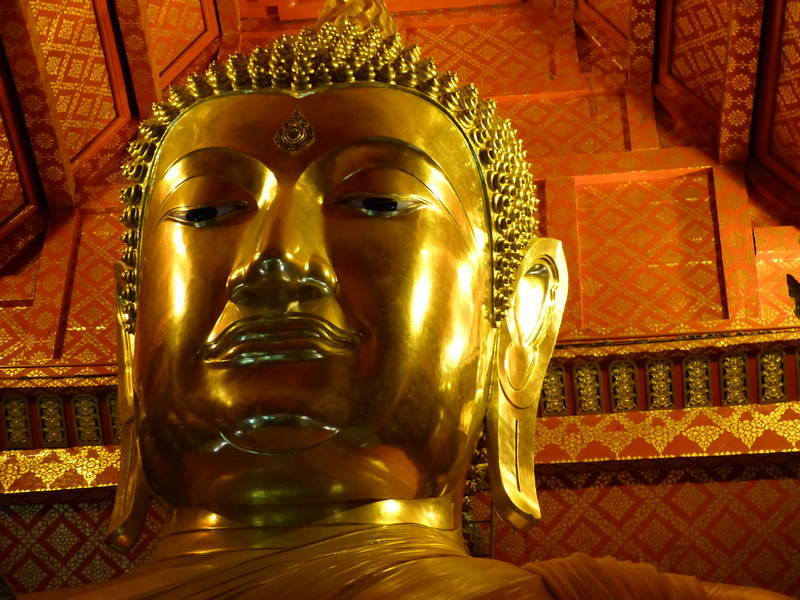
The stairs up the back of the statue are for cleaning and "dressing" the Buddha statue
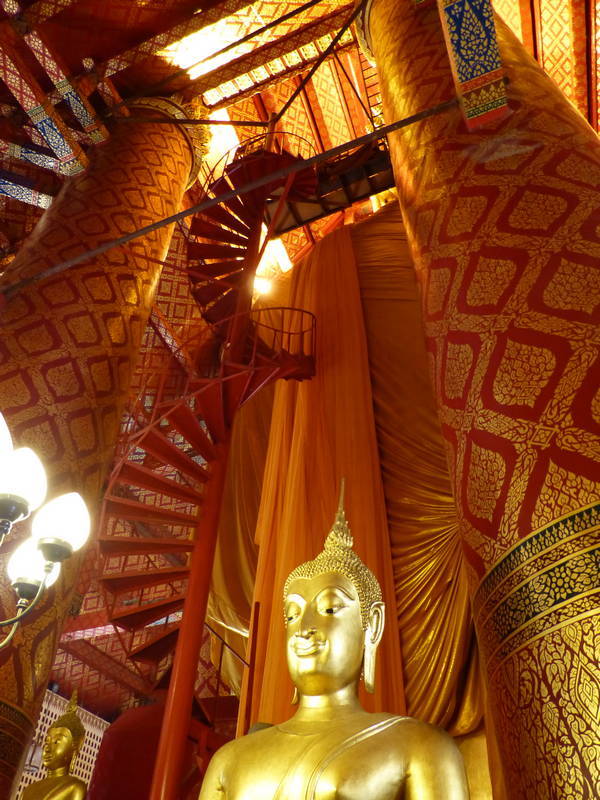
We enjoyed one last buffet breakfast before going to the serviced apartment in Bangkok (where we'll be making our own breakfasts) and then we saddled up for the ride into Bangkok. Only a few kilometres from Ayutthaya we rejoined Highway 1 and when we were about to merge onto the expressway noticed a "No Motorcycles" sign. We knew bikes weren't allowed on the expressways in Bangkok but this was still quite a ways out. We had to ride the whole 80 kilometres on the frontage road. It wasn't too bad, with only a few delays until we reached Bangkok proper. Once there, the traffic was quite horrendous and because the gaps between the lanes of traffic were so narrow it was almost impossible to split the lanes and make any progress. This also meant that my calculations for refueling the Adventure were off a bit and when we finally pulled into the Viva Garden the trip computer showed that I only had one kilometre left to go. Despite passing a couple of gas stations we were simply dying in the heat and had to get to the apartment before we reached the "well done" stage. We were welcomed with open arms and once again all the staff seemed to remember me from when I stayed with them a month ago. Last one in the pool is a rotten egg!
Hook up with Highway 1 and right away no motorbikes allowed in the fast lanes
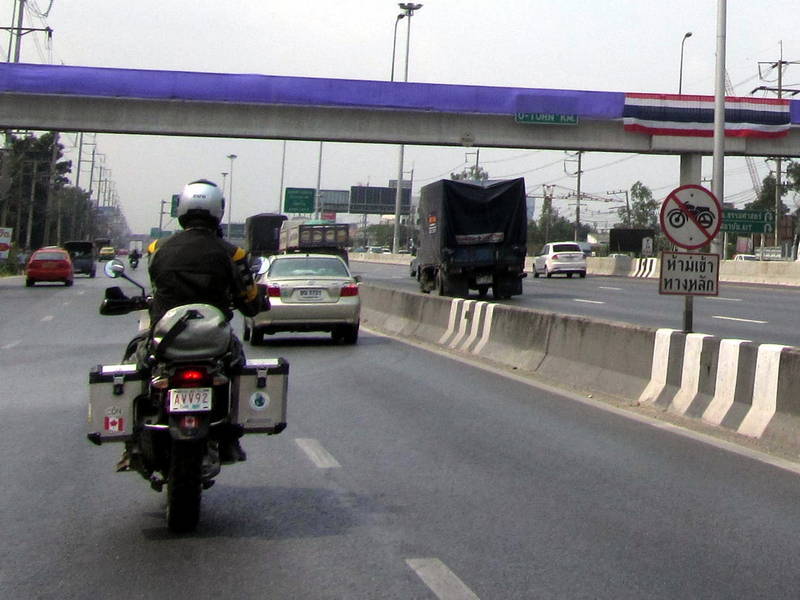
Toll expressway above, free expressway below and motorbikes allowed only on the frontage road
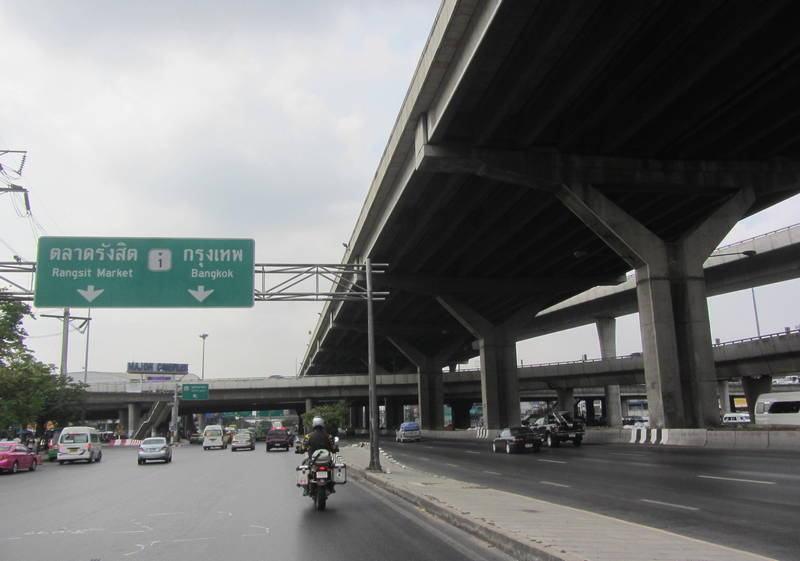
The Viva Garden is just a block away from a stop on the Bangkok Skytrain (no, I don't know if Bangkok or Vancouver used the name first) so it was easy to jump on a train towards the National Stadium where we could transfer and take another line to the Grand Palace. That plan went awry when we went for a walk around the station and saw that Jim Thompson House was just down the block. We had wanted to visit this museum anyway so decided to forego the palace for the moment. Jim Thompson worked for the OSS (precursor to the CIA) and was stationed in Bangkok after World War II. After his discharge he returned to Thailand and set to revitalizing the Thai silk industry. When the musical "The King and I" used his Thai silk fabrics the company really took off and has been doing very well ever since. Trained as an architect he used his skills to assemble six Thai houses on his estate (mostly from Ayutthaya) into his home, now known as Jim Thompson House. We arranged for a tour of the wonderful home filled with art collected by Mr. Thompson. While the home itself was fascinating the art collection was simply stunning; everything from Belgian glass to Ming dynasty vases to Burmese statues to a dining table once used by King Rama V of Thailand. I loved the quote that during Jim Thompson's heyday you could address a letter to "Jim Thompson, Bangkok" and it would get to him in a city of 3.5 million people. We stopped at the silk shop on the way out but everything seemed to be at Western prices (2300 baht or $75 for a tie for example) so we gave it a pass. Walking back to the Skytrain station a fellow started chatting with us and we discovered he had a Harley Davidson Sportster as well as a BMW R1200GS. This was the third person that had randomly approached us and started a conversation and not one of them wanted to sell us anything, simply to say hello and welcome us. Truly amazing in a city of 8 million people. We walked through a couple of high end fashion malls adjacent to the train station and then rode the rails back to the Viva Garden and its refreshing pool.
Jim Thompson house with silk displays
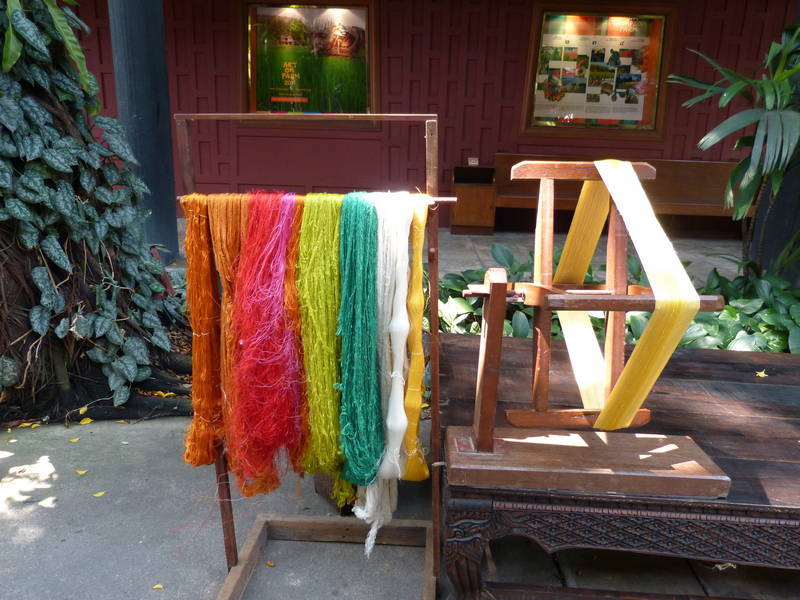
Are those plastic silk worms or real?
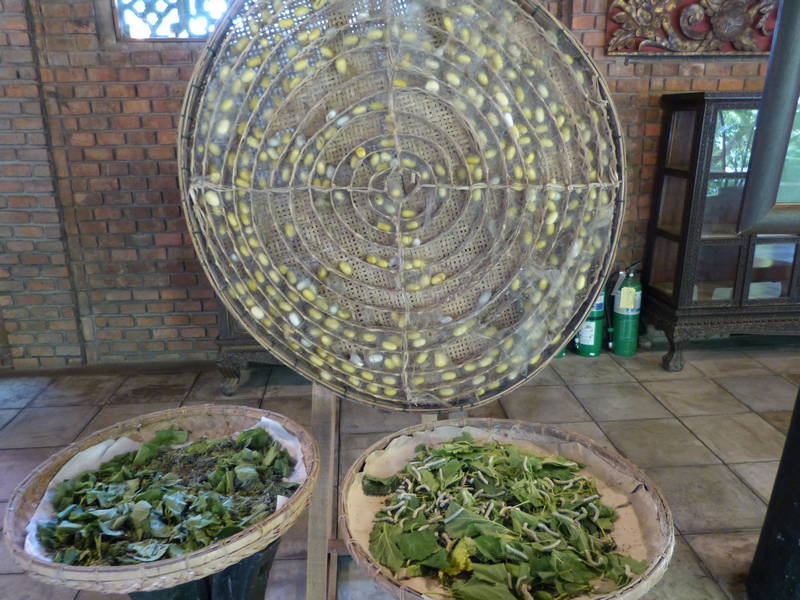
Jim Thompson assembled six historic buildings and created his home from them

We had arranged to get the F650GS serviced at BKK Motorrad on Friday and after a quick Skype call to my folks, I stripped the side bags off the bike and rode over there while Audrey went to a nearby clinic to get her blood check done. It was certainly much easier manoeuvring the narrow bike, without its saddlebags, through Bangkok's notorious traffic than the enormous Adventure. I was able to work on the website while waiting for the bike to be serviced so it was fairly productive time. In the early afternoon the service was completed and at 6500 baht ($225) it was about the same price as a similar service at home. I rode home in somewhat heavier traffic. As the cars queued up a few blocks before my planned turn at Sukhumvit Road I noticed that the scooters were headed for the sidewalk. Why not? I tucked in behind a scooter and thought to myself, "If you don't like my driving, stay off the sidewalk!" A couple of bollards on the sidewalk were probably intended to stop this activity but the F650 without the bags squeezed through when I moved my legs out of the way and I kept up with the scooters. Still it was a hot ride and I appreciated the refreshing dip in the pool when I got back. Audrey also had some good news in that the levels of anticoagulants in her blood were at the correct level. This called for a celebration and the Pizza Hut down the block didn't disappoint. Over the weekend we did some more sightseeing, including the postponed visit to the Grand Palace.
Along to the Chao Phraya is lots of evidence of Bangkok's historic power
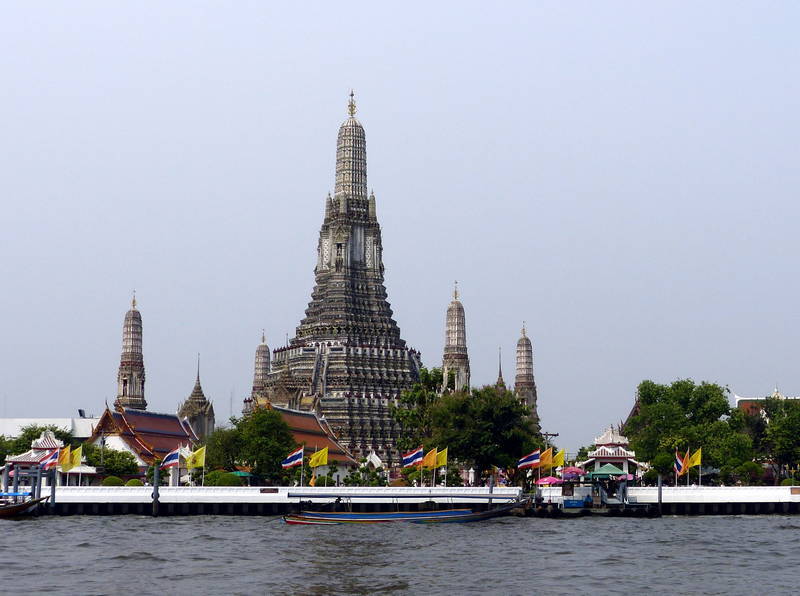
On the way into the palace we noticed this sign. Presumably it is OK to trust non-wily strangers?
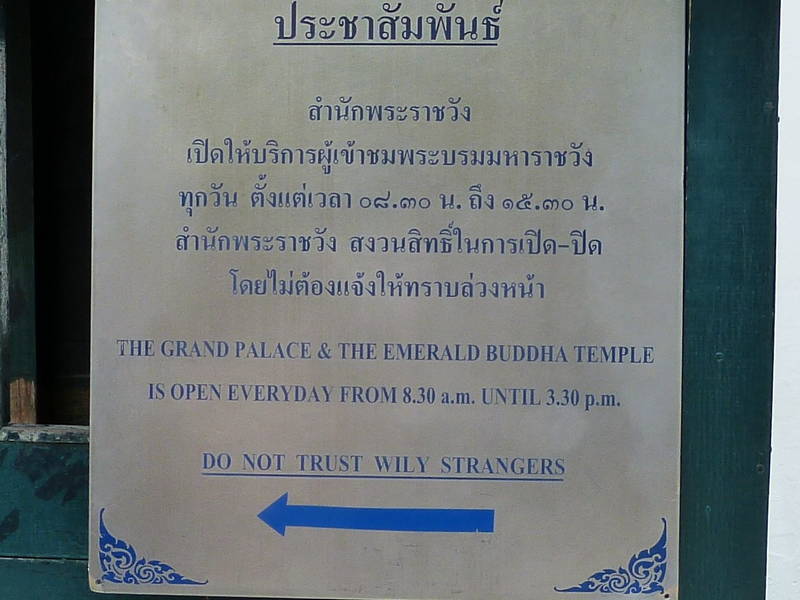
Exploring the amazing Grand Palace in Bangkok
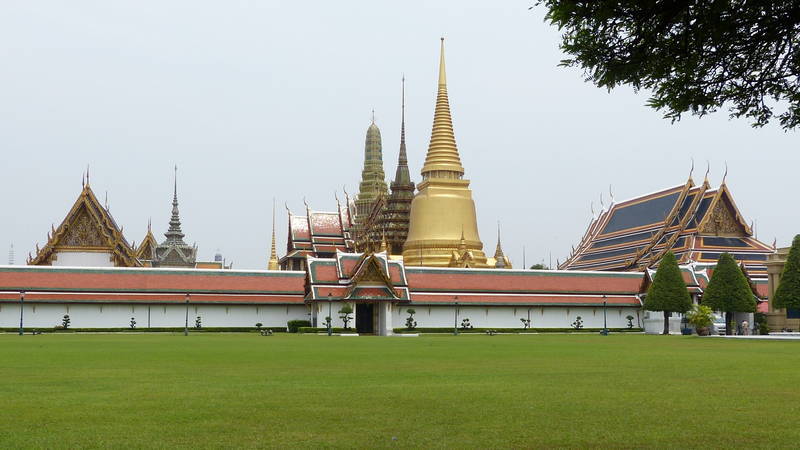
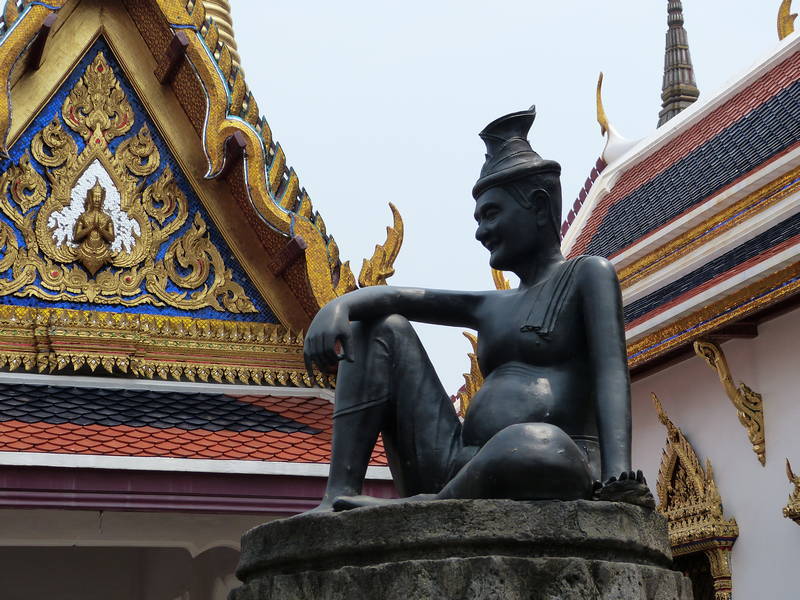
Whoa
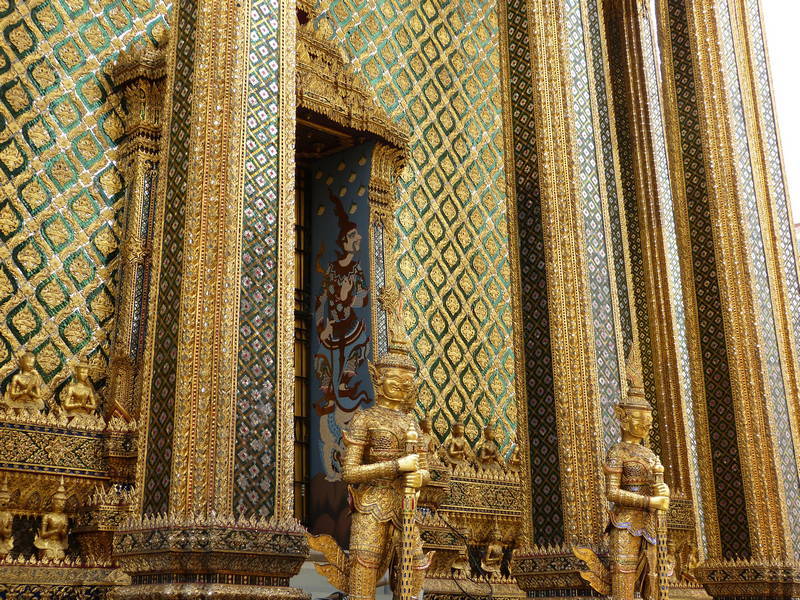
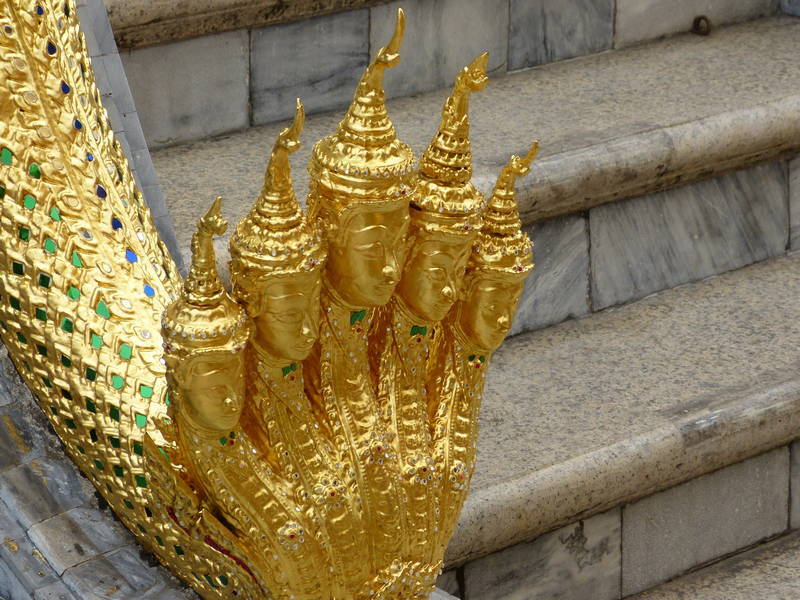
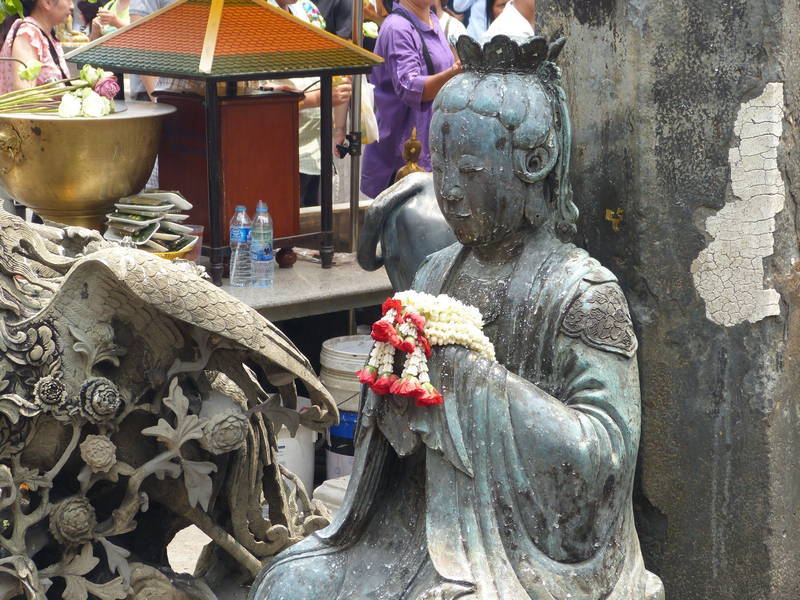
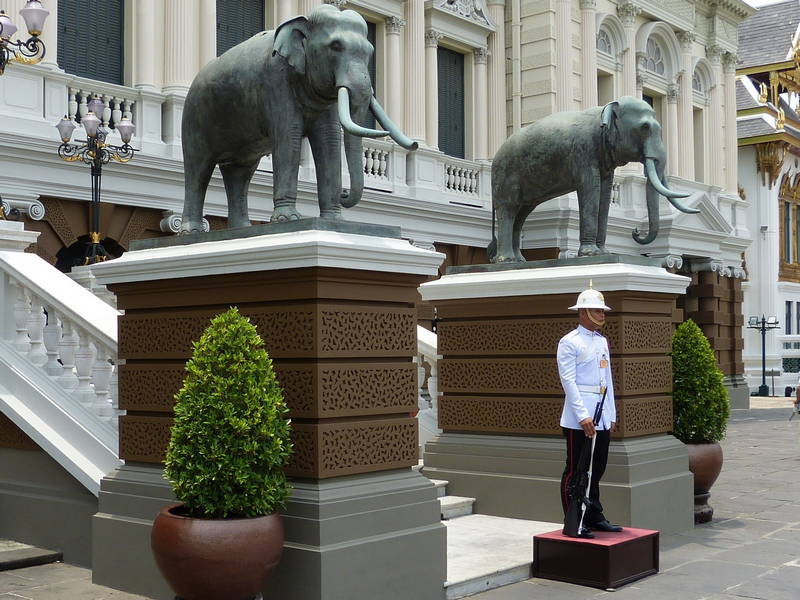

The Grand Palace itself
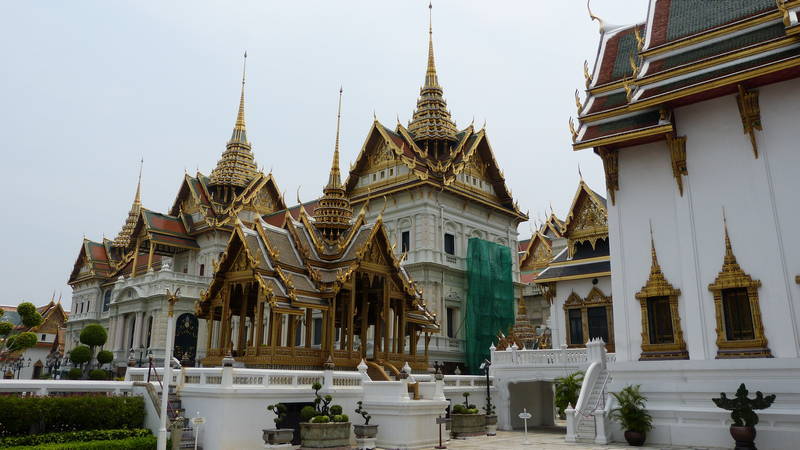
On Tuesday, April 9, we had an easy ride over to the general area where P.T. Air Cargo was located according to the GPS coordinates we had obtained. From there it was a bit trickier as there seemed to be a number of business parks in the area. We rode around to a few locations and asked a few random people and eventually we had a security guard point us in the right direction, but only when we saw someone waving from a doorway did we know we were in the right spot. The whole park seemed to be a live/work area where apartments were above the offices. Ratchaneewan invited us in for a drink of water and we used the opportunity to change out of sweaty motorcycle clothes. Then we rode about 5 kilometres to the warehouse where the motorcycles would be crated. Audrey took our motorcycle clothes and started drying them out in the blazing sun and I started taking the Adventure apart, trying to make it as small as possible. We used a forklift to raise the front of the bike so that the front wheel could be removed and then it was lowered onto the fork legs. As we started doing the same with the F650 a motorcycle/sidecar combination pulled up. The ice cream bike! A Coke popsicle and an iced coffee made working in the 40 degree heat a bit more bearable. After about three hours we had the bikes down as small as they would go and packed our gear tightly around them. On Wednesday the packing company would build the crates and then an accurate cost for shipping (based on weight and volume) could be calculated. Back at the office we gave Ratchaneewan the carnet de passages as well as the Thai import and conveyance documents for her to process. She then had one of her colleagues give us a ride to the nearest Skytrain station and, after stopping at the Thaya Praya station for lunch, we made it back to the hotel at 4:30.
Getting ready to make the motorbikes as small as possible at Meechai Packing
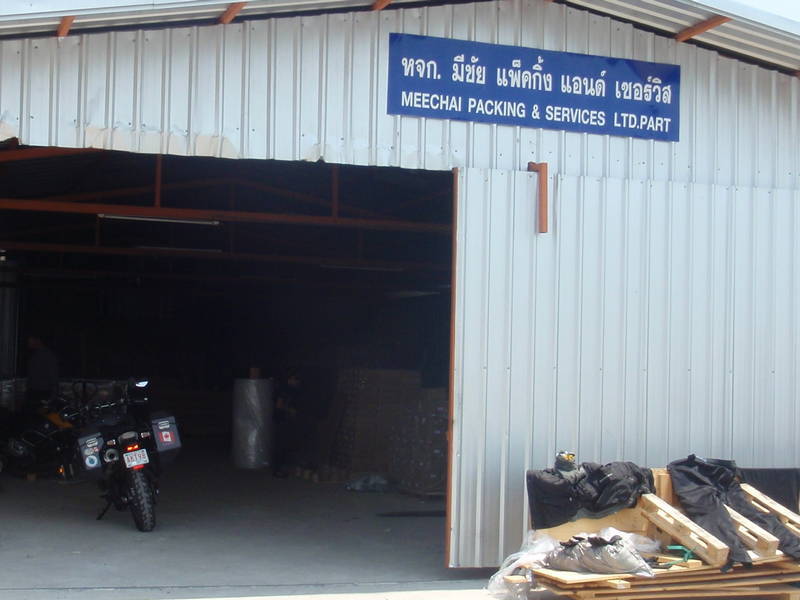
A forklift comes in handy to remove the front wheel
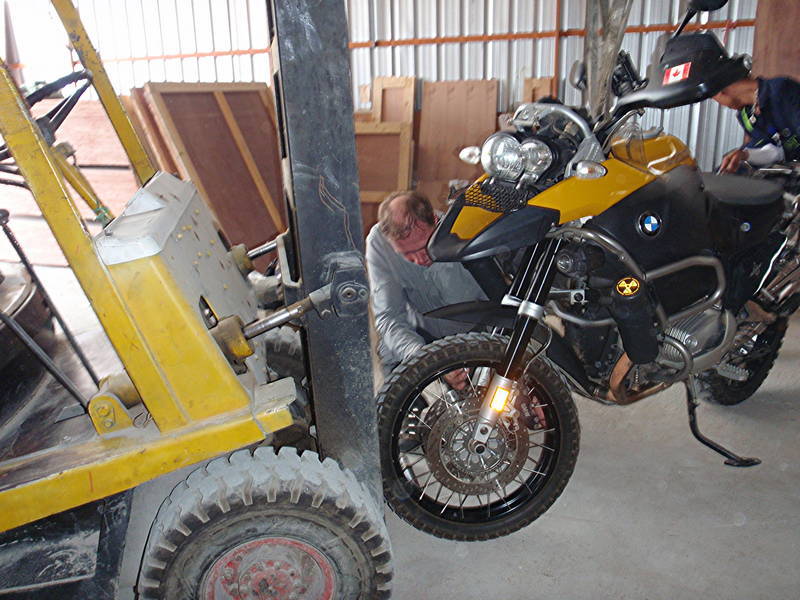
One bike ready to be crated
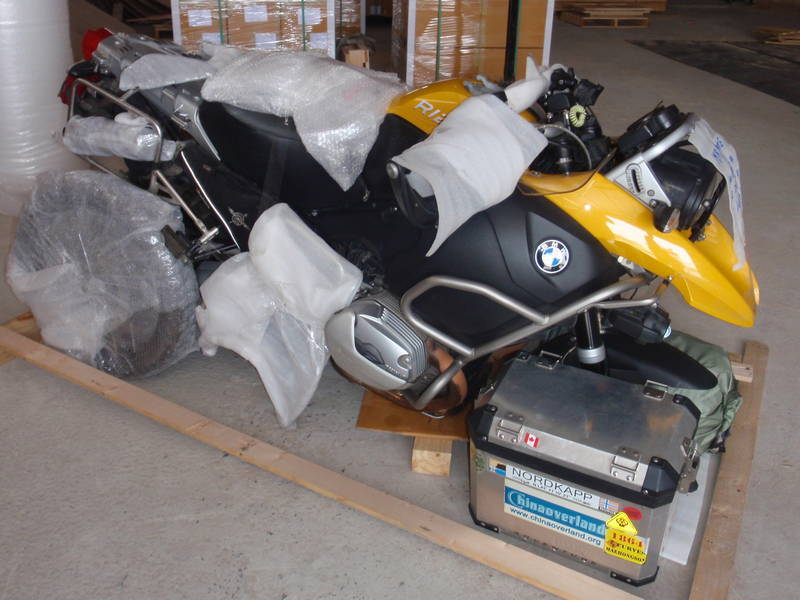
Hooray! The iced coffee motorbike is here!

Both bikes ready to be put into crates

It has always felt a bit strange to be without the motorcycles when on a motorcycle journey like ours. Our bikes are part of our identity and when they're taken away we aren't the same people, maybe not quite as special anymore. So it was that on Wednesday, after working on the website in the morning, we headed out for some sightseeing as regular tourists, not motorcyclists. We took the Skytrain to the Chao Phraya River and bought tickets on a tourist sightseeing boat. The boat cruised up the river with a running commentary and stopped at various piers that had access to tourist attractions. We hopped off at the Tha Thien pier and walked to Wat Pho where the famous reclining Buddha was located. This Buddha was huge at 46 metres long. Further down the road was the Museum of Siam which had great interactive displays on the history of Thailand. In the "War Room" Audrey fired a cannon in a simulated battle for Ayutthaya (defending against the Burmese) and I explored the growth of Thailand from city-state to nationhood in the "Map Room." It was again the convoluted journey via tourist boat and Skytrain back to the Viva Garden, stopping off at the Siam Paragon shopping centre for dinner. There was lots of choice when it came to restaurants but the MOS Burger caught our eye. It was one of our favourite burger places from Japan.
Cruising the Chao Phraya

Audrey hopes that we aren't on the Titanic

While the captain is amused
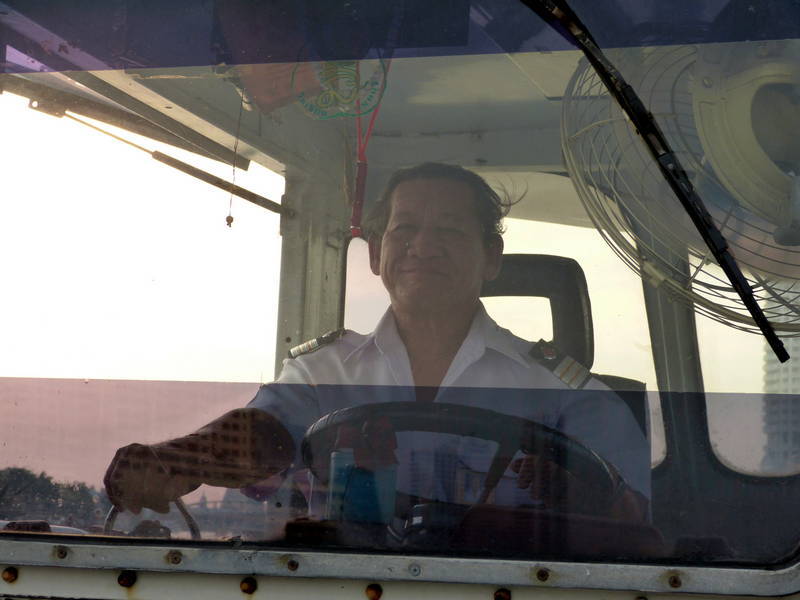
Exploring temples
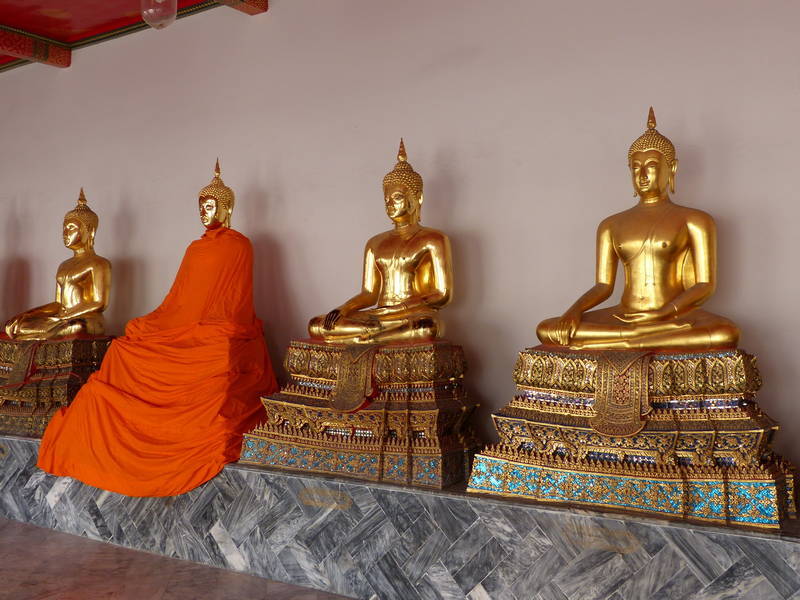

Defending Ayutthaya agains the Burmese

Who's Audrey with?
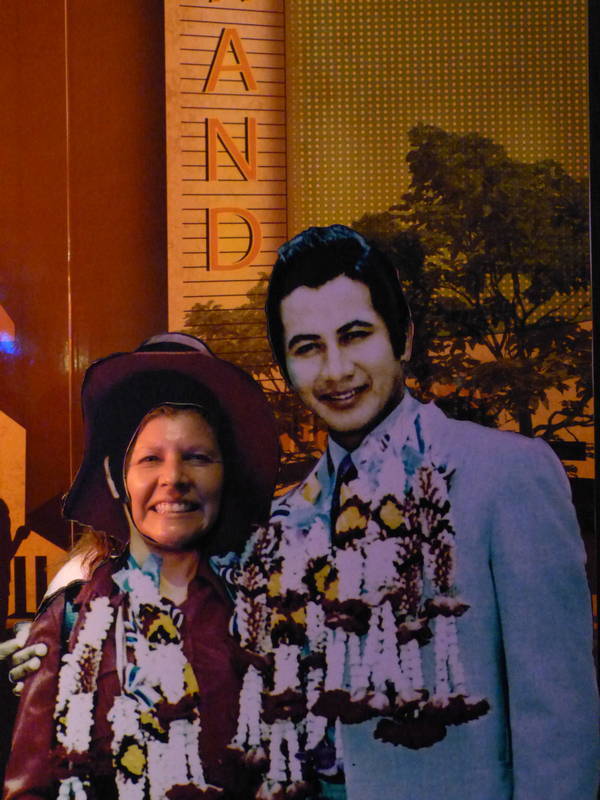
Delicious memories of Japan
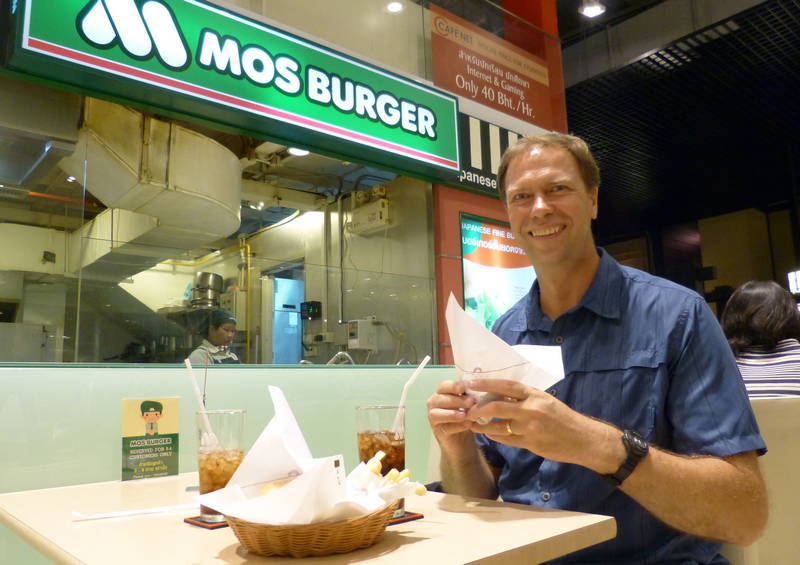
Thursday was a special morning for us. We took the last of the Malarone tablets as we were no longer in a Malarial area (Bangkok) and would soon be heading for Turkey. Hoorah! We had also received the quote from P.T. Air Cargo for the cost of shipping the bikes to Istanbul and it was 200,000 baht (about $6,500). We made arrangements to come up to the office and pay on Friday. Since the company only took cash we had to go to a bank and get a cash advance on MasterCard. At a Japanese mall (all familiar Japanese clothing stores and restaurants) we found a bank that would do the cash advance but only up to a maximum of 100,000 baht. And the largest bills of Thai baht are 1,000 baht notes. So we got 100 bills, stuffed them into a backpack and then went to another bank in the hopes that they could give us another 100,000 baht. No such luck, it was a daily limit imposed by MasterCard. We took out the maximum daily limit at the bank machine and determined we would have to go to a bank on the way out to the P.T. Air Cargo office on Friday morning to pick up the remainder. After stopping off at Tesco for grocery shopping we walked back to the hotel in a light rain. Soon that turned to a tropical downpour that soaked us almost as quickly as standing near Victoria Falls had done five years before (click here).
The last of the anti-malarial pills, hurrah!
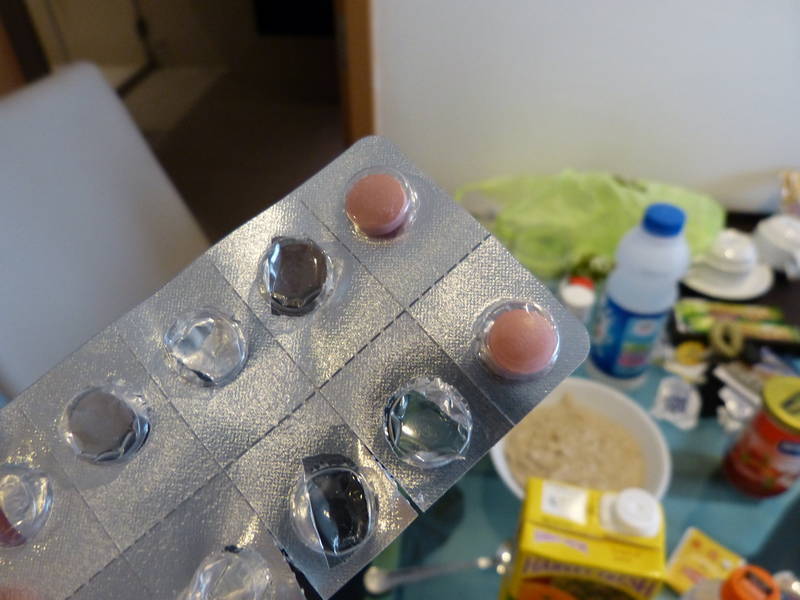
A tropical downpour

Our appointment to meet P.T. Air Cargo was at 11:00 so allowing for at least an hour's travel time on the Skytrain with its transfers we thought that going to a bank at 9:00 would leave plenty of time. Too bad the SCB bank near the hotel didn't open until 11:00. We hopped on the train and went up to Siam Center but the malls there didn't open until 10:00. We finally found a bank on the street that opened at 9:30 but they didn't do cash advances. On to another bank that opened at 10:00 and crossed our fingers that we would be able to get cash there. Yes! Back to the train and then after a couple of transfers we were at the station where we were to meet Ratchaneewan at a couple of minutes after 11:00. We kept an eye open for her green Nissan March (and saw a few of them) and she pulled up a few minutes later. Rather than driving back to the office, Ratchaneewan suggested we pay up right there in the car. I must say it did feel a bit gangsterish to be handing over 200 1,000 baht notes in the back of a car with tinted windows. It was convenient though since we could catch the next train back into Bangkok after our transaction was complete. We tried going to the National Museum but it was closed for the holidays (Songkran) so we wandered around China town and had a late lunch before heading back to the hotel via a large, gold Buddha statue.
Monk priority seating on the Skytrain

Saturday was our last full day in S.E. Asia and we made it a good one. The hotel provided us with a "Songkran kit" which consisted of a water pistol (!) and a waterproof pouch for a wallet and then we went out on the town. First, we had wanted to visit the famous floating market. It seemed easy enough to get there via the tourist boat we had taken previously. When we got to the docks it turned out to be quite expensive to take a boat tour for 1.5 hours just to visit the market. Since Lonely Planet suggested taking Bus 79 we walked around looking for bus stops having the number 79. Unfortunately we really didn't know where we were so didn't have much of a chance of finding the right bus. We ended up asking a tuk-tuk driver to give us a lift to the nearest bus stop where we just missed a 79. To heck with it, we said, let's catch a cab. OK, that was easier and at 300 baht still less expensive than the 1,500 baht tour boat. When we were dropped off we had to run a gauntlet of water fights on our way in. Perhaps this is a good time to explain what Songkran is about. Songkran is the traditional New Year's celebration, originally based on an astrological calendar but now with fixed dates. One of the more obvious ways to celebrate Songkran is to throw water on others and to smear random strangers with a beige coloured talc powder mixed with water. So we got a little wet on the walk to the floating market, all in good fun though. At the market we browsed around and finally found a table where a kind gentleman made room for us. As I was scrunched up, sitting cross legged at the low table Audrey went around to some of the boats and came back triumphantly carrying fried pork on a stick. Yummy. Then we were able to order a few more items right from the table as a waiter came by. After lunch we again braved the gauntlet and tried to catch the Bus 79. We were lined up with a few other people at the bus stop when a crowd of spectators redirected us to the correct side of the street. It was a crowded bus that arrived and as we stood in the aisle we tried to see where we were. At one point we crossed a bridge and it seemed like it was near a spot that the tour boat had stopped so we took a chance and jumped off the bus at the next stop, right into a very busy market. It was incredibly hectic as the crowds pushed and pulled us along, all the while getting soaked by water pistols (water cannons really) and getting our faces smeared with talc. We had to refill our tiny water pistols a couple of times but did manage to soak a few people as we worked our way back to the boat docks. Out of the crowds we were able to relax for a few minutes on a bench and dry out a little before catching the tour boat and then the Skytrain back to the Viva Garden. What a crazy holiday, and so much fun. If you ever have the opportunity to be in Thailand for Songkran make sure you go!
Ekke is ready for Songkran
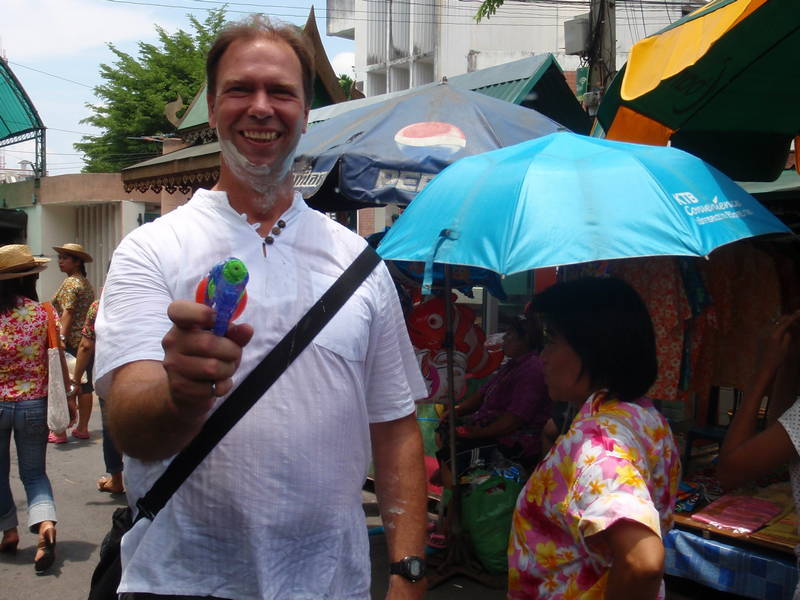
Giving water to the monks for blessing

Floating market for lunch
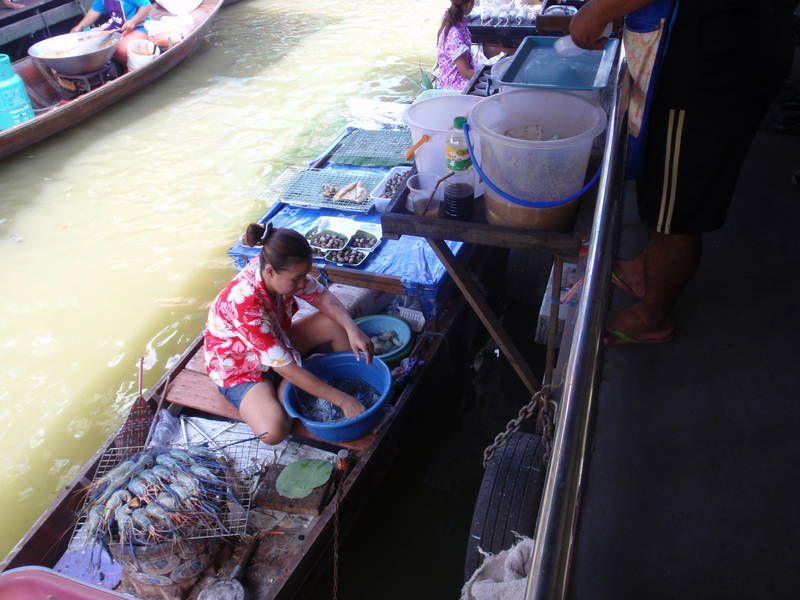
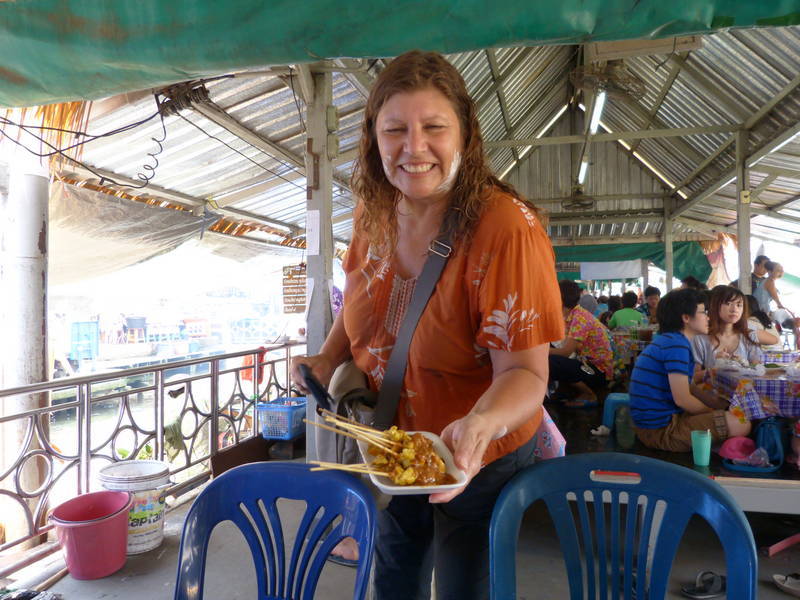
Now that's fresh
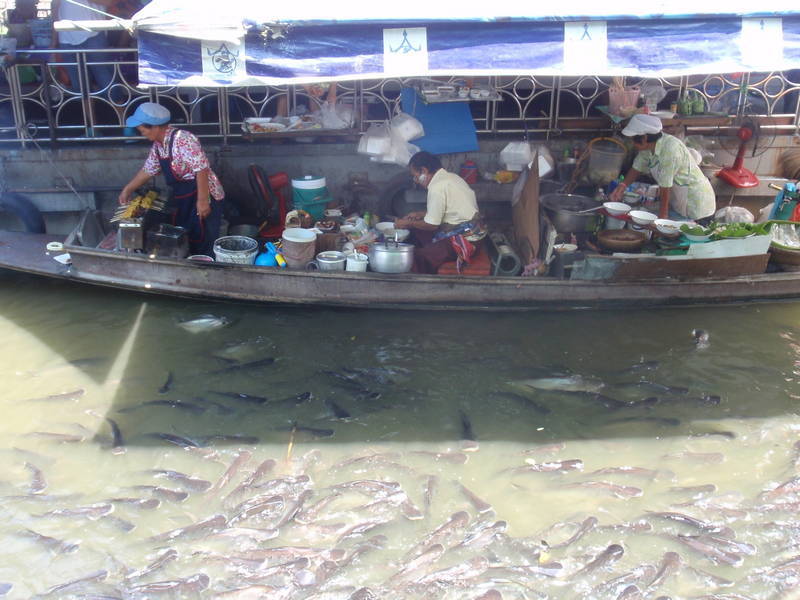
Of course, Songkran is the traditional time to bring out the dragster
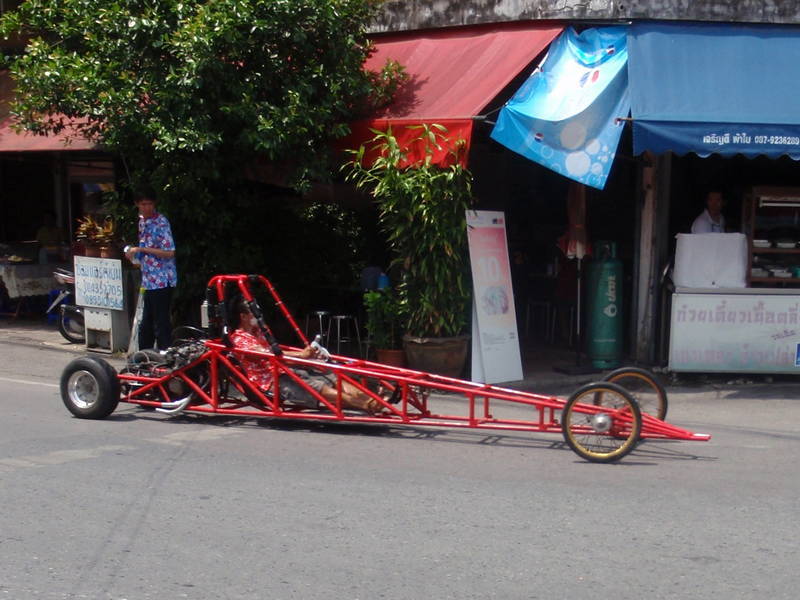
Arguably the most fun festival in the world
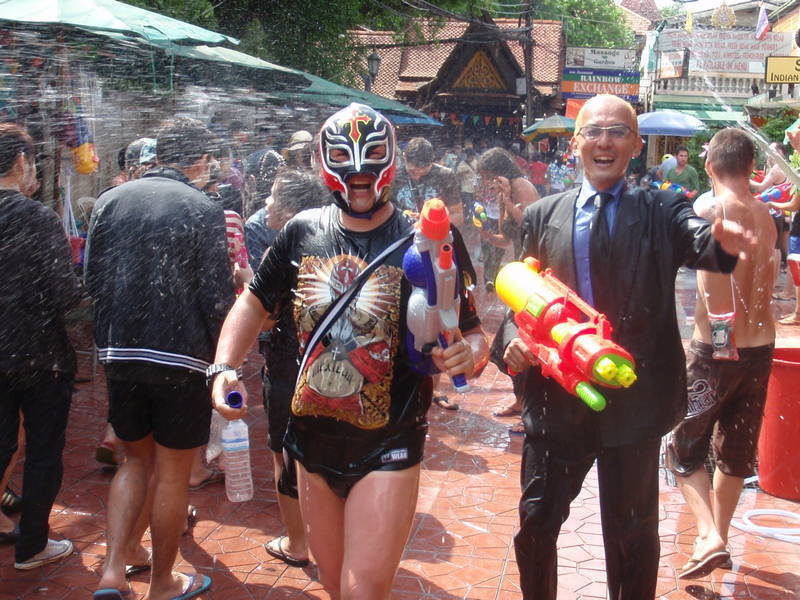
Audrey reloads and gets ready to re-enter the fray

A break to dry off a little
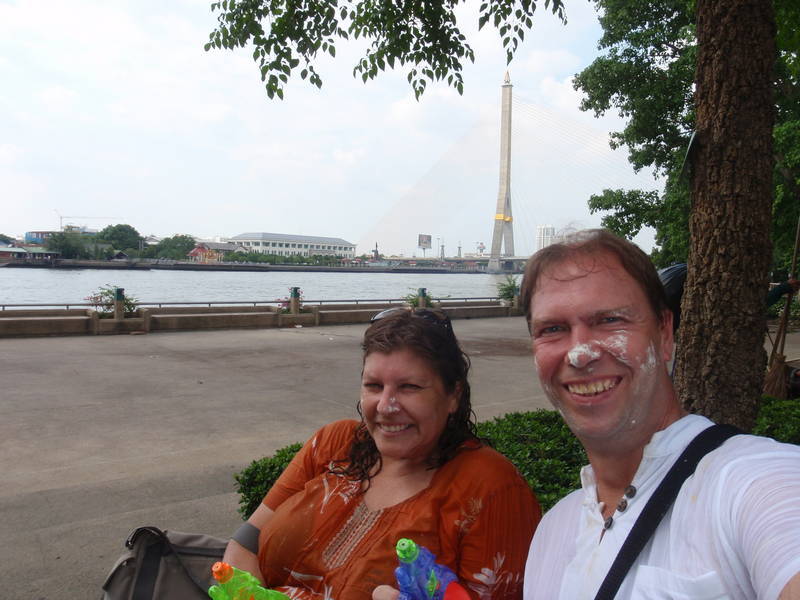
Looking down from the Skytrain station on the Songkran festivities
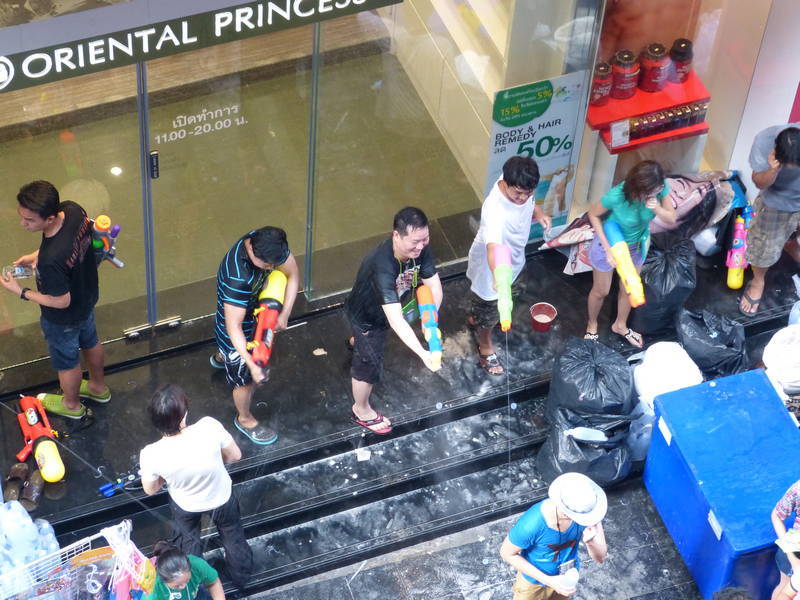
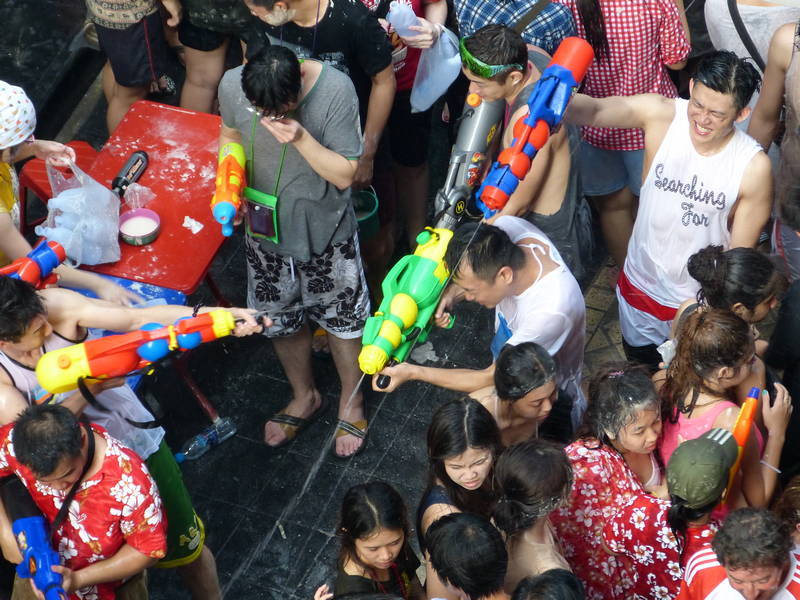
We had thrown everything into the laundry on Saturday evening after Songkran so were all packed and ready to go on Sunday morning. An early Sunday morning cab ride was an eye opening experience for us in Bangkok. No traffic! We were at the airport very quickly with lots of time left to check in, exchange our last remaining baht for Turkish lira and then get on the Qatar Air flight to Doha. We had had an amazing time in S.E. Asia, made all the more fun for having ridden our own motorcycles here. The people were so friendly everywhere we went, the food was delicious and it was almost unbelievable what great accommodation was available for such reasonable prices. I hope we can return.
Stop over in Doha before continuing on to Istanbul

Map of our route through Thailand

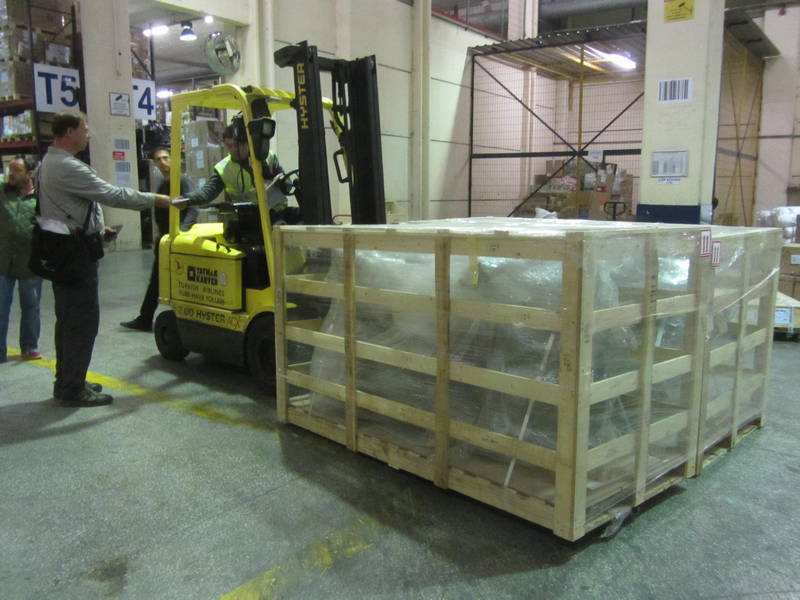
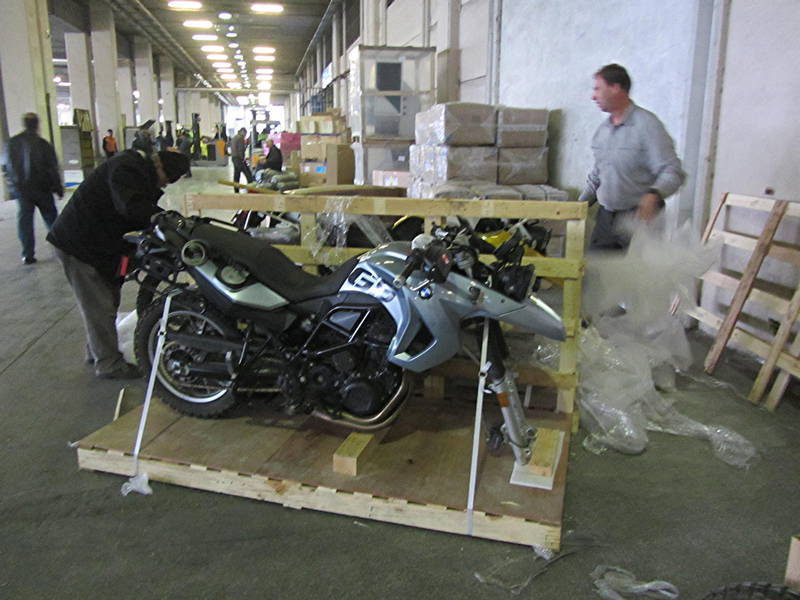
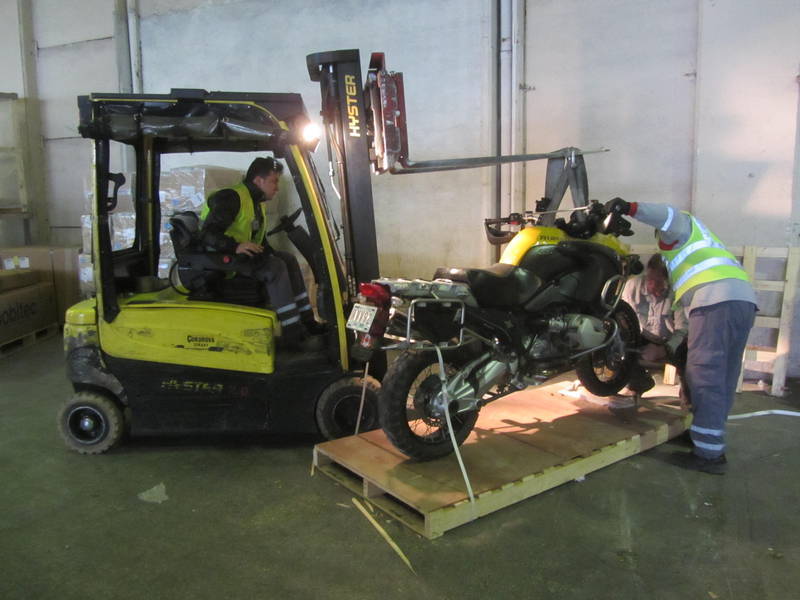
The Blue Mosque

Hagia Sophia

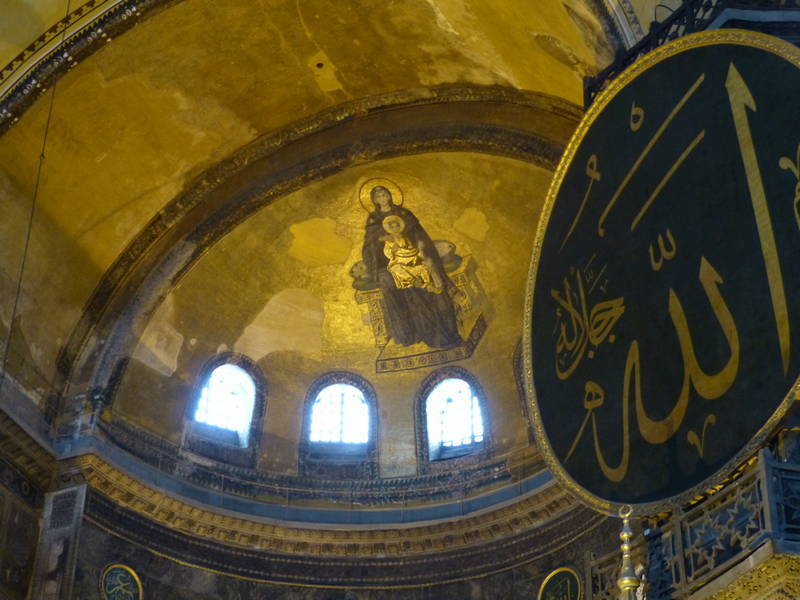
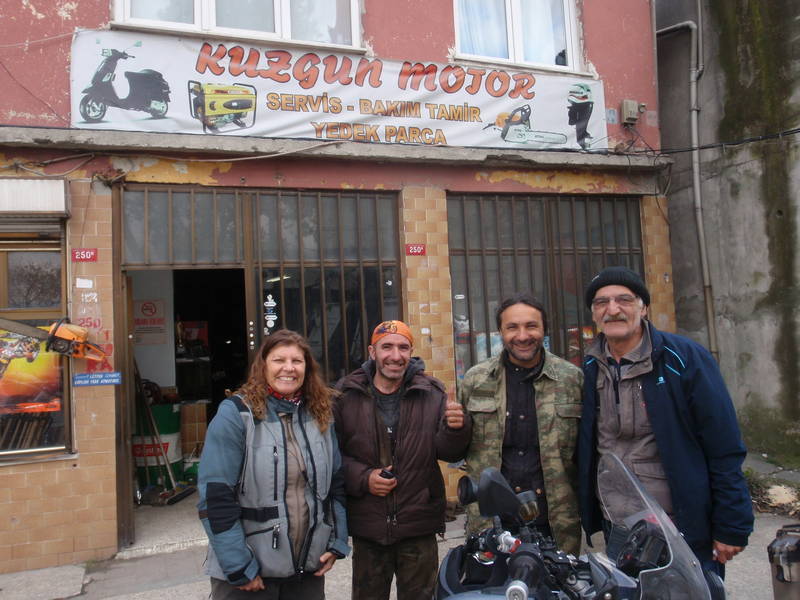
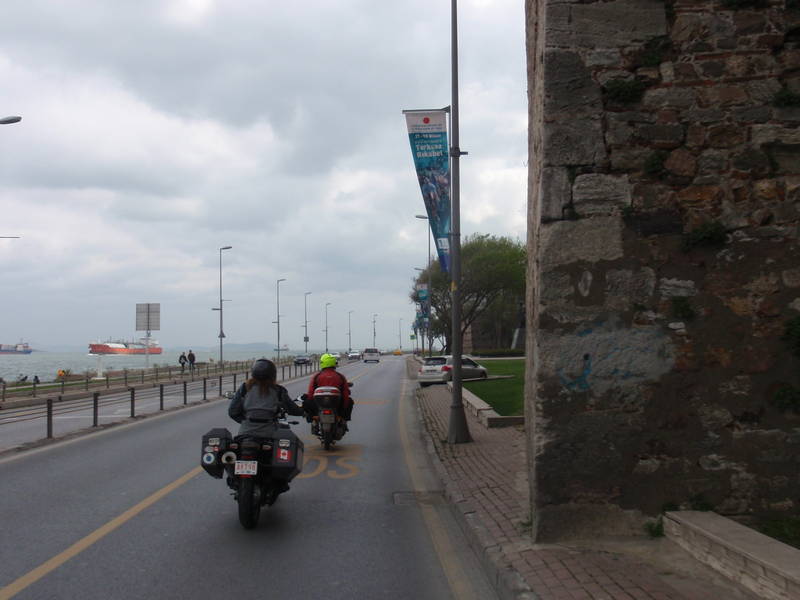
New Tires

Visiting the Blue Mosque with Slobodan
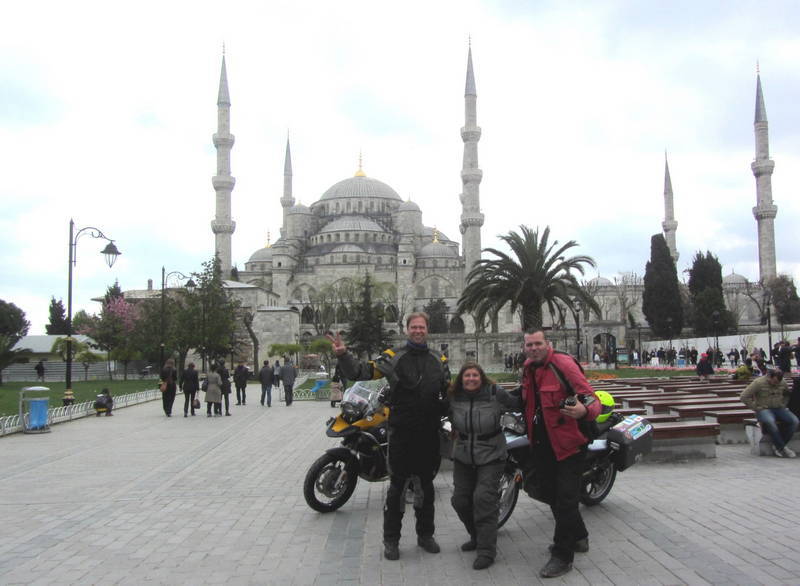

The ferry to Galipoli

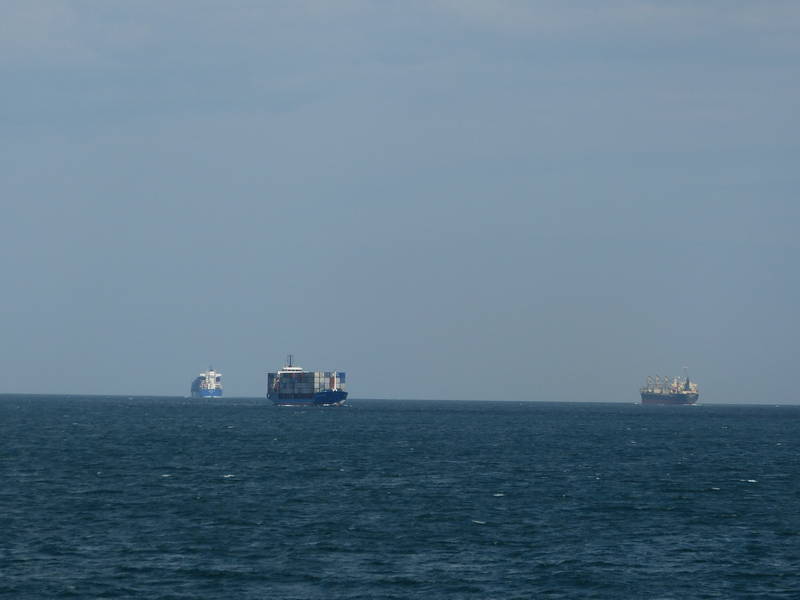
Troy
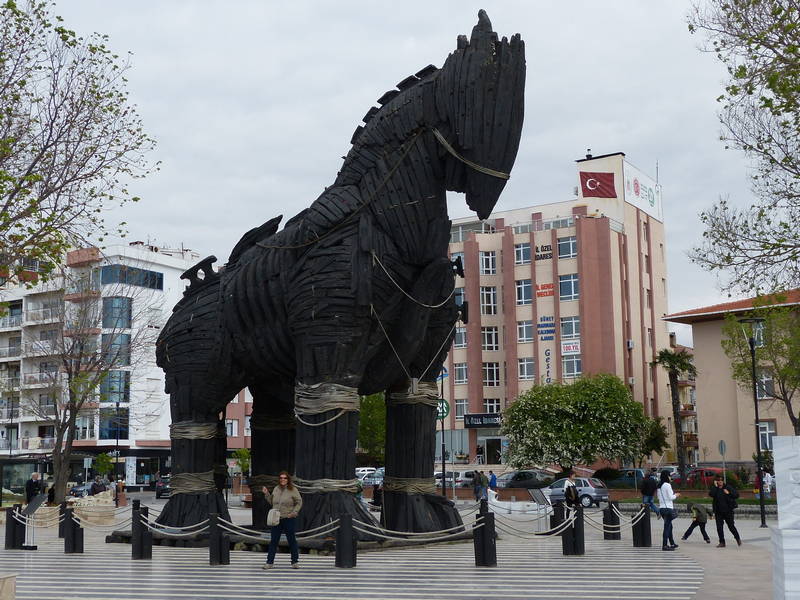
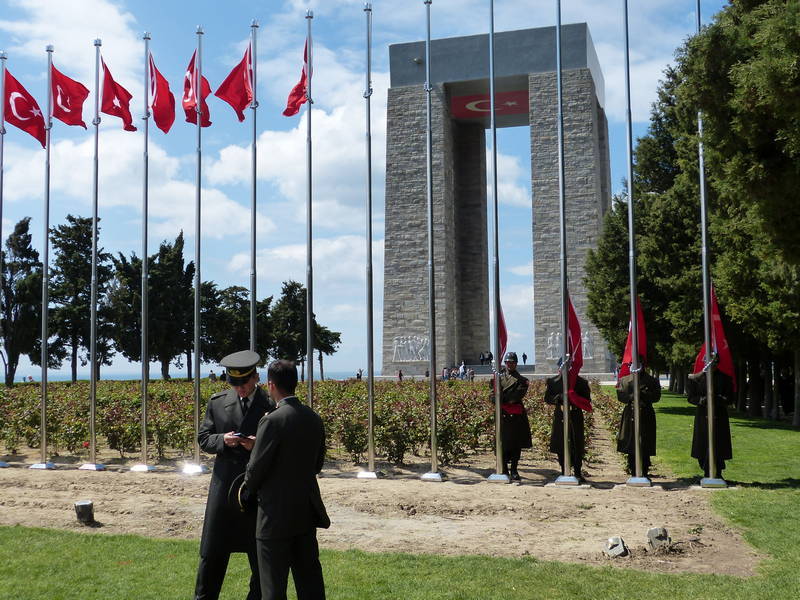
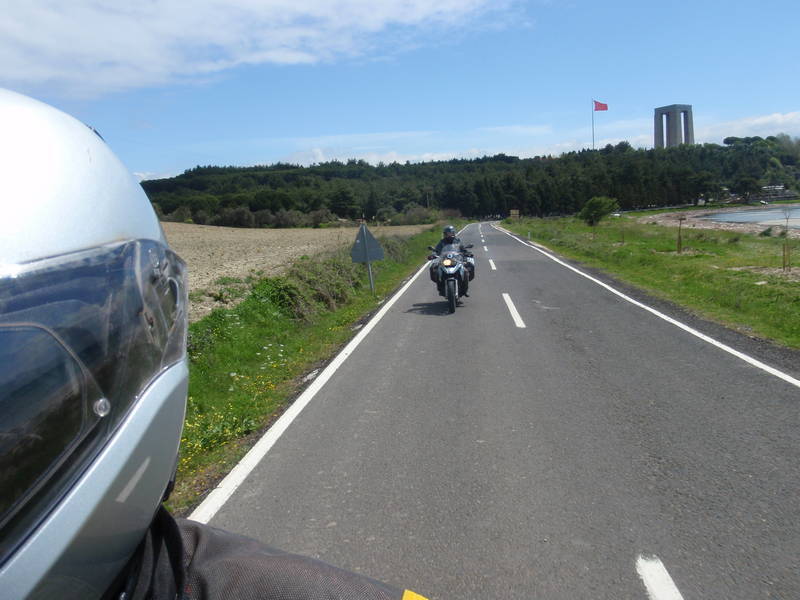
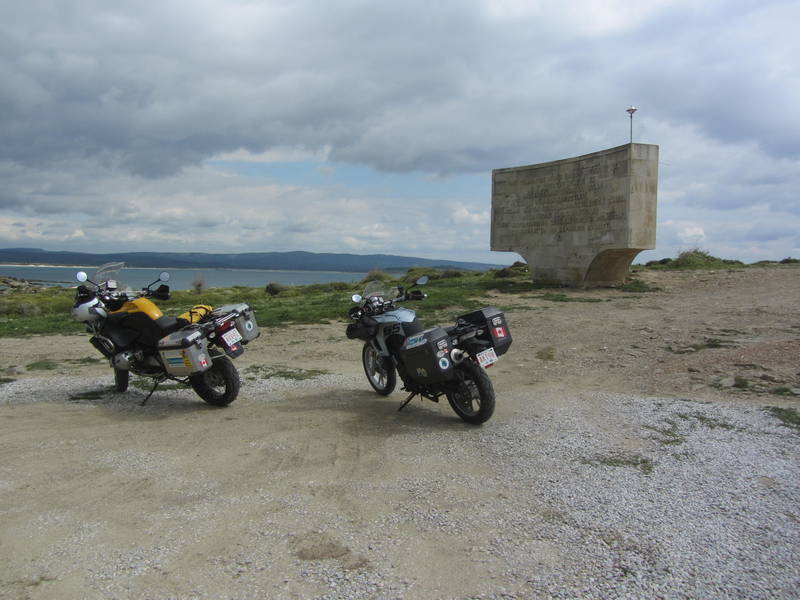

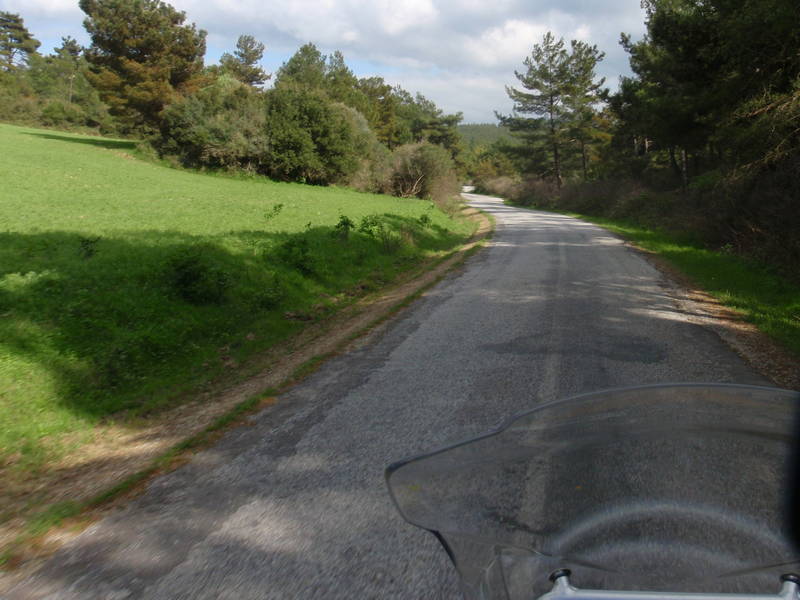
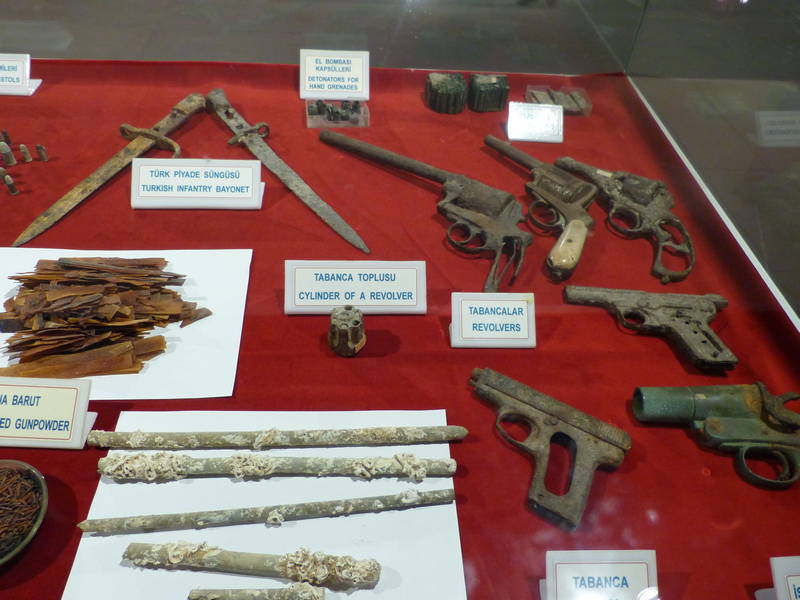

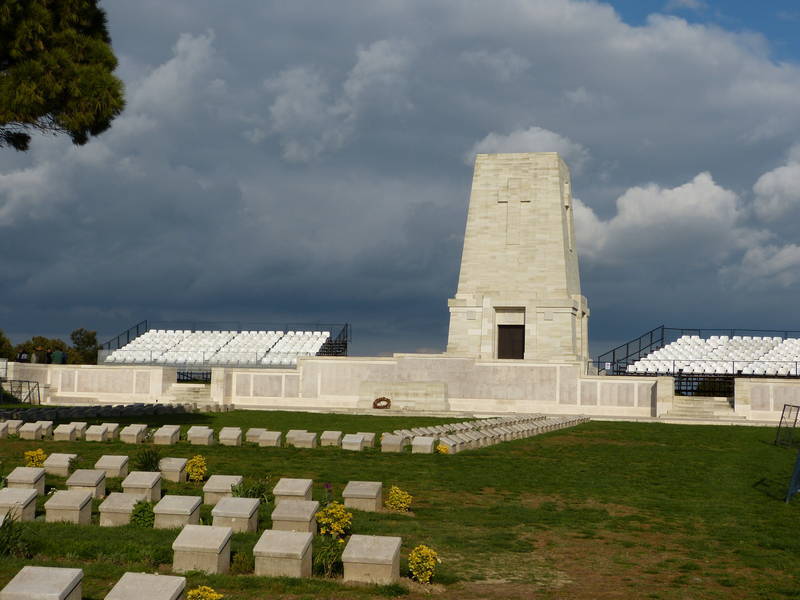
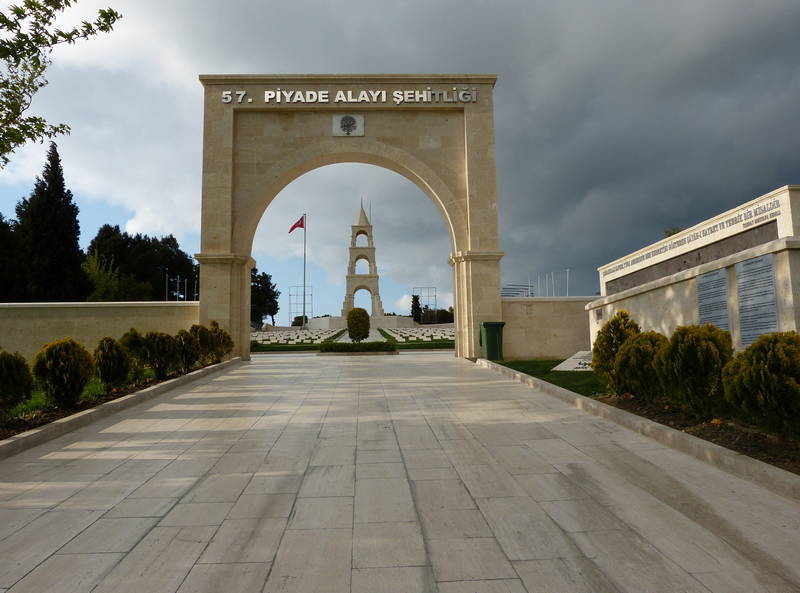

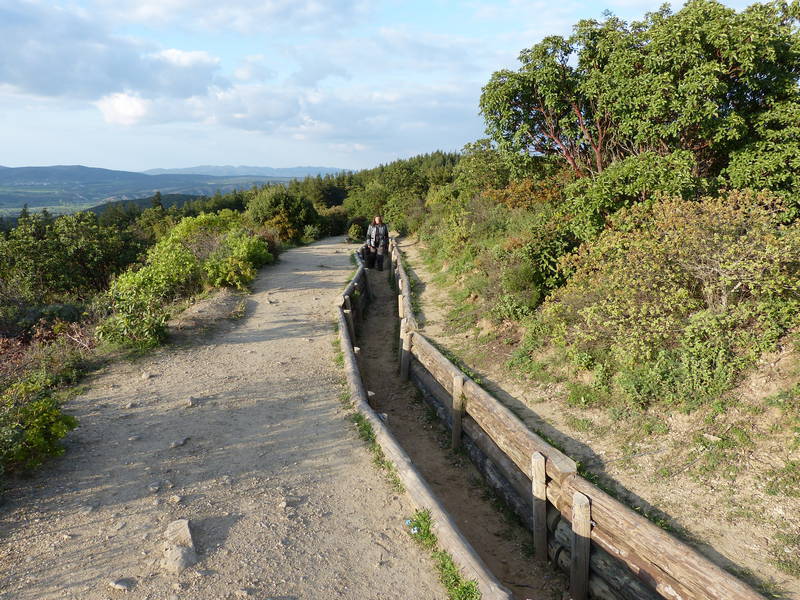

A Future BMW Rider
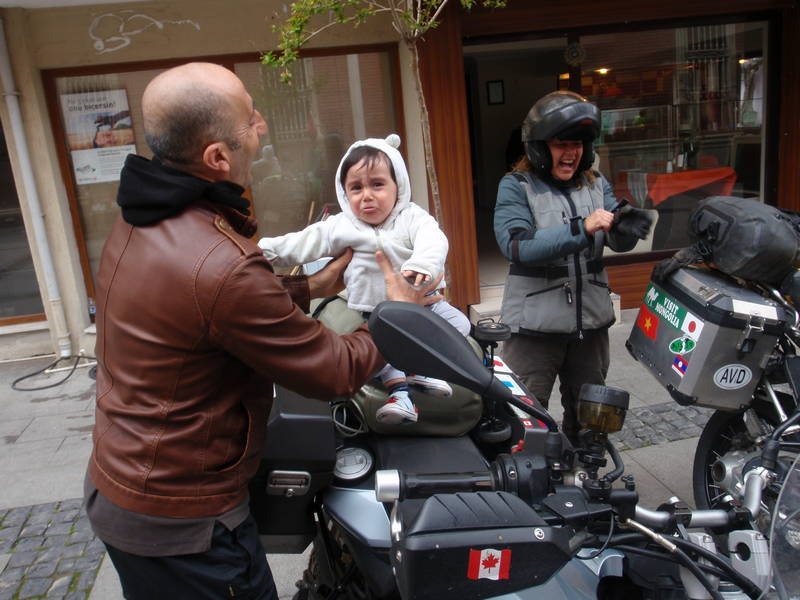
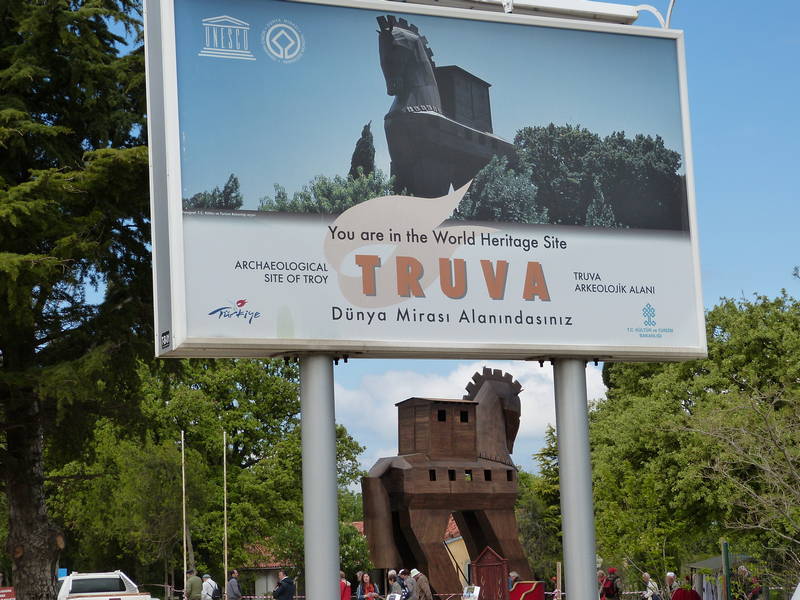


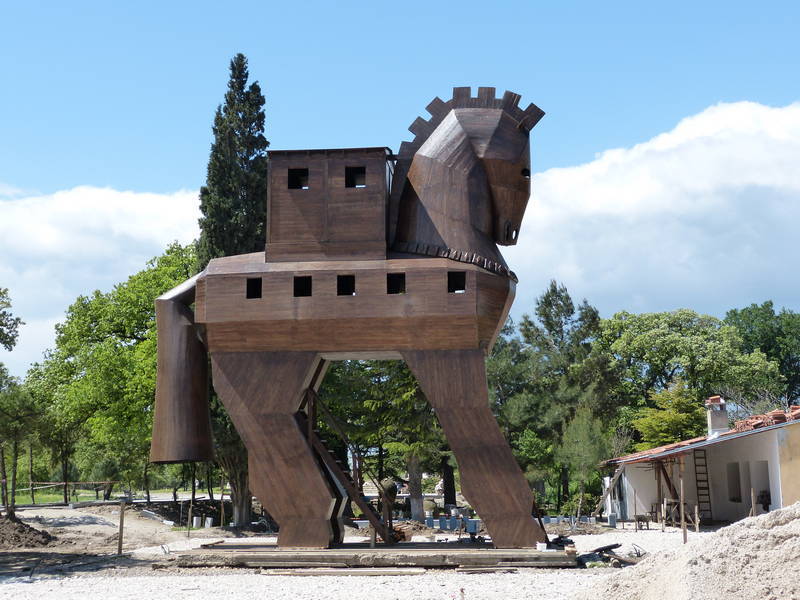

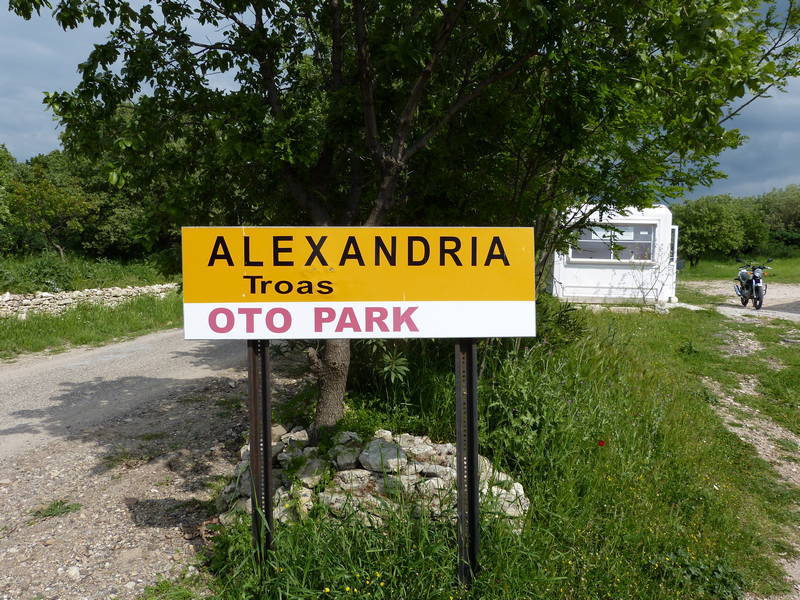
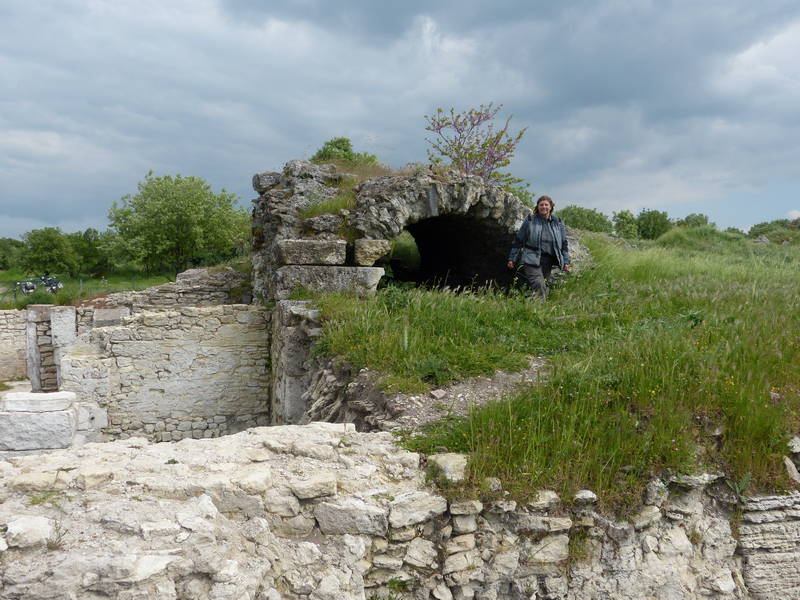
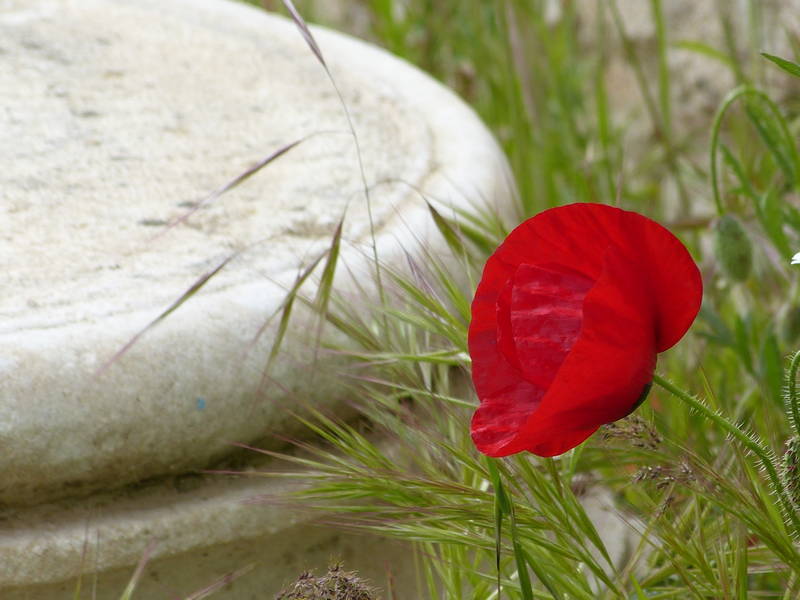
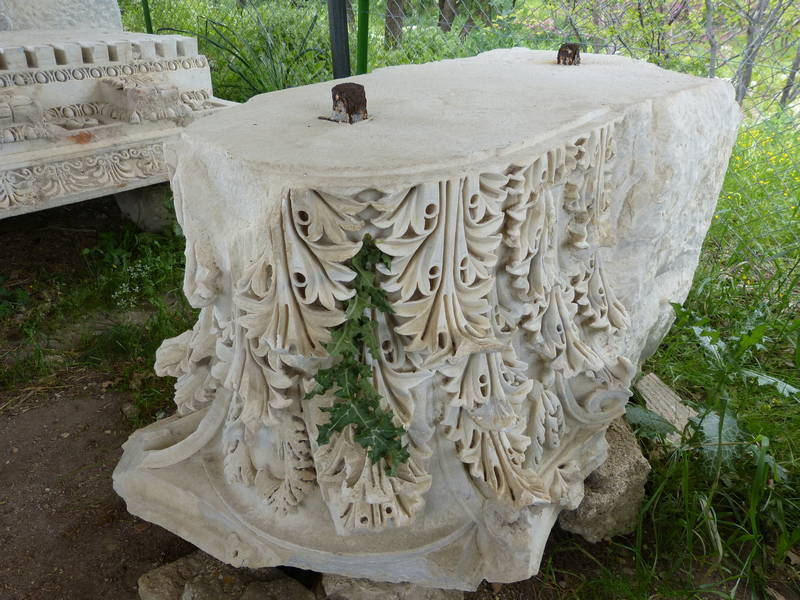
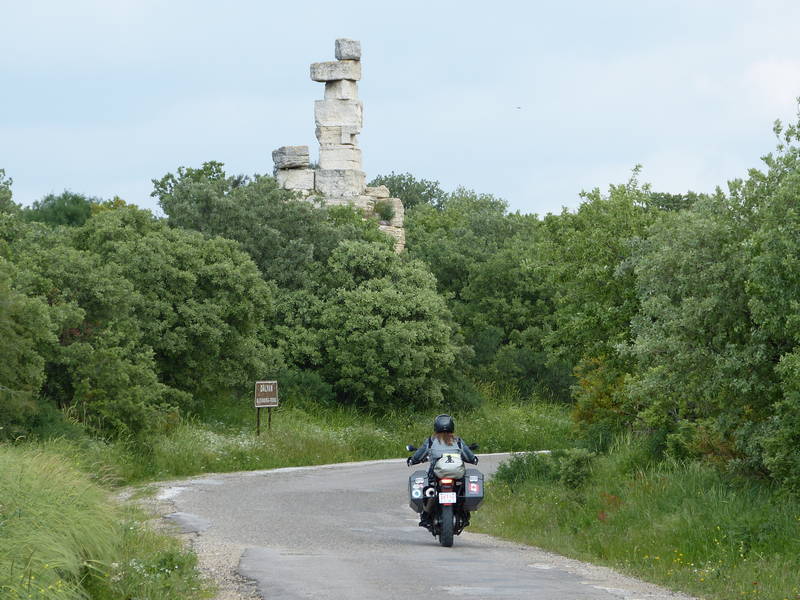

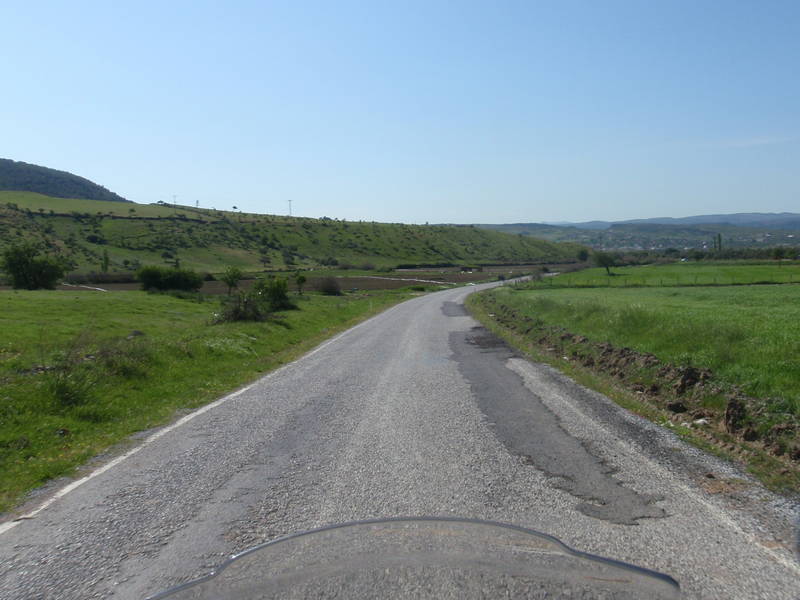
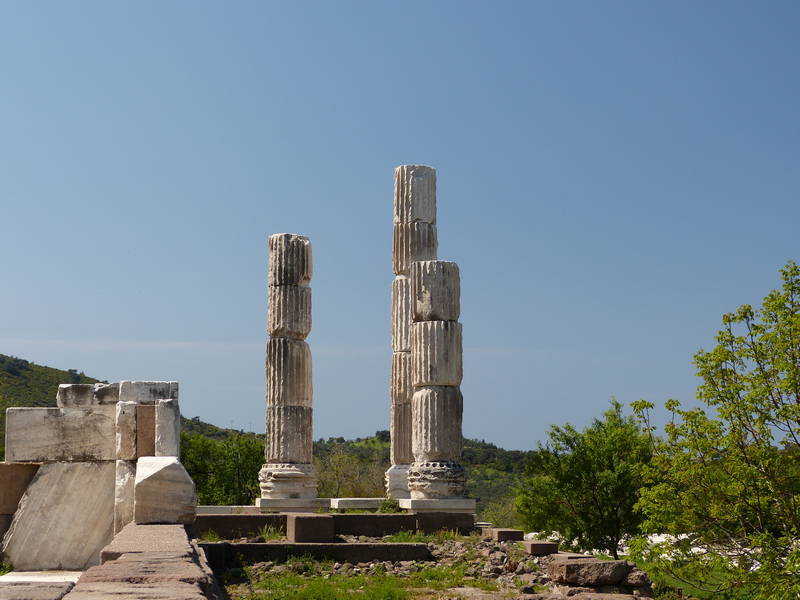

The westernmost point of Turkey
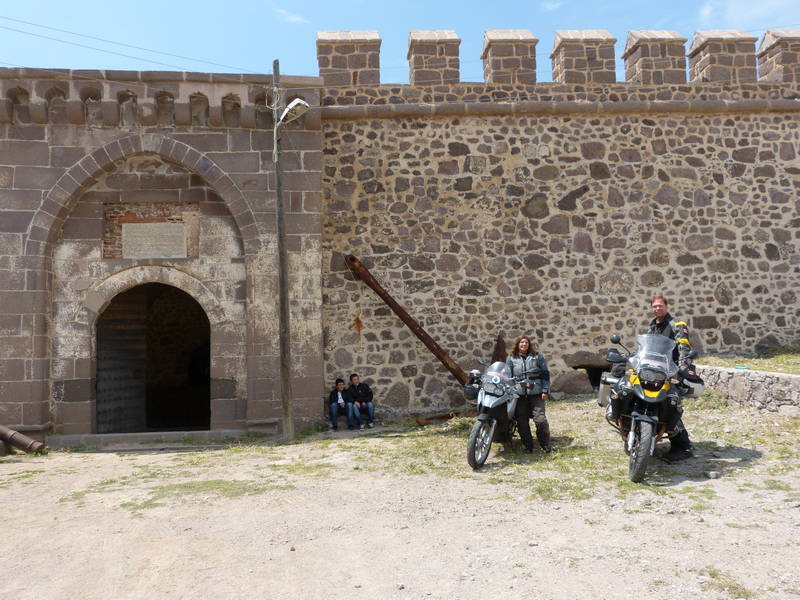
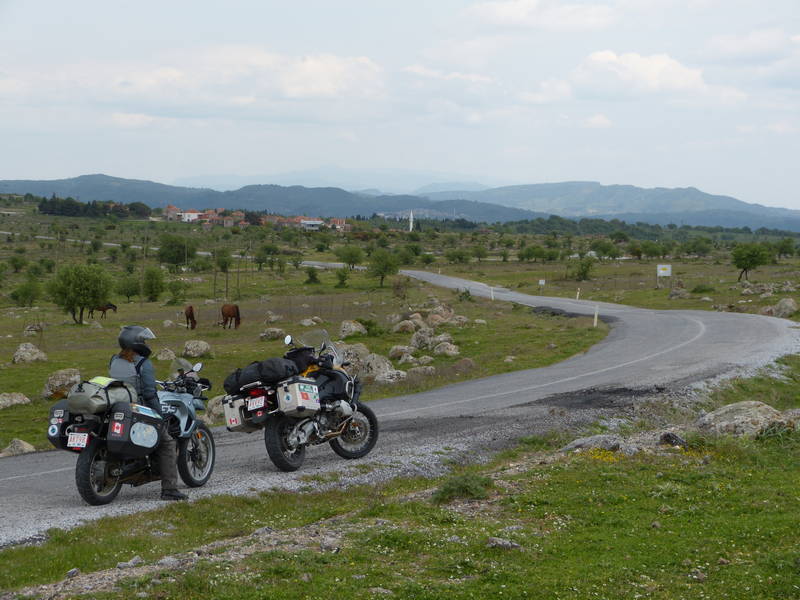
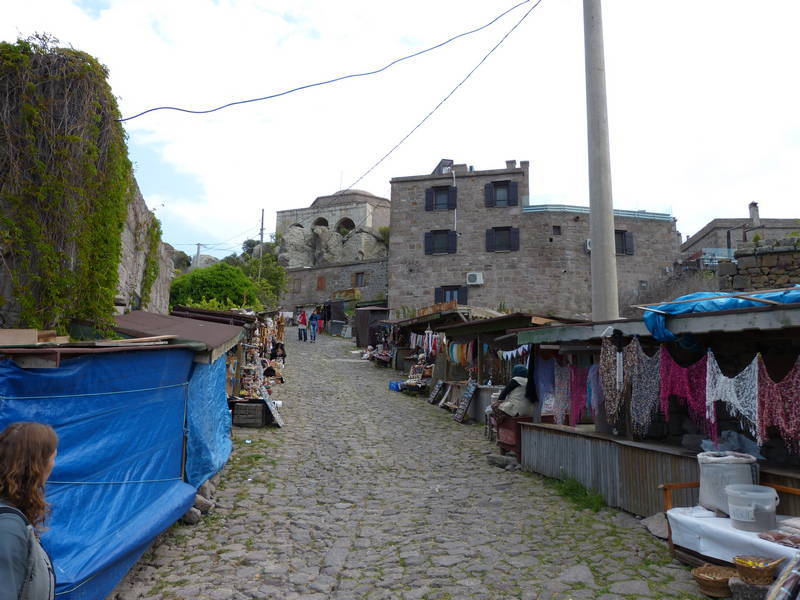
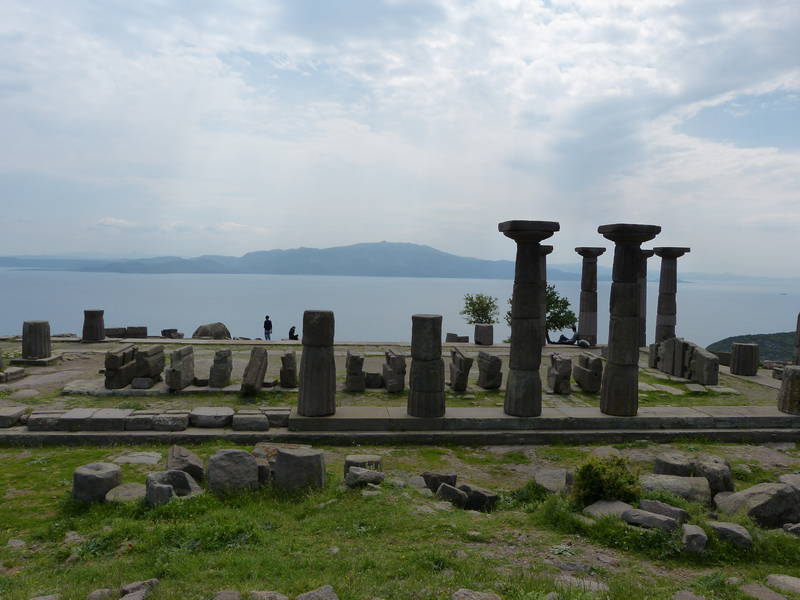

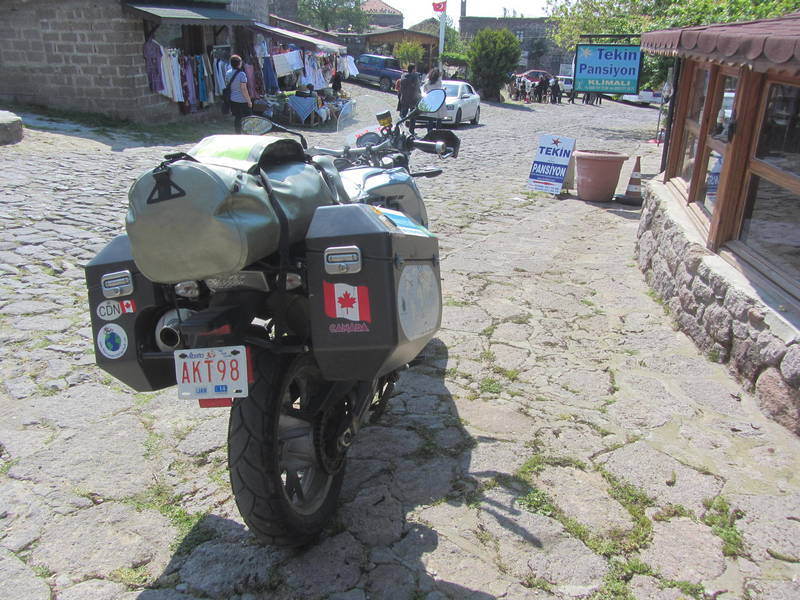

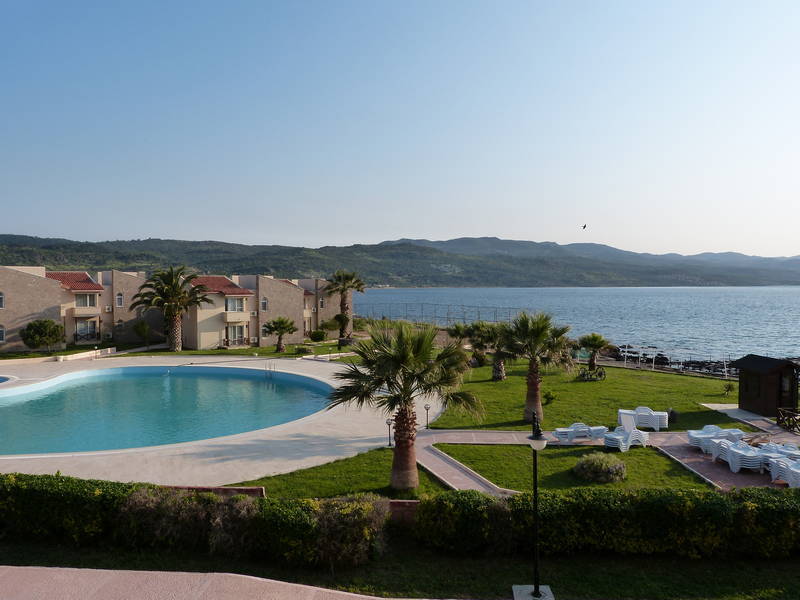
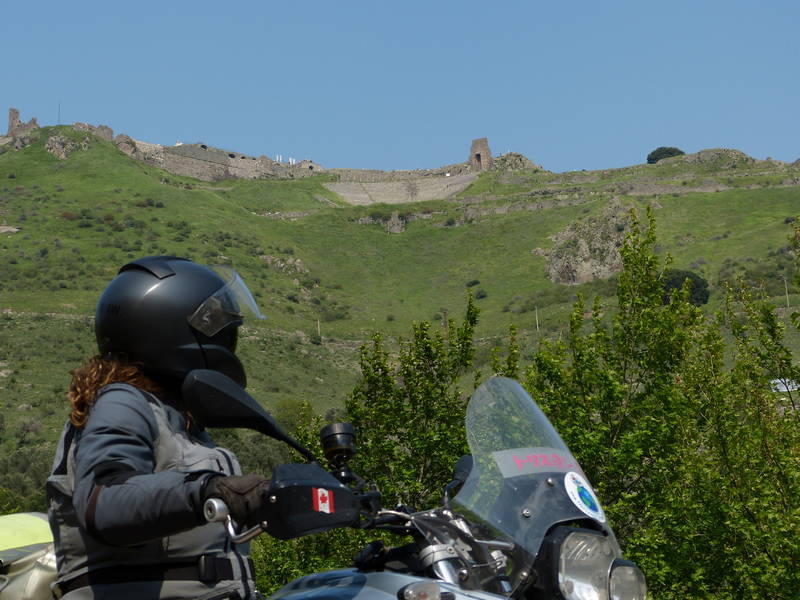
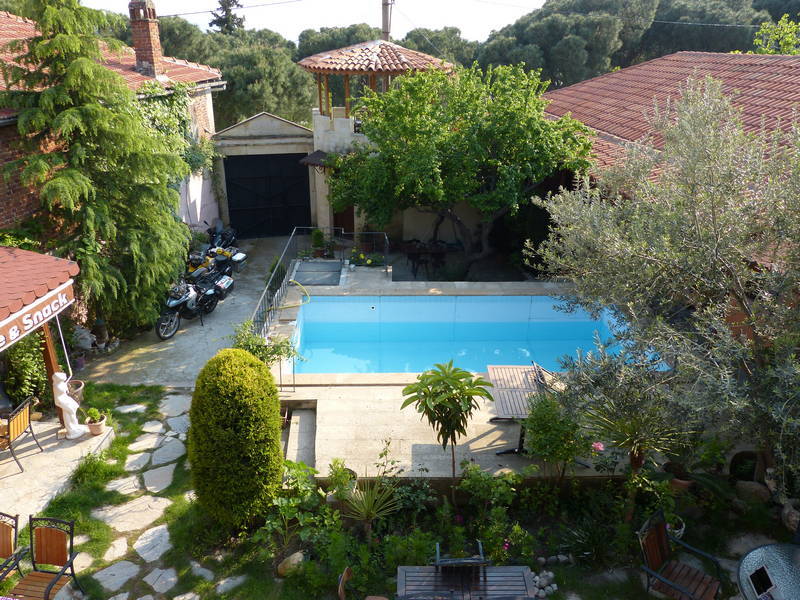
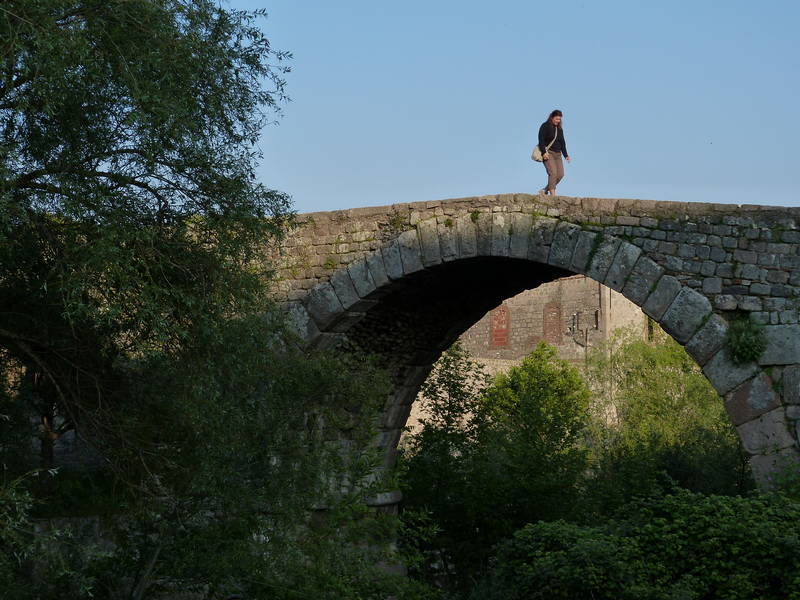
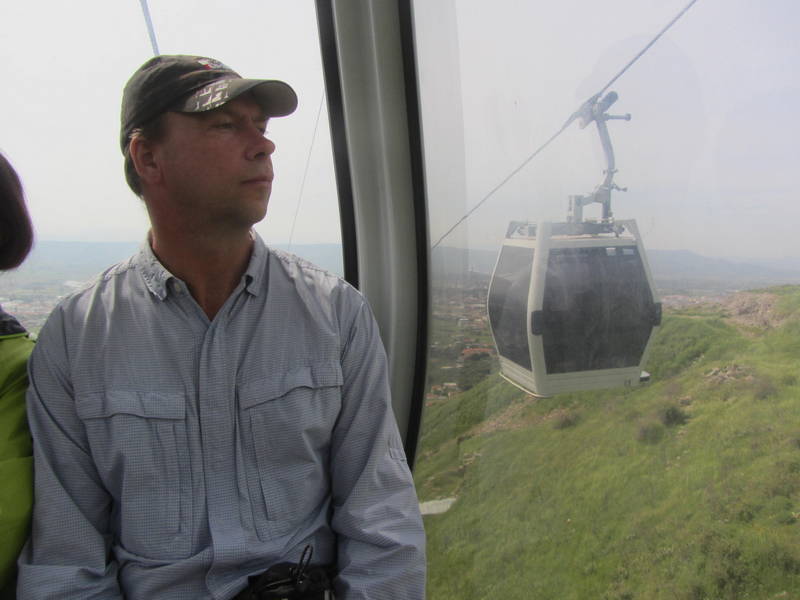

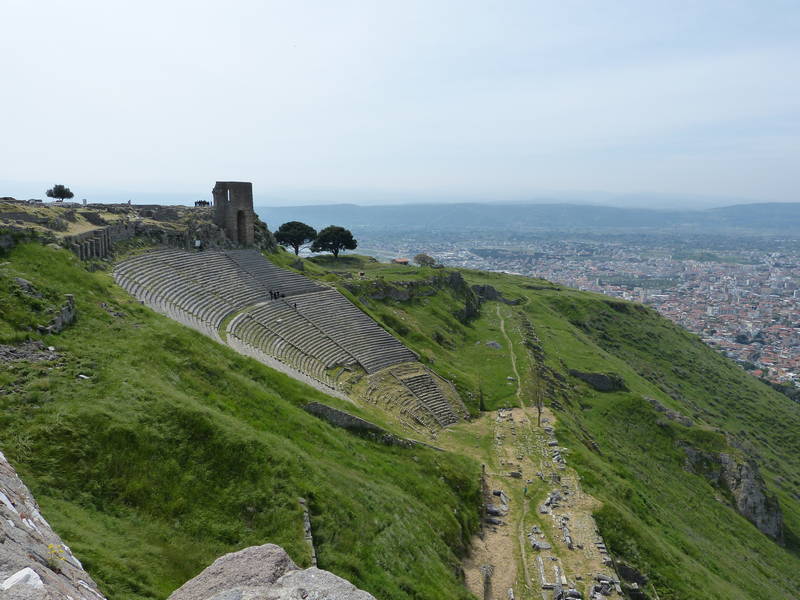



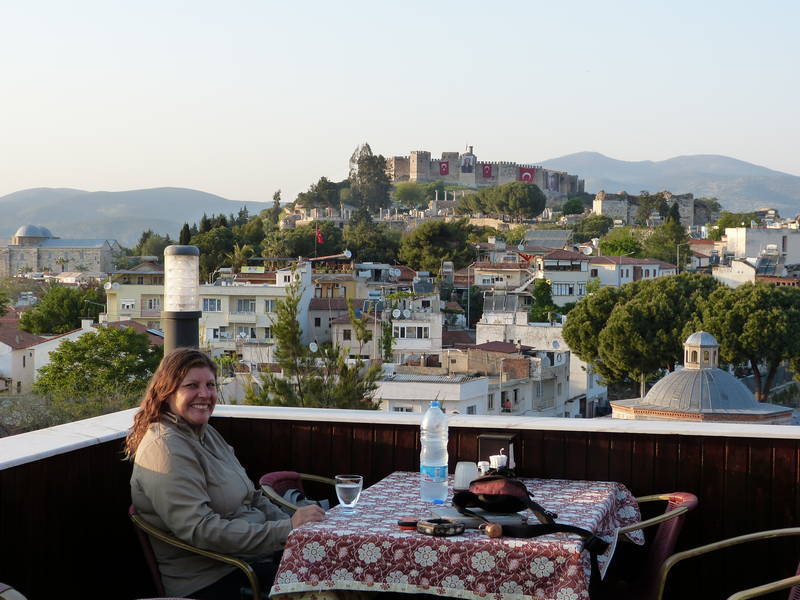

Ephesus Amphitheatre can seat 25,000
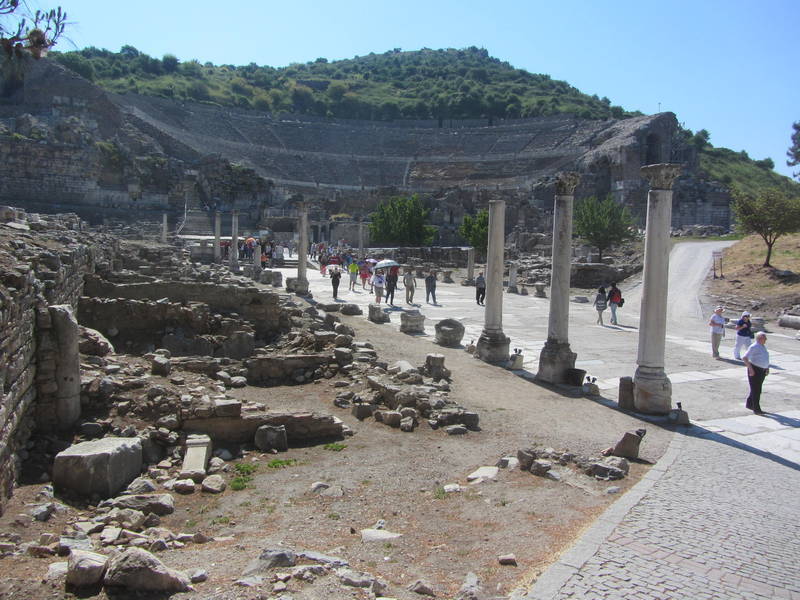
Library of Celsus
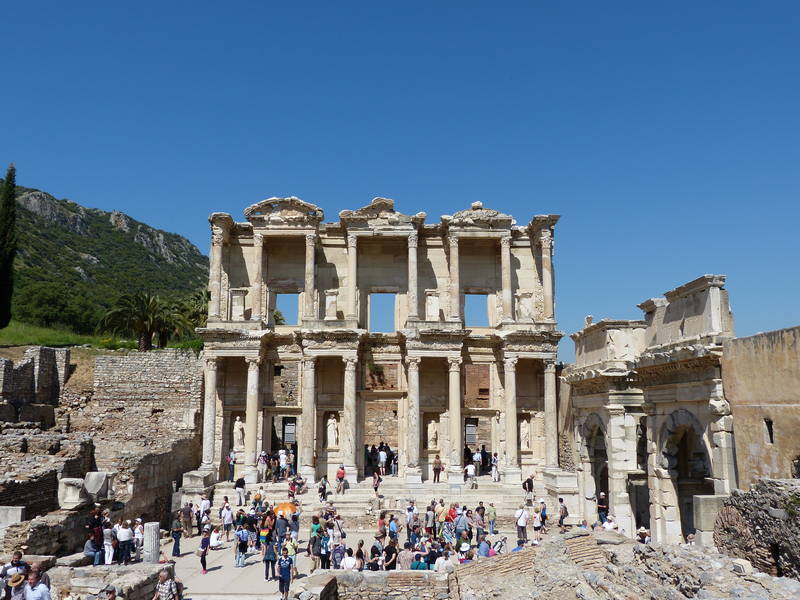
Quite a bit busier than when we were here 10 years ago

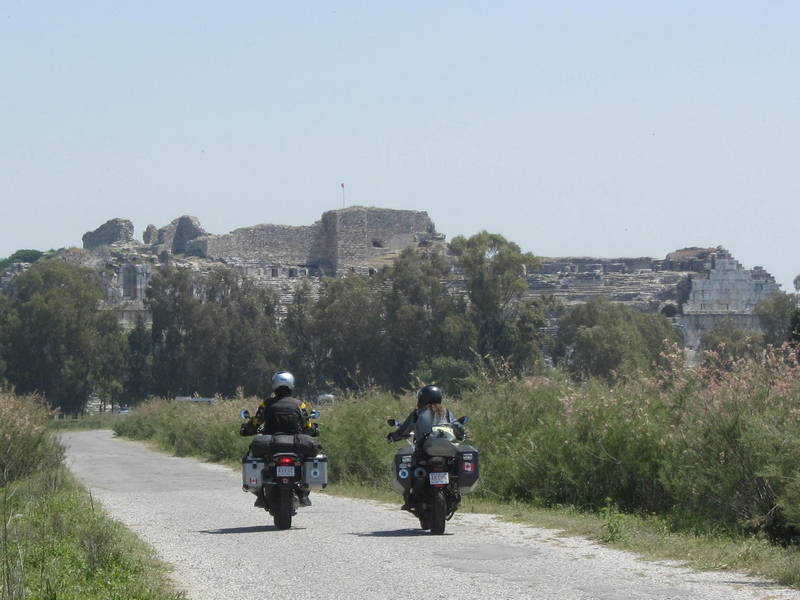




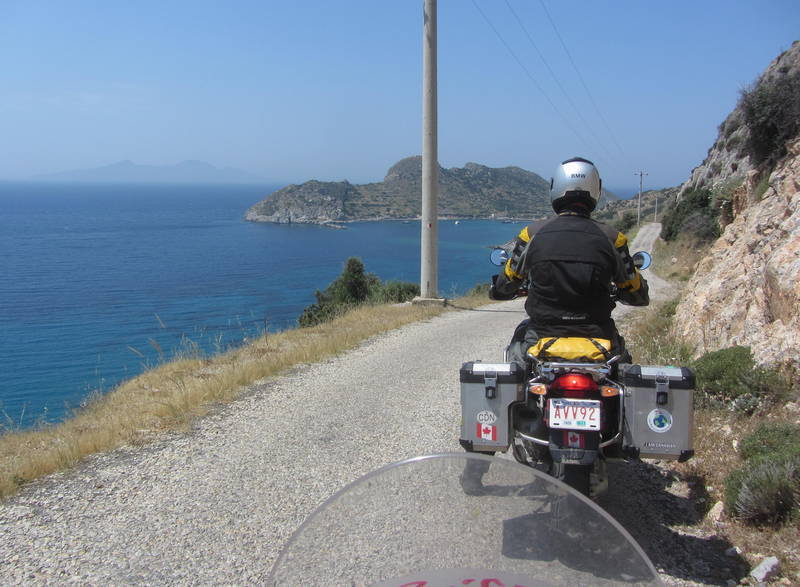
Riding the Dacha Peninsula





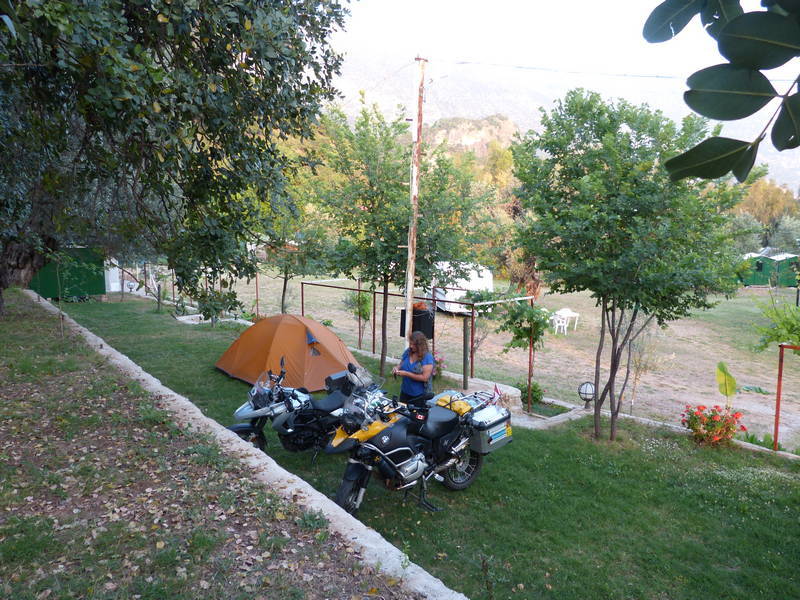
Having carried the Wild Thyme Turkey all throughout Asia, maybe it's time to finally eat it
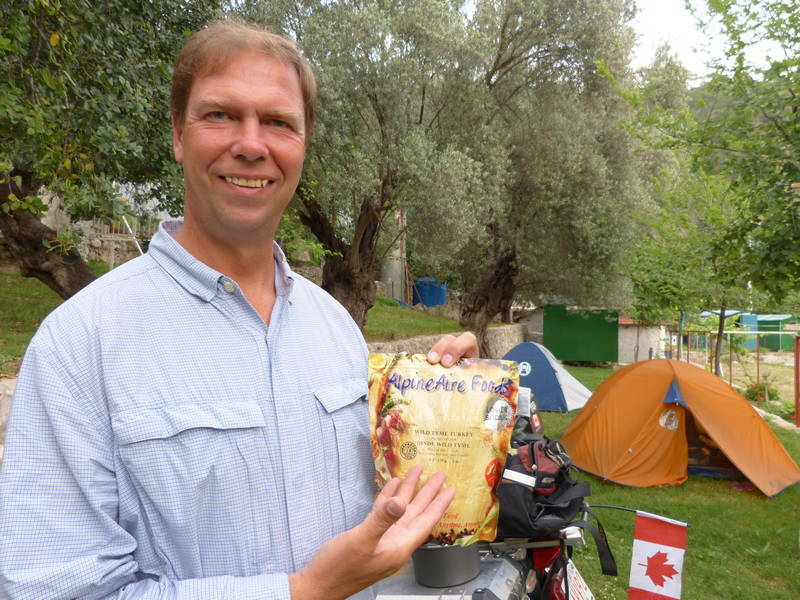
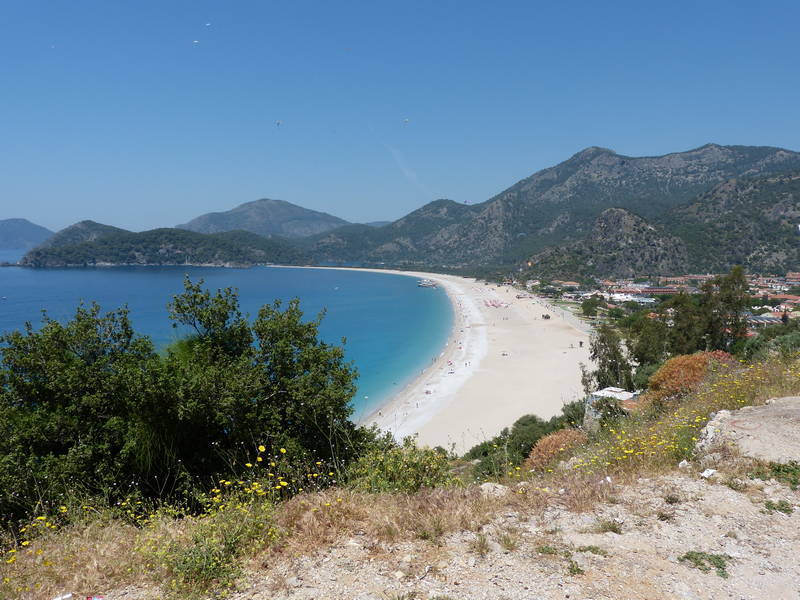

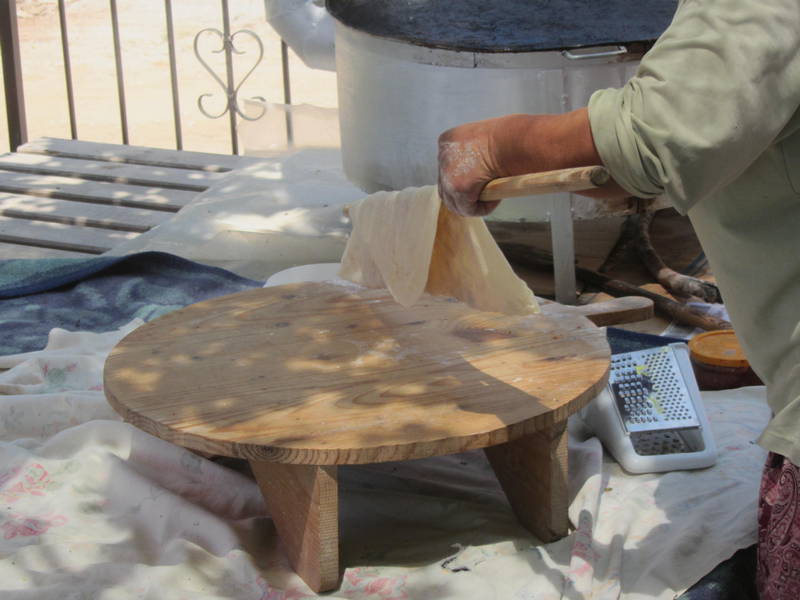
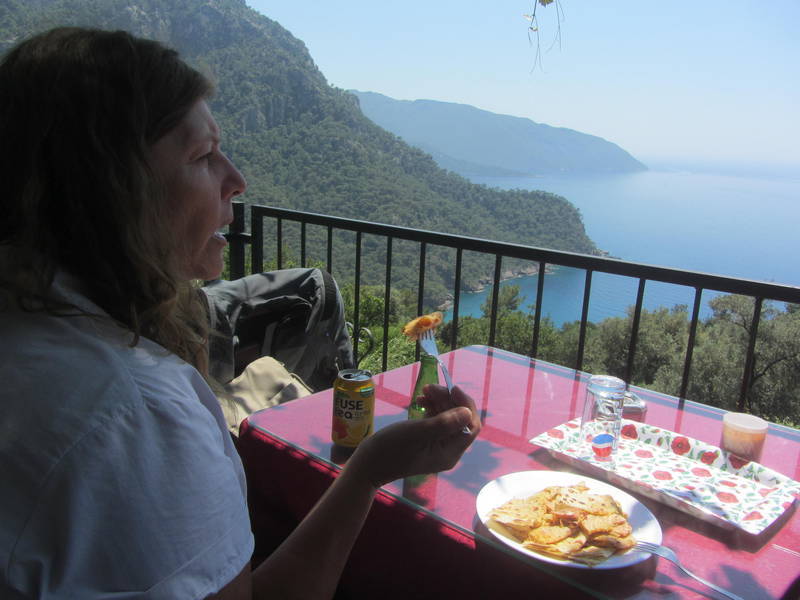


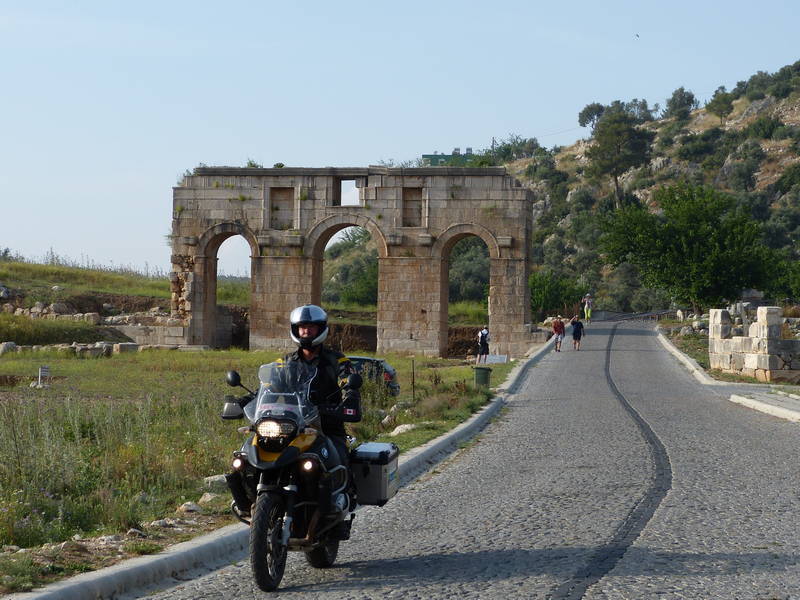



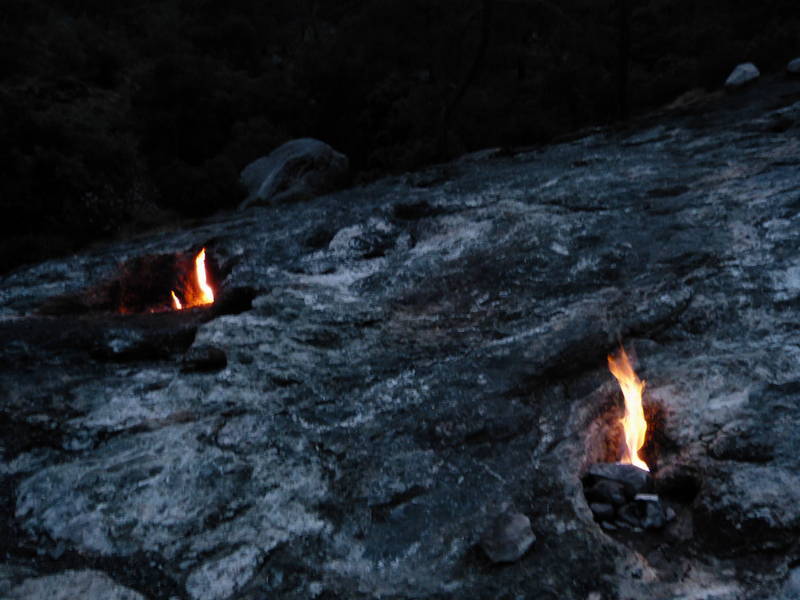

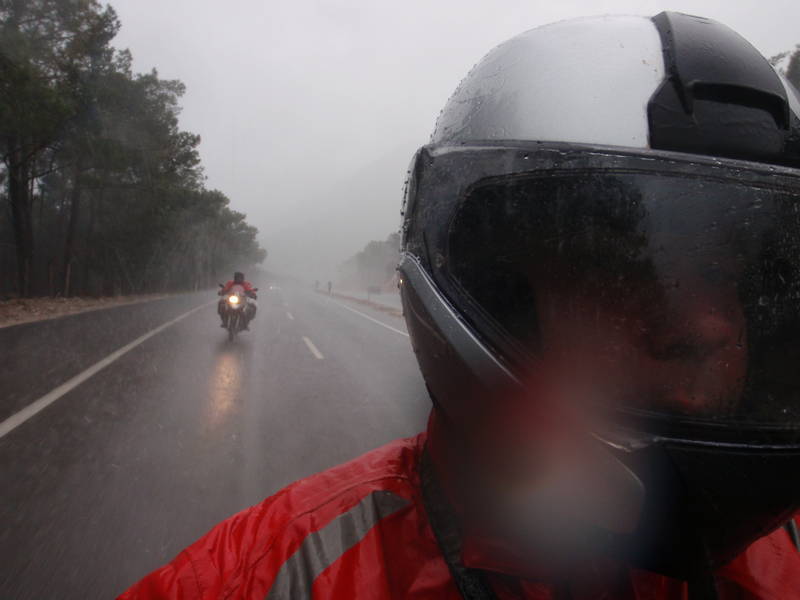


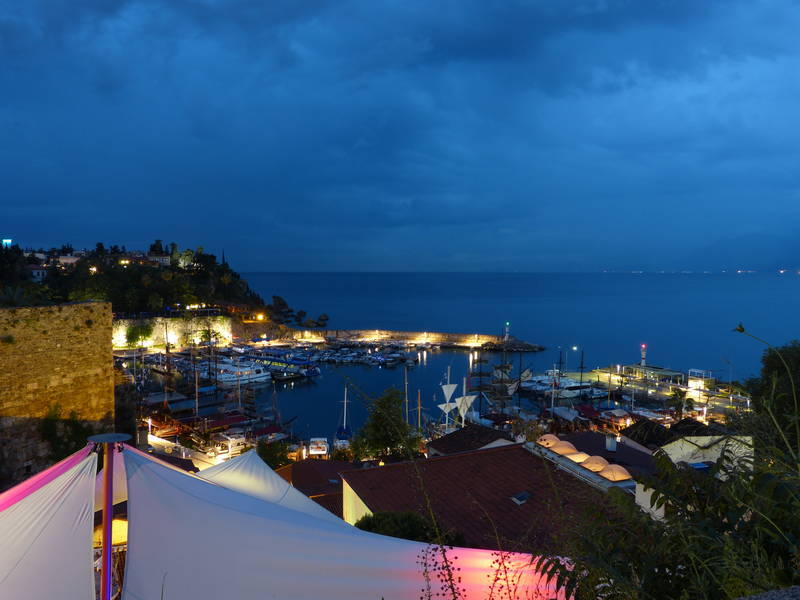



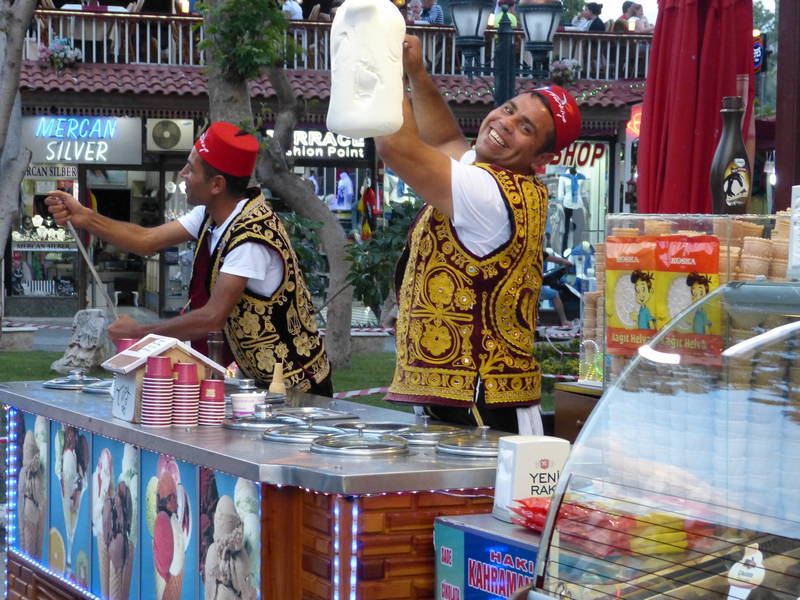

The kindness of strangers is always amazing

The rear end of the bike stepped out and Ekke nearly lost it and went over the cliff

An oil slick (or Diesel?)
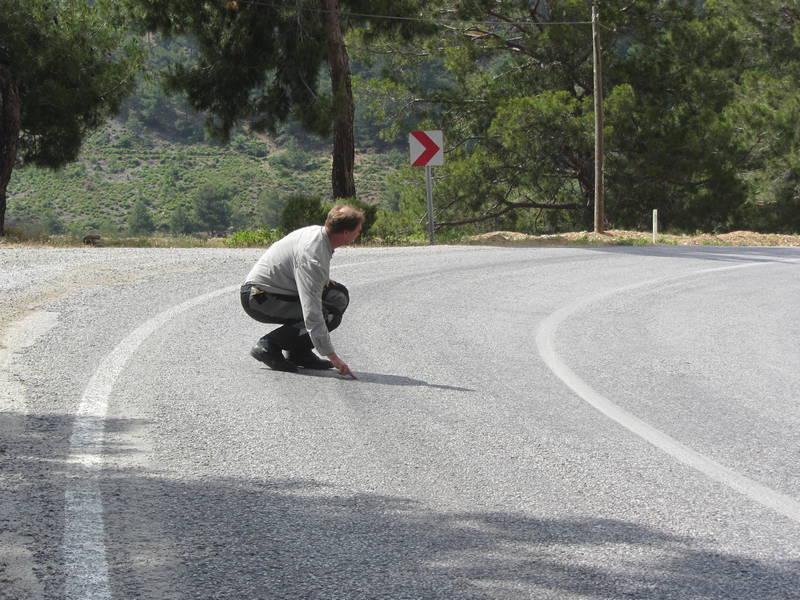
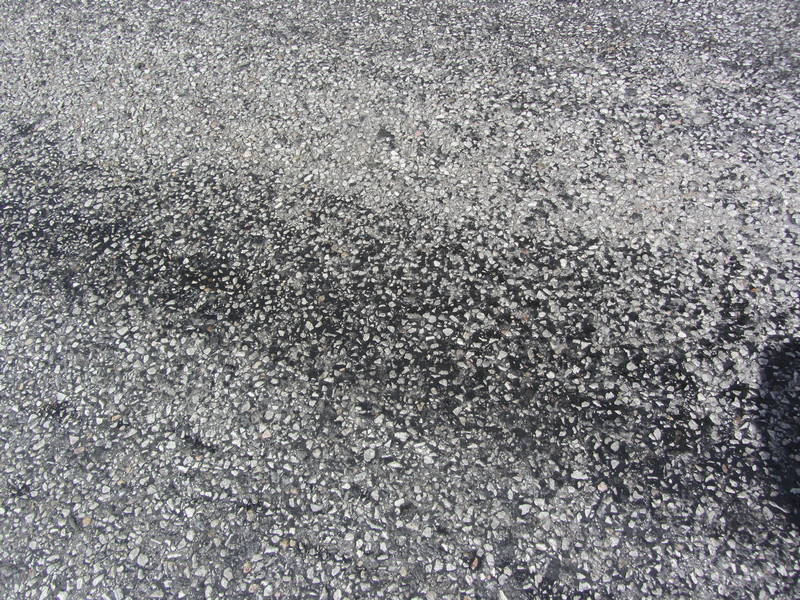


The ferry to Cyprus is late
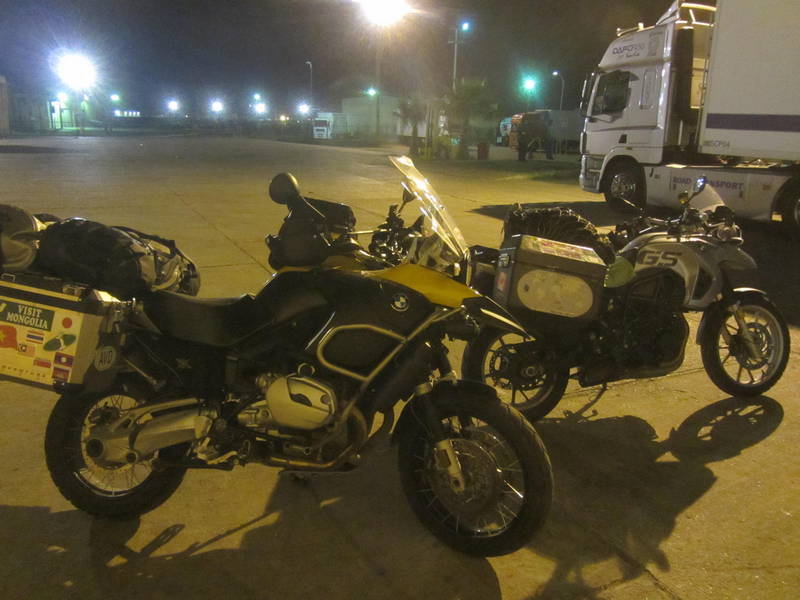
Very late


Home / Circumnavigation of Asia | 2012-2013
Circumnavigation of Asia | 2012-2013
After our trip through Africa and across Canada we started to plan our next trip and settled on the idea of riding across Russia to Japan. Because we had to ride across Siberia before it got too cold, we would be in Japan by the end of September so there was lots of time for further travel. How about going back to Europe over India? A plan was hatched!Planned Route (See actual GPS tracks below)

Actual Route

Chapter 1: Europe
Ekke writes:
What a hectic couple of weeks both at work and at home. (I think I could probably copy and paste that from the previous trips.)
Audrey had been finishing up at school first with report cards and then packing up her classroom. At my work it had been a pretty steep learning curve for Viola, my replacement, and we could probably have met for another two weeks and not cover everything there is to know. She is going to have a fun and challenging year. Come to think of it, so will we.
We thought the house wouldn't be too difficult since we started moving stuff into the basement and cleaning a few weeks beforehand but in the end cleaning is one of those never ending jobs as there always seems to be one more thing to do. We worked right through to 9:30 on Saturday evening with the renters moving in on Sunday morning so we didn't get to my parent's house in Airdrie until 10:30 pm.
Sunday was spent trying to figure out what to take and then how to pack it. We went to Carstairs for lunch with Audrey's mom, Verna, and said our good-byes. We put our VW in storage at a friend's place late in the afternoon (thanks Craig!) and then went back to Airdrie to stuff everything into the bags and headed off to the airport where we got to Club Class check-in in at 8:30. When we had booked our flight in January there were no inexpensive flights to Munich ($1,500 one-way with layovers in Toronto and Warsaw was the best) so we ended up booking a flight to Frankfurt on Air Transat and renting a car. The regular ticket was only $450 and Club Class was $800 so we upgraded for the extra leg room and extra luggage allowance since we were carrying all of our motorcycle gear and I had found a great deal on new shock absorbers for my bike. We were allowed 40 Kg each (compared to 23) and when we weighed our luggage it came to 38 Kg each. Perfect! We went to Kelsey's for supper with my Mom and then a tearful good-bye at security before we boarded our plane at 11:30 pm.
A Canada Day Cake!

Club Class looked great with comfy seats and a welcome glass of champagne to start our huge trip. We had a delicious cold snack on real china using real silverware while steerage got a plastic wrapped hot meal. We had the opportunity to pre-order breakfast and it was delicious. When we landed, about 45 minutes early, our luggage came out first with Priority tags on it. I'm lovin' Club Class! Audrey says she may never fly Steerage again.
Welcome aboard Club Class

Delicious breakfast

We took a cab (who wants to haul 80 Kg of luggage on the train?) and got to the Ibis hotel at about the time we were scheduled to land. A short break with a shower and a phone call home and then we went for a walk to find curry wurst. The small restaurant on the Main River we had gone to last year was just closing for the evening so we walked around the old town and found a sidewalk cafe that served curry wurst. Back at our tiny little hotel room we collapsed into bed at 9:30.
Old Town Frankfurt

Curry Wurst

Frankfurt Opera House

Tuesday morning we enjoyed the hotel buffet breakfast and then walked over to the train station to pick up our rental car. The Renault Scenic was big enough to carry four duffle bags as well as our carry-on bags. One feature that was quite handy was the built in navigation system that showed the current speed limit. In Europe when you leave a town there is usually a "speed limit ends" sign but nothing indicating the speed limit on the highway so this was actually a pretty useful gadget. A few hours down the autobahn took us to Tiefenbach and Motorrad Zierer, near Landshut. Audrey was very happy to see her bike sitting in the parking lot, ready to ride to China. We dropped off the new shock absorbers for my Adventure and then drove to Erding where Brian Dean, a friend from Calgary, was just starting an Edelweiss motorcycle tour of the Alps. We remembered roughly where Hotel Henry was from the time we spent living near Erding five years ago and went there via Schwaig. At the front desk we called his room but there was no answer. Someone walking by in an Edelweiss shirt didn't know Brian but he did hear a couple of people talking about Calgary in the parkade a few minutes earlier so we headed downstairs. Brian looked a bit surprised as we opened the door to the parkade and nearly ran into him. We had a little time before Brian and his friend Bob had to attend a briefing before their tour so we headed over to one of our favourite cake places, the Gezundheit's Park where I used to go for physiotherapy. Cake was part of the physio regimen at the time so a banana and egg liqueur cake seemed appropriate now. I was not disappointed. After cake we dropped Brian and Bob off at the hotel and drove to Kronwinkl.
Ekke, Audrey, Bob and Brian in front of the Edelweiss support van

Audrey writes:
We drove into my sister's driveway in Kronwinkl about 5 pm. Just then Peter Munro also drove up, which was great because exactly the same thing had happened when we arrived a year ago on our trip down from Norway. He's a friend of my sister's and works for BMW. Helena, Willi, and sons Andrew and Robin live in a quaint German cottage-like house and it was great to see it all again. Helena works in Munich but took the week off and chauffeured us around to get our various errands done, made delicious meals, and translated when necessary. One order of business was to take care of the motorcycles. The shocks we had brought from Canada would be installed by 5 pm on July 4th so we drove over to Zierer Motorrad to pick up the bikes. Michael Zierer, after learning about our trip plans, had us pose for photos in front of the shop. He wanted to put them on their dealership website. It felt great to get on the bikes again - the F650 GS twin purred to life when I eventually remembered how to start it. It had been a year and it took me a few moments to become familiar with the controls again. The less hilly way out of the parking lot seemed a good idea, as it would be a shame to drop the bike on the steep exit onto the busy road. Soon we were winding our way through the German hills, passing maize fields and red-roofed farm houses. Ekke went for a ride around the beautiful countryside. I just wanted to get back to Kronwinkl and shed my hot motorcycle gear in the severe humidity.
Ekke gives his bike a hug when he sees it while Michael Zierer looks on in bemusement

Ready to ride to China!

Recently restored church near Kronwinkl on Ekke's first ride

Helena and Willi wish for cooler weather to enjoy their new sweaters

Our week in Kronwinkl was just what we needed after our hectic departure from Calgary. It was easy to get into a routine of sleeping in, which we blamed on the jet lag, and eating fresh 'brotchens' or buns with meats, cheese, and Nutella for breakfast. Going into Landshut, about 11 km away was an absolute delight with its tall brick cathedral, old town of pastel-coloured buildings, and medieval Trausnitz Castle on the hill. Karstad, a local department store had everything we needed and Ekke found a pair of runners in his size. Later, Helena invited us to a Stamtisch at a nearby restaurant where expats and locals got together to speak English. We met some fabulous people. On Thursday night we went to a barbeque at the Huber's place, our former landlords of Gaesthaus Huber in Schwaig. I always get a bit teary-eyed when I see the place where we spent four months when Ekke was recuperating from the cargo bay accident of 2007. The Huber kids are all grown up and have promised to come to Canada to learn English. During the week, Ekke had time to install a sidestand foot enlarger, tank bag, straps for the BMW bag and sort out the camping and cooking gear. There was some tough decision-making, especially in the area of clothes. Motorcycle travellers know the value of space, especially when carrying all the camping and cooking gear. Clothing for all types of weather is crucial, like the rain gear, warm sweater, down-filled jacket, long undies, warmer gloves, and this takes up much of the space. As usual, I packed too much of the non-essential clothing, making my bag too heavy. What to toss out...
Ekke writes:
Saturday morning dawned with cloudy skies and imminent rain. Soon enough it was simply pelting down with rain. I'm sure we'll get enough rain on the trip anyway so we decided to pile into Willi's Golf and drive to Garmisch-Partenkirchen for BMW Motorrad Days. There was a very nice stretch of road approaching Wallgau, where our hotel was located, that would have been really fun on the bikes with twists and turns, not to mention waving at all the other BMW motorcyclists on the road but it sure was convenient in the car. As soon as Peter and Michelle arrived and we were all checked in we took a local bus to Garmisch and walked onto the festival grounds. Wow, what a lot of people and BMW motorcycles. Heaven! After a lunch in the biergarten we split up and explored the show. Audrey and I ended up at a presentation by Kevin and Julia Sanders from the UK whose Globebusters videos we've watched at home. They did a presentation on the tour they run from London to Beijing so it seemed especially relevant to us. The next presentation was by Michael Martin, the famous German photographer whom we had met in 2007 just before starting our Africa trip. I got on the cell phone and tried Tom and Andrea's (Munich Blue Knights) cell phone and they had just arrived at the front gates, just in time to join us for the Michael Martin presentation. Afterwards we wandered the grounds looking at the cool custom bikes and watching Chris Pfeiffer's stunt show. We met everyone back at the biergarten for supper and to enjoy the evening's entertainment. BMW Motorrad UK had reserved an entire section for about 225 people right next to our table. When we saw Julia Sanders Audrey went over and said, "Hello" so we got to thank her for their inspirational videos. She was really excited about our upcoming adventure too. There's a possibility that their next London to Beijing tour would be going through the 'Stans at about the same time as we'll be there coming back next year so maybe we'll see them again. A free shuttle bus brought us back to Wallgau later that evening and we enjoyed an Almond liqueur and hot chocolate night cap together before retiring to our rooms.
Checking in at the Hotel Alpenhof in Wallgau

Cool custom bikes were plentiful


I want this bike...

Audrey tries the new F700GS

While Ekke checks out the new BMW scooters

Andrea and Tom meet us in time for the Michael Martin show

Michael Martin remembers us from his show five years ago just before we left for Africa

The bike that started it all for us, Helge Pederson's R80G/S. Ten Years on Two Wheels.

Audrey buys some new gloves and tries her judo moves

Chris Pfeiffer demos the K1600GT
Peter, Helena, Audrey, Tom, Andrea, Michelle and Willi getting ready for a fun evening

We meet one of our heroes, Julia Sanders of Globebusters

Sunday looked like a great day so we decided to take the gondola to Alpspitz for the view. A really cool cantilevered platform was suspended over a sheer drop. I didn't venture out very far but I got a few photos of the others out there. The area really reminded us of the Rocky Mountains at home but at home there aren't cable cars and gondolas to every mountain peak with restaurants conveniently placed within walking distance. We took another gondola down part way and walked for half an hour to a restaurant for lunch. The wild flowers along the walk were just beautiful and we had to pause often to admire them and the views. Back at the cars, Peter and Michelle put the top down on their BMW 1 Series Cabriolet before heading home and we piled into the Golf for the 2 hour ride to Kronwinkl. What a fabulous weekend.
Audrey cantilevered out over Garmisch-Partenkirchen

Two sisters enjoying the view

Alpine meadows at Alpspitz

At the back Willi and Michelle and the front Peter, Helena, Audrey and Ekke

The second gondola to take us part way down to a hike

Wildflowers on the hike between the upper and lower gondolas

Tuesday morning was the real start to our trip and we loaded the bikes up in the driveway after everyone else had left for work. The ride to the Czech Republic started out on the autobahn but soon enough wound up into the hills on smaller two-lane roads. Our first true border crossing turned out to be rather anticlimactic. There was no border post to be seen, only some souvenir shops so we had to settle for a photo of a small sign announcing our arrival in a new country. While the border was nearly invisible, the change in the houses and cars and people was palpable.
The five litre bag won't fit so we have to drink some of the apple juice before heading off

And we're off!

Audrey writes:
Crossing the border into Czech Republic was a non-event. There were a few buildings scattered about from what used to be a formal process of passport stamping and visa checking. But there was no one to be seen, and we just cruised on through. Immediately the architecture changed and the neat and tidy Bavarian towns were behind us. Ekke had purchased $50 in Czech koruna in Canada, so that got us started in our first grocery store. I went inside to get some lunch supplies while Ekke watched the bikes. I only knew two words of Czech, but people in the store were very helpful. A small wall on the edge of the parking lot gave us a great place to sit, enjoying delicious home-made brownies compliments of Helena. Willi had given us a five litre bag of apple juice, from his own apple tree, which lasted until Lithuania. Any apple juice we tried after that was never as delicious. It was a pleasure riding the good roads through forests and beside farmland, and making our way through Prague was easy with Ekke's Garmin Zumo 550 GPS. It led us right to Hotel Kinsky where we could use our Best Western travel cards earned through Airmiles. A hotel concierge opened up a set of wooden doors from the street, and we rode through a tunnel into the hotel courtyard. Very cool. It felt very secure parking there, and we just threw the bikes covers over the bikes to protect our gear from the rain. The room was lovely, and it was great to have a place to plug in our iPad, iPhone, netbook, laptop and batteries from four different cameras, using the proper European plug adapters, of course.
Arriving in the Czech Republic had us doing a U-turn to find the sign

Parking in the courtyard of the Hotel Kinsky

This was our third try to get to Prague. In 2002 my bike broke down in Salzburg, and in 2007, Ekke had the knee accident. So, walking around Prague was extra special for us. A highlight for me was Charles Bridge, a 14th century stone bridge lined with 30 statues of various saints. It was also lined with several artists doing caricatures, and this was where Charlie Boorman had his portrait done in 'Long Way Round'. The three Gothic bridge towers were quite majestic, one of them a portal into the castle district, the other into the old town. We happened upon the medieval Astronomical Clock, a huge timepiece which still worked, and it also showed the positions of the sun and moon. The market square was really unusual as it contained a variety of Gothic and Baroque buildings and we just stared up in wonderment. I've heard the square described as the most beautiful in Europe, and, having finally seen it, have to agree.
Walking along the Charles Bridge Ekke contemplates getting a caricature done





The next day, July 11th, we wandered up to the castle complex. Some tourists were trying to negotiate the steep cobblestoned roads on Segways, and it looked about as much fun as on a motorcycle, or, not at all. But good entertainment for us. The changing of the guard at the castle was just starting. I couldn't see much because of the big crowd but did catch a glimpse of a blue uniform every now and again. Later, during our cappuccino break, some of the soldiers walked by us and I got a better look. Views across Prague were magnificent in the bright sunshine, and we looked down on lovely terraced gardens. A stroll across the old town took us to Wenceslaus Square where we admired the statue of the good king. Legend has it that he gave alms to the poor and helped his page get through a blizzard, which started tales of his heroic goodness and inspired the famous Christmas carol. The huge square was reminiscent of wide boulevards in Paris. It was interesting to walk where a crowd of 100 000 people had gathered in 1989 for the Velvet Revolution, a peaceful protest that contributed to the collapse of Czech communism. As we walked across a bridge to the lesser town, Ekke noticed a little restaurant, Terrassa, on the banks of the Vltava river, and soon I was sipping Sauvignon Blanc and eating delicious bread with olive oil with balsamic vinegar. Ekke said that his smoked salmon salad was delicious.
Saint Vitus Cathedral at the castle complex

Beautiful square

Good King Wenceslaus

Beer is cheaper than water

The Dancing House (nicknamed Ginger and Fred)

No matter how sore my feet were after a day's sight seeing I wasn't doing this

Spotting a restaurant adjacent to the weir

A delicious dinner


The border crossing into Poland on July 12th was easy, with more abandoned customs houses and no one to stamp our passports. While picnicking, a guy walked toward us and seemed pretty excited. He had seen our Alberta plates, and was astonished to see us in Poland with motorcycles. Turns out he was from Windsor, Ontario, and was visiting his former homeland. He warned us about drivers in Poland, saying they drank a lot, so be careful. We chatted for a while and he gave us a big salute as we rode away. I don't know if we saw any drunk drivers but the roads were very narrow, with no shoulder, and it made for some interesting passing situations. Oncoming vehicles just passed without really noticing we were there, and we were often forced to the side of the road to avoid a collision. On a really narrow, rough stretch, it started pouring rain. Ekke thought we could avoid the downpour because our route on the GPS headed in another direction. No such luck. Too late to put on the raingear and we pulled into our hotel a bit soaked. The only other group in the restaurant for dinner were some Gold Wing riders from Ukraine. But, our Ukrainian language skills are limited so we couldn't have much conversation. The meal was excellent and Ekke's beetroot soup with apple froth was the best he's ever had while his Roast Duck was simply fabulous. The lid on the coriander container must have fallen off as they were making my lasagna though.
Leaving the Hotel Kinsky

Entering Poland

Ultra-modern Best Western at a truck stop at Osjakow, Poland

Some narrow roads took us past fields and farmhouses and through small forests to Warsaw on July 13 and to the next Best Western. There was time to visit the old town after checking in and we spent some quality time wandering near the castle, fortress and border to the former ghetto. A quaint dinner spot had dumplings and potato pancakes on the menu, and it was great to sample the local cuisine. We happened upon a statue of Nicolaus Copernicus, the Polish astronomer. All around the statue were bronze plates depicting the earth revolving around the sun and I walked the path of the moon revolving around the earth. On the way home, Ekke nicknamed our cab-driver Robert Kubica, a Polish Formula 1 driver. He accidentally took us to the wrong hotel and then hit the gas to get us to our hotel a bit faster, swerving in and out of traffic, using other cars as pylons. I just held my breath for most of the trip and when we arrived safely, I looked around for a guy waving a chequered flag.
Some pleasant riding in Poland (when the traffic wasn't too heavy)

The Best Western Hotel Felix looks like a remnant of the Soviet Era

An evening stroll in Warsaw's old town




Madam Curie's museum wasn't open

The statue of Nicolaus Copernicas was surrounded by orbits of the planets

Having fun with bubbles

Our route north took us through Kaunas, Lithuania. The capital, Vilnius, was out of the way so we decided to save that for another time. Getting to the hotel was interesting as the GPS sent us the wrong way down a heavily cobblestoned one-way street but it seemed the only way into the courtyard of the hotel short of riding on a pedestrian mall. Walking down the mall after checking in we thought the buildings must have been quite spectacular at one time but were starting to crumble a bit. But the cathedral was beautiful and our restaurant was great. Ekke tried a strange drink, a kind of fermented wheat drink with raisins floating in it. There was not much time to visit Kaunas and we knew we'd have to come back to see the historic city.
Riding north in Poland

Delicious hunter stew for lunch

Entering Lithuania

Parking the bikes in the courtyard of the Best Western

Gorgeous church in Kaunas

An "interesting" beverage

The easiest way to leave our hotel was to, again, go the wrong way down a one-way street, which landed us on the pedestrian mall. A short ride on that, to the surprise of many walkers, eventually got us going in the right direction. The ride through the countryside was gentle, with wide shoulders that made passing safer than in Poland. Buildings and yards were neatly kept and it was pleasant riding. The Lithuanian litas that we had went a long way and we were hard-pressed to spend them all before leaving the country. Our dinner the previous evening had cost less than $10.00 for both of us, and we tried to spend the money on lunch and snacks. At a roadside cafe, Ekke looked at the sky and said it was going to rain in about two minutes. About two seconds later it just started pouring and we had just begun to throw the bike covers over the bikes. The cafe provided a nice refuge, with tacky boar statues, and the rain stopped as soon as it had started. It was still quite overcast when we came out so we put on our raingear. My BMW Tourshell pants are supposed to be waterproof, but the heavy rain disproved that theory, so I put rainpants on over top. My C-Change liner works well to keep my upper body dry, but in heavy rain it is good to have an outer covering to keep the jacket itself dry. Ekke also had liners, but has to plan ahead to put the pant's liner on before leaving the hotel as doing it on the side of the road makes for too much entertainment for passing motorists. So, he often wears raingear as well. As the sun appeared, it got hotter and hotter and soon we were baking inside the raingear, so off it came. There was no map of Riga on the GPS so Ekke looked at the iPad map and memorized it to try to get us to the hotel. We ended up doing a huge u-turn way up the highway, which led us into some pouring rain, and, with no raingear on and no place to stop, we were soaked by the time we got to the hotel. The joys of motorcycling.
A fellow BMW rider in Lithuania

Audrey tries to decide which one to bring home for a souvenir (go for the boar!)

Entering Latvia with the abandoned border control post decaying quietly behind

Using the iPad to find the hotel in Riga

The sun appeared again, and we had a great walk around the beautiful old town. Our shuttle bus driver had suggested the Lido Cafe for supper, and we decided to try it. The decor looked like a Latvian hunting lodge, the staff wore traditional dress, and the pork steak and sauerkraut were a great combination. On our walk, we peeked inside a church where a Sunday evening service was being held. The setting was lovely, and the priest had a beautiful singing voice. Too bad video wasn't allowed. The medieval buildings in the old town were awesome to look at, many of them having been rebuilt after the second world war. In Bastion Hill Park there were a lot of padlocks attached to a small bridge. Newlyweds attach their lock to the wrought iron as a symbol of a firm and stable marriage.
Downtown Riga, House of the Blackheads


Cat on a pointy roof

Coats of arms in Latvia beside the Powder Tower

Breakfast of oatmeal and hardboiled eggs was great at the Best Western Mara on July 16th. It is advertised as a 'Canadian-style' hotel, maybe because it is free standing, a half-timber design, with a big parking lot in front. It looked like a building you'd see while travelling around Ontario. There was also a copy of a landscape painting in the breakfast room by Frederick Varley, one of the Group of Seven. So Ontario-esque. Our ride took us along the Baltic, but we could only see trees. Luckily, on one of our breaks, we saw a little path through the trees and walked out onto a beautiful beach. Gorgeous yellow sand and a beautiful blue sea greeted us, but the wind was just howling and it was a bit chilly down there. The border crossing into Estonia was, again, non-existent. It was great to be able to use euros again and not have to worry about unfamiliar currencies. Ekke had done some research on the internet and learned that there was no Best Western hotel in Tallinn and other hotels were pretty pricey so we decided to give camping a try. The city campground was a bit tricky to find and when we finally did, it looked just like a parking lot. Ekke suggested we try a place by the yacht club, which turned out to be great, with a grassy, tree-lined spot and picnic tables. The best part was that it cost 3 euros per night. But showers were 3 euros per person, so not much savings there. There was a great little restaurant just across the parking lot, and we enjoyed a couple of pizzas. Prices seemed similar to those in Canada.
Cool and windy on the beach today

Entering Estonia

Lots of forests in Estonia

Camping for the first time on the trip

Audrey checks out the washroom facilities at the yacht club

The next day, July 17th, a bus was available nearby to take us into the old town of Tallinn, and we could leave our motorcycles safely parked at the yacht club. What a gorgeous old town, with fairy-tale spires and a stone wall with a wooden roof surrounding the World Heritage Site. The streets were heavily cobblestoned and we had to step carefully so we didn't twist an ankle. First order of business was to get a map, then find out about ferry schedules to Finland, and then get a cappuccino and cake. I overheard someone at the info place asking about the free English tour, so we decided to join in. The tour took two hours, and we started at Freedom Square. Our tour guide said that the Freedom Monument there was very unpopular, as it resembled a cross and most Estonians were atheists. It was also supposed to light up but often had technical difficulties. A petition had been started to have it removed. A walk up the hill took us to Kiek-in-da-Kok tower which means 'Peep into the Kitchen'. In the 15th century, tower occupants were able to peek into the kitchens of nearby houses. Maybe that's why curtains were invented. The tower had four metre thick walls and still had cannon balls embedded in it from 1577. The Toompea building, flanked by Tall Hermann Tower, is the centre of government of Tallinn. When Estonia was part of the Russian Empire in the late 1800s, the Alexander Nevsky Cathedral was built nearby. Inside, there was a lot of gold and marble, all stunning. The Doma Cathedral around the corner had a totally different feel, very plain, all concrete with huge tombs, and big coats of arms hanging on the walls.
The main gates into Tallinn's old town centre

Alexander Nevsky Cathedral

Spectacular view over Tallinn towards the docks

Tall Herman tower

The central square, Raekoja Plats was chock-a-block with sidewalk cafes, souvenir stands, and people. Our guide asked us to find 5 spires from where we were standing, and within seconds, a lady in the group said she had found them. No, only 4. She was sure she had 5, and kept trying to point them out. No, only 4. The guide showed us a special spot where you could stand and just see the top of a fifth spire if you looked carefully between two buildings. After saying goodbye to our great tour guide, we enjoyed lunch of Nuremburg sausages at a Bavarian restaurant, which seemed like the cheapest option. We retraced our steps of a lot of the tour because I had thought we had missed the palace, but it turns out we had seen it. The guide had described it as a government building and didn't mention that it used to be the palace. After a walk up to St. Olaf's Cathedral and Fat Margaret's Tower, we were so done. Fatigue had set in, so we tried to recharge our batteries with some sparkling water and cake at Josephine's. Ekke met his match with this huge piece of cake - too big and too sweet. But I still found more sights on our tourist map that we had not seen, and Ekke kindly joined me as we walked through St. Catherine's passage, the guildhall, and the Black Head Brotherhood house. Back at the yacht club, Ekke noticed that some other campers were using Skype so he tried calling his parents, with success. Did you know Skype was invented in Estonia? Me neither.
Raekoja Plats (only one steeple visible in this photo)

What should we have for lunch? A big beer maybe?

Cool old DKW on the road in Tallinn

Josephine cake is just too much, even for Ekke

Ekke writes:
Well our first experience camping was a real pleasure and all the equipment seemed to work. The Exped down filled sleeping mattresses were more comfortable than some of our hotel beds and I'm thinking of taking mine into the hotel with me. Too bad we didn't have an opportunity to test the stove for cooking. In any case, we needed to dry everything out after a light, ten minute rain shower in the morning but we were able to do that and make it to the ferry terminal by 9:10. We were directed to Lane 1 which had motorcycles and a Bentley, Range Rover and Porsche Cayenne in it. Cool, motorcycles are treated like First Class. We strapped the bikes down with the provided straps and headed up to the cafeteria for breakfast. With the priority boarding we were actually finished our breakfast of oatmeal (Audrey) and scrambled eggs before all the cars were loaded. The smooth, two hour sail gave us an opportunity to work on the website and sort photographs.
Lined up for the ferry to Helsinki

Working on the website during the crossing

With the warm temperatures and fairly high humidity on the ride north Audrey wasn't terribly happy with the new TourShell pants she had purchased in Calgary so in Helsinki we went out to Heino BMW and checked out their selection of warm weather gear. They had a pair of BMW City pants that fit Audrey perfectly and seemed much more breathable than the GoreTex TourShell pants. Of course, they wouldn't be waterproof but we have rain gear along in case we run into some moisture on the trip. On the ride to the Best Western Hotel Haaga Audrey couldn't wipe the smile off her face. She was really happy with the pants. If Audrey is happy I'm happy. The Best Western was a very modern hotel in Scandinavian style with beautiful furnishings. Would it be our last taste of Western comfort and convenience?
Checking in at the Best Western Hotel Haaga

Nice welcome in the room

In the morning we used the hotel's enormous pool (17 metres long) for a refreshing swim and then went for the buffet breakfast. Bus 63 stopped a five minute walk away from the hotel and showed up a few minutes after we arrived. We got off when everyone else did and found ourselves at the main train station in the centre of Helsinki. We wandered around downtown and strolled down the Esplanade Park ending up at a market set up for cruise ship passengers. A cheese and tomato sandwich with a smoothie for lunch had us appropriately fortified to continue our explorations. A glorious church on a rock, Uspenski Cathedral was located near the harbour and was quite spectacular inside. In contrast the Helsinki Cathedral, situated on Senate Square, was very simple and elegant inside. Late in the afternoon we caught the Number 63 back to the Haaga area and had Nasi Goreng at a Chinese restaurant a few blocks from the hotel.
Esplanade Park in Helsinki

Market near the docks at the end of Esplanade Park

Uspenski Cathedral



Taking a break

Helsinki Cathedral

Friday, July 20, we got an early start so that we could make it to the Russian border in plenty of time. One of the things that enabled the quick getaway was the checkout with the Best Western Rewards Travel Cards we had been using to pay for our hotel rooms. In every Best Western coming up from Germany it had always been a 45 minute process but in Helsinki it was a matter of moments and we were on our way. Finland was such an easy country to ride in compared to the Baltic States and especially compared to Poland. One could actually sit back and enjoy the ride rather than having to give 100% attention forward (cars passing without regard for oncoming traffic and slow moving vehicles in our lane) and backward (for cars coming up to pass and shoving us off to the side). The last outpost of Western Civilisation for us was a gas station with a market and café so we picked up a few last supplies and rode to the border. The queue of trucks was only a few kilometres long but we had heard reports that they could stretch for 50 or 60 kilometres waiting to enter Russia. We passed them and waited a few minutes to enter the border control point on the Finnish side. Once inside it was a quick stamp in the passport (the first one since landing in Frankfurt) to exit the Schengen countries and we entered no-man's land to Russia.
A stop at a highway gas station for the last taste of Western culture

Line of trucks waiting to enter Russia

Map of our route from Kronwinkl to Helsinki and the Russian border

Chapter 2: Russia; St. Petersburg to Moscow
Ekke writes:
We rode a short distance to the Russian border and pulled up just short of four different queues of cars. A border guard waved us into a slot between queues and soon enough cars started to line up behind us. This was our first introduction to Russian queuing but we were certain it wouldn't be our last. The guard motioned us to a passport control station where we joined a crush of people gathered around a small window. Once up at the front it took quite a while for the official to process our motorcycles as he tried to read our registration papers to find out the colour and so on. We were then able to proceed to customs where we needed to fill in customs declaration forms (in duplicate) and queue up again to have them checked. Overall it wasn't so difficult, the officials were reasonably helpful and it only took a couple of hours or about half the time that it took to enter Egypt. Our European insurance wasn't valid in Russia so we found an insurance seller tucked in behind a gas station to buy it, but we didn't have enough rubles. We had only exchanged 1,500 rubles (about $50) in Canada and the insurance for the entire time we would be in Russia would cost 2,800 rubles. The nearest cash machine (according to the insurance sales person) was 40 kilometres away. Audrey hit on the idea of buying only enough insurance to get us to Kazakhstan so we purchased 15 days for 1,400 rubles.
Welcome to Russia!

The GPS showed an ATM in Vyborg so we headed straight there since 100 rubles wasn't going to get us very far. Vyborg was a real vacation town, full of Russian tourists enjoying the beautiful weather and the old town. While the GPS guided us to the right spot we still didn't find the ATM. It took a bit of snooping around to find it hidden inside an old, brick building. Once at the machine I had fun guessing what to do since there were no English language options. Everything was written in Cyrillic. Eventually it spit out 4,000 rubles rather than eating my card. With cash in hand Audrey went to an indoor market and bought lunch, which we enjoyed on the square while keeping an eye on the bikes, which seemed to draw a bit of a crowd. I went in search of a toilet at the market and after a while found a building outside a side door. When I opened the door I was promptly shooed out by a matronly lady. Through sign language she told me to wait and after a few minutes a woman came out and both of them were giggling. Then the matronly woman motioned me inside and pushed me into a filthy stall. When I left the stall the attendant asked for a euro so I showed her a handful of rubles. She took 25 rubles and then literally shoved me out. That was totally not worth it. Especially since I didn't really need to go. Next time I'm going straight to a bush, which is what Audrey did as soon as we left town.
Riding into Vyborg

Central square in Vyborg

Audrey checks out the location of the ATM

The traffic west of Vyborg was light and pretty good but east, in the direction of Saint Petersburg it got crazier. This was the usual situation where trucks would drive on the shoulder while cars passed on the centreline regardless of oncoming traffic. When we came to a town on the outskirts of St. Petersburg traffic came almost to a complete halt and we crawled along for a kilometre or two while my oil temperature gauge crept higher and higher in the 26 degree heat. With the engine making knocking sounds we squeezed between some cars and a bus to find a small side road that the GPS said connected back with the main road. It was good to move a bit and I think we cut off at least few hundred metres of the traffic jam. After joining up with the main road it wasn't too much further of squeezing between trucks and cars until we got out of town. It must have taken half an hour to go two kilometres.
St. Pete was having a bit of a construction boom that made the GPS maps a trifle inaccurate. As a result we got turned around and had a bit of a tour of the suburbs. Using dead reckoning we were able to go in the general direction of the Anichkov Bridge Hotel and soon found ourselves riding beside the Fontanka River. We parked the bikes and I walked up and down the street looking for the hotel but there weren't any signs for it. I walked around a barrier into a courtyard and there was a tiny plaque on a door with the hotel name. I was buzzed in and climbed to the second story where I confirmed I was indeed in the right spot.
Pulling up near the Anichkov Bridge Hotel

A small plaque on the door inside the courtyard is the only clue there is a hotel here

Audrey writes:
After a bit of a rough start trying to ride through the city, it was magical arriving on the street of our hotel beside the Fontanka River. Historic buildings lined both sides of the river, which really resembled a canal, and I could see Anichkov Bridge with its four horse statues. I had to shake my head - we were in St. Petersburg, and it was beautiful. After parking on the street, Ekke went to look for the hotel. The address was correct but we couldn't see any hotel sign at all. As I waited I chatted about our trip with a friendly local, Deima, who had pretty good English. The Alberta license plates are always a good conversation opener. He was curious as to where we were going and was quite impressed when I said we were riding to China. He probably knew about the interesting Russian roads that awaited us. I asked him how he knew English and he said they get some English classes in school but it was at college where he really learned it. Ekke had found the hotel through a courtyard opening between buildings, and there was a small sign over a door, 'Anichkov Bridge Hotel'. We rode right over the sidewalk, through an archway, around a barrier and then parked in the courtyard. The concrete stairway up looked very decrepit, so I didn't have high hopes but our room wasn't bad, newly renovated and clean. Also, it was very central, just off Nevsky Prospekt, a bustling street of restaurants, monuments, cathedrals and a historic shopping mall. Deima's suggestion of a little Italian restaurant for dinner worked out well, and we strolled along the canal, stopping to activate the Spot Tracker.
The stairwell doesn't look promising...

After a quick breakfast on July 21, we decided to do a walking tour laid out in Lonely Planet. We had lost an hour crossing the border to Russia, so it was difficult getting up early. It was very pleasant walking up Nevsky Prospekt and it was just unbelievable how many really outstanding buildings we saw. At one time, everyone wanted to live on lively Nevsky, and a lot of nobles built huge mansions with courtyards there, all highly decorated with classical statues or columns. Our walking tour went out the window when we looked down one street. At the end of the canal was the most beautiful sight. Golden domes sparkling in the sunshine, more domes a riot of colours, greens and blues and yellows, looking like giant soft ice-cream cones. We had to go check it out. The structure was the Church on Spilled Blood and was built on the spot where Tsar Alexander II was assassinated while riding in his carriage. What a great monument to him. After paying a small fee we were able to go inside. Every centimetre was covered in a beautiful mural depicting biblical scenes, gold and marble everywhere. We were awestruck.
Time for a quick breakfast

Wow, Church on Spilled Blood grabs our attention


Stunning interior too


Our landlady told us to come back to the hotel between 11 am and 2 pm to register, one of those tasks that visitors to Russia must take care of. Usually a hotel can register for you, and it must be done within three days of entering the country. We came back at 11 but she told us she couldn't register us at that time, which was too bad because we'd walked back quite far just to register. But she said to just leave our passports and she'd get it done. Could we not have done that in the first place and not broken up our day coming back? We picked them up later that night with a new slip of paper inside.
Taking a break along Nevsky Prospekt after registering

Our priority in terms of sights to see in St. Petersburg was the Hermitage, a huge palace stuffed full of European art and artefacts from many different countries. The building itself is the former Winter Palace, and everyone from Peter the Great to Catherine the Great to Tsar Nicholas and Alexandra lived here, or in some version of it. It was quite stunning, painted mint green with white trim, tall pillars, and Greek-inspired statues lining the top. It's not the biggest art museum in the world, that honour goes to the Louvre in Paris but we were able to spend hours wandering amongst the priceless Da Vincis, Picassos and Matisses. Ekke loved the Dutch masters, like Rembrandt, especially the scenes of life in the Netherlands. What a coincidence that a Calatrava exhibit was on, the architect of the new red Peace Bridge in Calgary. He's designed some amazing structures and a lot of models were on display, mostly white suspension bridges, airports or train stations. No photos allowed, though. I got in big trouble from an attendant who said, "Nyet," when I touched one of the buttons to make some wings flap. I did notice, later, all kinds of buttons were being touched by others and they weren't getting into trouble. Sheesh. In one room, Ekke and I sat on what was surely the only bench in the Hermitage and stared at a beautiful painting for ages. We couldn't read who the artist was and neither of us was going to leave our seat to find out, so Ekke used his superzoom lens on his camera to take a picture of the info card across the room. Snyders. In the Egyptian room one sarcophagus was on display, protected in a hermetically-sealed case, so lovingly taken care of. Ekke and I just chuckled, recalling the hundreds of sarcophagi we had seen stacked in the Egyptian National Museum in Cairo in 2007, many of them covered in layers of dust. Lonely Planet suggested a few prized pieces of art to go see, so we followed the map through many of the 1500 rooms trying to find them. A display of Japanese armour and weaponry was interesting, as well as a hall full of portraits of Russian generals. And there was always more to see, room after room of beautiful furnishings, chandeliers and painted ceilings. So, we stopped when our feet got too sore to go any further. We weren't the only victims of the Hermitage that day; Some of the ladies hired to monitor the displays were definitely nodding off - I'm sure I heard snoring.
Sneaking a photo of a Calatrava model


Hall of Portraits of Generals

Ekke's favourite General


DaVinci



Rembrandt

A Snyder painting. Time to have some seafood?



Picasso

Van Gogh


Does this look a little like the scene in Raiders of the Lost Ark?

Back outside, it felt great to walk along the Neva River at a faster pace than in the Hermitage, which is really more like standing. The statue of the Bronze Horseman dominated Senate Square near the river. It was quite spectacular to see, and is a symbol of the city. The rock it sits on took two years to be moved from Finland. Behind it was St. Isaac's Cathedral, one of the biggest in the world. Climbing the 227 steps of the belltower was something we chose not to do as we dragged our weary bodies through the streets of St. Petersburg. Across the street at a park we perked up when we saw hundreds of bear statues. When we went over to investigate, we noticed there was one bear for each country, all side by side, colourfully painted. It was fun to see how countries represented themselves, with painted landscapes or cultural icons. The Canadian bear was a bit of a mystery to us, but we interpreted it as the colours of the land from sea to sea to sea. I think St. Petersburg picked up the idea from Buddy Bears in Berlin and made it into United Buddy Bears, a symbol of peace and tolerance throughout the world.
Outside we had missed a rain storm but caught a nice rainbow over the Hermitage

Peter and Paul Fortress across the Neva River

The Bronze Horseman

Loses the impact when Peter the Great checks his phone for messages

Pancakes and caviar! A bit too salty for Ekke's taste but something different

Ekke gets friendly with one of the Buddy Bears

The Canadian Buddy Bear

The light was good as we head home so took a picture of something...

A short walk from our hotel the next morning, July 22, we found a great breakfast place, Pancake and Wok. I got a steaming hot bowl of oatmeal and Ekke tried the omelet. The choice was mushroom or cheese. Ekke asked if he could get mushroom and cheese, but the guy just said, "No." Ekke tried again, but there was no way they could do that for him. It was just one or the other. Very strange. Whenever we ordered omelets after that we were very happy when they let us have more than one ingredient. The hop-on hop-off City Tour bus was a life-saver that day as we walked a bit less and learned a lot from the English commentary through our headphones. But we had to change seats three times to find a headphone jack that worked. While the bus waited by the Winter Palace the commentary said that in the centre of Palace Square is the Alexander Pillar, the largest single piece of granite in the world, and at 600 tonnes, is supported by its own weight. The face of the statue of the angel on top coincidentally looks like Alexander I's face. We also learned that when the Bolsheviks took control of the Winter Palace, their armed guards helped themselves to the wine and emptied the wine cellar within a month.
Waiting for an omelet

Royalty in St. Petersburg

The Palace Square

The bus took us across the Neva River to the Aurora, a huge Russian warship. This cruiser was used in the Russo-Japanese war but it is probably best known for having fired the first shot that started the 1917 revolution. A walk along the river took us past Peter the Great's cottage, the first residential building in St. Petersburg. The Peter and Paul Fortress nearby is a huge complex that has so much to see and do. It was built in 1703 for protection from Sweden. We walked by tombs of Peter the Great and Nicholas and Alexandra in the huge cathedral, a museum that took us through the building of the city, and the notorious high-security political jail. Dostoyevsky had a stay here before being sent to Siberia, and we found the cell that Trotsky stayed in. A sort of unrelated exhibit on Cosmonauts was actually quite enjoyable. It was very cool to see a replica of the Sputnik, space-dog photos, medals received by cosmonauts, and a re-entry capsule. We had to patiently wait our turn for kids to move out of the way so we could get our photos taken at the spacesuit display.
The Aurora

Wandering the park over to the Peter and Paul Fortress

You could get a 15 minute ride in a Sikorsky helicopter for 3,000 rubles ($100)

Saints Peter and Paul Cathedral inside the Peter and Paul Fortress

A Rodin exhibit was happening at the time so they had the Burghers of Calais on display outside

Ekke loves antique maps

And apparently antique dishware

Trotsky's cell

 Life-size replica of Sputnik
Life-size replica of SputnikAudrey looks ready to be a cosmonaut. Not that much different from a motorcycle outfit.

The Fortress was great for weddings but this bride's wardrobe malfunction might push her over the edge

Tiny portions of fettucini at an outdoor cafe on Nevsky Prospekt were barely adequate for dinner so we made up for it with a couple of big desserts. I heaved a sigh of relief when I saw pictures on the menu and we could just point to lemon cake or tiramisu. The highlight of this cafe was the people watching. It was like having a front row seat at a fashion runway. There was barely a woman without high heels on, and we wondered how they could spend all day in them like that, and then go out for an evening stroll. They also put a lot of time, thought, and presumably money into clothes, mostly dresses and skirts, very stylish with a perfect fit. Men just dressed fairly casually, outdone by the women, and they got to wear comfy shoes. A lot of fancy cars went by like Bentleys, Hummers and even the odd Ford Focus or two. Motorcyclists used Anichkov Bridge as a launching point for block-long wheelies, sounding like a superbike race. The sight reminded Ekke of a Cycle Canada cartoon where a dad explains to his son to look both ways and listen for the sound of a grinning demento pushing the needle deep into the red zone before crossing the street. We noticed that there were mostly sports bikes in St. P., so our Gelande-Strasse bikes always got a lot of attention wherever we went.
People watching at a cafe along Nevsky Prospekt (this was the only woman in St. Petersburg not wearing high heels)

An English boat tour was leaving at 7:00 pm from a dock just outside our hotel, so we climbed aboard. Alas, there was no room on-deck, so we sat inside. The commentary was given by a real person, so we didn't have to search for headphone jacks that worked. The boat chugged up the Fontanka River past royal summer gardens and out onto the larger Neva River. Our guide showed us the huge marble palace that Catherine the Great had built for one of her lovers, and her own little comfy palace nearby. Bigger boats roared past our tiny craft, and we could hear squeals from the tourists on deck as they got splashed by the waves. Ha ha. The boat cruised by the only castle in town, Mikhailovskiy, fortified by Tsar Paul I with a drawbridge so that he would be safe from assassins. It didn't really work as he was assassinated in his bedroom 40 days after moving in. The boat took us back close to our hotel as the sun slowly sank over our last evening in St. Petersburg.
Starting the boat tour

A water level view of the Hermitage

Ekke writes:
We packed up on Monday the 23rd and walked over to our favourite pancake place on Nevsky Prospekt but were disappointed to find it wouldn't open until 9:00 AM. McDonald's seemed to be the only restaurant open at 8:30 so it seemed to be our only option. Getting on the bikes after checking out we thought we could try getting our bikes to the Palace Square at the Hermitage for a photo and sure enough it was easy. There were even a couple of young men that were happy to snap a few shots of us. Another volunteer was found at the Church on Spilled Blood to take our pictures with the bikes and church.
Heading out of town via the Palace Square at the Hermitage

Stopping at the Church of Spilled Blood

Catherine Palace on the southeastern outskirts of St. Pete was our next stop. We purchased tickets to get in the palace grounds and then were told to go queue up for the Noon entry. We joined the back of a queue at 11:30. At Noon about 30 or 40 people were let into the palace and then it was another twenty minute wait before more were let in while the queue didn't move at all. What was happening was that tour guides would hold the place for a tour group and then when the guide got to the front, the entire tour group would enter. Surely there must be a better way. In any case we got into the palace at 1:00 PM, put on special slippers and picked up headsets. The headsets allowed you to hear the Russian tour guide. There were no English guides so we returned the headsets, joined a tour and just ogled the luxurious, ostentatious palace. We were able to break free from our group and just walk around the palace following and passing other tour groups. The amber room was especially spectacular where the walls were completely covered in amber. No photos allowed here though. Seeing all of this incredible luxury really brought home why the Russian revolution happened when a very, very few had such incredible wealth and the bulk of the population had virtually nothing.
Audrey rides up to Catherine Palace

Queue up for 1.5 hours


Losing our tour group at the hall of mirrors

Catherine was a "hippy" woman

Slippers on so that we didn't mar the wood floor. Nice BMW roundel.

A discrete photo of the Amber Room from another room

After walking around the palace grounds in a light rain we went for a donair at a small restaurant on a side street. It seemed to be frequented by tour bus drivers as they waited for their passengers to tour the palace. Properly fortified we jumped on the bikes and rode to Novgorod, arriving at about 6:00 PM. The 4,500 rubles for the Volkhov Hotel was a bit steep but it was nicely located near the Novgorod Kremlin. After dinner at a restaurant down the block we walked to the kremlin and wandered around. The oldest building in Russia was to be found here; St. Catherine cathedral dated from 1050 AD. I really enjoyed wandering around the grounds and over the Volkov River without the madding crowds of the other sites we had visited.
Audrey strolls the gardens at Catherine Palace on the way to a donair

The Volkhof Hotel in Novgorod

The outer walls of the Novgorod Kremlin

The oldest building in Russia is the Saint Catherine Cathedral from 1050 AD

That is a big bell

The breakfast buffet at the Volkhov Hotel was quite good and even had flapjacks (at least that's what the name card said in English under the Russian name). The riding was pretty good (by Russian standards in any case) as we continued Southeast and we found a highway café behind a gas station around lunch time that was a cafeteria style. Perfect, we just pointed at anything that looked good. I ended up with fish and rice and Audrey had chicken and rice. Afternoon coffee break happened at a BP gas station that was so clean and bright that we could have been in Bavaria. A nice selection of pastries was available plus they had cappuccinos. Without meaning to, Audrey chose a meat filled pastry while I ended up with two sweet pastries (though I thought I only ordered one, honest!) Russia, since the border with Finland, was all trees and bog. Not much for scenery. The small towns that the highway bisected were only one or two houses deep on either side of the road and then spread for a kilometre or two along the length of the highway. It didn't look like a lot of fun to cross the highway that was jammed with mostly trucks and a few cars going at least 80 km/h. It really made me wonder why the towns were out here in the bush at all. Perhaps they were waypoints in the days of the horse?
Lunch time cafe

Yummy meat pastry for Audrey while Ekke enjoys two sweet pastries at a BP gas station

Splitting lanes in Russia is necessary and expected though this truck has brought the fun to a halt

As we got closer to Moscow the driving became more aggressive and at one point while stuck in a stau (the ugly German word for traffic jam that you might remember from Chapter 1) a Russian couple with him on a Yamaha FJR and her on a BMW F800ST overtook us on the dirt shoulder and waved us to join them in riding past the long line of stopped cars. The queue coming into the small town on the other side was about five kilometres long as we waved goodbye to other couple. What was strange was that there didn't seem to be a reason for the stau other than sheer volume and the capacity of the road in the town just wasn't high enough. When we got to Moscow proper we were on a 10 lane expressway (5 lanes on each side) when again traffic ground to a complete halt. We started splitting lanes and worked our way past the cars and trucks, sometimes with only a centimetre to spare on either side of the saddlebags. The Bentleys (we passed two of them in the queue) moved over quite promptly when we came up behind them. The cause of this jam was more readily apparent than the last one as a Lada had come in contact with a tractor-trailer and spun into the centre barrier, blocking three of the five lanes. Once past that mess it was an easy ride around the ring road to find the Vega Hotel, our last Best Western hotel. While the hotel was free with our Airmiles Best Western Travel Cards, the parking was 1,000 rubles per bike for the three days or about $10 per day per bike. As it had been pretty intense travel the last couple of weeks we decided to book the Vega for an additional night and took Wednesday, July 25 as a day off.
Five kilometre long queue of vehicles entering a town. Note police car stopping the car passing the queue.

Arriving at the Vega Hotel in Moscow

A billboard at a sports betting centre (or bar) showing a SAIT Trojan hockey player. Is he Russian?

Thursday we were raring to go again and hopped on the Metro near the hotel, taking it to Revolution Square. We popped into the adjacent GUM department store mall for breakfast pastries and cappuccinos and then out to Red Square. There was a large queue, presumably to enter the Kremlin that Audrey joined while I went around to the ticket office. It was a good kilometre walk away to the ticket office and I was happy to see that there wasn't a queue. I was not so happy to see that the Moscow Kremlin was closed on Thursdays. Checking the guide book, sure enough it says open Friday to Wednesday. Must do better research next time. Walking back to Audrey I figured out she must be in the line to see Lenin's Mausoleum. She had made good progress in the queue but wasn't at the front yet. This gave me enough time to put my shoulder bag in the luggage lockup at the nearby State Museum. The guide book indicated that the luggage office was at the corner of the building. I tried every single door but nowhere was there a luggage office (though the security people at the actual entrance to the State Museum wanted to search my bag they didn't want to store it). Back at the front of the queue I rejoined Audrey and we decided to just try taking my shoulder bag in. When they finally let us in there was a door at the back corner of the State Museum only accessible from the queue side of the building. I dropped my bag there while Audrey queued up at the security checkpoint to get into the mausoleum. Queues are great sport as people try to work their way forward and ahead of others. We lost to a family who shoved their way past us to the security scanner but we passed them once beyond the scanner. The preservation of Lenin's body was amazing and a chill went down my spine as we walked around the tomb. The cool chamber was especially nice compared to the humid heat outside.
GUM mall on Red Square, now full of exclusive shops where people used to line up for bread

Red Square, Lenin's Tomb and Kremlin to the right and St. Basil's Cathedral ahead

Lenin's Mausoleum

After a coffee break we went to the State Museum, which showed Russian history from the Stone Age on up. I was snapping photos of various interesting artefacts but by the Iron Age an attendant came over and asked to see my photo ticket. I hadn't purchased one so they suggested I go back to the ticket office and buy one. My alternative involved less hassle, I simply stopped taking photos. In a way this was too bad because further along the timeline we got into the really opulent tsarist times where a couple of shots would have been nice. What was really odd, and definitely worth a quick, illegitimate photo was the American Declaration of Independence. I wouldn't have thought that it would be in the Russian State Museum but rather in the U.S.A. somewhere. Overall though, I didn't think the State Museum was very good and given my druthers would probably give it a miss next time. On the other side of Red Square was St. Basil's Cathedral, probably the most famous Russian church and certainly its most iconic. Inside it was a confusing series of small rooms with religious artefacts, rather than a real cathedral. After an air conditioned break for a Big Mac (more fun queuing at the counter) we walked down the pedestrian mall in the Arbat district. It took a bit of searching to find the Metro station with the construction and then we took the twenty minute ride home, where a delicious donair at a nearby restaurant provided an inexpensive dinner.
Inside the State Museum

Ekke ponders our next trip

Audrey tries on armour (virtually)

The American Decleration of Independence?!?

Coming back from St. Basil's Cathedral

Audrey grabs the cow by the horn in Arbat

Bentleys seem to be the most popular super luxury car (this one is parking to go to Wendy's)

Thursday was our day to visit the Kremlin so we jumped on the Metro and went straight to the ticket office. There were no Armoury tickets available so we decided to just purchase the Kremlin tickets and then went for breakfast. Over breakfast we decided we really wanted to see the Armoury since that is where the really opulent stuff is kept, like the Fabergé Eggs. Back at the ticket wicket we joined the queue for the 11:15 purchase time in order to enter the Armoury at Noon. When we got to the front there were no Armoury tickets left as they only sell a certain number. Perhaps there were announcements in Russian saying that they had sold out but it was awfully frustrating to have spent all that time in the queue and come away empty handed. We went into the Kremlin and looked at the stunning buildings and cathedrals before returning to the ticket queue. We figured timing was everything. Get in line too early and you'll end up at the front of the queue before the Armoury tickets go on sale. Get in line too late and the tickets will be sold out. We timed it perfectly and were at the front of the queue at 1:45. Of course, the people that had lined up too early now budged their way to the front as per any normal Russian queue but we did end up with tickets. It was truly worth it. The sheer spectacular decadence was something that truly has to be seen to be appreciated. The Fabergé Eggs were a perfect example as they started as simple Easter gifts and evolved into the most intricate designs imaginable. My favourite had a model of the first train that went from Moscow to Vladivostok in it. The detail was stunning. The entire Armoury was choc-a-bloc with over the top opulance, everything from clothing made with gold thread to bejewelled thrones to ornate carriages. Catherine's carriage that she rode in from St. Petersburg to Moscow was on display and because we could relate to the journey we could appreciate the improvement in suspension design. It took 23 horses to pull the carriage. A brief stop at the famous Pushkin Station MacDonald's before heading home to the Vega Hotel gave us time to think our options out for the next phase of the trip. The weather report for southern Kazakhstan was for highs in the high 30s and the roads were supposed to be terrible so progress would be slow and painful. The middle route through Urask and Aktobe to Aralsk was reported to have lots of 50 km long sections of construction with deep, soft sand. So we decided to take the northern route, staying in Russia through to Chelyabinsk and then dipping down to Kazakhstan towards Kostanay. The weather looked promising and we hoped the roads would be OK. We now had an extra day available so we used the last of our Best Western cards and took another day off.
Entrance to the Moscow Kremlin


The great cannon was a popular posing spot




Trans-Siberian Faberge Egg (click on image to see the Wikipedia write up)

It has clouded over after our Armoury tour

Lots of guards everywhere (usually blowing a whistle as someone loiters in the middle of the road to take a photo)

Our transit stop near the Vega Hotel. On the right is a timer since the last train left. A train came every minute.

On our day off we thought that we could beat the crowds and go down to Red Square with the motorcycles for a photo opportunity. Sure enough we found a spot in front of (or more accurately behind) St. Basil's Cathedral and snapped a few shots before various tour groups came through. Every one of them wanted to take pictures of us. And pictures of themselves with us. I think there were at least four separate tour groups (Chinese, Japanese, Korean and German) that came through. A Russian guy even wanted his picture taken with himself sitting on my bike. It was rather fun being a celebrity but we were soaked in sweat from standing around in the heat in our full motorcycle gear. Back at the Vega we worked on the website while watching a rerun of the Olympic Opening Ceremony and a little of the Russia versus Canada (who to cheer for?) women's basketball before someone changed the channel. It was neat to be in a hotel that was used for the 1980 Moscow Olympics while watching the 2012 London Olympics. Tomorrow we would ride east.
Posing for photos at Red Square

Groups of tourist came by to take photos of us "celebrities" (the world map on Audrey's saddlebag was great)

Audrey checks out the Olympic Rings at the Vega Hotel

Finishing up Chapter 1 of the website while watching the Opening Ceremonies of the Olympics

Map of our route from St. Petersburg to Moscow

Chapter 3: Russia; Moscow to Kazakhstan
Audrey writes:It was difficult on July 29th tearing ourselves away from the Best Western Vega and all its comforts. I will miss the cushy robe, which would have filled a whole saddle bag, but couldn't part with the spa slippers as they are so useful in hotel rooms. Our 15 days of Russian motorcycle insurance was going to run out so it was time to start heading toward Kazakhstan. The ride out of Moscow was fairly easy on a Sunday morning, but we still had to split lanes a couple of times. There's kind of a strange thrill when you see an opening between cars and then twist the throttle so you can dart through before other vehicles move or try to change lanes on you. Getting stuck between a couple of big trucks is a bit disconcerting, and there's nothing for it but to let traffic start moving and then finding your opening. The traffic lights here are different from the ones in North America. Before the light turns green there is a short yellow phase, possibly so you can get your vehicle into gear. But here in Russia, cars take off on the yellow, leaving us sitting there waiting for the green. I think it's a bit wishy-washy. Anyway, we rode out by some drab Soviet era apartment blocks, and headed out onto a fairly good four-lane. It turned into two lanes farther up but was in very good condition and easy to swerve out of the way if someone coming toward us misjudged their passing. Often they rethought passing when Ekke flashed his high-beam and they realized we were closer than they thought. We rode by leafy trees with red trunks, wooden houses, and a few golden fields and it was really rather pleasant.
Need to buy an inflatable dolphin?

The Cyrillic sign for Cafe was easily recognizable to us now, and we stopped in at a little place that had three tables, blue checkered tablecloths and lace curtains. Unfortunately the menu was all in Cyrillic and we couldn't count on using pictures or pointing at food, like in a cafeteria, to help us. So we looked at what some locals were eating, and pointed to their spaghetti. The server said, "Macaroni", and we said, "Da." So, we got some pasta with a lovely meat stew and some chocolate-covered almonds for dessert. We definitely are not starving here. And, we learned a new Russian word, 'macaroni', that we would use many times.
At the the gas stations, we have to prepay now before the pumps will start. So, it's a matter of estimating how much fuel the bikes will need, pay for that much, and then get reimbursed. To save doing it twice, I just pull up beside Ekke and he fuels his bike and then fuels mine in one go. One time we looked down and noticed gasoline running all over the side of my bike. The shut-off valve on the pump was not working. No gasoline sprayed on anyone, thank goodness, as Ewan McGregor and I both know the fun of getting gasoline in one's eyes.
Working the pumps

In Nizhny Novgorad, construction was wreaking havoc with the GPS but Ekke eventually got us to the Ibis hotel. When we handed over our passports at the front desk, the receptionist asked us for another piece of paper. Ekke's registration paper, received in St. Petersburg, was missing from his passport. We searched everywhere but couldn't find it. The staff even called our last hotel to see if they had it. No luck. So, they said they could just issue another one, no charge, to be picked up in the morning. All that drama of the missing paper was for nothing. It was great to just sit in our nice hotel room for a while and watch some Olympics on TV. It was all in Russian, from their perspective with the focus on their athletes, but their programming looked very similar to what you'd see in Canada. They also aired a lot of commercials of cute kids performing winter sports for their upcoming Olympics, Sochi 2014. After dinner we walked up a lively pedestrian mall where everyone was dressed as if they were off to a fancy nightclub. Some young people had music blasting and were showing off their dance moves with everything from jive to The Charleston to hip-hop. The former 19th century market town had some great architecture and the bank building looked like a castle. The brick walls and towers of the 500 year old kremlin, or fort, were quite intact and we strolled beside cannons, tanks and small airplanes. There were great views of the Volga and Oka rivers, with lots of water craft out, including big barges. In the Soviet era, Nizhny was closed to foreigners to protect research and production facilities. I'm glad they let us in. In 2018 some of the FIFA World Cup games will be played there.
Ekke checks out a strange little car

Walking the pedestrian mall towards the Nizhny Novgorod Kremlin

Castle-like bank. Now we know what they do with the money.

The opera house is beautiful

Break dancing on the mall

400th anniversary of Nizhny Novgorod Kremlin

The eternal flame overlooking the Volga

Barge on the Volga

Walking outside the Kremlin wall

Ekke enjoys the interactive displays and grabs the goat by the horns

There was a lot of construction on the roads after leaving Nizhny Novgorod on July 30th so it was slow going at times. We did a lot of lane splitting as we rode through small towns as traffic could back up at any time. Lunch was at a big cafeteria, with a lot of tourists, all Russian as far as we could tell. So, we could point to the food we wanted, a broth-based soup with meat in it topped with sour cream - delicious. It was bright and sunny for most of the day and the sun was hotter when we pulled into Kazan. The ride over a big causeway afforded us views of a sandy beach with umbrellas set up and people swimming. Ahead of us lay a huge traffic jam that had us sitting there for quite some time. It was a great vantage point for a beautiful view that lay to our left - a huge blue and white cathedral sparkled in the sunshine, surrounded by a white wall. But sitting on the bikes in the heat was not good, no matter how fabulous the view, and as there were no lane lines painted on the road, cars were squished too close together to do any lane-splitting. Ekke's bike was making funny knocking sounds, probably because of the heat making the oil in the bike a lower viscosity. We noticed a bit of room on the far right, so wiggled our way between cars to get over beside the curb. People moved a bit and let us in if they could and not one car honked at us. It all went well until we came up behind a small taxi that was trying to do the same thing as us. We eventually got around him when he couldn't get over a couple of big sewer lids sitting on the side of the road. Our tires just squeezed in around them and we were on our way. I'm sure traffic just sat there for hours, all due to a road closed for construction. In fact, they might still be sitting there. Another predictably efficient and clean Ibis Hotel made things easy, and we had safe parking underground via a really steep ramp. Another busy pedestrian mall was just around the corner and we enjoyed an evening walk. There are advantages to being in a downtown hotel.
Cool monument in the middle of a roundabout

Tourist cafeteria for lunch

Pleasant riding


Entering Kazan and going by the Kazan Kremlin

The hotel Ibis across the canal looks like it has nice air conditioned rooms

Going for a stroll after dinner

Ekke writes:
The knocking sound coming from my engine when we were stuck in hot traffic the day before was a bit worrisome and I thought it would be a good idea to change to a heavier weight oil. With that in mind I did a bit of research on the internet and found a motorcycle shop listed in Kazan. I programmed the approximate location into the GPS and rode over. When I got to the general area I rode around every single street and back alley I could find but no bike shops were found so I went back to the hotel, keeping an eye open for places to buy oil. In order to avoid the congestion along the canal that we had encountered the day before, I took a slightly different route back to the hotel. Coming by a market the road deteriorated to a pock-marked dirt track with 15 centimetre high tram lines raised running down the middle and traffic was completely jammed up as the engine started to overheat again. I arrived back at the hotel drenched in sweat from sitting on a hot motorcycle in traffic none the better since I didn't get an oil change.
We finished up the website and published Chapter 1 to the web then went in search of a post office to mail some stuff home. We had picked up a couple of souvenirs but mostly we needed to send excess stuff back, like Audrey's old motorcycle pants, in order to make some room and cut weight. As you can imagine, a Russian post office was quite interesting with several wickets and several queues. We lined up at a wicket that was near some boxes, hoping that we could purchase a box and then carefully pack our belongings into it to send home. While waiting for something on the order of twenty minutes I noticed that a woman in line ahead of us was reading the New York Times in English on her iPhone. I asked her if we were in the correct line to purchase and mail the box and she replied that we were and she would be happy to help us when it was our turn. Sure enough we needed a little Russian translation in order to buy the box so her help was appreciated. The mail clerk needed to see what we were mailing to make sure it was all appropriate (probably making sure we weren't sending home any Siberian tiger skin rugs) so we took our carefully packed belongings and dumped them into the box under her watchful gaze. I'm sure my parents will be absolutely delighted when they receive this parcel. While filling in the customs declaration form, Eugene came over and started speaking English to us. He has an '89 Cadillac that he absolutely loves and I'm sure it would have been nice to go see it if we had more time. He helped us with the last bits of translation as we paid for the parcel.
Sending a package home

After lunch in a cafe we went to the Kazan Kremlin and were absolutely stunned by its beauty. This was a UNESCO World Heritage Site and we could certainly see why. The beautiful mosque (the largest in Europe outside of Istanbul) within the walls of the Kremlin was inaugurated in 2005 on the same site as the original mosque that was destroyed in 1552. The bright white building shimmered in the sun. Also within the Kremlin walls was the Annunciation Cathedral from 1562 which was beautiful but didn't lend itself to photography as much as the mosque.
Walking towards the Kazan Kremlin after lunch

At the entrance to the kremlin stands a statue commemorating the fall of communism


Climbing the tower for a better view

Mosque opened in 2005

Ongoing reconstruction as part of the UNESCO World Heritage Site

Annunciation Cathedral


The faces on the statues seem to be changing to a more Eastern look

6,841 kilometres to go before we get to Japan, we're about half way then

Getting on the road on the first day of August at about 10:00 AM after the included buffet breakfast we stopped at a gas station to look for oil. The only heavier weight oil was a Mobil 1 synthetic 5W50 for the crazy price of 2,125 rubles ($62) for 4 litres. After a bit of hesitation we bought it since we didn't know if any normal 20W50 oil would be available anywhere else (and thinking back as I write this in Kazakhstan there was none). With the oil strapped to the back we got off the motorway for the first time since entering Russia and immediately the riding became much more enjoyable. There weren't nearly as many trucks and the traffic was light enough to be able to enjoy the scenery which looked a little like southern Alberta. The road quality also improved as it wasn't pounded by the heavy truck traffic. We were lucky to find an air conditioned café for lunch to get out of the heat. It was interesting to see the colourful houses in the village with satellite dishes in the yard. Later that afternoon we found an air conditioned McDonald's for an ice cream cone. A party of kids, about 12 years old, was happening outside and they looked at us curiously as we tromped inside. After sitting down and enjoying our cones a couple of the braver kids came over to our table and tried their English. It was much better than our Russian. Soon the whole gang was crowded around us asking questions through their best English speaker. When we left they all had to have their photos taken with us and the bikes so all the cell phones came out and we spent a few more minutes in the glare of the spotlight before hitting the road. Closer to Ufa we rejoined the M5 (a great name for you BMW car fans) and all the trucks again. On one particularly crowded section we saw a couple of BMW R100GSs parked at the side of the road going the other direction so we pulled over to see if we could give them a hand. They were two couples riding from Berlin to Novosibirsk with a quick pop into Mongolia and the speedometer on one of the bikes had quit working now on their way back home. They had the situation well in hand and didn't need our help so we continued onward. Only a few kilometres further on the rough, narrow two lane road we came upon a big, wide four lane divided highway that ran all the way to Ufa. Why the couples had pulled over at that particular spot on the narrow road was a bit of a mystery to us, if the bike would have quit it would be understandable but just to fix a broken speedo? When we started looking for hotels in Ufa we found them to be crazy expensive. The first one wanted 6,500 rubles, the second one wanted 7,700 rubles and the third one, the Hotel Astoria, came in at 5,500 rubles or $170 for one night. Ouch. There was no hot water in the afternoon and only one towel plus the two twin beds were super soft and uncomfortable. Having to save a bit of money we popped over to the local McDonald's for supper. One thing was for sure, McDonald's are super popular with Russians. It may be the best spot to go meet the locals and they're always air conditioned with clean bathrooms. We also realised that we had gone through a time zone change. We were no longer on Moscow Standard Time and had just lost two hours. We were having dinner at 9:30 PM. I don't recall ever having jet lag while riding a motorcycle but this certainly seemed to be the case.
Great riding

Lovely villages


Air conditioned comfort

Love the satellite dishes

A new fan club

A broken speedometer

Ekke tries the "Furry herring"

It was difficult getting up at a half way decent time but once we were on the road it turned out to be nice riding except of course for the trucks on the motorway. The road was rough from the truck traffic and it was almost scary riding behind a car carrier as the cars bounced around and shimmied from side to side. If you live in Chelyabinsk and the delivery of your new VW Polo has been delayed you might want to check the M5 in the direction of Ufa. Even passing trucks was cause for excitement as one of them jerked left to avoid a pothole just as the two of us were passing. At one point we came upon a queue of cars on the highway. After only a moment's hesitation we started riding down the gravel shoulder until we rejoined the front of the queue at a construction zone. Having a motorcycle sure is handy. In Chelyabinsk a Holiday Inn showed up on the GPS so we headed there, gritting our teeth at the thought of the price. Oh happy day, only 4,500 rubles with a large room and an enormous, comfortable king-sized bed. I had been schlepping four litres of oil along for a couple of days and I didn't really feel like importing it into Kazakhstan the next day so I went out to the parking lot and asked the security guard if I could change the oil right there. His only response was, "English, reception." I took that to mean, "OK, go ahead just don't make a mess." Using a pack bowl that had seen better days in Africa I drained the oil, poured the used oil back into the original container and found a dump. Recycling doesn't seem to have caught on in Russia yet.
Easy shoulder for riding means we can bypass the queue

Forests for as far as the eye can see

Ekke looks happy to get lunch at a cafe - macaroni!

How do I get that bunny on the bike?

Don't get too close to the car carriers as they buck and sway down the rough road

Parking lot of the Holiday Inn, perfect for an oil change

While we would have liked to get an early start to the day in order to get to the Kazakh border before it got too hot we were still a bit jet-lagged and Audrey was having a few stomach issues that were better handled while being close to a toilet. We got out of Chelyabinsk at Noon after Audrey had gone over to a pharmacy to get the Russian version of Immodium. She was helped by a lovely lady, Olga, who walked her to different shops and translated when necessary. She didn't know the translation for Pepto Bismol, though. We headed south, again using the gravel shoulder to bypass a two kilometre long queue of cars entering a small town. Past there the traffic eased up and it was an enjoyable ride to the border. When we stopped for fuel just before the border we became instant celebrities again and people came over to have their pictures taken with us. One of them even gave me a good luck key fob. The traffic dropped to almost zero as we rode the last few kilometres in Russia and then we came upon two queues, one of trucks and one of cars. Fortunately the truck line up was to the west of the cars and we are able to stand in the shade as we waited to be let into the customs compound. Only a few vehicles entered at a time and the line moved very slowly. Two hours of standing in the heat beside the trucks was made more bearable by the friendly people we met and at one point standing in the shade of a cattle trailer. Finally when we were let into the compound we were one of the first there and the border guard must have stopped people right after us so that we weren't in a terrible crush at the wicket to get the passports stamped out of Russia. It was a fairly slow process, again with the motorcycle registration causing the most difficulty. At one point when the customs official asked where we're from we mentioned that we live near Calgary. All of a sudden he said, "Calgary Flames!" and we clapped with joy and shared a big grin. He tried to tell us of a Russian hockey player from the local area but we didn't understand. I recalled that in addition to our Canada flag pins I had also thrown a Flames pin into the bag so Audrey went back to the bike as the official continued to process my passport. When we gave him the pin he was very happy, with a huge smile on his face but it didn't make the process any faster. By this time a big queue had lined up behind us as more people were let into the compound so Audrey handed out a couple of Canada flag pins to apologise for the delay. Finally we were let through, after a cursory inspection of the bikes, and rode through to the Kazakh side of the border.
What really nice people, they were so excited to see us


Cattle truck provides some shade and the cattle provides the entertainment

Map of our route

Chapter 4: Kazakhstan
Ekke writes:When we crossed the no-man's land between Russia and Kazakhstan we were greeted by a scene that was slightly more chaotic than the exit from Russia. A border guard motioned towards a booth where another guard handed us a couple of slips of paper each. One had some English on it so we were able to fill in a few blanks but the other was all in Cyrillic so we left it blank. Audrey then asked the first guard what to do next and he vaguely motioned in the direction of a couple of buildings. She heard something about "C" and sure enough one of the buildings had a "C" on it. The guard didn't stop us (or check our pieces of paper) when we rode past a few cars and straight to building "C". Inside the building (though a more accurate description might be shack) were two wickets and four or five people in queue. Soon we were motioned forward to an official and we started the entrance procedures. He asked what our final destination was so we said, "China!" It is always interesting as the officials try to decipher our registration documents, looking for the licence plate number and the colour and so on. This time we used our coats to describe the colours of the bikes, I pointed to a yellow stripe on my jacket and Audrey pointed at a light grey portion of hers. He took our pictures and when he was finished we asked where to go next. He said, "China!" With that we rode out of the customs compound and into Kazakhstan, in the blazing 33 degree heat. I stood in line at a currency exchange office for twenty minutes but when no-one showed up in the wicket the others in the line decided to leave. Joining them I went back to Audrey and said that not only was there no currency exchange but also the café next door with ice cold drinks didn't accept Russian rubles, only Kazakh tenge. Just then one of the others in the currency exchange line came over and said that the shack that Audrey had been standing in the shade of for the last twenty minutes also did currency exchange. Great! We exchanged a bunch of rubles and promptly crossed the street to the café. After a bit of a cool down I went to the insurance office and purchased Kazakh insurance. The total came to 760 tenge which I happily paid and went back to the café. There we did a bit of figuring and determined that insurance for the two bikes for two weeks was about $5. What would that cover exactly? Best to avoid any collisions.
Welcome to Kazakhstan

Now we headed east to Kostanay where a hotel showed up on the GPS. Despite the heat it was actually quite pleasant riding. The roads were good and the traffic was light. We passed kilometres and kilometres of grain fields. Sometimes the grain fields went right to the horizon and one could see the curvature of the earth, just like looking out on the ocean. What was very strange from a Canadian prairie perspective was that there wasn't a single farm house. Sure we have big farms at home but you'll always see farmhouses dotted here and there. Here there were none. Not even one. The only buildings were in small towns so perhaps these were a remnant of the communal system. It made us wonder though, how did these farms get transferred after the fall of communism? Were the farms still communal or were they privatised? After stopping at a roadside café for mashed potatoes and a meatball we got into Kostanay and went straight to the hotel where a room was indeed available though at 12,000 tenge ($80) it wasn't cheap. While Audrey collapsed in the room I took a short stroll down the pedestrian mall to where some celebrations were going on at a central square. There were marching bands and there was even a game show where contestants were selected from the audience. I made sure to be at the back and tried not to look like a potential contestant as I didn't understand even a single word of what they were saying. I suspected that saying, "I'll take' Kazakh Tidbits' for $200 Alex" wouldn't get me very far.
Taking a stretch while riding the steppe

Dinner break

Kazakh game show

The hotel included breakfast and we had a choice of ten different set menus. All in Kazakh Cyrillic. The waitress wasn't able to help us with deciphering the menu, just grunting in disgust when we acted confused. She got the hotel receptionist but she wasn't much help either. So we chose randomly and ended up with fried spam, bread and a boiled egg. No luck trying to get some jam or honey for the dry bread either. While packing up back in the room we thought we heard thunder but the view to the east looked OK. Soon enough dark storm clouds swept overhead, lightning was flashing and the heavens opened up. The streets became rivers and pedestrians scurried for cover. We decided to delay our departure until the storm had passed and hoped that it wasn't heading the same direction as us. By 11:00 AM the coast was clear and we rode the wet streets out of town. Later, after filling up at a gas station, we asked the attendant for a nearby café and he pointed to a small building a few hundred metres away. Again the menu wasn't of much help and we had a lot of fun trying to communicate what we would like to have for lunch. I eventually resorted to flapping my imaginary wings and clucking like a chicken, this seems to have worked as we ended up with chicken and mashed potatoes. Audrey had a nice drumstick but I had piece that might have been a breast and no knife was provided to tackle the job of getting a few scraps of meat off it. When I mimed a knife the owner responded with, "Kazakh!" and mimed using his bare hands to rip the piece of chicken apart. We were having a great time and he then proceeded to tell us of a cosmonaut landing near the town and he saw its parachute as the capsule drifted onto the steppe. Cool! As we left, the proprietor handed us a little good luck medallion of a horseshoe encrusted with evil eyes. As the suction cup couldn't be reliably attached to the bike Audrey stuffed it into her tankbag and hoped that it would still be able to cast its good luck magic spell over us. As we continued riding east I started doing some mental arithmetic (the roads were that good) and determined that we were almost exactly 180 degrees around the world from home. That is, if we went straight over the pole we would be in Calgary. From now on, as we rode East, we would actually be riding closer to home rather than farther away. Riding into a small town we tried to find the hotel that was indicated on the GPS but we had no luck. Asking people at a restaurant and outside a grocery store seemed to indicate that the restaurant was still open but that there was no longer a hotel. The people outside the grocery store were super friendly, wanting to find out everything about our trip and getting their pictures taken with us. One even went so far as to go into the grocery store and buy us a couple of delicious ice creams and wouldn't let us pay for a big bottle of water when we went to leave. Nice people everywhere. We decided that maybe we should try to ride to Astana but keep our eyes open for wild camping possibilities. At a roundabout we turned off the main highway and went north a few kilometres before riding over a hill onto the steppe. Out of sight of the road we set up camp and settled down for the night.
Out of the storm we shed our rain gear

Wide open spaces and little traffic

Our new found friends (thanks for the ice cream!)

Stopping to set up camp on the vast plain

A breakfast of coffee/tea and instant oatmeal (purchased at some point in Eastern Europe as we were trying to spend one or the other currency before crossing a border) and then back out to the highway. When we went through the roundabout back onto the main road it immediately became very rough and soon we were pounding through twenty kilometres of a construction zone with enormous potholes, rough rocks and dust. Despite it being 10:00 o'clock in the morning it was already 27 degrees and we worked up a sweat passing the slow moving trucks. Apparently in Kazakhstan, when reconstructing a road the road itself is completely closed for up to 50 kilometres and a bulldozer driven beside the road to clear a path for the traffic. The construction was finished at a small town and we were able to pop into a café for lunch and refreshment. The hot dog was very interesting as was the pastry filled with mashed potatoes. It was also interesting to see the proprietor use an abacus to add up our bill. Continuing our ride we noticed convoys of Chinese trucks heading west, Dongfens and Shacmans, all nice and shiny and new. Will the Chinese start making inroads into the European truck market? As we approached Astana we could see an enormous black cloud settled over the city so we put on our rain gear, getting a bit of rain as we rode through the suburbs but the main reason for the gear was to keep ourselves a bit cleaner as the roads were extremely wet and dirty. We found a hotel and were settled in by 2:30 in the afternoon. A short walk away was Line Brew, a fine restaurant that was over our budget but had delicious food. Walking south across the river into a central park we encountered a huge fun fair with bumper cars, shooting games, cotton candy and loads and loads of people, all enjoying the lovely evening. Down the river was a stunning bridge that looked like it could have been designed by the designer of the Peace Bridge, Calatrava. Getting on the internet back at the hotel we did a bit of searching but could not find any reference to a Calatrava bridge in Kazakhstan.
Breakfast of instant oats

Leaving the camp spot

Car breakdowns are so common that ramps are often available at rest stops

Yummy dinner at Line Brew in Astana

Fun fair in the park

This doesn't look terribly safe (Dad is casually hanging on to the rope with one hand)

Ekke tries out the exercise equipment in the park

This looks like it could be a Calatrava-designed bridge but it isn't

After breakfast the next day we walked a few kilometres to New Town, where all the really stunning new buildings are located. Along the way we stopped off at a couple of shopping malls and found the same stores that you would see anywhere else, Adidas, Reebok, Tom Tailor, et cetera. Actually the two malls had exactly the same stores in them; it was like they were carbon copies of each other. The Khan Shatyr was an entertainment complex/shopping mall at the far end of the Nurzhol Bulvar and was our first destination. Sure enough the shops were identical but there was also an arcade and water park at the top of the transparent tent-like structure. The Norman Foster designed building is the highest tensile structure in the world. Even more interesting for us though was the discovery of a Cinnabon in the food court. Suitably sweetened we left the Khan Shatyr and started walking down the boulevard in the direction of the Presidential Palace at the far end. Wow, the shiny new buildings reminded us of Dubai with their out-of-this-world shapes and designs. After passing underneath the state gas and oil company headquarters we came upon the place I would work if we lived in Kazakhstan, the Ministry of Transport and Communications. I'm sure that they have an entire floor dedicated to transportation data. And a civic cafeteria on the top floor with all the mashed potato filled pastries you could eat. Half way to the Presidential Palace was the Baytarek Monument, a golden orb sitting high atop a structure that resembled the open petals of a flower. We took the elevator to the top for grand views over Astana. There were three levels in the orb and the topmost level had a golden hand print of the president, Nursultan Nazarbayev, where one could put one's own hand. We lined up and put our hand in his. As I was leaving a woman asked where I was from and gave me a brief rundown on the handprint. Apparently I was supposed to make a wish when I had my hand in there. Maybe next time. She also said that the handprint was at exactly 97 metres high, representing the year that the capital of Kazakhstan was moved from Almaty to Astana. I responded by saying that I was almost two metres tall, did anything interesting happen in 1999? Judging by her blank stare I assumed not. Back on the ground we walked the remaining distance to the Presidential Palace and then found a bus going our general direction back to the hotel. After a fast food supper at the first mall (Star Burger wasn't that great, give it a miss if you're in Kazakhstan, Audrey says the KFC was good) we walked back through the park to the hotel, stiff and tired from a full day of walking in 30 degree heat.
Audrey is ready for a day of walking in Astana

Khan Shatyr entertainment complex

Amusement park is at the top of the tent

The headquarters for Kazakhstan's national gas and oil company

The Transportation and Communications tower on the left (transportation data probably has its own floor)

Beautiful Nur-Astana Mosque

Wild architecture

Audrey checks out an artificial tree near the Baytarek Monument

Ekke puts his hand in the hand print of President Nazarbayev

Spectacular view from the top of Baytarek Monument

Walking towards the Presidential Palace

Audrey writes:
Our hotel had the option of staying for twelve hours or twenty-four hours with the checkout time being based on arrival time. In our case this was 2:00 pm. We took advantage of the extra time and internet in the room to upload our website, then went on our way. The ride out of Astana on August 7th was fairly easy. Our route took us past some landmarks we had seen the day before. Ekke found a parking spot for us in front of Bayterek Monument to set up a photo, but we would have to set up the tripod on the road. A guy walking past us offered to take our picture and seemed very interested in our trip. He invited us to stay with him when we came up through Astana again, and he did email us to reissue the invitation. Although busy, the road to Karaganda had good pavement and passing trucks on the 2-lane road was easy. As we approached Karaganda, the road just stopped due to construction. The detour indicated left, but it seemed to lead us out of town. Most of the traffic was going that way, so we just followed and eventually made it to the hotel by a very convoluted route. We had read about this place in a great little book called "In Search of Kazakhstan", by Christopher Robbins. If everything you know about Kazakhstan was learned from Borat, then you need to read this. He explains how apples came from here, spends some time with President Nazarbayev, finds out about nuclear testing, local gulags, Dostoyevsky's exile, and learns about the Russian Space program. He stayed in the Cosmonaut Hotel, so we decided to stay there too. The desk clerk was probably appalled at a couple of dusty motorcyclists walking on their marble floors, and seemed surprised when we agreed to pay $200 (cough, cough) to stay for the night. The cosmonauts land nearby and are put up here after their journey, so how could we not stay? It was a beautiful place with all the amenities and we kept anything that said Cosmonaut Hotel on it (slippers, shoe horn, etc). Dinner in the lounge was very western, an authentic clubhouse sandwich, hamburger and fries, and the Olympic balance beam event was on TV, in Russian.
Leaving Astana we stop off at Khan Shatyr

And at Baytarek Monument

Tempted by roadside sales

Pulling up to the Cosmonaut Hotel in our own "space suits"

That robe looks comfy

The roads the next day were not bad, again two-lane with a few bumps now and again. Many big trucks meant lots of truck stops and we ate lunch at one of them. We had learned the word 'laghman', or long noodles and sauce, so Ekke confidently ordered it for lunch. I pointed at another customer's soup and it was delicious, with fresh vegetables grated on top. A truck driver, Suliman, sat down near us. With his three words of English and our three of Russian, we learned that he drove with his two brothers and son and they were on their way to Mongolia. About halfway through the day we arrived at the northern end of Lake Balkhash, a huge lake that is even on my world map. It was our constant companion for about half the day. Our destination was a hotel that Ekke had found on the GPS, near the lake. But, alas, the hotel was closed and we found ourselves in a small town with the sun about to set. We had something to eat at a cafe so we could sit down and have a look at the GPS. Luckily, we could just point to some food in a display case, but I wanted to know what was in the pastries. The lady got a big kick out of it when I mimed different animal sounds and actions, and she eventually sold us two "Moo" pastries. At the gas station, we ascertained that there was a hotel in town, so we rode in on one of the roughest roads we had been on so far. There were a few pieces of pavement in between big sandy bumps but that soon ended and it was just the loose sand. Some guys holding beers ran over to us and made us take our picture with them, and it was still unclear when we asked them whether there was a hotel in town or not. So, we rode around and came across a nice, new hotel. It looked a bit like a love hotel, with a symbol of a couple of intertwined rings on the front. But, it was too new, not yet open for business, so there was nothing else to do but head up the highway. There were some trucks parked down by the lake, and a 'P' for parking sign, so we rode down a hill and discovered that trucks parked there for the night. A small beach seemed like a great place to put up the tent. People were swimming and having a great time fishing from the dock. Just as the sun went down, all activity ceased and the people disappeared into a building or their truck cabs. We soon learned why when mosquitoes started dive-bombing us and we hurried into the tent. After killing about 20 of the little yellow critters, we were able to get some sleep until someone decided to walk around with a bright light at 1:00 am.
More wide open spaces

Interesting funiary structures

Taking a break

Young gentlemen insist on taking their photos with us

Riding into the sunset, it is time to find someplace to camp

The road deteriorated quite a bit the next day, August 9th, but the motorcycles could generally avoid the huge bumps and grooves. A group of huts appeared around lunchtime, with barbeques going out front, so we sat under an awning outside and enjoyed some grilled mutton. Then we rode and rode and rode, past the most uninspiring scenery we had ever seen. Dead grass to the right and left, the vast steppe stretching as far as the eye could see. The only thing of interest was a group of grazing camels, where we stopped for a photo op, but that was it. A camel herder galloped up on a horse shortly after and chased the camels away from the road. The temperature reached + 37 C. It actually didn't feel too bad and as long as we kept moving and caught a bit of a breeze. Also, wrapping the water in some clothing insulated it enough so that it was still drinkable. As we approached Almaty, it got a bit greener, and then there were trees, and we caught a glimpse of the snow-covered mountains through some clouds. The back road into town wound past wooden or concrete houses, trees on both sides of the road, through construction zones, and over some deep gravel where I almost lost it. Vehicles were passing the slow-moving traffic, probably where they shouldn't have passed, but it seemed the only way to get anywhere, so we did it, too. We were cooking along pretty good and came around a corner under a dark overpass when suddenly vehicles were in our lane, coming right at us. We were on a one-way off-ramp going the wrong way and we got some beeps and high-beams flashed at us. A quick u-turn set things to rights. Phew. The Uyut Hotel was nice, with parking right out in front of the main door, so we just locked up the bikes and left them there for four days. Parked nearby were several cars from the Mongol Rally.
Camped at the edge of Lake Balkhash

Truck stop restaurant wasn't open for breakfast

The ruts in the road can be pretty bad (these are OK, couldn't take a picture in the bad ones)

Lunch time kebap

Camels (OK, dromedaries really)

Once again we've ridden our motorcycles to a land where they have camels

The camel herder comes along to shoo the camels away from the road

Arriving at the Hotel Uyut

Lonely Planet found us a great restaurant, Mama Mia and the pesto penne was the best I've ever had. But I didn't know how to ask for no ice in my drink, (something)-On-The-Beach, and the next day my stomach rebelled. Some corn porridge was all it could take at our breakfast buffet. Job #1 in Almaty was to get our Mongolian Visa, so we took a cab for a fixed price of 1500 tenge ($10) to the Mongolian Embassy at 9:00 am. We should have asked the cab to wait, as the process only took fifteen minutes. A form in English was easy to fill out and we opted to pay double, or $232 for express service for two of us, so the visa would be ready by 1:00 pm that day. The other choice was to wait until Tuesday. Luckily we had brought enough U.S. dollars with us. Our GPS showed a shopping mall about three kilometres away, so we decided to walk there to kill some time. But, with fencing set up for a construction zone, we had to walk way around a residential area which took us in the wrong direction. The hot, dry, hilly walk turned into six kilometres, but at the end was a beautifully air-conditioned Mega mall. From there we wanted to catch a cab back to the embassy. Outside the mall, a guy approached us and said, "Taxi", so we said, "Da". He wasn't a real taxi driver and was just using his own car. But we knew this happened in Almaty, people just stand on the side of the road, hold out their hand and people with cars give them a ride for a fee. We said, "Mongolian Embassy" and he said "1000 tenge" without really knowing how far we were going, and we negotiated a lower price. He drove in the right direction at first, then he got on the phone and asked someone for directions, and then drove way past the turnoff to the embassy. Luckily Ekke had the GPS with him and showed him the map. We had to convince him to do a u-turn on a super busy road so he cut off an SUV, muscled his way between cars with millimetres to spare, hit the brakes hard several times, and eventually got us to the embassy. By now it was after 1:00 pm and the gate was locked. We were worried that they were now closed for the weekend and that paying for express service would be a waste of money. What a relief when the visa officer came out, handed us our passports through the gate and said goodbye in Mongolian. The 'taxi' took us back to our hotel, and I was so glad my seat belt worked. Ekke's didn't, so it was fortunate that we didn't need them.
Mountains south of Almaty on the way to the Mongolian Embassy

Happy to be at the Mega Mall

Air conditioning is turned up for the indoor skating rink

The description of the Zhety Qazyna restaurant in Lonely Planet sounded great, and it was beautiful inside. You could choose from three decors, European, Japanese, and Central Asian, which was our choice. Ekke likes to get adventurous with food, so he chose the camel milk, which, judging by the expression on his face, possibly came from the other end of the camel. I ordered spinach and cheese dumplings, which I thought would be about the size of your average large perogie. We had a great laugh when they brought them out - they could have fed a family.
Yes, camel milk tastes this good

Audrey tries a delicious, though extra large dumpling (she has two more on her plate)

A lot of time was spent working on the Russia website in our room, but we did manage to fit in some sight-seeing. On our way out of the hotel we noticed a guy checking out our bikes. He was French, and was just riding back from Mongolia on his BMW R100 GS. He apologized for his poor English, which was way better than my high school French, but managed to tell us about the rough 'roads' in Mongolia. We wished him well on his trip home through the 'Stans. Looking at photos later, we realized we had taken a picture of his bike riding by as we were walking in Astana. Small world. Ekke and I walked to beautiful Panifilov Park to look at Zenkov Cathedral. The colourfully painted structure was gorgeous on that bright, sunny day and we got some great pictures. It is very interesting because it is made entirely of wood, even the nails. Inside, women had their heads covered but it is not required of non-Russian Orthodox visitors like me. Further along a path in the park was a gigantic war memorial honouring soldiers of WWII and the Russian Revolution.
Zenkov Chathedral made entirely of wood


War memorial

Almaty's a pretty modern city and has a huge department store on the pedestrian mall. An entire floor was devoted to cellphones. It seems everyone here has one and are always chatting or texting. We also wandered among a whole floor of Kazakhstan souvenirs but it was too overwhelming to buy anything. There was just time to jump on the metro and get to the state museum before closing. Each metro station was decorated differently and our favourite had murals depicting the silk road. Almaty was a centre of silk road trade and crafts in the tenth century. The metro was only eight months old, and just sparkled because of a team of cleaners pushing Swiffers all over the marble floors. Families were having a great time riding up and down the long escalators, taking photos of each other. The escalator to exit was humongous. We timed it: three minutes long.
Riding a three minute long escalator up from the metro

Silk road artwork in the metro station

The Central State Museum was just the right size and since all the info cards were in Russian and Kazakh, we saw everything in an hour and a half. No photos were allowed of the displays but we did get a photo of the Golden Man replica in the hall. The real Golden Man, found in a nearby tomb, is locked up in a bank vault at an undisclosed location as his warrior outfit contains hundreds of pieces of gold. The warrior is a sort of unofficial symbol of the country. There is evidence that it is really a Golden Woman, as all the other artefacts found in the tomb point to to a female being buried there. Among the historic displays was a full-sized yurt all kitted out with traditional carpets and cooking pots. I was looking forward to seeing a real one out there on the Steppe. Armour, weapons and jewellery were on display, and a huge pair of leather and fur boots that I'm sure are the original Sorels. The museum only cost 100 tenge (67 cents) each to get in but the clerk wouldn't tell us that. She kept asking us questions, very surly and annoyed. She was probably asking us if we wanted to buy tickets for the special room. After visiting the main exhibits we wanted to do just that. Ekke sent me back to buy the extra tickets and take the heat for not having bought them in the first place. They cost 1300 tenge ($8.67) each. Her annoyance was palatable. But, it was worth it. The extra exhibit included hundreds of gold artefacts found in Scythian tombs near Almaty. We walked into a vault and the gold fairly glowed from its perch on red velvet inside various display cases. Some of it was in the shape of jewellery, but most were little gold leaves that had been used to decorate clothing. There were lots of animal motifs like antelope, big-horned sheep, moose and some strange creature with huge, curled antlers.
Entrance to the State Museum

Replica of the Golden Man statue

Random motorcycle shot in Almaty

More time was needed to finish the website, so we stayed another day. It's so easy to get comfortable with a place, knowing where restaurants are, knowing how to use the metro, but we knew we'd have to get going for sure the next day. There was enough time to squeeze in a visit to Kok Tobe, a cable car up a small mountain. Views of the city were great, and it was a real family place with amusement park rides, a petting zoo with fluffy chickens, and of course, The Beatles statue. Why is there a statue of the fab four on a mountain-top in Kazakhstan? Read all about Kazakh's love of The Beatles in the book "In Search of Kazakhstan".
Riding the cable car to the top of Kok Tobe

Enjoying an iced tea in the shade

Lovely views of the mountain range to the south (Kyrgyzstan on the other side)

Souvenir stands at the top of Kok Tobe

Fluffy chickens in the zoo

Of course we had to see the Fab Four

Walking through a market on the way back to the hotel

Ekke writes:
We did a quick write up of Chapter 3 of the website on Monday morning and then walked over to the post office to mail some souvenirs home before packing up and getting out of the hotel at Noon. Only a few crazy drivers made the ride more interesting and on the whole it was good riding going north. A bizarre little place adjacent to a reservoir was like a mini Las Vegas with a half dozen casinos scattered around the desert. Further along, we pulled over in the shade of a tree to drink a little water when a loaded motorcycle came to a stop beside us. It was Matt from the UK. He had ridden through Turkey and Iran, then the 'Stans and was now heading to Mongolia. His ultimate goal was to be in Kuala Lumpur for work. Since Matt was running low on gas after passing by several closed gas stations, and we were headed the same direction, we decided to ride together for a while. We rode behind him to the next gas station which, thankfully, was open. The three of us stopped at a café at around 6:00 PM and had a great conversation with the occupants of a Lexus that had passed us earlier and given us a big thumbs-up. The passenger, Paul, had a great sense of humour and had just enough English to get him in trouble. After dinner it seemed the shadows were getting quite long so we thought that we should probably find a place to camp for the night. While a road heading into the hills looked tempting, it was also a little exposed and it would be easy to see our bright orange tent, garnering unwanted attention. A little further north we found a small side road leading into a field behind some trees so we rode in a few hundred metres. A level spot looked good for the tent and Matt went over to the local melon farmer to ask if it was OK to camp there. He came back with the remains of a watermelon (fell off the bike on the way back), a couple of extra dog scrapes to add to his collection and the OK to camp. We washed off the watermelon and cut it up. Simply delicious. It was too hot for the fly on the tent so we left that off and slept under the stars, sort of.
Hopefully this is a right hand drive Toyota RAV4

Aladdin Casino north of Almaty

Ekke does a double take (A casino in the desert? It'll never fly!)

Ekke enjoys the first curve he's seen since the Ural Mountains

Matt pulls up

Following Matt on the way to a gas station

A yurt in the wild!

More interesting funiary arrangements

And of course those wide open spaces

Entrance to a town

We meet Paul and his Lexus driving friend, lots of fun!

Matt comes back with the OK to camp and the remains of a watermelon


Setting up camp outside the melon patch

Delicious!

In the morning, the melon farmers drove by with their Lada full of melons heading to the market. They stopped by our tents and Audrey went over to thank them for letting us stay. The passenger reached into the back and handed us a couple of honeydews. What a perfect start to the day, the sweetest honeydew ever. At the next town up the road we found a café that didn't look terribly hygienic but rustled us up some fried eggs, over easy. It would have been nice to figure out how to order fried eggs so that we could have them more regularly. It was another hot day of riding in the mid-thirties. You know it is hot when it cools down a bit and you look down at the thermometer and see that it says 32 degrees. A small town had people sitting beside the road selling apples and since Kazakhstan is the home of apples we couldn't very well leave without having any apples. A small boy wanted to sell us an entire bucket of apples but we only wanted three as there wasn't room on the bike for a bucket of apples and a honeydew melon. When we were standing by the motorcycles and getting ready to go all of a sudden the boy ran over with an entire bag of tomatoes. How nice! But where to put them? Eventually some space was found in one of my saddlebags and we headed out. Having the melon and apples later in the day we found that the honeydew wasn't quite as tasty as the one in the morning but the apples were fabulous, crisp and sweet. The tomatoes weren't crushed yet so the tent wasn't soaked in tomato juice but we didn't want to take a chance and had to dispose of them. The GPS indicated an "unnamed hotel" along the road north so we headed there, arriving a little before dark. If the hotel didn't turn out we would need to find a wild camp pretty quickly. But, there really was a hotel behind the café. Only one room was available and it had two small beds. I volunteered to sleep on the floor on my nice comfy Exped but since we paid 1,200 tenge each ($8) I wondered what exactly I paid for since I had brought my own bedding. As we were having dinner in the café the woman who rented us the room came over and asked to have her photo taken with us and the bikes. Always willing to meet the fans we agreed and went outside. Strangely enough she didn't have a camera. Now we have a bunch of photos of her and her friend with us on our camera and she has none of us.
A couple of honeydew melons for us

Breakfast restaurant

When in the land of apples we should really try the apples

Apple seller goes back to building a house of cards

Matt, "The Kazakh cemetaries are amazing. Rather than putting up a headstone they build entire castles when someone dies."

A wild grass fire relieves the monotony of riding the endless plains


Audrey rides into the setting sun

With Matt not far behind

We find this three room motel behind a cafe (two of the rooms were taken)

It was a hot night in the tiny little room since we didn't open the window in case strange insects came in but we did get some sleep. We asked about a shower the next morning and were shown a room out back where Audrey and I washed up. Very nice but now she wanted to charge us an additional 600 tenge each. We tried bargaining and suggesting that the photo of her the day before was 600 tenge but we don't think she understood and ended up paying the full cost at the time of breakfast. Breakfast consisted of a mashed potato filled pastry. We rode north a little ways to Georgievka and then, donning raingear after gassing up, rode east to Semey. A few kilometres out of town we found the most interesting construction zone yet. It was still raining when we hit the mud but the rain storm had filled all the holes with massive water puddles. The trouble was that when the holes were filled with water it was impossible to tell if it was going to be a small pothole or a motorcycle-swallowing monster. There was about 15 kilometres of this and then we had a section of bad pavement, back to the mud for a little more fun and then brand spanking new pavement for a while before getting a bit more of the really bad pavement. What made the bad pavement interesting was that the road was really wide and cars and trucks were using the entire width of the road to try and pick the best possible route through the mess, no matter which direction they were headed. Eventually, covered in mud, we arrived at Semey for lunch at a café, where the usual chicken dance had us eating chicken in no time. North of Semey, towards the border, we tried to spend our last tenge on snacks since, based on our experience entering Kazakhstan and that of other travellers using this border exit, we wanted to be prepared to spend three hours in the queue to leave Kazakhstan. Pulling up to the gate there wasn't much of a queue when we arrived, one car. And they entered the customs compound just after we parked. We obtained a couple of pieces of paper from the guard and waited a few minutes until he opened the gate to let us in. Then a matter of minutes in the queue for passport control, where our pictures were taken again and I received a lecture for not having registered at a hotel within five days of entering Kazakhstan but was let off with a warning not to do it again. Then we left Kazakhstan, snacks uneaten.
Riding towards Semey we run into a construction zone in the rain




Matt doesn't look too impressed

The pockmarked, wide pavement leads to interesting driving as everyone tries to take the best route

President Nazarbayev wishes us a fond farewell (at least that's we imagine the sign says)

Map of our route through Kazakhstan

Chapter 5: Russia; Altai to Mongolia
Ekke writes:With our snacks still uneaten we left the Kazakh side of the border and went to the queue for the Russian side. Matt simply rode past the line of cars and trucks (accompanied by the sound of only one annoyed horn) to the gate so we followed him. The gate guard was just closing the gate but when he saw us coming he swung it open again and motioned us inside. There was only one vehicle in the compound so we parked beside it and entered the shack. We filled out the immigration documents and handed them to the official who then stamped our passports. As we left we asked where to go for the customs inspection and paperwork but he responded with a, "Nyet." Sure enough, outside there were no other buildings between us and the exit gate. Just as we mounted the bikes the same official came outside and asked us to open our saddlebags for a customs inspection. Proving once again that one shouldn't volunteer information at a border crossing, just keep your mouth shut. In any case, it was a very cursory inspection and we didn't need to fill in the customs declaration form that we had to do at the St. Petersburg end of things. We hoped that this wouldn't cause problems when we exited Russia. Outside the compound we went in search of an insurance seller and exchange office as Matt had no Russian rubles. There was no exchange so we simply paid for Matt's insurance and he could pay us back when we got to an ATM in the next town.
It was only 60 kilometres to Rubtsovsk where three hotels showed up on the GPS. The first hotel wanted 3,500 rubles ($110) per person for the night so we went in search of the next hotel. There was nothing resembling a hotel at that location so off we went to the third hotel. While trying to get there through a parking lot we asked a passerby where the entrance was. He indicated it was a bad hotel and that we should follow him instead to a good hotel. So we followed him in his CRV to the north end of town, the direction we wanted to go the next day. He pulled into a gas station and motioned to an apartment building that had Hotel written on the side. We thanked him and off he went. The main entrance was just to a restaurant, no hotel. At the side entrance to the apartment building was a sign (in Cyrillic of course) that might have indicated that a hotel was on the third floor. We rang the bell and a woman came online, sounding a trifle annoyed. We apologised and started to walk away. She came on again and buzzed the door open so we entered and climbed three flights to what appeared to be a hotel. We got a double room for ourselves and were able to explain (through a lot of gesturing) that we would like a single room for our friend. Since there was no real parking available except as part of the gas station and it wasn't very well lit we pulled up on the sidewalk and chained everything up. Inside we pulled out the instruction manual for the factory alarm system on Audrey's bike, figured out how to program the remote and then set the alarm for the first time. The landlady shooed us down to the restaurant and when we went inside, plates of steaming hot tortellini were placed in front of us. I asked for a chai which came quickly enough but when I asked for sugar I got a "Nyet". Soon enough we realised that they were closing because we had lost another hour due to a time zone change. All in all it was a strange evening. In other words, it was a perfect cap to an interesting day that included a wet construction zone in Kazakhstan and an easy border crossing.
Arriving at dusk in Rubstovsk

Guided to a better hotel

On Thursday morning, the 16th of August, when we popped down for breakfast we were pleasantly surprised to find our motorcycles still where we had left them. There were four possible menu choices for breakfast and since we couldn't read any of them we just chose the first three. I was the lucky one to have macaroni and a meat patty. After finding an ATM and getting some more rubles we rode north to Barnaul. It was the easiest ride of the entire trip. It had warmed up to about 24 degrees, there was a good tailwind, the road was good and the traffic fairly light. As we hadn't had Internet access in a while we wanted to check in somewhere in Barnaul. We couldn't find anything and were pondering our options at the side of a busy road in the middle of Barnaul when a local biker pulled up and asked if we needed assistance. He led us to what used to be an internet café but it looked like it had been long closed. Around the corner was a restaurant though so he popped in and asked if they had wi-fi. Sure enough they did and with a wave he was off. Nice people everywhere. We spent an hour or so getting caught up with e-mails and so on while having delicious sushi. It was getting on to 5:00 PM when I checked the GPS and found that if we left promptly we could make it to a wild camp spot 240 kilometres east of town around about sunset. After stopping for fuel once we were at the turn off to a dirt track about ten minutes after the sun had set. The track led to the shores of the Katun river and there were a few clear spots where a tent could be set up. There were already a couple of spots taken but there was still plenty of room for us. The tents were pitched just as darkness fell.
Yummy macaroni and a meat patty for breakfast

Easy riding, warm, tail wind, light traffic, good road

Arriving in Barnaul a local biker leads us to a wi-fi restaurant

Getting caught up on e-mails and enjoying sushi

Riding into the Altai as the sun sets

Tents erected just as darkness falls

We hadn't packed any breakfast supplies so we rode a couple of kilometres to a small café where we did the usual mime/dance to order breakfast. This time however clucking like a chicken got us chicken and boiled potatoes rather than eggs. Still delicious though and of course the chicken dance is always a good icebreaker. With Matt concerned about the state of his front tire and needing to make it last until Ulaanbaatar (he had found a set of tires in UB via www.horizonsunlimited.com at the sushi/wi-fi restaurant) we decided to ride separately. This was a good choice as most of the vacation traffic turned off a few kilometres east of the café and the curvy road into the Altai Mountains became a fabulous playground better enjoyed at a brisk, though tire consuming, pace. When Audrey and I stopped for a break with a beautiful view of the river valley a young family stopped too. They came over and wanted their pictures taken with us while being amazed that we were from Canada and riding motorcycles here. Just before they left they went back to their car and grabbed a set of bicycling gloves. They gave these to us as a gift. Odd really, but a nice gesture. We climbed a pass that topped out at 1,700 metres where it was quite chilly and then rode on to another pass where a number of souvenir stalls were set up. There were lots of people and about ten 4x4s from Italy. We chatted with a couple from one of the 4x4s and they said that they had come from China up through Mongolia. They gave us some road information (this is always best from fellow travellers) that indicated that Western Mongolia was quite tough and that there were about 200 kilometres of bad road towards the Chinese border south of Ulaanbaatar. They were in a bit of a hurry as they needed to be back in Italy in September so we wished them good luck and then had a mashed potato filled pastry to eat. After photos with a few Russian tourists (one fellow simply plopped his kid on my bike without asking) we descended from the pass and went to the Kur Kechu cabins where we hoped to camp. It was no problem camping and the proprietor didn't charge us anything. After cooking up pasta for dinner we exchanged SD cards with Matt so that we would all have the same pictures of each other. Sitting at the picnic table it was getting quite chilly and for the first time on this trip I put on a jacket.
Packing up on the shores of the Katun river

New cycling gloves!

We pass Matt as he takes it easy on the worn tires

And enjoy some fantastic roads in the Altai

Picking up a bear shaped container of honey at the market

Leaving the market at the top of the pass

Arriving at Ker Kechu Cabins

Going over the map of Mongolia with Matt

After a heavy rain in the morning, Matt packed up his tent and we rode with him for a short distance in the direction of Mongolia. First a stop at a roadside café to supplement our instant oatmeal breakfast was in order. While waiting for our pancakes (nee crepes) we chatted with Denis from Novosibirsk, his English was excellent, and he offered up his phone number and e-mail address if we needed anything in Novosibirsk. Again, nice people everywhere. The pancakes were the best ones on the whole trip, though a miscommunication meant that we didn't get any eggs with them. After saying good bye to Matt and wishing him the best of luck we searched out a stone idol at the side of the road near a rock wall with petroglyphs. We could just make out the moustachioed face and a sword on the standing stone idol a few kilometres out of a small village. We returned to camp at about 5:00 PM and had another pasta dinner. Just after dinner the occupants of a nearby cottage came over and offered us red and yellow peppers, tomatoes and cucumbers all from their own garden in the town of Biysk, near Barnaul. Who knew you could grow tomatoes in Siberia?
Stopping for best blynis (crepes) of the trip so far

Riding towards Mongolia

Saying good-bye to Matt as he continues on to Mongolia and we turn back to Novosibirsk

Riding up to a stone idol

You can just make out the idol's moustache

Nearby petroglyphs

What beautiful riding

Stopping off at another stone idol

A Lenin statue with perhaps the best view

Making dinner back at camp

Enjoying Siberian vegetables (the peppers were so sweet they were more like a fruit than a vegetable)

It was a bright blue morning as we packed up at Kur Kechu and then rode north back to Barnaul. We were working towards an August 31 deadline to be in Ulaanbaatar to apply for the Chinese visa. That would give a week's processing time and three days to get from UB to the Chinese border. We thought that the route through Western Mongolia, though very difficult, would take us two weeks to accomplish so we had decided to take the northern route through Russia instead. The riding through the Altai was simply fantastic and we stopped again at the café where we had breakfast a couple of days prior. No need to mime a chicken as we simply pointed at the kebabs by the grill. Traffic became heavier as we got closer to Barnaul but it wasn't too bad except for the right-hand drive cars. The further east we came across Russia and Kazakhstan the more right-hand drive cars were on the road. It got to be so that close to 90% of the Japanese cars on the road were right-hand drive. On the highway this led to sheer insanity when combined with typically Russian aggressive driving. You couldn't relax for even a moment if there was either oncoming traffic or traffic coming up from behind. The right-hand drive vehicles would pull half way into the opposing lane to see if it was clear to pass, forcing other traffic to the side of the road. While we saw quite a few collisions it was surprising that there weren't more. Not taking the advice of the GPS we took a shorter looking route into the centre of Barnaul but a few kilometres off the four-lane expressway we came to a queue of cars that wasn't moving. A quick U-turn and back to the expressway we went. From there it was easy to get to the Barnaul Hotel, which we had passed earlier when looking for an internet connection. We were able to get a room and once we had freshened up walked a couple of blocks over to the sushi/wi-fi restaurant.
Lovely morning ride

Ural parked at the side of the newly paved road

Kebabs for lunch

Beautiful wooden house in Barnaul

Nice welcome at the Hotel Barnaul

Audrey contemplates going back to school

August 20 we enjoyed a nice breakfast buffet at the hotel and then rode north to Novosibirsk. A four-lane expressway lasted for almost 50 kilometres and made for very easy riding though to be honest the road wasn't too busy and the pavement was good so it wasn't bad for the remainder to Novosibirsk either. Before leaving on our trip we had contacted Denis in Moscow to see if he could provide tires for us along our route somewhere. We had anticipated that we would not be able to source the correct size tires for our motorbikes until Japan and that would be more than 20,000 kilometres into the trip so looked to get new tires before entering Mongolia. Denis could ship tires to Novosibirsk which fit with our original plan of riding through Western Mongolia. Now that we were taking the paved route through Russia it wasn't as critical to have good tires and to be honest our tires were not in bad shape considering that they had about 11,000 kilometres on them. But we thought we had pre-ordered them so really should pick them up. Once entering the industrial city of Novosibirsk we followed the GPS to a motorcycle shop. Inside no-one knew anything about tires being shipped in from Moscow for us. They allowed us to use their computer and we checked our e-mails to confirm that Denis had indeed sent them. No such luck as there were no recent e-mails from Denis. They did have one set of knobby tires available but these wouldn't suit our purposes so we decided to leave Novosibirsk and ride to Tomsk. Easier said than done. The Open Source Maps we were using in the GPS weren't necessarily very accurate in some places (despite the best efforts of contributors) and Novosibirsk was one of those places. That meant that sometimes main roads didn't connect on the map though they did in reality and then the GPS would calculate a route that didn't necessarily make any sense. This seemed to happen in Novosibirsk as within a few kilometres of leaving the bike shop we were guided down a dirt path. The main road looked like it led to the centre of the city before heading back in the direction of Tomsk. Wanting to avoid the typical traffic jams of Russian cities we decided that since cars were going down the dirt track maybe it was OK. It wasn't. The track was extremely rough as it descended into a small coulee underneath a set of huge pipes leading from a smoking industrial facility. The climb out of the coulee was even more challenging as it was so rough that keeping up enough momentum to avoid stalling was difficult. After a few kilometres we ended up at rows of Soviet-style apartment blocks and back on the pavement. I decided that it might make more sense to take the GPS route suggestion with a grain of salt and just aimed for some larger roads. We worked our way through a traffic jam caused by a collision and after an hour or so we were near the edge of the city but the road that the GPS indicated as the main highway didn't look like a highway, more like an access road to an industrial estate. We tried it anyway and soon were actually out of the city where we heaved a big sigh of relief. A short while later the GPS led us slightly astray again when on the screen it showed that an expressway would be finished in 2010. Instead we found that the road we were on ended and we backtracked a little until we accessed a brand new four-lane divided highway. The remainder of the ride to Tomsk went much more smoothly though we needed to don our raingear as we turned north off the M53. Being a smaller city, Tomsk's traffic wasn't quite as bad and we had no trouble finding the Bon Apart Hotel. They only had a room with a single bed available so I unrolled my Exped mattress and slept on the floor again.
Ekke makes quick work of the expressway

Arriving at the Hotel Bon Apart

Audrey writes
The 12:00 pm checkout time on August 21st meant we could spend the morning wandering around Tomsk in search of its famous wooden lattice-decorated log architecture. A walk up the busy Ul Lenina took us to some great old houses, many with carved window frames. The fancier mansions were built of timber and had really intricate carvings, like dragons or peacocks. As we walked through town, my heart skipped a beat when I saw a familiar-looking sign? McDonalds? We had not seen the golden arches since western Russia. But it was not to be. A restaurant was imitating the famous M using the same colours and lettering. Disappointed. Riding out of town took a long time due to many stops. When traffic did move, it was fun weaving in and out of slow vehicles, zipping around traffic circles and gunning it past lines of traffic. Someone gave us a big "thumbs up", and someone else stopped, rolled down their window and said, "Canada?!" Our ride out took us past the main square with the historic theatre and cathedral alongside blocky Soviet era buildings. The inevitable Lenin statue stood in the middle of the traffic circle and I whipped out my pocket camera to take a photo while managing my throttle and steering with the other hand.
McDonald's!?! Nope.

Checking out the wooden houses in Tomsk


Love the dragons


This one isn't looking so good


Leaving Tomsk

Our ride east took us through many forests and it was quite obvious why wood was the building material of choice. The streets of small towns that we passed through were lined with wooden huts that had carved window frames. Often the window frames were painted the traditional blue, but green was looking like this years' colour. The highway was not busy and it was very smooth until we came to some construction. The bikes just shook on the rough dirt sections and potholes that couldn't be avoided, especially when passing big trucks. Standing up on the footpegs stabilized the bikes, which was necessary when passing big trucks. Once, Ekke heard a thunk, and I saw the bag holding the tripod shake right off the back of his bike. Luckily there was no truck coming to run over it. Mental note: tighten all nuts and bolts. Coming out of a small town we saw another motorcycle, a Honda 650, 2-up, carrying a lot of luggage. It was an awkward spot to stop, so we just waved.
Ekke had found a waypoint for a wild-camping spot, but it looked a little damp when we rode by. So, we continued on to the next big centre that indicated a hotel, Krasnoyarsk. The ride through the city took us through a tree-lined park, and the twisty road was fun for us. Our hotel overlooked the Yenisei River. Clumps of huge apartment blocks in the distance stood like sentinels, all in a row on a big hill. The city of a million people was growing even more, and we counted at least a dozen construction cranes. We pulled in at around 9:30 pm, and were having dinner by 10:00. The time zone change really set us back, an hour in fact. We were now seven hours ahead of Germany, where we had started riding from, and fifteen hours ahead of Alberta. The next morning we decided to stay another day so we could write the Kazakhstan chapter. Or maybe it's because the porridge was so good. But, sometimes you just have to stop travelling and get the work done. It would mean a day less in the Lake Baikal region, but the reliable internet here and cheaper hotel prices were an advantage. There was a common room with sofas, so we planted ourselves there after the buffet breakfast. When the sun came out, we found a terrace outside, until the laptops ran out of power, so we moved inside again. Luckily, the hotel had a restaurant, which is super convenient when you're trying to just write. We didn't have to go in search of food. The website process also includes looking through hundreds of pictures from four cameras and narrowing it down to less than a hundred. All very time consuming, but fun reliving the trip.
Writing up the website in the gazebo

Mashed potatoes as a Borg Cube. Resistance is futile!

Krasnoyarsk websites say it has a World Heritage Site but I couldn't find it on the UNESCO list. I was still interested in finding it, a railroad truss bridge whose design won the gold medal at the 1900 Exposition Universelle, led by Monsieur Eifel himself. We thought we could locate it and possibly drive by on the way out the next day. A tourist map of the city didn't even list it, and I couldn't find its location on the internet. Ekke eventually found two railroad bridges on Bing maps, and perhaps one of them was it. As we were out getting supplies from the bikes, I looked down the river, and lo and behold, there it was, right in front of us the whole time. We took a photo, and (maybe) checked off another World Heritage Site.
UNESCO World Heritage Site with apartment blocks being constructed on the hill

The temperature the next day, August 23rd, was 4 degrees celsius, our coldest yet. Feeling very glad that I hadn't sent my warm clothes home during the 37 degrees in Kazakhstan, we bundled up and walked like cosmonauts to the bikes. With the wind-chill from riding it felt much colder and the heated handgrips were a very welcome bike accessory. Our goal was to ride 670 kilometres, or to the next big place that would have a hotel. The riding was interesting, as it was quite hilly past Krasnoyarsk, and pine forests lined the two-lane highway most of the day. There were long stretches of construction zones and the bikes handled most of them well. But one construction zone didn't have the typical rock and dust combination. This one was dirt, and it looked freshly graded. We had to pick up speed to avoid getting stuck. I saw Ekke's heavy Adventure wobbling a bit as the dirt softened and his foot dabbed on the ground a couple of times to try to save it. Thankfully he hit the gas and escaped a face-plant in the dirt. I duck-walked through that section, staying on the throttle so I wouldn't sink in. By 6:00 pm we were still a long way from Tulun, so we stopped for a Nutella sandwich break by the side of the road. It felt very woodsy, like northern B.C., trees and rugged terrain all around. By 8:00 pm we came to a bigger town and asked by miming to a local if there was a hotel. She said, "Da" and drew a great little map for us. The route took us back over two bridges, two left-hand turns and the hotel was on the left. As it was my turn, I went in to enquire if this was a hotel. It looked like one, with a lobby and reception desk. But the clerk at the desk said, "Nyet". I don't know if she meant it wasn't a hotel, or there were no rooms available or if she wasn't renting a room to a motorcyclist covered in dust from head to toe. We had read that occasionally hotels were reluctant to rent to foreigners, possibly because of the registration process or language barrier. So, we decided to just ride the 117 kilometres to Tulun. We were making good time, and I was really looking forward to a shower and dinner in an hour. My hopes were dashed when I saw clouds of dust up ahead. Big transport trucks travelling over another construction area raised the huge clouds of dust on the rocky, potholed roads. We couldn't see a thing but our only option was to pass them or go their speed of 10 kph. Checking carefully for oncoming vehicles, we just stood up on the footpegs, shifted into third, and headed into the dust zone. Sometimes the trucks we were passing would put on their right signal lights, indicating that we could pass safely, but only when they could see ahead. It got really interesting when it started getting dark, and we couldn't see oncoming traffic or potholes at all. We rolled into Tulun exhausted, stressed and covered in dust. It was difficult to blink because our eyelids were caked with it. Thank goodness the hotel clerk spoke some English and asked if we needed registration. I said no, and we got a room for 2600 roubles ($86.00). They gave us the privilege of parking behind the hotel for 100 roubles ($3.30) each. Still in our motorcycle gear, we walked out to the street to see if we could find a restaurant. Ekke saw one nearby that looked open, but when we saw some women come out, dressed to the nines in stilettos and miniskirts, we decided to pursue another option, the grocery store. Sitting on a bench eating cheese and buns, pepperoni sticks and mini creampuffs in full motorcycle gear, we must have looked ridiculous to passers-by. Knowing we would just eat them, we offered half the pack of creampuffs to our parking attendant. He just smiled, touched his chest and said, "Me?" and seemed so happy to get those creampuffs.
Bundled up against the chill leaving Krasnoyarsk

Here motorcycles are used as transportation not toys

Looking through the dust for a passing opportunity

A Nutella break can rejuvinate the body and the mind

The shadows are getting longer and longer

Getting gasoline the next day was stressful. I gave the clerk 1100 roubles for gas and we tried to fill up. But the pump stopped at 860 roubles worth of gas, and I went in to see what was going on. I thought I hadn't gotten enough change back, but it turns out he had reset the pump after 30 litres and Ekke had then finished filling both tanks. In the meantime, I had bought a couple more litres of gas because I thought my tank wasn't full and that I hadn't received enough change back. Very confusing system. A helpful local went in and got the money back for us for the two litres that we didn't use. Sheesh. Nearby was a cute little cafe, where we mimed eggs and pancakes. A very smart server understood us and brought us eggs and pancakes.
The ride was very pleasant under sunny, blue skies. In Irkutsk, we meandered through traffic, past historic buildings and cathedrals. Ekke said that the GPS said to stay on the same road, but the roads did a lot of twisting and turning, so it was guesswork as to which was the right way. Our hotel choice, the Agara, was housed in an old Soviet-era blocky gray building. It had been fully renovated of course, with a beautiful lobby but was more expensive than we thought it would be. The room had nice decor, but was small, and the shower stall a bit plasticky and cheap. The hotel staff told us that we could park behind the hotel, but the parking attendant wanted 20 roubles per hour to park there, which would have been 500 roubles ($16.00). Also, he wanted us to park in the soft dirt, and not in a regular spot. So we just parked in front of the hotel. Our search for somewhere to eat took us to a lovely park across the street, all around the park, and eventually back to the hotel pizza place. On the walk back we had to cross a wide street and started across the crosswalk. About halfway across a Ford Focus drove right toward us at high speed and missed us by centimetres. He even made eye contact with us and I'm pretty sure he sped up. Scary.
Meeting friendly Russian motorcyclists near Irkutsk

A couple of filthy bikes parked in front of the Hotel Agara

Fireworks in Irkutsk, why? We don't know but we enjoyed the show from our top floor room

The hotel security insisted that the bikes would not be safe out front, so we moved them into the secure lot at 9:00 pm and got them out the next morning, thus paying a lot less than 500 roubles. Since we had checked into the hotel at 5:25 pm, our checkout time was 24 hours later, or 5:25 the next day. We took advantage of the hotel internet to get the Kazakhstan chapter finished and downloaded. Potentially there was enough time to also email a few photos to Grant and Susan at the Horizons Unlimited (world motorcycle travellers) meeting in Nakusp, B.C. as well, and then visit a historic mansion on the way out of town. The bikes were parked out front and we noticed that three KTMs with Swiss license plates had pulled up right behind us. They looked like some serious adventurers, and we left our website card on their tankbags. Inside the London Pub at the hotel, we saw three guys who totally looked like motorcycle adventurers. They had just ridden from Mongolia and said they did 3000 kilometres in the north and west of the country, camping out for a few weeks. They were shipping the bikes by train to Moscow and taking the Trans Siberian Railway themselves. Lunch was ordered, but we waited and waited for it to arrive. Finally, my shrimp and chips arrived, so I ate it, and we waited and waited for Ekke's pasta. We had waited at least an hour. Then we had a mere half an hour to send photos to HU, pack up and check out. No time to visit the mansion as we still had to ride to Lake Baikal. We rode the 70 kilometres to Listvyanka, and found Hotel Baikaliska, a quaint three story wooden structure.
KTMs from Zurich

Arriving at Listvyanka on the shores of Lake Baikal

Lake Baikal is the deepest lake in the world at about 1600 metres, or a mile. It also holds 20% of the world's fresh water, more than all the Great Lakes combined. It's also 30 million years old. It was a beautiful blue colour in the sunshine, and Russian holiday-goers were out on boats or wandering the waterfront. A fifteen minute walk took us to a bankomat. Right outside, at a small market, a woman was selling charoite sculptures. I had read that this was a very special purple mineral only found in the Baikal area, so we bought a Nerpa seal sculpture for $80.00. The Chinese food for supper was surprisingly delicious, but we were, after all, getting closer to China.
Cool, a CCCP boat

Even cooler, CCCP ice cream!

Listvyanka at sunset

Baikal is famous for its changing weather and sure enough it poured rain the next day. A breakfast of wiener-like sausages (weisswurst?), cucumber and cold peas was one of our most interesting yet. The owner let us use the washing machine, so we did our first load of laundry in a machine since Germany. Handwashing in our collapsible packbowls was becoming second nature, but I don't recommend handwashing jeans. As it was Saturday night in B.C., world motorcycle travellers at the HU meeting in Nakusp were gathered, presenting or watching slideshows of each others' trips. Grant Johnson had suggested we try Skyping in. Noon Sunday worked perfectly as that was 8:00 pm Saturday evening and he put us on the big screen. The meeting had set a record for attendance, 210 people, making it the second largest in the world after Britain. We had a view of the audience on our laptop as we gave a brief ten-minute talk about where we had been and where we were going. A couple of questions were called out, and we heard, "Has Ekke broken his leg yet?" Everybody laughed. Jeremy Kroeker, (author of Motorcycle Therapy, which is available on Kobo and Kindle for $2.99, by the way) was referring to another trip in July of 2007, of course. After wishing Ekke's parents a happy birthday, we said goodbye. It was great to be part of the event, even from Siberia.
Internet did not work for the rest of the day, so I was forced to read 'Lonely Planet: Russia'. I finally discovered how to say the word for eggs, pronounced 'yie-tso', so now we could order breakfast. Some Russian tourists had taught us how to say crepes, or 'blini'. We walked into town to check out boat tours for the next day. The company had a one hour trip up the coast available for 6:00 pm, so we waited at the Chinese restaurant for a while, eating caramelized banana. But alas, the group that booked the boat cancelled because of the rain, so we got our money back. For dinner Ekke tried Omul, the local fish and declared it delicious. The next day, August 27th, after eating yie-tso for breakfast we caught a boat tour to the Circumbaikal railway coast. The weather had changed severely: It was gorgeous, clear, and blue-skied. Our boat was about ten metres long, with places to sit for about 12 people. It chug-chugged along the hilly, green coastline while we got an English commentary from the guide. She shared a few facts, stories and legends about Baikal, how it freezes on top and becomes an ice road in the winter, the endemic local wildlife like Nerpa seals and Omul, and how Lynne Cox, an American, swam across the lake. The boat was moored on a small beach and we hiked for 30 minutes, meeting the boat at another beach. Our walk took us on the Circumbaikal railway tracks, built by gulag prisoners in the early 1900s. Before we entered a 150 metre long tunnel, our guide handed out torches (flashlights). She also mentioned that if we heard a train coming, just move off the tracks and stand against the walls of the tunnel. No trains came, so we didn't have to do that. We ate some lunch on the rocky beach, and sat back enjoying the lake and sunshine. Our guide had mentioned that the high oxygen content of the lake makes people sleepy. I don't know if that's true but on the trip back most of us fell asleep.
Omul tastes much better than it looks

Repairing a loose bolt on the F650's exhaust pipe

Out on Lake Baikal

After an hour and a half the boat is beached for our walking tour of the train tracks

Walking down the tracks while the boat sails around to meet us further along the coast

Keep an eye out for the light at the end of the tunnel

We have some free time to dip our toes (or more if you like) into chilly Lake Baikal

Checking out a geology museum (rock collection) in Listvyanka

Our route the next day took us back through Irkutsk where I really wanted to stop and visit the mansion we had missed a few days earlier. The failed Decembrist Revolt in St. Petersburg in 1825 meant that many Russian army officers and noblemen were exiled to Siberia. Maria Volkonsky and other women followed their husbands into exile, travelling thousands of kilometres by horse-drawn wagon and building a new life in harsh Siberia. The wooden Volkonsky mansion tells the story of these women and contains photographs, furnishings and personal items. It was very interesting to see how lives were rebuilt and the role the women played in it.
Leaving Lake Baikal

Inside the Volkonsky mansion


The Volkonsky mansion in Irkutsk

We stopped by Hotel Agara because we still had the internet code, so the coffee shop made a good place to sit and find out if our tires had arrived in Ulan Ude. Ekke had arranged for two rear tires to be sent there, and we would pick them up in a couple of days. Also, we had received, by email, a letter of invitation from our Chinese tour operator so that we could apply for our Chinese visas, and we printed that off at the hotel. It rained heavily on the ride out, but we still wanted to look at a marble train station in Sluydyanka, which we eventually found. It was chilly and wet, so we stopped a bit early in Baikalski, knowing there was a hotel there.
Another mansion on the way out of Irkutsk

At the southern end of Lake Baikal, near the current terminus of the Circumbaikal Railway

The train station in Sluydyanka

The next day, the ride around the south of Lake Baikal was a lot of fun as it twisted and wound through the mountains (foothills to us). The pavement was good, there was little traffic, and the bikes easily managed the curvy road. We had not ridden on such a road in a long time, and we could finally put a bit of wear on the edges of the tires as opposed to just the middle. The tires had really flattened out from thousands of kilometres of virtually straight roads. In Ulan Ude we decided to find a cafe with WiFi and work out where we would pick up the tires. On the way, we saw a beautiful town square and right in the middle was the Lenin statue. This was no ordinary statue, however. It was just the head of Lenin, and was quite impressive sitting atop its pedestal, 7 metres high. Nearby, the Marco Polo Cafe had good WiFi and burritos (best burritos this side of the Urals says Ekke). Our hope was to just pick up the tires and start riding toward Mongolia. We needed to be in Ulaan Bataar on Thursday night at the latest to apply for the Chinese visas on Friday morning. With some emails and a phone call with help from one of the servers, we ascertained that Victor, our tire-contact person, worked until 6:00 pm. Disappointed that we wouldn't get riding until later, we made a plan to meet at the airport and he would bring the tires to us. That would at least put us in a better position to ride a couple of hundred kilometres that evening so it wouldn't be such a long day the next day, Thursday. When we got there, he pulled up behind us in his Chevrolet truck, but, alas, did not have any tires. What he did have was a piece of paper saying that they could be picked up at the airport cargo the next day at 10:30 am. Our first reaction was to just say forget about the tires and just start riding south. But we calculated that if we left at 11:00 am and had a quick border crossing and a good road in Mongolia, we could make the 570 kilometres before dark.
Riding alongside the TransSiberian Railway

Meeting more friendly people

We arrive in Ulan Ude, site of the largest bust of Lenin... in the world

Ulan Ude traffic jam

We decided to just stay at a nearby hotel and meet Victor there in the morning. He spoke Russian only, so he called up his English speaking friend, Elena, by cellphone to translate. I went in to enquire about a room, and after much conversation between Tamara, the hotel clerk and Victor, agreed on the amount, saw the room and said we would take it. Tamara started hemming and hawing about registration, and there was a lot of looking for forms and conversation with Victor in Russian. In the end, she said we couldn't stay. In the meantime, a cyclist had ridden up. I thought he looked Scandinavian, thin and muscular with a huge beard. When I asked if he spoke English, he said, "Yeah, I'm from Alaska!" Myles had been on the road for 3 1/2 years and had just cycled up from China and Mongolia. We told him of our hotel plight. He was also looking for a place to stay. I asked Tamara if we could just put our tents up in the front yard, and she said no. Myles saw an open field further up the road and said he would just put his tent up there. We said we would join him. As he was putting it up a herd of horses trotted by. Tamara changed her mind and said to just camp near the hotel. Victor got in his truck and drove to the airport to check out a hotel there, but we didn't want him to. Tamara again changed her mind and said we could stay in her hotel using Victor's passport for the paperwork but by this time we were determined to camp with Myles, and finally set up the tent, just as the sun was going down, or right during prime mosquito time. I showed Tamara my downfilled sleeping bag because she was worried we would freeze. We invited Myles into the restaurant for a 10:00 o'clock dinner, and shared travelling stories.
Myles and Victor at the hotel

We set up camp in the tall grass of the hotel courtyard

Victor met us at 10:00 the next morning and sat us down at a little cafe while he went to the airport to get the tires. Thank goodness there was no delay. We gave him the money, which he would send to Denis in Moscow who had shipped out the tires. We strapped them onto Ekke's bike and we were finally on the road by 11:00 am. The 200 kilometre ride to the Mongolian border was an absolute joy as we meandered through valleys and whizzed by pine trees in the glorious sunshine. We made good time as we pulled into Kyakhta, the last town before the border, to spend some roubles on gasoline and lunch. Young Russian boys came jogging after us, waving and giving us a thumbs up. I am always put on my guard when this happens, because when boys in Ethiopia or Jordan did this, it was usually to wing pebbles at us. But throughout Russia we received nothing but big smiles and waves and good wishes. From St. Petersburg to Ulan Ude, Russians always showed their appreciation of us two Canadian motorcyclists riding through their country. Many of them were possibly a bit wary of strangers at first, but once we smiled and spoke the three Russian words that we knew, they were very accepting of us. I will miss that.
Gorgeous pine forests and curvy road with little traffic leads to the border

After our last Russian meal of borscht and meat dumplings, we looked for an exchange place to buy some Mongolian Togrogs, but no one here dealt with that currency. A Mongolian fellow with a Harley t-shirt, who just crossed into Russia told us to just ride to the front of the border line-up. Inside, Russian officials asked for our customs documents that we had received upon entry into Russia a month and a half earlier. We searched our paperwork but could not find the documents. I thought we had handed them over when going out of Russia into Kazakhstan. An interpreter was brought in to impress upon us the importance of the customs papers. We told them that upon entering Russia from Kazakhstan, we had asked to fill out customs papers, but the border guard had said, "Nyet." We should have insisted, but it was late and we didn't really care. Paul, a 4x4 driver from the States whom we had met earlier in Listvyanka, told us that we would probably get through, but with a fine. The border official took our passports and vehicle registrations and was out of the office for a long time, photocopying. In the meantime, Ekke had a brainwave, looked in our old Russian vehicle insurance papers, and found his custom form. He then looked in my insurance packet and found mine. Feeling a bit sheepish, we presented the papers and were on our way. Goodbye Russia. What adventures would await us in Mongolia?
Our last Russian meal but someone back there thinks Ekke needs a haircut

Map of our route through Russia to Mongolia

Chapter 6: Mongolia
Audrey writes:Mongolia was one of those countries that was exotic and mysterious to us. What would the landscape be like? Would it be too rough for my off-road skill level? How traditional would the people be? Did they really live in yurts? With the delay in picking up tires in Ulan Ude, Russia that day, August 30th, the 200 kilometre ride to the border, and the time it took to sort out our misplaced documents, we finally reached the Mongolia border crossing around 4:30 pm. Luckily, with the time zone change we could turn the clock back an hour. The immigration and customs agents were, surprisingly, dressed very smartly, sort of a retro flight-attendant look. The procedure going in was relatively easy, filling out forms that, thankfully, were in English, getting those stamped, back to the same desk to get more forms, and back to another window to get those stamped. There was a bank to exchange roubles into Mongolian togrogs (sometimes written as 'tugriks'), which was a relief because we were worried we'd be stuck with a bunch of Russian currency. Usually insurance was sold just after we cleared the border, and we really wanted to make sure we bought some. Matt from Britain had bought it when he crossed into Mongolia, and he had been stopped by police later and asked to produce it. We rode through the gate and there we were - in Mongolia. The border town was dusty, with brick or wooden shacks, and plenty of garbage strewn about - not a great first impression. Two huts had signs that said, ' Insurance', but they were closed. So, we just rode away on a paved road, having a brief look in the next town for an insurance hut, but with no luck. The narrow road wound its way through green hills and grassy fields and the dark, gray sky seemed to make the green appear more brilliant. Every now and again we would spot gers or cylindrical nomadic huts, known as yurts in other countries, with herds of sheep, cattle or horses nearby. Sometimes there were a few leafy trees, but it was mostly rolling hills and plains, stretching far into the distance.
Bringing tires into Mongolia

Leaving the border town and heading out onto the steppe

Putting on the raingear

For a while we were making good time as the paved road continued with very little traffic and just a few potholes. Maybe we would make the 340 kilometres to Ulaanbaatar that night. A roadside hut appeared in the distance, and as we got closer, we could see a barrier across the road. I saw a uniformed officer come out and approach us. Oh no, was this where we were going to get caught and receive big fine for not having insurance? I was just getting my story straight in my head about how the insurance places were closed when he handed Ekke some little tickets. It was just a toll booth and they wanted 500 togrogs (35 cents) from each of us. Phew. The potholes seemed to get bigger as we rode along, and then there were more vehicles, 4x4s, big trucks, and cars. The sunset over the hills was really lovely, but it meant that darkness would soon be upon us, with Ulaanbaatar still quite far away. Drivers here showed us motorcyclists about as much respect as they did in Russia, or very little. Once oncoming vehicles saw that we were on bikes, they just headed into our lane, thinking we had enough room to just move to the side of the non-existent shoulder. After a few near collisions, we stopped for a break at a convenience store, bought some chips and yogurts, and assessed the situation. To go on in the dark was probably madness, but the thought of putting up the tent behind a gas station, in the dark, was not appealing either. We had reserved a ger at the Oasis Guest House in Ulaanbaatar, and it would be nice to make it there. Also, we wanted to be at the Chinese embassy first thing Friday morning to apply for our visas as they were closed on the weekend. Fortified with food, we got a bit braver and headed up the highway again. In the space of a few minutes, a car coming towards us pulled out to pass, saw us, and just kept going, forcing us to do some quick manoeuvering so as to avoid the head-on collision. We had several more close calls. Vehicles passing from behind came up way too quickly and nearly sideswiped us when they misjudged the pass and had to scramble back in. At about 10:00 pm we'd had enough. Ekke found a side road, and we headed up the rough gravel in the pitch dark. With our headlights to help us we located a fairly flat area on the steppe and managed to put the tent up. Exhausted from stress, sleep came easily.
Beautiful colours because of the rain

A herd of sheep and a few gers

We check Sukhbaatar for insurance sellers but no luck

Getting dark as we ride south

Seven degrees Celsius was pretty chilly the next day, but we were warm with our trusty MEC (Mountain Equipment Co-Op) sleeping bags and Exped mattresses. I climbed out of the tent and looked around. Off in the distance a man on a horse near a ger was herding his cattle our way. I waved, and he rode over. His English was about as good as my Mongolian, so we spoke in sign language. Yes, it's really cold, nice horse, from Canada, thanks for letting us stay here, beautiful country, is a photo okay, what's the price of mutton in Mongolia? Ekke snapped a few photos, I gave him a Canadian pin and he rode away. Very cool. It was a real 'Ewan and Charlie', moment (Long Way Round). Our pack-up was super quick. We donned many layers of clothing and headed out onto the highway to ride the last 40 kilometres to UB. Drivers were slightly more civilized in the daylight, until we reached the city of course. Then it was just jockeying for position in heavy traffic, trying to avoid deep potholes and getting sideswiped. We had never seen such a bad road in a city before and there was nowhere to swerve to avoid big potholes except into other vehicles. So we just slowed down and rode over the huge holes. Eventually the gravel and potholes turned into pavement, and there were actual lines and traffic lights. Lots of traffic police all over the place seemed to have one job only - to keep traffic out of the bus lanes. The buses were the only vehicles that were moving. Sometimes, if traffic moved slowly or was stopped we could split lanes or go in between vehicles to get through faster. Our plans to go to the guesthouse first to unload the luggage were quickly changed when we saw how long it was taking to just move a block. It still took about an hour and a half to go nine kilometres to get to the Chinese embassy. It opened at 9:30 am and it was about 9:25 when we arrived. There was a big line-up of about 50 people outside the door as we went to find a place to park. I stood in line while Ekke secured the bikes, and completed a couple of forms while waiting. There were people there from France, Germany and Australia and who knows where else, all trying to get their visas. Scissors and glue were provided to trim and attach a visa photo onto the forms, and by 11:30 am we got to the window to submit the application. The place closed at noon, so we were lucky. We chose to pay $20 U.S. extra, or $50 each to expedite the process, and they told us we could pick up our visas on Monday versus the following Friday. It's always a good idea to carry plenty of U.S. dollars when travelling to developing countries. The ride to the guesthouse was exciting, splitting lanes and trying to get through intersections without getting hit by cars making illegal turns. Traffic was so congested that even after our light was green, it took too long to clear the intersection of other traffic and then our side would have to go on a red light. Pedestrians didn't help as they crossed against the light, walking out onto the middle of the road to stand on the lane lines, slowing everyone down. What a relief to pull into the Oasis Guesthouse, owned by Austrians. The place was just ship-shape and very well run with hotel rooms, cafe, laundry service, a garden area with gers, and a place to park overland vehicles. Matt, our British friend, was there and it was great to hear about his adventures in west Mongolia. We hadn't had a hamburger and fries since European Russia, so that was the first order of business. Delicious. What a treat to also have Austrian specialties on the menu like Kaiserschmeeren (chopped up pancakes), leberkase (meatloaf) and Wiener schnitzel, but also spaghetti, lasagna and bacon and eggs. It's amazing how a little western food is so comforting when everything around is so unfamiliar. Our ger had four beds but we rented the whole thing for ourselves for 68 000 togrogs ($48) per night. Quilts were provided and there was a sawdust-pellet stove, but we didn't take any chances on being cold and brought in our own sleeping bags and mattresses to put on the beds. Gers are made of felt, with a lattice wood frame and are the dwellings of Mongolian nomads. You see them all over the countryside as half of the population still follow their herds and move locations four times per year. The door was so short, however, that I kept bonking my head. There was a great variety of vehicles at the guesthouse many from Switzerland but also from Germany. A Swiss couple in a Sprinter van told their tale of coming through Ulaanbaatar. It took them so long that they gave up, pulled over onto a side street and camped there for the night to try again the next day. A French motorcyclist arrived on the edge of the city at 6:00 pm, happy he would get to the guesthouse for supper, but not arriving there until well after 8:00 pm.
Good morning! What's this strange little orange ger doing here?

Mongolian herder

Our own ger

Quite roomy once past the low door

A cheeseburger, fries and a Coke. Life is good.

The first day of September was fairly cool. We submitted a couple of bags of laundry to guesthouse staff in the morning and it was done by noon, ready to hang up outside. Matt (Britain, Honda Transalp), Jan (France, Honda Africa Twin) and Uwe (Sweden, KTM 990 Adventure) were eager to help us put our new rear tires on our bikes. We combined expertise to break the bead on my tire using Ekke's sidestand and the weight of his bike, used an air compressor from one of the big overland trucks, and shared tools to get the tire back on. Then Ekke used our small air compressor to finish the job. After lunch, the same process was used for Ekke's tire. We got very comfortable at the Oasis which was a world away from the Ulaanbaatar traffic chaos just outside its gates, and it was really easy not to leave. That afternoon and evening and half of the next day were spent just sitting around eating and working on the laptops. But by late afternoon we had to get out. A group of us took a couple of taxis downtown, the cabs choosing little back streets that were in worse shape than the main roads but where traffic actually moved. If traffic stopped, vehicles would try to pass in the oncoming lane, blocking oncoming traffic and then it was gridlock. We finally made it to Sukhbaatar Square, built to commemorate independence from China, with a huge statue of Chinggis Khaan (sometimes called Ghengis) right in the middle of the marble entrance to the parliament building. A visit to the National Museum of Mongolia which housed Stone Age tools and weaponry, costumes of Mongolian ethnic groups, and a traditionally furnished ger, was very interesting. A Chinggis Khaan display was very insightful, as the focus was not on him as the brutal conqueror that he is well known for. Mongolians see him as a fair and responsible leader and advocate for the people. He promoted religious tolerance, diplomatic immunity, education and rights for women. After a couple of hours at the museum, we walked through a fairly modern shopping mall, bought some souvenirs, and ate supper at a restaurant called 40 K. Coincidentally an American named Brad (4x4, Mongol rally), a British guy (Range Rover) and Michael from Vancouver (rented jeep and backpacking) were also there, so it was fun. We saw the start of the Formula 1 Belgian Grand Prix on TV, and watched as Lewis Hamilton and Fernando Alonso immediately crashed and were out of the race.
Matt gives us a hand installing the new tires

It's handy having an overlander's truck for compressed air to seat the bead

Uwe adjusts the chain

Mongolian Parliament Building

With an enormous statue of Chinggis Khaan

Sukhbaatar Square in front of the parliament

An afternoon in the museum




Where did George Lucas get the idea for Queen Amidala's hair?



Horse-head two string fiddle

Mongolia invented Speedos? Who knew?

Going for a walk after the museum

Ekke helps to promote Mongolian tourism (Ekke Khaan?)

Matt, Jan and Uwe were hanging around Ulaanbaatar waiting for Jan's carnet (passport for his motorcycle) to arrive by courier from France. It arrived on Monday morning and we said goodbye as they rode off together with plans to go north to Russia and then over to Japan. The main reason for us hanging around UB for so long was to pick up our Chinese visas. The five kilometre walk to downtown on Monday was interesting, with dirt walkways that were sometimes just big holes in the ground or a narrow ridge of packed dirt. I grinned broadly as we watched little kids, all dressed neatly in uniforms, heading into class for the first day of school. But then I felt a bit nostalgic, and wondered how my former students were doing. School would start for the Calgary Board of Education the next day. Lonely Planet recommended Millie's for lunch and my grilled cheese sandwich didn't disappoint. Then Chinese visas needed to be paid for at the Golomnt Bank, easy to find at the Blue Sky Hotel, before we picked up the visas. After a 20 minute wait in line at the Chinese embassy, we picked up our passports with the Chinese visas attached inside. We were going to China! Very exciting. Taking our lives into our hands to cross the streets, we headed back to a theatre we had heard about from Heike, a BMW rider from Germany. She had said there was a fantastic cultural show, so we bought tickets for 25 000 togrogs ($17) each. They wanted 50 000 ($34) to allow us to take photos during the show, which we declined. After a delicious pastry at Wendy's Pattisserie, we took in a fabulous show. Several ethnic performances had a modern touch with great costumes and fast-paced dancing. A contortionist showed what amazing things could be done with the human body, tying herself into knots while balancing on her hands. There were so many great photo ops and people who had not paid to take photos tried to sneak in a few shots, but always got caught and sheepishly put their cameras away. The throat singing was really incredible. I thought that throat singing was unique to the Canadian Inuit, but apparently not. A unique instrument made from a cow's horn sounded deep and rich, almost like a clarinet. The show closed with traditional and modern music by the Mongolian National Orchestra playing a variety of string and percussion instruments that were unfamiliar to us, but it sounded fantastic. A female opera singer's voice was a bit high and twangy for our western ears, but the horse-hair cello solo was stunning. The orchestra finished with a lovely rendition of 'We Are the Champions' by Queen, much to the delight of the audience. Getting a taxi back to the guesthouse looked impossible as so many people were trying to wave them down, so, we braved the buses. All of them were stuffed to the gills. We pushed our way onto the Number 27 and Ekke and I just looked at each other, thankful that we didn't have to do this every day. More and more people pushed their way on and we couldn't breathe, jammed in from all sides. I had the 'Maps With Me' program opened on the iPhone and we followed our progress up Peace Avenue, getting off just near the guesthouse.
Saying goodbye to Matt again

With Uwe and Jan to Japan

Pedestrian hostile environment in Ulaanbaatar

Walking at night was interesting

Audrey seems happy to see the kids head back to school

A speed bump? Really? The roads aren't rough enough?

The Blue Sky hotel towers above the Choijin Lama Temple Museum

Statue of Sukhbaatar

One of the costumes used for the dancing performance

With such reliable internet at the Oasis guesthouse, we stayed another day and finished a website chapter. In the afternoon we rode east on a fairly good highway to go see a statue. Through towns, the road got really, really bad and vehicles zigzagged their way around huge sandy holes in the road. In the distance, we could see the silver statue of Chinggis Khaan glistening in the sunshine, our destination for that afternoon. As we got closer, the immensity of the structure became very apparent. At 40 metres high, it was huge. A German in a Toyota HiLux pickup truck with zebra stripes walked over, introduced himself and offered to take a couple of photos of us with the statue. Karsten had driven to Vladivostock, Russia, and was now heading home to Hamburg via Mongolia. We told him about the Oasis Guesthouse and he said that he was already planning to go there. Ekke and I paid 8000 ($5.60) togrogs each to take the elevator up the tail and backside of the horse. Some stairs took us up to the top of the horse's head. There were great views of the Mongolian countryside and of our motorcycles in the parking lot. A museum downstairs showed warrior artefacts and a map of the lands controlled by Chinggis Khaan, from Southeast Asia to China to Russia to Eastern Europe and the Caucasus. On the trip back, we were just coming into UB, slowing down from the higher speeds on the highway. Ekke was on the left side of the lane, and I was on the right. He swerved to the left, and I hit the biggest pothole I had ever seen, each tire banging hard on the edges of the hole, too late to swerve. I hadn't seen it with the low sun obscuring my vision. It wasn't so much a pothole, I thought later, as the entrance into Middle Earth. As I emerged from the other side of the hole, I thought, okay, maybe I escaped damage. But the bike got more sluggish, and soon the steering felt like it was gone. Then it really felt like something was wrong, like a bent frame or damaged suspension. I could see my future ride through China fading before my eyes. I chug-chugged towards Ekke, who had stopped further ahead. He looked at the bike and said, "Uh, you have two flat tires". I couldn't put the sidestand down to look because the bike was now too low. The front and rear wheel rims were both bent, and this had broken the seals of the tubeless tires, letting the air out. We assessed our options, like getting a truck to take us back to the guesthouse or somehow pushing the bike. I didn't want to wait there in heavy traffic by myself. The Heidenau tires were pretty thick and still had some structural integrity. So I rode back very carefully in second gear, 4 1/2 kilometres to the guesthouse, on two flat tires. Every little piece of dirt or uneven pavement made the bike shimmy, and I hung on tight. But we made it. Feeling a bit disappointed that my China trip could be undertaken in the passenger seat of a pickup truck, the Tiger beer went down easily that night.
Using a motorcycle to herd sheep

And using a motorcycle for simple transportation

Gers on the steppe

Chinggis Khaan statue can be seen from far away

Pulling up to the entrance to the monument

Wow, that's huge

Are those people up there on the mane?

Chinggis looks to have had even bigger feet than Ekke

The view from the horse's head

Face to face with the "Man of the Millenium"

Ekke writes:
Returning from the Chinggis Khaan monument, riding into the setting sun, visors covered in dust, we approached the outskirts of Ulaanbaatar. All of a sudden the vehicle in front of me swerved to avoid a huge pothole. I was in the left of portion of the lane and swung into the opposing lane to go around it but looking in my mirror I saw that Audrey was unable to avoid it and slammed into it at full force. The enormous motorcycle-swallowing monster of a pothole covered most of the lane and she was riding in the right wheel track with a guard rail on the shoulder. As I continued riding I saw that Audrey had really slowed down, putting on her hazard flashers so I pulled over at the first safe opportunity to wait for her. When she wobbled up I saw that both tires had gone flat. Then, like a slap in the face, we realised that this could be the end of our China tour. In five days we needed to be at the border to start our tour and it was at least a three day ride to get there from Ulaanbaatar. There was no way that these wheels could be repaired or replaced in time. In the meantime we were still five kilometres away from the comfort of our ger at the Oasis Guesthouse as the sun was going down. With light fading and our options fairly limited we decided to ride back on the flat tires. There wasn't much more damage that could be done to the wheels and if we kept the speed down then hopefully the tires wouldn't be damaged either. As we rode slowly along the shoulder I watched Audrey struggle with the wobbly motorcycle, avoiding potholes and sandy sections. Eventually we made it safely home where we could start thinking about some solutions to our predicament.
Slaloming around some small potholes on the way back from Chinggis Khaan

Two flat tires and almost five kilometres back to the Oasis

On Wednesday we did some research on the Horizons Unlimited Bulletin Board to see if there was a shop that could repair the wheels. I also e-mailed Chris at Jungle Junction in Nairobi to see if he had any suggestions on how to straighten the rims as I recalled that he had repaired the wheels on another F650 a couple of years ago. In the meantime Kurt, an ex-Californian now living in Thailand, said he knew someone that ran a motorcycle tour company who might have tubes in the correct sizes. It was difficult getting a hold of Vait as the Skype connection was very poor and for some reason his e-mail junk filter was blocking our Hotmail address but eventually we managed to connect. He did have heavy-duty motocross tubes available in the right sizes, what good news! He was also able to sell us an extra set so that we could have spares. We polished off the Russia chapter of the website while waiting for Vait to deliver the tubes. At 6:00 PM Vait arrived on a beautiful BMW R1200GS Adventure similar to mine, glorious new tubes in hand. While he was there he took a look at the bent wheels and said that his shop foreman might know someone who could repair cast aluminum wheels. With all the potholes in Ulaanbaatar there were bound to be a large number of bent automobile rims needing repair. Our research on the topic was quite divided; some people were saying that the wheels could be repaired by warming them and then using a press to straighten them and others saying that re-bending cast aluminum could lead to small stress fractures in the wheel, leading to catastrophic failure. It couldn't hurt to find out if a local thought it was possible so Vait said he would check with his foreman and call us back.
Bent rear wheel

Bent front wheel (the strap is there to hold the centre stand so the bike doesn't fall over)

Thursday was simply a waiting game as we e-mailed back and forth with Vait to see if his foreman was able to contact the wheel repair shop. The waiting was certainly not easy as we needed to leave on Friday in order to be at the border with China by Sunday evening, 670 kilometres away. We rationalised that if the wheels could be repaired on Friday we could leave very early on Saturday and, if necessary, arrive at the border on Monday morning. Hopefully the roads wouldn't be too bad going south. As the hours ticked by we became increasingly more nervous. I contacted my brother, Onno, and asked him to see if he could order a new set of wheels for the F650 to have delivered to Japan and at the same time set up a long overdue service for our motorcycles at a Japanese BMW dealership. The ferry to Korea from Shanghai was being set up by the Chinese tour company so I contacted a Korean company to arrange the trip from Busan in South Korea to Japan. At $558 for both us and the bikes on a 19 hour boat ride to Osaka it looked like a pretty good deal. Eventually at 5:00 PM we gave up waiting for Vait and asked Kurt to help us install the tubes. We tackled the rear tire first. It was tricky getting the tube in with the stiff sidewall of the tubeless tire but we eventually managed it. Just in time to take a Wiener schnitzel break for supper with a piece of delicious peach cake for dessert. The front tire was even more difficult as it was almost impossible to lever the tire far enough away from the rim to stuff the tube inside. Kurt suffered some bleeding knuckles but eventually that wheel was also good to go. A test ride would have to wait until morning. Only after the test ride could we determine if it was safe to ride the bike to China or if we would need to arrange a truck or train to get the F650 to the border from where it could ride in the guide's pickup truck.
Some of the vehicles at the Oasis


Karsten's Toyota

Kurt's KTM


Using the sidestand to break the bead really works

Tough getting that tube in

Friday morning I installed the wheels and checked the tire pressures. It all seemed to be good so I went out of the gate and rode out towards the edge of the city. A smooth, traffic free, section allowed me to get up to 80 kilometres per hour and I felt no vibrations or strange wobbles. The advantage of the cast wheels was apparent; while dented they were still running true. Back at the ger we packed everything up and then had Kaiserschmarn for breakfast. An e-mail from Paul at China Overland indicated that there are no combined passenger-vehicle ferries from Shanghai to South Korea. The bikes would have to go by cargo ship, taking three or four days, while we would have to fly. That would certainly impact our plans as it would leave very little time for actually riding in South Korea before heading to Japan to meet Onno. Putting that aside we finally rode out of the Oasis at Noon, pausing at the enormous pothole that had destroyed the wheels for a photo. Further along we were stopped at a police checkpoint, where we were a little nervous as we had not been able to purchase vehicle insurance for Mongolia. However, simply showing the International Driving Permit and a big smile was enough and soon were on our way again. We checked the tire temperatures and pressures regularly but everything was perfectly normal. 30 kilometres from Ulaanbaatar the road smoothed out and the traffic faded away, perfect riding with the wide open steppe before us. It was certainly difficult keeping the speed down in order to minimise the heat buildup in the tires. After 200 kilometres of this perfect riding we came to the town of Choir and south of town ran into road construction. We rode alongside the new road and on it when we could. Some of the sandy bits were a bit tricky. At a little after 5:00 PM we saw a tent with two bicycles off to the side but no people around. We contemplated for a moment to go over and set up our tent there as well but thought that we really should try to get as far as possible before dark in case the road to the border got more difficult. An hour later, where a maze of dirt tracks spread quite wide, we pitched our tent and cooked up tortellini for supper.
Checking out the pothole on the way out of Ulaanbaatar

Perfect road south running beside the Trans-Mongolian Railway

Camels!

The pavement ends south of Choir

Sand, lovely sand

Instant oats and coffee/tea for breakfast on Saturday morning and soon we were riding along sandy tracks again. We tried to ride on the road under construction as much as possible as it was quite well graded and firm but getting on and off the road was time consuming. Who knew that there were so many culverts in a highway? I suppose as a transportation engineer I should. In any case, our average speed was only 15 kilometres per hour, including time spent in a railway village looking for water. By 2:30 we had gone 100 kilometres. What I found interesting about the road construction was that everything was at the same stage. The entire length of almost 200 kilometres had a prepared subgrade and they were installing culverts. As a project manager I would have thought that doing small sections in various stages would be more efficient for the labour force as well as getting sections of the road into service sooner. In any case, 30 kilometres outside of Sainshand perfect pavement presented itself to us and after the ritual kiss of the pavement we zoomed south. At a gas station on the brand new bypass road for Sainshand we asked how much further the pavement would last and were pleasantly surprised to hear that it went on for another 80 kilometres. After 75 kilometres of easy riding the sun was getting low so we pulled off the highway and onto the steppe in the middle of nowhere. The Ramen noodles that we had picked up at the gas station made for a tasty supper. Here we were in the middle of the Gobi desert. It was very quiet and very alone. Audrey's imagination went into overdrive when she discovered that there was a fresh hole dug beside her motorcycle. It looked to be about the right size for the infamous Mongolian Death Worm. Audrey retreated to the relative safety of the tent (how is it that a millimetre-thick piece of nylon makes one feel safer?) while I stayed up and watched the stars come out. Without any lights nearby it made for spectacular star gazing.
Morning view from the tent


Yes, we've ridden our motorbikes to a land of camels



Finding a well at a railway town for much needed water

Still a long ways to go if this sand continues (Zamin Uud is at the border)

Ekke likes pavement. A lot.




Cooking dinner as the sun sets

We knew that we only had five kilometres of pavement left when we got up on Sunday morning and if we had to ride in very much sand it would be a long, tiring ride of 140 kilometres to the border at Zamyn Uud. Sure enough after 5 kilometres the pavement ended and after a short detour of deep sand we had a decent gravel road with only a few interruptions for piles of dirt. The trucks weren't using the gravel road so presumably these piles of dirt were put there to discourage them. This lasted about 80 kilometres during which time we saw a few herds of camels. We still found it amazing that we could have ridden our bikes to somewhere where double-humped camels roamed wild and free. Then the fun ended. Dirt tracks meandered, seemingly aimlessly, across the desert punctuated by sections of deep sand. The last 30 kilometres were difficult as the sand became more frequent and we were becoming more and more tired. We stopped every few kilometres to take a breather and eventually made it to Zamyn Uud before dark where a long line of trucks outside of town suggested that the border might be nearby. After stopping at a small grocery store for liquid refreshment we headed to a hotel situated above a Topnnk Bank on the main road to the border. The town itself had a real border town atmosphere to it, noisy and brash, so we were quite pleased when the desk clerk guided us to underground, secure parking for the motorcycles. After dinner in the hotel restaurant we walked around town and it was clear that the main focus of attention was the railway, with people getting on and off the Trans-Mongolian train. Perhaps the trucks on the outskirts of town were actually waiting to load their cargo onto the train. That would make a lot of sense considering the atrocious condition of the road north and so these dilapidated trucks were only used to ferry goods across the border between trains.
Horses come to investigate the little orange ger

While we check out the burrowing hole of the Mongolian Death Worm

After 5 kilometres the pavement ends


Lots of culverts

And sand

A box canyon where they haven't finished digging the road was a challenge to climb out of

Camel crossing

Trucks trundle along a sandy path in the distance as they can't go on the gravel road

Dirt piles discourage trucks and slow our progress

Local herdsmen at a watering hole

Which way?

Sand, sand

Exhausted

A long line of trucks outside Zamyn Uud with the highrises of Erlynhot in the distance

A hotel above a bank has secure parking

We went to the bank downstairs when they first opened so that we could exchange our Tugriks for Yuan but they couldn't do the exchange. Instead we packed up and rode our bikes over to the train station where there were a lot of foreign exchange offices. While one person waited with the bikes in the square, the other went in to exchange the money. It was amazing to see how private property was regarded in a completely different manner here. We had encountered curiosity in the past but these people were much more aggressive, touching the bikes, fiddling with the controls and even jumping on them without so much as a hello. With all of our money converted to Yuan we rode a couple of kilometres out of town to the border. Similar to the northern border when we entered Mongolia, we were greeted by confusion. First we were told to wait in a specific spot, and then we were told to move the bikes somewhere else and wait by a table. Eventually a younger official was assigned to get us through the process but even he was confused. We walked all over the compound, following him, looking for someone special to put a specific stamp on a specific piece of paper. At one point another customs officer left her post and guided our guide to another building where we climbed some stairs to an office that was closed. We waited a while then went back to the line where our bikes were and got someone to stamp another piece of paper before returning to the second floor office. The woman was back from her break and was able to create the export documents that we needed to enter China. Paul at China Overland had sent a copy of a form and given the exact information that needed to be entered on the form so that it matched the Chinese importation documents. The Chinese temporary importation process had been started in June so it was important that all the papers matched. With all the correct stamps in place we bid adieu to our customs officer and rode across no-man's land to the Chinese side. We were waved past a line of jeeps that were shuttling people across the border (no pedestrians are allowed to cross) and went to the front of the line. Standing on the steps of a building someone waved to us. It must be Frank, our English-speaking guide from China Overland. After the military officer waved us in we went straight to Frank and started the China side of the border processes. The first thing Frank wanted to see was the import/export form filled out by Mongolian customs. While the document for my bike was correct, the F650 form had the displacement where the weight should be. When Frank called the customs specialist who would be working our bikes through the border he was told that no mistakes were allowed on the form. So, we took it all back and returned to Mongolian customs. We parked the bikes, ignoring the waves and calls from the customs officials and went straight upstairs to the woman who had completed the form. She corrected her mistake, printed out new forms and then grabbed someone to sprint over to another office for a stamp. Now the form was ready for us to take to China. Back on the bikes, we cut across to the other side of the compound, finagled our way past the final guard who had taken our last piece of stamped paper an hour earlier and then back to China. This time for good.
Good morning Zamyn Uud!

Curious locals

Map of our route through Mongolia

Chapter 7: China Part 1
Ekke writes:Riding through no-man's land for the second time, on Monday, September 10, we rode straight to the front of the line of jeeps and waited for the military guard to wave us in. In a matter of moments we were back in the building with Frank, our English-speaking guide, going over the importation papers. This time they looked good so now we were able to start the process. For us it was incredibly easy. A simple form, in English, needed to be filled in and then presented to the passport control officers. They were really easy-going and we were stamped into China in a matter of moments. Back to the motorcycles and this time it would be a bit more time consuming to get them imported. A specialist, brought in by China Overland, took care of the entire process. While we waited by the bikes it started to rain and a customs official came out and suggested we wait in the passport control building until the procedure was completed. Very nice! After about 20 minutes we were called back to the bikes to show the customs officials where the engine serial numbers are located on the two bikes. We had no problem finding the VIN but the engine numbers were tricky. We had been asked for these numbers when starting the process back in June and we had asked the mechanics at Motorrad Zierer to look them up and then we simply forwarded the numbers to China Overland to prepare the permits. We had never actually seen where the numbers were inscribed. So we searched high and low on our filthy motorcycles to no avail. Eventually it was decided that we could go, with the admonition to not sell the engine and install a Chinese motorcycle engine when we left China. OK. We met up with Geordie in his Griswold pickup truck (At least that's what the name of the truck sounded like when we asked) which we would be following for the next three weeks. Riding away from the border, behind Geordie and Frank, we were struck immediately by how perfect the roads were and how clean everything was. What an incredible contrast to Mongolia. This border crossing was as much of a contrast between countries as the one we experienced going from Sudan to Ethiopia. At a clean, comfortable hotel we paid for two rooms (one for ourselves and a second room for the driver and guide) at a cost of 128 yuan per room (about $20). After getting settled we then dropped the bikes off at a customs lot so that the Chinese traffic police could do their inspection and issue the road permits the next day. We jumped into the back seat of Geordie's pickup truck and went to a nearby restaurant specialising in northeast Chinese dishes where for some reason we ordered enough food to feed an army. The chicken stew came with the chicken's feet still in it but overall the food was delicious and hopefully a good sign of the culinary delights to come. Back at the hotel I sat outside for a while doing the SPOT tracker and simply watched the street life. It struck me how incredibly quiet it was. A lot of the traffic was modern cars which were very quiet and electric scooters which made almost no sound at all. There was certainly a lot less honking than in Ulaanbaatar.
Chinese customs officer poses with the BMW R1200GS Adventure

Clean, quiet streets. Can't understand a single character on the signs of the building across the street.

Yummy, chicken stew

Our first full day in China started with going across the street for a breakfast of pastries and boiled eggs. We received the news that the bikes had been cleared by the traffic police so were able to pick them up and then we headed to a car wash to hose them down, the first wash since Germany. It was getting on to lunch time after all of this and we went in search of a restaurant, ending up at Mastruchka, a Russian/Western place. I was certain we would encounter lots of real Chinese food in the coming weeks so it wasn't too bad having spaghetti for lunch. On the way out of town we stopped at a gas station and we were a bit confused. We were directed to the side of the station, away from the pumps and told to use cans to fill the bikes. The cans held 10.5 litres and since we thought we needed about 30 litres we had to go back and forth three times but we didn't want to buy too much fuel and have left over either. It turned out that we needed more than the 31.5 that we bought and as a result only one bike was topped up and the second bike could have taken another litre or two. The Adventure is a very tall motorcycle when on the centre stand so it was difficult to hold the can high enough to pour and not spill any gasoline on the hot engine. Through Frank we learned that this is the way the small Chinese motorcycles are filled because it is too dangerous to fill them at the pump. We of course saw the system as not only time consuming and awkward but also as much more dangerous than simply using the pump. What was also interesting was a comment made by Frank when we suggested that we could simply override the staff and fill the bikes at the pump. He said that the video monitoring would record our bikes and then China Overland would be fined for breaking the rules. We found it odd that video recording would be used to enforce an arbitrary rule and then fine the company but perhaps that is how a police state works. As we rode south, out of Erlynhot, in a cold, light rain with a serious cross wind we noticed a few dinosaur statues. And then more and more. They were everywhere. Apparently Erlynhot was trying to get into the book of records for the most dinosaur statues in the world. After a 300 kilometre ride through a cold, wet Gobi desert we arrived in Jining just after dark at 7:00 PM and went to a four star hotel. We weren't allowed to park the motorcycles near the entrance of the hotel but had to park them with all the tiny little scooters at the far end of the parking lot. Inside we had to ask ourselves in what universe this was a four star hotel. An open drain in the middle of the bathroom floor, filthy carpets and peeling wallpaper certainly didn't meet our expectations for a four star hotel. Then again the 234 yuan per room (468 for two rooms was about $74) wasn't a four star price either though having to pay for two rooms and meals for four people could add up. Over a delicious hot pot dinner (a pot was kept simmering in the middle of the table and we cooked our own food in it, almost like a fondue) at a nearby restaurant we decided that since a cargo ship would take so much time to get our bikes to South Korea we wouldn't have any time to ride them there so we might as well ship them straight to Japan. Frank would contact the China Overland head office and start making the necessary arrangements the next day.
Using 10.5 litre jugs to fill the bikes

Wind farms and dinosaur statues, that's Erlynhot

Welcome to Erlynhot, China

Out of the rain, riding south

Hot pot dinner in Jining

Wednesday was a complete contrast to Monday's entry into China and Tuesday's ride to Jining. We were now in a part of China with a lot of coal mines and coal fired power plants. Huge trucks with loads of coal ran every which way and everything was very dusty. Soon we were covered in black coal dust and I'm sure breathing the stuff wasn't terribly good for our health. Passing trucks made for very interesting riding but even more interesting was that the national highway was under construction. Our driver, Geordie, decided that it was more expedient to drive on the unfinished portion of the road rather than share the old road with the trucks. This meant that we had to climb and go around various obstructions as well as avoid other drivers doing the same thing. Even on the main road sometimes the traffic would peter out and then all of a sudden the road was blocked for construction. The traffic that had to go through, diverted to the adjacent expressway and local traffic simply found their way around the obstruction. Since motorcycles weren't allowed on the expressway we were forced to find our way around the obstructions somehow. It made sense that the small Chinese motorcycles couldn't use the expressway but our large motorcycles would be more than capable of maintaining 110 kph so it made no sense to us that we had go through active construction sites rather than detour on the expressway. When we suggested trying the expressway and pleading our case with the toll booth attendant both Geordie and Frank were very firm that we would not do that. Perhaps China Overland could get into trouble when foreign vehicles broke the rules and they didn't want to risk that. Riding along the national highway we came upon a queue of trucks going the other direction, stopped for no apparent reason. Five kilometres further, our side of the road also ground to a halt. There we were, all parked on the highway at a widening in the road with trucks pointing every which way. When Frank asked a truck driver what was going on he was told that the trucks had been instructed to leave the expressway and now the national highway was simply jam packed with trucks. The volume was simply too much for the single lane of traffic and we had stopped at a toll booth (there were tolls on the national highway too but motorcycles could simply go around and didn't have to pay). When I walked forward a few hundred metres I found the source of the problem. The toll booth was not operational and all the gates were open. The trucks going the opposite direction from us (the ones that were diverted from the expressway) were clogging all the lanes in their direction and ours. Our side was stopped because the trucks going the opposite direction were blocking our route. Crazy. The trucks jostled for position whenever there was an opportunity to move ahead a couple of metres and some drivers had used a break in traffic to go into the opposing lanes and were now stuck there. Gridlocked, no one moved. After a half hour of this Audrey decided that we should fix the problem. We rode our motorcycles around the parked trucks and squeezed through the toll lane to the other side and then parked in front of a truck so that it could not enter our lane. Then, as the trucks inched forward, the gap in our lane wasn't immediately filled by another truck going the wrong way. Eventually our lane cleared and vehicles started to come through in the correct direction so we rode ahead and cleared the shoulder of opposing vehicles in order for our pickup truck to get through. A little while later, we were riding through a coal dust-choked city, when we came to a railway crossing. The gate arm had just gone down and we were third or fourth in line in our lane. As time passed, vehicles started lining up beside us in the opposing lane as well as the shoulder on our side. Small motorcycles used the opposing side's shoulder. When the train cleared we could see that the same thing had happened on the other side and when the gate arms opened traffic was standing four abreast facing each other. Soon everyone scrambled for position and it took a while to get all sorted out. It appeared to us that Chinese traffic abhorred a vacuum so filled every possible space. The resulting chaos seemed to sort itself out eventually as the jostling was perfectly normal and no one seemed to get upset when one driver got ahead of another. It certainly explained how the queue of trucks had formed at the toll plaza and the horror stories we had heard of 50 kilometre long queues of trucks. As travellers we are accustomed to trying to adapt to every new country's driving style but it looked like China was going to be a challenge. As the dusty day descended into dusk we came upon a perfect road, lined by lovely vegetation and with very few trucks. As we found out later, we had entered the county of Beijing where everything is beautifully well kept as the nation's capital. Then a few kilometres later, riding a lovely curvy road in the mountains we could make out a wall perched on a hilltop. Spotlights were lighting the wall and it made for a fantastic sight. The Great Wall of China. Unbelievable. We had actually ridden our motorcycles all the way from Germany to the Great Wall of China. Our hotel for the evening was at the base of the wall at Juyongguan Pass. While it was relatively new it had been built in the traditional style and was simply beautiful as it was bookended by the inner and outer gates of the Great Wall. We had to pinch ourselves to confirm that we weren't dreaming. How could it be that we had ridden our bikes here? At dinner in the hotel that evening a company party was in full swing. It looked like the Japanese head of a branch of Nikon was visiting and all the Chinese workers were being appreciated for their hard work. A translator was at the Japanese person's side the whole time translating the Chinese into English for him to understand. By 8:00 PM the place had cleared out and we also went to our room.
The other side of the highway hasn't been finished yet so we ride the "wrong way" on the finished portion

Everywhere in China apartments are being constructed at a furious pace

A queue of trucks about 5 kilometres long

Ends up with us in gridlock

The ubiquitous three wheelers are used to haul everything from corn stalks to coal

Our road twists underneath the expressway above

The Great Wall of China!

Thursday morning dawned bright and sunny; it looked like it would be a perfect day for a walk along The Great Wall of China. After breakfast Frank walked with us from the hotel to the base of the wall and when he wished us well he indicated that he had never made it all the way to the top. The bar was set and with that we set off. The climb started out quite steeply, with tall steps and it was very crowded. Even at this tourist site where there were more non-Asians than anywhere else we had been in China we were still being stopped and asked to pose for photos. One man simply grabbed me by the arm and dragged me over for a photo without so much as a "Nihâo". We were having fun with it but I could imagine that being a celebrity would get tiring. Using all of our training from climbing Kilimanjaro (thanks Stanley!) we went up "polé, polé", nice and slowly. Still we made steady progress and the crowds started to thin out. After a couple of watchtowers we shared the wall with only a handful of people bringing to mind a Wesley Crusher quote from Star Trek, "The higher the fewer." At the final tower we congratulated ourselves, enjoyed the view and then wondered if we could get back to the hotel from the other direction. The gates in the Great Wall are always doubled up for security. We had ascended the wall from the inner gate (closest to Beijing) and now we were wondering if we could go down to the outer gate. Thinking that there wasn't too much to lose except for time (and risking getting a bit of extra exercise) we tried it. This side was really steep and soon we understood why most of the people climbed the wall where we started. Some of the steep steps were really tall and were a stretch even for me to get down. But get down we did, right by the outer gate. As the hotel was located between the two gates it was perfect and we were back well before Noon, in time to pack up for the short ride to Beijing. After gearing up we decided to pose for a few photos of us on our bikes with The Great Wall of China. What a monumental occasion, it still hadn't sunk in that we had ridden our motorcycles here. After the photo shoot we rode through a passage in the inner wall and then on to Beijing. Apparently in the capital region it was OK for motorcycles to be on the expressway and we made good time on the perfect pavement. A stop for fuel along the expressway brought another surprise; we were allowed to get fuel directly from the pump, not having to shuttle back forth with ten litre jugs and spilling fuel over the hot engine. We pulled up outside a hotel that had been pre-arranged by China Overland but Frank took a long time coming back out. Apparently they could not accommodate foreign guests (and China Overland forgot to mention this in the reservations?). Fortunately the Super 8 (!) around the corner did accept us but we would have to leave the bikes parked on the street. The Super 8 was a pleasant surprise, being newly renovated and sparkling clean. It may not have had as many stars as other hotels we had stayed at but it was so much nicer because the little things were OK. There was no open sewer drain in the middle of the bathroom and the bathroom itself wasn't moldy. We locked the bikes up, set the alarm on the F650 and threw the covers over them, hoping that they would be OK. Since we had arrived early in the afternoon (it really was a short ride from The Great Wall) we had time to walk over to the nearby Bird's Nest Stadium, going via KFC (!) for lunch. The stadium was quite beautiful but because the 2008 Olympics were held while we were on our last trip (just riding across Canada at the time) we didn't have any memories of it. Inside the stadium a rehearsal for a musical was in full swing. It was a lot of fun watching them until the bad guys showed up on small electric chopper motorcycles with bat wings. Why are the motorcyclists the bad guys? Anyway back at the hotel we offered to take Frank and Geordie supper but they declined and we headed out to Cindy's restaurant for a pizza. Service was incredibly slow and it took forever to get our food but it was nice to be on our own for a change. Returning to the Super 8 rather late I did a little hand wash laundry since we were going to be in Beijing for a couple of nights so it would have time to dry.
From the hotel you can see the crowds on the wall

Where the wall splits to form inner and outer gates on the other side of the pass

The higher the fewer

One of the watchtowers

Looking along the expressway to Beijing

We made it!

Going down the other side was really steep with especially tall steps

Nothing says, "Great Wall of China" like a Slinky

We have ridden our motorcycles to The Great Wall of China!


Too bad we have to follow the pickup truck, those lanes are made for splitting

"Smiling Beijing Traffic Police"

We saw a sign like this in Morocco ten years ago. We still don't know what it means. (Exploding cars not allowed?)

At the Bird's Nest Stadium

It's huge inside

Bad guys on motorbikes

The square between the Bird's Nest and the Water Cube

Audrey is congratulated with a Gold Medal

Love the pedestrian countdown timer (the bar graph and it is red when the "Don't Walk" is lit)

Hmmm, we don't see this in the Co-op grocery store at home...

Overnight our driver, Geordie, decided that our motorcycles weren't safe enough parked in front of the hotel. Geordie had China Overland make reservations at another hotel and we now had to pack everything up, including my damp laundry, to move. It sure would have been nice to be involved in the decision making process to move. We wasted an hour and a half of our precious time in Beijing packing everything up, unlocking the motorcycles, riding a couple of kilometres to a 7 Days Inn where the bikes had secure parking and then changing back into our sightseeing clothes. This might have been made more palatable if the new hotel was nicer but it was worse in every way. The room was much smaller, the amenities weren't nearly as nice and to top it off they were in the midst of renovating so the room was a mess and the whole place smelled of paint and plaster. We put that out of our minds and took the subway to Tiananmen Square. The square, made famous by the 1989 protests that were quelled by military suppression, was located directly in front of the Forbidden City. The Meridian Gate was enormous and we jostled with the crowds to get in. We declined the use of a tour guide as we had Frank with us and then entered what is listed by UNESCO as the largest collection of preserved ancient wooden structures in the world. Inside the gate we crossed one of the five bridges over the Inner Golden Water River to the Gate of Supreme Harmony. Looking down from the gate onto a large square we could see throngs of tourists converging on the Hall of Supreme Harmony. On the stroll over to the hall Frank pointed out a number of enormous pots. Before modern firefighting equipment these pots were filled with water and used to protect the wooden structures. It must have worked as the Hall of Supreme Harmony was the largest wooden structure surviving in China. We climbed the raised marble platform and pushed our way with the rest of the crowd to the opening where we could have a view of the throne. Being taller than most of the other tourists I was able to see something without having to push to the very front. What a mad scramble though as everyone pushed and shoved to get a glimpse of the inside and then pushed their way out again. This process was repeated for the Hall of Central Harmony and the Hall of Preserving Harmony where crowds would push to the front for a quick glimpse and perhaps a cell phone photo of the throne. And then again for the Hall of Union and Peace and the Hall of Earthly Tranquility. By this time I was pretty much "Halled Out" so it was good that we now entered the inner court where the small Imperial Gardens were. Though to be honest the gardens were even more crowded than the rest of the palace. Rather than returning to the Meridian Gate, battling the crowds, Frank suggested we exit the Forbidden City at the Gate of Divine Might and walk back to the subway station along the moat and west side of the walled city. After the jostling in the crowds we readily agreed. Only much later did we realise that we missed the actual Palace Museum which is said to house more than a million rare and valuable works of art in its permanent collection. How could a tour guide in all good consciousness not explain the consequences of that decision?
Hall of Supreme Harmony

The throne inside the Hall of Supreme Harmony

And crowds jostling to see it

The throne inside the Hall of Central Harmony

A statue of a lion playing with its cub guards the entrance to the Hall of Preserving Harmony

Throne in the Hall of Preserving Harmony

The compact Imperial Gardens were, if possible, even more crowded

Walking around the outside of the Forbidden City

Apparently having three wheels makes the vehicle so much cheaper (taxes?) that they're quite popular

We detoured to a pedestrian mall for lunch at McDonald's, our first since Western Russia, and then took a convenient subway ride to the Summer Palace. The grounds of the palace were simply beautiful and near the North Palace Gate was Suzhou Street, a section of the park made to look like the canal streets of the city of Suzhou. It was beautiful and we could hardly wait to see Suzhou ourselves to see if it matched up to this replica. We walked west past the boat houses and the marble boat and then south to the lake shore. The Long Corridor, along the base of the hill, was over 700 metres long and contained about 8,000 different paintings depicting landscapes and stories from Chinese literary classics. We hopped on a boat across the small lake to the 17 Arch Bridge and back. The views from the boat of the Tower of Buddhist Incense were quite beautiful and it was good to rest up on the boat before climbing the countless steps to the tower. Perhaps someone should have counted them as there were a lot. Inside the tower was a statue of the thousand-handed Guanyin Buddha, standing five metres tall, cast in bronze and gilded with gold it almost glowed. The Tower of Buddhist Incense was near the centre of the park so it was only a short walk back to the north gate, near the metro station. Unfortunately the pathway was closed and we needed to descend all the way back to lake level and go around the hill to get to the exit gate. We eventually found our way out, passing by the Suzhou Street again but now in lovely light as the sun was setting, and back onto the metro for the ride back to the hotel. As this was our last night in Beijing we decided to splurge and go out for Peking Duck at a nearby restaurant famous for making it. A chef came to our table and carved the duck into bite-sized slices and placed the platter on the table. A moment or two later a selection of small crepes arrived along with a special sauce, peeled celery and lemon grass. The duck was placed on the crepe along with the celery and lemon grass and then drizzled with a little sauce. The crepe was then rolled up and eaten by hand. For some reason we had both envisioned that the duck would be eaten with chop sticks and accompanied by other dishes and a bowl of rice like most other Chinese foods we've had, so this was a bit of a surprise. What it did have in common with the Chinese food we had had on the trip so far was that it was delicious.
Ekke practises ordering Duck Feet Soup

Inside the Summer Palace is Suzhou Street

The Marble Boat

Over 8,000 paintings decorate the Long Corridor

Looks like lots of steps going up to the Tower of Buddhist Incense

Yep, that's a lot of steps

But the view is glorious

A glimpse of the thousand-handed Guanyin Buddha

If you're going to have a mythical animal statue why not have it look like a happy puppy dog?

Sun setting over Suzhou Street at the Summer Palace

The chef carves the Peking Duck

Who knew that you ate Peking Duck wrapped in a crepe?

Audrey writes:
A warm, sunny day greeted us on September 15th, and we were itching to get out on the road again. Geordie, the driver, informed us that there was construction on the highway ahead that day so we had better get an early start. Telling us the evening before would have been a good idea. So we had a quick breakfast in a rustic place near the hotel where meat-filled dumplings and won ton soup were ordered for us. The dumplings were in little steamer baskets and delicious, but I wondered if I could get used to having them for breakfast. The ride out of Beijing was an absolute pleasure on the expressway. Traffic was fairly light and calm, the highway was fantastic and it was great to look around and enjoy the scenery. Bush and tree-covered terraced hills lay before us as we left the highway and rode into the Taiyang Mountains. It was Saturday and there were plenty of bicyclists riding the hills, really kitted out with all the latest gear. I surmised that they were the nouveau riche of Beijing getting in their Saturday morning fitness and nature fix in the warm sunshine. Our route took us through small towns with roadside fruit and vegetable markets. Some very colourful booths lined the streets and I think they were selling firecrackers, maybe for the national holiday that was coming up in a few weeks. But later we saw some being set off in small towns, right beside the highway, with decorated wedding cars nearby.
Delicious dumplings for breakfast

Ekke gets ready to wave to another speed camera (he waved at every single camera on the trip, and there were hundreds)

Into the hills

For the most part, drivers were not very aggressive and going reasonable, if a bit slow, speeds on the curvy mountain roads. But then a few individuals kind of ruined the peaceful ride. First a guy driving a Volkswagen Santana came up from behind, rounded a traffic circle beside us, and then pulled into our lane forcing Ekke over and me to get way too close to a bicyclist. Hopefully this would be the one unsafe driver we would encounter that day, as most of the drivers seemed to be fairly calm. But a few more drivers who came up behind us behaved as if they didn't know what to do with something on two wheels in their lane. Our bikes are wider than your average scooters, which stay on the side of the road. So cars just treated us like scooters, moving in beside us and forcing us over into a space that was way too narrow for us at highway speeds. It took a lot of energy to remain calm and try to claim our lane.
Traffic thinned out later, however, and we wound our way up on well-paved roads, into the hills. The twisty roads were really fun as we climbed higher, rode on the ridges, and ducked back down again into the valleys. With a big grin on my face, I hit the throttle, and the F650 GS twin glided into the third-gear corners effortlessly. I was living a BMW motorcycle commercial. The bent rims were a non-issue as I took corner after glorious corner, each more fun than the last. The mountains in the distance were lovely in the sunshine, and we could see peaks quite far down the valley, layer after layer of slightly different greenish hues. But as soon as we got out of Beijing County the road deteriorated. A half hour wait because of blasting turned out to have been unnecessary because there was a detour route that wasn't signed. The dirt detour 'road' was really rough but I thought that if the buses were doing it, I should be able to make it. A really steep climb on big rocks caused me a moment of panic but I just twisted the throttle and hung on tight. This unofficial detour went right under the avalanche slope of the blasting so perhaps safety wasn't as much of an issue here.
Looks like it will be fun up ahead

Yep, it is fun

Construction on the National Highway so it's down to just one two-way lane


A bit of a detour

Later in the afternoon we came to another construction zone, also closed, but with no obvious detour route. A sign indicated that the highway was closed from 8:00 am to 6:00 pm. Great. Don't you think a tour company would know that the highway we were going to be riding on all day was closed? The expressway was nearby but we were assured that motorcycles could not get past the toll-booth operators, even in these circumstances. Ekke suggested that we should just try, as it was very obvious we were not scooters. But, Geordie wanted to try going around the closed sign, past a rock pile (put there to stop traffic), past active earth movers and diggers, over some big, sharp rocks in piles of really soft dirt. Really? And this was more 'legal' than trying to get on the express highway? He moved the sign, built up the area around the rock pile with smaller rocks and was able to get around with only a few scrapes to the bottom of the truck. He drove past the huge diggers and out the other side. I really didn't want to try it for several reasons, but mostly because of the really rocky, soft dirt piles that we would have to ride over. Did I have to? I suggested we could just put our tents up nearby and try it the next day. But as we looked at our options, the road magically got a lot better as the earth movers packed it down to get ready for opening. So, we went for it. Ekke rode across first, and then I tried it and got stuck halfway through. Ekke came to my rescue, rode another really rough part for me, and we got through at about 6:00 pm, just as the road opened. Crazy.
Geordie moves a pile of dirt and gets the truck around the obstruction

Loose dirt and sharp rocks plus active construction equipment, this is better than the expressway?

Ekke gets through the rough stuff and looks pretty happy about it

It was still 70 kilometres to the next town with a hotel, so we rode quickly to try to make it before it got too dark. As we were riding, I happened to look up into the hills and there, illuminated by the setting sun, was The Great Wall of China. I was flabbergasted. I did not know that we would be riding by a huge section of the wall that day. Good thing I had just looked into the hills at that moment. Even though it was getting dark and we were running late, I had to stop for a couple of photos. I was so excited about the discovery and pointed it out to Ekke, who was also very excited. Later, I shared my discovery with Frank, saying, "I saw the Great Wall, I saw it up in the hills! I didn't know we'd see the wall today." The way he answered was very indicative of his attitude on the whole trip. He bragged, "I, I saw Great Wall," gloating that he had seen it as well, and first, too. Uh, you're the tour guide. You knew it was there. I was seething at the way he just dismissed my excitement at discovering the wall, and never really warmed up to him after that. I was starting to think that we were just taking a couple of guys on a free holiday and getting very little in return. Anyway, a nice hotel awaited us in Laiyun for 400 yuan ($62) which we paid twice. We also paid twice for all meals, as Ekke already mentioned but is worth repeating. This is on top of paying $7200 for permits to get into China with the bikes, as well as the guide, driver and truck. For dinner Ekke and I had fun when he ordered duck feet soup by miming it. I got the whole thing on video. We talked a bit about what was coming up the next day as someone had neglected to tell us that we would see the Great Wall and beautiful shrines in the hills after leaving Beijing. Frank told us there was nothing much to watch for on our route tomorrow. He also said that it was too far to make it to Pingyao but that we'd get there early the day after that. We were happy that we wouldn't have such a long riding day ahead of us.
The Great Wall of China as the sun is setting

Duck's feet! (not quite as tasty as it sounds)

From the hotel in Laiyun

Four star hotel construction standards?

The gasoline 'dance' took us a long time the next day: Park the bikes away from the gas pump, get an attendant, fill a kettle, pour it into one of the bikes, go back and fill it again, spill it because of the awkward pouring position, clean up, gag because of smell, repeat. The novelty had worn off. We begged Frank to at least ask them if we could fill up the way the cars did but no luck. He said that with each gas station having cameras, the company could get into trouble if bikes were seen to be filling up directly from the nozzles. I wondered who would possibly take the time to send photos of a couple of motorcyclists using the gas station illegally, and who at the other end would care to see them.
The gas station manager comes out to fill the bikes

The ride the next day began with a beautiful stretch through the mountains, with curvy roads and very little traffic. We were making good time but then there was a 20 kilometre stretch with plenty of huge trucks and it was really slow going. Our route took us past more Great Wall towers, standing alone as the wall blocks had been taken down and used in other building projects. What a shame. Houses had heavy-looking slate roofs, a readily available building material here in the mountains. Later on we stopped at a fruit stand and got a few apples and apple-pears. There were several vendors sitting roadside beside their orchards and we stopped at one. The lady was so sweet and she wouldn't take any money for our purchases. So I rushed back to the bike and got a Canadian flag pin and our card with a photo of us in front of the pyramids and gave them to her. She looked like she was going to cry tears of joy and I could see her in my rearview mirror that she was sharing her little souvenirs with her friends as we rode away.
Up into the hills


Audrey living the dream

Mountain village

Audrey checks out a small shrine

Delicious apple-pears

Rural traffic can be interesting

At lunchtime Frank mentioned that we would be going all the way to Pingyao that day, another 300 kilometres. Uh, wait a minute. He had told us the night before that it was too far. Doing the math we knew that it would be way after dark when we arrived. Ekke also mentioned that there was a big city of 9 million people coming up but Frank just brushed him off with "Yeah, yeah, yeah, I know". Not being able to go around Taiyuan on the expressway, of course, we had to ride right through it. It was nothing but stop-and-go, a very painful experience, especially when we noticed that scooters and bicycles were travelling a lot faster than us. Having to stay with the truck meant that we lost the advantage of being on motorcycles and couldn't just zip in and out of traffic and make it through the city a lot quicker. Every red light was timed perfectly so that we had to stop at all intersections. Sometimes Geordie would suddenly change lanes and run a yellow light to get through the intersection, leaving us to either run a red light behind him or come to a screeching halt. Was he trying to lose us? It was difficult to ignore pedestrians who were halfway out into the crosswalk, waiting for someone to slow down to let them cross. But we just couldn't do it, needing to be selfish to move ahead. The setting sun was quite an interesting colour in the thick pollution, and I hoped that we would be stopping at a hotel here. When I rode up beside the truck to ask, Frank just said that once we were out of the city, it would be just another 30 minutes to Pingyao on a good road. Geordie's frustration at the snail's pace traffic started to show. He started driving erratically and suddenly swerved off the road, over into a construction lane and gunned it through the gravel, raising huge clouds of dust and spraying rocks. Did he expect us to follow him into that unpredictable mess, in the dark? We didn't. Later, the road did change to four lanes and traffic moved a lot quicker. But by this time it was pitch dark on an unlit highway, and it was scary passing tiny 3-wheeled, slow moving vehicles that had no lights, unwittingly missing them by centimetres. Trucks just shot out onto the highway without looking and we swerved regularly to avoid being hit.
A couple of motorcycle tourists in Taiyuan (their guide was also on a bike so they could slice through traffic)

Whereas we were stuck in traffic behind the pickup truck

People everywhere were super curious about us, always taking photos and waving

Relieved to finally make it, we rode into Pingyao 90 minutes (not 30 minutes) later, at 8:30 pm. A wonderful hotel awaited us. It was a classic Pingyao historic courtyard building. Around back in the alleyway a couple of huge wooden doors were opened up for us so that we could ride the bikes right into the courtyard. All around us were wood-decor rooms with big windows facing into the courtyard, and we hoped we would get a room with a view of the bikes. Frank spoke with the desk clerk, and then they left for a very long time. We waited at a table in the courtyard near the motorcycles. And waited. None of the staff could tell us what was going on. Finally after half an hour, Frank returned. He had some bad news. The hotel could not accept foreign guests. As of when? As of today. You're kidding. No. From what we could get out of Frank we learned that there was some trouble recently in another hotel in town and now hotels were being careful about following the rules. Luckily there was an opening at a big hotel down the street, a non-courtyard, character-free hotel that would accept foreign guests. By now it was 9:30 pm and when Frank asked what we were doing for supper, we were so annoyed from getting there so late, we just said, "Nothing. Goodnight." We're not sure what they did for supper, but the instant noodles in our hotel room were not half bad.
The window of our room looked down on Pingyao's ancient Ming Dynasty city wall, quite intact and well-preserved. Ekke, Frank and I walked beside it the next day, September 17th, and entered the main gate of the ancient city. The little cobblestoned lanes were delightful and we meandered past quaint shops and temples. A visit inside a Taoist temple revealed a courtyard with trees and statues. Further in, monks were lighting incense and going about their monkly duties. Up some stone stairs was a huge bell with a horizontal pole on a rope, just begging to be rung. I hope we didn't scare the neighbours. One street after another offered up quainter, intricately carved wooden houses and shop fronts. Pingyao used to be a financial centre, and the old banks were lovely. I wanted to see inside of one because I had read that some of the first cheques in use, ever, were on display. But the admission charge of 150 yuan ($23) per person was too much as it included all of Ping-Yao's museums and temples and we couldn't just pay for the one we had time to visit. So, we just looked at the bank from the outside. A coffee break at a courtyard hotel was a bit frustrating as I tried to order my coffee without sugar. I sent back the first cup and tried to ask Frank if they were then going to bring me one without sugar, but I got another one with sugar. Aargh. And this is with an 'interpreter'. Taking photos of the beautiful buildings was also a challenge as Frank always seemed to be there in the front and centre and I had to ask him several times to move out of the way. I tried to get some information out of him about the ancient city but all he could tell us is that it was from the Ming dynasty. Occasionally he would read a sign and tell us what it said, but we already knew what it said because it was in English.
The Ping-Yao wall

We pass by a courtyard hotel like the one we could have been staying in






Hope the bell doesn't wake the neighbours

Making dumplings on the street


Coal is used for a lot of things in China, from heating homes to cooking. Here the delivery wagon is getting filled.



Geordie suggested that eating lunch on the road was 'eating' up our time. He always chose not to eat much lunch anyway as it made him too drowsy to drive. So we said we would try not stopping for lunch and just have a quick snack break instead. The old town of Ping-Yao was not exactly the best place to buy any decent snacks and we could find no fresh foods. There was a stand selling fried spiral cookies so we bought a couple of handfuls of those, a few drinks, and took some individually wrapped sausages from our hotel room. Filling up the bikes with gasoline took longer than ever because the 6.5 litre kettles were so small and they took 5 3/5 slow, careful pours to do it. By the time we finished filling up there were about 8 scooters waiting. The ride through the mountains was beautiful and we saw several troglodyte or cave houses built into the hillside. There were hundreds of these places, some of them with pretty elaborate entryways. Mao Tse Tung had lived in one of these in the early days of his foray into communism, with other members of the party. Good thing I had read about them in Lonely Planet as Frank neglected to tell us we would see them. A roadside 'lunch' of cookies and sausages was not very satisfying and Geordie looked disappointed when we said that we'd rather take the time out to have a proper lunch next time.
Drying the crop on the roadside

Constructing the retaining wall for the road

Cave houses were quite common

OK, does anyone know what a "Stuffed Highway Section" is?

The skies of the mountainous area and high plateaus were bright and clear but as we descended into the valley, the air was thick and heavy. I don't know what kind of pollution the factories were spewing but it was like riding through a thick soup of filth, and an unpleasant stench hung in the air. Our faces and hands turned black, even with the protection of helmets and gloves. We wondered what the inside of people's lungs looked like, living in this environment, and they couldn't just leave the way we could. Arriving at Hukou Falls around 5:00 pm gave us time to visit the falls and take photos of people getting way too close to the edge. The falls on the Yellow River were spectacular. A bridged walkway took us out to some flat rocks where we could walk quite close to the dropoff, but not as close as others. The small fence would never save anyone if they had one misstep and slipped. On the other side of the river the falls fell off the side of a huge, wide cliff, water tumbling over the edge. Further downstream it looked like it was terraced, with falls bouncing down the flat rocks. Frank's only piece of information about Hukou Falls was, "Not as big as Niagara Falls."
Air is so thick that it is only possible to see a kilometre or so. People live in apartments next to the factories.

Walking the bridge to the edge of the Hukou Falls

Not too close to the edge



Delicious dinner back at the hotel

For breakfast the next day we walked to a small cafe and ate rice porridge and huge dumplings. When it was time to pay, Geordie and Frank tried to bully the proprietor into getting the meal for a few yuan less, making her show them the bill again and really causing an uncomfortable situation. They always had a way of making people squirm and look really unhappy with the way they treated them. Ekke gave the woman a big smile, thanked her, and her sour expression seemed to evaporate immediately. Before we left town we tried to fuel up but couldn't do so because of a power outage. Fifty kilometres up the road we found a gas station and just rode up to the pumps as if we were cars, hoping to fuel up without the gas cans. And it worked. They just started putting gas into the tanks and it took mere moments instead of half an hour to fill up the bikes. What a relief. Frank looked a bit uncomfortable with it, but, what are you going to do? Geordie had asked how far we could go on a tank of gas and we told him that my bike usually went about 300 kilometres before we had to fill up. He must have thought we were fibbing to him because in China, the bike was not even close to empty at the 300 kilometre mark, showing at least another 150 kilometres of fuel left. The average speeds of about 40 kph were giving us great fuel economy.
Motorcycle cops

Our route took us near the express highway, winding back and forth under it many times. Much of the ride was actually quite pleasant, and we passed by many more troglodyte homes built into the sand-coloured hillsides. The road climbed out of the valley and up onto a plateau at 1200 metres, and fruit orchards lined the road. I think persimmons and apples were growing there. The canyons below were quite stunning, with deep gorges, but we barely had time to get a glimpse of them as we had to keep moving, always trying to reach our destination before dark. At the top of one pass, Geordie suddenly stopped, right in the middle of the road, forcing us to hammer the brakes. I almost ran into the back of him. Was it a deer, a fruit wagon, a big hole in the road? No, he had stopped because he was checking out a restaurant on the side of the road. Ekke and I were quite angry that he had made such a stupid manoeuvre, putting us in a dangerous position, stopping suddenly and exposing us to highway traffic from behind. It took a while before the heart rate went down again.
While eating lunch, Ekke looked outside and noticed someone sitting on my bike. They never sit on Ekke's bike because their feet would be dangling, but always feel free to jump onto mine. Worried it would be dropped, Ekke ran out and asked the guy not to do that. Then, moments later, another guy tried it. Sheesh. I decided from then on to set the alarm, which would give someone a big surprise when it started beeping. The restaurant turned out to be very rustic and the proprietor apologized right away that the food would be very simple with little variety. But what a delicious meal! The flavours were simply fantastic and the people (as was everyone we met) were super friendly. Ekke still insists that the best food of the trip was at these roadside restaurants in small-town China. At the end of the meal, once again, Geordie and Frank started quibbling about the price with the lady, creating an uncomfortable mood. We gave her a 9 yuan ($1.50) tip and she was just over the moon with thankfulness.
Later that day, we were waved over by some police officers who wanted to check Geordie's paperwork. They didn't need to see any of ours. We gave them big smiles and called out, "Nihâo" (hello). Frank explained who we were and what we were doing and one police officer asked me a question. Frank interpreted and he asked, "What do you think of Japan? The Japanese are bad." He was obviously referring to a conflict that had just arisen where the Chinese said Japan had tried to claim Fishing Island for themselves. I'm sure there was a different story out of Japan in the age-old conflict. The Chinese government was urging their people to protest, sending text messages by phone. Anyway, I just said something noncommittal to the police officer and we rode off. Later Frank told us that he had seen on the news that three Japanese-made cars had been burned in Xi'an. Then we noticed that people who owned Japanese cars were flying the Chinese flag. We assumed they were showing support for China so that their cars wouldn't get burned, too.
Arriving in Lingtong, near Xi'an, just before the sun went down, we spied our first terracotta warrior statues, just outside the hotel. There were copies of them everywhere, in all shapes and sizes. It was very exciting seeing them and we couldn't wait to see the real thing. At dinner, Ekke and I told Frank that we wanted to see Emperor Jingdi's tomb as well as Emperor Qin's because from the description in Lonely Planet, it sounded amazing. They described it as one of the most underrated sites around, just the kind of thing we like to see. Frank said, "It's not interesting. It's just a hill."
"Have you been there?"
"No."
"How do you know, then?"
"Because we don't take tour buses there."
"Oh."
But we were persistent and eventually had a plan in the works to see Jingdi first the next day and the Terracotta Warriors later on that morning. The next day, September 19th, all four of us travelled in the truck. Geordie got so lost trying to find the Jingdi tomb that it took us an hour and a half to travel what should have been a half hour trip. He also stopped many times and asked roadside workers or people at bus stops where the tomb was and scowled when they couldn't tell him. Ekke knew where the tomb was by using the map in Lonely Planet in conjunction with the Maps With Me program on his iPad. He tried to show Frank and even pointed out a sign to the place but Frank just brushed him off. So, our time at the tomb was sparse. But it was magnificent. The tomb itself was just a grassy hill but it was in the midst of an archaeological dig and was fascinating. A film about the emperor's life was very cool as it looked like the characters, played by real actors in period costume, were holograms projected onto painted 3-D scenery. Emperor Jingdi of the Han Dynasty, 188 B.C., was known for lowering taxes and saving money by being diplomatic instead of warring. One of the good guys. A wide entrance-way led down to the most interesting part of his tomb and we walked through tunnels underground to where thousands of artefacts had been buried. They were exposed in long pits, row after row, and the fun part is that they were covered in Plexiglas and we could walk right above them. We looked down on terracotta figurines that had once been dressed in silk costumes to represent eunuchs, servants and male and female warriors. There was also a section just for domesticated animals like pigs, goats and horses. It was great to see a 'regular' tomb and what the emperor took with him to the afterlife. Frank even said, "That was very interesting!" so perhaps he would be taking tours there in the future.
Arriving at the hotel in Lingtong

Ongoing excavation work at Emperor Jingdi tomb

Another burial mound at the Jingdi site

Walking in our plastic booties on the Plexiglass floor above the tomb


Emperor Jingdi's tomb had normal life scenes in addition to the usual warrior scenes

The site of the Army of the Terracotta Warriors was totally different. I've never seen so many tourist booths, restaurants and shops lining the walkway to a World Heritage site. We ran the gauntlet past hawkers calling out to us, trying to sell us anything they could - terracotta warrior fridge magnets, statues and old communist memorabilia. At the gate they would not let Frank in with his tour guide pass. So we visited the site on our own and it actually felt good to be free of the 'Frank and Geordie show' for a while. We were so giddy and giggling like schoolchildren at the thought of just going where we wanted to, at our own pace, at the one of the most important archeological finds in history. LP had suggested watching the introductory film and then seeing the pits in a certain order, pit 3 then 2 then 1, going from sort-of spectacular to semi-spectacular to super-spectacular. The film was in a theatre where we stood in the middle with a big 360 degree screen. It talked about Emperor Qin Shi Huang as the emperor who unified China two millennia ago. It also showed how the tomb was built and how the statues were made. The re-enactment of the discovery of the tomb in 1974 by some peasants who were digging a well in a field was very cool. Their digging revealed some terracotta pieces and after the site was partially excavated it was opened for public viewing soon afterwards.
Huge statue of Emperor Qin Shi Huang at the entrance to the Terracotta Warriors

The first pit contained a few statues of higher ranking officials and some horses, and the detail was amazing. The number of bows on a uniform indicated the rank. The second pit was mostly unexcavated with row upon row of mounds yet to be uncovered. But there were still a lot of warriors, including kneeling archers. Three archeologists were standing on top of a mound and lowering a weighted string down to measure depth. We approached the final pit with great anticipation. A huge crowd of tourists stood overlooking the pit and we peeked over top and around them to see the most amazing sight - 2000 terracotta warriors standing ready to defend their emperor. Each warrior was individually carved, with unique clothing and facial features. As people left we made our way to the front and the whole pit was laid out before us. Stunning. The enormity of it all was incredible. It is estimated that 6000 warriors are down there. We walked around the pit, looking at each other in amazement as we observed detail after detail in the warriors' hair styles, shoes, stance and armour. At one end we saw about 20 people sitting at tables with big lamps, attempting to put pieces of warriors together like a big jigsaw puzzle. We succumbed to the touts on the way out and now own a few little terracotta warrior statues and fridge magnets, great memories of a fantastic day. We were so excited by the amazing sights that we felt nothing could bring us down from this feeling of exhilaration. Stay tuned for the next chapter to see how long that lasts...
Excavation from Pit 3

Archeologists working in Pit 2

Famous kneeling archer on display at Pit 2

We arrive at the amazing Pit 1

The sheer number is astonishing


And the individual detail is amazing



Map of our route to Xi'an

Chapter 8: China Part 2
Audrey writes:China continued to captivate, frustrate, enrapture and annoy. The Army of Terracotta Warriors and Emperor Jingdi's mausoleum had been stunning. This was why we travelled. All the frustration of the traffic craziness seemed to melt away when we looked into the eyes of a statue that had been buried for 2000 years, or saw locals break out into big grins when they saw us for the first time. We left the Xian area on September 20th and headed east. And yes, the traffic continued to be very frustratingly slow and congested, with our speeds averaging about 45 kph for the day. We knew it would be like this, so what was the problem? I think the big problem was that our tour company had planned way too many kilometres per day for us. When we originally looked at the itinerary, we were somewhat suspicious about the 400 kilometre days, but we rationalized it by saying that China Overland Tours were the experts and knew the roads and how traffic moved on the regular highways. Wrong. I don't know if either Geordie or Frank had travelled this route, and they didn't seem to have a sense of what to do if we happened upon an extraordinary situation, like a construction zone. Using their GPS often got them more lost than if they had used just plain common sense. We came upon a big barrier with a huge sign, obviously open for local traffic only and inevitably ended up doing a U-turn at the other end, wasting a lot of time. It would turn into a day of many U-turns. To us it was so obvious that we'd just have to find a detour or make something up, but going past a barrier would get us nowhere. So we had a chat with Frank, and suggested that we should go fewer kilometres each day. The really long days of sitting in traffic were getting to us. Hotel bookings needed to be changed or we would just have to find a place when we arrived at our destination. We came up with a plan and turned the next four days of our trip into five travel days, lowering the average number of kilometres for each day.
Leaving Xi'an

Bridge under construction

It was uncomfortable being on an unfinished bridge this high up

Communication problems continued. Lunch was delicious, but Frank ended up ordering seven dishes which was way too much food for four people, with three of the dishes going untouched. A bright point in our day was stopping at a small market. Ekke got us some fresh fruit and had a great time joking around with the locals, who were laughing at our lack of Chinese language skills. We had just let the truck go on without us. They would eventually notice we weren't behind them and stop or turn around. It was these times, without Frank or Geordie to do the talking for us that we loved, meeting the people on our own terms, trying to buy bananas or grapes and probably paying too much for them. It was also fun trying to explain our presence here, in their market town, on a couple of huge motorcycles from Canada. The locals' reaction to the bikes was always a lot of fun; their mouths wide open in shock. When we took our helmets off, revealing Ekke's fair features and the fact that I was female, their facial expressions were priceless.
Stopping at a local market

Sometimes it was just chaos at the construction sites

Each populated area seemed to run into the next populated area and it was like riding through one big town, the whole day. Pollution hung heavy in the air, and Frank told us that it would be like this all the way to Shanghai. Even with a shorter day we arrived at our destination, Xinan, at 6:20 pm, just as the sun was going down. Our only choice for accommodation was a government hotel (180 yuan or $28) because they were the only place in town that accepted foreign guests. So we took what we could get. The sweet and sour pork for supper did not disappoint.
Longmen Grottoes were only 40 kilometres away from Xinan but it took two hours to get there on September 21st. There were just so many vehicles like cars, scooters, semis, bicycles, bicycles pulling wagons, three-wheelers, three-wheelers pulling wagons. But it was worth the hassle. There were hundreds of caves, all containing Buddha and bodhisattva disciple statues, many of them hewn right out of the rock of the caves. We spent a couple of hours wandering around, climbing up hundreds of steps in our bulky motorcycle clothing to reach caves way up on the hillside. Many of the statues had been vandalized over the centuries, most recently during Mao's 'Cultural Revolution', but there were a lot that were completely intact. The Big Buddha was especially impressive. The ears alone were 1.9 metres high. Frank had been there before with his tour groups so he gave us a few facts about the place. He had never been to the other side of the Yi River but didn't think there was much to see over there. We insisted on crossing the bridge anyway and were stunned when we looked back at all the caves lining the hillside. The Big Buddha looked especially big from this vantage point, if a little washed out from the haze of pollution.
Longmen Caves


The ears alone on this statue stand 1.9 metres tall

From across the river one can really appreciate the scale of the enormous Buddha statue

A cute train on wheels took us back to the tourist area where we saw a vendor stretching ginger toffee. Delicious. After a really expensive (tourist zone) lunch, 210 yuan or $33 we went back to the bikes. When I turned the ignition key, I heard a distinctive 'chirp' of my alarm system indicating that the bike had been moved into an upright position. Someone had sat on it. So much for Geordie watching the bikes for us. A security guard came over and pointed to my tire. It took a second or two to realize why he was pointing to it. There was a nail stuck in it. The tire was holding air as the nail was in a thick part of the tread. So after some discussion, we decided to pull the nail out just in case riding on it would push it further in, putting a hole in the tire tube. I held my breath as Ekke pulled out the 2 centimetre-long piece of metal with some vice grips. No air appeared to be escaping. Phew. And now I had a great souvenir of Longmen Caves.
Ginger toffee being pulled

A nail being pulled

Shaolin Monastery was our next destination, about 60 kilometres away, but traffic moved oddly quickly and we made it by 4:30 pm. The last entry into the facility was at 5:00 pm. Ekke and I just wandered around by ourselves as Frank's tour guide pass would not get him in. He and Geordie went back to buy their own tickets and we saw it as a great opportunity to go ahead on our own. The Shaolin complex was huge, housing several temples, training facilities and residences for Kung Fu enthusiasts. We hadn't had time to research the area, but we were pleasantly surprised with the World Heritage Site. This was where Jet Li had trained. Hundreds of young men, ages 8-18, were out in a field performing various exercises, guided by their instructors. There were a lot of visitors watching them, possibly proud parents getting a glimpse of what they were paying the big bucks to send their sons to.
Entrance to Shaolin Monastery

Huge excercise yard

Practising their kicks

Ekke saw a queue forming up by a building which we thought was a temple. So, when you see a queue forming, you just join in, right? We had no idea what we were lined up for. Ropes delineated where to stand, so when a gentleman pushed passed us and got into line further ahead, it was obvious that we were getting 'budged'*. He waved to a couple of others to join him, so they pushed by us, too. I was a bit short-tempered after spending the day yelling at people trying to force me and my motorcycle off the road. So, here was a chance to confront a bully face-to-face. I called out to him and pointed behind me, saying that the line was back here. He snickered. So...I took a picture of him. In hindsight this was probably not the brightest thing to do but my cultural sensitivity meter was at an all-time low. Getting no response, I said, "Hey," and took another photo. I couldn't believe it when he started walking back towards me. Was I going to get pummelled? No. Thank goodness he just went to the back of the line, mumbling a sarcastic, "Goodbye" to me as he passed. I mumbled a sarcastic, "Xi-jen" (goodbye) to him in return, much to the delight of some ladies that had also been budged. Audrey: 1. Bully Budger: 0.
*'Budged' is the word for when an elementary-school student pushes in front of another student while standing in line. It may not be a real word.
So what had we been standing in line for? Well, we were ushered into a theatre with a stage at one end. Then we were treated to a spectacular display of Kung Fu mania, with several young men showing off their skills. There were the obvious high kicks and Kung Fu chops, all choreographed to music. A couple of stunts after that really amazed us. A pointed spear was placed on a Kung Fu-er's throat and he bent forward, bending the spear and it was amazing that he did not get pierced by the spear tip. A sheet of glass was brought out for the next stunt. A few audience members confirmed that it was real glass by touching it. An inflated balloon was held up on one side of the glass. The Kung Fu-er then got himself centred, took a deep breath, and with lightning speed, poked a hole in the glass and popped the balloon on the other side. The glass was held up and there was a little hole, about the size of a bullet hole, where his finger had gone through. Amazing. After the show we wandered through a gorgeous temple, bathed in a haze of burning incense. The grey-robed monks were going about their business, and it felt very spiritual with a bell gently gonging as the sun was going down. I was so excited about the whole experience that I shared a couple of stories with Frank when we met up later. He appeared bored with what I was saying, as usual, and went on to tell about his own temple experience. He was really bringing me down. He was definitely off my Christmas card list this year.
Kung Fu show

Popping a balloon through a plate of glass


Good luck to rub the belly of the Buddha

Frank and Geordie had found the most expensive hotel in town for us. They insisted that they could not find another one that would take foreign tourists, so we all had 4-star comfort that night for 418 yuan ($65) per room. But it was cool riding up to the posh drop-off area, jaws dropping all around. Ekke's always had this fantasy of riding his motorcycle up to valet parking and just tossing his keys to the attendant. This guy didn't look like he could ride a 1200 cc bike, though, so we just parked them ourselves. A security guard opened up a roped-off area for us right in front of the hotel, and we knew the bikes would be safe there. From our room we could see some boys dressed in Kung Fu gear doing calisthenics out in the parking lot. There must have been a training centre nearby. Free tickets for an evening performance were offered to us at hotel reception, so we quickly got ready to attend the 8:00 pm show. Frank had also scrambled for tickets from the front desk clerk when he saw we were getting them for free. But we didn't see him at the show. The performance was great, with orange-robed 'monks' displaying Kung Fu skills while telling about the history of the martial art, all in Mandarin. The highlight was when one of them put a bowl on his belly and had audience members come up and try to pull it off. A little boy 'monk' did the same stunt, this time getting picked up by the bowl, with the bowl remaining attached to his belly. We had to have a late supper (we had given Frank and Geordie 100 yuan to go find their own supper) and the restaurant staff seemed annoyed that we'd show up at 10 pm. So, we just got something quick, cheese balls and prawns. I guess they eat really early here.
Arriving at a posh hotel

Kung Fu show at the hotel

Cheese balls for a late dinner

As we checked out of the hotel the next day, the front desk clerk asked me if we'd enjoyed our stay and if we'd visited the temple and where we were going. She seemed genuinely happy to talk to us, the total opposite of my 'favourite' tour guide, Frank. How refreshing to have someone show an interest in my thoughts and feelings about what I was experiencing. In front of the hotel, a crowd from a tour bus had formed around our bikes. A few English speakers chatted with us about our trip. An enthusiastic lady just came up to me, not even saying hello or anything, put her arm around me and got her husband to snap some pictures of us. We certainly were a curiosity wherever we went. Out on the road, the usual array of drivers trying to get into head-on collisions and side-swiping us greeted us all day. When we arrived at Kaifeng around lunchtime, the sun was shining brightly and we spotted a KFC for lunch near a lively market place. I also spotted a drugstore, which I had not been able to find in a very long time. The bikes were parked beside a scooter pathway when all of a sudden Ekke and I heard a crash. We then noticed that a man on a bicycle had lost his balance and fallen down, packages flying every which way. We ran towards him and helped him up, picking up his packages. Frank just stood by and watched.
Another hazy day greets us as the bikes wait for us in the roped off area

We received a couple of small stuffed bears from these two guys in Kaifeng (near the spot where the cyclist fell)

Further along in Kaifeng, Ekke and I were riding through a busy intersection, following the truck through a green light. Small vehicles often run the red light and try to sneak across the intersections, and today was no different. Usually we could slalom through these vehicles and Ekke did so between a scooter from the left, and a bicycle from the right. Hot on his heels, I just followed him into the fray, not able to swerve due to both vehicles coming at me from both sides. As I rode through, I felt a small tug on my rear saddlebag. I looked in my mirror and saw the bicyclist on the ground. OMG! You don't ever want to experience how I felt at that moment. Hitting a bicyclist in China was the last thing I wanted to do. I stopped my bike, put the sidestand down and ran back into the intersection. Traffic had stopped in all directions and there was already a crowd around the old man. I could see some blood on the bridge of his nose, so I ran to the bike, grabbed the first aid kit, and brought him a piece of gauze, instructing him to hold it on his nose, and found another piece for a cut on his hand. Somehow, I also produced a couple of Band-Aids. He just sat there. Ekke came over and eventually, Frank and Geordie. I told Frank we could offer to drive the man home, and throw the slightly damaged bike into the back of the truck. But then the police showed up. They got a statement from me, translated by Frank, and instructed me to move my bike to the side of the road. The man just sat there, and a student who spoke good English said the old man was telling the police that I ran a red light and ran into him. She offered to help us but I said we had a guide who spoke English. So, how would this all turn out? A crowd had gathered around my bike, and I was really hoping that the gentleman was okay. I just hoped Frank was getting the message across that he had run the red light. Eventually, the man was helped up, and ushered to a police car. We were asked to follow the car. On the way to the police station, we noticed several bicycles and scooters running red lights, right in front of us and the police car. I'm glad I didn't take out any of those.
An ugly crowd gathers

So, here I was at a Chinese police station, not exactly where I'd envisioned myself to be on my dream-tour to China. Frank assured me that they could just look at the video and confirm that I had the green light and that the man had run into the side of my bike. Video? At every intersection? Only in China I suppose. Anyway, the police officers were super congenial and seemed more interested in looking at our bikes than doing the paperwork for the accident. We stepped into the station office which had a desk and some wooden benches. The police chief got our Chinese licenses from Frank, and they had a bit of a discussion. Frank said that it would take a couple of days to get the video evidence, but if we paid the man for his injury and damage to his bicycle, we could just go. I was worried that if I paid the money, it would be like admitting guilt on my part. Frank said that it was the only way. I quickly saw that really, it was an easy 'out' for me and to just accept the deal. Thank goodness we had 500 yuan, or about $78.00 in our possession. I handed the money over to the old man while the police chief took a picture of the 'transaction'. I asked if we could take a photo, too. No problem. So, I took the money back and handed it over while Ekke took a picture. I told the old man that we weren't quite finished, that he owed me 2 yuan for the Band-Aids. The police laughed at my joke, thank goodness. We watched as the man got on his twisted bicycle and rode away. I suggested to Frank that we could still offer him a ride home. He said no way, explaining that perhaps the man's son would be there and demand more money from us. So, that was that. Except the police weren't through with us yet. We had to stand and pose for pictures with them in front of our bikes.
Paying off the injured cyclist at the police station

And then it's time for a photo op with the cops

So, I was super careful from then on and avoided riding too near anything smaller than me. When talking later, Frank said that when someone has an accident, like the bicyclist Ekke and I helped earlier that day, people don't rush to their assistance because the victim might say that it was the Good Samaritan's fault. So, if a cyclist runs into you in China, it is automatically your fault. Then the conspiracy theories started going through my head. Did the old man on the bicycle just put his head down and peddle faster when he saw us, running into the side of my motorcycle on purpose? We'll never know. I'm just glad he was okay. And the way Frank had handled the situation proved that he was useful to us at least in some small way. So, he was back on my Christmas card list.
Ekke writes:
Frank had informed us that because of the combination of the mid-Autumn Festival and the National Day holiday we needed to bring our bikes to the port in Shanghai a day earlier than planned and now our free day in Nanjing was lost. We had an early breakfast on Sunday, September 23 so that we could make as much distance as possible and then have the afternoon on Monday to explore Nanjing. At the bikes there was something a little odd and it took a moment to figure out what it was. The bike covers were inside out. Both of them. The chances that we both would have done that seemed awfully slim. Then we noticed that Audrey's alarm had been activated and I couldn't remove the U-lock from my front wheel because the bike had been moved. It was quite unsettling to have had the bikes tampered with so thoroughly. At least nothing was stolen.
A few random vehicles in China



We packed up and got on the road. Traffic was even crazier today than in previous days as it seemed that everyone was out to run us off the road. Whenever we enter a new country we pride ourselves on being able to adapt to the different driving styles and then blending in. In China we found it difficult to determine the rules of behaviour. This day I developed a new theory and tested it. The theory was that as a driver if "I can't see you, I have the right of way." For example, if I were driving a three-wheeled scooter on the right shoulder of the highway I could simply turn left across the road anytime I wanted to because I couldn't see anyone behind me and therefore I had the right of way. Another example would be that when passing, as soon as the driver's door was past and the passed vehicle was no longer visible, the passing vehicle immediately had the right of way and could move back into the lane. Sure enough, the theory seemed to hold water. A huge dump truck blew through a red light while turning right and didn't look left so therefore would have had the right of way. A Honda CR-V provided the perfect test bed in heavy city traffic. The right lane was blocked and the Honda tried dropping back to change lanes but that didn't work so the driver scooted ahead until the driver's door was past me and I was no longer visible. Then he came into my lane. I guess by my new theory he would have had the right of way but I didn't really appreciate being sideswiped so I gave the door a swift kick. Now there is a CR-V driving around Southeastern China with a size 47 boot print on the door. He did pull back into his lane though. The scenery for this day wasn't terribly interesting as we rode through town after town with scattered farm land here and there on the flat land. After 380 kilometres Frank and Geordie found a halfway decent hotel in Mingguangshi. We paid them off for dinner and headed out on our own into town. They probably don't get a lot of Caucasian visitors in Mingguangshi and we got stared at even more than usual. It was actually kind of fun to watch people's expressions as they saw us and were startled by the freak show coming to town. We found a small fast food restaurant where I ordered something that looked like Nasi Goreng and Audrey had a skillet. The four or five young servers were enthralled to have us in their restaurant and peeked over the divider, watching us eat. They saw Audrey struggle with her chopsticks (a result of a volleyball injury many years ago) and then came over to show her a different way to hold them. It worked and now Audrey can use chopsticks! After dinner it was time for a photo session and there was no customer service while all the servers posed for photo after photo. It was a lot fun engaging with people directly rather than through Frank and everyone we met was so friendly.
At least motorcycles don't have to pay the tolls

Grain being dried beside the road and any other open space

Apartment buildings under construction everywhere we went

Our super friendly wait staff

On Monday we only had to ride 140 kilometres to Nanjing so that we could do some sightseeing in the afternoon. When we get closer to Nanjing the traffic became much more aggressive, with faster drivers. Suddenly a Cadillac CTS bolted up the right lane, trying to get ahead of a few cars in the heavy traffic. As the right lane was blocked the driver weaved back into the centre lane, narrowly missing Audrey. He did that another time and then, in frustration, hit the gas to shoot ahead of me. As he was beside me he suddenly veered into my lane, coming between me and Geordie's truck, with only millimetres to spare from taking me out. The realisation that he could easily have killed us both got my blood boiling. At the next signal light, when I saw him at the head of the line, I squeezed through the traffic and pulled up beside him. When he rolled down the passenger side window I unleashed a blue streak of swearing that I didn't think I had in me. He responded with a blank, questioning stare and he honestly didn't seem to have a clue as to why I was upset. In the midst of this, the driver of a VW Passat came up and started yelling at me. I guessed that he was upset because I may have clipped his car on the way to the Cadillac. Audrey also came up between the lines of traffic and gave the Caddy a kick on the rear bumper for good measure just as the light turned green. The Caddy took off and I hit the gas too, leaving the Passat driver standing in the middle of the road, but I didn't pursue the Cadillac. A few hundred metres up the road Audrey and I pulled over to let Geordie catch up in the truck and then we tucked in behind him. At a roundabout the Passat driver was standing beside his car and motioned for us to pull over. I shook my head, "No", and we continued towards the centre of Nanjing.
Crossing the Yangtze River as we enter Nanjing

A couple of more close calls had our nerves completely frayed and I pulled up beside the truck to ask Frank to take us to the closest hotel immediately. They must have looked on the GPS because only a few blocks further Geordie pulled over onto a parking space beside the sidewalk and Frank jumped out to what might be a hotel. While we were waiting for Frank to return, the driver of the Passat pulled up. Uh oh. He started accusing me of scratching his car to which I responded by pointing at my bike which didn't have a mark on it. When Frank came out he was able to translate what the VW driver was saying and we went back to his car. Sure enough, there was a small scratch on his right, rear fender at about the same height as my saddlebag. He wanted 100 yuan to repair the damage. $16 seemed pretty reasonable and, trying not to show my relief, I paid the man. It must be said that while we weren't terribly happy with Geordie's driving and navigating nor with Frank's tour guiding they both stood up for us in this situation and in the situation involving the cyclist. I'm not sure what the results would have been if they weren't as aggressive in defending us.
After chilling out in the hotel room for a little while, we met Frank for lunch in the hotel restaurant. He ordered a "lunch for three" and the food started piling up on the table. Maybe it was lunch for thirteen. Then an entire fish showed up. The fish alone could have fed eight people. Audrey started to choke on a tiny chicken bone, having to induce vomiting to clear her throat. It was starting to feel like Nanjing was out to kill us today. Still, we weren't going to let this ruin our short time in Nanjing. Since we had to bring the bikes to the port in Shanghai a day earlier than scheduled we had lost the full day we had planned for Nanjing and so needed to see at least something in the afternoon. We got in the truck and drove to Dr. Sun's mausoleum. Dr. Sun is considered the father of modern China; he played an instrumental role in overthrowing the Qin dynasty and served as president of the Provisional Republic of China when it was founded. It would be an honour to visit his mausoleum. While Geordie waited with the truck in the parking lot the three of us started to climb the hill to the mausoleum, preparing for the 392-step stairway. We were surprised that there was no entrance fee as we had read in Lonely Planet that there was a charge but Frank assured us it was indeed free. It turned out it was free on this day because the mausoleum is closed on Mondays. We turned back at the closed gate, looking wistfully at the stairs that we could have climbed. On an area map near the mausoleum it looked like the Ming tomb was quite close so we proposed walking over there. Frank thought it was too far and suggested taking a trolley. Back down by the parking lot and at the trolley station Frank found out that the trolley would cost 200 yuan. Since it was so expensive and Frank said that it was too far to walk we decided to abandon visiting the Ming tomb and take the truck back to the hotel, stopping off at the wall in the centre of town so that we could walk around lovely Nanjing. That plan went out the window as Geordie missed the wall and we drove straight past it back to the hotel instead. We consoled ourselves with a walk to MacDonald's for a Big Mac. Later we found out that the Ming tomb is actually within easy walking distance from Dr. Sun's mausoleum and that according to "www.china.org.cn" the tomb, "Looking grand and magnificent, it represents the greatest attainment of architecture and stone-engraving art, having a great impact on subsequent emperors' tombs scattered in Beijing, Hubei, Liaoning and Hebei in the following 500 years." Drat.
Entrance to Dr. Sun's Mausoleum

And another photo op

Tuesday, the 25th we rode mostly good highways to Suzhou with nice bypasses of Wuxi and Changzhou that were signed for "No Motorcycles" but for some reason Geordie led us there anyway. It was good looking down from the expressway onto the congested streets. It got to be a bit aggravating though when Geordie would insist on driving 70 kilometres per hour even though the speed limit was 100 kph and then driving in the left lane. Trucks would come up behind us and then move to the right lane to pass, making us feel like sitting ducks. Was he doing this in response to yesterday's nightmare traffic in Nanjing? On a wide open four lane divided road we were riding along at 70 kph when all of a sudden a Honda CR-V (what is it with CR-Vs?) entered the highway from the centre median behind the truck and just metres in front of us. The median was obscured by bushes so there was no warning of the vehicle's entrance and we needed to take emergency evasive manoeuvres in order to avoid slamming into the back of it. That certainly got the adrenaline flowing. A little later Geordie blew through a red light. What were we supposed to do? With trucks bearing down on us from behind we paused only slightly and then went through as well. No-one honked or did anything else untoward, almost as if it was perfectly normal for people to drive through red lights. Then, just to make our day more complete, Geordie missed a turn from the expressway. Rather than going down the road a little ways and pulling over, he stopped in the middle of the road, right next to the off ramp, cutting off a tractor-trailer and nearly getting us killed yet again. For someone who was supposed to have lots of experience guiding motorcycles through China he certainly didn't seem to understand our needs very well. Our main need at this point seemed to be survival.
On the way to Shanghai

Apartment buildings under construction, what a building boom

Thankfully we did make it to Suzhou in one piece and even though it took a while, we found a hotel near the Administrator's Garden. By this time we really needed some time away from Frank and Geordie so we gave them a hundred yuan for dinner and headed off to visit the gardens. The gardens were really beautiful and there were lots of people there enjoying them. Unfortunately Frank and Geordie were there too. Just the people we were trying to get away from for a while. After an hour or so wandering the lovely gardens we walked down the street to the Suzhou museum. We missed the last entry by five minutes so decided to walk to the old town, where the canals were supposed to be beautiful. The hotel had given us a map of the city with their hotel marked on the map as well some of the sights, like the Administrator's Garden and old town. We followed the map in what we thought was the right direction but it didn't seem quite right. Eventually we found a couple of street names and located ourselves on the map and walked in the right direction. It turned out that the staff hadn't marked the hotel's location correctly. We found Mei Mei selling silk near a pedestrian mall. She was great to deal with, explaining the differences between the various grades. We felt that this was the perfect place to buy silk as Suzhou was really known for its silk and was the beginning (or, depending on your point of view, end) of the Silk Road. What we really enjoyed though was being able to deal with people directly instead of going through Frank. Later that evening Frank phoned our room and mentioned that we needed to pay for the shipping of the bikes from Shanghai to Japan. He had forgotten to mention this to us when he had been told in Beijing. Apparently we wouldn't be leaving Suzhou until we paid.
Parking the bikes on the sidewalk in front of the Hanting Express Hotel

At the Humble Administrator's Garden



Parents waiting for their children after school

A lovely evening in Suzhou

Mei Mei's silk shop

Beautiful canals in Suzhou

Wednesday morning we walked over to the Beisi Pagoda where we climbed up to the 9th floor for great views of Suzhou. One of the highlights of Suzhou for us though was a visit to the silk museum across the street from the pagoda. It was fascinating to see how silk was manufactured and woven. We had read that there were live silk worms at the museum but we couldn't find them. There was a small portion of the museum where a plastic mannequin was tending plastic silk worms in a diorama display but other than that we couldn't find any real silk worms. We asked one of the staff about the live worms and he motioned for us to follow him out to the yard. There he plucked a leaf from a mulberry tree (the only food that silk worms eat) and then went to the diorama. He tossed the leaf onto the tray where the mannequin was tending the plastic silk worms and all of a sudden the "plastic" worms started moving and munching on the leaf! How cool was that? Walking back to the hotel we stopped off at an ATM to withdraw as much cash as we could. We paid Frank U.S. $500 plus 7,000 yuan and then hand printed a receipt for him to sign so that we had proof of payment. After paying Frank sprung another surprise on us. Rather than going to the hotel in Shanghai that was close to the Suzhou side and dropping the bikes off at the port on Thursday morning we were now going to ride straight to the port clear on the other side of Shanghai to drop off the bikes this afternoon. We had planned to prep the bikes for shipment at the hotel, including making sure that we didn't have too much fuel in them. Then as an extra surprise he told us that nothing could be kept on the bikes. This was despite us asking him that exact question a week prior, at which time he had responded by saying that it was OK to leave all of our camping equipment on the bikes. Now we had to ride around a city of 20 million people and then strip our luggage off the bikes in the afternoon. Ugh. We did a quick walk through some nearby shops to see if we could find some duffle bags to put our stuff into but came up empty handed. We would just have to throw it all into the back of the truck.
Entering the Beisi Pagoda


Lovely views from the 9th floor of the pagoda

The Silk Museum


Mannequin and plastic silk worms

The world's ugliest cat guards the cocoons

It takes two to operate this loom

Hey, those aren't plastic silk worms!

They're real

The canals of Suzhou in the morning

Riding from Suzhou to the outskirts of Shanghai was slow going with lots of traffic lights. Then as we got closer, the traffic really bogged down to a crawl. On my GPS I could see that there was a ring road around Shanghai and I was quite hopeful that things would speed up once we were on that. The hopes were dashed as traffic came to a standstill on the eight-lane divided highway. We were surrounded by idling trucks and because we were stuck behind Geordie's truck we couldn't split lanes. Then Audrey mentioned that she was running low on fuel. Right, we were planning to siphon some gas from the big Adventure tank to the F650 at the hotel. The trip computer on the F650 showed that we would just be able to make it to the port with a couple of kilometres to spare. Then the congested traffic caused the fuel economy to get worse. The countdown between distance to go to the port and distance to empty got closer and closer. Eventually it became apparent that we couldn't make it to the port without transferring some fuel. We hoped that we could do that as soon as we could get off the ring road where it would be safe to pull over. The trip computer started counting down in single digits and we were still on the highway, surrounded by slow moving trucks. We got some relief when the congestion eased up a bit and soon we were moving along at 80 kph but by now the trip computer showed zero kilometres left. Just then we entered a tunnel. No shoulder and surrounded by fast moving tractor-trailers in the dark. If the bike ran out of fuel here we would in all likelihood be run over. When daylight appeared we started moving over to the right shoulder and then a sign for a gas station appeared. Saved, we pulled into the station and heaved a huge sigh of relief. Wow, that was close. Since we weren't allowed to have too much fuel on the bikes we wanted to empty the Adventure rather than adding fuel to the F650 from the gas station. Using a siphon we had carried along for just this purpose we pumped a litre into the F650 from the Adventure and then rode the rest of the way to the port. After a few formalities we entered the complex and rode over to the shipping agent's warehouse facility. All the paperwork for leaving China was handled by the tour company so we busied ourselves with preparing our bikes for shipment. This entailed emptying our saddlebags and removing any other bags from the bikes and tossing all of our gear into the back of Geordie's dusty pickup truck. We then rode over to our container and waited for the paperwork and customs inspection to be completed. It was unnerving to have enormous forklifts zooming around carrying tractor-trailer size containers over our heads to say the least. The shipping company brought over a couple of people to strap the bikes into the container and then the doors were closed and a seal placed on the lock. We hoped we would be reunited with our bikes soon in Japan.
Riding to Shanghai

Stuck in truck traffic

Looks like congestion will ease up ahead

Fork lifts with enormous containers whizzing around

Strapping the bikes down in the container

Sealed up and ready to go to Japan

We piled into the truck and Geordie drove us to a nearby Ibis hotel where we then took all of our gear and lugged it up to our room. It took several trips. We were completely exhausted by the stress of the day so were happy when Frank said that he and Geordie would not be joining us for dinner. Instead they were meeting with his manager from China Overland. Since we wouldn't be seeing Frank and Geordie again we then had an awkward moment of deciding whether to tip them and if so, how much. While their service was actually quite poor we really did appreciated how they had stood up for us during the Kaifeng and Nanjing incidents. In the end we did give them a tip but as there really wasn't much precedent for us we had no idea whether we gave them far too much or not enough. In any case, this was the end of the Frank and Geordie show so we celebrated our newfound freedom by going to a local Chinese restaurant around the corner from the hotel. Later that evening Frank called to let us know that the shipping company needed an address and phone number in Japan. We booked a hotel in Fukuoka, Japan on Expedia and then I trotted downstairs to give it to him. Now we were truly free.
After the breakfast buffet we started to organise some of the pile of stuff we had pulled from our bikes. We needed to figure out a way of getting it all on the plane to Japan. So we jumped on the metro to a Carrefour department store and found some cheap, extra-large shopping bags. What a pleasure it was to ride the metro, so much less stressful than riding in traffic. Back at the Ibis we went across the street to the Crowne Plaza hotel for a special dinner. There we found that the special was New Zealand cuisine, with New Zealand meals and even New Zealand water. After our two and a half weeks of riding in China we were ready for a break. Maybe this was some kind of sign? Wouldn't riding in New Zealand be nice? We could spend a couple of months in New Zealand and then fly to South America to ride back home. It was certainly an interesting idea and it had appeal after this rather stressful time. We decided to file that thought away until after we were in Japan to see if our travel batteries could be recharged. We had options and the world was our oyster.
Picked up duffle bags at Carrefour and checked out the rice cookers

Hmmm, New Zealand? Wouldn't that be nice...

On Friday we moved to a new hotel, one that was more central for sightseeing and a bit more comfortable to spread out in. On the recommendation of a colleague from work we had booked the New Harbour Service Apartment Hotel. We had managed to stuff everything (camping gear, cooking gear, motorcycle clothing, helmets) into the four super-sized shopping bags in addition to our regular luggage and now dragged it all downstairs. A taxi was parked on the adjacent street so I showed him the address for the New Harbour but he simply shook his head "No". I took the address back inside to the front desk clerk and he translated it into Chinese. This also didn't work so then I asked the desk clerk to come out and explain to the cab driver what we wanted. After the clerk and the driver had a chat the clerk went back inside and retrieved more information about the address. Now we were good to go and the driver of the VW Santana lost no time in getting up to warp speed. I don't believe that there are any Chinese F1 drivers but this guy could have applied. We arrived safely at the hotel and after checking in we crossed our fingers as we opened the door to our home for the next week. Would it be like the other four-star hotels we had spent time in? No, it was beautiful, clean and spacious. Thanks Carie! After going shopping at the nearby Tesco and a bakery we had lunch (a Nutella sandwich, yummy) and then I decided to give my motorcycle jacket a wash. Considering how dirty our faces and hands were after a day of riding in China I imagined my jacket would be filthy. I wasn't wrong. At the first rinse I could stick my index finger into the tub of water and lose sight of the fingertip when the first knuckle was at the water line. Black, black, black. It took several washes to get to a point where the rinse water was reasonably clean. We had been breathing the same air that this jacket was passing through. What must our lungs look like?
Audrey washes her jacket

Over the next four days we worked on the Mongolia chapter of the website and did a lot of sightseeing. The Bund was a waterfront boardwalk with spectacular views of the ultra-modern Pudong district and Nanjing Street was an ultra-crowded pedestrian mall. Both were within easy walking distance of the New Harbour and we went first during the day and then again in the evening. The evening walk was incredibly crowded. Was everyone from Shanghai out enjoying the lovely evening? We were still objects of curiosity, even though there were other foreigners about, and had our pictures taken fairly regularly. The Shanghai Museum had interesting permanent exhibits but it was the temporary exhibit that really caught our attention. On loan from the Armoury in Moscow were all kinds of precious artefacts, including four Faberge eggs. My favourite, commemorating the Trans-Siberian Railway, was there and it was much easier to get up close to it than it had been at the Armoury a couple of months ago. We came back to it again just to marvel at the intricate construction. The Shanghai Urban Planning Museum was interesting not only for its historical displays but perhaps even more for its future plans in a giant model that showed the city with a few buildings that didn't exist yet. Since we had so much luggage it wouldn't be possible to take public transit to the airport on October 3 so we decided to ride the MagLev train to the airport and back just for fun. What an experience to ride along at 430 kilometres per hour. As the MagLev runs at that top speed for only a few hours per day we were lucky to experience the 430 kph ride to the airport and then the 300 kph (same as the Bullet Trains in Japan) ride back. 300 actually felt slow.
Pudong from the Bund

Another photo op

Busy Nanjing Street pedestrian mall

Audrey takes a break in People's Park

This could end badly in People's Park...

Shanghai Museum exhibits



One of many Ming vases

Does this bust look like Zek, the Grand Nagus Ferengi from Star Trek: Deep Space Nine?

Shanghai Planning Museum model of the city

An interesting plan for a future city near Philidelphia has a "Home for Inebriates"

Riding the 430 kph MagLev to the airport

In the airport we know exactly where we are

Nanjing Street by night is even more crowded

Pudong is spectacular by night

On October 1st, National Day, we walked over to Yuyuan Gardens. The crowds in the old district were, unbelievably, even denser than the walk along Nanjing Street had been. It was actually a matter of being pushed and pulled along by the crowds as we wound our way through the narrow streets. We were thus rather relieved to find that the gardens were less crowded than the surrounding streets. The next day we took the metro to Pudong and walked to the Financial Tower. It is really tall. Too high for me so Audrey compromised and we went up the adjacent Grand Hyatt to the 56th floor restaurant instead. We enjoyed delicious mango smoothies while admiring the view from up high.
Yuyuan Gardens

The streets outside Yuyuan Gardens are especially crowded

Enjoying a smoothie on the 56th floor of the Grand Hyatt

Wow, the sidewalks look crowded down there


October 3rd we lugged four enormous shopping bags in addition to our regular luggage down to the lobby and asked for a taxi. Another budding Formula 1 driver made the trip to the airport almost as fast as the MagLev. We were prepared to pay extra for our luggage since China Eastern indicated that the maximum luggage allowance was only 20 kilograms and we were only allowed two pieces of checked luggage. At the check-in counter the clerk weighed all five pieces of luggage and then suggested that we lash the two lightest pieces together. A service near the check-in counters first used plastic straps to secure the two bags together and then wrapped the whole thing up in plastic wrap. We thought the plastic wrap was a good idea so we had them do the two remaining cheap duffle bags too. Back at the counter we got our wallets ready to pay for the 26 kilogram combined package. Instead the check-in clerk simply handed us our boarding passes and wished us a pleasant flight. Great! We'll have to keep that in mind the next time we fly with a lot of luggage, China Eastern Airlines has flexible rules.
Wow, what an adventure China had been. We never would have thought that one could actually ride a motorcycle to the Great Wall of China. But we did. Amazing. The people that we met were so curious and friendly that it was going to be difficult going back to being ordinary people instead of the celebrities we had become in China. And the food, the flavours and variety even in the simplest restaurant was fantastic. This was all tempered with the frustrations of trying to survive the motorcycle riding and spending three weeks in the constant companionship of the guide and driver. What would Japan be like?
Our luggage all wrapped up and ready to check in for the flight to Fukuoka, Japan

Map of our route from Xi'an to Shanghai

Chapter 9: Japan Part 1
Audrey writes:It was quite exciting to be in Japan. Of course we had heard so much about it from Ekke's brother, Onno and sister-in-law, Chieko and finally it was a reality. I looked out the window of the Kamenoi Hotel on October 4th and saw volcanic hills covered in greenery and a hazy blue sky. Jets flew overhead, taking off and landing at the nearby Fukuoka airport. We knew things would be very different in Japan, and it started with breakfast. There was a big vat of steamed rice on offer at the hotel buffet, and a bowl of eggs sitting by it. There was also an assortment of pickled things but I could never figure out what they were. And coffee. Thank goodness. Other countries were often a bit short in the coffee department. I was also very happy to see some bread and a toaster oven. I could make my own silver-dollar toast, as that was about the size of the delicate little pieces. I wasn't going to have rice for breakfast so I must have looked piggish to the Japanese patrons when I had six pieces of toast. And it would be rounded out nicely with a boiled egg, which had been a breakfast staple in China. I gently cracked open the egg but to my surprise it was not boiled at all. It was really runny. In fact, it was raw. Ewww. Ekke consulted Onno later and learned that the raw egg is mixed in with the rice with a bit of soy sauce. Mmmm. Ekke tried it and it was OK, but later substituted sugar and milk for soy sauce. The Japanese were aghast. Mmmmm.
The Kamenoi Hotel in Fukuoka - home for a week

Our hope for the day was to get some paperwork done with the Japan Motor Association, pay some port fees, do something at customs and ride away on our motorcycles. Usually it was just that easy when getting a bike out of air cargo. Not so with shipping by boat. To try to get the ball rolling quickly, we took a taxi to the JMA, very expensive at 5000 yen ($58). But when the taxi driver got out and gave us the deepest bow I had ever seen, I thought it was worth the price just for that. After spending a couple of hours at the JMA to get papers that showed we had carnets for the bikes, we were told that we needed a freight forwarder to get the container out and then to put it on a truck to the customs terminal. We didn't know if the boat had even arrived, and were waiting to hear from Paul, our China Overland contact who had taken care of the shipping. So, we figured out how the metro system worked and took a train downtown. After a walk by the river, we sat down at an outdoor Yatai, or food stall and ate our first Ramen noodles. Delicious.
Which direction to the Yatai stands?

Yatai stand with our first Ramen noodles

The bikes had been booked in for a long-needed service at Free Man BMW but that had to be cancelled because we had no bikes. The dealership was a couple of kilometres from our hotel, so we walked there the next day. Kentaro, who spoke good English, recognized us immediately from Chieko's description and easily cancelled the service. He also told us we could purchase bike insurance right from him - easy. Fluent in Japanese, Onno and Chieko were working hard for us in Canada, deciphering the bill of lading that Paul had faxed us and trying to figure out what our next step should be. Onno said that the document had a bottom line of 81,300 yen. I was hoping that this was just a confirmation of the money we'd already paid in China to have the bikes shipped. There wasn't much we could do about it right now anyway, so we just ignored it. Since we couldn't get the bikes yet we would need to stay at least a couple more days at the hotel but they said they were all booked up as it was a national holiday on Monday. After searching the internet there didn't seem to be any hotels available in Fukuoka so we envisioned ourselves just camping out somewhere. But no campgrounds were nearby and we only had public transportation to haul all of our luggage around. So, we went in search of a bakery cafe for some afternoon refreshment. A cream cheese-filled bun was surprisingly delicious. Back at the hotel our problem was magically solved - the front desk staff said they had a cancellation and would have a room for us. Phew. The hills were beckoning, so we wandered in that direction for a bit of exercise. But right where the road ended and the hills began, the foliage was so thick with bamboo and other trees growing, it was impassable. So, we stuck to the road, walking by groups of Junior High School kids being dismissed from school. They looked pretty formal in their uniforms, the girls in skirts, boys in pants, all wearing suit jackets. Some of the girls got brave and called out, "Hello" to us, followed by a wave of giggles.
The hotel had a different room for us the next day, happily with more space. The bathroom was still about the size of one in a motorhome, though. Not much could be done on the long weekend in terms of getting the bikes out of the port so we took a bus and metro to downtown Fukuoka on Saturday, October 6th. This area was formerly the city of Hakata where back in the 13th century Mongols led by Kublai Khaan tried to invade Japan. The invasion was not successful due to typhoons destroying their ships. The Hakata Machiya Folk Museum was on our list and was housed in a traditional two-storey merchant's quarters. It had some very detailed artefacts on display from the area like famous clay dolls depicting Hakata lifestyles. Some traditional skits called Hakata-Miwaka were performed by local men on a tatami-matted stage. The performers wore traditional masks and were accompanied by a shamizen (3-stringed instrument) player. They ad-libbed various funny, everyday situations, all in Hakata dialect. We didn't understand a word. There was a lot of laughing from the audience and the performers, so we had fun, too.
Hakata Machiya Folk Museum


Hakata-Miwaka


The Japan Formula 1 Grand Prix race was scheduled for Sunday afternoon and we tried to find a place to watch it, but with no luck. None of the restaurants or bars with TVs were showing it, and we weren't able to get it through the hotel TV so we watched a covered version on the internet. Partway through we took a chance that there might be a TV in one of the lounges at the airport terminal, so we took a bus there. No luck. But we did enjoy great views from the observation deck of planes taking off and landing.
Monday was a national holiday, Health and Sports Day, so we decided to try out the high-speed train, the Shinkansen. It went about 300 kph so obviously didn't feel as fast as the 430 kph MagLev we had ridden in China. But, the train was smooth and efficient with comfy seats and we were in Kumamoto in no time. A tram took us downtown and we walked up the hill to the gorgeous castle. Much of it had been burned down in a siege but it was rebuilt and some of the original fortifications of 1467 remained. The stone walls were really unique, the curved design meant to keep invaders from climbing up. The castle housed a museum on all 6 floors and we climbed the stairs for great views. The Satsuma Rebellion of 1877 took place here. Discontented former Samurai, Saigo Takamori and followers laid siege to the castle, and the new government within, for 52 days, but were defeated. The film The Last Samurai is loosely based on this character. Out front we were treated to a presentation of Samurai 'fighting' by several young men dressed in traditional garb. Their choreographed dance to some modern music was very cool. They happily posed for photos afterwards and really seemed to enjoy their celebrity status. Later we managed to get in on an English-speaking tour of the castle area but we had a tour-guide to ourselves as everyone else was on the Japanese tour. The tour-guides were dressed impeccably in yellow suits and white gloves. We would see elaborate uniforms like this all over Japan, from hotel clerks to restaurant servers to gas station attendants. A walk on tatami mats through Honmaru Goten Palace took us past beautiful rooms filled with murals of landscapes and wild cranes. Royalty really knew how to live decadently. It was so beautiful and peaceful and I could just feel all my stresses melting away. We happened upon a free outdoor concert with some rock groups on the castle grounds, not quite as stress-free, and then it was time to catch a the Shinkansen back to Fukuoka.
Preparing to board the Shinkansen to Kumamoto

Kumamoto-jo

Get your photo taken by a Samurai

And this is how it will turn out...

Samurai demonstration




Spectacular Honmaru Goten Palace


The one original building still standing


One Samurai stands on the ramparts wishing people goodbye

Finally, on Tuesday, we could take action on the bikes. Chieko started phoning as soon as offices opened at 9:00 am (5:00 pm B.C. time), and she found Mitsubishi Logistics, a freight forwarder, who might be able to help us. They suggested phoning the Canadian Embassy. Really? Well, it couldn't hurt. So Ekke phoned Ms. Cochrane at the embassy and she was super helpful. Ekke explained what we were trying do and apparently there was some confusion as Mitsubishi thought we had a container of household goods. But before they would release the container we would have to pay Tokai Logistics in Yokohama the 81,300 yen ($942.34) for unloading the container and various surcharges. Yokohama was near Tokyo, hundreds of kilometres away. Time was now a factor because we were getting charged 3000 yen ($34) per day for the bikes to be stored at the port. So, we hurried off to a local bank and someone there helped us use a machine for the deposit. We then faxed the receipt to Tokai and the Canadian Embassy. Then Mitsubishi wanted a copy of all of our documentation such as the carnet, passport, vehicle registration, bill of lading etc. before deciding whether or not they could work on our tiny container. Usually they dealt with big shipments. We waited while Ms. Cochrane faxed our info to Mitsubishi and then waited for their answer. And waited. Finally 7 minutes before the next bus and subway to the port, we got a call from the front desk to call the embassy. Mitsubishi said they would take care of our container, thank goodness, but it would cost 30,000 yen ($347). They could only do the customs that day and release the bikes the day after. We got their address from Ms. Cochrane and then ran out the hotel door with our bike gear in bags, hoping that we could make it to our bus and get the bikes that afternoon. The bus was slightly late, so we made it. Mr. Konishi at the Mitsubishi office spoke good English and explained some of the codes for the surcharges over a cup of cold, oolong tea. Then he took us over to customs where they took the JAF form and stamped the carnet. Mr. Konishi told us we could not get the bikes that afternoon as the container would be trucked over to their warehouse the next morning. So he drove us and our motorcycle gear back to Hakata subway station.
We weren't riding yet but could enjoy a cool chopper going by

What a relief it was to receive an email from Mr. Konishi the next day, October 10th, saying that we could pick up bikes. Finally. He found us some identification tags and stylish hardhats and drove us to the warehouse. Safety and rules were the order of the day. What a difference from the China port experience where fork lifts carrying containers the size of buses zoomed right over our un-hardhatted heads. The container was brought over to the warehouse door, opened up, and we got our first glimpse of bikes since September 26th. They looked great. After wheeling them out and doing a photo session with the staff, we rode away, making sure to ride on the left side of the road. My gas tank was pretty much bone-dry (with memories of nearly running out of gas in the tunnel on a Shanghai expressway still playing on my mind) so we gassed up right away. The attendant put the gas in and it was a relief to know we wouldn't have to fill the bikes one gasoline can at a time. Ekke's GPS mounting key was packed away somewhere, so we didn't have a map to lead us back to the hotel. Instead he found a major road heading in the right direction, noticed a plane coming in for a landing off in the distance, and followed that. This got us to a road that we recognized from our bus rides and then to Free Man BMW. Kentaro said that the service department was super busy that day but offered us loaner bikes for the next day while the bikes were being serviced. He had an R1200R and a G650GS. This was very similar to my old bike so I didn't feel I needed to test ride it, and I didn't want to slow Ekke down. Also, we understood that expressways were super expensive in Japan, so we checked the cost, 8000 yen ($92) return, for two bikes on the expressway to Mt. Aso, and decided to go on one bike the next day. It would be a good opportunity for me to do some videotaping while sitting on the back of the bike.
Our first glimpse of the bikes in the container

Audrey reunited with her bike at last

Ready to ride in Japan

Straight to Free Man BMW for a long overdue service

While walking by a restaurant on the way back to the hotel we looked into the window and saw a strange sight. There were several dishes of sushi and sashimi, all moving around the restaurant on a conveyor belt. We had to try it. Sitting down at a table we just started plucking dishes of food that looked good from the conveyor belt. A 'menu' card indicated that the colour and design of the plate corresponded to the price of the dish. Very cool. The avocado and cream cheese with caviar was heavenly. The pile of dishes was added up and that was what we paid. Cool. Our walk back to the hotel took us past several interesting car dealerships and Ekke was in car heaven. So, he took lots of photos.
Hmmm, what to choose?

A few interesting Japanese cars




Making a Miata look large

With the bikes getting serviced, we picked up the BMW R1200R at Free Man BMW and rode 2-up to Aso San. The bike was very quick on the expressway and about 100 kilometres later we were on the twisty roads leading up to the volcano. The landscape reminded us of Maui, with volcanic cones, covered in thick, green foliage and Japanese tourists all around. Towards the top, the landscape changed dramatically, rocky and barren. After a lunch of noodle soup and pork in a ropeway (sky tram) terminal, we paid a small fee to ride right up to the caldera rim. Other riders had just left their gear, coats and helmets, sitting on their bikes. Was there no theft here? So, we just did the same, here, and everywhere else we parked the bikes in Japan. We were really looking forward to walking around the caldera rim and started up with great anticipation. But, something was blocking the pathway. It was roped off. Disappointed! There were signs indicating that the walkway was closed due to unsafe levels of sulphur dioxide coming out of the volcano. Well, it was probably a good idea not to breathe in S02, so we took the closure in stride. Another walkway led further away and up to a lookout point where we met some American tourists who kindly took our picture for us. There were some interesting concrete 'huts' on what looked like old lava flows, and we realized that these were for evacuation purposes in case the volcano suddenly started spewing lava. On our walk back to the bikes, we noticed that the ropes had been lifted and we could do the caldera walk after all. Looking down into the volcano we saw clouds of poisonous vapour wafting over the lake far below. When the clouds lifted we caught a glimpse of the roiling, mint-green coloured water. Just as we reached the top of the walkway, I caught a whiff of a sulphur smell, and within seconds, the S02 alarm was going off. Everyone quickly evacuated the area and headed away from the caldera.
On the way to Mt. Aso

A smoking cone

Lots of bikes lined up at the top

Drat, closed because of SO2 danger


The walk opens up for a short time before the SO2 alarm goes off again


Ekke had a blast riding the R1200R down the twisty road off of the volcano, and only had to stop every now and again for workers cleaning up mudslides. Signs for the roadwork were always there well in advance, and someone would be waving a red flag or red stick to stop us. A big, wide valley that contained the volcanoes, volcanic cones, farmers' fields and a couple of towns was actually the caldera itself. It's one of the largest calderas in the world at 25 kilometres wide. At a viewpoint we saw a large group of motorcyclists just out for the day. What a great place to ride. A different route home beside a winding river took us past small towns, through tunnels and gorges, and over bridges. The bike was returned to Free Man BMW with big grins on our faces, we were so excited about our day. Thank you, Kentaro.
Heading back to Fukuoka

Construction zones seem better managed than in China

Lovely roads in the hills

There was some time the next day to plan our journey ahead so we went in search of a map book. We settled on a Touring Mapple, maps that are made for motorcyclists. The fact that most of it was written in Kanji did not deter us. In our hotel room we could only plug one computer in at a time so we also perused the aisles of a huge electronics store to get an adapter that would get internet to all our devices at the same time. The bikes were not yet ready as Ekke's 1200 GS Adventure had a stripped cylinder head stud. We were trying to fix a time and place to meet Onno, Ekke's brother, who had flown in from Canada but he was way up near Matsumoto on the main island of Honshu and we were way down on the southern island of Kyushu. So, to meet him and get that part of the trip going, we could just start riding the 700 kilometres north on the expressways, pay the tolls, stay overnight in a hotel, and pay for gas money. Kentaro offered an alternative. He said that if you wanted to get north quickly, take an overnight ferry to Osaka. We calculated the costs of both options and the ferry was actually cheaper compared to riding on those toll roads. We'd also save a day because of the overnight ferry. Thanks again Kentaro. He downloaded a form from the internet and made our ferry reservation for us, recommending the room with 4 beds because it had a window. How's that for great BMW service.
There was some iffiness as to when Ekke's bike would be ready for pick-up on Saturday, October 13th, and we had to be on the road at 5:00 pm to make our ferry. So, our plan was to get a late checkout, pack up tonnes of stuff, and do some writing at the hotel for a while. We wandered down to breakfast and asked what time checkout was. 10:00 am. We then asked if we could have a late checkout. No. Right at checkout time a small army of cleaners would start tossing sheets and towels out of the rooms, bring in fresh ones, and vigorously begin cleaning rooms. This process could not be disturbed. It was 9:30 am. That was the quickest breakfast we've ever eaten and unfortunately I didn't have time to get my 6 pieces of toast down. The elevator couldn't take us up fast enough so we could start packing. With all of our camping and motorcycle gear all spread about to deal with, clothing, raingear and electronics, it was a big job. Within 15 minutes we had everything haphazardly tossed into bags, feeling thankful that we had not yet thrown out our $4 shopping bags purchased in China. We launched the stuff onto the elevator, and rode down, making the lobby just before 10:00 am. Phew. In Japan, one just feels that the rules cannot be broken.
Feeling a bit frazzled, I sat in the lobby with the luggage while Ekke went to pick up my bike so he could ferry our stuff to Free Man BMW. The bikes were fixed by 5:30 pm, and after the photo session and saying our goodbyes, we rode off to catch our ferry on Kyushu's northeast coast. The sun was just setting but riding in the dark in Japan did not feel dangerous in the least. Every vehicle had headlights. There wasn't anything with three wheels pulling a wagon. We saw no scooters going the wrong way down the highway. And we did see other motorcyclists being treated with respect by other drivers. The ferry process was a bit confusing at first, as the terminal signs were all in Kanji symbols. Luckily a port worker pointed out that we were at the wrong boat and sent us off in the right direction. Once there, it was easy as we just watched what the other motorcyclists were doing. To our shock and surprise, attendants on the boat found some tie-down chains for us and carefully secured our bikes. Usually that was our job on the ferries. The boat was very nice and I think we were the only foreign tourists aboard. We, thank goodness, chose not to try french fries from a vending machine, and had rice and yakatori (meat on a stick) at the cafeteria instead. The bunk beds in our room were a touch short for Ekke, but I slept well with the gentle chug-chugging of the engines in the background. Ekke got up in time to see the boat pass under some really magnificent bridges connecting smaller islands with Honshu.
Getting settled in on board the ferry

Passing under the bridge to Awaji Island

As we rode off the ferry into the port at Osaka the next day, October 14th, I saw someone standing in the parking lot waving at us. Oh, I thought. People are really friendly here. He kept waving. No, he was definitely trying to get someone's attention. I looked behind me. Everyone else but Ekke was already off the boat. Was he waving at me? Did I know anyone in Osaka? Then it occurred to me that it must be Hideki, a motorcyclist we had met in Switzerland in 2002. We had emailed him to say that we were going to be in the area sometime but didn't really know when. So, with big grins on our faces, we stopped, gave him a hug and told him we were really surprised he was there. He said he had been following the trip via the SPOT tracker on Facebook and saw a post indicating which overnight ferry we would be on. Great. When we met Hideki in Bern in 2002, he was at the beginning of a 5 year journey around the world on a Honda 400 motorcycle. Our paths crossed again when he came to a 2004 Horizons Unlimited motorcycle world travellers meeting near Nelson, B.C., still on his round-the-world tour. He stayed with us for a while after that and then continued on to South America. So, it was great to hook up again, here in Japan. Our rendezvous with Onno wasn't until later that afternoon, so after a bit of catching up, he asked if we wanted to see a bit of Osaka. We followed his van through the busy city and he led us to Osaka-jo, the local castle. Motorcycles parked for free, which was great. The moat surrounding the walled structure was fantastic, and we crossed a bridge and got our first views of the magnificent castle. The huge rocks for the stone walls and castle base were very impressive and came from islands far and wide.
Hideki meets us at the ferry terminal

The moat around Osaka-jo

Huge stones make up the wall around castle

As we approached the black, white and gold structure some familiar music started playing. It was Frank Sinatra, singing, 'You're Just Too Good To Be True'. Memories of doing the foxtrot in my grade 9 dance class immediately came to mind, but something was definitely going on here. Next thing you know, a couple of people started doing a kind of line-dance in time with the music. A couple more joined in and it was then that we clued in that this was a flash mob. Pretty soon there were about 20 people dancing, one of them dressed in a black suit. After the dance, he got down on one knee in front of a surprised-looking young woman, and presented her with the biggest ring I've ever seen, a joke ring, literally the size of a doorknob. She must have accepted, and all the dancers offered their congratulations. They enlisted Ekke to take photos of the group and one of the dancers told me that they were work colleagues, all in on the surprise together. Fun. The castle was almost anti-climactic after this, except for climbing up hundreds of steps to the top of the tower. But it did play an important role in the unification of Japan. There were interesting displays showing the way the Tokugawa clan had defeated the Toyotomis in 1615 becoming a very powerful ruling family. The dioramas of the battlefields and soldiers were really detailed.
Posing in front of Osaka-jo

When a flash mob breaks out

It's a marriage proposal

Lovely views from the top

Dioramas in the museum (Did George Lucas come here for Star Wars inspiration?)

Mock Samurais

After spending ages in the castle, we needed a snack, so Hideki suggested trying octopus balls. Wondering about the anatomy of an octopus, I soon learned that it was simply pieces of octopus, dipped in batter, then deep-fried and spherical in shape. After that, we wandered over to a Shinto temple, and crashed a traditional wedding. Well, it felt like we were crashing it as we stood and watched, but no one sent us away. The bride and groom led two lines of their family and wedding guests into the temple, and we followed them, peeking in and observing part of the ceremony. Beautiful. Hideki said that he would escort us into Nara with his van, about 40 kilometres away and we could visit there together. First we stopped for gas. This was no ordinary gas station, however. There were no pumps. Then I noticed some nozzles dangling and being pulled down from up above. Hideki explained that this is a space-saving mechanism. Only in Japan.
Takoyaki (Octopus in dough) Ekke thought they looked like Dutch poffertjes and dubbed them octopoffertjes

Yummy!

Traditional wedding near Osaka-jo


Where are the gas pumps?

The route to Nara took us up and over big hills and it was fun riding the curvy roads. We stopped for lunch at Pokki. There was a big square grill embedded right into our table. Oil was poured on and various foods placed on to cook. Delicious. We parked at the Nara Backpackers Guesthouse and walked towards the temple area. Nara was the first permanent capital city of Japan and had a huge legacy in buildings and parks. Chieko had also lived here, so we had heard a lot about it. Deer wandered around everywhere, and we bought some shika sembei or deer biscuits to feed them. They got a little greedy though, and started snatching biscuits out of Ekke's hand, nipping at his fingers. When they started head-butting us, we knew it was time to move on. Our first stop was the Todai-ji Museum that housed ancient Buddhist bronze sculpture. Amazing how such detail in facial features could be achieved. Further along, the Nandai Mon Gate marked the entrance to the temple complex with a couple of fearsome Nil guardians flanking the side. Daibatsu-Den Hall, housing a huge Buddha, was magnificent. Lonely Planet had recommended a way to get a really stunning first glimpse of the Buddha within the hall. We took their advice. We walked up the steps, stood at the doorway, closed our eyes, centred ourselves, and, on the count of three, opened our eyes and looked up. The Great Buddha appeared before us in all its bronze and gold glory. This was a huge Buddha. We just stared.
Lunch at Pokki restaurant

Nara deer get aggressive

Daibatsu-Den Hall

Has an enormous Buddha statue

Which Audrey promptly "high fives"

Fearsome guardians

After a walk around Nara Koen park we stood and looked at a map of the whole area. A monk noticed us looking and suggested we walk up to a balcony of one of the temples for a great view. So, we did, and were rewarded with a sweeping view of the temples and of Nara. As an added bonus, it was a great way of working off those octopus ball calories. When we got back to the guesthouse we noticed a Honda CB 400F motorcycle parked in the lot. Onno had arrived. We hadn't seen each other since we had departed on our trip in July so it was quite a reunion. Hideki also knew Onno, having met him when Hideki stayed with us in Canada. Hideki treated us all to an incredible dinner, the colourful seafood, pickles and rice all presented in big square Bento Boxes. It was time for Hideki to drive back to Osaka, so we said goodbye, knowing we'd meet out there in the motorcycle travelling world again somewhere, someday.
Someone seems to have squeezed a Honda into our parking space

Enjoying a fabulous dinner

Perfect and colourful presentation

Chatting with Hideki back at the ryokan

Ekke writes:
Monday, October 15, was our first day riding with Onno and also marked our first day of riding for the pleasure of riding. Up until now we had been riding purely to get to somewhere and if we found a nice road to get there, so much the better. Before setting off we wanted to visit Kasuga Taisha, a Shinto shrine established in 768 AD, and on the UNESCO World Heritage Site list. It was a lovely walk in the forest with many Nara deer, though not as many as the day before. The path leading up to the shrine was lined with stone lanterns and inside the shrine were beautiful bronze lanterns. Since we needed to be checked out of the ryokan by 11:00 we kept our visit short and hustled back, just in time to throw our stuff on the bikes. In the parking lot we had a look at the map and plotted a route south to the Kii Peninsula, getting underway by about Noon. After a bit of a false start leaving Nara on a dead end road, we eventually found our way to smaller country roads. Traffic wasn't terribly heavy but still, we rode through many small communities so it wasn't terribly fast riding either. At a rest area we had a decidedly unhealthy lunch of chips and a corn dog with cream puffs for dessert. Properly fortified, we then left the country roads behind and entered the hills. The traffic thinned out and what little traffic there was always pulled over to let us by. The roads weren't super twisty but had beautiful sweeping bends that were a lot of fun to ride. By 6:00 PM we had covered 140 kilometres and reached the town of Kumano on the coast. The easiest way to find accommodation in Japan is to head to the tourist office that is usually located at the train station. Following the signs to the train station in Kumano made it easy to find and as we dismounted our bikes we asked a couple of school girls if they knew of a hotel close by. Onno's Japanese is pretty darn good and it seemed to take people by surprise whenever he started talking Japanese. This time was no exception and the school girls were quite delighted to have this foreigner speaking to them, giggling almost uncontrollably. They weren't a lot of help in finding a hotel but it was a lot of fun chatting with them. Eventually Onno went inside the station and got a listing of hotels. We found a business hotel close by and bid adieu to our new friends. The rate of ¥8,000 ($90) for a double seemed steep for a fairly basic hotel and it wasn't terribly clean by Japanese standards but it was dark by now and we didn't have much in the way of options. The walk in the dark in deserted back alleys probably would have been uncomfortable in other countries but in Japan we felt perfectly safe. We ended up at a small restaurant where they put a charcoal grill in the middle of the table and then we ordered thinly sliced meats to cook. Delicious. This process was made much easier with Onno's language skills as he could actually order food whereas we had simply been pointing at pictures on the menu up until now.
Walking up to Kasuga Taisha


On the road with Onno

The road goes up into the hills of the Kii Peninsula

A couple of school girls are excited to see us in Kumano

Another in the series of Ekke and the low doors (at the hotel in Kumano)

And another delicious dinner

Tuesday we really took the riding for pleasure theme to a new high. Our plan was to ride a short distance south to a waterfall and then turn inland to ride mountain roads north, in the direction of the Japan Alps. We started off with the typical Japanese breakfast of fish and rice and then went for a walk along the beach. The small round stones were still a few millennia away from being sand but it was a lovely walk nevertheless. It's always good being by the ocean if you've grown up on the Canadian prairies. On the bikes it took an eternity of slow riding in city traffic to get to the Naicha Falls, 25 kilometres away. The falls and temple were quite beautiful though construction work was taking place to rehabilitate the river after recent flooding. This should have been our first clue. Our second clue should have been the "road closed" sign when we wanted to take the back road away from the falls in towards the mountains. We turned around, rode back down to the main road and used that to go up into the hills. Again a lot of construction work was taking place, cleaning up from recent flooding, adjacent to the road. Clue number three. The further we headed up, the narrower the road became and the fewer vehicles and people we encountered. What a joy to be riding these narrow mountain roads! We turned onto Highway 45, as that was the road that should be taking us north to Highway 44, through the interior of the peninsula. A sign with a large red X in a circle seemed to indicate the road was closed but short of turning around there was no realistic way to get north from here so we decided to try it. There was a fair amount of debris on the road (an affront to typical Japanese tidiness) indicating that the road wasn't used very much. After a few kilometres we found the source of the road closed sign. A large backhoe was parked where the road had washed away, down a steep hillside. We managed to get our bikes around the washout on a narrow dirt track and congratulated ourselves for overcoming the obstacle that was the source of the road closed sign. Taking lots of photos we then saddled up and rode 20 metres around a curve to find the true obstacle. The entire hillside had washed onto the road, trees and all. While it was possible to scramble over the obstruction, short of using a block and tackle it didn't seem feasible to get the motorbikes across. We had a long look at the maps and figured that we could backtrack to Highway 43 and then south to connect with 38 and 371 to get us back north. It was really slow going as we were now below the washout so the narrow road was covered in debris. There were no road closed signs though which we took as a good sign. However, the extremely slow riding meant that we didn't get to Highway 38 until almost 4:30 in the afternoon. As we hadn't seen a soul for the last several hours and no towns were indicated on the map along either Highway 38 or 371 we decided it would be safer to head for the coast where we knew there would be towns and hotels. As soon as we made that decision the road widened and straightened out so that the hour-long ride we were planning on to the coast only took 15 minutes. Going to the train station in Kushimoto we found the location of a nearby business hotel, checked in and walked over to a family restaurant for dinner. A standard menu item at family restaurants in Japan seemed to be a hamburger patty with some kind of tempura on the side, this one was no exception and it was delicious. The sundaes for desert were also quite special. The road along the coast hadn't been much fun for just the few kilometres to town so we thought we would give the mountain roads another shot the next day. We made 130 kilometres over the entire day, all of it in the exact opposite direction of our destination.
Breakfast at the hotel

Onno plays on the beach

Riding south

Grabbing a nice hot coffee from a vending machine

Curvy roads heading up towards the falls

Naicha Falls

Backtracking to the falls after the first road closure

Lovely small roads are a pleasure to ride

Repairing flood damage alongside the main road

Beautiful views when we're up in the hills

What great riding


Hmm, what could a sign with a whale on it mean? Nothing says "road closed" like a whale.

Getting around the washout

Clearing a stump

Only to find the real reason for the road closure

Checking the map on the iPad for alternative routes

Turned back we ride along tea plantations but see almost no-one

Debris covered road is an affront to Japanese tidiness but at least it isn't closed

Ekke shows where we've come so far

How do you make a sundae even better? Slap a creme caramel on top of course!

Wednesday we picked up breakfast at a Circle K convenience store and then rode in a light rain to a set of beautiful rocks we had ridden past the day before. An awning provided some shelter from the rain as we ate our breakfast and discussed what we should do. This rain, even though it wasn't terribly heavy, would make the narrow, twisty mountain roads even slower to ride as well as take out a lot of the fun. We decided to head north along the coast. At 20 degrees it wasn't too cold and the rain was intermittent so we only put in our Gore-Tex liners rather than the full raingear. North of Kumano, an offshoot from the main highway around a headland, had some nice twisty roads and beautiful views of tiny fishing villages clinging to the rugged coast. By this this time it was raining steadily and we were completely soaked. I'm sure this section would have been much more fun in the dry. Back along the main highway we commandeered an entire section at a McDonald's to spread our wet stuff out in the hopes of getting it a bit drier. 1.5 hours later we got all geared up again and stepped out into the rain. It was only a few kilometres to the toll expressway and there we could keep up a reasonable riding speed. It was clumsy getting the toll ticket, trying to keep it dry until we exited the toll way and then fumbling for the damp ticket and a credit card, but we did make over 200 kilometres before darkness overtook us. It was about 4:30 when we took the exit for Suzuka (the F1 race was here only a couple of weekends previous) and asked at a gas station for the location of a nearby hotel. They gave Onno directions and eventually we found the Route Inn. While the ¥15,000 ($175) was way above our budget it was dark and raining so we didn't have many options and took it. It didn't take long for us to hang all of our gear up to dry and then pop downstairs for a tasty dinner.
Beautiful rock formations on the way out of Kushimoto

Stopping at a temple on the ride north along the coast

It starts raining more heavily

Villages cling to the rugged coastline

Covered parking for motorcycles at rest areas along the expressway are appreciated

Audrey isn't too impressed by the water resistance of her Jesse luggage

Our destination of Takayama was a little over 200 kilometres away and it would be mostly expressway so we didn't need to rush out first thing on Thursday morning. Still, it was raining lightly so after yesterday's experience we thought it best to put the raingear on right away. At Nagoya the toll road ended and almost immediately another toll road started. This local toll road had a pay up front system so we needed to fish around for our wallets and dig out a few hundred yen to go around Nagoya. Back on the national toll way it was again a simple matter of taking a ticket at the start and then handing it, along with a credit card, to the attendant when getting off the toll way. This was certainly much more convenient but it was also expensive, as the 130 kilometre stretch cost us about ¥2,500 ($29) each. It was really enjoyable riding as the rain lessened and we were able to see the mountains, when we weren't in tunnels that is. It seemed that the Japanese expressways had as many tunnels as the roads in Norway did. According to the road signs we should have also been alert for monkeys on the road but we weren't fortunate enough to have to avoid any. We went to the train station in Takayama to find a place to stay and then rode over to a guest house. Despite looking high and low we couldn't find it so we pulled out the trusty Lonely Planet guide which recommended the Sozuke ryokan. Onno thought he had seen it on the ride in to the train station so we headed straight there only to find a tour group going in the front door. With fingers crossed, we entered and asked if there was room available for us. There was and we could sign up for a traditional dinner too. Perfect! We had enough time in the afternoon to explore Takayama and wandered around the old town before going to the festival floats museum. The highly decorated floats are carts used in the spring and autumn festivals when they are paraded around town at night. It was too bad that we had just missed the autumn festival as it was held the previous week. Back at the ryokan the supper was absolutely delicious as we sat around the low table with our feet in the pit below the table wearing our yukatas (robes). A nice hot bath in the communal tub (separate for men and women) after the cool and damp ride of the day was certainly nice.
Stopping for a hot tea and coffee break (Japanese vending machines are great!)

Caution monkeys!

Onno misses the heated grips from his K1200RS at home (and probably the 130 horsepower too)

Arriving at our ryokan in Takayama

Delicious looking dumplings bring us in

Yummy!

Wandering the old town streets

Sampling a little sake

Festival cart museum

Enjoying a traditional dinner in our yukatas

After a traditional Japanese breakfast we packed the bikes and rode a kilometre or so to Hida no Sato, which was a heritage park where old buildings had been moved to and put on display. The grass thatched buildings were beautiful and it was especially interesting to learn some of the history of the area. Each of the grass thatched buildings had a fireplace, this fireplace was important not only for heating the home in the winter but also the smoke from the fire kept the insects out of the roof and made the ropes strong. Looking for twisty mountain roads in the hopes of climbing to an altitude where we could see some of Japan's famous fall colours we spotted Highway 5 not too far out of town. When we got to the start of the road we were greeted by a toll booth attendant who indicated the road was closed. This seemed strange as a tour bus had gone in ahead of us. Onno got a little more elaboration and found out the road was closed to motorcycles but couldn't find out why. So we backtracked a little and took an alternative route. It was still nice with the autumn colours starting but the wet leaves on the road tempered our pace a bit. When faced with a toll tunnel we opted to take the old highway going over the mountain instead of the tunnel through it. This went well for a while as there was little traffic, the roads were curvy and the colours lovely but at the top of the mountain the road was closed. We had to turn around and use the ¥600 toll tunnel as that was now the only way for us to get to Matsumoto. The Japanese Alps made for cool riding at only 8 degrees Celsius but it was just beautiful arcing through corner after corner with the leaves starting to change colour in different places on the mountains. After another monumental day of 106 kilometres (did I mention it can be slow riding in Japan if you don't use the toll expressways?) we found a ryokan in Matsumoto. We unloaded the bikes, got settled into our tatami mat room and then walked over to Matsumoto-jo (the castle) to find it had already closed up for the evening. The light from the setting sun was beautiful and we shot lots of photos of the exterior of the castle. Dinner of fish and chips (and a Guinness for Audrey) at an Irish Pub was quite tasty and a change of pace from the Japanese food.
Hida no Sato

Ekke and Onno try a traditional game (without much success)


The fire not only heats the home but also keeps insects out of the roof and makes the ropes strong

How warm would straw snow boots be?

Audrey takes a break

The fall colours are starting in the hills

Arriving at our ryokan in Matsumoto we are greeted with a cozy looking tatami mat room

Matsumoto-jo looks beautiful as the sun sets



Relaxing back at the ryokan

On October 20 we wanted to experience as many twisty Japanese mountain roads as possible before heading to Tokyo, so we plotted a route up into the hills east of Matsumoto. We encountered another closed road (perhaps again due to flooding?) so had to do some backtracking but the riding was utterly beautiful on the steep, twisty roads. When we connected back up with the road that was closed we noticed that motorcycles were passing by the barriers so perhaps the road was open for bikes only. If only we could read Japanese. Also near the top was a campground that looked really nice, so that was something to keep in mind for when Onno had gone back to Canada. Camping might be a way to reduce our accommodation costs a bit in Japan. A few more lovely roads led us to a viewpoint where we could see the entire Matsumoto valley far below and the Japanese Alps in the distance. The tight and twisty roads had many really tight corners and switchbacks. Each corner had a mirror so that it was possible to see if there was any oncoming traffic on the narrow road. At one tight corner Onno, who was riding in front, suddenly pulled over to the shoulder, almost losing his balance at the drop-off to the ditch. With visions of an enormous Fuso dump truck I too slammed on the brakes and pulled over. Imagine our amusement when the tiniest of tiny Japanese pickup trucks rounded the bend. It reminded me of something from a Bugs Bunny cartoon. By this time it was past noon and we still had about 200 kilometres to go to Tokyo so we started heading in the general direction of the expressway. Fortunately we still had some great riding in the mountains to enjoy, and then unfortunately some city riding before getting to the highway. We ended up at Onno's father-in-law's apartment at about 5:00 PM and promptly called Motorrad Central to see if we could drop off Audrey's bike. With Onno's help we had ordered new wheels for the F650GS (after the pothole in Mongolia had dented the rims) and they had been shipped to Mr. Noguchi's house. He had been nice enough to store them for us for the last three weeks and naturally Audrey was anxious to get round wheels on her bike. Though to be honest, the dented rims had held up perfectly for the last 8,000 kilometres. Motorrad Central said we could drop the bike off before 7:00 PM on Saturday evening and the wheels would get installed on Sunday but because the steering head bearings also needed replacing it would be a day or two longer before we could pick the bike up again. (Most businesses in Japan only close for one day a week and that is a day of their choosing. Motorrad Central is closed on Tuesdays.) We lashed the wheels to the back of the Adventure and took about 30 minutes to ride the ten kilometres to the shop. The friendly staff at the shop (are all BMW Motorrad service managers in Japan named Kentaro?) took the wheels and had a quick look at them to make sure they were the correct ones before sending us on our way. I doubled Audrey on the back of the Adventure to Mr. Noguchi's house where we enjoyed a delicious home-made curry rice supper.
Enjoying a cup of tea in the morning

Riding up into the Japan Alps




Lunch break at 7-11

Zooming down the expressway towards Tokyo

We had originally planned to drop the F650GS off on Sunday but now we had the whole day to do some sightseeing in Tokyo. With Onno, we walked over to the Omiya Japan Rail train station and hopped on an inbound train. First stop, Akihabara or "Electric Town". This is the place to go if you want to find bargains on electronics but it has also morphed into the centre of geek culture. This means that we wandered through electronics stores as well as a few anime shops. The sheer quantity and variety of electronics shops was stunning, it seemed to be possible to purchase any electronics related device known to modern (and perhaps not so modern) civilisation. Back on the train we headed to Tokyo Station which had been restored and opened only a few days earlier so was rife with crowds looking at the magnificent building. We walked over to the Imperial Palace grounds for a photo of the wall and moat (reservations to take a tour of the grounds must be made well in advance) and then over to the Mitsubishi Ichigokan. This was the area's first office building and had a fascinating display and video of how the area has changed over time. While the original 1894 building was long destroyed, the current building is an exact replica, based on the original blueprints, built in 2009. The next train stop (after again admiring the restored Tokyo Station) for us was the super-fashionable area of Harajuku where a stroll down Omote-sando-dori reminded us of Champs-Elysees with the fashion houses, such as Gucci and Prada, lining the street. There were even a few goth-loli girls standing around waiting for someone to come over and take their picture. A lunch of delicious pasta followed by a yummy cheesecake crepe at a roadside vendor and we were off again, this time to Toyota's Amlux building. There were lots of Toyota models on display in the five storey building, including cut-away Priuses and the latest Toyota Century which looked suspiciously like it came straight from the 60's. A Toyota racing car simulation was as much fun as the trailer of an upcoming anime movie in Japanese was confusing. The best part of the Amlux building had to be the girls who dusted the display cars. Six or eight of the girls would march out in unison and each go to a car. Then, perfectly synchronised, they wielded their feather dusters and sashayed around the car, removing any accumulated dust. When complete, they all came back together and marched over to the next set of cars to be dusted. Toyota could have charged money for this. Back in Saitama Mr. Noguchi took us out to a great family restaurant, Jonathan's, where, similar to other family restaurants in Japan, a delicious beef patty and tempura (oysters this time) awaited me. Canada Dry ginger ale topped off the event and the day.
The wall around the Imperial Palace in Tokyo

Practical bike for carrying the children

Electronics stores galore in Akihabara

The crowds in Harajuku

A "goth-loli girl" in Harajuku

Audrey tries out a Toyota racing simulation at the Amlux building

A cut-away Prius

The dusting girls were fun to watch doing their synchronised routines

This brand new Toyota Century looks like it came straight from the 1960s

Onno and I cleaned up the bikes and then rode over to the rental agency to return the CB400F on Monday. It had been a great bike for Onno, if a trifle cramped. We doubled up on the Adventure back to the apartment after having a bowl of noodles for lunch. Later in the afternoon Onno and I went to Bic Camera, an enormous electronics store near the Omiya train station. Lots of cool, new gadgets on display but once we converted the price from yen to Canadian dollars there weren't any savings to be had, it was all about selection. At dinner time we met Onno's brother-in-law, Shinichirou at the train station and walked over to a yakatori restaurant. Here they kept bringing us yakatoris (meat skewers) until we told them to stop and then to pay the bill they simply added up the total number of sticks left behind. The crowd seemed to be mostly business men stopping off for a drink and a snack. After the appetiser yakatori we headed up to a restaurant on the ninth floor of a shopping centre and had tempura for dinner. It was great getting caught up with Shinichirou, whom we hadn't seen for many years. He was now running three dojos and had more than 300 students studying Aikedo.
Returning the rental bike

Slightly confusing signs

Dinner with Takehiko and Shinichirou

On Onno's last day in Japan we went to a local Costco (Onno is bakery manager at the Costco in Kelowna) to see how things were done here. Unlike the stand-alone shops in North America this Costco was attached to a shopping mall but otherwise it seemed like the same enormous warehouses at home. As luck would have it, the regional bakery manager was visiting the store and Onno had a chance to chat with him. I think he had a job offer within five minutes. We had to satisfy ourselves with trying various samples of chocolates and pastries as the lineups for the cash registers were enormous. I would guess on the order of an hour long. It really was too bad that that pumpkin pie had my name on it but Onno had a plane to catch so we hustled back to the train and to Mr. Noguchi's apartment. We picked up Onno's bags and then caught a cab to Omiya Station and all took the train to Nippori station where we said goodbye. Onno hopped on the Skyliner and was whisked off to Narita airport while we went with Mr. Noguchi to Ueno station, walking through Ueno-Koen gardens to the Tokyo National Museum. The museum has a fantastic collection of Japanese art and we perused everything from earthenware bowls to 15th century armour to silk prints to Prince Takamado's netsuke collection (toggles used to hold tobacco pouches in place). Back at Omiya station we had Chinese food before calling it a night and returning to the apartment.
Onno gets on the Skyliner to Narita

15th century armour at the Tokyo National Museum

Admiring silk robes

Enough museum time already, let's go outside!

It had only been a little more than a week but we had done so much with Onno. The riding had been fantastic in the Japanese hills with not only great roads but even a bit of adventure thrown in. It had been so much fun riding for the sheer joy of riding, looking for those twisty roads in the mountains and not caring if we didn't make it to our planned destination that day. Onno was a perfect travel companion; knowledgeable, flexible and he could speak Japanese to boot. Hopefully we had learned enough to be able to enjoy the rest of our time in Japan on our own.
Map of our route through Japan

Thanks to Onno for a number of the photos in this chapter!
Chapter 10: Japan Part 2
Audrey writes:Tokyo continued to captivate us and we spent the day, October 24th, visiting places that our guidebook recommended. The train from Otosan's place (Chieko's father, Mr. Noguchi) whisked us into the city and we walked a few blocks in an underground tunnel to the Tokyo Metropolitan Office in Shinjuuku. An elevator took us to the 45th floor for fantastic views of the metropolitan area of 25 million people. It was a great orientation of the city. The subway had a direct line to Shibuya, famous for its busy intersection. The second floor Starbucks on the corner was a perfect vantage point for taking in all the action. 100 000 people per hour cross this intersection at peak times, and I think we saw them all. It is designed as a pedestrian scramble, where all traffic stops and people cross at any of the six crosswalks, the busiest being the two that criss-cross the intersection. Crazy. A statue of a dog near the station commemorated Hachiko, the dog who waited every day at Shibyua train station for his master. What is special is that he continued to go there every day, even 9 years after his master's death. Touching. This brought to mind the story of Shep, another dog loyal to his master in the Montanta town of Fort Benton. Our next stop was Rappongi where we walked to the base of Tokyo Tower. It was built in the 1950's and looks exactly like the Eiffel Tower. But it is painted red. An odd bit of architecture, but interesting. Ekke thought it looked like a cellphone tower. The Ginza area was a great place for lunch. Any large department store in the area has an amazing food department where you can take away culinary delights or eat in. There was a great tempura place where everything was so well done, with the pre-wrapped moistened towelette and disposable wooden chopsticks. Not exactly environmentally-friendly but consistently there in any restaurant. A stroll in the area took us by Prada, Dior, Chanel, Gucci, Louis Vutton and some other jaw-droppingly expensive stores, all doing a brisk business. Shopping seems to be a real pastime in Tokyo, at least judging by the haute couture style of many of its residents. A walk through the area took us to Hama-Rikyu Gardens, built on the sight of a royal villa of the Shogun Tokugawas. A stroll through the Japanese gardens were beautiful, and everyone was admiring the peony and cosmos gardens. A seawater moat, filled with water from Tokyo Bay, surrounded the park. A long train ride took us back to Saitama, and a bookstore in Omiya station had the English map that we'd been looking for all over Japan.
Hikawa Jinja Shinto shrine just down the tree-lined street from Otosan's apartment

Spectacular views from the observation level of the Tokyo Metropolitan Offices


View from Starbucks of the intersection outside Shibuya Station
Cell phone tower or Eiffel tower?

Ginza shopping district

Delicious department-store tempura

Hama-Rikyu Gardens


After getting new steering head bearings at Central Motors, my bike was ready to pick up the next day. We packed up, and Otosan sent us off with gifts of crackers, chocolate and coffee. The expressway was a good choice because it got us out of the Tokyo area very quickly and efficiently and soon we were riding the smaller, twisty roads south of Nikko. A boulevard of giant cedar trees that stood like sentinels watching for intruders lined the last few kilometres of our route. We saw a sign for the Windsor Hotel and had a look at the place. There were a few cabins but it all looked deserted with no obvious hotel office. Then we saw a signboard with presumably the cabin numbers, each with an individual light beside it, some of them lit. It looked like a self-service hotel. Then it occurred to us that it must be a 'love' hotel where couples go for privacy and rent rooms by the hour. We didn't stay there. Nikko was a mystical place with ancient, moss-covered shrines and monuments appearing every now and again in the dark forests. Hotels were a bit pricey here so we thought we'd investigate a hostel with camping opportunities near hot springs. A steep incline down a back road took us close to the river, but we never did find the place. It was also getting chilly at 12 degrees Celsius so we looked in our guidebook and found Nikko Guesthouse for 9900 yen ($110). They were a few kilometres out of town, so it was great that they served supper in their common area, curried rice and teriyaki chicken. The next day we took some time out to work on the website, and rode into town for lunch. While I caught up on some reading, Ekke went for a long ride into the hills to find some waterfalls. At first it went well, with some amazingly curvy roads and switchbacks ridden at high speeds. But it all came to a grinding halt with a traffic jam on the one-way road up the mountain. Lines of cars were stopped or moving at a crawl. Ekke's bike started overheating so he tried to split lanes, but this was awkward because the space between cars was often tight with the saddlebags, and the middle of the road had raised-up cat's eyes which made riding between the cars and buses even trickier. He eventually made it home after having seen waterfalls from a distance, not being able to get close enough to them to see if they were the ones he sought. We chatted with a lovely lady, Eve, from the States, at dinner and after I inquired, she gave us a working knowledge of how the presidential election system worked in the U.S. She also kindly inquired about our trip and it was fun reliving it by sharing some stories.
Mr. Noguchi (Otosan) checks our map before we ride towards Nikko (yes the Adventure is a tall bike)

Giant cedars line the road to Nikko

Congested road and unknown falls on Ekke's day trip

The guesthouse was fully booked the next night and we had not yet seen Nikko. So, with a bit of research, we found a resort with camping cabins and they had a place for us to put up the tent for 3000 yen ($37). The last time we had put up a tent was somewhere in the Gobi Desert in Mongolia, so it was a bit of a shock. A narrow road took us down, winding around the cabin area, then up some steep switchbacks up, and I mean steep, to a camping area. It was very isolated, with no other campers. But the views of the surrounding hills from up there was amazing, with red, yellow and orange fall colours at the higher elevations. The Nikko World Heritage temples were a few kilometres away and friendly attendant led us to motorcycle parking. One ticket booklet allowed us access to all the Shinto and Buddhist temples. The number of gates, pagodas, bridges, worship halls and so on was astonishing. Stone steps took us up through the Yomeimon gate, very elaborately decorated. Toshogu Shrine had monkey sculptures on some of the structures to embody the principles, "Hear no evil, see no evil and speak no evil". The sun made an appearance every now and again and gave the wooden structures a beautiful glow. Visiting a temple felt very spiritual, from the taking off of shoes, kneeling on the tatami mats on the floor, listening to stories told in Japanese, to the bowing and clapping. In the Roaring Dragon temple, a monk struck sticks together right under an acoustic sweet spot and the howling sound was meant to resemble the sound of a dragon. In one area, we donated a few yen to throw rings at posts, to ring a bell, and to clap and bow in front of a shrine. Others paid to write notes and then hung them up on special hangers. It all felt a bit arcade-like and not as spiritual as the other areas. I had read in our guidebook that the mausoleum of Tokagawa Ieyasu was not included in our ticket, so we paid 700 yen ($7.84) each to enter. The Shogun who had united Japan was buried here in 1617, and it was quite an ostentatious memorial, all guilt and lacquer. On the way out, we noticed that we did have a ticket for the mausoleum in our booklet and had therefore paid twice for visiting the mausoleum. Darn. As it was getting dark, we thought it a good idea to have supper at the campground restaurant and therefore would be closer to our tent. Another couple was there, also on a motorcycle, and it turns out that they were camped up where we were. This was great, as it made it feel a bit less isolated. Ekke guided me and the other bike down the road then up the steep switchbacks to the campsite in the pitch dark and pouring rain. Wet leaves on the corners made it just that little bit more exciting. We chatted with Tanaka for a little while and then sought refuge in our tents.
Fantastic buildings in Nikko

Love the elephants

"Hear no evil, speak no evil, see no evil"

Quite a few crowds on this beautiful fall day






Mausoleum of Tokagawa Ieyasu

Peaceful gardens away from the crowds

The rain the next day put a damper on things, so to speak, and we didn't want to pack up, so stayed another day. It was a good opportunity to sit in the campground restaurant and write. We rode to Hippari Dako, a restaurant in town, which only had three tables. But hundreds of business cards from people all over the world were pinned to the walls. Our 'anti-business' card was added as well. Our supper back at the campground restaurant was fantastic. A cover was taken off the table and there was a burner underneath. We ordered slices of raw beef and cooked them with onions, peppers, bean sprouts and skinny mushrooms with the cooking oil provided. The sauce tasted like teriyaki. The owner really wanted us to try the mutton and pork, as well, so he brought a plate for free.
Fog in the Nikko valley below

Leaving our "anti-business" card at Hippari Dako

Waking up to a bright, sunny day with no rain in sight was very welcome on October 29th, and it allowed us to get things dried out before packing up. The road north out of Nikko wound up into the hills and we enjoyed curve after curve on the beautiful highway. The fall colours just kept getting better the higher we went and it was difficult making good time as we stopped at several viewpoints overlooking Nikko along the way. A rest area parking lot was filled with motorcycles and Ekke was thrilled to see an early-'80's Suzuki Katana in absolutely original mint condition, pull up near us. So the tables were turned and we were the ones taking photos of another motorcyclist. Hot milk was served at a little booth, and it went well with our cheese (a rare find) and crackers which we enjoyed at a picnic table in the sunshine. Our route took us through vacation country and there was a lot of advertising for hot springs resorts and hotels in the woods. Riding 158 kilometres took longer than we expected, sometimes because of traffic congestion, so we arrived in Shirakawa in the dark. A Denny's restaurant was a welcome sight, and we sat down there and pondered accommodation choices. The server told us that there were plenty of hotels near the train station, which we had searched for earlier and not found. We settled on a Route Inn for 9000 yen ($98).
The steep road is easier in the daytime when it isn't raining

The view back over Nikko

Pristine Suzuki Katana at a rest stop

It was very pleasant riding past farmlands with rice and corn ready to be harvested, some rice already in neat stooks. The road wound down the hills and we stopped at Iwaki Beach on the Pacific coast. Powerful waves crashed up on the beach and new breakwater barriers had recently been erected. The 2011 tsunami had done its damage here. A bunch of wrecked fishing boats were piled on top of each other near the shore, with a wrecked van sitting nearby. I wonder if this wreckage had been left as a reminder of the great devastation that was done here? The ride up the coast was beautiful but there were fewer and fewer cars as we rode north. Looking up toward the raised expressway, we could see no traffic on it. It was closed. We were approaching the Fukushima Nuclear Plant. Then, we could go no further. Armed guards waving batons had set up a barrier and indicated that we had to turn around and go back almost to Iwaki Beach, then back through the mountains to catch a road heading north. We came upon towns that were really overgrown with weeds, which was very un-Japanese. Some houses looked abandoned and some inhabited. Some stores and gas stations were open, and some weren't. Workers in white coveralls and face masks were cutting and bagging the overgrown weeds. More roads were signed as closed, or had police turning people back. After trying a few smaller roads, all blocked off, we headed the opposite direction of where we wanted go, back south. There we encountered one of the narrowest, twistiest roads yet, with mirrors to see if there was oncoming traffic on almost every corner. And very little traffic to boot. We headed east, then west again, and finally found a road going north that was open. It wound through little villages, eerily abandoned, the usually colourfully lit vending machines turned off and collecting dust. Here everything was overgrown with weeds, everything dirt-covered, and farmers had barricaded their front drives. Coming upon an abandoned town we stopped the bikes and shut off the engines. The absolute silence was eerie, as if we were on the set of some sci-fi movie. The only signs of life were a few construction crews fixing the roads after some landslides, and a guy on a bulldozer pushing topsoil to the middle of a field. One could only assume that the winds had blown nuclear dust to this area and that it was still abandoned because of that. With the hair standing up on the back of our necks we continued north. A few kilometres down the road, the city of Fukushima was lively and fully functioning as far as we could tell. We pushed on towards Sendai as the sun was going down. Our hotel there was booked so we paid the toll to take an expressway the final 80 kilometres.
Harvested rice paddies

Fishing boats piled up after the devastating tsunami of 2011

Another road closed as we try to get north around the damaged Fukushima Nuclear Power Plant

A helpful map (probably even more helpful if we could read Japanese)

Eerie sci-fi movie set? No, abandoned town near the Fukushima Nuclear Power Plant.

The next day, October 31st, we found a Doutour cafe for a great cup of coffee and breakfast sandwiches. At a nearby skyscraper an elevator whisked us to the 30th floor and we had city views east, right down to the ocean. There was definitely still evidence of the tsunami. Because of the shape of the harbour, Sendai had been hit hard. Although it had been completely cleaned up, we could see a huge swath of green fields where there used to be houses and stores and factories. Later, as we rode by the harbour, we saw more wrecked fishing boats piled up near the water's edge.
View from the 30th floor of an office building in Sendai (green fields used to be houses)

Riding along gently undulating roads, our route took us inland, past green fields and rice paddies. The fall colours were very evident higher up in the mountains, especially when a patch of evergreen trees was dotted with a few bright yellow or red deciduous trees. Forests here had been harvested and replanted, so all the trees were in neat rows, all the way up the mountainsides. A tourist information place was a welcome sight in Hiraizumi, and they helped us find a hotel room that would not break the bank. The only accommodation in town was for 18 200 yen ($204) per night, so they sent us back to a town we had come through where we paid 11 200 yen ($125) for two single rooms at Toyoko Inn. There was no double room available, and even though the bed in the single was big enough for two, rules are rules, and we had to get two rooms. So much for Ekke and I being together 24/7/365. Now it was 24/7/364. A little restaurant just back of the hotel served yakatori, or meat on a stick. We ordered some chicken, beef and tongue with soba noodles. The guys in there were super friendly and wanted us to sample different kinds, so gave us a stick of chicken neck yakatori for free. It tasted like chewy chicken.
A yakatori bar for dinner

The reason we were in Hiraizumi is that Otosan had suggested we should see Chuson-ji, the golden hall, if we were going up north. When we did our research, we realized that it was a UNESCO World Heritage Site. The parking lot was full but they could always squeeze in two motorcycles for a small fee. The parking attendants seemed so happy that we were gracing their lot with our presence, and went out of their way to show us where to park, grinning from ear to ear the whole time. A walk up a forested path with hundreds of other walkers led us to a group of temples. A ceremony was just beginning, with robed men and kimonoed women and children parading by us, into the temple. The Fujiwara family was the ruling family for a long time in this area, so maybe they were their descendants. They had built Konjiki-do, or the Golden Hall within Chuson-ji temple, the star attraction here, in the 12th century. The golden structure was protected under a wooden building, and was a mausoleum for four generations of Fujiwaras of the past. It wasn't solid gold but it looked solid gold, with every square centimetre covered in gold. Three Buddha statues, all covered in gold, sat on or beside an altar. All amazingly stunning and beautiful. Unfortunately, photos were forbidden. (Click here to go to the Chuson-ji website with a few photos of Konjiki-do) We stopped by a lovely museum that displayed statues and other artefacts used in royal ceremonies and admired a chrysanthemum display on the way back to the bikes. There, a couple of gentlemen, one from the States, came over to chat after having seen our Alberta plates. They were suitably surprised to see bikes from Canada over here in Japan. The ride into Yamagata took us past an odd sight: The UFO Hotel, which was in the shape of a big UFO mother ship (are we back on the sci-fi movie set?). Some prices were listed and sounded pretty reasonable. When we checked it out, it was fairly dark in that area and another hotel nearby was a love hotel. So, we thought the UFO was as well and moved on. While riding around Yamagata it started pouring rain as lightning flashed. We parked and stepped into a convenie and were helped by the clerks, who gave us directions to a Toyoko Inn. Parking on the entrance-walkway, under a canopy was very convenient. A grocery store across the street had a deli section where comfort food (pasta and cheese sauce) was reasonably priced.
A ceremony takes place as we walk up towards the Golden Temple

The Golden Temple itself (no photos allowed of the splendour inside)

The decision to stay another day on Friday November 2nd was not a hard one, as the skies looked a little dark and dampish. The breakfast buffet was always a welcome sight and at Toyoko Inns they served pickles, seaweed, fish, potato salad and rice balls. I was always happy to see toast and jam, too, as I couldn't get used to the other stuff. I did try a small, round, red pickle, and it was so strong and sour that my mouth involuntarily puckered up in response. The ladies managing the buffet must have felt sorry for me and soon a plate of hot wieners with ketchup appeared at our table. How nice. Since I didn't eat fish before 10 am I did learn to bring my own jar of peanut butter to the buffet to get in some protein. The hotel was near the downtown area, so we had a great walk around and used the time to work a bit on our website in the afternoon in the hotel lobby. A businessman came over to chat with us about our trip and was fluent in English. Usually this never happened with the locals but he was very comfortable with westerners and said he had asked the front desk clerk about us after having seen our bikes. He said the clerk told him that we were from Canada and had just ridden up without a reservation. I don't think people here do things as unplanned or spontaneous as not having a hotel room booked. It was convenient to, again, have supper at the grocery store deli, and the clerk, who remembered us from the day before, was super friendly and was very interested in chatting about our trip.
Working on the website in the Toyoko Inn

Ekke writes:
With all of our hard work going into completing the China chapter of our website on Friday, November 2, it was especially frustrating not being able to upload the chapter to the internet using the Toyoko Inn's internet. No matter what I did on Saturday I couldn't get the upload to work. I sent an e-mail to Dot Easy to see if they could solve the problem. At the Max Value grocery store across the street we picked up spaghetti and sauce for an emergency camp dinner and as we were leaving, the noodle lady at the in-store deli that we had met last night came over and wished us a great journey. When we rode away from the hotel she actually came running out from the store and gave us a big wave. Amazing, the Japanese people we had met were all so super friendly once over their initial shyness (or was it simply politeness?). The 245 kilometre ride was pleasant though by late afternoon it was becoming a bit cold. As it was Culture Day (Bunka-no-hi) and the fall colours were peaking in Nikko we knew that accommodation was going to be difficult to find. We started looking for hotels in a few towns before getting to Nikko as the thought of camping in the cold wasn't too appealing but with no success. Over dinner at an Asian Restaurant (Indian to us) in Nikko we decided that our only real option was to head for Kirifuri Camp where we had stayed last time and set up the tent. It was dark and only 3 degrees Celsius as we pulled up to the campground. When we asked if they had cabins available that said they did and the price was ¥8,400. We looked at each other and knew that neither of us wanted to set up the tent so we took it. What did we get for almost $100? An absolutely basic cabin with no furnishings (or heat) and just enough room for the four included futons to be spread out.
Leaving the Toyoko Inn on November 3

Snow in them thar hills!

Doubling up our four futons in the cabin and with double thick blankets to ward off the chill

On Sunday morning we awoke to a hint of frost on the motorcycles but as the sun came out our tiny cabin warmed up a bit. Eventually it warmed up enough for the ride down to Nikko and after fueling up we stopped at a café for a western breakfast, Audrey even enjoying a stack of pancakes. Our planned route to Kusatsu took us along the one-way road I had ridden last time, hopefully with beautiful colours and a chance to see the waterfalls I had missed. We hadn't even left town when traffic came to a complete standstill. Soon my bike was overheating as we crawled to the intersection that would take us to the planned route. After 15 minutes of that we decided that the traffic certainly wouldn't get any better further up the mountain (where I had been stuck last week) so when we got to the intersection rather than turning off we continued straight ahead and took the lower, more conventional, route. There were still a few nice curvy sections for entertainment as we zipped around the Sunday drivers gawking at the colours. The snow-capped mountains in the distance (not that far!) looked beautiful in the sunshine. By 3:00 PM we arrived in Kusatsu and were very glad that Booking.com had included the GPS coordinates for the ryokan. The hotel was located on the main road into town but it was tiny and there was no English on the sign in front so it would have been very difficult to find without the GPS. After an easy check-in (they didn't even ask our names) we dumped our stuff in the tatami-mat room and walked a couple of hundred metres to the centre of town. Kusatsu is a real onsen (hot spring) town and people were walking around in their yukatas from one hot spring to the next. To us it looked like it would be freezing cold and a few less hardy souls had down filled jackets over their yukatas. Steaming hot water flowed into the central square and cascaded down a set of falls as everyone was taking pictures of each other. We walked through to the other side of town to a large outdoor hot pool. There were separate pools for men and women and it was possible to get a glimpse of the men's side from a nearby nature trail. It appeared that bathing costumes were not in use. A light repast at the 7-11 back at the town centre was our dinner and then we retreated from the cold to our ryokan. Like most hotels in town, this one too had its own onsen. We appeared to be the only guests staying at the ryokan as we went our separate ways, Audrey to the women's onsen and me to the men's. I jumped in after using the provided bucket to wash up and then jumped right back out again. It was way too hot. I managed to get used to it eventually but back at the room I found a completely dry Audrey lounging in her yukata. Apparently she had no desire to be boiled alive.
A bizarre Bimota (Italian, not Japanese!) outside our breakfast cafe

Traffic is already slow leaving Nikko

Watch for monkeys carrying babies, cool!

The ryokan would have been difficult to find without the GPS coordinates

A couple of yukata wearing tourists head for 7-11

Everyone getting their photo taken in front of the cascading hot water

A Suburban looks completely out of place here

Enjoying eggs boiled in the hot springs, "onsen eggs"

A walk up the nature trail beside the grand outdoor baths

Stopping for a yakatori on the way back to the ryokan

As we hadn't figured out how to work the small portable heater in the room it was rather chilly on Monday morning. It got colder as we started our daytrip out of Kusatsu and the road climbed higher and higher. Beautiful colours except for one; white. There was still snow alongside the road at the higher elevations but fortunately the road itself was only wet in spots. Down the mountain on the other side we rode into Yudanaka and started looking for directions to the famous snow monkeys. These monkeys live near a hot pool and have been "encouraged" to stay with handouts of food. They're supposed to be quite the sight with snow falling and piling on their heads as they sit in the hot pool. While we were glad not to have snow for our riding, it would be a shame not to get that great photo opportunity. Not finding any signs we went to the train station and asked at the tourist information booth for directions. She pointed us in the general direction but then when we were back at the bikes in the parking lot she came running out with a description of the snow monkeys in English. While studying the papers a tiny lady on a tiny scooter came up and asked if we needed any help. When we mentioned we were looking for the snow monkeys she promptly said to follow her. Without hesitation we jumped on our bikes and were soon zipping through Yudanaka following her. Her helmet was relatively large and had protrusions for the visor so it looked a little like a monkey's head from behind. What fun! After some twists and turns she stopped at the trailhead for a 1.6 kilometre walk to the onsen. We could park here for free and have a nice walk to boot. After thanking her profusely we had a lovely stroll through the forest and soon ended up at the entrance to the hot pool. We paid our ¥500 entrance fee and went in. There were monkeys everywhere! They were playing and running around and sometimes just sitting enjoying a nice hot soak. We watched them for close to an hour and then it was back over the mountains to Kusatsu. It was again quite cold and a light fog on the other side made it feel even colder than the 3 degrees C that the thermometer indicated. We needed a good hot soak ourselves and walked over to the grand outdoor bath. Thankfully modesty prevailed as we were each alone in our large, separate hot pools and it was dark to boot. Back downtown we went to a speciality noodle shop but found the ¥1,800 per person for the cheapest noodle set a bit on the steep side. Wandering the back streets we found a small local restaurant where the pork tenderloin was simply fabulous and there wasn't another tourist around. One last plunge in the hotel onsen and we were definitely ready to collapse on our futons for a well-deserved rest.
Looking back at Kusatsu as we climb up and over the mountains, into the snow

Are we in the Alps?

Zooming in on the sign, I would guess not

A Japanese rider enjoying his CBR1100, soon to be available in Canada for 2013!


At least there is no snow on the roads

What lovely fall colours as we come back down

Following our helpful guide to the Snow Monkeys

An easy 1.6 kilometre walk to the monkey onsen

Our first monkeys were seen before the hot pools



Audrey contemplates joining the monkeys to warm up after the cold ride



Bye bye monkeys

Back to Kusatsu as a chilly fog fills the valleys

Posing in the central square in front of the hot springs of Kusatsu

And then going out for a delicious pork tenderloin

We awoke to the sound of rain falling outside our window and it looked quite miserable out there. Our destination for the day was in the vicinity Mount Fuji and it didn't look like we would get a look at Japan's iconic peak. We had missed a folk show the previous day so when we found out that there was another show at 9:30 in the morning we went to the central square before checking out of the ryokan. The show was quite entertaining as local women sang and stirred the hot waters of the onsen. Apparently the stirring cooled the water down from 95 Celsius to a more manageable temperature. Back at the ryokan we struggled into our rain gear and packed our bikes in the rain before heading up into the hills. By noon the rain had quit so we peeled off our rain gear at a gas station and then went to a Lawson Station convenience store for lunch. Lunch at "convenie's" was always great, with a nice hot Royal Milk Tea and sandwiches with the crusts cut off or sushi and edamame beans. 7-11s have the best cream puffs but Lawson Stations have the best corn dogs. All have spotlessly clean restrooms. We had downloaded a camping guide from the internet and it showed a campground on Lake Saiko but the directions weren't more detailed than that. After a short stint on the expressway we then crossed a small mountain range to get to the lake. By all accounts we should have been able to see Mount Fuji by now but the low hanging clouds obscured our view of the tops of even the low mountains we were riding through. A road circumnavigated the lake and we randomly chose to ride in a clockwise direction. We examined every sign and looked into every meadow for a campground. After half an hour or so we still hadn't seen anything but when I pulled over in a small town Audrey said that she thought she had seen tents in the trees a little ways back. We backtracked a ways and sure enough there were a couple of tents and what looked like camping facilities. A young man came out of a small building and indicated that we were in the right place. ¥2,000 per person, while expensive, was less than a hotel so we decided to stay a couple of nights with the hopes that we could ride up Mount Fuji if the clouds lifted. As it was dark after setting up the tent we didn't feel like cooking so headed over to nearby Kawaguchiko and found a family restaurant for dinner. Back at camp later that evening we received an e-mail that would change our trip. Audrey's Mom had had a stroke.
The folk show with women stirring the hot water to cool it off

Followed by folk singing and dancing

Then we bid "sayanora!" to our hosts (standing on the steps up to the ryokan to get a little closer to Ekke's height)

A damp start to the day

At least it isn't raining anymore when we find the campground at Lake Saiko

We tossed and turned as we worried in the chilly tent. Many thoughts ran through our heads and our first reaction was to jump on the next plane home. We managed to get through to Jackie, Audrey's sister in Carstairs, on Wednesday morning using Skype and found out that it was a minor stroke and Verna was recovering well in the Didsbury hospital. This really took the urgency off of getting back to Canada and we were now able to think a bit more clearly. We decided to ship our bikes to Singapore using a Roll On Roll Off boat (RORO) and while the bikes were in transit we could fly home. Checking with a shipping agent we found that the next boat left from Yokohama on November 26 and was scheduled to arrive in Singapore on December 17. This would give us a couple of weeks in Japan before going back to Canada and we would have a couple of weeks at home before flying on to Singapore to meet the bikes. We started making the necessary arrangements.
As the day had dawned with a thick fog we didn't hold out much hope of catching a glimpse of Mount Fuji. However, while we were Skyping Canada the fog started to burn off and soon there was a bright blue sky. The campground host had told us that Mt. Fuji should be visible from the campground and when we walked out from under the trees, there it was; the spectacular snow-capped peak of Fujisan glistening in the sun. We had to take advantage of this opportunity as apparently it was quite rare to see the top of the mountain. As we were leaving the campground the host came over and suggested a special view point. The ¥1,000 note has a picture of Mount Fuji on it and the spot where the picture was taken wasn't too far away from the campground. This sounded great so he gave us directions and we rode the 25 kilometres to Lake Motosu. The light wasn't quite right for the classic ¥1,000 shot with Mt. Fuji reflected in the lake but it was a beautiful scene nevertheless. By noon the temperature had warmed up enough that we dared to ride up Fuji to the end of the road at the fifth station, or about half way up. During the climbing season it is possible to hike the rest of the way to the very top, also known as the tenth station. We paid the ¥1,600 toll each and the road started climbing. The higher we rode the colder it got until the thermometer showed 2 degrees and the ice warning light was flashing on the dash. Fortunately that's about when we reached the end of the road so we were able to go for a walk and warm up in a café. An onsite post office allowed us to mail a couple of post cards home with Mt. Fuji stamps and then we rode back down to catch the sunset at Lake Motosu. The last rays of sunlight on Fujisan were simply breathtaking. As soon as the sun dropped below the horizon so did the temperature and it was a freezing cold ride to a steak restaurant and then back to camp.
A lovely camp spot

Mount Fuji as seen from the campground after the fog burns off

The ¥1,000 bill and a map to show us the way to the viewpoint to see the same angle

This looks like the right spot

That looks like a match

Riding back around Lake Saiko to see if we can ride up Fujisan

Yep, riding up the mountain

Parked at the fifth station (half way to the top)

Spectacular views of Kawaguchiko

Writing post cards and having a delicious Fuji Cake while warming up in the cafe

Back down at Lake Motosu for the sunset


Another cool and clear day greeted us as we packed up the tent on Thursday and we rode in a counter-clockwise route around Mt. Fuji towards the coast. The views were once again simply beautiful and we had to stop numerous times for photos. The back roads were great fun to ride but of course slow going. We hoped that when we got to the coast things would speed up a bit. It didn't. We were beginning to learn that there were three types of Japanese roads: 1) fun, twisty, slow mountain roads, 2) straight, boring, slow city roads and 3) efficient, expensive, fast toll roads. Only one of the three could actually get you anywhere in a reasonable amount of time and that was the toll road. After a number of hours of riding and only getting 60 kilometres we had to admit defeat and jumped on the toll road to get to Anjo, near Nagoya. We finally arrived at a comfortable and clean Toyoko Inn as dusk fell. Good thing they had room for us. As usual the front desk clerk were usually rather taken aback when we said that we didn't have a reservation. We decided to start using www.toyoko-inn.com to make reservations if we could as it seemed that these business hotels were usually easy to find (the buildings had the name in huge neon letters), were near train stations (usually easy to find) and were reliably clean, comfortable with a decent price (for Japan). I had received an e-mail from Dot Easy saying that they had no problems with our website so I tried uploading the China chapter again. Still no success. We had dinner at a nearby Italian buffet restaurant where we found that an Italian restaurant in Japan is different from an Italian restaurant in North America or Italy for that matter. We had never seen tofu or seaweed at an Italian restaurant before. The pizzas were delicious.
A rest stop as we ride around Mount Fuji towards the coast (the UJM is alive and well in Japan)

Looking at the map, how can we be lost? Where's a good landmark?

Before leaving the Toyoko Inn we booked our flights to Calgary. Our original plan was to fly to Calgary and then straight to Singapore but it turned out that a return flight to Tokyo and then a one-way flight to Singapore would save us several hundred dollars. The added advantage was that we could leave the bulk of our luggage (like the motorcycle clothing and helmets) with Noguchisan in Saitama and pick it up on the way through to Singapore. Finally getting underway at noon we stopped off at a local motorcycle shop to pick up chain lube for Audrey's bike. When the people found out about our trip they were so excited, insisting on taking lots of photos of us. The owner of the shop had rented a motorcycle and ridden from Calgary to Vancouver, right by our house, about 15 years ago. What a small world. Underway again we jumped on the expressway to get around Nagoya and rode towards Kyoto. As it was a weekend during the height of the fall colours every single hotel in Kyoto was booked full so we used our camping guide to locate a campground not too far out of the city. We found a youth camp in Nagaike that was an easy train ride from the centre of Kyoto. The access road didn't look very encouraging as the road was very narrow and overgrown with trees but a kilometre up were some buildings, volleyball courts and BBQ pits. There weren't any tents set up but there were a couple of small motorcycles in the gravel parking lot so we walked up to the large building and found that it was indeed a youth camp and they would be happy to let us set up the tent in an out-of-the-way spot. After setting up next to a bamboo grove we rode down to Nagaike where a shopping mall had a large grocery store to purchase breakfast supplies as well a McDonald's for a change-of-pace dinner. In the evening I tried uploading our website again using the campground's wi-fi and was surprised that it worked without a hitch. Perhaps the Toyoko Inn servers were blocking the FTP transfer?
The excited staff at Moto House 21st

Riding around Nagoya on the expressway. Yes, there are a lot of Priuses in Japan.

Expressway leaps across enormous valleys, the best way to make any distance in Japan (OK, the shinkansen may be better)

Setting up the tent beside a bamboo grove at the youth camp

While it was expensive to travel in Japan, it was really starting to grow on us. The travelling was relatively easy, with fabulous infrastructure, but at the same time incredibly exotic with things that you would only see in Japan. We had now recuperated from our China experience and could contemplate something more challenging rather than spending the rest of the trip in an easy to travel place like New Zealand. We were also really looking forward to visiting Kyoto, a place that everyone had said would be the highlight of any trip to Japan, especially with the fall colours lighting up the temples and gardens.
A few transportation-related photos:
OK, the red light is on the other side compared to what we're used to but even so, what are you supposed to do here?

Data collectors at work (technology seems to be behind our electronic counters)


How would they count that scramble intersection?

All throughout Japan different cute animals hold up traffic barriers

Knowing what these signs said might have been useful (guessing construction on the left but no clue what the cute cat is trying to tell us)

"Waffles" used to stabilise a cliff

Electric charging stations not popular yet but a few rest areas along the expressway had them

Map of our route through Japan

Chapter 11: Japan Part 3
Audrey writes:Kyoto, a former imperial city, is high on the list of places to see for most travellers, and we were no exception. It was time to park the bikes for a while after so many fabulous rides through the Japan Alps. It was also getting cold up in the hills, so we were hoping for some better weather down in the valleys. The trains ran with great efficiency and impeccable timing, and we just about missed ours on November 10th, having to run the last few hundred metres because the walk to the station had taken us longer than expected. Public transportation in Japan is fantastic, but it does put you on a schedule. The station at Kyoto was huge, with really high ceilings, and it felt like being inside a great cathedral. Our plan was to find a bus and go see a few temples and shrines. We saw a bunch of tourists in line for a bus so Ekke stood in line while I searched for tickets, and we got a couple of day-passes for about $5 each. The bus took a really long time due to traffic congestion, probably 45 minutes to get to the temple we were most interested in. We should have started with the closer temples. Ginju Temple was quite stunning, though, especially with the riot of fall colours adorning the trees. The garden was exactly what Japanese gardens should look like, according to pictures I had seen. Even with hoards of people, the place had such a peaceful feel with reflecting ponds, stone bridges and tiny, manicured trees. It was like wandering through a photograph.
Ginju Temple Gardens


Audrey enjoys a "Handmade Ginkakuji temple cream puff"

Outside the gate we strolled along the Path of Philosophy, a walkway along a canal that passed by several temples. A local stopped us and showed us some rocks he had painted with scenes of some of the temples. What a great souvenir of Kyoto. Honen-li temple was very simple in design, and we were impressed by the ancient stonework. We looked up in awe as we walked through the huge, intricately carved gate of Nanzen-ji, a temple complex of 13 structures. The gardens were so interesting to us with the sand raked into different patterns amidst little bonsai trees. Temple-visiting takes quite a lot of time, and with a lunch stop and coffee breaks, soon the day was over. Evening was nearly upon us but I still wanted to visit the area of Gion and see some of the places featured in the novel, Memoirs of a Geisha. There were some beautiful old restaurants where the Geisha would perform hostess duties, and locals and tourists alike were waiting outside one of them hoping to spot the elusive Geisha. Lonely Planet says that Geisha-spotting is a hobby for some people. We waited and watched for a while for someone to go in or come out and got bored very quickly. Also, we had seen Geisha wannabes all day long. They looked great but I knew they were not real Geishas. The hair was all wrong and there was no white powder on their faces. They were tourists, dressed up in rented Geisha kimonos for the day. It was almost like being at home during Stampede Week. A popular fish-wrap restaurant advertised that there were lovely Geishas inside, but it turns out they were mannequins. Still, Ekke got his photo taken with a Geisha so at least his dreams had come true.
A local artist sells us a beautiful handpainted stone and suggests we visit a nearby temple

The nearby temple features animal statues and shrines

Time for an "octopoffertje" break on the Path of Philosophy

Lunch break has typical tables that are a trifle too low for Ekke's knees

Is it still called a Japanese Garden if you're in Japan? Isn't it just a garden?



Dressed up for visiting Kyoto

Ekke enjoys dinner with a Geisha

To heck with Geisha spotting, check out this nice Honda S800

It was lovely waking up in the tent the next day, all snug and warm in our sleeping bags, a bamboo forest right outside the door. Granola and milk was also a special treat, a great change from hotel rice and pickle buffet breakfasts. Another train whisked us into Kyoto for round 2 of temple hopping. A Starbucks was a welcome sight as it had started to drizzle a little bit. The bus to Buddhist Kiyomizu-dera was quite quick. The temple, built in 778 AD, was very popular and here, even in the now-pouring rain, were the biggest crowds we saw all day. We walked along a big balcony, quite high up, with great views of the forest and city. Some young people were trying their luck by walking close-eyed between two big rocks. If they could make it to the other rock without opening their eyes, then true love would come to them. Mostly there were just people with closed eyes bumping into each other. Chion-in, further up the road boasted the biggest gate in the world and we climbed the tall steps up to the huge structure. A golden Buddha sat, just glowing, looking out at us from its perch inside the beautiful wooden temple.
Lots of rain as we visit the Kiyomizu-dera

Rocks of love, try to walk to the other rock with your eyes closed. If successful you'll be lucky in love.


More tourists dressed as Geishas

The rain just wasn't letting up so we took refuge in Shonen-in, my favourite temple. It was so peaceful there, with very few people, and we wandered stocking-feet on hardwood floors through rooms lined with painted murals. Sitting on tatami mats on a lovely verandah was a great place to dry off, surrounded by impeccably landscaped gardens. After a short bus ride to downtown Kyoto we found the Opa department store, which had an extremely interesting Christmas tree out front. The store offered refuge from the rain, and we enjoyed some pasta and pizza at their upstairs cafeteria. But the really interesting foods were at Nishiki market, a centuries-old historic covered market street. There were lots of creatures on display that I did not recognize, many with extra tentacles.
Exploring Shonen-in Ekke didn't hit his head even once

Looking out at the lovely gardens, out of the rain

Umm, "interesting" Christmas tree

Octopus on a stick in the Nishiki Market

A big shopping mall near the station in Nagaike was the perfect place to seek refuge from the rain for the evening, and then we took a cab back to the youth camp. There was so much more to see in Kyoto, so we knew we'd have to come back sometime. But it was time to move on if we were to get the bikes back to Tokyo to ship to Singapore. We packed up a wet tent and then headed in the direction of Himeji. There would be no way to make it there in one day if we took the regular highways, as we had to go through or around Osaka. The GPS took us on a toll-highway right through Osaka but traffic moved quite well. There were a few tollbooths, however, always awkward while wearing motorcycle gloves. I dropped one of my receipts while I was lined up to pay, but taking the time to get off the bike and pick it up would have delayed the cars behind me. Then I noticed that Ekke was showing his receipt to the tollbooth clerk, so I scrambled to get off the bike and chase after my lost receipt. No one honked their horns at me though and I could prove that I had paid for this section of the toll road already. At another tollbooth the payment method was not obvious but an attendant came over and somehow communicated to Ekke that he had to pay 100 yen. Digging out some coins was awkward. Then Ekke noticed that there was a 100 yen coin sitting in the change slot of the machine, so he just scooped it up and put it in the machine. One free ride. We saw a sign for a restaurant, and pulled off into a parking area. Stairs took us up to the restaurant, a structure that straddled the highway, like an overpass. The staff inside were very helpful and we were able to enjoy a delicious lunch as expressway traffic whizzed above, below and beside us.
Riding through Osaka on the expressway

Our 3:30 PM arrival time in Himeji gave us just enough time to get over to the castle before last entry at 4:00. This is one of only 4 original wooden castles in Japan and it is the biggest. We knew before arriving that renovations were underway, so we weren't too disappointed that we could not actually see the castle. When renovating a castle in Japan, they don't just put scaffolding up. They build another castle all around it. At least that's what it looked like. The structure protecting the castle during renovations totally covered the whole thing, with big rooms and elevators and displays. So, it was a unique experience to be able to ride up in an elevator beside the castle and then look down on the roof of the castle. The displays explained how sand, seaweed and hemp were used in the clay to help fit the roof tiles together. The colours of the setting sun on the castle were just beautiful. For supper, we ordered our meal from a machine that had only Kanji symbols to identify the dishes. Good thing there were pictures of food up on a menu board, so we then compared the symbol to the dish we wanted, put money in the machine, and pressed what we hoped was the Soba noodle button. We then took to the ticket over to the staff behind the counter and they prepared our dinner. It is a very efficient way to order food if one knows Kanji, the Japanese writing system. Fortunately again, helpful and friendly staff made sure we had the food we wanted.
Himeji-jo undergoing renovation under covers

An elevator whisked us to the top for a lovely view over the city and to observe the roof restoration work

A video shows how the restoration work is done

The roof ornaments are almost 2 metres tall

The restoration follows the original construction methods exactly

The setting sun shows how beautiful the castle will be when it's restored. We're coming back in 2015.

OK, look at pictures above the counter, memorise the kanji characters for the one you want and go to the machine

Match the kanji characters with your choice, insert money and then hand the ticket to the counter person

We checked out of our Toyoko Inn on November 13th and decided to try the regular highways. It was surprising how well traffic moved along, especially since it was a coastal road. All things maritime, like fishing boats and docks, were to our left as we manoeuvered our way along the twisty roads. An early afternoon arrival in Hiroshima was great as we then had time to catch the ferry to Miyajima Island and have a look at the Floating Torii gate at low tide. This shrine is part of the Itsukukushima-jinja temple complex and it looked amazing out there in the water. The tide was just starting to come in, so having Gore-Tex lined boots was a great advantage. Others who were trying to walk to the shrine on the wet sand, in stilettos, were finding it a little more challenging. The place was just crawling with tourists as well as groups of schoolchildren who weren't minding their teachers' instructions to avoid the incoming sea water. We decided to go in search of camping and have a closer look at the rest of the temple the next day. A ride up a twisty road took us to a huge recreational area with a park chock-a-block with wild deer. There was a reception building, but it was closed, so we just found the campground and set up the tent. A couple of young guys were there, also setting up a tent, so it was nice to know we were not alone. There was a shelter with a sink and table so we bought some supplies and cooked dinner. It was absolutely pitch dark when we heard a shuffling noise behind us. Our headlamp revealed a deer. Phew. But then our headlamps revealed another pair of eyes, these much lower to the ground. It was the strangest creature and clearly, it was just visiting us to see if it could snatch some of our food. This animal looked very familiar to me and I racked my brain to try to remember where I had seen it before. It looked like a cross between a dog and a raccoon. And then it came to me - a marderhund. I had seen one in Bielefeld, Germany, in a small zoo, in 2003. (Click here to see the 2003 visit to Bielefeld) Later, Ekke dug up a photo of that encounter, and the information about the animal indeed said that it was found in Southeast Asia. We kept shooing the little guy away from our dinner, and it eventually went away.
Lovely coastal road as we leave Himeji



Nice warning sign. Should we put on the rain gear now?

The Floating Torii as seen from the ferry to Miyajima, lots of people while the tide is out

Riding through town to park the bikes near the floating gate, don't run over the ubiquitous deer


The tide is coming in

Fun tourist activities around the temple grounds

Tide is out

Riding to the campground on Miyajima

A deer watches Ekke prepare dinner

A Marderhund (?!?) shows up to check out dinner

The marderhund and deer confir on the best strategy to obtain a delicious morsel

The next day we left the campground in time to see the Floating Torii when the tide was in and also to have another look at the Itsukukushima-jinja. The temples were built on stilts to allow for the incoming seawater and there were boardwalks connecting everything. The Floating Torii looked like it was out in the middle of the sea. A couple from Los Angeles, Akiko and Ken, kindly took our photo for us with the gate and we chatted a while about our trip. Then it was time to catch the ferry back and into the city of Hiroshima. Being too early to check into a hotel, we went straight to the Hiroshima Memorial Peace Park. Free parking is always high on our list of priorities so we rode around and eventually asked an attendant where we could park. He pointed left, to a small pathway, which took us toward a big open space in front of a fountain. Perfect. The bikes looked very good there. The fact that there were no other motorcycles parked there did not deter us from assuming this was the parking place. Later we found out that we were parked right in front of the Peace Fountain. We hoped that people who wanted to take pictures of it didn't mind having a couple of motorcycles with Alberta licence plates in their photos.
Before breaking camp and heading to the other side of the island

How are we ever going to find our bikes amongst all the other bikes in the parking lot when we come back?

Tide is in



Beautiful rainbow ends in Hiroshima as we take the ferry back from Miyajima

Nothing says "Merry Christmas" like a little tree by the remote control for the toilet

Parking at the Peace Park in Hiroshima (unbeknownst to us the fountain would be turned on later to soak the bikes)

The Peace Park was built on the open space left by the devastation of the bomb, a huge area that used to be the busy commercial and residential part of the city of Hiroshima. There were over 50 memorials in the Peace Park. We stopped at the memorial to school teachers and students first. When the atomic bomb was dropped on August 6th, 1945, a lot of school kids were right at ground zero. They were on a temporary assignment to help the war effort by demolishing buildings to make a fire break. This was a memorial to all those who perished. In the centre of the park was the Memorial Cenotaph, an arched structure containing the names of all who died, 135 000 people by the end of 1945. Further along was a children's monument, a statue of Sadako Sasaki. The story of the young girl who died of leukemia a few years after the bomb dropped is told in a well-known children's book, Sadako and the 1000 Paper Cranes. Sadako hoped that if she made 1000 origami cranes, she would be cured. In front of a statue to honour her and all children who died, a school group was singing and playing recorders, surrounded by thousands of paper cranes sent in by children all over the world. It was extremely touching.
Monument Dedicated to the Atomic Bombed Teachers and Students of National Elementary Schools

Memorial Cenotaph for the A-Bomb Victims

Some of the thousands of origami cranes at Sadako Sasaki's statue


As we walked around the park, a group of school kids approached us and introduced themselves. They were doing a class project and asked us where we were from and what peace meant to us. We happily gave up some time to help them. Their teacher said they were using the survey to get peoples' opinions about the Peace Park and to practise their English. Another group approached us, introduced themselves and asked us the same questions. Then there was another group and a group after that. After about ten groups of kids, we finally had to start avoiding them in order to get to our next destination. So we just put our heads down and walked towards the A-Bomb Dome monument, a bombed office building where everyone inside had perished. All that remained standing was a shell of the former building and it was left standing as a reminder of the events of that day and was added to the UNESCO World Heritage List in 1996. At the below-ground National Peace Memorial Hall we saw books and video with stories of how people had to leave others behind in burning buildings. Artefacts on display, like a little scorched lunchbox, a pair of shoes and watch stopped at the exact moment the bomb exploded were very touching. We spent hours at the Hiroshima Peace Memorial Museum, reading about the events of the day the bomb was dropped. A model of the part of Hiroshima that was hit showing before and after the bomb really highlighted the instantaneous destruction that it endured. On display were copies of hundreds of letters from the various mayors of Hiroshima to leaders of countries all over the world, imploring them to ban nuclear weapons whenever there was evidence that that country was doing nuclear weapons testing. The most recent letter from the current mayor of Hiroshima to President Obama was only a couple of months old. Dioramas showing people in the midst of it all really brought home the immediate impact of the blast. The museum was really well done, with explanations of the decision-making process to drop the bomb. But it was hard to get my head around the whole thing. One point that was emphasized is that all countries involved had to take responsibility for what had happened, including Japan. And with all the visitors to the Peace Park who were learning about the devastating consequences of nuclear war, there was a sense of hope that it will never happen again.
Answering a survey with a group of school kids in the Peace Park


The Hiroshima Prefectural Industrial Promotion Hall was near the epicentre yet stood while everything else was vapourised

Screens scrolled with names and photos of those killed in the atomic blast, thousands and thousands

Personal artefacts like this lunch box were deeply moving

A watch stopped at the instant the nuclear bomb exploded over Hiroshima

Ekke writes:
It was clear and cool as we left the city of Hiroshima on Thursday, November 15, tears still in our eyes after the previous afternoon's emotional visit to the Peace Park. After about 10 kilometres of riding it started to spit rain and we pulled into a bakery parking lot to don our wet weather gear. Surprisingly (if you know us) we didn't go into the bakery but continued up into the hills north of Hiroshima, protected from the elements. Still, we had to stop and warm up a bit as it was quite chilly on the ride to the UNESCO World Heritage site of the Iwami Ginzan Silver Mine Site. We parked our bikes near the edge of the old town, where a 3-D model showed the town and surrounding area and then we strolled into town. We were glad that the rain had stopped but the chill meant that our motorcycle gear was comfortable to wear. After a delicious pasta lunch at Roomin' Restaurant we went into an old home that had been turned into a museum. The Kumagai Residence, erected in 1801, had been home to one of the main silver merchants in the town's heyday from the end of the Edo period through to the Meiji period. What we found especially appealing was that the home was furnished, allowing us to really appreciate how their lives were lived. In addition there were museum displays of everything from clothing to sake sets. This was one of the best "museums" we visited in Japan. By 4:00 PM we were back at the bikes and still had to cover about 100 kilometres to get to Yonago and the comfort of the Toyoko Inn. While it was dark for the last hour of the journey we had made pretty good time on the expressway and had covered about 220 kilometres for the day.
Heading north from Hiroshima into the hills for a damp ride

Walking around the Iwami Ginzan silver mining town


The drinks with blue buttons are cold and the red buttons have hot drinks. A hot coffee or tea anyone?

The Kumagai Residence

The Japanese were tiny back in the day

A dining room adjacent to the kitchen

As we rode along the north coast of Japan on Friday we noticed that the water of the Sea of Japan seemed much wilder than on the Pacific coast side of the country. The surf was really crashing and we took the opportunity at a rest area to sit on the beach with a picnic lunch from a nearby Lawson Station convenience store. In the meantime we laid the tent out in the parking lot near the bikes so that it could dry out from our camping at Miyajima. The chain on the F650 seemed a bit loose so I adjusted that while Audrey corralled our tent as the wind tried to take it away. Back on the road we rode west, paralleling the coast, but without the benefit of an expressway it was slow going. To add some interest to the ride we came upon a rather puzzling sight. Sprinklers were pouring water out onto the road. At first we thought it was a water main break or something but upon closer inspection there were nozzles set alongside the road and on the centreline spraying water. At least we hoped it was simply water and not some chemical that would damage our clothing. There were a few locations where this was occurring and it seemed that mostly it was on hills. Eventually I came up with a theory but I have never verified it. I'll let you, dear reader, puzzle on it as well and give you my theory at the end of the chapter. E-mail me if you have an answer: ekke61@hotmail.com. With this puzzle rattling around in our heads (mine anyway) we kept going west towards Tsuruga where a nice hot Toyoko Inn shower awaited us after a 320 kilometre day.
Leaving Yogano and riding towards Mt. Yahazugasen

The wild coast on the Sea of Japan

You won't find a sack of tentacles in a convenience store back in Canada

Delicious milk tea despite the name

Some well-deserved beach time

What the heck?!? What are they spraying on the road? And why?

We hadn't done much research for things to see on our route back to Tokyo as we were quite focussed on making sure we got there in time to deliver the bikes to the port in Yokohama. So when we packed up on Saturday morning and plotted our route to Anjo (where we had stayed on the way to Kyoto a week and half before)we were pleasantly surprised to see that Hikone Castle was only a few kilometres off our route. Hikone-jo is only one of four castles listed as a National Treasure of Japan and the most significant historical building in Shiga Prefecture so it was quite a fortuitous find on the map. It rained all the way to Hikone and as we parked the bikes it seemed to rain even harder so we stored our gear on the bikes and then put the bike covers on, in the hopes that they would keep our stuff at least a little drier. We first walked through the adjacent museum before climbing the steps up to Hikone-jo under the cover of our umbrellas. The building must be beautiful in sunshine because even on this cloudy and rainy day the tower was quite spectacular, especially with some of the trees in the courtyard having changed into their fall colours. Inside wasn't as nice as some other castles we had seen but it did have that air of authenticity that only comes with being an original, unrestored building. The rain had intensified as we toured the castle and when we came back to the bikes we had to struggle into our waterproofs in the shelter of a nearby building in order to avoid drowning in the deluge. The bikes seemed to handle the inclement weather better than we did as they plowed resolutely through standing water on the expressway and we slowly became wetter and wetter under the raingear. The water always seems to find a way inside, no matter how cleverly we think we are dressing. For me the water was being soaked up by my bandana and then through the magic of wicking action transferred to my shirt. At the Toyoko Inn in Anjo they had washers and dryers so at least we had an opportunity to dry everything out. We set the dryers and then walked over to the same Italian buffet restaurant we had visited last time. They had changed their menu structure a little and now it was all-you-can-eat pizza available right on the buffet. Woo hoo! The feeding frenzy was topped off with the best dessert imaginable: a self-serve soft ice cream machine.
The entrance bridge to Hikone-jo


View from the top of the castle; rain and mist

On the way to the expressway from the Toyoko Inn in Anjo we stopped off at a motorcycle shop called Red Baron. They're a huge chain in Japan, specialising in selling used motorcycles, where I thought it would be cool to get a T-shirt. No T-shirts but the selection of older Japanese motorcycles was fantastic. Who knew that Suzuki made a classic early eighties Katana in a 250cc size? If you're interested in bringing a classic Japanese bike to Canada you can check out their website: www.redbaron.co.jp. Then, once on the Tomei Expressway we headed for Tokyo and Otosan's apartment in Saitama. While at a break at a Circle K convenience store I spotted a nice synthetic T-shirt and then had an animated conversation with the clerk who tried to describe what the Kanji characters said on the shirt. "I fight for love" was OK so I put the shirt on the counter with our other items. After paying and then going out for our coffee break by the bikes I had a look at the receipt and found that the clerk hadn't charged me for the shirt, it was a gift. Once again, we felt humbled to be in Japan, the people were so generous and friendly. Back on the expressway we knocked off another hundred kilometres and stopped for lunch at a rest area near Mount Fuji. Just as before, we were very lucky to see the top of the mountain. A lot of Sunday riders were returning from their weekend rides and the parking lot had many groups of bikes parked, with everyone trying to get a shot of the mountain and their bike. Near Tokyo traffic started to slow down and then stopped altogether so we joined the other motorcyclists and started to cut between the lanes of slow moving or stopped cars. In the eleven kilometres of the traffic jam we passed three Lamborghinis. Visions of a scuffed VW Passat in China were still lingering in my head as I tiptoed the wide Adventure by the hyper-expensive automobiles. We had a clear run to Tokyo after the jam and then once past the Tomei expressway toll booth, the road went down a spiral ramp. It was like entering the gates of hell as the lower we went the hotter it got. It was 13 degrees outside but in the tunnel the temperature was 30 degrees. It felt like we were on the Tokyo Metro system in the long tunnel. Navigation became a little more problematic as well since the GPS stopped getting the satellite signals underground. So it was more by luck than by skill that we took the correct exit and emerged back into the chilly evening some 13 kilometres after we had entered the tunnel. Once the GPS was back online it was a straightforward ride to Otosan's apartment where he made us a delicious pot of minestrone soup for dinner.
The weather has cleared up but all the rain of the previous day has Ekke thinking of a motorhome

Ekke shows our journey so far on the map on Audrey's bike to a busload of tourists

You have got to love the electronic toilet information screen at this rest area

On Monday we popped over to Motorrad Central to have new front tires installed. While the front tires still had lots of tread on them they had over 23,000 kilometres on them and were starting to cup a bit. Also, we weren't sure if we could source the Heidenaus in S.E. Asia so we opted to get them before dropping the bikes off at the port in Yokohama. We waited in their showroom, enjoying a nice cup of coffee while they installed and balanced the tires. Back at Mr. Noguchi's apartment we arrived in time to watch sumo wrestling on TV from our former "home town" of Fukuoka. It would have been fantastic to watch this event live but it was prohibitively expensive to jump on the Shinkansen to pop back down for a day or two. Plus we had to get our bikes to the port this week. On Tuesday we received a note from Motorrad Central saying that Audrey's chain was almost worn out and should be replaced soon. Why they didn't replace it while the bike was in the shop for the tires was a bit of a mystery. So I hopped on the F650 and went to a nearby motorcycle shop to purchase a chain. As soon as I rode away I could tell that the steering head bearings were notchy again even though they were virtually brand new, having been installed less than a month and 4,000 kilometres ago by Motorrad Central. As Motorrad Central was closed on Tuesdays and the bikes needed to be at the port on Wednesday there was no opportunity for them to rectify their mistake. When I returned from buying the chain I e-mailed Motorrad Central and told them of the problem, hoping that they could formulate some solution to repairing the bike. Later we met Takahiko (Otosan) and Shinichirou at the Omiya station and then walked over to a steak house for dinner. Shinichirou asked us if we wanted to come to one of his three dojos where he runs Aikido training, of course we did! A few blocks from the restaurant we entered the small building and watched the end of a lesson as the students were leaving. Another lesson started and Shinichirou helped the other instructor out with some lessons. He then asked us to participate, showing how much more powerful we were when we were relaxed and flexible as opposed to tense and rigid.
On Wednesday we left Saitama at about 8:30 and promptly got lodged in heavy commuter traffic, including on the expressway. Even splitting lanes it took us almost two and a half hours to ride the 70 kilometres to the Yokohama port warehouse. Omori Kazuhisa, the freight forwarder who arranged for us to get on the RORO to Singapore, didn't seem too upset when we showed up about an hour later than we had told him we were going to meet but maybe that was just typical Japanese politeness. After a brief inspection of the bikes to make sure that there was nothing inappropriate in the luggage (the saddlebags needed to be empty) we went to the customs office to stamp the carnet des passages out of Japan. This only took a few minutes and then we returned to the bikes to give them hug goodbye before Mr. Kazuhisa drove us to the JR train station. The cheeseburger at Freshness Burger was quite tasty and then we hopped on the direct train back to Omiya Station. This particular route took a little longer but had the advantage of not needing any transfers. Even the long way back on the train was an hour shorter than the motorcycle ride to the port and helps explain why public transport is so popular in Japan; it's faster than private transportation (Top Gear fans will know this is not true as Jeremy beat James and Richard in a race across Japan). Watching sumo on TV helped to ease the pain of losing our motorcycles for a month.
One last view of Mt. Fuji from the bikes as we ride the expressway to Yokohama

Goodbye to the bikes until Singapore

On the 22nd of November we took the train to Ueno station and then walked over to the Shitamachi Museum. The lower level of the museum had displays on life in the Shitamachi area as it was before the massive 1923 earthquake destroyed everything. The small wooden buildings had shops and living quarters all set up the way they would have been in the past. We had a wonderful tour guide explain the various exhibits. For example, the first exhibit was a shop set up to make and sell "geta" sandals, the Japanese raised clogs that look a little like flip-flops. Here the tour guide explained everything from construction methodologies to accounting procedures (with a primer on the abacus). I'm sure that we would have glanced at this display for a couple of minutes and moved on but now the fascinating and interactive discussion really brought the museum to life and we were completely absorbed. Upstairs was an exhibit on the earthquake itself. The 7.9 magnitude quake hit at Noon on September 1, 1923 so that most homes had fires going to make lunch. The destruction due to the earthquake was quite devastating but the ensuing fires, especially in the densely built up area of Shitamachi, levelled everything. 105,000 people died or were listed as missing while 370,000 homes were destroyed. Incomprehensible.
Shitamachi Museum with our tour guide providing a fascinating look into the past

From the Shitamachi Museum we walked via the Shinobazu Pond over to the Ueno Zoo where we especially enjoyed the cute ring-tailed lemurs and were amazed at how pink the pink flamingos were. The Ueno Zoo has been home to panda bears for 40 years and, since we didn't see any of them in China, we really wanted to have a look at them here. Our first walk by had them all sleeping or hiding but the second pass we got to see one munching on some delicious bamboo shoots. The bear that we were most impressed with though was the Hokkaido Brown Bear. It was enormous, like a grizzly bear at home, so apparently not everything in Japan is small and cute. Mental note, don't go camping in Hokkaido. From the zoo we walked through the Yanaka district, as it was littered with beautiful temples, and back to the Nishi-Nippori train station for the ride home.
Shinobazu Pond walking to the Ueno Zoo

Shoebill Struk

Love the lemurs

Prairie Dogs are pretty common at home but "zoo worthy" in Japan

Panda for lunch anyone?

Hokkaido bear is enormous, the size of a grizzly bear at home

The star of the show enjoys a bamboo break

Walking through the Yanaka district at sunset

On Friday, November 23, we planned to send our camping gear to Matt (see the Kazakhstan Chapter) in Kuala Lumpur but were informed that as it was Labor Thanksgiving Day the post offices were closed. Instead we spent the day packing the stuff to mail and preparing to fly to Canada on Saturday. The next morning we took a cab from Mr. Noguchi's apartment to the main post office in Saitama, as the local post office down the block was closed on Saturdays. There we tried to send the Chinese duffle bags (that we had purchased at the Carrefour in Shanghai) full of our camping gear to Matt but the mail clerks would have nothing of it. They insisted that we put our stuff into official boxes. It was a good thing that our flight to Canada didn't leave until late in the afternoon as this process was taking longer than we had planned. After getting the mail off we walked to the nearest train station and from there it took an hour to reach the Narita airport, getting there just before noon with plenty of time before our flight. November 24 was a day that seemed to us to last twice as long as any other day. We arrived at the Narita airport at about noon on the 24th and then landed in Calgary at about noon on the 24th. When we landed in Calgary we came from the west, while when we left in July we went east. Yes, we had actually gone around the world. First things first, lunch at Tim Horton's and then we drove (a car!) up to Carstairs to visit Audrey's mom. It was such a relief to see her and she was definitely her usual upbeat self.
From November 24 to December 12 we spent in Canada, visiting with friends and relatives, including the Calgary community from Horizons Unlimited and the Rocky Bow Riders BMW club. Before December 5 we drove over the Roger's Pass to get to Winfield, B.C. and celebrate Sinterklaas with my brother (hadn't seen him since Japan a month or two ago!) and his wife as well as my parents who had already booked a flight to Kelowna before we came home. At least we got to experience a bit of a Canadian winter even while on our year away.
If November 24 was the day we lived twice then December 13 was the day that wasn't. We woke up in Airdrie, Alberta at 7:00 AM, December 12, to catch a flight to Los Angeles and we landed at the Haneda airport in Tokyo at 11:00 PM on December 13. As we didn't want to risk riding the train to Omiya station late at night (not being sure when service ended) we had booked a "capsule hotel" at the airport. It was more of a cabin hotel as the deluxe cabins (one cabin on the women's side and one on the men's side) were just long enough for the bed and had a small aisle beside the bed but were high enough for me stand in. The business class cabins were only wide enough for the bed. I woke up at 4:00 AM and then dozed a little until 8:00 when I noticed a Facebook message from Audrey saying that she was up and in desperate need of caffeine. After breakfast we took the monorail and train to Omiya station where in the afternoon we made arrangements for picking up the bikes in Singapore. A juicy Mos burger for supper and then we collapsed into a fitful sleep at 8:30. This jetlag business wasn't much fun.
Cabin Hotel at Haneda Airport was a great place to collapse after spending almost 24 hours travelling

On Saturday, December 15 we went to one of Japan's most visited tourist attractions: Tokyo DisneySea. Considering how cold and, later in the morning, wet it was we were amazed at the number of people coming to play with Mickey and friends. As we thought that umbrellas would be difficult to manage on the rides we hadn't brought any with us and so were forced to purchase a couple of plastic ponchos for ¥500 each ($5.50). That helped, but those of us with longer than average arms couldn't keep our hands dry and out of the cold rain. My hands hadn't been that cold in ages and so I really missed the heated grips from my motorcycle. We had picked up a "Fast Pass" for the Journey to the Centre of the Earth ride that meant we could come back after 2:00 PM and just walk on rather than standing in line. This also meant that we couldn't pick up another Fast Pass until noon so we checked some of the rides to see how long the standby lines were. 120 to 180 minutes. OK, I'm not standing in line in a cold rain for 3 hours to do a 3 minute ride. Heck, I don't think I would stand in line for 3 hours even if the weather was beautiful. At one ride I was glad that I hadn't stood in line since there was actually a maximum height of 195 centimetres. While I'm only 193 cm tall I didn't think the risk of being decapitated (or whatever happens to tall people on these things) was acceptable. Fortunately there were plenty of things to do other than stand in lines to go on rides. My favourite place was the Society of Explorers and Adventurers where famous explorer's portraits were on display and science exhibits, such as Foucault's Pendulum, could be viewed. Even more fun were the remote controlled boats. While the Journey to the Centre of the Earth ride was good the real highlight of the day was the pyrotechnics and laser show with Mickey in the harbour at 5:30. We joined the crowds around the harbour and were entertained as boats with lights, fireworks and dancing Disney characters floated by. After the big show we got on the Disney monorail back to the train station and by 8:00 PM were back at Omiya station and Mr. Noguchi's apartment.
Happy to be out of the rain


Foucault's Pendulum shows the rotation of the Earth

Mickey's amazing light and pyrotechnic show

As the Narita airport was about two hours away by public transport from Otosan's apartment in Saitama we decided to stay in a hotel near the airport on Sunday night, our last night in Japan. On Sunday morning we thought we would do a bit of laundry before packing up but were having a spot of trouble figuring out the washing machine. Otosan had shown us how to use the device but because the machine could wash and dry there were a few options we weren't sure of. Audrey had received an iPad mini for Sinterklaas/Christmas and now had an opportunity to use it. We used Facetime to call Chieko in Winfield who then looked at the symbols on the machine and interpreted them for us. Thanks Chieko! After laundry we packed everything up, including all of our motorcycle gear and strapped it to a set of luggage trolleys we had just purchased at the Haneda airport. The trolleys were invaluable for the 800 metre walk to the train station and then across the airport to the shuttle bus that would take us to the Narita Hilton (it wasn't that expensive!). On the morning of December 17 an absolutely stunning breakfast buffet awaited us in the Hilton restaurant. We had wanted to have a light breakfast before our flight but in the end resistance was futile, "Is that a stack of pancakes I see?" The convenient shuttle bus dropped us off at our terminal after a few minutes' drive. Before checking our luggage with China Eastern Airlines we strapped our lovely luggage trolleys to our bags in the hope that they would prove to be just as useful in Singapore as they had been here. Then we were off to start a new adventure: S.E. Asia here we come!
Audrey leaves Mr. Noguchi's apartment on the way to Singapore

P.S. My theory on the water sprinklers? I think that they were clearing out the system in preparation for winter when a de-icing solution is sprayed onto the road.
Map for Japan Part 3

Map for our entire time in Japan. We'll have to come back for Kyushu and Hokkaido!

Chapter 12: Singapore, Malaysia and Christmas
Ekke writes:We left Japan from Narita airport on Monday, December 17 and flew via Shanghai to Singapore. After being out of China for a few months it was immediately apparent we were back the moment we landed. No more courteous and polite people. The lady at the international transfer desk (so we could stay in the airport and not have to get Chinese visas) was very gruff and sullen. We just had to laugh as she looked condescendingly at us and grunted at us to move over to a roped off area when she was done with us. It was so familiar. Then, sitting in the waiting area (at the same gate from which we flew to Fukuoka two and a half months ago) a group of Chinese tourists heading for Singapore sat down near us. They had lively animated discussions in very loud voices and then one of their group laid down across a few seats and started watching a video on a portable player. He didn't use headphones and had the unit cranked up loud enough for everyone to enjoy his show. Yep, we're not in Japan anymore. Fortunately it was a pleasant flight on China Eastern and we landed in Singapore at 10:30 PM local time. We had thought that Japan was going crazy with Christmas displays but in Japan it was only at shopping centres. Here in Singapore even the airport had a fabulous Christmas tree set up and people gathered around it taking pictures. Rolling the luggage out on our new luggage carts, we hailed a Chrysler 300 taxi and checked into the Fragrance Hotel. Our first impressions of Singapore were very positive as the driving was good and it was quite clean. No, not Japan clean, but Canada clean anyway.
After a relaxing break back home in Canada it was nice to get to S.E. Asia

Christmas in Singapore at the airport

While our primary purpose for being in Singapore was to pick up the bikes, Singapore has a lot to offer the tourist. As the boat with the bikes had been delayed another day we made the most of our time in Singapore. It was a good walk from The Fragrance Hotel to the Mass Rapid Transit system and there was an Indian restaurant on the way. Prata (a fried flour-based pancake served with curry) with onions and cheese along with a milk tea made for a great way to start the day. The MRT was a bit crowded but there was no pushing and shoving as there had been in China so the ride to downtown was quite pleasant. We weren't used to the heat and humidity but still it was pleasant walking around downtown, through Esplanade Park and past lovely terraced houses. The Fullerton Hotel and the iconic Marina Bay Sands hotel and casino made great Singapore backdrops for our photos. We had to make the trip to the Raffles Hotel, one of those classic (but seriously expensive at $600 to $8,000 per night) hotels that define a city. Perhaps the most famous signature of the Raffles Hotel and therefore Singapore was the Singapore Sling drink ($23 per glass) and we couldn't very well come to Singapore and not have one at Raffles. OK, I had a ginger ale, but I did have a taste of Audrey's and it was very nice. While the thought of a botanical garden didn't really excite me I was pleasantly surprised how beautiful and relaxing the place was. Even the warm afternoon rain made it more interesting, especially in the rainforest portion of the park. The park is famous for its National Orchid Gardens and one section had celebrity orchids that were specially bred and then presented to distinguished visitors in order to promote goodwill and foster closer ties between nations. The Jean Chretien and Princess Diana orchids stood out in my mind. In the evening we went to Orchard Road for its Christmas displays. The famous shopping street is home to expensive, designer outlet stores and the road itself had many exotic automobiles ranging from Porsches and Lamborghinis to the occasional Bentley. As dusk fell and the lights came on, a magical glow transformed the busy shopping street into a glittering Christmas display.
Iconic Marina Bay Sands

Ekke grabs the bull by the horns

The Raffles Hotel


OK, a ginger ale and a Singapore Sling

Stopping for a fresh sugar cane juice (and not shown is the Belgian fries with mayonnaise at the adjacent stall)

A walk through the rain forest in the Singapore Botanic Garden (with authentic rain)










Orchard Road Christmas lights



Another day was spent going on a boat tour of the canals as well as going to the offices of WWL (the owners of our Roll On Roll Off Boat) and the Automobile Association of Singapore to arrange the pickup of the bikes. We had heard that it would be prohibitively expensive to ride the bikes in Singapore and our visit at the AAS confirmed that. We would have to purchase insurance for the bikes (and no-one seemed to know where that could be purchased) as well as an electronic toll card, topped up with at least a minimum amount even if we weren't planning on taking any toll roads. In the end we decided to follow the advice of Matt (who had gone through this exact procedure the month before) and Dr. Greg Frazier both of whom indicated that it was much better to simply put the bikes on a truck and have them taken from the port to the border with Malaysia. The boat was scheduled to arrive on Friday, December 21 so we made arrangements to meet at the AAS office then. A call to the stevedores in charge of unloading the boat on Friday morning indicated that the boat was delayed yet again and the bikes wouldn't be available until 9:00 PM Friday night. That was way too late to do all the necessary paperwork and then cross into Malaysia so we called Rosie at the AAS and let her know that we would be picking the bikes up on Saturday morning. At the front desk of the Fragrance Hotel we were told that they were fully booked for Friday night so we made a quick trip to Expedia and found the Robertson Quay hotel which, aside from being downtown, had the added advantage of being much closer to the AAS office. With Friday now relegated to another waiting day we decided to make the best of it and took the MRT to the other side of the city, to the Jurong Bird Park. There were lots of fascinating and beautiful birds but the most interesting was a live demonstration with birds of prey. The usual tropical rain in the afternoon was a tremendous thunder storm and despite our umbrellas we were completely soaked quite quickly.
Walking to the MRT station

The Sands and the Fullerton

From the boat tour the Sands looks even more amazing

The financial district towers

Ekke tries his hand at driving the boat but decides to stick to riding motorcycles

Playing in the fountain at Robertson Quay

Entering the Jurong Bird Park while it is still nice and sunny

Our first birds in this tropical bird park are penguins

Hey, we have puffins at home in Newfoundland

OK, these look more tropical



Mongolian horse and bird of prey demonstration

Hmm, he doesn't look very Arab


Audrey finds some new feathered friends

And then it pours with fantastic thunder and lightning to match

Leaving the bird park a little damper than when we came in

Finally, the day had arrived when we could get our bikes. Saturday morning we packed all of our stuff and hailed a cab for the short ride to the Automobile Association office where we met Sam, a tow truck driver who would help with extricating the bikes from the port. We threw our luggage on the back of the tow truck and jammed into the cab for the twenty minute ride to the port. There we queued up to get passes to enter the port itself and soon Daniel from Bikebulance (a company specialising in transporting motorcycles in Singapore) showed up too. As the port would have greatly diminished services over the Christmas holidays it was extremely busy December 22 and it took almost two hours to get the port passes. The Bikebulance truck only had room for three in the cab so Audrey waited in the air conditioned comfort of the port pass office while Daniel, Sam and I collected the bikes. There they were, looking well rested after their time at sea and ready to tackle S.E. Asia. Sam and I lined up at another office with the paperwork from WWL so that we could take the bikes out and then we went back to the warehouse where Daniel manoeuvred the bikes into the back of his truck. I was amazed how easy he made it look. The Adventure went first. He fired up the motor, put it in gear and then ran beside it, the bike going up the ramp to the truck before he leaped into the truck bed at the last minute still holding onto the handlebars. He had obviously done this before. The F650GS seemed a little easier as he simply rode it up the ramp with enough speed to balance on the narrow ramp and then skidded to a stop before hitting the Adventure. At the port exit we waited while customs stamped our Carnet de Passages and then we said goodbye to Sam as Audrey joined us in the Bikebulance truck. By now it was well past lunch time and we bought Daniel a Big Mac on the way to the Second Link Bridge. A Singapore motorcycle enthusiast noticed our bikes in the back of the truck at McDonald's and was amazed that we had travelled so far on them. He insisted on getting photos of us and the bikes. We were celebrities again. Only an hour after we had our Carnets stamped into Singapore we had them stamped out again. Daniel drove into "no man's land" between Singapore and Malaysia and stopped on the Second Link Bridge on the shoulder of the road. This was as far as he would go. The bikes were unloaded and then he did a U-turn at a break in the median to return to Singapore.
Sam, the tow truck driver from the Automobile Association of Singapore gives us a ride over to the port

Daniel rides the F650GS up the ramp at the warehouse

And then takes the bikes off the truck an hour later on the Second Link Bridge to Malaysia

Ready to ride to the Malaysian border (while another tow truck deposits more vehicles to transfer to Malaysia)

We packed our bikes but didn't put on our full motorcycle gear in the heat as we anticipated spending some time standing around for passport control and customs to enter Malaysia just a few hundred metres up the road. The queue for cars entering Malaysia was quite long but motorcycles were heading to the left so we simply followed them. There we found small motorcycle-width pathways leading to a series of booths. I pulled up to one and Audrey to another where our passports were promptly stamped. I asked about the Carnet but was waved away. Audrey and I stopped after the passport control booths and conferred if we should pursue the Carnet issue any further by finding a customs office. In the end we decided that it wasn't worth the hassle, what's the worst that could happen? Then we rode a couple of kilometres further to a gas station (the bikes were on reserve when we dropped them off in Yokohama) where we changed into our full motorcycle gear. The expressway went all the way to Kuala Lumpur and was easy riding. The drivers weren't as polite as Japanese drivers (and who is?) but on the whole it went well. Except for the massive tropical afternoon rain of course which seemed to cause a few hydroplaning incidents based on a few single-vehicle collisions we saw. I decided that since we were entering and leaving the isolated storms I would forgo putting on the rain gear in the heat. Wow, I was completely soaked in mere moments and my motorcycle jacket and pants got a good washing. After the first storm and drying out a bit I thought better of my strategy and put on the rain gear for subsequent storms. This was made all the easier by the special motorcycle stops that the Malaysian authorities had placed under overpasses where one could get out of the rain and change. Nice! We arrived in Kuala Lumpur at about 8:30 and after checking in at our serviced apartment called Matt who came over and met us in the lobby. He was joined by his sister Rachel and her husband Steve who had arrived from the U.K. only a short time before us and, while jet-lagged, were happy to go out for a bite to eat at a local restaurant. We spent the entire evening getting caught up with Matt whom we had last seen in Ulaanbaatar in September.
Riding into another tropical rain storm on the way to Kuala Lumpur

On Sunday morning, after a nice buffet breakfast in the hotel, we went over to Matt's apartment. Matt, Rachel and Steve brought down the boxes of gear that we had sent from Japan. We talked a little as we unpacked the boxes and then started strapping the paraphernalia to our bikes. By 11:30 we were on the road and working our way out of Kuala Lumpur. Once on the expressway we made very good time heading north. Since we had reserved the week of Christmas at a resort near Krabi, Thailand starting on Christmas Eve we were on a bit of a schedule so it was a real pleasure to have easy riding on the toll-free (for motorcycles!) expressways. At 6:00 PM we started looking for a hotel near Alor Setar but it took almost two hours of riding around the city and checking out hotels before we found the Star Hotel. At 170 ringgits ($60) it wasn't too expensive and had a nice, clean room for us. We had covered about 450 kilometres so had about 400 kilometres with a border crossing to go on December 24. We got a reasonable start and were at the border checking out of Malaysia in short order. Again, leaving Malaysia was super simple with a special lane for motorcycles where our passports were stamped and we were in "no man's land" in less than a minute. The Thai side was a bit more problematic with filling in "Arrival" forms for passport control and then taking the Carnet de Passages over to customs to have a special import paper drawn up. Soon we were riding in Thailand and the differences with Malaysia were immediately apparent. It seemed a bit rougher around the edges; with dirtier streets and a four lane divided road had replaced the grade separated expressway. I had my doubts that a divided road with a barrier in the middle and U-turn spots every few kilometres could work very well and, sure enough, we soon noticed scooters and the occasional car going the wrong way on our side of the road. On the other hand, this made it easy to get to things on the side of the road such as convenience stores (our friend from Japan: 7-11) and other things. We stopped at a pineapple stand and chatted with a lovely woman and her daughter for a little while as we enjoyed their fresh, sweet pineapple. At a gas station, Café Amazon provided air conditioned comfort for a break from riding in the heat. With the help of the GPS we took some back roads around Krabi to Ao Nang and the Andamanee Resort. It was situated away from the busy beach area, back in the jungle and had an, oh so lovely, swimming pool. "Last one in is a rotten egg!" What a perfect Christmas Eve, topped off by dinner in the hotel restaurant of pineapple and chicken rice for me and a mild curry for Audrey.
Matt, Steve and Rachel bring down our boxes of camping gear sent from Japan

Leaving Kuala Lumpur the expressway is still good for riding

A Malaysian motorcycle club riding north

Fantastic, a place to pull over and put on the rain gear. Malaysia is obviously a great place for motorcyclists.

Some change into rain gear, others just wait it out

Motorcycle bypass around the toll booths


Stopping for a fresh pineapple break in Thailand

Taking the back roads to Ao Nang

Checking in at the Adamanee Resort

Then we spent a most relaxing week in Ao Nang. The Andamanee Resort seemed to be hacked straight from the jungle and so it was in a really quiet location. We tried walking to the beach, but only once, as the walk was along a stretch of road without shoulders. From then on we simply jumped on the motorcycles if we wanted to go to town for lively restaurants and shopping. The main street of Ao Nang was the exact opposite of our little hide-away in the jungle, crowded with T-shirt shops and crawling with sunburnt tourists. This was the Thailand that was so popular with Europeans coming for a break from winter. We used our week to good advantage, going swimming every day, updating the website and installing Christmas presents (lower footpegs promised to make my bike even more comfortable).
Audrey relaxes in the Andamanee Resort's pool

Ao Nang beach is beautiful but a bit of a walk from our jungle retreat


We did take a short trip out to Railay Beach, where the only access is by boat. The long-tail boat ride was fun and then we spent time wandering around the resorts and areas there. The beach itself was quite beautiful with glorious sand and surrounded by limestone karsts. A cave further inland was also fun to explore.
Down to the beach to catch the long tail boat to Railay Beach

Long tail boat has car engine driving the propeller out back, no I don't see a muffler either

Fantastic scenery just on the boat ride


Tham Pranangnai cave near Railay Beach

Soft, white sand was actually a bit too hot to walk on with bare feet

New Year's Eve day was our last day in Ao Nang and we spent it going on an all-day boat tour to Phi Phi Island. The speedboat allowed us to see a bit more than the slower long-tail boat and provided free showers as the boat pounded through the waves. We were soaked before we even went snorkelling. Because this was high season everywhere we went, the tour was absolutely crowded with other tourists and speed boats. Still, we could appreciate the beauty of the islands we visited with their perfect sand beaches framed by cliffs and jungle. We stopped at a couple of bays and jumped in the warm water to snorkel with the fishes in the deep blue sea. The tour included a trip to Phi Phi Don where a buffet lunch was set up and one could see that this was a pretty slick operation, speed boats coming and going, tourists given set times to visit and then on to the next sight. I think everyone dreams of islands like this, pure paradise, but the reality is that indeed everyone does dream of this so everyone is here, in paradise. Maybe it was just because it was high season but the sensation of being herded along with everyone else was a bit jarring after a week of relaxation at the Andamanee. Another free shower on the speed boat coming back to Ao Nang and then the shuttle bus (a small pickup truck with a bench on either side of the bed) took us to the hotel for a quiet New Year's Eve. My back was quite sunburned, presumably from snorkelling, so I should definitely remember the sun screen next time. The fireworks at midnight were spectacular and we were glad that we could enjoy them from the comfort of our balcony so that we could collapse back into bed, tired from our adventures at sea. 2012 had been an amazing year of adventures (I still can't believe we rode our motorcycles to the Great Wall of China). Who knew what 2013 would bring? One thing was for sure, it was a long way home from Thailand so there were bound to be some more adventures along the way.
On the speed boat headed for Ko Phi Phi and a free shower as the boat pounded through the waves



Snorkelling from the boat in a bay was a lot of fun

Breadcrumbs in the water seem to attract the fish

Speed boats lined up along the shore at peak season (location of the movie, "The Beach")


Packed and ready for the New Year

Map of our ride from Singapore to Ao Nang

Chapter 13: Thailand
Audrey writes:It was time to move on after a fantastic Christmas to New Year's 'vacation' at the Andamanee Resort in Ao Nang. We had really enjoyed the limestone towers rising out of the ocean, golden beaches, coconut curries, mango smoothies, and swimming in the lovely pool every day. What would the 'real' Thailand be like?
Our route took us through lush forests of banana and palm trees as we wound our way around limestone peaks. We passed by small settlements, the houses usually made of wood. The locals were always smiling and calling out a friendly 'Sawadee Ka' (hello) to us as we rode by. The small, quaint road didn't last for very long and soon we were on a four-lane highway heading north. Traffic moved very quickly and getting tailgated at high speeds was a bit unnerving. The busy road passed by houses and small shops, with vehicles backing out of their driveways right onto the busy road. Scooters often rode the wrong way on the highway, generally out of necessity as there were very few places to cross over to the other side. Sometimes there was a U-Turn place for drivers needing to go the other direction, but U-turning into oncoming vehicles going 130 kph felt somewhat unsafe. We had to do it a couple of times to get to a gas station and then to our hotel. There was a fairly rustic little restaurant that we tried for lunch, and my chicken and rice was so spicy that I could feel the burn for hours afterwards. Ekke found a small road on the GPS which twisted and turned its way through a forest of coconut trees. The road was made of concrete and in great shape and it was fun zooming past scooters, swerving to avoid overzealous dogs that came out to greet us.
Leaving the Andamanee Resort

Our wish was to stay at least two nights at every place we stopped while riding north so that we could have a day to get to know the area a bit. We were also easing ourselves back into third-world travel after such an easy time of it in Singapore and Japan. Resorts up the coast were quite reasonably priced, so we booked the Novotel Beach Resort on Expedia. It was a fantastic place with a beautiful pool and we spent ages swimming and relaxing.
Nice bike parking at the Novotel in Chumphon

The most interesting thing on the breakfast buffet the next day was the coloured sugar to sprinkle on the fresh pineapple, dragon fruit and banana. It turned out to be spicy sugar and my mouth is still burning. We loaded up on eggs, pastries and pancakes, knowing this would probably be one of our last Western-style breakfasts in a long time. Why take any chances? The sky was a little grey, but we got brave and decided to try the beach across the street. We came down some steps and around the corner and... were hugely disappointed. The beach looked more like the local garbage dump with flotsam and jetsam covering about 90% of the sand. We did try a bit of a walk but were hard-pressed to put a foot down without stepping on plastic bottles, Styrofoam or pieces of wood. Back to the beautiful pool instead. The hotel was a true oasis from the reality outside. Ekke found a Petenque pitch, so we played a couple of rounds. Metal balls were thrown at a smaller ball and not knowing the rules, we just made up our own. I'm pretty sure I won. The tables under a gazebo were a perfect place to settle in and write the Japan website. Planning a day to write is the only way to get it done. You just have to stop travelling every now and then to write about it.
The road north up the coast to Hua Hin was pretty similar to the highway the day before, busy, with many drivers going too fast for highway conditions. We came across a truck overturned on the road, and how it happened I have no idea. But, we made it to Hua Hin unscathed. The city was a busy place, chock-a-block with tourists and locals, tuk tuks and taxis. A huge portrait of the king greeted us on almost every street corner. The royals have been coming here for years, building summer palaces at the edge of the ocean. We rode like the locals, or at least like the scooter-riding locals, splitting lanes and heading right to the front of the pack of vehicles at stop lights. There was a countdown timer on the traffic lights: 3,2,1, go. The result was reminiscent of the start of a MotoGP race, but we usually won, having muscled our way into pole position. The hotel staff greeted us with a cool beverage and cold, jasmine-scented towel, always a welcome sight for dusty motorcyclists. A long, very cold swimming pool awaited us.
Riding north was interesting

Hopefully the driver of this little truck was OK

An ice cold pool is always nice after a hot ride

Posters of the King of Thailand were everywhere, even the login screen for the hotel's internet

The hotel provided a free shuttle 'bus', really a small pickup truck with some bench seats in the back, to the beach. The main attraction of Hua Hin was its five kilometres of gorgeous crescent beach. It was also relatively close to Bangkok, so it got a lot of weekend visitors. Perhaps half the city was on the beach that day, sitting on rented beach chairs that covered the best of the lovely sand. Waves lapped up against some interesting rock formations and horses with tourists on the back trotted by. The Gulf of Thailand was a perfect temperature and we swam for ages. It was fun getting jostled by huge waves that rolled in with a mighty force. Another pastime was avoiding getting our heads sliced off by the kite surfers doing 360s in the air. What a popular place for this sport, perhaps because of the high winds and big waves. We could only take so much of beach sitting, and we were also feeling the effects of the strong sun. Ekke spotted an Erdinger Weissbier sign which turned out to be a nice restaurant. After some mango smoothies and lunch, we took a long walk around Hua Hin. The local shopping mall still had its Christmas decorations up. We walked to a historic train station which had been converted into Centara Grand Beach Resort with beautiful, lush gardens and oceanside swimming pools.
Hua Hin beach

Going for a swim

Kite surfers

Yummy lunch at a restaurant that serves Erdinger Weissbier

Since this might be our last Western breakfast buffet, we ate up and headed further north, this time inland. There was no time to visit Bangkok as we were on a schedule to be at the motorcycle world travellers' meeting in Chang Mai in about a week. We would visit Bangkok on our way back south, barring any unforeseen circumstances stopping us (foreshadowing). After riding past areas that had been slashed and burned to make way for new farmland, the landscape got more lush and green again. Our destination was Kanchanaburi, a 230 kilometre ride. Booking a hotel the night before was working well for us, and we rode confidently up to the Felix River Resort, knowing that our room and a swimming pool awaited us. The problem with using the internet to book a place was that the pictures of the pricier resorts were so beautiful and enticed us in. And they were not too unreasonably priced for what you got, usually $60-$70 Canadian. What a gorgeous place, beautiful gardens, two pools, and our own bungalow. There were a few mosquitoes about, but we had started taking our malaria pills, Malarone, a few days prior to arriving in this jungly area. The items on the menu at dinner at the Chinese restaurant were very familiar, but did not taste quite as authentic as the real thing in China. Ekke tried the gelatinous dumplings for dessert, and despite the appetizing name, they were not to my taste. Music was playing on the other side of the resort, so our evening walk brought us in that direction. A stage had been set up, and swarms of convention-goers were sitting at tables, dutifully listening to what looked like the big bosses singing karaoke.
Coffee break!

A bridge over the River Kwai

Arriving at the Felix River Resort

Gorgeous grounds

But we didn't stop in Kanchanaburi just for the beautiful jungle resort. The place has a lot of World War II history. American, British, Dutch, Australian and other allied POWs were brought here on trains after Japan captured Singapore. Under terrible conditions with little food, shelter or medical care, they built the 'Death Railway'. It was named thus because 15 000 allies and 100 000 locals died while trying to build it. The story was made famous by a Hollywood film, The Bridge On The River Kwai, starring Alec Guinness, the script based on a book by Pierre Boulle. After the film won a best picture Oscar in 1958, tourists started flocking in to the area to see the famous bridge. The bridge had been blown up by Allied forces and then rebuilt, so the only original parts were the outer curved spans. Also, it crossed the River Mae Klong and not the nearby River Kwai. The author liked the name Kwai better so he used that name in the book. To keep the tourists happy, the Thai government renamed the river 'Kwai'.
Using the bikes like scooters, that is, lower speeds and no motorcycle protective gear except helmets and gloves, we rode into town. A wander through the Allied War Cemetery the final resting place of so many young men who had died far from home, was very touching. The area was extremely well-kept, row after row of graves amidst flowers, trees and a green lawn. The small museum, the Thailand-Burma Railway Center across the street told the story of the Death Railway. A model of a train car showed the small amount of space that 28 POWs had to crowd into, standing room only, to get to Kanchanaburi. Dioramas depicted poor medical conditions, kerosene-laced rice, and 'beds' made of bamboo poles rife with insects. The Japanese were charged with getting this railroad built in record time, and people were worked to death to get it done. Terrible punishments were meted out for any insubordination. Ekke was struck by the fact that, after having just visited Japan with its gentle, polite people, that the military from that society could act in such a brutal manner. Later, we walked over to the actual bridge, a short walk from our hotel, and crossed over the River Kwai. It was super busy, and thankfully, no trains came while we were crossing.
One of the steam engines used on the "Death Railway"


The bridge over the River Kwai as seen from the Felix River Resort

Walking across the bridge

The 400 kilometres to Sukhothai was a pleasant ride on a two-lane highway, past green fields and small forests. We did have to avoid a few head-on collisions. Oncoming traffic expected us to move over onto the shoulder as they passed other vehicles. They also seemed to misjudge our speed, assuming we were scooters, and thought they had plenty of time to pass, which they didn't. Ekke found us some smaller roads as we got close to Sukhothai, and we rode past wooden houses on stilts, surrounded by rice paddies. The GPS showed an ancient temple ruin on our route so we stopped and had a look before heading to the Orchid Hibiscus hotel. This turned out to be a typical 'Boutique' hotel, with rooms decorated with local artwork and artefacts. The price was right at 900 baht or $29. The owner was a very interesting Italian fellow, Paulo, who looked like he came straight out of the 1970s. There were old photos of him playing his Thai equivalent of a sitar, dressed in typical hippy garb. He must have lived there for ages, and he and his Thai wife had built a lovely little resort. As he was checking us in, Ekke happened to notice the date of the Thai stamp in his passport. The expiry date of our Thai visa was... today. We had only been in the country a couple of weeks in total, so how could that be? Paulo insisted that it was a mistake, that they should have given us a thirty day visa when we crossed the border from Malaysia. But the dates stamped in our passports indicated that we only had 15 days. Ekke had checked the bike paperwork upon entering the country and remembered that they had given us 30 days for the bikes. Paulo said there were fines for overstaying a visa, and suggested we go into town the next day, to the police station, to get our visa stamp changed. But it was an iffy thing to do, as they might charge us with being in the country without a valid visa. After doing a bit of research, we decided to ride to Burma (Myanmar) the next day. While many countries of the world have officially accepted the newer name of Myanmar, Canada has not and refers to the country as Burma.
Riding north past one of the many temples in Thailand, all more glittery than the last it seemed

Typical Thai traffic, overloaded sugar cane truck with a pickup pulling out to pass, better move over

We spotted an elephant and its mahout walking down the sidewalk and had to stop



Just outside Sukhothai at Wat Mum Lanka

Lonely Planet declared that our hotel, the Orchid Hibiscus, prided itself on its 'incredible breakfast'. As we sat down in the outdoor cafe the next morning, we noticed there was something very strange in the middle of all the tables. It looked like an old log, sitting in some liquid. Paulo brought us some little packages of banana leaves, and unwrapping them revealed some white coconut custard. He told us to slice a banana, put it on top of the custard, and drizzle it with honey. Honey? Oh, so that was what the log centrepiece was: a fresh honeycomb. It really was incredible. The meal was rounded off with some eggs and toast and then we were one our way. It was only 150 kilometres to Burma where we could cross the border, renew our visas upon entering back into Thailand and be back in time for afternoon tea. So, riding with visas that had expired the day before, we headed west. After passing through several towns on a fairly straight road, we started climbing into the mountains. The paved road became wonderfully twisty, and we leaned into the curves with joyous abandon. There were many slower vehicles on our route and the bikes easily overtook them. Oh, the power of BMWs. Occasionally a suicide lane appeared, a third lane in the middle meant for passing slow vehicles while climbing up into the hills. Often vehicles coming toward us thought, erroneously, that it was their lane, so we had a few close calls and had to be careful when using that lane.
"Incredible Breakfast" at the Orchid Hibiscus

It was really warm when we reached Mae Sot, the Thai border town. As we approached the border post, I heard a clunk and my bike would not move anymore. My chain had fallen off. I really had to get into the habit of checking the chain tension, but it was on the right side of my bike, where I could generally ignore it. Ekke rolled the bike to a shady spot, and a small audience watched his every move as he put it back on. No harm done, but I'm glad it happened in town, at slow speeds.
Re-installing the chain at the Thai - Burma border

At the Thai passport control office, we asked if we could take our bikes over to Burma. No. Then, the border official noticed that our visas in our passports had expired the day before. Really? The fine was 500 baht ($17) each. I tried very hard to argue our way out of it, of about how they should have given us a 30 day visa at the Malaysian border, how our motorcycles were valid for 30 days, but no luck. We paid the 1000 baht. The official also explained that for every day our visas were invalid, we would have had to pay the 500 baht. Good thing Ekke noticed the expiry date when he did. We had visions of leaving Thailand in two weeks with 14 000 baht ($484) worth of fines for invalid visas. Phew. We did check our guidebook later for what the rules are for land border crossings. While issuing 30 day visas at Thai international airports, they do just issue 15 day visas at land border crossings. Never assume that if your bikes can stay in the country for 30 days that you can, too.
So, we walked across the Friendship Bridge into Burma after parking the bikes just near the border post. The friendly folk at the Burma border post kept our passports and said that we could pick them up when leaving the country later that day. We were immediately struck by all the evidence that this really was a third-world country. Garbage lined the riverbank, sidewalks and buildings were crumbling, many people were begging, stray dogs were running around, and overall, people looked impoverished. But, it was a border town, which are often notorious for having a wide variety of 'characters' so perhaps the country was different further inland. Young men sat at tables on the sidewalks with stacks of local currency, the kyat. We changed some Thai baht into kyat and continued to walk up the street. We wanted a cold drink but it was difficult to find a place that had a refrigerator. Eventually, we found a little place with a few tables and some cold pop. A monk was just sitting down and we chatted for a bit and offered to buy him a cold drink. He accepted but took hot tea instead. He explained that he was on his way to a hospital in Thailand. He also showed us a picture postcard of a beautiful temple at Sukhothai and suggested we visit it at sunset. His Burmese accent made it difficult to understand what he was saying, but he chatted for quite some time. He gave us the postcard as a gift when we were leaving and we gave him a Canada pin in return.
Going for a walk in Burma

Or did we just enter the set for another "Mad Max" movie?

We meet a friendly Burmese monk and talk over a beverage

With a 150 kilometre ride ahead of us, we had to make our Burmese visit short. We retrieved our passports and walked back across the Friendship Bridge. The amount of pedestrians crossing back into Thailand was way more than when going into Burma. A huge lineup at the Thai border post greeted us. It looked like the wait would be at least an hour to cross the border. We decided to go to the front of the line and there we saw a special window just for foreigners. It was easy to get a new Thai visa, valid for 15 days, free of charge, jump on the bikes and be on our way. LP suggested the Canadian cafe for lunch, run by an expat Canadian. The menu was had very familiar items on it, like poutine and A&W Rootbeer. The curvy road was very fun going down, and we made it into Sukhothai at dusk. Nearby temples were lit up and we got the tripod out and took some photos.
Back in Sukhothai for sunset

We parked at our favourite little cafe for dinner. As we were leaving, a couple of women came in and were smiling at us. Then, three guys came in and said hello, that we must be the motorcyclists. They had seen our bikes parked outside. Ekke looked at one fellow and said, "Are you Tom?" He said yes. I said, "Big Tom?" He said yes more emphatically. We had read (Austrian) Big Tom's website about his trip through India, Nepal and Tibet on his BMW 1200 Adventure and had lost track of him when he rode through China to Laos. And here he was. The other fellows were also motorcycle adventure travellers, Heiko from Germany on a BMW R100GS with a sidecar, and Bryn from New Zealand on a BMW R100R. One lady was Cuki, who rode a Honda Transalp, and her mother (Cuki-Mama) who was on holiday from The Netherlands. We sat down again and immediately got questioned about where we were going, where we were coming from, how long, etc., and also learned about their travels. They were on their way to the Horizons Unlimited motorcycle travellers meeting in Chiang Mai, just like us. Tom suggested we all meet and ride there together in two day's time.
After an incredible breakfast of coconut custard again, we scootered on our motorcycles over to the Sukhothai Historical Park, a World Heritage Site, the next day. Once inside the gates, we rode around to the various archaeological sites. Sukhothai was the capital of a huge kingdom, starting in 1238 and lasting for 200 years, Thailand's golden age. Wat Mahahat, with 198 chedi or towers used for meditation and the storage of relics, was one magnificent temple. We watched groups of schoolchildren running around it, enjoying the different levels, nooks and crannies. The Buddha statues and chedi here are quite well-preserved and indicative of Sukhothai's contributions to the art and culture of Southeast Asia. What a pleasant morning we had, riding around to several of the ruins. We crossed a footbridge to Wat Sa Si, a simple temple on a little island. As we were wandering around, we saw someone looking closely at our motorcycles and taking photos. It turned out to be Bryn, and we chatted about the temples we had seen and about meeting the next day for our ride to Chiang Mai. Si Chum temple was a few minutes' ride away on the bikes. The Big Buddha peeked out from between the temple walls; its right hand covered with thin gold leafs that were rubbed on by practising Buddhists. Some smaller roads took us out into the countryside where we watched the sun set over Wat Chang Lom, the Elephant Circled Monastery.
Riding around the temples of the ancient city of Sukhothai




Kids will be kids

Definite Khmer influence

What a great place for wedding photos

Tom, Cuki and CukiMama rent bicycles to tour the historic site

Sunset at the temple recommended by the Burmese monk


Ekke writes:
We enjoyed our last "incredible" breakfast by taking a second helping of the banana drizzled with honey, cut up on top of coconut custard laying in a banana leaf. It is worth going to Thailand just to come to the Orchid Hibiscus for their breakfast, it's that good. Tearing ourselves away we rode into town and met Tom, Cuki (Cuki's mom was already on a bus headed for Chiang Mai) and Bryn at the same coffee shop where we had met on Tuesday. Over a cappuccino we discussed possible routes north to Chiang Mai and decided to take the smaller, country roads. This was a great choice as there was very little traffic and we could relax and enjoy the ride. Just before crossing the busy Highway 1 (the direct route to Chiang Mai) we stopped at a roadside restaurant for a big bowl of noodles and meatballs. I had really enjoyed the morning's ride, which surprised me as I normally don't like group riding. Highway 106, west of Highway 1, went up into the hills and soon the road became more entertaining as we were thrown a few curves. We really had a blast and considered going even further afield on another side road but stuck to the 106 as we didn't want to arrive after dark. The last 20 kilometres was hot and slow going as we got caught up in the traffic of Chiang Mai and its suburbs. Eventually we made it to Rider's Corner, the bar where the Horizons Unlimited mini-meeting was to be held, and then went to our nearby hotel to check in. The parking lot was around the back and the bell hop struggled to give us directions through the maze of narrow streets. I suggested that he jump on top of the duffle bag and give us directions from the back of my bike. He seemed to get quite a kick out of the experience. Back at Rider's Corner for dinner we had an opportunity to chat with Cuki's mom (who took the bus from Sukhothai) was visiting Thailand from the Netherlands. They were from Venlo, Limburg, very close to where I was born and lived the first seven years of my life before my parents immigrated to Canada.
Meeting Bryn at the coffee shop in Sukhothai

Group riding north

Rice paddies just getting started

Lunch break

The road becomes more interesting west of Highway 1

It is a blast travelling with Tom

Checking out one of the many temples along the way

Cuki and Tom

The group lined up for an afternoon break

Cuki in the traffic leading up to Chiang Mai

Bellhop gives directions to the parking lot perched on Ekke's duffle bag

Friday was an opportunity to get caught up on laundry as well as getting the new chain and steering head bearings (brought from Japan) installed at the Brit Bike shop. With that out of the way we spent a great evening at the Horizons Unlimited meeting at Rider's Corner, chatting with other world travellers and locals alike. Heike and Fillipo did a great presentation on riding across Iran and Pakistan and then Heike and Jeorg did a presentation on the first ride ever in Myanmar (Burma) with big motorcycles. The country is slowly but surely opening up and with any luck one day it will be possible to ride across Myanmar to India, cutting out either the flight over the country or riding all the way around it by going through China.
A few of the bikes lined up at Rider's Corner

Sylwia is quite fond of her yellow F650GS

Heike giving her presentation on their ride through Iran, Pakistan and India

On Saturday we were scheduled to give a presentation in the evening so spent some time polishing our Africa slideshow. We thought that the Africa presentation might be a bit different from the normal presentations done here and besides, we weren't quite ready to give a presentation on our ride across Russia and China. It took quite a bit of cutting to get the number of slides down to a manageable amount so that we could complete the presentation in the allotted 45 minutes. A group photo in front of Rider's Corner at 2:00 PM allowed us to meet some of the evening's audience and then at dinner time Rider's Corner put on a fabulous BBQ. The first presenter had a great sense of humour so we had a tough act to follow and as the bar was open to the street there was also quite a bit of traffic noise. Still, it seemed that the presentation went well and we weren't booed off the stage. Richard, the third presenter wasn't as diligent in keeping to the 45 minute time limit but the presentation on the misadventures of his trip to China was interesting enough that Rider's Corner offered to let him come back on Sunday evening to finish up. As was usual with HU meetings it was just wonderful to talk with other travellers, sharing adventures and getting information for the rest of our trip, both in S.E. Asia and further along to Nepal, India, Pakistan and Iran.
Sunday morning we phoned MasterCard as for some reason our cards weren't working. It seemed that the PIN numbers had been compromised, probably at a gas station where they weren't used to the chip cards. We were promised that new cards would be delivered to the hotel within a couple of days so we booked two more nights at the Eurana with its lovely pool. At 10:30 Dr. Gregory Frazier arrived on his Kawasaki KLR and we went to a restaurant for brunch while he interviewed us for an upcoming article. Greg is an author of numerous books, organiser of the HU mini-meeting in Thailand, has gone around the world five times and is one of our "road heroes". We had seen him give a presentation at a BMW MOA rally in 1999, providing at least some of the inspiration for our own world travels so it was a real pleasure to meet him and listen to his stories. That evening we returned to Rider's Corner to hear the rest of Richard's misadventures in China. The Chinese government had changed some rules regarding travel in China while Richard was enroute from Europe. All of his plans had to be changed as he could no longer ride across China to Laos, instead having to exit to Mongolia and then come down the same way we had come via Ulaanbaatar and Erlynhot. To compound the troubles, he then had to contact all the other travellers that were joining him on the tour (to help defray the costs of hiring the guide and driver) while they were enroute to China. Then, as he was in Ulaanbaater (about a week after we came through) he got a message that the tour was cancelled completely and they would not be allowed to enter China. What really brought Richard's troubles into focus for us though was the sudden realisation that we had communicated with Richard about a year ago via Horizons Unlimited about joining him on his trip. In the end we had decided that being in Laos in October wasn't good for us as we still would want to go to Japan and India, opposite directions from Laos. So we let him know that we would not be joining him but it could very well have been us as part of Richard's misadventures.
Monday we did a bit of sightseeing in Chiang Mai as we waited for our new MasterCards to arrive. After finishing up a Japan chapter of the website we then walked to Wat Phra Sing via the UN Irish Pub. The Guinness beef pie was delicious. Wat Phra Sing at the opposite side of the central part Chiang Mai from our hotel was a large temple complex of beautiful buildings. A lot of young monks walking around in their saffron coloured robes (and lined up at the nearby 7-11 buying chips) made the temples much more colourful and lively. Back at the Eurana the MasterCards still hadn't arrived so we arranged to stay another day.
Scooters seem to be a popular form of transport in Thailand

Young monks at Wat Phra Sing



Beautifully polished image of Buddha

Not Lord Buddha but rather monk Tan Pra Maha Kajjana, an arahant (or enlightened one)

Reclining Buddhas are the best

Wat Chedi Luang

For a donation one can bang the gong

It was good that we stayed in Chiang Mai an extra day as on Tuesday Audrey discovered that a filling from one of her front teeth had dropped out. Chiang Mai is a medical tourism destination of sorts so it was no surprise that we found a few dental clinics nearby. The Big Smile Dental Clinic had the best name so we walked over to their office and Audrey was able to get in right after lunch. While I downed a couple of smoothies in a nearby café Audrey had a new composite resin filling installed for the amazingly low price of 700 baht. I don't think you could even walk into a Canadian dentist's office for $25, never mind getting anything done. And the workmanship was beautiful, perhaps even better than the original filling done in Canada. Back at the hotel the MasterCards had arrived as well as an e-mail from Voyage Vietnam, the tour company that we had contacted regarding riding our bikes in Vietnam. Like China, special paperwork is required to bring big bikes into Vietnam and we had arranged with Voyage Vietnam to meet us at the border to do the paperwork. The e-mail said that since we were planning to ride in Vietnam during Tet (Lunar New Year), when most Vietnamese take to the road heading home to visit family, they were concerned for our safety and suggested that we take the guided tour rather than ride on our own. The cost for the guided option was quite expensive so we really had to think about it.
On Wednesday morning, before leaving Chiang Mai, we e-mailed back and forth with Voyage Vietnam about the tour options. In the end, we took their advice and signed up for an escorted, all-inclusive tour albeit shortened from our original plan to cut the costs a bit. We then e-mailed copies of all the documents they needed (except for the Vietnam visa which we didn't have yet) and rode over to a bank to transfer the deposit to their bank in Vietnam. By 1:00 PM we left Chiang Mai and rode up to Doi Inthanon, the highest point in Thailand. Being over 2,500 metres high meant that we were now above the perpetual haze that always seemed to plague lower Thailand and could enjoy true, blue skies. It also meant an escape from the warmth as the temperature dropped to 13 Celsius. We dropped down the mountain and then headed west into the setting sun. The road twisted and turned, with the occasional rough spot to keep things interesting. By 6:30 PM it was dark and we weren't looking forward to dodging potholes on the twisty road. Fortunately we turned right on Highway 108, north to Mae Hong Son, and the road was in perfect condition. New asphalt, bright painted lines and very little traffic. The twisty road was so much fun to ride that we temporarily suspended our belief that riding in the dark in a foreign country should be avoided at all costs. Arcing through corner after corner without the pesky distractions of gorgeous scenery made this a veritable playground for us. All too soon we arrived at the point where the GPS indicated the Fern Resort should be but there was no resort to be found. We rode up and down the highway, stopping to ask various people if they knew where to find it and eventually backtracked about ten kilometres where a small, unlit sign pointed down a narrow road. Then three or four kilometres riding down the narrow lane brought us to the entrance of the eco-lodge. As soon as we took off our helmets and removed the ear plugs we heard a familiar sound. Almost like drums but not quite. We couldn't quite place it. After checking in we followed the bell hop through the garden to our bungalow and saw the source of the sounds we had heard. Just like the heritage park Hida no Sato near Takayama in Japan, bamboo tubes were placed in small streams and as they filled and tipped over they made a characteristic banging sound. At Hida no Sato these were used as scarecrows so we wondered what they were scaring off here. With the hotel's restaurant closing at 9:00 PM we quickly dropped our stuff in the bungalow and hustled over to grab a bite to eat before returning to the bungalow to collapse into bed. Thank goodness someone disconnected the bamboo scarecrows and the banging didn't go on all night. On the other hand, did that mean various and sundry animals would now be free to come into the garden?
Filling up on the way out of Chiang Mai

Beautiful temple near the top of Doi Inthanon

2,500 metres means it is cool enough to walk around with the motorcycle gear on

Heading west before sunset with 182 kilometres to go

Lovely room at the Fern Resort

Having not been eaten by wild animals we celebrated by having another helping at the breakfast buffet. Then we got on the bikes and rode west in the direction of Myanmar on some small local roads. We hoped to be able to visit the Long Neck Karen tribe, famous for the women wearing rings around their necks in order to stretch them. Using the hand drawn map provided by the hotel as a guide we followed a small road up into the hills. A few water crossings made the ride even more interesting as some had slick algae on the bottom of the creek bed. Easy on the gas. We made it to a small town where a sign for the Karen people pointed down a well-worn pathway. There, at souvenir stalls selling all manner of handicrafts, were women from the Karen tribe. It was almost like we had walked into a National Geographic magazine. In the research we had done prior to coming here we found that a fair bit of controversy surrounded the Karen tribe in Thailand. Apparently they were escaping persecution in Myanmar and Thailand was granting them sanctuary but only the Long Neck Karen were granted that sanctuary. Other tribes weren't as lucky. The theory of course being that the Long Neck Karens were a tourist attraction and so were welcome to help Thailand's burgeoning tourist industry while the other tribes were not. In any case, political ramifications aside, we found our visit very interesting and hoped that buying a few locally made souvenirs would help their cause. Back through the slick water crossings (at one point I felt both wheels slide ever so gently in a two-wheel drift downstream but managed to avoid doing anything rash and thereby not crash) and down the narrow, twisty road back to Mae Hong Son. We stopped off at the Imperial Hotel (where we had asked directions the night before) for lunch and decided that it was so lovely in Mae Hong Son that we should spend another day. Back at the Fern we booked another night and then relaxed at poolside. The water was absolutely freezing and the staff looked especially shocked when we jumped in. In the evening I popped into Mae Hong Son for a few sunset photos and met Heike, from the HU meeting. Her and Fillipo were planning to enter Laos at Chiang Khong a couple of days ahead of us so we might meet up with them there.
Audrey tackles a water crossing

Ekke arrives at the Long Neck Karen village

Tourist neck rings

The older women in the tribe certainly had the longest necks


Algea in the stream made this crossing quite slippery as Ekke does a two-wheel drift

"Lovely" lunch at the Imperial on the way back

Evening in Mae Hong Son

Friday was a day of relaxation, enjoying the fabulous eco-lodge. Photos at the front desk showed the famous Hollywood couple of Brad and Angelina, apparently they had stayed at the resort a few years ago. We recalled a newspaper article back home where Brad rode an R1150GS Adventure and Angeline an F650GS near Edmonton and wondered if they too would have ridden to a view point up the mountain behind the resort. If they did, they might have been surprised, I know we were. It was only a few kilometres further up the road, in a park and looked easy enough on the hotel's map. After only a few kilometres though the road soon turned into a rough and sandy affair. Then as it climbed steeply up the hillside the switchbacks on the sandy surface became quite challenging. To top it off, the hazy view from the top wasn't especially interesting so going down the switchbacks and back to the comfort of the Fern Resort was a bit of a relief. While doing some internet in the hotel lobby I met Kerry and Laura from Winnipeg. Apparently it was quite chilly there.
Enjoying the gardens at the Fern Resort

Steep climb on the sandy road

At the top

Saturday morning we completed the Mae Hong Son loop, famous for having 1864 corners. The ride to Pai was quite entertaining with lots of great curves and not too much traffic. At a viewpoint a couple on a BMW Adventure pulled up beside us. Rainer and Sheila were from Munich and left from Garmish-Partenkirchen on July 7, a couple of days before us. They had come over the southern route to Turkey (while we went north to Finland) and then flew to India where they toured around before flying to Bangkok. As usual, sharing stories with fellow travellers was a lot of fun. Riding with them was the manager for BMW Motorrad in Penang, Malaysia where we were thinking of getting the bikes serviced when we came back down to Malaysia. It's always good to have a contact. After Pai the road was just as twisty but it was absolutely jam packed with every imaginable kind of vehicle coming up from Chiang Mai. Herds of Harley-Davidsons, swarms of buzzing Vespas, crazy supermotard riders and VW Beetle, Mini and Porsche clubs, all using the road as their own personal race track. We spent more time worrying about head-on collisions than enjoying the sinuous pavement. It was almost a relief to come to the four-lane divided Highway 107 heading north. As soon as we turned east again, off the 107 and onto a much quieter Highway 1150 we really enjoyed the ride. With almost as many curves as the road from Pai but way less traffic (and what little traffic there was, was local farm traffic) we had a great ride for most of the way to Chiang Rai where we checked into the Imperial River Resort.
Not too much traffic on the Mae Hong Son loop before we reached Pai

Rainer and Sheila from Munich

Riding behind some slow Harley Davidsons

Swarms of buzzing Vespas on the Mae Hong Son loop

Away from "The Loop" it was much quieter and enjoyable

Sunday morning we woke up to a lovely view from our room of the Kok (!) River and the hotel's gorgeous pool. The pool was perfect for swimming and we spent most of the day there. We did take a bit of break and popped into town to check out a shopping mall. It was amazing, like being dropped back into North America. It had all the same stores one would find in Market Mall in Calgary. We had one more swim in that fantastic pool on Monday morning and then were ready to ride to the Laos border by 11:00. Rather than go straight to Chiang Khong we decided to take the longer way, going along the Laos border, up in the hills. About 70 kilometres out of Chiang Rai we turned up a hill and were greeted with a set of steep switchbacks on severely potholed tarmac. Once past this challenge the road climbed along a ridge into the hills with spectacular views in both directions. The road followed the crest of the hill as it went from village to village. The altitude must make it better for farming certain crops up here rather than the more convenient valley floor. Just before stopping for lunch at a small Chinese restaurant (authentic based on our experience in China) I noticed that the GPS showed we crossed the border into Laos and back. This brief taste surely had us prepared to formally enter Laos on Tuesday. At about 4:00 PM we checked into the Teak Garden in Chiang Khong, our bungalow having a fantastic view over the fabled mother river; the Mekong. We took a stroll over to the docks to get a feel for the place and then stopped off at Rider's Coffee, where an old Harley-Davidson was parked out front, for a smoothie. In town for dinner that night we popped into a Mexican restaurant where not only the enchiladas and nachos were delicious but they also had the most amazing freshly baked bread. We would have to see if we could come back tomorrow before catching the ferry.
Pool at the Imperial River Resort was perfect for swimming

Ekke dips his hands in the Kok River

A small bike might be fun to ride...

The road climbs up into the hills near Laos

Riding along the ridge the views are great


Authentic Chinese food


View from the Teak Garden bungalow of the Mekong River

Stopping for a smoothie at Rider's Coffee in Chiang Khong

Sitting on the balcony of our bungalow at the Teak Garden, watching the sun rise over the Mekong was simply magical. It was especially cool to put a Skype call through to my parents so that they too could see this amazing scene as long-tail boats surged up stream and fishermen cast their nets. Sometimes technology can be pretty darn neat. After breakfast we had to go back to the Mexican restaurant for fresh bread and jam and then we rode over to the ferry dock. A little bit of confusion ensued as we tried to check out of Thailand, eventually having to pay 200 baht each for a "conveyance" form. We then purchased the boat tickets and since the boat wasn't scheduled to depart until 1:00 PM headed back to Rider's Coffee for a frappe. At 1:00 PM there was no boat at the treacherous looking "dock" but eventually a number of tractor-trailer trucks came down the steep ramp and then a boat jockeyed into position. The trucks were loaded and we were motioned aboard. The sandy approach was pounded into large potholes by the trucks so it looked like it could be challenging. In the end it wasn't so bad and we both managed to get our bikes aboard unscathed. Once we pulled out onto the river I had to have Audrey pinch me. Could this be real? Could I really be with my own motorcycle on a ferry crossing the Mekong River heading to Laos?
Sunrise over the Mekong


This looks like it could be tricky

On the way to Laos, crossing the Mekong

Audrey looks pretty happy about pinching Ekke to confirm that he is not dreaming

Map of our route through Thailand

Chapter 14: Laos
Audrey writes:Laos was an unexpected surprise. We had heard bits and pieces about it from other travellers, about rough roads, river crossings and thick jungle. I was a bit wary on the ferry ride over the Mekong, especially after riding the muddy approach onto the boat. To disembark, the ferry staff had two big semis pull up right to the edge so that their weight would stabilize the boat while we rode off. Easy. The Laos side of the Mekong did not look as prosperous as the Thailand side with crumbling buildings and infrastructure. As we rode up the hill, we were greeted by a pleasant scene. A group of Triumph motorcycles! The riders were on a trip with Edelweiss Tours and were just heading back to Thailand to fly home. Ekke stayed and chatted while I went to change some Thai money into Lao kip. A store up the road had an exchange sign out, and it was a good thing I had studied the exchange rate as the clerk tried to give me way less than what was due to me. But that was to be the only time in Laos that there was any hint of a rip-off. Customs and immigration were a bit awkward to find, in separate areas, but eventually we did. We paid $42 U.S. each for a visa. Two riders from Germany, Heike and Fillipo had emailed us about which hotel they were staying in, so we found a room at the same place. The Sombounsub Guesthouse in Huay Xai was simple, but spotlessly clean, for about $12 per night. As we went for a walk to find a cold drink we ran into Sarah and Tony whom we had met at the Horizons Unlimited Motorcycle Travellers Meeting in Chiang Mai. We sat down in a small restaurant for mango smoothies. They had just done the Gibbon Experience, and told us all about zip lining and staying in tree houses. Sounded amazing. We told them we were meeting Heike and Fillipo for dinner, so they joined us. Sylwia, who had ridden up by herself from Chiang Mai because her Thai visa was expiring, was also there. Her riding partner, Jens, was still in Chiang Mai getting his Honda Transalp fixed. Seeing Sylwia's yellow BMW F650GS parked in front of the hotel made me feel nostalgic for mine, the same bike I had ridden through Africa. What a great evening we had at the Hay Bow restaurant listening to stories about riding through India and Nepal. I hadn't laughed so hard in a long time. We ate an interesting potato dish for dinner, washed down with the local brew, Beerlao. Heike was a beer connoisseur and declared it to be very good.
Ferry across the Mekong

Triumph Explorers from an Edelweiss tour group wait to board the ferry to Thailand

Sombounsub Guesthouse in Huay Xai with a few travellers' motorcycles

HU Mini-meet in Laos, clockwise from lower left: Tony, Sylwia, Heike, Fillipo, Ekke, Audrey and Sarah

Heike and Fillipo left the next morning, riding towards Luang Nam Thang. Tony and Sarah had rented bikes in Thailand for a reasonable price but renting bikes in Laos was too expensive. They took a long-tail boat to Luang Prabang instead. We stayed another day and spent some time with Sylwia, hearing tales of her ride through Pakistan. The next day we packed up the bikes and rode north. After riding on the left side of the road for so long in Thailand, Ekke was not taking any chances and made a sign, 'Keep Right', to display on his tank bag. But the change to riding on the right side of the road was seamless. The beautifully paved highway lasted all the way to Luang Nam Thang, twisting and turning through the hills with very little traffic. Children laid out stalks of grain on the side of the road using the hot pavement to help dry it. Then we saw them take a handful of stalks and bang them on the road, over and over, wondering what they were doing. Later we learned that these stalks, called khere, were sold for 5000 kip ($0.67) per kilogram and made into brooms. The banging shook all the seeds off. After a really fun day of riding we arrived at Boat Landing Eco Lodge. Our own bamboo bungalow awaited us, overlooking the Nam Tha River for a very reasonable $55 per night. Little kids were snorkelling, trying to catch something in the water. Fishers in small dugout boats threw nets into the river. We rode into town and found the Green Discovery office. There we booked a kayak river tour for the next day. We had met a scooter rider from Bangkok earlier, checking out our bikes. When we got back to the bikes after some shopping, there he was again, leaving a map of Laos, Cambodia and Vietnam on Ekke's tankbag. He had purchased it just for us. How nice was that. Dinner at the Eco Lodge was amazing - Laos lap or ground chicken with mint leaves and a little basket of sticky rice on the side.
Fishing in the Mekong

Does anyone else think that the yellow centre line used in North America is a great invention?

Laos houses on stilts, keeping the floor dry during the wet season

Cabin at Boat Landing Eco Lodge

Kids in the river outside our cabin

After breakfast the next day, January 25th, a van with two kayaks strapped to the roof showed up to take us out for the day. We drove out about 5 kilometres, unloaded the inflatable kayaks and our guide, Oun, gave us a few minutes of instruction as to how to paddle. He checked our helmets and life jackets and we launched the kayaks into the water. The area to the right of us was a National Protected Area and was pristine jungle with banana trees, hanging vines and coconut palms. To the left, the jungle had been cut down and replaced by rows of rubber trees. Oun told us that China planted the trees, and then gave some of the profits to Laos. They had also built the beautiful new highways through the country, in exchange for some of Laos' natural resources. What a pleasant paddle down the peaceful river. Oun had a great sense of humour and told us a lot about the local area. When he learned I was a teacher, he told us stories of how adults in his village disciplined kids. They told them that the Falang would eat them if they didn't behave. Falang was a Laos word for foreigners. We docked beside a little settlement, a Lanten hill tribe. As I stepped out of the kayak, a strange thing happened. My leg promptly collapsed. Next thing I knew I was in the water, on my side, struggling to gain back my dignity as some villagers watched from the hill up above. My leg had charley-horsed, which had never happened to me before to that extent. After dragging myself to shore and taking a moment to recover, we wandered through the village. No photos were allowed. All the houses were made of wood and bamboo, on stilts because of the annual flooding of the rivers. The women wore cloth leggings and Oun explained that if their hair was in a bun and their eyebrows were shaved off, they were married. Around the corner some men had recently cut the head off of a huge pig. A few of them were scraping the pig's black hair off. Oun told us that one of the villagers was sick and that a village healer was making an offering of the pig to increase the wellness-odds. As we launched our kayak into the water, we could see the bloody pig also being launched into the river, quite a sacrifice, really. As Ekke and I paddled into some small rapids, our boat suddenly stopped. We were stuck on the rocks. Some little boys from the village, who looked to be about 5 years of age, saw our predicament and immediately swam over to help. I really wished we had photos of these three little kids, completely nude, pushing the 'Falang's' kayak over the rocks, a dead pig bobbing in the distance.
Starting off on our kayaking trip we happen upon a couple of fishermen

Lanten hill tribe village

Oun had us paddle over to a little beach in a really lush part of the jungle for lunch. He started a fire, produced three fish from a plastic bag, stuck them on a stick and placed them over the fire. He then paddled away and brought back some huge banana leaves that he used for a tablecloth. He emptied more plastic bags full of vegetables, sticky rice and sauces for the fish onto the leaves. We dipped the fish in chili and mint sauce and ate it with our fingers. I'm not generally a fan of fish, unless it comes in a blue box and says 'Captain Highliner', but this was amazing. The afternoon paddle was very pleasant, and we thought we were getting pretty good at paddling through rapids until our boat spun a full 360 degrees through some really fast moving water. No harm done though. But further on we were paddling really hard through a deep, fast flowing channel, trying to keep the boat straight. I'm not sure how, but the boat tipped sideways, and next thing you know I was in the river, struggling to keep my head above water. Oun had told us that if we did go into the water to aim our feet downriver and cross our arms over our lifejacket. I tried it and it worked quite well until I got stuck on some rocks. I was able to grab the kayak but the river tugged it downstream and I had to let go. Oun paddled upstream to rescue me. He had even saved my flip-flops which he had found floating further downstream. We laughed about the whole incident, later. Especially about the fact that I had fallen into the same water as the dead pig. At another village, we carried the kayaks and gear up the hill, and the driver and van were there waiting. Some construction on the gravel road on the way back made for a bumpy ride, and the van had to move right over to the edge of the cliff in order to pass by. The graders and backhoes stopped for us as we drove by.
Pulling up onto a beach for lunch as Oun gathers some banana leaves

Ekke shows off lunch before it goes on the fire

Oun rubbed some spices on the fish before putting them on the fire

Banana leaves make good seats, tables and plates

Surrounded by jungle (don't those vines look perfect for Tarzan to come swinging by?)

Oun rescues Audrey after she abandoned ship

Working on our website sitting on the veranda of our cabin

A ride to Muang Sing the next day was very pleasant, the motorcycles winding their way up a mostly paved road past some rich jungle foliage and more stilt-house villages. Inevitably a bush-bathroom break was necessary. Our guidebook had warned us that there was still a lot of UXO or unexploded ordinance in the countryside and advised being careful when walking. As many cluster bombs still remained hidden, it was recommended that we only walk on well-trodden paths. A small track down a hill provided a good spot, and Ekke was careful not to step off the track. I decided to wait until we reached town. Muang Sing was a dusty little place but the market was fantastic. All kinds of fruits and vegetables, clothing, and woven goods were for sale. Locals and ethnic hilltribe people brought their wares here to sell. We sat and enjoyed a bowl of noodle soup and took it all in. When we parked in front of the information centre, some ladies in traditional Hmong dress approached us and sold us some woven bags and stone beaded bracelets. One lady had a quick look around and then held open another bag. It looked like dried marijuana leaves. I put my fingers up to my mouth as if smoking, and the lady nodded. She then looked around again and then showed Ekke the inside of another bag, this time with some little rocks. We had read that the hilltribe people still traded in opium and it is likely that these were little rocks of the illegal drug. We just shook our heads, no, and quickly rode away. On the ride back, we could see some hills in the distance - China. I didn't think we were so close, but there it was. The border to Burma (Myanmar) was also fairly close, thus accounting for the variety of hilltribes in the area. We stopped at a little village for a cold drink. Two plastic chairs were produced for us, and soon a crowd gathered to look at us and our bikes as we sipped our Coca Colas. Instant celebrities. But, our celebrity didn't last very long as a pickup truck stopped nearby soon garnered more attention than a couple of Falang on motorbikes. Villagers rushed over to them carrying bundles of khern, or broom-grass. The driver weighed them and then gave them their 5000 kip per kilogram. In Luang Nam Tha we noticed a familiar couple walking down the street. It was Sylwia (Poland) and Jens (Germany). At a little pizza cafe, Jens told us about getting his bike fixed and then meeting up with Sylwia in Huay Xai. They also told us stories about getting stuck in a Pakistani hotel while demonstrations took place on the streets below. I was riding so I didn't partake of the Beerlao, but we sat there a long time together, swapping motorcycle adventure travel stories and eating fresh bread with hummus.
Riding to Muang Sing past more stilt houses

Lunchtime at the market in Muang Sing

Some interesting market items

Audrey mimes 'marijuana', and the dealer confirms it with a nod

The bikes always draw a crowd in a small rural village

We meet up with Sylwia and Jens back in Luang Nam Tha

Hanging out at the bungalow was all we wanted to do the next day, writing, reading, and sending river-soaked laundry in to be laundered. Breakfast was lovely, consisting of a baguette, fried eggs, papaya, apple, banana, and mango. We rode into town for lunch and found internet at a little cafe to catch up on our emailing, Facebooking and news. Also, the internet was useful for booking a room in Luang Prabang. Ekke took a shortcut route out the next day, January 28th which consisted of gravel, dirt and big potholes. Just a bit of off-roading to start our day. But it took us past some little neighbourhoods and we saw how the locals lived in their stilt houses, children waving and chickens with really long necks strutting about. The paved road wound up and down hills, lush and green everywhere and we made good time for about 100 kilometres to Ooudomxay. The pavement came to an end, however, and we rode a dusty, potholed road for about 90 kilometres to Pak Mong. We averaged about 35 kilometres per hour as we were constantly forced to brake for the big holes in the road. Our GS (on-road, off-road) bikes handled it all beautifully, though. The drivers here were gentle, speeds fairly low, staying on their own side of the road. Oun had told us that his home village was on this route, so we stopped nearby to take a photo. The sun was just setting as we reached Luang Prabang. We rode around the bustling city in the dark for a while, trying to find our hotel, the Luang Prabang Oasis Villa Namnuea. Ekke had a general idea as to where it was and eventually we saw a sign that looked just like the one on the website. We unloaded the bags, walked up to the front desk and were told that they were full, even though we had booked ahead. One of the staff got on a scooter and took us to the Tam Tam Hotel, which was really nice except for the little tiny ants in the kettle. And our motorcycle earplugs could not drown out the thump thump thump of the disco down the street. The next day, we went back to the original hotel but a room wouldn't be ready until noon. So, we rode to a lovely bakery, le Bannetton, housed in an old French villa, right across from a Buddhist temple. Our bikes, with their Alberta licence plates, got a lot of attention.
Shortcut leaving the Boat Landing Lodge

Dodging the local traffic

Beautiful scenery as we rode from Luang Nam Tha to Luang Prabang

Lush jungle

Arcing through small mountian villages

Barry Gibb (?!?) on mudflaps. Why?


Hauling khere to market

Rice paddies look freshly planted

Parked in front of Le Bannetton Cafe in Luang Prabang

That afternoon a ride up to Kuang Si Falls was a lot of fun, with a paved road winding through small villages. The roadside foliage was very tropical featuring banana plants and palm trees and sometimes beautiful little vegetable gardens or rice paddies. There were a few hardy tourists on rented bicycles, riding the 30 kilometres to the falls, bravely tackling the hills. The parking area was surrounded with booths selling everything touristy, so we knew this must be a popular place. The walk to the falls took us past a Bear Rescue Center. It must have been nap time as none of the sun bears or Asian black bears moved even a centimetre when we were there, but they were still interesting to look at. The falls were absolutely breathtaking. Mint-green pools of water glistened in the sunshine. Limestone formations allowed the pools to form, and little waterfalls flowed from pool to pool. There were squeals of delight as Tarzan-wannabes swung from a rope dangling from a tree hanging out over the water and landed in a deeper pool. Further up, the biggest falls dropped from a tall cliff. We walked on the smooth, slippery rocks just underneath, our Gore-Tex lined boots coming in very handy. Our hotel room was ready for us when we got back into town. The rather rustic wooden buildings overlooked a beautiful lily pond, just adjacent to a restaurant that had a live floor show. We watched the traditionally-dressed Laos dancers from across the pond. Beautiful. LP suggested a good restaurant, The Blue Lagoon, and it didn't disappoint. I don't know how many servers came to our table but I'm sure it was in the double digits. After eating plenty of rice dishes lately, we were ready for some western food, and Ekke declared the beef stroganoff to be excellent. The chef even came out and asked us how everything was. A magic bread basket just kept filling itself up over and over again and a delicious mango flambé was done just right.
Riding over wooden bridges framed by lush jungle on the way to Kuang Si Falls

Bear sanctuary on the way to the falls

Kuang Si Falls started out as small falls going from pool to pool

Getting larger the further we went up the trail

And then Tarzan imitators started jumping in

At the top of the valley were the true Kuang Si Falls

Getting fuel on the ride back to Luang Prabang at a full service gas station

Breakfast restaurant is near the folk dancing stage

A walk up to Wat Phu Si the next day helped burn off a few of the calories from the previous night's dinner. Buddha statues appeared at every corner as we huffed and puffed our way up to the giant stupa including a Buddha footprint, a reclining Buddha, and a Buddha in a cave. Views of the Mekong River and surrounding peaks were spectacular. A small museum down below called the TAEC was delightful displaying traditional tribal clothing, baskets and dwellings of the Hmong, Akha and Khamu tribes. In the Royal Palace Museum we wandered around in stocking feet on hardwood floors. The royal family was exiled to some caves in northern Laos so the palace was converted into a museum. The king and queen's bedchambers were intricately decorated, along with a beautiful throne room. Rare Buddha statues were displayed as well as silver ceremonial artefacts, robes and masks. Out back, in a big garage we walked through what Ekke declared as the lamest car museum ever. The dilapidated Lincoln Continental, an old Citroen and rickety old speedboat had been used to transport the royal family, but they weren't really in any condition to be on display. (Good thing no photos were allowed inside)
Climbing the stairs to Wat Phu Si

With many statues of Buddha along the way

Tuesday Buddha looks pretty relaxed

Teacher Buddha is one of Audrey's favourites

In the TAEC museum

A temple outside the Royal Palace Museum

Joma cafe was on our potential list of places to eat, so we tried it for lunch. It was quite well done, with wood decor, made-to order sandwiches, lasagnas and quiches. As we ate, I observed that everything about the place seemed oddly familiar. The lasagna wasn't quite Italian and the quiche not quite French. It was all really, well... Canadian. It was confirmed when Ekke spied the Nanaimo bars. Nanaimo bars, right in the middle of Laos! When we Googled it later, we found out that Joma was owned by two Canadian couples from British Columbia, Canada, thus explaining why everything felt so familiar and to our tastes. Fantastic. They serve fair trade Lao Arabica coffee and donate a percentage of their profits to the 'For People and Planet' plan.
A Nanaimo Bar in Laos?!?

It rained heavily all night long, which was a bit of a worry as we had booked an elephant trek for the next day, January 30th. We had seen elephants in Africa, but they weren't for riding so we were really looking forward to this. The rain had let up by morning and a van picked us up at our hotel at 9:00 AM. The elephant camp was a few kilometres out of town and construction had made the road so muddy that the van slipped and slid its way along. Another van was stuck, the passengers standing in the mud outside awaiting another van to pick them up. The elephant camp was a short walk up a muddy hill, and we climbed stairs up to a raised platform. It was raining a bit so we donned our raingear. A purpose-built bench was placed upon thick blankets on our elephant and then strapped down. I said that I was worried that we were too heavy for the elephant but was assured that it could carry 500 kilograms. Good thing we had a small breakfast. When we climbed aboard it felt really tippy and our mahout, the elephant manager, told us to shift our weight to the middle. He rode on the neck and we headed into the jungle with two other elephants. It felt pretty comfortable and just as I was getting used to it, we approached a steep hill. I thought, we must be going around it somewhere because it looked too steep for the poor elephant to make it up. Our mahout told us to lean forward as we went up, the elephant carefully stepping up the muddy slope. It really felt as if we would tumble off with the angle of the slope but the elephant persevered with instructions being called out by the mahout and a few tugs at its ear with a stick. Soon we were on flat ground again. Later, our mahout got off and took some photos of us. We felt pretty regal up there, like the king and queen, and we understood why people enjoyed it so much. The path turned unbelievably steep and muddy, and then a few big rocks were thrown into the mix. The elephant stepped carefully through it all and took us back to the camp. After feeding our elephant some well-deserved bananas, purchased from a small shack nearby, we wandered back to the platform area. Another couple had just ridden in on their elephant. All of a sudden the huge beast turned and trotted toward the banana shack, scooping up a bunch of free bananas with its trunk. The clerk leaped back and along with several others, made for the safety of the raised platform. The rogue elephant then just wandered away, the surprised couple still sitting on it. They were rescued by another mahout who rode a huge elephant that nudged the rogue elephant back. The couple transferred onto the big elephant, and all was well again.
Audrey checks out the elephants, looking for the best one

Our elephant's mahout sits on the neck of the great beast and steers it with his feet in the ears

Whoa, that looks too steep

Stop for a photo op of us on the elephant

And a photo op of the mahout

Water crossings are taken in stride

Giving our elephant a tip for a job well done

While a rogue elephant takes his own tips at the food stand

After another lunch at Joma, our new favourite cafe, we took a long walk around town. Many of the 600 former French villas were on the UNESCO list, waiting to be restored. Many were left to crumble, but it was that which gave Luang Prabang its quaint atmosphere. Some of the villas had become boutique hotels, way beyond our price range. It was pleasant just wandering the streets, a temple here, a villa there. Down some steps to the Mekong, we got on a longtail boat and went on a sunset cruise. The Mekong was quite wide here and it was bustling with activity. There were fishers throwing out nets, locals eating fresh fish at riverside shacks and kids playing soccer on the beaches. A rustic, wooden funicular leading up to a villa was for transporting goods up the hillside in a big wooden cart. On our walk back to the hotel we passed by a bustling night market, just packed with tourists shopping for woven goods and elephant slippers.
Beautiful French-era villas abound in Luang Prabang


Luang Prabang is liberally sprinkled with temples


Rickety bamboo bridge across a tributary to the Mekong gets washed away every wet season


The Mekong looks inviting for a sunset cruise

Steps down to the boat landing


Neat funicular for taking supplies up to the villa

The moment we've been waiting for, sunset

Strolling Luang Prabang in the evening

And stopping for a delicious smoothie

Our stay in Luang Prabang could have gone on much longer, but it was time to move on if we were to make our tour to Vietnam on time. The morning of February 1st we rode out into the countryside and the curvy road started almost immediately. It was motorcycling heaven for most of the day. As we climbed higher into the mountains, the fog started to burn off and the sun appeared. Our lunch spot provided spectacular views of karst formations sticking up like medieval fortresses in the distances. The chicken fried rice with a fried egg on top was delicious. It would almost have been a perfect day of riding but then we came upon a construction zone that consisted of deep dirt with a couple of tire tracks running through it. Ekke just hit the gas, whereas I wanted to slow ride through it, just to be sure I made it through in one piece. I rounded a corner, and there heading right toward me was a huge bus. We shared the same track, with dirt mounds to the right and left. I had nowhere to go. The driver beeped as we stood nose to nose. I looked up and just shook my head, no, I couldn't move over. After waiting each other out, the bus driver gave up, steered right and headed over the mound of dirt on his side. I just held my breath as he went past, the huge vehicle coming within millimetres of my saddlebags. Phew.
Riding south from Luang Prabang and up onto the mountains

Curvy roads

And lush jungle

Misty mountains

Other motorcyclists enjoying the great riding

Getting closer to Vang Vieng the scenery (if possible) became even more amazing


Parked for lunch

An after-lunch photo op


Approaching Vang Vieng as school lets out

Our hotel in Vang Vieng, the Thavonsouk Resort, had a view of the Nam Song River where people were floating down in kayaks and tubes, taking advantage of the sunny afternoon. I was dogged after a long day of riding and just relaxed in a deck chair, taking it all in. The town is known for climbing and caving, surrounded by craggy karst peaks. After a great pasta dinner, we enjoyed banana flambé for dessert, and it really flambéed when the half a cup of brandy was poured over top and lit.
Sitting at the Thavonsouk Resort on our deck

Watching the lazy Nam Song

We thought this was a pedestrian-only bridge but scooters proved us wrong

A lovely walk in the morning, February 2nd, took us to a car bridge over the river. Unfortunately it cost us 4000 kip ($0.53) return per person. The unfortunate part is that we found a little suspension bridge further upriver, with no toll. As we got back to the hotel, we noticed a couple on mountain bikes starting their daily cycle. We left late and eventually passed them, about 45 kilometres out of town. I wonder if they made it to Vientiane that night. The road was hilly and pleasant at first, and then got straighter and busier about 70 kilometres from the city. When we stopped for gas and a cold drink, we noticed a crowd forming across the road. The gas station attendant said it was a wedding. A voice started yelling across the P.A. system and gave us a bit of a start. Then a band started playing, and it was unbelievable how loud it was. When we put in our earplugs and rode away, we could still hear a thumping beat, way too loud for us. We came across a few wedding receptions later in Laos and the loud music, whether a live band or cd's, was definitely a pattern. Vientiane was an easy city to navigate through and our Best Western hotel easy to find. The only parking was on the sidewalk, but we felt the bikes were safe, especially after putting on disk locks, bike covers and activating my alarm system. February 2nd means 'Groundhog Day' and we sat on our sofa and watched the movie on the laptop, a once-a-year tradition. The most memorable February 2nd so far was in 2008, when we sat in a tent in Marsabit, Kenya, enjoying Bill Murray's comic genius.
Nice breakfast overlooking the Nam Song

Stopping for a seaweed-flavoured Pringles break on the way to Vientiane (memories of Japan)

Temple just down the street from the Best Western

Audrey checks the bikes outside the Best Western

Being the capital city, Vientiane has some really interesting things to see. We walked by the Presidential Palace, and it really reminded me of the Winter Palace in St. Petersburg, Russia. Across the street was a beautiful wat or temple, the Wat Si Saket. This one was very special because the arcade surrounding it contained thousands of little Buddha statues, each in its own little niche. We walked to the museum across the street, Haw Pha Kaew. It was purpose-built to house the Emerald Buddha, which had found its way to Vientiane in 1564. The Buddha was transported back to Thailand in 1779. Walking up tree-lined Lan Xang Avenue was a bit like walking the Champs Élysées in Paris. At the end of a big, wide boulevard stood a huge triumphal arch; the Patuxai. We climbed up to the top for some exercise and great views. For dinner, Fuji Japanese restaurant was conveniently located near our hotel, so we went in to see how authentic it was. The sushi, porkrolls and tempura were all fantastic. The only thing that was not authentic was the price. $22 for everything was amazing. It would have been double that in Japan.
Presidential Palace in Vientiane

Wat Si Saket

Patuxai (Victory Gate), dedicated to those who struggled for independence from France

Has nice views from the top

We caught a tuk tuk to the Vietnamese embassy the next day, February 4th, to see if we could get visas. As we waited outside the gates we chatted with a former StatsCan worker who loved Laos so much that he decided to live there. They finally opened up at about 10:00AM (we thought they opened at 8:00 AM) and a crush of people moved into the visa office. Filling out the forms while standing in line worked well, and, just as we had glued on visa photos we were at the front of the line to submit the applications. Because of a price increase as of February 1st, it cost $70 U.S. for same-day processing. From experience we thought this meant picking up the visas later that day. They asked us to wait for a few minutes and then called us over. Maybe our application was incomplete? No, the visas were ready, glued into our passports. The fastest visas ever. We tuk-tuked over to an international clinic to have my leg checked out. It had been swollen since the kayaking incident, so I thought I'd better have it looked at. I got a complete blood test and was asked to return for an ultrasound the next day. The facility was a little rough around the edges, but to get the results of tests almost immediately, and have them in my hand to look at was impressive. After a quick Joma run, (yes, they had the Canadian restaurant here in Vientiane), I rested at the hotel while Ekke wandered the market, searching for souvenirs to send back to Canada. He found some great elephant sculptures. (Happy Birthday, Chieko).
Nice shiny tuk-tuks lined up

Laos wiring

Ultrasound results confirmed that I had DVT, deep vein thrombosis in a knee vein. The doctor said that as long as I took medication, I should be able to continue the trip. It would mean staying in Vientiane a bit longer, for more tests, but we were enjoying it here. We only had to step outside the front door of our hotel and there were restaurants, temples, and a night market by the Mekong. Ekke used the time to research shipping companies and contacted Thai Airways Cargo in Bangkok to get quotes for shipping the bikes. He was told that we needed a freight forwarder. After contacting them, we discovered that it would cost about $3000 to ship two bikes to Kathmandu.
On February 7th, we took advantage of the gift of time and worked on the Japan chapter. Good thing we had eaten Japanese food recently, as it brought back all the great memories. A long walk beside the Mekong afforded us great views of Thailand on the other side. The waterfront area had been really developed nicely, with pathways and parks.
Visiting one of the many temples

After breakfast, always fantastic at the Best Western, Ekke went to wash his bike. When he came back he told me that he was going to wash the F650 for me and I felt sorry for him that he was exerting himself in such heat. (I found out later, through Facebook that he sat back and watched while others did the washing - busted). We tried the Istanbul Restaurant across the street and agreed that we really liked Turkish food. We also got to use our limited Turkish, saying Merhaba (hello) and Teshikir Edereem (thank-you). We discussed how the trip would be impacted by the DVT and what level of risk was acceptable. Back at the hotel, I phoned my doctor in Canada at 11 PM, 9 AM Calgary time. He confirmed that the trip could continue as long as I got regular blood tests, was near consistent medical care and avoided high altitudes. Okay, so this would take the Himalaya of Nepal and northern India out of our plans. Also, how consistent was the medical care in rural Pakistan? Disappointed.
"Ekke" washes the bikes

Nice clean bike in front of the Golden Stupa is checked out by a local

The next day, it got even more disappointing. I received an e-mail from my travel medical insurance company, Europ Assistance. They indicated that repatriation was medically necessary for my insurance to keep covering anything DVT-related. We were floored. Was this the end of the trip?
So, we made the tough decision for me to fly home, get better, and then resume the trip in, hopefully, a few weeks. Europ Assistance checked my policy and said that as soon as I landed on Canadian soil, complete travel coverage would kick in again. We made plans to change hotels and chose the Mercure for their secure parking which the Best Western lacked. We rode to the Golden Stupa and Reclining Buddha for a photo op with the bikes. Our motorcycle gear felt so hot but we persevered as we had found an excellent location to take the picture. We just rode through the temple grounds, positioned the bikes in front of the huge Reclining Buddha, and put the camera on the tripod. I expected an orange-robed monk to come over and send us on our way, but it never happened.
Reclining Buddha

From our hotel room window at the Mercure we could see the motorcycles parked in the scooter-parking area. Apparently we could also hear what was going on down there because my security alarm started wailing. When we looked down we saw a guy climbing sheepishly off my bike. I love that alarm. At dinner we discussed what we should do about our tour to Vietnam. It was definitely out for me. I was fine with Ekke going on the tour without me, and it meant that he would have someone to ride with for a couple of weeks while I was in Canada.
Europ Assistance booked me on the first available flight. They needed to make sure that I had medical clearance from all the airlines and that each leg of the trip was in business class. On February 11th at 5:00 PM I took the hotel shuttle bus to the Wattay International Airport just outside of Vientiane while Ekke rode his bike to see me off. During dinner at the airport, the restaurant played non-stop 'missing you' songs the whole time, which didn't lighten the somber mood. I walked through the security gate, sad to leave Ekke, wondering, "When will I return?"
Leaving on a jet plane back to Canada

Map of our route through Laos to Vientiane

Chapter 15: Riding Solo - Vietnam
Bonus scooter section! Photos of nothing but scooters at the bottom of the page.
Ekke writes:
After Monday evening's tearful goodbye and a night spent in a large, empty hotel room at the Mercure it felt good, if strange to get on the road again. I made sure Audrey's bike was securely stored and her helmet and other motorcycle gear was safely packed away at the hotel's luggage storage and then hit the road on Tuesday, February 12. In order to be at the border with Vietnam to meet Tuyen, of Voyage Vietnam, on the 14th I had to put in a couple of pretty good riding days. First I backtracked north, past Vang Vieng to Phoukhoun before turning east. Leaving Vientiane it became immediately apparent that riding would be completely different for the next few weeks. Slicing through traffic was easier as I didn't need to ride for two bikes, I could flow through gaps that closed right behind me and not worry about losing Audrey. Out of the city my mirrors were empty; the comforting glow of the F650's headlight missing. North of Vang Vieng I climbed into the hills and the road twisted along the hilltops, going from village to village. It was fun but slow riding with convoys of Chinese cars (that is, cars with Chinese licence plates) providing some entertainment value. Were these Chinese tourists visiting Laos during the Lunar New Year holidays? Turning east there were fewer of the convoys and the empty road invited some spirited riding. I arrived in Phonsavan late in the afternoon, going straight to the Vansana Plain of Jars hotel where an e-mail response before I left Vientiane said they would have room for me. They did, and after dragging my stuff the length of the hotel (they gave me a room at the far end) I freshened up and had dinner. A large table with twenty Chinese tourists made for a lively evening as I enjoyed pumpkin soup and Lao lap (the national dish of Laos, a kind of spicy minced meat salad) with steamed rice.
Audrey's bike tucked away at the Mercure Hotel in Vientiane

Does anyone else think that having a beer company sponsor road signs is a bad idea?

Great riding in the hills

In the morning I knew I had a fair distance to go but I couldn't come to Phonsavan and not see the famous Plain of Jars. There are thousands of megalithic stone jars scattered around the plains near Phonsavan and I went to Site 1, the closest site. The damage inflicted by American bombs during the Vietnam War appeared to be relatively minimal, one just had to pay attention to the marker stones that indicated where it was safe to walk, hopefully not encountering unexploded ordinance. The large stone jars appear to have been used as part of prehistoric burial practices. After my short visit, I rode up out of the plains and back into the nearby hills. Again the road followed the hilltops where the villages were located. This was quite different from the roads through the mountains at home or in Europe where the roads and villages were in the valleys with only the occasional road over a pass. It was quite cool at the higher elevations with only 14 degrees showing on the thermometer when I was at 1,500 metres. But working the gearbox between 2nd and 3rd gear for most of the day kept me warm. A small village had a couple of tanker trucks parked in front of a restaurant so I stopped for lunch. I thought I ordered fried rice with egg but I received fried rice with little bits of mystery meat, gristle and bone instead. Still, at 15,000 kip ($2) for lunch you can't complain too much and then the proprietor gave me a bunch of bananas when I left. The road got a little worse in the afternoon and it was slow going dodging the potholes. A delay on a steeply cambered curve where a truck had lost its load meant that I didn't arrive in Vieng Xai until late in the afternoon, looking for a place to stay. I rode around town looking for guesthouses mentioned in Lonely Planet but the nicest sounding place was under renovation. Riding up and down the two main streets I did find some of the caves where the Pathet Lao lived during the Vietnam War. Up to 23,000 people lived in these caves to hide from the American bombardment and the caves held everything from bakeries to a theatre. I eventually chose what looked like the nicest of the guesthouses and got a small, clean cabin for what I thought she said was 20,000 kip ($3), certainly a good price if it was true. I appeared to be the only person at the guesthouse as I sat by myself in the chilly outdoor restaurant. This time I received an egg with my fried rice and didn't have to pick out gristle and bones. I read up on the Vietnamese border crossing in LP and was encouraged to read, "This remote, seldom-used and often difficult border is an adventurer's delight."
Plain of Jars near Phonsavan

The largest of the jars

The road east winds up into the hills past stilted houses

The villages are up on top of the ridges as opposed to down in the valleys

Really? I didn't see any sliders though.

Curious locals inspect a horizontally opposed twin cylinder engine

Lunch break at a roadside restaurant

At breakfast I thought I would order something simple so that I could get on the road quickly and make it to the border in time to meet Tuyen. Boiled eggs sounded quick and easy. A few minutes after ordering the boiled eggs I heard a scooter fire up and then I saw the proprietor zip out of the hotel to return after a short while carrying a plastic bag. While I waited patiently for the eggs to arrive (a six minute egg shouldn't take too long should it?) I hoped that I would also get some bread to go with the eggs. Half an hour later five boiled eggs arrived at my table but no bread. Well, I guess there will be lots of protein for the day. The total cost for my stay was 95,000 kip ($13), including dinner and breakfast so I must have misheard the 20,000 kip quote the previous day. It was really 70,000 which still isn't a bad deal. The ride along the hills towards Vietnam was 58 kilometres long and consisted mostly of 2nd and 3rd gear corners again so it took about 1.5 hours to reach the border. Because this is quite an isolated border post I was the only one there and it was easy to take the time to explain the carnet de passage and how it should be stamped. After twenty minutes I was released into no-man's land and rode to the Vietnamese side of the border.
Rice paddies below

Heavy jungle as I ride east towards the border with Vietnam

I assumed that the only person standing at the border was Tuyen, my guide for the next couple of weeks, and sure enough it was. We went in together to the customs office and got to work on the paper work to enter the bike into Vietnam. Getting my own passport stamped was easy but as usual the bike was a bit more complicated. Eventually, with Tuyen's help, they got it all figured out and we were free to go. It was slow riding as the road was really quite rough and I was in 1st and 2nd gear riding behind Tuyen's tiny scooter. As the Tet celebrations (Lunar New Year) were still impacting local businesses, most shops and restaurants were closed and it wasn't possible to have lunch. Good thing I had five eggs for breakfast. Tuyen had planned ahead and brought along a few sesame and rice crackers for just this occasion. Vietnam seemed to be ahead of Laos for rice planting and as we rode along we saw rice paddies filled with water and a few green sprouts. This made missing Audrey even harder since I remembered her talking about rice paddies and how she was looking forward to seeing them in Vietnam. I knew that she would have loved this ride. At 4:30, after about 150 kilometres, we pulled into Mai Chau and rode past the rice paddies to our home stay. There, a large one room building on stilts awaited us. The room had a bamboo floor and through the cracks I could see the bikes below. A couple of mattresses were laid out with mosquito nets spread over them. I took a quick shower and then Tuyen and I walked down to the rice paddies via a set of souvenir stalls. Mai Chau is a popular tourist destination for both foreign and Vietnamese tourists as it is close enough to Hanoi to make a weekend getaway. Out in the fields were tens of workers from the local villages planting rice. It looked like back breaking work. At the home stay a dinner of fish, caviar, fried pork rolls and kale was served and, as was customary, we toasted the host with a shot of sake. In the evening a folk show across the street provided the entertainment and then I got the global roaming cell phone fired up to call Audrey. She had arrived safely in Calgary and while the insurance-provided business class was fantastic she was sick during the flight and couldn't really enjoy it.
At the Vietnamese border post, official hats wait for officials

It's a rough road for the first few kilometres in Vietnam following Tuyen on his scooter

Thank goodness we didn't need to take this swaying suspension bridge

Looks like back breaking work, planting rice fields

Arriving at the home stay in Mai Chau


A stroll before dinner, Hanoi is on the other side of the mountains

Dinner at the home stay

Good morning Vietnam! Over breakfast of noodle soup with an egg stirred in, Tuyen mentioned that once we crossed the mountain range between Mai Chau and Hanoi it would get more "humid." Sure enough, after stopping at the top of the ridge and looking back on the rice fields in the valley of Mai Chau, it did get damp with a heavy mist. Not enough to require rain gear, especially as the R1200GS Adventure has pretty good weather protection as is. While the roads heading into Hanoi were better than the road coming from the border the day before, the traffic was much heavier. Oncoming traffic didn't hesitate to pass even if they saw us and a few times we were forced onto the shoulder. Vietnamese traffic was certainly more aggressive than laidback Lao traffic. As we got closer to Hanoi, Tuyen took us on some quiet secondary roads for a truly nice ride. The limestone cliffs in the mist were simply beautiful. Once we got to Hanoi the calm of the country deserted us and we sliced and diced with the scooters in the heavy traffic to the Voyage Vietnam office. We arrived fairly wet as the heavy mist had turned into a light rain. The hotel originally planned for Hanoi, near the office, was not able to provide secure parking for my motorcycle so another hotel was found. Going there it appeared that the secure parking was in the lobby, up a set of high steps. Once the hotel staff saw the Adventure they seemed to have second thoughts on the possibility of getting the bike up into the lobby. Tuyen and I went for lunch while they pondered possible parking options. Calgary has a lot of Vietnamese restaurants so when we went to a restaurant in Hanoi I was immediately greeted with fairly familiar food. I didn't see my favourite though, the #25 on the menu at Pho Pasteur Saigon. After lunch I said goodbye to Tuyen, as I would be on my own for the weekend on a boat tour of Ha Long Bay, and then went for a walk around the old town. It was quite interesting to cross the busier streets and it took a little practice to be able to do it like a local. It seemed the best strategy was to have a quick glance at the oncoming traffic to make sure there weren't any buses or cement trucks coming and then slowly cross the street. The scooters flowed right around you. While it was unnerving it seemed to work well enough. Back at the hotel the staff insisted that it wasn't safe to leave the motorcycle parked on the sidewalk overnight and they told me to come down after 10:00 PM to move it into the lobby. I came down at 10:00, the big glass doors were opened and they put down some small ramps to ride the bike up. Discretion being the better part of valour I decided not to ride up (with visions of losing my balance and falling through the doors) but rather to walk beside the bike and slip the clutch. It worked! Unfortunately the dirty, wet roads from the day's ride meant that the bike was filthy and didn't grace their lobby as nicely as I had hoped.
Tuyen tries out the Adventure

Looking back down at Mai Chau

Riding quiet country roads near Hanoi

Secure parking

I packed up my luggage and a bag of laundry on Saturday morning and dropped it off at the front desk, then waited for the mini-bus to take me to the Ha Long Bay cruise. The Adventure looked secure in their lobby (as long as no-one tried sitting on it) and would remain there until I left Hanoi next week Tuesday. At 8:30 the mini-bus, already mostly full, came by and I jammed myself into a seat near a few Aussies who had partied a bit too hard the previous evening. They spent the four hour bus ride passing a puke bag back and forth. Four hours is a long time to spend with my knees jammed into the seat in front and I was happy when we stopped at a tourist trap for souvenirs. At 12:30 we arrived at the port and we were ferried to the cruise ship at 1:00. The cabin was very nice, even including a tiny, private balcony. There was a delay in our departure as apparently the captain was unable to file the necessary forms over the internet but eventually we headed out into the misty bay. There wasn't much to see because of the mist and fog but it was a relaxing ride nonetheless. At a bay amongst one of the thousands of islands there were a lot of overnight cruise ships parked (anchored would probably be the nautical term) and we found a spot as well. Then we took the tender to a floating town and hopped into kayaks to paddle around the bay. As I was the odd man out I got to paddle with our guide and, unlike Audrey on other kayaking trips I could mention, he didn't jump out. Dinner back on the boat and then it was time to mingle with the ten or twelve other guests before calling it an early night and sitting on the upper deck.
Home for the next couple of days; Imperial Cruiser

Nice little cabin with a balcony

Arriving at the overnight stop there are already a few kayaks out

We pick up our kayaks at the floating village

Looking back at the floating village

Paddling with the guide

An evening in Ha Long Bay

The original plan was to have visited a big cave in one of the limestone cliffs on Saturday but as we were delayed leaving port we had to have an early breakfast to squeeze it into Sunday morning. The Hang Sung Sot cave was large and our guide used a laser pointer to show us various people and animals in the rocks. The best part though was when we exited the cave mouth and found ourselves high up above the bay. What a fantastic view. Back on the boat we checked out of our rooms and then sailed over to meet another boat. Here passengers that were on the three day cruise transferred to the other boat and other people came aboard our vessel. When the new people were settled we had a cooking class. Well, cooking class is a bit of an exaggeration. Basically the guide had the ingredients for spring rolls and then showed us how to wet the rice paper, spoon the filling on and roll them up. We then had the opportunity to assemble our own spring roll and the instructor deep fried them. The best part of all that hard labour was that then we got to enjoy the delicious morsels that we had made "ourselves." We enjoyed a little free time after the cooking class as the ship started cruising back to port. When we were called for lunch I had lost my seat mates from the previous day and was placed with a threesome of French passengers. After a brief "hello" they then ignored me for the rest of the time, conversing purely in French amongst themselves and occasionally grunting approval if I asked to have a plate of food passed over. It really felt rather rude and I made a note to myself that if I'm in a similar group situation I would try to be as inclusive as possible. Back at the Ha Long Bay port we all jammed into another minibus for the 3:30 hour long bus ride back. It was really rather unpleasant being stuffed into a seat, unable to move, watching the scenery glide by. I much prefer motorcycle travel to bus travel. The bike was still in the lobby and looked as incongruous as ever. The motorcycle clothes looked great after the laundry, now I just needed to wash the bike to match. I walked over to Joma Café (the same Canadian owners as the Joma in Vientiane) for a BLT with pumpkin soup.
Hang Sung Sot cave

Fantastic view from the cave's mouth

Cooking class; spring rolls

Enjoying the fruits of my labour

On Monday morning I walked over to the Voyage Vietnam office and met Tuyen. After a cup of tea we walked to a nearby bank so that I could use MasterCard to pay for the tour. They weren't able to do a MasterCard transaction so sent us to another bank. That bank spent quite some time trying to make it all work but in the end the system just wasn't working so we had to go a third bank. At the third bank I was told that they couldn't process the MasterCard because the new card (sent out to us in Chiang Mai, Thailand) didn't have a bank name on it so I ended up using Visa and that worked. Because it was a cash advance, interest would be charged from the moment it was withdrawn. Back at the Voyage Vietnam office I met up with Tan for a city tour on the back of a Royal Enfield motorcycle. I got a Harley Davidson pudding bowl helmet and jumped on the back. Tan is a great rider and the Enfield is actually quite roomy so it was an enjoyable ride to the Temple of Literature, dedicated to Confucianism. The temple was constructed in 1070 and people come to pray and make wishes at statues of various instructors. After the temple we got back on the bike and took a tour around West Lake, ending up at the Voyage Vietnam office for lunch at a nearby restaurant. I wanted to see a museum about the American War so Tan took me to the War Museum after lunch but it was still closed because of Tet and it was the same for the Military Museum. A third museum was also closed but out front they had a few artefacts from the war, including a B52 bomber shot down over Hanoi. It was interesting to read the plaques describing the imperialist, evil Americans and the brave defenders of Hanoi. Certainly a different perspective from the one I grew up with in Canada.
The last time I wore a "pudding bowl helmet" I was five years old (and it didn't say Harley Davidson on it)

Tan shows off the damp Royal Enfield in front of the Ho Chi Minh monument

Temple of Literature

Riding around West Lake and back to the Voyage Vietnam office

A change of helmet for the afternoon's ride (Tan's a great rider, super smooth)

Remains of a B52 shot down over Hanoi

The Mig-21 that shot down a number of enemy planes

The museum grounds being cleaned up after Tet

We stop off at a spot where the undercarriage of a B52 landed in a Hanoi neighbourhood

A final Joma stop: Tea, Nanaimo bar, wi-fi. Life's good.

On Tuesday morning I managed to get the bike out of the hotel lobby without damaging anything and rode over to the Voyage Vietnam office to meet Tuyen for a coffee before we headed south. I mentioned that I would like to give the Royal Enfield a try and Tuyen let me take one around the block. It was an interesting bike to ride, at least at the low speeds of the congested streets of Old Hanoi. With its relaxed engine and roomy riding position it might make a neat bike to ride around the world though we would need to pack a bit lighter and perhaps take along more tools and spare parts. As it was raining lightly I put my rain gear on as I mounted my thoroughly modern BMW and we left Hanoi. Well, easier said than done as even Tuyen, a local, got a little turned around in the big city and I received an extra tour, stopping beside a very tall pagoda before getting directions to the highway. I found Hanoi one of the easiest big cities to ride in once I got accustomed to going with the prevailing scooter flow. While it looked like absolute chaos from the sidewalk, once riding in the traffic it was, if not orderly, at least not indecipherable. Out on the country roads that Tuyen led us to, the traffic eased up and it was enjoyable riding near lovely, mist-shrouded cliffs. We had to stop a few times to remove the rain gear and then put it on again a little while later. At our coffee and lunch stops locals always seemed stunned by both the big motorcycle and my relative height, coming over and standing beside me as if I was some kind of human measuring stick. As we got closer to Vinh we had to rejoin Highway 1 and the traffic was much heavier. Oncoming traffic, especially the long distance buses, would pull out to pass, pushing us onto the shoulder quite frequently. In this respect, riding with Tuyen who had now switched to a 125cc Honda from the scooter with which he picked me up at the border, was better than being on my own. He rode more like a scooter so our speeds were lower and we were usually over near the shoulder anyway. Just as we pulled off Highway 1 the little Honda sputtered and Tuyen coasted to the side of the road. It seemed like it was either out of gas or perhaps the electrical system was damp from the day's rain. With a bit of coaxing the little bike got going again and we rolled into Vinh as dusk fell. It took a little riding around until we found the Media hotel. This three star hotel really reminded me of the hotels in China; the shower leaked water all over the bathroom, there were bare wires sticking out of the walls, the beds were rock hard and the room had been fumigated to within a millimetre of its life. In another comparison with the China tour, I found that I still didn't enjoy riding behind a tour leader as much as riding on my own, but it was indeed much better riding behind a motorcycle as opposed to Geordie's pickup truck. While decision making was taken away (when to stop for rain gear, where to stay tonight, where is the next gas station) and hence some of the "adventure" it was almost like taking a vacation. Following Tuyen on the motorcycle was much easier as we could split lanes through traffic when needed and we could ride on the shoulder when getting passed. It also seemed better somehow knowing that the guide was experiencing the same environmental conditions as me; if I was wet and cold then so was he. After a long, dusty, hot day of riding in China it was sometimes frustrating to see Geordie and Frank bounce out of their air conditioned truck fresh as daisies.
Wheeling the Adventure out of the Camellia Hotel lobby

Crossing the street is easy. Just focus on the other side and walk slowly across. The scooters flow around you.

Taking an Enfield for a spin around the block

Leaving Hanoi in the mist

These chairs are just way too small

After a typical Asian breakfast we put our rain gear on for the ride to Ho Chi Minh's home. This is where Ho Chi Minh grew up, in a modest bamboo and wood house. There were some of Ho Chi Minh's sayings sprinkled around the grounds like, "Nothing is more valuable than independence and freedom." Tuyen lit an incense candle for me so that I could make a wish at one of the altars. I wished for world peace. After getting all sweaty walking around in full motorcycle clothes and rain gear we rode for a few kilometres before joining up with the Ho Chi Minh Highway to continue our journey south. I found it interesting that the Ho Chi Minh Highway had a yellow centre line. It was the only road in the whole country (and perhaps S.E. Asia) to have the yellow line. As a North American, where we always have yellow centre lines, I was happy to see it. In Huong Khe we stopped for lunch of noodles and beef and fried rice. As this was an all-inclusive tour Tuyen paid for all the meals and that made for a nice vacation too, not having to worry about money. I only had to pay for gas and incidentals. With the steely grey skies we left our rain gear on, especially as our route took us over a mountain pass. The road was a lot of fun as it twisted up and down the hills. On the other side of the pass Tuyen suddenly pulled over. The Honda's chain had fallen off. We spent a little while putting it back on but a few metres down the road it fell off again. It seemed to be very worn out and there was a sound like the wheel bearings were shot as the sprocket wobbled on the axle. The remainder of the ride to Phong Nha was done at 30 kilometres per hour, stopping every now and again to reinstall the chain, and we arrived at 5:30 PM. Too late to go to the famous, UNESCO Heritage listed Phong Nha cave so we would have to go first thing Thursday morning. Tuyen went in search of a new chain (and perhaps sprockets and wheel bearings) while I took a bit of a lie down, feeling like I had a touch of a cold or the flu. Over dinner of vegetable fried rice Tuyen said that he would get a new chain installed in the morning while we took a boat ride into the cave.
Ho Chi Minh's modest childhood home

Making a wish at Ho Chi Minh's statue

School's out on a rainy day

Milestone marker on the Ho Chi Minh Highway

The chain falls off Tuyen's Honda

Slow riding means it is easier to take pictures of the wonderful scenery that we pass through

This looks like it would have made a good runway during the American War


February 21 Tuyen dropped his bike off to get a new chain installed and then we walked over to the boat docks where we found a small group of tourists from Saigon ready to board a boat. They were happy to share the costs and we jumped aboard. It took half an hour in the motorboat to go up the slow moving river to the cave's mouth. At that point the motor was turned off and the crew started paddling into the darkness. It is a large cavern but we only went in about 600 metres before sliding the boat up onto a sandy beach. A small opening led into the remainder of the 7.5 kilometre long cave but it was only accessible by kayak from that point on. We walked around the lit cavern and then back to the boat for a short trip back downstream to another beach. Here we were let off and allowed to wander through the cave and exit at another point, near where the boat had entered the cave. We had only seen a small portion of the cave network but I imagine that exploring the further reaches of the cave by kayak would be quite exciting. We needed to get riding though as it was still a couple of hundred kilometres to Hue and it was already past 11:00 AM. As we rode towards the coast, again Tuyen pulled over suddenly. I thought that the new chain would have fixed the bike but that wasn't the reason he had stopped. In Calgary I have a favourite Vietnamese dish and I hadn't found it in Vietnam yet. I had explained what the dish was to Tuyen, and with the help of a photo that Audrey had taken of the menu in Calgary, he knew what to look for. He had seen a restaurant advertising "Bun Cha" and that's why he had stopped suddenly. The BBQ pork and noodles tasted a bit different compared to the dish at Pho Pasteur Saigon but still tasty. 60 kilometres after the lunch stop we took some small roads to get to the Vinh Moc tunnels. In these tunnels near the Demilitarized Zone hundreds of people had hidden and lived their lives during the American War. Tuyen handed me over to a local tour guide and we entered the network of tunnels. The tunnels were obviously not made with Dutch people in mind as they were mostly 1.6 metres high with the largest "room" being 1.9 metres tall. It was uncomfortable for me doing the tour but imagining what it must have been like to live down here with B52s dropping bombs brought home how arduous it must have been. The maternity "room" was nothing but a small niche dug out of the side of a tunnel. 17 babies had been born here during the war. It was a short ride to the DMZ, the 17th parallel that divided North and South Vietnam where Tuyen gave another brief lesson on the history of Vietnam. He really was quite knowledgeable and able to impart the information in an easy to absorb manner. As we had a fairly late start it was after dark when we arrived in Hue. Night riding in Vietnam was no fun at all as oncoming vehicles typically ran their high beams and continued to pass even if there was oncoming traffic, forcing us onto the shoulder where pedestrians and bicycles didn't have any reflectors, never mind lights. After checking in at the Ideal Hotel we walked over to the DMZ restaurant for a bacon cheeseburger.
Phong Nha is almost as pedestrian friendly as Ulaanbaatar

Entering the Phong Nha cave we shut off the motor and paddle into the darkness

Beached up inside the cave, to go any further and you'll need a kayak and a light

Entrance to Vinh Moc tunnels

Not made for Dutch people

Riding along the coast a short distance to the Demilitarized Zone

The Demilitarized Zone that separated North and South Vietnam

On Friday Tuyen and I jumped in a cab to the ancient Imperial City from the time that Hue was the capital of Vietnam. Inside the walled structure, known as the citadel, was the Purple Forbidden City where the Nguyen imperial family lived. It had a plan very similar to the Forbidden City in Beijing but during the Tet Offensive in 1968 when the North Vietnamese launched a major attack to capture Hue, 150 of the 160 buildings in the Imperial City were destroyed. Ongoing restoration was visible as we walked around the site with scaffolding up around some buildings and painting going on in others. From the Imperial City we walked over to a market and when I saw that there was an entire road fronted by barber shops I couldn't resist the urge for a haircut. 50,000 dong later I was nicely trimmed and when Tuyen saw what a nice job was done with me he went under the knife as well. Both all spiffed up we took the afternoon off and then met for dinner at 6:30 after which we went on a boat cruise of the Perfume River. Well it wasn't much of a cruise as the boat left the dock and then went upstream about 100 metres before dropping anchor. Then a small band started playing traditional music and five women performed traditional folk songs. The truly traditional tunes were very similar to Chinese opera in that the sound was similar to stepping on the tails of five cats at once. Fortunately a few more modern tunes crept into their repertoire and these were much more pleasant to listen to. Just as we returned to dock a very heavy downpour started and just as abruptly ended, leaving the streets soaking wet but us relatively dry, scampering back to the hotel.
Entering the Imperial City

One of the gates to the Purple Forbidden City

Ongoing restoration work

The theatre

A Huey helicopter captured during the Spring Campaign of 1975

It's interesting seeing the other side of the American War


Checking out the market

Hey, a helmet to match the iPhone!

Haircut time

The five ladies singing traditional songs on the cruise

While it rained some more overnight by the time we had finished breakfast it had let up and we didn't need to don our wet weather gear. Leaving Hue by small country roads was relaxing and we stopped at a small village where the entire GDP of the village looked like it was spent on building funerary monuments. Each grave in the cemetery seemed to be bigger and more elaborate than the last. Speaking of money, while this was an all-inclusive tour I still needed to pay for gas. I stopped at a couple of ATMs but both of them showed a Windows "Blue Screen of Death" so Tuyen spotted me half a million dong at our next gas stop where my bike took 800,000 dong (about $40). After the fill up we left town and turned off the main road, which entered a tunnel a bit further on. Instead of going into the tunnel, we climbed over the mountain, on the road made famous in the Top Gear Vietnam Special. The reason the road is so good is because most of the through-traffic bypasses the mountain road in favour of the tunnel, leaving only the tourists and tanker trucks (not permitted in the tunnel) on the curvy road. While Jeremy Clarkson declared the road one of the best coast roads in the world I can't quite agree. It is a lovely road alright and the sparse traffic makes it quite enjoyable but best in the world? I don't think so; how about the coast road in northern California near Petrolia? Or Cabot Trail in Nova Scotia? Or Chapman's Peak Drive near Cape Town? Or the Atlantic Highway in Norway? I think that Jeremy was having so much fun on his scooter that his judgement may have been addled. We stopped at a beautiful stretch of beach in Da Nang but it was still a bit too early in the season to fully enjoy the beach time. In Hoi An, after checking into our hotel, I popped around the corner and was fitted for a custom suit. $150 for a custom made suit is quite a deal and they were fast, saying to drop by at 9:30 PM for a test fitting. Tuyen and I walked around Hoi An, which would have been much nicer if it wasn't pouring rain. Still, watching the candles float down the canal was quite pretty. At the tailor the suit fit quite well and just needed a couple of minor adjustments to be perfect. They said to come back at 9:30 AM the next day for a final fitting and then to ship it home to Canada.
Cemetery of a small village is incredible for its over the top funerary monuments

Water buffalo in their natural habitat

And at work

Starting the ascent of the pass made famous in Top Gear with a beautiful view of the town below

The road curves and twists through the fog

At the top of the pass

Enormous!

Quality beach time (like the Stig on vacation)

The security guard at the hotel in Hoi An is dwarfed by the Adventure

Candles floating down the canal in Hoi An

On Sunday morning (did the tailors work all Saturday night?) the custom tailored suit fit perfectly. The attendant said that I looked quite handsome in it to which I replied, "Is it a magic suit?" She called the post office and a few minutes later a postal clerk came over, carrying everything necessary to make a nice little package. They proceeded to fold my new suit into a small parcel and I asked for it to be sent using the cheapest method possible. They protested saying that it would take three months to arrive back in Canada and I said that I wouldn't need the suit until August when I went back to work. So 510,000 dong for shipment ($25) added to the cost of the suit and it was still less than an off-the-rack suit at home though I suppose that if I added the cost of getting to Vietnam in the first place it might be more expensive. Back at the hotel we packed the bikes in the rain and headed off at about 10:30. We took small country roads for 110 kilometres until we reached the Ho Chi Minh Highway (love that yellow centre line) and turned south once again. The rain had been quite steady all day and it was a great relief to cross a mountain range late in the afternoon and get out of the incessant dampness. Why is it that a motorcycle suit that costs more than a new Vietnamese scooter can't keep me dry? After a couple of hours of riding our wet gear had dried out and we arrived in Ngoc Hoi at the BMC hotel. I opened the saddlebags and the left side had a few hundred millilitres of water while the right side bag contents were merely damp so the evening was spent drying everything out.
A magic suit

Another damp ride

February 25: Audrey's birthday. This was the first time since we had known each other (1987) that we weren't together on one of our birthdays. Using Skype I gave her a call as she was visiting my parents at lunch time in Airdrie enjoying a delicious homemade cake. It sounded like she was doing well and all the tests performed on her looked OK so that she would be able to rejoin our tour soon enough. In a way it was nice for Audrey to be home when her Mom was moving to a new place so she was able to help out. We hadn't planned to ride a great distance on Monday so we had lots of time to stop and see things. A beautiful day greeted us as we rode a short distance to the only wooden church in all of Vietnam. It really reminded me of the stave churches of Norway but only in that it was made of wood, not in its design. Nearby, a traditional meeting house stood with its characteristic tall, steep roof and on stilts. While the original building had been burned down in 2006 the new structure from 2011 was now used for meetings of the local communist party. We didn't have to ride very far to a restaurant that had the best BBQ chicken in all of Vietnam; yummy. In the afternoon Tuyen pulled off the road and down a dirt path into a suspiciously artificial forest. Rubber trees. Tuyen explained how the rubber is harvested twice a year. All I could think of was that it flows out just like maple syrup in Quebec, yummy. At about 3:00 we went to a large hydro-electric dam in the hopes of getting a tour of the facility but Tuyen was told that the place was closed for maintenance and we couldn't have a tour. A few minutes later, as we were enjoying a cold beverage, a bus pulled into the parking lot. Apparently the plant wasn't closed for maintenance anymore and they could get a tour and we were able to join them. We hopped on the bus and drove across the dam and down the valley on the other side. Four large turbines whirred away underground, generating up to 720 Megawatts. While this was the largest generator in Vietnam it was soon to be eclipsed as another, larger facility was being built north of Hanoi. It was a short ride to Pleiku and the final night of the tour. Over dinner Tuyen and I talked about the tour. I told him that the tour certainly met all of my expectations and I really liked following a motorcycle much more than following a car. (If you're thinking of riding in Vietnam check out their website at http://www.voyagevietnam.net/eng/) That evening I prepared for entering Cambodia by checking my paperwork, making sure I had a passport photo handy, had enough U.S. dollars on hand to purchase the visa and learning how to say hello and thank you in Khmer.
Audrey at my parent's house with her birthday cake

The only wooden church in all of Vietnam

Traditional meeting hall, now used for communist party meetings. Easier to back down the steps cut into a huge log.

Maple syrup in Vietnam? Nope, rubber trees.

What could have been a romantic dinner on Audrey's birthday in Pleiku

Since breakfast wasn't included at the hotel we stopped off at a roadside stand on the way out of Pleiku for a Vietnamese sub. A baguette with a delicious filling and a couple of fried eggs on top along with a Vietnamese coffee was a great start to the day, better than some of the buffets we had had. As we rode west on a fairly new road to the border Tuyen pulled over at a coffee plantation. Some of the best coffee in Vietnam was grown in these hills west of Pleiku. I didn't recognise any coffee beans on the trees so maybe it wasn't in season when we were there. We arrived at the border at 10:00 AM and the paperwork to exit Vietnam was done quite expediently. It looked like these customs officials had seen a carnet de passages before. With a big hug I said goodbye to Tuyen (how different it must have been for him to lead a tour "group" of one, non-drinking rider!) and then rode into no-man's land.
I was a little concerned that the roads in Cambodia would be very rough and it would take some time to ride across the country back to Thailand to await Audrey's return. The rough dirt path between the two border stations didn't inspire any confidence in my ability to make good time. I got the visa for Cambodia at the border after filling out a form and handing over $20 U.S. I then took my passport with its fresh visa to the passport office next door for a stamp before heading to the customs shack to explain the carnet de passage. It didn't take too long, with a little guidance from me, to figure it out and get me on my way. As there wasn't a currency exchange office at the border I stuffed my dong back into my pants and rode off. Once out of the border zone the road was fantastic. I couldn't believe my eyes, decent pavement and almost no traffic meant that I could ride at 100 kph without any trouble. I stopped at a small town bank to see if I could exchange Vietnamese dong for Cambodian riel but was told that they didn't do that, however I could go to the market in the centre of town and find someone who could do the exchange. I didn't want to waste time wandering around the market (especially in full motorcycle gear now that it had warmed up to 38 degrees) so got back on the fantastic road and did the 200 kilometres from the border to the intersection with National Highway 7 in a tick over two hours. I had planned to go to Stung Treng that evening but with the excellent time I had made from the border I thought I might be able to make it to Kratie. I pulled out the iPad and did a little research at the side of the road as a crowd of kids gathered around. As I opened the Lonely Planet guidebook I could hear "murmur, murmur, iPad, murmur…" LP said that Kratie had a few tourist facilities so I hoped that the road would be as good as the road from the border and headed south. There were stretches of broken tarmac and there was a bit more traffic but I made the 120 kilometres to Kratie well before dark. I rode around town, looking at the places mentioned in LP, but since LP is oriented more to the backpacker crowd it isn't as concerned with secure motorcycle parking as I am. The You Hong guesthouse was on a busy, narrow street in the centre of town with no parking visible so I went back to a large hotel I had spotted near the Mekong River. The Santepheap had a large parking area surrounded by a wall that looked secure so I went in to check it out. $15 for an air conditioned room sounded reasonable and as it was 39 degrees out I didn't bother asking how much a fan-only room was. Yes, the price was in U.S. dollars. Conveniently that's all the ATMs would spit out, no riel. After cooling off a bit in the room I took a walk and found that the You Hong Guesthouse had a nice restaurant. It had easily the best spaghetti Bolognese in S.E. Asia and a great smoothie to boot. I thought I could get to like Cambodia.
Excellent roads in Cambodia mean it is possible to average 100 kph

Though you have to watch for slower moving traffic

Back at the Mekong River

After a $2.50 breakfast at the Santepheap I headed south at 8:00 in the morning. It was already 28 degrees so I wanted to make some distance before it got too hot. The road I chose hugged the Mekong River and passed through little villages, each one with an enormous temple. After about 70 kilometres I turned east on National Highway 6 in the direction of Siem Reap. The highway was quite a bit busier and passing was a bit more aggressive with the expectation being that I pull over onto the shoulder to avoid getting flattened. I started to wonder if the problem really was that I was riding my motorcycle like locals drive a car and other drivers were expecting me to be going slowly like a small motorcycle on the shoulder. That certainly seemed to be the case in Vietnam where following Tuyen on his tiny bike going 70 kph instead of 100 felt safer with oncoming traffic. Nevertheless, I had no intention of riding along the shoulder at 70, not while expecting to reach Siem Reap in one day, so I just pulled onto the shoulder whenever there was oncoming traffic and stayed on the gas. I stopped for fuel (the only stop I would need in Cambodia as the Adventure's tank lets me do 700 kilometres between fill ups) and the price on the pump was in U.S. dollars. $1.25 seemed pretty reasonable and after the attendant topped it up he gave me a complimentary bottle of ice cold water. Cambodia could really grow on a person. I arrived at the Frangipani Villa in Siem Reap at about 2:30 and was pleasantly surprised at how nice this boutique hotel was. Clean and modern with super friendly staff who promptly gave me an ice cold welcome drink. One thing I had noticed at the Santepheap was the same at the Frangipani; they both had the softest bath towels I had ever used. Was this a Cambodian thing? I would have to wait until I returned with Audrey to confirm my theory. My plan was to get to Bangkok on Thursday, about 460 kilometres and one border crossing away so I made reservations for the Viva Garden Serviced Apartments in Bangkok and did a little research on the route. I had heard that not only are motorcycles not allowed on the toll highways in Bangkok, they're not even allowed on the expressways. I couldn't figure out a route that didn't involve at least some expressways so I knew I was going to have to play it by ear tomorrow.
OK, this doesn't look very safe (and see the oncoming scooter being pushed onto the dirt shoulder?)

Scooter transporter

In a way it was a shame to be so close to one of the wonders of the world, Angkor Wat, and yet not go to see it. I wanted to experience that in its fullness when Audrey returned. So on Thursday morning I tried to beat the heat and got going at 7:45. It was already 27 degrees and I did the 150 kilometres to the border before 10:00 AM. It was easy enough getting out of Cambodia once I had walked back to the customs office for the carnet de passage stamp. Right beside the passport office was an exchange booth so I thought I would try to get rid of my Vietnamese dong. No problem. I rode past the casino in no-man's land (?!?) to the Thai border post where an unofficial looking couple of men were doing all kinds of vehicle paperwork. They said to get my Thai visa and passport stamp first and then come back to see them. OK, I picked up the "arrival" card and turned to walk into the passport control office when, with a loud bang, I slammed my head against a low hanging metal sign. The crowd lined up for passport control all went, "Oh!" in unison so I responded in a loud voice, "Welcome to Thailand!" It was quite a long queue at the five or six passport booths and it took a long time to get stamped in. Once back outside the young men took copies of my driver's licence, vehicle registration and passport. They then filled in some kind of import form that I signed and was sent on my way to the customs office. There they took all the paperwork I had just done as well as my carnet de passage and a few minutes later came out with the temporary import document. Overall it took about an hour in the heat to get it all done. Riding in Thailand on the left was easy to adapt to and soon enough I was zipping along the four-lane divided highways heading to Bangkok. When I stopped for fuel there was a convenience store directly adjacent to the gas station where I had lunch. I had missed that in Laos, Vietnam and Cambodia. Closer to Bangkok the traffic became busier and of course more aggressive but I was able to hold my own. The expressway was flowing very quickly without delays underneath the toll highway above. About 60 kilometres out from Bangkok proper this worked well enough but when I got to within 15 kilometres or so I noticed that the car drivers were being much more aggressive towards me, cutting me off, tailgating or encroaching into my lane. I realised that there were now frontage roads and all the motorcycles were over there so I worked my way over and by the time I got off the expressway I was pretty close to the turnoff for Sukhumvit Road where the Viva Garden was located. The frontage road was heavily congested and the width of the saddlebags precluded a lot of lane splitting, even the scooters were stymied and forced to go around obstructing vehicles. It was 3:15 PM when I pulled into the parking lot of the Viva Garden and after sitting on a hot motorcycle stuck in traffic for the last half hour I must have looked quite bedraggled. My registration was expedited and soon enough I was in a cool shower and headed down to the swimming pool. I had put the Kok in Bangkok.
Underneath the tollway entering Bangkok

Home sweet home for the next week

Talking with Audrey we determined that the best thing to do would be for her to fly back to Vientiane. Her motorcycle was parked at the Mercure (hopefully!) and we could simply resume the trip as soon as she returned. We arranged a flight for her to Bangkok (via Toronto and Abu Dhabi) and then a separate flight onward to Vientiane. For some reason if booking directly to Vientiane from Calgary the flight on Expedia was about $1,000 more expensive than two separate flights. She would arrive on Saturday, March 9 in Vientiane so I would have a week in Bangkok to do a couple of things. I had the bike serviced at BKK Motorcycles and I also wrote up a full chapter of our website during the week. Audrey and I discussed where we would like to go after our time in S.E. Asia and since her doctors had said that at high altitude she was at increased risk of blood clots we decided to abandon the idea of returning to Europe via Nepal, India and Pakistan. We decided to fly to Istanbul and spend some time exploring Turkey and maybe head east as far as Iran before going up Eastern Europe back to Germany. I contacted a few freight forwarders and started making arrangements for getting the bikes air freighted to Istanbul.
Friday March 8, I said goodbye to the friendly people at the Viva Garden, promising I would be back with my wife in a month or so. The 8:00 AM traffic was at least going in the other direction so there weren't too many delays in retracing my route from a week ago. Still it was 31 degrees and it took two hours to ride 90 kilometres in the heat. A lunch break at a 7-11 when I fueled up provided some air conditioned relief from the heat as did another break in the afternoon for an iced green tea. I pulled into Khon Kaen at 4:30 and aside from missing one turn when I went under an underpass instead of up to the intersection to make my turn it was fairly easy to find the Centara Hotel where I had made reservations. Workers were still building the bar by the pool, the hotel was that new, but the pool was OK to use and I plunged in after peeling off my sticky motorcycle clothes. Ah, blessed relief.
In the morning I checked my e-mail to confirm that Audrey was on her way to Vientiane and found that she had been delayed leaving Toronto. That meant she missed her connection in Abu Dhabi to Bangkok and consequently would miss her flight from Bangkok to Vientiane. I called Expedia and was able to change her flight from an 11:45 AM departure out of Bangkok to 7:55 PM then e-mailed her back with the new information. This gave me some breathing room as well since I had planned to ride the 200 kilometres to Vientiane in the morning and meet her at the airport. Now I could take my time and wasn't under any pressure when I arrived at the Friendship Bridge between Thailand and Laos. Leaving Thailand was quick and easy and then crossing the bridge was also nice as there was a toll for all vehicles except motorcycles. For some reason Laos was a little more difficult, first obtaining the visa upon arrival and then paying the fee, which included an extra dollar for working overtime on Saturday. When I showed my carnet de passage to the vehicle inspection officers they motioned me to another building where I wandered around until I found an office where a guy was dozing behind his desk. I knocked loudly to wake him up and then he promptly filled in the appropriate spots on the form. I returned to the other officers and showed them the carnet and much discussion ensued. As the discussion was in Lao I didn't understand any of it. So one of the vehicle inspection officers motioned for me to follow him and led me back to the building where I had the carnet stamped. I tried to tell him that I had already done that. Just as we were to enter the office again the officer had a closer look at my carnet. Then he found the reason for the confusion. The Thailand portion of the carnet was still attached which is what they had been looking at. The new page below had been properly filled in by the Lao officer I had roused from his noontime nap. Now everything was OK for them, but I was a bit concerned that the bike hadn't been properly stamped out of Thailand. Would this create problems later when re-entering Thailand or when we returned home and tried to get our money back for the carnet? I rode across familiar Vientiane to the Mercure hotel and was delighted to see that Audrey's bike was still there, tucked under its blue cover. My delight faded somewhat when I tried to check in and was told that my reservation was for exactly one week later, March 16, not March 9. I pulled out the iPad and was able to pull up my e-mail which showed the confirmation for March 9. The mistake was theirs and fortunately there was a room available. I whiled away the afternoon by going to Joma for lunch, working on the website and reading a book all waiting anxiously for 9:05 PM to arrive. I had arranged for the hotel shuttle to meet Audrey at the airport but decided to ride there myself to greet her as she came off the plane. What a great reunion! It was so good to see her, knowing that now we could resume our adventures together. And the adventure started right away as the hotel shuttle didn't show up. There were a few options available to us but the one that we chose was for Audrey to ride on the back of my bike while resting her duffle bag on the saddlebag. Since she had on exactly the same protective gear as the vast majority of scooter riders in Laos (i.e. none) we rode very slowly along the side of the road for the three or four kilometres to the hotel. Let the rest of the adventure unfold from here.
Leaving Thailand and crossing the Friendship Bridge to Laos

A bonus section! Here are a few scooter photos I took on the ride:
Who knew an umbrella would even work on a scooter?


Entering Hanoi

That's got to be pretty heavy

Yes, he's texting on the cell phone





The orange tree after Tet


Fuzzy picture of pigs off to market

Why not?

Bananas anyone?



Scooters are the predominant mode in Vietnam



Cambodia had a few of these travelling salesmen travelling in convoys of three


Yes, Thailand has scooters too

Map of Ekke's route to and through Vietnam

Chapter 16: Reunited in Laos
Ekke writes:Sunday, March 10, was a day set aside for Audrey to try and get over a 14 hour jetlag. Some time in the Mercure's pool and fitness centre seemed to help and having her bike fire up on the first push of the button felt good too. On Monday we decided that since we hadn't done a lot of touristy things when last we were here in Vientiane we should do a little something now. A nice walk of about one and a half kilometres to Joma Café for breakfast was great and then we walked over to the National Museum. A good selection of displays ranged from prehistoric and tribal artefacts all the way to the modern era. I found it interesting that the displays on the American bombing referred to U.S. Imperialism, just like in Vietnam. Back at the hotel we relaxed by the pool for a little while before going over to COPE (Cooperative Orthotic and Prosthetic Enterprise) a non-profit organisation that provided rehabilitation for survivors of unexploded ordinance (UXO). The impact on people's lives, especially in rural Laos, was simply staggering. People couldn't work the fields without risk of having a leg blown off. Even children were out finding scrap metal (in the form of UXO) to supplement the family income. I found it especially curious that the people who dropped the bombs in the first place (the Americans) weren't the ones out there cleaning them up; instead it seemed to be mostly not-for-profit humanitarian organisations. On Tuesday we went for a ride out of town to a Buddha park. As Audrey hadn't ridden her motorcycle for a month it made for a nice dry run and it was really neat to see this park where hundreds of Buddha statues were on display from the tiny to the enormous. While the statues appeared ancient they were in fact relatively new as the park was started in 1958. The integration of Hinduism and Buddhism resulted in some interesting sculptures, the most interesting being a three storey high pumpkin that we could climb up. Apparently it represented Hell, Earth and Heaven and the view from Heaven was a treat. At the top, precariously perched on the rounded top, three stories above the ground, a young monk came over and practiced his English with us. I found it difficult to have a conversation in that situation so went down while Audrey continued to chat.
Entrance to the National Museum (no pictures allowed inside)

Samples from the Plain of Jars

An interesting carving in front of the museum

Wow, how many years would the average Laotian have to work to pay for a Bentley?

OK, I looked that up. As per the World Bank the Gross National Income per capita for Canada is $45,550 annually. So it would take the average Canadian a little more than four years to pay for a $200,000 Bentley. GNI for Laos? $1,130 per year. It would take 177 years for the average Laotian to pay for the Bentley. Wouldn't you feel awfully self conscious driving a car like that in such a poor country? Off soap box...
A cluster bomb display at COPE

Interesting statues at the Buddha Park just outside of Vientiane


Audrey does her best Reclining Buddha imitation

View from the top of the "Pumpkin"

Wednesday it was time to start travelling again. We planned for an early start with breakfast at 7:00 AM and then to ride a fairly short distance to Paksan. We packed up and rode into the centre of Vientiane where we had dropped off our laundry the day before. While picking up the laundry and packing the bikes a few tourists stopped by and we chatted about our trip. The owner of the laundry was originally from Hanoi and was going back home for a visit soon so it was interesting getting her perspective of both Hanoi and Vientiane. We ended up leaving Vientiane at about 9:00 AM and after a refueling stop and then a water break we arrived at Paksan at 11:30 AM. That was indeed a short ride. The VIP suite was only 180,000 kip ($24) so we decided to splurge and then went for a walk. That evening I met Pascalina and Phillip just as they were leaving the hotel to get some sunset photos on the Mekong. They had bicycled all the way from Switzerland over Iran, Mongolia and China. Wow! As they were off to take photos we decided to meet up for coffee in the morning.
Leaving Vientiane

Back out in the Lao countryside

On Thursday Audrey and I walked across the street to a coffee shop at 8:00 AM and shortly thereafter Pascalina and Phillip joined us. We must have talked for two and a half hours. It was great sharing experiences from on the road, especially as their journey had covered similar ground. One comment we found interesting was that they had obtained their Iranian visas in Trabzon, Turkey without the need for an authorisation number in just one day. We filed that information away and hoped that we would still be able to visit Iran, even if it meant coming from Turkey rather than Pakistan. It was already 33 degrees as we left Paksan at 11:00 AM and rode southeast. We turned off the main north-south highway onto Highway 8, running east. Up into the hills we climbed and it was fun playing on the twisty road before turning south and riding along the flat valley floor to the Auberge Sala Hinboun, an eco-lodge near the Kong Lor cave. Arriving at 2:30 meant that we probably had enough time to visit the cave but we decided to spend a couple of nights at the lodge instead so that we could take our time on Friday. A great walk along the road highlighted once again how friendly the Laotians were as everyone greeted us with a cheery, "Sabaydee!" A frozen orange juice on the way home made for a great refreshing Popsicle. Back at the lodge an e-mail from the shipper who would get our motorcycles to Istanbul said that the Songkran festival would be taking place in Thailand from April 13 to 16. They suggested that we should avoid that time for shipping as a lot of places would shut down for the festivities. They needed a couple of weeks to arrange the paperwork so we set our plans to enter Thailand on April 1 and then send them our Thai importation documents.
Meeting up with Pascalina and Phillip

Before they head to Vientiane and us to Kong Lor Cave

Riding into the hills away from the Mekong

Past Water Buffalo

To a stunning viewpoint

Arriving at the Auberge Sala Hinboun

View from our balcony

Going for a walk we came across these kids who had caught that evening's supper

While we had bananas flambee

Sleeping at an eco-lodge can definitely have a down side. In this case it was a loud, unidentified bird that would make a call every twenty minutes or so. All night long. Right underneath our room on stilts. Just as I drifted off the darn thing would cry out again. I finally grabbed the ear plugs out of my motorcycle jacket at 2:30 AM and managed to get some sleep. Later in the morning, after breakfast, we rode 12 kilometres south to the Kong Lor cave park. Now, I'm not normally a fan of caves and from the stories I had read I wasn't really looking forward to this one either. I mean, who wants to wander around in the dark, bashing their head into a rock only to have spiders the size of your palm walking around? At the dock we boarded a boat and motored into the cave mouth set into the side of a cliff. Our headlamps (mine could use new batteries) only provided the slightest illumination so it was good that the boat crew had massive flashlights. The underground river was amazing as we wound our way underneath the mountain. The ceiling was really high, at times simply disappearing into the darkness above with my weak headlamp unable to find the top. We beached beside a set of rapids and walked amongst stalactites lit up by floodlights. In the meantime the crew dragged our boat across the rapids and we boarded again on the other side. There were a few more rapids to negotiate where we walked in the water upstream with the boat and then we were out the other side. We had gone 7.5 kilometres through the mountain. A few stalls set up near the beach allowed us to purchase some refreshments for ourselves and the crew. The guide (as opposed to the motorman) had a Beerlao so hopefully it was still early enough in the day that he hadn't had too many to navigate our way back. It seemed to go well enough and we actually shot a few of the rapids going downstream that we had walked up previously. This was easily the best cave I had ever been in. After a delicious can of coconut juice ("with coconut flesh") we rode back to the lodge and packed up before the noon checkout time. After doubling back the way we had come the day before we rejoined Highway 13 southbound. We stopped for lunch at a small village with a lot of open air restaurants lining the highway. The displays were quite interesting and if we had a little more culinary adventure in us we could have tried the rats or frogs or even baby chicks roasted on skewers. As it was, just a photo and then some sticky rice with fried eggs satisfied our lunchtime cravings. After a hot but easy ride we arrived at Tha Khek and checked in to the Inthira Hotel. It seemed to be a bit of a backpacker joint (being mentioned in Lonely Planet can do that) but it had a nice room and the food in the restaurant was tasty. We went for a walk around town and when we came back I noticed that I had left my key in the lock of a saddlebag. I looked over at a gentleman sitting at the hotel café and smiled. He said he had seen it there and was keeping an eye on it for me. We struck up a bit of a conversation and afterwards Audrey and I thought about the backpacker crowd in general. For some reason it seemed that most backpackers ignored us. Other travellers would always come over and chat to us, amazed that we had ridden our motorbikes here but for some reason backpackers (and I'm generalising here) seemed to be in their own world.
Going south from the eco-lodge towards the Kong Lor Cave

The cave mouth just past those fallen rocks in the cliff face

Ready to jump into a boat and go into a cave

The motorman's headlamp was very powerful

Walking around the rapids through the stalactites

While the crew pulled the boat through

Other shallow stretches we had to walk in the stream

Out the other side

Colourful fish live just outside the cave

Leaving Kong Lor Cave

Lunch time; choices, choices

On Saturday we tried to get up early and on the road before it got too hot. Even leaving at 8:00 AM it was already 28 degrees but it was a comfortable temperature. With the easy ride we found ourselves just outside Savannahket at 10:00 AM. Audrey was still feeling OK so we decided to press on. It was a good 200 kilometres to Pakse but there were no other major centres along our route so we would have to ride in a bit of the day's heat to make it the whole way. By 11:00 it was getting on 34 degrees and we tried to stop for breaks as much as we could. We arrived at 1:00 PM just as it was getting good and warm and found that the Residence Sisouk had rooms available. It had been a hot ride and we were happy to relax in air conditioned comfort before going downstairs to the bakery restaurant for lunch. By 5:00 PM it had cooled down enough for us to go for a walk around town and we ended up at an Indian restaurant for supper. The chicken misala and lassi were delicious but would turn out to have an impact on us in ways we hadn't anticipated.
A Vietnamese travelling salesman came over to chat when he saw the Vietnamese flag on Ekke's bike

Another well-signed construction zone

Arrived at Residence Sisouk

These drums were also at the National Museum but we weren't allowed to touch them, here it's a coffee table

OK, now we know we're in the right place

On Saint Patrick's day we both woke up feeling a bit green and not terribly hungry for the skimpy breakfast provided by the Sisouk. It was a very short ride of only 30 kilometres to Champasak, on the other side of the Mekong, where we planned to stay at another Inthira hotel. We were riding on a beautiful, freshly paved road when a group of young men on scooters broke into an impromptu drag race ahead of me, I downshifted the Adventure a couple of gears and pinned the throttle. Flying through their little group at 150 km/h, I scattered them in my wake. That put a smile on my face. At the hotel both Audrey and I were really not feeling well at all and even quite irritable. Collapsing in the room we barely moved from bed except to vomit every now and again. When we did a bit of research as to what our ailment could be we surmised that it might have been a combination of food poisoning (the Indian food?) and dehydration from the long, hot ride the day before. The next to two days were a complete blur as we barely moved from our room at the Inthira.
Short ride to Champasak on a perfectly paved new road

Let's spend a few days locked up in this lovely room

Beautiful temples all around

On Wednesday we rode two-up on the F650GS to Wat Phu (the main reason we had come to Champasak in the first place). As we walked up a short distance Audrey started to feel a bit woozy (it was already approaching 30 degrees at 8:00 AM) and she decided to stop there. I continued the climb up to the temple and marvelled at how different this was from the temples we had been seeing for the last couple of months in Thailand, Laos and Vietnam. Apparently Wat Phu is thought to have been a precursor to Angkor Wat. The sun broke through the haze just as I reached the upper temple and put a lovely golden colour on a Buddha statue. After I came back down we went back to the hotel for breakfast and then rode into Pakse to go to a medical clinic so that Audrey could get her INR tested. This number allowed her to adjust her medication to prevent further blood clotting. The reading was good so she could maintain the same dosage but the doctor didn't have any comment on her other, current health issues (vomiting, lethargy, wooziness). After the ride back to Champasak in 38 degree heat it was a pleasure to stand under a cool outdoor shower in our hotel room.
The climb up to Wat Phu is framed by two buildings currently undergoing restoration

Audrey not feeling well, heads back down

Climbing the uneven steps up to Wat Phu

The sun breaks through the early morning haze to light up a Buddha statue

The Hindu influence on this temple is clear

Elephant rock

Looking back down from Wat Phu

Time for a cool, refreshing outdoor shower

We were both feeling pretty good on March 21 and happy to be on the road again at 8:00 AM. Our first adventure was only two kilometres away at the crossing of the Mekong. We could have backtracked to Pakse and used a bridge to cross the Mekong but what fun would that be? Instead we rode our bikes down a sandy shore onto tiny wooden rafts lashed together and balanced on top of a couple of pontoons. One of the pontoons had an outboard motor attached for propulsion. Getting on the rafts was quite interesting as the rafts were docked next to each other. It was necessary to ride across one raft in order to get on the one furthest out. As the F650 was much lighter than the 1200 we loaded that first and it was quite easy. But when I pushed the 1200 up the ramp and onto the raft the boat operators both gasped as the boat sank more than they were used to. It still seemed to be floating so it was deemed safe enough to cross the Mekong. Off we went, carefully watching the water levels in relation to the pontoons. At the far side there were already two rafts tied up and Audrey's raft pulled up to the outer one to tie up. My raft was then the fourth boat out from shore. I rode the F650 across the first raft and down the gangplank to the shore without too much trouble. But when I went to bring the Adventure ashore it was a bit more challenging. My raft was about 30 centimetres lower than the next raft so I had to use the engine to climb up onto it and then it sank 30 centimetres so the process could be repeated for the next raft in. At the final raft a scooter coming the other way decided that this was the perfect time for him to board. This made it a bit more challenging getting the heavy bike balanced on the bobbing boat so I could get on it to ride down the ramp. Audrey filmed the whole event at both ends but just as I was getting on the Adventure to ride down the ramp (i.e. the most exciting part) the camera battery died. And I wasn't going back for a re-take. Fortunately no bikes or operators ended up in the Mekong and I got the bike safely ashore. From there it was an easy 100 kilometre ride south to another ferry for the ride across to Khong Don, an island in the middle of the Mekong River. The operator of the raft, Mr. Phousy, asked the weight of the bikes and didn't seem too enthusiastic when I said the Adventure was on the order of 300 kilograms. He suggested we go 10 kilometres downstream to an official vehicle ferry. While that wasn't nearly as much fun the cost was exactly the same as the raft crossing earlier in the day at 50,000 kip ($7) per bike. We arrived at the Pon Arena hotel on the island and were immediately impressed by the beauty of our room and the lovely small pool. What a relief from the heat to soak in the cool waters of the pool overlooking the Mekong. In fact from the pool we could see Mr. Phousy and his raft on the other side of the river. Later in the afternoon we took a ride around the island and then picked up yoghurt and iced tea for a light supper. As per Dave Coulson, whom we had met in Switzerland many years ago (See the Switzerland chapter from 2002 here), the best thing to keep your stomach attuned to local foods is to have local yoghurt. This had worked for us throughout our travels but I was a bit skeptical when I had a closer look at the yoghurt I had picked up. On the label were pictures of corn and beans. Hmm, I wonder what Dave would have thought of this? It tasted… interesting and I'm sure that it helped my stomach to recuperate from the recent bout of food poisoning.
On the way to the ferry we passed an old colonial mansion, slowly decaying in the heat

The F650GS is aboard

The stern of the boat looks perilously close to the water

Riding across the Mekong River


OK, now to get the Adventure to shore.

Pon Arena hotel from across the Mekong River at Mr. Phousy's raft

Mr. Phousy thought the Adventure too heavy so we took the boring, safe vehicle ferry across instead

Refreshing pool at the Pon Arena hotel, watching the kids play in the river below

Huge Buddha statue across the river

A bridge will soon take all the fun out of crossing the Mekong River to get to Khong Don

Interesting corn and bean yoghurt

We took the vehicle ferry back across the Mekong and rode south on Friday, March 22, to the Khong Phapheng Falls. The 30,000 kip entry fee allowed us to enjoy the park for the entire day but we only stayed for half an hour, enjoying the largest falls in all of S.E. Asia. From there it was only a few kilometres to the border of Cambodia. A kilometre before the crossing, a customs station allowed us to get our carnet de passages stamped out of Laos and then at the border station itself we found a wooden shack where our passports were also stamped out. The ride across no-man's land was quite short and soon we were pulled up at a barrier across the road, getting ready to enter Cambodia. After riding across Cambodia solo I was eager to share my enthusiasm for this warm (both temperature and people) country with Audrey. Would the towels be as soft as I remembered?
The Khong Phapheng Falls are the largest (by volume) falls in all of S.E. Asia.

Yes, we had a great time in Laos

Map of our route through the second half of Laos

Chapter 17: Cambodia
Audrey writes:So, what new, interesting and exciting things awaited us in Cambodia? What would the roads be like, the people, the culture, the food? Let another motorcycle world travel adventure begin...
On March 22nd, 2013, the border crossing was upon us and after we had our temperature taken in our ears to ensure that we had no strange Laotian fevers, we went to find customs and immigration. The bored officials must get a big kick out of us clueless tourists, wandering around, trying to guess which building we go to next, no signs in English anywhere, just a vague wave shooing us away from them to somewhere else. We eventually found the offices we needed, and, eventually, in the right order. Then they asked for $25 U.S. each for a one-month visa and Lonely Planet had said to make sure that we only pay $20 and no more. Ekke said that he had only paid $20 when he entered Cambodia from Vietnam only a week or two ago. Oh well. Sometimes you just don't feel like arguing about it. We rode out of the border compound, wondering if all the paperwork was completed, but no-one chased after us as we rode away.
The imaginary line that is a border is a strange thing. There was such a different feeling about Cambodia immediately upon crossing that line, but it was hard to put my finger on what it was. Perhaps it was the houses, which all looked a bit rundown, or maybe it was the charred forests, recently slashed and burned to make way for more farmland. Most people were dressed in modern 'Western' clothing but we did see a few ladies dressed in traditional pyjamas. The city of Stung Treng was definitely a little 'rough around the edges', with crumbling sidewalks and buildings and garbage everywhere. The Gold River Inn was very simple, but clean, thank goodness, with the amazingly soft, fluffy towels of Ekke's dreams. We found Ponika's restaurant for lunch and just after we ordered, some movement caught my eye. I saw two little beady eyes peeking out from behind a flower pot - a rat! I ate my lunch with my feet up the whole time.
Slash and burn farmland greets us in Cambodia

A lot of women in Cambodia seemed to be wearing pyjamas

With no breakfast available at the hotel, we found the most promising choice for food in a rundown little cafe that served baguettes and eggs leaving us suitably fortified to tackle whatever Cambodia threw at us that day. And not a rat in sight. The ride south was quite pleasant on a good road, past stilt houses and small farms. Something drying on the warm pavement on the side of the road caught our eye. It looked like some sort of root vegetable, white in colour and cut into small chunks, but we never did find out what it was. A few potholes appeared and slowed us down, and then the potholes got bigger and soon there was nothing but gravel with a bit of intermittent pavement. The dust layers on our bikes and motorcycle jackets reminded me of our rides through the desert and we coughed and choked our way through it for a few hours. Most of the morning was spent standing up on the footpegs to stabilize the bikes in the unpredictable terrain, leaving me quite exhausted. The town of Kratie was a welcome sight, and we got some juice and 'nut' mix (I think they were dried chick peas) at a local mini-mart to recharge our batteries. The landscape changed further down the Mekong, becoming wonderfully lush and green, with tall stilt houses tucked in behind banana plants and palm trees, the good road winding gently past. But with good roads come higher speeds and much of the afternoon was spent swerving for oncoming vehicles to avoid head-on collisions. The road narrowed for construction, leaving only our lane open, but oncoming traffic just kept coming as if it was their lane. A huge bus, going way too fast, forced Ekke off the road onto the gravel, missing him and his bike by centimetres. Scary. Drivers here were definitely a lot more aggressive than in gentle Laos. What a relief to make it to Kompong Cham and the Monorom 2 VIP hotel. This hotel room definitely gets our 'Ugliest Hotel-Room Furniture' award, and you'll understand why when you see the photo. After something to eat, we tried to go for a walk to get some exercise, but the oppressive 38 C heat sent us scrambling back to the relief of the lovely air conditioning of the ugly hotel room.
Drying vegetables (?) along the roadside



Prime river front real estate

Walking around Kompong Cham we came upon a dangerous elephant

Travelling salesmen in their trucks camp for the night in Kompong Cham

And we spend the night in a hotel room with the most overwrought furniture

After attempting to make it to Phnom Penh the next day, March 24th, on smaller, more interesting roads, we had to give up because the construction zones made our route impassable. There was no rhyme or reason as to why the left lane was open or why it was our lane open and never very clear which lane to ride on to make it through. At one point there was a huge pile of dirt in the middle and we chose to ride on the right side of the road to get around it. The road became really rough and Ekke was able to ride over the top of the dirt pile to the other side of the road but I stopped to take a picture and missed my chance. As I rode further ahead I came nose-to-nose with a big dirt-grinding machine and it was a bit iffy as to whether it would stop or not. The driver didn't run me over, thank goodness, and after I shook my head indicating that I had nowhere for me and my bike to go but forward, he actually backed up! I was able to find a track over the mound of dirt and congratulated myself on playing chicken, and surviving, for the second time, with a vehicle way bigger than mine (The first time was 'Audrey vs. Bus' in Laos). We pulled over to the side of the road in a shady spot for a well-deserved water break. A young girl riding a scooter stopped beside us to say hello and to practise her English. She was in grade 12 and lived in a village a few minutes up the road and we chatted for quite some time, with her doing most of the chatting. She really wanted us to visit her home, and pleaded with us to come, but we couldn't afford the time and gave her a Canada pin and then went on our way. A missed opportunity, yes, but we didn't want to face riding in Cambodia after dark.
Checking out of the Monorom 2 VIP hotel

What could go wrong?

The main highway was no better than the smaller roads, all construction for most of the way to the city. Why a 100 kilometre stretch of road would all be torn up at the same time confounded me. Couldn't they just rip up and fix one part at a time? It was just a huge dust bowl, and I felt badly for the people in houses and businesses that lined the road. The ankle-deep layer of dust hid huge potholes, and when I hit them at higher speeds I was concerned that I would have another wheel rim-bending incident like in Mongolia. But, we made it through unscathed except for maybe a new coating of dust in our lungs. Ekke spied a dust-covered cooler and umbrella in front of a small shack on the side of the road and we stopped to buy a drink. Plastic chairs were produced for us, and the family seemed quite surprised that tourists would stop at their little place of business. The kids were very shy when we tried to speak with them, but they eventually squeaked out a few 'hellos'. With a bit of miming, the father was able to ask where we were from, and with more miming and the sharing of the map on my saddlebag we were able to explain our journey.
Stopping for a drink in another construction zone

Using the map on the saddlebag to explain our trip

It was with great anticipation that we arrived in Phnom Penh, the nation's capital, but riding through a run-down industrial area made it a bit anti-climactic. Ekke found his way through the busy city using the GPS and we only had to do one u-turn, but it was an exciting one. Just as Ekke put on his left turn signal and began his u-turn, a scooter suddenly tried to pass him on the left, nearly running into the side of his bike, with both bikes coming to a screeching halt. Close call. The appearance of the city improved as we rode in closer to the centre and our chosen hotel, the Blue Lime. A sign on the door announced that sex tourism was not allowed. Okay. As we dragged our dust-covered bodies through the lovely lobby, we looked out into a sunbed-lined courtyard and saw a shimmering blue swimming pool shaded by palm trees. It was like an oasis in the desert. But then we got some bad news. The hotel was fully booked. What? This never happened to us and we were floored. The staff recommended another hotel, and after partaking in their delicious passion-fruit welcome-drink, we sadly shuffled out the door, looking longingly back at the cool swimming pool. It was a few blocks to the Tea Garden Hotel, which was no Blue Lime, but it would do. The pool was a welcome sight, but was quite tiny and warmish from the sun beating down on it. Oh, the hardships we must endure.
Welcome/good bye drink while programming the GPS for the Tea Garden Hotel

Moving hotels the next day, back to the Blue Lime, was a possibility, but we decided that it would just break up our day too much. Upon further inspection we found that the Tea Garden Hotel had some nice features, like a buffet breakfast with made-to-order omelettes, and some inviting sofas beside a water-lily pond. A $2 tuktuk ride to the palace took about five minutes, and we arrived just as the temperature was reaching the high 30's. The palace was breathtaking, all gold and marble, and inside crystal chandeliers hung from a ceiling painted with murals. A walk through a garden with colourful flowering trees offered some shady relief from the sun beating down, and the path took us to the Silver Pagoda. Lonely Planet had said something about silver tiles, and I assumed they would be on the roof, or the side of the structure, but we saw nothing resembling silver. After removing our shoes, we joined the hoards of tourists for a wander around the inside of the pagoda. A life-sized golden Buddha covered in diamonds was the big draw, and it really sparkled. As we walked out, we saw some tourists studying what appeared to be the old linoleum floor. Or maybe they were just trying to get some airflow from a nearby fan. Disappointed that we had not seen any silver in the Silver Pagoda, we sat in the shade and studied Lonely Planet. We learned that the silver tiles, weighing 1 kilogram each, covered the entire interior of the pagoda, on the floor. We had another peek inside and indeed, there were silver tiles there, but they needed a good polish so they didn't look so much like old linoleum.
Relaxing in the tea garden

Gardens of the palace





Monkeys provide entertainment at the palace walls

Revitalized by a cold drink at Dairy Queen (really, Dairy Queen in Cambodia) we decided to tackle the National Museum, hoping that it would be air conditioned. No such luck, but the terracotta structure was open and airy, and we didn't suffer from the heat too much. The building itself looked like a temple, with peaked roofs topped with pointed spires and a flower garden in a central courtyard. We spent a long time wandering among the statues, dating from prehistoric times to the Khmer Empire period, both Hindu and Buddhist. Many came from Angkor Wat. It was lovely. For lunch we chose the Foreign Corespondent's Club, a former haven for journalists from the chaos of Pol Pot's regime. Now it is a swanky bar overlooking the beautifully redeveloped Tonle Sap Riverfront. Phnom Penh was really starting to grow on us. We enjoyed a walk back to our hotel, and finishing our sight-seeing day in the mid-afternoon was a good idea as temperatures climbed even higher. A wonderful chicken and broccoli dinner at the hotel that night was finished off with some sticky rice crème brûlée, blue in colour from some leaf used to flavour it.
Outside the national (not air conditioned) museum

Delicious Cambodian food (Fish and chips is Cambodian right?)

Another hot, sunny day greeted us and it made it hard to face the idea of putting on any protective motorcycle clothing for a trip out to Choeung Ek, so we decided to take a tuktuk. We had met a very friendly driver the day before, Paul, and he offered to take us the 28 kilometres there and back again for $15. Our tuktuk wove in and out of the traffic chaos of Phnom Penh, and with several near misses and potential accidents later we were at the historic site. The Choeung Ek Genocide Center is more commonly known as 'The Killing Fields'. Prisoners from the Tuol Sleng prison in the city were taken here for execution, and the fields have remained as a memorial to those who perished. Free audio-guides with information about the genocide were given to us at the entrance, and we must have spent at least 2 hours wandering around mass grave pits, listening to the stories in survivor's own voices on the audio-guide. A memorial stupa contained 8000 human skulls, evidence of what happened here. Paul waited for us, then took us to the Tuol Sleng prison in Phnom Penh. In the time of the Khmer Rouge regime, Pol Pot rallied the peasants to turn against city dwellers, sending them to forced labour camps or to prisons. Professionals like doctors, lawyers and teachers, anyone wearing glasses or who spoke a different language, artists, or anyone with 'clean' hands were rounded up and made to confess to crimes they did not commit. The prison, now a museum, had a photograph of every single person that was detained there, 17 000 of them, with many signed confessions on display. It was a pretty intense morning, difficult to get our head around how all of this could have happened. How could the Cambodians that survived have ever recovered?
Letting someone else do the driving

Paul navigates his way through the Phnom Penh traffic

The Memorial Stupa at the Killing Fields has 8,000 human skulls


Tuol Sleng prison in Phnom Penh

The walls were covered in photos of those imprisoned here


Walking around Phnom Penh at the riverfront


Police bike stands at the ready

We were ready to go by 7:00 am the next day, March 27th, so we would avoid the intense heat of the afternoon. Our ride out was fairly uneventful, now that we were used to scooters and bicyclists riding the wrong way toward us and cars ignoring the traffic signals and coming way too close. We had to back track over some of the dusty construction work, and it didn't seem so bad first thing in the morning. The ride to Sambor was quite pleasant, and when we stopped for a cold drink at a small cafe, several huge tour buses zoomed by, all going to Angkor. And so it begins (ie. mass tourism). A little boy stopped by our cafe table to say hello, curious about us western tourists. An early arrival at our hotel in Sambor was a blessing and, after dropping our luggage off in our bungalow, we made good use of the huge pool by doing laps for half an hour under the shade of coconut palms, mango trees and banana plants. A small mango had fallen into the pool and it became an impromptu ball that we tossed back and forth in the wonderfully cool pool. Our plans of working on the website soon went awry, as Ekke 'discovered' a download of the Vietnam Top Gear episode on his laptop. We sat at the cafe by the pool watching Jeremy Clarkson ride a scooter in the same places Ekke had ridden, enjoying the comic antics that never disappoint in a Top Gear episode.
Leaving Phnom Penh

Dusty construction for the first 50 kilometres

Green fields near the rivers

Lunch time

We get a curious visitor

Walking home from school alongside the busy highway

A cool and inviting pool



As we rode closer to Siem Reap, the highway improved immensely and we enjoyed looking at smiling kids, all happily waving at us, and two-story well-maintained wooden stilt houses along the way. Clearly this area enjoyed more prosperity than the northern areas. The city of Siem Reap was very well-kept, nicely landscaped and very touristy. It was too early to go to our hotel, so we rode over to Angkor. Our plan was to get a few photos of the motorcycles and us with Angkor Wat before the temperatures climbed too high. To ride into the temple area we had to buy a ticket, so we thought we might as well buy a three-day pass for$40 each. Our photos were taken and were printed right on our tickets. The ride along a tree-lined boulevard was so lovely, and we rode around a corner and there it was... Angkor Wat! This was huge. Yes, the temple was physically huge, with its famous towers, the largest religious structure in the world. But the idea of being here was huge, right up there with the Great Wall of China, the Pyramids or Petra. But it was too hot to just stand around and be amazed. We parked and took some photos, a German tourist obligingly taking a few shots of us and the famous wat (temple). Exploring the inside of the temple would have to wait as we thought it best to get photos of more temples in the park with the bikes while we could, so we rode around to see what we could discover, catching a bit of a welcome breeze during the ride. Our bikes were able to squeeze past a queue of vehicles waiting to get through a narrow stone gate. It was decorated with a big head statue and lined with deva (guardian) and asura (demon) statues engaged in a snake tug-of-war to cause the churning of the ocean (amazing what one learns from a guidebook). This took us into the Angkor Thom area. We parked in front of the impressive-looking temple and Ekke set up the tripod to get some photos. Our ride then took us past many smaller wats, a shimmering lake, a few monkeys, and some souvenir sellers. We stopped and bought a DVD that explained the history of the place, and a few little bronze Hindu figurines. We eventually made it to the Frangipani Hotel a few kilometres away in Siem Reap and parked the bikes in a driveway in front of the hotel. The hotel staff gave us a cold, ginger-flavoured welcome drink and greeted Ekke as if he were a long lost friend. He had stayed here one night on his ride from Vietnam to Bangkok and had been in Siem Reap for about 15 hours in total, possibly less, and every staff member recognized him. That was great fun.
Riding towards Siem Reap behind the truck delivering shiny new bicycles

No cones or flashing lights here, just a branch to warn of the blocked road

A German tourist snaps our photo in front of Angkor Wat

Boy it's getting hot in all the gear!


We inhaled the scent of fresh, white frangipani flowers in our lovely hotel room and looked down on an inviting, sparkling blue swimming pool. Umbrellas provided some very welcome shade as we lay around and read novels and motorcycle magazines - heavenly. We really wanted to see Angkor Wat at sunset so we managed to haul our lazy selves up, scooter over to the base of Phnom Bakheng Wat and walk the wooded pathway amongst hoards of other tourists. The problem was that most of these tourists were coming down from the wat, the opposite direction of the sunset-viewing area. Did we miss it? We arrived at the base of the wat at 5:29 pm. A sign indicated that entry to the wat closed at 5:30 pm. Just made it. Steep stairs took us up and the views of Angkor Wat were fantastic. But we immediately saw that low clouds were obscuring the sun and there would be no spectacular sunset at Angkor Wat that night. That's why all the tourists were retreating before sunset.
Checking into our lovely room at the Frangipani

Oh, that looks good; last one in is a rotten egg!

At the top of Phnom Bakheng Wat for sunset

Wow

After checking our guidebook for restaurant possibilities, we parked downtown and set off to find our choice for dinner. The restaurant was not there, so we wandered up a busy pedestrian street to see if we could find something else. A young couple came up to us and introduced themselves - Terri and Thomas from Austin, Texas. Thomas had observed the BMW stickers on our motorcycle helmets that we were carrying and said that we must be the riders of the BMW motorcycles parked in front of their hotel. After learning that they were motorcycle enthusiasts and had bikes back in the States, we chatted about our trip and then heard about their plans to go to Vietnam. We found ourselves sitting down to dinner together at a, coincidentally, Vietnamese restaurant. It was a lot of fun, sharing stories about motorcycle rides, and we really enjoyed their lively tales. They had clearly made travelling a part of their lives, and it was great to talk with such like-minded people. We sat down to breakfast with them at the Frangipani Hotel the next day, and they invited us to Austin to see the Moto-GP races on the new track there, Circuit of the Americas. Thomas produced a cellphone-photo of Terri standing beside Colin Edwards, a famous Moto-GP racer. Very cool.
Breakfast at the Frangipani with Thomas and Terri

Knowing from our explorations the day before that it was easy to ride around and park the bikes at the temples, we scootered over early in the morning. The sun was already beating down as we walked across the bridge to Angkor Wat, a Hindu, later Buddhist, temple built by Suryaverman II, in the 12th century AD. We thoroughly explored the huge structure. 800 metres of bas reliefs lined the walls of long hallways around the outside of the temple depicting Hindu scenes. We climbed up and down stairs, through passageways and courtyards. I was very impressed with the detail in the wat, the rugged towers, the Buddhist altars, the carved columns. Dripping with sweat after a big climb up to the top, we stopped in some shade for a drink. After recovering, somewhat, we rode to Ta Prohm and parked in the shade by the stone wall. Nature runs amok here, the roots of trees strangling sandstone blocks of the temples, and we were astonished. Every corner we came around offered some new delight, a huge tree embedded in a stone wall or roots choking stone archways. This was one of the temples where the movie, 'Tomb Raider' was filmed. One could just picture Lara Croft racing through the courtyards, under gates, swinging from jungle vines from high ceilings, pursued by the bad guys.
Walking across the bridge to Angkor Wat

Amazing reliefs


The back of Angkor Wat

What a steep climb



Riding over to Ta Prohm as the day heats up

Maybe riding naked is the way to beat the heat?

Passing through the gates at Angkor Thom

Ta Prohm is the jungle choked temple we had envisioned



Ekke gets ready for his best Tarzan swing from a vine


Before/After photo shows results of restoration work

Nice that they have a sign



Leaving Ta Prohm

Visiting two temples in the morning, with temperatures getting up into the high 30s was enough for us for one day. On the ride back into town we spied a restaurant sign at the Sofitel Hotel, and sat in the shock of their air-conditioned piano bar eating some really expensive pizza. A headline in a hotel copy of a Phnom Penh English newspaper caught my eye and I read how satellite photos showed 60% of 'protected' forest in Cambodia had been cut down. We recalled that we had seen a few fully loaded logging trucks on the roads, and fields that had once been forested. Sad.
With the heat there was nothing for it but to enjoy the pool all afternoon and then find an air-conditioned restaurant for dinner. A local hotel restaurant offered us the Cambodian food of our dreams, a set menu which included salad with fish sauce, garlic bread, corn chowder, stuffed leg of chicken with spinach and mashed potatoes. They had run out of the creme caramel for dessert so substituted deep fried ice cream. I don't actually know how authentically Cambodian it was, but it was definitely delicious.
On our last day of temple-hopping, we rode right to Angkor Thom, the mother of all temple complexes. As we parked under a shady tree and locked up our helmets, a family from Germany came over and chatted about the bikes. I love the expression on peoples' faces that inevitably comes when we explain how we flew the bikes from Canada and then rode across Russia to China. The Horizons Unlimited world map on the side of my bike was, again, a great visual aid to show the extent of our journey.
These map stickers are available from Horizons Unlimited and are great conversation starters

Angkor Thom was built by Jayavarman VII after Angkor Wat was sacked by the Chams and what is unique is that commoners were allowed to live within the walls of the temple complex. The city is surrounded by a huge wall and moat which kept out those pesky invaders. And if that didn't work, seeing the 54 towers of Bayon temple with 216 really big carved faces on every side would surely scare anyone off. The faces were supposed to represent Avalokiteshvara, the Buddhist Bodhisattva of Compassion but coincidentally bore a striking resemblance to the ruler, Jayavarman VII. The carved faces, all exactly the same, were impressive, not only by their size, but by the sheer number of them in a single temple. We climbed up stone stairs into the temple through little corridors and hidden passageways and got close-up views of the carved faces. They all had cheeky little grins that a stone carver with a good sense of humour probably added just for fun. Bas-reliefs on the outside showed everyday Cambodian life in the 12th century, mostly of farmers working in the fields.
Angkor Thom and a few of the 216 faces of Avalokiteshvara


This is not the face of Avalokiteshvara or Jayavarman VII

Locals dressed in period costume

More faces around back

And the side...

Another temple further along, Baphuon, was meant to resemble sacred Mount Meru and allowed for great views after a climb up hundreds of steep steps to the top. As we strolled through covered walkways which surrounded each level of the temple we admired the renovation work that had been done. The Khmer Rouge had destroyed the temple records and a French archaeological team that wanted to make the big pile of rocks into a temple again had a giant jigsaw puzzle on their hands. But they did a great job. I descended the steps and headed for the cool shade of a tree while Ekke stayed up. He told me later that he had found a reclining Buddha image embedded in the rock of one wall, about 60 metres long. I wasn't going back up to have a look. An outdoor cafe offered relief from the heat and we effortlessly downed a huge bottle of water. While walking out we noticed some T-shirts for sale, and Ekke found one that would fit. Looking at the tag after he bought it, he noticed that it said 'Old Navy, XXL, Maternity Wear'. Better stop eating that Cambodian fried ice-cream.
Baphuon

Can you make out the enormous reclining Buddha?

Ekke finds Cambodian clothing that fits (Ekke says, "Oh come on, maternity?!?)

There were many temples in the Angkor Thom complex so we had to pick and choose and walked to the Terrace of the Leper King next, thought to be a royal crematorium. On the walk back to the bikes we saw the Terrace of the Elephants, a platform where royalty watched grand victory parades, its walls decorated with parading elephants.





Although we were physically 'done' because of the heat and all that walking, it was the final day to make use of our 3-day pass, so we decided to ride over to one more temple, Preah Kahn. It was unique because it combined Hinduism and Buddhism into one big fusion temple, with statues from both religions. While taking some photos, a member of the tourist police came over and started telling us about the statues. It was really quite good information. He also pointed out some areas that we would have missed, hidden corridors and gates. He showed us how the Buddhist entrance had doors of equal size, but the Hindu entrances of Vishnu, Shiva and Brahma had successively smaller doors. We gave our impromptu tour guide a tip as we left. Since it was on our way back we did a quick trip to Neak Poan, and Lonely Planet said that if Las Vegas ever developed an Angkor theme, this should be the model for the swimming pool. A long boardwalk took us past a forest partially submerged in water, where a young boy was standing in the pond, catching snails. When we arrived at the site we saw a tiny temple, decorated with intertwined snakes, sitting in the middle of an ablution pond, flanked by statues of horses. It was a place of healing, and we both felt much better as we left the beautiful site.
On the ride we noticed this sign warning of land mines, don't go off the marked trails

Preah Kahn

Our informal guide





A young boy gathering snails just outside Neak Poan


I don't think we saw half of what Angkor and the surrounding area had to offer. There were so many more temples here and further north in the jungle. Just another of those places that we will have to return to. (While writing the Cambodia website here in Tirana, Albania I saw an article on CBC.ca that announced how evidence of a huge city around Angkor Wat had been discovered using laser technology. Neat).
One last shot at Angkor

And then it's time for reading at the pool with the iPad. What could go wrong?

The next day, March 31st, 2013, we rode 150 kilometres to the Thai border. Getting stamped out of Cambodia was easy, and after a quick scan of our fingertips, we were done. We said goodbye to another wonderful country that exceeded all our expectations for exciting motorcycle world travel.
Traffic safety is not Job #1 in Cambodia

Chicken on the way!

Map of our route through Cambodia

Chapter 18: Thailand Part 2
Ekke writes:After an easy ride from Siem Reap to the border on Sunday, March 31, 2013 it was also an easy exit process from Cambodia. The entry into Thailand (the fourth time for me) was a bit more convoluted as we had to fill in a number of forms, including the temporary import document. This document was perhaps the most important as it needed to be sent to the motorcycle shipping company ten days prior to shipping the bikes so that they could complete all the necessary export paperwork. After standing around in the blazing heat for so long it was nice to see a 7-11 a few hundred metres into Thailand. Air conditioned comfort and a chilled beverage. Ahhhh. The steamed bun and hot dog went down well for a cheap lunch and then back into the heat for the 50 kilometre ride to the River Resort in Sa Kaeo. 2000 baht (about $65) got an enormous suite with a fabulous shower and even a full kitchen. While the pool was a bit on the small side and could have done with a bit of maintenance it was a great place to spend a relaxing afternoon before dinner in the hotel restaurant.
40 Celsius makes for a hot ride but a great excuse for an afternoon in the pool

Fried eggs and toast in the hotel restaurant for breakfast and we were fortified for the 200 kilometre ride to Ayutthaya. This close to Bangkok we had to think about our fuel strategy as we didn't want to arrive at the shipping agent with too much fuel in the tank or, like in Shanghai, run out of gas on the way there. I didn't fill the Adventure and Audrey only put 10 litres into the F650 so we crossed our fingers and hoped it would all work out. Near the gas station was one of our favourite cafés in Thailand, Café Amazon. They have great beverages and cool air conditioning. There were a lot of military personnel at the café with lower ranks sitting outside and the higher ranking officials in air conditioned comfort. Once inside we ordered our drinks and a snack while the officers made room for us at a small table. Once seated we started chatting with the officers and the colonel mentioned how his daughter was in school in Portland, Oregon. We told them about our trip and they told us about life in Thailand. It was a fantastic experience made all the better when Audrey went to the cash register only to find out that the colonel had already paid for us. What wonderful people! As we approached Ayutthaya we hooked up with Highway 1, the main route to Bangkok, and suddenly we were off the lightly travelled rural highway and surrounded by fast moving cars and trucks. A slow truck pulled out to pass and with nowhere to turn I hammered the brakes while Audrey slalomed between cars into the passing lane. That was close. It probably won't be a very relaxing ride to Bangkok in a couple of days. We arrived at the Classic Kameo hotel to find a beautiful, brand new hotel. So new that construction and painting wasn't quite finished at the pool. Not that that stopped us from enjoying a lovely afternoon poolside.
High ranking Thai military personnel, colonel (standing between us) buys our drinks

Pulling into Ayutthaya and getting ready to do a U-turn at the stupa in the roundabout

After a fantastic buffet (I don't think I want to go near a weigh scale after our time in S.E. Asia) we hopped on the bikes and rode into the centre of Ayutthaya. We explored a series of temples, the remnants of a time when Ayutthaya was the capital of Siam (second after Sukhothai which you can read about in the first Thailand chapter here). After being the capital for over four hundred years Ayutthaya was sacked by the Burmese in 1767. We visited the UNESCO World Heritage Site of the Ayutthaya historical park, the site of the ruins of the former capital. Wat Phra Si Sanphet was one of the larger temples and the condition of the temples led us to believe that it had been restored; they were simply beautiful. A stop at the air conditioned (it was already heating up) Historical Study Center proved quite interesting as we discovered some of the Dutch history here. Apparently the Dutch arrived in 1601 and stayed around until the sacking. So it was with some amusement that I noted the last king in Ayutthaya was named Ekkathat. Did one of the members of the Dutch East India Company come home and christen a new baby boy "Ekke" in honour of the king? We stopped off at the tallest Buddha statue in Ayutthaya on the way back to the hotel and then chilled out for the afternoon.
Ayutthaya historical park

Buddha head trapped in the tree





Would it be a bit cooler riding an elephant?

Wat Phra Si Sanphet

The usual traffic chaos

Wat Kaitia

Ayutthaya has some unique tuk-tuks

The tallest Buddha statue in Ayutthaya


The stairs up the back of the statue are for cleaning and "dressing" the Buddha statue

We enjoyed one last buffet breakfast before going to the serviced apartment in Bangkok (where we'll be making our own breakfasts) and then we saddled up for the ride into Bangkok. Only a few kilometres from Ayutthaya we rejoined Highway 1 and when we were about to merge onto the expressway noticed a "No Motorcycles" sign. We knew bikes weren't allowed on the expressways in Bangkok but this was still quite a ways out. We had to ride the whole 80 kilometres on the frontage road. It wasn't too bad, with only a few delays until we reached Bangkok proper. Once there, the traffic was quite horrendous and because the gaps between the lanes of traffic were so narrow it was almost impossible to split the lanes and make any progress. This also meant that my calculations for refueling the Adventure were off a bit and when we finally pulled into the Viva Garden the trip computer showed that I only had one kilometre left to go. Despite passing a couple of gas stations we were simply dying in the heat and had to get to the apartment before we reached the "well done" stage. We were welcomed with open arms and once again all the staff seemed to remember me from when I stayed with them a month ago. Last one in the pool is a rotten egg!
Hook up with Highway 1 and right away no motorbikes allowed in the fast lanes

Toll expressway above, free expressway below and motorbikes allowed only on the frontage road

The Viva Garden is just a block away from a stop on the Bangkok Skytrain (no, I don't know if Bangkok or Vancouver used the name first) so it was easy to jump on a train towards the National Stadium where we could transfer and take another line to the Grand Palace. That plan went awry when we went for a walk around the station and saw that Jim Thompson House was just down the block. We had wanted to visit this museum anyway so decided to forego the palace for the moment. Jim Thompson worked for the OSS (precursor to the CIA) and was stationed in Bangkok after World War II. After his discharge he returned to Thailand and set to revitalizing the Thai silk industry. When the musical "The King and I" used his Thai silk fabrics the company really took off and has been doing very well ever since. Trained as an architect he used his skills to assemble six Thai houses on his estate (mostly from Ayutthaya) into his home, now known as Jim Thompson House. We arranged for a tour of the wonderful home filled with art collected by Mr. Thompson. While the home itself was fascinating the art collection was simply stunning; everything from Belgian glass to Ming dynasty vases to Burmese statues to a dining table once used by King Rama V of Thailand. I loved the quote that during Jim Thompson's heyday you could address a letter to "Jim Thompson, Bangkok" and it would get to him in a city of 3.5 million people. We stopped at the silk shop on the way out but everything seemed to be at Western prices (2300 baht or $75 for a tie for example) so we gave it a pass. Walking back to the Skytrain station a fellow started chatting with us and we discovered he had a Harley Davidson Sportster as well as a BMW R1200GS. This was the third person that had randomly approached us and started a conversation and not one of them wanted to sell us anything, simply to say hello and welcome us. Truly amazing in a city of 8 million people. We walked through a couple of high end fashion malls adjacent to the train station and then rode the rails back to the Viva Garden and its refreshing pool.
Jim Thompson house with silk displays

Are those plastic silk worms or real?

Jim Thompson assembled six historic buildings and created his home from them

We had arranged to get the F650GS serviced at BKK Motorrad on Friday and after a quick Skype call to my folks, I stripped the side bags off the bike and rode over there while Audrey went to a nearby clinic to get her blood check done. It was certainly much easier manoeuvring the narrow bike, without its saddlebags, through Bangkok's notorious traffic than the enormous Adventure. I was able to work on the website while waiting for the bike to be serviced so it was fairly productive time. In the early afternoon the service was completed and at 6500 baht ($225) it was about the same price as a similar service at home. I rode home in somewhat heavier traffic. As the cars queued up a few blocks before my planned turn at Sukhumvit Road I noticed that the scooters were headed for the sidewalk. Why not? I tucked in behind a scooter and thought to myself, "If you don't like my driving, stay off the sidewalk!" A couple of bollards on the sidewalk were probably intended to stop this activity but the F650 without the bags squeezed through when I moved my legs out of the way and I kept up with the scooters. Still it was a hot ride and I appreciated the refreshing dip in the pool when I got back. Audrey also had some good news in that the levels of anticoagulants in her blood were at the correct level. This called for a celebration and the Pizza Hut down the block didn't disappoint. Over the weekend we did some more sightseeing, including the postponed visit to the Grand Palace.
Along to the Chao Phraya is lots of evidence of Bangkok's historic power

On the way into the palace we noticed this sign. Presumably it is OK to trust non-wily strangers?

Exploring the amazing Grand Palace in Bangkok


Whoa





The Grand Palace itself

On Tuesday, April 9, we had an easy ride over to the general area where P.T. Air Cargo was located according to the GPS coordinates we had obtained. From there it was a bit trickier as there seemed to be a number of business parks in the area. We rode around to a few locations and asked a few random people and eventually we had a security guard point us in the right direction, but only when we saw someone waving from a doorway did we know we were in the right spot. The whole park seemed to be a live/work area where apartments were above the offices. Ratchaneewan invited us in for a drink of water and we used the opportunity to change out of sweaty motorcycle clothes. Then we rode about 5 kilometres to the warehouse where the motorcycles would be crated. Audrey took our motorcycle clothes and started drying them out in the blazing sun and I started taking the Adventure apart, trying to make it as small as possible. We used a forklift to raise the front of the bike so that the front wheel could be removed and then it was lowered onto the fork legs. As we started doing the same with the F650 a motorcycle/sidecar combination pulled up. The ice cream bike! A Coke popsicle and an iced coffee made working in the 40 degree heat a bit more bearable. After about three hours we had the bikes down as small as they would go and packed our gear tightly around them. On Wednesday the packing company would build the crates and then an accurate cost for shipping (based on weight and volume) could be calculated. Back at the office we gave Ratchaneewan the carnet de passages as well as the Thai import and conveyance documents for her to process. She then had one of her colleagues give us a ride to the nearest Skytrain station and, after stopping at the Thaya Praya station for lunch, we made it back to the hotel at 4:30.
Getting ready to make the motorbikes as small as possible at Meechai Packing

A forklift comes in handy to remove the front wheel

One bike ready to be crated

Hooray! The iced coffee motorbike is here!

Both bikes ready to be put into crates

It has always felt a bit strange to be without the motorcycles when on a motorcycle journey like ours. Our bikes are part of our identity and when they're taken away we aren't the same people, maybe not quite as special anymore. So it was that on Wednesday, after working on the website in the morning, we headed out for some sightseeing as regular tourists, not motorcyclists. We took the Skytrain to the Chao Phraya River and bought tickets on a tourist sightseeing boat. The boat cruised up the river with a running commentary and stopped at various piers that had access to tourist attractions. We hopped off at the Tha Thien pier and walked to Wat Pho where the famous reclining Buddha was located. This Buddha was huge at 46 metres long. Further down the road was the Museum of Siam which had great interactive displays on the history of Thailand. In the "War Room" Audrey fired a cannon in a simulated battle for Ayutthaya (defending against the Burmese) and I explored the growth of Thailand from city-state to nationhood in the "Map Room." It was again the convoluted journey via tourist boat and Skytrain back to the Viva Garden, stopping off at the Siam Paragon shopping centre for dinner. There was lots of choice when it came to restaurants but the MOS Burger caught our eye. It was one of our favourite burger places from Japan.
Cruising the Chao Phraya

Audrey hopes that we aren't on the Titanic

While the captain is amused

Exploring temples


Defending Ayutthaya agains the Burmese

Who's Audrey with?

Delicious memories of Japan

Thursday was a special morning for us. We took the last of the Malarone tablets as we were no longer in a Malarial area (Bangkok) and would soon be heading for Turkey. Hoorah! We had also received the quote from P.T. Air Cargo for the cost of shipping the bikes to Istanbul and it was 200,000 baht (about $6,500). We made arrangements to come up to the office and pay on Friday. Since the company only took cash we had to go to a bank and get a cash advance on MasterCard. At a Japanese mall (all familiar Japanese clothing stores and restaurants) we found a bank that would do the cash advance but only up to a maximum of 100,000 baht. And the largest bills of Thai baht are 1,000 baht notes. So we got 100 bills, stuffed them into a backpack and then went to another bank in the hopes that they could give us another 100,000 baht. No such luck, it was a daily limit imposed by MasterCard. We took out the maximum daily limit at the bank machine and determined we would have to go to a bank on the way out to the P.T. Air Cargo office on Friday morning to pick up the remainder. After stopping off at Tesco for grocery shopping we walked back to the hotel in a light rain. Soon that turned to a tropical downpour that soaked us almost as quickly as standing near Victoria Falls had done five years before (click here).
The last of the anti-malarial pills, hurrah!

A tropical downpour

Our appointment to meet P.T. Air Cargo was at 11:00 so allowing for at least an hour's travel time on the Skytrain with its transfers we thought that going to a bank at 9:00 would leave plenty of time. Too bad the SCB bank near the hotel didn't open until 11:00. We hopped on the train and went up to Siam Center but the malls there didn't open until 10:00. We finally found a bank on the street that opened at 9:30 but they didn't do cash advances. On to another bank that opened at 10:00 and crossed our fingers that we would be able to get cash there. Yes! Back to the train and then after a couple of transfers we were at the station where we were to meet Ratchaneewan at a couple of minutes after 11:00. We kept an eye open for her green Nissan March (and saw a few of them) and she pulled up a few minutes later. Rather than driving back to the office, Ratchaneewan suggested we pay up right there in the car. I must say it did feel a bit gangsterish to be handing over 200 1,000 baht notes in the back of a car with tinted windows. It was convenient though since we could catch the next train back into Bangkok after our transaction was complete. We tried going to the National Museum but it was closed for the holidays (Songkran) so we wandered around China town and had a late lunch before heading back to the hotel via a large, gold Buddha statue.
Monk priority seating on the Skytrain

Saturday was our last full day in S.E. Asia and we made it a good one. The hotel provided us with a "Songkran kit" which consisted of a water pistol (!) and a waterproof pouch for a wallet and then we went out on the town. First, we had wanted to visit the famous floating market. It seemed easy enough to get there via the tourist boat we had taken previously. When we got to the docks it turned out to be quite expensive to take a boat tour for 1.5 hours just to visit the market. Since Lonely Planet suggested taking Bus 79 we walked around looking for bus stops having the number 79. Unfortunately we really didn't know where we were so didn't have much of a chance of finding the right bus. We ended up asking a tuk-tuk driver to give us a lift to the nearest bus stop where we just missed a 79. To heck with it, we said, let's catch a cab. OK, that was easier and at 300 baht still less expensive than the 1,500 baht tour boat. When we were dropped off we had to run a gauntlet of water fights on our way in. Perhaps this is a good time to explain what Songkran is about. Songkran is the traditional New Year's celebration, originally based on an astrological calendar but now with fixed dates. One of the more obvious ways to celebrate Songkran is to throw water on others and to smear random strangers with a beige coloured talc powder mixed with water. So we got a little wet on the walk to the floating market, all in good fun though. At the market we browsed around and finally found a table where a kind gentleman made room for us. As I was scrunched up, sitting cross legged at the low table Audrey went around to some of the boats and came back triumphantly carrying fried pork on a stick. Yummy. Then we were able to order a few more items right from the table as a waiter came by. After lunch we again braved the gauntlet and tried to catch the Bus 79. We were lined up with a few other people at the bus stop when a crowd of spectators redirected us to the correct side of the street. It was a crowded bus that arrived and as we stood in the aisle we tried to see where we were. At one point we crossed a bridge and it seemed like it was near a spot that the tour boat had stopped so we took a chance and jumped off the bus at the next stop, right into a very busy market. It was incredibly hectic as the crowds pushed and pulled us along, all the while getting soaked by water pistols (water cannons really) and getting our faces smeared with talc. We had to refill our tiny water pistols a couple of times but did manage to soak a few people as we worked our way back to the boat docks. Out of the crowds we were able to relax for a few minutes on a bench and dry out a little before catching the tour boat and then the Skytrain back to the Viva Garden. What a crazy holiday, and so much fun. If you ever have the opportunity to be in Thailand for Songkran make sure you go!
Ekke is ready for Songkran

Giving water to the monks for blessing

Floating market for lunch


Now that's fresh

Of course, Songkran is the traditional time to bring out the dragster

Arguably the most fun festival in the world

Audrey reloads and gets ready to re-enter the fray

A break to dry off a little

Looking down from the Skytrain station on the Songkran festivities


We had thrown everything into the laundry on Saturday evening after Songkran so were all packed and ready to go on Sunday morning. An early Sunday morning cab ride was an eye opening experience for us in Bangkok. No traffic! We were at the airport very quickly with lots of time left to check in, exchange our last remaining baht for Turkish lira and then get on the Qatar Air flight to Doha. We had had an amazing time in S.E. Asia, made all the more fun for having ridden our own motorcycles here. The people were so friendly everywhere we went, the food was delicious and it was almost unbelievable what great accommodation was available for such reasonable prices. I hope we can return.
Stop over in Doha before continuing on to Istanbul

Map of our route through Thailand

Chapter 19: Turkey
Uncrating the bikes in Istanbul after air cargo from Bangkok


The Blue Mosque

Hagia Sophia




New Tires

Visiting the Blue Mosque with Slobodan


The ferry to Galipoli


Troy













A Future BMW Rider















The westernmost point of Turkey



















Ephesus Amphitheatre can seat 25,000

Library of Celsus

Quite a bit busier than when we were here 10 years ago







Riding the Dacha Peninsula






Having carried the Wild Thyme Turkey all throughout Asia, maybe it's time to finally eat it






















The kindness of strangers is always amazing

The rear end of the bike stepped out and Ekke nearly lost it and went over the cliff

An oil slick (or Diesel?)




The ferry to Cyprus is late

Very late

Map of our route through the first part of Turkey

